LPC1769 User Manual Full
User Manual: Pdf
Open the PDF directly: View PDF ![]() .
.
Page Count: 849 [warning: Documents this large are best viewed by clicking the View PDF Link!]
- Chapter 1: LPC176x/5x Introductory information
- Chapter 2: LPC176x/5x Memory map
- Chapter 3: LPC176x/5x System control
- Chapter 4: LPC176x/5x Clocking and power control
- 4.1 Summary of clocking and power control functions
- 4.2 Register description
- 4.3 Oscillators
- 4.4 Clock source selection multiplexer
- 4.5 PLL0 (Phase Locked Loop 0)
- 4.5.1 PLL0 operation
- 4.5.2 PLL0 register description
- 4.5.3 PLL0 Control register (PLL0CON - 0x400F C080)
- 4.5.4 PLL0 Configuration register (PLL0CFG - 0x400F C084)
- 4.5.5 PLL0 Status register (PLL0STAT - 0x400F C088)
- 4.5.6 PLL0 Interrupt: PLOCK0
- 4.5.7 PLL0 Modes
- 4.5.8 PLL0 Feed register (PLL0FEED - 0x400F C08C)
- 4.5.9 PLL0 and Power-down mode
- 4.5.10 PLL0 frequency calculation
- 4.5.11 Procedure for determining PLL0 settings
- 4.5.12 Examples of PLL0 settings
- Example 1
- Example 2
- Example 3
- 4.6 PLL1 (Phase Locked Loop 1)
- 4.6.1 PLL1 register description
- 4.6.2 PLL1 Control register (PLL1CON - 0x400F C0A0)
- 4.6.3 PLL1 Configuration register (PLL1CFG - 0x400F C0A4)
- 4.6.4 PLL1 Status register (PLL1STAT - 0x400F C0A8)
- 4.6.5 PLL1 Interrupt: PLOCK1
- 4.6.6 PLL1 Feed register (PLL1FEED - 0x400F C0AC)
- 4.6.7 PLL1 and Power-down mode
- 4.6.8 PLL1 frequency calculation
- 4.6.9 Procedure for determining PLL1 settings
- 4.7 Clock dividers
- 4.8 Power control
- 4.8.1 Sleep mode
- 4.8.2 Deep Sleep mode
- 4.8.3 Power-down mode
- 4.8.4 Deep Power-down mode
- 4.8.5 Peripheral power control
- 4.8.6 Register description
- 4.8.7 Power Mode Control register (PCON - 0x400F C0C0)
- 4.8.8 Wake-up from Reduced Power Modes
- 4.8.9 Power Control for Peripherals register (PCONP - 0x400F C0C4)
- 4.8.10 Power control usage notes
- 4.8.11 Power domains
- 4.9 Wake-up timer
- 4.10 External clock output pin
- Chapter 5: LPC176x/5x Flash accelerator
- Chapter 6: LPC176x/5x Nested Vectored Interrupt Controller (NVIC)
- 6.1 Features
- 6.2 Description
- 6.3 Interrupt sources
- 6.4 Vector table remapping
- Examples:
- 6.5 Register description
- 6.5.1 Interrupt Set-Enable Register 0 register (ISER0 - 0xE000 E100)
- 6.5.2 Interrupt Set-Enable Register 1 register (ISER1 - 0xE000 E104)
- 6.5.3 Interrupt Clear-Enable Register 0 (ICER0 - 0xE000 E180)
- 6.5.4 Interrupt Clear-Enable Register 1 register (ICER1 - 0xE000 E184)
- 6.5.5 Interrupt Set-Pending Register 0 register (ISPR0 - 0xE000 E200)
- 6.5.6 Interrupt Set-Pending Register 1 register (ISPR1 - 0xE000 E204)
- 6.5.7 Interrupt Clear-Pending Register 0 register (ICPR0 - 0xE000 E280)
- 6.5.8 Interrupt Clear-Pending Register 1 register (ICPR1 - 0xE000 E284)
- 6.5.9 Interrupt Active Bit Register 0 (IABR0 - 0xE000 E300)
- 6.5.10 Interrupt Active Bit Register 1 (IABR1 - 0xE000 E304)
- 6.5.11 Interrupt Priority Register 0 (IPR0 - 0xE000 E400)
- 6.5.12 Interrupt Priority Register 1 (IPR1 - 0xE000 E404)
- 6.5.13 Interrupt Priority Register 2 (IPR2 - 0xE000 E408)
- 6.5.14 Interrupt Priority Register 3 (IPR3 - 0xE000 E40C)
- 6.5.15 Interrupt Priority Register 4 (IPR4 - 0xE000 E410)
- 6.5.16 Interrupt Priority Register 5 (IPR5 - 0xE000 E414)
- 6.5.17 Interrupt Priority Register 6 (IPR6 - 0xE000 E418)
- 6.5.18 Interrupt Priority Register 7 (IPR7 - 0xE000 E41C)
- 6.5.19 Interrupt Priority Register 8 (IPR8 - 0xE000 E420)
- 6.5.20 Software Trigger Interrupt Register (STIR - 0xE000 EF00)
- Chapter 7: LPC176x/5x Pin configuration
- Chapter 8: LPC176x/5x Pin connect block
- 8.1 How to read this chapter
- 8.2 Description
- 8.3 Pin function select register values
- Multiple connections
- 8.4 Pin mode select register values
- Function of PINMODE in open drain mode
- 8.5 Register description
- Pin control module register reset values
- 8.5.1 Pin Function Select register 0 (PINSEL0 - 0x4002 C000)
- 8.5.2 Pin Function Select Register 1 (PINSEL1 - 0x4002 C004)
- 8.5.3 Pin Function Select register 2 (PINSEL2 - 0x4002 C008)
- 8.5.4 Pin Function Select Register 3 (PINSEL3 - 0x4002 C00C)
- 8.5.5 Pin Function Select Register 4 (PINSEL4 - 0x4002 C010)
- 8.5.6 Pin Function Select Register 7 (PINSEL7 - 0x4002 C01C)
- 8.5.7 Pin Function Select Register 9 (PINSEL9 - 0x4002 C024)
- 8.5.8 Pin Function Select Register 10 (PINSEL10 - 0x4002 C028)
- 8.5.9 Pin Mode select register 0 (PINMODE0 - 0x4002 C040)
- 8.5.10 Pin Mode select register 1 (PINMODE1 - 0x4002 C044)
- 8.5.11 Pin Mode select register 2 (PINMODE2 - 0x4002 C048)
- 8.5.12 Pin Mode select register 3 (PINMODE3 - 0x4002 C04C)
- 8.5.13 Pin Mode select register 4 (PINMODE4 - 0x4002 C050)
- 8.5.14 Pin Mode select register 7 (PINMODE7 - 0x4002 C05C)
- 8.5.15 Pin Mode select register 9 (PINMODE9 - 0x4002 C064)
- 8.5.16 Open Drain Pin Mode select register 0 (PINMODE_OD0 - 0x4002 C068)
- 8.5.17 Open Drain Pin Mode select register 1 (PINMODE_OD1 - 0x4002 C06C)
- 8.5.18 Open Drain Pin Mode select register 2 (PINMODE_OD2 - 0x4002 C070)
- 8.5.19 Open Drain Pin Mode select register 3 (PINMODE_OD3 - 0x4002 C074)
- 8.5.20 Open Drain Pin Mode select register 4 (PINMODE_OD4 - 0x4002 C078)
- 8.5.21 I2C Pin Configuration register (I2CPADCFG - 0x4002 C07C)
- Chapter 9: LPC176x/5x General Purpose Input/Output (GPIO)
- 9.1 Basic configuration
- 9.2 Features
- 9.3 Applications
- 9.4 Pin description
- 9.5 Register description
- 9.5.1 GPIO port Direction register FIOxDIR (FIO0DIR to FIO4DIR- 0x2009 C000 to 0x2009 C080)
- 9.5.2 GPIO port output Set register FIOxSET (FIO0SET to FIO4SET - 0x2009 C018 to 0x2009 C098)
- 9.5.3 GPIO port output Clear register FIOxCLR (FIO0CLR to FIO4CLR- 0x2009 C01C to 0x2009 C09C)
- 9.5.4 GPIO port Pin value register FIOxPIN (FIO0PIN to FIO4PIN- 0x2009 C014 to 0x2009 C094)
- 9.5.5 Fast GPIO port Mask register FIOxMASK (FIO0MASK to FIO4MASK - 0x2009 C010 to 0x2009 C090)
- 9.5.6 GPIO interrupt registers
- 9.5.6.1 GPIO overall Interrupt Status register (IOIntStatus - 0x4002 8080)
- 9.5.6.2 GPIO Interrupt Enable for port 0 Rising Edge (IO0IntEnR - 0x4002 8090)
- 9.5.6.3 GPIO Interrupt Enable for port 2 Rising Edge (IO2IntEnR - 0x4002 80B0)
- 9.5.6.4 GPIO Interrupt Enable for port 0 Falling Edge (IO0IntEnF - 0x4002 8094)
- 9.5.6.5 GPIO Interrupt Enable for port 2 Falling Edge (IO2IntEnF - 0x4002 80B4)
- 9.5.6.6 GPIO Interrupt Status for port 0 Rising Edge Interrupt (IO0IntStatR - 0x4002 8084)
- 9.5.6.7 GPIO Interrupt Status for port 2 Rising Edge Interrupt (IO2IntStatR - 0x4002 80A4)
- 9.5.6.8 GPIO Interrupt Status for port 0 Falling Edge Interrupt (IO0IntStatF - 0x4002 8088)
- 9.5.6.9 GPIO Interrupt Status for port 2 Falling Edge Interrupt (IO2IntStatF - 0x4002 80A8)
- 9.5.6.10 GPIO Interrupt Clear register for port 0 (IO0IntClr - 0x4002 808C)
- 9.5.6.11 GPIO Interrupt Clear register for port 2 (IO2IntClr - 0x4002 80AC)
- 9.6 GPIO usage notes
- Chapter 10: LPC176x/5x Ethernet
- 10.1 Basic configuration
- 10.2 Introduction
- 10.3 Features
- 10.4 Architecture and operation
- 10.5 DMA engine functions
- 10.6 Overview of DMA operation
- 10.7 Ethernet Packet
- 10.8 Overview
- 10.9 Pin description
- 10.10 Registers and software interface
- 10.11 Ethernet MAC register definitions
- 10.11.1 MAC Configuration Register 1 (MAC1 - 0x5000 0000)
- 10.11.2 MAC Configuration Register 2 (MAC2 - 0x5000 0004)
- 10.11.3 Back-to-Back Inter-Packet-Gap Register (IPGT - 0x5000 0008)
- 10.11.4 Non Back-to-Back Inter-Packet-Gap Register (IPGR - 0x5000 000C)
- 10.11.5 Collision Window / Retry Register (CLRT - 0x5000 0010)
- 10.11.6 Maximum Frame Register (MAXF - 0x5000 0014)
- 10.11.7 PHY Support Register (SUPP - 0x5000 0018)
- 10.11.8 Test Register (TEST - 0x5000 001C)
- 10.11.9 MII Mgmt Configuration Register (MCFG - 0x5000 0020)
- 10.11.10 MII Mgmt Command Register (MCMD - 0x5000 0024)
- 10.11.11 MII Mgmt Address Register (MADR - 0x5000 0028)
- 10.11.12 MII Mgmt Write Data Register (MWTD - 0x5000 002C)
- 10.11.13 MII Mgmt Read Data Register (MRDD - 0x5000 0030)
- 10.11.14 MII Mgmt Indicators Register (MIND - 0x5000 0034)
- 10.11.15 Station Address 0 Register (SA0 - 0x5000 0040)
- 10.11.16 Station Address 1 Register (SA1 - 0x5000 0044)
- 10.11.17 Station Address 2 Register (SA2 - 0x5000 0048)
- 10.12 Control register definitions
- 10.12.1 Command Register (Command - 0x5000 0100)
- 10.12.2 Status Register (Status - 0x5000 0104)
- 10.12.3 Receive Descriptor Base Address Register (RxDescriptor - 0x5000 0108)
- 10.12.4 Receive Status Base Address Register (RxStatus - 0x5000 010C)
- 10.12.5 Receive Number of Descriptors Register (RxDescriptor - 0x5000 0110)
- 10.12.6 Receive Produce Index Register (RxProduceIndex - 0x5000 0114)
- 10.12.7 Receive Consume Index Register (RxConsumeIndex - 0x5000 0118)
- 10.12.8 Transmit Descriptor Base Address Register (TxDescriptor - 0x5000 011C)
- 10.12.9 Transmit Status Base Address Register (TxStatus - 0x5000 0120)
- 10.12.10 Transmit Number of Descriptors Register (TxDescriptorNumber - 0x5000 0124)
- 10.12.11 Transmit Produce Index Register (TxProduceIndex - 0x5000 0128)
- 10.12.12 Transmit Consume Index Register (TxConsumeIndex - 0x5000 012C)
- 10.12.13 Transmit Status Vector 0 Register (TSV0 - 0x5000 0158)
- 10.12.14 Transmit Status Vector 1 Register (TSV1 - 0x5000 015C)
- 10.12.15 Receive Status Vector Register (RSV - 0x5000 0160)
- 10.12.16 Flow Control Counter Register (FlowControlCounter - 0x5000 0170)
- 10.12.17 Flow Control Status Register (FlowControlStatus - 0x5000 0174)
- 10.13 Receive filter register definitions
- 10.13.1 Receive Filter Control Register (RxFilterCtrl - 0x5000 0200)
- 10.13.2 Receive Filter WoL Status Register (RxFilterWoLStatus - 0x5000 0204)
- 10.13.3 Receive Filter WoL Clear Register (RxFilterWoLClear - 0x5000 0208)
- 10.13.4 Hash Filter Table LSBs Register (HashFilterL - 0x5000 0210)
- 10.13.5 Hash Filter Table MSBs Register (HashFilterH - 0x5000 0214)
- 10.14 Module control register definitions
- 10.15 Descriptor and status formats
- 10.16 Ethernet block functional description
- 10.17 Interrupts
- 10.17.1 Direct Memory Access (DMA)
- 10.17.2 Initialization
- 10.17.3 Transmit process
- 10.17.4 Receive process
- 10.17.5 Transmission retry
- 10.17.6 Status hash CRC calculations
- 10.17.7 Duplex modes
- 10.17.8 IEE 802.3/Clause 31 flow control
- 10.17.9 Half-Duplex mode backpressure
- 10.17.10 Receive filtering
- 10.17.11 Power management
- 10.17.12 Wake-up on LAN
- 10.17.13 Enabling and disabling receive and transmit
- 10.17.14 Transmission padding and CRC
- 10.17.15 Huge frames and frame length checking
- 10.17.16 Statistics counters
- 10.17.17 MAC status vectors
- 10.17.18 Reset
- 10.17.19 Ethernet errors
- 10.18 AHB bandwidth
- 10.19 CRC calculation
- Chapter 11: LPC176x/5x USB device controller
- 11.1 How to read this chapter
- 11.2 Basic configuration
- 11.3 Introduction
- 11.4 Features
- 11.5 Fixed endpoint configuration
- 11.6 Functional description
- 11.7 Operational overview
- 11.8 Pin description
- 11.9 Clocking and power management
- 11.10 Register description
- 11.10.1 Clock control registers
- 11.10.2 Device interrupt registers
- 11.10.2.1 USB Interrupt Status register (USBIntSt - 0x5000 C1C0)
- 11.10.2.2 USB Device Interrupt Status register (USBDevIntSt - 0x5000 C200)
- 11.10.2.3 USB Device Interrupt Enable register (USBDevIntEn - 0x5000 C204)
- 11.10.2.4 USB Device Interrupt Clear register (USBDevIntClr - 0x5000 C208)
- 11.10.2.5 USB Device Interrupt Set register (USBDevIntSet - 0x5000 C20C)
- 11.10.2.6 USB Device Interrupt Priority register (USBDevIntPri - 0x5000 C22C)
- 11.10.3 Endpoint interrupt registers
- 11.10.3.1 USB Endpoint Interrupt Status register (USBEpIntSt - 0x5000 C230)
- 11.10.3.2 USB Endpoint Interrupt Enable register (USBEpIntEn - 0x5000 C234)
- 11.10.3.3 USB Endpoint Interrupt Clear register (USBEpIntClr - 0x5000 C238)
- 11.10.3.4 USB Endpoint Interrupt Set register (USBEpIntSet - 0x5000 C23C)
- 11.10.3.5 USB Endpoint Interrupt Priority register (USBEpIntPri - 0x5000 C240)
- 11.10.4 Endpoint realization registers
- 11.10.5 USB transfer registers
- 11.10.5.1 USB Receive Data register (USBRxData - 0x5000 C218)
- 11.10.5.2 USB Receive Packet Length register (USBRxPLen - 0x5000 C220)
- 11.10.5.3 USB Transmit Data register (USBTxData - 0x5000 C21C)
- 11.10.5.4 USB Transmit Packet Length register (USBTxPLen - 0x5000 C224)
- 11.10.5.5 USB Control register (USBCtrl - 0x5000 C228)
- 11.10.6 SIE command code registers
- 11.10.7 DMA registers
- 11.10.7.1 USB DMA Request Status register (USBDMARSt - 0x5000 C250)
- 11.10.7.2 USB DMA Request Clear register (USBDMARClr - 0x5000 C254)
- 11.10.7.3 USB DMA Request Set register (USBDMARSet - 0x5000 C258)
- 11.10.7.4 USB UDCA Head register (USBUDCAH - 0x5000 C280)
- 11.10.7.5 USB EP DMA Status register (USBEpDMASt - 0x5000 C284)
- 11.10.7.6 USB EP DMA Enable register (USBEpDMAEn - 0x5000 C288)
- 11.10.7.7 USB EP DMA Disable register (USBEpDMADis - 0x5000 C28C)
- 11.10.7.8 USB DMA Interrupt Status register (USBDMAIntSt - 0x5000 C290)
- 11.10.7.9 USB DMA Interrupt Enable register (USBDMAIntEn - 0x5000 C294)
- 11.10.7.10 USB End of Transfer Interrupt Status register (USBEoTIntSt - 0x5000 C2A0)
- 11.10.7.11 USB End of Transfer Interrupt Clear register (USBEoTIntClr - 0x5000 C2A4)
- 11.10.7.12 USB End of Transfer Interrupt Set register (USBEoTIntSet - 0x5000 C2A8)
- 11.10.7.13 USB New DD Request Interrupt Status register (USBNDDRIntSt - 0x5000 C2AC)
- 11.10.7.14 USB New DD Request Interrupt Clear register (USBNDDRIntClr - 0x5000 C2B0)
- 11.10.7.15 USB New DD Request Interrupt Set register (USBNDDRIntSet - 0x5000 C2B4)
- 11.10.7.16 USB System Error Interrupt Status register (USBSysErrIntSt - 0x5000 C2B8)
- 11.10.7.17 USB System Error Interrupt Clear register (USBSysErrIntClr - 0x5000 C2BC)
- 11.10.7.18 USB System Error Interrupt Set register (USBSysErrIntSet - 0x5000 C2C0)
- 11.11 Interrupt handling
- Slave mode
- DMA mode
- 11.12 Serial interface engine command description
- 11.12.1 Set Address (Command: 0xD0, Data: write 1 byte)
- 11.12.2 Configure Device (Command: 0xD8, Data: write 1 byte)
- 11.12.3 Set Mode (Command: 0xF3, Data: write 1 byte)
- 11.12.4 Read Current Frame Number (Command: 0xF5, Data: read 1 or 2 bytes)
- 11.12.5 Read Test Register (Command: 0xFD, Data: read 2 bytes)
- 11.12.6 Set Device Status (Command: 0xFE, Data: write 1 byte)
- 11.12.7 Get Device Status (Command: 0xFE, Data: read 1 byte)
- 11.12.8 Get Error Code (Command: 0xFF, Data: read 1 byte)
- 11.12.9 Read Error Status (Command: 0xFB, Data: read 1 byte)
- 11.12.10 Select Endpoint (Command: 0x00 - 0x1F, Data: read 1 byte (optional))
- 11.12.11 Select Endpoint/Clear Interrupt (Command: 0x40 - 0x5F, Data: read 1 byte)
- 11.12.12 Set Endpoint Status (Command: 0x40 - 0x55, Data: write 1 byte (optional))
- 11.12.13 Clear Buffer (Command: 0xF2, Data: read 1 byte (optional))
- 11.12.14 Validate Buffer (Command: 0xFA, Data: none)
- 11.13 USB device controller initialization
- 11.14 Slave mode operation
- 11.15 DMA operation
- 11.15.1 Transfer terminology
- 11.15.2 USB device communication area
- 11.15.3 Triggering the DMA engine
- 11.15.4 The DMA descriptor
- 11.15.4.1 Next_DD_pointer
- 11.15.4.2 DMA_mode
- 11.15.4.3 Next_DD_valid
- 11.15.4.4 Isochronous_endpoint
- 11.15.4.5 Max_packet_size
- 11.15.4.6 DMA_buffer_length
- 11.15.4.7 DMA_buffer_start_addr
- 11.15.4.8 DD_retired
- 11.15.4.9 DD_status
- 11.15.4.10 Packet_valid
- 11.15.4.11 LS_byte_extracted
- 11.15.4.12 MS_byte_extracted
- 11.15.4.13 Present_DMA_count
- 11.15.4.14 Message_length_position
- 11.15.4.15 Isochronous_packetsize_memory_address
- 11.15.5 Non-isochronous endpoint operation
- 11.15.6 Isochronous endpoint operation
- OUT endpoints
- IN endpoints
- OUT transfers in ATLE mode
- IN transfers in ATLE mode
- OUT endpoints
- IN endpoints
- OUT endpoints
- IN endpoints
- 11.16 Double buffered endpoint operation
- Chapter 12: LPC176x/5x USB Host controller
- Chapter 13: LPC176x/5x USB OTG
- 13.1 How to read this chapter
- 13.2 Basic configuration
- 13.3 Introduction
- 13.4 Features
- 13.5 Architecture
- 13.6 Modes of operation
- 13.7 Pin configuration
- 13.8 Register description
- 13.8.1 USB Interrupt Status Register (USBIntSt - 0x5000 C1C0)
- 13.8.2 OTG Interrupt Status Register (OTGIntSt - 0x5000 C100)
- 13.8.3 OTG Interrupt Enable Register (OTGIntEn - 0x5000 C104)
- 13.8.4 OTG Interrupt Set Register (OTGIntSet - 0x5000 C20C)
- 13.8.5 OTG Interrupt Clear Register (OTGIntClr - 0x5000 C10C)
- 13.8.6 OTG Status and Control Register (OTGStCtrl - 0x5000 C110)
- 13.8.7 OTG Timer Register (OTGTmr - 0x5000 C114)
- 13.8.8 OTG Clock Control Register (OTGClkCtrl - 0x5000 CFF4)
- 13.8.9 OTG Clock Status Register (OTGClkSt - 0x5000 CFF8)
- 13.8.10 I2C Receive Register (I2C_RX - 0x5000 C300)
- 13.8.11 I2C Transmit Register (I2C_TX - 0x5000 C300)
- 13.8.12 I2C Status Register (I2C_STS - 0x5000 C304)
- 13.8.13 I2C Control Register (I2C_CTL - 0x5000 C308)
- 13.8.14 I2C Clock High Register (I2C_CLKHI - 0x5000 C30C)
- 13.8.15 I2C Clock Low Register (I2C_CLKLO - 0x5000 C310)
- 13.8.16 Interrupt handling
- 13.9 HNP support
- Remove D+ pull-up
- Add D+ pull-up
- Set BDIS_ACON_EN in external OTG transceiver
- Clear BDIS_ACON_EN in external OTG transceiver
- Discharge VBUS
- Load and enable OTG timer
- Stop OTG timer
- Suspend host on port 1
- 13.10 Clocking and power management
- 13.11 USB OTG controller initialization
- Chapter 14: LPC176x/5x UART0/2/3
- 14.1 Basic configuration
- 14.2 Features
- 14.3 Pin description
- 14.4 Register description
- 14.4.1 UARTn Receiver Buffer Register (U0RBR - 0x4000 C000, U2RBR - 0x4009 8000, U3RBR - 0x4009 C000 when DLAB = 0)
- 14.4.2 UARTn Transmit Holding Register (U0THR - 0x4000 C000, U2THR - 0x4009 8000, U3THR - 0x4009 C000 when DLAB = 0)
- 14.4.3 UARTn Divisor Latch LSB register (U0DLL - 0x4000 C000, U2DLL - 0x4009 8000, U3DLL - 0x4009 C000 when DLAB = 1) and UARTn Divisor Latch MSB register (U0DLM - 0x4000 C004, U2DLL - 0x4009 8004, U3DLL - 0x4009 C004 when DLAB = 1)
- 14.4.4 UARTn Interrupt Enable Register (U0IER - 0x4000 C004, U2IER - 0x4009 8004, U3IER - 0x4009 C004 when DLAB = 0)
- 14.4.5 UARTn Interrupt Identification Register (U0IIR - 0x4000 C008, U2IIR - 0x4009 8008, U3IIR - 0x4009 C008)
- 14.4.6 UARTn FIFO Control Register (U0FCR - 0x4000 C008, U2FCR - 0x4009 8008, U3FCR - 0x4009 C008)
- UART receiver DMA
- UART transmitter DMA
- 14.4.7 UARTn Line Control Register (U0LCR - 0x4000 C00C, U2LCR - 0x4009 800C, U3LCR - 0x4009 C00C)
- 14.4.8 UARTn Line Status Register (U0LSR - 0x4000 C014, U2LSR - 0x4009 8014, U3LSR - 0x4009 C014)
- 14.4.9 UARTn Scratch Pad Register (U0SCR - 0x4000 C01C, U2SCR - 0x4009 801C U3SCR - 0x4009 C01C)
- 14.4.10 UARTn Auto-baud Control Register (U0ACR - 0x4000 C020, U2ACR - 0x4009 8020, U3ACR - 0x4009 C020)
- 14.4.11 UARTn IrDA Control Register (U0ICR - 0x4000 C024, U2ICR - 0x4009 8024, U3ICR - 0x4009 C024)
- 14.4.12 UARTn Fractional Divider Register (U0FDR - 0x4000 C028, U2FDR - 0x4009 8028, U3FDR - 0x4009 C028)
- 14.4.13 UARTn Transmit Enable Register (U0TER - 0x4000 C030, U2TER - 0x4009 8030, U3TER - 0x4009 C030)
- 14.5 Architecture
- Chapter 15: LPC176x/5x UART1
- 15.1 Basic configuration
- 15.2 Features
- 15.3 Pin description
- 15.4 Register description
- 15.4.1 UART1 Receiver Buffer Register (U1RBR - 0x4001 0000, when DLAB = 0)
- 15.4.2 UART1 Transmitter Holding Register (U1THR - 0x4001 0000 when DLAB = 0)
- 15.4.3 UART1 Divisor Latch LSB and MSB Registers (U1DLL - 0x4001 0000 and U1DLM - 0x4001 0004, when DLAB = 1)
- 15.4.4 UART1 Interrupt Enable Register (U1IER - 0x4001 0004, when DLAB = 0)
- 15.4.5 UART1 Interrupt Identification Register (U1IIR - 0x4001 0008)
- 15.4.6 UART1 FIFO Control Register (U1FCR - 0x4001 0008)
- UART receiver DMA
- UART transmitter DMA
- 15.4.7 UART1 Line Control Register (U1LCR - 0x4001 000C)
- 15.4.8 UART1 Modem Control Register (U1MCR - 0x4001 0010)
- 15.4.9 Auto-flow control
- 15.4.10 UART1 Line Status Register (U1LSR - 0x4001 0014)
- 15.4.11 UART1 Modem Status Register (U1MSR - 0x4001 0018)
- 15.4.12 UART1 Scratch Pad Register (U1SCR - 0x4001 001C)
- 15.4.13 UART1 Auto-baud Control Register (U1ACR - 0x4001 0020)
- 15.4.14 Auto-baud
- 15.4.15 Auto-baud modes
- 15.4.16 UART1 Fractional Divider Register (U1FDR - 0x4001 0028)
- 15.4.17 UART1 Transmit Enable Register (U1TER - 0x4001 0030)
- 15.4.18 UART1 RS485 Control register (U1RS485CTRL - 0x4001 004C)
- 15.4.19 UART1 RS-485 Address Match register (U1RS485ADRMATCH - 0x4001 0050)
- 15.4.20 UART1 RS-485 Delay value register (U1RS485DLY - 0x4001 0054)
- 15.4.21 RS-485/EIA-485 modes of operation
- RS-485/EIA-485 Normal Multidrop Mode (NMM)
- RS-485/EIA-485 Auto Address Detection (AAD) mode
- RS-485/EIA-485 Auto Direction Control
- RS485/EIA-485 driver delay time
- RS485/EIA-485 output inversion
- 15.5 Architecture
- Chapter 16: LPC176x/5x CAN1/2
- 16.1 Basic configuration
- 16.2 CAN controllers
- 16.3 Features
- 16.4 Pin description
- 16.5 CAN controller architecture
- 16.6 Memory map of the CAN block
- 16.7 CAN controller registers
- 16.7.1 CAN Mode register (CAN1MOD - 0x4004 4000, CAN2MOD - 0x4004 8000)
- 16.7.2 CAN Command Register (CAN1CMR - 0x4004 x004, CAN2CMR - 0x4004 8004)
- 16.7.3 CAN Global Status Register (CAN1GSR - 0x4004 x008, CAN2GSR - 0x4004 8008)
- 16.7.4 CAN Interrupt and Capture Register (CAN1ICR - 0x4004 400C, CAN2ICR - 0x4004 800C)
- 16.7.5 CAN Interrupt Enable Register (CAN1IER - 0x4004 4010, CAN2IER - 0x4004 8010)
- 16.7.6 CAN Bus Timing Register (CAN1BTR - 0x4004 4014, CAN2BTR - 0x4004 8014)
- 16.7.7 CAN Error Warning Limit register (CAN1EWL - 0x4004 4018, CAN2EWL - 0x4004 8018)
- 16.7.8 CAN Status Register (CAN1SR - 0x4004 401C, CAN2SR - 0x4004 801C)
- 16.7.9 CAN Receive Frame Status register (CAN1RFS - 0x4004 4020, CAN2RFS - 0x4004 8020)
- 16.7.10 CAN Receive Identifier register (CAN1RID - 0x4004 4024, CAN2RID - 0x4004 8024)
- 16.7.11 CAN Receive Data register A (CAN1RDA - 0x4004 4028, CAN2RDA - 0x4004 8028)
- 16.7.12 CAN Receive Data register B (CAN1RDB - 0x4004 402C, CAN2RDB - 0x4004 802C)
- 16.7.13 CAN Transmit Frame Information register (CAN1TFI[1/2/3] - 0x4004 40[30/ 40/50], CAN2TFI[1/2/3] - 0x4004 80[30/40/50])
- 16.7.14 CAN Transmit Identifier register (CAN1TID[1/2/3] - 0x4004 40[34/44/54], CAN2TID[1/2/3] - 0x4004 80[34/44/54])
- 16.7.15 CAN Transmit Data register A (CAN1TDA[1/2/3] - 0x4004 40[38/48/58], CAN2TDA[1/2/3] - 0x4004 80[38/48/58])
- 16.7.16 CAN Transmit Data register B (CAN1TDB[1/2/3] - 0x4004 40[3C/4C/5C], CAN2TDB[1/2/3] - 0x4004 80[3C/4C/5C])
- 16.7.17 CAN Sleep Clear register (CANSLEEPCLR - 0x400F C110)
- 16.7.18 CAN Wake-up Flags register (CANWAKEFLAGS - 0x400F C114)
- 16.8 CAN controller operation
- 16.9 Centralized CAN registers
- 16.10 Global acceptance filter
- 16.11 Acceptance filter modes
- 16.12 Sections of the ID look-up table RAM
- 16.13 ID look-up table RAM
- 16.14 Acceptance filter registers
- 16.14.1 Acceptance Filter Mode Register (AFMR - 0x4003 C000)
- 16.14.2 Section configuration registers
- 16.14.3 Standard Frame Individual Start Address register (SFF_sa - 0x4003 C004)
- 16.14.4 Standard Frame Group Start Address register (SFF_GRP_sa - 0x4003 C008)
- 16.14.5 Extended Frame Start Address register (EFF_sa - 0x4003 C00C)
- 16.14.6 Extended Frame Group Start Address register (EFF_GRP_sa - 0x4003 C010)
- 16.14.7 End of AF Tables register (ENDofTable - 0x4003 C014)
- 16.14.8 Status registers
- 16.14.9 LUT Error Address register (LUTerrAd - 0x4003 C018)
- 16.14.10 LUT Error register (LUTerr - 0x4003 C01C)
- 16.14.11 Global FullCANInterrupt Enable register (FCANIE - 0x4003 C020)
- 16.14.12 FullCAN Interrupt and Capture registers (FCANIC0 - 0x4003 C024 and FCANIC1 - 0x4003 C028)
- 16.15 Configuration and search algorithm
- 16.16 FullCAN mode
- 16.17 Examples of acceptance filter tables and ID index values
- 16.17.1 Example 1: only one section is used
- 16.17.2 Example 2: all sections are used
- 16.17.3 Example 3: more than one but not all sections are used
- 16.17.4 Configuration example 4
- 16.17.5 Configuration example 5
- 16.17.6 Configuration example 6
- 16.17.7 Configuration example 7
- 16.17.8 Look-up table programming guidelines
- Chapter 17: LPC176x/5x SPI
- 17.1 Basic configuration
- 17.2 Features
- 17.3 SPI overview
- 17.4 Pin description
- 17.5 SPI data transfers
- 17.6 SPI peripheral details
- 17.7 Register description
- 17.7.1 SPI Control Register (S0SPCR - 0x4002 0000)
- 17.7.2 SPI Status Register (S0SPSR - 0x4002 0004)
- 17.7.3 SPI Data Register (S0SPDR - 0x4002 0008)
- 17.7.4 SPI Clock Counter Register (S0SPCCR - 0x4002 000C)
- 17.7.5 SPI Test Control Register (SPTCR - 0x4002 0010)
- 17.7.6 SPI Test Status Register (SPTSR - 0x4002 0014)
- 17.7.7 SPI Interrupt Register (S0SPINT - 0x4002 001C)
- 17.8 Architecture
- Chapter 18: LPC176x/5x SSP0/1
- 18.1 Basic configuration
- 18.2 Features
- 18.3 Description
- 18.4 Pin descriptions
- 18.5 Bus description
- 18.6 Register description
- 18.6.1 SSPn Control Register 0 (SSP0CR0 - 0x4008 8000, SSP1CR0 - 0x4003 0000)
- 18.6.2 SSPn Control Register 1 (SSP0CR1 - 0x4008 8004, SSP1CR1 - 0x4003 0004)
- 18.6.3 SSPn Data Register (SSP0DR - 0x4008 8008, SSP1DR - 0x4003 0008)
- 18.6.4 SSPn Status Register (SSP0SR - 0x4008 800C, SSP1SR - 0x4003 000C)
- 18.6.5 SSPn Clock Prescale Register (SSP0CPSR - 0x4008 8010, SSP1CPSR - 0x4003 0010)
- 18.6.6 SSPn Interrupt Mask Set/Clear Register (SSP0IMSC - 0x4008 8014, SSP1IMSC - 0x4003 0014)
- 18.6.7 SSPn Raw Interrupt Status Register (SSP0RIS - 0x4008 8018, SSP1RIS - 0x4003 0018)
- 18.6.8 SSPn Masked Interrupt Status Register (SSP0MIS - 0x4008 801C, SSP1MIS - 0x4003 001C)
- 18.6.9 SSPn Interrupt Clear Register (SSP0ICR - 0x4008 8020, SSP1ICR - 0x4003 0020)
- 18.6.10 SSPn DMA Control Register (SSP0DMACR - 0x4008 8024, SSP1DMACR - 0x4003 0024)
- Chapter 19: LPC176x/5x I2C0/1/2
- 19.1 Basic configuration
- 19.2 Features
- 19.3 Applications
- 19.4 Description
- 19.5 Pin description
- 19.6 I2C operating modes
- 19.7 I2C implementation and operation
- 19.7.1 Input filters and output stages
- 19.7.2 Address Registers, I2ADR0 to I2ADR3
- 19.7.3 Address mask registers, I2MASK0 to I2MASK3
- 19.7.4 Comparator
- 19.7.5 Shift register, I2DAT
- 19.7.6 Arbitration and synchronization logic
- 19.7.7 Serial clock generator
- 19.7.8 Timing and control
- 19.7.9 Control register, I2CONSET and I2CONCLR
- 19.7.10 Status decoder and status register
- 19.8 Register description
- 19.8.1 I2C Control Set register (I2CONSET: I2C0, I2C0CONSET - 0x4001 C000; I2C1, I2C1CONSET - 0x4005 C000; I2C2, I2C2CONSET - 0x400A 0000)
- 19.8.2 I2C Control Clear register (I2CONCLR: I2C0, I2C0CONCLR - 0x4001 C018; I2C1, I2C1CONCLR - 0x4005 C018; I2C2, I2C2CONCLR - 0x400A 0018)
- 19.8.3 I2C Status register (I2STAT: I2C0, I2C0STAT - 0x4001 C004; I2C1, I2C1STAT - 0x4005 C004; I2C2, I2C2STAT - 0x400A 0004)
- 19.8.4 I2C Data register (I2DAT: I2C0, I2C0DAT - 0x4001 C008; I2C1, I2C1DAT - 0x4005 C008; I2C2, I2C2DAT - 0x400A 0008)
- 19.8.5 I2C Monitor mode control register (I2MMCTRL: I2C0, I2C0MMCTRL - 0x4001 C01C; I2C1, I2C1MMCTRL- 0x4005 C01C; I2C2, I2C2MMCTRL- 0x400A 001C)
- 19.8.6 I2C Data buffer register (I2DATA_BUFFER: I2C0, I2CDATA_BUFFER - 0x4001 C02C; I2C1, I2C1DATA_BUFFER- 0x4005 C02C; I2C2, I2C2DATA_BUFFER- 0x400A 002C)
- 19.8.7 I2C Slave Address registers (I2ADR0 to 3: I2C0, I2C0ADR[0, 1, 2, 3]- 0x4001 C0[0C, 20, 24, 28]; I2C1, I2C1ADR[0, 1, 2, 3] - address 0x4005 C0[0C, 20, 24, 28]; I2C2, I2C2ADR[0, 1, 2, 3] - address 0x400A 00[0C, 20, 24, 28])
- 19.8.8 I2C Mask registers (I2MASK0 to 3: I2C0, I2C0MASK[0, 1, 2, 3] - 0x4001 C0[30, 34, 38, 3C]; I2C1, I2C1MASK[0, 1, 2, 3] - address 0x4005 C0[30, 34, 38, 3C]; I2C2, I2C2MASK[0, 1, 2, 3] - address 0x400A 00[30, 34, 38, 3C])
- 19.8.9 I2C SCL HIGH duty cycle register (I2SCLH: I2C0, I2C0SCLH - 0x4001 C010; I2C1, I2C1SCLH - 0x4005 C010; I2C2, I2C2SCLH - 0x400A 0010)
- 19.8.10 I2C SCL Low duty cycle register (I2SCLL: I2C0 - I2C0SCLL: 0x4001 C014; I2C1 - I2C1SCLL: 0x4005 C014; I2C2 - I2C2SCLL: 0x400A 0014)
- 19.8.11 Selecting the appropriate I2C data rate and duty cycle
- 19.9 Details of I2C operating modes
- 19.10 Software example
- Chapter 20: LPC176x/5x I2S
- 20.1 Basic configuration
- 20.2 Features
- 20.3 Description
- 20.4 Pin descriptions
- 20.5 Register description
- 20.5.1 Digital Audio Output register (I2SDAO - 0x400A 8000)
- 20.5.2 Digital Audio Input register (I2SDAI - 0x400A 8004)
- 20.5.3 Transmit FIFO register (I2STXFIFO - 0x400A 8008)
- 20.5.4 Receive FIFO register (I2SRXFIFO - 0x400A 800C)
- 20.5.5 Status Feedback register (I2SSTATE - 0x400A 8010)
- 20.5.6 DMA Configuration Register 1 (I2SDMA1 - 0x400A 8014)
- 20.5.7 DMA Configuration Register 2 (I2SDMA2 - 0x400A 8018)
- 20.5.8 Interrupt Request Control register (I2SIRQ - 0x400A 801C)
- 20.5.9 Transmit Clock Rate register (I2STXRATE - 0x400A 8020)
- 20.5.10 Receive Clock Rate register (I2SRXRATE - 0x400A 8024)
- 20.5.11 Transmit Clock Bit Rate register (I2STXBITRATE - 0x400A 8028)
- 20.5.12 Receive Clock Bit Rate register (I2SRXBITRATE - 0x400A 802C)
- 20.5.13 Transmit Mode Control register (I2STXMODE - 0x400A 8030)
- 20.5.14 Receive Mode Control register (I2SRXMODE - 0x400A 8034)
- 20.6 I2S transmit and receive interfaces
- 20.7 I2S operating modes
- 20.8 FIFO controller
- Chapter 21: LPC176x/5x Timer 0/1/2/3
- 21.1 Basic configuration
- 21.2 Features
- 21.3 Applications
- 21.4 Description
- 21.5 Pin description
- 21.6 Register description
- 21.6.1 Interrupt Register (T[0/1/2/3]IR - 0x4000 4000, 0x4000 8000, 0x4009 0000, 0x4009 4000)
- 21.6.2 Timer Control Register (T[0/1/2/3]CR - 0x4000 4004, 0x4000 8004, 0x4009 0004, 0x4009 4004)
- 21.6.3 Count Control Register (T[0/1/2/3]CTCR - 0x4000 4070, 0x4000 8070, 0x4009 0070, 0x4009 4070)
- 21.6.4 Timer Counter registers (T0TC - T3TC, 0x4000 4008, 0x4000 8008, 0x4009 0008, 0x4009 4008)
- 21.6.5 Prescale register (T0PR - T3PR, 0x4000 400C, 0x4000 800C, 0x4009 000C, 0x4009 400C)
- 21.6.6 Prescale Counter register (T0PC - T3PC, 0x4000 4010, 0x4000 8010, 0x4009 0010, 0x4009 4010)
- 21.6.7 Match Registers (MR0 - MR3)
- 21.6.8 Match Control Register (T[0/1/2/3]MCR - 0x4000 4014, 0x4000 8014, 0x4009 0014, 0x4009 4014)
- 21.6.9 Capture Registers (CR0 - CR1)
- 21.6.10 Capture Control Register (T[0/1/2/3]CCR - 0x4000 4028, 0x4000 8028, 0x4009 0028, 0x4009 4028)
- 21.6.11 External Match Register (T[0/1/2/3]EMR - 0x4000 403C, 0x4000 803C, 0x4009 003C, 0x4009 403C)
- 21.6.12 DMA operation
- 21.7 Example timer operation
- 21.8 Architecture
- Chapter 22: LPC176x/5x Repetitive Interrupt Timer (RIT)
- Chapter 23: LPC176x/5x System Tick Timer
- Chapter 24: LPC176x/5x Pulse Width Modulator (PWM)
- 24.1 Basic configuration
- 24.2 Features
- 24.3 Description
- 24.4 Sample waveform with rules for single and double edge control
- 24.5 Pin description
- 24.6 Register description
- 24.6.1 PWM Interrupt Register (PWM1IR - 0x4001 8000)
- 24.6.2 PWM Timer Control Register (PWM1TCR 0x4001 8004)
- 24.6.3 PWM Count Control Register (PWM1CTCR - 0x4001 8070)
- 24.6.4 PWM Match Control Register (PWM1MCR - 0x4001 8014)
- 24.6.5 PWM Capture Control Register (PWM1CCR - 0x4001 8028)
- 24.6.6 PWM Control Register (PWM1PCR - 0x4001 804C)
- 24.6.7 PWM Latch Enable Register (PWM1LER - 0x4001 8050)
- Chapter 25: LPC176x/5x Motor control PWM
- 25.1 Introduction
- 25.2 Description
- 25.3 Pin description
- 25.4 Block Diagram
- 25.5 Configuring other modules for MCPWM use
- 25.6 General Operation
- 25.7 Register description
- 25.7.1 MCPWM Control register
- 25.7.2 MCPWM Capture Control register
- 25.7.3 MCPWM Interrupt registers
- 7.3.1 MCPWM Interrupt Enable read address (MCINTEN - 0x400B 8050)
- 25.7.3.2 MCPWM Interrupt Enable set address (MCINTEN_SET - 0x400B 8054)
- 25.7.3.3 MCPWM Interrupt Enable clear address (MCINTEN_CLR - 0x400B 8058)
- 25.7.3.4 MCPWM Interrupt Flags read address (MCINTF - 0x400B 8068)
- 25.7.3.5 MCPWM Interrupt Flags set address (MCINTF_SET - 0x400B 806C)
- 25.7.3.6 MCPWM Interrupt Flags clear address (MCINTF_CLR - 0x400B 8070)
- 25.7.4 MCPWM Count Control register
- 25.7.5 MCPWM Timer/Counter 0-2 registers (MCTC0-2 - 0x400B 8018, 0x400B 801C, 0x400B 8020)
- 25.7.6 MCPWM Limit 0-2 registers (MCLIM0-2 - 0x400B 8024, 0x400B 8028, 0x400B 802C)
- 25.7.7 MCPWM Match 0-2 registers (MCMAT0-2 - 0x400B 8030, 0x400B 8034, 0x400B 8038)
- 25.7.8 MCPWM Dead-time register (MCDT - 0x400B 803C)
- 25.7.9 MCPWM Commutation Pattern register (MCCP - 0x400B 8040)
- 25.7.10 MCPWM Capture Registers
- 25.8 PWM operation
- Edge-aligned PWM without dead-time
- Center-aligned PWM without dead-time
- Dead-time counter
- Chapter 26: LPC176x/5x Quadrature Encoder Interface (QEI)
- 26.1 Basic configuration
- 26.2 Features
- 26.3 Introduction
- 26.4 Functional description
- 26.5 Pin description
- 26.6 Register description
- 26.6.1 Register summary
- 26.6.2 Control registers
- 26.6.3 Position, index and timer registers
- 26.6.3.1 QEI Position register (QEIPOS - 0x400B C00C)
- 26.6.3.2 QEI Maximum Position register (QEIMAXPOS - 0x400B C010)
- 26.6.3.3 QEI Position Compare register 0 (CMPOS0 - 0x400B C014)
- 26.6.3.4 QEI Position Compare register 1 (CMPOS1 - 0x400B C018)
- 26.6.3.5 QEI Position Compare register 2 (CMPOS2 - 0x400B C01C)
- 26.6.3.6 QEI Index Count register (INXCNT - 0x400B C020)
- 26.6.3.7 QEI Index Compare register (INXCMP - 0x400B C024)
- 26.6.3.8 QEI Timer Reload register (QEILOAD - 0x400B C028)
- 26.6.3.9 QEI Timer register (QEITIME - 0x400B C02C)
- 26.6.3.10 QEI Velocity register (QEIVEL - 0x400B C030)
- 26.6.3.11 QEI Velocity Capture register (QEICAP - 0x400B C034)
- 26.6.3.12 QEI Velocity Compare register (VELCOMP - 0x400B C038)
- 26.6.3.13 QEI Digital Filter register (FILTER - 0x400B C03C)
- 26.6.4 Interrupt registers
- 26.6.4.1 QEI Interrupt Status register (QEIINTSTAT)
- 26.6.4.2 QEI Interrupt Set register (QEISET - 0x400B CFEC)
- 26.6.4.3 QEI Interrupt Clear register (QEICLR - 0x400B CFE8)
- 26.6.4.4 QEI Interrupt Enable register (QEIIE - 0x400B CFE4)
- 26.6.4.5 QEI Interrupt Enable Set register (QEIIES - 0x400B CFDC)
- 26.6.4.6 QEI Interrupt Enable Clear register (QEIIEC - 0x400B CFD8)
- Chapter 27: LPC176x/5x Real-Time Clock (RTC) and backup registers
- 27.1 Basic configuration
- 27.2 Features
- 27.3 Description
- 27.4 Architecture
- 27.5 Pin description
- 27.6 Register description
- 27.6.1 RTC interrupts
- 27.6.2 Miscellaneous register group
- 27.6.2.1 Interrupt Location Register (ILR - 0x4002 4000)
- 27.6.2.2 Clock Control Register (CCR - 0x4002 4008)
- 27.6.2.3 Counter Increment Interrupt Register (CIIR - 0x4002 400C)
- 27.6.2.4 Alarm Mask Register (AMR - 0x4002 4010)
- 27.6.2.5 RTC Auxiliary control register (RTC_AUX - 0x4002 405C)
- 27.6.2.6 RTC Auxiliary Enable register (RTC_AUXEN - 0x4002 4058)
- 27.6.3 Consolidated time registers
- 27.6.4 Time Counter Group
- 27.6.5 Calibration procedure
- Backward calibration
- Forward calibration
- 27.7 RTC usage notes
- Chapter 28: LPC176x/5x Watchdog Timer (WDT)
- Chapter 29: LPC176x/5x Analog-to-Digital Converter (ADC)
- 29.1 Basic configuration
- 29.2 Features
- 29.3 Description
- 29.4 Pin description
- 29.5 Register description
- 29.5.1 A/D Control Register (AD0CR - 0x4003 4000)
- 29.5.2 A/D Global Data Register (AD0GDR - 0x4003 4004)
- 29.5.3 A/D Interrupt Enable register (AD0INTEN - 0x4003 400C)
- 29.5.4 A/D Data Registers (AD0DR0 to AD0DR7 - 0x4003 4010 to 0x4003 402C)
- 29.5.5 A/D Status register (ADSTAT - 0x4003 4030)
- 29.5.6 A/D Trim register (ADTRIM - 0x4003 4034)
- 29.6 Operation
- Chapter 30: LPC176x/5x Digital-to-Analog Converter (DAC)
- Chapter 31: LPC176x/5x General Purpose DMA (GPDMA)
- 31.1 Basic configuration
- 31.2 Introduction
- 31.3 Features
- 31.4 Functional description
- 31.4.1 DMA controller functional description
- 31.4.2 DMA system connections
- 31.5 Register description
- 31.5.1 DMA Interrupt Status register (DMACIntStat - 0x5000 4000)
- 31.5.2 DMA Interrupt Terminal Count Request Status register (DMACIntTCStat - 0x5000 4004)
- 31.5.3 DMA Interrupt Terminal Count Request Clear register (DMACIntTCClear - 0x5000 4008)
- 31.5.4 DMA Interrupt Error Status register (DMACIntErrStat - 0x5000 400C)
- 31.5.5 DMA Interrupt Error Clear register (DMACIntErrClr - 0x5000 4010)
- 31.5.6 DMA Raw Interrupt Terminal Count Status register (DMACRawIntTCStat - 0x5000 4014)
- 31.5.7 DMA Raw Error Interrupt Status register (DMACRawIntErrStat - 0x5000 4018)
- 31.5.8 DMA Enabled Channel register (DMACEnbldChns - 0x5000 401C)
- 31.5.9 DMA Software Burst Request register (DMACSoftBReq - 0x5000 4020)
- 31.5.10 DMA Software Single Request register (DMACSoftSReq - 0x5000 4024)
- 31.5.11 DMA Software Last Burst Request register (DMACSoftLBReq - 0x5000 4028)
- 31.5.12 DMA Software Last Single Request register (DMACSoftLSReq - 0x5000 402C)
- 31.5.13 DMA Configuration register (DMACConfig - 0x5000 4030)
- 31.5.14 DMA Synchronization register (DMACSync - 0x5000 4034)
- 31.5.15 DMA Request Select register (DMAReqSel - 0x400F C1C4)
- 31.5.16 DMA Channel registers
- 31.5.17 DMA Channel Source Address registers (DMACCxSrcAddr - 0x5000 41x0)
- 31.5.18 DMA Channel Destination Address registers (DMACCxDestAddr - 0x5000 41x4)
- 31.5.19 DMA Channel Linked List Item registers (DMACCxLLI - 0x5000 41x8)
- 31.5.20 DMA channel control registers (DMACCxControl - 0x5000 41xC)
- 31.5.21 DMA Channel Configuration registers (DMACCxConfig - 0x5000 41x0)
- 31.6 Using the DMA controller
- Disabling a DMA channel and losing data in the FIFO
- Disabling the DMA channel without losing data in the FIFO
- Chapter 32: LPC176x/5x Flash memory interface and programming
- 32.1 Introduction
- 32.2 Features
- 32.3 Description
- 32.4 Boot process flowchart
- 32.5 Sector numbers
- 32.6 Code Read Protection (CRP)
- 32.7 ISP commands
- 32.7.1 Unlock <Unlock code>
- 32.7.2 Set Baud Rate <Baud Rate> <stop bit>
- 32.7.3 Echo <setting>
- 32.7.4 Write to RAM <start address> <number of bytes>
- 32.7.5 Read Memory <address> <no. of bytes>
- 32.7.6 Prepare sector(s) for write operation <start sector number> <end sector number>
- 32.7.7 Copy RAM to Flash <flash address> <RAM address> <no of bytes>
- 32.7.8 Go <address> <mode>
- 32.7.9 Erase sector(s) <start sector number> <end sector number>
- 32.7.10 Blank check sector(s) <sector number> <end sector number>
- 32.7.11 Read Part Identification number
- 32.7.12 Read Boot Code version number
- 32.7.13 Read device serial number
- 32.7.14 Compare <address1> <address2> <no of bytes>
- 32.7.15 ISP Return Codes
- 32.8 IAP commands
- 32.8.1 Prepare sector(s) for write operation
- 32.8.2 Copy RAM to Flash
- 32.8.3 Erase Sector(s)
- 32.8.4 Blank check sector(s)
- 32.8.5 Read part identification number
- 32.8.6 Read Boot Code version number
- 32.8.7 Read device serial number
- 32.8.8 Compare <address1> <address2> <no of bytes>
- 32.8.9 Re-invoke ISP
- 32.8.10 IAP Status Codes
- 32.9 JTAG flash programming interface
- 32.10 Flash signature generation
- Signature generation
- Content verification
- Chapter 33: LPC176x/5x JTAG, Serial Wire Debug (SWD), and Trace
- Chapter 34: Appendix: Cortex-M3 user guide
- 34.1 ARM Cortex-M3 User Guide: Introduction
- 34.2 ARM Cortex-M3 User Guide: Instruction Set
- Note
- Note
- Note
- Note
- Note
- Note
- 34.2.3.7 Conditional execution
- 34.2.3.8 Instruction width selection
- 34.2.4 Memory access instructions
- 34.2.5 General data processing instructions
- Note
- 34.2.5.1.4 Condition flags
- 34.2.5.1.5 Examples
- 34.2.5.1.6 Multiword arithmetic examples
- 34.2.5.2 AND, ORR, EOR, BIC, and ORN
- 34.2.5.3 ASR, LSL, LSR, ROR, and RRX
- 34.2.5.4 CLZ
- 34.2.5.5 CMP and CMN
- 34.2.5.6 MOV and MVN
- 34.2.5.7 MOVT
- 34.2.5.8 REV, REV16, REVSH, and RBIT
- 34.2.5.9 TST and TEQ
- 34.2.6 Multiply and divide instructions
- 34.2.7 Saturating instructions
- 34.2.8 Bitfield instructions
- 34.2.9 Branch and control instructions
- 34.2.10 Miscellaneous instructions
- Note
- 34.3 ARM Cortex-M3 User Guide: Processor
- 34.3.1 Programmers model
- 34.3.2 Memory model
- 34.3.2.1 Memory regions, types and attributes
- 34.3.2.2 Memory system ordering of memory accesses
- 34.3.2.3 Behavior of memory accesses
- 34.3.2.4 Software ordering of memory accesses
- 34.3.2.5 Bit-banding
- 34.3.2.6 Memory endianness
- 34.3.2.7 Synchronization primitives
- 34.3.2.8 Programming hints for the synchronization primitives
- 34.3.3 Exception model
- 34.3.4 Fault handling
- 34.3.5 Power management
- 34.4 ARM Cortex-M3 User Guide: Peripherals
- 34.4.1 About the Cortex-M3 peripherals
- 34.4.2 Nested Vectored Interrupt Controller
- 34.4.2.1 The CMSIS mapping of the Cortex-M3 NVIC registers
- 34.4.2.2 Interrupt Set-enable Registers
- 34.4.2.3 Interrupt Clear-enable Registers
- 34.4.2.4 Interrupt Set-pending Registers
- 34.4.2.5 Interrupt Clear-pending Registers
- 34.4.2.6 Interrupt Active Bit Registers
- 34.4.2.7 Interrupt Priority Registers
- 34.4.2.8 Software Trigger Interrupt Register
- 34.4.2.9 Level-sensitive and pulse interrupts
- 34.4.2.10 NVIC design hints and tips
- 34.4.3 System control block
- 34.4.3.1 The CMSIS mapping of the Cortex-M3 SCB registers
- 34.4.3.2 Auxiliary Control Register
- 34.4.3.3 CPUID Base Register
- 34.4.3.4 Interrupt Control and State Register
- 34.4.3.5 Vector Table Offset Register
- 34.4.3.6 Application Interrupt and Reset Control Register
- 34.4.3.7 System Control Register
- 34.4.3.8 Configuration and Control Register
- 34.4.3.9 System Handler Priority Registers
- 34.4.3.10 System Handler Control and State Register
- Caution
- 34.4.3.11 Configurable Fault Status Register
- 34.4.3.12 Hard Fault Status Register
- 34.4.3.13 Memory Management Fault Address Register
- 34.4.3.14 Bus Fault Address Register
- 34.4.3.15 System control block design hints and tips
- 34.4.4 System timer, SysTick
- 34.4.5 Memory protection unit
- 34.4.5.1 MPU Type Register
- 34.4.5.2 MPU Control Register
- 34.4.5.3 MPU Region Number Register
- 34.4.5.4 MPU Region Base Address Register
- 34.4.5.5 MPU Region Attribute and Size Register
- 34.4.5.6 MPU access permission attributes
- 34.4.5.7 MPU mismatch
- 34.4.5.8 Updating an MPU region
- 34.4.5.9 MPU design hints and tips
- 34.5 ARM Cortex-M3 User Guide: Glossary
- Chapter 35: Supplementary information

UM10360
LPC176x/5x User manual
Rev. 3.1 — 2 April 2014 User manual
Document information
Info Content
Keywords LPC1769, LPC1768, LPC1767, LPC1766, LPC1765, LPC1764, LPC1763,
LPC1759, LPC1758, LPC1756, LPC1754, LPC1752, LPC1751, ARM, ARM
Cortex-M3, 32-bit, USB, Ethernet, CAN, I2S, Microcontroller
Abstract LPC176x/5x user manual

UM10360 All information provided in this document is subject to legal disclaimers. © NXP B.V. 2014. All rights reserved.
User manual Rev. 3.1 — 2 April 2014 2 of 849
NXP Semiconductors UM10360
LPC17xx user manual
Revision history
Rev Date Description
3.1 20140402 LPC176x/5x user manual
Modifications:
•Added LPC1768UK.
•Table 73 “Pin description (LPC175x)” and Table 74 “Pin description (LPC176x)”: Changed
RX_MCLK and TX_MCLK type from INPUT to OUTPUT.
320131220LPC176x/5x user manual
Modifications:
•Part ID for part LPC1763 added.
•Changed title to “LPC176x/5x User manual”.
•Updated numbering for CAN interfaces: CAN1 uses SCC = 0, CAN2 uses SCC = 1. See
Section 16.13 “ID look-up table RAM” and Section 16.15 “Configuration and search algorithm”.
•Updated Serial Wire Output description (Tab le 61 0 ).
•Clarified burst mode information for ADGINTEN (Tabl e 5 3 2 and Tab l e 5 3 4).
•Condition CCLK > 18 MHz for USB operation is not applicable for this USB peripheral and was
removed (see Section 4.7.1, Section 11.13, and Section 13.11).
•Description of CAN interrupt request updated. One common CAN interrupt is triggered. See
Section 16.8.3.
•Condition on minimum frequency of CAP input clock added in Section 21.5.1.
•Description of RIMASK register corrected. See Ta b l e 4 3 4 .
•Condition for maximum allowable STCLK frequency added. See Section 23.4.
•Delete statement “All PWM related Match registers are configured for toggle on match.” in
Figure 121.
•Description of INXCNT register updated. See Section 26.6.3.6.
•Reset value of the RTC_AUX register corrected. See Tab l e 508 .
•DAC power-down mode removed in Section 30.2.
•Added: The DAC output is disabled in deep-sleep, power-down, or deep power-down modes.
See Tabl e 5 3 8.
•Boot loader SRAM use explained. See Section 33.5.
•SYSRESETREQ supported. See Tabl e 6 6 0.
•Figure 19 “Ethernet packet fields” corrected.
•Bit description in the SPI test control register corrected. Bit 0 indicates test mode. All other bits
are reserved. See Section 17.7.5 “SPI Test Control Register (SPTCR - 0x4002 0010)”.
•Figure 118 “RI timer block diagram” updated.

UM10360 All information provided in this document is subject to legal disclaimers. © NXP B.V. 2014. All rights reserved.
User manual Rev. 3.1 — 2 April 2014 3 of 849
Contact information
For more information, please visit: http://www.nxp.com
For sales office addresses, please send an email to: salesaddresses@nxp.com
NXP Semiconductors UM10360
LPC17xx user manual
220100819LPC176x/5x user manual revision.
Modifications:
•UART0/1/2/3: FIFOLVL register removed.
•ADC: reset value of the ADCTRM register changed to 0xF00 (Table 500).
•Timer0/1/2/3: Description of DMA operation updated.
•USB Device: Corrected error in the USBCmdCode register (0x01 = write, 0x02 = read)
(Table 184).
•Clocking and power control: add bit 15 (PCGPIO) to PCONP register (Table 46).
•Part LPC1763 added.
•Update register bit description of USBIntStat register in Host and Device mode (Table 155 and
Tabl e 2 2 1 ).
•Motor control PWM: update description of match and limit registers.
•GPIO: update register bit description of the FIOPIN register (Table 73).
•Numerous editorial updates throughout the user manual.
120100104LPC176x/5x user manual revision.
Revision history …continued
Rev Date Description

UM10360 All information provided in this document is subject to legal disclaimers. © NXP B.V. 2014. All rights reserved.
User manual Rev. 3.1 — 2 April 2014 4 of 849
1.1 Introduction
The LPC176x/5x is an ARM Cortex-M3 based microcontroller for embedded applications
requiring a high level of integration and low power dissipation. The ARM Cortex-M3 is a
next generation core that offers system enhancements such as modernized debug
features and a higher level of support block integration.
High speed versions (LPC1769 and LPC1759) operate at up to a 120 MHz CPU
frequency. Other versions operate at up to an 100 MHz CPU frequency. The ARM
Cortex-M3 CPU incorporates a 3-stage pipeline and uses a Harvard architecture with
separate local instruction and data buses as well as a third bus for peripherals. The ARM
Cortex-M3 CPU also includes an internal prefetch unit that supports speculative
branches.
The peripheral complement of the LPC176x/5x includes up to 512 kB of flash memory, up
to 64 kB of data memory, Ethernet MAC, a USB interface that can be configured as either
Host, Device, or OTG, 8 channel general purpose DMA controller, 4 UARTs, 2 CAN
channels, 2 SSP controllers, SPI interface, 3 I2C interfaces, 2-input plus 2-output I2S
interface, 8 channel 12-bit ADC, 10-bit DAC, motor control PWM, Quadrature Encoder
interface, 4 general purpose timers, 6-output general purpose PWM, ultra-low power RTC
with separate battery supply, and up to 70 general purpose I/O pins.
UM10360
Chapter 1: LPC176x/5x Introductory information
Rev. 3.1 — 2 April 2014 User manual

UM10360 All information provided in this document is subject to legal disclaimers. © NXP B.V. 2014. All rights reserved.
User manual Rev. 3.1 — 2 April 2014 5 of 849
NXP Semiconductors UM10360
Chapter 1: LPC176x/5x Introductory information
1.2 Features
Refer to Section 1.4.1 for details of features on specific part numbers.
•ARM Cortex-M3 processor, running at frequencies of up to 120 MHz on high speed
versions (LPC1769 and LPC1759), up to 100 MHz on other versions. A Memory
Protection Unit (MPU) supporting eight regions is included.
•ARM Cortex-M3 built-in Nested Vectored Interrupt Controller (NVIC).
•Up to 512 kB on-chip flash program memory with In-System Programming (ISP) and
In-Application Programming (IAP) capabilities. The combination of an enhanced flash
memory accelerator and location of the flash memory on the CPU local code/data bus
provides high code performance from flash.
•Up to 64 kB on-chip SRAM includes:
–Up to 32 kB of SRAM on the CPU with local code/data bus for high-performance
CPU access.
–Up to two 16 kB SRAM blocks with separate access paths for higher throughput.
These SRAM blocks may be used for Ethernet, USB, and DMA memory, as well as
for general purpose instruction and data storage.
•Eight channel General Purpose DMA controller (GPDMA) on the AHB multilayer
matrix that can be used with the SSP, I2S, UART, the Analog-to-Digital and
Digital-to-Analog converter peripherals, timer match signals, GPIO, and for
memory-to-memory transfers.
•Multilayer AHB matrix interconnect provides a separate bus for each AHB master.
AHB masters include the CPU, General Purpose DMA controller, Ethernet MAC, and
the USB interface. This interconnect provides communication with no arbitration
delays unless two masters attempt to access the same slave at the same time.
•Split APB bus allows for higher throughput with fewer stalls between the CPU and
DMA. A single level of write buffering allows the CPU to continue without waiting for
completion of APB writes if the APB was not already busy.
•Serial interfaces:
–Ethernet MAC with RMII interface and dedicated DMA controller.
–USB 2.0 full-speed controller that can be configured for either device, Host, or
OTG operation with an on-chip PHY for device and Host functions and a dedicated
DMA controller.
–Four UARTs with fractional baud rate generation, internal FIFO, IrDA, and DMA
support. One UART has modem control I/O and RS-485/EIA-485 support.
–Two-channel CAN controller.
–Two SSP controllers with FIFO and multi-protocol capabilities. The SSP interfaces
can be used with the GPDMA controller.
–SPI controller with synchronous, serial, full duplex communication and
programmable data length. SPI is included as a legacy peripheral and can be used
instead of SSP0.
–Three enhanced I2C-bus interfaces, one with an open-drain output supporting the
full I2C specification and Fast mode plus with data rates of 1Mbit/s, two with
standard port pins. Enhancements include multiple address recognition and
monitor mode.

UM10360 All information provided in this document is subject to legal disclaimers. © NXP B.V. 2014. All rights reserved.
User manual Rev. 3.1 — 2 April 2014 6 of 849
NXP Semiconductors UM10360
Chapter 1: LPC176x/5x Introductory information
–I2S (Inter-IC Sound) interface for digital audio input or output, with fractional rate
control. The I2S interface can be used with the GPDMA. The I2S interface supports
3-wire data transmit and receive or 4-wire combined transmit and receive
connections, as well as master clock output.
•Other peripherals:
–70 (100 pin package) or 52 (80-pin package) General Purpose I/O (GPIO) pins with
configurable pull-up/down resistors, open drain mode, and repeater mode. All
GPIOs are located on an AHB bus for fast access, and support Cortex-M3
bit-banding. GPIOs can be accessed by the General Purpose DMA Controller. Any
pin of ports 0 and 2 can be used to generate an interrupt.
–12-bit Analog-to-Digital Converter (ADC) with input multiplexing among eight pins,
conversion rates up to 200 kHz, and multiple result registers. The 12-bit ADC can
be used with the GPDMA controller.
–10-bit Digital-to-Analog Converter (DAC) with dedicated conversion timer and DMA
support.
–Four general purpose timers/counters, with a total of eight capture inputs and ten
compare outputs. Each timer block has an external count input. Specific timer
events can be selected to generate DMA requests.
–One motor control PWM with support for three-phase motor control.
–Quadrature encoder interface that can monitor one external quadrature encoder.
–One standard PWM/timer block with external count input.
–Real-Time Clock (RTC) with a separate power domain. The RTC is clocked by a
dedicated RTC oscillator. The RTC block includes 20 bytes of battery-powered
backup registers, allowing system status to be stored when the rest of the chip is
powered off. Battery power can be supplied from a standard 3 V Lithium button
cell. The RTC will continue working when the battery voltage drops to as low as
2.1 V. An RTC interrupt can wake up the CPU from any reduced power mode.
–Watchdog Timer (WDT). The WDT can be clocked from the internal RC oscillator,
the RTC oscillator, or the APB clock.
–Cortex-M3 system tick timer, including an external clock input option.
–Repetitive interrupt timer provides programmable and repeating timed interrupts.
•Standard JTAG test/debug interface as well as Serial Wire Debug and Serial Wire
Trace Port options.
•Emulation trace module supports real-time trace.
•Four reduced power modes: Sleep, Deep-sleep, Power-down, and Deep
power-down.
•Single 3.3 V power supply (2.4 V to 3.6 V). Temperature range of -40 °C to 85 °C.
•Four external interrupt inputs configurable as edge/level sensitive. All pins on PORT0
and PORT2 can be used as edge sensitive interrupt sources.
•Non-maskable Interrupt (NMI) input.
•Clock output function that can reflect the main oscillator clock, IRC clock, RTC clock,
CPU clock, or the USB clock.
•The Wake-up Interrupt Controller (WIC) allows the CPU to automatically wake up
from any priority interrupt that can occur while the clocks are stopped in deep sleep,
Power-down, and Deep power-down modes.

UM10360 All information provided in this document is subject to legal disclaimers. © NXP B.V. 2014. All rights reserved.
User manual Rev. 3.1 — 2 April 2014 7 of 849
NXP Semiconductors UM10360
Chapter 1: LPC176x/5x Introductory information
•Processor wake-up from Power-down mode via any interrupt able to operate during
Power-down mode (includes external interrupts, RTC interrupt, USB activity, Ethernet
wake-up interrupt, CAN bus activity, PORT0/2 pin interrupt, and NMI).
•Each peripheral has its own clock divider for further power savings.
•Brownout detect with separate threshold for interrupt and forced reset.
•On-chip Power-On Reset (POR).
•On-chip crystal oscillator with an operating range of 1 MHz to 25 MHz.
•4 MHz internal RC oscillator trimmed to 1% accuracy that can optionally be used as a
system clock.
•An on-chip PLL allows CPU operation up to the maximum CPU rate without the need
for a high-frequency crystal. May be run from the main oscillator, the internal RC
oscillator, or the RTC oscillator.
•A second, dedicated PLL may be used for the USB interface in order to allow added
flexibility for the Main PLL settings.
•Versatile pin function selection feature allows many possibilities for using on-chip
peripheral functions.
•Available as LQFP100 (14 mm 14 mm 1.4 mm), TFBGA1001 (9 mm 9 mm 0.7
mm), WLCSP100 (5.074 5.074 0.6 mm) package, and 80-pin LQFP (12 x 12 x 1.4
mm) packages
1.3 Applications
•eMetering
•Lighting
•Industrial networking
•Alarm systems
•White goods
•Motor control
1. LPC1768/65 only.

UM10360 All information provided in this document is subject to legal disclaimers. © NXP B.V. 2014. All rights reserved.
User manual Rev. 3.1 — 2 April 2014 8 of 849
NXP Semiconductors UM10360
Chapter 1: LPC176x/5x Introductory information
1.4 Ordering information
1.4.1 Part options summary
Table 1. Ordering information
Type number Package
Name Description Version
LPC1769FBD100
LQFP100 plastic low profile quad flat package; 100 leads; body 14 14 1.4 mm SOT407-1
LPC1768FBD100
LPC1767FBD100
LPC1766FBD100
LPC1765FBD100
LPC1764FBD100
LPC1763FBD100
LPC1768FET100 TFBGA100 plastic thin fine-pitch ball grid array package; 100 balls; body 9 x 9 x
0.7 mm
SOT926-1
LPC1768UK WLCSP100 wafer level chip-scale package; 100 balls; 5.074 5.074 0.6 mm -
LPC1759FBD80
LQFP80 plastic low profile quad flat package; 80 leads; body 12 12 1.4 mm SOT315-1
LPC1758FBD80
LPC1756FBD80
LPC1754FBD80
LPC1752FBD80
LPC1751FBD80
Table 2. Ordering options for LPC176x/5x parts
Type number Max. CPU
speed
Flash Total
SRAM
Ethernet USB CAN I2SDAC Package
LPC1769FBD100 120 MHz 512 kB 64 kB yes Device/Host/OTG 2 yes yes 100 pin
LPC1768FBD100 100 MHz 512 kB 64 kB yes Device/Host/OTG 2 yes yes 100 pin
LPC1768FET100 100 MHz 512 kB 64 kB yes Device/Host/OTG 2 yes yes 100 pin
LPC1768UK 100 MHz 512 kB 64 kB yes Device/Host/OTG 2 yes yes 100 pin
LPC1767FBD100 100 MHz 512 kB 64 kB yes no no yes yes 100 pin
LPC1766FBD100 100 MHz 256 kB 64 kB yes Device/Host/OTG 2 yes yes 100 pin
LPC1765FBD100 100 MHz 256 kB 64 kB no Device/Host/OTG 2 yes yes 100 pin
LPC1764FBD100 100 MHz 128 kB 32 kB yes Device 2 no no 100 pin
LPC1763FBD100 100 MHz 256 kB 64 kB no no no yes yes 100 pin
LPC1759FBD80 120 MHz 512 kB 64 kB no Device/Host/OTG 2 yes yes 80 pin
LPC1758FBD80 100 MHz 512 kB 64 kB yes Device/Host/OTG 2 yes yes 80 pin
LPC1756FBD80 100 MHz 256 kB 32 kB no Device/Host/OTG 2 yes yes 80 pin
LPC1754FBD80 100 MHz 128 kB 32 kB no Device/Host/OTG 1 no yes 80 pin
LPC1752FBD80 100 MHz 64 kB 16 kB no Device 1 no no 80 pin
LPC1751FBD80 100 MHz 32 kB 8 kB no Device 1 no no 80 pin
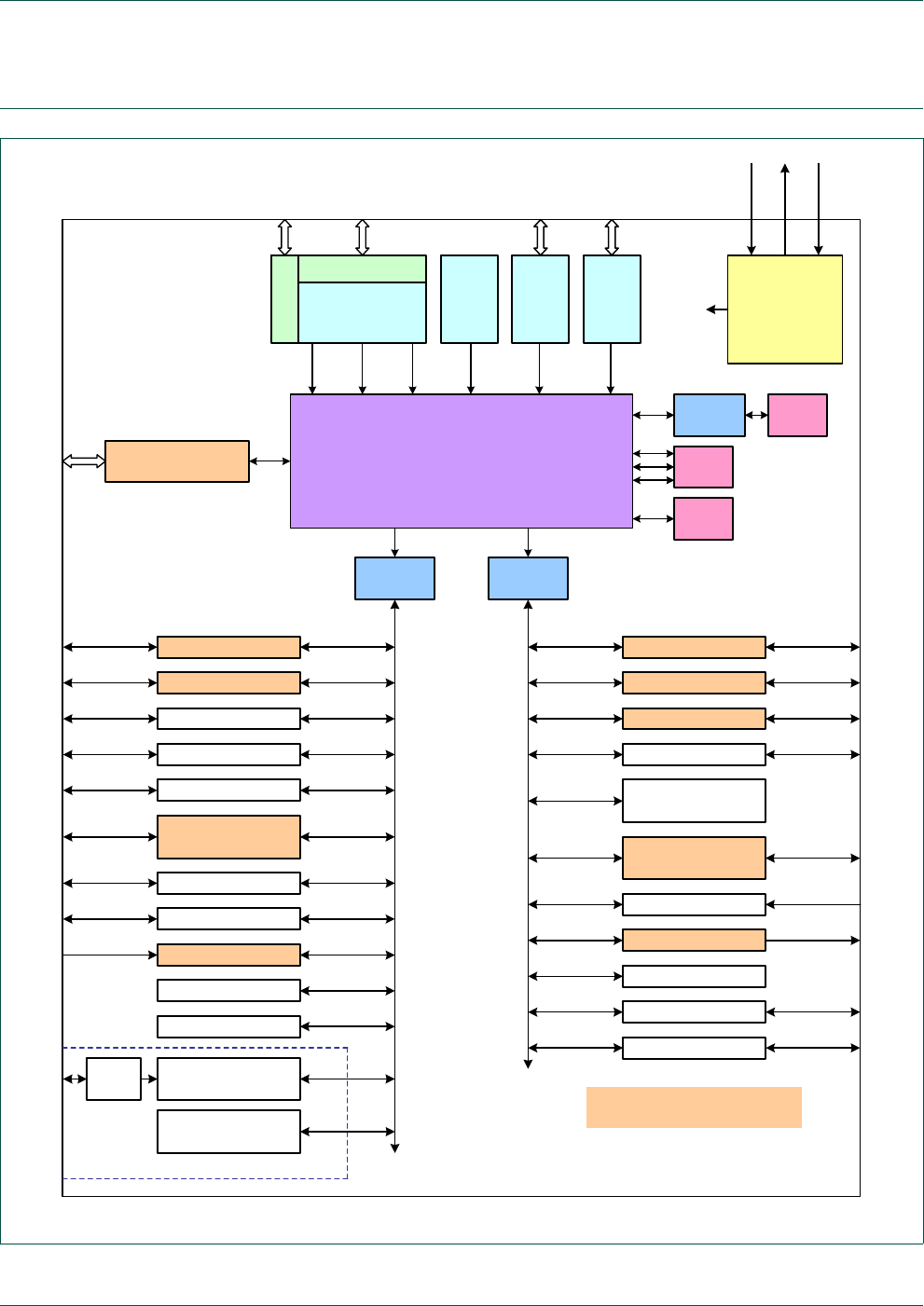
UM10360 All information provided in this document is subject to legal disclaimers. © NXP B.V. 2014. All rights reserved.
User manual Rev. 3.1 — 2 April 2014 9 of 849
NXP Semiconductors UM10360
Chapter 1: LPC176x/5x Introductory information
1.5 Simplified block diagram
Fig 1. LPC1768 simplified block diagram
AHB to
APB bridge
AHB to
APB bridge
APB slave group 1APB slave group 0
Note: shaded peripheral blocks
support General Purpose DMA
RTC Power Domain
Multilayer AHB Matrix
I2C2
I2S
UARTs 2 & 3
SSP0
Real Time Clock
20 bytes of backup
registers
SSP1
UARTs 0 & 1
CAN 1 & 2
I2C 0 & 1
SPI0
Capture/Compare
Timers 0 & 1
Watchdog Timer
PWM1
12-bit ADC
Pin Connect Block
GPIO Interrupt Ctl
32 kHz
oscillator
DMA
controller
Clock Generation,
Power Control,
Brownout Detect,
and other
system functions
RST
Xtalin
Xtalout
Clocks
and
Controls
Ethernet
PHY
interface
Ethernet
10/100
MAC
USB
device,
host,
OTG
USB
interface
JTAG
interface
ARM Cortex-M3
Test/Debug Interface
System
bus
D-code
bus
I-code
bus
ROM
8 kB
SRAM
64 kB
Trace
Port
Trace Module
High Speed GPIO
Capture/Compare
Timers 2 & 3
External Interrupts
DAC
System Control
Motor Control PWM
Quadrature Encoder
Repetitive Interrupt
Timer
Flash
512 kB
Flash
Accelerator

UM10360 All information provided in this document is subject to legal disclaimers. © NXP B.V. 2014. All rights reserved.
User manual Rev. 3.1 — 2 April 2014 10 of 849
NXP Semiconductors UM10360
Chapter 1: LPC176x/5x Introductory information
1.6 Architectural overview
The ARM Cortex-M3 includes three AHB-Lite buses, one system bus and the I-code and
D-code buses which are faster and are used similarly to TCM interfaces: one bus
dedicated for instruction fetch (I-code) and one bus for data access (D-code). The use of
two core buses allows for simultaneous operations if concurrent operations target different
devices.
The LPC176x/5x uses a multi-layer AHB matrix to connect the Cortex-M3 buses and other
bus masters to peripherals in a flexible manner that optimizes performance by allowing
peripherals on different slaves ports of the matrix to be accessed simultaneously by
different bus masters. Details of the multilayer matrix connections are shown in Figure 2.
APB peripherals are connected to the CPU via two APB busses using separate slave
ports from the multilayer AHB matrix. This allows for better performance by reducing
collisions between the CPU and the DMA controller. The APB bus bridges are configured
to buffer writes so that the CPU or DMA controller can write to APB devices without
always waiting for APB write completion.
1.7 ARM Cortex-M3 processor
The ARM Cortex-M3 is a general purpose 32-bit microprocessor, which offers high
performance and very low power consumption. The Cortex-M3 offers many new features,
including a Thumb-2 instruction set, low interrupt latency, hardware divide,
interruptible/continuable multiple load and store instructions, automatic state save and
restore for interrupts, tightly integrated interrupt controller with Wake-up Interrupt
Controller, and multiple core buses capable of simultaneous accesses.
Pipeline techniques are employed so that all parts of the processing and memory systems
can operate continuously. Typically, while one instruction is being executed, its successor
is being decoded, and a third instruction is being fetched from memory.
The ARM Cortex-M3 processor is described in detail in the Cortex-M3 User Guide that is
appended to this manual.
1.7.1 Cortex-M3 Configuration Options
The LPC176x/5x uses the r2p0 version of the Cortex-M3 CPU, which includes a number
of configurable options, as noted below.
System options:
•The Nested Vectored Interrupt Controller (NVIC) is included. The NVIC includes the
SYSTICK timer.
•The Wake-up Interrupt Controller (WIC) is included. The WIC allows more powerful
options for waking up the CPU from reduced power modes.
•A Memory Protection Unit (MPU) is included.
•A ROM Table in included. The ROM Table provides addresses of debug components
to external debug systems.

UM10360 All information provided in this document is subject to legal disclaimers. © NXP B.V. 2014. All rights reserved.
User manual Rev. 3.1 — 2 April 2014 11 of 849
NXP Semiconductors UM10360
Chapter 1: LPC176x/5x Introductory information
Debug related options:
•A JTAG debug interface is included.
•Serial Wire Debug is included. Serial Wire Debug allows debug operations using only
2 wires, simple trace functions can be added with a third wire.
•The Embedded Trace Macrocell (ETM) is included. The ETM provides instruction
trace capabilities.
•The Data Watchpoint and Trace (DWT) unit is included. The DWT allows data
address or data value matches to be trace information or trigger other events. The
DWT includes 4 comparators and counters for certain internal events.
•An Instrumentation Trace Macrocell (ITM) is included. Software can write to the ITM in
order to send messages to the trace port.
•The Trace Port Interface Unit (TPIU) is included. The TPIU encodes and provides
trace information to the outside world. This can be on the Serial Wire Viewer pin or the
4-bit parallel trace port.
•A Flash Patch and Breakpoint (FPB) is included. The FPB can generate hardware
breakpoints and remap specific addresses in code space to SRAM as a temporary
method of altering non-volatile code. The FPB include 2 literal comparators and 6
instruction comparators.
1.8 On-chip flash memory system
The LPC176x/5x contains up to 512 kB of on-chip flash memory. A flash memory
accelerator maximizes performance for use with the two fast AHB-Lite buses. This
memory may be used for both code and data storage. Programming of the flash memory
may be accomplished in several ways. It may be programmed In System via the serial
port. The application program may also erase and/or program the flash while the
application is running, allowing a great degree of flexibility for data storage field firmware
upgrades, etc.
1.9 On-chip Static RAM
The LPC176x/5x contains up to 64 kB of on-chip static RAM memory. Up to 32 kB of
SRAM, accessible by the CPU and all three DMA controllers are on a higher-speed bus.
Devices containing more than 32 kB SRAM have two additional 16 kB SRAM blocks, each
situated on separate slave ports on the AHB multilayer matrix.
This architecture allows the possibility for CPU and DMA accesses to be separated in
such a way that there are few or no delays for the bus masters.
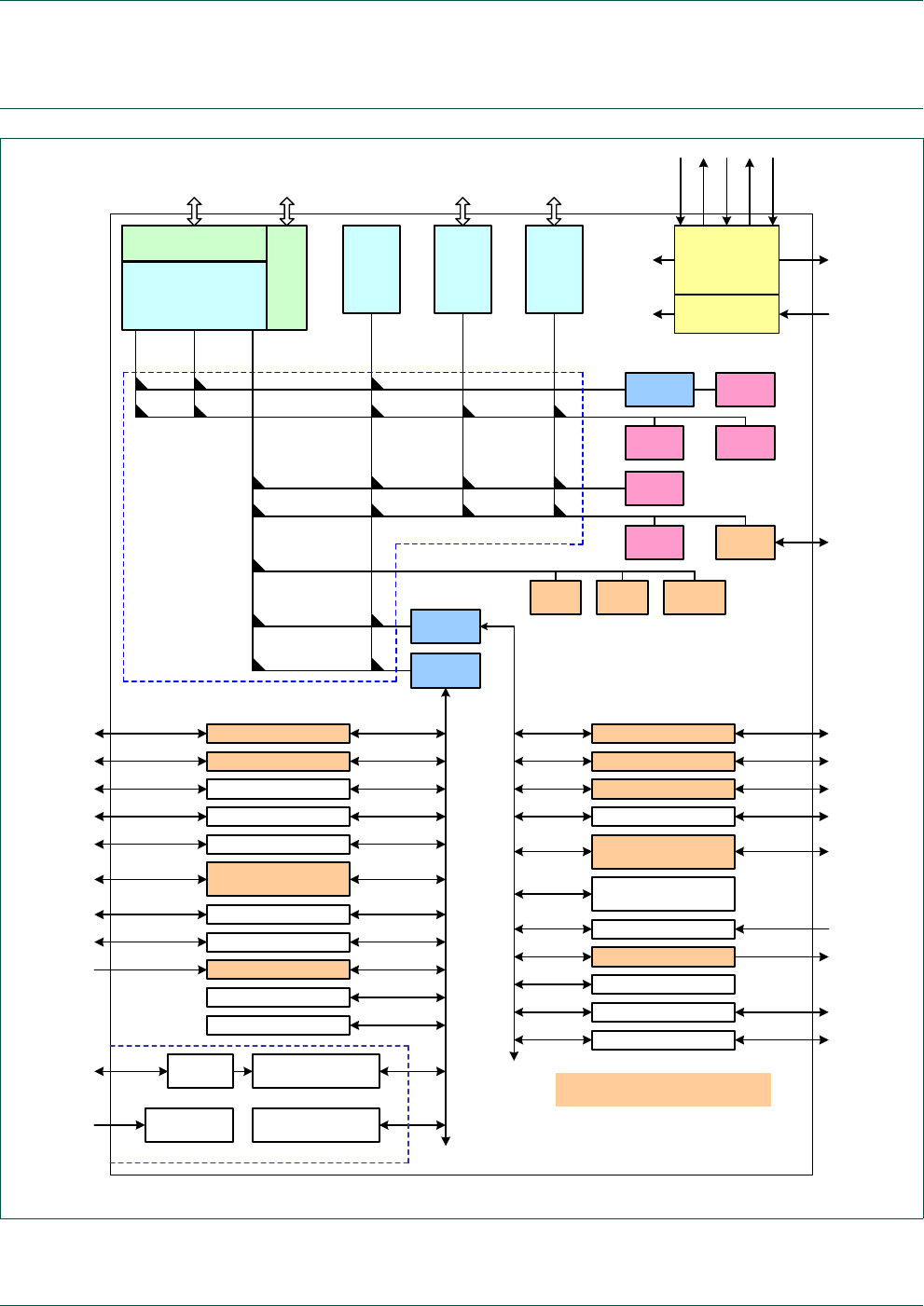
UM10360 All information provided in this document is subject to legal disclaimers. © NXP B.V. 2014. All rights reserved.
User manual Rev. 3.1 — 2 April 2014 12 of 849
NXP Semiconductors UM10360
Chapter 1: LPC176x/5x Introductory information
1.10 Block diagram
Fig 2. LPC1768 block diagram, CPU and buses
Multilayer
AHB Matrix
AHB to
APB bridge
AHB to
APB bridge
JTAG
interface Debug Port
Ethernet PHY
interface
SRAM
16 kB
SRAM
16 kB
EMULATION
TRACE MODULE
ARM Cortex-M3
TEST/DEBUG
INTERFACE USB
device,
host,
OTG
USB
interface
DMA
controller
Ethernet
10/100
MAC
System
bus
D-code
bus
I-code
bus
DMAC
regs
USB
regs
Ethernet
regs
clock generation,
power control,
and other
system functions
SRAM
32 kB
ROM
8 kB
Flash
512 kB
Flash
Accelerator
RST
Xtalin
Xtalout
X32Kin
X32Kout
APB slave group 1
Note: shaded peripheral blocks
support General Purpose DMA
Capture/compare
timers 2 & 3
I2C2
I2S
UARTs 2 & 3
SSP0
External interrupts
DAC
System control
Motor control PWM
Quadrature encoder
APB slave group 0
RTC Power Domain
Real Time Clock
SSP1
UARTs 0 & 1
CAN 1 & 2
I2C 0 & 1
SPI0
Capture/compare
timers 0 & 1
Watchdog timer
PWM1
12-bit ADC
Pin connect block
GPIO interrupt control
32 kHz
oscillator
Backup registers
(20 bytes)
Repetitive interrupt
timer
ultra-low power
regulator
Vbat
voltage regulator
clocks
and
controls
internal
power
Vdd
CLK
OUT
HS
GPIO

UM10360 All information provided in this document is subject to legal disclaimers. © NXP B.V. 2014. All rights reserved.
User manual Rev. 3.1 — 2 April 2014 13 of 849
2.1 Memory map and peripheral addressing
The ARM Cortex-M3 processor has a single 4 GB address space. The following table
shows how this space is used on the LPC176x/5x.
2.2 Memory maps
The LPC176x/5x incorporates several distinct memory regions, shown in the following
figures. Figure 3 shows the overall map of the entire address space from the user
program viewpoint following reset. The interrupt vector area supports address remapping,
which is described later in this section.
UM10360
Chapter 2: LPC176x/5x Memory map
Rev. 3.1 — 2 April 2014 User manual
Table 3. LPC176x/5x memory usage and details
Address range General Use Address range details and description
0x0000 0000 to
0x1FFF FFFF
On-chip non-volatile
memory
0x0000 0000 - 0x0007 FFFF For devices with 512 kB of flash memory.
0x0000 0000 - 0x0003 FFFF For devices with 256 kB of flash memory.
0x0000 0000 - 0x0001 FFFF For devices with 128 kB of flash memory.
0x0000 0000 - 0x0000 FFFF For devices with 64 kB of flash memory.
0x0000 0000 - 0x0000 7FFF For devices with 32 kB of flash memory.
On-chip SRAM 0x1000 0000 - 0x1000 7FFF For devices with 32 kB of local SRAM.
0x1000 0000 - 0x1000 3FFF For devices with 16 kB of local SRAM.
0x1000 0000 - 0x1000 1FFF For devices with 8 kB of local SRAM.
Boot ROM 0x1FFF 0000 - 0x1FFF 1FFF 8 kB Boot ROM with flash services.
0x2000 0000 to
0x3FFF FFFF
On-chip SRAM
(typically used for
peripheral data)
0x2007 C000 - 0x2007 FFFF AHB SRAM - bank 0 (16 kB), present on
devices with 32 kB or 64 kB of total SRAM.
0x2008 0000 - 0x2008 3FFF AHB SRAM - bank 1 (16 kB), present on
devices with 64 kB of total SRAM.
GPIO 0x2009 C000 - 0x2009 FFFF GPIO.
0x4000 0000 to
0x5FFF FFFF
APB Peripherals 0x4000 0000 - 0x4007 FFFF APB0 Peripherals, up to 32 peripheral blocks,
16 kB each.
0x4008 0000 - 0x400F FFFF APB1 Peripherals, up to 32 peripheral blocks,
16 kB each.
AHB peripherals 0x5000 0000 - 0x501F FFFF DMA Controller, Ethernet interface, and USB
interface.
0xE000 0000 to
0xE00F FFFF
Cortex-M3 Private
Peripheral Bus
0xE000 0000 - 0xE00F FFFF Cortex-M3 related functions, includes the
NVIC and System Tick Timer.
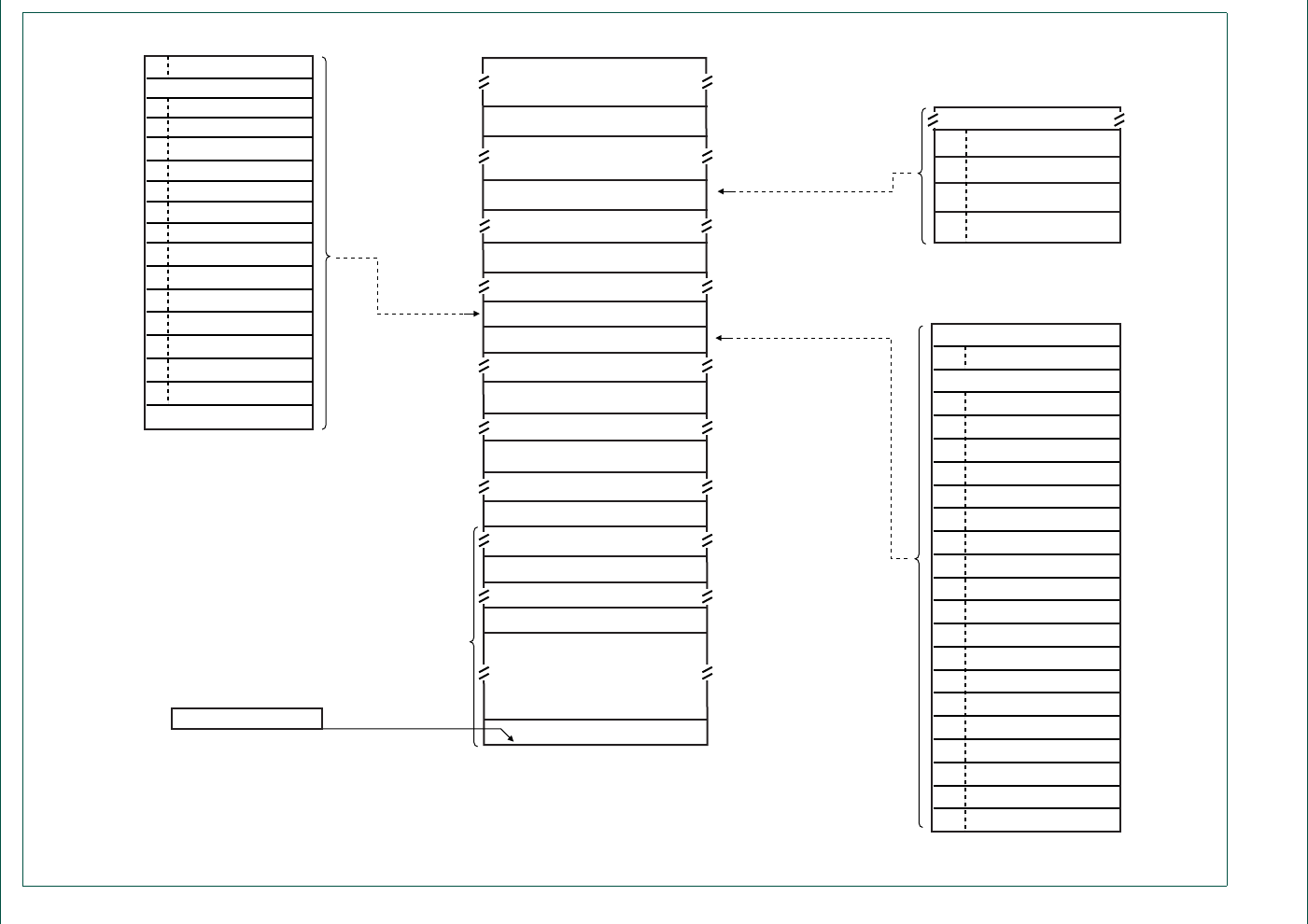
xxxxxxxxxxxxxxxxxxxxx xxxxxxxxxxxxxxxxxxxxxxxxxx xxxxxxx x x x xxxxxxxxxxxxxxxxxxxxxxxxxxxxxx xxxxxxxxxxxxxxxxxxx xx xx xxxxx
xxxxxxxxxxxxxxxxxxxxxxxxxxx xxxxxxxxxxxxxxxxxxx xxxxxx xxxxxxxxxxxxxxxxxxxxxxxxxxxxxxxxxxx xxxxxxxxxxxx x x
xxxxxxxxxxxxxxxxxxxxx xxxxxxxxxxxxxxxxxxxxxxxxxxxxxx xxxxx xxxxxxxxxxxxxxxxxxxxxxxxxxxxxxxxxxxxxxxxxxxxxxxxxx xxxxxxxx
xxxxxxxxxxxxxxxxxxxxxxxxx xxxxxxxxxxxxxxxxxxxx xxx
UM10360 All information provided in this document is subject to legal disclaimers. © NXP B.V. 2014. All rights reserved.
User manual Rev. 3.1 — 2 April 2014 14 of 849
NXP Semiconductors UM10360
Chapter 2: LPC176x/5x Memory map
Fig 3. LPC176x/5x system memory map
0x5000 0000
0x5000 4000
0x5000 8000
0x5000 C000
0x5020 0000
AHB peripherals
Ethernet controller
USB controller
reserved
127- 4 reserved
GPDMA controller
0
1
2
3
APB0 peripherals
0x4000 4000
0x4000 8000
0x4000 C000
0x4001 0000
0x4001 8000
0x4002 0000
0x4002 8000
0x4002 C000
0x4003 4000
0x4003 0000
0x4003 8000
0x4003 C000
0x4004 0000
0x4004 4000
0x4004 8000
0x4004 C000
0x4005 C000
0x4006 0000
0x4008 0000
0x4002 4000
0x4001 C000
0x4001 4000
0x4000 0000
WDT
TIMER0
TIMER1
UART0
UART1
reserved
I2C0
SPI
RTC + backup registers
GPIO interrupts
pin connect
SSP1
ADC
CAN AF RAM
CAN AF registers
CAN common
CAN1
CAN2
22 - 19 reserved
I2C1
31 - 24 reserved
0
1
2
3
4
5
6
7
8
9
10
11
12
13
14
15
16
17
18
23
APB1 peripherals
0x4008 0000
0x4008 8000
0x4008 C000
0x4009 0000
0x4009 4000
0x4009 8000
0x4009 C000
0x400A 0000
0x400A 4000
0x400A 8000
0x400A C000
0x400B 0000
0x400B 4000
0x400B 8000
0x400B C000
0x400C 0000
0x400F C000
0x4010 0000
SSP0
DAC
Timer 2
Timer 3
UART2
UART3
reserved
I2S
I2C2
1 - 0 reserved
2
3
4
5
6
7
8
9
10
reserved
repetitive interrupt timer
11
12
reserved
motor control PWM
30 - 16 reserved
13
14
15
system control31
reserved
reserved
32 kB local static RAM
reserved
reserved
private peripheral bus
0x0000 0000
0 GB
0.5 GB
4 GB
1 GB
0x0008 0000
0x1000 0000
0x1000 8000
0x1FFF 0000
0x1FFF 2000
0x2007 C000
0x2008 4000
0x2009 C000
0x200A 0000
0x2200 0000
0x2400 0000
0x4000 0000
0x4008 0000
0x4010 0000
0x4200 0000
0x4400 0000
0x5000 0000
0x5020 0000
0xE000 0000
0xE010 0000
0xFFFF FFFF
reserved
reserved
GPIO
reserved
reserved
reserved
reserved
APB0 peripherals
AHB periherals
APB1 peripherals
AHB SRAM bit band alias addressing
peripheral bit band alias addressing
AHB SRAM (2 blocks of 16 kB)
LPC1768 memory space
512 kB on-chip flash
QEI
PWM1
8 kB boot ROM
0x0000 0000
0x0000 0400
active interrupt vectors
+ 256 words
I-code/D-code
memory space

UM10360 All information provided in this document is subject to legal disclaimers. © NXP B.V. 2014. All rights reserved.
User manual Rev. 3.1 — 2 April 2014 15 of 849
NXP Semiconductors UM10360
Chapter 2: LPC176x/5x Memory map
Figure 3 and Table 4 show different views of the peripheral address space. The AHB
peripheral area is 2 megabyte in size, and is divided to allow for up to 128 peripherals.
The APB peripheral area is 1 megabyte in size and is divided to allow for up to 64
peripherals. Each peripheral of either type is allocated 16 kilobytes of space. This allows
simplifying the address decoding for each peripheral.
All peripheral register addresses are word aligned (to 32-bit boundaries) regardless of
their size. This eliminates the need for byte lane mapping hardware that would be required
to allow byte (8-bit) or half-word (16-bit) accesses to occur at smaller boundaries. An
implication of this is that word and half-word registers must be accessed all at once. For
example, it is not possible to read or write the upper byte of a word register separately.
2.3 APB peripheral addresses
The following table shows the APB0/1 address maps. No APB peripheral uses all of the
16 kB space allocated to it. Typically each device’s registers are "aliased" or repeated at
multiple locations within each 16 kB range.
Table 4. APB0 peripherals and base addresses
APB0 peripheral Base address Peripheral name
00x4000 0000 Watchdog Timer
10x4000 4000 Timer 0
20x4000 8000 Timer 1
30x4000 C000 UART0
40x4001 0000 UART1
50x4001 4000 reserved
60x4001 8000 PWM1
70x4001 C000 I2C0
80x40020000 SPI
90x40024000 RTC
10 0x4002 8000 GPIO interrupts
11 0x4002 C000 Pin Connect Block
12 0x4003 0000 SSP1
13 0x4003 4000 ADC
14 0x4003 8000 CAN Acceptance Filter RAM
15 0x4003 C000 CAN Acceptance Filter Registers
16 0x4004 0000 CAN Common Registers
17 0x4004 4000 CAN Controller 1
18 0x4004 8000 CAN Controller 2
19 to 22 0x4004 C000 to 0x4005 8000 reserved
23 0x4005 C000 I2C1
24 to 31 0x4006 0000 to 0x4007 C000 reserved

UM10360 All information provided in this document is subject to legal disclaimers. © NXP B.V. 2014. All rights reserved.
User manual Rev. 3.1 — 2 April 2014 16 of 849
NXP Semiconductors UM10360
Chapter 2: LPC176x/5x Memory map
2.4 Memory re-mapping
The Cortex-M3 incorporates a mechanism that allows remapping the interrupt vector table
to alternate locations in the memory map. This is controlled via the Vector Table Offset
Register contained in the Cortex-M3. Refer to Section 6.4 and Section 34.4.3.5 of the
Cortex-M3 User Guide appended to this manual for details of the Vector Table Offset
feature.
Boot ROM re-mapping
Following a hardware reset, the Boot ROM is temporarily mapped to address 0. This is
normally transparent to the user. However, if execution is halted immediately after reset by
a debugger, it should correct the mapping for the user. See Section 33.6.
2.5 AHB arbitration
The Multilayer AHB Matrix arbitrates between several masters. By default, the Cortex-M3
D-code bus has the highest priority, followed by the I-Code bus. All other masters share a
lower priority.
2.6 Bus fault exceptions
The LPC176x/5x generates Bus Fault exception if an access is attempted for an address
that is in a reserved or unassigned address region. The regions are areas of the memory
map that are not implemented for a specific derivative. These include all spaces marked
“reserved” in Figure 3.
Table 5. APB1 peripherals and base addresses
APB1 peripheral Base address Peripheral name
00x4008 0000 reserved
10x4008 4000 reserved
20x4008 8000 SSP0
30x4008 C000 DAC
40x4009 0000 Timer 2
50x4009 4000 Timer 3
60x4009 8000 UART2
70x4009 C000 UART3
80x400A 0000 I2C2
90x400A4000 reserved
10 0x400A 8000 I2S
11 0x400A C000 reserved
12 0x400B 0000 Repetitive interrupt timer
13 0x400B 4000 reserved
14 0x400B 8000 Motor control PWM
15 0x400B C000 Quadrature Encoder Interface
16 to 30 0x400C 0000 to 0x400F 8000 reserved
31 0x400F C000 System control

UM10360 All information provided in this document is subject to legal disclaimers. © NXP B.V. 2014. All rights reserved.
User manual Rev. 3.1 — 2 April 2014 17 of 849
NXP Semiconductors UM10360
Chapter 2: LPC176x/5x Memory map
For these areas, both attempted data access and instruction fetch generate an exception.
In addition, a Bus Fault exception is generated for any instruction fetch that maps to an
AHB or APB peripheral address.
Within the address space of an existing APB peripheral, an exception is not generated in
response to an access to an undefined address. Address decoding within each peripheral
is limited to that needed to distinguish defined registers within the peripheral itself. For
example, an access to address 0x4000 D000 (an undefined address within the UART0
space) may result in an access to the register defined at address 0x4000 C000. Details of
such address aliasing within a peripheral space are not defined in the LPC176x/5x
documentation and are not a supported feature.
If software executes a write directly to the flash memory, the flash accelerator will
generate a Bus Fault exception. Flash programming must be accomplished by using the
specified flash programming interface provided by the Boot Code.
Note that the Cortex-M3 core stores the exception flag along with the associated
instruction in the pipeline and processes the exception only if an attempt is made to
execute the instruction fetched from the disallowed address. This prevents accidental
aborts that could be caused by prefetches that occur when code is executed very near a
memory boundary.

UM10360 All information provided in this document is subject to legal disclaimers. © NXP B.V. 2014. All rights reserved.
User manual Rev. 3.1 — 2 April 2014 18 of 849
3.1 Introduction
The system control block includes several system features and control registers for a
number of functions that are not related to specific peripheral devices. These include:
•Reset
•Brown-Out Detection
•External Interrupt Inputs
•Miscellaneous System Controls and Status
Each type of function has its own register(s) if any are required and unneeded bits are
defined as reserved in order to allow future expansion. Unrelated functions never share
the same register addresses
3.2 Pin description
Tab l e 6 shows pins that are associated with System Control block functions.
UM10360
Chapter 3: LPC176x/5x System control
Rev. 3.1 — 2 April 2014 User manual
Table 6. Pin summary
Pin name Pin
direction
Pin description
EINT0 Input External Interrupt Input 0 - An active low/high level or falling/rising
edge general purpose interrupt input. This pin may be used to wake up
the processor from Sleep, Deep-sleep, or Power-down modes.
EINT1 Input External Interrupt Input 1 - See the EINT0 description above.
EINT2 Input External Interrupt Input 2 - See the EINT0 description above.
EINT3 Input External Interrupt Input 3 - See the EINT0 description above.
RESET Input External Reset input - A LOW on this pin resets the chip, causing I/O
ports and peripherals to take on their default states, and the processor to
begin execution at address 0x0000 0000.

UM10360 All information provided in this document is subject to legal disclaimers. © NXP B.V. 2014. All rights reserved.
User manual Rev. 3.1 — 2 April 2014 19 of 849
NXP Semiconductors UM10360
Chapter 3: LPC176x/5x System control
3.3 Register description
All registers, regardless of size, are on word address boundaries. Details of the registers
appear in the description of each function.
3.4 Reset
Reset has 4 sources on the LPC176x/5x: the RESET pin, Watchdog Reset, Power On
Reset (POR), and Brown Out Detect (BOD).
The RESET pin is a Schmitt trigger input pin. Assertion of chip Reset by any source, once
the operating voltage attains a usable level, starts the wake-up timer (see description in
Section 4.9 “Wake-up timer” in this chapter), causing reset to remain asserted until the
external Reset is de-asserted, the oscillator is running, a fixed number of clocks have
passed, and the flash controller has completed its initialization. The reset logic is shown in
the following block diagram (see Figure 4).
Table 7. Summary of system control registers
Name Description Access Reset value Address
External Interrupts
EXTINT External Interrupt Flag Register R/W 0 0x400F C140
EXTMODE External Interrupt Mode register R/W 0 0x400F C148
EXTPOLAR External Interrupt Polarity Register R/W 0 0x400F C14C
Reset
RSID Reset Source Identification Register R/W see Tab l e 8 0x400F C180
Syscon Miscellaneous Registers
SCS System Control and Status R/W 0 0x400F C1A0
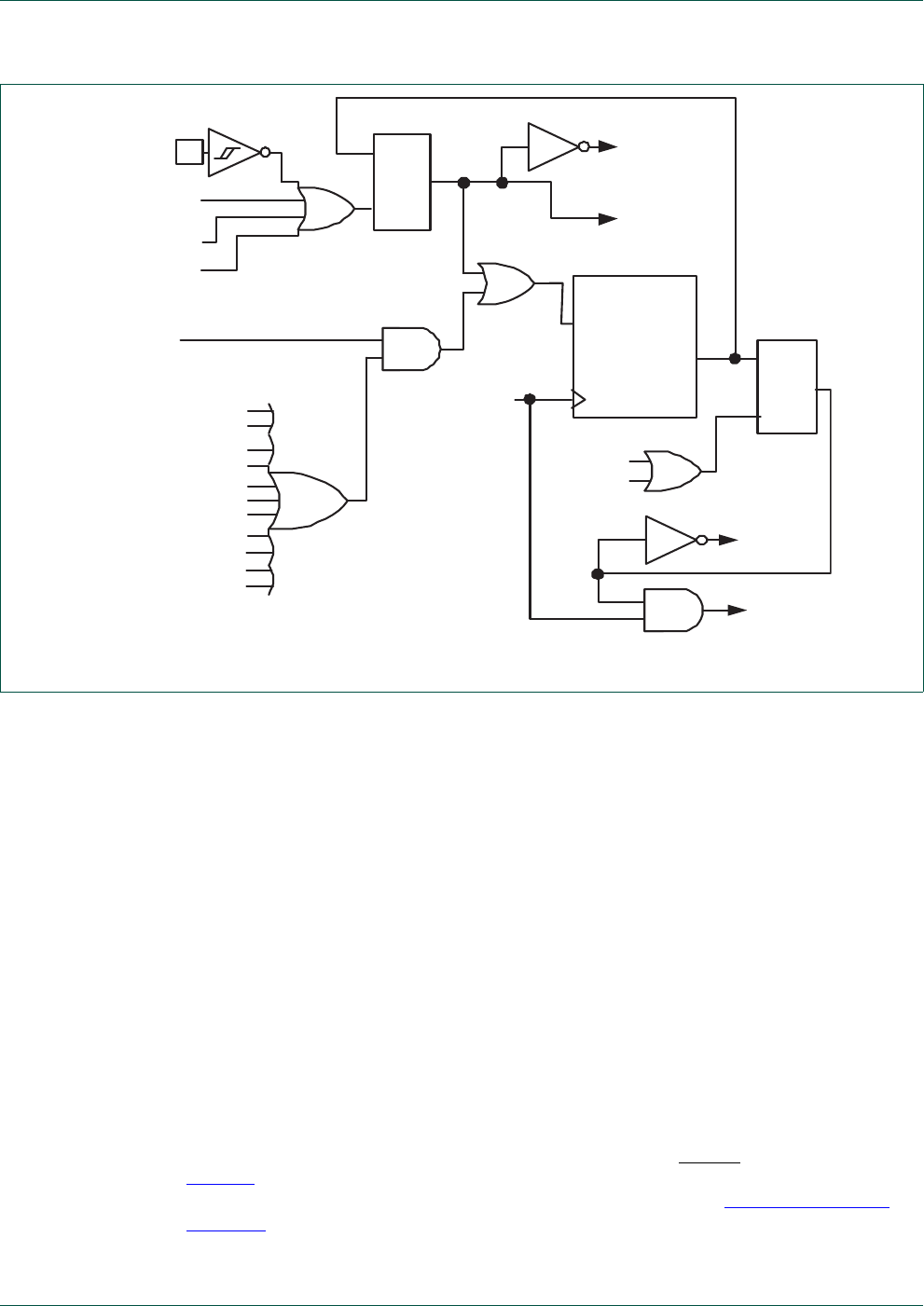
UM10360 All information provided in this document is subject to legal disclaimers. © NXP B.V. 2014. All rights reserved.
User manual Rev. 3.1 — 2 April 2014 20 of 849
NXP Semiconductors UM10360
Chapter 3: LPC176x/5x System control
On the assertion of a reset source external to the Cortex-M3 CPU (POR, BOD reset,
External reset, and Watchdog reset), the IRC starts up. After the IRC-start-up time
(maximum of 60 s on power-up) and after the IRC provides a stable clock output, the
reset signal is latched and synchronized on the IRC clock. Then the following two
sequences start simultaneously:
1. The 2-bit IRC wake-up timer starts counting when the synchronized reset is
de-asserted. The boot code in the ROM starts when the 2-bit IRC wake-up timer times
out. The boot code performs the boot tasks and may jump to the flash. If the flash is
not ready to access, the Flash Accelerator will insert wait cycles until the flash is
ready.
2. The flash wake-up timer (9-bit) starts counting when the synchronized reset is
de-asserted. The flash wake-up timer generates the 100 s flash start-up time. Once
it times out, the flash initialization sequence is started, which takes about 250 cycles.
When it’s done, the Flash Accelerator will be granted access to the flash.
When the internal Reset is removed, the processor begins executing at address 0, which
is initially the Reset vector mapped from the Boot Block. At that point, all of the processor
and peripheral registers have been initialized to predetermined values.
Figure 5 shows an example of the relationship between the RESET, the IRC, and the
processor status when the LPC176x/5x starts up after reset. See Section 4.3.2 “Main
oscillator” for start-up of the main oscillator if selected by the user code.
Fig 4. Reset block diagram including the wake-up timer
C
Q
S
APB read of
PDBIT
in PCON
power-down
C
Q
S
F
OSC
to other
blocks
WAKE-UP TIMER
watchdog
reset
external
reset
START
COUNT 2
n
internal RC
oscillator
Reset to the
on-chip circuitry
Reset to
PCON.PD
write “1”
from APB
reset
EINT0 wake-up
EINT1 wake-up
EINT2 wake-up
POR
BOD
EINT3 wake-up
RTC wake-up
BOD wake-up
Ethernet MAC wake-up
USB need_clk wake-up
CAN wake-up
GPIO0 port wake-up
GPIO2 port wake-up
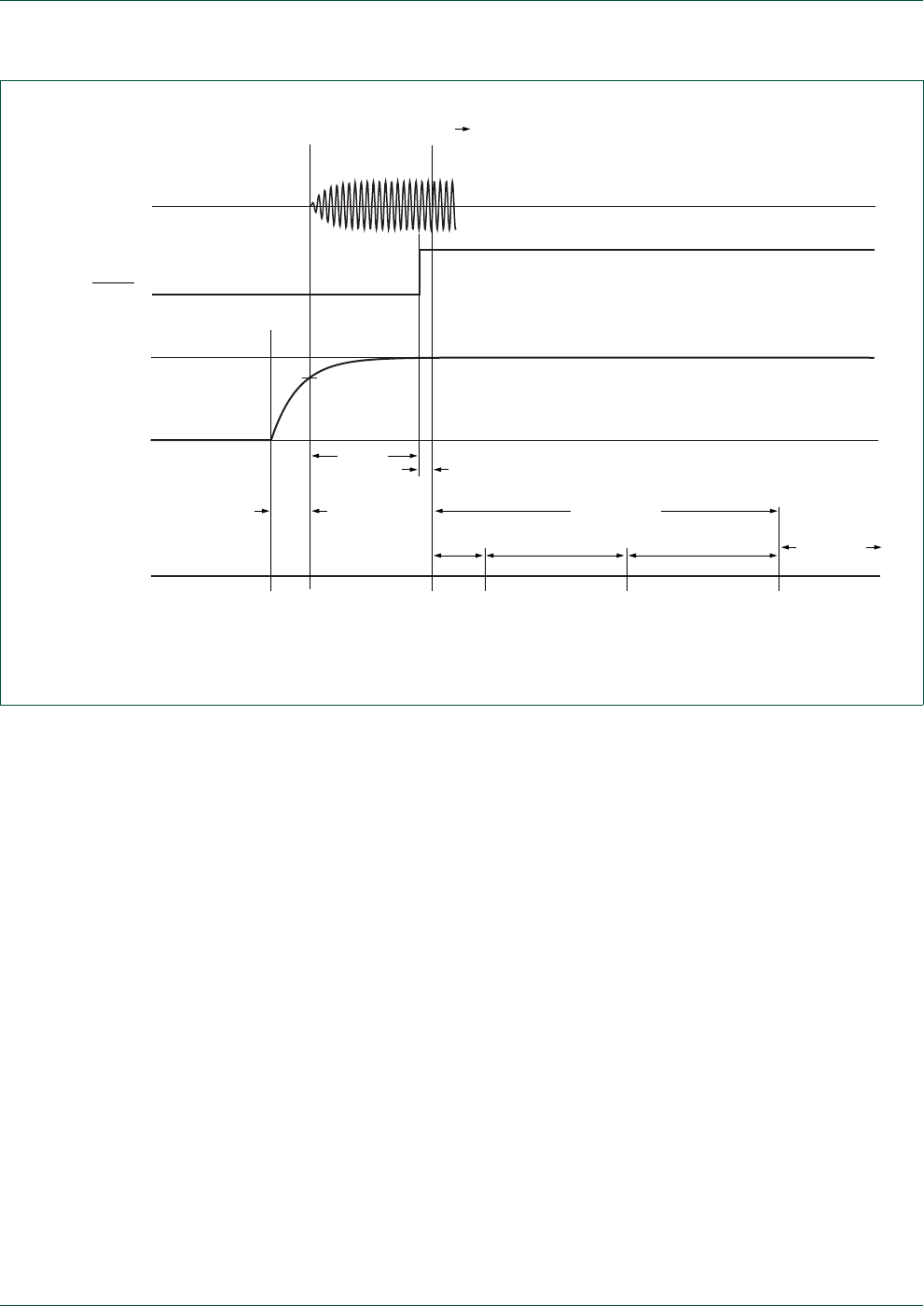
UM10360 All information provided in this document is subject to legal disclaimers. © NXP B.V. 2014. All rights reserved.
User manual Rev. 3.1 — 2 April 2014 21 of 849
NXP Semiconductors UM10360
Chapter 3: LPC176x/5x System control
Fig 5. Example of start-up after reset
valid threshold
processor status
VDD(REG)(3V3)
IRC status
RESET
GND
60 µs
1 µs; IRC stability count
boot time
user code
boot code
execution
finishes;
user code starts
flash read
starts
flash read
finishes
IRC
starts
IRC
stable
supply ramp-up
time
7 µs 181 µs 224 µs

UM10360 All information provided in this document is subject to legal disclaimers. © NXP B.V. 2014. All rights reserved.
User manual Rev. 3.1 — 2 April 2014 22 of 849
NXP Semiconductors UM10360
Chapter 3: LPC176x/5x System control
3.4.1 Reset Source Identification Register (RSID - 0x400F C180)
This register contains one bit for each source of Reset. Writing a 1 to any of these bits
clears the corresponding read-side bit to 0. The interactions among the four sources are
described below.
Table 8. Reset Source Identification register (RSID - address 0x400F C180) bit description
Bit Symbol Description Reset
value
0PORAssertion of the POR signal sets this bit, and clears all of the other bits in
this register. But if another Reset signal (e.g., External Reset) remains
asserted after the POR signal is negated, then its bit is set. This bit is not
affected by any of the other sources of Reset.
See
text
1EXTRAssertion of the RESET
signal sets this bit. This bit is cleared only by
software or POR.
See
text
2WDTRThis bit is set when the Watchdog Timer times out and the WDTRESET bit
in the Watchdog Mode Register is 1. This bit is cleared only by software or
POR.
See
text
3BODRThis bit is set when the V
DD(REG)(3V3) voltage reaches a level below the
BOD reset trip level (typically 1.85 V under nominal room temperature
conditions).
If the VDD(REG)(3V3) voltage dips from the normal operating range to below
the BOD reset trip level and recovers, the BODR bit will be set to 1.
If the VDD(REG)(3V3) voltage dips from the normal operating range to below
the BOD reset trip level and continues to decline to the level at which POR
is asserted (nominally 1 V), the BODR bit is cleared.
If the VDD(REG)(3V3) voltage rises continuously from below 1 V to a level
above the BOD reset trip level, the BODR will be set to 1.
This bit is cleared only by software or POR.
Note: Only in the case where a reset occurs and the POR = 0, the BODR
bit indicates if the VDD(REG)(3V3) voltage was below the BOD reset trip level
or not.
See
text
31:4 - Reserved, user software should not write ones to reserved bits. The value
read from a reserved bit is not defined.
NA

UM10360 All information provided in this document is subject to legal disclaimers. © NXP B.V. 2014. All rights reserved.
User manual Rev. 3.1 — 2 April 2014 23 of 849
NXP Semiconductors UM10360
Chapter 3: LPC176x/5x System control
3.5 Brown-out detection
The LPC176x/5x includes a Brown-Out Detector (BOD) that provides 2-stage monitoring
of the voltage on the VDD(REG)(3V3) pins. If this voltage falls below the BOD interrupt trip
level (typically 2.2 V under nominal room temperature conditions), the BOD asserts an
interrupt signal to the NVIC. This signal can be enabled for interrupt in the Interrupt
Enable Register in the NVIC in order to cause a CPU interrupt; if not, software can monitor
the signal by reading the Raw Interrupt Status Register.
The second stage of low-voltage detection asserts Reset to inactivate the LPC176x/5x
when the voltage on the VDD(REG)(3V3) pins falls below the BOD reset trip level (typically
1.85 V under nominal room temperature conditions). This Reset prevents alteration of the
flash as operation of the various elements of the chip would otherwise become unreliable
due to low voltage. The BOD circuit maintains this reset down below 1 V, at which point
the Power-On Reset circuitry maintains the overall Reset.
Both the BOD reset interrupt level and the BOD reset trip level thresholds include some
hysteresis. In normal operation, this hysteresis allows the BOD reset interrupt level
detection to reliably interrupt, or a regularly-executed event loop to sense the condition.
But when Brown-Out Detection is enabled to bring the LPC176x/5x out of Power-down
mode (which is itself not a guaranteed operation -- see Section 4.8.7 “Power Mode
Control register (PCON - 0x400F C0C0)”), the supply voltage may recover from a
transient before the wake-up timer has completed its delay. In this case, the net result of
the transient BOD is that the part wakes up and continues operation after the instructions
that set Power-down mode, without any interrupt occurring and with the BOD bit in the
RSID being 0. Since all other wake-up conditions have latching flags (see Section 3.6.2
“External Interrupt flag register (EXTINT - 0x400F C140)” and Section 27.6.2), a wake-up
of this type, without any apparent cause, can be assumed to be a Brown-Out that has
gone away.
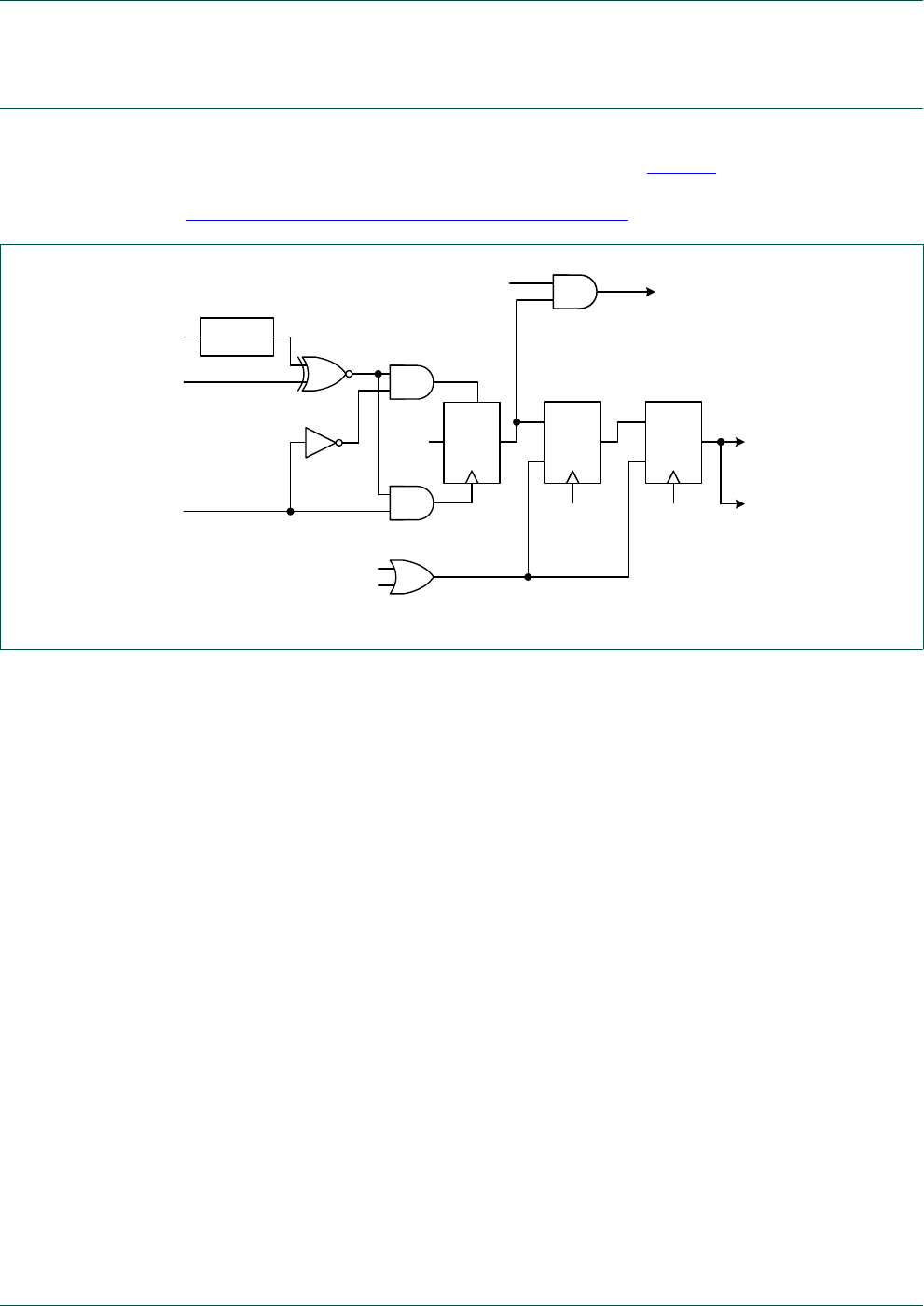
UM10360 All information provided in this document is subject to legal disclaimers. © NXP B.V. 2014. All rights reserved.
User manual Rev. 3.1 — 2 April 2014 24 of 849
NXP Semiconductors UM10360
Chapter 3: LPC176x/5x System control
3.6 External interrupt inputs
TheLPC176x/5x includes four External Interrupt Inputs as selectable pin functions. The
logic of an individual external interrupt is represented in Figure 6. In addition, external
interrupts have the ability to wake up the CPU from Power-down mode. Refer to
Section 4.8.8 “Wake-up from Reduced Power Modes” for details.
Fig 6. External interrupt logic
Interrupt flag
(one bit of EXTINT)
write to EXTINTi
internal reset
EINTi to wakeup timer
EINTi pin
EXTMODEi PCLK
to interrupt
controller
EXTPOLARi
EINTi interrupt enable
PCLK
1
GLITCH
FILTER
APB read
of EXTINTi
Q
S
R
Q
S
R
Q
S
D
100621

UM10360 All information provided in this document is subject to legal disclaimers. © NXP B.V. 2014. All rights reserved.
User manual Rev. 3.1 — 2 April 2014 25 of 849
NXP Semiconductors UM10360
Chapter 3: LPC176x/5x System control
3.6.1 Register description
The external interrupt function has four registers associated with it. The EXTINT register
contains the interrupt flags. The EXTMODE and EXTPOLAR registers specify the level
and edge sensitivity parameters.
[1] Reset Value reflects the data stored in used bits only. It does not include reserved bits content.
3.6.2 External Interrupt flag register (EXTINT - 0x400F C140)
When a pin is selected for its external interrupt function, the level or edge on that pin
(selected by its bits in the EXTPOLAR and EXTMODE registers) will set its interrupt flag in
this register. This asserts the corresponding interrupt request to the NVIC, which will
cause an interrupt if interrupts from the pin are enabled.
Writing ones to bits EINT0 through EINT3 in EXTINT register clears the corresponding
bits. In level-sensitive mode the interrupt is cleared only when the pin is in its inactive
state.
Once a bit from EINT0 to EINT3 is set and an appropriate code starts to execute (handling
wake-up and/or external interrupt), this bit in EXTINT register must be cleared. Otherwise
event that was just triggered by activity on the EINT pin will not be recognized in future.
Important: whenever a change of external interrupt operating mode (i.e. active
level/edge) is performed (including the initialization of an external interrupt), the
corresponding bit in the EXTINT register must be cleared! For details see
Section 3.6.3 “External Interrupt Mode register (EXTMODE - 0x400F C148)” and
Section 3.6.4 “External Interrupt Polarity register (EXTPOLAR - 0x400F C14C)”.
For example, if a system wakes up from Power-down using low level on external interrupt
0 pin, its post wake-up code must reset EINT0 bit in order to allow future entry into the
Power-down mode. If EINT0 bit is left set to 1, subsequent attempt(s) to invoke
Power-down mode will fail. The same goes for external interrupt handling.
More details on Power-down mode will be discussed in the following chapters.
Table 9. External Interrupt registers
Name Description Access Reset
value[1]
Address
EXTINT The External Interrupt Flag Register contains
interrupt flags for EINT0, EINT1, EINT2 and
EINT3. See Table 1 0 .
R/W 0x00 0x400F C140
EXTMODE The External Interrupt Mode Register controls
whether each pin is edge- or level-sensitive.
See Tab l e 11 .
R/W 0x00 0x400F C148
EXTPOLAR The External Interrupt Polarity Register controls
which level or edge on each pin will cause an
interrupt. See Tab l e 1 2.
R/W 0x00 0x400F C14C

UM10360 All information provided in this document is subject to legal disclaimers. © NXP B.V. 2014. All rights reserved.
User manual Rev. 3.1 — 2 April 2014 26 of 849
NXP Semiconductors UM10360
Chapter 3: LPC176x/5x System control
[1] Example: e.g. if the EINTx is selected to be low level sensitive and low level is present on
corresponding pin, this bit can not be cleared; this bit can be cleared only when signal on the
pin becomes high.
3.6.3 External Interrupt Mode register (EXTMODE - 0x400F C148)
The bits in this register select whether each EINT pin is level- or edge-sensitive. Only pins
that are selected for the EINT function (see Section 8.5) and enabled in the appropriate
NVIC register) can cause interrupts from the External Interrupt function (though of course
pins selected for other functions may cause interrupts from those functions).
Note: Software should only change a bit in this register when its interrupt is
disabled in the NVIC (state readable in the ISERn/ICERn registers), and should write
the corresponding 1 to EXTINT before enabling (initializing) or re-enabling the
interrupt. An extraneous interrupt(s) could be set by changing the mode and not
having the EXTINT cleared.
Table 10. External Interrupt Flag register (EXTINT - address 0x400F C140) bit description
Bit Symbol Description Reset
value
0EINT0In level-sensitive mode, this bit is set if the EINT0 function is selected for
its pin, and the pin is in its active state. In edge-sensitive mode, this bit is
set if the EINT0 function is selected for its pin, and the selected edge
occurs on the pin.
This bit is cleared by writing a one to it, except in level sensitive mode
when the pin is in its active state.[1]
0
1EINT1In level-sensitive mode, this bit is set if the EINT1 function is selected for
its pin, and the pin is in its active state. In edge-sensitive mode, this bit is
set if the EINT1 function is selected for its pin, and the selected edge
occurs on the pin.
This bit is cleared by writing a one to it, except in level sensitive mode
when the pin is in its active state.[1]
0
2EINT2In level-sensitive mode, this bit is set if the EINT2 function is selected for
its pin, and the pin is in its active state. In edge-sensitive mode, this bit is
set if the EINT2 function is selected for its pin, and the selected edge
occurs on the pin.
This bit is cleared by writing a one to it, except in level sensitive mode
when the pin is in its active state.[1]
0
3EINT3In level-sensitive mode, this bit is set if the EINT3 function is selected for
its pin, and the pin is in its active state. In edge-sensitive mode, this bit is
set if the EINT3 function is selected for its pin, and the selected edge
occurs on the pin.
This bit is cleared by writing a one to it, except in level sensitive mode
when the pin is in its active state.[1]
0
31:4 - Reserved, user software should not write ones to reserved bits. The value
read from a reserved bit is not defined.
NA

UM10360 All information provided in this document is subject to legal disclaimers. © NXP B.V. 2014. All rights reserved.
User manual Rev. 3.1 — 2 April 2014 27 of 849
NXP Semiconductors UM10360
Chapter 3: LPC176x/5x System control
3.6.4 External Interrupt Polarity register (EXTPOLAR - 0x400F C14C)
In level-sensitive mode, the bits in this register select whether the corresponding pin is
high- or low-active. In edge-sensitive mode, they select whether the pin is rising- or
falling-edge sensitive. Only pins that are selected for the EINT function Only pins that are
selected for the EINT function (see Section 8.5) and enabled in the appropriate NVIC
register) can cause interrupts from the External Interrupt function (though of course pins
selected for other functions may cause interrupts from those functions).
Note: Software should only change a bit in this register when its interrupt is
disabled in the NVIC (state readable in the ISERn/ICERn registers), and should write
the corresponding 1 to EXTINT before enabling (initializing) or re-enabling the
interrupt. An extraneous interrupt(s) could be set by changing the polarity and not
having the EXTINT cleared.
Table 11. External Interrupt Mode register (EXTMODE - address 0x400F C148) bit
description
Bit Symbol Value Description Reset
value
0EXTMODE00 Level-sensitivity is selected for EINT0.0
1EINT0
is edge sensitive.
1EXTMODE10 Level-sensitivity is selected for EINT1.0
1EINT1
is edge sensitive.
2EXTMODE20 Level-sensitivity is selected for EINT2.0
1EINT2
is edge sensitive.
3EXTMODE30 Level-sensitivity is selected for EINT3.0
1EINT3
is edge sensitive.
31:4 - - Reserved, user software should not write ones to reserved
bits. The value read from a reserved bit is not defined.
NA
Table 12. External Interrupt Polarity register (EXTPOLAR - address 0x400F C14C) bit
description
Bit Symbol Value Description Reset
value
0EXTPOLAR00 EINT0 is low-active or falling-edge sensitive (depending on
EXTMODE0).
0
1EINT0
is high-active or rising-edge sensitive (depending on
EXTMODE0).
1EXTPOLAR10 EINT1
is low-active or falling-edge sensitive (depending on
EXTMODE1).
0
1EINT1
is high-active or rising-edge sensitive (depending on
EXTMODE1).
2EXTPOLAR20 EINT2
is low-active or falling-edge sensitive (depending on
EXTMODE2).
0
1EINT2
is high-active or rising-edge sensitive (depending on
EXTMODE2).

UM10360 All information provided in this document is subject to legal disclaimers. © NXP B.V. 2014. All rights reserved.
User manual Rev. 3.1 — 2 April 2014 28 of 849
NXP Semiconductors UM10360
Chapter 3: LPC176x/5x System control
3EXTPOLAR30 EINT3 is low-active or falling-edge sensitive (depending on
EXTMODE3).
0
1EINT3
is high-active or rising-edge sensitive (depending on
EXTMODE3).
31:4 - - Reserved, user software should not write ones to reserved
bits. The value read from a reserved bit is not defined.
NA
Table 12. External Interrupt Polarity register (EXTPOLAR - address 0x400F C14C) bit
description
Bit Symbol Value Description Reset
value

UM10360 All information provided in this document is subject to legal disclaimers. © NXP B.V. 2014. All rights reserved.
User manual Rev. 3.1 — 2 April 2014 29 of 849
NXP Semiconductors UM10360
Chapter 3: LPC176x/5x System control
3.7 Other system controls and status flags
Some aspects of controlling LPC176x/5x operation that do not fit into peripheral or other
registers are grouped here.
3.7.1 System Controls and Status register (SCS - 0x400F C1A0)
The SCS register contains several control/status bits related to the main oscillator. Since
chip operation always begins using the Internal RC Oscillator, and the main oscillator may
not be used at all in some applications, it will only be started by software request. This is
accomplished by setting the OSCEN bit in the SCS register, as described in Table 3-13.
The main oscillator provides a status flag (the OSCSTAT bit in the SCS register) so that
software can determine when the oscillator is running and stable. At that point, software
can control switching to the main oscillator as a clock source. Prior to starting the main
oscillator, a frequency range must be selected by configuring the
OSCRANGE bit in the SCS register.
Table 13. System Controls and Status register (SCS - address 0x400F C1A0) bit description
Bit Symbol Value Description Access Reset
value
3:0 - -Reserved. User software should not write ones to
reserved bits. The value read from a reserved bit is
not defined.
-NA
4OSCRANGE Main oscillator range select. R/W 0
0The frequency range of the main oscillator is 1MHz
to 20 MHz.
1The frequency range of the main oscillator is
15 MHz to 25 MHz.
5OSCEN Main oscillator enable. R/W 0
0The main oscillator is disabled.
1The main oscillator is enabled, and will start up if
the correct external circuitry is connected to the
XTAL1 and XTAL2 pins.
6OSCSTAT Main oscillator status. RO 0
0The main oscillator is not ready to be used as a
clock source.
1The main oscillator is ready to be used as a clock
source. The main oscillator must be enabled via the
OSCEN bit.
31:7 - -Reserved. User software should not write ones to
reserved bits. The value read from a reserved bit is
not defined.
-NA
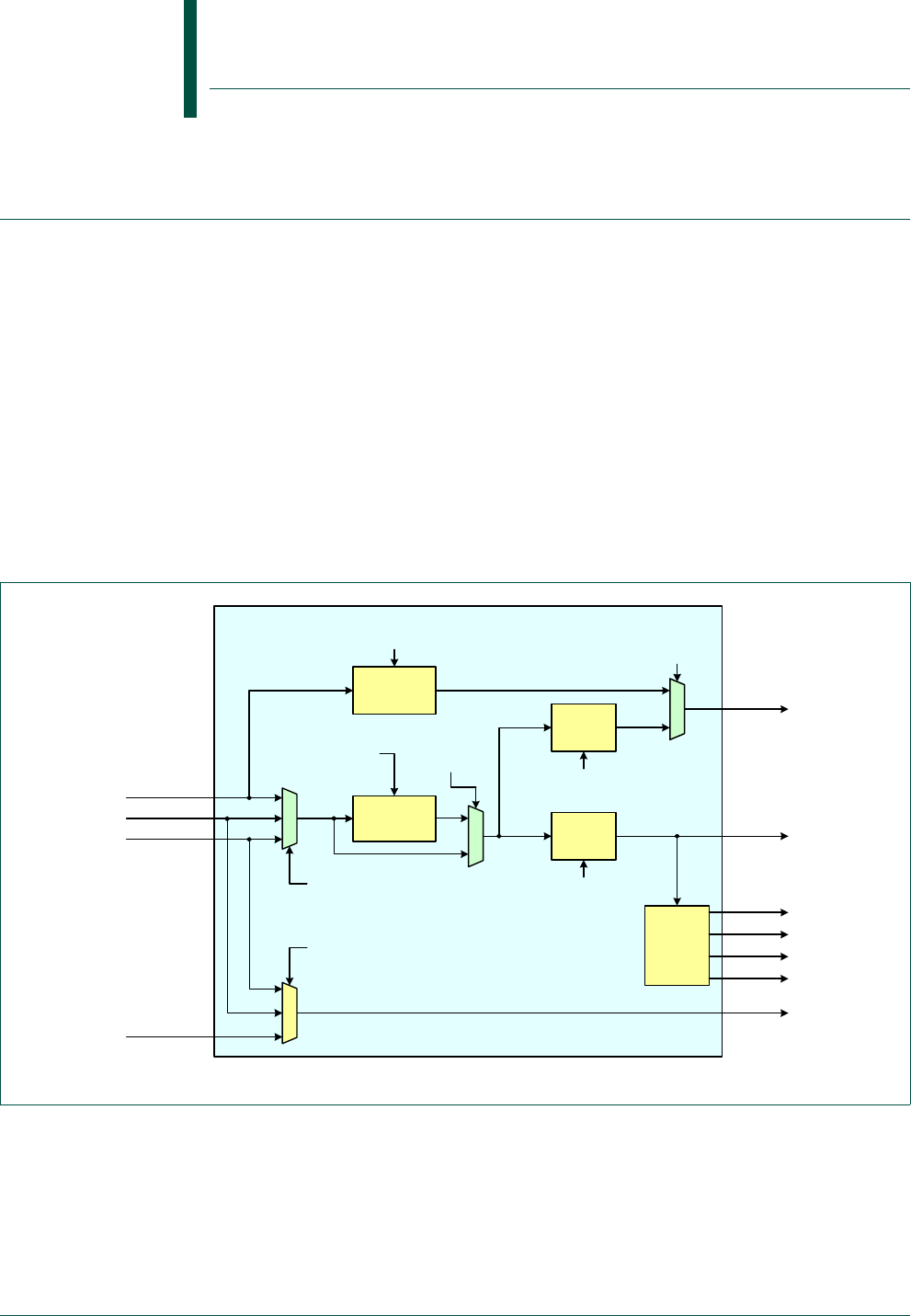
UM10360 All information provided in this document is subject to legal disclaimers. © NXP B.V. 2014. All rights reserved.
User manual Rev. 3.1 — 2 April 2014 30 of 849
4.1 Summary of clocking and power control functions
This section describes the generation of the various clocks needed by the LPC176x/5x
and options of clock source selection, as well as power control and wake-up from reduced
power modes. Functions described in the following subsections include:
•Oscillators
•Clock source selection
•PLLs
•Clock dividers
•APB dividers
•Power control
•Wake-up timer
•External clock output
UM10360
Chapter 4: LPC176x/5x Clocking and power control
Rev. 3.1 — 2 April 2014 User manual
Fig 7. Clock generation for the LPC176x/5x
`
USB
Clock
Divider
osc_clk
irc_osc
system clock select
CLKSRCSEL[1:0]
USB PLL settings
(PLL1...)
USB clock divider setting
USBCLKCFG[3:0]
PCLK_WDT
Peripheral
Clock
Divider
wd_clk
usb_clk
pclk1
pclk8
pclk4
pclk2
USB PLL
(PLL1)
main PLL
settings
(PLL0...)
USB PLL
select
(PLL1CON)
Main PLL
(PLL0) CPU
Clock
Divider
pllclk
CPU PLL
select
(PLL0CON)
cclk
watchdog clock select
WDCLKSEL[1:0]
rtc_clk
CPU clock divider setting
CCLKCFG[7:0]
sysclk

UM10360 All information provided in this document is subject to legal disclaimers. © NXP B.V. 2014. All rights reserved.
User manual Rev. 3.1 — 2 April 2014 31 of 849
NXP Semiconductors UM10360
Chapter 4: LPC176x/5x Clocking and power control
4.2 Register description
All registers, regardless of size, are on word address boundaries. Details of the registers
appear in the description of each function.
Table 14. Summary of system control registers
Name Description Access Reset value Address
Clock source selection
CLKSRCSEL Clock Source Select Register R/W 0 0x400F C10C
Phase Locked Loop (PLL0, Main PLL)
PLL0CON PLL0 Control Register R/W 0 0x400F C080
PLL0CFG PLL0 Configuration Register R/W 0 0x400F C084
PLL0STAT PLL0 Status Register RO 0 0x400F C088
PLL0FEED PLL0 Feed Register WO NA 0x400F C08C
Phase Locked Loop (PLL1, USB PLL)
PLL1CON PLL1 Control Register R/W 0 0x400F C0A0
PLL1CFG PLL1 Configuration Register R/W 0 0x400F C0A4
PLL1STAT PLL1 Status Register RO 0 0x400F C0A8
PLL1FEED PLL1 Feed Register WO NA 0x400F C0AC
Clock dividers
CCLKCFG CPU Clock Configuration Register R/W 0 0x400F C104
USBCLKCFG USB Clock Configuration Register R/W 0 0x400F C108
PCLKSEL0 Peripheral Clock Selection register 0. R/W 0 0x400F C1A8
PCLKSEL1 Peripheral Clock Selection register 1. R/W 0 0x400F C1AC
Power control
PCON Power Control Register R/W 0 0x400F C0C0
PCONP Power Control for Peripherals Register R/W 0x03BE 0x400F C0C4
Utility
CLKOUTCFG Clock Output Configuration Register R/W 0 0x400F C1C8

UM10360 All information provided in this document is subject to legal disclaimers. © NXP B.V. 2014. All rights reserved.
User manual Rev. 3.1 — 2 April 2014 32 of 849
NXP Semiconductors UM10360
Chapter 4: LPC176x/5x Clocking and power control
4.3 Oscillators
The LPC176x/5x includes three independent oscillators. These are the Main Oscillator,
the Internal RC Oscillator, and the RTC oscillator. Each oscillator can be used for more
than one purpose as required in a particular application. This can be seen in Figure 7.
Following Reset, the LPC176x/5x will operate from the Internal RC Oscillator until
switched by software. This allows systems to operate without any external crystal, and
allows the boot loader code to operate at a known frequency.
4.3.1 Internal RC oscillator
The Internal RC Oscillator (IRC) may be used as the clock source for the watchdog timer,
and/or as the clock that drives PLL0 and subsequently the CPU. The precision of the IRC
does not allow for use of the USB interface, which requires a much more precise time
base in order to comply with the USB specification. Also, the IRC should not be used with
the CAN1/2 block if the CAN baud rate is higher than 100 kbit/s.The nominal IRC
frequency is 4 MHz.
Upon power-up or any chip reset, the LPC176x/5x uses the IRC as the clock source.
Software may later switch to one of the other available clock sources.
4.3.2 Main oscillator
The main oscillator can be used as the clock source for the CPU, with or without using
PLL0. The main oscillator operates at frequencies of 1 MHz to 25 MHz. This frequency
can be boosted to a higher frequency, up to the maximum CPU operating frequency, by
the Main PLL (PLL0). The oscillator output is called OSC_CLK. The clock selected as the
PLL0 input is PLLCLKIN and the ARM processor clock frequency is referred to as CCLK
for purposes of rate equations, etc. elsewhere in this document. The frequencies of
PLLCLKIN and CCLK are the same value unless the PLL0 is active and connected. Refer
to Section 4.5 “PLL0 (Phase Locked Loop 0)” for details.
The on-board oscillator in the LPC176x/5x can operate in one of two modes: slave mode
and oscillation mode.
In slave mode the input clock signal should be coupled by means of a capacitor of 100 pF
(CC in Figure 8, drawing a), with an amplitude between 200 mVrms and 1000 mVrms.
This corresponds to a square wave signal with a signal swing of between 280 mV and 1.4
V. The XTAL2 pin in this configuration can be left unconnected.
External components and models used in oscillation mode are shown in Figure 8,
drawings b and c, and in Ta b le 15 and Ta b l e 16. Since the feedback resistance is
integrated on chip, only a crystal and the capacitances CX1 and CX2 need to be connected
externally in case of fundamental mode oscillation (the fundamental frequency is
represented by L, CL and RS). Capacitance CP in Figure 8, drawing c, represents the
parallel package capacitance and should not be larger than 7 pF. Parameters FC, CL, RS
and CP are supplied by the crystal manufacturer.
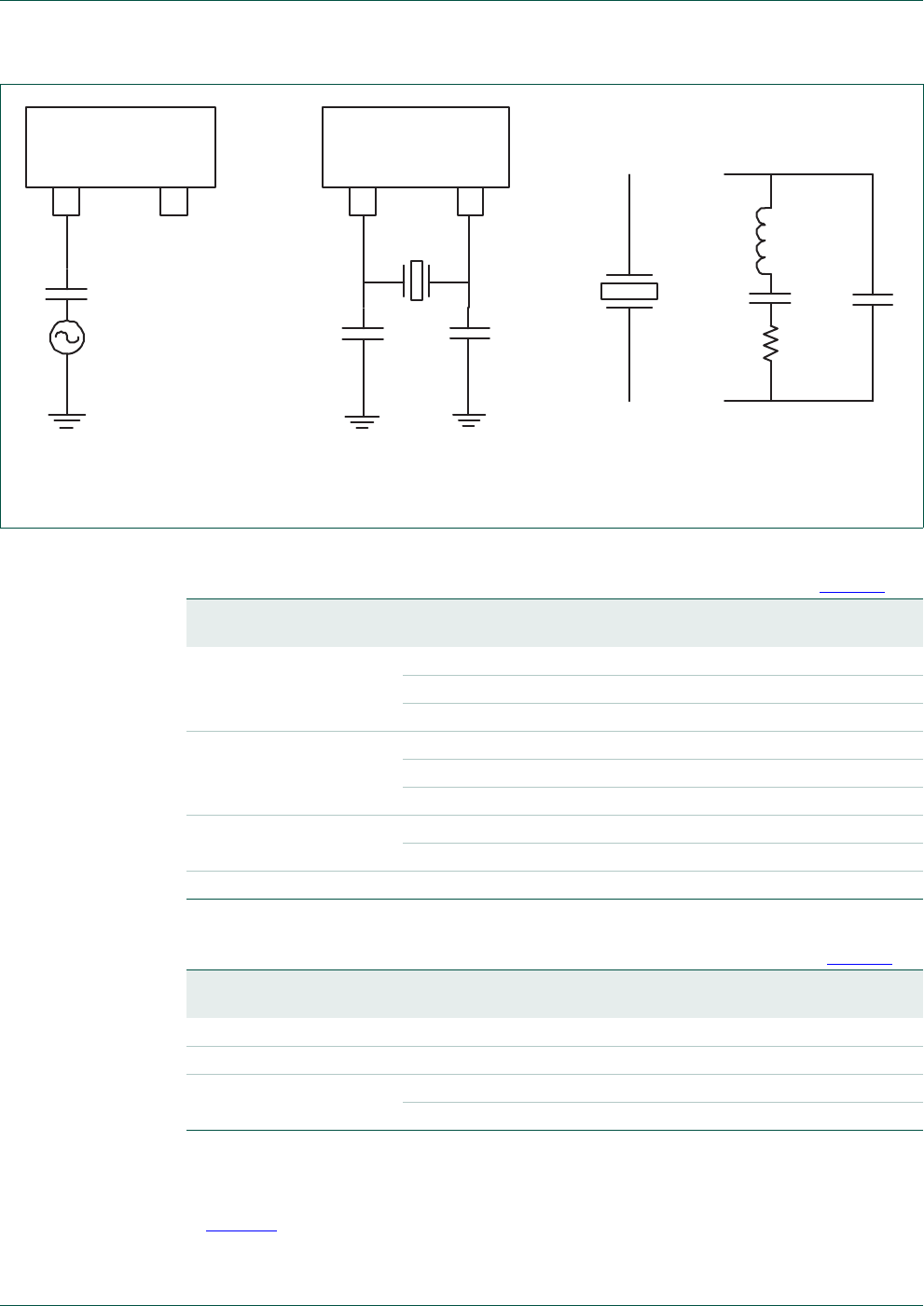
UM10360 All information provided in this document is subject to legal disclaimers. © NXP B.V. 2014. All rights reserved.
User manual Rev. 3.1 — 2 April 2014 33 of 849
NXP Semiconductors UM10360
Chapter 4: LPC176x/5x Clocking and power control
Since chip operation always begins using the Internal RC Oscillator, and the main
oscillator may not be used at all in some applications, it will only be started by software
request. This is accomplished by setting the OSCEN bit in the SCS register, as described
in Tab l e 1 3. The main oscillator provides a status flag (the OSCSTAT bit in the SCS
register) so that software can determine when the oscillator is running and stable. At that
Fig 8. Oscillator modes and models: a) slave mode of operation, b) oscillation mode of operation, c) external
crystal model used for CX1/X2 evaluation
LPC17xx LPC17xx
Clock
CC
CX1 CX2
CLCP
L
RS
< = >
a) b) c)
Xtal
XTAL1 XTAL2 XTAL1 XTAL2
Table 15. Recommended values for CX1/X2 in oscillation mode (crystal and external
components parameters) low frequency mode (OSCRANGE = 0, see Table 13)
Fundamental oscillation
frequency FOSC
Crystal load
capacitance CL
Maximum crystal
series resistance RS
External load
capacitors CX1, CX2
1 MHz to 5 MHz 10 pF < 300 18 pF, 18 pF
20 pF < 300 39 pF, 39 pF
30 pF < 300 57 pF, 57 pF
5MHz to 10MHz 10 pF < 30018 pF, 18 pF
20 pF < 200 39 pF, 39 pF
30 pF < 100 57 pF, 57 pF
10 MHz to 15 MHz 10 pF < 160 18 pF, 18 pF
20 pF < 60 39 pF, 39 pF
15 MHz to 20 MHz 10 pF < 80 18 pF, 18 pF
Table 16. Recommended values for CX1/X2 in oscillation mode (crystal and external
components parameters) high frequency mode (OSCRANGE = 1, see Table 13)
Fundamental oscillation
frequency FOSC
Crystal load
capacitance CL
Maximum crystal
series resistance RS
External load
capacitors CX1, CX2
15 MHz to 20 MHz 10 pF < 180 18 pF, 18 pF
20 pF < 100 39 pF, 39 pF
20 MHz to 25 MHz 10 pF < 160 18 pF, 18 pF
20 pF < 80 39 pF, 39 pF

UM10360 All information provided in this document is subject to legal disclaimers. © NXP B.V. 2014. All rights reserved.
User manual Rev. 3.1 — 2 April 2014 34 of 849
NXP Semiconductors UM10360
Chapter 4: LPC176x/5x Clocking and power control
point, software can control switching to the main oscillator as a clock source. Prior to
starting the main oscillator, a frequency range must be selected by configuring the
OSCRANGE bit in the SCS register.
4.3.3 RTC oscillator
The RTC oscillator provides a 1 Hz clock to the RTC and a 32 kHz clock output that can
be used as the clock source for PLL0 and CPU and/or the watchdog timer.
Remark: The RTC oscillator must not be used as a clock source when the PLL0 output is
selected to drive the USB controller. In this case select the main oscillator as clock source
for PLL0 (see also Tab le 17 ).

UM10360 All information provided in this document is subject to legal disclaimers. © NXP B.V. 2014. All rights reserved.
User manual Rev. 3.1 — 2 April 2014 35 of 849
NXP Semiconductors UM10360
Chapter 4: LPC176x/5x Clocking and power control
4.4 Clock source selection multiplexer
Several clock sources may be chosen to drive PLL0 and ultimately the CPU and on-chip
peripheral devices. The clock sources available are the main oscillator, the RTC oscillator,
and the Internal RC oscillator.
The clock source selection can only be changed safely when PLL0 is not connected. For a
detailed description of how to change the clock source in a system using PLL0 see
Section 4.5.13 “PLL0 setup sequence”.
Note the following restrictions regarding the choice of clock sources:
•Only the main oscillator must be used (via PLL0) as the clock source for the USB
subsystem. The IRC or RTC oscillators do not provide the proper tolerances for this
use.
•The IRC oscillator should not be used (via PLL0) as the clock source for the CAN
controllers if the CAN baud rate is higher than 100 kbit/s.
4.4.1 Clock Source Select register (CLKSRCSEL - 0x400F C10C)
The CLKSRCSEL register contains the bits that select the clock source for PLL0.
Table 17. Clock Source Select register (CLKSRCSEL - address 0x400F C10C) bit
description
Bit Symbol Value Description Reset
value
1:0 CLKSRC Selects the clock source for PLL0 as follows: 0
00 Selects the Internal RC oscillator as the PLL0 clock source
(default).
01 Selects the main oscillator as the PLL0 clock source.
Remark: Select the main oscillator as PLL0 clock source if the
PLL0 clock output is used for USB or for CAN with baudrates
>100 kBit/s.
10 Selects the RTC oscillator as the PLL0 clock source.
11 Reserved, do not use this setting.
Warning: Improper setting of this value, or an incorrect sequence of
changing this value may result in incorrect operation of the device.
31:2 - 0 Reserved, user software should not write ones to reserved bits.
The value read from a reserved bit is not defined.
NA

UM10360 All information provided in this document is subject to legal disclaimers. © NXP B.V. 2014. All rights reserved.
User manual Rev. 3.1 — 2 April 2014 36 of 849
NXP Semiconductors UM10360
Chapter 4: LPC176x/5x Clocking and power control
4.5 PLL0 (Phase Locked Loop 0)
PLL0 accepts an input clock frequency in the range of 32 kHz to 50 MHz. The clock
source is selected in the CLKSRCSEL register (see Section 4.4). The input frequency is
multiplied up to a high frequency, then divided down to provide the actual clock used by
the CPU, peripherals, and optionally the USB subsystem. Note that the USB subsystem
has its own dedicated PLL (see Section 4.6). PLL0 can produce a clock up to the
maximum allowed for the CPU, which is 120 MHz on high speed versions (LPC1769 and
LPC1759), and 100 MHz on other versions.
4.5.1 PLL0 operation
The PLL input, in the range of 32 kHZ to 50 MHz, may initially be divided down by a value
"N", which may be in the range of 1 to 256. This input division provides a greater number
of possibilities in providing a wide range of output frequencies from the same input
frequency.
Following the PLL input divider is the PLL multiplier. This can multiply the input divider
output through the use of a Current Controlled Oscillator (CCO) by a value "M", in the
range of 6 through 512, plus additional values listed in Tabl e 2 1. The resulting frequency
must be in the range of 275 MHz to 550 MHz. The multiplier works by dividing the CCO
output by the value of M, then using a phase-frequency detector to compare the divided
CCO output to the multiplier input. The error value is used to adjust the CCO frequency.
There are additional dividers at the output of PLL0 to bring the frequency down to what is
needed for the CPU, peripherals, and potentially the USB subsystem. PLL0 output
dividers are described in the Clock Dividers section following the PLL0 description. A
block diagram of PLL0 is shown in Figure 9
PLL activation is controlled via the PLL0CON register. PLL0 multiplier and divider values
are controlled by the PLL0CFG register. These two registers are protected in order to
prevent accidental alteration of PLL0 parameters or deactivation of the PLL. Since all chip
operations, including the Watchdog Timer, could be dependent on PLL0 if so configured
(for example when it is providing the chip clock), accidental changes to the PLL0 setup
values could result in unexpected or fatal behavior of the microcontroller. The protection is
accomplished by a feed sequence similar to that of the Watchdog Timer. Details are
provided in the description of the PLL0FEED register.
PLL0 is turned off and bypassed following a chip Reset and by entering Power-down
mode. PLL0 must be configured, enabled, and connected to the system by software.
It is important that the setup procedure described in Section 4.5.13 “PLL0 setup
sequence” is followed or PLL0 might not operate at all!
4.5.1.1 PLL0 and startup/boot code interaction
When there is no valid user code (determined by the checksum word) in the user flash or
the ISP enable pin (P2.10) is pulled low on startup, the ISP mode will be entered and the
boot code will setup the PLL with the IRC. Therefore it can not be assumed that the PLL is
disabled when the user opens a debug session to debug the application code. The user
startup code must follow the steps described in this chapter to disconnect the PLL.
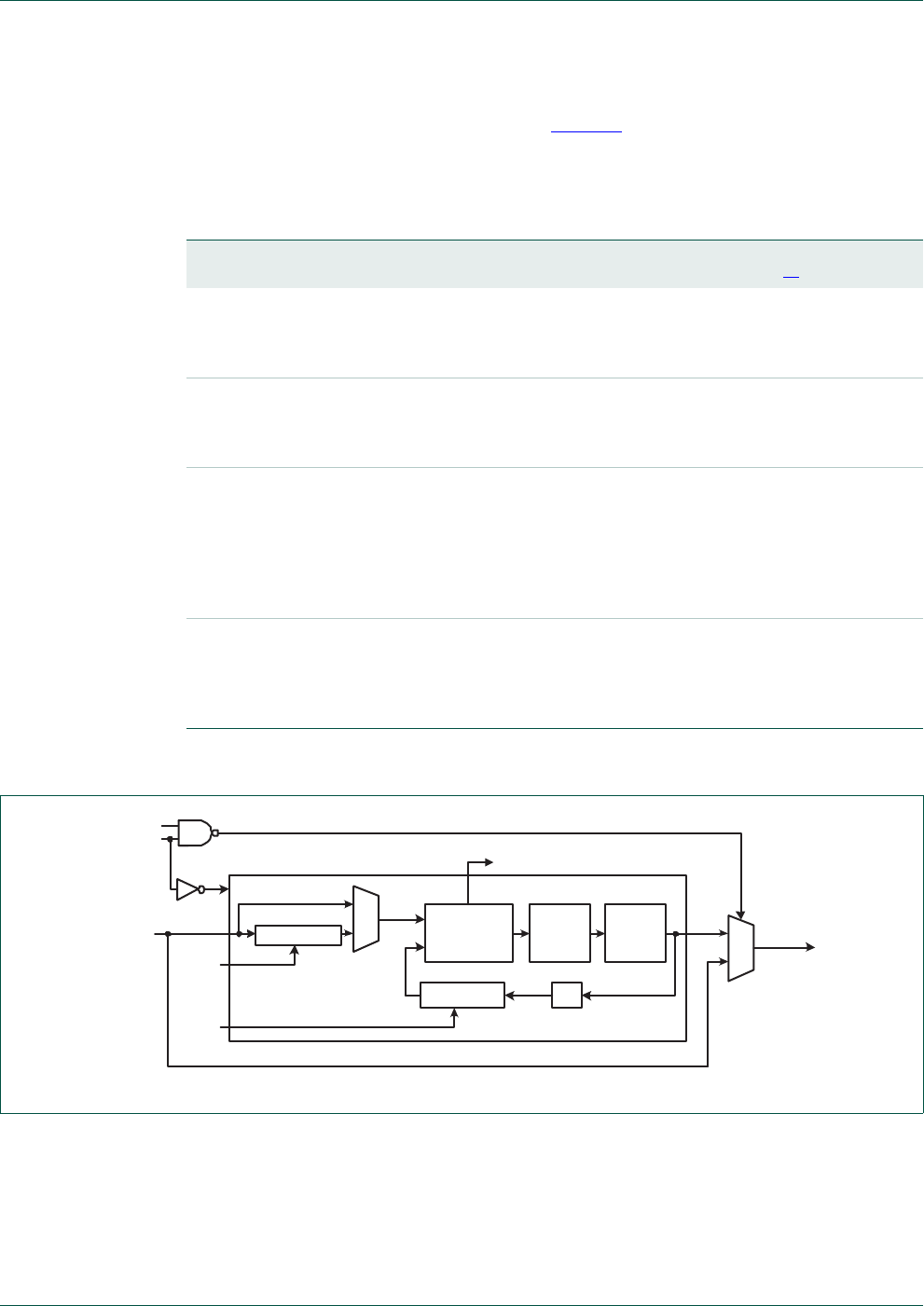
UM10360 All information provided in this document is subject to legal disclaimers. © NXP B.V. 2014. All rights reserved.
User manual Rev. 3.1 — 2 April 2014 37 of 849
NXP Semiconductors UM10360
Chapter 4: LPC176x/5x Clocking and power control
4.5.2 PLL0 register description
PLL0 is controlled by the registers shown in Tab l e 1 8. More detailed descriptions follow.
Warning: Improper setting of PLL0 values may result in incorrect operation of the
device!
[1] Reset Value reflects the data stored in used bits only. It does not include reserved bits content.
4.5.3 PLL0 Control register (PLL0CON - 0x400F C080)
The PLL0CON register contains the bits that enable and connect PLL0. Enabling PLL0
allows it to attempt to lock to the current settings of the multiplier and divider values.
Connecting PLL0 causes the processor and most chip functions to run from the PLL0
output clock. Changes to the PLL0CON register do not take effect until a correct PLL0
Table 18. PLL0 registers
Name Description Access Reset
value[1]
Address
PLL0CON PLL0 Control Register. Holding register for
updating PLL0 control bits. Values written to this
register do not take effect until a valid PLL0 feed
sequence has taken place.
R/W 0 0x400F C080
PLL0CFG PLL0 Configuration Register. Holding register for
updating PLL0 configuration values. Values
written to this register do not take effect until a
valid PLL0 feed sequence has taken place.
R/W 0 0x400F C084
PLL0STAT PLL0 Status Register. Read-back register for
PLL0 control and configuration information. If
PLL0CON or PLL0CFG have been written to, but
a PLL0 feed sequence has not yet occurred, they
will not reflect the current PLL0 state. Reading
this register provides the actual values controlling
the PLL0, as well as the PLL0 status.
RO 0 0x400F C088
PLL0FEED PLL0 Feed Register. This register enables
loading of the PLL0 control and configuration
information from the PLL0CON and PLL0CFG
registers into the shadow registers that actually
affect PLL0 operation.
WO NA 0x400F C08C
Fig 9. PLL0 block diagram
N-DIVIDER
M-DIVIDER
NSEL
[7:0]
PHASE-
FREQUENCY
DETECTOR
FILTER CCO
/2
MSEL
[14:0]
PLOCK
PLLE
PLLC
pd
refclk
pllclkin pllclk

UM10360 All information provided in this document is subject to legal disclaimers. © NXP B.V. 2014. All rights reserved.
User manual Rev. 3.1 — 2 April 2014 38 of 849
NXP Semiconductors UM10360
Chapter 4: LPC176x/5x Clocking and power control
feed sequence has been given (see Section 4.5.8 “PLL0 Feed register (PLL0FEED -
0x400F C08C)”).
PLL0 must be set up, enabled, and Lock established before it may be used as a clock
source. When switching from the oscillator clock to the PLL0 output or vice versa, internal
circuitry synchronizes the operation in order to ensure that glitches are not generated.
Hardware does not insure that PLL0 is locked before it is connected or automatically
disconnect PLL0 if lock is lost during operation. In the event of loss of lock on PLL0, it is
likely that the oscillator clock has become unstable and disconnecting PLL0 will not
remedy the situation.
4.5.4 PLL0 Configuration register (PLL0CFG - 0x400F C084)
The PLL0CFG register contains PLL0 multiplier and divider values. Changes to the
PLL0CFG register do not take effect until a correct PLL feed sequence has been given
(see Section 4.5.8 “PLL0 Feed register (PLL0FEED - 0x400F C08C)”). Calculations for
the PLL frequency, and multiplier and divider values are found in the Section 4.5.10 “PLL0
frequency calculation”.
Table 19. PLL Control register (PLL0CON - address 0x400F C080) bit description
Bit Symbol Description Reset
value
0PLLE0PLL0 Enable. When one, and after a valid PLL0 feed, this bit will activate
PLL0 and allow it to lock to the requested frequency. See PLL0STAT
register, Ta b l e 22.
0
1PLLC0PLL0 Connect. Setting PLLC0 to one after PLL0 has been enabled and
locked, then followed by a valid PLL0 feed sequence causes PLL0 to
become the clock source for the CPU, AHB peripherals, and used to
derive the clocks for APB peripherals. The PLL0 output may potentially
be used to clock the USB subsystem if the frequency is 48 MHz. See
PLL0STAT register, Tabl e 2 2 .
0
31:2 - Reserved, user software should not write ones to reserved bits. The
value read from a reserved bit is not defined.
NA
Table 20. PLL0 Configuration register (PLL0CFG - address 0x400F C084) bit description
Bit Symbol Description Reset
value
14:0 MSEL0 PLL0 Multiplier value. Supplies the value "M" in PLL0 frequency
calculations. The value stored here is M - 1. Supported values for M
are 6 through 512 and those listed in Tab l e 2 1 .
Note: Not all values of M are needed, and therefore some are not
supported by hardware. For details on selecting values for MSEL0 see
Section 4.5.10 “PLL0 frequency calculation”.
0
15 - Reserved, user software should not write ones to reserved bits. The
value read from a reserved bit is not defined.
NA
23:16 NSEL0 PLL0 Pre-Divider value. Supplies the value "N" in PLL0 frequency
calculations. The value stored here is N - 1. Supported values for N are
1 through 32.
Note: For details on selecting the right value for NSEL0 see
Section 4.5.10 “PLL0 frequency calculation”.
0
31:24 - Reserved, user software should not write ones to reserved bits. The
value read from a reserved bit is not defined.
NA

UM10360 All information provided in this document is subject to legal disclaimers. © NXP B.V. 2014. All rights reserved.
User manual Rev. 3.1 — 2 April 2014 39 of 849
NXP Semiconductors UM10360
Chapter 4: LPC176x/5x Clocking and power control
4.5.5 PLL0 Status register (PLL0STAT - 0x400F C088)
The read-only PLL0STAT register provides the actual PLL0 parameters that are in effect
at the time it is read, as well as PLL0 status. PLL0STAT may disagree with values found in
PLL0CON and PLL0CFG because changes to those registers do not take effect until a
Table 21. Multiplier values for PLL0 with a 32 kHz input
Multiplier
(M)
Pre-divide
(N)
FCCO Multiplier
(M)
Pre-divide
(N)
FCCO
4272 1 279.9698 12085 2 396.0013
4395 1 288.0307 12207 2 399.9990
4578 1 300.0238 12817 2 419.9875
4725 1 309.6576 12817 3 279.9916
4807 1 315.0316 13184 2 432.0133
5127 1 336.0031 13184 3 288.0089
5188 1 340.0008 13672 2 448.0041
5400 1 353.8944 13733 2 450.0029
5493 1 359.9892 13733 3 300.0020
5859 1 383.9754 13916 2 455.9995
6042 1 395.9685 14099 2 461.9960
6075 1 398.1312 14420 3 315.0097
6104 1 400.0317 14648 2 479.9857
6409 1 420.0202 15381 2 504.0046
6592 1 432.0133 15381 3 336.0031
6750 1 442.3680 15564 3 340.0008
6836 1 448.0041 15625 2 512.0000
6866 1 449.9702 15869 2 519.9954
6958 1 455.9995 16113 2 527.9908
7050 1 462.0288 16479 3 359.9892
7324 1 479.9857 17578 3 383.9973
7425 1 486.6048 18127 3 395.9904
7690 1 503.9718 18311 3 400.0099
7813 1 512.0328 19226 3 419.9984
7935 1 520.0282 19775 3 431.9915
8057 1 528.0236 20508 3 448.0041
8100 1 530.8416 20599 3 449.9920
8545 2 280.0026 20874 3 455.9995
8789 2 287.9980 21149 3 462.0070
9155 2 299.9910 21973 3 480.0075
9613 2 314.9988 23071 3 503.9937
10254 2 336.0031 23438 3 512.0109
10376 2 340.0008 23804 3 520.0063
10986 2 359.9892 24170 3 528.0017
11719 2 384.0082

UM10360 All information provided in this document is subject to legal disclaimers. © NXP B.V. 2014. All rights reserved.
User manual Rev. 3.1 — 2 April 2014 40 of 849
NXP Semiconductors UM10360
Chapter 4: LPC176x/5x Clocking and power control
proper PLL0 feed has occurred (see Section 4.5.8 “PLL0 Feed register (PLL0FEED -
0x400F C08C)”).
4.5.6 PLL0 Interrupt: PLOCK0
The PLOCK0 bit in the PLL0STAT register reflects the lock status of PLL0. When PLL0 is
enabled, or parameters are changed, PLL0 requires some time to establish lock under the
new conditions. PLOCK0 can be monitored to determine when PLL0 may be connected
for use. The value of PLOCK0 may not be stable when the PLL reference frequency
(FREF, the frequency of REFCLK, which is equal to the PLL input frequency divided by the
pre-divider value) is less than 100 kHz or greater than 20 MHz. In these cases, the PLL
may be assumed to be stable after a start-up time has passed. This time is 500 s when
FREF is greater than 400 kHz and 200 / FREF seconds when FREF is less than 400 kHz
PLOCK0 is connected to the interrupt controller. This allows for software to turn on PLL0
and continue with other functions without having to wait for PLL0 to achieve lock. When
the interrupt occurs, PLL0 may be connected, and the interrupt disabled. PLOCK0
appears as interrupt 32 in Tab l e 50 . Note that PLOCK0 remains asserted whenever PLL0
is locked, so if the interrupt is used, the interrupt service routine must disable the PLOCK0
interrupt prior to exiting.
4.5.7 PLL0 Modes
The combinations of PLLE0 and PLLC0 are shown in Tabl e 2 3.
Table 22. PLL Status register (PLL0STAT - address 0x400F C088) bit description
Bit Symbol Description Reset
value
14:0 MSEL0 Read-back for the PLL0 Multiplier value. This is the value currently
used by PLL0, and is one less than the actual multiplier.
0
15 - Reserved, user software should not write ones to reserved bits.
The value read from a reserved bit is not defined.
NA
23:16 NSEL0 Read-back for the PLL0 Pre-Divider value. This is the value
currently used by PLL0, and is one less than the actual divider.
0
24 PLLE0_STAT Read-back for the PLL0 Enable bit. This bit reflects the state of the
PLEC0 bit in PLL0CON (see Ta b le 19) after a valid PLL0 feed.
When one, PLL0 is currently enabled. When zero, PLL0 is turned
off. This bit is automatically cleared when Power-down mode is
entered.
0
25 PLLC0_STAT Read-back for the PLL0 Connect bit. This bit reflects the state of
the PLLC0 bit in PLL0CON (see Tab l e 19) after a valid PLL0 feed.
When PLLC0 and PLLE0 are both one, PLL0 is connected as the
clock source for the CPU. When either PLLC0 or PLLE0 is zero,
PLL0 is bypassed. This bit is automatically cleared when
Power-down mode is entered.
0
26 PLOCK0 Reflects the PLL0 Lock status. When zero, PLL0 is not locked.
When one, PLL0 is locked onto the requested frequency. See text
for details.
0
31:27 - Reserved, user software should not write ones to reserved bits.
The value read from a reserved bit is not defined.
NA

UM10360 All information provided in this document is subject to legal disclaimers. © NXP B.V. 2014. All rights reserved.
User manual Rev. 3.1 — 2 April 2014 41 of 849
NXP Semiconductors UM10360
Chapter 4: LPC176x/5x Clocking and power control
4.5.8 PLL0 Feed register (PLL0FEED - 0x400F C08C)
A correct feed sequence must be written to the PLL0FEED register in order for changes to
the PLL0CON and PLL0CFG registers to take effect. The feed sequence is:
1. Write the value 0xAA to PLL0FEED.
2. Write the value 0x55 to PLL0FEED.
The two writes must be in the correct sequence, and there must be no other register
access in the same address space (0x400F C000 to 0x400F FFFF) between them.
Because of this, it may be necessary to disable interrupts for the duration of the PLL0 feed
operation, if there is a possibility that an interrupt service routine could write to another
register in that space. If either of the feed values is incorrect, or one of the previously
mentioned conditions is not met, any changes to the PLL0CON or PLL0CFG register will
not become effective.
4.5.9 PLL0 and Power-down mode
Power-down mode automatically turns off and disconnects PLL0. Wake-up from
Power-down mode does not automatically restore PLL0 settings, this must be done in
software. Typically, a routine to activate PLL0, wait for lock, and then connect PLL0 can be
called at the beginning of any interrupt service routine that might be called due to the
wake-up. It is important not to attempt to restart PLL0 by simply feeding it when execution
resumes after a wake-up from Power-down mode. This would enable and connect PLL0
at the same time, before PLL lock is established.
4.5.10 PLL0 frequency calculation
PLL0 equations use the following parameters:
Table 23. PLL control bit combinations
PLLC0 PLLE0 PLL Function
0 0 PLL0 is turned off and disconnected. PLL0 outputs the unmodified clock input.
01PLL0 is active, but not yet connected. PLL0 can be connected after PLOCK0 is
asserted.
10Same as 00 combination. This prevents the possibility of PLL0 being connected
without also being enabled.
11PLL0 is active and has been connected as the system clock source.
Table 24. PLL Feed register (PLL0FEED - address 0x400F C08C) bit description
Bit Symbol Description Reset
value
7:0 PLL0FEED The PLL0 feed sequence must be written to this register in order for
PLL0 configuration and control register changes to take effect.
0x00
31:8 - Reserved, user software should not write ones to reserved bits. The
value read from a reserved bit is not defined.
NA

UM10360 All information provided in this document is subject to legal disclaimers. © NXP B.V. 2014. All rights reserved.
User manual Rev. 3.1 — 2 April 2014 42 of 849
NXP Semiconductors UM10360
Chapter 4: LPC176x/5x Clocking and power control
The PLL0 output frequency (when PLL0 is both active and connected) is given by:
FCCO = (2 M FIN) / N
PLL inputs and settings must meet the following:
•FIN is in the range of 32 kHz to 50 MHz.
•FCCO is in the range of 275 MHz to 550 MHz.
The equation can be solved for other PLL parameters:
M = (FCCO N) / (2 FIN)
N = (2 M FIN) / FCCO
FIN = (FCCO N) / (2 M)
Allowed values for M:
At higher oscillator frequencies, in the MHz range, values of M from 6 through 512 are
allowed. This supports the entire useful range of both the main oscillator and the IRC.
For lower frequencies, specifically when the RTC is used to clock PLL0, a set of 65
additional M values have been selected for supporting baud rate generation, CAN
operation, and obtaining integer MHz frequencies. These values are shown in Tab le 2 6 .
Table 25. PLL frequency parameter
Parameter Description
FIN the frequency of PLLCLKIN from the Clock Source Selection Multiplexer.
FCCO the frequency of the PLLCLK (output of the PLL Current Controlled Oscillator)
NPLL0 Pre-divider value from the NSEL0 bits in the PLL0CFG register (PLL0CFG
NSEL0 field + 1). N is an integer from 1 through 32.
MPLL0 Multiplier value from the MSEL0 bits in the PLL0CFG register (PLL0CFG
MSEL0 field + 1). Not all potential values are supported. See below.
FREF PLL internal reference frequency, FIN divided by N.
Table 26. Additional Multiplier Values for use with a Low Frequency Clock Input
Low Frequency PLL Multipliers
4272 4395 4578 4725 4807
5127 5188 5400 5493 5859
6042 6075 6104 6409 6592
6750 6836 6866 6958 7050
7324 7425 7690 7813 7935
8057 8100 8545 8789 9155
9613 10254 10376 10986 11719
12085 12207 12817 13184 13672
13733 13916 14099 14420 14648
15381 15564 15625 15869 16113

UM10360 All information provided in this document is subject to legal disclaimers. © NXP B.V. 2014. All rights reserved.
User manual Rev. 3.1 — 2 April 2014 43 of 849
NXP Semiconductors UM10360
Chapter 4: LPC176x/5x Clocking and power control
4.5.11 Procedure for determining PLL0 settings
PLL0 parameter determination can be simplified by using a spreadsheet available from
NXP. To determine PLL0 parameters by hand, the following general procedure may be
used:
1. Determine if the application requires use of the USB interface, and whether it will be
clocked from PLL0. The USB requires a 50% duty cycle clock of 48 MHz within a very
small tolerance, which means that FCCO must be an even integer multiple of 48 MHz
(i.e. an integer multiple of 96 MHz), within a very small tolerance.
2. Choose the desired processor operating frequency (CCLK). This may be based on
processor throughput requirements, need to support a specific set of UART baud
rates, etc. Bear in mind that peripheral devices may be running from a lower clock
frequency than that of the processor (see Section 4.7 “Clock dividers” on page 55 and
Section 4.8 “Power control” on page 59). Find a value for FCCO that is close to a
multiple of the desired CCLK frequency, bearing in mind the requirement for USB
support in [1] above, and that lower values of FCCO result in lower power dissipation.
3. Choose a value for the PLL input frequency (FIN). This can be a clock obtained from
the main oscillator, the RTC oscillator, or the on-chip RC oscillator. For USB support,
the main oscillator should be used. Bear in mind that if PLL1 rather than PLL0 is used
to clock the USB subsystem, this affects the choice of the main oscillator frequency.
4. Calculate values for M and N to produce a sufficiently accurate FCCO frequency. The
desired M value -1 will be written to the MSEL0 field in PLL0CFG. The desired N value
-1 will be written to the NSEL0 field in PLL0CFG.
In general, it is better to use a smaller value for N, to reduce the level of multiplication that
must be accomplished by the CCO. Due to the difficulty in finding the best values in some
cases, it is recommended to use a spreadsheet or similar method to show many
possibilities at once, from which an overall best choice may be selected. A spreadsheet is
available from NXP for this purpose.
16479 17578 18127 18311 19226
19775 20508 20599 20874 21149
21973 23071 23438 23804 24170
Table 26. Additional Multiplier Values for use with a Low Frequency Clock Input
Low Frequency PLL Multipliers

UM10360 All information provided in this document is subject to legal disclaimers. © NXP B.V. 2014. All rights reserved.
User manual Rev. 3.1 — 2 April 2014 44 of 849
NXP Semiconductors UM10360
Chapter 4: LPC176x/5x Clocking and power control
4.5.12 Examples of PLL0 settings
The following table gives a summary of examples that illustrate selecting PLL0 values
based on different system requirements.
Example 1
Assumptions:
•The USB interface will not be used in the application, or will be clocked by PLL1.
•The desired CPU rate is 100 MHz.
•An external 10 MHz crystal or clock source will be used as the system clock source.
Calculations:
M = (FCCO N) / (2 FIN)
A smaller value for the PLL pre-divide (N) as well as a smaller value of the multiplier (M),
both result in better PLL operational stability and lower output jitter. Lower values of FCCO
also save power. So, the process of determining PLL setup parameters involves looking
for the smallest N and M values giving the lowest FCCO value that will support the required
CPU and/or USB clocks. It is usually easier to work backward from the desired output
clock rate and determine a target FCCO rate, then find a way to obtain that FCCO rate from
the available input clock.
Potential precise values of FCCO are integer multiples of the desired CPU clock. In this
example, it is clear that the smallest frequency for FCCO that can produce the desired CPU
clock rate and is within the PLL0 operating range of 275 to 550 MHz is 300 MHz
(3 ´ 100 MHz).
Assuming that the PLL pre-divide is 1 (N = 1), the equation above gives
M=((300´10
6´1)/(210 ´ 106) = 300 / 20 = 15. Since the result is an integer, there is
no need to look any further for a good set of PLL0 configuration values. The value written
to PLL0CFG would be 0x0E (N - 1 = 0; M - 1 = 14 gives 0x0E).
The PLL output must be further divided in order to produce the CPU clock. This is
accomplished using a separate divider that is described later in this chapter, see
Section 4.7.1.
Table 27. Summary of PLL0 examples
Example Description
1• The PLL0 clock source is 10 MHz.
• PLL0 is not used as the USB clock source, or the USB interface is not used.
• The desired CPU clock is 100 MHz.
2• The PLL0 clock source is 4 MHz.
• PLL0 is used as the USB clock source.
• The desired CPU clock is 60 MHz.
3• The PLL0 clock source is the 32.768 kHz RTC clock.
• PLL0 is not used as the USB clock source, or the USB interface is not used.
• The desired CPU clock is 72 MHz.

UM10360 All information provided in this document is subject to legal disclaimers. © NXP B.V. 2014. All rights reserved.
User manual Rev. 3.1 — 2 April 2014 45 of 849
NXP Semiconductors UM10360
Chapter 4: LPC176x/5x Clocking and power control
Example 2
Assumptions:
•The USB interface will be used in the application and will be clocked from PLL0.
•The desired CPU rate is 60 MHz.
•An external 4 MHz crystal or clock source will be used as the system clock source.
This clock source could be the Internal RC oscillator (IRC).
Calculations:
M = (FCCO N) / (2 FIN)
Because supporting USB requires a precise 48 MHz clock with a 50% duty cycle, that
need must be addressed first. Potential precise values of FCCO are integer multiples of the
2 ´ the 48 MHz USB clock. The 2 ´ insures that the clock has a 50% duty cycle, which
would not be the case for a division of the PLL output by an odd number.
The possibilities for the FCCO rate when the USB is used are 288 MHz, 384 MHz, and 480
MHz. The smallest frequency for FCCO that can produce a valid USB clock rate and is
within the PLL0 operating range is 288 MHz (3 ´ 2 ´ 48 MHz).
Start by assuming N = 1, since this produces the smallest multiplier needed for PLL0. So,
M=((288´10
6) ´ 1) /(2(4 ´ 106)) = 288 / 8 = 36. The result is an integer, which is
necessary to obtain a precise USB clock. The value written to PLL0CFG would be 0x23
(N - 1 = 0; M - 1 = 35 = 0x23).
The potential CPU clock rate can be determined by dividing FCCO by the desired CPU
frequency: 288 ´ 106 / 60 ´ 106= 4.8. The nearest integer value for the CPU Clock Divider
is then 5, giving us 57.6 MHz as the nearest value to the desired CPU clock rate.
If it is important to obtain exactly 60 MHz, an FCCO rate must be found that can be divided
down to both 48 MHz and 60 MHz. As previously noted, the possibilities for the FCCO rate
when the USB is used are 288 MHz, 384 MHz, and 480 MHz. Of these, only is 480 MHz is
also evenly divisible by 60. Divided by 10, this gives the 48 MHz with a 50% duty cycle
needed by the USB subsystem. Divided by 8, it gives 60 MHz for the CPU clock. PLL0
settings for 480 MHz are N = 1 and M = 60.
The PLL output must be further divided in order to produce both the CPU clock and the
USB clock. This is accomplished using separate dividers that are described later in this
chapter. See Section 4.7.1 and Section 4.7.2.

UM10360 All information provided in this document is subject to legal disclaimers. © NXP B.V. 2014. All rights reserved.
User manual Rev. 3.1 — 2 April 2014 46 of 849
NXP Semiconductors UM10360
Chapter 4: LPC176x/5x Clocking and power control
Example 3
Assumptions:
•The USB interface will not be used in the application, or will be clocked by PLL1.
•The desired CPU rate is 72 MHz
•The 32.768 kHz RTC clock source will be used as the system clock source
Calculations:
M = (FCCO N) / (2 FIN)
The smallest integer multiple of the desired CPU clock rate that is within the PLL0
operating range is 288 MHz (4 ´ 72 MHz).
Using the equation above and assuming that N = 1, M = ((288 ´ 106) ´ 1) /(232,768) =
4,394.53125. This is not an integer, so the CPU frequency will not be exactly 72 MHz with
this setting. Since this example is less obvious, it may be useful to make a table of
possibilities for different values of N (see below).
Beyond N = 5, the value of M is out of range or not supported, so the table stops at that
point. In the third column of the table, the calculated M value is rounded to the nearest
integer. If this results in CCLK being above the maximum operating frequency, it is
allowed if it is not more than 1/2 above the maximum frequency.
In general, larger values of FREF result in a more stable PLL when the input clock is a low
frequency. Even the first table entry shows a very small error of just over 1 hundredth of a
percent, or 107 parts per million (ppm). If that is not accurate enough in the application,
the second case gives a much smaller error of 7 ppm. There are no allowed combinations
that give a smaller error than that.
Remember that when a frequency below about 1 MHz is used as the PLL0 clock source,
not all multiplier values are available. As it turns out, all of the rounded M values found in
Tab l e 2 8 of this example are supported, which may be confirmed in Tab le 26 . If PLL0
calculations suggest use of unsupported multiplier values, those values must be
disregarded and other values examined to find the best fit.
The value written to PLL0CFG for the second table entry would be 0x12254
(N - 1 = 1 = 0x1; M - 1 = 8788 = 0x2254).
The PLL output must be further divided in order to produce the CPU clock. This is
accomplished using a separate divider that is described later in this chapter, see
Section 4.7.1.
Table 28. Potential values for PLL example
N M M Rounded FREF in
Hz (FIN /
N)
FCCO in
MHz (FREF x
M)
CCLK in MHz
(FCCO / 4)
Error
(CCLK-72) / 72
14394.53125 4395 32768 288.0307 72.0077 0.0107
28789.0625 8789 16384 287.9980 71.9995 -0.0007
313183.5937513184 10922.67288.0089 72.0022 0.0031
417578.125 17578 8192 287.9980 71.9995 -0.0007
521972.6562521973 6553.6 288.0045 72.0011 0.0016

UM10360 All information provided in this document is subject to legal disclaimers. © NXP B.V. 2014. All rights reserved.
User manual Rev. 3.1 — 2 April 2014 47 of 849
NXP Semiconductors UM10360
Chapter 4: LPC176x/5x Clocking and power control
4.5.13 PLL0 setup sequence
The following sequence must be followed step by step in order to have PLL0 initialized
and running:
1. Disconnect PLL0 with one feed sequence if PLL0 is already connected.
2. Disable PLL0 with one feed sequence.
3. Change the CPU Clock Divider setting to speed up operation without PLL0, if desired.
4. Write to the Clock Source Selection Control register to change the clock source if
needed.
5. Write to the PLL0CFG and make it effective with one feed sequence. The PLL0CFG
can only be updated when PLL0 is disabled.
6. Enable PLL0 with one feed sequence.
7. Change the CPU Clock Divider setting for the operation with PLL0. It is critical to do
this before connecting PLL0.
8. Wait for PLL0 to achieve lock by monitoring the PLOCK0 bit in the PLL0STAT register,
or using the PLOCK0 interrupt, or wait for a fixed time when the input clock to PLL0 is
slow (i.e. 32 kHz). The value of PLOCK0 may not be stable when the PLL reference
frequency (FREF, the frequency of REFCLK, which is equal to the PLL input
frequency divided by the pre-divider value) is less than 100 kHz or greater than
20 MHz. In these cases, the PLL may be assumed to be stable after a start-up time
has passed. This time is 500 µs when FREF is greater than 400 kHz and 200 / FREF
seconds when FREF is less than 400 kHz.
9. Connect PLL0 with one feed sequence.
It is very important not to merge any steps above. For example, do not update the
PLL0CFG and enable PLL0 simultaneously with the same feed sequence.

UM10360 All information provided in this document is subject to legal disclaimers. © NXP B.V. 2014. All rights reserved.
User manual Rev. 3.1 — 2 April 2014 48 of 849
NXP Semiconductors UM10360
Chapter 4: LPC176x/5x Clocking and power control
4.6 PLL1 (Phase Locked Loop 1)
PLL1 receives its clock input from the main oscillator only and can be used to provide a
fixed 48 MHz clock only to the USB subsystem. This is an option in addition to the
possibility of generating the USB clock from PLL0.
PLL1 is disabled and powered off on reset. If PLL1 is left disabled, the USB clock can be
supplied by PLL0 if everything is set up to provide 48 MHz through that route. If PLL1 is
enabled and connected via the PLL1CON register (see Section 4.6.2), it is automatically
selected to drive the USB subsystem (see Figure 7).
PLL1 activation is controlled via the PLL1CON register. PLL1 multiplier and divider values
are controlled by the PLL1CFG register. These two registers are protected in order to
prevent accidental alteration of PLL1 parameters or deactivation of PLL1. The protection
is accomplished by a feed sequence similar to that of the Watchdog Timer. Details are
provided in the description of the PLL1FEED register.
PLL1 accepts an input clock frequency in the range of 10 MHz to 25 MHz only. The input
frequency is multiplied up to the range of 48 MHz for the USB clock using a Current
Controlled Oscillator (CCO). The multiplier can be an integer value from 1 to 32 (for USB,
the multiplier value cannot be higher than 4. The CCO operates in the range of 156 MHz
to 320 MHz, so there is an additional divider in the loop to keep the CCO within its
frequency range while PLL1 is providing the desired output frequency. The output divider
may be set to divide by 2, 4, 8, or 16 to produce the output clock. Since the minimum
output divider value is 2, it is insured that the output of PLL1 has a 50% duty cycle. A
block diagram of PLL1 is shown in Figure 10.
4.6.1 PLL1 register description
PLL1 is controlled by the registers shown in Tab l e 2 9. More detailed descriptions follow.
Writes to any unused bits are ignored. A read of any unused bits will return a logic zero.
Warning: Improper setting of PLL1 values may result in incorrect operation of the
USB subsystem!
Table 29. PLL1 registers
Name Description Access Reset
value[1]
Address
PLL1CON PLL1 Control Register. Holding register for
updating PLL1 control bits. Values written to this
register do not take effect until a valid PLL1 feed
sequence has taken place.
R/W 0 0x400F C0A0
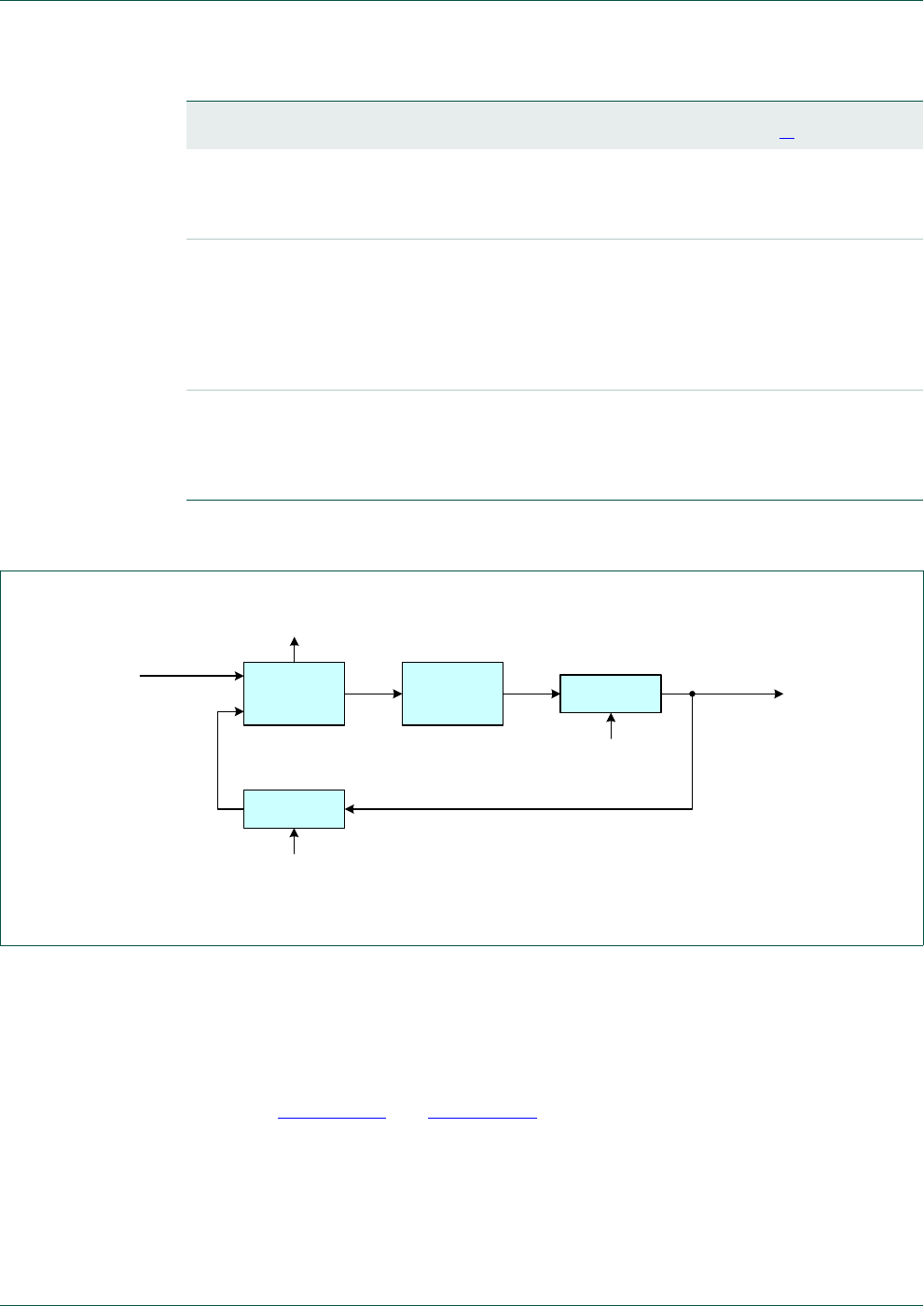
UM10360 All information provided in this document is subject to legal disclaimers. © NXP B.V. 2014. All rights reserved.
User manual Rev. 3.1 — 2 April 2014 49 of 849
NXP Semiconductors UM10360
Chapter 4: LPC176x/5x Clocking and power control
[1] Reset Value reflects the data stored in used bits only. It does not include reserved bits content.
4.6.2 PLL1 Control register (PLL1CON - 0x400F C0A0)
The PLL1CON register contains the bits that enable and connect PLL1. Enabling PLL1
allows it to attempt to lock to the current settings of the multiplier and divider values.
Connecting PLL1 causes the USB subsystem to run from the PLL1 output clock. Changes
to the PLL1CON register do not take effect until a correct PLL feed sequence has been
given (see Section 4.6.6 and Section 4.6.3).
PLL1CFG PLL1 Configuration Register. Holding register
for updating PLL1 configuration values. Values
written to this register do not take effect until a
valid PLL1 feed sequence has taken place.
R/W 0 0x400F C0A4
PLL1STAT PLL1 Status Register. Read-back register for
PLL1 control and configuration information. If
PLL1CON or PLL1CFG have been written to,
but a PLL1 feed sequence has not yet occurred,
they will not reflect the current PLL1 state.
Reading this register provides the actual values
controlling PLL1, as well as PLL1 status.
RO 0 0x400F C0A8
PLL1FEED PLL1 Feed Register. This register enables
loading of PLL1 control and configuration
information from the PLL1CON and PLL1CFG
registers into the shadow registers that actually
affect PLL1 operation.
WO NA 0x400F C0AC
Table 29. PLL1 registers
Name Description Access Reset
value[1]
Address
Fig 10. PLL1 block diagram
100416
PLL output
clock
Divide by 2P
Phase
Detector
PLOCK
PLLSTAT[10]
Current-
Controlled
Oscillator
Fcco
PSEL
PLLSTAT[6:5]
PLL input
clock
Divide by M
MSEL
PLLSTAT[4:0]

UM10360 All information provided in this document is subject to legal disclaimers. © NXP B.V. 2014. All rights reserved.
User manual Rev. 3.1 — 2 April 2014 50 of 849
NXP Semiconductors UM10360
Chapter 4: LPC176x/5x Clocking and power control
PLL1 must be set up, enabled, and lock established before it may be used as a clock
source for the USB subsystem. The hardware does not insure that the PLL is locked
before it is connected nor does it automatically disconnect the PLL if lock is lost during
operation.
4.6.3 PLL1 Configuration register (PLL1CFG - 0x400F C0A4)
The PLL1CFG register contains the PLL1 multiplier and divider values. Changes to the
PLL1CFG register do not take effect until a correct PLL1 feed sequence has been given
(see Section 4.6.6). Calculations for the PLL1 frequency, and multiplier and divider values
are found in Section 4.6.9.
4.6.4 PLL1 Status register (PLL1STAT - 0x400F C0A8)
The read-only PLL1STAT register provides the actual PLL1 parameters that are in effect
at the time it is read, as well as the PLL1 status. PLL1STAT may disagree with values
found in PLL1CON and PLL1CFG because changes to those registers do not take effect
until a proper PLL1 feed has occurred (see Section 4.6.6 “PLL1 Feed register (PLL1FEED
- 0x400F C0AC)”).
Table 30. PLL1 Control register (PLL1CON - address 0x400F C0A0) bit description
Bit Symbol Description Reset
value
0PLLE1PLL1 Enable. When one, and after a valid PLL1 feed, this bit will
activate PLL1 and allow it to lock to the requested frequency. See
PLL1STAT register, Table 3 2 .
0
1PLLC1PLL1 Connect. Setting PLLC to one after PLL1 has been enabled and
locked, then followed by a valid PLL1 feed sequence causes PLL1 to
become the clock source for the USB subsystem via the USB clock
divider. See PLL1STAT register, Ta ble 3 2 .
0
31:2 - Reserved, user software should not write ones to reserved bits. The
value read from a reserved bit is not defined.
NA
Table 31. PLL Configuration register (PLL1CFG - address 0x400F C0A4) bit description
Bit Symbol Description Reset
value
4:0 MSEL1 PLL1 Multiplier value. Supplies the value "M" in the PLL1 frequency
calculations.
Note: For details on selecting the right value for MSEL1 see
Section 4.6.8.
0
6:5 PSEL1 PLL1 Divider value. Supplies the value "P" in the PLL1 frequency
calculations.
Note: For details on selecting the right value for PSEL1 see
Section 4.6.8.
0
31:7 - Reserved, user software should not write ones to reserved bits. The
value read from a reserved bit is not defined.
NA

UM10360 All information provided in this document is subject to legal disclaimers. © NXP B.V. 2014. All rights reserved.
User manual Rev. 3.1 — 2 April 2014 51 of 849
NXP Semiconductors UM10360
Chapter 4: LPC176x/5x Clocking and power control
4.6.4.1 PLL1 modes
The combinations of PLLE1 and PLLC1 are shown in Tabl e 3 3.
4.6.5 PLL1 Interrupt: PLOCK1
The PLOCK1 bit in the PLL1STAT register reflects the lock status of PLL1. When PLL1 is
enabled, or parameters are changed, the PLL requires some time to establish lock under
the new conditions. PLOCK1 can be monitored to determine when the PLL may be
connected for use.
PLOCK1 is connected to the interrupt controller. This allows for software to turn on the
PLL and continue with other functions without having to wait for the PLL to achieve lock.
When the interrupt occurs, the PLL may be connected, and the interrupt disabled.
PLOCK1 appears as interrupt 48 in Tab l e 50 . Note that PLOCK1 remains asserted
whenever PLL1 is locked, so if the interrupt is used, the interrupt service routine must
disable the PLOCK1 interrupt prior to exiting.
Table 32. PLL1 Status register (PLL1STAT - address 0x400F C0A8) bit description
Bit Symbol Description Reset
value
4:0 MSEL1 Read-back for the PLL1 Multiplier value. This is the value currently
used by PLL1.
0
6:5 PSEL1 Read-back for the PLL1 Divider value. This is the value currently
used by PLL1.
0
7- Reserved, user software should not write ones to reserved bits.
The value read from a reserved bit is not defined.
NA
8PLLE1_STATRead-back for the PLL1 Enable bit. When one, PLL1 is currently
activated. When zero, PLL1 is turned off. This bit is automatically
cleared when Power-down mode is activated.
0
9PLLC1_STATRead-back for the PLL1 Connect bit. When PLLC and PLLE are
both one, PLL1 is connected as the clock source for the
microcontroller. When either PLLC or PLLE is zero, PLL1 is
bypassed and the oscillator clock is used directly by the
microcontroller. This bit is automatically cleared when Power-down
mode is activated.
0
10 PLOCK1 Reflects the PLL1 Lock status. When zero, PLL1 is not locked.
When one, PLL1 is locked onto the requested frequency.
0
31:11 - Reserved, user software should not write ones to reserved bits.
The value read from a reserved bit is not defined.
NA
Table 33. PLL1 control bit combinations
PLLC1 PLLE1 PLL1 Function
00PLL1 is turned off and disconnected.
01PLL1 is active, but not yet connected. PLL1 can be connected after PLOCK1
is asserted.
10Same as 00 combination. This prevents the possibility of PLL1 being
connected without also being enabled.
11PLL1 is active and has been connected. The clock for the USB subsystem is
sourced from PLL1.

UM10360 All information provided in this document is subject to legal disclaimers. © NXP B.V. 2014. All rights reserved.
User manual Rev. 3.1 — 2 April 2014 52 of 849
NXP Semiconductors UM10360
Chapter 4: LPC176x/5x Clocking and power control
4.6.6 PLL1 Feed register (PLL1FEED - 0x400F C0AC)
A correct feed sequence must be written to the PLL1FEED register in order for changes to
the PLL1CON and PLL1CFG registers to take effect. The feed sequence is:
1. Write the value 0xAA to PLL1FEED.
2. Write the value 0x55 to PLL1FEED.
The two writes must be in the correct sequence, and there must be no other register
access in the same address space (0x400F C000 to 0x400F FFFF) between them.
Because of this, it may be necessary to disable interrupts for the duration of the PLL feed
operation, if there is a possibility that an interrupt service routine could write to another
register in that space. If either of the feed values is incorrect, or one of the previously
mentioned conditions is not met, any changes to the PLL1CON or PLL1CFG register will
not become effective.
4.6.7 PLL1 and Power-down mode
Power-down mode automatically turns off and disconnects activated PLL(s). Wake-up
from Power-down mode does not automatically restore PLL settings, this must be done in
software. Typically, a routine to activate the PLL, wait for lock, and then connect the PLL
can be called at the beginning of any interrupt service routine that might be called due to
the wake-up. It is important not to attempt to restart a PLL by simply feeding it when
execution resumes after a wake-up from Power-down mode. This would enable and
connect the PLL at the same time, before PLL lock is established.
If activity on the USB data lines is not selected to wake the microcontroller from
Power-down mode (see Section 4.8.8 for details of wake up from reduced modes), both
the Main PLL (PLL0) and the USB PLL (PLL1) will be automatically be turned off and
disconnected when Power-down mode is invoked, as described above. However, if the
USB activity interrupt is enabled and USB_NEED_CLK = 1 (see Tab l e 1 9 2 for a
description of USB_NEED_CLK), it is not possible to go into Power-down mode and any
attempt to set the PD bit will fail, leaving the PLLs in the current state.
Table 34. PLL1 Feed register (PLL1FEED - address 0x400F C0AC) bit description
Bit Symbol Description Reset
value
7:0 PLL1FEED The PLL1 feed sequence must be written to this register in order for
PLL1 configuration and control register changes to take effect.
0x00
31:8 - Reserved, user software should not write ones to reserved bits. The
value read from a reserved bit is not defined.
NA

UM10360 All information provided in this document is subject to legal disclaimers. © NXP B.V. 2014. All rights reserved.
User manual Rev. 3.1 — 2 April 2014 53 of 849
NXP Semiconductors UM10360
Chapter 4: LPC176x/5x Clocking and power control
4.6.8 PLL1 frequency calculation
The PLL1 equations use the following parameters:
The PLL1 output frequency (when the PLL is both active and connected) is given by:
USBCLK = M FOSC or USBCLK = FCCO / (2 P)
The CCO frequency can be computed as:
FCCO = USBCLK 2 P or FCCO = FOSC ´ M 2 P
The PLL1 inputs and settings must meet the following criteria:
•FOSC is in the range of 10 MHz to 25 MHz.
•USBCLK is 48 MHz.
•FCCO is in the range of 156 MHz to 320 MHz.
4.6.9 Procedure for determining PLL1 settings
The PLL1 configuration for USB may be determined as follows:
1. The desired PLL1 output frequency is USBCLK = 48 MHz.
2. Choose an oscillator frequency (FOSC). USBCLK must be the whole (non-fractional)
multiple of FOSC meaning that the possible values for FOSC are 12 MHz, 16 MHz, and
24 MHz.
3. Calculate the value of M to configure the MSEL1 bits. M = USBCLK / FOSC. In this
case, the possible values for M = 2, 3, or 4 (FOSC = 24 MHz, 16 MHz, or 12 MHz). The
value written to the MSEL1 bits in PLL1CFG is M - 1 (see Tabl e 3 7).
4. Find a value for P to configure the PSEL1 bits, such that FCCO is within its defined
frequency limits of 156 MHz to 320 MHz. FCCO is calculated using FCCO = USBCLK
2 P. It follows that P = 2 is the only P value to yield FCCO in the allowed range. The
value written to the PSEL1 bits in PLL1CFG is ‘01’ for P = 2 (see Table 36 ).
Table 35. Elements determining PLL frequency
Element Description
FOSC the frequency from the crystal oscillator
FCCO the frequency of the PLL1 current controlled oscillator
USBCLK the PLL1 output frequency (48 MHz for USB)
MPLL1 Multiplier value from the MSEL1 bits in the PLL1CFG register
PPLL1 Divider value from the PSEL1 bits in the PLL1CFG register

UM10360 All information provided in this document is subject to legal disclaimers. © NXP B.V. 2014. All rights reserved.
User manual Rev. 3.1 — 2 April 2014 54 of 849
NXP Semiconductors UM10360
Chapter 4: LPC176x/5x Clocking and power control
Table 36. PLL1 Divider values
Values allowed for using PLL1 with USB are highlighted.
PSEL1 Bits (PLL1CFG bits [6:5]) Value of P
00 1
01 2
10 4
11 8
Table 37. PLL1 Multiplier values
Values allowed for using PLL1 with USB are highlighted.
MSEL1 Bits (PLL1CFG bits [4:0]) Value of M
00000 1
00001 2
00010 3
00011 4
... ...
11110 31
11111 32
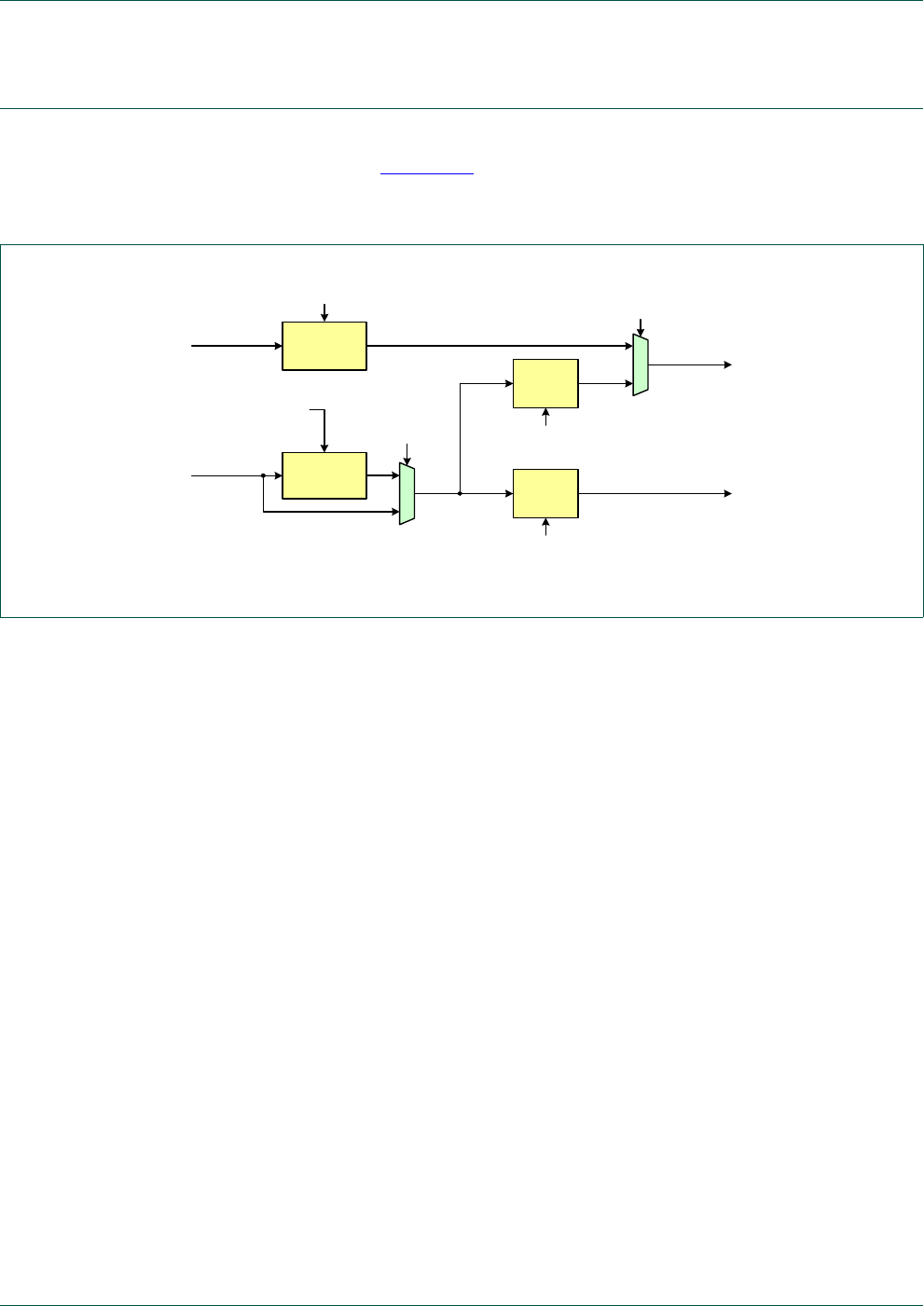
UM10360 All information provided in this document is subject to legal disclaimers. © NXP B.V. 2014. All rights reserved.
User manual Rev. 3.1 — 2 April 2014 55 of 849
NXP Semiconductors UM10360
Chapter 4: LPC176x/5x Clocking and power control
4.7 Clock dividers
The output of the PLL0 must be divided down for use by the CPU and the USB subsystem
(if used with PLL0, see Section 4.6). Separate dividers are provided such that the CPU
frequency can be determined independently from the USB subsystem, which always
requires 48 MHz with a 50% duty cycle for proper operation.
4.7.1 CPU Clock Configuration register (CCLKCFG - 0x400F C104)
The CCLKCFG register controls the division of the PLL0 output before it is used by the
CPU. When PLL0 is bypassed, the division may be by 1. When PLL0 is running, the
output must be divided in order to bring the CPU clock frequency (CCLK) within operating
limits. An 8-bit divider allows a range of options, including slowing CPU operation to a low
rate for temporary power savings without turning off PLL0.
Fig 11. PLLs and clock dividers
USB
Clock
Divider
osc_clk
USB PLL settings
(PLL1...)
USB clock divider setting
USBCLKCFG[3:0]
usb_clk
USB PLL
(PLL1)
main PLL
settings
(PLL0...)
USB PLL select
(PLL1CON)
Main PLL
(PLL0) CPU
Clock
Divider
pllclk
CPU PLL
select
(PLL0CON)
cclk
CPU clock divider setting
CCLKCFG[7:0]
sysclk

UM10360 All information provided in this document is subject to legal disclaimers. © NXP B.V. 2014. All rights reserved.
User manual Rev. 3.1 — 2 April 2014 56 of 849
NXP Semiconductors UM10360
Chapter 4: LPC176x/5x Clocking and power control
The CCLK is derived from the PLL0 output signal, divided by CCLKSEL + 1. Having
CCLKSEL = 2 results in CCLK being one third of the PLL0 output, CCLKSEL = 3 results in
CCLK being one quarter of the PLL0 output, etc.
4.7.2 USB Clock Configuration register (USBCLKCFG - 0x400F C108)
This register is used only if the USB PLL (PLL1) is not connected (via the PLLC1 bit in
PLL1CON). If PLL1 is connected, its output is automatically used as the USB clock
source, and PLL1 must be configured to supply the correct 48 MHz clock to the USB
subsystem. If PLL1 is not connected, the USB subsystem will be driven by PLL0 via the
USB clock divider.
The USBCLKCFG register controls the division of the PLL0 output before it is used by the
USB subsystem.The PLL0 output must be divided in order to bring the USB clock
frequency to 48 MHz with a 50% duty cycle. A 4-bit divider allows obtaining the correct
USB clock from any even multiple of 48 MHz (i.e. any multiple of 96 MHz) within the PLL
operating range.
Remark: The Internal RC oscillator should not be used to drive PLL0 when the USB is
using PLL0 as a clock source because a more precise clock is needed for USB
specification compliance (see Ta b le 17 ).
Table 38. CPU Clock Configuration register (CCLKCFG - address 0x400F C104) bit
description
Bit Symbol Value Description Reset
value
7:0 CCLKSEL Selects the divide value for creating the CPU clock (CCLK)
from the PLL0 output.
0x00
0pllclk is divided by 1 to produce the CPU clock. This setting is
not allowed when the PLL0 is connected, because the rate
would always be greater than the maximum allowed CPU
clock.
1pllclk is divided by 2 to produce the CPU clock. This setting is
not allowed when the PLL0 is connected, because the rate
would always be greater than the maximum allowed CPU
clock.
2pllclk is divided by 3 to produce the CPU clock.
3pllclk is divided by 4 to produce the CPU clock.
4pllclk is divided by 5 to produce the CPU clock.
::
255 pllclk is divided by 256 to produce the CPU clock.
31:8 - Reserved, user software should not write ones to reserved
bits. The value read from a reserved bit is not defined.
NA

UM10360 All information provided in this document is subject to legal disclaimers. © NXP B.V. 2014. All rights reserved.
User manual Rev. 3.1 — 2 April 2014 57 of 849
NXP Semiconductors UM10360
Chapter 4: LPC176x/5x Clocking and power control
4.7.3 Peripheral Clock Selection registers 0 and 1 (PCLKSEL0 -
0x400F C1A8 and PCLKSEL1 - 0x400F C1AC)
A pair of bits in a Peripheral Clock Selection register controls the rate of the clock signal
that will be supplied to the corresponding peripheral as specified in Tab l e 40 , Ta b le 4 1 and
Tab l e 4 2.
Remark: The peripheral clock for the RTC block is fixed at CCLK/8.
[1] PCLK_CAN1 and PCLK_CAN2 must have the same PCLK divide value when the CAN function is used.
Table 39. USB Clock Configuration register (USBCLKCFG - address 0x400F C108) bit
description
Bit Symbol Value Description Reset
value
3:0 USBSEL Selects the divide value for creating the USB clock from the
PLL0 output. Only the values shown below can produce even
number multiples of 48 MHz from the PLL0 output.
Warning: Improper setting of this value will result in incorrect
operation of the USB interface.
0
5PLL0 output is divided by 6. PLL0 output must be 288 MHz.
7PLL0 output is divided by 8. PLL0 output must be 384 MHz.
9PLL0 output is divided by 10. PLL0 output must be 480 MHz.
31:4 - Reserved, user software should not write ones to reserved
bits. The value read from a reserved bit is not defined.
NA
Table 40. Peripheral Clock Selection register 0 (PCLKSEL0 - address 0x400F C1A8) bit
description
Bit Symbol Description Reset
value
1:0 PCLK_WDT Peripheral clock selection for WDT. 00
3:2 PCLK_TIMER0 Peripheral clock selection for TIMER0. 00
5:4 PCLK_TIMER1 Peripheral clock selection for TIMER1. 00
7:6 PCLK_UART0 Peripheral clock selection for UART0. 00
9:8 PCLK_UART1 Peripheral clock selection for UART1. 00
11:10 - Reserved. NA
13:12 PCLK_PWM1 Peripheral clock selection for PWM1. 00
15:14 PCLK_I2C0 Peripheral clock selection for I2C0. 00
17:16 PCLK_SPI Peripheral clock selection for SPI. 00
19:18 - Reserved. NA
21:20 PCLK_SSP1 Peripheral clock selection for SSP1. 00
23:22 PCLK_DAC Peripheral clock selection for DAC. 00
25:24 PCLK_ADC Peripheral clock selection for ADC. 00
27:26 PCLK_CAN1 Peripheral clock selection for CAN1.[1] 00
29:28 PCLK_CAN2 Peripheral clock selection for CAN2.[1] 00
31:30 PCLK_ACF Peripheral clock selection for CAN acceptance filtering.[1] 00

UM10360 All information provided in this document is subject to legal disclaimers. © NXP B.V. 2014. All rights reserved.
User manual Rev. 3.1 — 2 April 2014 58 of 849
NXP Semiconductors UM10360
Chapter 4: LPC176x/5x Clocking and power control
Table 41. Peripheral Clock Selection register 1 (PCLKSEL1 - address 0x400F C1AC) bit
description
Bit Symbol Description Reset
value
1:0 PCLK_QEI Peripheral clock selection for the Quadrature Encoder
Interface.
00
3:2 PCLK_GPIOINT Peripheral clock selection for GPIO interrupts. 00
5:4 PCLK_PCB Peripheral clock selection for the Pin Connect block. 00
7:6 PCLK_I2C1 Peripheral clock selection for I2C1. 00
9:8 - Reserved. NA
11:10 PCLK_SSP0 Peripheral clock selection for SSP0. 00
13:12 PCLK_TIMER2 Peripheral clock selection for TIMER2. 00
15:14 PCLK_TIMER3 Peripheral clock selection for TIMER3. 00
17:16 PCLK_UART2 Peripheral clock selection for UART2. 00
19:18 PCLK_UART3 Peripheral clock selection for UART3. 00
21:20 PCLK_I2C2 Peripheral clock selection for I2C2. 00
23:22 PCLK_I2S Peripheral clock selection for I2S. 00
25:24 - Reserved. NA
27:26 PCLK_RIT Peripheral clock selection for Repetitive Interrupt Timer. 00
29:28 PCLK_SYSCON Peripheral clock selection for the System Control block. 00
31:30 PCLK_MC Peripheral clock selection for the Motor Control PWM. 00
Table 42. Peripheral Clock Selection register bit values
PCLKSEL0 and PCLKSEL1
individual peripheral’s clock
select options
Function Reset
value
00 PCLK_peripheral = CCLK/4 00
01 PCLK_peripheral = CCLK
10 PCLK_peripheral = CCLK/2
11 PCLK_peripheral = CCLK/8, except for CAN1, CAN2, and
CAN filtering when “11” selects = CCLK/6.

UM10360 All information provided in this document is subject to legal disclaimers. © NXP B.V. 2014. All rights reserved.
User manual Rev. 3.1 — 2 April 2014 59 of 849
NXP Semiconductors UM10360
Chapter 4: LPC176x/5x Clocking and power control
4.8 Power control
The LPC176x/5x supports a variety of power control features: Sleep mode, Deep Sleep
mode, Power-down mode, and Deep Power-down mode. The CPU clock rate may also be
controlled as needed by changing clock sources, re-configuring PLL values, and/or
altering the CPU clock divider value. This allows a trade-off of power versus processing
speed based on application requirements. In addition, Peripheral Power Control allows
shutting down the clocks to individual on-chip peripherals, allowing fine tuning of power
consumption by eliminating all dynamic power use in any peripherals that are not required
for the application.
Entry to any reduced power mode begins with the execution of either a WFI (Wait For
Interrupt) or WFE (Wait For Exception) instruction by the Cortex-M3. The Cortex-M3
internally supports two reduced power modes: Sleep and Deep Sleep. These are selected
by the SLEEPDEEP bit in the cortex-M3 System Control Register. Power-down and Deep
Power-down modes are selected by bits in the PCON register. See Tab l e 44. The same
register contains flags that indicate whether entry into each reduced power mode actually
occurred.
The LPC176x/5x also implements a separate power domain in order to allow turning off
power to the bulk of the device while maintaining operation of the Real Time Clock.
Reduced power modes have some limitation during debug, see Section 33.5 for more
information.
4.8.1 Sleep mode
Note: Sleep mode on the LPC176x/5x corresponds to the Idle mode on LPC2xxx series
devices. The name is changed because ARM has incorporated portions of reduced power
mode control into the Cortex-M3. LPC176x/5x documentation uses the Cortex-M3
terminology where applicable.
When Sleep mode is entered, the clock to the core is stopped, and the SMFLAG bit in
PCON is set, see Ta ble 4 4 .Resumption from the Sleep mode does not need any special
sequence but re-enabling the clock to the ARM core.
In Sleep mode, execution of instructions is suspended until either a Reset or an interrupt
occurs. Peripheral functions continue operation during Sleep mode and may generate
interrupts to cause the processor to resume execution. Sleep mode eliminates dynamic
power used by the processor itself, memory systems and related controllers, and internal
buses.
The GPDMA may operate in Sleep mode to access AHB SRAMs and peripherals with
GPDMA support, but the GPDMA cannot access the flash memory or the main SRAM,
which are disabled in order to save power.
Wake-up from Sleep mode will occur whenever any enabled interrupt occurs.
4.8.2 Deep Sleep mode
Note: Deep Sleep mode on the LPC176x/5x corresponds to the Sleep mode on LPC23xx
and LPC24xx series devices. The name is changed because ARM has incorporated
portions of reduced power mode control into the Cortex-M3. LPC176x/5x documentation
uses the Cortex-M3 terminology where applicable.

UM10360 All information provided in this document is subject to legal disclaimers. © NXP B.V. 2014. All rights reserved.
User manual Rev. 3.1 — 2 April 2014 60 of 849
NXP Semiconductors UM10360
Chapter 4: LPC176x/5x Clocking and power control
When the chip enters the Deep Sleep mode, the main oscillator is powered down, nearly
all clocks are stopped, and the DSFLAG bit in PCON is set, see Tab l e 4 4. The IRC
remains running and can be configured to drive the Watchdog Timer, allowing the
Watchdog to wake up the CPU. The 32 kHz RTC oscillator is not stopped and RTC
interrupts may be used as a wake-up source. The flash is left in the standby mode
allowing a quick wake-up. The PLLs are automatically turned off and disconnected. The
CCLK and USBCLK clock dividers automatically get reset to zero.
The processor state and registers, peripheral registers, and internal SRAM values are
preserved throughout Deep Sleep mode and the logic levels of chip pins remain static.
The Deep Sleep mode can be terminated and normal operation resumed by either a
Reset or certain specific interrupts that are able to function without clocks. Since all
dynamic operation of the chip is suspended, Deep Sleep mode reduces chip power
consumption to a very low value.
On the wake-up of Deep Sleep mode, if the IRC was used before entering Deep Sleep
mode, a 2-bit IRC timer starts counting and the code execution and peripherals activities
will resume after the timer expires (4 cycles). If the main external oscillator was used, the
12-bit main oscillator timer starts counting and the code execution will resume when the
timer expires (4096 cycles). The user must remember to re-configure any required PLLs
and clock dividers after the wake-up.
Wake-up from Deep Sleep mode can be brought about by NMI, External Interrupts EINT0
through EINT3, GPIO interrupts, the Ethernet Wake-on-LAN interrupt, Brownout Detect,
an RTC Alarm interrupt, a Watchdog Timer time out, a USB input pin transition (USB
activity interrupt), or a CAN input pin transition, when the related interrupt is enabled.
Wake-up will occur whenever any enabled interrupt occurs.
4.8.3 Power-down mode
Power-down mode does everything that Deep Sleep mode does, but also turns off the
flash memory. Entry to Power-down mode causes the PDFLAG bit in PCON to be set, see
Tab l e 4 4. This saves more power, but requires waiting for resumption of flash operation
before execution of code or data access in the flash memory can be accomplished.
When the chip enters Power-down mode, the IRC, the main oscillator, and all clocks are
stopped. The RTC remains running if it has been enabled and RTC interrupts may be
used to wake up the CPU. The flash is forced into Power-down mode. The PLLs are
automatically turned off and disconnected. The CCLK and USBCLK clock dividers
automatically get reset to zero.
Upon wake-up from Power-down mode, if the IRC was used before entering Power-down
mode, after IRC-start-up time (about 60 s), the 2-bit IRC timer starts counting and
expiring in 4 cycles. Code execution can then be resumed immediately following the
expiration of the IRC timer if the code was running from SRAM. In the meantime, the flash
wake-up timer measures flash start-up time of about 100 s. When it times out, access to
the flash is enabled. The user must remember to re-configure any required PLLs and
clock dividers after the wake-up.
Wake-up from Power-down mode can be brought about by NMI, External Interrupts EINT0
through EINT3, GPIO interrupts, the Ethernet Wake-on-LAN interrupt, Brownout Detect,
an RTC Alarm interrupt, a USB input pin transition (USB activity interrupt), or a CAN input
pin transition, when the related interrupt is enabled.

UM10360 All information provided in this document is subject to legal disclaimers. © NXP B.V. 2014. All rights reserved.
User manual Rev. 3.1 — 2 April 2014 61 of 849
NXP Semiconductors UM10360
Chapter 4: LPC176x/5x Clocking and power control
4.8.4 Deep Power-down mode
In Deep Power-down mode, power is shut off to the entire chip with the exception of the
Real-Time Clock, the RESET pin, the WIC, and the RTC backup registers. Entry to Deep
Power-down mode causes the DPDFLAG bit in PCON to be set, see Tab le 44 .
To optimize power conservation, the user has the additional option of turning off or
retaining power to the 32 kHz oscillator. It is also possible to use external circuitry to turn
off power to the on-chip regulator via the VDD(REG)(3V3) pins after entering Deep
Power-down mode.Power to the on-chip regulator must be restored before device
operation can be restarted.
Wake-up from Deep Power-down mode will occur when an external reset signal is
applied, or the RTC interrupt is enabled and an RTC interrupt is generated.
4.8.5 Peripheral power control
A Power Control for Peripherals feature allows individual peripherals to be turned off if
they are not needed in the application, resulting in additional power savings. This is
detailed in the description of the PCONP register.
4.8.6 Register description
The Power Control function uses registers shown in Tab l e 4 3 . More detailed descriptions
follow.
[1] Reset Value reflects the data stored in used bits only. It does not include reserved bits content.
Table 43. Power Control registers
Name Description Access Reset
value[1]
Address
PCON Power Control Register. This register contains
control bits that enable some reduced power
operating modes of the LPC176x/5x. See
Tab l e 4 4 .
R/W 0x00 0x400F C0C0
PCONP Power Control for Peripherals Register. This
register contains control bits that enable and
disable individual peripheral functions, allowing
elimination of power consumption by peripherals
that are not needed.
R/W 0x400F C0C4

UM10360 All information provided in this document is subject to legal disclaimers. © NXP B.V. 2014. All rights reserved.
User manual Rev. 3.1 — 2 April 2014 62 of 849
NXP Semiconductors UM10360
Chapter 4: LPC176x/5x Clocking and power control
4.8.7 Power Mode Control register (PCON - 0x400F C0C0)
Controls for some reduced power modes and other power related controls are contained
in the PCON register, as described in Tabl e 4 4.
[1] BOD reset (BORD- bit 4 in PCON register) and BOD interrupt needs to be disabled before a user disables
or enables the power to BOD (BOGD - bit 3 in PCON register).
[2] Only one of these flags will be valid at a specific time.
[3] Hardware reset only for a power-up of core power or by a brownout detect event.
[4] Hardware reset only for a power-up event on Vbat.
Table 44. Power Mode Control register (PCON - address 0x400F C0C0) bit description
Bit Symbol Description Reset
value
0PM0 Power mode control bit 0. This bit controls entry to the Power-down
mode. See Section 4.8.7.1 below for details.
0
1PM1 Power mode control bit 1. This bit controls entry to the Deep
Power-down mode. See Section 4.8.7.1 below for details.
0
2BODRPM
Brown-Out Reduced Power Mode. When BODRPM is 1, the
Brown-Out Detect circuitry will be turned off when chip Power-down
mode or Deep Sleep mode is entered, resulting in a further reduction
in power usage. However, the possibility of using Brown-Out Detect as
a wake-up source from the reduced power mode will be lost.
When 0, the Brown-Out Detect function remains active during
Power-down and Deep Sleep modes.
See the System Control Block chapter for details of Brown-Out
detection.
0
3BOGD
[1] Brown-Out Global Disable. When BOGD is 1, the Brown-Out Detect
circuitry is fully disabled at all times, and does not consume power.
When 0, the Brown-Out Detect circuitry is enabled.
See the System Control Block chapter for details of Brown-Out
detection.
Note: the Brown-Out Reset Disable (BORD, in this register) and the
Brown-Out Interrupt (xx) must be disabled when software changes the
value of this bit.
0
4BORD
Brown-Out Reset Disable. When BORD is 1, the BOD will not reset
the device when the VDD(REG)(3V3) voltage dips goes below the BOD
reset trip level. The Brown-Out interrupt is not affected.
When BORD is 0, the BOD reset is enabled.
See the Section 3.5 for details of Brown-Out detection.
0
7:3 - Reserved, user software should not write ones to reserved bits. The
value read from a reserved bit is not defined.
NA
8 SMFLAG Sleep Mode entry flag. Set when the Sleep mode is successfully
entered. Cleared by software writing a one to this bit.
0 [2][3]
9DSFLAGDeep Sleep entry flag. Set when the Deep Sleep mode is successfully
entered. Cleared by software writing a one to this bit.
0 [2][3]
10 PDFLAG Power-down entry flag. Set when the Power-down mode is
successfully entered. Cleared by software writing a one to this bit.
0 [2][3]
11 DPDFLAG Deep Power-down entry flag. Set when the Deep Power-down mode
is successfully entered. Cleared by software writing a one to this bit.
0 [2][4]
31:12 - Reserved, user software should not write ones to reserved bits. The
value read from a reserved bit is not defined.
NA

UM10360 All information provided in this document is subject to legal disclaimers. © NXP B.V. 2014. All rights reserved.
User manual Rev. 3.1 — 2 April 2014 63 of 849
NXP Semiconductors UM10360
Chapter 4: LPC176x/5x Clocking and power control
4.8.7.1 Encoding of Reduced Power Modes
The PM1and PM0 bits in PCON allow entering reduced power modes as needed. The
encoding of these bits allows backward compatibility with devices that previously only
supported Sleep and Power-down modes. Tab l e 4 5 below shows the encoding for the
three reduced power modes supported by the LPC176x/5x.
4.8.8 Wake-up from Reduced Power Modes
Any enabled interrupt can wake up the CPU from Sleep mode. Certain interrupts can
wake up the processor if it is in either Deep Sleep mode or Power-down mode.
Interrupts that can occur during Deep Sleep or Power-down mode will wake up the CPU if
the interrupt is enabled. After wake-up, execution will continue to the appropriate interrupt
service routine. These interrupts are NMI, External Interrupts EINT0 through EINT3, GPIO
interrupts, Ethernet Wake-on-LAN interrupt, Brownout Detect, RTC Alarm, CAN Activity
Interrupt, and USB Activity Interrupt. In addition, the watchdog timer can wake up the part
from Deep Sleep mode if the watchdog timer is being clocked by the IRC oscillator. For
the wake-up process to take place the corresponding interrupt must be enabled in the
NVIC. For pin-related peripheral functions, the related functions must also be mapped to
pins.
The CAN Activity Interrupt is generated by activity on the CAN bus pins, and the USB
Activity Interrupt is generated by activity on the USB bus pins. These interrupts are only
useful to wake up the CPU when it is on Deep Sleep or Power-down mode, when the
peripheral functions are powered up, but not active. Typically, if these interrupts are used,
their flags should be polled just before enabling the interrupt and entering the desired
reduced power mode. This can save time and power by avoiding an immediate wake-up.
Upon wake-up, the interrupt service can turn off the related activity interrupt, do any
application specific setup, and exit to await a normal peripheral interrupt.
In Deep Power-down mode, internal power to most of the device is removed, which limits
the possibilities for waking up from this mode. Wake-up from Deep Power-down mode will
occur when an external reset signal is applied, or the RTC interrupt is enabled and an
RTC interrupt is generated.
4.8.9 Power Control for Peripherals register (PCONP - 0x400F C0C4)
The PCONP register allows turning off selected peripheral functions for the purpose of
saving power. This is accomplished by gating off the clock source to the specified
peripheral blocks. A few peripheral functions cannot be turned off (i.e. the Watchdog timer,
the Pin Connect block, and the System Control block).
Table 45. Encoding of reduced power modes
PM1, PM0 Description
00 Execution of WFI or WFE enters either Sleep or Deep Sleep mode as defined by the
SLEEPDEEP bit in the Cortex-M3 System Control Register.
01 Execution of WFI or WFE enters Power-down mode if the SLEEPDEEP bit in the
Cortex-M3 System Control Register is 1.
10 Reserved, this setting should not be used.
11 Execution of WFI or WFE enters Deep Power-down mode if the SLEEPDEEP bit in
the Cortex-M3 System Control Register is 1.

UM10360 All information provided in this document is subject to legal disclaimers. © NXP B.V. 2014. All rights reserved.
User manual Rev. 3.1 — 2 April 2014 64 of 849
NXP Semiconductors UM10360
Chapter 4: LPC176x/5x Clocking and power control
Some peripherals, particularly those that include analog functions, may consume power
that is not clock dependent. These peripherals may contain a separate disable control that
turns off additional circuitry to reduce power. Information on peripheral specific power
saving features may be found in the chapter describing that peripheral.
Each bit in PCONP controls one peripheral as shown in Tab l e 46 .
If a peripheral control bit is 1, that peripheral is enabled. If a peripheral control bit is 0, that
peripheral’s clock is disabled (gated off) to conserve power. For example if bit 19 is 1, the
I2C1 interface is enabled. If bit 19 is 0, the I2C1 interface is disabled.
Important: valid read from a peripheral register and valid write to a peripheral
register is possible only if that peripheral is enabled in the PCONP register!
Table 46. Power Control for Peripherals register (PCONP - address 0x400F C0C4) bit
description
Bit Symbol Description Reset
value
0- Reserved. NA
1PCTIM0 Timer/Counter 0 power/clock control bit. 1
2PCTIM1 Timer/Counter 1 power/clock control bit. 1
3PCUART0UART0 power/clock control bit. 1
4PCUART1UART1 power/clock control bit. 1
5- Reserved. NA
6 PCPWM1 PWM1 power/clock control bit. 1
7PCI2C0 The I
2C0 interface power/clock control bit. 1
8PCSPI The SPI interface power/clock control bit. 1
9PCRTC The RTC power/clock control bit. 1
10 PCSSP1 The SSP 1 interface power/clock control bit. 1
11 - Reserved. NA
12 PCADC A/D converter (ADC) power/clock control bit.
Note: Clear the PDN bit in the AD0CR before clearing this bit, and set
this bit before setting PDN.
0
13 PCCAN1 CAN Controller 1 power/clock control bit. 0
14 PCCAN2 CAN Controller 2 power/clock control bit. 0
15 PCGPIO Power/clock control bit for IOCON, GPIO, and GPIO interrupts. 1
16 PCRIT Repetitive Interrupt Timer power/clock control bit. 0
17 PCMCPWM Motor Control PWM 0
18 PCQEI Quadrature Encoder Interface power/clock control bit. 0
19 PCI2C1 The I2C1 interface power/clock control bit. 1
20 - Reserved. NA
21 PCSSP0 The SSP0 interface power/clock control bit. 1
22 PCTIM2 Timer 2 power/clock control bit. 0
23 PCTIM3 Timer 3 power/clock control bit. 0
24 PCUART2 UART 2 power/clock control bit. 0
25 PCUART3 UART 3 power/clock control bit. 0
26 PCI2C2 I2C interface 2 power/clock control bit. 1

UM10360 All information provided in this document is subject to legal disclaimers. © NXP B.V. 2014. All rights reserved.
User manual Rev. 3.1 — 2 April 2014 65 of 849
NXP Semiconductors UM10360
Chapter 4: LPC176x/5x Clocking and power control
Note that the DAC peripheral does not have a control bit in PCONP. To enable the DAC,
its output must be selected to appear on the related pin, P0.26, by configuring the
PINSEL1 register. See Section 8.5.2 “Pin Function Select Register 1 (PINSEL1 -
0x4002 C004)”.
4.8.10 Power control usage notes
After every reset, the PCONP register contains the value that enables selected interfaces
and peripherals controlled by the PCONP to be enabled. Therefore, apart from proper
configuring via peripheral dedicated registers, the user’s application might have to access
the PCONP in order to start using some of the on-board peripherals.
Power saving oriented systems should have 1s in the PCONP register only in positions
that match peripherals really used in the application. All other bits, declared to be
"Reserved" or dedicated to the peripherals not used in the current application, must be
cleared to 0.
4.8.11 Power domains
The LPC176x/5x provides two independent power domains that allow the bulk of the
device to have power removed while maintaining operation of the Real Time Clock.
The VBAT pin supplies power only to the RTC domain. The RTC requires a minimum of
power to operate, which can be supplied by an external battery. Whenever the device core
power is present, that power is used to operate the RTC, causing no power drain from a
battery when main power is available.
27 PCI2S I2S interface power/clock control bit. 0
28 - Reserved. NA
29 PCGPDMA GPDMA function power/clock control bit. 0
30 PCENET Ethernet block power/clock control bit. 0
31 PCUSB USB interface power/clock control bit. 0
Table 46. Power Control for Peripherals register (PCONP - address 0x400F C0C4) bit
description
Bit Symbol Description Reset
value

UM10360 All information provided in this document is subject to legal disclaimers. © NXP B.V. 2014. All rights reserved.
User manual Rev. 3.1 — 2 April 2014 66 of 849
NXP Semiconductors UM10360
Chapter 4: LPC176x/5x Clocking and power control
4.9 Wake-up timer
The LPC176x/5x begins operation at power-up and when awakened from Power-down
mode by using the 4 MHz IRC oscillator as the clock source. This allows chip operation to
begin quickly. If the main oscillator or one or both PLLs are needed by the application,
software will need to enable these features and wait for them to stabilize before they are
used as a clock source.
When the main oscillator is initially activated, the wake-up timer allows software to ensure
that the main oscillator is fully functional before the processor uses it as a clock source
and starts to execute instructions. This is important at power-on, all types of Reset, and
whenever any of the aforementioned functions are turned off for any reason. Since the
oscillator and other functions are turned off during Power-down mode, any wake-up of the
processor from Power-down mode makes use of the Wake-up Timer.
The Wake-up Timer monitors the crystal oscillator as the means of checking whether it is
safe to begin code execution. When power is applied to the chip, or some event caused
the chip to exit Power-down mode, some time is required for the oscillator to produce a
signal of sufficient amplitude to drive the clock logic. The amount of time depends on
many factors, including the rate of VDD(REG)(3V3) ramp (in the case of power on), the type
of crystal and its electrical characteristics (if a quartz crystal is used), as well as any other
external circuitry (e.g. capacitors), and the characteristics of the oscillator itself under the
existing ambient conditions.
Once a clock is detected, the Wake-up Timer counts a fixed number of clocks (4,096),
then sets the flag (OSCSTAT bit in the SCS register) that indicates that the main oscillator
is ready for use. Software can then switch to the main oscillator and start any required
PLLs. Refer to the Main Oscillator description in this chapter for details.
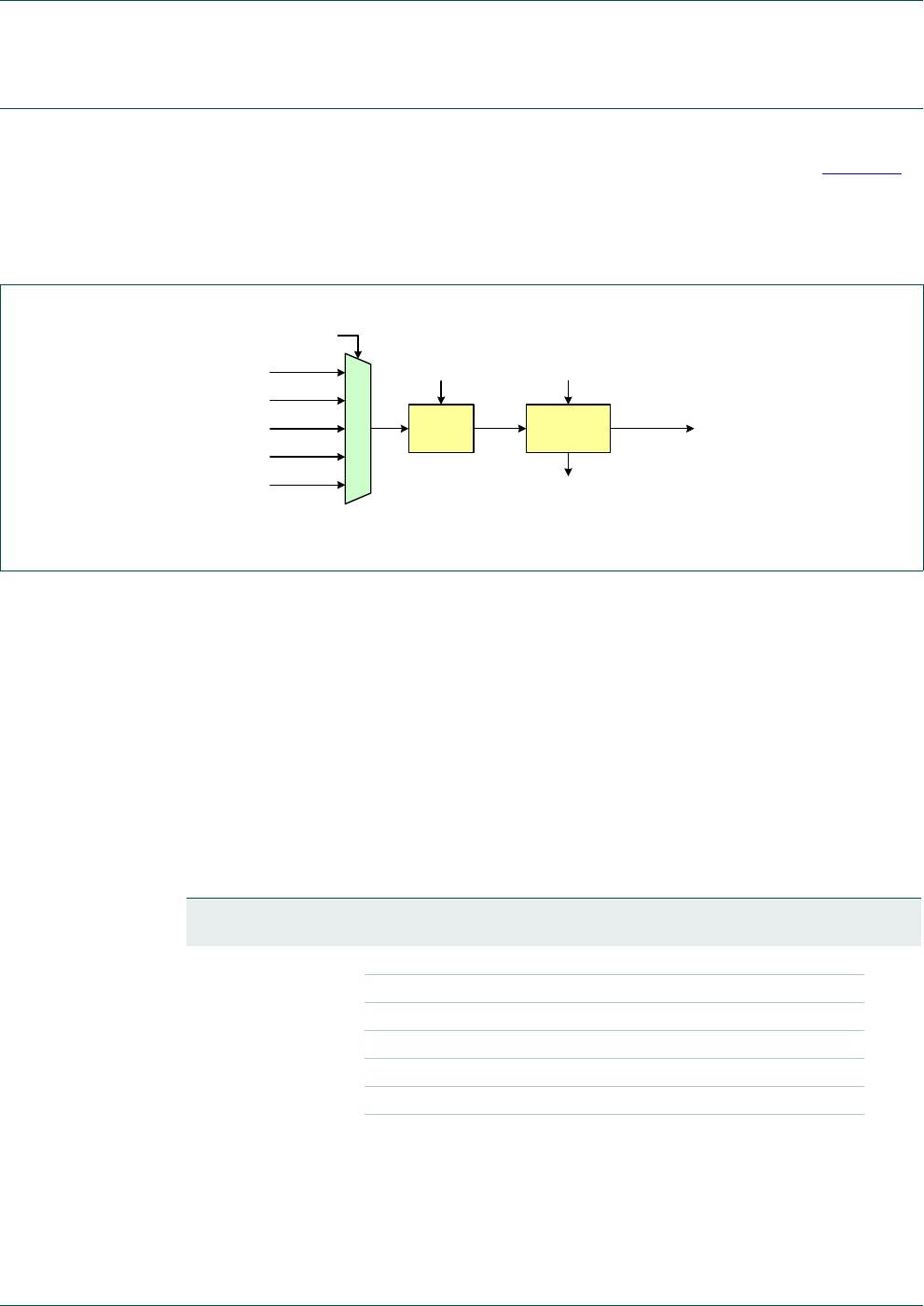
UM10360 All information provided in this document is subject to legal disclaimers. © NXP B.V. 2014. All rights reserved.
User manual Rev. 3.1 — 2 April 2014 67 of 849
NXP Semiconductors UM10360
Chapter 4: LPC176x/5x Clocking and power control
4.10 External clock output pin
For system test and development purposes, any one of several internal clocks may be
brought out on the CLKOUT function available on the P1.27 pin, as shown in Figure 12.
Clocks that may be observed via CLKOUT are the CPU clock (cclk), the main oscillator
(osc_clk), the internal RC oscillator (irc_osc), the USB clock (usb_clk), and the RTC clock
(rtc_clk).
4.10.1 Clock Output Configuration register (CLKOUTCFG - 0x400F C1C8)
The CLKOUTCFG register controls the selection of the internal clock that appears on the
CLKOUT pin and allows dividing the clock by an integer value up to 16. The divider can be
used to produce a system clock that is related to one of the on-chip clocks. For most clock
sources, the division may be by 1. When the CPU clock is selected and is higher than
approximately 50 MHz, the output must be divided in order to bring the frequency within
the ability of the pin to switch with reasonable logic levels.
Note: The CLKOUT multiplexer is designed to switch cleanly, without glitches, between
the possible clock sources. The divider is also designed to allow changing the divide value
without glitches.
Fig 12. CLKOUT selection
CLKOUTCFG[3:0]
rtc_clk
irc_osc
osc_clk
usb_clk
cclk
CLKOUT
Divider
CLKOUTCFG[7:4]
010
001
011
100
000
Clock Enable
Syncronizer
CLKOUTCFG[8]
CLKOUT
CLKOUTCFG[9]
Table 47. Clock Output Configuration register (CLKOUTCFG - 0x400F C1C8) bit description
Bit Symbol Value Description Reset
value
3:0 CLKOUTSEL Selects the clock source for the CLKOUT function. 0
0000 Selects the CPU clock as the CLKOUT source.
0001 Selects the main oscillator as the CLKOUT source.
0010 Selects the Internal RC oscillator as the CLKOUT source.
0011 Selects the USB clock as the CLKOUT source.
0100 Selects the RTC oscillator as the CLKOUT source.
others Reserved, do not use these settings.

UM10360 All information provided in this document is subject to legal disclaimers. © NXP B.V. 2014. All rights reserved.
User manual Rev. 3.1 — 2 April 2014 68 of 849
NXP Semiconductors UM10360
Chapter 4: LPC176x/5x Clocking and power control
7:4 CLKOUTDIV Integer value to divide the output clock by, minus one. 0
0000 Clock is divided by 1.
0001 Clock is divided by 2.
0010 Clock is divided by 3.
... ...
1111 Clock is divided by 16.
8CLKOUT_EN CLKOUT enable control, allows switching the CLKOUT
source without glitches. Clear to stop CLKOUT on the
next falling edge. Set to enable CLKOUT.
0
9CLKOUT_ACT CLKOUT activity indication. Reads as 1 when CLKOUT is
enabled. Read as 0 when CLKOUT has been disabled via
the CLKOUT_EN bit and the clock has completed being
stopped.
0
31:10 - Reserved, user software should not write ones to reserved
bits. The value read from a reserved bit is not defined.
NA
Table 47. Clock Output Configuration register (CLKOUTCFG - 0x400F C1C8) bit description
Bit Symbol Value Description Reset
value
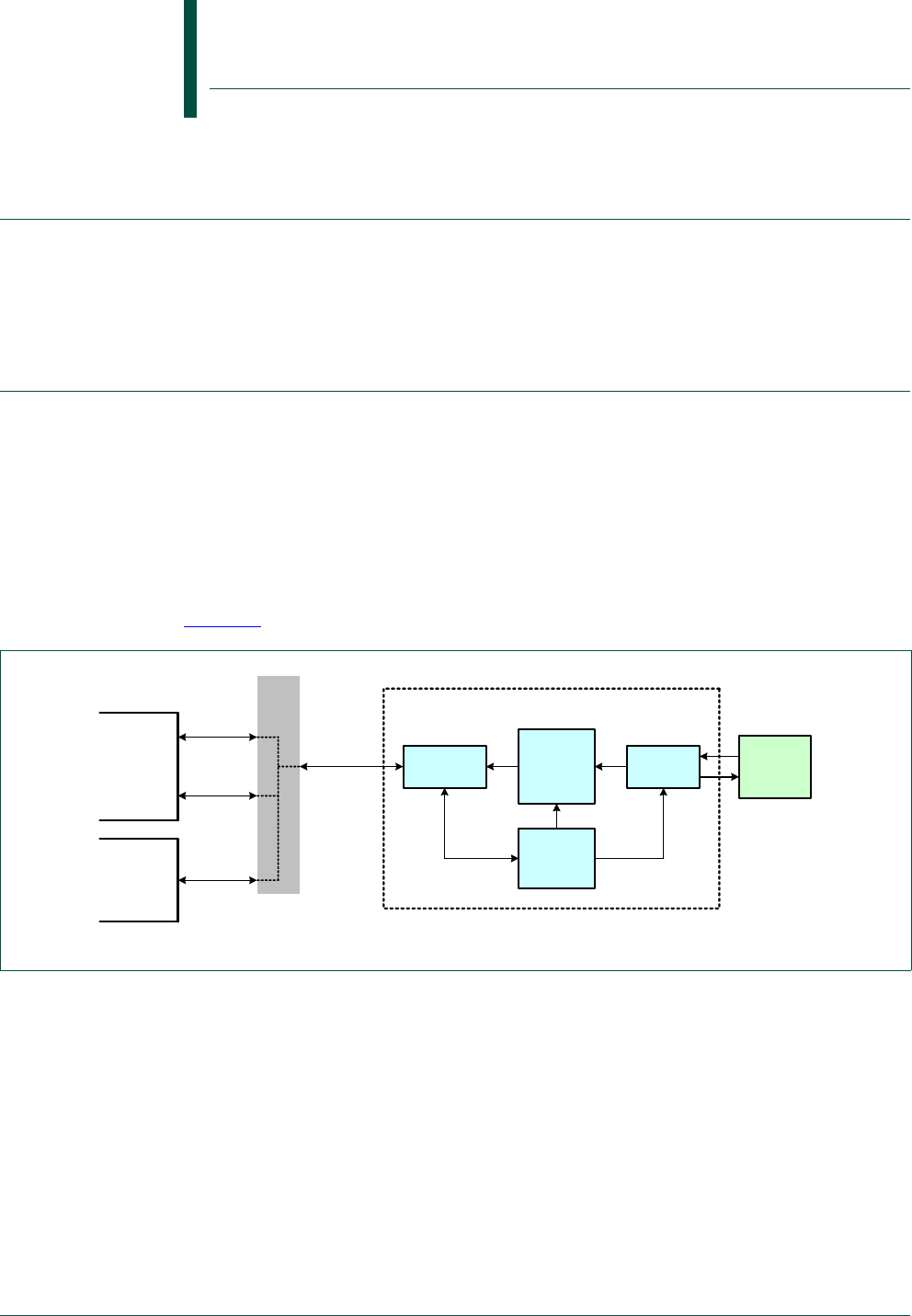
UM10360 All information provided in this document is subject to legal disclaimers. © NXP B.V. 2014. All rights reserved.
User manual Rev. 3.1 — 2 April 2014 69 of 849
5.1 Introduction
The flash accelerator block in the LPC176x/5x allows maximization of the performance of
the Cortex-M3 processor when it is running code from flash memory, while also saving
power. The flash accelerator also provides speed and power improvements for data
accesses to the flash memory.
5.2 Flash accelerator blocks
The flash accelerator is divided into several functional blocks:
•AHB-Lite bus interface, accessible by the Cortex-M3 I-code and D-code buses, as
well as by the General Purpose DMA Controller
•An array of eight 128-bit buffers
•Flash accelerator control logic, including address compare and flash control
•A flash memory interface
Figure 13 shows a simplified diagram of the flash accelerator blocks and data paths.
In the following descriptions, the term “fetch” applies to an explicit flash read request from
the CPU. “Prefetch” is used to denote a flash read of instructions beyond the current
processor fetch address.
5.2.1 Flash memory bank
There is one bank of flash memory controlled by the LPC176x/5x flash accelerator.
Flash programming operations are not controlled by the flash accelerator, but are handled
as a separate function. A Boot ROM contains flash programming algorithms that may be
called as part of the application program, and a loader that may be run to allow
programming of the flash memory.
UM10360
Chapter 5: LPC176x/5x Flash accelerator
Rev. 3.1 — 2 April 2014 User manual
Fig 13. Simplified block diagram of the flash accelerator showing potential bus connections
Flash
Accelerator
Control
Flash
Interface
AHB-Lite
bus interface
Buffer
Array
Flash
Memory
Bus
Matrix
DCode
bus
ICode
bus
Cortex-M3
CPU
General
Purpose
DMA
Controller
DMA
Master Port
Combined
AHB
Flash Accelerator

UM10360 All information provided in this document is subject to legal disclaimers. © NXP B.V. 2014. All rights reserved.
User manual Rev. 3.1 — 2 April 2014 70 of 849
NXP Semiconductors UM10360
Chapter 5: LPC176x/5x Flash accelerator
5.2.2 Flash programming Issues
Since the flash memory does not allow accesses during programming and erase
operations, it is necessary for the flash accelerator to force the CPU to wait if a memory
access to a flash address is requested while the flash memory is busy with a
programming operation. Under some conditions, this delay could result in a Watchdog
time-out. The user will need to be aware of this possibility and take steps to insure that an
unwanted Watchdog reset does not cause a system failure while programming or erasing
the flash memory.
In order to preclude the possibility of stale data being read from the flash memory, the
LPC176x/5x flash accelerator buffers are automatically invalidated at the beginning of any
flash programming or erase operation. Any subsequent read from a flash address will
cause a new fetch to be initiated after the flash operation has completed.
5.3 Register description
The flash accelerator is controlled by the register shown in Ta b le 48 . More detailed
descriptions follow.
[1] Reset Value reflects the data stored in defined bits only. It does not include reserved bits content.
Table 48. Summary of flash accelerator registers
Name Description Access Reset
value[1]
Address
FLASHCFG Flash Accelerator Configuration Register.
Controls flash access timing. See Ta b l e 4 9.
R/W 0x303A 0x400F C000

UM10360 All information provided in this document is subject to legal disclaimers. © NXP B.V. 2014. All rights reserved.
User manual Rev. 3.1 — 2 April 2014 71 of 849
NXP Semiconductors UM10360
Chapter 5: LPC176x/5x Flash accelerator
5.4 Flash Accelerator Configuration register (FLASHCFG - 0x400F C000)
Configuration bits select the flash access time, as shown in Table 49. The lower bits of
FLASHCFG control internal flash accelerator functions and should not be altered.
Following reset, flash accelerator functions are enabled and flash access timing is set to a
default value of 4 clocks.
Changing the FLASHCFG register value causes the flash accelerator to invalidate all of
the holding latches, resulting in new reads of flash information as required. This
guarantees synchronization of the flash accelerator to CPU operation.
5.5 Operation
Simply put, the flash accelerator attempts to have the next Cortex-M3 instruction that will
be needed in its latches in time to prevent CPU fetch stalls. The LPC176x/5x uses one
bank of flash memory. The flash accelerator includes an array of eight 128-bit buffers to
store both instructions and data in a configurable manner. Each 128-bit buffer in the array
can include four 32-bit instructions, eight 16-bit instructions or some combination of the
two. During sequential code execution, a buffer typically contains the current instruction
and the entire flash line that contains that instruction, or one flash line of data containing a
previously requested address. Buffers are marked according to how they are used (as
instruction or data buffers), and when they have been accessed. This information is used
to carry out the buffer replacement strategy.
The Cortex-M3 provides a separate bus for instruction access (I-code) and data access
(D-code) in the code memory space. These buses, plus the General Purpose DMA
Controllers’s master port, are arbitrated by the AHB multilayer matrix. Any access to the
flash memory’s address space is presented to the flash accelerator.
Table 49. Flash Accelerator Configuration register (FLASHCFG - address 0x400F C000) bit description
Bit Symbol Value Description Reset
value
11:0 - -Reserved, user software should not change these bits from the reset value. 0x03A
15:12 FLASHTIM Flash access time. The value of this field plus 1 gives the number of CPU clocks used
for a flash access.
Warning: improper setting of this value may result in incorrect operation of the device.
0x3
0000 Flash accesses use 1 CPU clock. Use for up to 20 MHz CPU clock.
0001 Flash accesses use 2 CPU clocks. Use for up to 40 MHz CPU clock.
0010 Flash accesses use 3 CPU clocks. Use for up to 60 MHz CPU clock.
0011 Flash accesses use 4 CPU clocks. Use for up to 80 MHz CPU clock.
0100 Flash accesses use 5 CPU clocks. Use for up to 100 MHz CPU clock.
Use for up to 120 Mhz for LPC1759 and LPC1769 only.
0101 Flash accesses use 6 CPU clocks. This “safe” setting will work under any conditions.
Other Intended for potential future higher speed devices.
31:16 - Reserved. The value read from a reserved bit is not defined. NA

UM10360 All information provided in this document is subject to legal disclaimers. © NXP B.V. 2014. All rights reserved.
User manual Rev. 3.1 — 2 April 2014 72 of 849
NXP Semiconductors UM10360
Chapter 5: LPC176x/5x Flash accelerator
If a flash instruction fetch and a flash data access from the CPU occur at the same time,
the multilayer matrix gives precedence to the data access. This is because a stalled data
access always slows down execution, while a stalled instruction fetch often does not.
When the flash data access is concluded, any flash fetch or prefetch that had been in
progress is re-initiated.
Branches and other program flow changes cause a break in the sequential flow of
instruction fetches described above. Buffer replacement strategy in the flash accelerator
attempts to maximize the chances that potentially reusable information is retained until it
is needed again.
If an attempt is made to write directly to the flash memory without using the normal flash
programming interface (via Boot ROM function calls), the flash accelerator generates an
error condition. The CPU treats this error as a data abort. The GPDMA handles error
conditions as described in Section 31.4.1.6.3.
When an Instruction Fetch is not satisfied by existing contents of the buffer array, nor has
a prefetch been initiated for that flash line, the CPU will be stalled while a fetch is initiated
for the related 128-bit flash line. If a prefetch has been initiated but not yet completed, the
CPU is stalled for a shorter time since the required flash access is already in progress.
Typically, a flash prefetch is begun whenever an access is made to a just prefetched
address, or to a buffer whose immediate successor is not already in another buffer. A
prefetch in progress may be aborted by a data access, in order to minimize CPU stalls.
A prefetched flash line is latched within the flash memory, but the flash accelerator does
not capture the line in a buffer until the CPU presents an address that is contained within
the prefetched flash line. If the core presents an instruction address that is not already
buffered and is not contained in the prefetched flash line, the prefetched line will be
discarded.
Some special cases include the possibility that the CPU will request a data access to an
address already contained in an instruction buffer. In this case, the data will be read from
the buffer as if it was a data buffer. The reverse case, if the CPU requests an instruction
address that can be satisfied from an existing data buffer, causes the instruction to be
supplied from the data buffer, and the buffer to be changed into an instruction buffer. This
causes the buffer to be handled differently when the flash accelerator is determining which
buffer is to be overwritten next.

UM10360 All information provided in this document is subject to legal disclaimers. © NXP B.V. 2014. All rights reserved.
User manual Rev. 3.1 — 2 April 2014 73 of 849
6.1 Features
•Nested Vectored Interrupt Controller that is an integral part of the ARM Cortex-M3
•Tightly coupled interrupt controller provides low interrupt latency
•Controls system exceptions and peripheral interrupts
•In the LPC176x/5x, the NVIC supports 35 vectored interrupts
•32 programmable interrupt priority levels, with hardware priority level masking
•Relocatable vector table
•Non-Maskable Interrupt
•Software interrupt generation
6.2 Description
The Nested Vectored Interrupt Controller (NVIC) is an integral part of the Cortex-M3. The
tight coupling to the CPU allows for low interrupt latency and efficient processing of late
arriving interrupts.
Refer to the Cortex-M3 User Guide Section 34.4.2 for details of NVIC operation.
6.3 Interrupt sources
Tab l e 5 0 lists the interrupt sources for each peripheral function. Each peripheral device
may have one or more interrupt lines to the Vectored Interrupt Controller. Each line may
represent more than one interrupt source, as noted.
Exception numbers relate to where entries are stored in the exception vector table.
Interrupt numbers are used in some other contexts, such as software interrupts.
In addition, the NVIC handles the Non-Maskable Interrupt (NMI). In order for NMI to
operate from an external signal, the NMI function must be connected to the related device
pin (P2.10 / EINT0n / NMI). When connected, a logic 1 on the pin will cause the NMI to be
processed. For details, refer to the Cortex-M3 User Guide that is an appendix to this User
Manual.
UM10360
Chapter 6: LPC176x/5x Nested Vectored Interrupt Controller
(NVIC)
Rev. 3.1 — 2 April 2014 User manual

UM10360 All information provided in this document is subject to legal disclaimers. © NXP B.V. 2014. All rights reserved.
User manual Rev. 3.1 — 2 April 2014 74 of 849
NXP Semiconductors UM10360
Chapter 6: LPC176x/5x Nested Vectored Interrupt Controller (NVIC)
Table 50. Connection of interrupt sources to the Vectored Interrupt Controller
Interrupt
ID
Exception
Number
Vector
Offset
Function Flag(s)
016 0x40WDT Watchdog Interrupt (WDINT)
117 0x44Timer 0 Match 0 - 1 (MR0, MR1)
Capture 0 - 1 (CR0, CR1)
218 0x48Timer 1 Match 0 - 2 (MR0, MR1, MR2)
Capture 0 - 1 (CR0, CR1)
319 0x4CTimer 2 Match 0-3
Capture 0-1
420 0x50Timer 3 Match 0-3
Capture 0-1
521 0x54UART0 Rx Line Status (RLS)
Transmit Holding Register Empty (THRE)
Rx Data Available (RDA)
Character Time-out Indicator (CTI)
End of Auto-Baud (ABEO)
Auto-Baud Time-Out (ABTO)
622 0x58UART1 Rx Line Status (RLS)
Transmit Holding Register Empty (THRE)
Rx Data Available (RDA)
Character Time-out Indicator (CTI)
Modem Control Change
End of Auto-Baud (ABEO)
Auto-Baud Time-Out (ABTO)
723 0x5CUART 2 Rx Line Status (RLS)
Transmit Holding Register Empty (THRE)
Rx Data Available (RDA)
Character Time-out Indicator (CTI)
End of Auto-Baud (ABEO)
Auto-Baud Time-Out (ABTO)
824 0x60UART 3 Rx Line Status (RLS)
Transmit Holding Register Empty (THRE)
Rx Data Available (RDA)
Character Time-out Indicator (CTI)
End of Auto-Baud (ABEO)
Auto-Baud Time-Out (ABTO)
9 25 0x64 PWM1 Match 0 - 6 of PWM1
Capture 0-1 of PWM1
10 26 0x68 I2C0 SI (state change)
11 27 0x6C I2C1 SI (state change)
12 28 0x70 I2C2 SI (state change)
13 29 0x74 SPI SPI Interrupt Flag (SPIF)
Mode Fault (MODF)

UM10360 All information provided in this document is subject to legal disclaimers. © NXP B.V. 2014. All rights reserved.
User manual Rev. 3.1 — 2 April 2014 75 of 849
NXP Semiconductors UM10360
Chapter 6: LPC176x/5x Nested Vectored Interrupt Controller (NVIC)
14 30 0x78 SSP0 Tx FIFO half empty of SSP0
Rx FIFO half full of SSP0
Rx Timeout of SSP0
Rx Overrun of SSP0
15 31 0x7C SSP 1 Tx FIFO half empty
Rx FIFO half full
Rx Timeout
Rx Overrun
16 32 0x80 PLL0 (Main PLL) PLL0 Lock (PLOCK0)
17 33 0x84 RTC Counter Increment (RTCCIF)
Alarm (RTCALF)
18 34 0x88 External Interrupt External Interrupt 0 (EINT0)
19 35 0x8C External Interrupt External Interrupt 1 (EINT1)
20 36 0x90 External Interrupt External Interrupt 2 (EINT2)
21 37 0x94 External Interrupt External Interrupt 3 (EINT3).
Note: EINT3 channel is shared with GPIO interrupts
22 38 0x98 ADC A/D Converter end of conversion
23 39 0x9C BOD Brown Out detect
24 40 0xA0 USB USB_INT_REQ_LP, USB_INT_REQ_HP, USB_INT_REQ_DMA
25 41 0xA4 CAN CAN Common, CAN 0 Tx, CAN 0 Rx, CAN 1 Tx, CAN 1 Rx
26 42 0xA8 GPDMA IntStatus of DMA channel 0, IntStatus of DMA channel 1
27 43 0xAC I2Sirq, dmareq1, dmareq2
28 44 0xB0 Ethernet WakeupInt, SoftInt, TxDoneInt, TxFinishedInt, TxErrorInt,
TxUnderrunInt, RxDoneInt, RxFinishedInt, RxErrorInt,
RxOverrunInt.
29 45 0xB4 Repetitive Interrupt
Timer
RITINT
30 46 0xB8 Motor Control PWM IPER[2:0], IPW[2:0], ICAP[2:0], FES
31 47 0xBC Quadrature Encoder INX_Int, TIM_Int, VELC_Int, DIR_Int, ERR_Int, ENCLK_Int,
POS0_Int, POS1_Int, POS2_Int, REV_Int, POS0REV_Int,
POS1REV_Int, POS2REV_Int
32 48 0xC0 PLL1 (USB PLL) PLL1 Lock (PLOCK1)
33 49 0xC4 USB Activity Interrupt USB_NEED_CLK
34 50 0xC8 CAN Activity Interrupt CAN1WAKE, CAN2WAKE
Table 50. Connection of interrupt sources to the Vectored Interrupt Controller
Interrupt
ID
Exception
Number
Vector
Offset
Function Flag(s)

UM10360 All information provided in this document is subject to legal disclaimers. © NXP B.V. 2014. All rights reserved.
User manual Rev. 3.1 — 2 April 2014 76 of 849
NXP Semiconductors UM10360
Chapter 6: LPC176x/5x Nested Vectored Interrupt Controller (NVIC)
6.4 Vector table remapping
The Cortex-M3 incorporates a mechanism that allows remapping the interrupt vector table
to alternate locations in the memory map. This is controlled via the Vector Table Offset
Register (VTOR) contained in the Cortex-M3.
The vector table may be located anywhere within the bottom 1 GB of Cortex-M3 address
space. The vector table should be located on a 256 word (1024 byte) boundary to insure
alignment on LPC176x/5x family devices. Refer to Section 34.4.3.5 of the Cortex-M3 User
Guide appended to this manual for details of the Vector Table Offset feature.
ARM describes bit 29 of the VTOR (TBLOFF) as selecting a memory region, either code
or SRAM. For simplicity, this bit can be thought as simply part of the address offset since
the split between the “code” space and the “SRAM” space occurs at the location
corresponding to bit 29 in a memory address.
Examples:
To p lac e th e vec t or ta b l e a t t h e be g inn i ng o f the “local” static RAM, starting at address
0x1000 0000, place the value 0x1000 0000 in the VTOR register. This indicates address
0x1000 0000 in the code space, since bit 29 of the VTOR equals 0.
To p lac e t h e ve c tor ta b le a t t he b e gi n n in g of the AHB static RAM, starting at address
0x2007 C000, place the value 0x2007 C000 in the VTOR register. This indicates address
0x2007 C000 in the SRAM space, since bit 29 of the VTOR equals 1.

UM10360 All information provided in this document is subject to legal disclaimers. © NXP B.V. 2014. All rights reserved.
User manual Rev. 3.1 — 2 April 2014 77 of 849
NXP Semiconductors UM10360
Chapter 6: LPC176x/5x Nested Vectored Interrupt Controller (NVIC)
6.5 Register description
The following table summarizes the registers in the NVIC as implemented in the
LPC176x/5x. The Cortex-M3 User Guide Section 34.4.2 provides a functional description
of the NVIC.
Table 51. NVIC register map
Name Description Access Reset
value
Address
ISER0 to
ISER1
Interrupt Set-Enable Registers. These 2 registers allow enabling
interrupts and reading back the interrupt enables for specific
peripheral functions.
RW 0 ISER0 - 0xE000 E100
ISER1 - 0xE000 E104
ICER0 to
ICER1
Interrupt Clear-Enable Registers. These 2 registers allow disabling
interrupts and reading back the interrupt enables for specific
peripheral functions.
RW 0 ICER0 - 0xE000 E180
ICER1 - 0xE000 E184
ISPR0 to
ISPR1
Interrupt Set-Pending Registers. These 2 registers allow changing
the interrupt state to pending and reading back the interrupt
pending state for specific peripheral functions.
RW 0 ISPR0 - 0xE000 E200
ISPR1 - 0xE000 E204
ICPR0 to
ICPR1
Interrupt Clear-Pending Registers. These 2 registers allow
changing the interrupt state to not pending and reading back the
interrupt pending state for specific peripheral functions.
RW 0 ICPR0 - 0xE000 E280
ICPR1 - 0xE000 E284
IABR0 to
IABR1
Interrupt Active Bit Registers. These 2 registers allow reading the
current interrupt active state for specific peripheral functions.
RO 0 IABR0 - 0xE000 E300
IABR1 - 0xE000 E304
IPR0 to
IPR8
Interrupt Priority Registers. These 9 registers allow assigning a
priority to each interrupt. Each register contains the 5-bit priority
fields for 4 interrupts.
RW 0 IPR0 - 0xE000 E400
IPR1 - 0xE000 E404
IPR2 - 0xE000 E408
IPR3 - 0xE000 E40C
IPR4 - 0xE000 E410
IPR5 - 0xE000 E414
IPR6 - 0xE000 E418
IPR7 - 0xE000 E41C
IPR8 - 0xE000 E420
STIR Software Trigger Interrupt Register. This register allows software to
generate an interrupt.
WO 0 STIR - 0xE000 EF00

UM10360 All information provided in this document is subject to legal disclaimers. © NXP B.V. 2014. All rights reserved.
User manual Rev. 3.1 — 2 April 2014 78 of 849
NXP Semiconductors UM10360
Chapter 6: LPC176x/5x Nested Vectored Interrupt Controller (NVIC)
6.5.1 Interrupt Set-Enable Register 0 register (ISER0 - 0xE000 E100)
The ISER0 register allows enabling the first 32 peripheral interrupts, or for reading the
enabled state of those interrupts. The remaining interrupts are enabled via the ISER1
register (Section 6.5.2). Disabling interrupts is done through the ICER0 and ICER1
registers (Section 6.5.3 and Section 6.5.4).
Table 52. Interrupt Set-Enable Register 0 register (ISER0 - 0xE000 E100)
Bit Name Function
0ISE_WDT Watchdog Timer Interrupt Enable.
Write: writing 0 has no effect, writing 1 enables the interrupt.
Read: 0 indicates that the interrupt is disabled, 1 indicates that the interrupt is enabled.
1ISE_TIMER0Timer 0 Interrupt Enable. See functional description for bit 0.
2ISE_TIMER1Timer 1. Interrupt Enable. See functional description for bit 0.
3ISE_TIMER2Timer 2 Interrupt Enable. See functional description for bit 0.
4ISE_TIMER3Timer 3 Interrupt Enable. See functional description for bit 0.
5ISE_UART0UART0 Interrupt Enable. See functional description for bit 0.
6ISE_UART1UART1 Interrupt Enable. See functional description for bit 0.
7ISE_UART2UART2 Interrupt Enable. See functional description for bit 0.
8ISE_UART3UART3 Interrupt Enable. See functional description for bit 0.
9ISE_PWM PWM1 Interrupt Enable. See functional description for bit 0.
10 ISE_I2C0 I2C0 Interrupt Enable. See functional description for bit 0.
11 ISE_I2C1 I2C1 Interrupt Enable. See functional description for bit 0.
12 ISE_I2C2 I2C2 Interrupt Enable. See functional description for bit 0.
13 ISE_SPI SPI Interrupt Enable. See functional description for bit 0.
14 ISE_SSP0 SSP0 Interrupt Enable. See functional description for bit 0.
15 ISE_SSP1 SSP1 Interrupt Enable. See functional description for bit 0.
16 ISE_PLL0 PLL0 (Main PLL) Interrupt Enable. See functional description for bit 0.
17 ISE_RTC Real Time Clock (RTC) Interrupt Enable. See functional description for bit 0.
18 ISE_EINT0 External Interrupt 0 Interrupt Enable. See functional description for bit 0.
19 ISE_EINT1 External Interrupt 1 Interrupt Enable. See functional description for bit 0.
20 ISE_EINT2 External Interrupt 2 Interrupt Enable. See functional description for bit 0.
21 ISE_EINT3 External Interrupt 3 Interrupt Enable. See functional description for bit 0.
22 ISE_ADC ADC Interrupt Enable. See functional description for bit 0.
23 ISE_BOD BOD Interrupt Enable. See functional description for bit 0.
24 ISE_USB USB Interrupt Enable. See functional description for bit 0.
25 ISE_CAN CAN Interrupt Enable. See functional description for bit 0.
26 ISE_DMA GPDMA Interrupt Enable. See functional description for bit 0.
27 ISE_I2S I2S Interrupt Enable. See functional description for bit 0.
28 ISE_ENET Ethernet Interrupt Enable. See functional description for bit 0.
29 ISE_RIT Repetitive Interrupt Timer Interrupt Enable. See functional description for bit 0.
30 ISE_MCPWM Motor Control PWM Interrupt Enable. See functional description for bit 0.
31 ISE_QEI Quadrature Encoder Interface Interrupt Enable. See functional description for bit 0.

UM10360 All information provided in this document is subject to legal disclaimers. © NXP B.V. 2014. All rights reserved.
User manual Rev. 3.1 — 2 April 2014 79 of 849
NXP Semiconductors UM10360
Chapter 6: LPC176x/5x Nested Vectored Interrupt Controller (NVIC)
6.5.2 Interrupt Set-Enable Register 1 register (ISER1 - 0xE000 E104)
The ISER1 register allows enabling the second group of peripheral interrupts, or for
reading the enabled state of those interrupts. Disabling interrupts is done through the
ICER0 and ICER1 registers (Section 6.5.3 and Section 6.5.4).
Table 53. Interrupt Set-Enable Register 1 register (ISER1 - 0xE000 E104)
Bit Name Function
0ISE_PLL1 PLL1 (USB PLL) Interrupt Enable.
Write: writing 0 has no effect, writing 1 enables the interrupt.
Read: 0 indicates that the interrupt is disabled, 1 indicates that the interrupt is enabled.
1ISE_USBACTUSB Activity Interrupt Enable. See functional description for bit 0.
2ISE_CANACTCAN Activity Interrupt Enable. See functional description for bit 0.
31:3 - Reserved, user software should not write ones to reserved bits. The value read from a reserved bit
is not defined.

UM10360 All information provided in this document is subject to legal disclaimers. © NXP B.V. 2014. All rights reserved.
User manual Rev. 3.1 — 2 April 2014 80 of 849
NXP Semiconductors UM10360
Chapter 6: LPC176x/5x Nested Vectored Interrupt Controller (NVIC)
6.5.3 Interrupt Clear-Enable Register 0 (ICER0 - 0xE000 E180)
The ICER0 register allows disabling the first 32 peripheral interrupts, or for reading the
enabled state of those interrupts. The remaining interrupts are disabled via the ICER1
register (Section 6.5.4). Enabling interrupts is done through the ISER0 and ISER1
registers (Section 6.5.1 and Section 6.5.2).
Table 54. Interrupt Clear-Enable Register 0 (ICER0 - 0xE000 E180)
Bit Name Function
0ICE_WDT Watchdog Timer Interrupt Disable.
Write: writing 0 has no effect, writing 1 disables the interrupt.
Read: 0 indicates that the interrupt is disabled, 1 indicates that the interrupt is enabled.
1ICE_TIMER0Timer 0 Interrupt Disable. See functional description for bit 0.
2ICE_TIMER1Timer 1. Interrupt Disable. See functional description for bit 0.
3ICE_TIMER2Timer 2 Interrupt Disable. See functional description for bit 0.
4ICE_TIMER3Timer 3 Interrupt Disable. See functional description for bit 0.
5ICE_UART0UART0 Interrupt Disable. See functional description for bit 0.
6ICE_UART1UART1 Interrupt Disable. See functional description for bit 0.
7ICE_UART2UART2 Interrupt Disable. See functional description for bit 0.
8ICE_UART3UART3 Interrupt Disable. See functional description for bit 0.
9ICE_PWM PWM1 Interrupt Disable. See functional description for bit 0.
10 ICE_I2C0 I2C0 Interrupt Disable. See functional description for bit 0.
11 ICE_I2C1 I2C1 Interrupt Disable. See functional description for bit 0.
12 ICE_I2C2 I2C2 Interrupt Disable. See functional description for bit 0.
13 ICE_SPI SPI Interrupt Disable. See functional description for bit 0.
14 ICE_SSP0 SSP0 Interrupt Disable. See functional description for bit 0.
15 ICE_SSP1 SSP1 Interrupt Disable. See functional description for bit 0.
16 ICE_PLL0 PLL0 (Main PLL) Interrupt Disable. See functional description for bit 0.
17 ICE_RTC Real Time Clock (RTC) Interrupt Disable. See functional description for bit 0.
18 ICE_EINT0 External Interrupt 0 Interrupt Disable. See functional description for bit 0.
19 ICE_EINT1 External Interrupt 1 Interrupt Disable. See functional description for bit 0.
20 ICE_EINT2 External Interrupt 2 Interrupt Disable. See functional description for bit 0.
21 ICE_EINT3 External Interrupt 3 Interrupt Disable. See functional description for bit 0.
22 ICE_ADC ADC Interrupt Disable. See functional description for bit 0.
23 ICE_BOD BOD Interrupt Disable. See functional description for bit 0.
24 ICE_USB USB Interrupt Disable. See functional description for bit 0.
25 ICE_CAN CAN Interrupt Disable. See functional description for bit 0.
26 ICE_DMA GPDMA Interrupt Disable. See functional description for bit 0.
27 ICE_I2S I2S Interrupt Disable. See functional description for bit 0.
28 ICE_ENET Ethernet Interrupt Disable. See functional description for bit 0.
29 ICE_RIT Repetitive Interrupt Timer Interrupt Disable. See functional description for bit 0.
30 ICE_MCPWM Motor Control PWM Interrupt Disable. See functional description for bit 0.
31 ICE_QEI Quadrature Encoder Interface Interrupt Disable. See functional description for bit 0.

UM10360 All information provided in this document is subject to legal disclaimers. © NXP B.V. 2014. All rights reserved.
User manual Rev. 3.1 — 2 April 2014 81 of 849
NXP Semiconductors UM10360
Chapter 6: LPC176x/5x Nested Vectored Interrupt Controller (NVIC)
6.5.4 Interrupt Clear-Enable Register 1 register (ICER1 - 0xE000 E184)
The ICER1 register allows disabling the second group of peripheral interrupts, or for
reading the enabled state of those interrupts. Enabling interrupts is done through the
ISER0 and ISER1 registers (Section 6.5.1 and Section 6.5.2).
Table 55. Interrupt Clear-Enable Register 1 register (ICER1 - 0xE000 E184)
Bit Name Function
0ICE_PLL1 PLL1 (USB PLL) Interrupt Disable.
Write: writing 0 has no effect, writing 1 disables the interrupt.
Read: 0 indicates that the interrupt is disabled, 1 indicates that the interrupt is enabled.
1ICE_USBACTUSB Activity Interrupt Disable. See functional description for bit 0.
2ICE_CANACTCAN Activity Interrupt Disable. See functional description for bit 0.
31:3 - Reserved, user software should not write ones to reserved bits. The value read from a reserved bit
is not defined.

UM10360 All information provided in this document is subject to legal disclaimers. © NXP B.V. 2014. All rights reserved.
User manual Rev. 3.1 — 2 April 2014 82 of 849
NXP Semiconductors UM10360
Chapter 6: LPC176x/5x Nested Vectored Interrupt Controller (NVIC)
6.5.5 Interrupt Set-Pending Register 0 register (ISPR0 - 0xE000 E200)
The ISPR0 register allows setting the pending state of the first 32 peripheral interrupts, or
for reading the pending state of those interrupts. The remaining interrupts can have their
pending state set via the ISPR1 register (Section 6.5.6). Clearing the pending state of
interrupts is done through the ICPR0 and ICPR1 registers (Section 6.5.7 and
Section 6.5.8).
Table 56. Interrupt Set-Pending Register 0 register (ISPR0 - 0xE000 E200)
Bit Name Function
0ISP_WDT Watchdog Timer Interrupt Pending set.
Write: writing 0 has no effect, writing 1 changes the interrupt state to pending.
Read: 0 indicates that the interrupt is not pending, 1 indicates that the interrupt is pending.
1ISP_TIMER0Timer 0 Interrupt Pending set. See functional description for bit 0.
2ISP_TIMER1Timer 1. Interrupt Pending set. See functional description for bit 0.
3ISP_TIMER2Timer 2 Interrupt Pending set. See functional description for bit 0.
4ISP_TIMER3Timer 3 Interrupt Pending set. See functional description for bit 0.
5ISP_UART0UART0 Interrupt Pending set. See functional description for bit 0.
6ISP_UART1UART1 Interrupt Pending set. See functional description for bit 0.
7ISP_UART2UART2 Interrupt Pending set. See functional description for bit 0.
8ISP_UART3UART3 Interrupt Pending set. See functional description for bit 0.
9ISP_PWM PWM1 Interrupt Pending set. See functional description for bit 0.
10 ISP_I2C0 I2C0 Interrupt Pending set. See functional description for bit 0.
11 ISP_I2C1 I2C1 Interrupt Pending set. See functional description for bit 0.
12 ISP_I2C2 I2C2 Interrupt Pending set. See functional description for bit 0.
13 ISP_SPI SPI Interrupt Pending set. See functional description for bit 0.
14 ISP_SSP0 SSP0 Interrupt Pending set. See functional description for bit 0.
15 ISP_SSP1 SSP1 Interrupt Pending set. See functional description for bit 0.
16 ISP_PLL0 PLL0 (Main PLL) Interrupt Pending set. See functional description for bit 0.
17 ISP_RTC Real Time Clock (RTC) Interrupt Pending set. See functional description for bit 0.
18 ISP_EINT0 External Interrupt 0 Interrupt Pending set. See functional description for bit 0.
19 ISP_EINT1 External Interrupt 1 Interrupt Pending set. See functional description for bit 0.
20 ISP_EINT2 External Interrupt 2 Interrupt Pending set. See functional description for bit 0.
21 ISP_EINT3 External Interrupt 3 Interrupt Pending set. See functional description for bit 0.
22 ISP_ADC ADC Interrupt Pending set. See functional description for bit 0.
23 ISP_BOD BOD Interrupt Pending set. See functional description for bit 0.
24 ISP_USB USB Interrupt Pending set. See functional description for bit 0.
25 ISP_CAN CAN Interrupt Pending set. See functional description for bit 0.
26 ISP_DMA GPDMA Interrupt Pending set. See functional description for bit 0.
27 ISP_I2S I2S Interrupt Pending set. See functional description for bit 0.
28 ISP_ENET Ethernet Interrupt Pending set. See functional description for bit 0.
29 ISP_RIT Repetitive Interrupt Timer Interrupt Pending set. See functional description for bit 0.
30 ISP_MCPWM Motor Control PWM Interrupt Pending set. See functional description for bit 0.
31 ISP_QEI Quadrature Encoder Interface Interrupt Pending set. See functional description for bit 0.

UM10360 All information provided in this document is subject to legal disclaimers. © NXP B.V. 2014. All rights reserved.
User manual Rev. 3.1 — 2 April 2014 83 of 849
NXP Semiconductors UM10360
Chapter 6: LPC176x/5x Nested Vectored Interrupt Controller (NVIC)
6.5.6 Interrupt Set-Pending Register 1 register (ISPR1 - 0xE000 E204)
The ISPR1 register allows setting the pending state of the second group of peripheral
interrupts, or for reading the pending state of those interrupts. Clearing the pending state
of interrupts is done through the ICPR0 and ICPR1 registers (Section 6.5.7 and
Section 6.5.8).
Table 57. Interrupt Set-Pending Register 1 register (ISPR1 - 0xE000 E204)
Bit Name Function
0ISP_PLL1 PLL1 (USB PLL) Interrupt Pending set.
Write: writing 0 has no effect, writing 1 changes the interrupt state to pending.
Read: 0 indicates that the interrupt is not pending, 1 indicates that the interrupt is pending.
1ISP_USBACTUSB Activity Interrupt Pending set. See functional description for bit 0.
2ISP_CANACTCAN Activity Interrupt Pending set. See functional description for bit 0.
31:3 - Reserved, user software should not write ones to reserved bits. The value read from a reserved bit
is not defined.

UM10360 All information provided in this document is subject to legal disclaimers. © NXP B.V. 2014. All rights reserved.
User manual Rev. 3.1 — 2 April 2014 84 of 849
NXP Semiconductors UM10360
Chapter 6: LPC176x/5x Nested Vectored Interrupt Controller (NVIC)
6.5.7 Interrupt Clear-Pending Register 0 register (ICPR0 - 0xE000 E280)
The ICPR0 register allows clearing the pending state of the first 32 peripheral interrupts,
or for reading the pending state of those interrupts. The remaining interrupts can have
their pending state cleared via the ICPR1 register (Section 6.5.8). Setting the pending
state of interrupts is done through the ISPR0 and ISPR1 registers (Section 6.5.5 and
Section 6.5.6).
Table 58. Interrupt Clear-Pending Register 0 register (ICPR0 - 0xE000 E280)
Bit Name Function
0ICP_WDT Watchdog Timer Interrupt Pending clear.
Write: writing 0 has no effect, writing 1 changes the interrupt state to not pending.
Read: 0 indicates that the interrupt is not pending, 1 indicates that the interrupt is pending.
1ICP_TIMER0Timer 0 Interrupt Pending clear. See functional description for bit 0.
2ICP_TIMER1Timer 1. Interrupt Pending clear. See functional description for bit 0.
3ICP_TIMER2Timer 2 Interrupt Pending clear. See functional description for bit 0.
4ICP_TIMER3Timer 3 Interrupt Pending clear. See functional description for bit 0.
5ICP_UART0UART0 Interrupt Pending clear. See functional description for bit 0.
6ICP_UART1UART1 Interrupt Pending clear. See functional description for bit 0.
7ICP_UART2UART2 Interrupt Pending clear. See functional description for bit 0.
8ICP_UART3UART3 Interrupt Pending clear. See functional description for bit 0.
9ICP_PWM PWM1 Interrupt Pending clear. See functional description for bit 0.
10 ICP_I2C0 I2C0 Interrupt Pending clear. See functional description for bit 0.
11 ICP_I2C1 I2C1 Interrupt Pending clear. See functional description for bit 0.
12 ICP_I2C2 I2C2 Interrupt Pending clear. See functional description for bit 0.
13 ICP_SPI SPI Interrupt Pending clear. See functional description for bit 0.
14 ICP_SSP0 SSP0 Interrupt Pending clear. See functional description for bit 0.
15 ICP_SSP1 SSP1 Interrupt Pending clear. See functional description for bit 0.
16 ICP_PLL0 PLL0 (Main PLL) Interrupt Pending clear. See functional description for bit 0.
17 ICP_RTC Real Time Clock (RTC) Interrupt Pending clear. See functional description for bit 0.
18 ICP_EINT0 External Interrupt 0 Interrupt Pending clear. See functional description for bit 0.
19 ICP_EINT1 External Interrupt 1 Interrupt Pending clear. See functional description for bit 0.
20 ICP_EINT2 External Interrupt 2 Interrupt Pending clear. See functional description for bit 0.
21 ICP_EINT3 External Interrupt 3 Interrupt Pending clear. See functional description for bit 0.
22 ICP_ADC ADC Interrupt Pending clear. See functional description for bit 0.
23 ICP_BOD BOD Interrupt Pending clear. See functional description for bit 0.
24 ICP_USB USB Interrupt Pending clear. See functional description for bit 0.
25 ICP_CAN CAN Interrupt Pending clear. See functional description for bit 0.
26 ICP_DMA GPDMA Interrupt Pending clear. See functional description for bit 0.
27 ICP_I2S I2S Interrupt Pending clear. See functional description for bit 0.
28 ICP_ENET Ethernet Interrupt Pending clear. See functional description for bit 0.
29 ICP_RIT Repetitive Interrupt Timer Interrupt Pending clear. See functional description for bit 0.
30 ICP_MCPWM Motor Control PWM Interrupt Pending clear. See functional description for bit 0.
31 ICP_QEI Quadrature Encoder Interface Interrupt Pending clear. See functional description for bit 0.

UM10360 All information provided in this document is subject to legal disclaimers. © NXP B.V. 2014. All rights reserved.
User manual Rev. 3.1 — 2 April 2014 85 of 849
NXP Semiconductors UM10360
Chapter 6: LPC176x/5x Nested Vectored Interrupt Controller (NVIC)
6.5.8 Interrupt Clear-Pending Register 1 register (ICPR1 - 0xE000 E284)
The ICPR1 register allows clearing the pending state of the second group of peripheral
interrupts, or for reading the pending state of those interrupts. Setting the pending state of
interrupts is done through the ISPR0 and ISPR1 registers (Section 6.5.5 and
Section 6.5.6).
Table 59. Interrupt Set-Pending Register 1 register (ISPR1 - 0xE000 E204)
Bit Name Function
0ICP_PLL1 PLL1 (USB PLL) Interrupt Pending clear.
Write: writing 0 has no effect, writing 1 changes the interrupt state to not pending.
Read: 0 indicates that the interrupt is not pending, 1 indicates that the interrupt is pending.
1ICP_USBACTUSB Activity Interrupt Pending clear. See functional description for bit 0.
2ICP_CANACTCAN Activity Interrupt Pending clear. See functional description for bit 0.
31:3 - Reserved, user software should not write ones to reserved bits. The value read from a reserved bit
is not defined.

UM10360 All information provided in this document is subject to legal disclaimers. © NXP B.V. 2014. All rights reserved.
User manual Rev. 3.1 — 2 April 2014 86 of 849
NXP Semiconductors UM10360
Chapter 6: LPC176x/5x Nested Vectored Interrupt Controller (NVIC)
6.5.9 Interrupt Active Bit Register 0 (IABR0 - 0xE000 E300)
The IABR0 register is a read-only register that allows reading the active state of the first
32 peripheral interrupts. This allows determining which peripherals are asserting an
interrupt to the NVIC, and may also be pending if they are enabled. The remaining
interrupts can have their active state read via the IABR1 register (Section 6.5.10).
Table 60. Interrupt Active Bit Register 0 (IABR0 - 0xE000 E300)
Bit Name Function
0IAB_WDT Watchdog Timer Interrupt Active.
Read: 0 indicates that the interrupt is not active, 1 indicates that the interrupt is active.
1IAB_TIMER0Timer 0 Interrupt Active. See functional description for bit 0.
2IAB_TIMER1Timer 1. Interrupt Active. See functional description for bit 0.
3IAB_TIMER2Timer 2 Interrupt Active. See functional description for bit 0.
4IAB_TIMER3Timer 3 Interrupt Active. See functional description for bit 0.
5IAB_UART0UART0 Interrupt Active. See functional description for bit 0.
6IAB_UART1UART1 Interrupt Active. See functional description for bit 0.
7IAB_UART2UART2 Interrupt Active. See functional description for bit 0.
8IAB_UART3UART3 Interrupt Active. See functional description for bit 0.
9IAB_PWM PWM1 Interrupt Active. See functional description for bit 0.
10 IAB_I2C0 I2C0 Interrupt Active. See functional description for bit 0.
11 IAB_I2C1 I2C1 Interrupt Active. See functional description for bit 0.
12 IAB_I2C2 I2C2 Interrupt Active. See functional description for bit 0.
13 IAB_SPI SPI Interrupt Active. See functional description for bit 0.
14 IAB_SSP0 SSP0 Interrupt Active. See functional description for bit 0.
15 IAB_SSP1 SSP1 Interrupt Active. See functional description for bit 0.
16 IAB_PLL0 PLL0 (Main PLL) Interrupt Active. See functional description for bit 0.
17 IAB_RTC Real Time Clock (RTC) Interrupt Active. See functional description for bit 0.
18 IAB_EINT0 External Interrupt 0 Interrupt Active. See functional description for bit 0.
19 IAB_EINT1 External Interrupt 1 Interrupt Active. See functional description for bit 0.
20 IAB_EINT2 External Interrupt 2 Interrupt Active. See functional description for bit 0.
21 IAB_EINT3 External Interrupt 3 Interrupt Active. See functional description for bit 0.
22 IAB_ADC ADC Interrupt Active. See functional description for bit 0.
23 IAB_BOD BOD Interrupt Active. See functional description for bit 0.
24 IAB_USB USB Interrupt Active. See functional description for bit 0.
25 IAB_CAN CAN Interrupt Active. See functional description for bit 0.
26 IAB_DMA GPDMA Interrupt Active. See functional description for bit 0.
27 IAB_I2S I2S Interrupt Active. See functional description for bit 0.
28 IAB_ENET Ethernet Interrupt Active. See functional description for bit 0.
29 IAB_RIT Repetitive Interrupt Timer Interrupt Active. See functional description for bit 0.
30 IAB_MCPWM Motor Control PWM Interrupt Active. See functional description for bit 0.
31 IAB_QEI Quadrature Encoder Interface Interrupt Active. See functional description for bit 0.

UM10360 All information provided in this document is subject to legal disclaimers. © NXP B.V. 2014. All rights reserved.
User manual Rev. 3.1 — 2 April 2014 87 of 849
NXP Semiconductors UM10360
Chapter 6: LPC176x/5x Nested Vectored Interrupt Controller (NVIC)
6.5.10 Interrupt Active Bit Register 1 (IABR1 - 0xE000 E304)
The IABR1 register is a read-only register that allows reading the active state of the
second group of peripheral interrupts. This allows determining which peripherals are
asserting an interrupt to the NVIC, and may also be pending if they are enabled.
Table 61. Interrupt Active Bit Register 1 (IABR1 - 0xE000 E304)
Bit Name Function
0IAB_PLL1 PLL1 (USB PLL) Interrupt Active.
Read: 0 indicates that the interrupt is not active, 1 indicates that the interrupt is active.
1IAB_USBACTUSB Activity Interrupt Active. See functional description for bit 0.
2IAB_CANACTCAN Activity Interrupt Active. See functional description for bit 0.
31:3 - Reserved, user software should not write ones to reserved bits. The value read from a reserved bit
is not defined.

UM10360 All information provided in this document is subject to legal disclaimers. © NXP B.V. 2014. All rights reserved.
User manual Rev. 3.1 — 2 April 2014 88 of 849
NXP Semiconductors UM10360
Chapter 6: LPC176x/5x Nested Vectored Interrupt Controller (NVIC)
6.5.11 Interrupt Priority Register 0 (IPR0 - 0xE000 E400)
The IPR0 register controls the priority of the first 4 peripheral interrupts. Each interrupt can
have one of 32 priorities, where 0 is the highest priority.
6.5.12 Interrupt Priority Register 1 (IPR1 - 0xE000 E404)
The IPR1 register controls the priority of the second group of 4 peripheral interrupts. Each
interrupt can have one of 32 priorities, where 0 is the highest priority.
6.5.13 Interrupt Priority Register 2 (IPR2 - 0xE000 E408)
The IPR2 register controls the priority of the third group of 4 peripheral interrupts. Each
interrupt can have one of 32 priorities, where 0 is the highest priority.
Table 62. Interrupt Priority Register 0 (IPR0 - 0xE000 E400)
Bit Name Function
2:0 Unimplemented These bits ignore writes, and read as 0.
7:3 IP_WDT Watchdog Timer Interrupt Priority. 0 = highest priority. 31 (0x1F) = lowest priority.
10:8 Unimplemented These bits ignore writes, and read as 0.
15:11 IP_TIMER0 Timer 0 Interrupt Priority. See functional description for bits 7-3.
18:16 Unimplemented These bits ignore writes, and read as 0.
23:19 IP_TIMER1 Timer 1 Interrupt Priority. See functional description for bits 7-3.
26:24 Unimplemented These bits ignore writes, and read as 0.
31:27 IP_TIMER2 Timer 2 Interrupt Priority. See functional description for bits 7-3.
Table 63. Interrupt Priority Register 1 (IPR1 - 0xE000 E404)
Bit Name Function
2:0 Unimplemented These bits ignore writes, and read as 0.
7:3 IP_TIMER3 Timer 3 Interrupt Priority. 0 = highest priority. 31 (0x1F) = lowest priority.
10:8 Unimplemented These bits ignore writes, and read as 0.
15:11 IP_UART0 UART0 Interrupt Priority. See functional description for bits 7-3.
18:16 Unimplemented These bits ignore writes, and read as 0.
23:19 IP_UART1 UART1 Interrupt Priority. See functional description for bits 7-3.
26:24 Unimplemented These bits ignore writes, and read as 0.
31:27 IP_UART2 UART2 Interrupt Priority. See functional description for bits 7-3.
Table 64. Interrupt Priority Register 2 (IPR2 - 0xE000 E408)
Bit Name Function
2:0 Unimplemented These bits ignore writes, and read as 0.
7:3 IP_UART3 UART3 Interrupt Priority. 0 = highest priority. 31 (0x1F) = lowest priority.
10:8 Unimplemented These bits ignore writes, and read as 0.
15:11 IP_PWM PWM Interrupt Priority. See functional description for bits 7-3.
18:16 Unimplemented These bits ignore writes, and read as 0.
23:19 IP_I2C0 I2C0 Interrupt Priority. See functional description for bits 7-3.
26:24 Unimplemented These bits ignore writes, and read as 0.
31:27 IP_I2C1 I2C1 Interrupt Priority. See functional description for bits 7-3.

UM10360 All information provided in this document is subject to legal disclaimers. © NXP B.V. 2014. All rights reserved.
User manual Rev. 3.1 — 2 April 2014 89 of 849
NXP Semiconductors UM10360
Chapter 6: LPC176x/5x Nested Vectored Interrupt Controller (NVIC)
6.5.14 Interrupt Priority Register 3 (IPR3 - 0xE000 E40C)
The IPR3 register controls the priority of the fourth group of 4 peripheral interrupts. Each
interrupt can have one of 32 priorities, where 0 is the highest priority.
6.5.15 Interrupt Priority Register 4 (IPR4 - 0xE000 E410)
The IPR4 register controls the priority of the fifth group of 4 peripheral interrupts. Each
interrupt can have one of 32 priorities, where 0 is the highest priority.
6.5.16 Interrupt Priority Register 5 (IPR5 - 0xE000 E414)
The IPR5 register controls the priority of the sixth group of 4 peripheral interrupts. Each
interrupt can have one of 32 priorities, where 0 is the highest priority.
Table 65. Interrupt Priority Register 3 (IPR3 - 0xE000 E40C)
Bit Name Function
2:0 Unimplemented These bits ignore writes, and read as 0.
7:3 IP_I2C2 I2C2 Interrupt Priority. 0 = highest priority. 31 (0x1F) = lowest priority.
10:8 Unimplemented These bits ignore writes, and read as 0.
15:11 IP_SPI SPI Interrupt Priority. See functional description for bits 7-3.
18:16 Unimplemented These bits ignore writes, and read as 0.
23:19 IP_SSP0 SSP0 Interrupt Priority. See functional description for bits 7-3.
26:24 Unimplemented These bits ignore writes, and read as 0.
31:27 IP_SSP1 SSP1 Interrupt Priority. See functional description for bits 7-3.
Table 66. Interrupt Priority Register 4 (IPR4 - 0xE000 E410)
Bit Name Function
2:0 Unimplemented These bits ignore writes, and read as 0.
7:3 IP_PLL0 PLL0 (Main PLL) Interrupt Priority. 0 = highest priority. 31 (0x1F) = lowest priority.
10:8 Unimplemented These bits ignore writes, and read as 0.
15:11 IP_RTC Real Time Clock (RTC) Interrupt Priority. See functional description for bits 7-3.
18:16 Unimplemented These bits ignore writes, and read as 0.
23:19 IP_EINT0 External Interrupt 0 Interrupt Priority. See functional description for bits 7-3.
26:24 Unimplemented These bits ignore writes, and read as 0.
31:27 IP_EINT1 External Interrupt 1 Interrupt Priority. See functional description for bits 7-3.
Table 67. Interrupt Priority Register 5 (IPR5 - 0xE000 E414)
Bit Name Function
2:0 Unimplemented These bits ignore writes, and read as 0.
7:3 IP_EINT2 External Interrupt 2 Interrupt Priority. 0 = highest priority. 31 (0x1F) = lowest priority.
10:8 Unimplemented These bits ignore writes, and read as 0.
15:11 IP_EINT3 External Interrupt 3 Interrupt Priority. See functional description for bits 7-3.
18:16 Unimplemented These bits ignore writes, and read as 0.
23:19 IP_ADC ADC Interrupt Priority. See functional description for bits 7-3.
26:24 Unimplemented These bits ignore writes, and read as 0.
31:27 IP_BOD BOD Interrupt Priority. See functional description for bits 7-3.

UM10360 All information provided in this document is subject to legal disclaimers. © NXP B.V. 2014. All rights reserved.
User manual Rev. 3.1 — 2 April 2014 90 of 849
NXP Semiconductors UM10360
Chapter 6: LPC176x/5x Nested Vectored Interrupt Controller (NVIC)
6.5.17 Interrupt Priority Register 6 (IPR6 - 0xE000 E418)
The IPR6 register controls the priority of the seventh group of 4 peripheral interrupts. Each
interrupt can have one of 32 priorities, where 0 is the highest priority.
6.5.18 Interrupt Priority Register 7 (IPR7 - 0xE000 E41C)
The IPR7 register controls the priority of the eighth group of 4 peripheral interrupts. Each
interrupt can have one of 32 priorities, where 0 is the highest priority.
6.5.19 Interrupt Priority Register 8 (IPR8 - 0xE000 E420)
The IPR8 register controls the priority of the ninth and last group of 4 peripheral interrupts.
Each interrupt can have one of 32 priorities, where 0 is the highest priority.
Table 68. Interrupt Priority Register 6 (IPR6 - 0xE000 E418)
Bit Name Function
2:0 Unimplemented These bits ignore writes, and read as 0.
7:3 IP_USB USB Interrupt Priority. 0 = highest priority. 31 (0x1F) = lowest priority.
10:8 Unimplemented These bits ignore writes, and read as 0.
15:11 IP_CAN CAN Interrupt Priority. See functional description for bits 7-3.
18:16 Unimplemented These bits ignore writes, and read as 0.
23:19 IP_DMA GPDMA Interrupt Priority. See functional description for bits 7-3.
26:24 Unimplemented These bits ignore writes, and read as 0.
31:27 IP_I2S I2S Interrupt Priority. See functional description for bits 7-3.
Table 69. Interrupt Priority Register 7 (IPR7 - 0xE000 E41C)
Bit Name Function
2:0 Unimplemented These bits ignore writes, and read as 0.
7:3 IP_ENET Ethernet Interrupt Priority. 0 = highest priority. 31 (0x1F) = lowest priority.
10:8 Unimplemented These bits ignore writes, and read as 0.
15:11 IP_RIT Repetitive Interrupt Timer Interrupt Priority. See functional description for bits 7-3.
18:16 Unimplemented These bits ignore writes, and read as 0.
23:19 IP_MCPWM Motor Control PWM Interrupt Priority. See functional description for bits 7-3.
26:24 Unimplemented These bits ignore writes, and read as 0.
31:27 IP_QEI Quadrature Encoder Interface Interrupt Priority. See functional description for bits 7-3.
Table 70. Interrupt Priority Register 8 (IPR8 - 0xE000 E420)
Bit Name Function
2:0 Unimplemented These bits ignore writes, and read as 0.
7:3 IP_PLL1 PLL1 (USB PLL) Interrupt Priority. 0 = highest priority. 31 (0x1F) = lowest priority.
10:8 Unimplemented These bits ignore writes, and read as 0.
15:11 IP_USBACT USB Activity Interrupt Priority. See functional description for bits 7-3.
18:16 Unimplemented These bits ignore writes, and read as 0.
23:19 IP_CANACT CAN Activity Interrupt Priority. See functional description for bits 7-3.
31:24 Unimplemented These bits ignore writes, and read as 0.

UM10360 All information provided in this document is subject to legal disclaimers. © NXP B.V. 2014. All rights reserved.
User manual Rev. 3.1 — 2 April 2014 91 of 849
NXP Semiconductors UM10360
Chapter 6: LPC176x/5x Nested Vectored Interrupt Controller (NVIC)
6.5.20 Software Trigger Interrupt Register (STIR - 0xE000 EF00)
The STIR register provides an alternate way for software to generate an interrupt, in
addition to using the ISPR registers. This mechanism can only be used to generate
peripheral interrupts, not system exceptions.
By default, only privileged software can write to the STIR register. Unprivileged software
can be given this ability if privileged software sets the USERSETMPEND bit in the CCR
register (see Section 34.4.3.8).
Table 71. Software Trigger Interrupt Register (STIR - 0xE000 EF00)
Bit Name Function
8:0 INTID Writing a value to this field generates an interrupt for the specified the interrupt number (see
Tab l e 5 0 ). The range allowed for the LPC176x/5x is 0 to 111.
31:9 - Reserved, user software should not write ones to reserved bits. The value read from a reserved
bit is not defined.
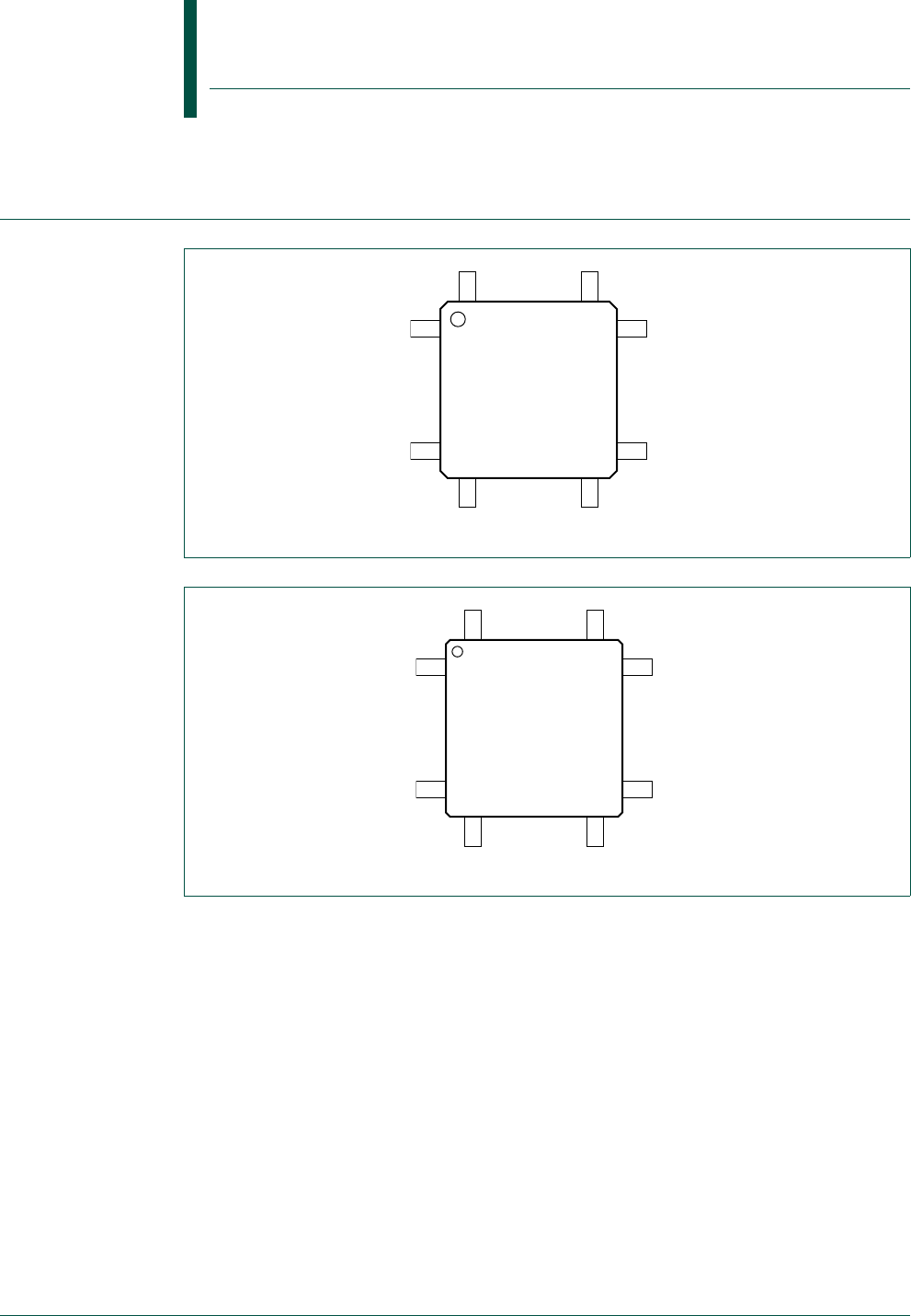
UM10360 All information provided in this document is subject to legal disclaimers. © NXP B.V. 2014. All rights reserved.
User manual Rev. 3.1 — 2 April 2014 92 of 849
7.1 LPC176x/5x pin configuration
UM10360
Chapter 7: LPC176x/5x Pin configuration
Rev. 3.1 — 2 April 2014 User manual
Fig 14. LPC176x LQFP100 pin configuration
Fig 15. LPC175x LQFP80 pin configuration
75
26
50
100
76
51
1
25
002aad945_1
60
21
40
80
61
41
1
20
002aae158
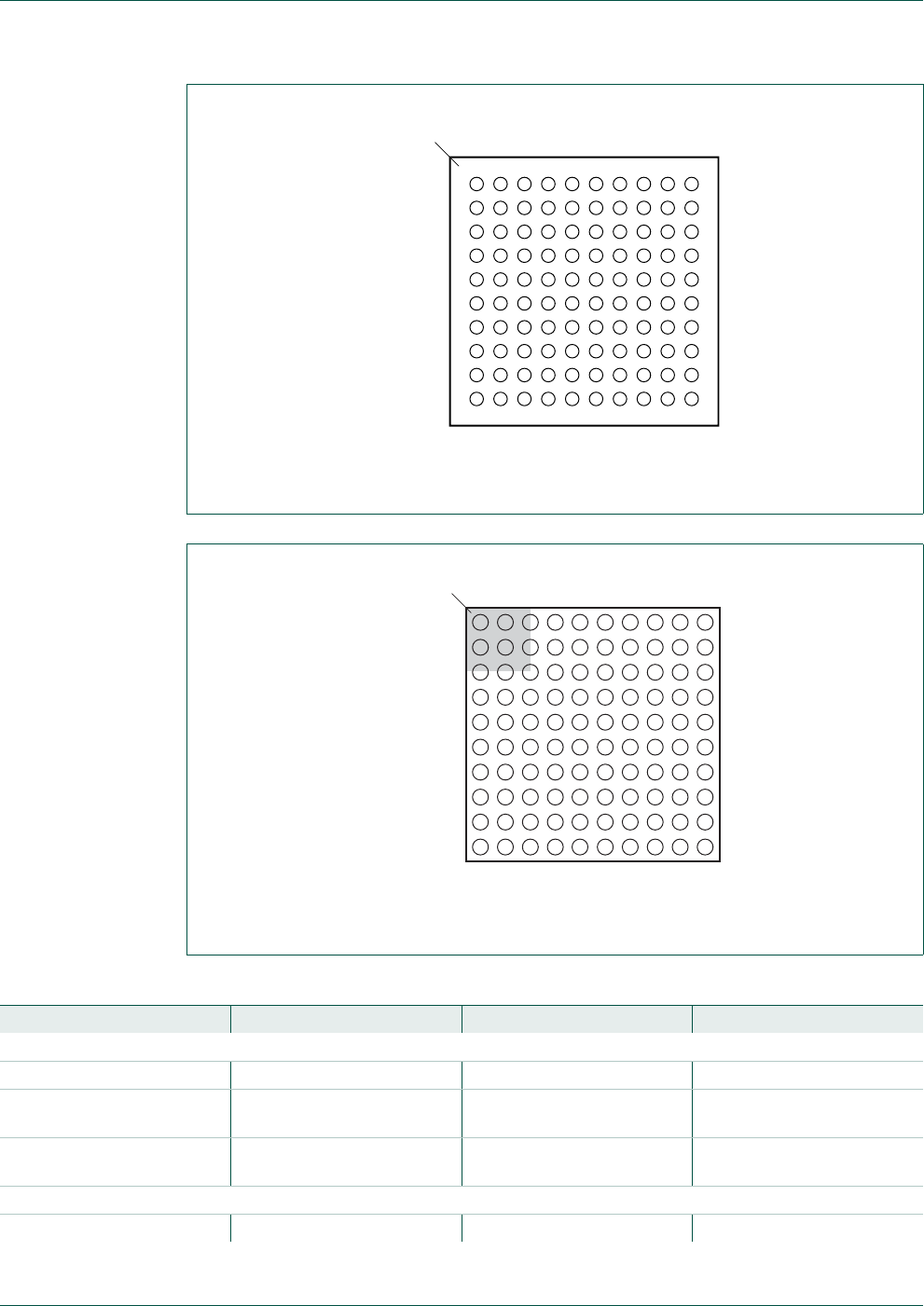
UM10360 All information provided in this document is subject to legal disclaimers. © NXP B.V. 2014. All rights reserved.
User manual Rev. 3.1 — 2 April 2014 93 of 849
NXP Semiconductors UM10360
Chapter 7: LPC176x/5x Pin configuration
Fig 16. Pin configuration TFBGA100 package
Fig 17. Pin configuration WLCSP100 package
002aaf723
LPC1768FET100
Transparent top view
J
G
K
H
F
E
D
C
B
A
24681013579
ball A1
index area
Transparent top view
1
A
B
C
D
E
F
G
H
J
K
2345678910
LPC1768UK
bump A1
index area
aaa-009522
Table 72. Pin allocation table TFBGA100 package
Pin Symbol Pin Symbol Pin Symbol Pin Symbol
Row A
1TDO/SWO 2P0[3]/RXD0/AD0[6] 3V
DD(3V3) 4P1[4]/ENET_TX_EN
5P1[10]/ENET_RXD1 6P1[16]/ENET_MDC 7V
DD(REG)(3V3) 8P0[4]/I2SRX_CLK/
RD2/CAP2[0]
9P0[7]/I2STX_CLK/
SCK1/MAT2[1]
10 P0[9]/I2STX_SDA/
MOSI1/MAT2[3]
11 - 12 -
Row B
1TMS/SWDIO 2RTCK 3V
SS 4P1[1]/ENET_TXD1

UM10360 All information provided in this document is subject to legal disclaimers. © NXP B.V. 2014. All rights reserved.
User manual Rev. 3.1 — 2 April 2014 94 of 849
NXP Semiconductors UM10360
Chapter 7: LPC176x/5x Pin configuration
5P1[9]/ENET_RXD0 6P1[17]/
ENET_MDIO
7V
SS 8P0[6]/I2SRX_SDA/
SSEL1/MAT2[0]
9P2[0]/PWM1[1]/TXD1 10P2[1]/PWM1[2]/RXD111- 12-
Row C
1TCK/SWDCLK 2TRST 3TDI 4P0[2]/TXD0/AD0[7]
5P1[8]/ENET_CRS 6P1[15]/
ENET_REF_CLK
7P4[28]/RX_MCLK/
MAT2[0]/TXD3
8P0[8]/I2STX_WS/
MISO1/MAT2[2]
9V
SS 10 VDD(3V3) 11 - 12 -
Row D
1P0[24]/AD0[1]/
I2SRX_WS/CAP3[1]
2P0[25]/AD0[2]/
I2SRX_SDA/TXD3
3P0[26]/AD0[3]/
AOUT/RXD3
4n.c.
5P1[0]/ENET_TXD0 6P1[14]/ENET_RX_ER7P0[5]/I2SRX_WS/
TD2/CAP2[1]
8P2[2]/PWM1[3]/
CTS1/TRACEDATA[3]
9P2[4]/PWM1[5]/
DSR1/TRACEDATA[1]
10 P2[5]/PWM1[6]/
DTR1/TRACEDATA[0]
11 - 12 -
Row E
1V
SSA 2V
DDA 3VREFP 4n.c.
5P0[23]/AD0[0]/
I2SRX_CLK/CAP3[0]
6P4[29]/TX_MCLK/
MAT2[1]/RXD3
7P2[3]/PWM1[4]/
DCD1/TRACEDATA[2]
8 P2[6]/PCAP1[0]/
RI1/TRACECLK
9P2[7]/RD2/RTS1 10P2[8]/TD2/TXD2 11- 12 -
Row F
1VREFN 2RTCX1 3RESET 4P1[31]/SCK1/
AD0[5]
5 P1[21]/MCABORT/
PWM1[3]/SSEL0
6P0[18]/DCD1/
MOSI0/MOSI
7P2[9]/USB_CONNECT/
RXD2
8P0[16]/RXD1/
SSEL0/SSEL
9P0[17]/CTS1/
MISO0/MISO
10 P0[15]/TXD1/
SCK0/SCK
11 - 12 -
Row G
1RTCX2 2VBAT 3XTAL2 4P0[30]/USB_D
5P1[25]/MCOA1/
MAT1[1]
6P1[29]/MCOB2/
PCAP1[1]/MAT0[1]
7V
SS 8P0[21]/RI1/RD1
9P0[20]/DTR1/SCL1 10P0[19]/DSR1/SDA1 11 - 12 -
Row H
1P1[30]/V
BUS/
AD0[4]
2XTAL1 3P3[25]/MAT0[0]/
PWM1[2]
4P1[18]/USB_UP_LED/
PWM1[1]/CAP1[0]
5P1[24]/MCI2/
PWM1[5]/MOSI0
6V
DD(REG)(3V3) 7P0[10]/TXD2/
SDA2/MAT3[0]
8P2[11]/EINT1/
I2STX_CLK
9V
DD(3V3) 10 P0[22]/RTS1/TD1 11 - 12 -
Table 72. Pin allocation table TFBGA100 package …continued
Pin Symbol Pin Symbol Pin Symbol Pin Symbol
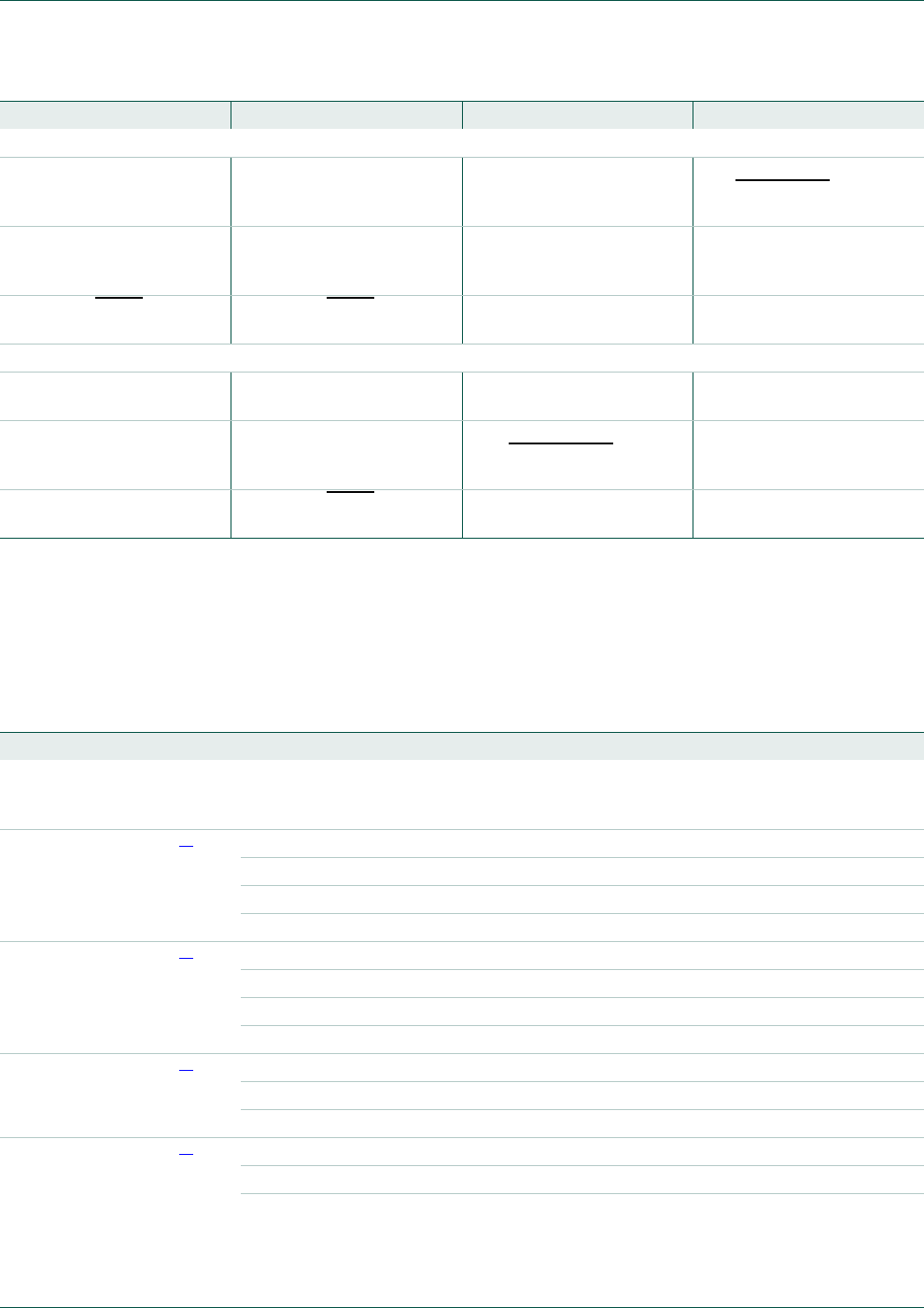
UM10360 All information provided in this document is subject to legal disclaimers. © NXP B.V. 2014. All rights reserved.
User manual Rev. 3.1 — 2 April 2014 95 of 849
NXP Semiconductors UM10360
Chapter 7: LPC176x/5x Pin configuration
7.1.1 LPC176x/5x pin description
I/O pins on the LPC176x/5x are 5V tolerant and have input hysteresis unless indicated in
the table below. Crystal pins, power pins, and reference voltage pins are not 5V tolerant.
In addition, when pins are selected to be A to D converter inputs, they are no longer 5V
tolerant and must be limited to the voltage at the ADC positive reference pin (VREFP).
Row J
1P0[28]/SCL0/
USB_SCL
2P0[27]/SDA0/
USB_SDA
3P0[29]/USB_D+ 4P1[19]/MCOA0/
USB_PPWR/
CAP1[1]
5P1[22]/MCOB0/
USB_PWRD/
MAT1[0]
6V
SS 7P1[28]/MCOA2/
PCAP1[0]/
MAT0[0]
8P0[1]/TD1/RXD3/SCL1
9P2[13]/EINT3
/
I2STX_SDA
10 P2[10]/EINT0/NMI 11 - 12 -
Row K
1P3[26]/STCLK/
MAT0[1]/PWM1[3]
2V
DD(3V3) 3V
SS 4P1[20]/MCI0/
PWM1[2]/SCK0
5P1[23]/MCI1/
PWM1[4]/MISO0
6P1[26]/MCOB1/
PWM1[6]/CAP0[0]
7P1[27]/CLKOUT
/USB_OVRCR/
CAP0[1]
8P0[0]/RD1/TXD3/SDA1
9P0[11]/RXD2/
SCL2/MAT3[1]
10 P2[12]/EINT2/
I2STX_WS
11 - 12 -
Table 72. Pin allocation table TFBGA100 package …continued
Pin Symbol Pin Symbol Pin Symbol Pin Symbol
Table 73. Pin description (LPC175x)
Symbol Pin Type Description
P0[0] to P0[31] I/O Port 0: Port 0 is a 32-bit I/O port with individual direction controls for each bit. The
operation of Port 0 pins depends upon the pin function selected via the pin
connect block. Some port pins are not available on the LQFP80 package.
P0[0]/RD1/TXD3/
SDA1
37[1] I/O P0[0] — General purpose digital input/output pin.
IRD1 — CAN1 receiver input.
OTXD3 — Transmitter output for UART3.
I/O SDA1 — I2C1 data input/output (this is not an I2C-bus compliant open-drain pin).
P0[1]/TD1/RXD3/
SCL1
38[1] I/O P0[1] — General purpose digital input/output pin.
OTD1 — CAN1 transmitter output.
IRXD3 — Receiver input for UART3.
I/O SCL1 — I2C1 clock input/output (this is not an I2C-bus compliant open-drain pin).
P0[2]/TXD0/AD0[7] 79[2] I/O P0[2] — General purpose digital input/output pin.
OTXD0 — Transmitter output for UART0.
IAD0[7] — A/D converter 0, input 7.
P0[3]/RXD0/AD0[6] 80[2] I/O P0[3] — General purpose digital input/output pin.
IRXD0 — Receiver input for UART0.
IAD0[6] — A/D converter 0, input 6.

UM10360 All information provided in this document is subject to legal disclaimers. © NXP B.V. 2014. All rights reserved.
User manual Rev. 3.1 — 2 April 2014 96 of 849
NXP Semiconductors UM10360
Chapter 7: LPC176x/5x Pin configuration
P0[6]/
I2SRX_SDA/
SSEL1/MAT2[0]
64[1] I/O P0[6] — General purpose digital input/output pin.
I/O I2SRX_SDA — Receive data. It is driven by the transmitter and read by the
receiver. Corresponds to the signal SD in the I2S-bus specification.
(LPC1759/58/56 only).
I/O SSEL1 — Slave Select for SSP1.
OMAT2[0] — Match output for Timer 2, channel 0.
P0[7]/I2STX_CLK/
SCK1/MAT2[1]
63[1] I/O P0[7] — General purpose digital input/output pin.
I/O I2STX_CLK — Transmit Clock. It is driven by the master and received by the
slave. Corresponds to the signal SCK in the I2S-bus specification.
(LPC1759/58/56 only).
I/O SCK1 — Serial Clock for SSP1.
OMAT2[1] — Match output for Timer 2, channel 1.
P0[8]/I2STX_WS/
MISO1/MAT2[2]
62[1] I/O P0[8] — General purpose digital input/output pin.
I/O I2STX_WS — Transmit Word Select. It is driven by the master and received by the
slave. Corresponds to the signal WS in the I2S-bus specification. (LPC1759/58/56
only).
I/O MISO1 — Master In Slave Out for SSP1.
OMAT2[2] — Match output for Timer 2, channel 2.
P0[9]/I2STX_SDA/
MOSI1/MAT2[3]
61[1] I/O P0[9] — General purpose digital input/output pin.
I/O I2STX_SDA — Transmit data. It is driven by the transmitter and read by the
receiver. Corresponds to the signal SD in the I2S-bus specification.
(LPC1759/58/56 only).
I/O MOSI1 — Master Out Slave In for SSP1.
OMAT2[3] — Match output for Timer 2, channel 3.
P0[10]/TXD2/
SDA2/MAT3[0]
39[1] I/O P0[10] — General purpose digital input/output pin.
OTXD2 — Transmitter output for UART2.
I/O SDA2 — I2C2 data input/output (this is not an open-drain pin).
OMAT3[0] — Match output for Timer 3, channel 0.
P0[11]/RXD2/
SCL2/MAT3[1]
40[1] I/O P0[11] — General purpose digital input/output pin.
IRXD2 — Receiver input for UART2.
I/O SCL2 — I2C2 clock input/output (this is not an open-drain pin).
OMAT3[1] — Match output for Timer 3, channel 1.
P0[15]/TXD1/
SCK0/SCK
47[1] I/O P0[15] — General purpose digital input/output pin.
OTXD1 — Transmitter output for UART1.
I/O SCK0 — Serial clock for SSP0.
I/O SCK — Serial clock for SPI.
P0[16]/RXD1/
SSEL0/SSEL
48[1] I/O P0[16] — General purpose digital input/output pin.
IRXD1 — Receiver input for UART1.
I/O SSEL0 — Slave Select for SSP0.
I/O SSEL — Slave Select for SPI.
Table 73. Pin description (LPC175x) …continued
Symbol Pin Type Description

UM10360 All information provided in this document is subject to legal disclaimers. © NXP B.V. 2014. All rights reserved.
User manual Rev. 3.1 — 2 April 2014 97 of 849
NXP Semiconductors UM10360
Chapter 7: LPC176x/5x Pin configuration
P0[17]/CTS1/
MISO0/MISO
46[1] I/O P0[17] — General purpose digital input/output pin.
ICTS1 — Clear to Send input for UART1.
I/O MISO0 — Master In Slave Out for SSP0.
I/O MISO — Master In Slave Out for SPI.
P0[18]/DCD1/
MOSI0/MOSI
45[1] I/O P0[18] — General purpose digital input/output pin.
IDCD1 — Data Carrier Detect input for UART1.
I/O MOSI0 — Master Out Slave In for SSP0.
I/O MOSI — Master Out Slave In for SPI.
P0[22]/RTS1/TD1 44[1] I/O P0[22] — General purpose digital input/output pin.
ORTS1 — Request to Send output for UART1. Can also be configured to be an
RS-485/EIA-485 output enable signal.
OTD1 — CAN1 transmitter output.
P0[25]/AD0[2]/
I2SRX _SDA/
TXD3
7[2] I/O P0[25] — General purpose digital input/output pin.
IAD0[2] — A/D converter 0, input 2.
I/O I2SRX_SDA — Receive data. It is driven by the transmitter and read by the
receiver. Corresponds to the signal SD in the I2S-bus specification.
(LPC1759/58/56 only).
OTXD3 — Transmitter output for UART3.
P0[26]/AD0[3]/
AOUT/RXD3
6[3] I/O P0[26] — General purpose digital input/output pin.
IAD0[3] — A/D converter 0, input 3.
OAOUT — DAC output. (LPC1759/58/56/54 only).
IRXD3 — Receiver input for UART3.
P0[29]/USB_D+ 22[4] I/O P0[29] — General purpose digital input/output pin.
I/O USB_D+ — USB bidirectional D+ line.
P0[30]/USB_D23[4] I/O P0[30] — General purpose digital input/output pin.
I/O USB_D — USB bidirectional D line.
P1[0] to P1[31] I/O Port 1: Port 1 is a 32-bit I/O port with individual direction controls for each bit. The
operation of port 1 pins depends upon the pin function selected via the pin connect
block. Some port pins are not available on the LQFP80 package.
P1[0]/
ENET_TXD0
76[1] I/O P1[0] — General purpose digital input/output pin.
OENET_TXD0 — Ethernet transmit data 0. (LPC1758 only).
P1[1]/
ENET_TXD1
75[1] I/O P1[1] — General purpose digital input/output pin.
OENET_TXD1 — Ethernet transmit data 1. (LPC1758 only).
P1[4]/
ENET_TX_EN
74[1] I/O P1[4] — General purpose digital input/output pin.
OENET_TX_EN — Ethernet transmit data enable. (LPC1758 only).
P1[8]/
ENET_CRS
73[1] I/O P1[8] — General purpose digital input/output pin.
IENET_CRS — Ethernet carrier sense. (LPC1758 only).
P1[9]/
ENET_RXD0
72[1] I/O P1[9] — General purpose digital input/output pin.
IENET_RXD0 — Ethernet receive data. (LPC1758 only).
P1[10]/
ENET_RXD1
71[1] I/O P1[10] — General purpose digital input/output pin.
IENET_RXD1 — Ethernet receive data. (LPC1758 only).
Table 73. Pin description (LPC175x) …continued
Symbol Pin Type Description
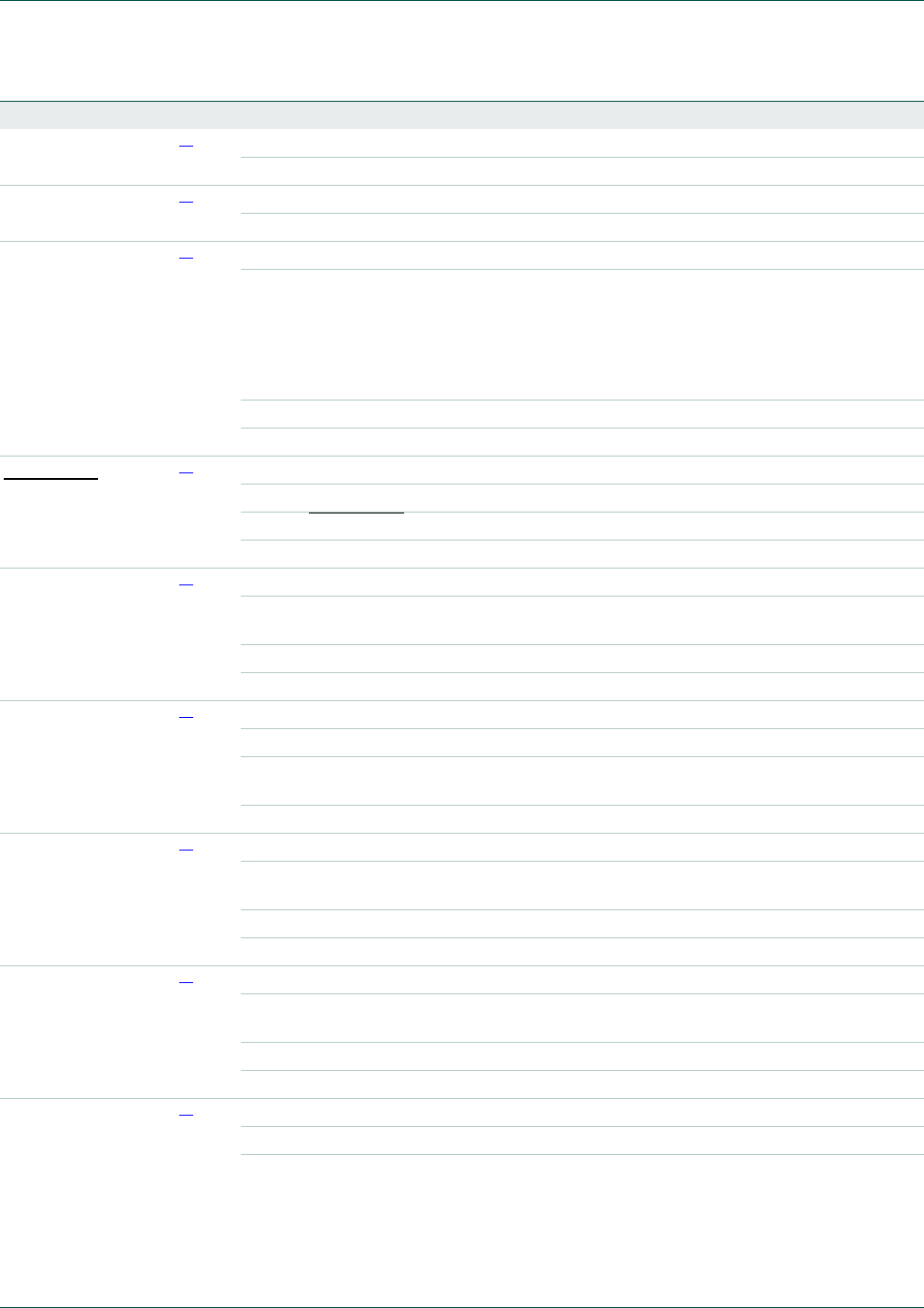
UM10360 All information provided in this document is subject to legal disclaimers. © NXP B.V. 2014. All rights reserved.
User manual Rev. 3.1 — 2 April 2014 98 of 849
NXP Semiconductors UM10360
Chapter 7: LPC176x/5x Pin configuration
P1[14]/
ENET_RX_ER
70[1] I/O P1[14] — General purpose digital input/output pin.
IENET_RX_ER — Ethernet receive error. (LPC1758 only).
P1[15]/
ENET_REF_CLK
69[1] I/O P1[15] — General purpose digital input/output pin.
IENET_REF_CLK — Ethernet reference clock. (LPC1758 only).
P1[18]/
USB_UP_LED/
PWM1[1]/
CAP1[0]
25[1] I/O P1[18] — General purpose digital input/output pin.
OUSB_UP_LED — USB GoodLink LED indicator. It is LOW when the device is
configured (non-control endpoints enabled), or when the host is enabled and has
detected a device on the bus. It is HIGH when the device is not configured, or
when host is enabled and has not detected a device on the bus, or during global
suspend. It transitions between LOW and HIGH (flashes) when the host is enabled
and detects activity on the bus.
OPWM1[1] — Pulse Width Modulator 1, channel 1 output.
ICAP1[0] — Capture input for Timer 1, channel 0.
P1[19]/MCOA0/
USB_PPWR
CAP1[1]
26[1] I/O P1[19] — General purpose digital input/output pin.
OMCOA0 — Motor control PWM channel 0, output A.
OUSB_PPWR — Port Power enable signal for USB port. (LPC1759/58/56/54 only).
ICAP1[1] — Capture input for Timer 1, channel 1.
P1[20]/MCI0/
PWM1[2]/SCK0
27[1] I/O P1[20] — General purpose digital input/output pin.
IMCI0 — Motor control PWM channel 0, input. Also Quadrature Encoder Interface
PHA input.
OPWM1[2] — Pulse Width Modulator 1, channel 2 output.
I/O SCK0 — Serial clock for SSP0.
P1[22]/MCOB0/
USB_PWRD/
MAT1[0]
28[1] I/O P1[22] — General purpose digital input/output pin.
OMCOB0 — Motor control PWM channel 0, output B.
IUSB_PWRD — Power Status for USB port (host power switch).
(LPC1759/58/56/54 only).
OMAT1[0] — Match output for Timer 1, channel 0.
P1[23]/MCI1/
PWM1[4]/MISO0
29[1] I/O P1[23] — General purpose digital input/output pin.
IMCI1 — Motor control PWM channel 1, input. Also Quadrature Encoder Interface
PHB input.
OPWM1[4] — Pulse Width Modulator 1, channel 4 output.
I/O MISO0 — Master In Slave Out for SSP0.
P1[24]/MCI2/
PWM1[5]/MOSI0
30[1] I/O P1[24] — General purpose digital input/output pin.
IMCI2 — Motor control PWM channel 2, input. Also Quadrature Encoder Interface
INDEX input.
OPWM1[5] — Pulse Width Modulator 1, channel 5 output.
I/O MOSI0 — Master Out Slave in for SSP0.
P1[25]/MCOA1/
MAT1[1]
31[1] I/O P1[25] — General purpose digital input/output pin.
OMCOA1 — Motor control PWM channel 1, output A.
OMAT1[1] — Match output for Timer 1, channel 1.
Table 73. Pin description (LPC175x) …continued
Symbol Pin Type Description

UM10360 All information provided in this document is subject to legal disclaimers. © NXP B.V. 2014. All rights reserved.
User manual Rev. 3.1 — 2 April 2014 99 of 849
NXP Semiconductors UM10360
Chapter 7: LPC176x/5x Pin configuration
P1[26]/MCOB1/
PWM1[6]/CAP0[0]
32[1] I/O P1[26] — General purpose digital input/output pin.
OMCOB1 — Motor control PWM channel 1, output B.
OPWM1[6] — Pulse Width Modulator 1, channel 6 output.
ICAP0[0] — Capture input for Timer 0, channel 0.
P1[28]/MCOA2/
PCAP1[0]/
MAT0[0]
35[1] I/O P1[28] — General purpose digital input/output pin.
OMCOA2 — Motor control PWM channel 2, output A.
IPCAP1[0] — Capture input for PWM1, channel 0.
OMAT0[0] — Match output for Timer 0, channel 0.
P1[29]/MCOB2/
PCAP1[1]/
MAT0[1]
36[1] I/O P1[29] — General purpose digital input/output pin.
OMCOB2 — Motor control PWM channel 2, output B.
IPCAP1[1] — Capture input for PWM1, channel 1.
OMAT0[1] — Match output for Timer 0, channel 1.
P1[30]/VBUS/
AD0[4]
18[2] I/O P1[30] — General purpose digital input/output pin.
IVBUS — Monitors the presence of USB bus power.
Note: This signal must be HIGH for USB reset to occur.
IAD0[4] — A/D converter 0, input 4.
P1[31]/SCK1/
AD0[5]
17[2] I/O P1[31] — General purpose digital input/output pin.
I/O SCK1 — Serial Clock for SSP1.
IAD0[5] — A/D converter 0, input 5.
P2[0] to P2[31] I/O Port 2: Port 2 is a 32-bit I/O port with individual direction controls for each bit. The
operation of port 2 pins depends upon the pin function selected via the pin connect
block. Some port pins are not available on the LQFP80 package.
P2[0]/PWM1[1]/
TXD1
60[1] I/O P2[0] — General purpose digital input/output pin.
OPWM1[1] — Pulse Width Modulator 1, channel 1 output.
OTXD1 — Transmitter output for UART1.
P2[1]/PWM1[2]/
RXD1
59[1] I/O P2[1] — General purpose digital input/output pin.
OPWM1[2] — Pulse Width Modulator 1, channel 2 output.
IRXD1 — Receiver input for UART1.
P2[2]/PWM1[3]/
CTS1/
TRACEDATA[3]
58[1] I/O P2[2] — General purpose digital input/output pin.
OPWM1[3] — Pulse Width Modulator 1, channel 3 output.
ICTS1 — Clear to Send input for UART1.
OTRACEDATA[3] — Trace data, bit 3.
P2[3]/PWM1[4]/
DCD1/
TRACEDATA[2]
55[1] I/O P2[3] — General purpose digital input/output pin.
OPWM1[4] — Pulse Width Modulator 1, channel 4 output.
IDCD1 — Data Carrier Detect input for UART1.
OTRACEDATA[2] — Trace data, bit 2.
P2[4]/PWM1[5]/
DSR1/
TRACEDATA[1]
54[1] I/O P2[4] — General purpose digital input/output pin.
OPWM1[5] — Pulse Width Modulator 1, channel 5 output.
IDSR1 — Data Set Ready input for UART1.
OTRACEDATA[1] — Trace data, bit 1.
Table 73. Pin description (LPC175x) …continued
Symbol Pin Type Description
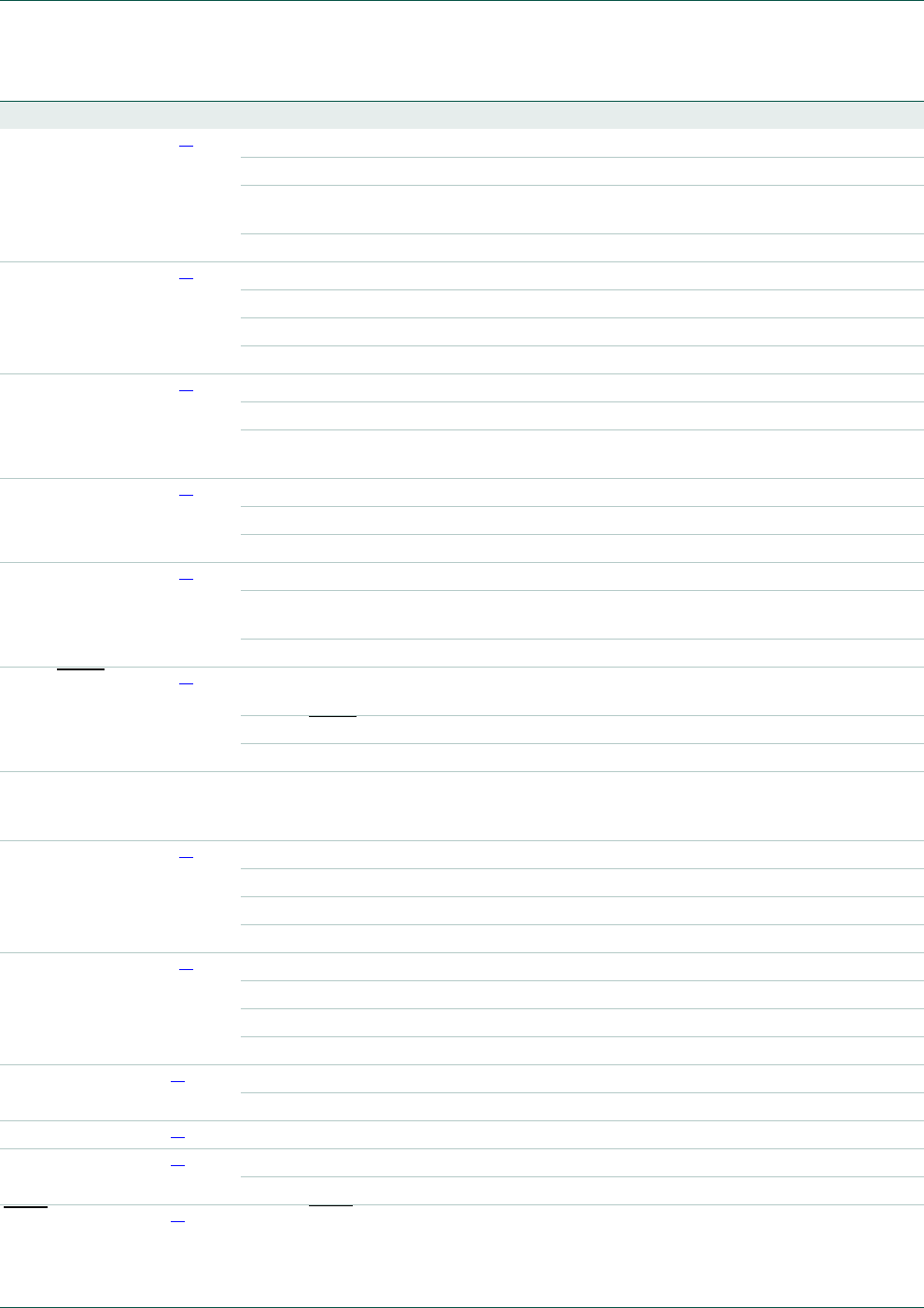
UM10360 All information provided in this document is subject to legal disclaimers. © NXP B.V. 2014. All rights reserved.
User manual Rev. 3.1 — 2 April 2014 100 of 849
NXP Semiconductors UM10360
Chapter 7: LPC176x/5x Pin configuration
P2[5]/PWM1[6]/
DTR1/
TRACEDATA[0]
53[1] I/O P2[5] — General purpose digital input/output pin.
OPWM1[6] — Pulse Width Modulator 1, channel 6 output.
ODTR1 — Data Terminal Ready output for UART1. Can also be configured to be an
RS-485/EIA-485 output enable signal.
OTRACEDATA[0] — Trace data, bit 0.
P2[6]/PCAP1[0]/
RI1/TRACECLK
52[1] I/O P2[6] — General purpose digital input/output pin.
IPCAP1[0] — Capture input for PWM1, channel 0.
IRI1 — Ring Indicator input for UART1.
OTRACECLK — Trace Clock.
P2[7]/RD2/
RTS1
51[1] I/O P2[7] — General purpose digital input/output pin.
IRD2 — CAN2 receiver input. (LPC1759/58/56 only).
ORTS1 — Request to Send output for UART1. Can also be configured to be an
RS-485/EIA-485 output enable signal.
P2[8]/TD2/
TXD2
50[1] I/O P2[8] — General purpose digital input/output pin.
OTD2 — CAN2 transmitter output. (LPC1759/58/56 only).
OTXD2 — Transmitter output for UART2.
P2[9]/
USB_CONNECT/
RXD2
49[1] I/O P2[9] — General purpose digital input/output pin.
OUSB_CONNECT — Signal used to switch an external 1.5 k resistor under
software control. Used with the SoftConnect USB feature.
IRXD2 — Receiver input for UART2.
P2[10]/EINT0/NMI 41[5] I/O P2[10] — General purpose digital input/output pin. A LOW level on this pin during
reset starts the ISP command handler.
IEINT0 — External interrupt 0 input.
INMI — Non-maskable interrupt input.
P4[0] to P4[31] I/O Port 4: Port 4 is a 32-bit I/O port with individual direction controls for each bit. The
operation of port 4 pins depends upon the pin function selected via the pin connect
block. Some port pins are not available on the LQFP80 package.
P4[28]/RX_MCLK/
MAT2[0]/TXD3
65[1] I/O P4[28] — General purpose digital input/output pin.
ORX_MCLK — I2S receive master clock. (LPC1759/58/56 only).
OMAT2[0] — Match output for Timer 2, channel 0.
OTXD3 — Transmitter output for UART3.
P4[29]/TX_MCLK/
MAT2[1]/RXD3
68[1] I/O P4[29] — General purpose digital input/output pin.
OTX_MCLK — I2S transmit master clock. (LPC1759/58/56 only).
OMAT2[1] — Match output for Timer 2, channel 1.
IRXD3 — Receiver input for UART3.
TDO/SWO 1[6] OTDO — Test D a ta o ut f o r J TA G i n t erfa c e .
OSWO — Serial wire trace output.
TDI 2[7] ITDI — Tes t D a ta i n f or J TA G i nt e r f ace .
TMS/SWDIO 3[7] ITMS — Test Mod e S elec t f o r J TAG int e r f ace .
I/O SWDIO — Serial wire debug data input/output.
TRST 4[7] ITRST — Test R e s et f o r JTAG i n ter f a c e.
Table 73. Pin description (LPC175x) …continued
Symbol Pin Type Description
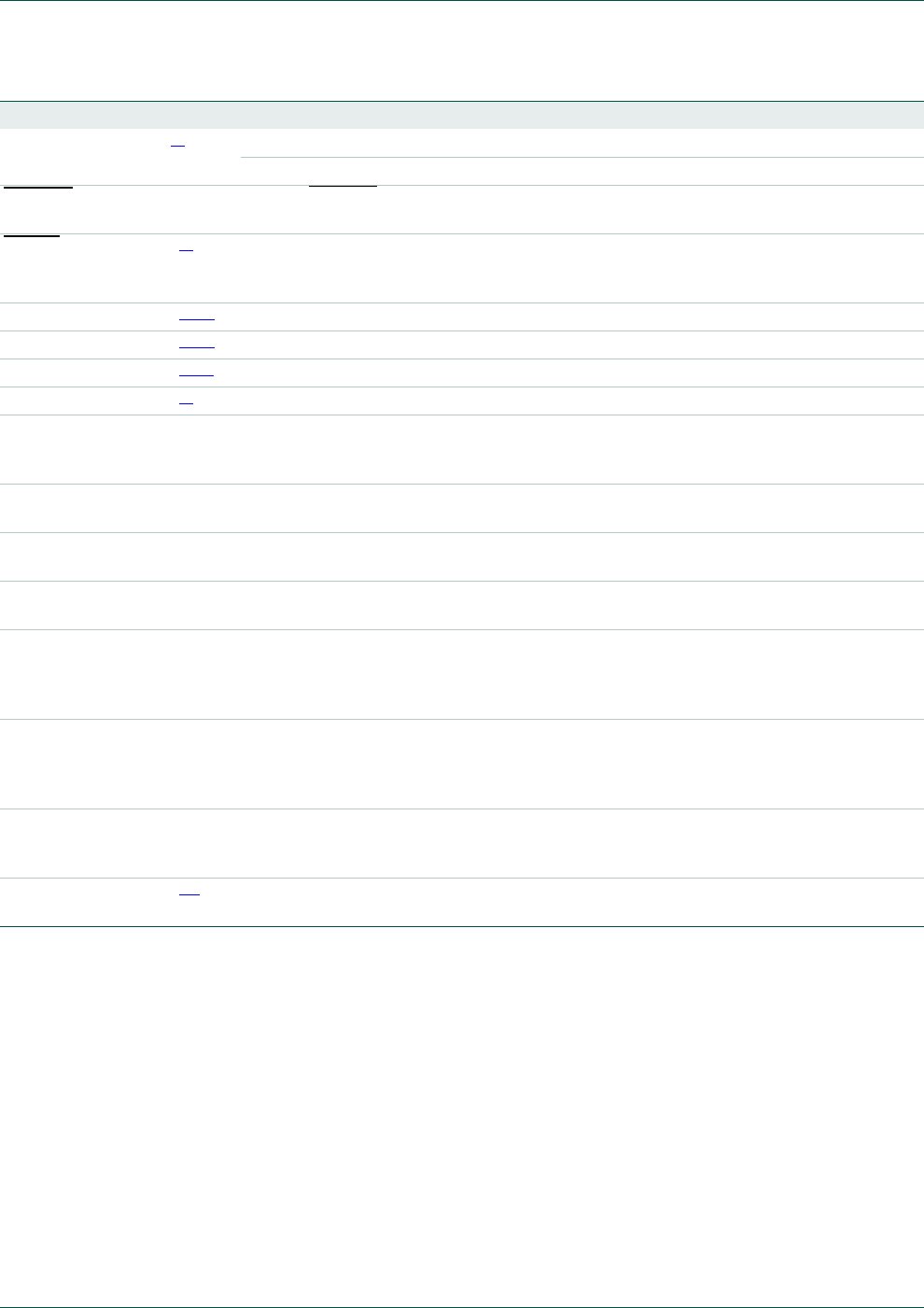
UM10360 All information provided in this document is subject to legal disclaimers. © NXP B.V. 2014. All rights reserved.
User manual Rev. 3.1 — 2 April 2014 101 of 849
NXP Semiconductors UM10360
Chapter 7: LPC176x/5x Pin configuration
[1] 5 V tolerant pad providing digital I/O functions with TTL levels and hysteresis. This pin is pulled up to a voltage level of 2.3 V to 2.6 V.
[2] 5 V tolerant pad providing digital I/O functions (with TTL levels and hysteresis) and analog input. When configured as a ADC input,
digital section of the pad is disabled and the pin is not 5 V tolerant. This pin is pulled up to a voltage level of 2.3 V to 2.6 V.
[3] 5 V tolerant pad providing digital I/O with TTL levels and hysteresis and analog output function. When configured as the DAC output,
digital section of the pad is disabled. This pin is pulled up to a voltage level of 2.3 V to 2.6 V.
[4] Pad provides digital I/O and USB functions. It is designed in accordance with the USB specification, revision 2.0 (Full-speed and
Low-speed mode only). This pad is not 5 V tolerant.
[5] 5 V tolerant pad with 10 ns glitch filter providing digital I/O functions with TTL levels and hysteresis. This pin is pulled up to a voltage
level of 2.3 V to 2.6 V.
[6] 5 V tolerant pad with TTL levels and hysteresis. Internal pull-up and pull-down resistors disabled.
[7] 5 V tolerant pad with TTL levels and hysteresis and internal pull-up resistor.
[8] 5 V tolerant pad with 20 ns glitch filter providing digital I/O function with TTL levels and hysteresis.
[9] Pad provides special analog functionality. 32 kHz crystal oscillator must be used with the RTC.
TCK/SWDCLK 5[6] ITCK — Tes t C loc k f or J TA G i n ter f a c e .
ISWDCLK — Serial wire clock.
RSTOUT 11 O RSTOUT — This is a 3.3 V pin. LOW on this pin indicates UM10360 being in
Reset state.
RESET 14[8] IExternal reset input: A LOW-going pulse as short as 50 ns on this pin resets the
device, causing I/O ports and peripherals to take on their default states, and
processor execution to begin at address 0. TTL with hysteresis, 5 V tolerant.
XTAL1 19[9][10] IInput to the oscillator circuit and internal clock generator circuits.
XTAL2 20[9][10] OOutput from the oscillator amplifier.
RTCX1 13[9][11] IInput to the RTC oscillator circuit.
RTCX2 15[9] OOutput from the RTC oscillator circuit.
VSS 24, 33,
43, 57,
66, 78
Iground: 0 V reference.
VSSA 9Ianalog ground: 0 V reference. This should nominally be the same voltage as VSS,
but should be isolated to minimize noise and error.
VDD(3V3) 21, 42,
56, 77
I3.3 V supply voltage: This is the power supply voltage for the I/O ports.
VDD(REG)(3V3) 34, 67 I 3.3 V voltage regulator supply voltage: This is the supply voltage for the on-chip
voltage regulator only.
VDDA 8Ianalog 3.3 V pad supply voltage: This should be nominally the same voltage as
VDD(3V3) but should be isolated to minimize noise and error. This voltage is used to
power the ADC and DAC. This pin should be tied to 3.3 V if the ADC and DAC are
not used.
VREFP 10 I ADC positive reference voltage: This should be nominally the same voltage as
VDDA but should be isolated to minimize noise and error. Level on this pin is used
as a reference for ADC and DAC. This pin should be tied to 3.3 V if the ADC and
DAC are not used.
VREFN 12 I ADC negative reference voltage: This should be nominally the same voltage as
VSS but should be isolated to minimize noise and error. Level on this pin is used as
a reference for ADC and DAC.
VBAT 16[11] IRTC pin power supply: 3.3 V on this pin supplies the power to the RTC
peripheral.
Table 73. Pin description (LPC175x) …continued
Symbol Pin Type Description

UM10360 All information provided in this document is subject to legal disclaimers. © NXP B.V. 2014. All rights reserved.
User manual Rev. 3.1 — 2 April 2014 102 of 849
NXP Semiconductors UM10360
Chapter 7: LPC176x/5x Pin configuration
[10] When the system oscillator is not used, connect XTAL1 and XTAL2 as follows: XTAL1 can be left floating or can be grounded (grounding
is preferred to reduce susceptibility to noise). XTAL2 should be left floating.
[11] When the RTC is not used, connect VBAT to VDD(REG)(3V3) and leave RTCX1 floating.
Table 74. Pin description (LPC176x)
Symbol Pin/ball Type Description
LQFP100
TFBGA100
WLCSP100
P0[0] to P0[31] I/O Port 0: Port 0 is a 32-bit I/O port with individual direction controls for
each bit. The operation of port 0 pins depends upon the pin function
selected via the pin connect block. Pins 12, 13, 14, and 31 of this
port are not available.
P0[0]/RD1/TXD3/
SDA1
46 K8 H10 [1] I/O P0[0] — General purpose digital input/output pin.
IRD1 — CAN1 receiver input. (LPC1769/68/66/65/64 only).
OTXD3 — Transmitter output for UART3.
I/O SDA1 — I2C1 data input/output. (This is not an I2C-bus compliant
open-drain pin).
P0[1]/TD1/RXD3/
SCL1
47 J8 H9 [1] I/O P0[1] — General purpose digital input/output pin.
OTD1 — CAN1 transmitter output. (LPC1769/68/66/65/64 only).
IRXD3 — Receiver input for UART3.
I/O SCL1 — I2C1 clock input/output. (This is not an I2C-bus compliant
open-drain pin).
P0[2]/TXD0/AD0[7] 98 C4 B1 [2] I/O P0[2] — General purpose digital input/output pin.
OTXD0 — Transmitter output for UART0.
IAD0[7] — A/D converter 0, input 7.
P0[3]/RXD0/AD0[6] 99 A2 C3 [2] I/O P0[3] — General purpose digital input/output pin.
IRXD0 — Receiver input for UART0.
IAD0[6] — A/D converter 0, input 6.
P0[4]/
I2SRX_CLK/
RD2/CAP2[0]
81 A8 G2 [1] I/O P0[4] — General purpose digital input/output pin.
I/O I2SRX_CLK — Receive Clock. It is driven by the master and
received by the slave. Corresponds to the signal SCK in the I2S-bus
specification. (LPC1769/68/67/66/65/63 only).
IRD2 — CAN2 receiver input. (LPC1769/68/66/65/64 only).
ICAP2[0] — Capture input for Timer 2, channel 0.
P0[5]/
I2SRX_WS/
TD2/CAP2[1]
80 D7 H1 [1] I/O P0[5] — General purpose digital input/output pin.
I/O I2SRX_WS — Receive Word Select. It is driven by the master and
received by the slave. Corresponds to the signal WS in the I2S-bus
specification. (LPC1769/68/67/66/65/63 only).
OTD2 — CAN2 transmitter output. (LPC1769/68/66/65/64 only).
ICAP2[1] — Capture input for Timer 2, channel 1.

UM10360 All information provided in this document is subject to legal disclaimers. © NXP B.V. 2014. All rights reserved.
User manual Rev. 3.1 — 2 April 2014 103 of 849
NXP Semiconductors UM10360
Chapter 7: LPC176x/5x Pin configuration
P0[6]/
I2SRX_SDA/
SSEL1/MAT2[0]
79 B8 G3 [1] I/O P0[6] — General purpose digital input/output pin.
I/O I2SRX_SDA — Receive data. It is driven by the transmitter and read
by the receiver. Corresponds to the signal SD in the I2S-bus
specification. (LPC1769/68/67/66/65/63 only).
I/O SSEL1 — Slave Select for SSP1.
OMAT2[0] — Match output for Timer 2, channel 0.
P0[7]/
I2STX_CLK/
SCK1/MAT2[1]
78 A9 J1 [1] I/O P0[7] — General purpose digital input/output pin.
I/O I2STX_CLK — Transmit Clock. It is driven by the master and
received by the slave. Corresponds to the signal SCK in the I2S-bus
specification. (LPC1769/68/67/66/65/63 only).
I/O SCK1 — Serial Clock for SSP1.
OMAT2[1] — Match output for Timer 2, channel 1.
P0[8]/
I2STX_WS/
MISO1/MAT2[2]
77 C8 H2 [1] I/O P0[8] — General purpose digital input/output pin.
I/O I2STX_WS — Transmit Word Select. It is driven by the master and
received by the slave. Corresponds to the signal WS in the I2S-bus
specification. (LPC1769/68/67/66/65/63 only).
I/O MISO1 — Master In Slave Out for SSP1.
OMAT2[2] — Match output for Timer 2, channel 2.
P0[9]/
I2STX_SDA/
MOSI1/MAT2[3]
76 A10 H3 [1] I/O P0[9] — General purpose digital input/output pin.
I/O I2STX_SDA — Transmit data. It is driven by the transmitter and
read by the receiver. Corresponds to the signal SD in the I2S-bus
specification. (LPC1769/68/67/66/65/63 only).
I/O MOSI1 — Master Out Slave In for SSP1.
OMAT2[3] — Match output for Timer 2, channel 3.
P0[10]/TXD2/
SDA2/MAT3[0]
48 H7 H8 [1] I/O P0[10] — General purpose digital input/output pin.
OTXD2 — Transmitter output for UART2.
I/O SDA2 — I2C2 data input/output (this is not an open-drain pin).
OMAT3[0] — Match output for Timer 3, channel 0.
P0[11]/RXD2/
SCL2/MAT3[1]
49 K9 J10 [1] I/O P0[11] — General purpose digital input/output pin.
IRXD2 — Receiver input for UART2.
I/O SCL2 — I2C2 clock input/output (this is not an open-drain pin).
OMAT3[1] — Match output for Timer 3, channel 1.
P0[15]/TXD1/
SCK0/SCK
62 F10 H6 [1] I/O P0[15] — General purpose digital input/output pin.
OTXD1 — Transmitter output for UART1.
I/O SCK0 — Serial clock for SSP0.
I/O SCK — Serial clock for SPI.
Table 74. Pin description (LPC176x) …continued
Symbol Pin/ball Type Description
LQFP100
TFBGA100
WLCSP100

UM10360 All information provided in this document is subject to legal disclaimers. © NXP B.V. 2014. All rights reserved.
User manual Rev. 3.1 — 2 April 2014 104 of 849
NXP Semiconductors UM10360
Chapter 7: LPC176x/5x Pin configuration
P0[16]/RXD1/
SSEL0/SSEL
63 F8 J5 [1] I/O P0[16] — General purpose digital input/output pin.
IRXD1 — Receiver input for UART1.
I/O SSEL0 — Slave Select for SSP0.
I/O SSEL — Slave Select for SPI.
P0[17]/CTS1/
MISO0/MISO
61 F9 K6 [1] I/O P0[17] — General purpose digital input/output pin.
ICTS1 — Clear to Send input for UART1.
I/O MISO0 — Master In Slave Out for SSP0.
I/O MISO — Master In Slave Out for SPI.
P0[18]/DCD1/
MOSI0/MOSI
60 F6 J6 [1] I/O P0[18] — General purpose digital input/output pin.
IDCD1 — Data Carrier Detect input for UART1.
I/O MOSI0 — Master Out Slave In for SSP0.
I/O MOSI — Master Out Slave In for SPI.
P0[19]/DSR1/
SDA1
59 G10 K7 [1] I/O P0[19] — General purpose digital input/output pin.
IDSR1 — Data Set Ready input for UART1.
I/O SDA1 — I2C1 data input/output (this is not an I2C-bus compliant
open-drain pin).
P0[20]/DTR1/SCL1 58 G9 J7 [1] I/O P0[20] — General purpose digital input/output pin.
ODTR1 — Data Terminal Ready output for UART1. Can also be
configured to be an RS-485/EIA-485 output enable signal.
I/O SCL1 — I2C1 clock input/output (this is not an I2C-bus compliant
open-drain pin).
P0[21]/RI1/RD1 57 G8 H7 [1] I/O P0[21] — General purpose digital input/output pin.
IRI1 — Ring Indicator input for UART1.
IRD1 — CAN1 receiver input. (LPC1769/68/66/65/64 only).
P0[22]/RTS1/TD1 56 H10 K8 [1] I/O P0[22] — General purpose digital input/output pin.
ORTS1 — Request to Send output for UART1. Can also be
configured to be an RS-485/EIA-485 output enable signal.
OTD1 — CAN1 transmitter output. (LPC1769/68/66/65/64 only).
P0[23]/AD0[0]/
I2SRX_CLK/
CAP3[0]
9E5D5
[2] I/O P0[23] — General purpose digital input/output pin.
IAD0[0] — A/D converter 0, input 0.
I/O I2SRX_CLK — Receive Clock. It is driven by the master and
received by the slave. Corresponds to the signal SCK in the I2S-bus
specification. (LPC1769/68/67/66/65/63 only).
ICAP3[0] — Capture input for Timer 3, channel 0.
Table 74. Pin description (LPC176x) …continued
Symbol Pin/ball Type Description
LQFP100
TFBGA100
WLCSP100

UM10360 All information provided in this document is subject to legal disclaimers. © NXP B.V. 2014. All rights reserved.
User manual Rev. 3.1 — 2 April 2014 105 of 849
NXP Semiconductors UM10360
Chapter 7: LPC176x/5x Pin configuration
P0[24]/AD0[1]/
I2SRX_WS/
CAP3[1]
8D1B4
[2] I/O P0[24] — General purpose digital input/output pin.
IAD0[1] — A/D converter 0, input 1.
I/O I2SRX_WS — Receive Word Select. It is driven by the master and
received by the slave. Corresponds to the signal WS in the I2S-bus
specification. (LPC1769/68/67/66/65/63 only).
ICAP3[1] — Capture input for Timer 3, channel 1.
P0[25]/AD0[2]/
I2SRX_SDA/
TXD3
7D2A3
[2] I/O P0[25] — General purpose digital input/output pin.
IAD0[2] — A/D converter 0, input 2.
I/O I2SRX_SDA — Receive data. It is driven by the transmitter and read
by the receiver. Corresponds to the signal SD in the I2S-bus
specification. (LPC1769/68/67/66/65/63 only).
OTXD3 — Transmitter output for UART3.
P0[26]/AD0[3]/
AOUT/RXD3
6D3C5
[3] I/O P0[26] — General purpose digital input/output pin.
IAD0[3] — A/D converter 0, input 3.
OAOUT — DAC output (LPC1769/68/67/66/65/63 only).
IRXD3 — Receiver input for UART3.
P0[27]/SDA0/
USB_SDA
25 J2 C8 [4] I/O P0[27] — General purpose digital input/output pin. Output is
open-drain.
I/O SDA0 — I2C0 data input/output. Open-drain output (for I2C-bus
compliance).
I/O USB_SDA — USB port I2C serial data (OTG transceiver,
LPC1769/68/66/65 only).
P0[28]/SCL0/
USB_SCL
24 J1 B9 [4] I/O P0[28] — General purpose digital input/output pin. Output is
open-drain.
I/O SCL0 — I2C0 clock input/output. Open-drain output (for I2C-bus
compliance).
I/O USB_SCL — USB port I2C serial clock (OTG transceiver,
LPC1769/68/66/65 only).
P0[29]/USB_D+ 29 J3 B10 [5] I/O P0[29] — General purpose digital input/output pin.
I/O USB_D+ — USB bidirectional D+ line. (LPC1769/68/66/65/64 only).
P0[30]/USB_D30 G4 C9 [5] I/O P0[30] — General purpose digital input/output pin.
I/O USB_D — USB bidirectional D line. (LPC1769/68/66/65/64 only).
P1[0] to P1[31] I/O Port 1: Port 1 is a 32-bit I/O port with individual direction controls for
each bit. The operation of port 1 pins depends upon the pin function
selected via the pin connect block. Pins 2, 3, 5, 6, 7, 11, 12, and 13
of this port are not available.
P1[0]/
ENET_TXD0
95 D5 C1 [1] I/O P1[0] — General purpose digital input/output pin.
OENET_TXD0 — Ethernet transmit data 0. (LPC1769/68/67/66/64
only).
Table 74. Pin description (LPC176x) …continued
Symbol Pin/ball Type Description
LQFP100
TFBGA100
WLCSP100

UM10360 All information provided in this document is subject to legal disclaimers. © NXP B.V. 2014. All rights reserved.
User manual Rev. 3.1 — 2 April 2014 106 of 849
NXP Semiconductors UM10360
Chapter 7: LPC176x/5x Pin configuration
P1[1]/
ENET_TXD1
94 B4 C2 [1] I/O P1[1] — General purpose digital input/output pin.
OENET_TXD1 — Ethernet transmit data 1. (LPC1769/68/67/66/64
only).
P1[4]/
ENET_TX_EN
93 A4 D2 [1] I/O P1[4] — General purpose digital input/output pin.
OENET_TX_EN — Ethernet transmit data enable.
(LPC1769/68/67/66/64 only).
P1[8]/
ENET_CRS
92 C5 D1 [1] I/O P1[8] — General purpose digital input/output pin.
IENET_CRS — Ethernet carrier sense. (LPC1769/68/67/66/64 only).
P1[9]/
ENET_RXD0
91 B5 D3 [1] I/O P1[9] — General purpose digital input/output pin.
IENET_RXD0 — Ethernet receive data. (LPC1769/68/67/66/64
only).
P1[10]/
ENET_RXD1
90 A5 E3 [1] I/O P1[10] — General purpose digital input/output pin.
IENET_RXD1 — Ethernet receive data. (LPC1769/68/67/66/64
only).
P1[14]/
ENET_RX_ER
89 D6 E2 [1] I/O P1[14] — General purpose digital input/output pin.
IENET_RX_ER — Ethernet receive error. (LPC1769/68/67/66/64
only).
P1[15]/
ENET_REF_CLK
88 C6 E1 [1] I/O P1[15] — General purpose digital input/output pin.
IENET_REF_CLK — Ethernet reference clock.
(LPC1769/68/67/66/64 only).
P1[16]/
ENET_MDC
87 A6 F3 [1] I/O P1[16] — General purpose digital input/output pin.
OENET_MDC — Ethernet MIIM clock (LPC1769/68/67/66/64 only).
P1[17]/
ENET_MDIO
86 B6 F2 [1] I/O P1[17] — General purpose digital input/output pin.
I/O ENET_MDIO — Ethernet MIIM data input and output.
(LPC1769/68/67/66/64 only).
P1[18]/
USB_UP_LED/
PWM1[1]/
CAP1[0]
32 H4 D9 [1] I/O P1[18] — General purpose digital input/output pin.
OUSB_UP_LED — USB GoodLink LED indicator. It is LOW when the
device is configured (non-control endpoints enabled), or when the
host is enabled and has detected a device on the bus. It is HIGH
when the device is not configured, or when host is enabled and has
not detected a device on the bus, or during global suspend. It
transitions between LOW and HIGH (flashes) when the host is
enabled and detects activity on the bus. (LPC1769/68/66/65/64
only).
OPWM1[1] — Pulse Width Modulator 1, channel 1 output.
ICAP1[0] — Capture input for Timer 1, channel 0.
P1[19]/MCOA0/
USB_PPWR/
CAP1[1]
33 J4 C10 [1] I/O P1[19] — General purpose digital input/output pin.
OMCOA0 — Motor control PWM channel 0, output A.
OUSB_PPWR — Port Power enable signal for USB port.
(LPC1769/68/66/65 only).
ICAP1[1] — Capture input for Timer 1, channel 1.
Table 74. Pin description (LPC176x) …continued
Symbol Pin/ball Type Description
LQFP100
TFBGA100
WLCSP100
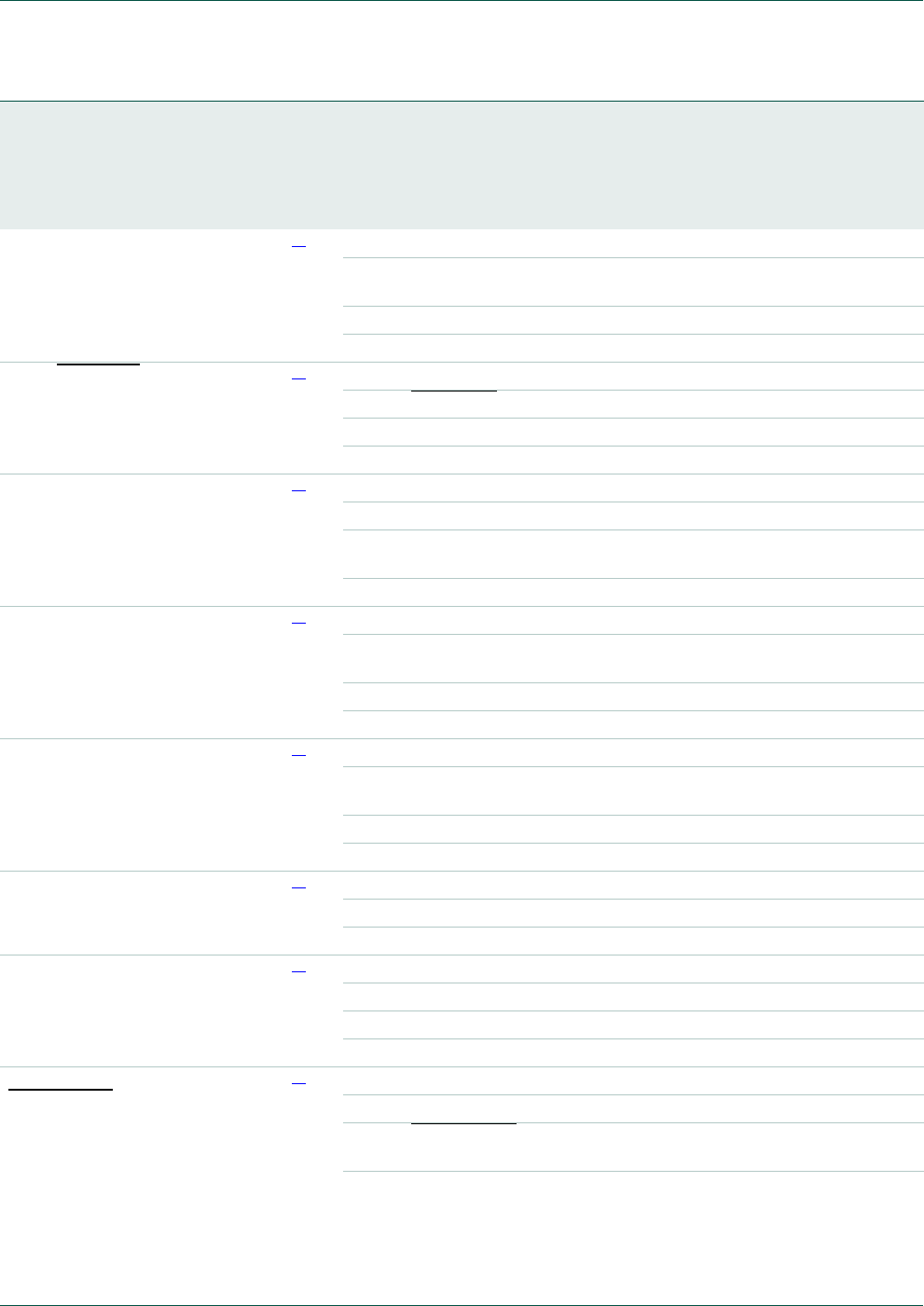
UM10360 All information provided in this document is subject to legal disclaimers. © NXP B.V. 2014. All rights reserved.
User manual Rev. 3.1 — 2 April 2014 107 of 849
NXP Semiconductors UM10360
Chapter 7: LPC176x/5x Pin configuration
P1[20]/MCI0/
PWM1[2]/SCK0
34 K4 E8 [1] I/O P1[20] — General purpose digital input/output pin.
IMCI0 — Motor control PWM channel 0, input. Also Quadrature
Encoder Interface PHA input.
OPWM1[2] — Pulse Width Modulator 1, channel 2 output.
I/O SCK0 — Serial clock for SSP0.
P1[21]/MCABORT/
PWM1[3]/
SSEL0
35 F5 E9 [1] I/O P1[21] — General purpose digital input/output pin.
OMCABORT — Motor control PWM, LOW-active fast abort.
OPWM1[3] — Pulse Width Modulator 1, channel 3 output.
I/O SSEL0 — Slave Select for SSP0.
P1[22]/MCOB0/
USB_PWRD/
MAT1[0]
36 J5 D10 [1] I/O P1[22] — General purpose digital input/output pin.
OMCOB0 — Motor control PWM channel 0, output B.
IUSB_PWRD — Power Status for USB port (host power switch,
LPC1769/68/66/65 only).
OMAT1[0] — Match output for Timer 1, channel 0.
P1[23]/MCI1/
PWM1[4]/MISO0
37 K5 E7 [1] I/O P1[23] — General purpose digital input/output pin.
IMCI1 — Motor control PWM channel 1, input. Also Quadrature
Encoder Interface PHB input.
OPWM1[4] — Pulse Width Modulator 1, channel 4 output.
I/O MISO0 — Master In Slave Out for SSP0.
P1[24]/MCI2/
PWM1[5]/MOSI0
38 H5 F8 [1] I/O P1[24] — General purpose digital input/output pin.
IMCI2 — Motor control PWM channel 2, input. Also Quadrature
Encoder Interface INDEX input.
OPWM1[5] — Pulse Width Modulator 1, channel 5 output.
I/O MOSI0 — Master Out Slave in for SSP0.
P1[25]/MCOA1/
MAT1[1]
39 G5 F9 [1] I/O P1[25] — General purpose digital input/output pin.
OMCOA1 — Motor control PWM channel 1, output A.
OMAT1[1] — Match output for Timer 1, channel 1.
P1[26]/MCOB1/
PWM1[6]/CAP0[0]
40 K6 E10 [1] I/O P1[26] — General purpose digital input/output pin.
OMCOB1 — Motor control PWM channel 1, output B.
OPWM1[6] — Pulse Width Modulator 1, channel 6 output.
ICAP0[0] — Capture input for Timer 0, channel 0.
P1[27]/CLKOUT
/USB_OVRCR/
CAP0[1]
43 K7 G9 [1] I/O P1[27] — General purpose digital input/output pin.
OCLKOUT — Clock output pin.
IUSB_OVRCR — USB port Over-Current status. (LPC1769/68/66/65
only).
ICAP0[1] — Capture input for Timer 0, channel 1.
Table 74. Pin description (LPC176x) …continued
Symbol Pin/ball Type Description
LQFP100
TFBGA100
WLCSP100

UM10360 All information provided in this document is subject to legal disclaimers. © NXP B.V. 2014. All rights reserved.
User manual Rev. 3.1 — 2 April 2014 108 of 849
NXP Semiconductors UM10360
Chapter 7: LPC176x/5x Pin configuration
P1[28]/MCOA2/
PCAP1[0]/
MAT0[0]
44 J7 G10 [1] I/O P1[28] — General purpose digital input/output pin.
OMCOA2 — Motor control PWM channel 2, output A.
IPCAP1[0] — Capture input for PWM1, channel 0.
OMAT0[0] — Match output for Timer 0, channel 0.
P1[29]/MCOB2/
PCAP1[1]/
MAT0[1]
45 G6 G8 [1] I/O P1[29] — General purpose digital input/output pin.
OMCOB2 — Motor control PWM channel 2, output B.
IPCAP1[1] — Capture input for PWM1, channel 1.
OMAT0[1] — Match output for Timer 0, channel 1.
P1[30]/VBUS/
AD0[4]
21 H1 B8 [2] I/O P1[30] — General purpose digital input/output pin.
IVBUS — Monitors the presence of USB bus power.
(LPC1769/68/66/65/64 only).
Note: This signal must be HIGH for USB reset to occur.
IAD0[4] — A/D converter 0, input 4.
P1[31]/SCK1/
AD0[5]
20 F4 C7 [2] I/O P1[31] — General purpose digital input/output pin.
I/O SCK1 — Serial Clock for SSP1.
IAD0[5] — A/D converter 0, input 5.
P2[0] to P2[31] I/O Port 2: Port 2 is a 32-bit I/O port with individual direction controls for
each bit. The operation of port 2 pins depends upon the pin function
selected via the pin connect block. Pins 14 through 31 of this port
are not available.
P2[0]/PWM1[1]/
TXD1
75 B9 K1 [1] I/O P2[0] — General purpose digital input/output pin.
OPWM1[1] — Pulse Width Modulator 1, channel 1 output.
OTXD1 — Transmitter output for UART1.
P2[1]/PWM1[2]/
RXD1
74 B10 J2 [1] I/O P2[1] — General purpose digital input/output pin.
OPWM1[2] — Pulse Width Modulator 1, channel 2 output.
IRXD1 — Receiver input for UART1.
P2[2]/PWM1[3]/
CTS1/
TRACEDATA[3]
73 D8 K2 [1] I/O P2[2] — General purpose digital input/output pin.
OPWM1[3] — Pulse Width Modulator 1, channel 3 output.
ICTS1 — Clear to Send input for UART1.
OTRACEDATA[3] — Trace data, bit 3.
P2[3]/PWM1[4]/
DCD1/
TRACEDATA[2]
70 E7 K3 [1] I/O P2[3] — General purpose digital input/output pin.
OPWM1[4] — Pulse Width Modulator 1, channel 4 output.
IDCD1 — Data Carrier Detect input for UART1.
OTRACEDATA[2] — Trace data, bit 2.
P2[4]/PWM1[5]/
DSR1/
TRACEDATA[1]
69 D9 J3 [1] I/O P2[4] — General purpose digital input/output pin.
OPWM1[5] — Pulse Width Modulator 1, channel 5 output.
IDSR1 — Data Set Ready input for UART1.
OTRACEDATA[1] — Trace data, bit 1.
Table 74. Pin description (LPC176x) …continued
Symbol Pin/ball Type Description
LQFP100
TFBGA100
WLCSP100
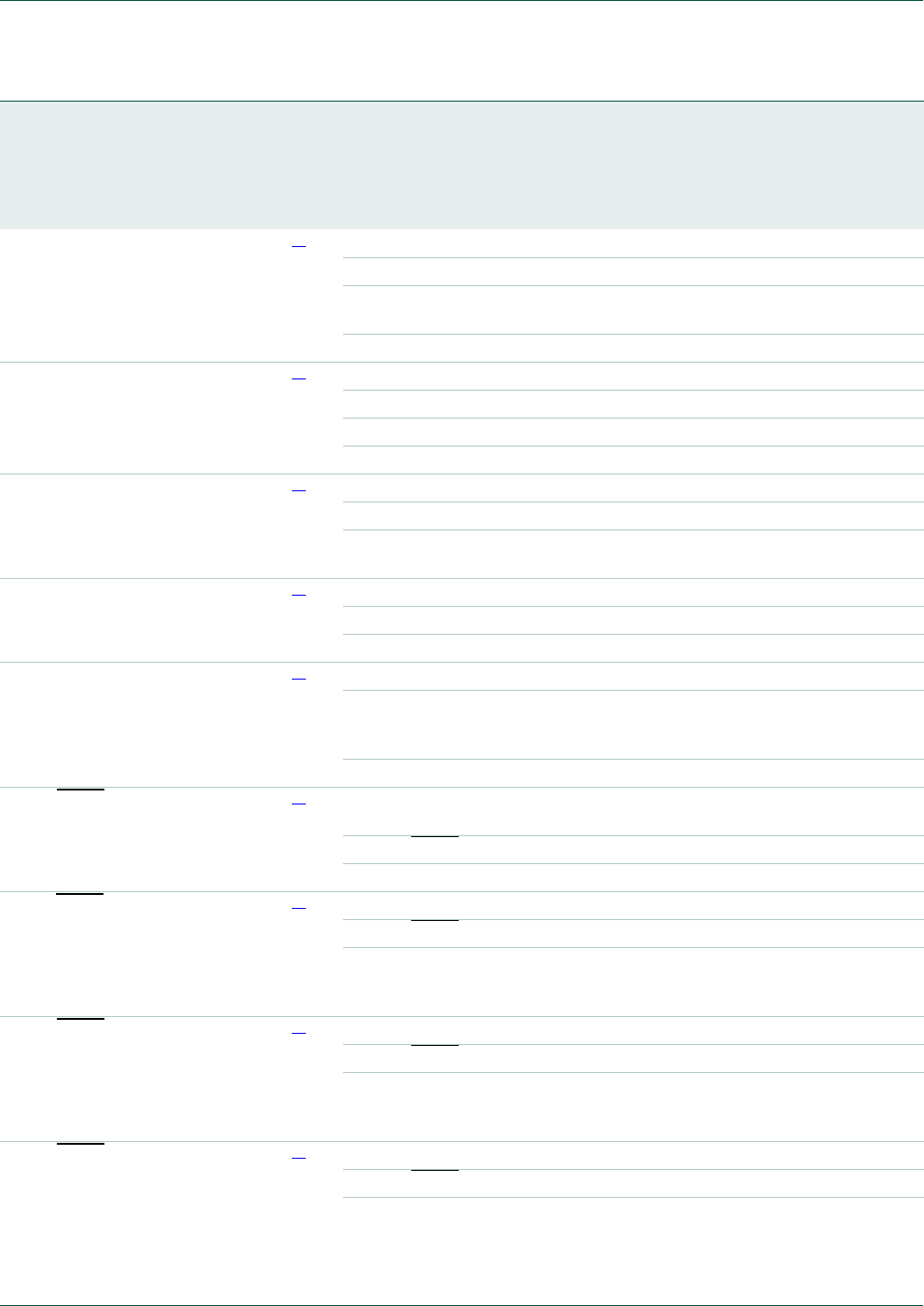
UM10360 All information provided in this document is subject to legal disclaimers. © NXP B.V. 2014. All rights reserved.
User manual Rev. 3.1 — 2 April 2014 109 of 849
NXP Semiconductors UM10360
Chapter 7: LPC176x/5x Pin configuration
P2[5]/PWM1[6]/
DTR1/
TRACEDATA[0]
68 D10 H4 [1] I/O P2[5] — General purpose digital input/output pin.
OPWM1[6] — Pulse Width Modulator 1, channel 6 output.
ODTR1 — Data Terminal Ready output for UART1. Can also be
configured to be an RS-485/EIA-485 output enable signal.
OTRACEDATA[0] — Trace data, bit 0.
P2[6]/PCAP1[0]/
RI1/TRACECLK
67 E8 K4 [1] I/O P2[6] — General purpose digital input/output pin.
IPCAP1[0] — Capture input for PWM1, channel 0.
IRI1 — Ring Indicator input for UART1.
OTRACECLK — Trace Clock.
P2[7]/RD2/
RTS1
66 E9 J4 [1] I/O P2[7] — General purpose digital input/output pin.
IRD2 — CAN2 receiver input. (LPC1769/68/66/65/64 only).
ORTS1 — Request to Send output for UART1. Can also be
configured to be an RS-485/EIA-485 output enable signal.
P2[8]/TD2/
TXD2
65 E10 H5 [1] I/O P2[8] — General purpose digital input/output pin.
OTD2 — CAN2 transmitter output. (LPC1769/68/66/65/64 only).
OTXD2 — Transmitter output for UART2.
P2[9]/
USB_CONNECT/
RXD2
64 F7 K5 [1] I/O P2[9] — General purpose digital input/output pin.
OUSB_CONNECT — Signal used to switch an external 1.5 k
resistor under software control. Used with the SoftConnect USB
feature. (LPC1769/68/66/65/64 only).
IRXD2 — Receiver input for UART2.
P2[10]/EINT0/NMI 53 J10 K9 [6] I/O P2[10] — General purpose digital input/output pin. A LOW level on
this pin during reset starts the ISP command handler.
IEINT0 — External interrupt 0 input.
INMI — Non-maskable interrupt input.
P2[11]/EINT1/
I2STX_CLK
52 H8 J8 [6] I/O P2[11] — General purpose digital input/output pin.
IEINT1 — External interrupt 1 input.
I/O I2STX_CLK — Transmit Clock. It is driven by the master and
received by the slave. Corresponds to the signal SCK in the I2S-bus
specification. (LPC1769/68/67/66/65/63 only).
P2[12]/EINT2/
I2STX_WS
51 K10 K10 [6] I/O P2[12] — General purpose digital input/output pin.
IEINT2 — External interrupt 2 input.
I/O I2STX_WS — Transmit Word Select. It is driven by the master and
received by the slave. Corresponds to the signal WS in the I2S-bus
specification. (LPC1769/68/67/66/65/63 only).
P2[13]/EINT3/
I2STX_SDA
50 J9 J9 [6] I/O P2[13] — General purpose digital input/output pin.
IEINT3 — External interrupt 3 input.
I/O I2STX_SDA — Transmit data. It is driven by the transmitter and
read by the receiver. Corresponds to the signal SD in the I2S-bus
specification. (LPC1769/68/67/66/65/63 only).
Table 74. Pin description (LPC176x) …continued
Symbol Pin/ball Type Description
LQFP100
TFBGA100
WLCSP100
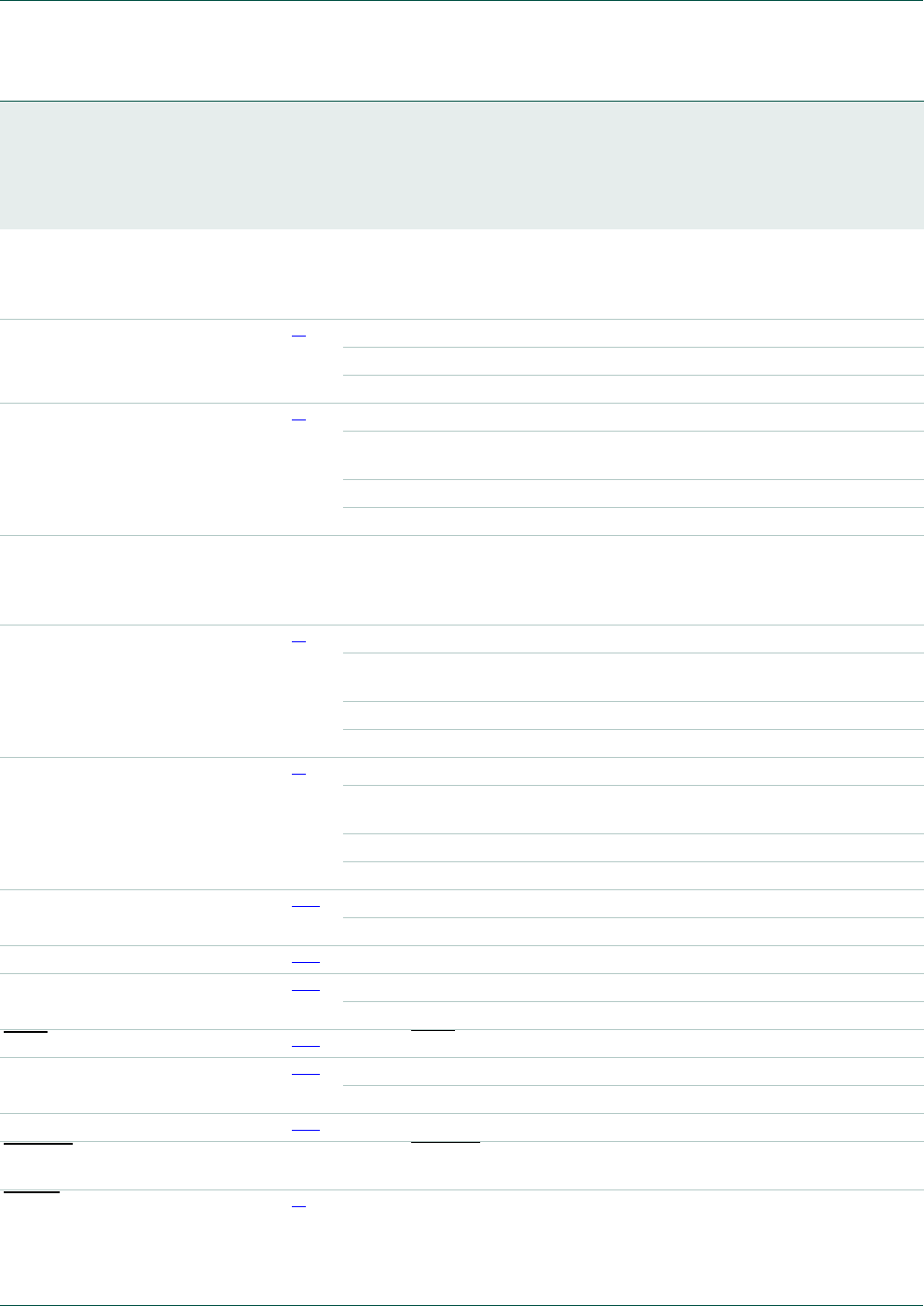
UM10360 All information provided in this document is subject to legal disclaimers. © NXP B.V. 2014. All rights reserved.
User manual Rev. 3.1 — 2 April 2014 110 of 849
NXP Semiconductors UM10360
Chapter 7: LPC176x/5x Pin configuration
P3[0] to P3[31] I/O Port 3: Port 3 is a 32-bit I/O port with individual direction controls for
each bit. The operation of port 3 pins depends upon the pin function
selected via the pin connect block. Pins 0 through 24, and 27
through 31 of this port are not available.
P3[25]/MAT0[0]/
PWM1[2]
27 H3 D8 [1] I/O P3[25] — General purpose digital input/output pin.
OMAT0[0] — Match output for Timer 0, channel 0.
OPWM1[2] — Pulse Width Modulator 1, output 2.
P3[26]/STCLK/
MAT0[1]/PWM1[3]
26 K1 A10 [1] I/O P3[26] — General purpose digital input/output pin.
ISTCLK — System tick timer clock input. The maximum STCLK
frequency is 1/4 of the ARM processor clock frequency CCLK.
OMAT0[1] — Match output for Timer 0, channel 1.
OPWM1[3] — Pulse Width Modulator 1, output 3.
P4[0] to P4[31] I/O Port 4: Port 4 is a 32-bit I/O port with individual direction controls for
each bit. The operation of port 4 pins depends upon the pin function
selected via the pin connect block. Pins 0 through 27, 30, and 31 of
this port are not available.
P4[28]/RX_MCLK/
MAT2[0]/TXD3
82 C7 G1 [1] I/O P4[28] — General purpose digital input/output pin.
ORX_MCLK — I2S receive master clock. (LPC1769/68/67/66/65
only).
OMAT2[0] — Match output for Timer 2, channel 0.
OTXD3 — Transmitter output for UART3.
P4[29]/TX_MCLK/
MAT2[1]/RXD3
85 E6 F1 [1] I/O P4[29] — General purpose digital input/output pin.
OTX_MCLK — I2S transmit master clock. (LPC1769/68/67/66/65
only).
OMAT2[1] — Match output for Timer 2, channel 1.
IRXD3 — Receiver input for UART3.
TDO/SWO 1 A1 A1 [1][7] OTDO — Tes t Da t a o u t f or J TA G i nte r f a ce.
OSWO — Serial wire trace output.
TDI 2 C3 C4 [1][8] ITDI — Test D a ta i n fo r J TA G i nte r f a ce.
TMS/SWDIO 3 B1 B3 [1][8] ITMS — Tes t M o d e Sel e c t f o r J TA G i nter f a c e.
I/O SWDIO — Serial wire debug data input/output.
TRST 4C2A2
[1][8] ITRST — Test Reset for JTAG interface.
TCK/SWDCLK 5 C1 D4 [1][7] ITCK — Te s t Clo c k for J TA G inte r f a c e.
ISWDCLK — Serial wire clock.
RTCK 100 B2 B2 [1][7] ORTCK — JTAG interface control signal.
RSTOUT 14 - - - O RSTOUT — This is a 3.3 V pin. LOW on this pin indicates the
microcontroller being in Reset state.
RESET 17 F3 C6 [9] IExternal reset input: A LOW-going pulse as short as 50 ns on this
pin resets the device, causing I/O ports and peripherals to take on
their default states, and processor execution to begin at address 0.
TTL with hysteresis, 5 V tolerant.
Table 74. Pin description (LPC176x) …continued
Symbol Pin/ball Type Description
LQFP100
TFBGA100
WLCSP100
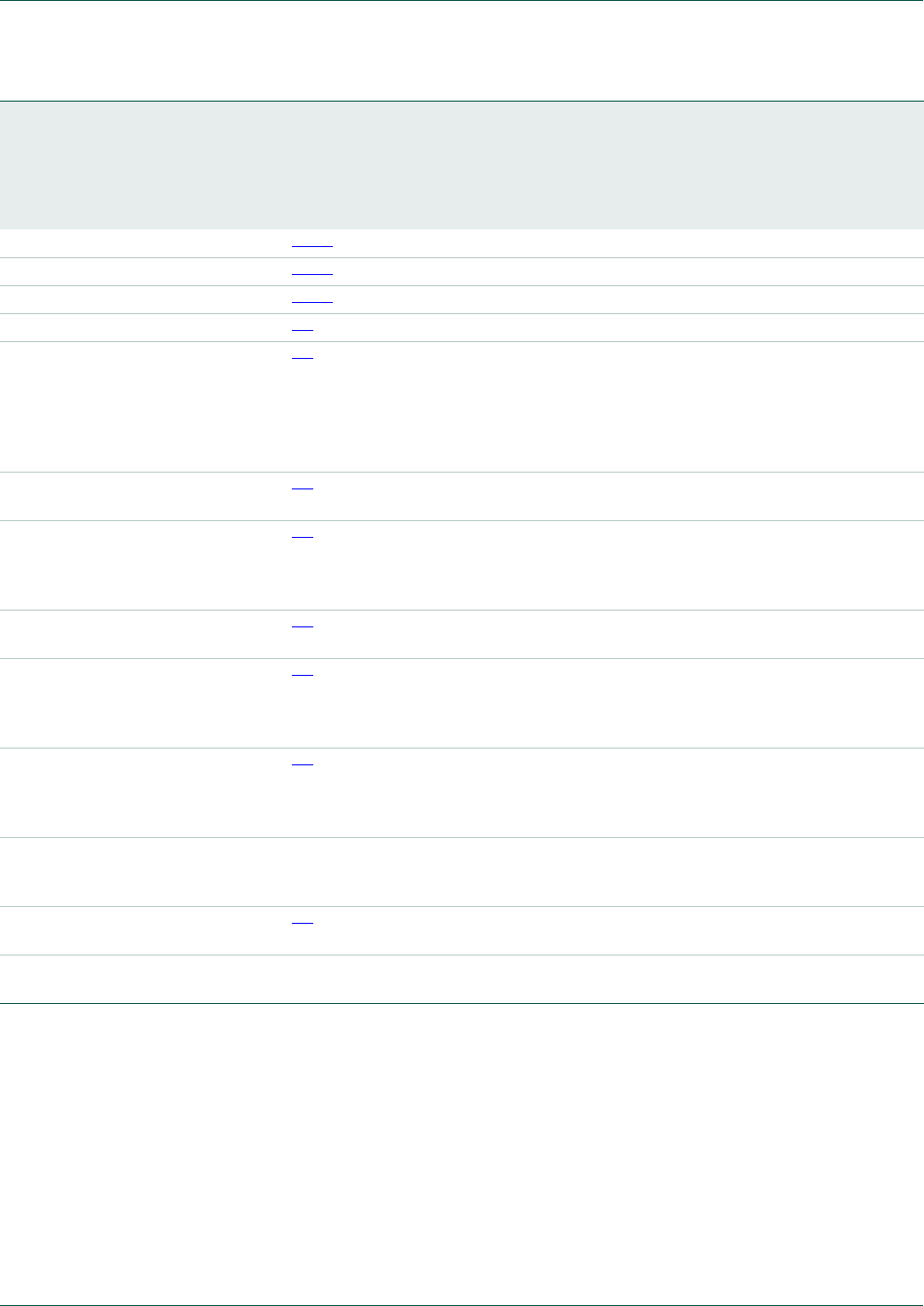
UM10360 All information provided in this document is subject to legal disclaimers. © NXP B.V. 2014. All rights reserved.
User manual Rev. 3.1 — 2 April 2014 111 of 849
NXP Semiconductors UM10360
Chapter 7: LPC176x/5x Pin configuration
[1] 5 V tolerant pad providing digital I/O functions with TTL levels and hysteresis. This pin is pulled up to a voltage level of 2.3 V to 2.6 V.
[2] 5 V tolerant pad providing digital I/O functions (with TTL levels and hysteresis) and analog input. When configured as a ADC input,
digital section of the pad is disabled and the pin is not 5 V tolerant. This pin is pulled up to a voltage level of 2.3 V to 2.6 V.
[3] 5 V tolerant pad providing digital I/O with TTL levels and hysteresis and analog output function. When configured as the DAC output,
digital section of the pad is disabled. This pin is pulled up to a voltage level of 2.3 V to 2.6 V.
[4] Open-drain 5 V tolerant digital I/O pad, compatible with I2C-bus 400 kHz specification. This pad requires an external pull-up to provide
output functionality. When power is switched off, this pin connected to the I2C-bus is floating and does not disturb the I2C lines.
Open-drain configuration applies to all functions on this pin.
[5] Pad provides digital I/O and USB functions. It is designed in accordance with the USB specification, revision 2.0 (Full-speed and
Low-speed mode only). This pad is not 5 V tolerant.
[6] 5 V tolerant pad with 10 ns glitch filter providing digital I/O functions with TTL levels and hysteresis. This pin is pulled up to a voltage
level of 2.3 V to 2.6 V.
XTAL1 22 H2 D7 [10][11] IInput to the oscillator circuit and internal clock generator circuits.
XTAL2 23 G3 A9 [10][11] O Output from the oscillator amplifier.
RTCX1 16 F2 A7 [10][11] IInput to the RTC oscillator circuit.
RTCX2 18 G1 B7 [10] OOutput from the RTC oscillator circuit.
VSS 31,
41,
55,
72,
83,
97
B3,
B7,
C9,
G7,
J6,
K3
E5,
F5,
F6,
G5,
G6,
G7
[10] Iground: 0 V reference.
VSSA 11 E1 B5 [10] Ianalog ground: 0 V reference. This should nominally be the same
voltage as VSS, but should be isolated to minimize noise and error.
VDD(3V3) 28,
54,
71,
96
K2,
H9,
C10
, A3
E4,
E6,
F7,
G4
[10] I3.3 V supply voltage: This is the power supply voltage for the I/O
ports.
VDD(REG)(3V3) 42,
84
H6,
A7
F4,
F0
[10] I3.3 V voltage regulator supply voltage: This is the supply voltage
for the on-chip voltage regulator only.
VDDA 10 E2 A4 [10] Ianalog 3.3 V pad supply voltage: This should be nominally the
same voltage as VDD(3V3) but should be isolated to minimize noise
and error. This voltage is used to power the ADC and DAC. This pin
should be tied to 3.3 V if the ADC and DAC are not used.
VREFP 12 E3 A5 [10] IADC positive reference voltage: This should be nominally the
same voltage as VDDA but should be isolated to minimize noise and
error. Level on this pin is used as a reference for ADC and DAC.
This pin should be tied to 3.3 V if the ADC and DAC are not used.
VREFN 15 F1 A6 I ADC negative reference voltage: This should be nominally the
same voltage as VSS but should be isolated to minimize noise and
error. Level on this pin is used as a reference for ADC and DAC.
VBAT 19 G2 A8 [10] IRTC pin power supply: 3.3 V on this pin supplies the power to the
RTC peripheral.
n.c. 13 D4,
E4
B6,
D6
-not connected.
Table 74. Pin description (LPC176x) …continued
Symbol Pin/ball Type Description
LQFP100
TFBGA100
WLCSP100

UM10360 All information provided in this document is subject to legal disclaimers. © NXP B.V. 2014. All rights reserved.
User manual Rev. 3.1 — 2 April 2014 112 of 849
NXP Semiconductors UM10360
Chapter 7: LPC176x/5x Pin configuration
[7] 5 V tolerant pad with TTL levels and hysteresis. Internal pull-up and pull-down resistors disabled.
[8] 5 V tolerant pad with TTL levels and hysteresis and internal pull-up resistor.
[9] 5 V tolerant pad with 20 ns glitch filter providing digital I/O function with TTL levels and hysteresis.
[10] Pad provides special analog functionality. A 32 kHz crystal oscillator must be used with the RTC.
[11] When the system oscillator is not used, connect XTAL1 and XTAL2 as follows: XTAL1 can be left floating or can be grounded (grounding
is preferred to reduce susceptibility to noise). XTAL2 should be left floating.
[12] When the RTC is not used, connect VBAT to VDD(REG)(3V3) and leave RTCX1 floating.

UM10360 All information provided in this document is subject to legal disclaimers. © NXP B.V. 2014. All rights reserved.
User manual Rev. 3.1 — 2 April 2014 113 of 849
8.1 How to read this chapter
Tab l e 75 shows the functions of the PINSEL registers in the LPC176x/5x.
8.2 Description
The pin connect block allows most pins of the microcontroller to have more than one
potential function. Configuration registers control the multiplexers to allow connection
between the pin and the on chip peripherals.
Peripherals should be connected to the appropriate pins prior to being activated and prior
to any related interrupt(s) being enabled. Activity of any enabled peripheral function that is
not mapped to a related pin should be considered undefined.
Selection of a single function on a port pin excludes other peripheral functions available
on the same pin. However, the GPIO input stays connected and may be read by software
or used to contribute to the GPIO interrupt feature.
8.3 Pin function select register values
The PINSEL registers control the functions of device pins as shown below. Pairs of bits in
these registers correspond to specific device pins.
UM10360
Chapter 8: LPC176x/5x Pin connect block
Rev. 3.1 — 2 April 2014 User manual
Table 75. Summary of PINSEL registers
Register Controls Table
PINSEL0 P0[15:0] Tab l e 8 0
PINSEL1 P0 [31:16] Tab l e 8 1
PINSEL2 P1 [15:0] (Ethernet) Table 8 2
PINSEL3 P1 [31:16] Tab l e 8 3
PINSEL4 P2 [15:0] Tab l e 8 4
PINSEL5 P2 [31:16] not used
PINSEL6 P3 [15:0] not used
PINSEL7 P3 [31:16] Tab l e 8 5
PINSEL8 P4 [15:0] not used
PINSEL9 P4 [31:16] Tab l e 8 6
PINSEL10 Trace port enable Tab l e 8 7
Table 76. Pin function select register bits
PINSEL0 to
PINSEL9 Values
Function Value after Reset
00 Primary (default) function, typically GPIO port 00
01 First alternate function
10 Second alternate function
11 Third alternate function

UM10360 All information provided in this document is subject to legal disclaimers. © NXP B.V. 2014. All rights reserved.
User manual Rev. 3.1 — 2 April 2014 114 of 849
NXP Semiconductors UM10360
Chapter 8: LPC176x/5x Pin connect block
The direction control bit in the GPIO registers is effective only when the GPIO function is
selected for a pin. For other functions, direction is controlled automatically. Each
derivative typically has a different pinout and therefore a different set of functions possible
for each pin. Details for a specific derivative may be found in the appropriate data sheet.
Multiple connections
Since a particular peripheral function may be allowed on more than one pin, it is in
principle possible to configure more than one pin to perform the same function. If a
peripheral output function is configured to appear on more than one pin, it will in fact be
routed to those pins. If a peripheral input function is configured to appear on more than
one pin for some reason, the peripheral will receive its input from the lowest port number.
For instance, any pin of port 0 will take precedence over any pin of a higher numbered
port, and pin 0 of any port will take precedence over a higher numbered pin of the same
port.
8.4 Pin mode select register values
The PINMODE registers control the input mode of all ports. This includes the use of the
on-chip pull-up/pull-down resistor feature and a special open drain operating mode. The
on-chip pull-up/pull-down resistor can be selected for every port pin regardless of the
function on this pin with the exception of the I2C pins for the I2C0 interface and the USB
pins (see Section 8.5.10). Three bits are used to control the mode of a port pin, two in a
PINMODE register, and an additional one in a PINMODE_OD register. Bits are reserved
for unused pins as in the PINSEL registers.
Repeater mode enables the pull-up resistor if the pin is at a logic high and enables the
pull-down resistor if the pin is at a logic low. This causes the pin to retain its last known
state if it is configured as an input and is not driven externally. The state retention is not
applicable to the Deep Power-down mode. Repeater mode may typically be used to
prevent a pin from floating (and potentially using significant power if it floats to an
indeterminate state) if it is temporarily not driven.
The PINMODE_OD registers control the open drain mode for ports. The open drain mode
causes the pin to be pulled low normally if it is configured as an output and the data value
is 0. If the data value is 1, the output drive of the pin is turned off, equivalent to changing
the pin direction. This combination simulates an open drain output.
Table 77. Pin Mode Select register Bits
PINMODE0 to
PINMODE9 Values
Function Value after
Reset
00 Pin has an on-chip pull-up resistor enabled. 00
01 Repeater mode (see text below).
10 Pin has neither pull-up nor pull-down resistor enabled.
11 Pin has an on-chip pull-down resistor enabled.
Table 78. Open Drain Pin Mode Select register Bits
PINMODE_OD0 to
PINMODE_OD4
Values
Function Value after
Reset
0Pin is in the normal (not open drain) mode. 00
1Pin is in the open drain mode.

UM10360 All information provided in this document is subject to legal disclaimers. © NXP B.V. 2014. All rights reserved.
User manual Rev. 3.1 — 2 April 2014 115 of 849
NXP Semiconductors UM10360
Chapter 8: LPC176x/5x Pin connect block
Function of PINMODE in open drain mode
Normally the value of PINMODE applies to a pin only when it is in the input mode. When a
pin is in the open drain mode, caused by a 1 in the corresponding bit of one of the
PINMODE_OD registers, the input mode still does not apply when the pin is outputting a
0. However, when the pin value is 1, PINMODE applies since this state turns off the pin’s
output driver. For example, this allows for the possibility of configuring a pin to be open
drain with an on-chip pullup. A pullup in this case which is only on when the pin is not
being pulled low by the pin’s own output.

UM10360 All information provided in this document is subject to legal disclaimers. © NXP B.V. 2014. All rights reserved.
User manual Rev. 3.1 — 2 April 2014 116 of 849
NXP Semiconductors UM10360
Chapter 8: LPC176x/5x Pin connect block
8.5 Register description
The Pin Control Module contains 11 registers as shown in Table 79 below.
[1] Reset Value reflects the data stored in used bits only. It does not include reserved bits content.
Pin control module register reset values
On external reset, watchdog reset, power-on-reset (POR), and BOD reset, all registers in
this module are reset to '0'.
Table 79. Pin Connect Block Register Map
Name Description Access Reset
Value[1]
Address
PINSEL0 Pin function select register 0. R/W 0 0x4002 C000
PINSEL1 Pin function select register 1. R/W 0 0x4002 C004
PINSEL2 Pin function select register 2. R/W 0 0x4002 C008
PINSEL3 Pin function select register 3. R/W 0 0x4002 C00C
PINSEL4 Pin function select register 4 R/W 0 0x4002 C010
PINSEL7 Pin function select register 7 R/W 0 0x4002 C01C
PINSEL8 Pin function select register 8 R/W 0 0x4002 C020
PINSEL9 Pin function select register 9 R/W 0 0x4002 C024
PINSEL10 Pin function select register 10 R/W 0 0x4002 C028
PINMODE0 Pin mode select register 0 R/W 0 0x4002 C040
PINMODE1 Pin mode select register 1 R/W 0 0x4002 C044
PINMODE2 Pin mode select register 2 R/W 0 0x4002 C048
PINMODE3 Pin mode select register 3. R/W 0 0x4002 C04C
PINMODE4 Pin mode select register 4 R/W 0 0x4002 C050
PINMODE5 Pin mode select register 5 R/W 0 0x4002 C054
PINMODE6 Pin mode select register 6 R/W 0 0x4002 C058
PINMODE7 Pin mode select register 7 R/W 0 0x4002 C05C
PINMODE9 Pin mode select register 9 R/W 0 0x4002 C064
PINMODE_OD0 Open drain mode control register 0 R/W 0 0x4002 C068
PINMODE_OD1 Open drain mode control register 1 R/W 0 0x4002 C06C
PINMODE_OD2 Open drain mode control register 2 R/W 0 0x4002 C070
PINMODE_OD3 Open drain mode control register 3 R/W 0 0x4002 C074
PINMODE_OD4 Open drain mode control register 4 R/W 0 0x4002 C078
I2CPADCFG I2C Pin Configuration register R/W 0 0x4002 C07C

UM10360 All information provided in this document is subject to legal disclaimers. © NXP B.V. 2014. All rights reserved.
User manual Rev. 3.1 — 2 April 2014 117 of 849
NXP Semiconductors UM10360
Chapter 8: LPC176x/5x Pin connect block
8.5.1 Pin Function Select register 0 (PINSEL0 - 0x4002 C000)
The PINSEL0 register controls the functions of the lower half of Port 0. The direction
control bit in FIO0DIR register is effective only when the GPIO function is selected for a
pin. For other functions, the direction is controlled automatically.
[1] Not available on 80-pin package.
8.5.2 Pin Function Select Register 1 (PINSEL1 - 0x4002 C004)
The PINSEL1 register controls the functions of the upper half of Port 0. The direction
control bit in the FIO0DIR register is effective only when the GPIO function is selected for
a pin. For other functions the direction is controlled automatically.
Table 80. Pin function select register 0 (PINSEL0 - address 0x4002 C000) bit description
PINSEL0 Pin
name
Function when
00
Function when 01 Function
when 10
Function
when 11
Reset
value
1:0 P0.0 GPIO Port 0.0 RD1 TXD3 SDA1 00
3:2 P0.1 GPIO Port 0.1 TD1 RXD3 SCL1 00
5:4 P0.2 GPIO Port 0.2 TXD0 AD0.7 Reserved 00
7:6 P0.3 GPIO Port 0.3 RXD0 AD0.6 Reserved 00
9:8 P0.4[1] GPIO Port 0.4 I2SRX_CLK RD2 CAP2.0 00
11:10 P0.5[1] GPIO Port 0.5 I2SRX_WS TD2 CAP2.1 00
13:12 P0.6 GPIO Port 0.6I2SRX_SDA SSEL1 MAT2.0 00
15:14 P0.7 GPIO Port 0.7 I2STX_CLK SCK1 MAT2.1 00
17:16 P0.8 GPIO Port 0.8 I2STX_WS MISO1 MAT2.2 00
19:18 P0.9 GPIO Port 0.9 I2STX_SDA MOSI1 MAT2.3 00
21:20 P0.10 GPIO Port 0.10 TXD2 SDA2 MAT3.0 00
23:22 P0.11 GPIO Port 0.11 RXD2 SCL2 MAT3.1 00
29:24 - Reserved Reserved Reserved Reserved 0
31:30 P0.15 GPIO Port 0.15 TXD1 SCK0 SCK 00
Table 81. Pin function select register 1 (PINSEL1 - address 0x4002 C004) bit
description
PINSEL1 Pin name Function when
00
Function
when 01
Function
when 10
Function
when 11
Reset
value
1:0 P0.16 GPIO Port 0.16 RXD1 SSEL0 SSEL 00
3:2 P0.17 GPIO Port 0.17 CTS1 MISO0 MISO 00
5:4 P0.18 GPIO Port 0.18 DCD1 MOSI0 MOSI 00
7:6 P0.19[1] GPIO Port 0.19 DSR1 Reserved SDA1 00
9:8 P0.20[1] GPIO Port 0.20 DTR1 Reserved SCL1 00
11:10 P0.21[1] GPIO Port 0.21 RI1 Reserved RD1 00
13:12 P0.22 GPIO Port 0.22 RTS1 Reserved TD1 00
15:14 P0.23[1] GPIO Port 0.23 AD0.0 I2SRX_CLK CAP3.0 00
17:16 P0.24[1] GPIO Port 0.24 AD0.1 I2SRX_WS CAP3.1 00
19:18 P0.25 GPIO Port 0.25 AD0.2 I2SRX_SDA TXD3 00
21:20 P0.26 GPIO Port 0.26 AD0.3 AOUT RXD3 00
23:22 P0.27[1][2] GPIO Port 0.27 SDA0 USB_SDA Reserved 00

UM10360 All information provided in this document is subject to legal disclaimers. © NXP B.V. 2014. All rights reserved.
User manual Rev. 3.1 — 2 April 2014 118 of 849
NXP Semiconductors UM10360
Chapter 8: LPC176x/5x Pin connect block
[1] Not available on 80-pin package.
[2] Pins P0[27] and P0[28] are open-drain for I2C-bus compliance.
8.5.3 Pin Function Select register 2 (PINSEL2 - 0x4002 C008)
The PINSEL2 register controls the functions of the lower half of Port 1, which contains the
Ethernet related pins. The direction control bit in the FIO1DIR register is effective only
when the GPIO function is selected for a pin. For other functions, the direction is
controlled automatically.
8.5.4 Pin Function Select Register 3 (PINSEL3 - 0x4002 C00C)
The PINSEL3 register controls the functions of the upper half of Port 1. The direction
control bit in the FIO1DIR register is effective only when the GPIO function is selected for
a pin. For other functions, direction is controlled automatically.
25:24 P0.28[1][2] GPIO Port 0.28 SCL0 USB_SCL Reserved 00
27:26 P0.29 GPIO Port 0.29 USB_DReserved Reserved 00
29:28 P0.30 GPIO Port 0.30 USB_DReserved Reserved 00
31:30 - Reserved Reserved Reserved Reserved 00
Table 81. Pin function select register 1 (PINSEL1 - address 0x4002 C004) bit
description …continued
PINSEL1 Pin name Function when
00
Function
when 01
Function
when 10
Function
when 11
Reset
value
Table 82. Pin function select register 2 (PINSEL2 - address 0x4002 C008) bit description
PINSEL2 Pin
name
Function when
00
Function when
01
Function
when 10
Function
when 11
Reset
value
1:0 P1.0 GPIO Port 1.0 ENET_TXD0 Reserved Reserved 00
3:2 P1.1 GPIO Port 1.1 ENET_TXD1 Reserved Reserved 00
7:4 - Reserved Reserved Reserved Reserved 0
9:8 P1.4 GPIO Port 1.4 ENET_TX_EN Reserved Reserved 00
15:10 - Reserved Reserved Reserved Reserved 0
17:16 P1.8 GPIO Port 1.8 ENET_CRS Reserved Reserved 00
19:18 P1.9 GPIO Port 1.9 ENET_RXD0 Reserved Reserved 00
21:20 P1.10 GPIO Port 1.10 ENET_RXD1 Reserved Reserved 00
27:22 - Reserved Reserved Reserved Reserved 0
29:28 P1.14 GPIO Port 1.14 ENET_RX_ER Reserved Reserved 00
31:30 P1.15 GPIO Port 1.15 ENET_REF_CLK Reserved Reserved 00
Table 83. Pin function select register 3 (PINSEL3 - address 0x4002 C00C) bit
description
PINSEL3 Pin
name
Function when
00
Function when
01
Function
when 10
Function
when 11
Reset
value
1:0 P1.16[1] GPIO Port 1.16 ENET_MDC Reserved Reserved 00
3:2 P1.17[1] GPIO Port 1.17 ENET_MDIO Reserved Reserved 00
5:4 P1.18 GPIO Port 1.18 USB_UP_LED PWM1.1 CAP1.0 00
7:6 P1.19 GPIO Port 1.19 MCOA0 USB_PPWR CAP1.1 00
9:8 P1.20 GPIO Port 1.20 MCI0 PWM1.2 SCK0 00

UM10360 All information provided in this document is subject to legal disclaimers. © NXP B.V. 2014. All rights reserved.
User manual Rev. 3.1 — 2 April 2014 119 of 849
NXP Semiconductors UM10360
Chapter 8: LPC176x/5x Pin connect block
[1] Not available on 80-pin package.
8.5.5 Pin Function Select Register 4 (PINSEL4 - 0x4002 C010)
The PINSEL4 register controls the functions of the lower half of Port 2. The direction
control bit in the FIO2DIR register is effective only when the GPIO function is selected for
a pin. For other functions, direction is controlled automatically.
[1] Not available on 80-pin package.
[2] These pins support a debug trace function when selected via a development tool or by writing to the
PINSEL10 register. See Section 8.5.8 “Pin Function Select Register 10 (PINSEL10 - 0x4002 C028)” for
details.
11:10 P1.21[1] GPIO Port 1.21 MCABORT PWM1.3 SSEL0 00
13:12 P1.22 GPIO Port 1.22 MCOB0 USB_PWRD MAT1.0 00
15:14 P1.23 GPIO Port 1.23 MCI1 PWM1.4 MISO0 00
17:16 P1.24 GPIO Port 1.24 MCI2 PWM1.5 MOSI0 00
19:18 P1.25 GPIO Port 1.25 MCOA1 Reserved MAT1.1 00
21:20 P1.26 GPIO Port 1.26 MCOB1 PWM1.6 CAP0.0 00
23:22 P1.27[1] GPIO Port 1.27 CLKOUT USB_OVRCR CAP0.1 00
25:24 P1.28 GPIO Port 1.28 MCOA2 PCAP1.0 MAT0.0 00
27:26 P1.29 GPIO Port 1.29 MCOB2 PCAP1.1 MAT0.1 00
29:28 P1.30 GPIO Port 1.30 Reserved VBUS AD0.4 00
31:30 P1.31 GPIO Port 1.31 Reserved SCK1 AD0.5 00
Table 83. Pin function select register 3 (PINSEL3 - address 0x4002 C00C) bit
description …continued
PINSEL3 Pin
name
Function when
00
Function when
01
Function
when 10
Function
when 11
Reset
value
Table 84. Pin function select register 4 (PINSEL4 - address 0x4002 C010) bit description
PINSEL4 Pin
name
Function when
00
Function when 01 Function
when 10
Function when
11
Reset
value
1:0 P2.0 GPIO Port 2.0 PWM1.1 TXD1 Reserved 00
3:2 P2.1 GPIO Port 2.1 PWM1.2 RXD1 Reserved 00
5:4 P2.2 GPIO Port 2.2 PWM1.3 CTS1 Reserved [2] 00
7:6 P2.3 GPIO Port 2.3 PWM1.4 DCD1 Reserved [2] 00
9:8 P2.4 GPIO Port 2.4 PWM1.5 DSR1 Reserved [2] 00
11:10 P2.5 GPIO Port 2.5 PWM1.6 DTR1 Reserved [2] 00
13:12 P2.6 GPIO Port 2.6 PCAP1.0 RI1 Reserved [2] 00
15:14 P2.7 GPIO Port 2.7 RD2 RTS1 Reserved 00
17:16 P2.8 GPIO Port 2.8 TD2 TXD2 ENET_MDC 00
19:18 P2.9 GPIO Port 2.9 USB_CONNECT RXD2 ENET_MDIO 00
21:20 P2.10 GPIO Port 2.10 EINT0 NMI Reserved 00
23:22 P2.11[1] GPIO Port 2.11 EINT1 Reserved I2STX_CLK 00
25:24 P2.12[1] GPIO Port 2.12 EINT2 Reserved I2STX_WS 00
27:26 P2.13[1] GPIO Port 2.13 EINT3 Reserved I2STX_SDA 00
31:28 - Reserved Reserved Reserved Reserved 0

UM10360 All information provided in this document is subject to legal disclaimers. © NXP B.V. 2014. All rights reserved.
User manual Rev. 3.1 — 2 April 2014 120 of 849
NXP Semiconductors UM10360
Chapter 8: LPC176x/5x Pin connect block
8.5.6 Pin Function Select Register 7 (PINSEL7 - 0x4002 C01C)
The PINSEL7 register controls the functions of the upper half of Port 3. The direction
control bit in the FIO3DIR register is effective only when the GPIO function is selected for
a pin. For other functions, direction is controlled automatically.
[1] Not available on 80-pin package.
8.5.7 Pin Function Select Register 9 (PINSEL9 - 0x4002 C024)
The PINSEL9 register controls the functions of the upper half of Port 4. The direction
control bit in the FIO4DIR register is effective only when the GPIO function is selected for
a pin. For other functions, direction is controlled automatically.
8.5.8 Pin Function Select Register 10 (PINSEL10 - 0x4002 C028)
Only bit 3 of this register is used to control the Trace function on pins P2.2 through P2.6.
Table 85. Pin function select register 7 (PINSEL7 - address 0x4002 C01C) bit description
PINSEL7 Pin
name
Function when
00
Function
when 01
Function
when 10
Function
when 11
Reset
value
17:0 - Reserved Reserved Reserved Reserved 0
19:18 P3.25[1] GPIO Port 3.25 Reserved MAT0.0 PWM1.2 00
21:20 P3.26[1] GPIO Port 3.26 STCLK MAT0.1 PWM1.3 00
31:22 - Reserved Reserved Reserved Reserved 0
Table 86. Pin function select register 9 (PINSEL9 - address 0x4002 C024) bit description
PINSEL9 Pin
name
Function when
00
Function
when 01
Function
when 10
Function
when 11
Reset
value
23:0 - Reserved Reserved Reserved Reserved 00
25:24 P4.28 GPIO Port 4.28 RX_MCLK MAT2.0 TXD3 00
27:26 P4.29 GPIO Port 4.29 TX_MCLK MAT2.1 RXD3 00
31:28 - Reserved Reserved Reserved Reserved 00
Table 87. Pin function select register 10 (PINSEL10 - address 0x4002 C028) bit description
Bit Symbol Value Description Reset
value
2:0 - -Reserved. Software should not write 1 to these bits.NA
3GPIO/TRACE TPIU interface pins control. 0
0TPIU interface is disabled.
1TPIU interface is enabled. TPIU signals are
available on the pins hosting them regardless of the
PINSEL4 content.
31:4 - - Reserved. Software should not write 1 to these bits. NA

UM10360 All information provided in this document is subject to legal disclaimers. © NXP B.V. 2014. All rights reserved.
User manual Rev. 3.1 — 2 April 2014 121 of 849
NXP Semiconductors UM10360
Chapter 8: LPC176x/5x Pin connect block
8.5.9 Pin Mode select register 0 (PINMODE0 - 0x4002 C040)
This register controls pull-up/pull-down resistor configuration for Port 0 pins 0 to 15.
[1] Not available on 80-pin package.
8.5.10 Pin Mode select register 1 (PINMODE1 - 0x4002 C044)
This register controls pull-up/pull-down resistor configuration for Port 1 pins 16 to 26. For
details see Section 8.4 “Pin mode select register values”.
Table 88. Pin Mode select register 0 (PINMODE0 - address 0x4002 C040) bit description
PINMODE0 Symbol Value Description Reset
value
1:0 P0.00MODE Port 0 pin 0 on-chip pull-up/down resistor control. 00
00 P0.0 pin has a pull-up resistor enabled.
01 P0.0 pin has repeater mode enabled.
10 P0.0 pin has neither pull-up nor pull-down.
11 P0.0 has a pull-down resistor enabled.
3:2 P0.01MODE Port 0 pin 1 control, see P0.00MODE. 00
5:4 P0.02MODE Port 0 pin 2 control, see P0.00MODE. 00
7:6 P0.03MODE Port 0 pin 3 control, see P0.00MODE. 00
9:8 P0.04MODE[1] Port 0 pin 4 control, see P0.00MODE. 00
11:10 P0.05MODE[1] Port 0 pin 5 control, see P0.00MODE. 00
13:12 P0.06MODE Port 0 pin 6 control, see P0.00MODE. 00
15:14 P0.07MODE Port 0 pin 7 control, see P0.00MODE. 00
17:16 P0.08MODE Port 0 pin 8 control, see P0.00MODE. 00
19:18 P0.09MODE Port 0 pin 9control, see P0.00MODE. 00
21:20 P0.10MODE Port 0 pin 10 control, see P0.00MODE. 00
23:22 P0.11MODE Port 0 pin 11 control, see P0.00MODE. 00
29:24 - Reserved. NA
31:30 P0.15MODE Port 0 pin 15 control, see P0.00MODE. 00
Table 89. Pin Mode select register 1 (PINMODE1 - address 0x4002 C044) bit description
PINMODE1 Symbol Description Reset
value
1:0 P0.16MODE Port 1 pin 16 control, see P0.00MODE. 00
3:2 P0.17MODE Port 1 pin 17 control, see P0.00MODE. 00
5:4 P0.18MODE Port 1 pin 18 control, see P0.00MODE. 00
7:6 P0.19MODE[1] Port 1 pin 19 control, see P0.00MODE. 00
9:8 P0.20MODE[1] Port 1 pin 20control, see P0.00MODE. 00
11:10 P0.21MODE[1] Port 1 pin 21 control, see P0.00MODE. 00
13:12 P0.22MODE Port 1 pin 22 control, see P0.00MODE. 00
15:14 P0.23MODE[1] Port 1 pin 23 control, see P0.00MODE. 00
17:16 P0.24MODE[1] Port 1 pin 24 control, see P0.00MODE. 00
19:18 P0.25MODE Port 1 pin 25 control, see P0.00MODE. 00

UM10360 All information provided in this document is subject to legal disclaimers. © NXP B.V. 2014. All rights reserved.
User manual Rev. 3.1 — 2 April 2014 122 of 849
NXP Semiconductors UM10360
Chapter 8: LPC176x/5x Pin connect block
[1] Not available on 80-pin package.
[2] The pin mode cannot be selected for pins P0[27] to P0[30]. Pins P0[27] and P0[28] are dedicated I2C
open-drain pins without pull-up/down. Pins P0[29] and P0[30] are USB specific pins without configurable
pull-up or pull-down resistors. Pins P0[29] and P0[30] also must have the same direction since they operate
as a unit for the USB function, see Section 9.5.1 “GPIO port Direction register FIOxDIR (FIO0DIR to
FIO4DIR- 0x2009 C000 to 0x2009 C080)”.
8.5.11 Pin Mode select register 2 (PINMODE2 - 0x4002 C048)
This register controls pull-up/pull-down resistor configuration for Port 1 pins 0 to 15. For
details see Section 8.4 “Pin mode select register values”.
8.5.12 Pin Mode select register 3 (PINMODE3 - 0x4002 C04C)
This register controls pull-up/pull-down resistor configuration for Port 1 pins 16 to 31. For
details see Section 8.4 “Pin mode select register values”.
21:20 P0.26MODE Port 1 pin 26 control, see P0.00MODE. 00
29:22 - Reserved. [2] NA
31:30 - Reserved. NA
Table 89. Pin Mode select register 1 (PINMODE1 - address 0x4002 C044) bit description
PINMODE1 Symbol Description Reset
value
Table 90. Pin Mode select register 2 (PINMODE2 - address 0x4002 C048) bit description
PINMODE2 Symbol Description Reset
value
1:0 P1.00MODE Port 1 pin 0 control, see P0.00MODE. 00
3:2 P1.01MODE Port 1 pin 1 control, see P0.00MODE. 00
7:4 - Reserved. NA
9:8 P1.04MODE Port 1 pin 4 control, see P0.00MODE. 00
15:10 - Reserved. NA
17:16 P1.08MODE Port 1 pin 8 control, see P0.00MODE. 00
19:18 P1.09MODE Port 1 pin 9 control, see P0.00MODE. 00
21:20 P1.10MODE Port 1 pin 10 control, see P0.00MODE. 00
27:22 - Reserved. NA
29:28 P1.14MODE Port 1 pin 14 control, see P0.00MODE. 00
31:30 P1.15MODE Port 1 pin 15 control, see P0.00MODE. 00
Table 91. Pin Mode select register 3 (PINMODE3 - address 0x4002 C04C) bit description
PINMODE3 Symbol Description Reset
value
1:0 P1.16MODE[1] Port 1 pin 16 control, see P0.00MODE. 00
3:2 P1.17MODE[1] Port 1 pin 17 control, see P0.00MODE. 00
5:4 P1.18MODE Port 1 pin 18 control, see P0.00MODE. 00
7:6 P1.19MODE Port 1 pin 19 control, see P0.00MODE. 00
9:8 P1.20MODE Port 1 pin 20 control, see P0.00MODE. 00
11:10 P1.21MODE[1] Port 1 pin 21 control, see P0.00MODE. 00
13:12 P1.22MODE Port 1 pin 22 control, see P0.00MODE. 00

UM10360 All information provided in this document is subject to legal disclaimers. © NXP B.V. 2014. All rights reserved.
User manual Rev. 3.1 — 2 April 2014 123 of 849
NXP Semiconductors UM10360
Chapter 8: LPC176x/5x Pin connect block
[1] Not available on 80-pin package.
8.5.13 Pin Mode select register 4 (PINMODE4 - 0x4002 C050)
This register controls pull-up/pull-down resistor configuration for Port 2 pins 0 to 15. For
details see Section 8.4 “Pin mode select register values”.
[1] Not available on 80-pin package.
15:14 P1.23MODE Port 1 pin 23 control, see P0.00MODE. 00
17:16 P1.24MODE Port 1 pin 24 control, see P0.00MODE. 00
19:18 P1.25MODE Port 1 pin 25 control, see P0.00MODE. 00
21:20 P1.26MODE Port 1 pin 26 control, see P0.00MODE. 00
23:22 P1.27MODE[1] Port 1 pin 27 control, see P0.00MODE. 00
25:24 P1.28MODE Port 1 pin 28 control, see P0.00MODE. 00
27:26 P1.29MODE Port 1 pin 29 control, see P0.00MODE. 00
29:28 P1.30MODE Port 1 pin 30 control, see P0.00MODE. 00
31:30 P1.31MODE Port 1 pin 31 control, see P0.00MODE. 00
Table 91. Pin Mode select register 3 (PINMODE3 - address 0x4002 C04C) bit description
PINMODE3 Symbol Description Reset
value
Table 92. Pin Mode select register 4 (PINMODE4 - address 0x4002 C050) bit description
PINMODE4 Symbol Description Reset
value
1:0 P2.00MODE Port 2 pin 0 control, see P0.00MODE. 00
3:2 P2.01MODE Port 2 pin 1 control, see P0.00MODE. 00
5:4 P2.02MODE Port 2 pin 2 control, see P0.00MODE. 00
7:6 P2.03MODE Port 2 pin 3 control, see P0.00MODE. 00
9:8 P2.04MODE Port 2 pin 4 control, see P0.00MODE. 00
11:10 P2.05MODE Port 2 pin 5 control, see P0.00MODE. 00
13:12 P2.06MODE Port 2 pin 6 control, see P0.00MODE. 00
15:14 P2.07MODE Port 2 pin 7 control, see P0.00MODE. 00
17:16 P2.08MODE Port 2 pin 8 control, see P0.00MODE. 00
19:18 P2.09MODE Port 2 pin 9 control, see P0.00MODE. 00
21:20 P2.10MODE Port 2 pin 10 control, see P0.00MODE. 00
23:22 P2.11MODE[1] Port 2 pin 11 control, see P0.00MODE. 00
25:24 P2.12MODE[1] Port 2 pin 12 control, see P0.00MODE. 00
27:26 P2.13MODE[1] Port 2 pin 13 control, see P0.00MODE. 00
31:28 - Reserved. NA

UM10360 All information provided in this document is subject to legal disclaimers. © NXP B.V. 2014. All rights reserved.
User manual Rev. 3.1 — 2 April 2014 124 of 849
NXP Semiconductors UM10360
Chapter 8: LPC176x/5x Pin connect block
8.5.14 Pin Mode select register 7 (PINMODE7 - 0x4002 C05C)
This register controls pull-up/pull-down resistor configuration for Port 3 pins 16 to 31. For
details see Section 8.4 “Pin mode select register values”.
[1] Not available on 80-pin package.
8.5.15 Pin Mode select register 9 (PINMODE9 - 0x4002 C064)
This register controls pull-up/pull-down resistor configuration for Port 4 pins 16 to 31. For
details see Section 8.4 “Pin mode select register values”.
8.5.16 Open Drain Pin Mode select register 0 (PINMODE_OD0 - 0x4002 C068)
This register controls the open drain mode for Port 0 pins. For details see Section 8.4 “Pin
mode select register values”.
Table 93. Pin Mode select register 7 (PINMODE7 - address 0x4002 C05C) bit description
PINMODE7 Symbol Description Reset
value
17:0 - Reserved NA
19:18 P3.25MODE[1] Port 3 pin 25 control, see P0.00MODE. 00
21:20 P3.26MODE[1] Port 3 pin 26 control, see P0.00MODE. 00
31:22 - Reserved. NA
Table 94. Pin Mode select register 9 (PINMODE9 - address 0x4002 C064) bit description
PINMODE9 Symbol Description Reset
value
23:0 - Reserved. NA
25:24 P4.28MODE Port 4 pin 28 control, see P0.00MODE. 00
27:26 P4.29MODE Port 4 pin 29 control, see P0.00MODE. 00
31:28 - Reserved. NA
Table 95. Open Drain Pin Mode select register 0 (PINMODE_OD0 - address 0x4002 C068) bit
description
PINMODE
_OD0
Symbol Value Description Reset
value
0P0.00OD[3] Port 0 pin 0 open drain mode control. 0
0P0.0 pin is in the normal (not open drain) mode.
1P0.0 pin is in the open drain mode.
1P0.01OD[3] Port 0 pin 1 open drain mode control, see P0.00OD 0
2P0.02ODPort 0 pin 2 open drain mode control, see P0.00OD0
3P0.03ODPort 0 pin 3 open drain mode control, see P0.00OD0
4P0.04ODPort 0 pin 4 open drain mode control, see P0.00OD0
5P0.05ODPort 0 pin 5 open drain mode control, see P0.00OD0
6P0.06ODPort 0 pin 6 open drain mode control, see P0.00OD0
7P0.07ODPort 0 pin 7 open drain mode control, see P0.00OD0
8P0.08ODPort 0 pin 8 open drain mode control, see P0.00OD0
9P0.09ODPort 0 pin 9 open drain mode control, see P0.00OD0

UM10360 All information provided in this document is subject to legal disclaimers. © NXP B.V. 2014. All rights reserved.
User manual Rev. 3.1 — 2 April 2014 125 of 849
NXP Semiconductors UM10360
Chapter 8: LPC176x/5x Pin connect block
[1] Not available on 80-pin package.
[2] Port 0 pins 27 and 28 should be set up using the I2CPADCFG register if they are used for an I2C-bus. Bits
27 and 28 of PINMODE_OD0 do not have any affect on these pins, they are special open drain I2C-bus
compatible pins.
[3] Port 0 bits 1:0, 11:10, and 20:19 may potentially be used for I2C-buses using standard port pins. If so, they
should be configured for open drain mode via the related bits in PINMODE_OD0.
8.5.17 Open Drain Pin Mode select register 1 (PINMODE_OD1 -
0x4002 C06C)
This register controls the open drain mode for Port 1 pins. For details see Section 8.4 “Pin
mode select register values”.
10 P0.10OD[3] Port 0 pin 10 open drain mode control, see P0.00OD 0
11 P0.11OD[3] Port 0 pin 11 open drain mode control, see P0.00OD 0
14:12 - Reserved. NA
15 P0.15OD Port 0 pin 15 open drain mode control, see P0.00OD 0
16 P0.16OD Port 0 pin 16 open drain mode control, see P0.00OD 0
17 P0.17OD Port 0 pin 17 open drain mode control, see P0.00OD 0
18 P0.18OD Port 0 pin 18 open drain mode control, see P0.00OD 0
19 P0.19OD[3] Port 0 pin 19 open drain mode control, see P0.00OD 0
20 P0.20OD[3] Port 0 pin 20open drain mode control, see P0.00OD 0
21 P0.21OD Port 0 pin 21 open drain mode control, see P0.00OD 0
22 P0.22OD Port 0 pin 22 open drain mode control, see P0.00OD 0
23 P0.23OD Port 0 pin 23 open drain mode control, see P0.00OD 0
24 P0.24OD Port 0 pin 24open drain mode control, see P0.00OD 0
25 P0.25OD Port 0 pin 25 open drain mode control, see P0.00OD 0
26 P0.26OD Port 0 pin 26 open drain mode control, see P0.00OD 0
28:27 - [2] Reserved. NA
29 P0.29OD Port 0 pin 29 open drain mode control, see P0.00OD 0
30 P0.30OD Port 0 pin 30 open drain mode control, see P0.00OD 0
31 - Reserved. NA
Table 95. Open Drain Pin Mode select register 0 (PINMODE_OD0 - address 0x4002 C068) bit
description …continued
PINMODE
_OD0
Symbol Value Description Reset
value
Table 96. Open Drain Pin Mode select register 1 (PINMODE_OD1 - address 0x4002 C06C) bit
description
PINMODE
_OD1
Symbol Value Description Reset
value
0P1.00OD Port 1 pin 0 open drain mode control. 0
0P1.0 pin is in the normal (not open drain) mode.
1P1.0 pin is in the open drain mode.
1P1.01OD Port 1 pin 1 open drain mode control, see P1.00OD 0
3:2 - Reserved. NA
4P1.04OD Port 1 pin 4 open drain mode control, see P1.00OD 0

UM10360 All information provided in this document is subject to legal disclaimers. © NXP B.V. 2014. All rights reserved.
User manual Rev. 3.1 — 2 April 2014 126 of 849
NXP Semiconductors UM10360
Chapter 8: LPC176x/5x Pin connect block
[1] Not available on 80-pin package.
8.5.18 Open Drain Pin Mode select register 2 (PINMODE_OD2 - 0x4002 C070)
This register controls the open drain mode for Port 2 pins. For details see Section 8.4 “Pin
mode select register values”.
7:5 - Reserved. NA
8P1.08OD Port 1 pin 8 open drain mode control, see P1.00OD 0
9P1.09OD Port 1 pin 9 open drain mode control, see P1.00OD 0
10 P1.10OD Port 1 pin 10 open drain mode control, see P1.00OD 0
13:11 - Reserved. NA
14 P1.14OD Port 1 pin 14 open drain mode control, see P1.00OD 0
15 P1.15OD Port 1 pin 15 open drain mode control, see P1.00OD 0
16 P1.16OD[1] Port 1 pin 16 open drain mode control, see P1.00OD 0
17 P1.17OD[1] Port 1 pin 17 open drain mode control, see P1.00OD 0
18 P1.18OD Port 1 pin 18 open drain mode control, see P1.00OD 0
19 P1.19OD Port 1 pin 19 open drain mode control, see P1.00OD 0
20 P1.20OD Port 1 pin 20open drain mode control, see P1.00OD 0
21 P1.21OD[1] Port 1 pin 21 open drain mode control, see P1.00OD 0
22 P1.22OD Port 1 pin 22 open drain mode control, see P1.00OD 0
23 P1.23OD Port 1 pin 23 open drain mode control, see P1.00OD 0
24 P1.24OD Port 1 pin 24open drain mode control, see P1.00OD 0
25 P1.25OD Port 1 pin 25 open drain mode control, see P1.00OD 0
26 P1.26OD Port 1 pin 26 open drain mode control, see P1.00OD 0
27 P1.27OD[1] Port 1 pin 27 open drain mode control, see P1.00OD 0
28 P1.28OD Port 1 pin 28 open drain mode control, see P1.00OD 0
29 P1.29OD Port 1 pin 29 open drain mode control, see P1.00OD 0
30 P1.30OD Port 1 pin 30 open drain mode control, see P1.00OD 0
31 P1.31OD Port 1 pin 31 open drain mode control. 0
Table 96. Open Drain Pin Mode select register 1 (PINMODE_OD1 - address 0x4002 C06C) bit
description …continued
PINMODE
_OD1
Symbol Value Description Reset
value
Table 97. Open Drain Pin Mode select register 2 (PINMODE_OD2 - address 0x4002 C070) bit
description
PINMODE
_OD2
Symbol Value Description Reset
value
0P2.00OD Port 2 pin 0 open drain mode control. 0
0P2.0 pin is in the normal (not open drain) mode.
1P2.0 pin is in the open drain mode.
1P2.01OD Port 2 pin 1 open drain mode control, see P2.00OD 0
2P2.02OD Port 2 pin 2 open drain mode control, see P2.00OD 0
3P2.03OD Port 2 pin 3 open drain mode control, see P2.00OD 0
4P2.04OD Port 2 pin 4 open drain mode control, see P2.00OD 0

UM10360 All information provided in this document is subject to legal disclaimers. © NXP B.V. 2014. All rights reserved.
User manual Rev. 3.1 — 2 April 2014 127 of 849
NXP Semiconductors UM10360
Chapter 8: LPC176x/5x Pin connect block
[1] Not available on 80-pin package.
8.5.19 Open Drain Pin Mode select register 3 (PINMODE_OD3 - 0x4002 C074)
This register controls the open drain mode for Port 3 pins. For details see Section 8.4 “Pin
mode select register values”.
[1] Not available on 80-pin package.
8.5.20 Open Drain Pin Mode select register 4 (PINMODE_OD4 - 0x4002 C078)
This register controls the open drain mode for Port 4 pins. For details see Section 8.4 “Pin
mode select register values”.
5P2.05OD Port 2 pin 5 open drain mode control, see P2.00OD 0
6P2.06OD Port 2 pin 6 open drain mode control, see P2.00OD 0
7P2.07OD Port 2 pin 7 open drain mode control, see P2.00OD 0
8P2.08OD Port 2 pin 8 open drain mode control, see P2.00OD 0
9P2.09OD Port 2 pin 9 open drain mode control, see P2.00OD 0
10 P2.10OD Port 2 pin 10 open drain mode control, see P2.00OD 0
11 P2.11OD[1] Port 2 pin 11 open drain mode control, see P2.00OD 0
12 P2.12OD[1] Port 2 pin 12 open drain mode control, see P2.00OD 0
13 P2.13OD[1] Port 2 pin 13 open drain mode control, see P2.00OD 0
31:14 - Reserved. NA
Table 97. Open Drain Pin Mode select register 2 (PINMODE_OD2 - address 0x4002 C070) bit
description …continued
PINMODE
_OD2
Symbol Value Description Reset
value
Table 98. Open Drain Pin Mode select register 3 (PINMODE_OD3 - address 0x4002 C074) bit
description
PINMODE
_OD3
Symbol Value Description Reset
value
24:0 - Reserved. NA
25 P3.25OD[1] Port 3 pin 25 open drain mode control. 0
0P3.25 pin is in the normal (not open drain) mode.
1P3.25 pin is in the open drain mode.
26 P3.26OD[1] Port 3 pin 26 open drain mode control, see P3.25OD 0
31:27 - Reserved. NA
Table 99. Open Drain Pin Mode select register 4 (PINMODE_OD4 - address 0x4002 C078) bit
description
PINMODE
_OD4
Symbol Value Description Reset
value
27:0 - Reserved. NA

UM10360 All information provided in this document is subject to legal disclaimers. © NXP B.V. 2014. All rights reserved.
User manual Rev. 3.1 — 2 April 2014 128 of 849
NXP Semiconductors UM10360
Chapter 8: LPC176x/5x Pin connect block
8.5.21 I2C Pin Configuration register (I2CPADCFG - 0x4002 C07C)
The I2CPADCFG register allows configuration of the I2C pins for the I2C0 interface only, in
order to support various I2C-bus operating modes. For use in standard or Fast Mode I2C,
the 4 bits in I2CPADCFG should be 0, the default value for this register. For Fast Mode
Plus, the SDADRV0 and SCLDRV0 bits should be 1. For non-I2C use of these pins, it may
be desirable to turn off I2C filtering and slew rate control by setting SDAI2C0 and SCLI2C0
to 1. See Tab l e 1 00 below.
28 P4.28OD Port 4 pin 28 open drain mode control. 0
0P4.28 pin is in the normal (not open drain) mode.
1P4.28 pin is in the open drain mode.
29 P4.28OD Port 4 pin 29 open drain mode control, see P4.28OD 0
31:30 - Reserved. NA
Table 99. Open Drain Pin Mode select register 4 (PINMODE_OD4 - address 0x4002 C078) bit
description …continued
PINMODE
_OD4
Symbol Value Description Reset
value
Table 100. I2C Pin Configuration register (I2CPADCFG - address 0x4002 C07C) bit
description
I2CPADCFG Symbol Value Description Reset
value
0SDADRV0 Drive mode control for the SDA0 pin, P0.27. 0
0The SDA0 pin is in the standard drive mode.
1The SDA0 pin is in Fast Mode Plus drive mode.
1SDAI2C0 I2C mode control for the SDA0 pin, P0.27. 0
0The SDA0 pin has
I2C glitch filtering and slew rate
control enabled.
1The SDA0 pin has
I2C glitch filtering and slew rate
control disabled.
2SCLDRV0Drive mode control for the SCL0 pin, P0.28.0
0The SCL0 pin is in the standard drive mode.
1The SCL0 pin is in Fast Mode Plus drive mode.
3SCLI2C0
I2C mode control for the SCL0 pin, P0.28. 0
0The SCL0 pin has
I2C glitch filtering and slew rate
control enabled.
1The SCL0 pin has
I2C glitch filtering and slew rate
control disabled.
31:4 - Reserved. NA

UM10360 All information provided in this document is subject to legal disclaimers. © NXP B.V. 2014. All rights reserved.
User manual Rev. 3.1 — 2 April 2014 129 of 849
9.1 Basic configuration
GPIOs are configured using the following registers:
1. Power: always enabled.
2. Pins: See Section 8.3 for GPIO pins and their modes.
3. Wake-up: GPIO ports 0 and 2 can be used for wake-up if needed, see (Section 4.8.8).
4. Interrupts: Enable GPIO interrupts in IO0/2IntEnR (Ta b l e 11 5) or IO0/2IntEnF
(Tab le 117). Interrupts are enabled in the NVIC using the appropriate Interrupt Set
Enable register.
9.2 Features
9.2.1 Digital I/O ports
•Accelerated GPIO functions:
–GPIO registers are located on a peripheral AHB bus for fast I/O timing.
–Mask registers allow treating sets of port bits as a group, leaving other bits
unchanged.
–All GPIO registers are byte, half-word, and word addressable.
–Entire port value can be written in one instruction.
–GPIO registers are accessible by the GPDMA.
•Bit-level set and clear registers allow a single instruction set or clear of any number of
bits in one port.
•All GPIO registers support Cortex-M3 bit-banding.
•GPIO registers are accessible by the GPDMA controller to allow DMA of data to or
from GPIOs, synchronized to any DMA request.
•Direction control of individual port bits.
•All I/Os default to input with pullup after reset.
9.2.2 Interrupt generating digital ports
•Port 0 and Port 2 can provide a single interrupt for any combination of port pins.
•Each port pin can be programmed to generate an interrupt on a rising edge, a falling
edge, or both.
•Edge detection is asynchronous, so it may operate when clocks are not present, such
as during Power-down mode. With this feature, level triggered interrupts are not
needed.
•Each enabled interrupt contributes to a wake-up signal that can be used to bring the
part out of Power-down mode.
UM10360
Chapter 9: LPC176x/5x General Purpose Input/Output (GPIO)
Rev. 3.1 — 2 April 2014 User manual

UM10360 All information provided in this document is subject to legal disclaimers. © NXP B.V. 2014. All rights reserved.
User manual Rev. 3.1 — 2 April 2014 130 of 849
NXP Semiconductors UM10360
Chapter 9: LPC176x/5x General Purpose Input/Output (GPIO)
•Registers provide a software view of pending rising edge interrupts, pending falling
edge interrupts, and overall pending GPIO interrupts.
•GPIO0 and GPIO2 interrupts share the same position in the NVIC with External
Interrupt 3.
9.3 Applications
•General purpose I/O
•Driving LEDs or other indicators
•Controlling off-chip devices
•Sensing digital inputs, detecting edges
•Bringing the part out of Power-down mode
9.4 Pin description
[1] P0[14:12] are not available.
[2] P1[2], P1[3], P1[7:5], P1[13:11] are not available.
Table 101. GPIO pin description
Pin Name Type Description
P0[30:0][1];
P1[31:0][2];
P2[13:0];
P3[26:25];
P4[29:28]
Input/
Output
General purpose input/output. These are typically shared with other
peripherals functions and will therefore not all be available in an
application. Packaging options may affect the number of GPIOs
available in a particular device.
Some pins may be limited by requirements of the alternate functions of
the pin. For example, the pins containing the I2C0 functions are
open-drain for any function selected on that pin. Details may be found
in Section 7.1.1.
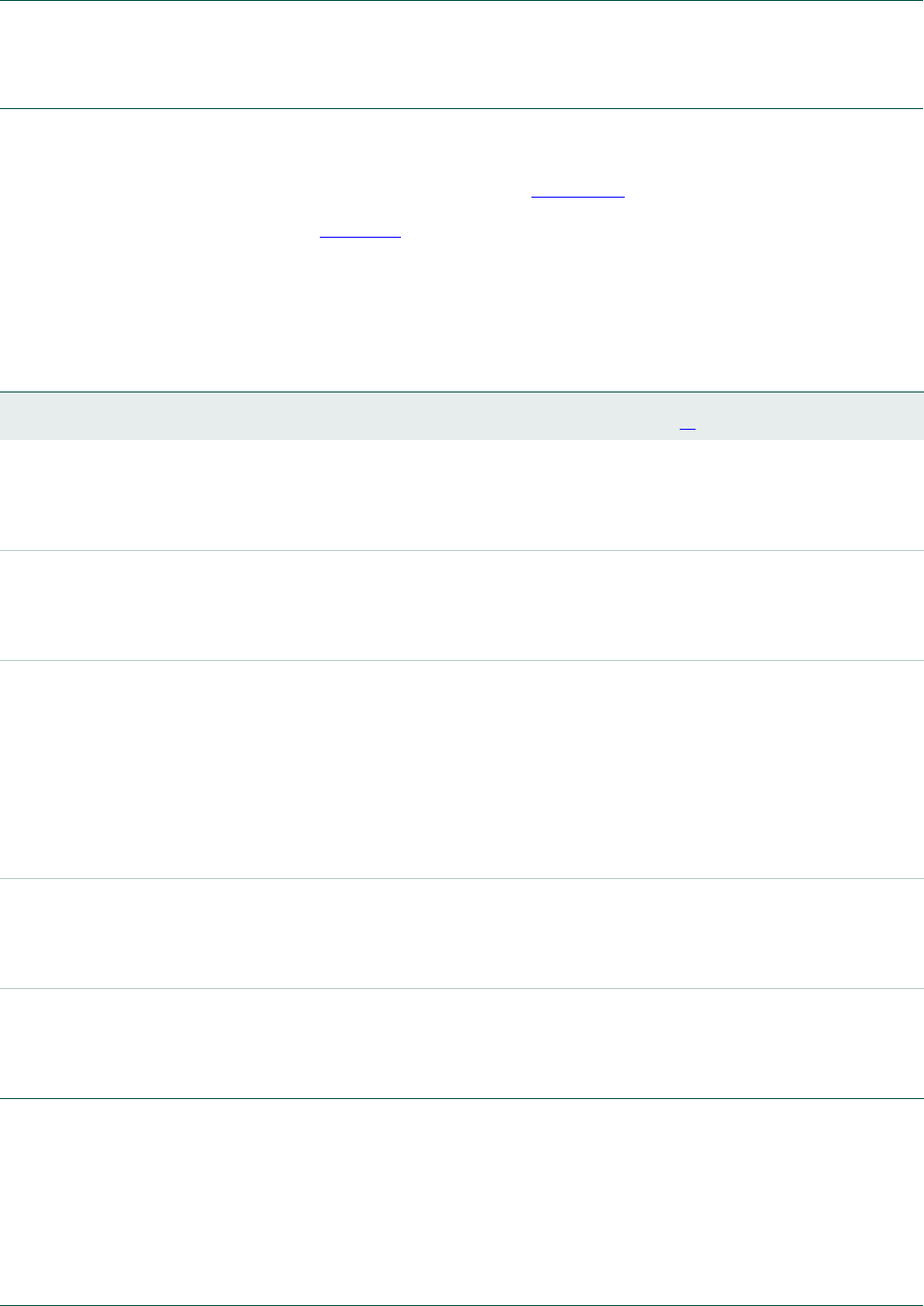
UM10360 All information provided in this document is subject to legal disclaimers. © NXP B.V. 2014. All rights reserved.
User manual Rev. 3.1 — 2 April 2014 131 of 849
NXP Semiconductors UM10360
Chapter 9: LPC176x/5x General Purpose Input/Output (GPIO)
9.5 Register description
Due to compatibility requirements with the LPC2300 series ARM7-based products, the
LPC176x/5x implements portions of five 32-bit General Purpose I/O ports. Details on a
specific GPIO port usage can be found in Section 8.3.
The registers in Tab le 10 2 represent the enhanced GPIO features available on all of the
GPIO ports. These registers are located on an AHB bus for fast read and write timing.
They can all be accessed in byte, half-word, and word sizes. A mask register allows
access to a group of bits in a single GPIO port independently from other bits in the same
port.
[1] Reset value reflects the data stored in used bits only. It does not include reserved bits content.
Table 102. GPIO register map (local bus accessible registers - enhanced GPIO features)
Generic
Name
Description Access Reset
value[1]
PORTn Register
Name & Address
FIODIR Fast GPIO Port Direction control register. This register
individually controls the direction of each port pin.
R/W 0 FIO0DIR - 0x2009 C000
FIO1DIR - 0x2009 C020
FIO2DIR - 0x2009 C040
FIO3DIR - 0x2009 C060
FIO4DIR - 0x2009 C080
FIOMASK Fast Mask register for port. Writes, sets, clears, and reads to
port (done via writes to FIOPIN, FIOSET, and FIOCLR, and
reads of FIOPIN) alter or return only the bits enabled by zeros
in this register.
R/W 0 FIO0MASK - 0x2009 C010
FIO1MASK - 0x2009 C030
FIO2MASK - 0x2009 C050
FIO3MASK - 0x2009 C070
FIO4MASK - 0x2009 C090
FIOPIN Fast Port Pin value register using FIOMASK. The current state
of digital port pins can be read from this register, regardless of
pin direction or alternate function selection (as long as pins are
not configured as an input to ADC). The value read is masked
by ANDing with inverted FIOMASK. Writing to this register
places corresponding values in all bits enabled by zeros in
FIOMASK.
Important: if an FIOPIN register is read, its bit(s) masked with
1 in the FIOMASK register will be read as 0 regardless of the
physical pin state.
R/W 0 FIO0PIN - 0x2009 C014
FIO1PIN - 0x2009 C034
FIO2PIN - 0x2009 C054
FIO3PIN - 0x2009 C074
FIO4PIN - 0x2009 C094
FIOSET Fast Port Output Set register using FIOMASK. This register
controls the state of output pins. Writing 1s produces highs at
the corresponding port pins. Writing 0s has no effect. Reading
this register returns the current contents of the port output
register. Only bits enabled by 0 in FIOMASK can be altered.
R/W 0 FIO0SET - 0x2009 C018
FIO1SET - 0x2009 C038
FIO2SET - 0x2009 C058
FIO3SET - 0x2009 C078
FIO4SET - 0x2009 C098
FIOCLR Fast Port Output Clear register using FIOMASK. This register
controls the state of output pins. Writing 1s produces lows at
the corresponding port pins. Writing 0s has no effect. Only bits
enabled by 0 in FIOMASK can be altered.
WO 0 FIO0CLR - 0x2009 C01C
FIO1CLR - 0x2009 C03C
FIO2CLR - 0x2009 C05C
FIO3CLR - 0x2009 C07C
FIO4CLR - 0x2009 C09C

UM10360 All information provided in this document is subject to legal disclaimers. © NXP B.V. 2014. All rights reserved.
User manual Rev. 3.1 — 2 April 2014 132 of 849
NXP Semiconductors UM10360
Chapter 9: LPC176x/5x General Purpose Input/Output (GPIO)
[1] Reset value reflects the data stored in used bits only. It does not include reserved bits content.
9.5.1 GPIO port Direction register FIOxDIR (FIO0DIR to FIO4DIR- 0x2009
C000 to 0x2009 C080)
This word accessible register is used to control the direction of the pins when they are
configured as GPIO port pins. Direction bit for any pin must be set according to the pin
functionality.
Note that GPIO pins P0.29 and P0.30 are shared with the USB_D+ and USB_D- pins and
must have the same direction. If either FIO0DIR bit 29 or 30 are configured as zero, both
P0.29 and P0.30 will be inputs. If both FIO0DIR bits 29 and 30 are ones, both P0.29 and
P0.30 will be outputs.
Aside from the 32-bit long and word only accessible FIODIR register, every fast GPIO port
can also be controlled via several byte and half-word accessible registers listed in
Tab l e 1 05 , too. Next to providing the same functions as the FIODIR register, these
additional registers allow easier and faster access to the physical port pins.
Table 103. GPIO interrupt register map
Generic
Name
Description Access Reset
value[1]
PORTn Register
Name & Address
IntEnR GPIO Interrupt Enable for Rising edge. R/W 0 IO0IntEnR - 0x4002 8090
IO2IntEnR - 0x4002 80B0
IntEnF GPIO Interrupt Enable for Falling edge. R/W 0 IO0IntEnR - 0x4002 8094
IO2IntEnR - 0x4002 80B4
IntStatR GPIO Interrupt Status for Rising edge. RO 0 IO0IntStatR - 0x4002 8084
IO2IntStatR - 0x4002 80A4
IntStatF GPIO Interrupt Status for Falling edge. RO 0 IO0IntStatF - 0x4002 8088
IO2IntStatF - 0x4002 80A8
IntClr GPIO Interrupt Clear. WO 0 IO0IntClr - 0x4002 808C
IO2IntClr - 0x4002 80AC
IntStatus GPIO overall Interrupt Status. RO 0 IOIntStatus - 0x4002 8080
Table 104. Fast GPIO port Direction register FIO0DIR to FIO4DIR - addresses 0x2009 C000 to
0x2009 C080) bit description
Bit Symbol Value Description Reset
value
31:0 FIO0DIR
FIO1DIR
FIO2DIR
FIO3DIR
FIO4DIR
Fast GPIO Direction PORTx control bits. Bit 0 in FIOxDIR
controls pin Px.0, bit 31 in FIOxDIR controls pin Px.31.
0x0
0Controlled pin is input.
1Controlled pin is output.

UM10360 All information provided in this document is subject to legal disclaimers. © NXP B.V. 2014. All rights reserved.
User manual Rev. 3.1 — 2 April 2014 133 of 849
NXP Semiconductors UM10360
Chapter 9: LPC176x/5x General Purpose Input/Output (GPIO)
9.5.2 GPIO port output Set register FIOxSET (FIO0SET to FIO4SET - 0x2009
C018 to 0x2009 C098)
This register is used to produce a HIGH level output at the port pins configured as GPIO in
an OUTPUT mode. Writing 1 produces a HIGH level at the corresponding port pins.
Writing 0 has no effect. If any pin is configured as an input or a secondary function, writing
1 to the corresponding bit in the FIOxSET has no effect.
Reading the FIOxSET register returns the value of this register, as determined by
previous writes to FIOxSET and FIOxCLR (or FIOxPIN as noted above). This value does
not reflect the effect of any outside world influence on the I/O pins.
Table 105. Fast GPIO port Direction control byte and half-word accessible register
description
Generic
Register
name
Description Register
length (bits)
& access
Reset
value
PORTn Register
Address & Name
FIOxDIR0 Fast GPIO Port x Direction
control register 0. Bit 0 in
FIOxDIR0 register corresponds
to pin Px.0 … bit 7 to pin Px.7.
8 (byte)
R/W
0x00 FIO0DIR0 - 0x2009 C000
FIO1DIR0 - 0x2009 C020
FIO2DIR0 - 0x2009 C040
FIO3DIR0 - 0x2009 C060
FIO4DIR0 - 0x2009 C080
FIOxDIR1 Fast GPIO Port x Direction
control register 1. Bit 0 in
FIOxDIR1 register corresponds
to pin Px.8 … bit 7 to pin Px.15.
8 (byte)
R/W
0x00 FIO0DIR1 - 0x2009 C001
FIO1DIR1 - 0x2009 C021
FIO2DIR1 - 0x2009 C041
FIO3DIR1 - 0x2009 C061
FIO4DIR1 - 0x2009 C081
FIOxDIR2 Fast GPIO Port x Direction
control register 2. Bit 0 in
FIOxDIR2 register corresponds
to pin Px.16 … bit 7 to pin
Px.23.
8 (byte)
R/W
0x00 FIO0DIR2 - 0x2009 C002
FIO1DIR2 - 0x2009 C022
FIO2DIR2 - 0x2009 C042
FIO3DIR2 - 0x2009 C062
FIO4DIR2 - 0x2009 C082
FIOxDIR3 Fast GPIO Port x Direction
control register 3. Bit 0 in
FIOxDIR3 register corresponds
to pin Px.24 … bit 7 to pin
Px.31.
8 (byte)
R/W
0x00 FIO0DIR3 - 0x2009 C003
FIO1DIR3 - 0x2009 C023
FIO2DIR3 - 0x2009 C043
FIO3DIR3 - 0x2009 C063
FIO4DIR3 - 0x2009 C083
FIOxDIRL Fast GPIO Port x Direction
control Lower half-word
register. Bit 0 in FIOxDIRL
register corresponds to pin
Px.0 … bit 15 to pin Px.15.
16 (half-word)
R/W
0x0000 FIO0DIRL - 0x2009 C000
FIO1DIRL - 0x2009 C020
FIO2DIRL - 0x2009 C040
FIO3DIRL - 0x2009 C060
FIO4DIRL - 0x2009 C080
FIOxDIRU Fast GPIO Port x Direction
control Upper half-word
register. Bit 0 in FIOxDIRU
register corresponds to Px.16
… bit 15 to Px.31.
16 (half-word)
R/W
0x0000 FIO0DIRU - 0x2009 C002
FIO1DIRU - 0x2009 C022
FIO2DIRU - 0x2009 C042
FIO3DIRU - 0x2009 C062
FIO4DIRU - 0x2009 C082

UM10360 All information provided in this document is subject to legal disclaimers. © NXP B.V. 2014. All rights reserved.
User manual Rev. 3.1 — 2 April 2014 134 of 849
NXP Semiconductors UM10360
Chapter 9: LPC176x/5x General Purpose Input/Output (GPIO)
Access to a port pin via the FIOxSET register is conditioned by the corresponding bit of
the FIOxMASK register (see Section 9.5.5).
Aside from the 32-bit long and word only accessible FIOxSET register, every fast GPIO
port can also be controlled via several byte and half-word accessible registers listed in
Tab l e 1 07 , too. Next to providing the same functions as the FIOxSET register, these
additional registers allow easier and faster access to the physical port pins.
Table 106. Fast GPIO port output Set register (FIO0SET to FIO4SET - addresses 0x2009 C018
to 0x2009 C098) bit description
Bit Symbol Value Description Reset
value
31:0 FIO0SET
FIO1SET
FIO2SET
FIO3SET
FIO4SET
Fast GPIO output value Set bits. Bit 0 in FIOxSET controls pin
Px.0, bit 31 in FIOxSET controls pin Px.31.
0x0
0Controlled pin output is unchanged.
1Controlled pin output is set to HIGH.
Table 107. Fast GPIO port output Set byte and half-word accessible register description
Generic
Register
name
Description Register
length (bits)
& access
Reset
value
PORTn Register
Address & Name
FIOxSET0 Fast GPIO Port x output Set
register 0. Bit 0 in FIOxSET0
register corresponds to pin
Px.0 … bit 7 to pin Px.7.
8 (byte)
R/W
0x00 FIO0SET0 - 0x2009 C018
FIO1SET0 - 0x2009 C038
FIO2SET0 - 0x2009 C058
FIO3SET0 - 0x2009 C078
FIO4SET0 - 0x2009 C098
FIOxSET1 Fast GPIO Port x output Set
register 1. Bit 0 in FIOxSET1
register corresponds to pin
Px.8 … bit 7 to pin Px.15.
8 (byte)
R/W
0x00 FIO0SET1 - 0x2009 C019
FIO1SET1 - 0x2009 C039
FIO2SET1 - 0x2009 C059
FIO3SET1 - 0x2009 C079
FIO4SET1 - 0x2009 C099
FIOxSET2 Fast GPIO Port x output Set
register 2. Bit 0 in FIOxSET2
register corresponds to pin
Px.16 … bit 7 to pin Px.23.
8 (byte)
R/W
0x00 FIO0SET2 - 0x2009 C01A
FIO1SET2 - 0x2009 C03A
FIO2SET2 - 0x2009 C05A
FIO3SET2 - 0x2009 C07A
FIO4SET2 - 0x2009 C09A
FIOxSET3 Fast GPIO Port x output Set
register 3. Bit 0 in FIOxSET3
register corresponds to pin
Px.24 … bit 7 to pin Px.31.
8 (byte)
R/W
0x00 FIO0SET3 - 0x2009 C01B
FIO1SET3 - 0x2009 C03B
FIO2SET3 - 0x2009 C05B
FIO3SET3 - 0x2009 C07B
FIO4SET3 - 0x2009 C09B
FIOxSETL Fast GPIO Port x output Set
Lower half-word register. Bit 0
in FIOxSETL register
corresponds to pin Px.0 … bit
15 to pin Px.15.
16 (half-word)
R/W
0x0000 FIO0SETL - 0x2009 C018
FIO1SETL - 0x2009 C038
FIO2SETL - 0x2009 C058
FIO3SETL - 0x2009 C078
FIO4SETL - 0x2009 C098
FIOxSETU Fast GPIO Port x output Set
Upper half-word register. Bit 0
in FIOxSETU register
corresponds to Px.16 … bit
15 to Px.31.
16 (half-word)
R/W
0x0000 FIO0SETU - 0x2009 C01A
FIO1SETU - 0x2009 C03A
FIO2SETU - 0x2009 C05A
FIO3SETU - 0x2009 C07A
FIO4SETU - 0x2009 C09A

UM10360 All information provided in this document is subject to legal disclaimers. © NXP B.V. 2014. All rights reserved.
User manual Rev. 3.1 — 2 April 2014 135 of 849
NXP Semiconductors UM10360
Chapter 9: LPC176x/5x General Purpose Input/Output (GPIO)
9.5.3 GPIO port output Clear register FIOxCLR (FIO0CLR to FIO4CLR-
0x2009 C01C to 0x2009 C09C)
This register is used to produce a LOW level output at port pins configured as GPIO in an
OUTPUT mode. Writing 1 produces a LOW level at the corresponding port pin and clears
the corresponding bit in the FIOxSET register. Writing 0 has no effect. If any pin is
configured as an input or a secondary function, writing to FIOxCLR has no effect.
Access to a port pin via the FIOxCLR register is conditioned by the corresponding bit of
the FIOxMASK register (see Section 9.5.5).
Aside from the 32-bit long and word only accessible FIOxCLR register, every fast GPIO
port can also be controlled via several byte and half-word accessible registers listed in
Tab l e 1 09 , too. Next to providing the same functions as the FIOxCLR register, these
additional registers allow easier and faster access to the physical port pins.
Table 108. Fast GPIO port output Clear register (FIO0CLR to FIO4CLR- addresses 0x2009
C01C to 0x2009 C09C) bit description
Bit Symbol Value Description Reset
value
31:0 FIO0CLR
FIO1CLR
FIO2CLR
FIO3CLR
FIO4CLR
Fast GPIO output value Clear bits. Bit 0 in FIOxCLR controls pin
Px.0, bit 31 controls pin Px.31.
0x0
0Controlled pin output is unchanged.
1Controlled pin output is set to LOW.
Table 109. Fast GPIO port output Clear byte and half-word accessible register
description
Generic
Register
name
Description Register
length (bits)
& access
Reset
value
PORTn Register
Address & Name
FIOxCLR0 Fast GPIO Port x output
Clear register 0. Bit 0 in
FIOxCLR0 register
corresponds to pin Px.0 …
bit 7 to pin Px.7.
8 (byte)
WO
0x00 FIO0CLR0 - 0x2009 C01C
FIO1CLR0 - 0x2009 C03C
FIO2CLR0 - 0x2009 C05C
FIO3CLR0 - 0x2009 C07C
FIO4CLR0 - 0x2009 C09C
FIOxCLR1 Fast GPIO Port x output
Clear register 1. Bit 0 in
FIOxCLR1 register
corresponds to pin Px.8 …
bit 7 to pin Px.15.
8 (byte)
WO
0x00 FIO0CLR1 - 0x2009 C01D
FIO1CLR1 - 0x2009 C03D
FIO2CLR1 - 0x2009 C05D
FIO3CLR1 - 0x2009 C07D
FIO4CLR1 - 0x2009 C09D
FIOxCLR2 Fast GPIO Port x output
Clear register 2. Bit 0 in
FIOxCLR2 register
corresponds to pin Px.16 …
bit 7 to pin Px.23.
8 (byte)
WO
0x00 FIO0CLR2 - 0x2009 C01E
FIO1CLR2 - 0x2009 C03E
FIO2CLR2 - 0x2009 C05E
FIO3CLR2 - 0x2009 C07E
FIO4CLR2 - 0x2009 C09E

UM10360 All information provided in this document is subject to legal disclaimers. © NXP B.V. 2014. All rights reserved.
User manual Rev. 3.1 — 2 April 2014 136 of 849
NXP Semiconductors UM10360
Chapter 9: LPC176x/5x General Purpose Input/Output (GPIO)
9.5.4 GPIO port Pin value register FIOxPIN (FIO0PIN to FIO4PIN- 0x2009
C014 to 0x2009 C094)
This register provides the value of port pins that are configured to perform only digital
functions. The register will give the logic value of the pin regardless of whether the pin is
configured for input or output, or as GPIO or an alternate digital function. As an example,
a particular port pin may have GPIO input, GPIO output, UART receive, and PWM output
as selectable functions. Any configuration of that pin will allow its current logic state to be
read from the corresponding FIOxPIN register.
If a pin has an analog function as one of its options, the pin state cannot be read if the
analog configuration is selected. Selecting the pin as an A/D input disconnects the digital
features of the pin. In that case, the pin value read in the FIOxPIN register is not valid.
Writing to the FIOxPIN register stores the value in the port output register, bypassing the
need to use both the FIOxSET and FIOxCLR registers to obtain the entire written value.
This feature should be used carefully in an application since it affects the entire port.
Access to a port pin via the FIOxPIN register is conditioned by the corresponding bit of
the FIOxMASK register (see Section 9.5.5).
FIOxCLR3 Fast GPIO Port x output
Clear register 3. Bit 0 in
FIOxCLR3 register
corresponds to pin Px.24 …
bit 7 to pin Px.31.
8 (byte)
WO
0x00 FIO0CLR3 - 0x2009 C01F
FIO1CLR3 - 0x2009 C03F
FIO2CLR3 - 0x2009 C05F
FIO3CLR3 - 0x2009 C07F
FIO4CLR3 - 0x2009 C09F
FIOxCLRL Fast GPIO Port x output
Clear Lower half-word
register. Bit 0 in FIOxCLRL
register corresponds to pin
Px.0 … bit 15 to pin Px.15.
16 (half-word)
WO
0x0000 FIO0CLRL - 0x2009 C01C
FIO1CLRL - 0x2009 C03C
FIO2CLRL - 0x2009 C05C
FIO3CLRL - 0x2009 C07C
FIO4CLRL - 0x2009 C09C
FIOxCLRU Fast GPIO Port x output
Clear Upper half-word
register. Bit 0 in FIOxCLRU
register corresponds to pin
Px.16 … bit 15 to Px.31.
16 (half-word)
WO
0x0000 FIO0CLRU - 0x2009 C01E
FIO1CLRU - 0x2009 C03E
FIO2CLRU - 0x2009 C05E
FIO3CLRU - 0x2009 C07E
FIO4CLRU - 0x2009 C09E
Table 109. Fast GPIO port output Clear byte and half-word accessible register
description …continued
Generic
Register
name
Description Register
length (bits)
& access
Reset
value
PORTn Register
Address & Name

UM10360 All information provided in this document is subject to legal disclaimers. © NXP B.V. 2014. All rights reserved.
User manual Rev. 3.1 — 2 April 2014 137 of 849
NXP Semiconductors UM10360
Chapter 9: LPC176x/5x General Purpose Input/Output (GPIO)
Only pins masked with zeros in the Mask register (see Section 9.5.5) will be correlated to
the current content of the Fast GPIO port pin value register.
Aside from the 32-bit long and word only accessible FIOxPIN register, every fast GPIO
port can also be controlled via several byte and half-word accessible register listed in
Tab l e 111, too. Next to providing the same functions as the FIOxPIN register, these
additional registers allow easier and faster access to the physical port pins.
Table 110. Fast GPIO port Pin value register (FIO0PIN to FIO4PIN- addresses 0x2009 C014 to
0x2009 C094) bit description
Bit Symbol Value Description Reset
value
31:0 FIO0VAL
FIO1VAL
FIO2VAL
FIO3VAL
FIO4VAL
Fast GPIO output value bits. Bit 0 corresponds to pin Px.0, bit 31
corresponds to pin Px.31. Only bits also set to 0 in the
FIOxMASK register are affected by a write or show the pin’s
actual logic state.
0x0
0Reading a 0 indicates that the port pin’s current state is LOW.
Writing a 0 sets the output register value to LOW.
1Reading a 1 indicates that the port pin’s current state is HIGH.
Writing a 1 sets the output register value to HIGH.
Table 111. Fast GPIO port Pin value byte and half-word accessible register
description
Generic
Register
name
Description Register
length (bits)
& access
Reset
value
PORTn Register
Address & Name
FIOxPIN0 Fast GPIO Port x Pin value
register 0. Bit 0 in FIOxPIN0
register corresponds to pin
Px.0 … bit 7 to pin Px.7.
8 (byte)
R/W
0x00 FIO0PIN0 - 0x2009 C014
FIO1PIN0 - 0x2009 C034
FIO2PIN0 - 0x2009 C054
FIO3PIN0 - 0x2009 C074
FIO4PIN0 - 0x2009 C094
FIOxPIN1 Fast GPIO Port x Pin value
register 1. Bit 0 in FIOxPIN1
register corresponds to pin
Px.8 … bit 7 to pin Px.15.
8 (byte)
R/W
0x00 FIO0PIN1 - 0x2009 C015
FIO1PIN1 - 0x2009 C035
FIO2PIN1 - 0x2009 C055
FIO3PIN1 - 0x2009 C075
FIO4PIN1 - 0x2009 C095
FIOxPIN2 Fast GPIO Port x Pin value
register 2. Bit 0 in FIOxPIN2
register corresponds to pin
Px.16 … bit 7 to pin Px.23.
8 (byte)
R/W
0x00 FIO0PIN2 - 0x2009 C016
FIO1PIN2 - 0x2009 C036
FIO2PIN2 - 0x2009 C056
FIO3PIN2 - 0x2009 C076
FIO4PIN2 - 0x2009 C096

UM10360 All information provided in this document is subject to legal disclaimers. © NXP B.V. 2014. All rights reserved.
User manual Rev. 3.1 — 2 April 2014 138 of 849
NXP Semiconductors UM10360
Chapter 9: LPC176x/5x General Purpose Input/Output (GPIO)
9.5.5 Fast GPIO port Mask register FIOxMASK (FIO0MASK to FIO4MASK -
0x2009 C010 to 0x2009 C090)
This register is used to select port pins that will and will not be affected by write accesses
to the FIOxPIN, FIOxSET or FIOxCLR register. Mask register also filters out port’s content
when the FIOxPIN register is read.
A zero in this register’s bit enables an access to the corresponding physical pin via a read
or write access. If a bit in this register is one, corresponding pin will not be changed with
write access and if read, will not be reflected in the updated FIOxPIN register. For
software examples, see Section 9.6.
FIOxPIN3 Fast GPIO Port x Pin value
register 3. Bit 0 in FIOxPIN3
register corresponds to pin
Px.24 … bit 7 to pin Px.31.
8 (byte)
R/W
0x00 FIO0PIN3 - 0x2009 C017
FIO1PIN3 - 0x2009 C037
FIO2PIN3 - 0x2009 C057
FIO3PIN3 - 0x2009 C077
FIO4PIN3 - 0x2009 C097
FIOxPINL Fast GPIO Port x Pin value
Lower half-word register. Bit 0
in FIOxPINL register
corresponds to pin Px.0 … bit
15 to pin Px.15.
16 (half-word)
R/W
0x0000 FIO0PINL - 0x2009 C014
FIO1PINL - 0x2009 C034
FIO2PINL - 0x2009 C054
FIO3PINL - 0x2009 C074
FIO4PINL - 0x2009 C094
FIOxPINU Fast GPIO Port x Pin value
Upper half-word register. Bit 0
in FIOxPINU register
corresponds to pin Px.16 … bit
15 to Px.31.
16 (half-word)
R/W
0x0000 FIO0PINU - 0x2009 C016
FIO1PINU - 0x2009 C036
FIO2PINU - 0x2009 C056
FIO3PINU - 0x2009 C076
FIO4PINU - 0x2009 C096
Table 111. Fast GPIO port Pin value byte and half-word accessible register
description …continued
Generic
Register
name
Description Register
length (bits)
& access
Reset
value
PORTn Register
Address & Name
Table 112. Fast GPIO port Mask register (FIO0MASK to FIO4MASK - addresses 0x2009 C010
to 0x2009 C090) bit description
Bit Symbol Value Description Reset
value
31:0 FIO0MASK
FIO1MASK
FIO2MASK
FIO3MASK
FIO4MASK
Fast GPIO physical pin access control. 0x0
0Controlled pin is affected by writes to the port’s FIOxSET,
FIOxCLR, and FIOxPIN register(s). Current state of the pin
can be read from the FIOxPIN register.
1Controlled pin is not affected by writes into the port’s
FIOxSET, FIOxCLR and FIOxPIN register(s). When the
FIOxPIN register is read, this bit will not be updated with the
state of the physical pin.

UM10360 All information provided in this document is subject to legal disclaimers. © NXP B.V. 2014. All rights reserved.
User manual Rev. 3.1 — 2 April 2014 139 of 849
NXP Semiconductors UM10360
Chapter 9: LPC176x/5x General Purpose Input/Output (GPIO)
Aside from the 32-bit long and word only accessible FIOxMASK register, every fast GPIO
port can also be controlled via several byte and half-word accessible registers listed in
Ta b l e 11 3 , too. Next to providing the same functions as the FIOxMASK register, these
additional registers allow easier and faster access to the physical port pins.
Table 113. Fast GPIO port Mask byte and half-word accessible register description
Generic
Register
name
Description Register
length (bits)
& access
Reset
value
PORTn Register
Address & Name
FIOxMASK0 Fast GPIO Port x Mask
register 0. Bit 0 in
FIOxMASK0 register
corresponds to pin Px.0 …
bit 7 to pin Px.7.
8 (byte)
R/W
0x0 FIO0MASK0 - 0x2009 C010
FIO1MASK0 - 0x2009 C030
FIO2MASK0 - 0x2009 C050
FIO3MASK0 - 0x2009 C070
FIO4MASK0 - 0x2009 C090
FIOxMASK1 Fast GPIO Port x Mask
register 1. Bit 0 in
FIOxMASK1 register
corresponds to pin Px.8 …
bit 7 to pin Px.15.
8 (byte)
R/W
0x0 FIO0MASK1 - 0x2009 C011
FIO1MASK1 - 0x2009 C031
FIO2MASK1 - 0x2009 C051
FIO3MASK1 - 0x2009 C071
FIO4MASK1 - 0x2009 C091
FIOxMASK2 Fast GPIO Port x Mask
register 2. Bit 0 in
FIOxMASK2 register
corresponds to pin Px.16 …
bit 7 to pin Px.23.
8 (byte)
R/W
0x0 FIO0MASK2 - 0x2009 C012
FIO1MASK2 - 0x2009 C032
FIO2MASK2 - 0x2009 C052
FIO3MASK2 - 0x2009 C072
FIO4MASK2 - 0x2009 C092
FIOxMASK3 Fast GPIO Port x Mask
register 3. Bit 0 in
FIOxMASK3 register
corresponds to pin Px.24 …
bit 7 to pin Px.31.
8 (byte)
R/W
0x0 FIO0MASK3 - 0x2009 C013
FIO1MASK3 - 0x2009 C033
FIO2MASK3 - 0x2009 C053
FIO3MASK3 - 0x2009 C073
FIO4MASK3 - 0x2009 C093
FIOxMASKL Fast GPIO Port x Mask
Lower half-word register.
Bit 0 in FIOxMASKL
register corresponds to pin
Px.0 … bit 15 to pin Px.15.
16
(half-word)
R/W
0x0 FIO0MASKL - 0x2009 C010
FIO1MASKL - 0x2009 C030
FIO2MASKL - 0x2009 C050
FIO3MASKL - 0x2009 C070
FIO4MASKL - 0x2009 C090
FIOxMASKU Fast GPIO Port x Mask
Upper half-word register.
Bit 0 in FIOxMASKU
register corresponds to pin
Px.16 … bit 15 to Px.31.
16
(half-word)
R/W
0x0 FIO0MASKU - 0x2009 C012
FIO1MASKU - 0x2009 C032
FIO2MASKU - 0x2009 C052
FIO3MASKU - 0x2009 C072
FIO4MASKU - 0x2009 C092

UM10360 All information provided in this document is subject to legal disclaimers. © NXP B.V. 2014. All rights reserved.
User manual Rev. 3.1 — 2 April 2014 140 of 849
NXP Semiconductors UM10360
Chapter 9: LPC176x/5x General Purpose Input/Output (GPIO)
9.5.6 GPIO interrupt registers
The following registers configure the pins of Port 0 and Port 2 to generate interrupts.
9.5.6.1 GPIO overall Interrupt Status register (IOIntStatus - 0x4002 8080)
This read-only register indicates the presence of interrupt pending on all of the GPIO ports
that support GPIO interrupts. Only status one bit per port is required.
9.5.6.2 GPIO Interrupt Enable for port 0 Rising Edge (IO0IntEnR - 0x4002 8090)
Each bit in these read-write registers enables the rising edge interrupt for the
corresponding port 0 pin.
Table 114. GPIO overall Interrupt Status register (IOIntStatus - address 0x4002 8080) bit
description
Bit Symbol Value Description Reset
value
0P0Int Port 0 GPIO interrupt pending. 0
0There are no pending interrupts on Port 0.
1There is at least one pending interrupt on Port 0.
1- - Reserved. The value read from a reserved bit is not defined.NA
2P2Int Port 2 GPIO interrupt pending. 0
0There are no pending interrupts on Port 2.
1There is at least one pending interrupt on Port 2.
31:2 - - Reserved. The value read from a reserved bit is not defined. NA
Table 115. GPIO Interrupt Enable for port 0 Rising Edge (IO0IntEnR - 0x4002 8090) bit
description
Bit Symbol Value Description Reset
value
0P0.0ER Enable rising edge interrupt for P0.0. 0
0Rising edge interrupt is disabled on P0.0.
1Rising edge interrupt is enabled on P0.0.
1P0.1ER Enable rising edge interrupt for P0.1. 0
2P0.2ER Enable rising edge interrupt for P0.2. 0
3P0.3ER Enable rising edge interrupt for P0.3. 0
4P0.4ER
[1] Enable rising edge interrupt for P0.4. 0
5P0.5ER
[1] Enable rising edge interrupt for P0.5. 0
6P0.6ER Enable rising edge interrupt for P0.6. 0
7P0.7ER Enable rising edge interrupt for P0.7. 0
8P0.8ER Enable rising edge interrupt for P0.8. 0
9P0.9ER Enable rising edge interrupt for P0.9. 0
10 P0.10ER Enable rising edge interrupt for P0.10. 0
11 P0.11ER Enable rising edge interrupt for P0.11. 0
14:12 - Reserved NA
15 P0.15ER Enable rising edge interrupt for P0.15. 0
16 P0.16ER Enable rising edge interrupt for P0.16. 0

UM10360 All information provided in this document is subject to legal disclaimers. © NXP B.V. 2014. All rights reserved.
User manual Rev. 3.1 — 2 April 2014 141 of 849
NXP Semiconductors UM10360
Chapter 9: LPC176x/5x General Purpose Input/Output (GPIO)
[1] Not available on 80-pin package.
9.5.6.3 GPIO Interrupt Enable for port 2 Rising Edge (IO2IntEnR - 0x4002 80B0)
Each bit in these read-write registers enables the rising edge interrupt for the
corresponding port 2 pin.
17 P0.17ER Enable rising edge interrupt for P0.17. 0
18 P0.18ER Enable rising edge interrupt for P0.18. 0
19 P0.19ER[1] Enable rising edge interrupt for P0.19. 0
20 P0.20ER[1] Enable rising edge interrupt for P0.20. 0
21 P0.21ER[1] Enable rising edge interrupt for P0.21. 0
22 P0.22ER Enable rising edge interrupt for P0.22. 0
23 P0.23ER[1] Enable rising edge interrupt for P0.23. 0
24 P0.24ER[1] Enable rising edge interrupt for P0.24. 0
25 P0.25ER Enable rising edge interrupt for P0.25. 0
26 P0.26ER Enable rising edge interrupt for P0.26. 0
27 P0.27ER[1] Enable rising edge interrupt for P0.27. 0
28 P0.28ER[1] Enable rising edge interrupt for P0.28. 0
29 P0.29ER Enable rising edge interrupt for P0.29. 0
30 P0.30ER Enable rising edge interrupt for P0.30. 0
31 - Reserved. NA
Table 115. GPIO Interrupt Enable for port 0 Rising Edge (IO0IntEnR - 0x4002 8090) bit
description …continued
Bit Symbol Value Description Reset
value
Table 116. GPIO Interrupt Enable for port 2 Rising Edge (IO2IntEnR - 0x4002 80B0) bit
description
Bit Symbol Value Description Reset
value
0P2.0ER Enable rising edge interrupt for P2.0. 0
0Rising edge interrupt is disabled on P2.0.
1Rising edge interrupt is enabled on P2.0.
1P2.1ER Enable rising edge interrupt for P2.1. 0
2P2.2ER Enable rising edge interrupt for P2.2. 0
3P2.3ER Enable rising edge interrupt for P2.3. 0
4P2.4ER Enable rising edge interrupt for P2.4. 0
5P2.5ER Enable rising edge interrupt for P2.5. 0
6P2.6ER Enable rising edge interrupt for P2.6. 0
7P2.7ER Enable rising edge interrupt for P2.7. 0
8P2.8ER Enable rising edge interrupt for P2.8. 0
9P2.9ER Enable rising edge interrupt for P2.9. 0
10 P2.10ER Enable rising edge interrupt for P2.10. 0
11 P2.11ER[1] Enable rising edge interrupt for P2.11. 0

UM10360 All information provided in this document is subject to legal disclaimers. © NXP B.V. 2014. All rights reserved.
User manual Rev. 3.1 — 2 April 2014 142 of 849
NXP Semiconductors UM10360
Chapter 9: LPC176x/5x General Purpose Input/Output (GPIO)
[1] Not available on 80-pin package.
9.5.6.4 GPIO Interrupt Enable for port 0 Falling Edge (IO0IntEnF - 0x4002 8094)
Each bit in these read-write registers enables the falling edge interrupt for the
corresponding GPIO port 0 pin.
12 P2.12ER[1] Enable rising edge interrupt for P2.12. 0
13 P2.13ER[1] Enable rising edge interrupt for P2.13. 0
31:14 - Reserved. NA
Table 116. GPIO Interrupt Enable for port 2 Rising Edge (IO2IntEnR - 0x4002 80B0) bit
description …continued
Bit Symbol Value Description Reset
value
Table 117. GPIO Interrupt Enable for port 0 Falling Edge (IO0IntEnF - address 0x4002 8094)
bit description
Bit Symbol Value Description Reset
value
0P0.0EF Enable falling edge interrupt for P0.0 0
0Falling edge interrupt is disabled on P0.0.
1Falling edge interrupt is enabled on P0.0.
1P0.1EF Enable falling edge interrupt for P0.1. 0
2P0.2EF Enable falling edge interrupt for P0.2. 0
3P0.3EF Enable falling edge interrupt for P0.3. 0
4P0.4EF
[1] Enable falling edge interrupt for P0.4. 0
5P0.5EF
[1] Enable falling edge interrupt for P0.5. 0
6P0.6EF Enable falling edge interrupt for P0.6. 0
7P0.7EF Enable falling edge interrupt for P0.7. 0
8P0.8EF Enable falling edge interrupt for P0.8. 0
9P0.9EF Enable falling edge interrupt for P0.9. 0
10 P0.10EF Enable falling edge interrupt for P0.10. 0
11 P0.11EF Enable falling edge interrupt for P0.11. 0
14:12 - Reserved. NA
15 P0.15EF Enable falling edge interrupt for P0.15. 0
16 P0.16EF Enable falling edge interrupt for P0.16. 0
17 P0.17EF Enable falling edge interrupt for P0.17. 0
18 P0.18EF Enable falling edge interrupt for P0.18. 0
19 P0.19EF[1] Enable falling edge interrupt for P0.19. 0
20 P0.20EF[1] Enable falling edge interrupt for P0.20. 0
21 P0.21EF[1] Enable falling edge interrupt for P0.21. 0
22 P0.22EF Enable falling edge interrupt for P0.22. 0
23 P0.23EF[1] Enable falling edge interrupt for P0.23. 0
24 P0.24EF[1] Enable falling edge interrupt for P0.24. 0
25 P0.25EF Enable falling edge interrupt for P0.25. 0
26 P0.26EF Enable falling edge interrupt for P0.26. 0
27 P0.27EF[1] Enable falling edge interrupt for P0.27. 0

UM10360 All information provided in this document is subject to legal disclaimers. © NXP B.V. 2014. All rights reserved.
User manual Rev. 3.1 — 2 April 2014 143 of 849
NXP Semiconductors UM10360
Chapter 9: LPC176x/5x General Purpose Input/Output (GPIO)
[1] Not available on 80-pin package.
9.5.6.5 GPIO Interrupt Enable for port 2 Falling Edge (IO2IntEnF - 0x4002 80B4)
Each bit in these read-write registers enables the falling edge interrupt for the
corresponding GPIO port 2 pin.
[1] Not available on 80-pin package.
28 P0.28EF[1] Enable falling edge interrupt for P0.28. 0
29 P0.29EF Enable falling edge interrupt for P0.29. 0
30 P0.30EF Enable falling edge interrupt for P0.30. 0
31 - Reserved. NA
Table 117. GPIO Interrupt Enable for port 0 Falling Edge (IO0IntEnF - address 0x4002 8094)
bit description …continued
Bit Symbol Value Description Reset
value
Table 118. GPIO Interrupt Enable for port 2 Falling Edge (IO2IntEnF - 0x4002 80B4) bit
description
Bit Symbol Value Description Reset
value
0P2.0EF Enable falling edge interrupt for P2.0 0
0Falling edge interrupt is disabled on P2.0.
1Falling edge interrupt is enabled on P2.0.
1P2.1EF Enable falling edge interrupt for P2.1. 0
2P2.2EF Enable falling edge interrupt for P2.2. 0
3P2.3EF Enable falling edge interrupt for P2.3. 0
4P2.4EF Enable falling edge interrupt for P2.4. 0
5P2.5EF Enable falling edge interrupt for P2.5. 0
6P2.6EF Enable falling edge interrupt for P2.6. 0
7P2.7EF Enable falling edge interrupt for P2.7. 0
8P2.8EF Enable falling edge interrupt for P2.8. 0
9P2.9EF Enable falling edge interrupt for P2.9. 0
10 P2.10EF Enable falling edge interrupt for P2.10. 0
11 P2.11EF[1] Enable falling edge interrupt for P2.11. 0
12 P2.12EF[1] Enable falling edge interrupt for P2.12. 0
13 P2.13EF[1] Enable falling edge interrupt for P2.13. 0
31:14 - Reserved. NA

UM10360 All information provided in this document is subject to legal disclaimers. © NXP B.V. 2014. All rights reserved.
User manual Rev. 3.1 — 2 April 2014 144 of 849
NXP Semiconductors UM10360
Chapter 9: LPC176x/5x General Purpose Input/Output (GPIO)
9.5.6.6 GPIO Interrupt Status for port 0 Rising Edge Interrupt (IO0IntStatR -
0x4002 8084)
Each bit in these read-only registers indicates the rising edge interrupt status for port 0.
[1] Not available on 80-pin package.
Table 119. GPIO Interrupt Status for port 0 Rising Edge Interrupt (IO0IntStatR - 0x4002 8084)
bit description
Bit Symbol Value Description Reset
value
0P0.0REI Status of Rising Edge Interrupt for P0.0 0
0A rising edge has not been detected on P0.0.
1Interrupt has been generated due to a rising edge on P0.0.
1P0.1REI Status of Rising Edge Interrupt for P0.1. 0
2P0.2REI Status of Rising Edge Interrupt for P0.2. 0
3P0.3REI Status of Rising Edge Interrupt for P0.3. 0
4P0.4REI
[1] Status of Rising Edge Interrupt for P0.4. 0
5P0.5REI
[1] Status of Rising Edge Interrupt for P0.5. 0
6P0.6REI Status of Rising Edge Interrupt for P0.6. 0
7P0.7REI Status of Rising Edge Interrupt for P0.7. 0
8P0.8REI Status of Rising Edge Interrupt for P0.8. 0
9P0.9REI Status of Rising Edge Interrupt for P0.9. 0
10 P0.10REI Status of Rising Edge Interrupt for P0.10. 0
11 P0.11REI Status of Rising Edge Interrupt for P0.11. 0
14:12 - Reserved. NA
15 P0.15REI Status of Rising Edge Interrupt for P0.15. 0
16 P0.16REI Status of Rising Edge Interrupt for P0.16. 0
17 P0.17REI Status of Rising Edge Interrupt for P0.17. 0
18 P0.18REI Status of Rising Edge Interrupt for P0.18. 0
19 P0.19REI[1] Status of Rising Edge Interrupt for P0.19. 0
20 P0.20REI[1] Status of Rising Edge Interrupt for P0.20. 0
21 P0.21REI[1] Status of Rising Edge Interrupt for P0.21. 0
22 P0.22REI Status of Rising Edge Interrupt for P0.22. 0
23 P0.23REI[1] Status of Rising Edge Interrupt for P0.23. 0
24 P0.24REI[1] Status of Rising Edge Interrupt for P0.24. 0
25 P0.25REI Status of Rising Edge Interrupt for P0.25. 0
26 P0.26REI Status of Rising Edge Interrupt for P0.26. 0
27 P0.27REI[1] Status of Rising Edge Interrupt for P0.27. 0
28 P0.28REI[1] Status of Rising Edge Interrupt for P0.28. 0
29 P0.29REI Status of Rising Edge Interrupt for P0.29. 0
30 P0.30REI Status of Rising Edge Interrupt for P0.30. 0
31 - Reserved. NA

UM10360 All information provided in this document is subject to legal disclaimers. © NXP B.V. 2014. All rights reserved.
User manual Rev. 3.1 — 2 April 2014 145 of 849
NXP Semiconductors UM10360
Chapter 9: LPC176x/5x General Purpose Input/Output (GPIO)
9.5.6.7 GPIO Interrupt Status for port 2 Rising Edge Interrupt (IO2IntStatR -
0x4002 80A4)
Each bit in these read-only registers indicates the rising edge interrupt status for port 2.
[1] Not available on 80-pin package.
9.5.6.8 GPIO Interrupt Status for port 0 Falling Edge Interrupt (IO0IntStatF -
0x4002 8088)
Each bit in these read-only registers indicates the falling edge interrupt status for port 0.
Table 120. GPIO Interrupt Status for port 2 Rising Edge Interrupt (IO2IntStatR - 0x4002 80A4)
bit description
Bit Symbol Value Description Reset
value
0P2.0REI Status of Rising Edge Interrupt for P2.0 0
0A rising edge has not been detected on P2.0.
1Interrupt has been generated due to a rising edge on P2.0.
1P2.1REI Status of Rising Edge Interrupt for P2.1. 0
2P2.2REI Status of Rising Edge Interrupt for P2.2. 0
3P2.3REI Status of Rising Edge Interrupt for P2.3. 0
4P2.4REI Status of Rising Edge Interrupt for P2.4. 0
5P2.5REI Status of Rising Edge Interrupt for P2.5. 0
6P2.6REI Status of Rising Edge Interrupt for P2.6. 0
7P2.7REI Status of Rising Edge Interrupt for P2.7. 0
8P2.8REI Status of Rising Edge Interrupt for P2.8. 0
9P2.9REI Status of Rising Edge Interrupt for P2.9. 0
10 P2.10REI Status of Rising Edge Interrupt for P2.10. 0
11 P2.11REI[1] Status of Rising Edge Interrupt for P2.11. 0
12 P2.12REI[1] Status of Rising Edge Interrupt for P2.12. 0
13 P2.13REI[1] Status of Rising Edge Interrupt for P2.13. 0
31:14 - Reserved. NA
Table 121. GPIO Interrupt Status for port 0 Falling Edge Interrupt (IO0IntStatF - 0x4002 8088)
bit description
Bit Symbol Value Description Reset
value
0P0.0FEI Status of Falling Edge Interrupt for P0.0 0
0A falling edge has not been detected on P0.0.
1Interrupt has been generated due to a falling edge on P0.0.
1P0.1FEI Status of Falling Edge Interrupt for P0.1. 0
2P0.2FEI Status of Falling Edge Interrupt for P0.2. 0
3P0.3FEI Status of Falling Edge Interrupt for P0.3. 0
4P0.4FEI
[1] Status of Falling Edge Interrupt for P0.4. 0
5P0.5FEI
[1] Status of Falling Edge Interrupt for P0.5. 0
6P0.6FEI Status of Falling Edge Interrupt for P0.6. 0
7P0.7FEI Status of Falling Edge Interrupt for P0.7. 0

UM10360 All information provided in this document is subject to legal disclaimers. © NXP B.V. 2014. All rights reserved.
User manual Rev. 3.1 — 2 April 2014 146 of 849
NXP Semiconductors UM10360
Chapter 9: LPC176x/5x General Purpose Input/Output (GPIO)
[1] Not available on 80-pin package.
9.5.6.9 GPIO Interrupt Status for port 2 Falling Edge Interrupt (IO2IntStatF -
0x4002 80A8)
Each bit in these read-only registers indicates the falling edge interrupt status for port 2.
8P0.8FEI Status of Falling Edge Interrupt for P0.8. 0
9P0.9FEI Status of Falling Edge Interrupt for P0.9. 0
10 P0.10FEI Status of Falling Edge Interrupt for P0.10. 0
11 P0.11FEI Status of Falling Edge Interrupt for P0.11. 0
14:12 - Reserved. NA
15 P0.15FEI Status of Falling Edge Interrupt for P0.15. 0
16 P0.16FEI Status of Falling Edge Interrupt for P0.16. 0
17 P0.17FEI Status of Falling Edge Interrupt for P0.17. 0
18 P0.18FEI Status of Falling Edge Interrupt for P0.18. 0
19 P0.19FEI[1] Status of Falling Edge Interrupt for P0.19. 0
20 P0.20FEI[1] Status of Falling Edge Interrupt for P0.20. 0
21 P0.21FEI[1] Status of Falling Edge Interrupt for P0.21. 0
22 P0.22FEI Status of Falling Edge Interrupt for P0.22. 0
23 P0.23FEI[1] Status of Falling Edge Interrupt for P0.23. 0
24 P0.24FEI[1] Status of Falling Edge Interrupt for P0.24. 0
25 P0.25FEI Status of Falling Edge Interrupt for P0.25. 0
26 P0.26FEI Status of Falling Edge Interrupt for P0.26. 0
27 P0.27FEI[1] Status of Falling Edge Interrupt for P0.27. 0
28 P0.28FEI[1] Status of Falling Edge Interrupt for P0.28. 0
29 P0.29FEI Status of Falling Edge Interrupt for P0.29. 0
30 P0.30FEI Status of Falling Edge Interrupt for P0.30. 0
31 - Reserved. NA
Table 121. GPIO Interrupt Status for port 0 Falling Edge Interrupt (IO0IntStatF - 0x4002 8088)
bit description …continued
Bit Symbol Value Description Reset
value
Table 122. GPIO Interrupt Status for port 2 Falling Edge Interrupt (IO2IntStatF - 0x4002 80A8)
bit description
Bit Symbol Value Description Reset
value
0P2.0FEI Status of Falling Edge Interrupt for P2.0 0
0A falling edge has not been detected on P2.0.
1Interrupt has been generated due to a falling edge on P2.0.
1P2.1FEI Status of Falling Edge Interrupt for P2.1. 0
2P2.2FEI Status of Falling Edge Interrupt for P2.2. 0
3P2.3FEI Status of Falling Edge Interrupt for P2.3. 0
4P2.4FEI Status of Falling Edge Interrupt for P2.4. 0
5P2.5FEI Status of Falling Edge Interrupt for P2.5. 0
6P2.6FEI Status of Falling Edge Interrupt for P2.6. 0

UM10360 All information provided in this document is subject to legal disclaimers. © NXP B.V. 2014. All rights reserved.
User manual Rev. 3.1 — 2 April 2014 147 of 849
NXP Semiconductors UM10360
Chapter 9: LPC176x/5x General Purpose Input/Output (GPIO)
[1] Not available on 80-pin package.
9.5.6.10 GPIO Interrupt Clear register for port 0 (IO0IntClr - 0x4002 808C)
Writing a 1 into a bit in this write-only register clears any interrupts for the corresponding
port 0 pin.
7P2.7FEI Status of Falling Edge Interrupt for P2.7. 0
8P2.8FEI Status of Falling Edge Interrupt for P2.8. 0
9P2.9FEI Status of Falling Edge Interrupt for P2.9. 0
10 P2.10FEI Status of Falling Edge Interrupt for P2.10. 0
11 P2.11FEI[1] Status of Falling Edge Interrupt for P2.11. 0
12 P2.12FEI[1] Status of Falling Edge Interrupt for P2.12. 0
13 P2.13FEI[1] Status of Falling Edge Interrupt for P2.13. 0
31:14 - Reserved. NA
Table 122. GPIO Interrupt Status for port 2 Falling Edge Interrupt (IO2IntStatF - 0x4002 80A8)
bit description …continued
Bit Symbol Value Description Reset
value
Table 123. GPIO Interrupt Clear register for port 0 (IO0IntClr - 0x4002 808C)) bit
description
Bit Symbol Value Description Reset
value
0P0.0CI Clear GPIO port Interrupts for P0.0 0
0 Corresponding bits in IOxIntStatR and IOxIntStatF are
unchanged.
1 Corresponding bits in IOxIntStatR and IOxStatF are cleared.
1P0.1CI Clear GPIO port Interrupts for P0.1. 0
2P0.2CI Clear GPIO port Interrupts for P0.2. 0
3P0.3CI Clear GPIO port Interrupts for P0.3. 0
4P0.4CI
[1] Clear GPIO port Interrupts for P0.4. 0
5P0.5CI
[1] Clear GPIO port Interrupts for P0.5. 0
6P0.6CI Clear GPIO port Interrupts for P0.6. 0
7P0.7CI Clear GPIO port Interrupts for P0.7. 0
8P0.8CI Clear GPIO port Interrupts for P0.8. 0
9P0.9CI Clear GPIO port Interrupts for P0.9. 0
10 P0.10CI Clear GPIO port Interrupts for P0.10. 0
11 P0.11CI Clear GPIO port Interrupts for P0.11. 0
14:12 - Reserved. NA
15 P0.15CI Clear GPIO port Interrupts for P0.15. 0
16 P0.16CI Clear GPIO port Interrupts for P0.16. 0
17 P0.17CI Clear GPIO port Interrupts for P0.17. 0
18 P0.18CI Clear GPIO port Interrupts for P0.18. 0
19 P0.19CI[1] Clear GPIO port Interrupts for P0.19. 0
20 P0.20CI[1] Clear GPIO port Interrupts for P0.20. 0
21 P0.21CI[1] Clear GPIO port Interrupts for P0.21. 0

UM10360 All information provided in this document is subject to legal disclaimers. © NXP B.V. 2014. All rights reserved.
User manual Rev. 3.1 — 2 April 2014 148 of 849
NXP Semiconductors UM10360
Chapter 9: LPC176x/5x General Purpose Input/Output (GPIO)
[1] Not available on 80-pin package.
9.5.6.11 GPIO Interrupt Clear register for port 2 (IO2IntClr - 0x4002 80AC)
Writing a 1 into a bit in this write-only register clears any interrupts for the corresponding
port 2 pin.
[1] Not available on 80-pin package.
22 P0.22CI Clear GPIO port Interrupts for P0.22. 0
23 P0.23CI[1] Clear GPIO port Interrupts for P0.23. 0
24 P0.24CI[1] Clear GPIO port Interrupts for P0.24. 0
25 P0.25CI Clear GPIO port Interrupts for P0.25. 0
26 P0.26CI Clear GPIO port Interrupts for P0.26. 0
27 P0.27CI[1] Clear GPIO port Interrupts for P0.27. 0
28 P0.28CI[1] Clear GPIO port Interrupts for P0.28. 0
29 P0.29CI Clear GPIO port Interrupts for P0.29. 0
30 P0.30CI Clear GPIO port Interrupts for P0.30. 0
31 - Reserved. NA
Table 123. GPIO Interrupt Clear register for port 0 (IO0IntClr - 0x4002 808C)) bit
description …continued
Bit Symbol Value Description Reset
value
Table 124. GPIO Interrupt Clear register for port 2 (IO2IntClr - 0x4002 80AC) bit description
Bit Symbol Value Description Reset
value
0P2.0CI Clear GPIO port Interrupts for P2.0 0
0 Corresponding bits in IOxIntStatR and IOxIntStatF are
unchanged.
1 Corresponding bits in IOxIntStatR and IOxStatF are cleared.
1P2.1CI Clear GPIO port Interrupts for P2.1. 0
2P2.2CI Clear GPIO port Interrupts for P2.2. 0
3P2.3CI Clear GPIO port Interrupts for P2.3. 0
4P2.4CI Clear GPIO port Interrupts for P2.4. 0
5P2.5CI Clear GPIO port Interrupts for P2.5. 0
6P2.6CI Clear GPIO port Interrupts for P2.6. 0
7P2.7CI Clear GPIO port Interrupts for P2.7. 0
8P2.8CI Clear GPIO port Interrupts for P2.8. 0
9P2.9CI Clear GPIO port Interrupts for P2.9. 0
10 P2.10CI Clear GPIO port Interrupts for P2.10. 0
11 P2.11CI[1] Clear GPIO port Interrupts for P2.11. 0
12 P2.12CI[1] Clear GPIO port Interrupts for P2.12. 0
13 P2.13CI[1] Clear GPIO port Interrupts for P2.13. 0
31:14 - Reserved. NA

UM10360 All information provided in this document is subject to legal disclaimers. © NXP B.V. 2014. All rights reserved.
User manual Rev. 3.1 — 2 April 2014 149 of 849
NXP Semiconductors UM10360
Chapter 9: LPC176x/5x General Purpose Input/Output (GPIO)
9.6 GPIO usage notes
9.6.1 Example: An instantaneous output of 0s and 1s on a GPIO port
Solution 1: using 32-bit (word) accessible fast GPIO registers
FIO0MASK = 0xFFFF00FF ;
FIO0PIN = 0x0000A500;
Solution 2: using 16-bit (half-word) accessible fast GPIO registers
FIO0MASKL = 0x00FF;
FIO0PINL = 0xA500;
Solution 3: using 8-bit (byte) accessible fast GPIO registers
FIO0PIN1 = 0xA5;
9.6.2 Writing to FIOSET/FIOCLR vs. FIOPIN
Writing to the FIOSET/FIOCLR registers allow a program to easily change a port’s output
pin(s) to both high and low levels at the same time. When FIOSET or FIOCLR are used,
only pin/bit(s) written with 1 will be changed, while those written as 0 will remain
unaffected.
Writing to the FIOPIN register enables instantaneous output of a desired value on the
parallel GPIO. Data written to the FIOPIN register will affect all pins configured as outputs
on that port: zeroes in the value will produce low level pin outputs and ones in the value
will produce high level pin outputs.
A subset of a port’s pins may be changed by using the FIOMASK register to define which
pins are affected. FIOMASK is set up to contain zeroes in bits corresponding to pins that
will be changed, and ones for all others. Solution 2 from Section 9.6.1 above illustrates
output of 0xA5 on PORT0 pins 15 to 8 while preserving all other PORT0 output pins as
they were before.

UM10360 All information provided in this document is subject to legal disclaimers. © NXP B.V. 2014. All rights reserved.
User manual Rev. 3.1 — 2 April 2014 150 of 849
10.1 Basic configuration
The Ethernet controller is configured using the following registers:
1. Power: In the PCONP register (Ta b le 46 ), set bit PCENET.
Remark: On reset, the Ethernet block is disabled (PCENET = 0).
2. Clock: see Ta bl e 38 .
3. Pins: Enable Ethernet pins through the PINSEL registers and select their modes
through the PINMODE registers, see Section 8.5.
4. Wake-up: Activity on the Ethernet port can wake up the microcontroller from
Power-down mode, see Section 4.8.8.
5. Interrupts: Interrupts are enabled in the NVIC using the appropriate Interrupt Set
Enable register.
6. Initialization: see Section 10.17.2.
10.2 Introduction
The Ethernet block contains a full featured 10 Mbps or 100 Mbps Ethernet MAC (Media
Access Controller) designed to provide optimized performance through the use of DMA
hardware acceleration. Features include a generous suite of control registers, half or full
duplex operation, flow control, control frames, hardware acceleration for transmit retry,
receive packet filtering and wake-up on LAN activity. Automatic frame transmission and
reception with Scatter-Gather DMA off-loads many operations from the CPU.
The Ethernet block is an AHB master that drives the AHB bus matrix. Through the matrix,
it has access to all on-chip RAM memories. A recommended use of RAM by the Ethernet
is to use one of the RAM blocks exclusively for Ethernet traffic. That RAM would then be
accessed only by the Ethernet and the CPU, and possibly the GPDMA, giving maximum
bandwidth to the Ethernet function.
The Ethernet block interfaces between an off-chip Ethernet PHY using the RMII (Reduced
Media Independent Interface) protocol and the on-chip MIIM (Media Independent
Interface Management) serial bus, also referred to as MDIO (Management Data
Input/Output).
UM10360
Chapter 10: LPC176x/5x Ethernet
Rev. 3.1 — 2 April 2014 User manual
Table 125. Ethernet acronyms, abbreviations, and definitions
Acronym or
Abbreviation
Definition
AHB Advanced High-performance bus
CRC Cyclic Redundancy Check
DMA Direct Memory Access
Double-word 64-bit entity
FCS Frame Check Sequence (CRC)
Fragment A (part of an) Ethernet frame; one or multiple fragments can add up to a single
Ethernet frame.

UM10360 All information provided in this document is subject to legal disclaimers. © NXP B.V. 2014. All rights reserved.
User manual Rev. 3.1 — 2 April 2014 151 of 849
NXP Semiconductors UM10360
Chapter 10: LPC176x/5x Ethernet
10.3 Features
•Ethernet standards support:
–Supports 10 or 100 Mbps PHY devices including 10 Base-T, 100 Base-TX,
100 Base-FX, and 100 Base-T4.
–Fully compliant with IEEE standard 802.3.
–Fully compliant with 802.3x Full Duplex Flow Control and Half Duplex back
pressure.
–Flexible transmit and receive frame options.
–VLAN frame support.
•Memory management:
–Independent transmit and receive buffers memory mapped to shared SRAM.
–DMA managers with scatter/gather DMA and arrays of frame descriptors.
–Memory traffic optimized by buffering and prefetching.
•Enhanced Ethernet features:
–Receive filtering.
–Multicast and broadcast frame support for both transmit and receive.
–Optional automatic FCS insertion (CRC) for transmit.
–Selectable automatic transmit frame padding.
Frame An Ethernet frame consists of destination address, source address, length
type field, payload and frame check sequence.
Half-word 16-bit entity
LAN Local Area Network
MAC Media Access Control sublayer
MII Media Independent Interface
MIIM MII management
Octet An 8-bit data entity, used in lieu of "byte" by IEEE 802.3
Packet A frame that is transported across Ethernet; a packet consists of a preamble,
a start of frame delimiter and an Ethernet frame.
PHY Ethernet Physical Layer
RMII Reduced MII
Rx Receive
TCP/IP Transmission Control Protocol / Internet Protocol. The most common
high-level protocol used with Ethernet.
Tx Transmit
VLAN Virtual LAN
WoL Wake-up on LAN
Word 32-bit entity
Table 125. Ethernet acronyms, abbreviations, and definitions …continued
Acronym or
Abbreviation
Definition
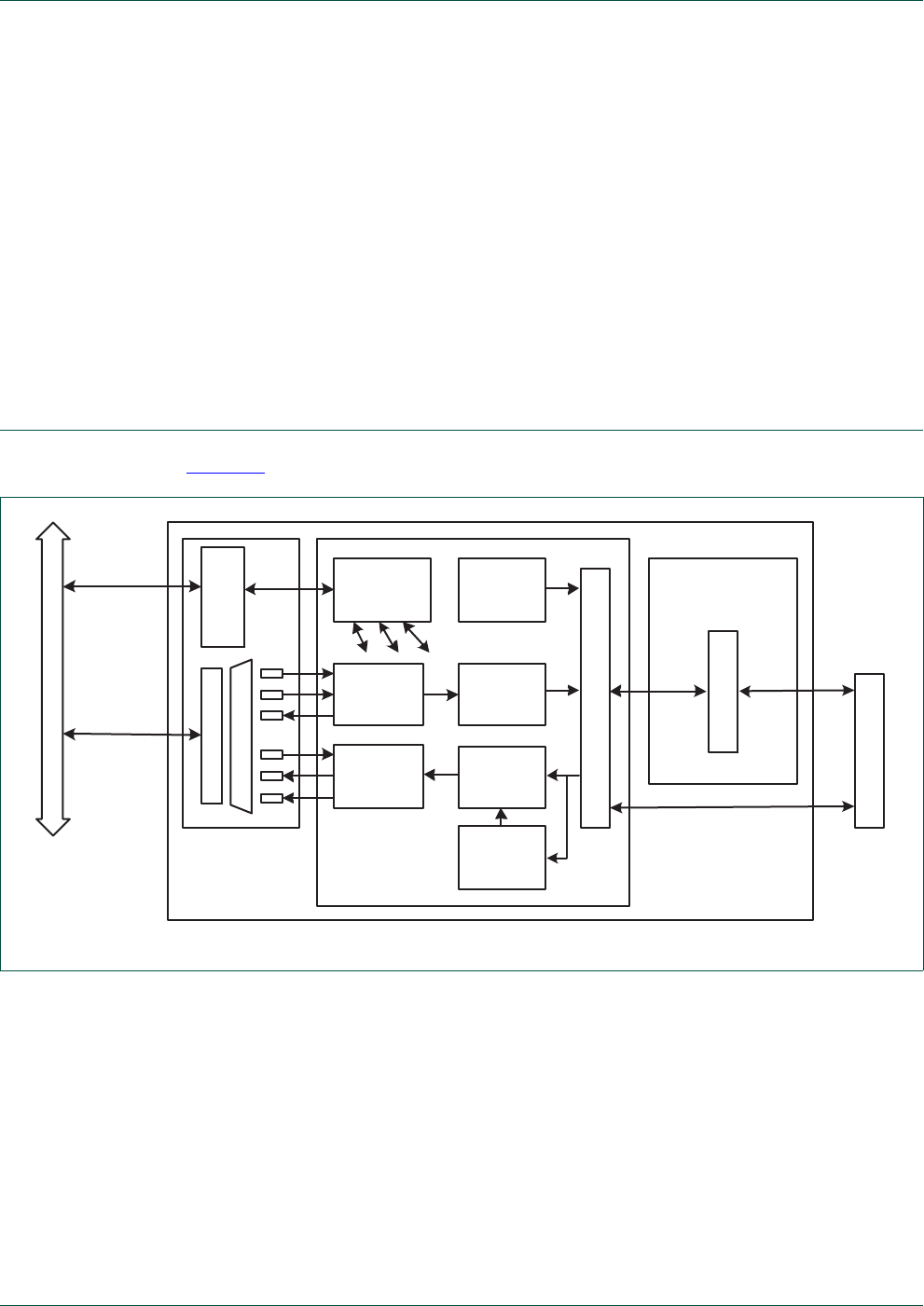
UM10360 All information provided in this document is subject to legal disclaimers. © NXP B.V. 2014. All rights reserved.
User manual Rev. 3.1 — 2 April 2014 152 of 849
NXP Semiconductors UM10360
Chapter 10: LPC176x/5x Ethernet
–Over-length frame support for both transmit and receive allows any length frames.
–Promiscuous receive mode.
–Automatic collision backoff and frame retransmission.
–Includes power management by clock switching.
–Wake-on-LAN power management support allows system wake-up: using the
receive filters or a magic frame detection filter.
•Physical interface:
–Attachment of external PHY chip through a standard Reduced MII (RMII) interface.
–PHY register access is available via the Media Independent Interface Management
(MIIM) interface.
10.4 Architecture and operation
Figure 18 shows the internal architecture of the Ethernet block.
The block diagram for the Ethernet block consists of:
•The host registers module containing the registers in the software view and handling
AHB accesses to the Ethernet block. The host registers connect to the transmit and
receive data path as well as the MAC.
•The DMA to AHB interface. This provides an AHB master connection that allows the
Ethernet block to access on-chip SRAM for reading of descriptors, writing of status,
and reading and writing data buffers.
•The Ethernet MAC, which interfaces to the off-chip PHY via an RMII interface.
•The transmit data path, including:
Fig 18. Ethernet block diagram
register
interface (AHB
slave)
DMA interface
(AHB master)
BUS INTERFACE
RECEIVE
DMA
TRANSMIT
DMA
RECEIVE
BUFFER
RECEIVE
FILTER
TRANSMIT
RETRY
TRANSMIT
FLOW
CONTROL
ETHERNET MAC
RMII ADAPTER
RMII
MIIM
HOST
REGISTERS
AHB BUS
ETHERNET
BLOCK
ETHERNET PHY
BUS
INTERFACE

UM10360 All information provided in this document is subject to legal disclaimers. © NXP B.V. 2014. All rights reserved.
User manual Rev. 3.1 — 2 April 2014 153 of 849
NXP Semiconductors UM10360
Chapter 10: LPC176x/5x Ethernet
–The transmit DMA manager which reads descriptors and data from memory and
writes status to memory.
–The transmit retry module handling Ethernet retry and abort situations.
–The transmit flow control module which can insert Ethernet pause frames.
•The receive data path, including:
–The receive DMA manager which reads descriptors from memory and writes data
and status to memory.
–The Ethernet MAC which detects frame types by parsing part of the frame header.
–The receive filter which can filter out certain Ethernet frames by applying different
filtering schemes.
–The receive buffer implementing a delay for receive frames to allow the filter to
filter out certain frames before storing them to memory.
10.5 DMA engine functions
The Ethernet block is designed to provide optimized performance via DMA hardware
acceleration. Independent scatter/gather DMA engines connected to the AHB bus off-load
many data transfers from the CPU.
Descriptors, which are stored in memory, contain information about fragments of incoming
or outgoing Ethernet frames. A fragment may be an entire frame or a much smaller
amount of data. Each descriptor contains a pointer to a memory buffer that holds data
associated with a fragment, the size of the fragment buffer, and details of how the
fragment will be transmitted or received.
Descriptors are stored in arrays in memory, which are located by pointer registers in the
Ethernet block. Other registers determine the size of the arrays, point to the next
descriptor in each array that will be used by the DMA engine, and point to the next
descriptor in each array that will be used by the Ethernet device driver.
10.6 Overview of DMA operation
The DMA engine makes use of a Receive descriptor array and a Transmit descriptor array
in memory. All or part of an Ethernet frame may be contained in a memory buffer
associated with a descriptor. When transmitting, the transmit DMA engine uses as many
descriptors as needed (one or more) to obtain (gather) all of the parts of a frame, and
sends them out in sequence. When receiving, the receive DMA engine also uses as many
descriptors as needed (one or more) to find places to store (scatter) all of the data in the
received frame.
The base address registers for the descriptor array, registers indicating the number of
descriptor array entries, and descriptor array input/output pointers are contained in the
Ethernet block. The descriptor entries and all transmit and receive packet data are stored
in memory which is not a part of the Ethernet block. The descriptor entries tell where
related frame data is stored in memory, certain aspects of how the data is handled, and
the result status of each Ethernet transaction.
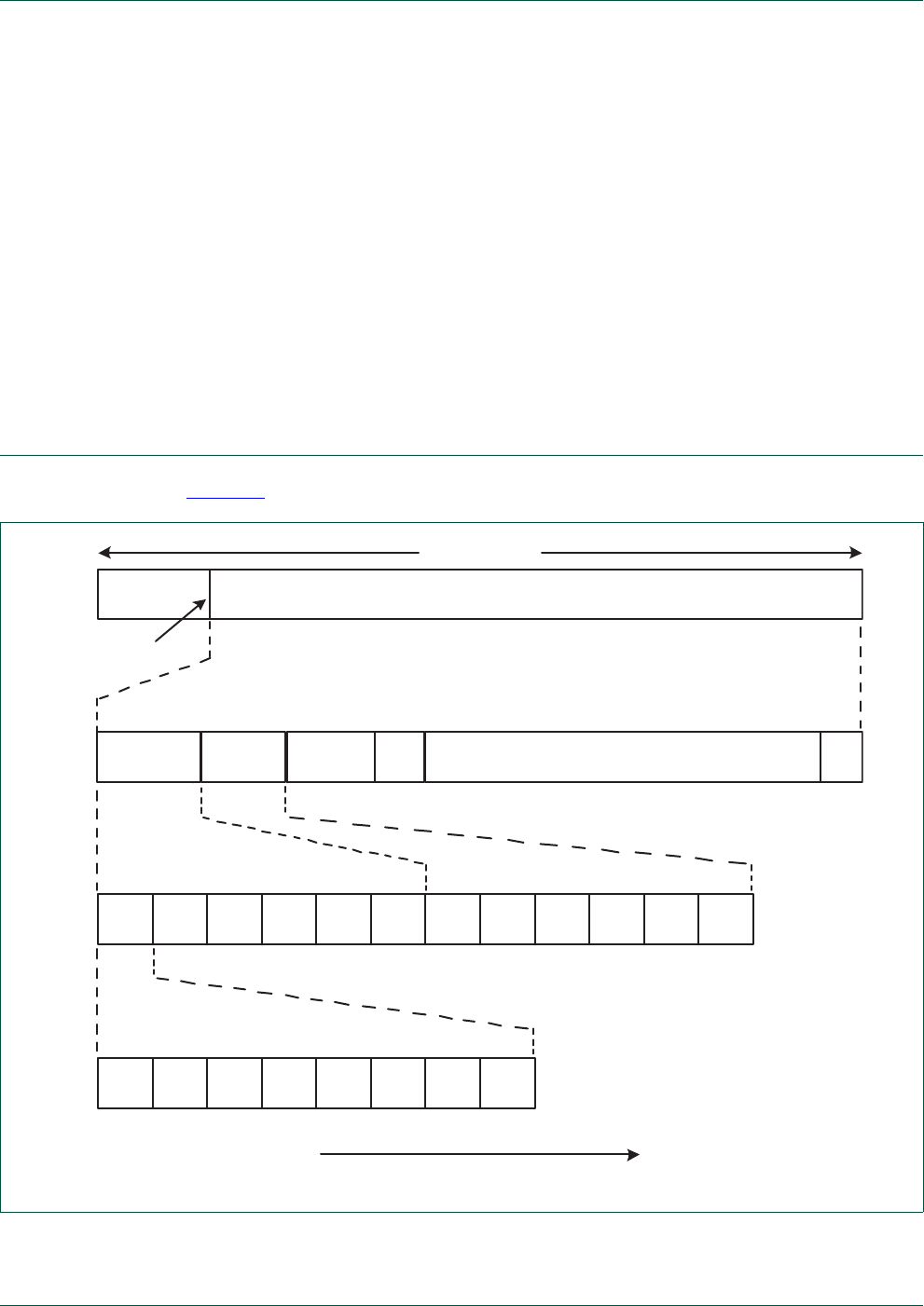
UM10360 All information provided in this document is subject to legal disclaimers. © NXP B.V. 2014. All rights reserved.
User manual Rev. 3.1 — 2 April 2014 154 of 849
NXP Semiconductors UM10360
Chapter 10: LPC176x/5x Ethernet
Hardware in the DMA engine controls how data incoming from the Ethernet MAC is saved
to memory, causes fragment related status to be saved, and advances the hardware
receive pointer for incoming data. Driver software must handle the disposition of received
data, changing of descriptor data addresses (to avoid unnecessary data movement), and
advancing the software receive pointer. The two pointers create a circular queue in the
descriptor array and allow both the DMA hardware and the driver software to know which
descriptors (if any) are available for their use, including whether the descriptor array is
empty or full.
Similarly, driver software must set up pointers to data that will be transmitted by the
Ethernet MAC, giving instructions for each fragment of data, and advancing the software
transmit pointer for outgoing data. Hardware in the DMA engine reads this information and
sends the data to the Ethernet MAC interface when possible, updating the status and
advancing the hardware transmit pointer.
10.7 Ethernet Packet
Figure 19 illustrates the different fields in an Ethernet packet.
A packet consists of a preamble, a start-of-frame delimiter and an Ethernet frame.
Fig 19. Ethernet packet fields
OPTIONAL
VLAN
SOURCE
ADDRESS
DesA
1st
octet
DesA
2nd
octet
DesA
3rd
octet
DesA
4th
octet
DesA
5th
octet
DesA
6th
octet
1st
octet
2nd
octet
3rd
octet
4th
octet
5th
octet
6th
octet
SrcA SrcA SrcA SrcA SrcA SrcA
LSB
bit 0 bit 1 bit 2 bit 3 bit 4 bit 5 bit 6
MSB
bit 7
DESTINATION
ADDRESS PAYLOAD FCS
ETHERNET FRAME
PREAMBLE
7 bytes
ethernet packet
start-of-frame
delimiter
1 byte
time
LEN
TYPE

UM10360 All information provided in this document is subject to legal disclaimers. © NXP B.V. 2014. All rights reserved.
User manual Rev. 3.1 — 2 April 2014 155 of 849
NXP Semiconductors UM10360
Chapter 10: LPC176x/5x Ethernet
The Ethernet frame consists of the destination address, the source address, an optional
VLAN field, the length/type field, the payload and the frame check sequence.
Each address consists of 6 bytes where each byte consists of 8 bits. Bits are transferred
starting with the least significant bit.
10.8 Overview
10.8.1 Partitioning
The Ethernet block and associated device driver software offer the functionality of the
Media Access Control (MAC) sublayer of the data link layer in the OSI reference model
(see IEEE std 802.3). The MAC sublayer offers the service of transmitting and receiving
frames to the next higher protocol level, the MAC client layer, typically the Logical Link
Control sublayer. The device driver software implements the interface to the MAC client
layer. It sets up registers in the Ethernet block, maintains descriptor arrays pointing to
frames in memory and receives results back from the Ethernet block through interrupts.
When a frame is transmitted, the software partially sets up the Ethernet frames by
providing pointers to the destination address field, source address field, the length/type
field, the MAC client data field and optionally the CRC in the frame check sequence field.
Preferably concatenation of frame fields should be done by using the scatter/gather
functionality of the Ethernet core to avoid unnecessary copying of data. The hardware
adds the preamble and start frame delimiter fields and can optionally add the CRC, if
requested by software. When a packet is received the hardware strips the preamble and
start frame delimiter and passes the rest of the packet - the Ethernet frame - to the device
driver, including destination address, source address, length/type field, MAC client data
and frame check sequence (FCS).
Apart from the MAC, the Ethernet block contains receive and transmit DMA managers that
control receive and transmit data streams between the MAC and the AHB interface.
Frames are passed via descriptor arrays located in host memory, so that the hardware
can process many frames without software/CPU support. Frames can consist of multiple
fragments that are accessed with scatter/gather DMA. The DMA managers optimize
memory bandwidth using prefetching and buffering.
A receive filter block is used to identify received frames that are not addressed to this
Ethernet station, so that they can be discarded. The Rx filters include a perfect address
filter and a hash filter.
Wake-on-LAN power management support makes it possible to wake the system up from
a power-down state -a state in which some of the clocks are switched off -when wake-up
frames are received over the LAN. Wake-up frames are recognized by the receive filtering
modules or by a Magic Frame detection technology. System wake-up occurs by triggering
an interrupt.
An interrupt logic block raises and masks interrupts and keeps track of the cause of
interrupts. The interrupt block sends an interrupt request signal to the host system.
Interrupts can be enabled, cleared and set by software.

UM10360 All information provided in this document is subject to legal disclaimers. © NXP B.V. 2014. All rights reserved.
User manual Rev. 3.1 — 2 April 2014 156 of 849
NXP Semiconductors UM10360
Chapter 10: LPC176x/5x Ethernet
Support for IEEE 802.3/clause 31 flow control is implemented in the flow control block.
Receive flow control frames are automatically handled by the MAC. Transmit flow control
frames can be initiated by software. In half duplex mode, the flow control module will
generate back pressure by sending out continuous preamble only, interrupted by pauses
to prevent the jabber limit from being exceeded.
The Ethernet block has a standard Reduced Media Independent Interface (RMII) to
connect to an external Ethernet PHY chip. Registers in the PHY chip are accessed via the
AHB interface through the serial management connection of the MIIM bus, typically
operating at 2.5 MHz.
10.8.2 Example PHY Devices
Some examples of compatible PHY devices are shown in Ta b l e 1 26 .
10.9 Pin description
Tab l e 1 27 shows the signals used for connecting the Reduced Media Independent
Interface (RMII) to the external PHY.
Tab l e 1 28 shows the signals used for Media Independent Interface Management (MIIM) of
the external PHY.
Table 126. Example PHY Devices
Manufacturer Part Number(s)
Broadcom BCM5221
ICS ICS1893
Intel LXT971A
LSI Logic L80223, L80225, L80227
Micrel KS8721
National DP83847, DP83846, DP83843
SMSC LAN83C185
Table 127. Ethernet RMII pin descriptions
Pin Name Type Pin Description
ENET_TX_EN Output Transmit data enable
ENET_TXD[1:0] Output Transmit data, 2 bits
ENET_RXD[1:0] Input Receive data, 2 bits.
ENET_RX_ER Input Receive error.
ENET_CRS Input Carrier sense/data valid.
ENET_REF_CLK/
ENET_RX_CLK
Input Reference clock
Table 128. Ethernet MIIM pin descriptions
Pin Name Type Pin Description
ENET_MDC Output MIIM clock.
ENET_MDIO Input/Output MI data input and output

UM10360 All information provided in this document is subject to legal disclaimers. © NXP B.V. 2014. All rights reserved.
User manual Rev. 3.1 — 2 April 2014 157 of 849
NXP Semiconductors UM10360
Chapter 10: LPC176x/5x Ethernet
10.10 Registers and software interface
The software interface of the Ethernet block consists of a register view and the format
definitions for the transmit and receive descriptors. These two aspects are addressed in
the next two subsections.
10.10.1 Register map
Tab l e 1 29 lists the registers, register addresses and other basic information. The total
AHB address space required is 4 kilobytes.
After a hard reset or a soft reset via the RegReset bit of the Command register all bits in
all registers are reset to 0 unless stated otherwise in the following register descriptions.
Some registers will have unused bits which will return a 0 on a read via the AHB interface.
Writing to unused register bits of an otherwise writable register will not have side effects.
The register map consists of registers in the Ethernet MAC and registers around the core
for controlling DMA transfers, flow control and filtering.
Reading from reserved addresses or reserved bits leads to unpredictable data. Writing to
reserved addresses or reserved bits has no effect.
Reading of write-only registers will return a read error on the AHB interface. Writing of
read-only registers will return a write error on the AHB interface.
Table 129. Ethernet register definitions
Name Description Access Reset Value Address
MAC registers
MAC1 MAC configuration register 1. R/W 0x8000 0x5000 0000
MAC2 MAC configuration register 2. R/W 0 0x5000 0004
IPGT Back-to-Back Inter-Packet-Gap register. R/W 0 0x5000 0008
IPGR Non Back-to-Back Inter-Packet-Gap register. R/W 0 0x5000 000C
CLRT Collision window / Retry register. R/W 0x370F 0x5000 0010
MAXF Maximum Frame register. R/W 0x0600 0x5000 0014
SUPP PHY Support register. R/W 0 0x5000 0018
TEST Tes t r egi s t e r. R/W 0 0x5000 001C
MCFG MII Mgmt Configuration register. R/W 0 0x5000 0020
MCMD MII Mgmt Command register. R/W 0 0x5000 0024
MADR MII Mgmt Address register. R/W 0 0x5000 0028
MWTD MII Mgmt Write Data register. WO 0 0x5000 002C
MRDD MII Mgmt Read Data register. RO 0 0x5000 0030
MIND MII Mgmt Indicators register. RO 0 0x5000 0034
SA0 Station Address 0 register. R/W 0 0x5000 0040
SA1 Station Address 1 register. R/W 0 0x5000 0044
SA2 Station Address 2 register. R/W 0 0x5000 0048
Control registers
Command Command register. R/W 0 0x5000 0100

UM10360 All information provided in this document is subject to legal disclaimers. © NXP B.V. 2014. All rights reserved.
User manual Rev. 3.1 — 2 April 2014 158 of 849
NXP Semiconductors UM10360
Chapter 10: LPC176x/5x Ethernet
The third column in the table lists the accessibility of the register: read-only, write-only,
read/write.
All AHB register write transactions except for accesses to the interrupt registers are
posted i.e. the AHB transaction will complete before write data is actually committed to the
register. Accesses to the interrupt registers will only be completed by accepting the write
data when the data has been committed to the register.
Status Status register. RO 0 0x5000 0104
RxDescriptor Receive descriptor base address register. R/W 0 0x5000 0108
RxStatus Receive status base address register. R/W 0 0x5000 010C
RxDescriptorNumber Receive number of descriptors register. R/W 0 0x5000 0110
RxProduceIndex Receive produce index register. RO 0 0x5000 0114
RxConsumeIndex Receive consume index register. R/W 0 0x5000 0118
TxDescriptor Transmit descriptor base address register. R/W 0 0x5000 011C
TxStatus Transmit status base address register. R/W 0 0x5000 0120
TxDescriptorNumber Transmit number of descriptors register. R/W 0 0x5000 0124
TxProduceIndex Transmit produce index register. R/W 0 0x5000 0128
TxConsumeIndex Transmit consume index register. RO 0 0x5000 012C
TSV0 Transmit status vector 0 register. RO 0 0x5000 0158
TSV1 Transmit status vector 1 register. RO 0 0x5000 015C
RSV Receive status vector register. RO 0 0x5000 0160
FlowControlCounter Flow control counter register. R/W 0 0x5000 0170
FlowControlStatus Flow control status register. RO 0 0x5000 0174
Rx filter registers
RxFliterCtrl Receive filter control register. 00x5000 0200
RxFilterWoLStatus Receive filter WoL status register. 00x5000 0204
RxFilterWoLClear Receive filter WoL clear register. 00x5000 0208
HashFilterL Hash filter table LSBs register. 00x5000 0210
HashFilterH Hash filter table MSBs register. 00x5000 0214
Module control registers
IntStatus Interrupt status register. RO 0 0x5000 0FE0
IntEnable Interrupt enable register. R/W 0 0x5000 0FE4
IntClear Interrupt clear register. WO 0 0x5000 0FE8
IntSet Interrupt set register. WO 0 0x5000 0FEC
PowerDown Power-down register. R/W 0 0x5000 0FF4
Table 129. Ethernet register definitions …continued
Name Description Access Reset Value Address

UM10360 All information provided in this document is subject to legal disclaimers. © NXP B.V. 2014. All rights reserved.
User manual Rev. 3.1 — 2 April 2014 159 of 849
NXP Semiconductors UM10360
Chapter 10: LPC176x/5x Ethernet
10.11 Ethernet MAC register definitions
This section defines the bits in the individual registers of the Ethernet block register map.
10.11.1 MAC Configuration Register 1 (MAC1 - 0x5000 0000)
The MAC configuration register 1 (MAC1) has an address of 0x5000 0000. Its bit
definition is shown in Table 130.
10.11.2 MAC Configuration Register 2 (MAC2 - 0x5000 0004)
The MAC configuration register 2 (MAC2) has an address of 0x5000 0004. Its bit
definition is shown in Table 131.
Table 130. MAC Configuration register 1 (MAC1 - address 0x5000 0000) bit description
Bit Symbol Function Reset
value
0RECEIVE ENABLESet this to allow receive frames to be received. Internally the MAC synchronizes
this control bit to the incoming receive stream.
0
1PASS ALL RECEIVE
FRAMES
When enabled (set to ’1’), the MAC will pass all frames regardless of type (normal
vs. Control). When disabled, the MAC does not pass valid Control frames.
0
2RX FLOW CONTROLWhen enabled (set to ’1’), the MAC acts upon received PAUSE Flow Control
frames. When disabled, received PAUSE Flow Control frames are ignored.
0
3TX FLOW CONTROLWhen enabled (set to ’1’), PAUSE Flow Control frames are allowed to be
transmitted. When disabled, Flow Control frames are blocked.
0
4LOOPBACK Setting this bit will cause the MAC Transmit interface to be looped back to the MAC
Receive interface. Clearing this bit results in normal operation.
0
7:5 - Unused 0x0
8RESET TX Setting this bit will put the Transmit Function logic in reset. 0
9RESET MCS / TXSetting this bit resets the MAC Control Sublayer / Transmit logic. The MCS logic
implements flow control.
0
10 RESET RX Setting this bit will put the Ethernet receive logic in reset. 0
11 RESET MCS / RX Setting this bit resets the MAC Control Sublayer / Receive logic. The MCS logic
implements flow control.
0x0
13:12 - Reserved. User software should not write ones to reserved bits. The value read
from a reserved bit is not defined.
0x0
14 SIMULATION RESET Setting this bit will cause a reset to the random number generator within the
Transmit Function.
0
15 SOFT RESET Setting this bit will put all modules within the MAC in reset except the Host
Interface.
1
31:16 - Reserved. User software should not write ones to reserved bits. The value read
from a reserved bit is not defined.
0x0
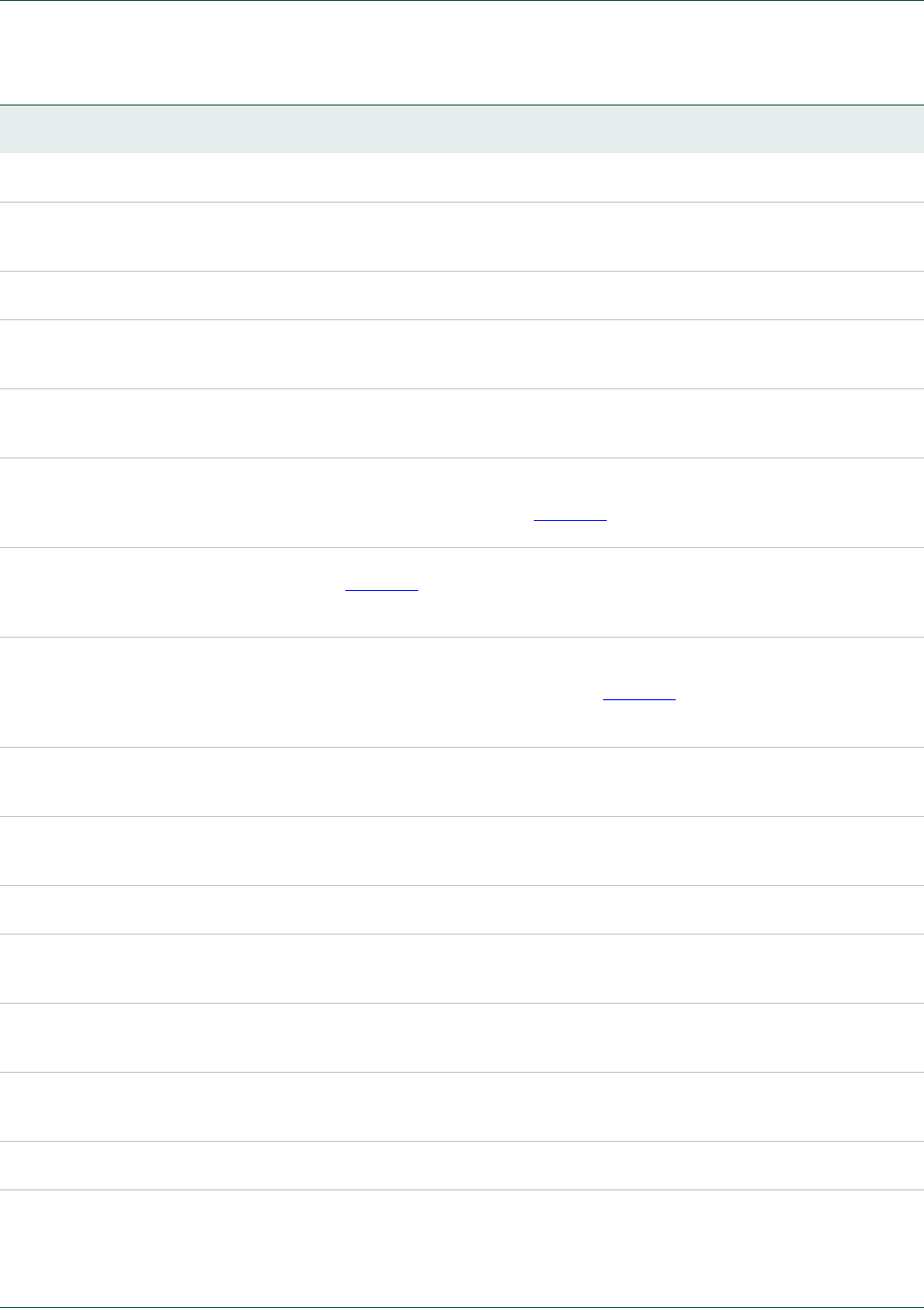
UM10360 All information provided in this document is subject to legal disclaimers. © NXP B.V. 2014. All rights reserved.
User manual Rev. 3.1 — 2 April 2014 160 of 849
NXP Semiconductors UM10360
Chapter 10: LPC176x/5x Ethernet
Table 131. MAC Configuration register 2 (MAC2 - address 0x5000 0004) bit description
Bit Symbol Function Reset
value
0FULL-DUPLEX When enabled (set to ’1’), the MAC operates in Full-Duplex mode. When disabled,
the MAC operates in Half-Duplex mode.
0
1FRAME LENGTH
CHECKING
When enabled (set to ’1’), both transmit and receive frame lengths are compared to
the Length/Type field. If the Length/Type field represents a length then the check is
performed. Mismatches are reported in the StatusInfo word for each received frame.
0
2HUGE FRAME
ENABLE
When enabled (set to ’1’), frames of any length are transmitted and received. 0
3DELAYED CRC This bit determines the number of bytes, if any, of proprietary header information
that exist on the front of IEEE 802.3 frames. When 1, four bytes of header (ignored
by the CRC function) are added. When 0, there is no proprietary header.
0
4CRC ENABLE Set this bit to append a CRC to every frame whether padding was required or not.
Must be set if PAD/CRC ENABLE is set. Clear this bit if frames presented to the
MAC contain a CRC.
0
5PAD / CRC ENABLESet this bit to have the MAC pad all short frames. Clear this bit if frames presented
to the MAC have a valid length. This bit is used in conjunction with AUTO PAD
ENABLE and VLAN PAD ENABLE. See Tab le 13 3 - Pad Operation for details on the
pad function.
0
6VLAN PAD ENABLESet this bit to cause the MAC to pad all short frames to 64 bytes and append a valid
CRC. Consult Tab l e 1 3 3 - Pad Operation for more information on the various
padding features.
Note: This bit is ignored if PAD / CRC ENABLE is cleared.
0
7AUTO DETECT PAD
ENABLE
Set this bit to cause the MAC to automatically detect the type of frame, either tagged
or un-tagged, by comparing the two octets following the source address with
0x8100 (VLAN Protocol ID) and pad accordingly. Ta b le 13 3 - Pad Operation
provides a description of the pad function based on the configuration of this register.
Note: This bit is ignored if PAD / CRC ENABLE is cleared.
0
8PURE PREAMBLE
ENFORCEMENT
When enabled (set to ’1’), the MAC will verify the content of the preamble to ensure
it contains 0x55 and is error-free. A packet with an incorrect preamble is discarded.
When disabled, no preamble checking is performed.
0
9LONG PREAMBLE
ENFORCEMENT
When enabled (set to ’1’), the MAC only allows receive packets which contain
preamble fields less than 12 bytes in length. When disabled, the MAC allows any
length preamble as per the Standard.
0
11:10 - Reserved. User software should not write ones to reserved bits. The value read
from a reserved bit is not defined.
0x0
12 NO BACKOFF When enabled (set to ’1’), the MAC will immediately retransmit following a collision
rather than using the Binary Exponential Backoff algorithm as specified in the
Standard.
0
13 BACK PRESSURE /
NO BACKOFF
When enabled (set to ’1’), after the MAC incidentally causes a collision during back
pressure, it will immediately retransmit without backoff, reducing the chance of
further collisions and ensuring transmit packets get sent.
0
14 EXCESS DEFER When enabled (set to ’1’) the MAC will defer to carrier indefinitely as per the
Standard. When disabled, the MAC will abort when the excessive deferral limit is
reached.
0
31:15 - Reserved. User software should not write ones to reserved bits. The value read
from a reserved bit is not defined.
0x0

UM10360 All information provided in this document is subject to legal disclaimers. © NXP B.V. 2014. All rights reserved.
User manual Rev. 3.1 — 2 April 2014 161 of 849
NXP Semiconductors UM10360
Chapter 10: LPC176x/5x Ethernet
10.11.3 Back-to-Back Inter-Packet-Gap Register (IPGT - 0x5000 0008)
The Back-to-Back Inter-Packet-Gap register (IPGT) has an address of 0x5000 0008. Its
bit definition is shown in Ta b l e 1 3 3.
10.11.4 Non Back-to-Back Inter-Packet-Gap Register (IPGR - 0x5000 000C)
The Non Back-to-Back Inter-Packet-Gap register (IPGR) has an address of 0x5000 000C.
Its bit definition is shown in Tab l e 134 .
Table 132. Pad operation
Type Auto detect
pad enable
MAC2 [7]
VLAN pad
enable
MAC2 [6]
Pad/CRC
enable
MAC2 [5]
Action
Any x x 0 No pad or CRC check
Any 0 0 1 Pad to 60 bytes, append CRC
Any x 1 1 Pad to 64 bytes, append CRC
Any 1 0 1 If untagged, pad to 60 bytes and append CRC. If VLAN tagged: pad to
64 bytes and append CRC.
Table 133. Back-to-back Inter-packet-gap register (IPGT - address 0x5000 0008) bit description
Bit Symbol Function Reset
value
6:0 BACK-TO-BACK
INTER-PACKET-GAP
This is a programmable field representing the nibble time offset of the minimum
possible period between the end of any transmitted packet to the beginning of the
next. In Full-Duplex mode, the register value should be the desired period in
nibble times minus 3. In Half-Duplex mode, the register value should be the
desired period in nibble times minus 6. In Full-Duplex the recommended setting is
0x15 (21d), which represents the minimum IPG of 960 ns (in 100 Mbps mode) or
9.6 µs (in 10 Mbps mode). In Half-Duplex the recommended setting is 0x12 (18d),
which also represents the minimum IPG of 960 ns (in 100 Mbps mode) or 9.6 µs
(in 10 Mbps mode).
0x0
31:7 - Reserved. User software should not write ones to reserved bits. The value read
from a reserved bit is not defined.
0x0
Table 134. Non Back-to-back Inter-packet-gap register (IPGR - address 0x5000 000C) bit description
Bit Symbol Function Reset
value
6:0 NON-BACK-TO-BACK
INTER-PACKET-GAP PART2
This is a programmable field representing the Non-Back-to-Back
Inter-Packet-Gap. The recommended value is 0x12 (18d), which
represents the minimum IPG of 960 ns (in 100 Mbps mode) or 9.6 µs (in
10 Mbps mode).
0x0
7- Reserved. User software should not write ones to reserved bits. The value
read from a reserved bit is not defined.
0x0
14:8 NON-BACK-TO-BACK
INTER-PACKET-GAP PART1
This is a programmable field representing the optional carrierSense
window referenced in IEEE 802.3/4.2.3.2.1 'Carrier Deference'. If carrier is
detected during the timing of IPGR1, the MAC defers to carrier. If,
however, carrier becomes active after IPGR1, the MAC continues timing
IPGR2 and transmits, knowingly causing a collision, thus ensuring fair
access to medium. Its range of values is 0x0 to IPGR2. The recommended
value is 0xC (12d)
0x0
31:15 - Reserved. User software should not write ones to reserved bits. The value
read from a reserved bit is not defined.
0x0

UM10360 All information provided in this document is subject to legal disclaimers. © NXP B.V. 2014. All rights reserved.
User manual Rev. 3.1 — 2 April 2014 162 of 849
NXP Semiconductors UM10360
Chapter 10: LPC176x/5x Ethernet
10.11.5 Collision Window / Retry Register (CLRT - 0x5000 0010)
The Collision window / Retry register (CLRT) has an address of 0x5000 0010. Its bit
definition is shown in Table 135.
10.11.6 Maximum Frame Register (MAXF - 0x5000 0014)
The Maximum Frame register (MAXF) has an address of 0x5000 0014. Its bit definition is
shown in Ta b l e 13 6 .
10.11.7 PHY Support Register (SUPP - 0x5000 0018)
The PHY Support register (SUPP) has an address of 0x5000 0018. The SUPP register
provides additional control over the RMII interface. The bit definition of this register is
shown in Ta b l e 13 7 .
Unused bits in the PHY support register should be left as zeroes.
10.11.8 Test Register (TEST - 0x5000 001C)
The Test register (TEST) has an address of 0x5000 001C. The bit definition of this register
is shown in Tab le 13 8 . These bits are used for testing purposes only.
Table 135. Collision Window / Retry register (CLRT - address 0x5000 0010) bit description
Bit Symbol Function Reset
value
3:0 RETRANSMISSION
MAXIMUM
This is a programmable field specifying the number of retransmission attempts
following a collision before aborting the packet due to excessive collisions. The
Standard specifies the attemptLimit to be 0xF (15d). See IEEE 802.3/4.2.3.2.5.
0xF
7:4 - Reserved. User software should not write ones to reserved bits. The value read from
a reserved bit is not defined.
0x0
13:8 COLLISION
WINDOW
This is a programmable field representing the slot time or collision window during
which collisions occur in properly configured networks. The default value of 0x37
(55d) represents a 56 byte window following the preamble and SFD.
0x37
31:14 - Reserved, user software should not write ones to reserved bits. The value read from
a reserved bit is not defined.
NA
Table 136. Maximum Frame register (MAXF - address 0x5000 0014) bit description
Bit Symbol Function Reset
value
15:0 MAXIMUM FRAME
LENGTH
This field resets to the value 0x0600, which represents a maximum receive frame of
1536 octets. An untagged maximum size Ethernet frame is 1518 octets. A tagged
frame adds four octets for a total of 1522 octets. If a shorter maximum length
restriction is desired, program this 16-bit field.
0x0600
31:16 - Unused 0x0
Table 137. PHY Support register (SUPP - address 0x5000 0018) bit description
Bit Symbol Function Reset
value
7:0 - Unused 0x0
8SPEED This bit configures the Reduced MII logic for the current operating speed. When set,
100 Mbps mode is selected. When cleared, 10 Mbps mode is selected.
0
31:9 - Unused 0x0
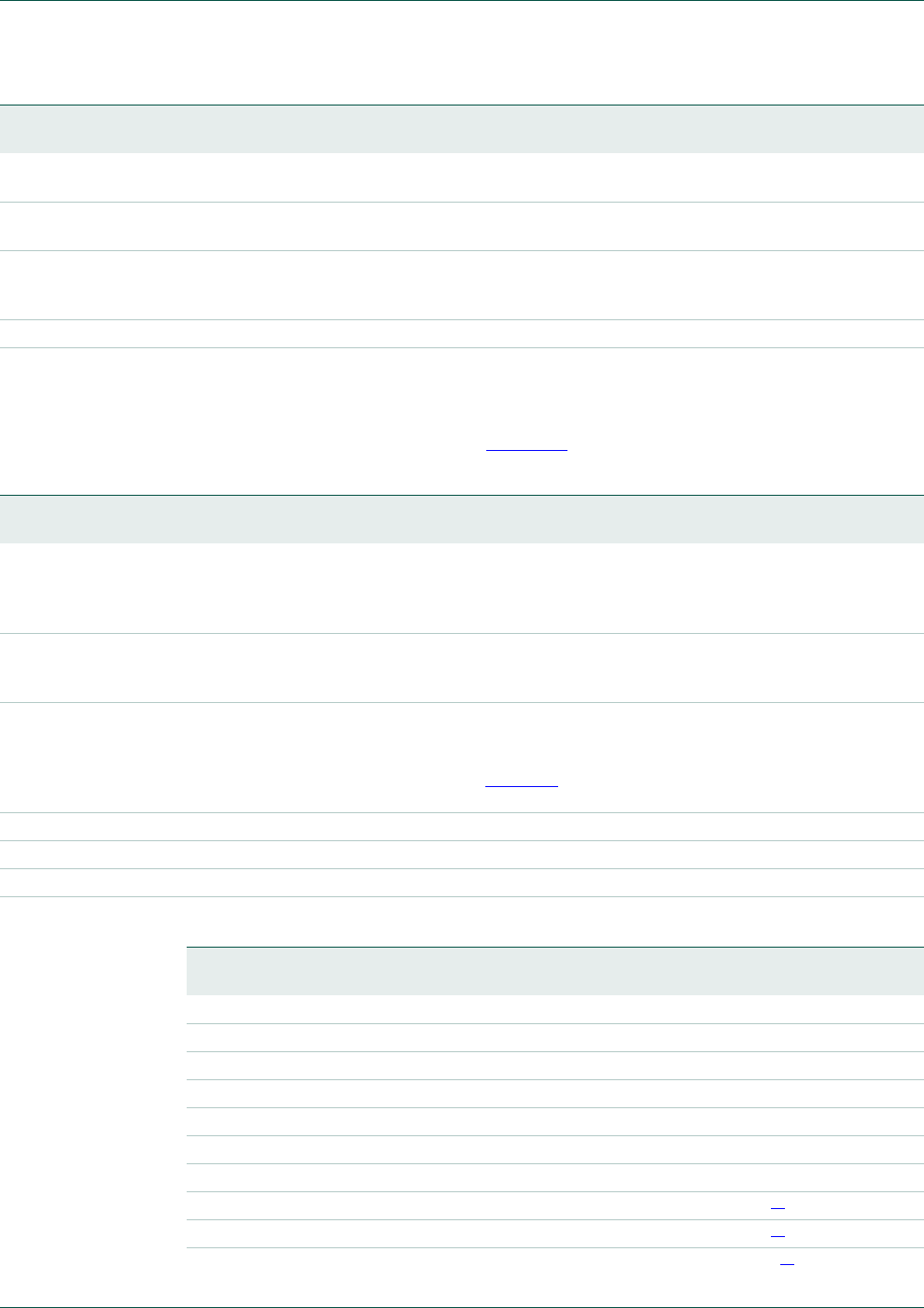
UM10360 All information provided in this document is subject to legal disclaimers. © NXP B.V. 2014. All rights reserved.
User manual Rev. 3.1 — 2 April 2014 163 of 849
NXP Semiconductors UM10360
Chapter 10: LPC176x/5x Ethernet
10.11.9 MII Mgmt Configuration Register (MCFG - 0x5000 0020)
The MII Mgmt Configuration register (MCFG) has an address of 0x5000 0020. The bit
definition of this register is shown in Table 139 .
Table 138. Test register (TEST - address 0x5000 ) bit description
Bit Symbol Function Reset
value
0SHORTCUT PAUSE
QUANTA
This bit reduces the effective PAUSE quanta from 64 byte-times to 1 byte-time. 0
1TEST PAUSE This bit causes the MAC Control sublayer to inhibit transmissions, just as if a
PAUSE Receive Control frame with a nonzero pause time parameter was received.
0
2TEST
BACKPRESSURE
Setting this bit will cause the MAC to assert backpressure on the link. Backpressure
causes preamble to be transmitted, raising carrier sense. A transmit packet from the
system will be sent during backpressure.
0
31:3 - Unused 0x0
Table 139. MII Mgmt Configuration register (MCFG - address 0x5000 0020) bit description
Bit Symbol Function Reset
value
0SCAN INCREMENTSet this bit to cause the MII Management hardware to perform read cycles across a
range of PHYs. When set, the MII Management hardware will perform read cycles
from address 1 through the value set in PHY ADDRESS[4:0]. Clear this bit to allow
continuous reads of the same PHY.
0
1SUPPRESS
PREAMBLE
Set this bit to cause the MII Management hardware to perform read/write cycles
without the 32-bit preamble field. Clear this bit to cause normal cycles to be
performed. Some PHYs support suppressed preamble.
0
5:2 CLOCK SELECT This field is used by the clock divide logic in creating the MII Management Clock
(MDC) which IEEE 802.3u defines to be no faster than 2.5 MHz. Some PHYs
support clock rates up to 12.5 MHz, however. The AHB bus clock (HCLK) is divided
by the specified amount. Refer to Ta b l e 140 below for the definition of values for this
field.
0
14:6 - Unused 0x0
15 RESET MII MGMT This bit resets the MII Management hardware. 0
31:16 - Unused 0x0
Table 140. Clock select encoding
Clock Select Bit 5 Bit 4 Bit 3 Bit 2 Maximum AHB
clock supported
Host Clock divided by 4 0 0 0 x 10
Host Clock divided by 6 0 0 1 0 15
Host Clock divided by 8 0 0 1 1 20
Host Clock divided by 10 0 1 0 0 25
Host Clock divided by 14 0 1 0 1 35
Host Clock divided by 20 0 1 1 0 50
Host Clock divided by 28 0 1 1 1 70
Host Clock divided by 36 1 0 0 0 80[1]
Host Clock divided by 40 1 0 0 1 90[1]
Host Clock divided by 44 1 0 1 0 100[1]

UM10360 All information provided in this document is subject to legal disclaimers. © NXP B.V. 2014. All rights reserved.
User manual Rev. 3.1 — 2 April 2014 164 of 849
NXP Semiconductors UM10360
Chapter 10: LPC176x/5x Ethernet
[1] The maximum AHB clock rate allowed is limited to the maximum CPU clock rate for the device.
10.11.10 MII Mgmt Command Register (MCMD - 0x5000 0024)
The MII Mgmt Command register (MCMD) has an address of 0x5000 0024. The bit
definition of this register is shown in Table 141 .
10.11.11 MII Mgmt Address Register (MADR - 0x5000 0028)
The MII Mgmt Address register (MADR) has an address of 0x5000 0028. The bit definition
of this register is shown in Ta b le 1 4 2 .
10.11.12 MII Mgmt Write Data Register (MWTD - 0x5000 002C)
The MII Mgmt Write Data register (MWTD) is a write-only register with an address of
0x5000 002C. The bit definition of this register is shown in Tab l e 1 4 3 .
Host Clock divided by 48 1 0 1 1 120[1]
Host Clock divided by 52 1 1 0 0 130[1]
Host Clock divided by 56 1 1 0 1 140[1]
Host Clock divided by 60 1 1 1 0 150[1]
Host Clock divided by 64 1 1 1 1 160[1]
Table 140. Clock select encoding
Clock Select Bit 5 Bit 4 Bit 3 Bit 2 Maximum AHB
clock supported
Table 141. MII Mgmt Command register (MCMD - address 0x5000 0024) bit description
Bit Symbol Function Reset
value
0READThis bit causes the MII Management hardware to perform a single Read cycle. The Read data is
returned in Register MRDD (MII Mgmt Read Data).
0
1SCANThis bit causes the MII Management hardware to perform Read cycles continuously. This is
useful for monitoring Link Fail for example.
0
31:2 - Unused 0x0
Table 142. MII Mgmt Address register (MADR - address 0x5000 0028) bit description
Bit Symbol Function Reset
value
4:0 REGISTER
ADDRESS
This field represents the 5-bit Register Address field of Mgmt
cycles. Up to 32 registers can be accessed.
0x0
7:5 - Unused 0x0
12:8 PHY ADDRESS This field represents the 5-bit PHY Address field of Mgmt
cycles. Up to 31 PHYs can be addressed (0 is reserved).
0x0
31:13 - Unused 0x0

UM10360 All information provided in this document is subject to legal disclaimers. © NXP B.V. 2014. All rights reserved.
User manual Rev. 3.1 — 2 April 2014 165 of 849
NXP Semiconductors UM10360
Chapter 10: LPC176x/5x Ethernet
10.11.13 MII Mgmt Read Data Register (MRDD - 0x5000 0030)
The MII Mgmt Read Data register (MRDD) is a read-only register with an address of
0x5000 0030. The bit definition of this register is shown in Tabl e 1 44.
10.11.14 MII Mgmt Indicators Register (MIND - 0x5000 0034)
The MII Mgmt Indicators register (MIND) is a read-only register with an address of
0x5000 0034. The bit definition of this register is shown in Tabl e 1 45.
Here are two examples to access PHY via the MII Management Controller.
For PHY Write if scan is not used:
1. Write 0 to MCMD
2. Write PHY address and register address to MADR
3. Write data to MWTD
4. Wait for busy bit to be cleared in MIND
For PHY Read if scan is not used:
1. Write 1 to MCMD
2. Write PHY address and register address to MADR
Table 143. MII Mgmt Write Data register (MWTD - address 0x5000 002C) bit description
Bit Symbol Function Reset
value
15:0 WRITE
DATA
When written, an MII Mgmt write cycle is performed using the 16-bit
data and the pre-configured PHY and Register addresses from the
MII Mgmt Address register (MADR).
0x0
31:16 - Unused 0x0
Table 144. MII Mgmt Read Data register (MRDD - address 0x5000 0030) bit description
Bit Symbol Function Reset
value
15:0 READ
DATA
Following an MII Mgmt Read Cycle, the 16-bit data can be read from
this location.
0x0
31:16 - Unused 0x0
Table 145. MII Mgmt Indicators register (MIND - address 0x5000 0034) bit description
Bit Symbol Function Reset
value
0BUSY When ’1’ is returned - indicates MII Mgmt is currently performing an
MII Mgmt Read or Write cycle.
0
1SCANNINGWhen ’1’ is returned - indicates a scan operation (continuous MII
Mgmt Read cycles) is in progress.
0
2NOT VALIDWhen ’1’ is returned - indicates MII Mgmt Read cycle has not
completed and the Read Data is not yet valid.
0
3MII Link FailWhen ’1’ is returned - indicates that an MII Mgmt link fail has
occurred.
0
31:4 - Unused 0x0

UM10360 All information provided in this document is subject to legal disclaimers. © NXP B.V. 2014. All rights reserved.
User manual Rev. 3.1 — 2 April 2014 166 of 849
NXP Semiconductors UM10360
Chapter 10: LPC176x/5x Ethernet
3. Wait for busy bit to be cleared in MIND
4. Write 0 to MCMD
5. Read data from MRDD
10.11.15 Station Address 0 Register (SA0 - 0x5000 0040)
The Station Address 0 register (SA0) has an address of 0x5000 0040. The bit definition of
this register is shown in Tab l e 14 6 .
The station address is used for perfect address filtering and for sending pause control
frames. For the ordering of the octets in the packet please refer to Figure 19.
10.11.16 Station Address 1 Register (SA1 - 0x5000 0044)
The Station Address 1 register (SA1) has an address of 0x5000 0044. The bit definition of
this register is shown in Tab l e 14 7 .
The station address is used for perfect address filtering and for sending pause control
frames. For the ordering of the octets in the packet please refer to Figure 19.
10.11.17 Station Address 2 Register (SA2 - 0x5000 0048)
The Station Address 2 register (SA2) has an address of 0x5000 0048. The bit definition of
this register is shown in Tab l e 14 8 .
Table 146. Station Address register (SA0 - address 0x5000 0040) bit description
Bit Symbol Function Reset
value
7:0 STATION ADDRESS,
2nd octet
This field holds the second octet of the station address. 0x0
15:8 STATION ADDRESS,
1st octet
This field holds the first octet of the station address. 0x0
31:16 - Unused 0x0
Table 147. Station Address register (SA1 - address 0x5000 0044) bit description
Bit Symbol Function Reset
value
7:0 STATION ADDRESS,
4th octet
This field holds the fourth octet of the station address. 0x0
15:8 STATION ADDRESS,
3rd octet
This field holds the third octet of the station address. 0x0
31:16 - Unused 0x0
Table 148. Station Address register (SA2 - address 0x5000 0048) bit description
Bit Symbol Function Reset
value
7:0 STATION ADDRESS,
6th octet
This field holds the sixth octet of the station address. 0x0
15:8 STATION ADDRESS,
5th octet
This field holds the fifth octet of the station address. 0x0
31:16 - Unused 0x0

UM10360 All information provided in this document is subject to legal disclaimers. © NXP B.V. 2014. All rights reserved.
User manual Rev. 3.1 — 2 April 2014 167 of 849
NXP Semiconductors UM10360
Chapter 10: LPC176x/5x Ethernet
The station address is used for perfect address filtering and for sending pause control
frames. For the ordering of the octets in the packet please refer to Figure 19.
10.12 Control register definitions
10.12.1 Command Register (Command - 0x5000 0100)
The Command register (Command) register has an address of 0x5000 0100. Its bit
definition is shown in Table 149.
All bits can be written and read. The Tx/RxReset bits are write-only, reading will return a 0.
10.12.2 Status Register (Status - 0x5000 0104)
The Status register (Status) is a read-only register with an address of 0x5000 0104. Its bit
definition is shown in Table 150.
The values represent the status of the two channels/data paths. When the status is 1, the
channel is active, meaning:
Table 149. Command register (Command - address 0x5000 0100) bit description
Bit Symbol Function Reset
value
0RxEnable Enable receive. 0
1TxEnable Enable transmit. 0
2- Unused 0x0
3RegReset When a ’1’ is written, all datapaths and the host registers are
reset. The MAC needs to be reset separately.
0
4TxReset When a ’1’ is written, the transmit datapath is reset. 0
5RxReset When a ’1’ is written, the receive datapath is reset. 0
6PassRuntFrameWhen set to ’1’, passes runt frames smaller than 64 bytes to
memory unless they have a CRC error. If ’0’ runt frames are
filtered out.
0
7PassRxFilterWhen set to ’1’, disables receive filtering i.e. all frames
received are written to memory.
0
8TxFlowControlEnable IEEE 802.3 / clause 31 flow control sending pause
frames in full duplex and continuous preamble in half duplex.
0
9RMII When set to “1”, RMII mode is selected. This bit must be set to
one during Ethernet initialization. See Section 10.17.2.
0
10 FullDuplex When set to “1”, indicates full duplex operation. 0
31:11 - Unused 0x0
Table 150. Status register (Status - address 0x5000 0104) bit description
Bit Symbol Function Reset
value
0RxStatusIf 1, the receive channel is active. If 0, the receive channel is inactive.0
1TxStatusIf 1, the transmit channel is active. If 0, the transmit channel is inactive.0
31:2 - Unused 0x0

UM10360 All information provided in this document is subject to legal disclaimers. © NXP B.V. 2014. All rights reserved.
User manual Rev. 3.1 — 2 April 2014 168 of 849
NXP Semiconductors UM10360
Chapter 10: LPC176x/5x Ethernet
•It is enabled and the Rx/TxEnable bit is set in the Command register or it just got
disabled while still transmitting or receiving a frame.
•Also, for the transmit channel, the transmit queue is not empty
i.e. ProduceIndex != ConsumeIndex.
•Also, for the receive channel, the receive queue is not full
i.e. ProduceIndex != ConsumeIndex - 1.
The status transitions from active to inactive if the channel is disabled by a software reset
of the Rx/TxEnable bit in the Command register and the channel has committed the status
and data of the current frame to memory. The status also transitions to inactive if the
transmit queue is empty or if the receive queue is full and status and data have been
committed to memory.
10.12.3 Receive Descriptor Base Address Register (RxDescriptor -
0x5000 0108)
The Receive Descriptor base address register (RxDescriptor) has an address of
0x5000 0108. Its bit definition is shown in Ta b l e 15 1 .
The receive descriptor base address is a byte address aligned to a word boundary i.e.
LSB 1:0 are fixed to “00”. The register contains the lowest address in the array of
descriptors.
10.12.4 Receive Status Base Address Register (RxStatus - 0x5000 010C)
The receive descriptor base address is a byte address aligned to a word boundary i.e.
LSB 1:0 are fixed to “00”. The register contains the lowest address in the array of
descriptors.
The receive status base address is a byte address aligned to a double word boundary i.e.
LSB 2:0 are fixed to “000”.
10.12.5 Receive Number of Descriptors Register (RxDescriptor - 0x5000 0110)
The Receive Number of Descriptors register (RxDescriptorNumber) has an address of
0x5000 0110. Its bit definition is shown in Ta bl e 1 5 3 .
Table 151. Receive Descriptor Base Address register (RxDescriptor - address 0x5000 0108)
bit description
Bit Symbol Function Reset
value
1:0 - Fixed to ’00’ -
31:2 RxDescriptor MSBs of receive descriptor base address. 0x0
Table 152. receive Status Base Address register (RxStatus - address 0x5000 010C) bit
description
Bit Symbol Function Reset
value
2:0 - Fixed to ’000’ -
31:3 RxStatus MSBs of receive status base address. 0x0

UM10360 All information provided in this document is subject to legal disclaimers. © NXP B.V. 2014. All rights reserved.
User manual Rev. 3.1 — 2 April 2014 169 of 849
NXP Semiconductors UM10360
Chapter 10: LPC176x/5x Ethernet
The receive number of descriptors register defines the number of descriptors in the
descriptor array for which RxDescriptor is the base address. The number of descriptors
should match the number of statuses. The register uses minus one encoding i.e. if the
array has 8 elements, the value in the register should be 7.
10.12.6 Receive Produce Index Register (RxProduceIndex - 0x5000 0114)
The Receive Produce Index register (RxProduceIndex) is a read-only register with an
address of 0x5000 0114. Its bit definition is shown in Ta b le 1 5 4 .
The receive produce index register defines the descriptor that is going to be filled next by
the hardware receive process. After a frame has been received, hardware increments the
index. The value is wrapped to 0 once the value of RxDescriptorNumber has been
reached. If the RxProduceIndex equals RxConsumeIndex - 1, the array is full and any
further frames being received will cause a buffer overrun error.
10.12.7 Receive Consume Index Register (RxConsumeIndex - 0x5000 0118)
The Receive consume index register (RxConsumeIndex) has an address of 0x5000 0118.
Its bit definition is shown in Tab l e 155 .
The receive consume register defines the descriptor that is going to be processed next by
the software receive driver. The receive array is empty as long as RxProduceIndex equals
RxConsumeIndex. As soon as the array is not empty, software can process the frame
pointed to by RxConsumeIndex. After a frame has been processed by software, software
should increment the RxConsumeIndex. The value must be wrapped to 0 once the value
Table 153. Receive Number of Descriptors register (RxDescriptor - address 0x5000 0110) bit
description
Bit Symbol Function Reset
value
15:0 RxDescriptorNumber Number of descriptors in the descriptor array for which
RxDescriptor is the base address. The number of
descriptors is minus one encoded.
0x0
31:16 - Unused 0x0
Table 154. Receive Produce Index register (RxProduceIndex - address 0x5000 0114) bit
description
Bit Symbol Function Reset
value
15:0 RxProduceIndex Index of the descriptor that is going to be filled next by the
receive datapath.
0x0
31:16 - Unused 0x0
Table 155. Receive Consume Index register (RxConsumeIndex - address 0x5000 0118) bit
description
Bit Symbol Function Reset
value
15:0 RxConsumeIndex Index of the descriptor that is going to be processed next by
the receive
31:16 - Unused 0x0

UM10360 All information provided in this document is subject to legal disclaimers. © NXP B.V. 2014. All rights reserved.
User manual Rev. 3.1 — 2 April 2014 170 of 849
NXP Semiconductors UM10360
Chapter 10: LPC176x/5x Ethernet
of RxDescriptorNumber has been reached. If the RxProduceIndex equals
RxConsumeIndex - 1, the array is full and any further frames being received will cause a
buffer overrun error.
10.12.8 Transmit Descriptor Base Address Register (TxDescriptor -
0x5000 011C)
The Transmit Descriptor base address register (TxDescriptor) has an address of
0x5000 011C. Its bit definition is shown in Ta b l e 1 5 6.
The transmit descriptor base address is a byte address aligned to a word boundary i.e.
LSB 1:0 are fixed to “00”. The register contains the lowest address in the array of
descriptors.
10.12.9 Transmit Status Base Address Register (TxStatus - 0x5000 0120)
The Transmit Status base address register (TxStatus) has an address of 0x5000 0120. Its
bit definition is shown in Ta b l e 1 5 7.
The transmit status base address is a byte address aligned to a word boundary i.e. LSB
1:0 are fixed to “00”. The register contains the lowest address in the array of statuses.
10.12.10 Transmit Number of Descriptors Register (TxDescriptorNumber -
0x5000 0124)
The Transmit Number of Descriptors register (TxDescriptorNumber) has an address of
0x5000 0124. Its bit definition is shown in Ta b l e 15 8 .
Table 156. Transmit Descriptor Base Address register (TxDescriptor - address 0x5000 011C)
bit description
Bit Symbol Function Reset
value
1:0 - Fixed to ’00’ -
31:2 TxDescriptor MSBs of transmit descriptor base address. 0x0
Table 157. Transmit Status Base Address register (TxStatus - address 0x5000 0120) bit
description
Bit Symbol Function Reset
value
1:0 - Fixed to ’00’ -
31:2 TxStatus MSBs of transmit status base address. 0x0
Table 158. Transmit Number of Descriptors register (TxDescriptorNumber - address
0x5000 0124) bit description
Bit Symbol Function Reset
value
15:0 TxDescriptorNumber Number of descriptors in the descriptor array for which
TxDescriptor is the base address. The register is minus
one encoded.
31:16 - Unused 0x0

UM10360 All information provided in this document is subject to legal disclaimers. © NXP B.V. 2014. All rights reserved.
User manual Rev. 3.1 — 2 April 2014 171 of 849
NXP Semiconductors UM10360
Chapter 10: LPC176x/5x Ethernet
The transmit number of descriptors register defines the number of descriptors in the
descriptor array for which TxDescriptor is the base address. The number of descriptors
should match the number of statuses. The register uses minus one encoding i.e. if the
array has 8 elements, the value in the register should be 7.
10.12.11 Transmit Produce Index Register (TxProduceIndex - 0x5000 0128)
The Transmit Produce Index register (TxProduceIndex) has an address of 0x5000 0128.
Its bit definition is shown in Tab l e 159 .
The transmit produce index register defines the descriptor that is going to be filled next by
the software transmit driver. The transmit descriptor array is empty as long as
TxProduceIndex equals TxConsumeIndex. If the transmit hardware is enabled, it will start
transmitting frames as soon as the descriptor array is not empty. After a frame has been
processed by software, it should increment the TxProduceIndex. The value must be
wrapped to 0 once the value of TxDescriptorNumber has been reached. If the
TxProduceIndex equals TxConsumeIndex - 1 the descriptor array is full and software
should stop producing new descriptors until hardware has transmitted some frames and
updated the TxConsumeIndex.
10.12.12 Transmit Consume Index Register (TxConsumeIndex - 0x5000 012C)
The Transmit Consume Index register (TxConsumeIndex) is a read-only register with an
address of 0x5000 012C. Its bit definition is shown in Ta b le 1 6 0 .
The transmit consume index register defines the descriptor that is going to be transmitted
next by the hardware transmit process. After a frame has been transmitted hardware
increments the index, wrapping the value to 0 once the value of TxDescriptorNumber has
been reached. If the TxConsumeIndex equals TxProduceIndex the descriptor array is
empty and the transmit channel will stop transmitting until software produces new
descriptors.
10.12.13 Transmit Status Vector 0 Register (TSV0 - 0x5000 0158)
The Transmit Status Vector 0 register (TSV0) is a read-only register with an address of
0x5000 0158. The transmit status vector registers store the most recent transmit status
returned by the MAC. Since the status vector consists of more than 4 bytes, status is
Table 159. Transmit Produce Index register (TxProduceIndex - address 0x5000 0128) bit
description
Bit Symbol Function Reset
value
15:0 TxProduceIndex Index of the descriptor that is going to be filled next by the
transmit software driver.
0x0
31:16 - Unused 0x0
Table 160. Transmit Consume Index register (TxConsumeIndex - address 0x5000 012C) bit
description
Bit Symbol Function Reset
value
15:0 TxConsumeIndex Index of the descriptor that is going to be transmitted next by
the transmit datapath.
0x0
31:16 - Unused 0x0

UM10360 All information provided in this document is subject to legal disclaimers. © NXP B.V. 2014. All rights reserved.
User manual Rev. 3.1 — 2 April 2014 172 of 849
NXP Semiconductors UM10360
Chapter 10: LPC176x/5x Ethernet
distributed over two registers TSV0 and TSV1. These registers are provided for debug
purposes, because the communication between driver software and the Ethernet block
takes place primarily through the frame descriptors. The status register contents are valid
as long as the internal status of the MAC is valid and should typically only be read when
the transmit and receive processes are halted.
Tab l e 1 61 lists the bit definitions of the TSV0 register.
[1] The EMAC doesn't distinguish the frame type and frame length, so, e.g. when the IP(0x8000) or
ARP(0x0806) packets are received, it compares the frame type with the max length and gives the "Length
out of range" error. In fact, this bit is not an error indication, but simply a statement by the chip regarding the
status of the received frame.
10.12.14 Transmit Status Vector 1 Register (TSV1 - 0x5000 015C)
The Transmit Status Vector 1 register (TSV1) is a read-only register with an address of
0x5000 015C. The transmit status vector registers store the most recent transmit status
returned by the MAC. Since the status vector consists of more than 4 bytes, status is
distributed over two registers TSV0 and TSV1. These registers are provided for debug
Table 161. Transmit Status Vector 0 register (TSV0 - address 0x5000 0158) bit description
Bit Symbol Function Reset
value
0CRC error The attached CRC in the packet did not match the
internally generated CRC.
0
1Length check errorIndicates the frame length field does not match the actual
number of data items and is not a type field.
0
2Length out of range
[1] Indicates that frame type/length field was larger than
1500 bytes.
0
3Done Transmission of packet was completed. 0
4 Multicast Packet’s destination was a multicast address. 0
5Broadcast Packet’s destination was a broadcast address. 0
6Packet Defer Packet was deferred for at least one attempt, but less than
an excessive defer.
0
7Excessive DeferPacket was deferred in excess of 6071 nibble times in
100 Mbps or 24287 bit times in 10 Mbps mode.
0
8Excessive CollisionPacket was aborted due to exceeding of maximum allowed
number of collisions.
0
9Late Collision Collision occurred beyond collision window, 512bit times.0
10 Giant Byte count in frame was greater than can be represented
in the transmit byte count field in TSV1.
0
11 Underrun Host side caused buffer underrun. 0
27:12 Total bytes The total number of bytes transferred including collided
attempts.
0x0
28 Control frame The frame was a control frame. 0
29 Pause The frame was a control frame with a valid PAUSE
opcode.
0
30 Backpressure Carrier-sense method backpressure was previously
applied.
0
31 VLAN Frame’s length/type field contained 0x8100 which is the
VLAN protocol identifier.
0

UM10360 All information provided in this document is subject to legal disclaimers. © NXP B.V. 2014. All rights reserved.
User manual Rev. 3.1 — 2 April 2014 173 of 849
NXP Semiconductors UM10360
Chapter 10: LPC176x/5x Ethernet
purposes, because the communication between driver software and the Ethernet block
takes place primarily through the frame descriptors. The status register contents are valid
as long as the internal status of the MAC is valid and should typically only be read when
the transmit and receive processes are halted.Tab l e 1 6 2 lists the bit definitions of the
TSV1 register.
10.12.15 Receive Status Vector Register (RSV - 0x5000 0160)
The Receive status vector register (RSV) is a read-only register with an address of
0x5000 0160. The receive status vector register stores the most recent receive status
returned by the MAC. This register is provided for debug purposes, because the
communication between driver software and the Ethernet block takes place primarily
through the frame descriptors. The status register contents are valid as long as the
internal status of the MAC is valid and should typically only be read when the transmit and
receive processes are halted.
Tab l e 1 63 lists the bit definitions of the RSV register.
Table 162. Transmit Status Vector 1 register (TSV1 - address 0x5000 015C) bit description
Bit Symbol Function Reset
value
15:0 Transmit byte count The total number of bytes in the frame, not counting the
collided bytes.
0x0
19:16 Transmit collision
count
Number of collisions the current packet incurred during
transmission attempts. The maximum number of collisions
(16) cannot be represented.
0x0
31:20 - Unused 0x0
Table 163. Receive Status Vector register (RSV - address 0x5000 0160) bit
description
Bit Symbol Function Reset
value
15:0 Received byte count Indicates length of received frame. 0x0
16 Packet previously
ignored
Indicates that a packet was dropped. 0
17 RXDV event
previously seen
Indicates that the last receive event seen was not long
enough to be a valid packet.
0
18 Carrier event
previously seen
Indicates that at some time since the last receive statistics,
a carrier event was detected.
0
19 Receive code
violation
Indicates that received PHY data does not represent a
valid receive code.
0
20 CRC error The attached CRC in the packet did not match the
internally generated CRC.
0
21 Length check error Indicates the frame length field does not match the actual
number of data items and is not a type field.
0
22 Length out of range[1] Indicates that frame type/length field was larger than
1518 bytes.
0
23 Receive OK The packet had valid CRC and no symbol errors. 0
24 Multicast The packet destination was a multicast address. 0
25 Broadcast The packet destination was a broadcast address. 0

UM10360 All information provided in this document is subject to legal disclaimers. © NXP B.V. 2014. All rights reserved.
User manual Rev. 3.1 — 2 April 2014 174 of 849
NXP Semiconductors UM10360
Chapter 10: LPC176x/5x Ethernet
[1] The EMAC doesn't distinguish the frame type and frame length, so, e.g. when the IP(0x8000) or
ARP(0x0806) packets are received, it compares the frame type with the max length and gives the "Length
out of range" error. In fact, this bit is not an error indication, but simply a statement by the chip regarding the
status of the received frame.
10.12.16 Flow Control Counter Register (FlowControlCounter - 0x5000 0170)
The Flow Control Counter register (FlowControlCounter) has an address of 0x5000 0170.
Tab l e 1 64 lists the bit definitions of the register.
10.12.17 Flow Control Status Register (FlowControlStatus - 0x5000 0174)
The Flow Control Status register (FlowControlStatus) is a read-only register with an
address of 0x5000 0174. Ta bl e 1 6 5 lists the bit definitions of the register.
26 Dribble Nibble Indicates that after the end of packet another 1-7 bits were
received. A single nibble, called dribble nibble, is formed
but not sent out.
0
27 Control frame The frame was a control frame. 0
28 PAUSE The frame was a control frame with a valid PAUSE
opcode.
0
29 Unsupported Opcode The current frame was recognized as a Control Frame but
contains an unknown opcode.
0
30 VLAN Frame’s length/type field contained 0x8100 which is the
VLAN protocol identifier.
0
31 - Unused 0x0
Table 163. Receive Status Vector register (RSV - address 0x5000 0160) bit
description …continued
Bit Symbol Function Reset
value
Table 164. Flow Control Counter register (FlowControlCounter - address 0x5000 0170) bit
description
Bit Symbol Function Reset
value
15:0 MirrorCounter In full duplex mode the MirrorCounter specifies the number
of cycles before re-issuing the Pause control frame.
0x0
31:16 PauseTimer In full-duplex mode the PauseTimer specifies the value
that is inserted into the pause timer field of a pause flow
control frame. In half duplex mode the PauseTimer
specifies the number of backpressure cycles.
0x0
Table 165. Flow Control Status register (FlowControlStatus - address 0x5000 0174) bit
description
Bit Symbol Function Reset
value
15:0 MirrorCounterCurrent In full duplex mode this register represents the current
value of the datapath’s mirror counter which counts up to
the value specified by the MirrorCounter field in the
FlowControlCounter register. In half duplex mode the
register counts until it reaches the value of the PauseTimer
bits in the FlowControlCounter register.
0x0
31:16 - Unused 0x0

UM10360 All information provided in this document is subject to legal disclaimers. © NXP B.V. 2014. All rights reserved.
User manual Rev. 3.1 — 2 April 2014 175 of 849
NXP Semiconductors UM10360
Chapter 10: LPC176x/5x Ethernet
10.13 Receive filter register definitions
10.13.1 Receive Filter Control Register (RxFilterCtrl - 0x5000 0200)
The Receive Filter Control register (RxFilterCtrl) has an address of 0x5000 0200.
Tab l e 1 66 lists the definition of the individual bits in the register.
10.13.2 Receive Filter WoL Status Register (RxFilterWoLStatus - 0x5000 0204)
The Receive Filter Wake-up on LAN Status register (RxFilterWoLStatus) is a read-only
register with an address of 0x5000 0204.
Tab l e 1 67 lists the definition of the individual bits in the register.
Table 166. Receive Filter Control register (RxFilterCtrl - address 0x5000 0200) bit description
Bit Symbol Function Reset
value
0AcceptUnicastEn When set to ’1’, all unicast frames are accepted. 0
1AcceptBroadcastEn When set to ’1’, all broadcast frames are accepted. 0
2AcceptMulticastEn When set to ’1’, all multicast frames are accepted.0
3AcceptUnicastHashEnWhen set to ’1’, unicast frames that pass the imperfect
hash filter are accepted.
0
4AcceptMulticastHashEnWhen set to ’1’, multicast frames that pass the
imperfect hash filter are accepted.
0
5AcceptPerfectEn When set to ’1’, the frames with a destination address
identical to the
station address are accepted.
0
11:6 - Reserved, user software should not write ones to
reserved bits. The value read from a reserved bit is not
defined.
NA
12 MagicPacketEnWoL When set to ’1’, the result of the magic packet filter will
generate a WoL interrupt when there is a match.
0
13 RxFilterEnWoL When set to ’1’, the result of the perfect address
matching filter and the imperfect hash filter will
generate a WoL interrupt when there is a match.
0
31:14 - Unused 0x0
Table 167. Receive Filter WoL Status register (RxFilterWoLStatus - address 0x5000 0204) bit
description
Bit Symbol Function Reset
value
0 AcceptUnicastWoL When the value is ’1’, a unicast frames caused WoL. 0
1AcceptBroadcastWoL When the value is ’1’, a broadcast frame caused WoL. 0
2AcceptMulticastWoL When the value is ’1’, a multicast frame caused WoL.0
3 AcceptUnicastHashWoL When the value is ’1’, a unicast frame that passes the
imperfect hash filter caused WoL.
0
4AcceptMulticastHashWoLWhen the value is ’1’, a multicast frame that passes the
imperfect hash filter caused WoL.
0
5AcceptPerfectWoL When the value is ’1’, the perfect address matching filter
caused WoL.
0

UM10360 All information provided in this document is subject to legal disclaimers. © NXP B.V. 2014. All rights reserved.
User manual Rev. 3.1 — 2 April 2014 176 of 849
NXP Semiconductors UM10360
Chapter 10: LPC176x/5x Ethernet
The bits in this register record the cause for a WoL. Bits in RxFilterWoLStatus can be
cleared by writing the RxFilterWoLClear register.
10.13.3 Receive Filter WoL Clear Register (RxFilterWoLClear - 0x5000 0208)
The Receive Filter Wake-up on LAN Clear register (RxFilterWoLClear) is a write-only
register with an address of 0x5000 0208.
Tab l e 1 68 lists the definition of the individual bits in the register.
The bits in this register are write-only; writing resets the corresponding bits in the
RxFilterWoLStatus register.
10.13.4 Hash Filter Table LSBs Register (HashFilterL - 0x5000 0210)
The Hash Filter table LSBs register (HashFilterL) has an address of 0x5000 0210.
Tab l e 1 69 lists the bit definitions of the register. Details of Hash filter table use can be
found in Section 10.17.10 “Receive filtering” on page 207.
6- Unused 0x0
7RxFilterWoL When the value is ’1’, the receive filter caused WoL. 0
8MagicPacketWoL When the value is ’1’, the magic packet filter caused
WoL.
0
31:9 - Unused 0x0
Table 167. Receive Filter WoL Status register (RxFilterWoLStatus - address 0x5000 0204) bit
description …continued
Bit Symbol Function Reset
value
Table 168. Receive Filter WoL Clear register (RxFilterWoLClear - address 0x5000 0208) bit
description
Bit Symbol Function Reset
value
0AcceptUnicastWoLClr When a ’1’ is written to one of these bits (0 to 5), the
corresponding status bit in the RxFilterWoLStatus
register is cleared.
0
1AcceptBroadcastWoLClr 0
2AcceptMulticastWoLClr 0
3AcceptUnicastHashWoLClr 0
4AcceptMulticastHashWoLClr 0
5AcceptPerfectWoLClr 0
6- Unused 0x0
7 RxFilterWoLClr When a ’1’ is written to one of these bits (7 and/or 8),
the corresponding status bit in the RxFilterWoLStatus
register is cleared.
0
8MagicPacketWoLClr 0
31:9 - Unused 0x0
Table 169. Hash Filter Table LSBs register (HashFilterL - address 0x5000 0210) bit
description
Bit Symbol Function Reset
value
31:0 HashFilterL Bits 31:0 of the imperfect filter hash table for receive
filtering.
0x0

UM10360 All information provided in this document is subject to legal disclaimers. © NXP B.V. 2014. All rights reserved.
User manual Rev. 3.1 — 2 April 2014 177 of 849
NXP Semiconductors UM10360
Chapter 10: LPC176x/5x Ethernet
10.13.5 Hash Filter Table MSBs Register (HashFilterH - 0x5000 0214)
The Hash Filter table MSBs register (HashFilterH) has an address of 0x5000 0214.
Tab l e 1 70 lists the bit definitions of the register. Details of Hash filter table use can be
found in Section 10.17.10 “Receive filtering” on page 207.
10.14 Module control register definitions
10.14.1 Interrupt Status Register (IntStatus - 0x5000 0FE0)
The Interrupt Status register (IntStatus) is a read-only register with an address of
0x5000 0FE0. The interrupt status register bit definition is shown in Table 171 . Note that
all bits are flip-flops with an asynchronous set in order to be able to generate interrupts if
there are wake-up events while clocks are disabled.
Table 170. Hash Filter MSBs register (HashFilterH - address 0x5000 0214) bit description
Bit Symbol Function Reset
value
31:0 HashFilterH Bits 63:32 of the imperfect filter hash table for receive
filtering.
0x0
Table 171. Interrupt Status register (IntStatus - address 0x5000 0FE0) bit description
Bit Symbol Function Reset
value
0RxOverrunIntInterrupt set on a fatal overrun error in the receive queue. The
fatal interrupt should be resolved by a Rx soft-reset. The bit is not
set when there is a nonfatal overrun error.
0
1RxErrorIntInterrupt trigger on receive errors: AlignmentError, RangeError,
LengthError, SymbolError, CRCError or NoDescriptor or Overrun.
0
2RxFinishedIntInterrupt triggered when all receive descriptors have been
processed i.e. on the transition to the situation where
ProduceIndex == ConsumeIndex.
0
3RxDoneIntInterrupt triggered when a receive descriptor has been processed
while the Interrupt bit in the Control field of the descriptor was set.
0
4TxUnderrunIntInterrupt set on a fatal underrun error in the transmit queue. The
fatal interrupt should be resolved by a Tx soft-reset. The bit is not
set when there is a nonfatal underrun error.
0
5TxErrorIntInterrupt trigger on transmit errors: LateCollision,
ExcessiveCollision and ExcessiveDefer, NoDescriptor or
Underrun.
0
6TxFinishedIntInterrupt triggered when all transmit descriptors have been
processed i.e. on the transition to the situation where
ProduceIndex == ConsumeIndex.
0
7TxDoneIntInterrupt triggered when a descriptor has been transmitted while
the Interrupt bit in the Control field of the descriptor was set.
0
11:8 - Unused 0x0
12 SoftInt Interrupt triggered by software writing a 1 to the SoftintSet bit in
the IntSet register.
0
13 WakeupInt Interrupt triggered by a Wake-up event detected by the receive
filter.
0
31:14 - Unused 0x0

UM10360 All information provided in this document is subject to legal disclaimers. © NXP B.V. 2014. All rights reserved.
User manual Rev. 3.1 — 2 April 2014 178 of 849
NXP Semiconductors UM10360
Chapter 10: LPC176x/5x Ethernet
The interrupt status register is read-only. Setting can be done via the IntSet register. Reset
can be accomplished via the IntClear register.
10.14.2 Interrupt Enable Register (IntEnable - 0x5000 0FE4)
The Interrupt Enable register (IntEnable) has an address of 0x5000 0FE4. The interrupt
enable register bit definition is shown in Tabl e 1 7 2 .
10.14.3 Interrupt Clear Register (IntClear - 0x5000 0FE8)
The Interrupt Clear register (IntClear) is a write-only register with an address of
0x5000 0FE8. The interrupt clear register bit definition is shown in Ta b l e 17 3 .
Table 172. Interrupt Enable register (intEnable - address 0x5000 0FE4) bit description
Bit Symbol Function Reset
value
0RxOverrunIntEnEnable for interrupt trigger on receive buffer overrun or
descriptor underrun situations.
0
1RxErrorIntEnEnable for interrupt trigger on receive errors. 0
2RxFinishedIntEnEnable for interrupt triggered when all receive descriptors have
been processed i.e. on the transition to the situation where
ProduceIndex == ConsumeIndex.
0
3RxDoneIntEnEnable for interrupt triggered when a receive descriptor has
been processed while the Interrupt bit in the Control field of the
descriptor was set.
0
4TxUnderrunIntEnEnable for interrupt trigger on transmit buffer or descriptor
underrun situations.
0
5TxErrorIntEnEnable for interrupt trigger on transmit errors. 0
6TxFinishedIntEnEnable for interrupt triggered when all transmit descriptors
have been processed i.e. on the transition to the situation
where ProduceIndex == ConsumeIndex.
0
7TxDoneIntEnEnable for interrupt triggered when a descriptor has been
transmitted while the Interrupt bit in the Control field of the
descriptor was set.
0
11:8 - Unused 0x0
12 SoftIntEn Enable for interrupt triggered by the SoftInt bit in the IntStatus
register, caused by software writing a 1 to the SoftIntSet bit in
the IntSet register.
0
13 WakeupIntEn Enable for interrupt triggered by a Wake-up event detected by
the receive filter.
0
31:14 - Unused 0x0

UM10360 All information provided in this document is subject to legal disclaimers. © NXP B.V. 2014. All rights reserved.
User manual Rev. 3.1 — 2 April 2014 179 of 849
NXP Semiconductors UM10360
Chapter 10: LPC176x/5x Ethernet
The interrupt clear register is write-only. Writing a 1 to a bit of the IntClear register clears
the corresponding bit in the status register. Writing a 0 will not affect the interrupt status.
10.14.4 Interrupt Set Register (IntSet - 0x5000 0FEC)
The Interrupt Set register (IntSet) is a write-only register with an address of 0x5000 0FEC.
The interrupt set register bit definition is shown in Tab l e 174 .
The interrupt set register is write-only. Writing a 1 to a bit of the IntSet register sets the
corresponding bit in the status register. Writing a 0 will not affect the interrupt status.
Table 173. Interrupt Clear register (IntClear - address 0x5000 0FE8) bit description
Bit Symbol Function Reset
value
0 RxOverrunIntClr Writing a ’1’ to one of these bits clears (0 to 7) the
corresponding status bit in interrupt status register
IntStatus.
0
1RxErrorIntClr 0
2RxFinishedIntClr 0
3RxDoneIntClr 0
4TxUnderrunIntClr 0
5TxErrorIntClr 0
6TxFinishedIntClr 0
7TxDoneIntClr 0
11:8 - Unused 0x0
12 SoftIntClr Writing a ’1’ to one of these bits (12 and/or 13) clears the
corresponding status bit in interrupt status register
IntStatus.
0
13 WakeupIntClr 0
31:14 - Unused 0x0
Table 174. Interrupt Set register (IntSet - address 0x5000 0FEC) bit description
Bit Symbol Function Reset
value
0RxOverrunIntSetWriting a ’1’ to one of these bits (0 to 7) sets the
corresponding status bit in interrupt status register
IntStatus.
0
1RxErrorIntSet 0
2RxFinishedIntSet 0
3RxDoneIntSet 0
4TxUnderrunIntSet 0
5TxErrorIntSet 0
6TxFinishedIntSet 0
7TxDoneIntSet 0
11:8 - Unused 0x0
12 SoftIntSet Writing a ’1’ to one of these bits (12 and/or 13) sets the
corresponding status bit in interrupt status register
IntStatus.
0
13 WakeupIntSet 0
31:14 - Unused 0x0

UM10360 All information provided in this document is subject to legal disclaimers. © NXP B.V. 2014. All rights reserved.
User manual Rev. 3.1 — 2 April 2014 180 of 849
NXP Semiconductors UM10360
Chapter 10: LPC176x/5x Ethernet
10.14.5 Power-Down Register (PowerDown - 0x5000 0FF4)
The Power-Down register (PowerDown) is used to block all AHB accesses except
accesses to the Power-Down register. The register has an address of 0x5000 0FF4. The
bit definition of the register is listed in Tabl e 1 7 5 .
Setting the bit will return an error on all read and write accesses on the MACAHB interface
except for accesses to the Power-Down register.
Table 175. Power-Down register (PowerDown - address 0x5000 0FF4) bit description
Bit Symbol Function Reset
value
30:0 - Unused 0x0
31 PowerDownMACAHB If true, all AHB accesses will return a read/write error,
except accesses to the Power-Down register.
0
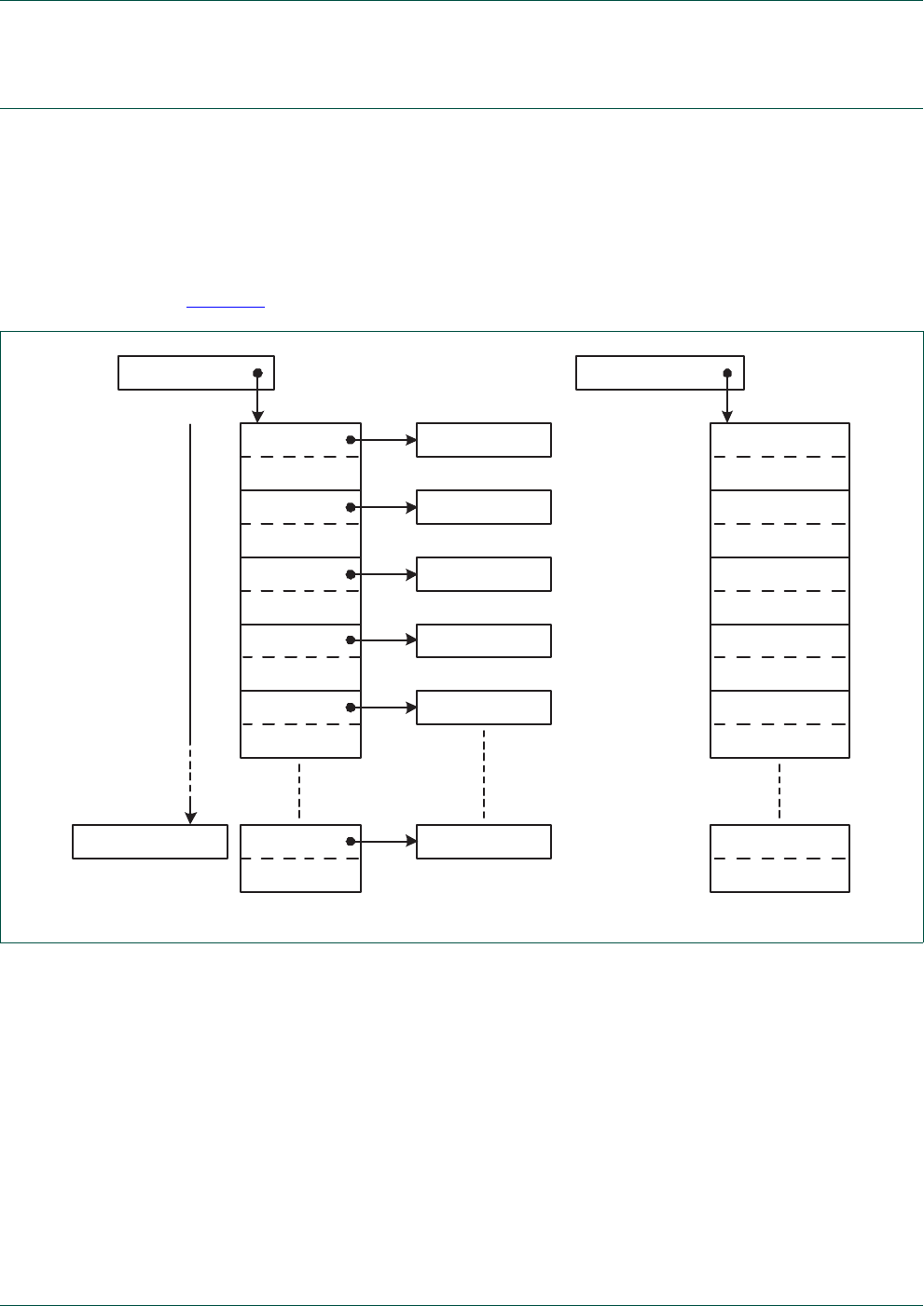
UM10360 All information provided in this document is subject to legal disclaimers. © NXP B.V. 2014. All rights reserved.
User manual Rev. 3.1 — 2 April 2014 181 of 849
NXP Semiconductors UM10360
Chapter 10: LPC176x/5x Ethernet
10.15 Descriptor and status formats
This section defines the descriptor format for the transmit and receive scatter/gather DMA
engines. Each Ethernet frame can consist of one or more fragments. Each fragment
corresponds to a single descriptor. The DMA managers in the Ethernet block scatter (for
receive) and gather (for transmit) multiple fragments for a single Ethernet frame.
10.15.1 Receive descriptors and statuses
Figure 20 depicts the layout of the receive descriptors in memory.
Receive descriptors are stored in an array in memory. The base address of the array is
stored in the RxDescriptor register, and should be aligned on a 4 byte address boundary.
The number of descriptors in the array is stored in the RxDescriptorNumber register using
a minus one encoding style e.g. if the array has 8 elements the register value should be 7.
Parallel to the descriptors there is an array of statuses. For each element of the descriptor
array there is an associated status field in the status array. The base address of the status
array is stored in the RxStatus register, and must be aligned on an 8 byte address
boundary. During operation (when the receive data path is enabled) the RxDescriptor,
RxStatus and RxDescriptorNumber registers should not be modified.
Two registers, RxConsumeIndex and RxProduceIndex, define the descriptor locations
that will be used next by hardware and software. Both registers act as counters starting at
0 and wrapping when they reach the value of RxDescriptorNumber. The RxProduceIndex
contains the index of the descriptor that is going to be filled with the next frame being
Fig 20. Receive descriptor memory layout
1
2
3
4
5
StatusInfo
StatusHashCRC
StatusInfo
StatusHashCRC
StatusInfo
StatusHashCRC
StatusInfo
StatusHashCRC
StatusInfo
StatusHashCRC
StatusInfo
StatusHashCRC
PACKET
CONTROL
PACKET
CONTROL
PACKET
CONTROL
PACKET
CONTROL
PACKET
CONTROL
PACKET
CONTROL
RxStatus
RxDescriptorNumber
RxDescriptor
DATA BUFFER
DATA BUFFER
DATA BUFFER
DATA BUFFER
DATA BUFFER
DATA BUFFER

UM10360 All information provided in this document is subject to legal disclaimers. © NXP B.V. 2014. All rights reserved.
User manual Rev. 3.1 — 2 April 2014 182 of 849
NXP Semiconductors UM10360
Chapter 10: LPC176x/5x Ethernet
received. The RxConsumeIndex is programmed by software and is the index of the next
descriptor that the software receive driver is going to process. When RxProduceIndex ==
RxConsumeIndex, the receive buffer is empty. When RxProduceIndex ==
RxConsumeIndex -1 (taking wraparound into account), the receive buffer is full and newly
received data would generate an overflow unless the software driver frees up one or more
descriptors.
Each receive descriptor takes two word locations (8 bytes) in memory. Likewise each
status field takes two words (8 bytes) in memory. Each receive descriptor consists of a
pointer to the data buffer for storing receive data (Packet) and a control word (Control).
The Packet field has a zero address offset, the control field has a 4 byte address offset
with respect to the descriptor address as defined in Table 176.
The data buffer pointer (Packet) is a 32-bit, byte aligned address value containing the
base address of the data buffer. The definition of the control word bits is listed in
Tab l e 1 77 .
Tab l e 1 78 lists the fields in the receive status elements from the status array.
Each receive status consists of two words. The StatusHashCRC word contains a
concatenation of the two 9-bit hash CRCs calculated from the destination and source
addresses contained in the received frame. After detecting the destination and source
addresses, StatusHashCRC is calculated once, then held for every fragment of the same
frame.
The concatenation of the two CRCs is shown in Table 1 7 9:
Table 176. Receive Descriptor Fields
Symbol Address
offset
Bytes Description
Packet 0x0 4 Base address of the data buffer for storing receive data.
Control 0x4 4 Control information, see Ta b le 17 7 .
Table 177. Receive Descriptor Control Word
Bit Symbol Description
10:0 Size Size in bytes of the data buffer. This is the size of the buffer reserved by the
device driver for a frame or frame fragment i.e. the byte size of the buffer
pointed to by the Packet field. The size is -1 encoded e.g. if the buffer is 8
bytes the size field should be equal to 7.
30:11 - Unused
31 Interrupt If true generate an RxDone interrupt when the data in this frame or frame
fragment and the associated status information has been committed to
memory.
Table 178. Receive Status Fields
Symbol Address
offset
Bytes Description
StatusInfo 0x0 4 Receive status return flags, see Table 1 8 0 .
StatusHashCRC 0x4 4 The concatenation of the destination address hash CRC and
the source address hash CRC.

UM10360 All information provided in this document is subject to legal disclaimers. © NXP B.V. 2014. All rights reserved.
User manual Rev. 3.1 — 2 April 2014 183 of 849
NXP Semiconductors UM10360
Chapter 10: LPC176x/5x Ethernet
The StatusInfo word contains flags returned by the MAC and flags generated by the
receive data path reflecting the status of the reception. Ta b l e 1 8 0 lists the bit definitions in
the StatusInfo word.
Table 179. Receive Status HashCRC Word
Bit Symbol Description
8:0 SAHashCRC Hash CRC calculated from the source address.
15:9 - Unused
24:16 DAHashCRC Hash CRC calculated from the destination address.
31:25 - Unused
Table 180. Receive status information word
Bit Symbol Description
10:0 RxSize The size in bytes of the actual data transferred into one fragment buffer. In
other words, this is the size of the frame or fragment as actually written by
the DMA manager for one descriptor. This may be different from the Size
bits of the Control field in the descriptor that indicate the size of the buffer
allocated by the device driver. Size is -1 encoded e.g. if the buffer has
8bytes the RxSize value will be 7.
17:11 - Unused
18 ControlFrame Indicates this is a control frame for flow control, either a pause frame or a
frame with an unsupported opcode.
19 VLAN Indicates a VLAN frame.
20 FailFilter Indicates this frame has failed the Rx filter. These frames will not normally
pass to memory. But due to the limitation of the size of the buffer, part of
this frame may already be passed to memory. Once the frame is found to
have failed the Rx filter, the remainder of the frame will be discarded
without being passed to the memory. However, if the PassRxFilter bit in
the Command register is set, the whole frame will be passed to memory.
21 Multicast Set when a multicast frame is received.
22 Broadcast Set when a broadcast frame is received.
23 CRCError The received frame had a CRC error.
24 SymbolError The PHY reports a bit error over the PHY interface during reception.
25 LengthError The frame length field value in the frame specifies a valid length, but does
not match the actual data length.
26 RangeError[1] The received packet exceeds the maximum packet size.
27 AlignmentError An alignment error is flagged when dribble bits are detected and also a
CRC error is detected. This is in accordance with IEEE std. 802.3/clause
4.3.2.
28 Overrun Receive overrun. The adapter can not accept the data stream.
29 NoDescriptor No new Rx descriptor is available and the frame is too long for the buffer
size in the current receive descriptor.
30 LastFlag When set to 1, indicates this descriptor is for the last fragment of a frame.
If the frame consists of a single fragment, this bit is also set to 1.
31 Error An error occurred during reception of this frame. This is a logical OR of
AlignmentError, RangeError, LengthError, SymbolError, CRCError, and
Overrun.
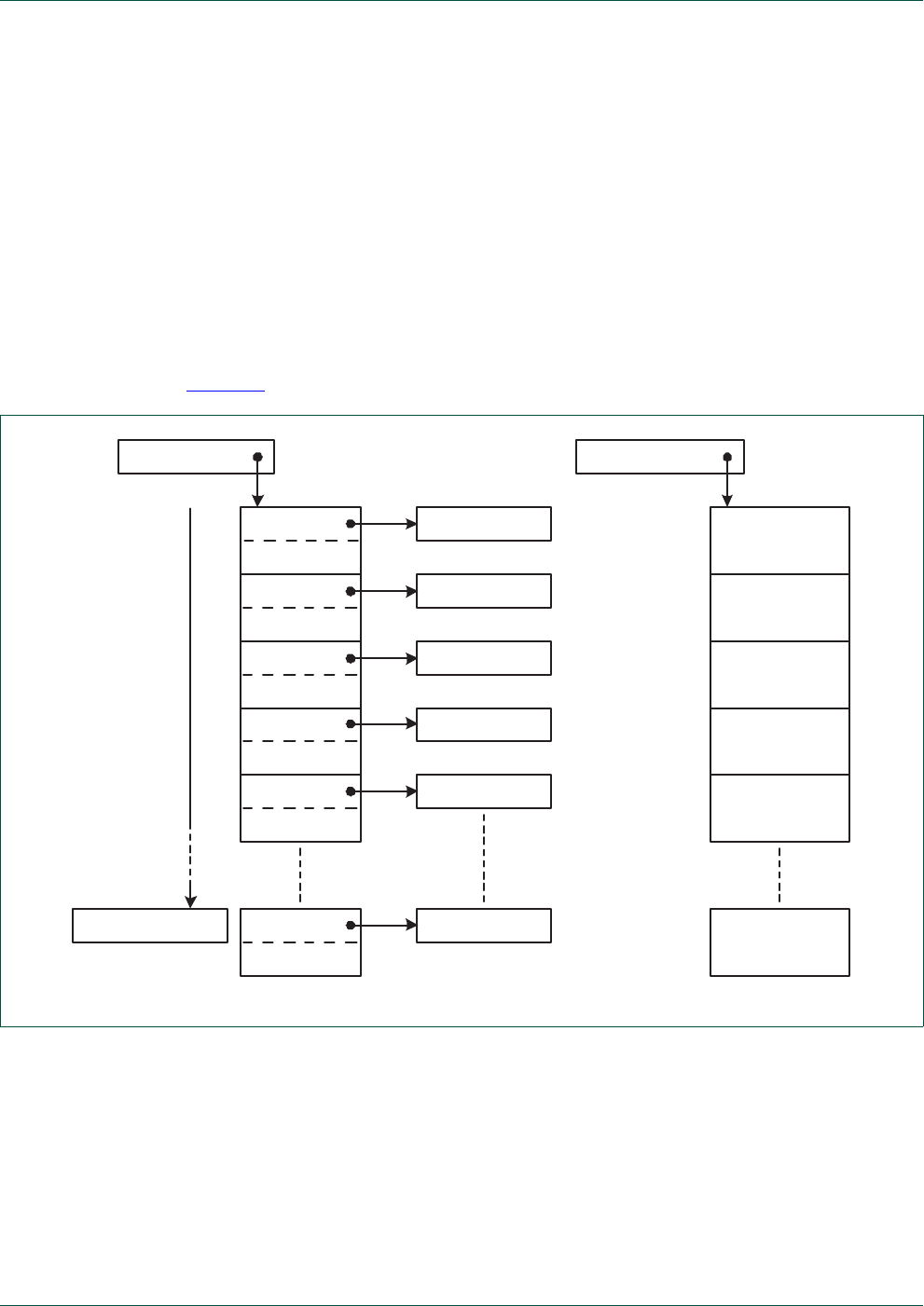
UM10360 All information provided in this document is subject to legal disclaimers. © NXP B.V. 2014. All rights reserved.
User manual Rev. 3.1 — 2 April 2014 184 of 849
NXP Semiconductors UM10360
Chapter 10: LPC176x/5x Ethernet
[1] The EMAC doesn't distinguish the frame type and frame length, so, e.g. when the IP(0x8000) or
ARP(0x0806) packets are received, it compares the frame type with the max length and gives the "Range"
error. In fact, this bit is not an error indication, but simply a statement by the chip regarding the status of the
received frame.
For multi-fragment frames, the value of the AlignmentError, RangeError, LengthError,
SymbolError and CRCError bits in all but the last fragment in the frame will be 0; likewise
the value of the FailFilter, Multicast, Broadcast, VLAN and ControlFrame bits is undefined.
The status of the last fragment in the frame will copy the value for these bits from the
MAC. All fragment statuses will have valid LastFrag, RxSize, Error, Overrun and
NoDescriptor bits.
10.15.2 Transmit descriptors and statuses
Figure 21 depicts the layout of the transmit descriptors in memory.
Transmit descriptors are stored in an array in memory. The lowest address of the transmit
descriptor array is stored in the TxDescriptor register, and must be aligned on a 4 byte
address boundary. The number of descriptors in the array is stored in the
TxDescriptorNumber register using a minus one encoding style i.e. if the array has 8
elements the register value should be 7. Parallel to the descriptors there is an array of
statuses. For each element of the descriptor array there is an associated status field in the
status array. The base address of the status array is stored in the TxStatus register, and
must be aligned on a 4 byte address boundary. During operation (when the transmit data
path is enabled) the TxDescriptor, TxStatus, and TxDescriptorNumber registers should
not be modified.
Fig 21. Transmit descriptor memory layout
1
2
3
4
5
StatusInfo
StatusInfo
StatusInfo
StatusInfo
StatusInfo
StatusInfo
PACKET
CONTROL
PACKET
CONTROL
PACKET
CONTROL
PACKET
CONTROL
PACKET
CONTROL
PACKET
CONTROL
TxStatus
TxDescriptorNumber
TxDescriptor
DATA BUFFER
DATA BUFFER
DATA BUFFER
DATA BUFFER
DATA BUFFER
DATA BUFFER

UM10360 All information provided in this document is subject to legal disclaimers. © NXP B.V. 2014. All rights reserved.
User manual Rev. 3.1 — 2 April 2014 185 of 849
NXP Semiconductors UM10360
Chapter 10: LPC176x/5x Ethernet
Two registers, TxConsumeIndex and TxProduceIndex, define the descriptor locations that
will be used next by hardware and software. Both register act as counters starting at 0 and
wrapping when they reach the value of TxDescriptorNumber. The TxProduceIndex
contains the index of the next descriptor that is going to be filled by the software driver.
The TxConsumeIndex contains the index of the next descriptor going to be transmitted by
the hardware. When TxProduceIndex == TxConsumeIndex, the transmit buffer is empty.
When TxProduceIndex == TxConsumeIndex -1 (taking wraparound into account), the
transmit buffer is full and the software driver cannot add new descriptors until the
hardware has transmitted one or more frames to free up descriptors.
Each transmit descriptor takes two word locations (8 bytes) in memory. Likewise each
status field takes one word (4 bytes) in memory. Each transmit descriptor consists of a
pointer to the data buffer containing transmit data (Packet) and a control word (Control).
The Packet field has a zero address offset, whereas the control field has a 4 byte address
offset, see Ta b le 1 8 1 .
The data buffer pointer (Packet) is a 32-bit, byte aligned address value containing the
base address of the data buffer. The definition of the control word bits is listed in
Tab l e 1 82 .
Tab l e 1 83 shows the one field transmit status.
Table 181. Transmit descriptor fields
Symbol Address offset Bytes Description
Packet 0x0 4Base address of the data buffer containing transmit data.
Control 0x4 4Control information, see Table 1 8 2.
Table 182. Transmit descriptor control word
Bit Symbol Description
10:0 Size Size in bytes of the data buffer. This is the size of the frame or fragment as it
needs to be fetched by the DMA manager. In most cases it will be equal to the
byte size of the data buffer pointed to by the Packet field of the descriptor. Size
is -1 encoded e.g. a buffer of 8 bytes is encoded as the Size value 7.
25:11 - Unused
26 Override Per frame override. If true, bits 30:27 will override the defaults from the MAC
internal registers. If false, bits 30:27 will be ignored and the default values
from the MAC will be used.
27 Huge If true, enables huge frame, allowing unlimited frame sizes. When false,
prevents transmission of more than the maximum frame length (MAXF[15:0]).
28 Pad If true, pad short frames to 64 bytes.
29 CRC If true, append a hardware CRC to the frame.
30 Last If true, indicates that this is the descriptor for the last fragment in the transmit
frame. If false, the fragment from the next descriptor should be appended.
31 Interrupt If true, a TxDone interrupt will be generated when the data in this frame or
frame fragment has been sent and the associated status information has been
committed to memory.
Table 183. Transmit status fields
Symbol Address
offset
Bytes Description
StatusInfo 0x0 4Transmit status return flags, see Ta b l e 1 8 4 .

UM10360 All information provided in this document is subject to legal disclaimers. © NXP B.V. 2014. All rights reserved.
User manual Rev. 3.1 — 2 April 2014 186 of 849
NXP Semiconductors UM10360
Chapter 10: LPC176x/5x Ethernet
The transmit status consists of one word which is the StatusInfo word. It contains flags
returned by the MAC and flags generated by the transmit data path reflecting the status of
the transmission. Tab l e 18 4 lists the bit definitions in the StatusInfo word.
For multi-fragment frames, the value of the LateCollision, ExcessiveCollision,
ExcessiveDefer, Defer and CollissionCount bits in all but the last fragment in the frame will
be 0. The status of the last fragment in the frame will copy the value for these bits from the
MAC. All fragment statuses will have valid Error, NoDescriptor and Underrun bits.
10.16 Ethernet block functional description
This section defines the functions of the DMA capable 10/100 Ethernet MAC. After
introducing the DMA concepts of the Ethernet block, and a description of the basic
transmit and receive functions, this section elaborates on advanced features such as flow
control, receive filtering, etc.
10.16.1 Overview
The Ethernet block can transmit and receive Ethernet packets from an off-chip Ethernet
PHY connected through the RMII interface.
Typically during system start-up, the Ethernet block will be initialized. Software
initialization of the Ethernet block should include initialization of the descriptor and status
arrays as well as the receiver fragment buffers.
Remark: When initializing the Ethernet block, it is important to first configure the PHY and
ensure that reference clocks (ENET_REF_CLK signal in RMII mode, or both
ENET_RX_CLK and ENET_TX_CLK signals in MII mode) are present at the external pins
and connected to the EMAC module (selecting the appropriate pins using the PINSEL
registers) prior to continuing with Ethernet configuration. Otherwise the CPU can become
locked and no further functionality will be possible. This will cause JTAG lose
communication with the target, if debug mode is being used.
Table 184. Transmit status information word
Bit Symbol Description
20:0 - Unused
24:21 CollisionCount The number of collisions this packet incurred, up to the
Retransmission Maximum.
25 Defer This packet incurred deferral, because the medium was occupied.
This is not an error unless excessive deferral occurs.
26 ExcessiveDefer This packet incurred deferral beyond the maximum deferral limit and
was aborted.
27 ExcessiveCollision Indicates this packet exceeded the maximum collision limit and was
aborted.
28 LateCollision An Out of window Collision was seen, causing packet abort.
29 Underrun A Tx underrun occurred due to the adapter not producing transmit
data.
30 NoDescriptor The transmit stream was interrupted because a descriptor was not
available.
31 Error An error occurred during transmission. This is a logical OR of
Underrun, LateCollision, ExcessiveCollision, and ExcessiveDefer.

UM10360 All information provided in this document is subject to legal disclaimers. © NXP B.V. 2014. All rights reserved.
User manual Rev. 3.1 — 2 April 2014 187 of 849
NXP Semiconductors UM10360
Chapter 10: LPC176x/5x Ethernet
To t r an s m it a pac k e t t h e s o ft w ar e dr i v er h as t o se t up t he a ppr o pr i a te C ont r ol r e gis te rs
and a descriptor to point to the packet data buffer before transferring the packet to
hardware by incrementing the TxProduceIndex register. After transmission, hardware will
increment TxConsumeIndex and optionally generate an interrupt.
The hardware will receive packets from the PHY and apply filtering as configured by the
software driver. While receiving a packet the hardware will read a descriptor from memory
to find the location of the associated receiver data buffer. Receive data is written in the
data buffer and receive status is returned in the receive descriptor status word. Optionally
an interrupt can be generated to notify software that a packet has been received. Note
that the DMA manager will prefetch and buffer up to three descriptors.
10.16.2 AHB interface
The registers of the Ethernet block connect to an AHB slave interface to allow access to
the registers from the CPU.
The AHB interface has a 32-bit data path, which supports only word accesses and has an
address aperture of 4 kB. Tab l e 1 2 9 lists the registers of the Ethernet block.
All AHB write accesses to registers are posted except for accesses to the IntSet, IntClear
and IntEnable registers. AHB write operations are executed in order.
If the PowerDown bit of the PowerDown register is set, all AHB read and write accesses
will return a read or write error except for accesses to the PowerDown register.
Bus Errors
The Ethernet block generates errors for several conditions:
•The AHB interface will return a read error when there is an AHB read access to a
write-only register; likewise a write error is returned when there is an AHB write
access to the read-only register. An AHB read or write error will be returned on AHB
read or write accesses to reserved registers. These errors are propagated back to the
CPU. Registers defined as read-only and write-only are identified in Table 1 2 9 .
•If the PowerDown bit is set all accesses to AHB registers will result in an error
response except for accesses to the PowerDown register.
10.17 Interrupts
The Ethernet block has a single interrupt request output to the CPU (via the NVIC).
The interrupt service routine must read the IntStatus register to determine the origin of the
interrupt. All interrupt statuses can be set by software writing to the IntSet register;
statuses can be cleared by software writing to the IntClear register.
The transmit and receive data paths can only set interrupt statuses, they cannot clear
statuses. The SoftInt interrupt cannot be set by hardware and can be used by software for
test purposes.
10.17.1 Direct Memory Access (DMA)
Descriptor arrays

UM10360 All information provided in this document is subject to legal disclaimers. © NXP B.V. 2014. All rights reserved.
User manual Rev. 3.1 — 2 April 2014 188 of 849
NXP Semiconductors UM10360
Chapter 10: LPC176x/5x Ethernet
The Ethernet block includes two DMA managers. The DMA managers make it possible to
transfer frames directly to and from memory with little support from the processor and
without the need to trigger an interrupt for each frame.
The DMA managers work with arrays of frame descriptors and statuses that are stored in
memory. The descriptors and statuses act as an interface between the Ethernet hardware
and the device driver software. There is one descriptor array for receive frames and one
descriptor array for transmit frames. Using buffering for frame descriptors, the memory
traffic and memory bandwidth utilization of descriptors can be kept small.
Each frame descriptor contains two 32-bit fields: the first field is a pointer to a data buffer
containing a frame or a fragment, whereas the second field is a control word related to
that frame or fragment.
The software driver must write the base addresses of the descriptor and status arrays in
the TxDescriptor/RxDescriptor and TxStatus/RxStatus registers. The number of
descriptors/statuses in each array must be written in the
TxDescriptorNumber/RxDescriptorNumber registers. The number of descriptors in an
array corresponds to the number of statuses in the associated status array.
Transmit descriptor arrays, receive descriptor arrays and transmit status arrays must be
aligned on a 4 byte (32bit)address boundary, while the receive status array must be
aligned on a 8 byte (64bit) address boundary.
Ownership of descriptors
Both device driver software and Ethernet hardware can read and write the descriptor
arrays at the same time in order to produce and consume descriptors. A descriptor is
"owned" either by the device driver or by the Ethernet hardware. Only the owner of a
descriptor reads or writes its value. Typically, the sequence of use and ownership of
descriptors and statuses is as follows: a descriptor is owned and set up by the device
driver; ownership of the descriptor/status is passed by the device driver to the Ethernet
block, which reads the descriptor and writes information to the status field; the Ethernet
block passes ownership of the descriptor back to the device driver, which uses the status
information and then recycles the descriptor to be used for another frame. Software must
pre-allocate the memory used to hold the descriptor arrays.
Software can hand over ownership of descriptors and statuses to the hardware by
incrementing (and wrapping if on the array boundary) the
TxProduceIndex/RxConsumeIndex registers. Hardware hands over descriptors and
status to software by updating the TxConsumeIndex/ RxProduceIndex registers.
After handing over a descriptor to the receive and transmit DMA hardware, device driver
software should not modify the descriptor or reclaim the descriptor by decrementing the
TxProduceIndex/ RxConsumeIndex registers because descriptors may have been
prefetched by the hardware. In this case the device driver software will have to wait until
the frame has been transmitted or the device driver has to soft-reset the transmit and/or
receive data paths which will also reset the descriptor arrays.
Sequential order with wrap-around
When descriptors are read from and statuses are written to the arrays, this is done in
sequential order with wrap-around. Sequential order means that when the Ethernet block
has finished reading/writing a descriptor/status, the next descriptor/status it reads/writes is

UM10360 All information provided in this document is subject to legal disclaimers. © NXP B.V. 2014. All rights reserved.
User manual Rev. 3.1 — 2 April 2014 189 of 849
NXP Semiconductors UM10360
Chapter 10: LPC176x/5x Ethernet
the one at the next higher, adjacent memory address. Wrap around means that when the
Ethernet block has finished reading/writing the last descriptor/status of the array (with the
highest memory address), the next descriptor/status it reads/writes is the first
descriptor/status of the array at the base address of the array.
Full and Empty state of descriptor arrays
The descriptor arrays can be empty, partially full or full. A descriptor array is empty when
all descriptors are owned by the producer. A descriptor array is partially full if both
producer and consumer own part of the descriptors and both are busy processing those
descriptors. A descriptor array is full when all descriptors (except one) are owned by the
consumer, so that the producer has no more room to process frames. Ownership of
descriptors is indicated with the use of a consume index and a produce index. The
produce index is the first element of the array owned by the producer. It is also the index
of the array element that is next going to be used by the producer of frames (it may
already be busy using it and subsequent elements). The consume index is the first
element of the array that is owned by the consumer. It is also the number of the array
element next to be consumed by the consumer of frames (it and subsequent elements
may already be in the process of being consumed). If the consume index and the produce
index are equal, the descriptor array is empty and all array elements are owned by the
producer. If the consume index equals the produce index plus one, then the array is full
and all array elements (except the one at the produce index) are owned by the consumer.
With a full descriptor array, still one array element is kept empty, to be able to easily
distinguish the full or empty state by looking at the value of the produce index and
consume index. An array must have at least 2 elements to be able to indicate a full
descriptor array with a produce index of value 0 and a consume index of value 1. The
wrap around of the arrays is taken into account when determining if a descriptor array is
full, so a produce index that indicates the last element in the array and a consume index
that indicates the first element in the array, also means the descriptor array is full. When
the produce index and the consume index are unequal and the consume index is not the
produce index plus one (with wrap around taken into account), then the descriptor array is
partially full and both the consumer and producer own enough descriptors to be able to
operate actively on the descriptor array.
Interrupt bit
The descriptors have an Interrupt bit, which is programmed by software. When the
Ethernet block is processing a descriptor and finds this bit set, it will allow triggering an
interrupt (after committing status to memory) by passing the RxDoneInt or TxDoneInt bits
in the IntStatus register to the interrupt output pin. If the Interrupt bit is not set in the
descriptor, then the RxDoneInt or TxDoneInt are not set and no interrupt is triggered (note
that the corresponding bits in IntEnable must also be set to trigger interrupts). This offers
flexible ways of managing the descriptor arrays. For instance, the device driver could add
10 frames to the Tx descriptor array, and set the Interrupt bit in descriptor number 5 in the
descriptor array. This would invoke the interrupt service routine before the transmit
descriptor array is completely exhausted. The device driver could add another batch of
frames to the descriptor array, without interrupting continuous transmission of frames.
Frame fragments
For maximum flexibility in frame storage, frames can be split up into multiple frame
fragments with fragments located in different places in memory. In this case one
descriptor is used for each frame fragment. So, a descriptor can point to a single frame or

UM10360 All information provided in this document is subject to legal disclaimers. © NXP B.V. 2014. All rights reserved.
User manual Rev. 3.1 — 2 April 2014 190 of 849
NXP Semiconductors UM10360
Chapter 10: LPC176x/5x Ethernet
to a fragment of a frame. By using fragments, scatter/gather DMA can be done: transmit
frames are gathered from multiple fragments in memory and receive frames can be
scattered to multiple fragments in memory.
By stringing together fragments it is possible to create large frames from small memory
areas. Another use of fragments is to be able to locate a frame header and frame payload
in different places and to concatenate them without copy operations in the device driver.
For transmissions, the Last bit in the descriptor Control field indicates if the fragment is the
last in a frame; for receive frames, the LastFrag bit in the StatusInfo field of the status
words indicates if the fragment is the last in the frame. If the Last(Frag) bit is 0 the next
descriptor belongs to the same Ethernet frame, If the Last(Frag) bit is 1 the next descriptor
is a new Ethernet frame.
10.17.2 Initialization
After reset, the Ethernet software driver needs to initialize the Ethernet block. During
initialization the software needs to:
•Remove the soft reset condition from the MAC
•Configure the PHY via the MIIM interface of the MAC.
Remark: it is important to configure the PHY and insure that reference clocks
(ENET_REF_CLK signal in RMII mode, or both ENET_RX_CLK and ENET_TX_CLK
signals in MII mode) are present at the external pins and connected to the EMAC
module (selecting the appropriate pins using the PINSEL registers) prior to continuing
with Ethernet configuration. Otherwise the CPU can become locked and no further
functionality will be possible. This will cause JTAG lose communication with the target,
if debug mode is being used.
•Select RMII mode
•Configure the transmit and receive DMA engines, including the descriptor arrays
•Configure the host registers (MAC1,MAC2 etc.) in the MAC
•Enable the receive and transmit data paths
Depending on the PHY, the software needs to initialize registers in the PHY via the MII
Management interface. The software can read and write PHY registers by programming
the MCFG, MCMD, MADR registers of the MAC. Write data should be written to the
MWTD register; read data and status information can be read from the MRDD and MIND
registers.
The Ethernet block supports RMII PHYs. During initialization software must select RMII
mode by programming the Command register.
Before switching to RMII mode the default soft reset (MAC1 register bit 15) has to be
de-asserted. The phy_ref_clk must be running and internally connected during this
operation.
Transmit and receive DMA engines should be initialized by the device driver by allocating
the descriptor and status arrays in memory. Transmit and receive functions have their own
dedicated descriptor and status arrays. The base addresses of these arrays need to be
programmed in the TxDescriptor/TxStatus and RxDescriptor/RxStatus registers. The
number of descriptors in an array matches the number of statuses in an array.

UM10360 All information provided in this document is subject to legal disclaimers. © NXP B.V. 2014. All rights reserved.
User manual Rev. 3.1 — 2 April 2014 191 of 849
NXP Semiconductors UM10360
Chapter 10: LPC176x/5x Ethernet
Please note that the transmit descriptors, receive descriptors and receive statuses are 8
bytes each while the transmit statuses are 4 bytes each. All descriptor arrays and transmit
statuses need to be aligned on 4 byte boundaries; receive status arrays need to be
aligned on 8 byte boundaries. The number of descriptors in the descriptor arrays needs to
be written to the TxDescriptorNumber/RxDescriptorNumber registers using a -1 encoding
i.e. the value in the registers is the number of descriptors minus one e.g. if the descriptor
array has 4 descriptors the value of the number of descriptors register should be 3.
After setting up the descriptor arrays, frame buffers need to be allocated for the receive
descriptors before enabling the receive data path. The Packet field of the receive
descriptors needs to be filled with the base address of the frame buffer of that descriptor.
Amongst others the Control field in the receive descriptor needs to contain the size of the
data buffer using -1 encoding.
The receive data path has a configurable filtering function for discarding/ignoring specific
Ethernet frames. The filtering function should also be configured during initialization.
After an assertion of the hardware reset, the soft reset bit in the MAC will be asserted. The
soft reset condition must be removed before the Ethernet block can be enabled.
Enabling of the receive function is located in two places. The receive DMA manager
needs to be enabled and the receive data path of the MAC needs to be enabled. To
prevent overflow in the receive DMA engine the receive DMA engine should be enabled
by setting the RxEnable bit in the Command register before enabling the receive data path
in the MAC by setting the RECEIVE ENABLE bit in the MAC1 register.
The transmit DMA engine can be enabled at any time by setting the TxEnable bit in the
Command register.
Before enabling the data paths, several options can be programmed in the MAC, such as
automatic flow control, transmit to receive loop-back for verification, full/half duplex
modes, etc.
Base addresses of descriptor arrays and descriptor array sizes cannot be modified
without a (soft) reset of the receive and transmit data paths.
10.17.3 Transmit process
Overview
This section outlines the transmission process.
Device driver sets up descriptors and data
If the descriptor array is full the device driver should wait for the descriptor arrays to
become not full before writing to a descriptor in the descriptor array. If the descriptor array
is not full, the device driver should use the descriptor numbered TxProduceIndex of the
array pointed to by TxDescriptor.
The Packet pointer in the descriptor is set to point to a data frame or frame fragment to be
transmitted. The Size field in the Command field of the descriptor should be set to the
number of bytes in the fragment buffer, -1 encoded. Additional control information can be
indicated in the Control field in the descriptor (bits Interrupt, Last, CRC, Pad).

UM10360 All information provided in this document is subject to legal disclaimers. © NXP B.V. 2014. All rights reserved.
User manual Rev. 3.1 — 2 April 2014 192 of 849
NXP Semiconductors UM10360
Chapter 10: LPC176x/5x Ethernet
After writing the descriptor the descriptor needs to be handed over to the hardware by
incrementing (and possibly wrapping) the TxProduceIndex register.
If the transmit data path is disabled, the device driver should not forget to enable the
transmit data path by setting the TxEnable bit in the Command register.
When there is a multi-fragment transmission for fragments other than the last, the Last bit
in the descriptor must be set to 0; for the last fragment the Last bit must be set to 1. To
trigger an interrupt when the frame has been transmitted and transmission status has
been committed to memory, set the Interrupt bit in the descriptor Control field to 1. To have
the hardware add a CRC in the frame sequence control field of this Ethernet frame, set
the CRC bit in the descriptor. This should be done if the CRC has not already been added
by software. To enable automatic padding of small frames to the minimum required frame
size, set the Pad bit in the Control field of the descriptor to 1. In typical applications bits
CRC and Pad are both set to 1.
The device driver can set up interrupts using the IntEnable register to wait for a signal of
completion from the hardware or can periodically inspect (poll) the progress of
transmission. It can also add new frames at the end of the descriptor array, while
hardware consumes descriptors at the start of the array.
The device driver can stop the transmit process by resetting the TxEnable bit in the
Command register to 0. The transmission will not stop immediately; frames already being
transmitted will be transmitted completely and the status will be committed to memory
before deactivating the data path. The status of the transmit data path can be monitored
by the device driver reading the TxStatus bit in the Status register.
As soon as the transmit data path is enabled and the corresponding TxConsumeIndex
and TxProduceIndex are not equal i.e. the hardware still needs to process frames from
the descriptor array, the TxStatus bit in the Status register will return to 1 (active).
Tx DMA manager reads the Tx descriptor array
When the TxEnable bit is set, the Tx DMA manager reads the descriptors from memory at
the address determined by TxDescriptor and TxConsumeIndex. The number of
descriptors requested is determined by the total number of descriptors owned by the
hardware: TxProduceIndex - TxConsumeIndex. Block transferring descriptors minimizes
memory loading. Read data returned from memory is buffered and consumed as needed.
Tx DMA manager transmits data
After reading the descriptor the transmit DMA engine reads the associated frame data
from memory and transmits the frame. After transfer completion, the Tx DMA manager
writes status information back to the StatusInfo and StatusHashCRC words of the status
field. The value of the TxConsumeIndex is only updated after status information has been
committed to memory, which is checked by an internal tag protocol in the memory
interface. The Tx DMA manager continues to transmit frames until the descriptor array is
empty. If the transmit descriptor array is empty the TxStatus bit in the Status register will
return to 0 (inactive). If the descriptor array is empty the Ethernet hardware will set the
TxFinishedInt bit of the IntStatus register. The transmit data path will still be enabled.
The Tx DMA manager inspects the Last bit of the descriptor Control field when loading the
descriptor. If the Last bit is 0, this indicates that the frame consists of multiple fragments.
The Tx DMA manager gathers all the fragments from the host memory, visiting a string of

UM10360 All information provided in this document is subject to legal disclaimers. © NXP B.V. 2014. All rights reserved.
User manual Rev. 3.1 — 2 April 2014 193 of 849
NXP Semiconductors UM10360
Chapter 10: LPC176x/5x Ethernet
frame descriptors, and sends them out as one Ethernet frame on the Ethernet connection.
When the Tx DMA manager finds a descriptor with the Last bit in the Control field set to 1,
this indicates the last fragment of the frame and thus the end of the frame is found.
Update ConsumeIndex
Each time the Tx DMA manager commits a status word to memory it completes the
transmission of a descriptor and it increments the TxConsumeIndex (taking wrap around
into account) to hand the descriptor back to the device driver software. Software can
re-use the descriptor for new transmissions after hardware has handed it back.
The device driver software can keep track of the progress of the DMA manager by reading
the TxConsumeIndex register to see how far along the transmit process is. When the Tx
descriptor array is emptied completely, the TxConsumeIndex register retains its last value.
Write transmission status
After the frame has been transmitted over the RMII bus, the StatusInfo word of the frame
descriptor is updated by the DMA manager.
If the descriptor is for the last fragment of a frame (or for the whole frame if there are no
fragments), then depending on the success or failure of the frame transmission, error
flags (Error, LateCollision, ExcessiveCollision, Underrun, ExcessiveDefer, Defer) are set
in the status. The CollisionCount field is set to the number of collisions the frame incurred,
up to the Retransmission Maximum programmed in the Collision window/retry register of
the MAC.
Statuses for all but the last fragment in the frame will be written as soon as the data in the
frame has been accepted by the Tx DMA manager. Even if the descriptor is for a frame
fragment other than the last fragment, the error flags are returned via the AHB interface. If
the Ethernet block detects a transmission error during transmission of a (multi-fragment)
frame, all remaining fragments of the frame are still read via the AHB interface. After an
error, the remaining transmit data is discarded by the Ethernet block. If there are errors
during transmission of a multi-fragment frame the error statuses will be repeated until the
last fragment of the frame. Statuses for all but the last fragment in the frame will be written
as soon as the data in the frame has been accepted by the Tx DMA manager. These may
include error information if the error is detected early enough. The status for the last
fragment in the frame will only be written after the transmission has completed on the
Ethernet connection. Thus, the status for the last fragment will always reflect any error
that occurred anywhere in the frame.
The status of the last frame transmission can also be inspected by reading the TSV0 and
TSV1 registers. These registers do not report statuses on a fragment basis and do not
store information of previously sent frames. They are provided primarily for debug
purposes, because the communication between driver software and the Ethernet block
takes place through the frame descriptors. The status registers are valid as long as the
internal status of the MAC is valid and should typically only be read when the transmit and
receive processes are halted.
Transmission error handling
If an error occurs during the transmit process, the Tx DMA manager will report the error
via the transmission StatusInfo word written in the Status array and the IntStatus interrupt
status register.

UM10360 All information provided in this document is subject to legal disclaimers. © NXP B.V. 2014. All rights reserved.
User manual Rev. 3.1 — 2 April 2014 194 of 849
NXP Semiconductors UM10360
Chapter 10: LPC176x/5x Ethernet
The transmission can generate several types of errors: LateCollision, ExcessiveCollision,
ExcessiveDefer, Underrun, and NoDescriptor. All have corresponding bits in the
transmission StatusInfo word. In addition to the separate bits in the StatusInfo word,
LateCollision, ExcessiveCollision, and ExcessiveDefer are ORed together into the Error
bit of the Status. Errors are also propagated to the IntStatus register; the TxError bit in the
IntStatus register is set in the case of a LateCollision, ExcessiveCollision, ExcessiveDefer,
or NoDescriptor error; Underrun errors are reported in the TxUnderrun bit of the IntStatus
register.
Underrun errors can have three causes:
•The next fragment in a multi-fragment transmission is not available. This is a nonfatal
error. A NoDescriptor status will be returned on the previous fragment and the TxError
bit in IntStatus will be set.
•The transmission fragment data is not available when the Ethernet block has already
started sending the frame. This is a nonfatal error. An Underrun status will be returned
on transfer and the TxError bit in IntStatus will be set.
•The flow of transmission statuses stalls and a new status has to be written while a
previous status still waits to be transferred across the memory interface. This is a fatal
error which can only be resolved by a soft reset of the hardware.
The first and second situations are nonfatal and the device driver has to re-send the frame
or have upper software layers re-send the frame. In the third case the hardware is in an
undefined state and needs to be soft reset by setting the TxReset bit in the Command
register.
After reporting a LateCollision, ExcessiveCollision, ExcessiveDefer or Underrun error, the
transmission of the erroneous frame will be aborted, remaining transmission data and
frame fragments will be discarded and transmission will continue with the next frame in
the descriptor array.
Device drivers should catch the transmission errors and take action.
Transmit triggers interrupts
The transmit data path can generate four different interrupt types:
•If the Interrupt bit in the descriptor Control field is set, the Tx DMA will set the
TxDoneInt bit in the IntStatus register after sending the fragment and committing the
associated transmission status to memory. Even if a descriptor (fragment) is not the
last in a multi-fragment frame the Interrupt bit in the descriptor can be used to
generate an interrupt.
•If the descriptor array is empty while the Ethernet hardware is enabled the hardware
will set the TxFinishedInt bit of the IntStatus register.
•If the AHB interface does not consume the transmission statuses at a sufficiently high
bandwidth the transmission may underrun in which case the TxUnderrun bit will be set
in the IntStatus register. This is a fatal error which requires a soft reset of the
transmission queue.
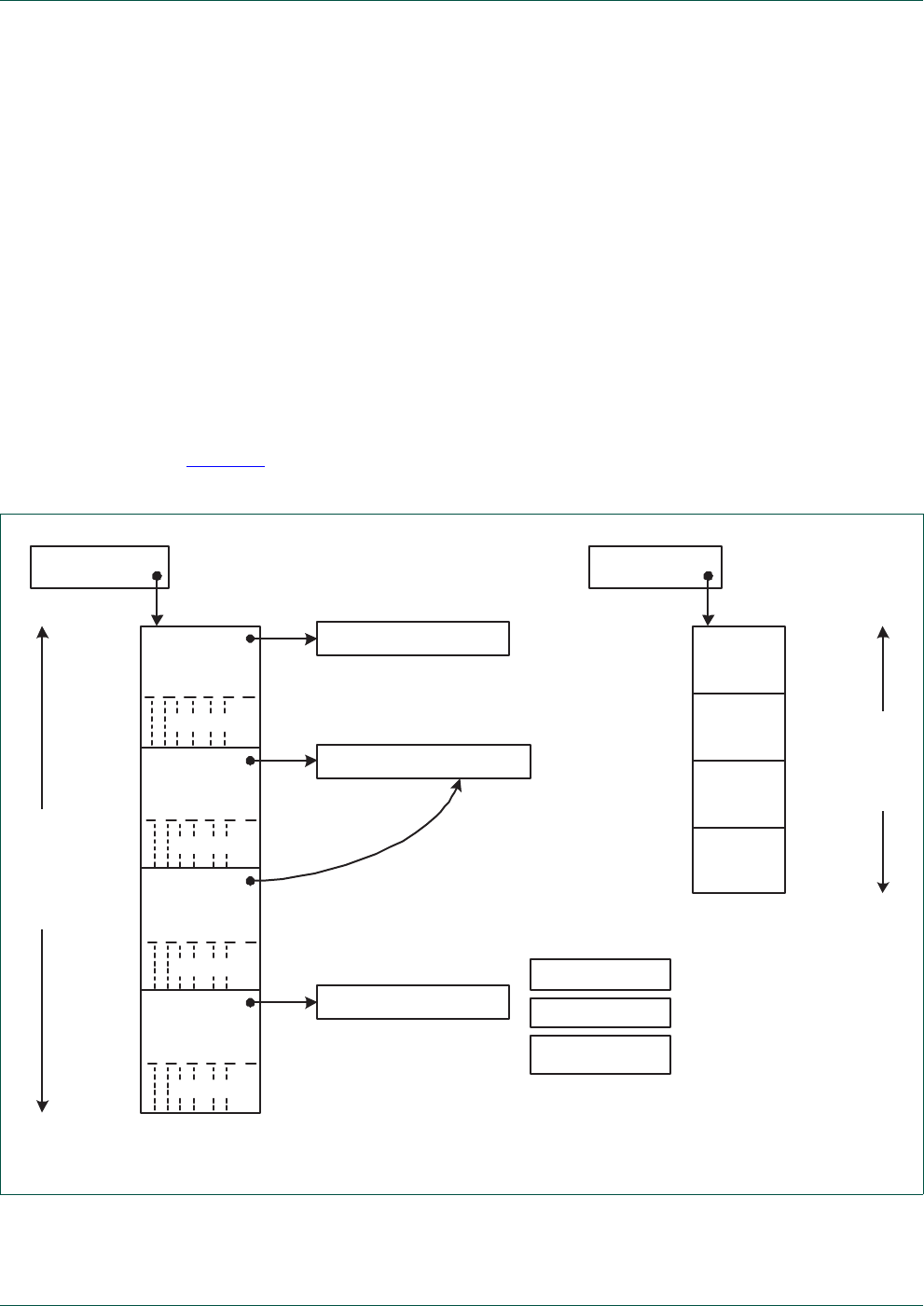
UM10360 All information provided in this document is subject to legal disclaimers. © NXP B.V. 2014. All rights reserved.
User manual Rev. 3.1 — 2 April 2014 195 of 849
NXP Semiconductors UM10360
Chapter 10: LPC176x/5x Ethernet
•In the case of a transmission error (LateCollision, ExcessiveCollision, or
ExcessiveDefer) or a multi-fragment frame where the device driver did provide the
initial fragments but did not provide the rest of the fragments (NoDescriptor) or in the
case of a nonfatal overrun, the hardware will set the TxErrorInt bit of the IntStatus
register.
All of the above interrupts can be enabled and disabled by setting or resetting the
corresponding bits in the IntEnable register. Enabling or disabling does not affect the
IntStatus register contents, only the propagation of the interrupt status to the CPU (via the
NVIC).
The interrupts, either of individual frames or of the whole list, are a good means of
communication between the DMA manager and the device driver, triggering the device
driver to inspect the status words of descriptors that have been processed.
Transmit example
Figure 22 illustrates the transmit process in an example transmitting uses a frame header
of 8 bytes and a frame payload of 12 bytes.
After reset the values of the DMA registers will be zero. During initialization the device
driver will allocate the descriptor and status array in memory. In this example, an array of
four descriptors is allocated; the array is 4x2x4 bytes and aligned on a 4 byte address
Fig 22. Transmit example memory and registers
StatusInfo
StatusInfo
StatusInfo
StatusInfo
Packet
0x20081314
TxStatus
0x200811F8
TxDescriptor
0x200810EC
0x200810EC
0x200810F0
0x200810F4
0x200810F8
0x200810FC
0x20081100
0x20081104
0x20081108
0x200811F8
0x200811FC
0x20081200
0x20081204
Packet
0x20081411
Packet
0x20081419
Packet
0x20081324
descriptor array
descriptor 0de s cr i pt o r 1descriptor 2descriptor 3
descriptor array
fragment buffers
TxProduceIndex
TxConsumeIndex
TxDescriptorNumber
= 3
stat us 1 st at us 0statu s 3 st atu s 2
stat us array
status array
PACKET 1 HEADER (8 bytes)
PACKET 0 PAYLOAD (12 bytes)
PACKET 0 HEADER (8 bytes)
00 7Control
CONTROL
00 7
Control
CONTROL
11 3
Control
CONTROL
00 7
Control
CONTROL
0x20081314
0x2008131B
0x20081411
0x20081419
0x2008141C
0x20081324
0x2008132B

UM10360 All information provided in this document is subject to legal disclaimers. © NXP B.V. 2014. All rights reserved.
User manual Rev. 3.1 — 2 April 2014 196 of 849
NXP Semiconductors UM10360
Chapter 10: LPC176x/5x Ethernet
boundary. Since the number of descriptors matches the number of statuses the status
array consists of four elements; the array is 4x1x4 bytes and aligned on a 4 byte address
boundary. The device driver writes the base address of the descriptor array
(0x2008 10EC) to the TxDescriptor register and the base address of the status array
(0x2008 11F8) to the TxStatus register. The device driver writes the number of descriptors
and statuses minus 1(3) to the TxDescriptorNumber register. The descriptors and
statuses in the arrays need not be initialized, yet.
At this point, the transmit data path may be enabled by setting the TxEnable bit in the
Command register. If the transmit data path is enabled while there are no further frames to
send the TxFinishedInt interrupt flag will be set. To reduce the processor interrupt load
only the desired interrupts can be enabled by setting the relevant bits in the IntEnable
register.
Now suppose application software wants to transmit a frame of 12 bytes using a TCP/IP
protocol (in real applications frames will be larger than 12 bytes). The TCP/IP stack will
add a header to the frame. The frame header need not be immediately in front of the
payload data in memory. The device driver can program the Tx DMA to collect header and
payload data. To do so, the device driver will program the first descriptor to point at the
frame header; the Last flag in the descriptor will be set to false/0 to indicate a
multi-fragment transmission. The device driver will program the next descriptor to point at
the actual payload data. The maximum size of a payload buffer is 2 kB so a single
descriptor suffices to describe the payload buffer. For the sake of the example though the
payload is distributed across two descriptors. After the first descriptor in the array
describing the header, the second descriptor in the array describes the initial 8 bytes of
the payload; the third descriptor in the array describes the remaining 4 bytes of the frame.
In the third descriptor the Last bit in the Control word is set to true/1 to indicate it is the last
descriptor in the frame. In this example the Interrupt bit in the descriptor Control field is set
in the last fragment of the frame in order to trigger an interrupt after the transmission
completed. The Size field in the descriptor’s Control word is set to the number of bytes in
the fragment buffer, -1 encoded.
Note that in real device drivers, the payload will typically only be split across multiple
descriptors if it is more than 2 kB. Also note that transmission payload data is forwarded to
the hardware without the device driver copying it (zero copy device driver).
After setting up the descriptors for the transaction the device driver increments the
TxProduceIndex register by 3 since three descriptors have been programmed. If the
transmit data path was not enabled during initialization the device driver needs to enable
the data path now.
If the transmit data path is enabled the Ethernet block will start transmitting the frame as
soon as it detects the TxProduceIndex is not equal to TxConsumeIndex - both were zero
after reset. The Tx DMA will start reading the descriptors from memory. The memory
system will return the descriptors and the Ethernet block will accept them one by one
while reading the transmit data fragments.
As soon as transmission read data is returned from memory, the Ethernet block will try to
start transmission on the Ethernet connection via the RMII interface.

UM10360 All information provided in this document is subject to legal disclaimers. © NXP B.V. 2014. All rights reserved.
User manual Rev. 3.1 — 2 April 2014 197 of 849
NXP Semiconductors UM10360
Chapter 10: LPC176x/5x Ethernet
After transmitting each fragment of the frame the Tx DMA will write the status of the
fragment’s transmission. Statuses for all but the last fragment in the frame will be written
as soon as the data in the frame has been accepted by the Tx DMA manager. The status
for the last fragment in the frame will only be written after the transmission has completed
on the Ethernet connection.
Since the Interrupt bit in the descriptor of the last fragment is set, after committing the
status of the last fragment to memory the Ethernet block will trigger a TxDoneInt interrupt,
which triggers the device driver to inspect the status information.
In this example the device driver cannot add new descriptors as long as the Ethernet
block has not incremented the TxConsumeIndex because the descriptor array is full (even
though one descriptor is not programmed yet). Only after the hardware commits the status
for the first fragment to memory and the TxConsumeIndex is set to 1 by the DMA manager
can the device driver program the next (the fourth) descriptor. The fourth descriptor can
already be programmed before completely transmitting the first frame.
In this example the hardware adds the CRC to the frame. If the device driver software
adds the CRC, the CRC trailer can be considered another frame fragment which can be
added by doing another gather DMA.
Each data byte is transmitted across the RMII interface as four 2-bit values. The Ethernet
block adds the preamble, frame delimiter leader, and the CRC trailer if hardware CRC is
enabled. Once transmission on the RMII interface commences the transmission cannot
be interrupted without generating an underrun error, which is why descriptors and data
read commands are issued as soon as possible and pipelined.
Using an RMII PHY, the data communication between the Ethernet block and the PHY is
communicated at 50 MHz. In 10 Mbps mode data will only be transmitted once every 10
clock cycles.
10.17.4 Receive process
This section outlines the receive process including the activities in the device driver
software.
Device driver sets up descriptors
After initializing the receive descriptor and status arrays to receive frames from the
Ethernet connection, the receive data path should be enabled in the MAC1 register and
the Control register.
During initialization, each Packet pointer in the descriptors is set to point to a data
fragment buffer. The size of the buffer is stored in the Size bits of the Control field of the
descriptor. Additionally, the Control field in the descriptor has an Interrupt bit. The Interrupt
bit allows generation of an interrupt after a fragment buffer has been filled and its status
has been committed to memory.
After the initialization and enabling of the receive data path, all descriptors are owned by
the receive hardware and should not be modified by the software unless hardware hands
over the descriptor by incrementing the RxProduceIndex, indicating that a frame has been
received. The device driver is allowed to modify the descriptors after a (soft) reset of the
receive data path.

UM10360 All information provided in this document is subject to legal disclaimers. © NXP B.V. 2014. All rights reserved.
User manual Rev. 3.1 — 2 April 2014 198 of 849
NXP Semiconductors UM10360
Chapter 10: LPC176x/5x Ethernet
Rx DMA manager reads Rx descriptor arrays
When the RxEnable bit in the Command register is set, the Rx DMA manager reads the
descriptors from memory at the address determined by RxDescriptor and
RxProduceIndex. The Ethernet block will start reading descriptors even before actual
receive data arrives on the RMII interface (descriptor prefetching). The block size of the
descriptors to be read is determined by the total number of descriptors owned by the
hardware: RxConsumeIndex - RxProduceIndex - 1. Block transferring of descriptors
minimizes memory load. Read data returned from memory is buffered and consumed as
needed.
RX DMA manager receives data
After reading the descriptor, the receive DMA engine waits for the MAC to return receive
data from the RMII interface that passes the receive filter. Receive frames that do not
match the filtering criteria are not passed to memory. Once a frame passes the receive
filter, the data is written in the fragment buffer associated with the descriptor. The Rx DMA
does not write beyond the size of the buffer. When a frame is received that is larger than a
descriptor’s fragment buffer, the frame will be written to multiple fragment buffers of
consecutive descriptors. In the case of a multi-fragment reception, all but the last fragment
in the frame will return a status where the LastFrag bit is set to 0. Only on the last
fragment of a frame the LastFrag bit in the status will be set to 1. If a fragment buffer is the
last of a frame, the buffer may not be filled completely. The first receive data of the next
frame will be written to the fragment buffer of the next descriptor.
After receiving a fragment, the Rx DMA manager writes status information back to the
StatusInfo and StatusHashCRC words of the status. The Ethernet block writes the size in
bytes of a descriptor’s fragment buffer in the RxSize field of the Status word. The value of
the RxProduceIndex is only updated after the fragment data and the fragment status
information has been committed to memory, which is checked by an internal tag protocol
in the memory interface. The Rx DMA manager continues to receive frames until the
descriptor array is full. If the descriptor array is full, the Ethernet hardware will set the
RxFinishedInt bit of the IntStatus register. The receive data path will still be enabled. If the
receive descriptor array is full any new receive data will generate an overflow error and
interrupt.
Update ProduceIndex
Each time the Rx DMA manager commits a data fragment and the associated status word
to memory, it completes the reception of a descriptor and increments the RxProduceIndex
(taking wrap around into account) in order to hand the descriptor back to the device driver
software. Software can re-use the descriptor for new receptions by handing it back to
hardware when the receive data has been processed.
The device driver software can keep track of the progress of the DMA manager by reading
the RxProduceIndex register to see how far along the receive process is. When the Rx
descriptor array is emptied completely, the RxProduceIndex retains its last value.
Write reception status
After the frame has been received from the RMII bus, the StatusInfo and StatusHashCRC
words of the frame descriptor are updated by the DMA manager.

UM10360 All information provided in this document is subject to legal disclaimers. © NXP B.V. 2014. All rights reserved.
User manual Rev. 3.1 — 2 April 2014 199 of 849
NXP Semiconductors UM10360
Chapter 10: LPC176x/5x Ethernet
If the descriptor is for the last fragment of a frame (or for the whole frame if there are no
fragments), then depending on the success or failure of the frame reception, error flags
(Error, NoDescriptor, Overrun, AlignmentError, RangeError, LengthError, SymbolError, or
CRCError) are set in StatusInfo. The RxSize field is set to the number of bytes actually
written to the fragment buffer, -1 encoded. For fragments not being the last in the frame
the RxSize will match the size of the buffer. The hash CRCs of the destination and source
addresses of a packet are calculated once for all the fragments belonging to the same
packet and then stored in every StatusHashCRC word of the statuses associated with the
corresponding fragments. If the reception reports an error, any remaining data in the
receive frame is discarded and the LastFrag bit will be set in the receive status field, so
the error flags in all but the last fragment of a frame will always be 0.
The status of the last received frame can also be inspected by reading the RSV register.
The register does not report statuses on a fragment basis and does not store information
of previously received frames. RSV is provided primarily for debug purposes, because the
communication between driver software and the Ethernet block takes place through the
frame descriptors.
Reception error handling
When an error occurs during the receive process, the Rx DMA manager will report the
error via the receive StatusInfo written in the Status array and the IntStatus interrupt status
register.
The receive process can generate several types of errors: AlignmentError, RangeError,
LengthError, SymbolError, CRCError, Overrun, and NoDescriptor. All have corresponding
bits in the receive StatusInfo. In addition to the separate bits in the StatusInfo,
AlignmentError, RangeError, LengthError, SymbolError, and CRCError are ORed together
into the Error bit of the StatusInfo. Errors are also propagated to the IntStatus register; the
RxError bit in the IntStatus register is set if there is an AlignmentError, RangeError,
LengthError, SymbolError, CRCError, or NoDescriptor error; nonfatal overrun errors are
reported in the RxError bit of the IntStatus register; fatal Overrun errors are report in the
RxOverrun bit of the IntStatus register. On fatal overrun errors, the Rx data path needs to
be soft reset by setting the RxReset bit in the Command register.
Overrun errors can have three causes:
•In the case of a multi-fragment reception, the next descriptor may be missing. In this
case the NoDescriptor field is set in the status word of the previous descriptor and the
RxError in the IntStatus register is set. This error is nonfatal.
•The data flow on the receiver data interface stalls, corrupting the packet. In this case
the overrun bit in the status word is set and the RxError bit in the IntStatus register is
set. This error is nonfatal.
•The flow of reception statuses stalls and a new status has to be written while a
previous status still waits to be transferred across the memory interface. This error will
corrupt the hardware state and requires the hardware to be soft reset. The error is
detected and sets the Overrun bit in the IntStatus register.
The first overrun situation will result in an incomplete frame with a NoDescriptor status
and the RxError bit in IntStatus set. Software should discard the partially received frame.
In the second overrun situation the frame data will be corrupt which results in the Overrun
status bit being set in the Status word while the IntError interrupt bit is set. In the third case

UM10360 All information provided in this document is subject to legal disclaimers. © NXP B.V. 2014. All rights reserved.
User manual Rev. 3.1 — 2 April 2014 200 of 849
NXP Semiconductors UM10360
Chapter 10: LPC176x/5x Ethernet
receive errors cannot be reported in the receiver Status arrays which corrupts the
hardware state; the errors will still be reported in the IntStatus register’s Overrun bit. The
RxReset bit in the Command register should be used to soft reset the hardware.
Device drivers should catch the above receive errors and take action.
Receive triggers interrupts
The receive data path can generate four different interrupt types:
•If the Interrupt bit in the descriptor Control field is set, the Rx DMA will set the
RxDoneInt bit in the IntStatus register after receiving a fragment and committing the
associated data and status to memory. Even if a descriptor (fragment) is not the last in
a multi-fragment frame, the Interrupt bit in the descriptor can be used to generate an
interrupt.
•If the descriptor array is full while the Ethernet hardware is enabled, the hardware will
set the RxFinishedInt bit of the IntStatus register.
•If the AHB interface does not consume receive statuses at a sufficiently high
bandwidth, the receive status process may overrun, in which case the RxOverrun bit
will be set in the IntStatus register.
•If there is a receive error (AlignmentError, RangeError, LengthError, SymbolError, or
CRCError), or a multi-fragment frame where the device driver did provide descriptors
for the initial fragments but did not provide the descriptors for the rest of the
fragments, or if a nonfatal data Overrun occurred, the hardware will set the RxErrorInt
bit of the IntStatus register.
All of the above interrupts can be enabled and disabled by setting or resetting the
corresponding bits in the IntEnable register. Enabling or disabling does not affect the
IntStatus register contents, only the propagation of the interrupt status to the CPU (via the
NVIC).
The interrupts, either of individual frames or of the whole list, are a good means of
communication between the DMA manager and the device driver, triggering the device
driver to inspect the status words of descriptors that have been processed.
Device driver processes receive data
As a response to status (e.g. RxDoneInt) interrupts or polling of the RxProduceIndex, the
device driver can read the descriptors that have been handed over to it by the hardware
(RxProduceIndex - RxConsumeIndex). The device driver should inspect the status words
in the status array to check for multi-fragment receptions and receive errors.
The device driver can forward receive data and status to upper software layers. After
processing of data and status, the descriptors, statuses and data buffers may be recycled
and handed back to hardware by incrementing the RxConsumeIndex.
Receive example
Figure 23 illustrates the receive process in an example receiving a frame of 19 bytes.
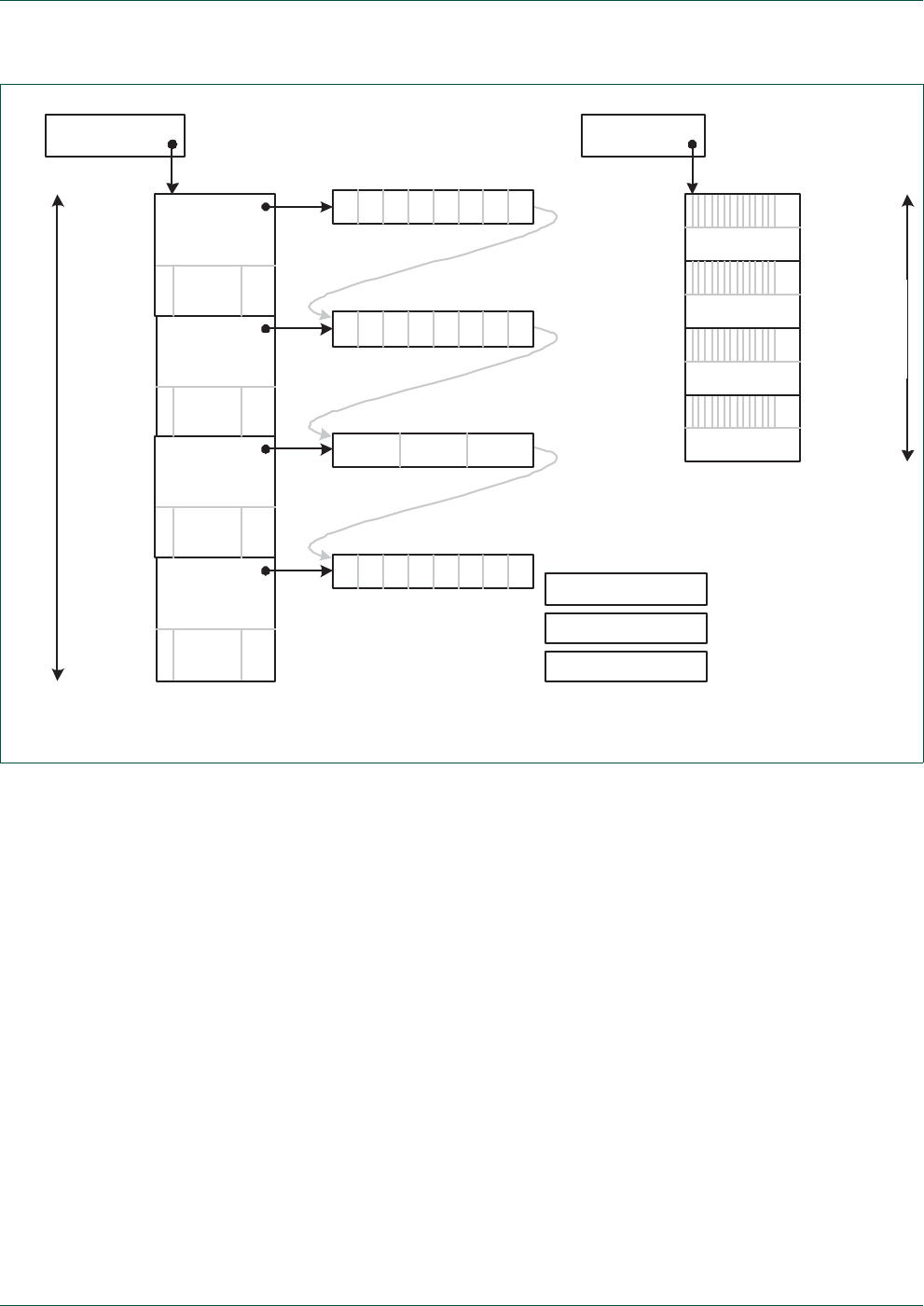
UM10360 All information provided in this document is subject to legal disclaimers. © NXP B.V. 2014. All rights reserved.
User manual Rev. 3.1 — 2 April 2014 201 of 849
NXP Semiconductors UM10360
Chapter 10: LPC176x/5x Ethernet
After reset, the values of the DMA registers will be zero. During initialization, the device
driver will allocate the descriptor and status array in memory. In this example, an array of
four descriptors is allocated; the array is 4x2x4 bytes and aligned on a 4 byte address
boundary. Since the number of descriptors matches the number of statuses, the status
array consists of four elements; the array is 4x2x4 bytes and aligned on a 8 byte address
boundary. The device driver writes the base address of the descriptor array
(0x2008 10EC) in the RxDescriptor register, and the base address of the status array
(0x2008 11F8) in the RxStatus register. The device driver writes the number of descriptors
and statuses minus 1 (3) in the RxDescriptorNumber register. The descriptors and
statuses in the arrays need not be initialized yet.
After allocating the descriptors, a fragment buffer needs to be allocated for each of the
descriptors. Each fragment buffer can be between 1 byte and 2 k bytes. The base
address of the fragment buffer is stored in the Packet field of the descriptors. The number
of bytes in the fragment buffer is stored in the Size field of the descriptor Control word.
The Interrupt field in the Control word of the descriptor can be set to generate an interrupt
as soon as the descriptor has been filled by the receive process. In this example the
fragment buffers are 8 bytes, so the value of the Size field in the Control word of the
descriptor is set to 7. Note that in this example, the fragment buffers are actually a
Fig 23. Receive Example Memory and Registers
PACKET
0x20081409
RxStatus
0x200811F8
RxDescriptor
0x200810EC
0x200810EC
0x200810F0
0x200810F4
0x200810F8
0x200810FC
0x20081100
0x20081104
0x20081108
0x200811F8
0x20081200
0x20081208
0x20081210
PACKET
0x20081411
PACKET
0x20081419
PACKET
0x20081325
descriptor array
De sc ript or 0Desc ript or 1Des cripto r 2De script or 3
descriptor array
fragment buffers
RxProduceIndex
RxConsumeIndex
RxDescriptorNumber = 3
Status 1 Status 0Status 3 Status 2
stat us array
status array
FRAGMENT 1 BUFFER (8 bytes)
FRAGMENT 0 BUFFER (8 bytes)
FRAGMENT 2 BUFFER (3 bytes)
FRAGMENT 3 BUFFER (8 bytes)
17CONTROL
17CONTROL
17
CONTROL
17
CONTROL
StatusInfo 7
StatusHashCRC
StatusInfo 7
StatusHashCRC
StatusInfo 7
StatusHashCRC
StatusInfo 2
StatusHashCRC
0x20081409
0x20081410
0x20081411
0x20081418
0x20081325
0x2008132C
0x20081419
0x2008141B

UM10360 All information provided in this document is subject to legal disclaimers. © NXP B.V. 2014. All rights reserved.
User manual Rev. 3.1 — 2 April 2014 202 of 849
NXP Semiconductors UM10360
Chapter 10: LPC176x/5x Ethernet
continuous memory space; even when a frame is distributed over multiple fragments it will
typically be in a linear, continuous memory space; when the descriptors wrap at the end of
the descriptor array the frame will not be in a continuous memory space.
The device driver should enable the receive process by writing a 1 to the RxEnable bit of
the Command register, after which the MAC needs to be enabled by writing a 1 to the
‘RECEIVE ENABLE’ bit of the MAC1 configuration register. The Ethernet block will now
start receiving Ethernet frames. To reduce the processor interrupt load, some interrupts
can be disabled by setting the relevant bits in the IntEnable register.
After the Rx DMA manager is enabled, it will start issuing descriptor read commands. In
this example the number of descriptors is 4. Initially the RxProduceIndex and
RxConsumeIndex are 0. Since the descriptor array is considered full if RxProduceIndex
== RxConsumeIndex - 1, the Rx DMA manager can only read (RxConsumeIndex -
RxProduceIndex - 1 =) 3 descriptors; note the wrapping.
After enabling the receive function in the MAC, data reception will begin starting at the
next frame i.e. if the receive function is enabled while the RMII interface is halfway
through receiving a frame, the frame will be discarded and reception will start at the next
frame. The Ethernet block will strip the preamble and start of frame delimiter from the
frame. If the frame passes the receive filtering, the Rx DMA manager will start writing the
frame to the first fragment buffer.
Suppose the frame is 19 bytes long. Due to the buffer sizes specified in this example, the
frame will be distributed over three fragment buffers. After writing the initial 8 bytes in the
first fragment buffer, the status for the first fragment buffer will be written and the Rx DMA
will continue filling the second fragment buffer. Since this is a multi-fragment receive, the
status of the first fragment will have a 0 for the LastFrag bit in the StatusInfo word; the
RxSize field will be set to 7 (8, -1 encoded). After writing the 8 bytes in the second
fragment the Rx DMA will continue writing the third fragment. The status of the second
fragment will be like the status of the first fragment: LastFrag = 0, RxSize = 7. After writing
the three bytes in the third fragment buffer, the end of the frame has been reached and the
status of the third fragment is written. The third fragment’s status will have the LastFrag bit
set to 1 and the RxSize equal to 2 (3, -1 encoded).
The next frame received from the RMII interface will be written to the fourth fragment
buffer i.e. five bytes of the third buffer will be unused.
The Rx DMA manager uses an internal tag protocol in the memory interface to check that
the receive data and status have been committed to memory. After the status of the
fragments are committed to memory, an RxDoneInt interrupt will be triggered, which
activates the device driver to inspect the status information. In this example, all
descriptors have the Interrupt bit set in the Control word i.e. all descriptors will generate
an interrupt after committing data and status to memory.
In this example the receive function cannot read new descriptors as long as the device
driver does not increment the RxConsumeIndex, because the descriptor array is full (even
though one descriptor is not programmed yet). Only after the device driver has forwarded
the receive data to application software, and after the device driver has updated the
RxConsumeIndex by incrementing it, will the Ethernet block can continue reading
descriptors and receive data. The device driver will probably increment the
RxConsumeIndex by 3, since the driver will forward the complete frame consisting of
three fragments to the application, and hence free up three descriptors at the same time.

UM10360 All information provided in this document is subject to legal disclaimers. © NXP B.V. 2014. All rights reserved.
User manual Rev. 3.1 — 2 April 2014 203 of 849
NXP Semiconductors UM10360
Chapter 10: LPC176x/5x Ethernet
Each four pairs of bits transferred on the RMII interface are transferred as a byte on the
data write interface after being delayed by 128 or 136 cycles for filtering by the receive
filter and buffer modules. The Ethernet block removes preamble, frame start delimiter, and
CRC from the data and checks the CRC. To limit the buffer NoDescriptor error probability,
three descriptors are buffered. The value of the RxProduceIndex is only updated after
status information has been committed to memory, which is checked by an internal tag
protocol in the memory interface. The software device driver will process the receive data,
after which the device driver will update the RxConsumeIndex.
10.17.5 Transmission retry
If a collision on the Ethernet occurs, it usually takes place during the collision window
spanning the first 64 bytes of a frame. If collision is detected, the Ethernet block will retry
the transmission. For this purpose, the first 64 bytes of a frame are buffered, so that this
data can be used during the retry. A transmission retry within the first 64 bytes in a frame
is fully transparent to the application and device driver software.
When a collision occurs outside of the 64 byte collision window, a LateCollision error is
triggered, and the transmission is aborted. After a LateCollision error, the remaining data
in the transmit frame will be discarded. The Ethernet block will set the Error and
LateCollision bits in the frame’s status fields. The TxError bit in the IntStatus register will
be set. If the corresponding bit in the IntEnable register is set, the TxError bit in the
IntStatus register will be propagated to the CPU (via the NVIC). The device driver software
should catch the interrupt and take appropriate actions.
The ‘RETRANSMISSION MAXIMUM’ field of the CLRT register can be used to configure
the maximum number of retries before aborting the transmission.
10.17.6 Status hash CRC calculations
For each received frame, the Ethernet block is able to detect the destination address and
source address and from them calculate the corresponding hash CRCs. To perform the
computation, the Ethernet block features two internal blocks: one is a controller
synchronized with the beginning and the end of each frame, the second block is the CRC
calculator.
When a new frame is detected, internal signaling notifies the controller.The controller
starts counting the incoming bytes of the frame, which correspond to the destination
address bytes. When the sixth (and last) byte is counted, the controller notifies the
calculator to store the corresponding 32-bit CRC into a first inner register. Then the
controller repeats counting the next incoming bytes, in order to get synchronized with the
source address. When the last byte of the source address is encountered, the controller
again notifies the CRC calculator, which freezes until the next new frame. When the
calculator receives this second notification, it stores the present 32-bit CRC into a second
inner register. Then the CRCs remain frozen in their own registers until new notifications
arise.
The destination address and source address hash CRCs being written in the
StatusHashCRC word are the nine most significant bits of the 32-bit CRCs as calculated
by the CRC calculator.

UM10360 All information provided in this document is subject to legal disclaimers. © NXP B.V. 2014. All rights reserved.
User manual Rev. 3.1 — 2 April 2014 204 of 849
NXP Semiconductors UM10360
Chapter 10: LPC176x/5x Ethernet
10.17.7 Duplex modes
The Ethernet block can operate in full duplex and half duplex mode. Half or full duplex
mode needs to be configured by the device driver software during initialization.
For a full duplex connection the FullDuplex bit of the Command register needs to be set to
1 and the FULL-DUPLEX bit of the MAC2 configuration register needs to be set to 1; for
half duplex the same bits need to be set to 0.
10.17.8 IEE 802.3/Clause 31 flow control
Overview
For full duplex connections, the Ethernet block supports IEEE 802.3/clause 31 flow control
using pause frames. This type of flow control may be used in full-duplex point-to-point
connections. Flow control allows a receiver to stall a transmitter e.g. when the receive
buffers are (almost) full. For this purpose, the receiving side sends a pause frame to the
transmitting side.
Pause frames use units of 512 bit times corresponding to 128 rx_clk/tx_clk cycles.
Receive flow control
In full-duplex mode, the Ethernet block will suspend its transmissions when the it receives
a pause frame. Rx flow control is initiated by the receiving side of the transmission. It is
enabled by setting the ‘RX FLOW CONTROL’ bit in the MAC1 configuration register. If the
RX FLOW CONTROL’ bit is zero, then the Ethernet block ignores received pause control
frames. When a pause frame is received on the Rx side of the Ethernet block,
transmission on the Tx side will be interrupted after the currently transmitting frame has
completed, for an amount of time as indicated in the received pause frame. The transmit
data path will stop transmitting data for the number of 512 bit slot times encoded in the
pause-timer field of the received pause control frame.
By default the received pause control frames are not forwarded to the device driver. To
forward the receive flow control frames to the device driver, set the ‘PASS ALL RECEIVE
FRAMES’ bit in the MAC1 configuration register.
Transmit flow control
If case device drivers need to stall the receive data e.g. because software buffers are full,
the Ethernet block can transmit pause control frames. Transmit flow control needs to be
initiated by the device driver software; there is no IEEE 802.3/31 flow control initiated by
hardware, such as the DMA managers.
With software flow control, the device driver can detect a situation in which the process of
receiving frames needs to be interrupted by sending out Tx pause frames. Note that due
to Ethernet delays, a few frames can still be received before the flow control takes effect
and the receive stream stops.
Transmit flow control is activated by writing 1 to the TxFlowControl bit of the Command
register. When the Ethernet block operates in full duplex mode, this will result in
transmission of IEEE 802.3/31 pause frames. The flow control continues until a 0 is
written to TxFlowControl bit of the Command register.

UM10360 All information provided in this document is subject to legal disclaimers. © NXP B.V. 2014. All rights reserved.
User manual Rev. 3.1 — 2 April 2014 205 of 849
NXP Semiconductors UM10360
Chapter 10: LPC176x/5x Ethernet
If the MAC is operating in full-duplex mode, then setting the TxFlowControl bit of the
Command register will start a pause frame transmission. The value inserted into the
pause-timer value field of transmitted pause frames is programmed via the
PauseTimer[15:0] bits in the FlowControlCounter register. When the TxFlowControl bit is
de-asserted, another pause frame having a pause-timer value of 0x0000 is automatically
sent to abort flow control and resume transmission.
When flow control be in force for an extended time, a sequence of pause frames must be
transmitted. This is supported with a mirror counter mechanism. To enable mirror
counting, a nonzero value is written to the MirrorCounter[15:0] bits in the
FlowControlCounter register. When the TxFlowControl bit is asserted, a pause frame is
transmitted. After sending the pause frame, an internal mirror counter is initialized to zero.
The internal mirror counter starts incrementing one every 512 bit-slot times. When the
internal mirror counter reaches the MirrorCounter value, another pause frame is
transmitted with pause-timer value equal to the PauseTimer field from the
FlowControlCounter register, the internal mirror counter is reset to zero and restarts
counting. The register MirrorCounter[15:0] is usually set to a smaller value than register
PauseTimer[15:0] to ensure an early expiration of the mirror counter, allowing time to send
a new pause frame before the transmission on the other side can resume. By continuing
to send pause frames before the transmitting side finishes counting the pause timer, the
pause can be extended as long as TxFlowControl is asserted. This continues until
TxFlowControl is de-asserted when a final pause frame having a pause-timer value of
0x0000 is automatically sent to abort flow control and resume transmission. To disable the
mirror counter mechanism, write the value 0 to MirrorCounter field in the
FlowControlCounter register. When using the mirror counter mechanism, account for
time-of-flight delays, frame transmission time, queuing delays, crystal frequency
tolerances, and response time delays by programming the MirrorCounter conservatively,
typically about 80% of the PauseTimer value.
If the software device driver sets the MirrorCounter field of the FlowControlCounter
register to zero, the Ethernet block will only send one pause control frame. After sending
the pause frame an internal pause counter is initialized at zero; the internal pause counter
is incremented by one every 512 bit-slot times. Once the internal pause counter reaches
the value of the PauseTimer register, the TxFlowControl bit in the Command register will
be reset. The software device driver can poll the TxFlowControl bit to detect when the
pause completes.
The value of the internal counter in the flow control module can be read out via the
FlowControlStatus register. If the MirrorCounter is nonzero, the FlowControlStatus register
will return the value of the internal mirror counter; if the MirrorCounter is zero the
FlowControlStatus register will return the value of the internal pause counter value.
The device driver is allowed to dynamically modify the MirrorCounter register value and
switch between zero MirrorCounter and nonzero MirrorCounter modes.
Transmit flow control is enabled via the ‘TX FLOW CONTROL’ bit in the MAC1
configuration register. If the ‘TX FLOW CONTROL’ bit is zero, then the MAC will not
transmit pause control frames, software must not initiate pause frame transmissions, and
the TxFlowControl bit in the Command register should be zero.
Transmit flow control example
Figure 24 illustrates the transmit flow control.
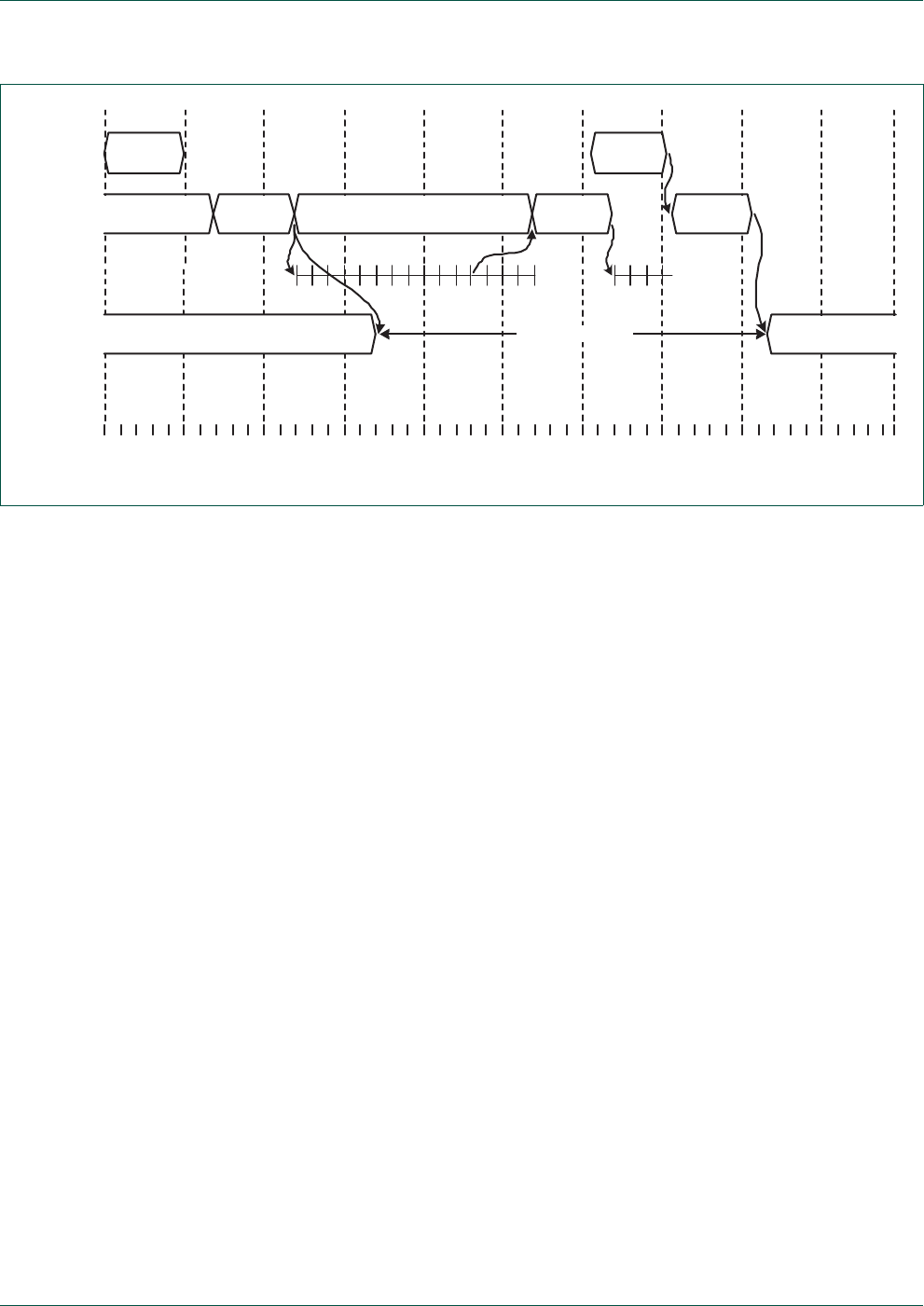
UM10360 All information provided in this document is subject to legal disclaimers. © NXP B.V. 2014. All rights reserved.
User manual Rev. 3.1 — 2 April 2014 206 of 849
NXP Semiconductors UM10360
Chapter 10: LPC176x/5x Ethernet
In this example, a frame is received while transmitting another frame (full duplex.) The
device driver detects that some buffer might overrun and enables the transmit flow control
by programming the PauseTimer and MirrorCounter fields of the FlowControlCounter
register, after which it enables the transmit flow control by setting the TxFlowControl bit in
the Command register.
As a response to the enabling of the flow control a pause control frame will be sent after
the currently transmitting frame has been transmitted. When the pause frame
transmission completes the internal mirror counter will start counting bit slots; as soon as
the counter reaches the value in the MirrorCounter field another pause frame is
transmitted. While counting the transmit data path will continue normal transmissions.
As soon as software disables transmit flow control a zero pause control frame is
transmitted to resume the receive process.
10.17.9 Half-Duplex mode backpressure
When in half-duplex mode, backpressure can be generated to stall receive packets by
sending continuous preamble that basically jams any other transmissions on the Ethernet
medium. When the Ethernet block operates in half duplex mode, asserting
the TxFlowControl bit in the Command register will result in applying continuous preamble
on the Ethernet wire, effectively blocking traffic from any other Ethernet station on the
same segment.
In half duplex mode, when the TxFlowControl bit goes high, continuous preamble is sent
until TxFlowControl is de-asserted. If the medium is idle, the Ethernet block begins
transmitting preamble, which raises carrier sense causing all other stations to defer. In the
event the transmitting of preamble causes a collision, the backpressure ‘rides through’ the
collision. The colliding station backs off and then defers to the backpressure. If during
backpressure, the user wishes to send a frame, the backpressure is interrupted, the frame
sent and then the backpressure resumed. If TxFlowControl is asserted for longer than
3.3 ms in 10 Mbps mode or 0.33 ms in 100 Mbps mode, backpressure will cease sending
preamble for several byte times to avoid the jabber limit.
Fig 24. Transmit Flow Control
MirrorCounter
(1/515 bit
slots)
4000 150 300200 45035025050 100 500
PauseTimer
MirrorCounter
TxFlowCtl
clear
TxFlowCtl
pause control
frame
transmission
pause control
frame
transmission
pause control
frame
transmission
normal transimisson
normal receive
normal
transmission
normal receive
RMII
receive
RMII
transmit
device driver
register
writes
pause in effect

UM10360 All information provided in this document is subject to legal disclaimers. © NXP B.V. 2014. All rights reserved.
User manual Rev. 3.1 — 2 April 2014 207 of 849
NXP Semiconductors UM10360
Chapter 10: LPC176x/5x Ethernet
10.17.10 Receive filtering
Features of receive filtering
The Ethernet MAC has several receive packet filtering functions that can be configured
from the software driver:
•Perfect address filter: allows packets with a perfectly matching station address to be
identified and passed to the software driver.
•Hash table filter: allows imperfect filtering of packets based on the station address.
•Unicast/multicast/broadcast filtering: allows passing of all unicast, multicast, and/or
broadcast packets.
•Magic packet filter: detection of magic packets to generate a Wake-on-LAN interrupt.
The filtering functions can be logically combined to create complex filtering functions.
Furthermore, the Ethernet block can pass or reject runt packets smaller than 64 bytes; a
promiscuous mode allows all packets to be passed to software.
Overview
The Ethernet block has the capability to filter out receive frames by analyzing the Ethernet
destination address in the frame. This capability greatly reduces the load on the host
system, because Ethernet frames that are addressed to other stations would otherwise
need to be inspected and rejected by the device driver software, using up bandwidth,
memory space, and host CPU time. Address filtering can be implemented using the
perfect address filter or the (imperfect) hash filter. The latter produces a 6-bit hash code
which can be used as an index into a 64 entry programmable hash table. Figure 25
depicts a functional view of the receive filter.
At the top of the diagram the Ethernet receive frame enters the filters. Each filter is
controlled by signals from control registers; each filter produces a ‘Ready’ output and a
‘Match’ output. If ‘Ready’ is 0 then the Match value is ‘don’t care’; if a filter finishes filtering
then it will assert its Ready output; if the filter finds a matching frame it will assert the
Match output along with the Ready output. The results of the filters are combined by logic
functions into a single RxAbort output. If the RxAbort output is asserted, the frame does
not need to be received.
In order to reduce memory traffic, the receive data path has a buffer of 68 bytes. The
Ethernet MAC will only start writing a frame to memory after 68 byte delays. If the RxAbort
signal is asserted during the initial 68 bytes of the frame, the frame can be discarded and
removed from the buffer and not stored to memory at all, not using up receive descriptors,
etc. If the RxAbort signal is asserted after the initial 68 bytes in a frame (probably due to
reception of a Magic Packet), part of the frame is already written to memory and the
Ethernet MAC will stop writing further data in the frame to memory; the FailFilter bit in the
status word of the frame will be set to indicate that the software device driver can discard
the frame immediately.
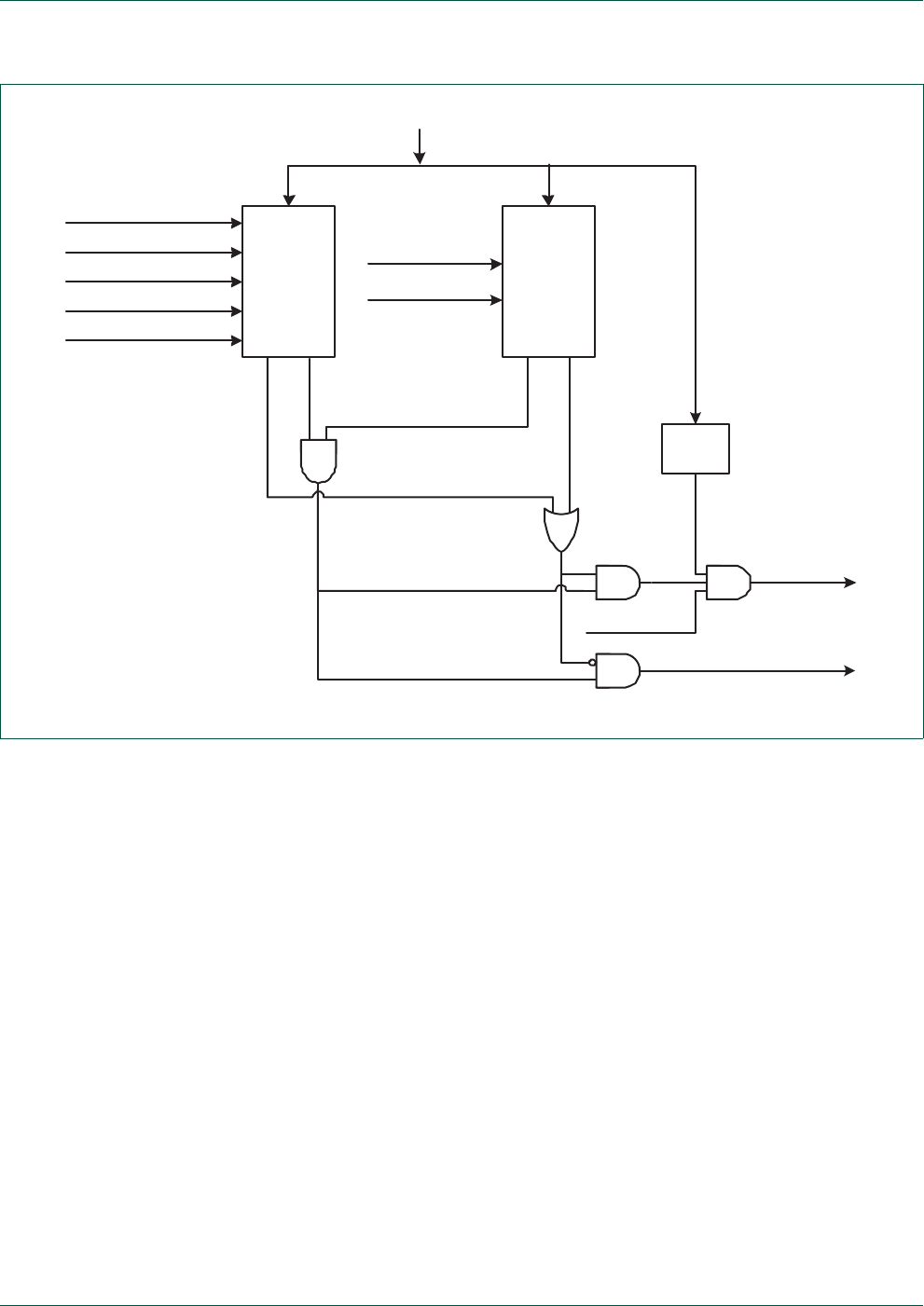
UM10360 All information provided in this document is subject to legal disclaimers. © NXP B.V. 2014. All rights reserved.
User manual Rev. 3.1 — 2 April 2014 208 of 849
NXP Semiconductors UM10360
Chapter 10: LPC176x/5x Ethernet
Unicast, broadcast and multicast
Generic filtering based on the type of frame (unicast, multicast or broadcast) can be
programmed using the AcceptUnicastEn, AcceptMulticastEn, or AcceptBroadcastEn bits
of the RxFilterCtrl register. Setting the AcceptUnicast, AcceptMulticast, and
AcceptBroadcast bits causes all frames of types unicast, multicast and broadcast,
respectively, to be accepted, ignoring the Ethernet destination address in the frame. To
program promiscuous mode, i.e. to accept all frames, set all 3 bits to 1.
Perfect address match
When a frame with a unicast destination address is received, a perfect filter compares the
destination address with the 6 byte station address programmed in the station address
registers SA0, SA1, SA2. If the AcceptPerfectEn bit in the RxFilterCtrl register is set to 1,
and the address matches, the frame is accepted.
Imperfect hash filtering
An imperfect filter is available, based on a hash mechanism. This filter applies a hash
function to the destination address and uses the hash to access a table that indicates if
the frame should be accepted. The advantage of this type of filter is that a small table can
cover any possible address. The disadvantage is that the filtering is imperfect, i.e.
sometimes frames are accepted that should have been discarded.
Fig 25. Receive filter block diagram
IMPERFECT
HASH
FILTER
AcceptUnicastEn
AcceptMulticastEn
AcceptMulticastHashEn
AcceptUnicastHashEn
HashFilter
PERFECT
ADDRESS
FILTER
packet
CRC
OK?
HFReady
HFMatch
PAReady
PAMatch
RxAbort
FReady
FMatch
RxFilterEnWoL
RxFilterWoL
StationAddress
AcceptPerfectEn

UM10360 All information provided in this document is subject to legal disclaimers. © NXP B.V. 2014. All rights reserved.
User manual Rev. 3.1 — 2 April 2014 209 of 849
NXP Semiconductors UM10360
Chapter 10: LPC176x/5x Ethernet
•Hash function:
–The standard Ethernet cyclic redundancy check (CRC) function is calculated from
the 6 byte destination address in the Ethernet frame (this CRC is calculated
anyway as part of calculating the CRC of the whole frame), then bits [28:23] out of
the 32-bit CRC result are taken to form the hash. The 6-bit hash is used to access
the hash table: it is used as an index in the 64-bit HashFilter register that has been
programmed with accept values. If the selected accept value is 1, the frame is
accepted.
–The device driver can initialize the hash filter table by writing to the registers
HashFilterL and HashfilterH. HashFilterL contains bits 0 through 31 of the table
and HashFilterH contains bit 32 through 63 of the table. So, hash value 0
corresponds to bit 0 of the HashfilterL register and hash value 63 corresponds to
bit 31 of the HashFilterH register.
•Multicast and unicast
–The imperfect hash filter can be applied to multicast addresses, by setting the
AcceptMulticastHashEn bit in the RxFilter register to 1.
–The same imperfect hash filter that is available for multicast addresses can also be
used for unicast addresses. This is useful to be able to respond to a multitude of
unicast addresses without enabling all unicast addresses. The hash filter can be
applied to unicast addresses by setting the AcceptUnicastHashEn bit in the
RxFilter register to 1.
Enabling and disabling filtering
The filters as defined in the sections above can be bypassed by setting the PassRxFilter
bit in the Command register. When the PassRxFilter bit is set, all receive frames will be
passed to memory. In this case the device driver software has to implement all filtering
functionality in software. Setting the PassRxFilter bit does not affect the runt frame filtering
as defined in the next section.
Runt frames
A frame with less than 64 bytes (or 68 bytes for VLAN frames) is shorter than the
minimum Ethernet frame size and therefore considered erroneous; they might be collision
fragments. The receive data path automatically filters and discards these runt frames
without writing them to memory and using a receive descriptor.
When a runt frame has a correct CRC there is a possibility that it is intended to be useful.
The device driver can receive the runt frames with correct CRC by setting the
PassRuntFrame bit of the Command register to 1.
10.17.11 Power management
The Ethernet block supports power management by means of clock switching. All clocks
in the Ethernet core can be switched off. If Wake-up on LAN is needed, the rx_clk should
not be switched off.
10.17.12 Wake-up on LAN
Overview

UM10360 All information provided in this document is subject to legal disclaimers. © NXP B.V. 2014. All rights reserved.
User manual Rev. 3.1 — 2 April 2014 210 of 849
NXP Semiconductors UM10360
Chapter 10: LPC176x/5x Ethernet
The Ethernet block supports power management with remote wake-up over LAN. The
host system can be powered down, even including part of the Ethernet block itself, while
the Ethernet block continues to listen to packets on the LAN. Appropriately formed
packets can be received and recognized by the Ethernet block and used to trigger the
host system to wake up from its power-down state.
Wake-up of the system takes effect through an interrupt. When a wake-up event is
detected, the WakeupInt bit in the IntStatus register is set. The interrupt status will trigger
an interrupt if the corresponding WakeupIntEn bit in the IntEnable register is set. This
interrupt should be used by system power management logic to wake up the system.
While in a power-down state the packet that generates a Wake-up on LAN event is lost.
There are two ways in which Ethernet packets can trigger wake-up events: generic
Wake-up on LAN and Magic Packet. Magic Packet filtering uses an additional filter for
Magic Packet detection. In both cases a Wake-up on LAN event is only triggered if the
triggering packet has a valid CRC. Figure 25 shows the generation of the wake-up signal.
The RxFilterWoLStatus register can be read by the software to inspect the reason for a
Wake-up event. Before going to power-down the power management software should
clear the register by writing the RxFilterWolClear register.
NOTE: when entering in power-down mode, a receive frame might be not entirely stored
into the Rx buffer. In this situation, after turning exiting power-down mode, the next
receive frame is corrupted due to the data of the previous frame being added in front of
the last received frame. Software drivers have to reset the receive data path just after
exiting power-down mode.
The following subsections describe the two Wake-up on LAN mechanisms.
Filtering for WoL
The receive filter functionality can be used to generate Wake-up on LAN events. If the
RxFilterEnWoL bit of the RxFilterCtrl register is set, the receive filter will set the WakeupInt
bit of the IntStatus register if a frame is received that passes the filter. The interrupt will
only be generated if the CRC of the frame is correct.
Magic Packet WoL
The Ethernet block supports wake-up using Magic Packet technology (see ‘Magic Packet
technology’, Advanced Micro Devices). A Magic Packet is a specially formed packet solely
intended for wake-up purposes. This packet can be received, analyzed and recognized by
the Ethernet block and used to trigger a wake-up event.
A Magic Packet is a packet that contains in its data portion the station address repeated
16 times with no breaks or interruptions, preceded by 6 Magic Packet synchronization
bytes with the value 0xFF. Other data may be surrounding the Magic Packet pattern in the
data portion of the packet. The whole packet must be a well-formed Ethernet frame.
The magic packet detection unit analyzes the Ethernet packets, extracts the packet
address and checks the payload for the Magic Packet pattern. The address from the
packet is used for matching the pattern (not the address in the SA0/1/2 registers.) A magic
packet only sets the wake-up interrupt status bit if the packet passes the receive filter as
illustrated in Figure 25: the result of the receive filter is ANDed with the magic packet filter
result to produce the result.

UM10360 All information provided in this document is subject to legal disclaimers. © NXP B.V. 2014. All rights reserved.
User manual Rev. 3.1 — 2 April 2014 211 of 849
NXP Semiconductors UM10360
Chapter 10: LPC176x/5x Ethernet
Magic Packet filtering is enabled by setting the MagicPacketEnWoL bit of the RxFilterCtrl
register. Note that when doing Magic Packet WoL, the RxFilterEnWoL bit in the
RxFilterCtrl register should be 0. Setting the RxFilterEnWoL bit to 1 would accept all
packets for a matching address, not just the Magic Packets i.e. WoL using Magic Packets
is more strict.
When a magic packet is detected, apart from the WakeupInt bit in the IntStatus register,
the MagicPacketWoL bit is set in the RxFilterWoLStatus register. Software can reset the
bit writing a 1 to the corresponding bit of the RxFilterWoLClear register.
Example: An example of a Magic Packet with station address 0x11 0x22 0x33 0x44 0x55
0x66 is the following (MISC indicates miscellaneous additional data bytes in the packet):
<DESTINATION> <SOURCE> <MISC>
FF FF FF FF FF FF
11 22 33 44 55 66 11 22 33 44 55 66
11 22 33 44 55 66 11 22 33 44 55 66
11 22 33 44 55 66 11 22 33 44 55 66
11 22 33 44 55 66 11 22 33 44 55 66
11 22 33 44 55 66 11 22 33 44 55 66
11 22 33 44 55 66 11 22 33 44 55 66
11 22 33 44 55 66 11 22 33 44 55 66
11 22 33 44 55 66 11 22 33 44 55 66
<MISC> <CRC>
10.17.13 Enabling and disabling receive and transmit
Enabling and disabling reception
After reset, the receive function of the Ethernet block is disabled. The receive function can
be enabled by the device driver setting the RxEnable bit in the Command register and the
“RECEIVE ENABLE’ bit in the MAC1 configuration register (in that order).
The status of the receive data path can be monitored by the device driver by reading the
RxStatus bit of the Status register. Figure 26 illustrates the state machine for the
generation of the RxStatus bit.

UM10360 All information provided in this document is subject to legal disclaimers. © NXP B.V. 2014. All rights reserved.
User manual Rev. 3.1 — 2 April 2014 212 of 849
NXP Semiconductors UM10360
Chapter 10: LPC176x/5x Ethernet
After a reset, the state machine is in the INACTIVE state. As soon as the RxEnable bit is
set in the Command register, the state machine transitions to the ACTIVE state. As soon
as the RxEnable bit is cleared, the state machine returns to the INACTIVE state. If the
receive data path is busy receiving a packet while the receive data path gets disabled, the
packet will be received completely, stored to memory along with its status before returning
to the INACTIVE state. Also if the Receive descriptor array is full, the state machine will
return to the INACTIVE state.
For the state machine in Figure 26, a soft reset is like a hardware reset assertion, i.e. after
a soft reset the receive data path is inactive until the data path is re-enabled.
Enabling and disabling transmission
After reset, the transmit function of the Ethernet block is disabled. The Tx transmit data
path can be enabled by the device driver setting the TxEnable bit in the Command
register to 1.
The status of the transmit data paths can be monitored by the device driver reading the
TxStatus bit of the Status register. Figure 27 illustrates the state machine for the
generation of the TxStatus bit.
Fig 26. Receive Active/Inactive state machine
ACTIVE
RxStatus = 1
INACTIVE
RxStatus = 0
RxEnable = 1
RxEnable = 0 and not busy receiving
OR
RxProduceIndex = RxConsumeIndex - 1
reset
xxxxxxxxxxxxxxxxxx

UM10360 All information provided in this document is subject to legal disclaimers. © NXP B.V. 2014. All rights reserved.
User manual Rev. 3.1 — 2 April 2014 213 of 849
NXP Semiconductors UM10360
Chapter 10: LPC176x/5x Ethernet
After reset, the state machine is in the INACTIVE state. As soon as the TxEnable bit is set
in the Command register and the Produce and Consume indices are not equal, the state
machine transitions to the ACTIVE state. As soon as the TxEnable bit is cleared and the
transmit data path has completed all pending transmissions, including committing the
transmission status to memory, the state machine returns to the INACTIVE state. The
state machine will also return to the INACTIVE state if the Produce and Consume indices
are equal again i.e. all frames have been transmitted.
For the state machine in Figure 27, a soft reset is like a hardware reset assertion, i.e. after
a soft reset the transmit data path is inactive until the data path is re-enabled.
10.17.14 Transmission padding and CRC
In the case of a frame of less than 60 bytes (or 64 bytes for VLAN frames), the Ethernet
block can pad the frame to 64 or 68 bytes including a 4 bytes CRC Frame Check
Sequence (FCS). Padding is affected by the value of the ‘AUTO DETECT PAD ENABLE’
(ADPEN), ‘VLAN PAD ENABLE’ (VLPEN) and ‘PAD/CRC ENABLE’ (PADEN) bits of the
MAC2 configuration register, as well as the Override and Pad bits from the transmit
descriptor Control word. CRC generation is affected by the ‘CRC ENABLE’ (CRCE) and
‘DELAYED CRC’ (DCRC) bits of the MAC2 configuration register, and the Override and
CRC bits from the transmit descriptor Control word.
The effective pad enable (EPADEN) is equal to the ‘PAD/CRC ENABLE’ bit from the
MAC2 register if the Override bit in the descriptor is 0. If the Override bit is 1, then
EPADEN will be taken from the descriptor Pad bit. Likewise the effective CRC enable
(ECRCE) equals CRCE if the Override bit is 0, otherwise it equal the CRC bit from the
descriptor.
If padding is required and enabled, a CRC will always be appended to the padded frames.
A CRC will only be appended to the non-padded frames if ECRCE is set.
If EPADEN is 0, the frame will not be padded and no CRC will be added unless ECRCE is
set.
Fig 27. Transmit Active/Inactive state machine
ACTIVE
TxStatus = 1
INACTIVE
TxStatus = 0
TxEnable = 1
AND
TxProduceIndex <> TxConsumeIndex
TxEnable = 0 and not busy transmitting
OR
TxProduceIndex = TxConsumeIndex
reset
xxxxxxxxxxxxxxxxxxxxxx

UM10360 All information provided in this document is subject to legal disclaimers. © NXP B.V. 2014. All rights reserved.
User manual Rev. 3.1 — 2 April 2014 214 of 849
NXP Semiconductors UM10360
Chapter 10: LPC176x/5x Ethernet
If EPADEN is 1, then small frames will be padded and a CRC will always be added to the
padded frames. In this case if ADPEN and VLPEN are both 0, then the frames will be
padded to 60 bytes and a CRC will be added creating 64 bytes frames; if VLPEN is 1, the
frames will be padded to 64 bytes and a CRC will be added creating 68 bytes frames; if
ADPEN is 1, while VLPEN is 0 VLAN frames will be padded to 64 bytes, non VLAN
frames will be padded to 60 bytes, and a CRC will be added to padded frames, creating
64 or 68 bytes padded frames.
If CRC generation is enabled, CRC generation can be delayed by four bytes by setting the
DELAYED CRC bit in the MAC2 register, in order to skip proprietary header information.
10.17.15 Huge frames and frame length checking
The ‘HUGE FRAME ENABLE’ bit in the MAC2 configuration register can be set to 1 to
enable transmission and reception of frames of any length. Huge frame transmission can
be enabled on a per frame basis by setting the Override and Huge bits in the transmit
descriptor Control word.
When enabling huge frames, the Ethernet block will not check frame lengths and report
frame length errors (RangeError and LengthError). If huge frames are enabled, the
received byte count in the RSV register may be invalid because the frame may exceed the
maximum size; the RxSize fields from the receive status arrays will be valid.
Frame lengths are checked by comparing the length/type field of the frame to the actual
number of bytes in the frame. A LengthError is reported by setting the corresponding bit in
the receive StatusInfo word.
The MAXF register allows the device driver to specify the maximum number of bytes in a
frame. The Ethernet block will compare the actual receive frame to the MAXF value and
report a RangeError in the receive StatusInfo word if the frame is larger.
10.17.16 Statistics counters
Generally, Ethernet applications maintain many counters that track Ethernet traffic
statistics. There are a number of standards specifying such counters, such as IEEE std
802.3 / clause 30. Other standards are RFC 2665 and RFC 2233.
The approach taken here is that by default all counters are implemented in software. With
the help of the StatusInfo field in frame statuses, many of the important statistics events
listed in the standards can be counted by software.
10.17.17 MAC status vectors
Transmit and receive status information as detected by the MAC are available in registers
TSV0, TSV1 and RSV so that software can poll them. These registers are normally of
limited use because the communication between driver software and the Ethernet block
takes place primarily through frame descriptors. Statistical events can be counted by
software in the device driver. However, for debug purposes the transmit and receive status
vectors are made visible. They are valid as long as the internal status of the MAC is valid
and should typically only be read when the transmit and receive processes are halted.

UM10360 All information provided in this document is subject to legal disclaimers. © NXP B.V. 2014. All rights reserved.
User manual Rev. 3.1 — 2 April 2014 215 of 849
NXP Semiconductors UM10360
Chapter 10: LPC176x/5x Ethernet
10.17.18 Reset
The Ethernet block has a hard reset input which is connected to the chip reset, as well as
several soft resets which can be activated by setting the appropriate bit(s) in registers. All
registers in the Ethernet block have a value of 0 after a hard reset, unless otherwise
specified.
Hard reset
After a hard reset, all registers will be set to their default value.
Soft reset
Parts of the Ethernet block can be soft reset by setting bits in the Command register and
the MAC1 configuration register.The MAC1 register has six different reset bits:
•SOFT RESET: Setting this bit will put all modules in the MAC in reset, except for the
MAC registers (at addresses 0x000 to 0x0FC). The value of the soft reset after a
hardware reset assertion is 1, i.e. the soft reset needs to be cleared after a hardware
reset.
•SIMULATION RESET: Resets the random number generator in the Transmit
Function. The value after a hardware reset assertion is 0.
•RESET MCS/Rx: Setting this bit will reset the MAC Control Sublayer (pause frame
logic) and the receive function in the MAC. The value after a hardware reset assertion
is 0.
•RESET Rx: Setting this bit will reset the receive function in the MAC. The value after a
hardware reset assertion is 0.
•RESET MCS/Tx: Setting this bit will reset the MAC Control Sublayer (pause frame
logic) and the transmit function in the MAC. The value after a hardware reset
assertion is 0.
•RESET Tx: Setting this bit will reset the transmit function of the MAC. The value after
a hardware reset assertion is 0.
The above reset bits must be cleared by software.
The Command register has three different reset bits:
•TxReset: Writing a ‘1’ to the TxReset bit will reset the transmit data path, excluding the
MAC portions, including all (read-only) registers in the transmit data path, as well as
the TxProduceIndex register in the host registers module. A soft reset of the transmit
data path will abort all AHB transactions of the transmit data path. The reset bit will be
cleared autonomously by the Ethernet block. A soft reset of the Tx data path will clear
the TxStatus bit in the Status register.
•RxReset: Writing a ‘1’ to the RxReset bit will reset the receive data path, excluding the
MAC portions, including all (read-only) registers in the receive data path, as well as
the RxConsumeIndex register in the host registers module. A soft reset of the receive
data path will abort all AHB transactions of the receive data path. The reset bit will be
cleared autonomously by the Ethernet block. A soft reset of the Rx data path will clear
the RxStatus bit in the Status register.

UM10360 All information provided in this document is subject to legal disclaimers. © NXP B.V. 2014. All rights reserved.
User manual Rev. 3.1 — 2 April 2014 216 of 849
NXP Semiconductors UM10360
Chapter 10: LPC176x/5x Ethernet
•RegReset: Resets all of the data paths and registers in the host registers module,
excluding the registers in the MAC. A soft reset of the registers will also abort all AHB
transactions of the transmit and receive data path. The reset bit will be cleared
autonomously by the Ethernet block.
To d o a ful l s o ft res e t of th e Et h ern e t block, device driver software must:
•Set the ‘SOFT RESET’ bit in the MAC1 register to 1.
•Set the RegReset bit in the Command register, this bit clears automatically.
•Re-initialize the MAC registers (0x000 to 0x0FC).
•Reset the ‘SOFT RESET’ bit in the MAC1 register to 0.
To reset just the transmit data path, the device driver software has to:
•Set the ‘RESET MCS/Tx’ bit in the MAC1 register to 1.
•Disable the Tx DMA managers by setting the TxEnable bits in the Command register
to 0.
•Set the TxReset bit in the Command register, this bit clears automatically.
•Reset the ‘RESET MCS/Tx’ bit in the MAC1 register to 0.
To r es et jus t th e re c e iv e da ta pa t h, t he d evi c e d r ive r so ft w ar e h a s t o:
•Disable the receive function by resetting the ‘RECEIVE ENABLE’ bit in the MAC1
configuration register and resetting of the RxEnable bit of the Command register.
•Set the ‘RESET MCS/Rx’ bit in the MAC1 register to 1.
•Set the RxReset bit in the Command register, this bit clears automatically.
•Reset the ‘RESET MCS/Rx’ bit in the MAC1 register to 0.
10.17.19 Ethernet errors
The Ethernet block generates errors for the following conditions:
•A reception can cause an error: AlignmentError, RangeError, LengthError,
SymbolError, CRCError, NoDescriptor, or Overrun. These are reported back in the
receive StatusInfo and in the interrupt status register (IntStatus).
•A transmission can cause an error: LateCollision, ExcessiveCollision,
ExcessiveDefer, NoDescriptor, or Underrun. These are reported back in the
transmission StatusInfo and in the interrupt status register (IntStatus).

UM10360 All information provided in this document is subject to legal disclaimers. © NXP B.V. 2014. All rights reserved.
User manual Rev. 3.1 — 2 April 2014 217 of 849
NXP Semiconductors UM10360
Chapter 10: LPC176x/5x Ethernet
10.18 AHB bandwidth
The Ethernet block is connected to an AHB bus which must carry all of the data and
control information associated with all Ethernet traffic in addition to the CPU accesses
required to operate the Ethernet block and deal with message contents.
10.18.1 DMA access
Assumptions
By making some assumptions, the bandwidth needed for each type of AHB transfer can
be calculated and added in order to find the overall bandwidth requirement.
The flexibility of the descriptors used in the Ethernet block allows the possibility of defining
memory buffers in a range of sizes. In order to analyze bus bandwidth requirements,
some assumptions must be made about these buffers. The "worst case" is not addressed
since that would involve all descriptors pointing to single byte buffers, with most of the
memory occupied in holding descriptors and very little data. It can easily be shown that
the AHB cannot handle the huge amount of bus traffic that would be caused by such a
degenerate (and illogical) case.
For this analysis, an Ethernet packet is assumed to consist of a 64 byte frame.
Continuous traffic is assumed on both the transmit and receive channels.
This analysis does not reflect the flow of Ethernet traffic over time, which would include
inter-packet gaps in both the transmit and receive channels that reduce the bandwidth
requirements over a larger time frame.
Types of DMA access and their bandwidth requirements
The interface to an external Ethernet PHY is via RMII. RMII operates at 50 MHz,
transferring a byte in 4 clock cycles. The data transfer rate is 12.5 Mbps.
The Ethernet block initiates DMA accesses for the following cases:
•Tx descriptor read:
–Transmit descriptors occupy 2 words (8 bytes) of memory and are read once for
each use of a descriptor.
–Two word read happens once every 64 bytes (16 words) of transmitted data.
–This gives 1/8th of the data rate, which = 1.5625 Mbps.
•Rx descriptor read:
–Receive descriptors occupy 2 words (8 bytes) of memory and are read once for
each use of a descriptor.
–Two word read happens once every 64 bytes (16 words) of received data.
–This gives 1/8th of the data rate, which = 1.5625 Mbps.
•Tx status write:
–Transmit status occupies 1 word (4 bytes) of memory and is written once for each
use of a descriptor.
–One word write happens once every 64 bytes (16 words) of transmitted data.
–This gives 1/16th of the data rate, which = 0.7813 Mbps.

UM10360 All information provided in this document is subject to legal disclaimers. © NXP B.V. 2014. All rights reserved.
User manual Rev. 3.1 — 2 April 2014 218 of 849
NXP Semiconductors UM10360
Chapter 10: LPC176x/5x Ethernet
•Rx status write:
–Receive status occupies 2 words (8 bytes) of memory and is written once for each
use of a descriptor.
–Two word write happens once every 64 bytes (16 words) of received data.
–This gives 1/8 of the data rate, which = 1.5625 Mbps.
•Tx data read:
–Data transmitted in an Ethernet frame, the size is variable.
–Basic Ethernet rate = 12.5 Mbps.
•Rx data write:
–Data to be received in an Ethernet frame, the size is variable.
–Basic Ethernet rate = 12.5 Mbps.
This gives a total rate of 30.5 Mbps for the traffic generated by the Ethernet DMA function.
10.18.2 Types of CPU access
•Accesses that mirror each of the DMA access types:
–All or part of status values must be read, and all or part of descriptors need to be
written after each use, transmitted data must be stored in the memory by the CPU,
and eventually received data must be retrieved from the memory by the CPU.
–This gives roughly the same or slightly lower rate as the combined DMA functions,
which = 30.5 Mbps.
•Access to registers in the Ethernet block:
–The CPU must read the RxProduceIndex, TxConsumeIndex, and IntStatus
registers, and both read and write the RxConsumeIndex and TxProduceIndex
registers.
–7 word read/writes once every 64 bytes (16 words) of transmitted and received
data.
–This gives 7/16 of the data rate, which = 5.4688 Mbps.
This gives a total rate of 36 Mbps for the traffic generated by the Ethernet DMA function.
10.18.3 Overall bandwidth
Overall traffic on the AHB is the sum of DMA access rates and CPU access rates, which
comes to approximately 66.5 MB/s.
The peak bandwidth requirement can be somewhat higher due to the use of small
memory buffers, in order to hold often used addresses (e.g. the station address) for
example. Driver software can determine how to build frames in an efficient manner that
does not overutilize the AHB.
The bandwidth available on the AHB bus depends on the system clock frequency. As an
example, assume that the system clock is set at 60 MHz. All or nearly all of bus accesses
related to the Ethernet will be word transfers. The raw AHB bandwidth can be
approximated as 4 bytes per two system clocks, which equals 2 times the system clock
rate. With a 60 MHz system clock, the bandwidth is 120 MB/s, giving about 55% utilization

UM10360 All information provided in this document is subject to legal disclaimers. © NXP B.V. 2014. All rights reserved.
User manual Rev. 3.1 — 2 April 2014 219 of 849
NXP Semiconductors UM10360
Chapter 10: LPC176x/5x Ethernet
for Ethernet traffic during simultaneous transmit and receive operations. This shows that it
is not necessary to use the maximum CPU frequency for the Ethernet to work with plenty
of bandwidth headroom.

UM10360 All information provided in this document is subject to legal disclaimers. © NXP B.V. 2014. All rights reserved.
User manual Rev. 3.1 — 2 April 2014 220 of 849
NXP Semiconductors UM10360
Chapter 10: LPC176x/5x Ethernet
10.19 CRC calculation
The calculation is used for several purposes:
•Generation the FCS at the end of the Ethernet frame.
•Generation of the hash table index for the hash table filtering.
•Generation of the destination and source address hash CRCs.
The C pseudocode function below calculates the CRC on a frame taking the frame
(without FCS) and the number of bytes in the frame as arguments. The function returns
the CRC as a 32-bit integer.
int crc_calc(char frame_no_fcs[], int frame_len) {
int i; // iterator
int j; // another iterator
char byte; // current byte
int crc; // CRC result
int q0, q1, q2, q3; // temporary variables
crc = 0xFFFFFFFF;
for (i = 0; i < frame_len; i++) {
byte = *frame_no_fcs++;
for (j = 0; j < 2; j++) {
if (((crc >> 28) ^ (byte >> 3)) & 0x00000001) {
q3 = 0x04C11DB7;
} else {
q3 = 0x00000000;
}
if (((crc >> 29) ^ (byte >> 2)) & 0x00000001) {
q2 = 0x09823B6E;
} else {
q2 = 0x00000000;
}
if (((crc >> 30) ^ (byte >> 1)) & 0x00000001) {
q1 = 0x130476DC;
} else {
q1 = 0x00000000;
}
if (((crc >> 31) ^ (byte >> 0)) & 0x00000001) {
q0 = 0x2608EDB8;
} else {
q0 = 0x00000000;
}
crc = (crc << 4) ^ q3 ^ q2 ^ q1 ^ q0;
byte >>= 4;
}
}
return crc;
}
For FCS calculation, this function is passed a pointer to the first byte of the frame and the
length of the frame without the FCS.

UM10360 All information provided in this document is subject to legal disclaimers. © NXP B.V. 2014. All rights reserved.
User manual Rev. 3.1 — 2 April 2014 221 of 849
NXP Semiconductors UM10360
Chapter 10: LPC176x/5x Ethernet
For hash filtering, this function is passed a pointer to the destination address part of the
frame and the CRC is only calculated on the 6 address bytes. The hash filter uses bits
[28:23] for indexing the 64-bits { HashFilterH, HashFilterL } vector. If the corresponding bit
is set the packet is passed, otherwise it is rejected by the hash filter.
For obtaining the destination and source address hash CRCs, this function calculates first
both the 32-bit CRCs, then the nine most significant bits from each 32-bit CRC are
extracted, concatenated, and written in every StatusHashCRC word of every fragment
status.

UM10360 All information provided in this document is subject to legal disclaimers. © NXP B.V. 2014. All rights reserved.
User manual Rev. 3.1 — 2 April 2014 222 of 849
11.1 How to read this chapter
This chapter describes the USB controller which is present on all LPC176x/5x devices
except the LPC1767. On some LPC176x/5x family devices, the USB controller can also
be configured for Host or OTG operation.
11.2 Basic configuration
The USB controller is configured using the following registers:
1. Power: In the PCONP register (Ta b le 46 ), set bit PCUSB.
Remark: On reset, the USB block is disabled (PCUSB = 0).
2. Clock: The USB block can be used with a dedicated USB PLL (PLL1) to obtain the
USB clock or with the Main PLL (PLL0). See Section 4.6.1.
3. Pins: Select USB pins and their modes in PINSEL0 to PINSEL5 and PINMODE0 to
PINMODE5 (Section 8.5).
4. Wake-up: Activity on the USB bus port can wake up the microcontroller from
Power-down mode, see Section 4.8.8.
5. Interrupts: Interrupts are enabled in the NVIC using the appropriate Interrupt Set
Enable register.
6. Initialization: see Section 11.13.
11.3 Introduction
The Universal Serial Bus (USB) is a four-wire bus that supports communication between a
host and one or more (up to 127) peripherals. The host controller allocates the USB
bandwidth to attached devices through a token-based protocol. The bus supports hot
plugging and dynamic configuration of the devices. All transactions are initiated by the
host controller.
The host schedules transactions in 1 ms frames. Each frame contains a Start-Of-Frame
(SOF) marker and transactions that transfer data to or from device endpoints. Each device
can have a maximum of 16 logical or 32 physical endpoints. There are four types of
transfers defined for the endpoints. Control transfers are used to configure the device.
Interrupt transfers are used for periodic data transfer. Bulk transfers are used when the
rate of transfer is not critical. Isochronous transfers have guaranteed delivery time but no
error correction.
For more information on the Universal Serial Bus, see the USB Implementers Forum
website.
The USB device controller on the LPC176x/5x enables full-speed (12 Mb/s) data
exchange with a USB host controller.
UM10360
Chapter 11: LPC176x/5x USB device controller
Rev. 3.1 — 2 April 2014 User manual

UM10360 All information provided in this document is subject to legal disclaimers. © NXP B.V. 2014. All rights reserved.
User manual Rev. 3.1 — 2 April 2014 223 of 849
NXP Semiconductors UM10360
Chapter 11: LPC176x/5x USB device controller
11.4 Features
•Fully compliant with the USB 2.0 specification (full speed).
•Supports 32 physical (16 logical) endpoints.
•Supports Control, Bulk, Interrupt and Isochronous endpoints.
•Scalable realization of endpoints at run time.
•Endpoint maximum packet size selection (up to USB maximum specification) by
software at run time.
•Supports SoftConnect and GoodLink features.
•Supports DMA transfers on all non-control endpoints.
•Allows dynamic switching between CPU controlled and DMA modes.
•Double buffer implementation for Bulk and Isochronous endpoints.
11.5 Fixed endpoint configuration
Tab l e 1 86 shows the supported endpoint configurations. Endpoints are realized and
configured at run time using the Endpoint realization registers, documented in
Section 11.10.4 “Endpoint realization registers”.
Table 185. USB related acronyms, abbreviations, and definitions used in this chapter
Acronym/abbreviation Description
AHB Advanced High-performance bus
ATLE Auto Transfer Length Extraction
ATX Analog Transceiver
DD DMA Descriptor
DDP DMA Description Pointer
DMA Direct Memory Access
EOP End-Of-Packet
EP Endpoint
EP_RAM Endpoint RAM
FS Full Speed
LED Light Emitting Diode
LS Low Speed
MPS Maximum Packet Size
NAK Negative Acknowledge
PLL Phase Locked Loop
RAM Random Access Memory
SOF Start-Of-Frame
SIE Serial Interface Engine
SRAM Synchronous RAM
UDCA USB Device Communication Area
USB Universal Serial Bus

UM10360 All information provided in this document is subject to legal disclaimers. © NXP B.V. 2014. All rights reserved.
User manual Rev. 3.1 — 2 April 2014 224 of 849
NXP Semiconductors UM10360
Chapter 11: LPC176x/5x USB device controller
11.6 Functional description
The architecture of the USB device controller is shown below in Figure 28.
Table 186. Fixed endpoint configuration
Logical
endpoint
Physical
endpoint
Endpoint type Direction Packet size (bytes) Double buffer
00Control Out 8, 16, 32, 64 No
01Control In 8, 16, 32, 64 No
1 2 Interrupt Out 1 to 64 No
1 3 Interrupt In 1 to 64 No
2 4 Bulk Out 8, 16, 32, 64 Yes
2 5 Bulk In 8, 16, 32, 64 Yes
3 6 Isochronous Out 1 to 1023 Yes
3 7 Isochronous In 1 to 1023 Yes
4 8 Interrupt Out 1 to 64 No
4 9 Interrupt In 1 to 64 No
510 Bulk Out 8, 16, 32, 64 Yes
511 Bulk In 8, 16, 32, 64 Yes
612 Isochronous Out 1 to 1023 Yes
613 Isochronous In 1 to 1023 Yes
714 Interrupt Out 1 to 64 No
715 Interrupt In 1 to 64 No
816 Bulk Out 8, 16, 32, 64 Yes
817 Bulk In 8, 16, 32, 64 Yes
918 Isochronous Out 1 to 1023 Yes
919 Isochronous In 1 to 1023 Yes
10 20 Interrupt Out 1 to 64 No
10 21 Interrupt In 1 to 64 No
11 22 Bulk Out 8, 16, 32, 64 Yes
11 23 Bulk In 8, 16, 32, 64 Yes
12 24 Isochronous Out 1 to 1023 Yes
12 25 Isochronous In 1 to 1023 Yes
13 26 Interrupt Out 1 to 64 No
13 27 Interrupt In 1 to 64 No
14 28 Bulk Out 8, 16, 32, 64 Yes
14 29 Bulk In 8, 16, 32, 64 Yes
15 30 Bulk Out 8, 16, 32, 64 Yes
15 31 Bulk In 8, 16, 32, 64 Yes
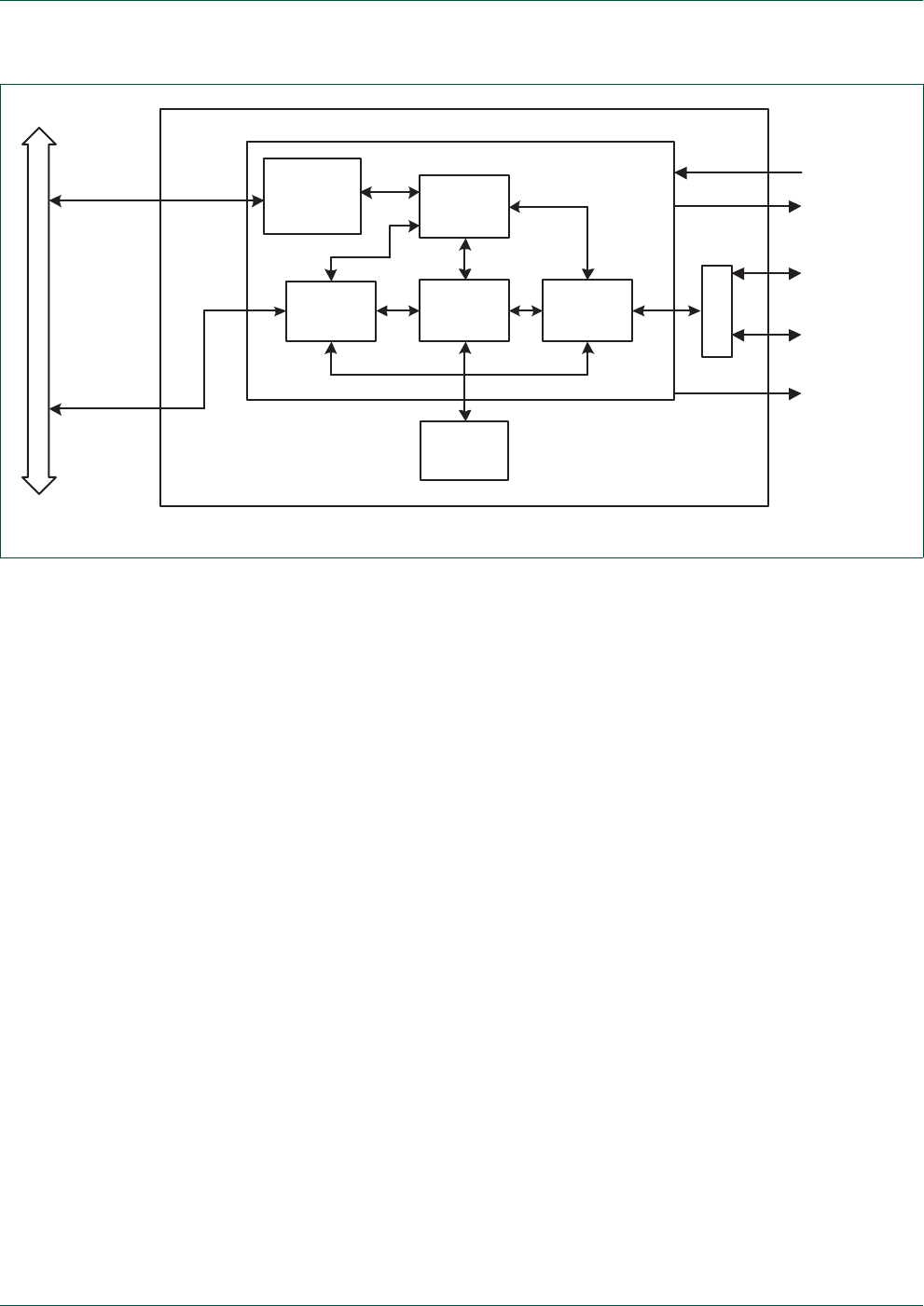
UM10360 All information provided in this document is subject to legal disclaimers. © NXP B.V. 2014. All rights reserved.
User manual Rev. 3.1 — 2 April 2014 225 of 849
NXP Semiconductors UM10360
Chapter 11: LPC176x/5x USB device controller
11.6.1 Analog transceiver
The USB Device Controller has a built-in analog transceiver (ATX). The USB ATX
sends/receives the bi-directional D+ and D- signals of the USB bus.
11.6.2 Serial Interface Engine (SIE)
The SIE implements the full USB protocol layer. It is completely hardwired for speed and
needs no firmware intervention. It handles transfer of data between the endpoint buffers in
EP_RAM and the USB bus. The functions of this block include: synchronization pattern
recognition, parallel/serial conversion, bit stuffing/de-stuffing, CRC checking/generation,
PID verification/generation, address recognition, and handshake evaluation/generation.
11.6.3 Endpoint RAM (EP_RAM)
Each endpoint buffer is implemented as an SRAM based FIFO. The SRAM dedicated for
this purpose is called the EP_RAM. Each realized endpoint has a reserved space in the
EP_RAM. The total EP_RAM space required depends on the number of realized
endpoints, the maximum packet size of the endpoint, and whether the endpoint supports
double buffering.
11.6.4 EP_RAM access control
The EP_RAM Access Control logic handles transfer of data from/to the EP_RAM and the
three sources that can access it: the CPU (via the Register Interface), the SIE, and the
DMA Engine.
Fig 28. USB device controller block diagram
register
interface
(AHB slave)
DMA interface
(AHB master)
EP_RAM
(4K)
EP_RAM
ACCESS
CONTROL
REGISTER
INTERFACE
SERIAL
INTERFACE
ENGINE
DMA
ENGINE
USB DEVICE
BLOCK
USB ATX
BUS
MASTER
INTERFACE
AHB BUS
VBUS
USB_CONNECT
USB_D+
USB_D-
USB_UP_LED

UM10360 All information provided in this document is subject to legal disclaimers. © NXP B.V. 2014. All rights reserved.
User manual Rev. 3.1 — 2 April 2014 226 of 849
NXP Semiconductors UM10360
Chapter 11: LPC176x/5x USB device controller
11.6.5 DMA engine and bus master interface
When enabled for an endpoint, the DMA Engine transfers data between RAM on the AHB
bus and the endpoint’s buffer in EP_RAM. A single DMA channel is shared between all
endpoints. When transferring data, the DMA Engine functions as a master on the AHB
bus through the bus master interface.
11.6.6 Register interface
The Register Interface allows the CPU to control the operation of the USB Device
Controller. It also provides a way to write transmit data to the controller and read receive
data from the controller.
11.6.7 SoftConnect
The connection to the USB is accomplished by bringing D+ (for a full-speed device) HIGH
through a 1.5 kOhm pull-up resistor. The SoftConnect feature can be used to allow
software to finish its initialization sequence before deciding to establish connection to the
USB. Re-initialization of the USB bus connection can also be performed without having to
unplug the cable.
To use the SoftConnect feature, the CONNECT signal should control an external switch
that connects the 1.5 kOhm resistor between D+ and +3.3V. Software can then control the
CONNECT signal by writing to the CON bit using the SIE Set Device Status command.
11.6.8 GoodLink
Good USB connection indication is provided through GoodLink technology. When the
device is successfully enumerated and configured, the LED indicator will be permanently
ON. During suspend, the LED will be OFF.
This feature provides a user-friendly indicator on the status of the USB device. It is a
useful field diagnostics tool to isolate faulty equipment.
To use the GoodLink feature the UP_LED signal should control an LED. The UP_LED
signal is controlled using the SIE Configure Device command.
11.7 Operational overview
Transactions on the USB bus transfer data between device endpoints and the host. The
direction of a transaction is defined with respect to the host. OUT transactions transfer
data from the host to the device. IN transactions transfer data from the device to the host.
All transactions are initiated by the host controller.
For an OUT transaction, the USB ATX receives the bi-directional D+ and D- signals of the
USB bus. The Serial Interface Engine (SIE) receives the serial data from the ATX and
converts it into a parallel data stream. The parallel data is written to the corresponding
endpoint buffer in the EP_RAM.
For IN transactions, the SIE reads the parallel data from the endpoint buffer in EP_RAM,
converts it into serial data, and transmits it onto the USB bus using the USB ATX.

UM10360 All information provided in this document is subject to legal disclaimers. © NXP B.V. 2014. All rights reserved.
User manual Rev. 3.1 — 2 April 2014 227 of 849
NXP Semiconductors UM10360
Chapter 11: LPC176x/5x USB device controller
Once data has been received or sent, the endpoint buffer can be read or written. How this
is accomplished depends on the endpoint’s type and operating mode. The two operating
modes for each endpoint are Slave (CPU-controlled) mode, and DMA mode.
In Slave mode, the CPU transfers data between RAM and the endpoint buffer using the
Register Interface. See Section 11.14 “Slave mode operation” for a detailed description of
this mode.
In DMA mode, the DMA transfers data between RAM and the endpoint buffer. See
Section 11.15 “DMA operation” for a detailed description of this mode.
11.8 Pin description
11.9 Clocking and power management
This section describes the clocking and power management features of the USB Device
Controller.
11.9.1 Power requirements
The USB protocol insists on power management by the device. This becomes very critical
if the device draws power from the bus (bus-powered device). The following constraints
should be met by a bus-powered device:
1. A device in the non-configured state should draw a maximum of 100 mA from the bus.
2. A configured device can draw only up to what is specified in the Max Power field of
the configuration descriptor. The maximum value is 500 mA.
3. A suspended device can draw a maximum of 2.5 mA.
11.9.2 Clocks
The USB device controller clocks are shown in Tab le 1 88
Table 187. USB external interface
Name Direction Description
VBUS IV
BUS status input. When this function is not enabled
via its corresponding PINSEL register, it is driven
HIGH internally.
USB_CONNECT O SoftConnect control signal.
USB_UP_LED O GoodLink LED control signal.
USB_D+ I/O Positive differential data.
USB_D- I/O Negative differential data.

UM10360 All information provided in this document is subject to legal disclaimers. © NXP B.V. 2014. All rights reserved.
User manual Rev. 3.1 — 2 April 2014 228 of 849
NXP Semiconductors UM10360
Chapter 11: LPC176x/5x USB device controller
11.9.3 Power management support
To help conserve power, the USB device controller automatically disables the AHB master
clock and usbclk when not in use.
When the USB Device Controller goes into the suspend state (bus is idle for 3 ms), the
usbclk input to the device controller is automatically disabled, helping to conserve power.
However, if software wishes to access the device controller registers, usbclk must be
active. To allow access to the device controller registers while in the suspend state, the
USBClkCtrl and USBClkSt registers are provided.
When software wishes to access the device controller registers, it should first ensure
usbclk is enabled by setting DEV_CLK_EN in the USBClkCtrl register, and then poll the
corresponding DEV_CLK_ON bit in USBClkSt until set. Once set, usbclk will remain
enabled until DEV_CLK_EN is cleared by software.
When a DMA transfer occurs, the device controller automatically turns on the AHB master
clock. Once asserted, it remains active for a minimum of 2 ms (2 frames), to help ensure
that DMA throughput is not affected by turning off the AHB master clock. 2 ms after the
last DMA access, the AHB master clock is automatically disabled to help conserve power.
If desired, software also has the capability of forcing this clock to remain enabled using the
USBClkCtrl register.
Note that the AHB slave clock is always enabled as long as the PCUSB bit of PCONP is
set. When the device controller is not in use, all of the device controller clocks may be
disabled by clearing PCUSB.
The USB_NEED_CLK signal is used to facilitate going into and waking up from chip
Power-down mode. USB_NEED_CLK is asserted if any of the bits of the USBClkSt
register are asserted.
After entering the suspend state with DEV_CLK_EN and AHB_CLK_EN cleared, the
DEV_CLK_ON and AHB_CLK_ON will be cleared when the corresponding clock turns off.
When both bits are zero, USB_NEED_CLK will be low, indicating that the chip can be put
into Power-down mode by writing to the PCON register. The status of USB_NEED_CLK
can be read from the USBIntSt register.
Any bus activity in the suspend state will cause the USB_NEED_CLK signal to be
asserted. When the chip is in Power-down mode and the USB interrupt is enabled, the
assertion of USB_NEED_CLK causes the chip to wake up from Power-down mode.
Table 188. USB device controller clock sources
Clock source Description
AHB master clock Clock for the AHB master bus interface and DMA
AHB slave clock Clock for the AHB slave interface
usbclk 48 MHz clock from the dedicated USB PLL (PLL1) or the Main PLL (PLL0),
used to recover the 12 MHz clock from the USB bus

UM10360 All information provided in this document is subject to legal disclaimers. © NXP B.V. 2014. All rights reserved.
User manual Rev. 3.1 — 2 April 2014 229 of 849
NXP Semiconductors UM10360
Chapter 11: LPC176x/5x USB device controller
11.9.4 Remote wake-up
The USB device controller supports software initiated remote wake-up. Remote wake-up
involves resume signaling on the USB bus initiated from the device. This is done by
clearing the SUS bit in the SIE Set Device Status register. Before writing into the register,
all the clocks to the device controller have to be enabled using the USBClkCtrl register.
11.10 Register description
Tab l e 1 89 shows the USB Device Controller registers directly accessible by the CPU. The
Serial Interface Engine (SIE) has other registers that are indirectly accessible via the SIE
command registers. See Section 11.12 “Serial interface engine command description” for
more info.
Table 189. USB device register map
Name Description Access Reset value[1] Address
Clock control registers
USBClkCtrl USB Clock Control R/W 0 0x5000 CFF4
USBClkSt USB Clock Status RO 0 0x5000 CFF8
Device interrupt registers
USBIntSt USB Interrupt Status R/W 0x8000 0000 0x400F C1C0
USBDevIntSt USB Device Interrupt Status RO 0x10 0x5000 C200
USBDevIntEn USB Device Interrupt Enable R/W 0 0x5000 C204
USBDevIntClr USB Device Interrupt Clear WO 0 0x5000 C208
USBDevIntSet USB Device Interrupt Set WO 0 0x5000 C20C
USBDevIntPri USB Device Interrupt Priority WO 0 0x5000 C22C
Endpoint interrupt registers
USBEpIntSt USB Endpoint Interrupt Status RO 0 0x5000 C230
USBEpIntEn USB Endpoint Interrupt Enable R/W 0 0x5000 C234
USBEpIntClr USB Endpoint Interrupt Clear WO 0 0x5000 C238
USBEpIntSet USB Endpoint Interrupt Set WO 0 0x5000 C23C
USBEpIntPri USB Endpoint Priority WO[2] 00x5000 C240
Endpoint realization registers
USBReEp USB Realize Endpoint R/W 0x3 0x5000 C244
USBEpIn USB Endpoint Index WO[2] 00x5000 C248
USBMaxPSize USB MaxPacketSize R/W 0x8 0x5000 C24C
USB transfer registers
USBRxData USB Receive Data RO 0 0x5000 C218
USBRxPLen USB Receive Packet Length RO 0 0x5000 C220
USBTxData USB Transmit Data WO[2] 00x5000 C21C
USBTxPLen USB Transmit Packet Length WO[2] 00x5000 C224
USBCtrl USB Control R/W 0 0x5000 C228
SIE Command registers
USBCmdCode USB Command Code WO[2] 00x5000 C210
USBCmdData USB Command Data RO 0 0x5000 C214

UM10360 All information provided in this document is subject to legal disclaimers. © NXP B.V. 2014. All rights reserved.
User manual Rev. 3.1 — 2 April 2014 230 of 849
NXP Semiconductors UM10360
Chapter 11: LPC176x/5x USB device controller
[1] Reset value reflects the data stored in used bits only. It does not include reserved bits content.
[2] Reading WO register will return an invalid value.
11.10.1 Clock control registers
11.10.1.1 USB Clock Control register (USBClkCtrl - 0x5000 CFF4)
This register controls the clocking of the USB Device Controller. Whenever software
wants to access the device controller registers, both DEV_CLK_EN and AHB_CLK_EN
must be set.
The software does not have to repeat this exercise for every register access, provided that
the corresponding USBClkCtrl bits are already set. Note that this register is functional only
when the PCUSB bit of PCONP is set; when PCUSB is cleared, all clocks to the device
controller are disabled irrespective of the contents of this register. USBClkCtrl is a
read/write register.
DMA registers
USBDMARSt USB DMA Request Status RO 0 0x5000 C250
USBDMARClr USB DMA Request Clear WO[2] 00x5000 C254
USBDMARSet USB DMA Request Set WO[2] 00x5000 C258
USBUDCAH USB UDCA Head R/W 0 0x5000 C280
USBEpDMASt USB Endpoint DMA Status RO 0 0x5000 C284
USBEpDMAEn USB Endpoint DMA Enable WO[2] 00x5000 C288
USBEpDMADis USB Endpoint DMA Disable WO[2] 00x5000 C28C
USBDMAIntSt USB DMA Interrupt Status RO 0 0x5000 C290
USBDMAIntEn USB DMA Interrupt Enable R/W 0 0x5000 C294
USBEoTIntSt USB End of Transfer Interrupt Status RO 0 0x5000 C2A0
USBEoTIntClr USB End of Transfer Interrupt Clear WO[2] 00x5000 C2A4
USBEoTIntSet USB End of Transfer Interrupt Set WO[2] 00x5000 C2A8
USBNDDRIntSt USB New DD Request Interrupt Status RO 0 0x5000 C2AC
USBNDDRIntClr USB New DD Request Interrupt Clear WO[2] 00x5000 C2B0
USBNDDRIntSet USB New DD Request Interrupt Set WO[2] 00x5000 C2B4
USBSysErrIntSt USB System Error Interrupt Status RO 0 0x5000 C2B8
USBSysErrIntClr USB System Error Interrupt Clear WO[2] 00x5000 C2BC
USBSysErrIntSet USB System Error Interrupt Set WO[2] 00x5000 C2C0
Table 189. USB device register map …continued
Name Description Access Reset value[1] Address
Table 190. USBClkCtrl register (USBClkCtrl - address 0x5000 CFF4) bit description
Bit Symbol Description Reset value
0- Reserved, user software should not write ones to reserved bits. The value
read from a reserved bit is not defined.
NA
1DEV_CLK_EN Device clock enable. Enables the usbclk input to the device controller 0
2- Reserved, user software should not write ones to reserved bits. The value
read from a reserved bit is not defined.
NA

UM10360 All information provided in this document is subject to legal disclaimers. © NXP B.V. 2014. All rights reserved.
User manual Rev. 3.1 — 2 April 2014 231 of 849
NXP Semiconductors UM10360
Chapter 11: LPC176x/5x USB device controller
11.10.1.2 USB Clock Status register (USBClkSt - 0x5000 CFF8)
This register holds the clock availability status. The bits of this register are ORed together
to form the USB_NEED_CLK signal. When enabling a clock via USBClkCtrl, software
should poll the corresponding bit in USBClkSt. If it is set, then software can go ahead with
the register access. Software does not have to repeat this exercise for every access,
provided that the USBClkCtrl bits are not disturbed. USBClkSt is a read-only register.
11.10.2 Device interrupt registers
11.10.2.1 USB Interrupt Status register (USBIntSt - 0x5000 C1C0)
The USB Device Controller has three interrupt lines. This register allows software to
determine their status with a single read operation. All three interrupt lines are ORed
together to a single channel of the vectored interrupt controller. This register also contains
the USB_NEED_CLK status and EN_USB_INTS control bits. USBIntSt is a read/write
register.
3- Reserved. User software should not write ones to reserved bits. The value
read from a reserved bit is not defined.
NA
4AHB_CLK_EN AHB clock enable 0
31:5 - Reserved, user software should not write ones to reserved bits. The value
read from a reserved bit is not defined.
NA
Table 190. USBClkCtrl register (USBClkCtrl - address 0x5000 CFF4) bit description …continued
Bit Symbol Description Reset value
Table 191. USB Clock Status register (USBClkSt - address 0x5000 CFF8) bit description
Bit Symbol Description Reset value
0- Reserved, user software should not write ones to reserved bits. The value
read from a reserved bit is not defined.
NA
1DEV_CLK_ON Device clock on. The usbclk input to the device controller is active. 0
3:2 - Reserved, user software should not write ones to reserved bits. The value
read from a reserved bit is not defined.
NA
4AHB_CLK_ON AHB clock on. 0
31:5 - Reserved, user software should not write ones to reserved bits. The value
read from a reserved bit is not defined.
NA
Table 192. USB Interrupt Status register (USBIntSt - address 0x5000 C1C0) bit description
Bit Symbol Description Reset value
0 USB_INT_REQ_LP Low priority interrupt line status. This bit is read-only. 0
1USB_INT_REQ_HPHigh priority interrupt line status. This bit is read-only. 0
2USB_INT_REQ_DMADMA interrupt line status. This bit is read-only. 0
7:3 - These bits are reserved in a device-only configuration. User software should
not write ones to reserved bits. The value read from a reserved bit is not
defined. See Ta b le 258 for OTG configuration.
NA
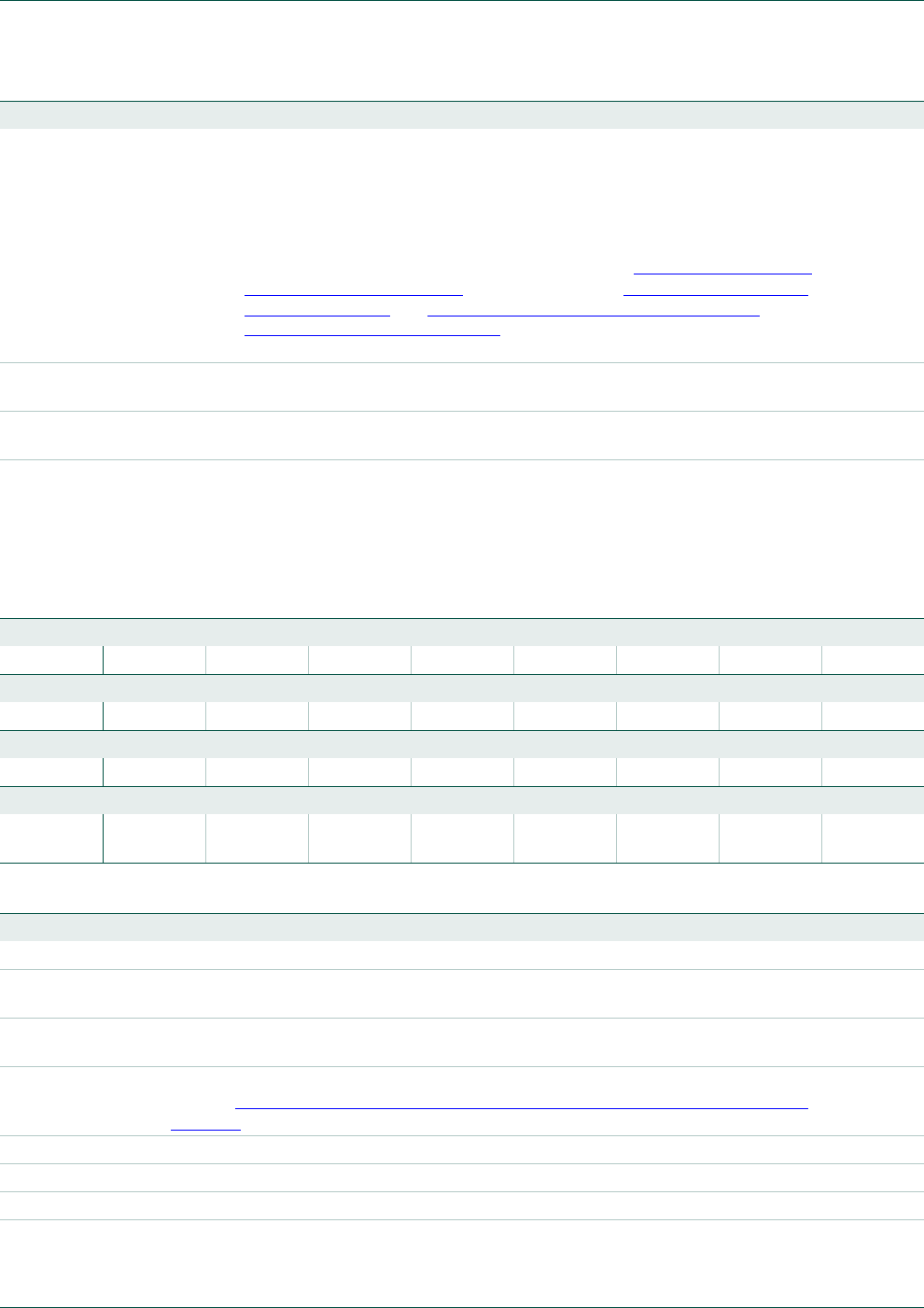
UM10360 All information provided in this document is subject to legal disclaimers. © NXP B.V. 2014. All rights reserved.
User manual Rev. 3.1 — 2 April 2014 232 of 849
NXP Semiconductors UM10360
Chapter 11: LPC176x/5x USB device controller
11.10.2.2 USB Device Interrupt Status register (USBDevIntSt - 0x5000 C200)
The USBDevIntSt register holds the status of each interrupt. A 0 indicates no interrupt and
1 indicates the presence of the interrupt. USBDevIntSt is a read-only register.
8USB_NEED_CLK USB need clock indicator. This bit is set to 1 when USB activity or a change
of state on the USB data pins is detected, and it indicates that a PLL supplied
clock of 48 MHz is needed. Once USB_NEED_CLK becomes one, it resets
to zero 5 ms after the last packet has been received/sent, or 2 ms after the
Suspend Change (SUS_CH) interrupt has occurred. A change of this bit from
0 to 1 can wake up the microcontroller if activity on the USB bus is selected
to wake up the part from the Power-down mode (see Section 4.8.8 “Wake-up
from Reduced Power Modes” for details). Also see Section 4.5.9 “PLL0 and
Power-down mode” and Section 4.8.9 “Power Control for Peripherals
register (PCONP - 0x400F C0C4)” for considerations about the PLL and
invoking the Power-down mode. This bit is read-only.
1
30:9 - Reserved, user software should not write ones to reserved bits. The value
read from a reserved bit is not defined.
NA
31 EN_USB_INTS Enable all USB interrupts. When this bit is cleared, the Vectored Interrupt
Controller does not see the ORed output of the USB interrupt lines.
1
Table 192. USB Interrupt Status register (USBIntSt - address 0x5000 C1C0) bit description …continued
Bit Symbol Description Reset value
Table 193. USB Device Interrupt Status register (USBDevIntSt - address 0x5000 C200) bit allocation
Reset value: 0x0000 0000
Bit 31 30 29 28 27 26 25 24
Symbol --------
Bit 23 22 21 20 19 18 17 16
Symbol --------
Bit 15 14 13 12 11 10 9 8
Symbol ------ERR_INTEP_RLZED
Bit 7 6 5 4 3 2 1 0
Symbol TxENDPKT Rx
ENDPKT
CDFULL CCEMPTY DEV_STAT EP_SLOW EP_FAST FRAME
Table 194. USB Device Interrupt Status register (USBDevIntSt - address 0x5000 C200) bit description
Bit Symbol Description Reset value
0 FRAME The frame interrupt occurs every 1 ms. This is used in isochronous packet transfers. 0
1EP_FASTFast endpoint interrupt. If an Endpoint Interrupt Priority register (USBEpIntPri) bit is set,
the corresponding endpoint interrupt will be routed to this bit.
0
2EP_SLOWSlow endpoints interrupt. If an Endpoint Interrupt Priority Register (USBEpIntPri) bit is
not set, the corresponding endpoint interrupt will be routed to this bit.
0
3DEV_STATSet when USB Bus reset, USB suspend change or Connect change event occurs.
Refer to Section 11.12.6 “Set Device Status (Command: 0xFE, Data: write 1 byte)” on
page 256.
0
4CCEMPTYThe command code register (USBCmdCode) is empty (New command can be written).1
5CDFULL Command data register (USBCmdData) is full (Data can be read now). 0
6RxENDPKTThe current packet in the endpoint buffer is transferred to the CPU. 0
7TxENDPKTThe number of data bytes transferred to the endpoint buffer equals the number of bytes
programmed in the TxPacket length register (USBTxPLen).
0
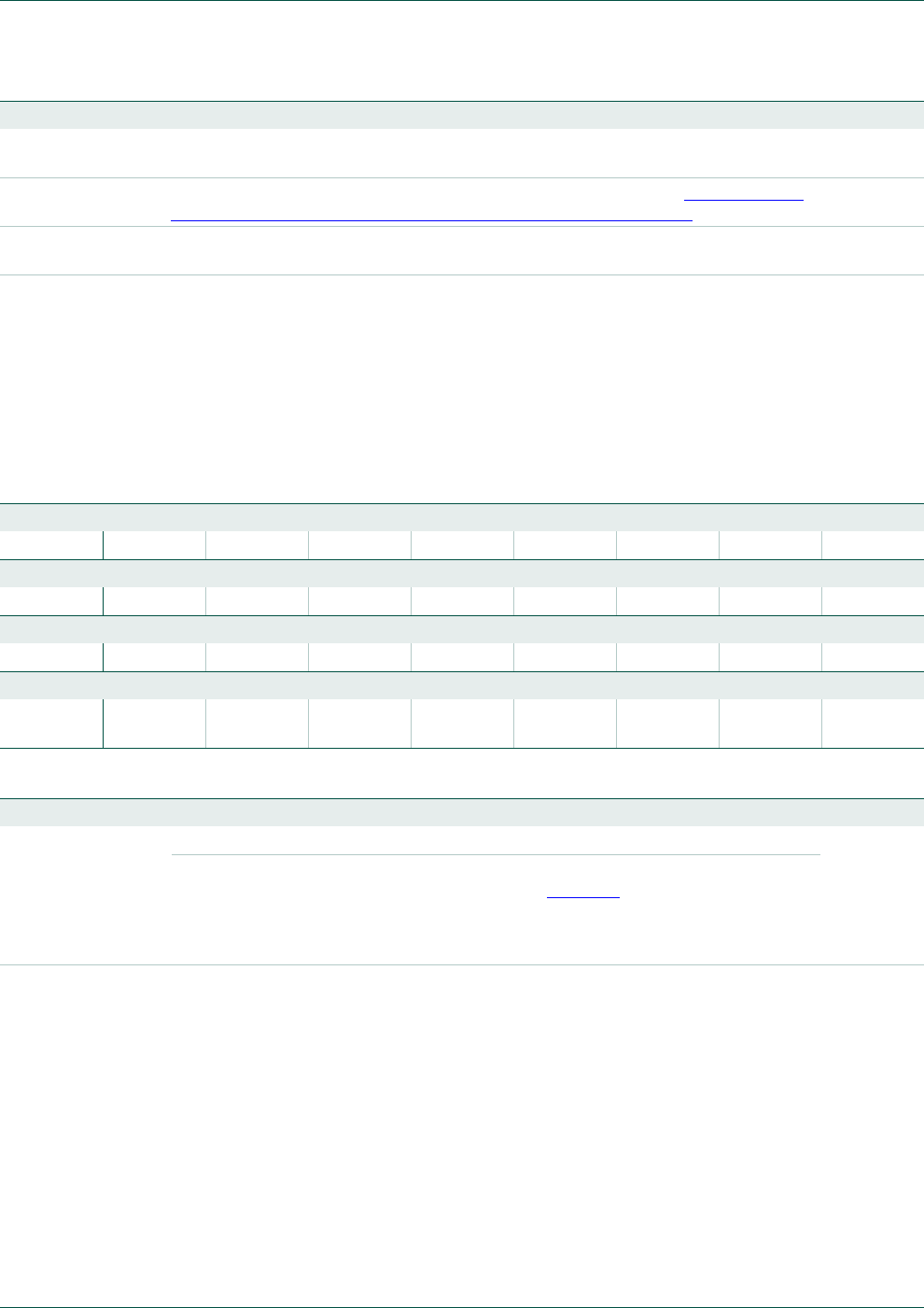
UM10360 All information provided in this document is subject to legal disclaimers. © NXP B.V. 2014. All rights reserved.
User manual Rev. 3.1 — 2 April 2014 233 of 849
NXP Semiconductors UM10360
Chapter 11: LPC176x/5x USB device controller
11.10.2.3 USB Device Interrupt Enable register (USBDevIntEn - 0x5000 C204)
Writing a one to a bit in this register enables the corresponding bit in USBDevIntSt to
generate an interrupt on one of the interrupt lines when set. By default, the interrupt is
routed to the USB_INT_REQ_LP interrupt line. Optionally, either the EP_FAST or FRAME
interrupt may be routed to the USB_INT_REQ_HP interrupt line by changing the value of
USBDevIntPri. USBDevIntEn is a read/write register.
11.10.2.4 USB Device Interrupt Clear register (USBDevIntClr - 0x5000 C208)
Writing one to a bit in this register clears the corresponding bit in USBDevIntSt. Writing a
zero has no effect.
Remark: Before clearing the EP_SLOW or EP_FAST interrupt bits, the corresponding
endpoint interrupts in USBEpIntSt should be cleared.
USBDevIntClr is a write-only register.
8EP_RLZEDEndpoints realized. Set when Realize Endpoint register (USBReEp) or MaxPacketSize
register (USBMaxPSize) is updated and the corresponding operation is completed.
0
9ERR_INTError Interrupt. Any bus error interrupt from the USB device. Refer to Section 11.12.9
“Read Error Status (Command: 0xFB, Data: read 1 byte)” on page 258
0
31:10 - Reserved, user software should not write ones to reserved bits. The value read from a
reserved bit is not defined.
NA
Table 194. USB Device Interrupt Status register (USBDevIntSt - address 0x5000 C200) bit description …continued
Bit Symbol Description Reset value
Table 195. USB Device Interrupt Enable register (USBDevIntEn - address 0x5000 C204) bit allocation
Reset value: 0x0000 0000
Bit 31 30 29 28 27 26 25 24
Symbol --------
Bit 23 22 21 20 19 18 17 16
Symbol --------
Bit 15 14 13 12 11 10 9 8
Symbol ------ERR_INTEP_RLZED
Bit 7 6 5 4 3 2 1 0
Symbol TxENDPKT Rx
ENDPKT
CDFULL CCEMPTY DEV_STAT EP_SLOW EP_FAST FRAME
Table 196. USB Device Interrupt Enable register (USBDevIntEn - address 0x5000 C204) bit description
Bit Symbol Value Description Reset value
31:0 See
USBDevIntEn
bit allocation
table above
0No interrupt is generated. 0
1An interrupt will be generated when the corresponding bit in the Device
Interrupt Status (USBDevIntSt) register (Tab l e 1 9 3) is set. By default, the
interrupt is routed to the USB_INT_REQ_LP interrupt line. Optionally, either
the EP_FAST or FRAME interrupt may be routed to the USB_INT_REQ_HP
interrupt line by changing the value of USBDevIntPri.
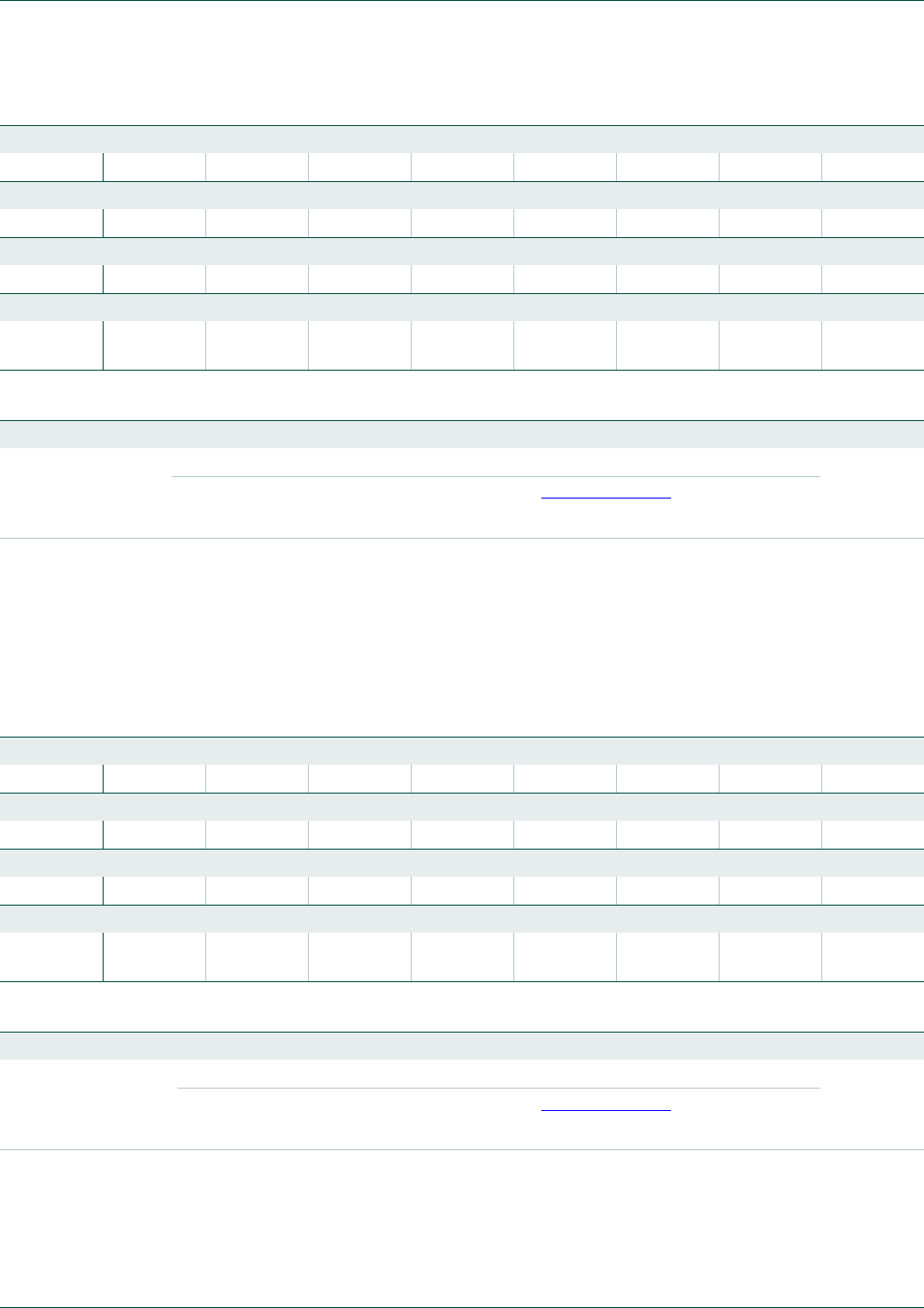
UM10360 All information provided in this document is subject to legal disclaimers. © NXP B.V. 2014. All rights reserved.
User manual Rev. 3.1 — 2 April 2014 234 of 849
NXP Semiconductors UM10360
Chapter 11: LPC176x/5x USB device controller
11.10.2.5 USB Device Interrupt Set register (USBDevIntSet - 0x5000 C20C)
Writing one to a bit in this register sets the corresponding bit in the USBDevIntSt. Writing a
zero has no effect
USBDevIntSet is a write-only register.
Table 197. USB Device Interrupt Clear register (USBDevIntClr - address 0x5000 C208) bit allocation
Reset value: 0x0000 0000
Bit 31 30 29 28 27 26 25 24
Symbol --------
Bit 23 22 21 20 19 18 17 16
Symbol --------
Bit 15 14 13 12 11 10 9 8
Symbol ------ERR_INTEP_RLZED
Bit 7 6 5 4 3 2 1 0
Symbol TxENDPKT Rx
ENDPKT
CDFULL CCEMPTY DEV_STAT EP_SLOW EP_FAST FRAME
Table 198. USB Device Interrupt Clear register (USBDevIntClr - address 0x5000 C208) bit description
Bit Symbol Value Description Reset value
31:0 See
USBDevIntClr
bit allocation
table above
0No effect. 0
1The corresponding bit in USBDevIntSt (Section 11.10.2.2) is cleared.
Table 199. USB Device Interrupt Set register (USBDevIntSet - address 0x5000 C20C) bit allocation
Reset value: 0x0000 0000
Bit 31 30 29 28 27 26 25 24
Symbol --------
Bit 23 22 21 20 19 18 17 16
Symbol --------
Bit 15 14 13 12 11 10 9 8
Symbol ------ERR_INTEP_RLZED
Bit 7 6 5 4 3 2 1 0
Symbol TxENDPKT Rx
ENDPKT
CDFULL CCEMPTY DEV_STAT EP_SLOW EP_FAST FRAME
Table 200. USB Device Interrupt Set register (USBDevIntSet - address 0x5000 C20C) bit description
Bit Symbol Value Description Reset value
31:0 See
USBDevIntSet
bit allocation
table above
0No effect. 0
1The corresponding bit in USBDevIntSt (Section 11.10.2.2) is set.

UM10360 All information provided in this document is subject to legal disclaimers. © NXP B.V. 2014. All rights reserved.
User manual Rev. 3.1 — 2 April 2014 235 of 849
NXP Semiconductors UM10360
Chapter 11: LPC176x/5x USB device controller
11.10.2.6 USB Device Interrupt Priority register (USBDevIntPri - 0x5000 C22C)
Writing one to a bit in this register causes the corresponding interrupt to be routed to the
USB_INT_REQ_HP interrupt line. Writing zero causes the interrupt to be routed to the
USB_INT_REQ_LP interrupt line. Either the EP_FAST or FRAME interrupt can be routed
to USB_INT_REQ_HP, but not both. If the software attempts to set both bits to one, no
interrupt will be routed to USB_INT_REQ_HP. USBDevIntPri is a write-only register.
11.10.3 Endpoint interrupt registers
The registers in this group facilitate handling of endpoint interrupts. Endpoint interrupts are
used in Slave mode operation.
11.10.3.1 USB Endpoint Interrupt Status register (USBEpIntSt - 0x5000 C230)
Each physical non-isochronous endpoint is represented by a bit in this register to indicate
that it has generated an interrupt. All non-isochronous OUT endpoints generate an
interrupt when they receive a packet without an error. All non-isochronous IN endpoints
generate an interrupt when a packet is successfully transmitted, or when a NAK
handshake is sent on the bus and the interrupt on NAK feature is enabled (see
Section 11.12.3 “Set Mode (Command: 0xF3, Data: write 1 byte)” on page 255). A bit set
to one in this register causes either the EP_FAST or EP_SLOW bit of USBDevIntSt to be
set depending on the value of the corresponding bit of USBEpDevIntPri. USBEpIntSt is a
read-only register.
Note that for Isochronous endpoints, handling of packet data is done when the FRAME
interrupt occurs.
Table 201. USB Device Interrupt Priority register (USBDevIntPri - address 0x5000 C22C) bit description
Bit Symbol Value Description Reset
value
0FRAME0 FRAME interrupt is routed to USB_INT_REQ_LP. 0
1FRAME interrupt is routed to USB_INT_REQ_HP.
1EP_FAST0 EP_FAST interrupt is routed to USB_INT_REQ_LP. 0
1EP_FAST interrupt is routed to USB_INT_REQ_HP.
31:2 - Reserved, user software should not write ones to reserved bits. The value read from a
reserved bit is not defined.
NA
Table 202. USB Endpoint Interrupt Status register (USBEpIntSt - address 0x5000 C230) bit allocation
Reset value: 0x0000 0000
Bit 31 30 29 28 27 26 25 24
Symbol EP15TX EP15RX EP14TX EP14RX EP13TX EP13RX EP12TX EP12RX
Bit 23 22 21 20 19 18 17 16
Symbol EP11TX EP11RX EP10TX EP10RX EP9TX EP9RX EP8TX EP8RX
Bit 15 14 13 12 11 10 9 8
Symbol EP7TX EP7RX EP6TX EP6RX EP5TX EP5RX EP4TX EP4RX
Bit 7 6 5 4 3 2 1 0
Symbol EP3TX EP3RX EP2TX EP2RX EP1TX EP1RX EP0TX EP0RX

UM10360 All information provided in this document is subject to legal disclaimers. © NXP B.V. 2014. All rights reserved.
User manual Rev. 3.1 — 2 April 2014 236 of 849
NXP Semiconductors UM10360
Chapter 11: LPC176x/5x USB device controller
11.10.3.2 USB Endpoint Interrupt Enable register (USBEpIntEn - 0x5000 C234)
Setting a bit to 1 in this register causes the corresponding bit in USBEpIntSt to be set
when an interrupt occurs for the associated endpoint. Setting a bit to 0 causes the
corresponding bit in USBDMARSt to be set when an interrupt occurs for the associated
endpoint. USBEpIntEn is a read/write register.
Table 203. USB Endpoint Interrupt Status register (USBEpIntSt - address 0x5000 C230) bit description
Bit Symbol Description Reset value
0EP0RX Endpoint 0, Data Received Interrupt bit. 0
1EP0TX Endpoint 0, Data Transmitted Interrupt bit or sent a NAK. 0
2EP1RX Endpoint 1, Data Received Interrupt bit. 0
3EP1TX Endpoint 1, Data Transmitted Interrupt bit or sent a NAK. 0
4EP2RX Endpoint 2, Data Received Interrupt bit. 0
5EP2TX Endpoint 2, Data Transmitted Interrupt bit or sent a NAK. 0
6EP3RX Endpoint 3, Isochronous endpoint. NA
7EP3TX Endpoint 3, Isochronous endpoint. NA
8EP4RX Endpoint 4, Data Received Interrupt bit. 0
9EP4TX Endpoint 4, Data Transmitted Interrupt bit or sent a NAK. 0
10 EP5RX Endpoint 5, Data Received Interrupt bit. 0
11 EP5TX Endpoint 5, Data Transmitted Interrupt bit or sent a NAK. 0
12 EP6RX Endpoint 6, Isochronous endpoint. NA
13 EP6TX Endpoint 6, Isochronous endpoint. NA
14 EP7RX Endpoint 7, Data Received Interrupt bit. 0
15 EP7TX Endpoint 7, Data Transmitted Interrupt bit or sent a NAK. 0
16 EP8RX Endpoint 8, Data Received Interrupt bit. 0
17 EP8TX Endpoint 8, Data Transmitted Interrupt bit or sent a NAK. 0
18 EP9RX Endpoint 9, Isochronous endpoint. NA
19 EP9TX Endpoint 9, Isochronous endpoint. NA
20 EP10RX Endpoint 10, Data Received Interrupt bit. 0
21 EP10TX Endpoint 10, Data Transmitted Interrupt bit or sent a NAK. 0
22 EP11RX Endpoint 11, Data Received Interrupt bit. 0
23 EP11TX Endpoint 11, Data Transmitted Interrupt bit or sent a NAK. 0
24 EP12RX Endpoint 12, Isochronous endpoint. NA
25 EP12TX Endpoint 12, Isochronous endpoint. NA
26 EP13RX Endpoint 13, Data Received Interrupt bit. 0
27 EP13TX Endpoint 13, Data Transmitted Interrupt bit or sent a NAK. 0
28 EP14RX Endpoint 14, Data Received Interrupt bit. 0
29 EP14TX Endpoint 14, Data Transmitted Interrupt bit or sent a NAK. 0
30 EP15RX Endpoint 15, Data Received Interrupt bit. 0
31 EP15TX Endpoint 15, Data Transmitted Interrupt bit or sent a NAK. 0

UM10360 All information provided in this document is subject to legal disclaimers. © NXP B.V. 2014. All rights reserved.
User manual Rev. 3.1 — 2 April 2014 237 of 849
NXP Semiconductors UM10360
Chapter 11: LPC176x/5x USB device controller
11.10.3.3 USB Endpoint Interrupt Clear register (USBEpIntClr - 0x5000 C238)
Writing a one to this a bit in this register causes the SIE Select Endpoint/Clear Interrupt
command to be executed (Table 249) for the corresponding physical endpoint. Writing
zero has no effect. Before executing the Select Endpoint/Clear Interrupt command, the
CDFULL bit in USBDevIntSt is cleared by hardware. On completion of the command, the
CDFULL bit is set, USBCmdData contains the status of the endpoint, and the
corresponding bit in USBEpIntSt is cleared.
Notes:
•When clearing interrupts using USBEpIntClr, software should wait for CDFULL to be
set to ensure the corresponding interrupt has been cleared before proceeding.
•While setting multiple bits in USBEpIntClr simultaneously is possible, it is not
recommended; only the status of the endpoint corresponding to the least significant
interrupt bit cleared will be available at the end of the operation.
•Alternatively, the SIE Select Endpoint/Clear Interrupt command can be directly
invoked using the SIE command registers, but using USBEpIntClr is recommended
because of its ease of use.
Each physical endpoint has its own reserved bit in this register. The bit field definition is
the same as that of USBEpIntSt shown in Ta bl e 2 0 2 . USBEpIntClr is a write-only register.
Table 204. USB Endpoint Interrupt Enable register (USBEpIntEn - address 0x5000 C234) bit allocation
Reset value: 0x0000 0000
Bit 31 30 29 28 27 26 25 24
Symbol EP15TX EP15RX EP14TX EP14RX EP13TX EP13RX EP12TX EP12RX
Bit 23 22 21 20 19 18 17 16
Symbol EP11TX EP11RX EP10TX EP10RX EP9TX EP9RX EP8TX EP8RX
Bit 15 14 13 12 11 10 9 8
Symbol EP7TX EP7RX EP6TX EP6RX EP5TX EP5RX EP4TX EP4RX
Bit 7 6 5 4 3 2 1 0
Symbol EP3TX EP3RX EP2TX EP2RX EP1TX EP1RX EP0TX EP0RX
Table 205. USB Endpoint Interrupt Enable register (USBEpIntEn - address 0x5000 C234) bit description
Bit Symbol Value Description Reset value
31:0 See USBEpIntEn bit
allocation table above
0The corresponding bit in USBDMARSt is set when an interrupt occurs
for this endpoint.
0
1The corresponding bit in USBEpIntSt is set when an interrupt
occurs for this endpoint. Implies Slave mode for this endpoint.
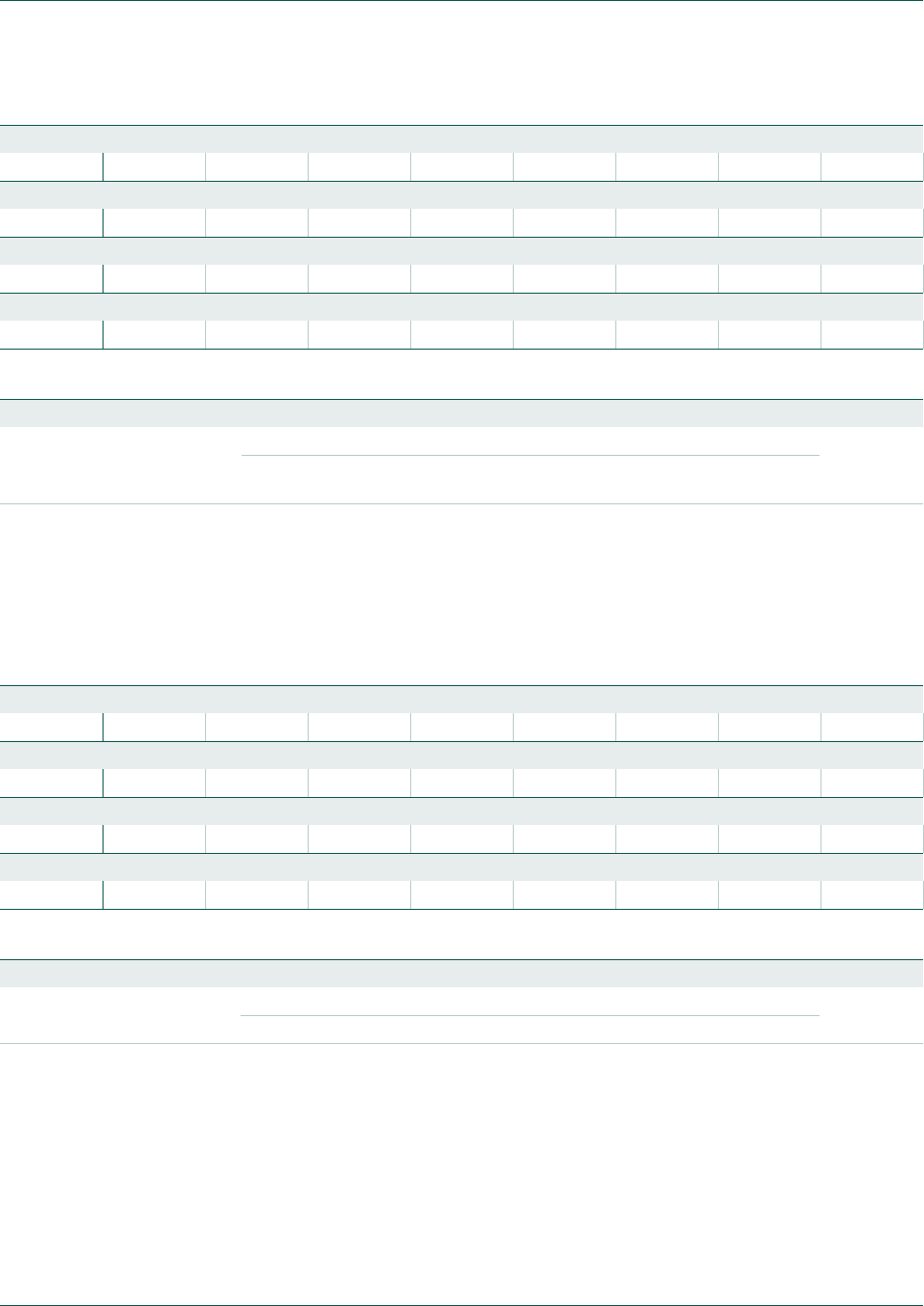
UM10360 All information provided in this document is subject to legal disclaimers. © NXP B.V. 2014. All rights reserved.
User manual Rev. 3.1 — 2 April 2014 238 of 849
NXP Semiconductors UM10360
Chapter 11: LPC176x/5x USB device controller
11.10.3.4 USB Endpoint Interrupt Set register (USBEpIntSet - 0x5000 C23C)
Writing a one to a bit in this register sets the corresponding bit in USBEpIntSt. Writing zero
has no effect. Each endpoint has its own bit in this register. USBEpIntSet is a write-only
register.
11.10.3.5 USB Endpoint Interrupt Priority register (USBEpIntPri - 0x5000 C240)
This register determines whether an endpoint interrupt is routed to the EP_FAST or
EP_SLOW bits of USBDevIntSt. If a bit in this register is set to one, the interrupt is routed
to EP_FAST, if zero it is routed to EP_SLOW. Routing of multiple endpoints to EP_FAST
or EP_SLOW is possible.
Note that the USBDevIntPri register determines whether the EP_FAST interrupt is routed
to the USB_INT_REQ_HP or USB_INT_REQ_LP interrupt line.
Table 206. USB Endpoint Interrupt Clear register (USBEpIntClr - address 0x5000 C238) bit allocation
Reset value: 0x0000 0000
Bit 31 30 29 28 27 26 25 24
Symbol EP15TX EP15RX EP14TX EP14RX EP13TX EP13RX EP12TX EP12RX
Bit 23 22 21 20 19 18 17 16
Symbol EP11TX EP11RX EP10TX EP10RX EP9TX EP9RX EP8TX EP8RX
Bit 15 14 13 12 11 10 9 8
Symbol EP7TX EP7RX EP6TX EP6RX EP5TX EP5RX EP4TX EP4RX
Bit 7 6 5 4 3 2 1 0
Symbol EP3TX EP3RX EP2TX EP2RX EP1TX EP1RX EP0TX EP0RX
Table 207. USB Endpoint Interrupt Clear register (USBEpIntClr - address 0x5000 C238) bit description
Bit Symbol Value Description Reset value
31:0 See USBEpIntClr bit
allocation table above
0No effect. 0
1Clears the corresponding bit in USBEpIntSt, by executing the SIE
Select Endpoint/Clear Interrupt command for this endpoint.
Table 208. USB Endpoint Interrupt Set register (USBEpIntSet - address 0x5000 C23C) bit allocation
Reset value: 0x0000 0000
Bit 31 30 29 28 27 26 25 24
Symbol EP15TX EP15RX EP14TX EP14RX EP13TX EP13RX EP12TX EP12RX
Bit 23 22 21 20 19 18 17 16
Symbol EP11TX EP11RX EP10TX EP10RX EP9TX EP9RX EP8TX EP8RX
Bit 15 14 13 12 11 10 9 8
Symbol EP7TX EP7RX EP6TX EP6RX EP5TX EP5RX EP4TX EP4RX
Bit 7 6 5 4 3 2 1 0
Symbol EP3TX EP3RX EP2TX EP2RX EP1TX EP1RX EP0TX EP0RX
Table 209. USB Endpoint Interrupt Set register (USBEpIntSet - address 0x5000 C23C) bit description
Bit Symbol Value Description Reset value
31:0 See USBEpIntSet bit
allocation table above
0No effect. 0
1Sets the corresponding bit in USBEpIntSt.
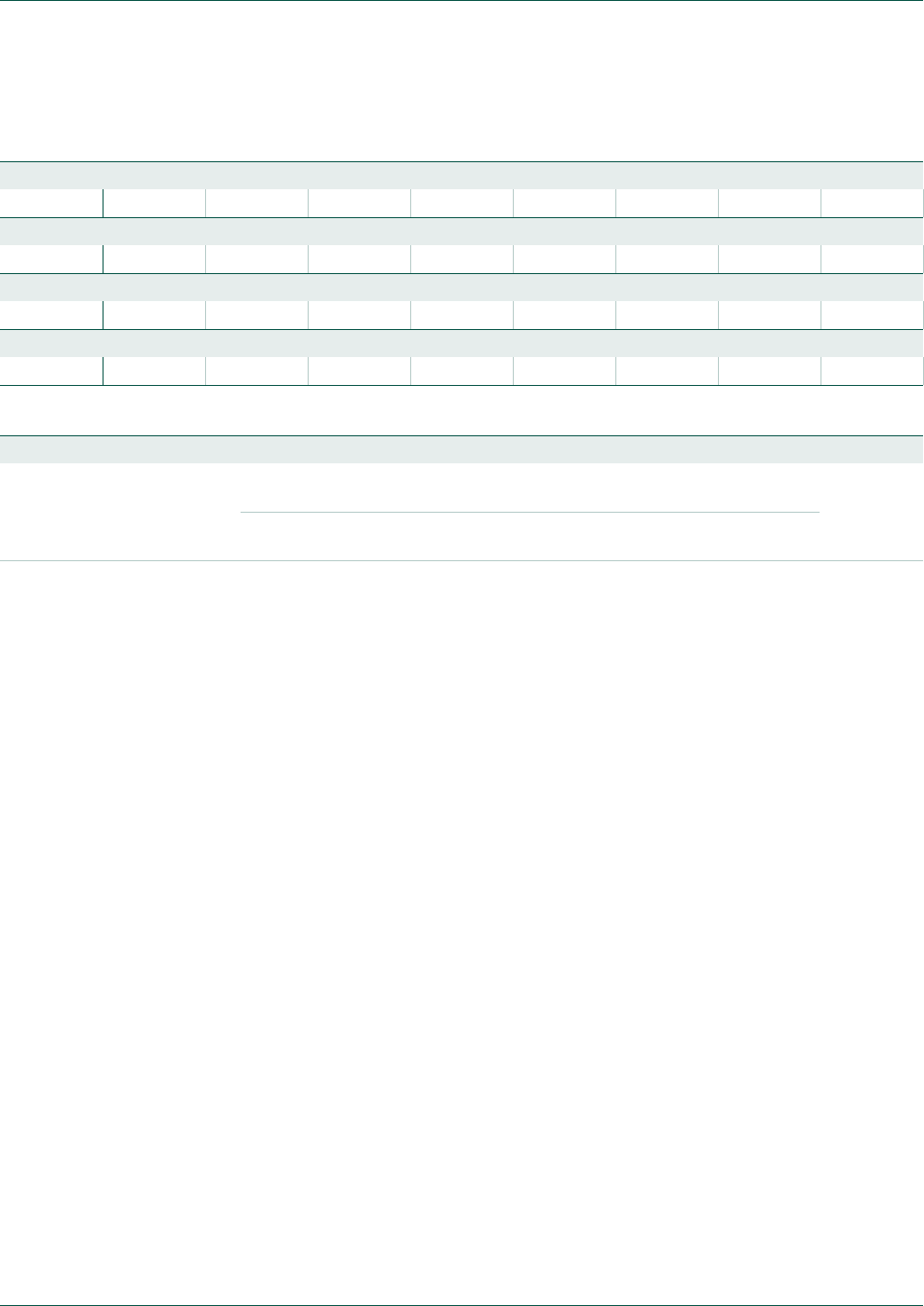
UM10360 All information provided in this document is subject to legal disclaimers. © NXP B.V. 2014. All rights reserved.
User manual Rev. 3.1 — 2 April 2014 239 of 849
NXP Semiconductors UM10360
Chapter 11: LPC176x/5x USB device controller
USBEpIntPri is a write-only register.
11.10.4 Endpoint realization registers
The registers in this group allow realization and configuration of endpoints at run time.
11.10.4.1 EP RAM requirements
The USB device controller uses a RAM based FIFO for each endpoint buffer. The RAM
dedicated for this purpose is called the Endpoint RAM (EP_RAM). Each endpoint has
space reserved in the EP_RAM. The EP_RAM space required for an endpoint depends
on its MaxPacketSize and whether it is double buffered. 32 words of EP_RAM are used by
the device for storing the endpoint buffer pointers. The EP_RAM is word aligned but the
MaxPacketSize is defined in bytes hence the RAM depth has to be adjusted to the next
word boundary. Also, each buffer has one word header showing the size of the packet
length received.
The EP_ RAM space (in words) required for the physical endpoint can be expressed as
(1)
where dbstatus = 1 for a single-buffered endpoint and 2 for a double-buffered endpoint.
Since all the realized endpoints occupy EP_RAM space, the total EP_RAM requirement is
(2)
where N is the number of realized endpoints. Total EP_RAM space should not exceed
4096 bytes (4 kB, 1 kwords).
Table 210. USB Endpoint Interrupt Priority register (USBEpIntPri - address 0x5000 C240) bit allocation
Reset value: 0x0000 0000
Bit 31 30 29 28 27 26 25 24
Symbol EP15TX EP15RX EP14TX E14RX EP13TX EP13RX EP12TX EP12RX
Bit 23 22 21 20 19 18 17 16
Symbol EP11TX EP11RX EP10TX EP10RX EP9TX EP9RX EP8TX EP8RX
Bit 15 14 13 12 11 10 9 8
Symbol EP7TX EP7RX EP6TX EP6RX EP5TX EP5RX EP4TX EP4RX
Bit 7 6 5 4 3 2 1 0
Symbol EP3TX EP3RX EP2TX EP2RX EP1TX EP1RX EP0TX EP0RX
Table 211. USB Endpoint Interrupt Priority register (USBEpIntPri - address 0x5000 C240) bit description
Bit Symbol Value Description Reset value
31:0 See USBEpIntPri bit
allocation table above
0The corresponding interrupt is routed to the EP_SLOW bit of
USBDevIntSt
0
1The corresponding interrupt is routed to the EP_FAST bit of
USBDevIntSt
EPRAMspace MaxPacketSize 3+
4
--------------------------------------------------1+
dbstatus=
TotalEPRAMspace 32 EPRAMspace n
n0=
N
+=
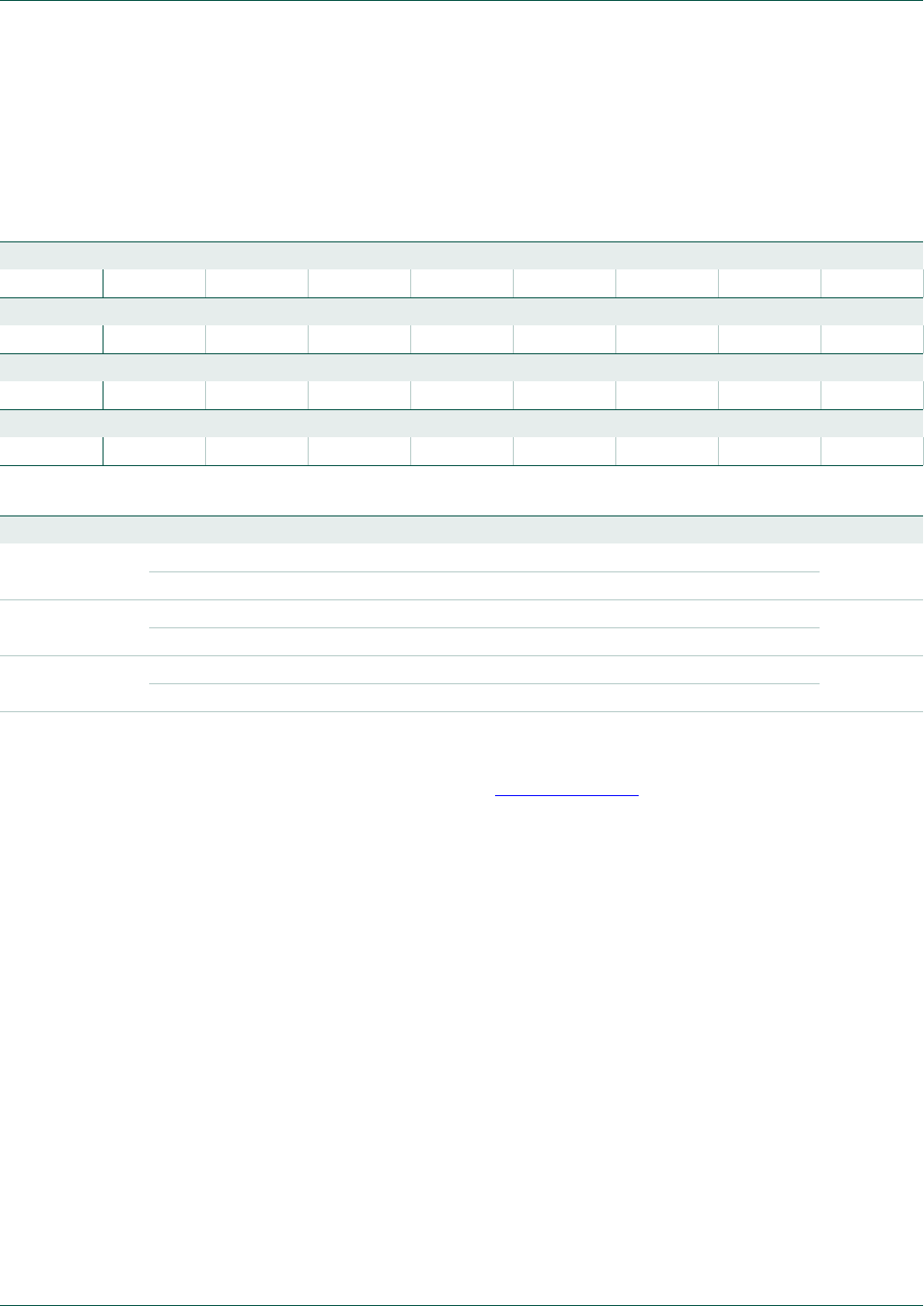
UM10360 All information provided in this document is subject to legal disclaimers. © NXP B.V. 2014. All rights reserved.
User manual Rev. 3.1 — 2 April 2014 240 of 849
NXP Semiconductors UM10360
Chapter 11: LPC176x/5x USB device controller
11.10.4.2 USB Realize Endpoint register (USBReEp - 0x5000 C244)
Writing one to a bit in this register causes the corresponding endpoint to be realized.
Writing zeros causes it to be unrealized. This register returns to its reset state when a bus
reset occurs. USBReEp is a read/write register.
On reset, only the control endpoints are realized. Other endpoints, if required, are realized
by programming the corresponding bits in USBReEp. To calculate the required EP_RAM
space for the realized endpoints, see Section 11.10.4.1.
Realization of endpoints is a multi-cycle operation. Pseudo code for endpoint realization is
shown below.
Clear EP_RLZED bit in USBDevIntSt;
for every endpoint to be realized,
{
/* OR with the existing value of the Realize Endpoint register */
USBReEp |= (UInt32) ((0x1 << endpt));
/* Load Endpoint index Reg with physical endpoint no.*/
USBEpIn = (UInt32) endpointnumber;
/* load the max packet size Register */
USBEpMaxPSize = MPS;
/* check whether the EP_RLZED bit in the Device Interrupt Status register is set
*/
while (!(USBDevIntSt & EP_RLZED))
{
/* wait until endpoint realization is complete */
Table 212. USB Realize Endpoint register (USBReEp - address 0x5000 C244) bit allocation
Reset value: 0x0000 0003
Bit 31 30 29 28 27 26 25 24
Symbol EP31 EP30 EP29 EP28 EP27 EP26 EP25 EP24
Bit 23 22 21 20 19 18 17 16
Symbol EP23 EP22 EP21 EP20 EP19 EP18 EP17 EP16
Bit 15 14 13 12 11 10 9 8
Symbol EP15 EP14 EP13 EP12 EP11 EP10 EP9 EP8
Bit 7 6 5 4 3 2 1 0
Symbol EP7 EP6 EP5 EP4 EP3 EP2 EP1 EP0
Table 213. USB Realize Endpoint register (USBReEp - address 0x5000 C244) bit description
Bit Symbol Value Description Reset value
0EP0 0 Control endpoint EP0 is not realized. 1
1Control endpoint EP0 is realized.
1EP1 0 Control endpoint EP1 is not realized. 1
1Control endpoint EP1 is realized.
31:2 EPxx 0 Endpoint EPxx is not realized. 0
1Endpoint EPxx is realized.
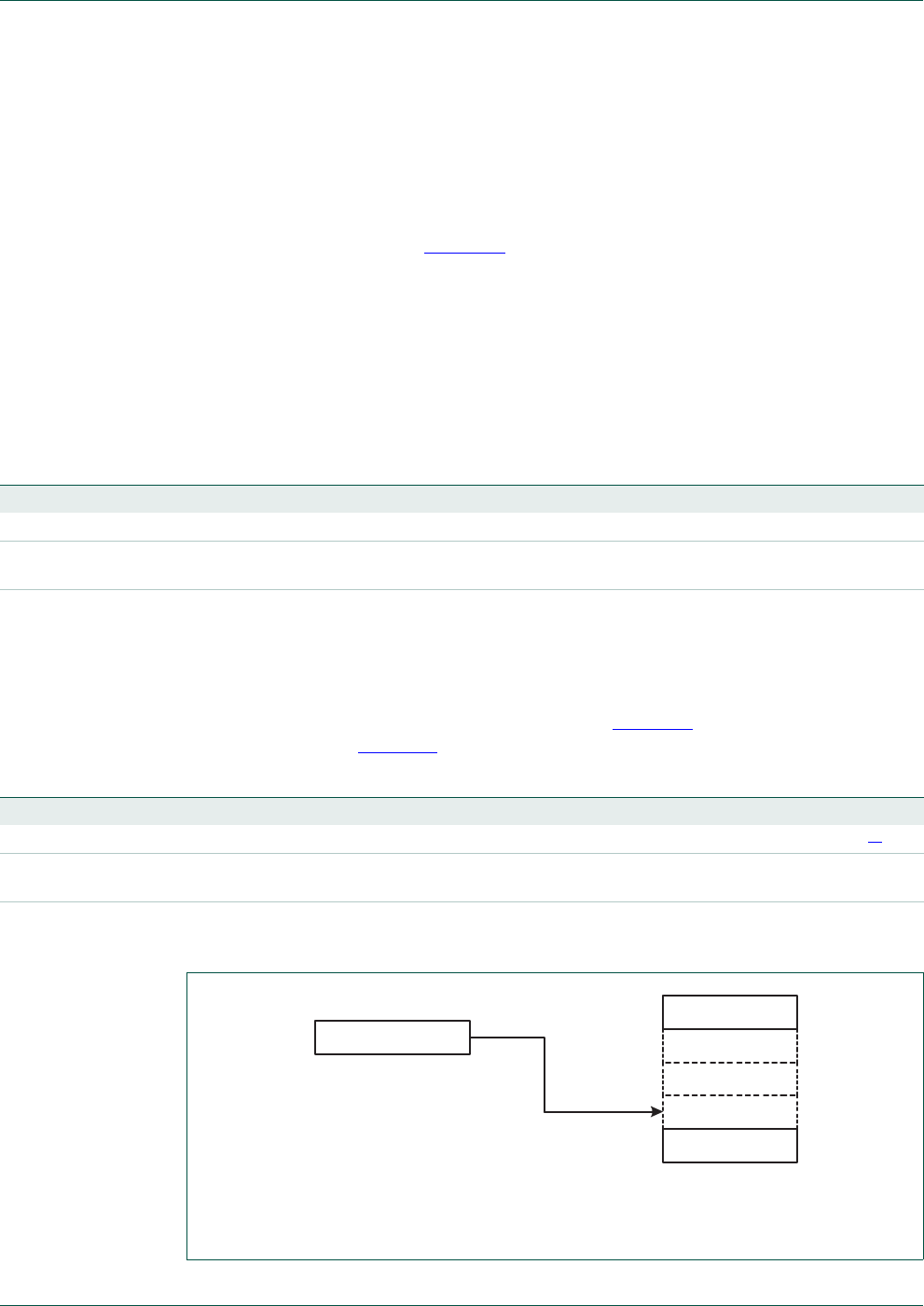
UM10360 All information provided in this document is subject to legal disclaimers. © NXP B.V. 2014. All rights reserved.
User manual Rev. 3.1 — 2 April 2014 241 of 849
NXP Semiconductors UM10360
Chapter 11: LPC176x/5x USB device controller
}
/* Clear the EP_RLZED bit */
Clear EP_RLZED bit in USBDevIntSt;
}
The device will not respond to any transactions to unrealized endpoints. The SIE
Configure Device command will only cause realized and enabled endpoints to respond to
transactions. For details see Tabl e 2 44.
11.10.4.3 USB Endpoint Index register (USBEpIn - 0x5000 C248)
Each endpoint has a register carrying the MaxPacketSize value for that endpoint. This is
in fact a register array. Hence before writing, this register is addressed through the
USBEpIn register.
The USBEpIn register will hold the physical endpoint number. Writing to USBMaxPSize
will set the array element pointed to by USBEpIn. USBEpIn is a write-only register.
11.10.4.4 USB MaxPacketSize register (USBMaxPSize - 0x5000 C24C)
On reset, the control endpoint is assigned the maximum packet size of 8 bytes. Other
endpoints are assigned 0. Modifying USBMaxPSize will cause the endpoint buffer
addresses within the EP_RAM to be recalculated. This is a multi-cycle process. At the
end, the EP_RLZED bit will be set in USBDevIntSt (Ta b le 1 9 3). USBMaxPSize array
indexing is shown in Figure 29. USBMaxPSize is a read/write register.
[1] Reset value for EP0 and EP1. All other endpoints have a reset value of 0x0.
Table 214. USB Endpoint Index register (USBEpIn - address 0x5000 C248) bit description
Bit Symbol Description Reset value
4:0 PHY_EP Physical endpoint number (0-31) 0
31:5 - Reserved, user software should not write ones to reserved bits. The value read from
a reserved bit is not defined.
NA
Table 215. USB MaxPacketSize register (USBMaxPSize - address 0x5000 C24C) bit description
Bit Symbol Description Reset value
9:0 MPS The maximum packet size value. 0x008[1]
31:10 - Reserved, user software should not write ones to reserved bits. The value read from a
reserved bit is not defined.
NA
The Endpoint Index is set via the USBEpIn register. MPS_EP0 to MPS_EP31 are accessed via the
USBMaxPSize register.
Fig 29. USB MaxPacketSize register array indexing
ENDPOINT INDEX
MPS_EP0
MPS_EP31

UM10360 All information provided in this document is subject to legal disclaimers. © NXP B.V. 2014. All rights reserved.
User manual Rev. 3.1 — 2 April 2014 242 of 849
NXP Semiconductors UM10360
Chapter 11: LPC176x/5x USB device controller
11.10.5 USB transfer registers
The registers in this group are used for transferring data between endpoint buffers and
RAM in Slave mode operation. See Section 11.14 “Slave mode operation”.
11.10.5.1 USB Receive Data register (USBRxData - 0x5000 C218)
For an OUT transaction, the CPU reads the endpoint buffer data from this register. Before
reading this register, the RD_EN bit and LOG_ENDPOINT field of the USBCtrl register
should be set appropriately. On reading this register, data from the selected endpoint
buffer is fetched. The data is in little endian format: the first byte received from the USB
bus will be available in the least significant byte of USBRxData. USBRxData is a read-only
register.
11.10.5.2 USB Receive Packet Length register (USBRxPLen - 0x5000 C220)
This register contains the number of bytes remaining in the endpoint buffer for the current
packet being read via the USBRxData register, and a bit indicating whether the packet is
valid or not. Before reading this register, the RD_EN bit and LOG_ENDPOINT field of the
USBCtrl register should be set appropriately. This register is updated on each read of the
USBRxData register. USBRxPLen is a read-only register.
11.10.5.3 USB Transmit Data register (USBTxData - 0x5000 C21C)
For an IN transaction, the CPU writes the endpoint data into this register. Before writing to
this register, the WR_EN bit and LOG_ENDPOINT field of the USBCtrl register should be
set appropriately, and the packet length should be written to the USBTxPlen register. On
writing this register, the data is written to the selected endpoint buffer. The data is in little
endian format: the first byte sent on the USB bus will be the least significant byte of
USBTxData. USBTxData is a write-only register.
Table 216. USB Receive Data register (USBRxData - address 0x5000 C218) bit description
Bit Symbol Description Reset value
31:0 RX_DATA Data received. 0x0000 0000
Table 217. USB Receive Packet Length register (USBRxPlen - address 0x5000 C220) bit description
Bit Symbol Value Description Reset value
9:0 PKT_LNGTH - The remaining number of bytes to be read from the currently selected
endpoint’s buffer. When this field decrements to 0, the RxENDPKT bit will be
set in USBDevIntSt.
0
10 DV Data valid. This bit is useful for isochronous endpoints. Non-isochronous
endpoints do not raise an interrupt when an erroneous data packet is
received. But invalid data packet can be produced with a bus reset. For
isochronous endpoints, data transfer will happen even if an erroneous
packet is received. In this case DV bit will not be set for the packet.
0
0Data is invalid.
1Data is valid.
11 PKT_RDY - The PKT_LNGTH field is valid and the packet is ready for reading. 0
31:12 - -Reserved, user software should not write ones to reserved bits. The value
read from a reserved bit is not defined.
NA

UM10360 All information provided in this document is subject to legal disclaimers. © NXP B.V. 2014. All rights reserved.
User manual Rev. 3.1 — 2 April 2014 243 of 849
NXP Semiconductors UM10360
Chapter 11: LPC176x/5x USB device controller
11.10.5.4 USB Transmit Packet Length register (USBTxPLen - 0x5000 C224)
This register contains the number of bytes transferred from the CPU to the selected
endpoint buffer. Before writing data to USBTxData, software should first write the packet
length (MaxPacketSize) to this register. After each write to USBTxData, hardware
decrements USBTxPLen by 4. The WR_EN bit and LOG_ENDPOINT field of the USBCtrl
register should be set to select the desired endpoint buffer before starting this process.
For data buffers larger than the endpoint’s MaxPacketSize, software should submit data in
packets of MaxPacketSize, and send the remaining extra bytes in the last packet. For
example, if the MaxPacketSize is 64 bytes and the data buffer to be transferred is of
length 130 bytes, then the software sends two 64-byte packets and the remaining 2 bytes
in the last packet. So, a total of 3 packets are sent on USB. USBTxPLen is a write-only
register.
11.10.5.5 USB Control register (USBCtrl - 0x5000 C228)
This register controls the data transfer operation of the USB device. It selects the endpoint
buffer that is accessed by the USBRxData and USBTxData registers, and enables
reading and writing them. USBCtrl is a read/write register.
Table 218. USB Transmit Data register (USBTxData - address 0x5000 C21C) bit description
Bit Symbol Description Reset value
31:0 TX_DATA Transmit Data. 0x0000 0000
Table 219. USB Transmit Packet Length register (USBTxPLen - address 0x5000 C224) bit description
Bit Symbol Value Description Reset value
9:0 PKT_LNGTH - The remaining number of bytes to be written to the selected endpoint buffer.
This field is decremented by 4 by hardware after each write to USBTxData.
When this field decrements to 0, the TxENDPKT bit will be set in
USBDevIntSt.
0x000
31:10 - - Reserved, user software should not write ones to reserved bits. The value
read from a reserved bit is not defined.
NA
Table 220. USB Control register (USBCtrl - address 0x5000 C228) bit description
Bit Symbol Value Description Reset value
0RD_EN Read mode control. Enables reading data from the OUT endpoint buffer
for the endpoint specified in the LOG_ENDPOINT field using the
USBRxData register. This bit is cleared by hardware when the last word
of the current packet is read from USBRxData.
0
0Read mode is disabled.
1Read mode is enabled.
1WR_EN Write mode control. Enables writing data to the IN endpoint buffer for the
endpoint specified in the LOG_ENDPOINT field using the USBTxData
register. This bit is cleared by hardware when the number of bytes in
USBTxLen have been sent.
0
0Write mode is disabled.
1Write mode is enabled.
5:2 LOG_ENDPOINT - Logical Endpoint number. 0x0
31:6 - -Reserved, user software should not write ones to reserved bits. The
value read from a reserved bit is not defined.
NA

UM10360 All information provided in this document is subject to legal disclaimers. © NXP B.V. 2014. All rights reserved.
User manual Rev. 3.1 — 2 April 2014 244 of 849
NXP Semiconductors UM10360
Chapter 11: LPC176x/5x USB device controller
11.10.6 SIE command code registers
The SIE command code registers are used for communicating with the Serial Interface
Engine. See Section 11.12 “Serial interface engine command description” for more
information.
11.10.6.1 USB Command Code register (USBCmdCode - 0x5000 C210)
This register is used for sending the command and write data to the SIE. The commands
written here are propagated to the SIE and executed there. After executing the command,
the register is empty, and the CCEMPTY bit of USBDevIntSt register is set. See
Section 11.12 for details. USBCmdCode is a write-only register.
11.10.6.2 USB Command Data register (USBCmdData - 0x5000 C214)
This register contains the data retrieved after executing a SIE command. When the data is
ready to be read, the CD_FULL bit of the USBDevIntSt register is set. See Tabl e 1 9 3 for
details. USBCmdData is a read-only register.
11.10.7 DMA registers
The registers in this group are used for the DMA mode of operation (see Section 11.15
“DMA operation”)
11.10.7.1 USB DMA Request Status register (USBDMARSt - 0x5000 C250)
A bit in this register associated with a non-isochronous endpoint is set by hardware when
an endpoint interrupt occurs (see the description of USBEpIntSt) and the corresponding
bit in USBEpIntEn is 0. A bit associated with an isochronous endpoint is set when the
corresponding bit in USBEpIntEn is 0 and a FRAME interrupt occurs. A set bit serves as a
Table 221. USB Command Code register (USBCmdCode - address 0x5000 C210) bit description
Bit Symbol Value Description Reset value
7:0 - -Reserved, user software should not write ones to reserved bits. The value
read from a reserved bit is not defined.
NA
15:8 CMD_PHASE The command phase: 0x00
0x01 Write
0x02 Read
0x05 Command
23:16 CMD_CODE/
CMD_WDATA
This is a multi-purpose field. When CMD_PHASE is Command or Read,
this field contains the code for the command (CMD_CODE). When
CMD_PHASE is Write, this field contains the command write data
(CMD_WDATA).
0x00
31:24 - -Reserved, user software should not write ones to reserved bits. The value
read from a reserved bit is not defined.
NA
Table 222. USB Command Data register (USBCmdData - address 0x5000 C214) bit description
Bit Symbol Description Reset value
7:0 CMD_RDATA Command Read Data. 0x00
31:8 - Reserved, user software should not write ones to reserved bits. The value read from
a reserved bit is not defined.
NA
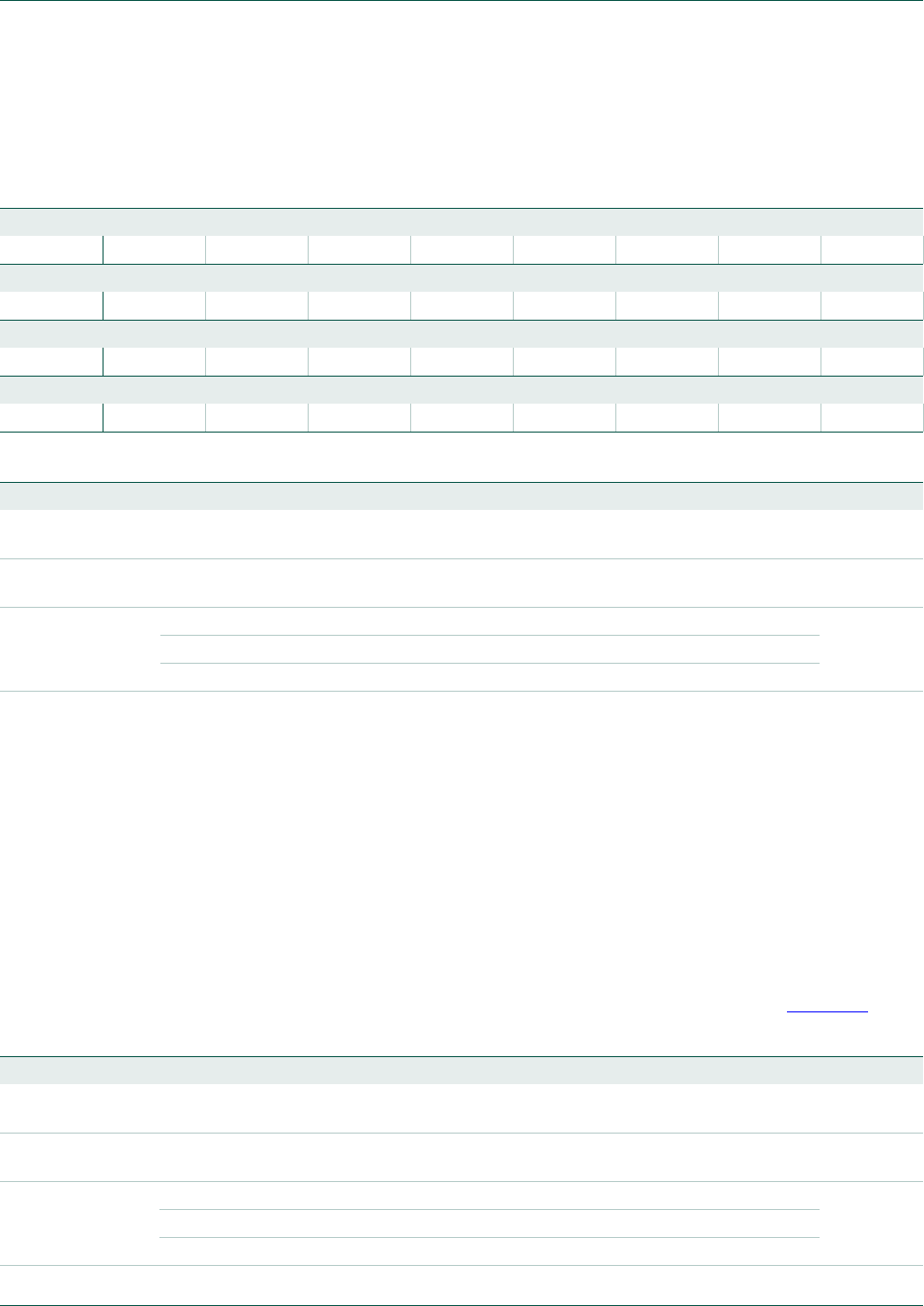
UM10360 All information provided in this document is subject to legal disclaimers. © NXP B.V. 2014. All rights reserved.
User manual Rev. 3.1 — 2 April 2014 245 of 849
NXP Semiconductors UM10360
Chapter 11: LPC176x/5x USB device controller
flag for the DMA engine to start the data transfer if the DMA is enabled for the
corresponding endpoint in the USBEpDMASt register. The DMA cannot be enabled for
control endpoints (EP0 and EP1). USBDMARSt is a read-only register.
[1] DMA can not be enabled for this endpoint and the corresponding bit in the USBDMARSt must be 0.
11.10.7.2 USB DMA Request Clear register (USBDMARClr - 0x5000 C254)
Writing one to a bit in this register will clear the corresponding bit in the USBDMARSt
register. Writing zero has no effect.
This register is intended for initialization prior to enabling the DMA for an endpoint. When
the DMA is enabled for an endpoint, hardware clears the corresponding bit in
USBDMARSt on completion of a packet transfer. Therefore, software should not clear the
bit using this register while the endpoint is enabled for DMA operation.
USBDMARClr is a write-only register.
The USBDMARClr bit allocation is identical to the USBDMARSt register (Ta b le 22 3 ).
Table 223. USB DMA Request Status register (USBDMARSt - address 0x5000 C250) bit allocation
Reset value: 0x0000 0000
Bit 31 30 29 28 27 26 25 24
Symbol EP31 EP30 EP29 EP28 EP27 EP26 EP25 EP24
Bit 23 22 21 20 19 18 17 16
Symbol EP23 EP22 EP21 EP20 EP19 EP18 EP17 EP16
Bit 15 14 13 12 11 10 9 8
Symbol EP15 EP14 EP13 EP12 EP11 EP10 EP9 EP8
Bit 7 6 5 4 3 2 1 0
Symbol EP7 EP6 EP5 EP4 EP3 EP2 EP1 EP0
Table 224. USB DMA Request Status register (USBDMARSt - address 0x5000 C250) bit description
Bit Symbol Value Description Reset value
0EP0 0 Control endpoint OUT (DMA cannot be enabled for this endpoint and EP0 bit
must be 0).
0
1EP1 0 Control endpoint IN (DMA cannot be enabled for this endpoint and EP1 bit
must be 0).
0
31:2 EPxx Endpoint xx (2 xx 31) DMA request. 0
0DMA not requested by endpoint xx.
1DMA requested by endpoint xx.
Table 225. USB DMA Request Clear register (USBDMARClr - address 0x5000 C254) bit description
Bit Symbol Value Description Reset value
0EP0 0 Control endpoint OUT (DMA cannot be enabled for this endpoint and the EP0
bit must be 0).
0
1EP1 0 Control endpoint IN (DMA cannot be enabled for this endpoint and the EP1 bit
must be 0).
0
31:2 EPxx Clear the endpoint xx (2 xx 31) DMA request. 0
0No effect.
1Clear the corresponding bit in USBDMARSt.

UM10360 All information provided in this document is subject to legal disclaimers. © NXP B.V. 2014. All rights reserved.
User manual Rev. 3.1 — 2 April 2014 246 of 849
NXP Semiconductors UM10360
Chapter 11: LPC176x/5x USB device controller
11.10.7.3 USB DMA Request Set register (USBDMARSet - 0x5000 C258)
Writing one to a bit in this register sets the corresponding bit in the USBDMARSt register.
Writing zero has no effect.
This register allows software to raise a DMA request. This can be useful when switching
from Slave to DMA mode of operation for an endpoint: if a packet to be processed in DMA
mode arrives before the corresponding bit of USBEpIntEn is cleared, the DMA request is
not raised by hardware. Software can then use this register to manually start the DMA
transfer.
Software can also use this register to initiate a DMA transfer to proactively fill an IN
endpoint buffer before an IN token packet is received from the host.
USBDMARSet is a write-only register.
The USBDMARSet bit allocation is identical to the USBDMARSt register (Ta b le 2 2 3).
11.10.7.4 USB UDCA Head register (USBUDCAH - 0x5000 C280)
The UDCA (USB Device Communication Area) Head register maintains the address
where the UDCA is located in the RAM. Refer to Section 11.15.2 “USB device
communication area” and Section 11.15.4 “The DMA descriptor” for more details on the
UDCA and DMA descriptors. USBUDCAH is a read/write register.
11.10.7.5 USB EP DMA Status register (USBEpDMASt - 0x5000 C284)
Bits in this register indicate whether DMA operation is enabled for the corresponding
endpoint. A DMA transfer for an endpoint can start only if the corresponding bit is set in
this register. USBEpDMASt is a read-only register.
Table 226. USB DMA Request Set register (USBDMARSet - address 0x5000 C258) bit description
Bit Symbol Value Description Reset value
0EP00 Control endpoint OUT (DMA cannot be enabled for this endpoint and the EP0 bit
must be 0).
0
1EP10 Control endpoint IN (DMA cannot be enabled for this endpoint and the EP1 bit must
be 0).
0
31:2 EPxx Set the endpoint xx (2 xx 31) DMA request. 0
0No effect.
1Set the corresponding bit in USBDMARSt.
Table 227. USB UDCA Head register (USBUDCAH - address 0x5000 C280) bit description
Bit Symbol Description Reset value
6:0 - Reserved. Software should not write ones to reserved bits. The UDCA is aligned to
128-byte boundaries.
0x00
31:7 UDCA_ADDR Start address of the UDCA. 0

UM10360 All information provided in this document is subject to legal disclaimers. © NXP B.V. 2014. All rights reserved.
User manual Rev. 3.1 — 2 April 2014 247 of 849
NXP Semiconductors UM10360
Chapter 11: LPC176x/5x USB device controller
11.10.7.6 USB EP DMA Enable register (USBEpDMAEn - 0x5000 C288)
Writing one to a bit to this register will enable the DMA operation for the corresponding
endpoint. Writing zero has no effect.The DMA cannot be enabled for control endpoints
EP0 and EP1. USBEpDMAEn is a write-only register.
11.10.7.7 USB EP DMA Disable register (USBEpDMADis - 0x5000 C28C)
Writing a one to a bit in this register clears the corresponding bit in USBEpDMASt. Writing
zero has no effect on the corresponding bit of USBEpDMASt. Any write to this register
clears the internal DMA_PROCEED flag. Refer to Section 11.15.5.4 “Optimizing
descriptor fetch” for more information on the DMA_PROCEED flag. If a DMA transfer is in
progress for an endpoint when its corresponding bit is cleared, the transfer is completed
before the DMA is disabled. When an error condition is detected during a DMA transfer,
the corresponding bit is cleared by hardware. USBEpDMADis is a write-only register.
11.10.7.8 USB DMA Interrupt Status register (USBDMAIntSt - 0x5000 C290)
Each bit of this register reflects whether any of the 32 bits in the corresponding interrupt
status register are set. USBDMAIntSt is a read-only register.
Table 228. USB EP DMA Status register (USBEpDMASt - address 0x5000 C284) bit description
Bit Symbol Value Description Reset value
0EP0_DMA_ENABLE0 Control endpoint OUT (DMA cannot be enabled for this endpoint and
the EP0_DMA_ENABLE bit must be 0).
0
1EP1_DMA_ENABLE0 Control endpoint IN (DMA cannot be enabled for this endpoint and
the EP1_DMA_ENABLE bit must be 0).
0
31:2 EPxx_DMA_ENABLE endpoint xx (2 xx 31) DMA enabled bit. 0
0The DMA for endpoint EPxx is disabled.
1The DMA for endpoint EPxx is enabled.
Table 229. USB EP DMA Enable register (USBEpDMAEn - address 0x5000 C288) bit description
Bit Symbol Value Description Reset value
0EP0_DMA_ENABLE0 Control endpoint OUT (DMA cannot be enabled for this endpoint and
the EP0_DMA_ENABLE bit value must be 0).
0
1EP1_DMA_ENABLE0 Control endpoint IN (DMA cannot be enabled for this endpoint and the
EP1_DMA_ENABLE bit must be 0).
0
31:2 EPxx_DMA_ENABLE Endpoint xx(2 xx 31) DMA enable control bit. 0
0 No effect.
1Enable the DMA operation for endpoint EPxx.
Table 230. USB EP DMA Disable register (USBEpDMADis - address 0x5000 C28C) bit description
Bit Symbol Value Description Reset value
0EP0_DMA_DISABLE0 Control endpoint OUT (DMA cannot be enabled for this endpoint and
the EP0_DMA_DISABLE bit value must be 0).
0
1EP1_DMA_DISABLE0 Control endpoint IN (DMA cannot be enabled for this endpoint and the
EP1_DMA_DISABLE bit value must be 0).
0
31:2 EPxx_DMA_DISABLE Endpoint xx (2 xx 31) DMA disable control bit. 0
0No effect.
1Disable the DMA operation for endpoint EPxx.

UM10360 All information provided in this document is subject to legal disclaimers. © NXP B.V. 2014. All rights reserved.
User manual Rev. 3.1 — 2 April 2014 248 of 849
NXP Semiconductors UM10360
Chapter 11: LPC176x/5x USB device controller
11.10.7.9 USB DMA Interrupt Enable register (USBDMAIntEn - 0x5000 C294)
Writing a one to a bit in this register enables the corresponding bit in USBDMAIntSt to
generate an interrupt on the USB_INT_REQ_DMA interrupt line when set. USBDMAIntEn
is a read/write register.
11.10.7.10 USB End of Transfer Interrupt Status register (USBEoTIntSt - 0x5000 C2A0)
When the DMA transfer completes for the current DMA descriptor, either normally
(descriptor is retired) or because of an error, the bit corresponding to the endpoint is set in
this register. The cause of the interrupt is recorded in the DD_status field of the descriptor.
USBEoTIntSt is a read-only register.
Table 231. USB DMA Interrupt Status register (USBDMAIntSt - address 0x5000 C290) bit description
Bit Symbol Value Description Reset value
0EOT End of Transfer Interrupt bit. 0
0All bits in the USBEoTIntSt register are 0.
1At least one bit in the USBEoTIntSt is set.
1NDDR New DD Request Interrupt bit. 0
0All bits in the USBNDDRIntSt register are 0.
1At least one bit in the USBNDDRIntSt is set.
2ERR System Error Interrupt bit. 0
0All bits in the USBSysErrIntSt register are 0.
1At least one bit in the USBSysErrIntSt is set.
31:3 - -Reserved, user software should not write ones to reserved bits. The value read
from a reserved bit is not defined.
NA
Table 232. USB DMA Interrupt Enable register (USBDMAIntEn - address 0x5000 C294) bit description
Bit Symbol Value Description Reset value
0EOT End of Transfer Interrupt enable bit. 0
0The End of Transfer Interrupt is disabled.
1The End of Transfer Interrupt is enabled.
1NDDR New DD Request Interrupt enable bit. 0
0The New DD Request Interrupt is disabled.
1The New DD Request Interrupt is enabled.
2ERR System Error Interrupt enable bit. 0
0The System Error Interrupt is disabled.
1The System Error Interrupt is enabled.
31:3 - -Reserved, user software should not write ones to reserved bits. The value read
from a reserved bit is not defined.
NA
Table 233. USB End of Transfer Interrupt Status register (USBEoTIntSt - address 0x5000 C2A0s) bit description
Bit Symbol Value Description Reset value
31:0 EPxx Endpoint xx (2 xx 31) End of Transfer Interrupt request. 0
0There is no End of Transfer interrupt request for endpoint xx.
1There is an End of Transfer Interrupt request for endpoint xx.

UM10360 All information provided in this document is subject to legal disclaimers. © NXP B.V. 2014. All rights reserved.
User manual Rev. 3.1 — 2 April 2014 249 of 849
NXP Semiconductors UM10360
Chapter 11: LPC176x/5x USB device controller
11.10.7.11 USB End of Transfer Interrupt Clear register (USBEoTIntClr - 0x5000 C2A4)
Writing one to a bit in this register clears the corresponding bit in the USBEoTIntSt
register. Writing zero has no effect. USBEoTIntClr is a write-only register.
11.10.7.12 USB End of Transfer Interrupt Set register (USBEoTIntSet - 0x5000 C2A8)
Writing one to a bit in this register sets the corresponding bit in the USBEoTIntSt register.
Writing zero has no effect. USBEoTIntSet is a write-only register.
11.10.7.13 USB New DD Request Interrupt Status register (USBNDDRIntSt - 0x5000
C2AC)
A bit in this register is set when a transfer is requested from the USB device and no valid
DD is detected for the corresponding endpoint. USBNDDRIntSt is a read-only register.
11.10.7.14 USB New DD Request Interrupt Clear register (USBNDDRIntClr - 0x5000
C2B0)
Writing one to a bit in this register clears the corresponding bit in the USBNDDRIntSt
register. Writing zero has no effect. USBNDDRIntClr is a write-only register.
11.10.7.15 USB New DD Request Interrupt Set register (USBNDDRIntSet - 0x5000
C2B4)
Writing one to a bit in this register sets the corresponding bit in the USBNDDRIntSt
register. Writing zero has no effect. USBNDDRIntSet is a write-only register
Table 234. USB End of Transfer Interrupt Clear register (USBEoTIntClr - address 0x5000 C2A4) bit description
Bit Symbol Value Description Reset value
31:0 EPxx Clear endpoint xx (2 xx 31) End of Transfer Interrupt request. 0
0No effect.
1Clear the EPxx End of Transfer Interrupt request in the USBEoTIntSt register.
Table 235. USB End of Transfer Interrupt Set register (USBEoTIntSet - address 0x5000 C2A8) bit description
Bit Symbol Value Description Reset value
31:0 EPxx Set endpoint xx (2 xx 31) End of Transfer Interrupt request. 0
0No effect.
1Set the EPxx End of Transfer Interrupt request in the USBEoTIntSt register.
Table 236. USB New DD Request Interrupt Status register (USBNDDRIntSt - address 0x5000 C2AC) bit description
Bit Symbol Value Description Reset value
31:0 EPxx Endpoint xx (2 xx 31) new DD interrupt request. 0
0There is no new DD interrupt request for endpoint xx.
1There is a new DD interrupt request for endpoint xx.
Table 237. USB New DD Request Interrupt Clear register (USBNDDRIntClr - address 0x5000 C2B0) bit description
Bit Symbol Value Description Reset value
31:0 EPxx Clear endpoint xx (2 xx 31) new DD interrupt request. 0
0No effect.
1Clear the EPxx new DD interrupt request in the USBNDDRIntSt register.

UM10360 All information provided in this document is subject to legal disclaimers. © NXP B.V. 2014. All rights reserved.
User manual Rev. 3.1 — 2 April 2014 250 of 849
NXP Semiconductors UM10360
Chapter 11: LPC176x/5x USB device controller
11.10.7.16 USB System Error Interrupt Status register (USBSysErrIntSt - 0x5000 C2B8)
If a system error (AHB bus error) occurs when transferring the data or when fetching or
updating the DD the corresponding bit is set in this register. USBSysErrIntSt is a read-only
register.
11.10.7.17 USB System Error Interrupt Clear register (USBSysErrIntClr - 0x5000 C2BC)
Writing one to a bit in this register clears the corresponding bit in the USBSysErrIntSt
register. Writing zero has no effect. USBSysErrIntClr is a write-only register.
11.10.7.18 USB System Error Interrupt Set register (USBSysErrIntSet - 0x5000 C2C0)
Writing one to a bit in this register sets the corresponding bit in the USBSysErrIntSt
register. Writing zero has no effect. USBSysErrIntSet is a write-only register.
11.11 Interrupt handling
This section describes how an interrupt event on any of the endpoints is routed to the
Nested Vectored Interrupt Controller (NVIC). For a diagram showing interrupt event
handling, see Figure 30.
All non-isochronous OUT endpoints (control, bulk, and interrupt endpoints) generate an
interrupt when they receive a packet without an error. All non-isochronous IN endpoints
generate an interrupt when a packet has been successfully transmitted or when a NAK
signal is sent and interrupts on NAK are enabled by the SIE Set Mode command, see
Section 11.12.3. For isochronous endpoints, a frame interrupt is generated every 1 ms.
Table 238. USB New DD Request Interrupt Set register (USBNDDRIntSet - address 0x5000 C2B4) bit description
Bit Symbol Value Description Reset value
31:0 EPxx Set endpoint xx (2 xx 31) new DD interrupt request. 0
0No effect.
1Set the EPxx new DD interrupt request in the USBNDDRIntSt register.
Table 239. USB System Error Interrupt Status register (USBSysErrIntSt - address 0x5000 C2B8) bit description
Bit Symbol Value Description Reset value
31:0 EPxx Endpoint xx (2 xx 31) System Error Interrupt request. 0
0There is no System Error Interrupt request for endpoint xx.
1There is a System Error Interrupt request for endpoint xx.
Table 240. USB System Error Interrupt Clear register (USBSysErrIntClr - address 0x5000 C2BC) bit description
Bit Symbol Value Description Reset value
31:0 EPxx Clear endpoint xx (2 xx 31) System Error Interrupt request. 0
0No effect.
1Clear the EPxx System Error Interrupt request in the USBSysErrIntSt register.
Table 241. USB System Error Interrupt Set register (USBSysErrIntSet - address 0x5000 C2C0) bit description
Bit Symbol Value Description Reset value
31:0 EPxx Set endpoint xx (2 xx 31) System Error Interrupt request. 0
0No effect.
1Set the EPxx System Error Interrupt request in the USBSysErrIntSt register.

UM10360 All information provided in this document is subject to legal disclaimers. © NXP B.V. 2014. All rights reserved.
User manual Rev. 3.1 — 2 April 2014 251 of 849
NXP Semiconductors UM10360
Chapter 11: LPC176x/5x USB device controller
The interrupt handling is different for Slave and DMA mode.
Slave mode
If an interrupt event occurs on an endpoint and the endpoint interrupt is enabled in the
USBEpIntEn register, the corresponding status bit in the USBEpIntSt is set. For
non-isochronous endpoints, all endpoint interrupt events are divided into two types by the
corresponding USBEpIntPri[n] registers: fast endpoint interrupt events and slow endpoint
interrupt events. All fast endpoint interrupt events are ORed and routed to bit EP_FAST in
the USBDevIntSt register. All slow endpoint interrupt events are ORed and routed to the
EP_SLOW bit in USBDevIntSt.
For isochronous endpoints, the FRAME bit in USBDevIntSt is set every 1 ms.
The USBDevIntSt register holds the status of all endpoint interrupt events as well as the
status of various other interrupts (see Section 11.10.2.2). By default, all interrupts (if
enabled in USBDevIntEn) are routed to the USB_INT_REQ_LP bit in the USBIntSt
register to request low priority interrupt handling. However, the USBDevIntPri register can
route either the FRAME or the EP_FAST bit to the USB_INT_REQ_HP bit in the USBIntSt
register.
Only one of the EP_FAST and FRAME interrupt events can be routed to the
USB_INT_REQ_HP bit. If routing both bits to USB_INT_REQ_HP is attempted, both
interrupt events are routed to USB_INT_REQ_LP.
Slow endpoint interrupt events are always routed directly to the USB_INT_REQ_LP bit for
low priority interrupt handling by software.
The final interrupt signal to the NVIC is gated by the EN_USB_INTS bit in the USBIntSt
register. The USB interrupts are routed to the NVIC only if EN_USB_INTS is set.
DMA mode
If an interrupt event occurs on a non-control endpoint and the endpoint interrupt is not
enabled in the USBEpIntEn register, the corresponding status bit in the USBDMARSt is
set by hardware. This serves as a flag for the DMA engine to transfer data if DMA transfer
is enabled for the corresponding endpoint in the USBEpDMASt register.
Three types of interrupts can occur for each endpoint for data transfers in DMA mode: End
of transfer interrupt, new DD request interrupt, and system error interrupt. These interrupt
events set a bit for each endpoint in the respective registers USBEoTIntSt,
USBNDDRIntSt, and USBSysErrIntSt. The End of transfer interrupts from all endpoints
are then Ored and routed to the EOT bit in USBDMAIntSt. Likewise, all New DD request
interrupts and system error interrupt events are routed to the NDDR and ERR bits
respectively in the USBDMAStInt register.
The EOT, NDDR, and ERR bits (if enabled in USBDMAIntEn) are ORed to set the
USB_INT_REQ_DMA bit in the USBIntSt register. If the EN_USB_INTS bit is set in
USBIntSt, the interrupt is routed to the NVIC.
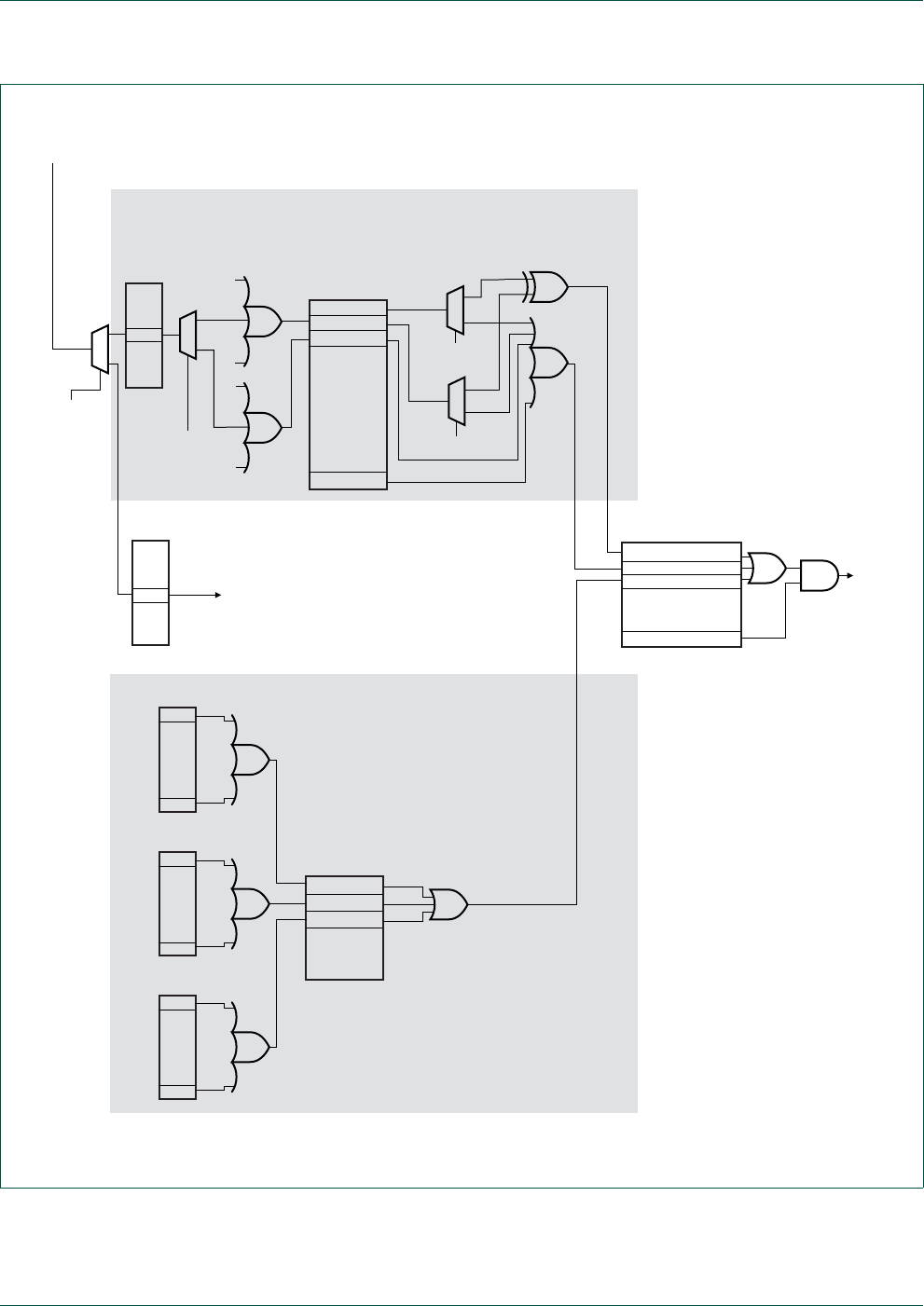
UM10360 All information provided in this document is subject to legal disclaimers. © NXP B.V. 2014. All rights reserved.
User manual Rev. 3.1 — 2 April 2014 252 of 849
NXP Semiconductors UM10360
Chapter 11: LPC176x/5x USB device controller
For simplicity, USBDevIntEn and USBDMAIntEn are not shown.
Fig 30. Interrupt event handling
USB_INT_REQ_HP
USB_INT_REQ_LP
USB_INT_REQ_DMA
EN_USB_INTS
to NVIC
.
.
.
.
.
.
.
.
.
.
.
.
.
.
.
.
.
.
.
.
.
.
.
.
FRAME
EP_FAST
EP_SLOW
USBDevIntPri[0]
USBDevIntPri[1]
USBEpIntPri[n]
USBEpIntSt
USBDMARSt
to DMA engine
interrupt
event on
EPn
n
n
.
.
.
.
0
31
.
.
.
.
0
31
.
.
.
.
0
31
USBEoTIntST
USBNDDRIntSt
USBSysErrIntSt
EOT
NDDR
ERR
USBDevIntSt
USBIntSt
USBEpIntEn[n]
from other
Endpoints
USBDMAIntSt
Slave mode
DMA Mode
ERR_INT

UM10360 All information provided in this document is subject to legal disclaimers. © NXP B.V. 2014. All rights reserved.
User manual Rev. 3.1 — 2 April 2014 253 of 849
NXP Semiconductors UM10360
Chapter 11: LPC176x/5x USB device controller
11.12 Serial interface engine command description
The functions and registers of the Serial Interface Engine (SIE) are accessed using
commands, which consist of a command code followed by optional data bytes (read or
write action). The USBCmdCode (Tabl e 2 21) and USBCmdData (Tab l e 2 2 2 ) registers are
used for these accesses.
A complete access consists of two phases:
1. Command phase: the USBCmdCode register is written with the CMD_PHASE field
set to the value 0x05 (Command), and the CMD_CODE field set to the desired
command code. On completion of the command, the CCEMPTY bit of USBDevIntSt is
set.
2. Data phase (optional): for writes, the USBCmdCode register is written with the
CMD_PHASE field set to the value 0x01 (Write), and the CMD_WDATA field set with
the desired write data. On completion of the write, the CCEMPTY bit of USBDevIntSt
is set. For reads, USBCmdCode register is written with the CMD_PHASE field set to
the value 0x02 (Read), and the CMD_CODE field set with command code the read
corresponds to. On completion of the read, the CDFULL bit of USBDevInSt will be set,
indicating the data is available for reading in the USBCmdData register. In the case of
multi-byte registers, the least significant byte is accessed first.
An overview of the available commands is given in Tab l e 2 42 .
Here is an example of the Read Current Frame Number command (reading 2 bytes):
USBDevIntClr = 0x30; // Clear both CCEMPTY & CDFULL
USBCmdCode = 0x00F50500; // CMD_CODE=0xF5, CMD_PHASE=0x05(Command)
while (!(USBDevIntSt & 0x10)); // Wait for CCEMPTY.
USBDevIntClr = 0x10; // Clear CCEMPTY interrupt bit.
USBCmdCode = 0x00F50200; // CMD_CODE=0xF5, CMD_PHASE=0x02(Read)
while (!(USBDevIntSt & 0x20)); // Wait for CDFULL.
USBDevIntClr = 0x20; // Clear CDFULL.
CurFrameNum = USBCmdData; // Read Frame number LSB byte.
USBCmdCode = 0x00F50200; // CMD_CODE=0xF5, CMD_PHASE=0x02(Read)
while (!(USBDevIntSt & 0x20)); // Wait for CDFULL.
Temp = USBCmdData; // Read Frame number MSB byte
USBDevIntClr = 0x20; // Clear CDFULL interrupt bit.
CurFrameNum = CurFrameNum | (Temp << 8);
Here is an example of the Set Address command (writing 1 byte):
USBDevIntClr = 0x10; // Clear CCEMPTY.
USBCmdCode = 0x00D00500; // CMD_CODE=0xD0, CMD_PHASE=0x05(Command)
while (!(USBDevIntSt & 0x10)); // Wait for CCEMPTY.
USBDevIntClr = 0x10; // Clear CCEMPTY.
USBCmdCode = 0x008A0100; // CMD_WDATA=0x8A(DEV_EN=1, DEV_ADDR=0xA),
// CMD_PHASE=0x01(Write)
while (!(USBDevIntSt & 0x10)); // Wait for CCEMPTY.
USBDevIntClr = 0x10; // Clear CCEMPTY.

UM10360 All information provided in this document is subject to legal disclaimers. © NXP B.V. 2014. All rights reserved.
User manual Rev. 3.1 — 2 April 2014 254 of 849
NXP Semiconductors UM10360
Chapter 11: LPC176x/5x USB device controller
11.12.1 Set Address (Command: 0xD0, Data: write 1 byte)
The Set Address command is used to set the USB assigned address and enable the
(embedded) function. The address set in the device will take effect after the status stage
of the control transaction. After a bus reset, DEV_ADDR is set to 0x00, and DEV_EN is
set to 1. The device will respond to packets for function address 0x00, endpoint 0 (default
endpoint).
11.12.2 Configure Device (Command: 0xD8, Data: write 1 byte)
A value of 1 written to the register indicates that the device is configured and all the
enabled non-control endpoints will respond. Control endpoints are always enabled and
respond even if the device is not configured, in the default state.
Table 242. SIE command code table
Command name Recipient Code (Hex) Data phase
Device commands
Set Address Device D0 Write 1 byte
Configure Device Device D8 Write 1 byte
Set Mode Device F3 Write 1 byte
Read Current Frame Number Device F5 Read 1 or 2 bytes
Read Test Register Device FD Read 2 bytes
Set Device Status Device FE Write 1 byte
Get Device Status Device FE Read 1 byte
Get Error Code Device FF Read 1 byte
Read Error Status Device FB Read 1 byte
Endpoint Commands
Select Endpoint Endpoint 0 00 Read 1 byte (optional)
Endpoint 1 01 Read 1 byte (optional)
Endpoint xx xx Read 1 byte (optional)
Select Endpoint/Clear Interrupt Endpoint 0 40 Read 1 byte
Endpoint 1 41 Read 1 byte
Endpoint xx xx 40 Read 1 byte
Set Endpoint Status Endpoint 0 40 Write 1 byte
Endpoint 1 41 Write 1 byte
Endpoint xx xx 40 Write 1 byte
Clear Buffer Selected Endpoint F2 Read 1 byte (optional)
Validate Buffer Selected Endpoint FA None
Table 243. Set Address command bit description
Bit Symbol Description Reset value
6:0 DEV_ADDR Device address set by the software. After a bus reset this field is set to 0x00. 0x00
7DEV_EN Device Enable. After a bus reset this bit is set to 1.
0: Device will not respond to any packets.
1: Device will respond to packets for function address DEV_ADDR.
0

UM10360 All information provided in this document is subject to legal disclaimers. © NXP B.V. 2014. All rights reserved.
User manual Rev. 3.1 — 2 April 2014 255 of 849
NXP Semiconductors UM10360
Chapter 11: LPC176x/5x USB device controller
11.12.3 Set Mode (Command: 0xF3, Data: write 1 byte)
[1] This bit should be reset to 0 if the DMA is enabled for any of the Interrupt OUT endpoints.
[2] This bit should be reset to 0 if the DMA is enabled for any of the Bulk OUT endpoints.
11.12.4 Read Current Frame Number (Command: 0xF5, Data: read 1 or 2
bytes)
Returns the frame number of the last successfully received SOF. The frame number is
eleven bits wide. The frame number returns least significant byte first. In case the user is
only interested in the lower 8 bits of the frame number, only the first byte needs to be read.
Table 244. Configure Device command bit description
Bit Symbol Description Reset value
0CONF_DEVICEDevice is configured. All enabled non-control endpoints will respond. This bit is
cleared by hardware when a bus reset occurs. When set, the UP_LED signal is
driven LOW if the device is not in the suspended state (SUS=0).
7:1 - Reserved, user software should not write ones to reserved bits. The value read
from a reserved bit is not defined.
NA
Table 245. Set Mode command bit description
Bit Symbol Value Description Reset value
0AP_CLK Always PLL Clock. 0
0USB_NEED_CLK is functional; the 48 MHz clock can be stopped when the
device enters suspend state.
1USB_NEED_CLK is fixed to 1; the 48 MHz clock cannot be stopped when the
device enters suspend state.
1INAK_CI Interrupt on NAK for Control IN endpoint. 0
0Only successful transactions generate an interrupt.
1Both successful and NAKed IN transactions generate interrupts.
2INAK_CO Interrupt on NAK for Control OUT endpoint. 0
0Only successful transactions generate an interrupt.
1Both successful and NAKed OUT transactions generate interrupts.
3INAK_II Interrupt on NAK for Interrupt IN endpoint. 0
0Only successful transactions generate an interrupt.
1Both successful and NAKed IN transactions generate interrupts.
4INAK_IO
[1] Interrupt on NAK for Interrupt OUT endpoints. 0
0Only successful transactions generate an interrupt.
1Both successful and NAKed OUT transactions generate interrupts.
5INAK_BI Interrupt on NAK for Bulk IN endpoints. 0
0Only successful transactions generate an interrupt.
1Both successful and NAKed IN transactions generate interrupts.
6INAK_BO
[2] Interrupt on NAK for Bulk OUT endpoints. 0
0Only successful transactions generate an interrupt.
1Both successful and NAKed OUT transactions generate interrupts.
7- -Reserved, user software should not write ones to reserved bits. The value read
from a reserved bit is not defined.
NA

UM10360 All information provided in this document is subject to legal disclaimers. © NXP B.V. 2014. All rights reserved.
User manual Rev. 3.1 — 2 April 2014 256 of 849
NXP Semiconductors UM10360
Chapter 11: LPC176x/5x USB device controller
•In case no SOF was received by the device at the beginning of a frame, the frame
number returned is that of the last successfully received SOF.
•In case the SOF frame number contained a CRC error, the frame number returned will
be the corrupted frame number as received by the device.
11.12.5 Read Test Register (Command: 0xFD, Data: read 2 bytes)
The test register is 16 bits wide. It returns the value of 0xA50F if the USB clocks (usbclk
and AHB slave clock) are running.
11.12.6 Set Device Status (Command: 0xFE, Data: write 1 byte)
The Set Device Status command sets bits in the Device Status Register.
Table 246. Set Device Status command bit description
Bit Symbol Value Description Reset value
0CON The Connect bit indicates the current connect status of the device. It controls the
CONNECT output pin, used for SoftConnect. Reading the connect bit returns the
current connect status. This bit is cleared by hardware when the VBUS status
input is LOW for more than 3 ms. The 3 ms delay filters out temporary dips in the
VBUS voltage.
0
0Writing a 0 will make the CONNECT pin go HIGH.
1Writing a 1 will make the CONNECT pin go LOW.
1CON_CH Connect Change. 0
0This bit is cleared when read.
1This bit is set when the device’s pull-up resistor is disconnected because VBUS
disappeared. The DEV_STAT interrupt is generated when this bit is 1.
2SUS Suspend: The Suspend bit represents the current suspend state.
When the device is suspended (SUS = 1) and the CPU writes a 0 into it, the
device will generate a remote wake-up. This will only happen when the device is
connected (CON = 1). When the device is not connected or not suspended,
writing a 0 has no effect. Writing a 1 to this bit has no effect.
0
0This bit is reset to 0 on any activity.
1This bit is set to 1 when the device hasn’t seen any activity on its upstream port
for more than 3 ms.
3SUS_CH Suspend (SUS) bit change indicator. The SUS bit can toggle because:
•The device goes into the suspended state.
•The device is disconnected.
•The device receives resume signalling on its upstream port.
This bit is cleared when read.
0
0SUS bit not changed.
1SUS bit changed. At the same time a DEV_STAT interrupt is generated.

UM10360 All information provided in this document is subject to legal disclaimers. © NXP B.V. 2014. All rights reserved.
User manual Rev. 3.1 — 2 April 2014 257 of 849
NXP Semiconductors UM10360
Chapter 11: LPC176x/5x USB device controller
11.12.7 Get Device Status (Command: 0xFE, Data: read 1 byte)
The Get Device Status command returns the Device Status Register. Reading the device
status returns 1 byte of data. The bit field definition is same as the Set Device Status
Register as shown in Tab le 24 6 .
Remark: To ensure correct operation, the DEV_STAT bit of USBDevIntSt must be cleared
before executing the Get Device Status command.
11.12.8 Get Error Code (Command: 0xFF, Data: read 1 byte)
Different error conditions can arise inside the SIE. The Get Error Code command returns
the last error code that occurred. The 4 least significant bits form the error code.
4RST Bus Reset bit. On a bus reset, the device will automatically go to the default
state. In the default state:
•Device is unconfigured.
•Will respond to address 0.
•Control endpoint will be in the Stalled state.
•All endpoints are unrealized except control endpoints EP0 and EP1.
•Data toggling is reset for all endpoints.
•All buffers are cleared.
•There is no change to the endpoint interrupt status.
•DEV_STAT interrupt is generated.
Note: Bus resets are ignored when the device is not connected (CON=0).
0
0This bit is cleared when read.
1This bit is set when the device receives a bus reset. A DEV_STAT interrupt is
generated.
7:5 - Reserved, user software should not write ones to reserved bits. The value read
from a reserved bit is not defined.
NA
Table 246. Set Device Status command bit description
Bit Symbol Value Description Reset value

UM10360 All information provided in this document is subject to legal disclaimers. © NXP B.V. 2014. All rights reserved.
User manual Rev. 3.1 — 2 April 2014 258 of 849
NXP Semiconductors UM10360
Chapter 11: LPC176x/5x USB device controller
11.12.9 Read Error Status (Command: 0xFB, Data: read 1 byte)
This command reads the 8-bit Error register from the USB device. This register records
which error events have recently occurred in the SIE. If any of these bits are set, the
ERR_INT bit of USBDevIntSt is set. The error bits are cleared after reading this register.
11.12.10 Select Endpoint (Command: 0x00 -0x1F, Data: read 1 byte (optional))
The Select Endpoint command initializes an internal pointer to the start of the selected
buffer in EP_RAM. Optionally, this command can be followed by a data read, which
returns some additional information on the packet(s) in the endpoint buffer(s). The
command code of the Select Endpoint command is equal to the physical endpoint
number. In the case of a single buffered endpoint the B_2_FULL bit is not valid.
Table 247. Get Error Code command bit description
Bit Symbol Value Description Reset value
3:0 EC Error Code. 0x0
0000 No Error.
0001 PID Encoding Error.
0010 Unknown PID.
0011 Unexpected Packet - any packet sequence violation from the specification.
0100 Error in Token CRC.
0101 Error in Data CRC.
0110 Time Out Error.
0111 Babble.
1000 Error in End of Packet.
1001 Sent/Received NAK.
1010 Sent Stall.
1011 Buffer Overrun Error.
1100 Sent Empty Packet (ISO Endpoints only).
1101 Bitstuff Error.
1110 Error in Sync.
1111 Wrong Toggle Bit in Data PID, ignored data.
4EA - The Error Active bit will be reset once this register is read.
7:5 - Reserved, user software should not write ones to reserved bits. The value read
from a reserved bit is not defined.
NA
Table 248. Read Error Status command bit description
Bit Symbol Description Reset value
0PID_ERRPID encoding error or Unknown PID or Token CRC. 0
1UEPKT Unexpected Packet - any packet sequence violation from the specification. 0
2DCRC Data CRC error. 0
3TIMEOUTTime out error. 0
4EOP End of packet error. 0
5B_OVRNBuffer Overrun. 0
6BTSTF Bit stuff error. 0
7TGL_ERRWrong toggle bit in data PID, ignored data. 0

UM10360 All information provided in this document is subject to legal disclaimers. © NXP B.V. 2014. All rights reserved.
User manual Rev. 3.1 — 2 April 2014 259 of 849
NXP Semiconductors UM10360
Chapter 11: LPC176x/5x USB device controller
11.12.11 Select Endpoint/Clear Interrupt (Command: 0x40 - 0x5F, Data: read 1
byte)
Commands 0x40 to 0x5F are identical to their Select Endpoint equivalents, with the
following differences:
•They clear the bit corresponding to the endpoint in the USBEpIntSt register.
•In case of a control OUT endpoint, they clear the STP and PO bits in the
corresponding Select Endpoint Register.
•Reading one byte is obligatory.
Table 249. Select Endpoint command bit description
Bit Symbol Value Description Reset value
0FE Full/Empty. This bit indicates the full or empty status of the endpoint buffer(s).
For IN endpoints, the FE bit gives the ANDed result of the B_1_FULL and
B_2_FULL bits. For OUT endpoints, the FE bit gives ORed result of the
B_1_FULL and B_2_FULL bits. For single buffered endpoints, this bit simply
reflects the status of B_1_FULL.
0
0For an IN endpoint, at least one write endpoint buffer is empty.
1For an OUT endpoint, at least one endpoint read buffer is full.
1ST Stalled endpoint indicator. 0
0The selected endpoint is not stalled.
1The selected endpoint is stalled.
2STP SETUP bit: the value of this bit is updated after each successfully received
packet (i.e. an ACKed package on that particular physical endpoint).
0
0 The STP bit is cleared by doing a Select Endpoint/Clear Interrupt on this
endpoint.
1The last received packet for the selected endpoint was a SETUP packet.
3PO Packet over-written bit. 0
0The PO bit is cleared by the ‘Select Endpoint/Clear Interrupt’ command.
1 The previously received packet was over-written by a SETUP packet.
4EPN EP NAKed bit indicates sending of a NAK. If the host sends an OUT packet to a
filled OUT buffer, the device returns NAK. If the host sends an IN token packet
to an empty IN buffer, the device returns NAK.
0
0The EPN bit is reset after the device has sent an ACK after an OUT packet or
when the device has seen an ACK after sending an IN packet.
1The EPN bit is set when a NAK is sent and the interrupt on NAK feature is
enabled.
5B_1_FULL The buffer 1 status. 0
0Buffer 1 is empty.
1Buffer 1 is full.
6B_2_FULL The buffer 2 status. 0
0Buffer 2 is empty.
1Buffer 2 is full.
7- -Reserved, user software should not write ones to reserved bits. The value read
from a reserved bit is not defined.
NA

UM10360 All information provided in this document is subject to legal disclaimers. © NXP B.V. 2014. All rights reserved.
User manual Rev. 3.1 — 2 April 2014 260 of 849
NXP Semiconductors UM10360
Chapter 11: LPC176x/5x USB device controller
Remark: This command may be invoked by using the USBCmdCode and USBCmdData
registers, or by setting the corresponding bit in USBEpIntClr. For ease of use, using the
USBEpIntClr register is recommended.
11.12.12 Set Endpoint Status (Command: 0x40 - 0x55, Data: write 1 byte
(optional))
The Set Endpoint Status command sets status bits 7:5 and 0 of the endpoint. The
Command Code of Set Endpoint Status is equal to the sum of 0x40 and the physical
endpoint number in hex. Not all bits can be set for all types of endpoints.
11.12.13 Clear Buffer (Command: 0xF2, Data: read 1 byte (optional))
When an OUT packet sent by the host has been received successfully, an internal
hardware FIFO status Buffer_Full flag is set. All subsequent packets will be refused by
returning a NAK. When the device software has read the data, it should free the buffer by
issuing the Clear Buffer command. This clears the internal Buffer_Full flag. When the
buffer is cleared, new packets will be accepted.
When bit 0 of the optional data byte is 1, the previously received packet was over-written
by a SETUP packet. The Packet over-written bit is used only in control transfers.
According to the USB specification, a SETUP packet should be accepted irrespective of
the buffer status. The software should always check the status of the PO bit after reading
Table 250. Set Endpoint Status command bit description
Bit Symbol Value Description Reset value
0ST Stalled endpoint bit. A Stalled control endpoint is automatically unstalled when it
receives a SETUP token, regardless of the content of the packet. If the endpoint
should stay in its stalled state, the CPU can stall it again by setting this bit. When
a stalled endpoint is unstalled - either by the Set Endpoint Status command or by
receiving a SETUP token - it is also re-initialized. This flushes the buffer: in case
of an OUT buffer it waits for a DATA 0 PID; in case of an IN buffer it writes a DATA
0 PID. There is no change of the interrupt status of the endpoint. When already
unstalled, writing a zero to this bit initializes the endpoint. When an endpoint is
stalled by the Set Endpoint Status command, it is also re-initialized.
0
0The endpoint is unstalled.
1The endpoint is stalled.
4:1 - -Reserved, user software should not write ones to reserved bits. The value read
from a reserved bit is not defined.
NA
5DA Disabled endpoint bit. 0
0The endpoint is enabled.
1The endpoint is disabled.
6RF_MO Rate Feedback Mode. 0
0Interrupt endpoint is in the Toggle mode.
1Interrupt endpoint is in the Rate Feedback mode. This means that transfer takes
place without data toggle bit.
7CND_ST Conditional Stall bit. 0
0Unstalls both control endpoints.
1Stall both control endpoints, unless the STP bit is set in the Select Endpoint
register. It is defined only for control OUT endpoints.

UM10360 All information provided in this document is subject to legal disclaimers. © NXP B.V. 2014. All rights reserved.
User manual Rev. 3.1 — 2 April 2014 261 of 849
NXP Semiconductors UM10360
Chapter 11: LPC176x/5x USB device controller
the SETUP data. If it is set then it should discard the previously read data, clear the PO bit
by issuing a Select Endpoint/Clear Interrupt command, read the new SETUP data and
again check the status of the PO bit.
See Section 11.14 “Slave mode operation” for a description of when this command is
used.
11.12.14 Validate Buffer (Command: 0xFA, Data: none)
When the CPU has written data into an IN buffer, software should issue a Validate Buffer
command. This tells hardware that the buffer is ready for sending on the USB bus.
Hardware will send the contents of the buffer when the next IN token packet is received.
Internally, there is a hardware FIFO status flag called Buffer_Full. This flag is set by the
Validate Buffer command and cleared when the data has been sent on the USB bus and
the buffer is empty.
A control IN buffer cannot be validated when its corresponding OUT buffer has the Packet
Over-written (PO) bit (see the Clear Buffer Register) set or contains a pending SETUP
packet. For the control endpoint the validated buffer will be invalidated when a SETUP
packet is received.
See Section 11.14 “Slave mode operation” for a description of when this command is
used.
11.13 USB device controller initialization
The LPC176x/5x USB device controller initialization includes the following steps:
1. Enable the device controller by setting the PCUSB bit of PCONP.
2. Configure and enable the PLL and Clock Dividers to provide 48 MHz for usbclk and
the desired frequency for cclk. For the procedure for determining the PLL setting and
configuration, see Section 4.5.11 “Procedure for determining PLL0 settings”.
3. Enable the device controller clocks by setting DEV_CLK_EN and AHB_CLK_EN bits
in the USBClkCtrl register. Poll the respective clock bits in the USBClkSt register until
they are set.
4. Enable the USB pin functions by writing to the corresponding PINSEL register.
5. Disable the pull-ups and pull-downs on the VBUS pin using the corresponding
PINMODE register by putting the pin in the “pin has neither pull-up nor pull-down
resistor enabled” mode. See Section 8.4 “Pin mode select register values”.
6. Set USBEpIn and USBMaxPSize registers for EP0 and EP1, and wait until the
EP_RLZED bit in USBDevIntSt is set so that EP0 and EP1 are realized.
Table 251. Clear Buffer command bit description
Bit Symbol Value Description Reset value
0PO Packet over-written bit. This bit is only applicable to the control endpoint EP0. 0
0The previously received packet is intact.
1The previously received packet was over-written by a later SETUP packet.
7:1 - - Reserved, user software should not write ones to reserved bits. The value read from
a reserved bit is not defined.
NA

UM10360 All information provided in this document is subject to legal disclaimers. © NXP B.V. 2014. All rights reserved.
User manual Rev. 3.1 — 2 April 2014 262 of 849
NXP Semiconductors UM10360
Chapter 11: LPC176x/5x USB device controller
7. Enable endpoint interrupts (Slave mode):
–Clear all endpoint interrupts using USBEpIntClr.
–Clear any device interrupts using USBDevIntClr.
–Enable Slave mode for the desired endpoints by setting the corresponding bits in
USBEpIntEn.
–Set the priority of each enabled interrupt using USBEpIntPri.
–Configure the desired interrupt mode using the SIE Set Mode command.
–Enable device interrupts using USBDevIntEn (normally DEV_STAT, EP_SLOW,
and possibly EP_FAST).
8. Configure the DMA (DMA mode):
–Disable DMA operation for all endpoints using USBEpDMADis.
–Clear any pending DMA requests using USBDMARClr.
–Clear all DMA interrupts using USBEoTIntClr, USBNDDRIntClr, and
USBSysErrIntClr.
–Prepare the UDCA in system memory.
–Write the desired address for the UDCA to USBUDCAH.
–Enable the desired endpoints for DMA operation using USBEpDMAEn.
–Set EOT, DDR, and ERR bits in USBDMAIntEn.
9. Install USB interrupt handler in the NVIC by writing its address to the appropriate
vector table location and enabling the USB interrupt in the NVIC.
10. Set default USB address to 0x0 and DEV_EN to 1 using the SIE Set Address
command. A bus reset will also cause this to happen.
11. Set CON bit to 1 to make CONNECT active using the SIE Set Device Status
command.
The configuration of the endpoints varies depending on the software application. By
default, all the endpoints are disabled except control endpoints EP0 and EP1. Additional
endpoints are enabled and configured by software after a SET_CONFIGURATION or
SET_INTERFACE device request is received from the host.
11.14 Slave mode operation
In Slave mode, the CPU transfers data between RAM and the endpoint buffer using the
Register Interface.
11.14.1 Interrupt generation
In slave mode, data packet transfer between RAM and an endpoint buffer can be initiated
in response to an endpoint interrupt. Endpoint interrupts are enabled using the
USBEpIntEn register, and are observable in the USBEpIntSt register.
All non-isochronous OUT endpoints generate an endpoint interrupt when they receive a
packet without an error. All non-isochronous IN endpoints generate an interrupt when a
packet is successfully transmitted, or when a NAK handshake is sent on the bus and the
interrupt on NAK feature is enabled.

UM10360 All information provided in this document is subject to legal disclaimers. © NXP B.V. 2014. All rights reserved.
User manual Rev. 3.1 — 2 April 2014 263 of 849
NXP Semiconductors UM10360
Chapter 11: LPC176x/5x USB device controller
For Isochronous endpoints, transfer of data is done when the FRAME interrupt (in
USBDevIntSt) occurs.
11.14.2 Data transfer for OUT endpoints
When the software wants to read the data from an endpoint buffer it should set the
RD_EN bit and program LOG_ENDPOINT with the desired endpoint number in the
USBCtrl register. The control logic will fetch the packet length to the USBRxPLen register,
and set the PKT_RDY bit (Tab l e 2 1 7 ).
Software can now start reading the data from the USBRxData register (Ta ble 2 1 6). When
the end of packet is reached, the RD_EN bit is cleared, and the RxENDPKT bit is set in
the USBDevSt register. Software now issues a Clear Buffer (refer to Ta b le 25 1 ) command.
The endpoint is now ready to accept the next packet. For OUT isochronous endpoints, the
next packet will be received irrespective of whether the buffer has been cleared. Any data
not read from the buffer before the end of the frame is lost. See Section 11.16 “Double
buffered endpoint operation” for more details.
If the software clears RD_EN before the entire packet is read, reading is terminated, and
the data remains in the endpoint’s buffer. When RD_EN is set again for this endpoint, the
data will be read from the beginning.
11.14.3 Data transfer for IN endpoints
When writing data to an endpoint buffer, WR_EN (Section 11.10.5.5 “USB Control register
(USBCtrl - 0x5000 C228)”) is set and software writes to the number of bytes it is going to
send in the packet to the USBTxPLen register (Section 11.10.5.4). It can then write data
continuously in the USBTxData register.
When the number of bytes programmed in USBTxPLen have been written to USBTxData,
the WR_EN bit is cleared, and the TxENDPKT bit is set in the USBDevIntSt register.
Software issues a Validate Buffer (Section 11.12.14 “Validate Buffer (Command: 0xFA,
Data: none)”) command. The endpoint is now ready to send the packet. For IN
isochronous endpoints, the data in the buffer will be sent only if the buffer is validated
before the next FRAME interrupt occurs; otherwise, an empty packet will be sent in the
next frame. If the software clears WR_EN before the entire packet is written, writing will
start again from the beginning the next time WR_EN is set for this endpoint.
Both RD_EN and WR_EN can be high at the same time for the same logical endpoint.
Interleaved read and write operation is possible.
11.15 DMA operation
In DMA mode, the DMA transfers data between RAM and the endpoint buffer.
The following sections discuss DMA mode operation. Background information is given in
sections Section 11.15.2 “USB device communication area” and Section 11.15.3
“Triggering the DMA engine”. The fields of the DMA Descriptor are described in
Section 11.15.4 “The DMA descriptor”. The last three sections describe DMA operation:
Section 11.15.5 “Non-isochronous endpoint operation”, Section 11.15.6 “Isochronous
endpoint operation”, and Section 11.15.7 “Auto Length Transfer Extraction (ATLE) mode
operation”.
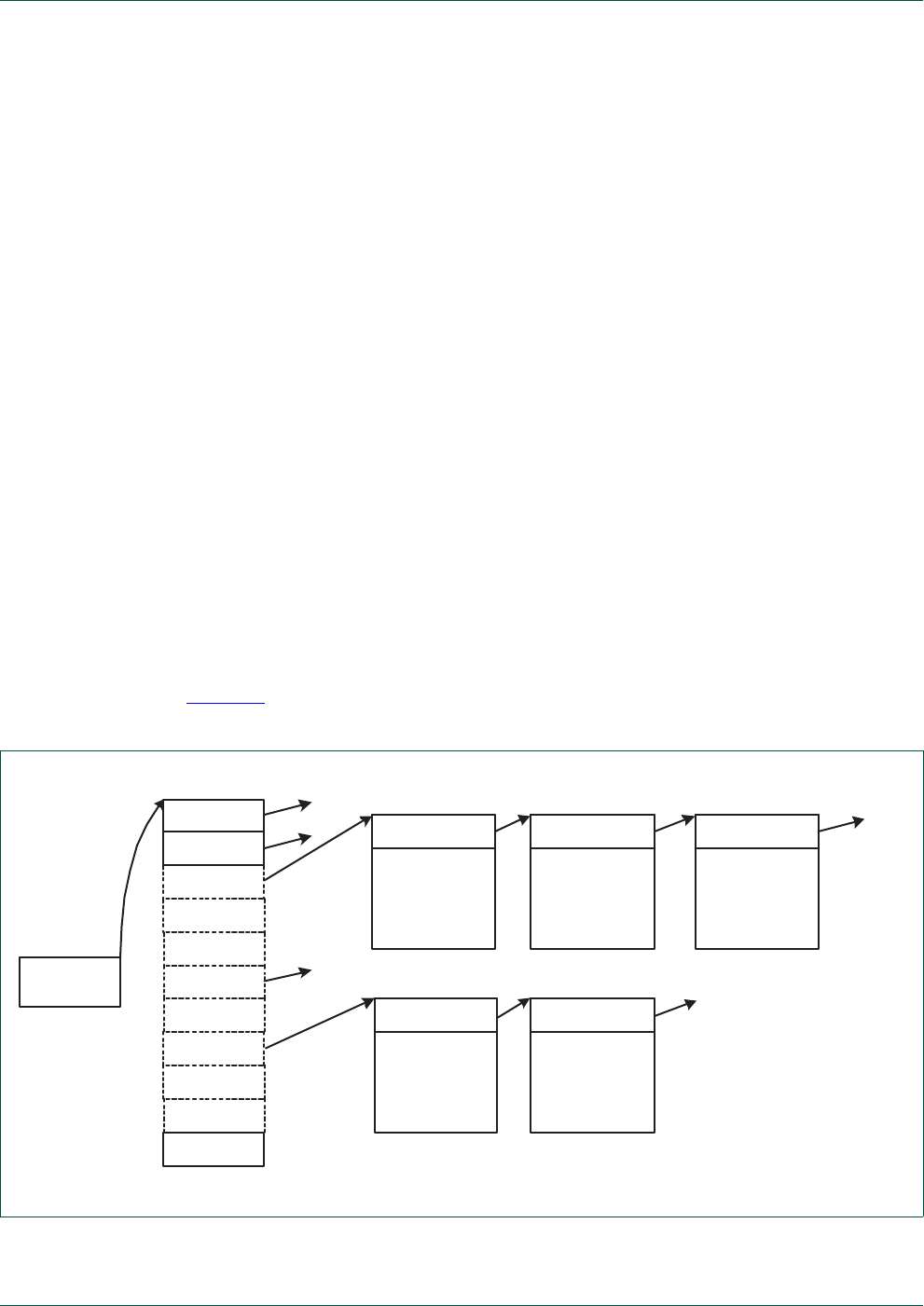
UM10360 All information provided in this document is subject to legal disclaimers. © NXP B.V. 2014. All rights reserved.
User manual Rev. 3.1 — 2 April 2014 264 of 849
NXP Semiconductors UM10360
Chapter 11: LPC176x/5x USB device controller
11.15.1 Transfer terminology
Within this section three types of transfers are mentioned:
1. USB transfers – transfer of data over the USB bus. The USB 2.0 specification refers
to these simply as transfers. Within this section they are referred to as USB transfers
to distinguish them from DMA transfers. A USB transfer is composed of transactions.
Each transaction is composed of packets.
2. DMA transfers – the transfer of data between an endpoint buffer and system memory
(RAM).
3. Packet transfers – in this section, a packet transfer refers to the transfer of a packet of
data between an endpoint buffer and system memory (RAM). A DMA transfer is
composed of one or more packet transfers.
11.15.2 USB device communication area
The CPU and DMA controller communicate through a common area of memory, called the
USB Device Communication Area, or UDCA. The UDCA is a 32-word array of DMA
Descriptor Pointers (DDPs), each of which corresponds to a physical endpoint. Each DDP
points to the start address of a DMA Descriptor, if one is defined for the endpoint. DDPs
for unrealized endpoints and endpoints disabled for DMA operation are ignored and can
be set to a NULL (0x0) value.
The start address of the UDCA is stored in the USBUDCAH register. The UDCA can
reside at any 128-byte boundary of RAM that is accessible to both the CPU and DMA
controller.
Figure 31 illustrates the UDCA and its relationship to the UDCA Head (USBUDCAH)
register and DMA Descriptors.
Fig 31. UDCA Head register and DMA Descriptors
UDCA HEAD
REGISTER
1
31
DDP-EP2
2
DD-EP2-a
NULL
NULL Next_DD_pointer
0NULL
DDP-EP31
NULL
DDP-EP16
16
NULL
DD-EP2-b
Next_DD_pointer
DD-EP2-c
Next_DD_pointer
DD-EP16-a
Next_DD_pointer
DD-EP16-b
Next_DD_pointer
UDCA

UM10360 All information provided in this document is subject to legal disclaimers. © NXP B.V. 2014. All rights reserved.
User manual Rev. 3.1 — 2 April 2014 265 of 849
NXP Semiconductors UM10360
Chapter 11: LPC176x/5x USB device controller
11.15.3 Triggering the DMA engine
An endpoint raises a DMA request when Slave mode is disabled by setting the
corresponding bit in the USBEpIntEn register to 0 (Section 11.10.3.2) and an endpoint
interrupt occurs (see Section 11.10.7.1 “USB DMA Request Status register (USBDMARSt
- 0x5000 C250)”).
A DMA transfer for an endpoint starts when the endpoint is enabled for DMA operation in
USBEpDMASt, the corresponding bit in USBDMARSt is set, and a valid DD is found for
the endpoint.
All endpoints share a single DMA channel to minimize hardware overhead. If more than
one DMA request is active in USBDMARSt, the endpoint with the lowest physical endpoint
number is processed first.
In DMA mode, the bits corresponding to Interrupt on NAK for Bulk OUT and Interrupt OUT
endpoints (INAK_BO and INAK_IO) should be set to 0 using the SIE Set Mode command
(Section 11.12.3).
11.15.4 The DMA descriptor
DMA transfers are described by a data structure called the DMA Descriptor (DD).
DDs are placed in RAM. These descriptors can be located anywhere in on-chip RAM at
word-aligned addresses.
DDs for non-isochronous endpoints are four words long. DDs for isochronous endpoints
are five words long.
The parameters associated with a DMA transfer are:
•The start address of the DMA buffer
•The length of the DMA buffer
•The start address of the next DMA descriptor
•Control information
•Count information (number of bytes transferred)
•Status information
Tab l e 2 52 lists the DMA descriptor fields.
Table 252. DMA descriptor
Word
position
Access
(H/W)
Access
(S/W)
Bit
position
Description
0RR/W31:0Next_DD_pointer

UM10360 All information provided in this document is subject to legal disclaimers. © NXP B.V. 2014. All rights reserved.
User manual Rev. 3.1 — 2 April 2014 266 of 849
NXP Semiconductors UM10360
Chapter 11: LPC176x/5x USB device controller
[1] Write-only in ATLE mode
Legend: R - Read; W - Write; I - Initialize
11.15.4.1 Next_DD_pointer
Pointer to the memory location from where the next DMA descriptor will be fetched.
11.15.4.2 DMA_mode
Specifies the DMA mode of operation. Two modes have been defined: Normal and
Automatic Transfer Length Extraction (ATLE) mode. In normal mode, software initializes
the DMA_buffer_length for OUT endpoints. In ATLE mode, the DMA_buffer_length is
extracted from the incoming data. See Section 11.15.7 “Auto Length Transfer Extraction
(ATLE) mode operation” on page 272 for more details.
11.15.4.3 Next_DD_valid
This bit indicates whether the software has prepared the next DMA descriptor. If set, the
DMA engine fetches the new descriptor when it is finished with the current one.
1RR/W1:0DMA_mode (00 -Normal; 01 - ATLE)
RR/W2 Next_DD_valid (1 - valid; 0 - invalid)
--3Reserved
RR/W4 Isochronous_endpoint (1 - isochronous; 0 - non-isochronous)
RR/W15:5Max_packet_size
R/W[1] R/W 31:16 DMA_buffer_length
This value is specified in bytes for non-isochronous endpoints and in
number of packets for isochronous endpoints.
2R/W R/W 31:0 DMA_buffer_start_addr
3R/W R/I 0 DD_retired (To be initialized to 0)
WR/I4:1DD_status (To be initialized to 0000):
0000 - NotServiced
0001 - BeingServiced
0010 - NormalCompletion
0011 - DataUnderrun (short packet)
1000 - DataOverrun
1001 - SystemError
WR/I5 Packet_valid (To be initialized to 0)
WR/I6 LS_byte_extracted (ATLE mode) (To be initialized to 0)
WR/I7 MS_byte_extracted (ATLE mode) (To be initialized to 0)
RW13:8Message_length_position (ATLE mode)
--15:14 Reserved
R/W R/I 31:16 Present_DMA_count (To be initialized to 0)
4R/W R/W 31:0 Isochronous_packetsize_memory_address
Table 252. DMA descriptor
Word
position
Access
(H/W)
Access
(S/W)
Bit
position
Description

UM10360 All information provided in this document is subject to legal disclaimers. © NXP B.V. 2014. All rights reserved.
User manual Rev. 3.1 — 2 April 2014 267 of 849
NXP Semiconductors UM10360
Chapter 11: LPC176x/5x USB device controller
11.15.4.4 Isochronous_endpoint
When set, this bit indicates that the descriptor belongs to an isochronous endpoint. Hence
5 words have to be read when fetching it.
11.15.4.5 Max_packet_size
The maximum packet size of the endpoint. This parameter is used while transferring the
data for IN endpoints from the memory. It is used for OUT endpoints to detect the short
packet. This is applicable to non-isochronous endpoints only. This field should be set to
the same MPS value that is assigned for the endpoint using the USBMaxPSize register.
11.15.4.6 DMA_buffer_length
This indicates the depth of the DMA buffer allocated for transferring the data. The DMA
engine will stop using this descriptor when this limit is reached and will look for the next
descriptor.
In Normal mode operation, software sets this value for both IN and OUT endpoints. In
ATLE mode operation, software sets this value for IN endpoints only. For OUT endpoints,
hardware sets this value using the extracted length of the data stream.
For isochronous endpoints, DMA_buffer_length is specified in number of packets, for
non-isochronous endpoints in bytes.
11.15.4.7 DMA_buffer_start_addr
The address where the data is read from or written to. This field is updated each time the
DMA engine finishes transferring a packet.
11.15.4.8 DD_retired
This bit is set by hardware when the DMA engine finishes the current descriptor. This
happens when the end of the buffer is reached, a short packet is transferred
(non-isochronous endpoints), or an error condition is detected.
11.15.4.9 DD_status
The status of the DMA transfer is encoded in this field. The following codes are defined:
•NotServiced - No packet has been transferred yet.
•BeingServiced - At least one packet is transferred.
•NormalCompletion - The DD is retired because the end of the buffer is reached and
there were no errors. The DD_retired bit is also set.
•DataUnderrun - Before reaching the end of the DMA buffer, the USB transfer is
terminated because a short packet is received. The DD_retired bit is also set.
•DataOverrun - The end of the DMA buffer is reached in the middle of a packet
transfer. This is an error situation. The DD_retired bit is set. The present DMA count
field is equal to the value of DMA_buffer_length. The packet must be re-transmitted
from the endpoint buffer in another DMA transfer. The corresponding
EPxx_DMA_ENABLE bit in USBEpDMASt is cleared.
•SystemError - The DMA transfer being serviced is terminated because of an error on
the AHB bus. The DD_retired bit is not set in this case. The corresponding
EPxx_DMA_ENABLE in USBEpDMASt is cleared. Since a system error can happen
while updating the DD, the DD fields in RAM may be unreliable.

UM10360 All information provided in this document is subject to legal disclaimers. © NXP B.V. 2014. All rights reserved.
User manual Rev. 3.1 — 2 April 2014 268 of 849
NXP Semiconductors UM10360
Chapter 11: LPC176x/5x USB device controller
11.15.4.10 Packet_valid
This bit is used for isochronous endpoints. It indicates whether the last packet transferred
to the memory is received with errors or not. This bit is set if the packet is valid, i.e., it was
received without errors. See Section 11.15.6 “Isochronous endpoint operation” on page
270 for isochronous endpoint operation.
This bit is unnecessary for non-isochronous endpoints because a DMA request is
generated only for packets without errors, and thus Packet_valid will always be set when
the request is generated.
11.15.4.11 LS_byte_extracted
Used in ATLE mode. When set, this bit indicates that the Least Significant Byte (LSB) of
the transfer length has been extracted. The extracted size is reflected in the
DMA_buffer_length field, bits 23:16.
11.15.4.12 MS_byte_extracted
Used in ATLE mode. When set, this bit indicates that the Most Significant Byte (MSB) of
the transfer size has been extracted. The size extracted is reflected in the
DMA_buffer_length field, bits 31:24. Extraction stops when LS_Byte_extracted and
MS_byte_extracted bits are set.
11.15.4.13 Present_DMA_count
The number of bytes transferred by the DMA engine. The DMA engine updates this field
after completing each packet transfer.
For isochronous endpoints, Present_DMA_count is the number of packets transferred; for
non-isochronous endpoints, Present_DMA_count is the number of bytes.
11.15.4.14 Message_length_position
Used in ATLE mode. This field gives the offset of the message length position embedded
in the incoming data packets. This is applicable only for OUT endpoints. Offset 0 indicates
that the message length starts from the first byte of the first packet.
11.15.4.15 Isochronous_packetsize_memory_address
The memory buffer address where the packet size information along with the frame
number has to be transferred or fetched. See Figure 32. This is applicable to isochronous
endpoints only.
11.15.5 Non-isochronous endpoint operation
11.15.5.1 Setting up DMA transfers
Software prepares the DMA Descriptors (DDs) for those physical endpoints to be enabled
for DMA transfer. These DDs are present in on-chip RAM. The start address of the first
DD is programmed into the DMA Description pointer (DDP) location for the corresponding
endpoint in the UDCA. Software then sets the EPxx_DMA_ENABLE bit for this endpoint in
the USBEpDMAEn register (Section 11.10.7.6).The DMA_mode bit field in the descriptor
is set to ‘00’ for normal mode operation. All other DD fields are initialized as specified in
Tab l e 2 52 .

UM10360 All information provided in this document is subject to legal disclaimers. © NXP B.V. 2014. All rights reserved.
User manual Rev. 3.1 — 2 April 2014 269 of 849
NXP Semiconductors UM10360
Chapter 11: LPC176x/5x USB device controller
DMA operation is not supported for physical endpoints 0 and 1 (default control endpoints).
11.15.5.2 Finding DMA Descriptor
When there is a trigger for a DMA transfer for an endpoint, the DMA engine will first
determine whether a new descriptor has to the fetched or not. A new descriptor does not
have to be fetched if the last packet transferred was for the same endpoint and the DD is
not yet in the retired state. An internal flag called DMA_PROCEED is used to identify this
condition (see Section 11.15.5.4 “Optimizing descriptor fetch” on page 269).
If a new descriptor has to be read, the DMA engine will calculate the location of the DDP
for this endpoint and will fetch the start address of the DD from this location. A DD start
address at location zero is considered invalid. In this case the NDDR interrupt is raised.
All other word-aligned addresses are considered valid.
When the DD is fetched, the DD status word (word 3) is read first and the status of the
DD_retired bit is checked. If not set, DDP points to a valid DD. If DD_retired is set, the
DMA engine will read the control word (word 1) of the DD.
If Next_DD_valid bit is set, the DMA engine will fetch the Next_DD_pointer field (word 0)
of the DD and load it to the DDP. The new DDP is written to the UDCA area.
The full DD (4 words) will then be fetched from the address in the DDP. The DD will give
the details of the DMA transfer to be done. The DMA engine will load its hardware
resources with the information fetched from the DD (start address, DMA count etc.).
If Next_DD_valid is not set and DD_retired bit is set, the DMA engine raises the NDDR
interrupt for this endpoint and clears the corresponding EPxx_DMA_ENABLE bit.
11.15.5.3 Transferring the data
For OUT endpoints, the current packet is read from the EP_RAM by the DMA Engine and
transferred to on-chip RAM memory locations starting from DMA_buffer_start_addr. For
IN endpoints, the data is fetched from on-chip RAM at DMA_buffer_start_addr and written
to the EP_RAM. The DMA_buffer_start_addr and Present_DMA_count fields are updated
after each packet is transferred.
11.15.5.4 Optimizing descriptor fetch
A DMA transfer normally involves multiple packet transfers. Hardware will not re-fetch a
new DD from memory unless the endpoint changes. To indicate an ongoing multi-packet
transfer, hardware sets an internal flag called DMA_PROCEED.
The DMA_PROCEED flag is cleared after the required number of bytes specified in the
DMA_buffer_length field is transferred. It is also cleared when the software writes into the
USBEpDMADis register. The ability to clear the DMA_PROCEED flag allows software to
force the DD to be re-fetched for the next packet transfer. Writing all zeros into the
USBEpDMADis register clears the DMA_PROCEED flag without disabling DMA operation
for any endpoint.
11.15.5.5 Ending the packet transfer
On completing a packet transfer, the DMA engine writes back the DD with updated status
information to the same memory location from where it was read. The
DMA_buffer_start_addr, Present_DMA_count, and the DD_status fields in the DD are
updated.

UM10360 All information provided in this document is subject to legal disclaimers. © NXP B.V. 2014. All rights reserved.
User manual Rev. 3.1 — 2 April 2014 270 of 849
NXP Semiconductors UM10360
Chapter 11: LPC176x/5x USB device controller
A DD can have the following types of completion:
Normal completion - If the current packet is fully transferred and the
Present_DMA_count field equals the DMA_buffer_length, the DD has completed
normally. The DD will be written back to memory with DD_retired set and DD_status set
to NormalCompletion. The EOT interrupt is raised for this endpoint.
USB transfer end completion - If the current packet is fully transferred and its size is
less than the Max_packet_size field, and the end of the DMA buffer is still not reached,
the USB transfer end completion occurs. The DD will be written back to the memory
with DD_retired set and DD_Status set to the DataUnderrun completion code. The EOT
interrupt is raised for this endpoint.
Error completion - If the current packet is partially transferred i.e. the end of the DMA
buffer is reached in the middle of the packet transfer, an error situation occurs. The DD
is written back with DD_retired set and DD_status set to the DataOverrun status code.
The EOT interrupt is raised for this endpoint and the corresponding bit in USBEpDMASt
register is cleared. The packet will be re-sent from the endpoint buffer to memory when
the corresponding EPxx_DMA_ENABLE bit is set again using the USBEpDMAEn
register.
11.15.5.6 No_Packet DD
For an IN transfer, if the system does not have any data to send for a while, it can respond
to an NDDR interrupt by programming a No_Packet DD. This is done by setting both the
Max_packet_size and DMA_buffer_length fields in the DD to 0. On processing a
No_Packet DD, the DMA engine clears the DMA request bit in USBDMARSt
corresponding to the endpoint without transferring a packet. The DD is retired with a
status code of NormalCompletion. This can be repeated as often as necessary. The
device will respond to IN token packets on the USB bus with a NAK until a DD with a data
packet is programmed and the DMA transfers the packet into the endpoint buffer.
11.15.6 Isochronous endpoint operation
For isochronous endpoints, the packet size can vary for each packet. There is one packet
per isochronous endpoint for each frame.
11.15.6.1 Setting up DMA transfers
Software sets the isochronous endpoint bit to 1 in the DD, and programs the initial value of
the Isochronous_packetsize_memory_address field. All other fields are initialized the
same as for non-isochronous endpoints.
For isochronous endpoints, the DMA_buffer_length and Present_DMA_count fields are in
frames rather than bytes.
11.15.6.2 Finding the DMA Descriptor
Finding the descriptors is done in the same way as that for a non-isochronous endpoint.
A DMA request will be placed for DMA-enabled isochronous endpoints on every FRAME
interrupt. On processing the request, the DMA engine will fetch the descriptor and if
Isochronous_endpoint is set, will fetch the Isochronous_packetsize_memory_address
from the fifth word of the DD.

UM10360 All information provided in this document is subject to legal disclaimers. © NXP B.V. 2014. All rights reserved.
User manual Rev. 3.1 — 2 April 2014 271 of 849
NXP Semiconductors UM10360
Chapter 11: LPC176x/5x USB device controller
11.15.6.3 Transferring the Data
The data is transferred to or from the memory location DMA_buffer_start_addr. After the
end of the packet transfer the Present_DMA_count value is incremented by 1.
The isochronous packet size is stored in memory as shown in Figure 32. Each word in the
packet size memory shown is divided into fields: Frame_number (bits 31 to 17),
Packet_valid (bit 16), and Packet_length (bits 15 to 0). The space allocated for the packet
size memory for a given DD should be DMA_buffer_length words in size – one word for
each packet to transfer.
OUT endpoints
At the completion of each frame, the packet size is written to the address location in
Isochronous_packet_size_memory_address, and
Isochronous_packet_size_memory_address is incremented by 4.
IN endpoints
Only the Packet_length field of the isochronous packet size word is used. For each frame,
an isochronous data packet of size specified by this field is transferred from the USB
device to the host, and Isochronous_packet_size_memory_address is incremented by 4
at the end of the packet transfer. If Packet_length is zero, an empty packet will be sent by
the USB device.
11.15.6.4 DMA descriptor completion
DDs for isochronous endpoints can only end with a status code of NormalCompletion
since there is no short packet on Isochronous endpoints, and the USB transfer continues
indefinitely until a SystemError occurs. There is no DataOverrun detection for isochronous
endpoints.
11.15.6.5 Isochronous OUT Endpoint Operation Example
Assume that an isochronous endpoint is programmed for the transfer of 10 frames and
that the transfer begins when the frame number is 21. After transferring four frames with
packet sizes of 10,15, 8 and 20 bytes without errors, the descriptor and memory map
appear as shown in Figure 32.
The_total_number_of_bytes_transferred = 0x0A + 0x0F + 0x08 + 0x14 = 0x35.
The Packet_valid bit (bit 16) of all the words in the packet length memory is set to 1.
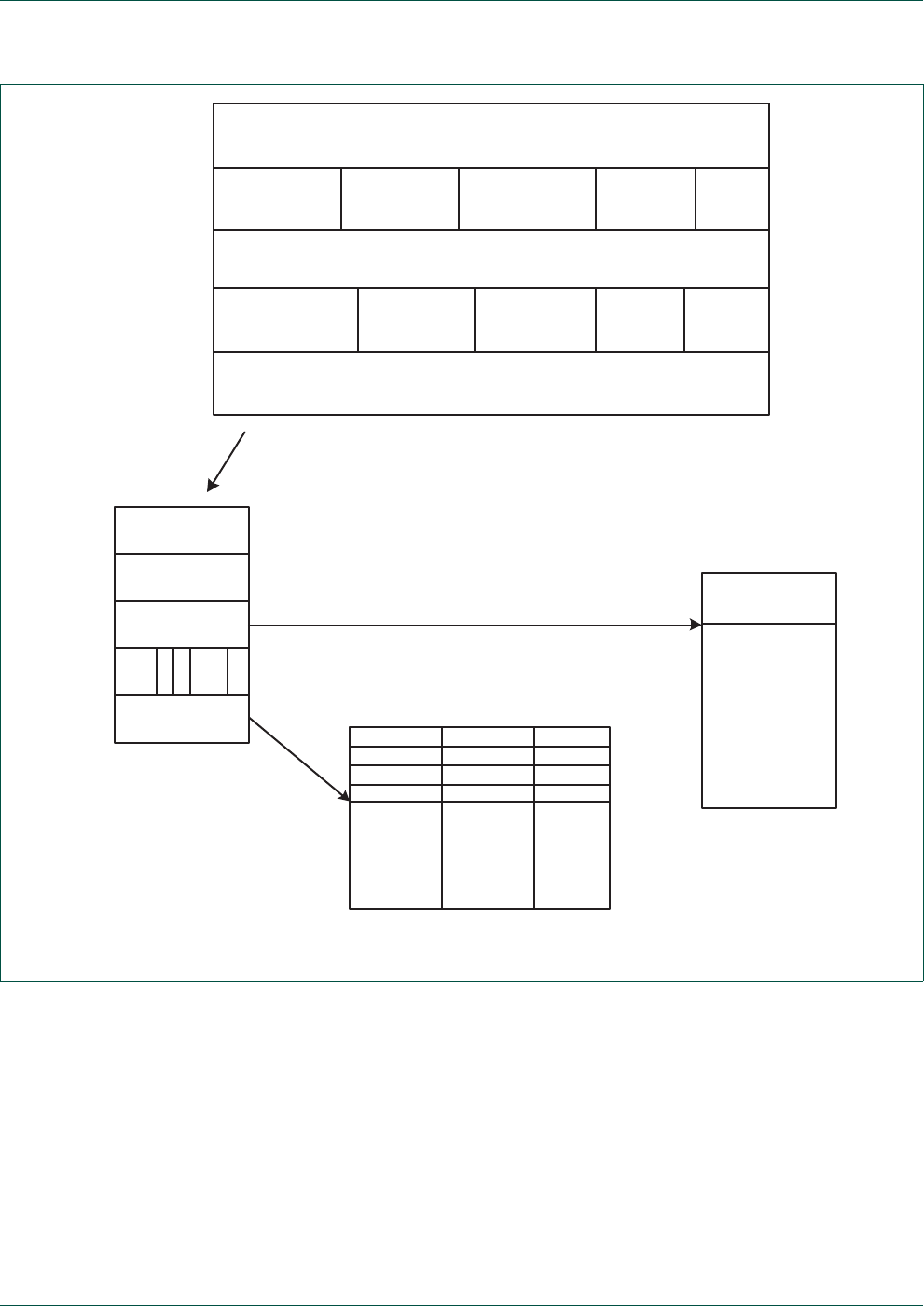
UM10360 All information provided in this document is subject to legal disclaimers. © NXP B.V. 2014. All rights reserved.
User manual Rev. 3.1 — 2 April 2014 272 of 849
NXP Semiconductors UM10360
Chapter 11: LPC176x/5x USB device controller
11.15.7 Auto Length Transfer Extraction (ATLE) mode operation
Some host drivers such as NDIS (Network Driver Interface Specification) host drivers are
capable of concatenating small USB transfers (delta transfers) to form a single large USB
transfer. For OUT USB transfers, the device hardware has to break up this concatenated
transfer back into the original delta transfers and transfer them to separate DMA buffers.
This is achieved by setting the DMA mode to Auto Transfer Length Extraction (ATLE)
mode in the DMA descriptor. ATLE mode is supported for Bulk endpoints only.
Fig 32. Isochronous OUT endpoint operation example
DMA_modeNext_DD_ValidIsochronous_endpointMax_packet_sizeDMA_buffer_length
01631
after 4 packets
15
0x60000010
0x80000035
0x000A0010
0x4
0x0
W1
W2
W3
W4
W0
FULL
EMPTY
data memory
packet size memory
0x60000000
0x80000000
W1
W2
W3
W4
W0
0010x00x000A
Next_DD_Pointer
NULL
DMA_buffer_start_addr
Isocronous_packetsize_memory_address
DD_RetiredDD_StatusPacket_ValidATLE settingsPresent_DMA_Count
0x0 0NANA
0x0
Packet_Lengthframe_ number Packet_Valid
10
15
8
20
1
1
1
1
21
22
23
24
00x1--
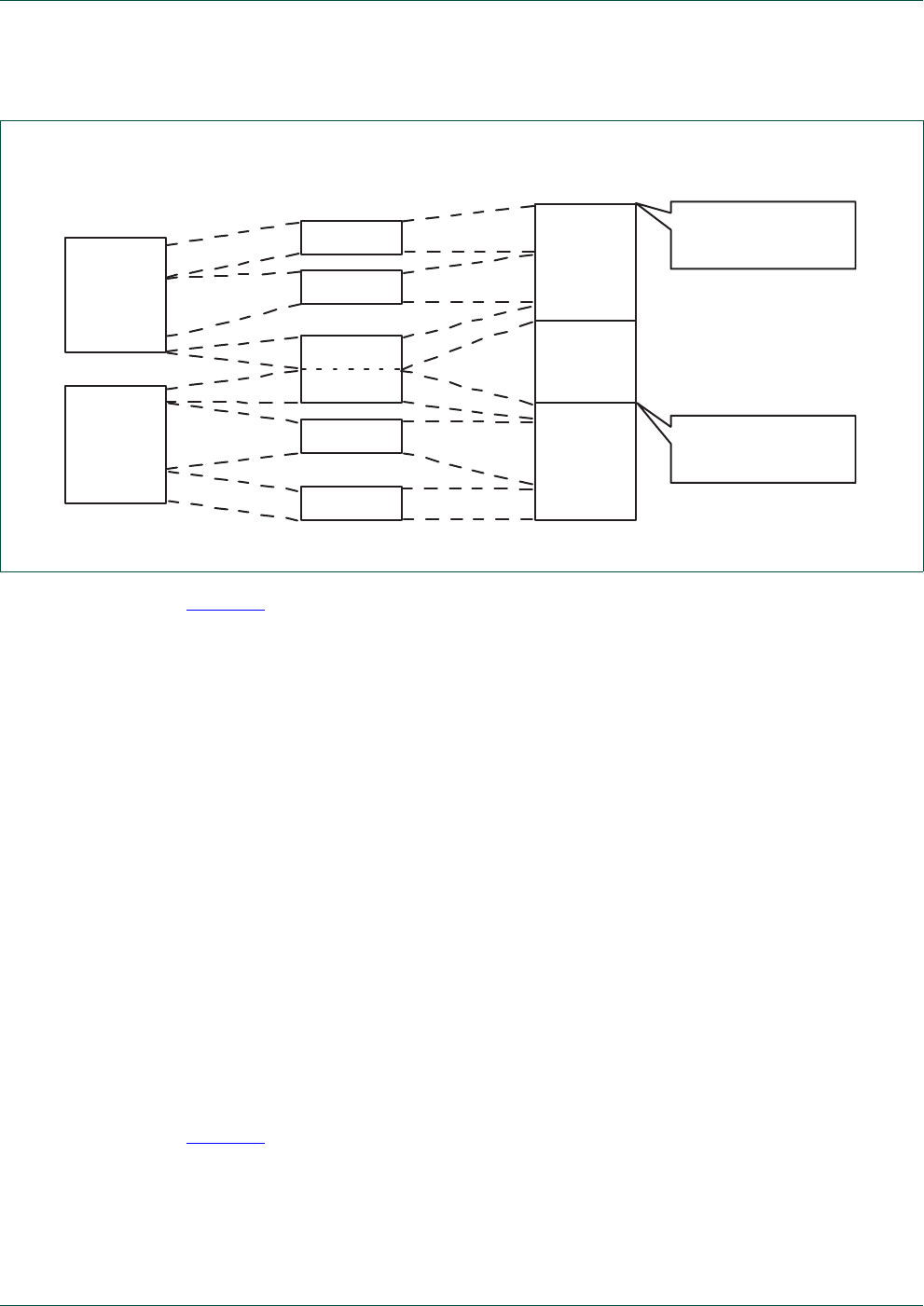
UM10360 All information provided in this document is subject to legal disclaimers. © NXP B.V. 2014. All rights reserved.
User manual Rev. 3.1 — 2 April 2014 273 of 849
NXP Semiconductors UM10360
Chapter 11: LPC176x/5x USB device controller
OUT transfers in ATLE mode
Figure 33 shows a typical OUT USB transfer in ATLE mode, where the host concatenates
two USB transfers of 160 bytes and 100 bytes, respectively. Given a MaxPacketSize of
64, the device hardware interprets this USB transfer as four packets of 64 bytes and a
short packet of 4 bytes. The third and fourth packets are concatenated. Note that in
Normal mode, the USB transfer would be interpreted as packets of 64, 64, 32, and 64 and
36 bytes.
It is now the responsibility of the DMA engine to separate these two USB transfers and put
them in the memory locations in the DMA_buffer_start_addr field of DMA Descriptor 1
(DD1) and DMA Descriptor 2 (DD2).
Hardware reads the two-byte-wide DMA_buffer_length at the offset (from the start of the
USB transfer) specified by Message_length_position from the incoming data packets and
writes it in the DMA_buffer_length field of the DD. To ensure that both bytes of the
DMA_buffer_length are extracted in the event they are split between two packets, the
flags LS_byte_extracted and MS_byte_extracted are set by hardware after the respective
byte is extracted. After the extraction of the MS byte, the DMA transfer continues as in the
normal mode.
The flags LS_byte_extracted and MS_byte_extracted are set to 0 by software when
preparing a new DD. Therefore, once a DD is retired, the transfer length is extracted again
for the next DD.
If DD1 is retired during the transfer of a concatenated packet (such as the third packet in
Figure 33), and DD2 is not programmed (Next_DD_valid field of DD1 is 0), then DD1 is
retired with DD_status set to the DataOverrun status code. This is treated as an error
condition and the corresponding EPxx_DMA_ENABLE bit of USBEpDMASt is cleared by
hardware.
Fig 33. Data transfer in ATLE mode
DMA_buffer_start_addr
of DD1
DMA_buffer_start_addr
of DD2
data to be sent
by host driver
data in packets
as seen on USB
data to be stored in
RAM by DMA engine
160 bytes
100 bytes
64 bytes
64 bytes
32 bytes
32 bytes
64 bytes
4 bytes
160 bytes
100 bytes

UM10360 All information provided in this document is subject to legal disclaimers. © NXP B.V. 2014. All rights reserved.
User manual Rev. 3.1 — 2 April 2014 274 of 849
NXP Semiconductors UM10360
Chapter 11: LPC176x/5x USB device controller
In ATLE mode, the last buffer length to be transferred always ends with a short or empty
packet indicating the end of the USB transfer. If the concatenated transfer lengths are
such that the USB transfer ends on a MaxPacketSize packet boundary, the (NDIS) host
will send an empty packet to mark the end of the USB transfer.
IN transfers in ATLE mode
For IN USB transfers from the device to the host, DMA_buffer_length is set by the device
software as in normal mode.
In ATLE mode, the device concatenates data from multiple DDs to form a single USB
transfer. If a DD is retired in the middle of a packet (packet size is less than
MaxPacketSize), the next DD referenced by Next_DD_pointer is fetched, and the
remaining bytes to form a packet of MaxPacketSize are transferred from the next DD’s
buffer.
If the next DD is not programmed (i.e. Next_DD_valid field in DD is 0), and the DMA buffer
length for the current DD has completed before the MaxPacketSize packet boundary, then
the available bytes from current DD are sent as a short packet on USB, which marks the
end of the USB transfer for the host.
If the last buffer length completes on a MaxPacketSize packet boundary, the device
software must program the next DD with DMA_buffer_length field 0, so that an empty
packet is sent by the device to mark the end of the USB transfer for the host.
11.15.7.1 Setting up the DMA transfer
For OUT endpoints, the host hardware needs to set the field Message_length_position in
the DD. This indicates the start location of the message length in the incoming data
packets. Also the device software has to set the DMA_buffer_length field to 0 for OUT
endpoints because this field is updated by the device hardware after the extraction of the
buffer length.
For IN endpoints, descriptors are set in the same way as in normal mode operation.
Since a single packet can be split between two DDs, software should always keep two
DDs ready, except for the last DMA transfer which ends with a short or empty packet.
11.15.7.2 Finding the DMA Descriptor
DMA descriptors are found in the same way as the normal mode operation.
11.15.7.3 Transferring the Data
OUT endpoints
If the LS_byte_extracted or MS_byte_extracted bit in the status field is not set, the
hardware will extract the transfer length from the data stream and program
DMA_buffer_length. Once the extraction is complete both the LS_byte_extracted and
MS_byte_extracted bits will be set.
IN endpoints
The DMA transfer proceeds as in normal mode and continues until the number of bytes
transferred equals the DMA_buffer_length.

UM10360 All information provided in this document is subject to legal disclaimers. © NXP B.V. 2014. All rights reserved.
User manual Rev. 3.1 — 2 April 2014 275 of 849
NXP Semiconductors UM10360
Chapter 11: LPC176x/5x USB device controller
11.15.7.4 Ending the packet transfer
The DMA engine proceeds with the transfer until the number of bytes specified in the field
DMA_buffer_length is transferred to or from on-chip RAM. Then the EOT interrupt will be
generated. If this happens in the middle of the packet, the linked DD will get loaded and
the remaining part of the packet gets transferred to or from the address pointed by the
new DD.
OUT endpoints
If the linked DD is not valid and the packet is partially transferred to memory, the DD ends
with DataOverrun status code set, and the DMA will be disabled for this endpoint.
Otherwise DD_status will be updated with the NormalCompletion status code.
IN endpoints
If the linked DD is not valid and the packet is partially transferred to USB, the DD ends
with a status code of NormalCompletion in the DD_status field. This situation corresponds
to the end of the USB transfer, and the packet will be sent as a short packet. Also, when
the linked DD is valid and buffer length is 0, an empty packet will be sent to indicate the
end of the USB transfer.
11.16 Double buffered endpoint operation
The Bulk and Isochronous endpoints of the USB Device Controller are double buffered to
increase data throughput.
When a double-buffered endpoint is realized, enough space for both endpoint buffers is
automatically allocated in the EP_RAM. See Section 11.10.4.1.
For the following discussion, the endpoint buffer currently accessible to the CPU or DMA
engine for reading or writing is said to be the active buffer.
11.16.1 Bulk endpoints
For Bulk endpoints, the active endpoint buffer is switched by the SIE Clear Buffer or
Validate Buffer commands.
The following example illustrates how double buffering works for a Bulk OUT endpoint in
Slave mode:
Assume that both buffer 1 (B_1) and buffer 2 (B_2) are empty, and that the active buffer is
B_1.
1. The host sends a data packet to the endpoint. The device hardware puts the packet
into B_1, and generates an endpoint interrupt.
2. Software clears the endpoint interrupt and begins reading the packet data from B_1.
While B_1 is still being read, the host sends a second packet, which device hardware
places in B_2, and generates an endpoint interrupt.
3. Software is still reading from B_1 when the host attempts to send a third packet. Since
both B_1 and B_2 are full, the device hardware responds with a NAK.
4. Software finishes reading the first packet from B_1 and sends a SIE Clear Buffer
command to free B_1 to receive another packet. B_2 becomes the active buffer.

UM10360 All information provided in this document is subject to legal disclaimers. © NXP B.V. 2014. All rights reserved.
User manual Rev. 3.1 — 2 April 2014 276 of 849
NXP Semiconductors UM10360
Chapter 11: LPC176x/5x USB device controller
5. Software sends the SIE Select Endpoint command to read the Select Endpoint
Register and test the FE bit. Software finds that the active buffer (B_2) has data
(FE=1). Software clears the endpoint interrupt and begins reading the contents of
B_2.
6. The host re-sends the third packet which device hardware places in B_1. An endpoint
interrupt is generated.
7. Software finishes reading the second packet from B_2 and sends a SIE Clear Buffer
command to free B_2 to receive another packet. B_1 becomes the active buffer.
Software waits for the next endpoint interrupt to occur (it already has been generated
back in step 6).
8. Software responds to the endpoint interrupt by clearing it and begins reading the third
packet from B_1.
9. Software finishes reading the third packet from B_1 and sends a SIE Clear Buffer
command to free B_1 to receive another packet. B_2 becomes the active buffer.
10. Software tests the FE bit and finds that the active buffer (B_2) is empty (FE=0).
11. Both B_1 and B_2 are empty. Software waits for the next endpoint interrupt to occur.
The active buffer is now B_2. The next data packet sent by the host will be placed in
B_2.
The following example illustrates how double buffering works for a Bulk IN endpoint in
Slave mode:
Assume that both buffer 1 (B_1) and buffer 2 (B_2) are empty and that the active buffer is
B_1. The interrupt on NAK feature is enabled.
1. The host requests a data packet by sending an IN token packet. The device responds
with a NAK and generates an endpoint interrupt.
2. Software clears the endpoint interrupt. The device has three packets to send.
Software fills B_1 with the first packet and sends a SIE Validate Buffer command. The
active buffer is switched to B_2.
3. Software sends the SIE Select Endpoint command to read the Select Endpoint
Register and test the FE bit. It finds that B_2 is empty (FE=0) and fills B_2 with the
second packet. Software sends a SIE Validate Buffer command, and the active buffer
is switched to B_1.
4. Software waits for the endpoint interrupt to occur.
5. The device successfully sends the packet in B_1 and clears the buffer. An endpoint
interrupt occurs.
6. Software clears the endpoint interrupt. Software fills B_1 with the third packet and
validates it using the SIE Validate Buffer command. The active buffer is switched to
B_2.
7. The device successfully sends the second packet from B_2 and generates an
endpoint interrupt.
8. Software has no more packets to send, so it simply clears the interrupt.
9. The device successfully sends the third packet from B_1 and generates an endpoint
interrupt.
10. Software has no more packets to send, so it simply clears the interrupt.

UM10360 All information provided in this document is subject to legal disclaimers. © NXP B.V. 2014. All rights reserved.
User manual Rev. 3.1 — 2 April 2014 277 of 849
NXP Semiconductors UM10360
Chapter 11: LPC176x/5x USB device controller
11. Both B_1 and B_2 are empty, and the active buffer is B_2. The next packet written by
software will go into B_2.
In DMA mode, switching of the active buffer is handled automatically in hardware. For
Bulk IN endpoints, proactively filling an endpoint buffer to take advantage of the double
buffering can be accomplished by manually starting a packet transfer using the
USBDMARSet register.
11.16.2 Isochronous endpoints
For isochronous endpoints, the active data buffer is switched by hardware when the
FRAME interrupt occurs. The SIE Clear Buffer and Validate Buffer commands do not
cause the active buffer to be switched.
Double buffering allows the software to make full use of the frame interval writing or
reading a packet to or from the active buffer, while the packet in the other buffer is being
sent or received on the bus.
For an OUT isochronous endpoint, any data not read from the active buffer before the end
of the frame is lost when it switches.
For an IN isochronous endpoint, if the active buffer is not validated before the end of the
frame, an empty packet is sent on the bus when the active buffer is switched, and its
contents will be overwritten when it becomes active again.

UM10360 All information provided in this document is subject to legal disclaimers. © NXP B.V. 2014. All rights reserved.
User manual Rev. 3.1 — 2 April 2014 278 of 849
12.1 How to read this chapter
The USB host controller is available on the LPC1768, LPC1766, LPC1765, LPC1758,
LPC1756, and LPC1754. On these devices, the USB controller can be configured for
device, Host, or OTG operation.
12.2 Basic configuration
The USB controller is configured using the following registers:
1. Power: In the PCONP register (Ta b le 46 ), set bit PCUSB.
Remark: On reset, the USB block is disabled (PCUSB = 0).
2. Clock: The USB block can be used with a dedicated USB PLL (PLL1) to obtain the
USB clock or with the Main PLL (PLL0). See Section 4.6.1.
3. Pins: Select USB pins and their modes in PINSEL0 to PINSEL5 and PINMODE0 to
PINMODE5 (Section 8.5).
4. Wake-up: Activity on the USB bus port can wake up the microcontroller from
Power-down mode, see Section 4.8.8.
5. Interrupts: Interrupts are enabled in the NVIC using the appropriate Interrupt Set
Enable register.
6. Initialization: see Section 13.11.
12.3 Introduction
This section describes the host portion of the USB 2.0 OTG dual role core which
integrates the host controller (OHCI compliant), device controller, and I2C interface. The
I2C interface controls the external OTG ATX.
The USB is a 4 wire bus that supports communication between a host and a number (127
max.) of peripherals. The host controller allocates the USB bandwidth to attached devices
through a token based protocol. The bus supports hot plugging, un-plugging and dynamic
configuration of the devices. All transactions are initiated by the host controller.
The host controller enables data exchange with various USB devices attached to the bus.
It consists of register interface, serial interface engine and DMA controller. The register
interface complies to the OHCI specification.
UM10360
Chapter 12: LPC176x/5x USB Host controller
Rev. 3.1 — 2 April 2014 User manual
Table 253. USB (OHCI) related acronyms and abbreviations used in this chapter
Acronym/abbreviation Description
AHB Advanced High-Performance Bus
ATX Analog Transceiver
DMA Direct Memory Access
FS Full Speed
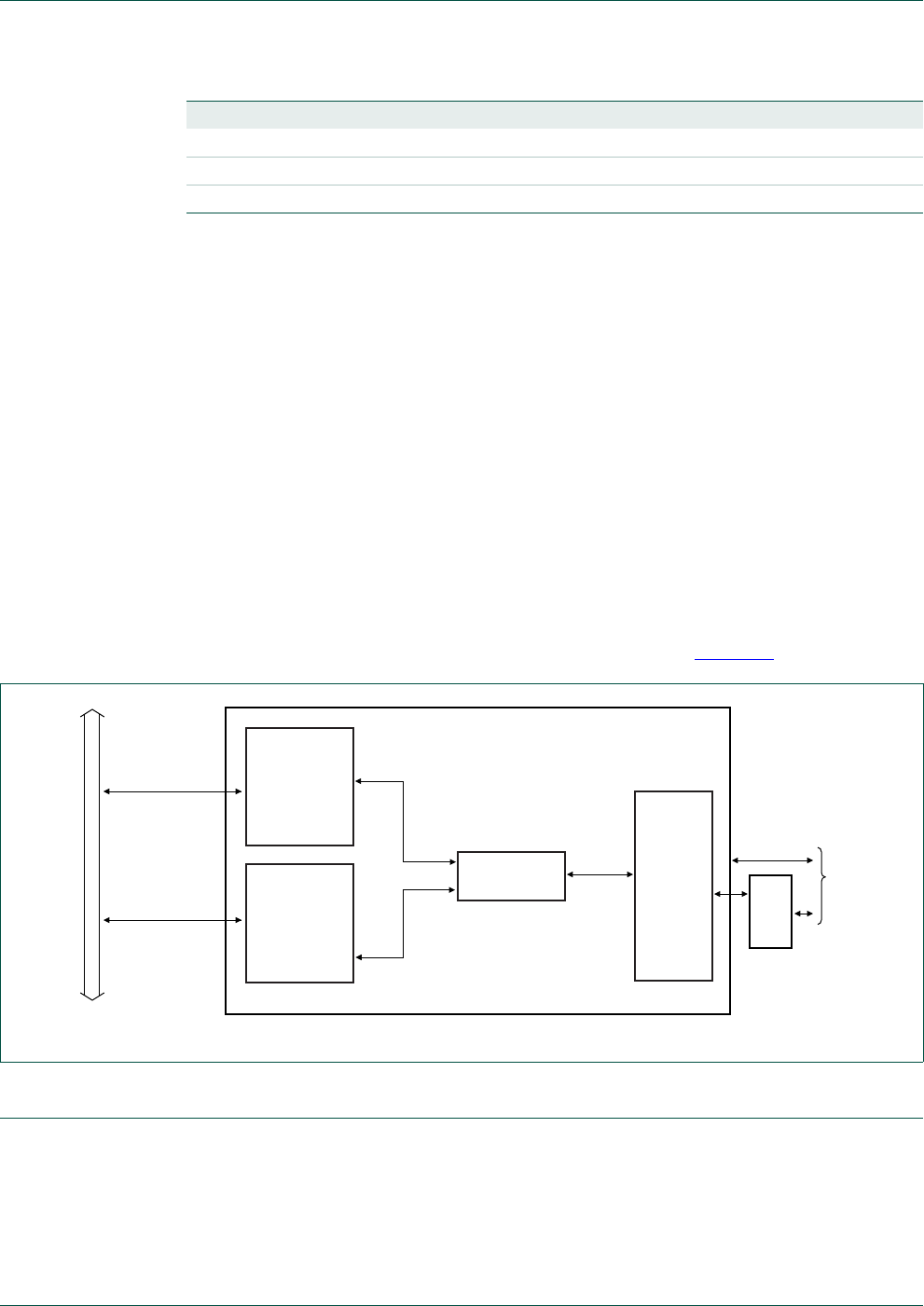
UM10360 All information provided in this document is subject to legal disclaimers. © NXP B.V. 2014. All rights reserved.
User manual Rev. 3.1 — 2 April 2014 279 of 849
NXP Semiconductors UM10360
Chapter 12: LPC176x/5x USB Host controller
12.3.1 Features
•OHCI compliant.
•OpenHCI specifies the operation and interface of the USB Host Controller and SW
Driver
–USBOperational: Process Lists and generate SOF Tokens.
–USBReset: Forces reset signaling on the bus, SOF disabled.
–USBSuspend: Monitor USB for wake-up activity.
–USBResume: Forces resume signaling on the bus.
•The Host Controller has four USB states visible to the SW Driver.
•HCCA register points to Interrupt and Isochronous Descriptors List.
•ControlHeadED and BulkHeadED registers point to Control and Bulk Descriptors List.
12.3.2 Architecture
The architecture of the USB host controller is shown below in Figure 34.
12.4 Interfaces
The USB interface is controlled by the OTG controller. It has one USB port.
LS Low Speed
OHCI Open Host Controller Interface
USB Universal Serial Bus
Table 253. USB (OHCI) related acronyms and abbreviations used in this chapter …continued
Acronym/abbreviation Description
Fig 34. USB Host controller block diagram
REGISTER
INTERFACE
BUS
MASTER
INTERFACE
USB
ATX
DMA interface
(AHB master)
register
interface
(AHB slave)
AHB bus
HOST
CONTROLLER
ATX
CONTROL
LOGIC/
PORT
MUX
USB
port
USB HOST BLOCK
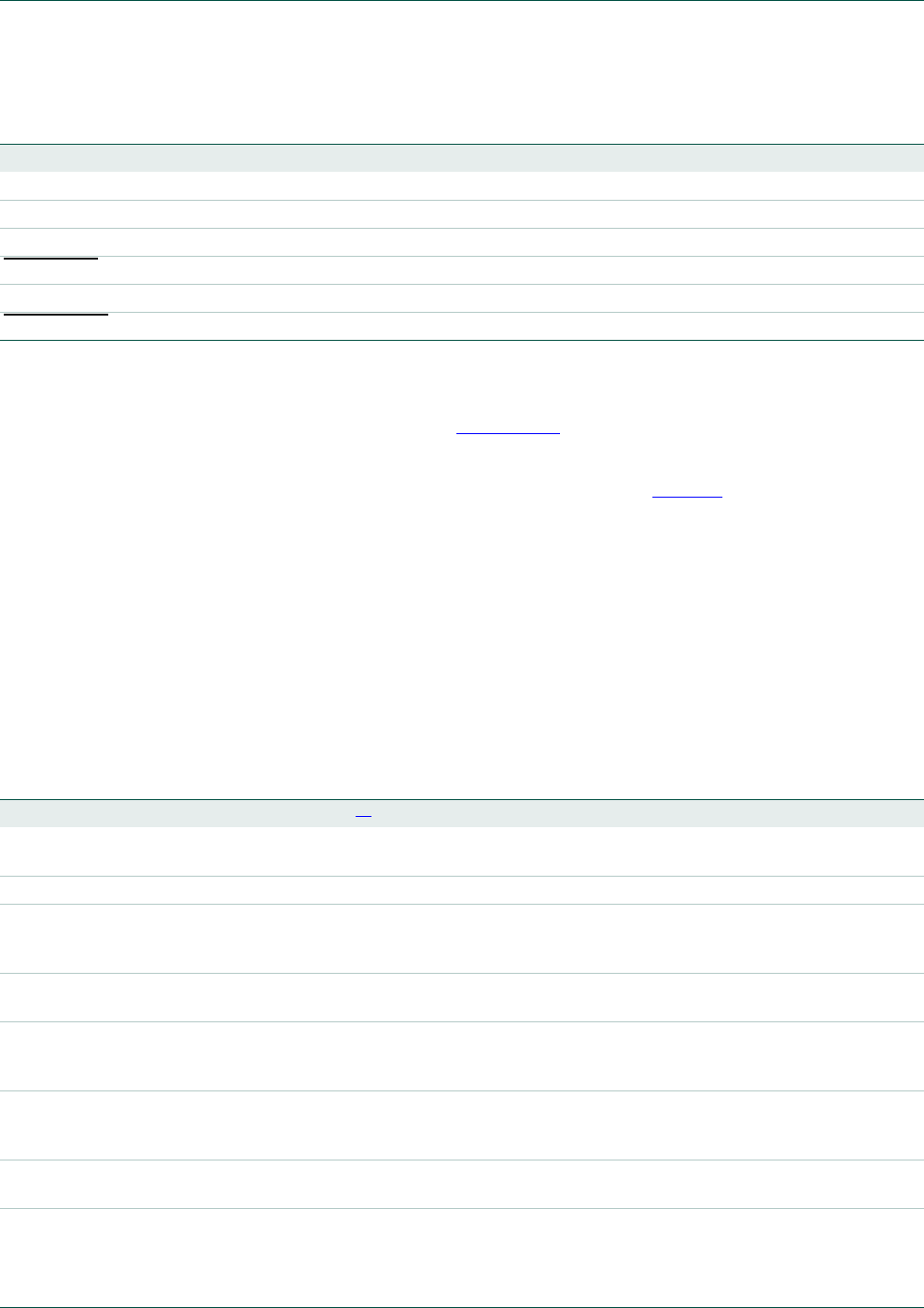
UM10360 All information provided in this document is subject to legal disclaimers. © NXP B.V. 2014. All rights reserved.
User manual Rev. 3.1 — 2 April 2014 280 of 849
NXP Semiconductors UM10360
Chapter 12: LPC176x/5x USB Host controller
12.4.1 Pin description
12.4.1.1 USB host usage note
The USB block can be configured as USB host. For details on how to connect the USB
port, see the USB OTG chapter, Section 13.7.
The USB device/host/OTG controller is disabled after RESET and must be enabled by
writing a 1 to the PCUSB bit in the PCONP register, see Tabl e 4 6.
12.4.2 Software interface
The software interface of the USB host block consists of a register view and the format
definitions for the endpoint descriptors. For details on these two aspects see the OHCI
specification. The register map is shown in the next subsection.
12.4.2.1 Register map
The following registers are located in the AHB clock ‘cclk’ domain. They can be accessed
directly by the processor. All registers are 32 bits wide and aligned in the word address
boundaries.
Table 254. USB Host port pins
Pin name Direction Description Type
USB_D+ I/O Positive differential data USB Connector
USB_DI/O Negative differential data USB Connector
USB_UP_LED O GoodLink LED control signal Control
USB_PPWR OPort power enable Host power switch
USB_PWRD I Port power status Host power switch
USB_OVRCR IOver-current status Host power switch
Table 255. USB Host register address definitions
Name Address R/W[1] Function Reset value
HcRevision 0x5000 C000 R BCD representation of the version of the HCI
specification that is implemented by the Host Controller.
0x10
HcControl 0x5000 C004 R/W Defines the operating modes of the HC. 0x0
HcCommandStatus 0x5000 C008 R/W This register is used to receive the commands from the
Host Controller Driver (HCD). It also indicates the status
of the HC.
0x0
HcInterruptStatus 0x5000 C00C R/W Indicates the status on various events that cause
hardware interrupts by setting the appropriate bits.
0x0
HcInterruptEnable 0x5000 C010 R/W Controls the bits in the HcInterruptStatus register and
indicates which events will generate a hardware
interrupt.
0x0
HcInterruptDisable 0x5000 C014 R/W The bits in this register are used to disable
corresponding bits in the HCInterruptStatus register and
in turn disable that event leading to hardware interrupt.
0x0
HcHCCA 0x5000 C018 R/W Contains the physical address of the host controller
communication area.
0x0
HcPeriodCurrentED 0x5000 C01C R Contains the physical address of the current isochronous
or interrupt endpoint descriptor.
0x0

UM10360 All information provided in this document is subject to legal disclaimers. © NXP B.V. 2014. All rights reserved.
User manual Rev. 3.1 — 2 April 2014 281 of 849
NXP Semiconductors UM10360
Chapter 12: LPC176x/5x USB Host controller
[1] The R/W column in Tab l e 25 5 lists the accessibility of the register:
a) Registers marked ‘R’ for access will return their current value when read.
b) Registers marked ‘R/W’ allow both read and write.
12.4.2.2 USB Host Register Definitions
Refer to the OHCI specification document on the Compaq website for register definitions.
HcControlHeadED 0x5000 C020 R/W Contains the physical address of the first endpoint
descriptor of the control list.
0x0
HcControlCurrentED 0x5000 C024 R/W Contains the physical address of the current endpoint
descriptor of the control list
0x0
HcBulkHeadED 0x5000 C028 R/W Contains the physical address of the first endpoint
descriptor of the bulk list.
0x0
HcBulkCurrentED 0x5000 C02C R/W Contains the physical address of the current endpoint
descriptor of the bulk list.
0x0
HcDoneHead 0x5000 C030 R Contains the physical address of the last transfer
descriptor added to the ‘Done’ queue.
0x0
HcFmInterval 0x5000 C034 R/W Defines the bit time interval in a frame and the full speed
maximum packet size which would not cause an
overrun.
0x2EDF
HcFmRemaining 0x5000 C038 R A 14-bit counter showing the bit time remaining in the
current frame.
0x0
HcFmNumber 0x5000 C03C R Contains a 16-bit counter and provides the timing
reference among events happening in the HC and the
HCD.
0x0
HcPeriodicStart 0x5000 C040 R/W Contains a programmable 14-bit value which determines
the earliest time HC should start processing a periodic
list.
0x0
HcLSThreshold 0x5000 C044 R/W Contains 11-bit value which is used by the HC to
determine whether to commit to transfer a maximum of
8-byte LS packet before EOF.
0x628h
HcRhDescriptorA 0x5000 C048 R/W First of the two registers which describes the
characteristics of the root hub.
0xFF000902
HcRhDescriptorB 0x5000 C04C R/W Second of the two registers which describes the
characteristics of the Root Hub.
0x60000h
HcRhStatus 0x5000 C050 R/W This register is divided into two parts. The lower D-word
represents the hub status field and the upper word
represents the hub status change field.
0x0
HcRhPortStatus[1] 0x5000 C054 R/W Controls and reports the port events on a per-port basis. 0x0
HcRhPortStatus[2] 0x5000 C058 R/W Controls and reports the port events on a per port basis. 0x0
Module_ID/Ver_Rev_ID 0x5000 C0FC R IP number, where yy (0x00) is unique version number
and zz (0x00) is a unique revision number.
0x3505yyzz
Table 255. USB Host register address definitions …continued
Name Address R/W[1] Function Reset value

UM10360 All information provided in this document is subject to legal disclaimers. © NXP B.V. 2014. All rights reserved.
User manual Rev. 3.1 — 2 April 2014 282 of 849
13.1 How to read this chapter
The USB OTG controller is available in the LPC1768, LPC1766, LPC1765, LPC1758,
LPC1756, and LPC1754. On these devices, the USB controller can be configured for
device, Host, or OTG operation.
13.2 Basic configuration
The USB controller is configured using the following registers:
1. Power: In the PCONP register (Ta b le 46 ), set bit PCUSB.
Remark: On reset, the USB block is disabled (PCUSB = 0).
2. Clock: The USB clock can generated using the dedicated USB PLL (PLL1) or with the
Main PLL (PLL0). See Section 4.6.1.
3. Pins: Select USB pins and their modes in PINSEL0 to PINSEL5 and PINMODE0 to
PINMODE5 (Section 8.5).
4. Wake-up: Activity on the USB bus port can wake up the microcontroller from
Power-down mode (see Section 13.10.2 and Section 4.8.8).
5. Interrupts: Interrupts are enabled in the NVIC using the appropriate Interrupt Set
Enable register.
6. Initialization: see Section 13.11.
13.3 Introduction
This chapter describes the OTG and I2C portions of the USB 2.0 OTG dual role device
controller which integrates the (OHCI) host controller, device controller, and I2C. The I2C
interface that is part of the USB block is intended to control an external OTG transceiver,
and is not the same as the I2C peripherals described in Section 19.1.
USB OTG (On-The-Go) is a supplement to the USB 2.0 specification that augments the
capability of existing mobile devices and USB peripherals by adding host functionality for
connection to USB peripherals. The specification and more information on USB OTG can
be found on the USB Implementers Forum web site.
13.4 Features
•Fully compliant with On-The-Go supplement to the USB 2.0 Specification, Revision
1.0a.
•Hardware support for Host Negotiation Protocol (HNP).
•Includes a programmable timer required for HNP and SRP.
•Supports any OTG transceiver compliant with the OTG Transceiver Specification
(CEA-2011), Rev. 1.0.
UM10360
Chapter 13: LPC176x/5x USB OTG
Rev. 3.1 — 2 April 2014 User manual
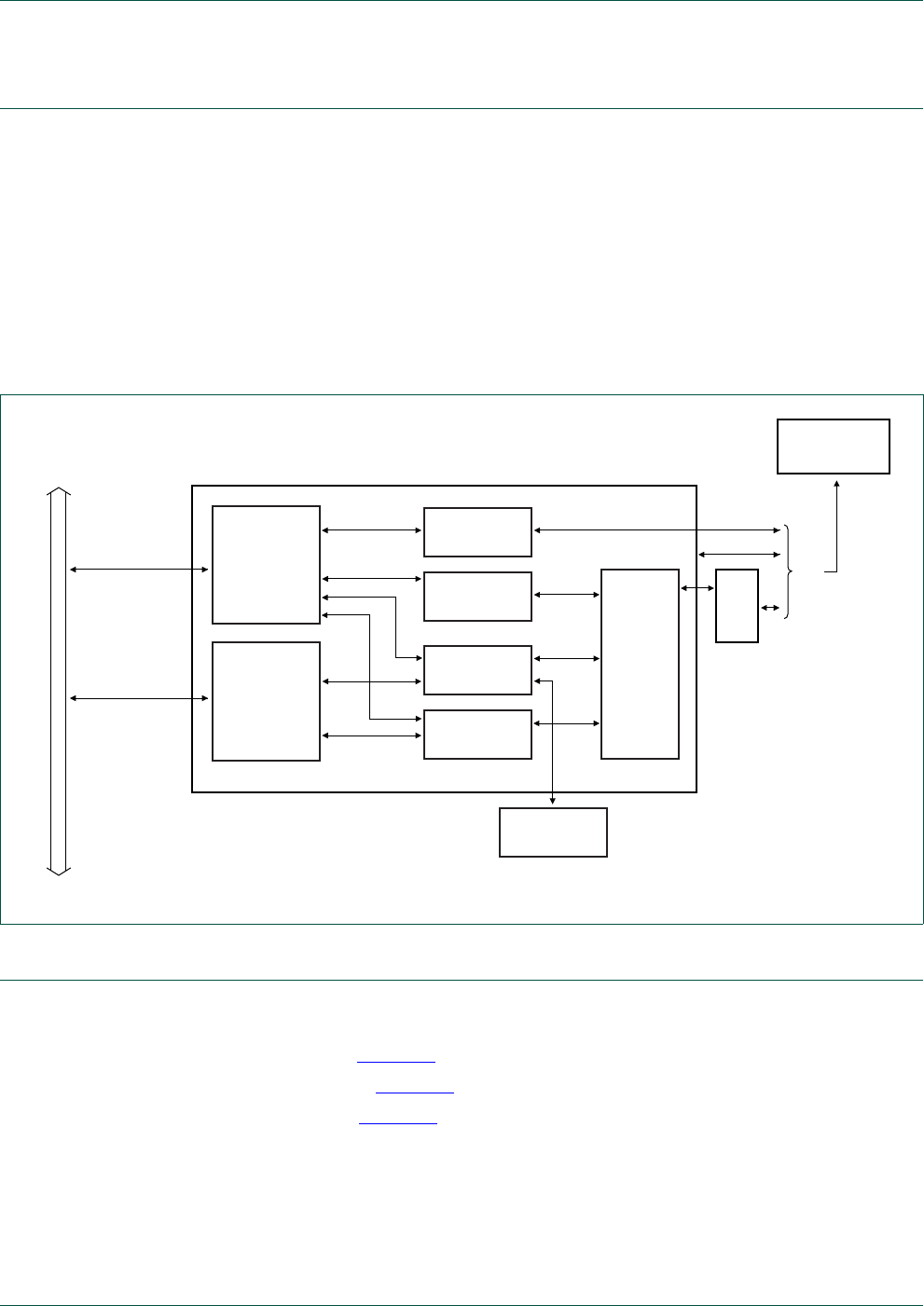
UM10360 All information provided in this document is subject to legal disclaimers. © NXP B.V. 2014. All rights reserved.
User manual Rev. 3.1 — 2 April 2014 283 of 849
NXP Semiconductors UM10360
Chapter 13: LPC176x/5x USB OTG
13.5 Architecture
The architecture of the USB OTG controller is shown below in the block diagram.
The host, device, OTG, and I2C controllers can be programmed through the register
interface. The OTG controller enables dynamic switching between host and device roles
through the HNP protocol. One port may be connected to an external OTG transceiver to
support an OTG connection. The communication between the register interface and an
external OTG transceiver is handled through an I2C interface and through the external
OTG transceiver interrupt signal.
For USB connections that use the device or host controller only (not OTG), the ports use
an embedded USB Analog Transceiver (ATX).
13.6 Modes of operation
The OTG controller is capable of operating in the following modes:
•Host mode (see Figure 36)
•Device mode (see Figure 37)
•OTG mode (see Figure 38)
Fig 35. USB OTG controller block diagram
REGISTER
INTERFACE
BUS
MASTER
INTERFACE
USB
ATX
DMA interface
(AHB master)
register
interface
(AHB slave)
AHB bus
I2C
CONTROLLER
DEVICE
CONTROLLER
HOST
CONTROLLER
EP_RAM
OTG
CONTROLLER
ATX
CONTROL
LOGIC/
PORT
MUX
USB
port
OTG
TRANSCEIVER
USB OTG BLOCK

UM10360 All information provided in this document is subject to legal disclaimers. © NXP B.V. 2014. All rights reserved.
User manual Rev. 3.1 — 2 April 2014 284 of 849
NXP Semiconductors UM10360
Chapter 13: LPC176x/5x USB OTG
13.7 Pin configuration
The OTG controller has one USB port.
The following figures show different ways to realize connections to an USB device. The
example described here uses an ISP1302 (ST-Ericsson) for the external OTG transceiver
and the USB Host power switch LM3526-L (National Semiconductors).
13.7.1 Connecting the USB port to an external OTG transceiver
For OTG functionality an external OTG transceiver must be connected to the LPC176x/5x:
Use the internal USB transceiver for USB signalling and use the external OTG transceiver
for OTG functionality only (see Figure 36). This option uses the internal transceiver in
VP/VM mode.
Table 256. USB OTG port pins
Pin name Direction Description Pin category
USB_D+ I/O Positive differential data USB Connector
USB_DI/O Negative differential data USB Connector
USB_UP_LED O GoodLink LED control signal Control
USB_SCL I/O I2C serial clock External OTG transceiver
USB_SDA I/O I2C serial data External OTG transceiver
Fig 36. USB OTG port configuration
USB_D+
USB_D−
USB_SDA
USB_SCL
RSTOUT
LPC17xx
Mini-AB
connector
33 Ω
33 Ω
VDD
VDD
EINTn
RESET_N
ADR/PSW
SPEED
SUSPEND
OE_N/INT_N
SCL
SDA
INT_N
VBUS
ID
DP
DM
ISP1302
VSSIO,
VSSCORE
USB_UP_LED
VDD
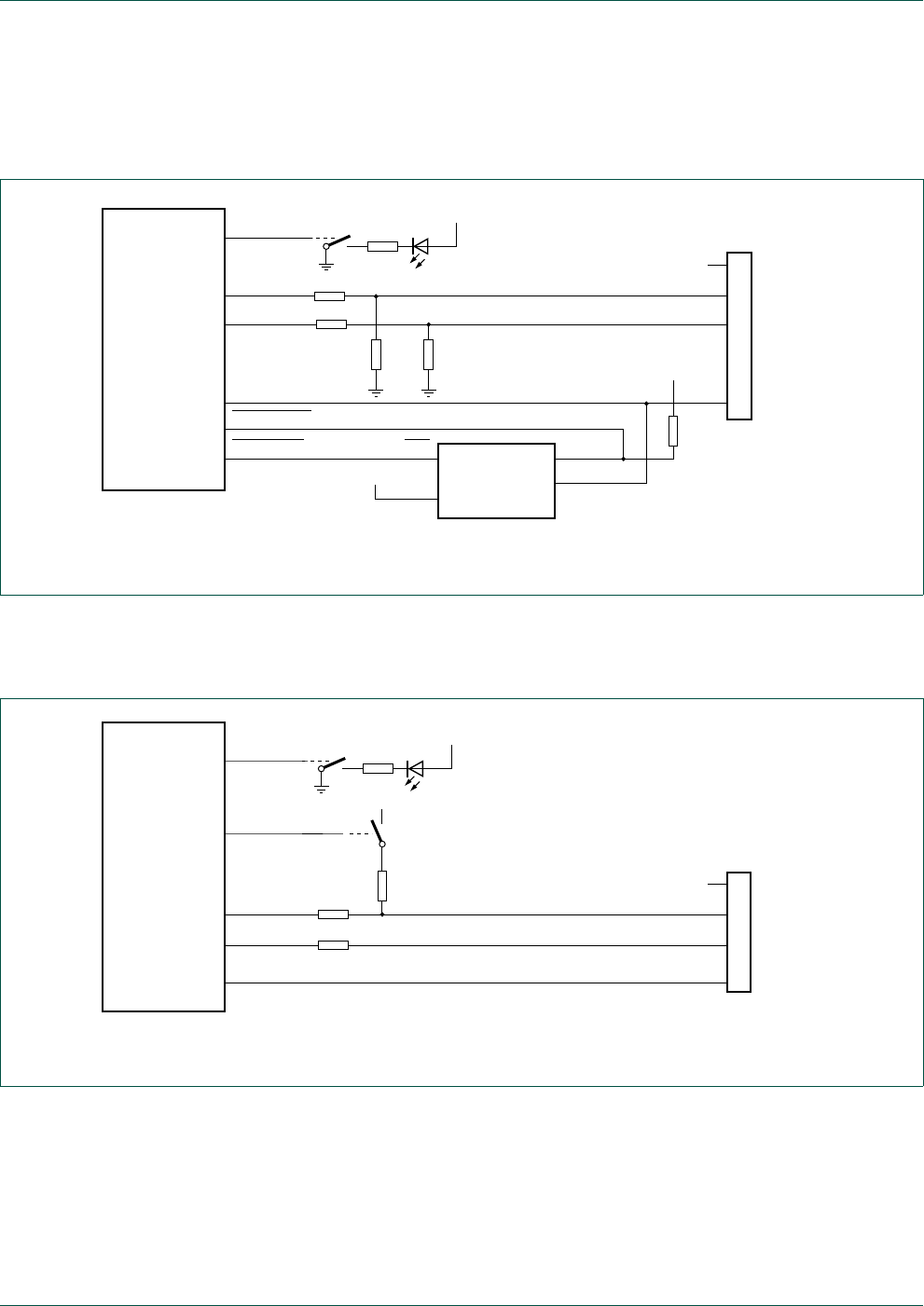
UM10360 All information provided in this document is subject to legal disclaimers. © NXP B.V. 2014. All rights reserved.
User manual Rev. 3.1 — 2 April 2014 285 of 849
NXP Semiconductors UM10360
Chapter 13: LPC176x/5x USB OTG
13.7.2 Connecting USB as a host
The USB port is connected as host using an embedded USB transceiver. There is no
OTG functionality on the port.
13.7.3 Connecting USB as device
The USB port is connected as device. There is no OTG functionality on the USB port.
Fig 37. USB host port configuration
USB_UP_LED
USB_D+
USB_D−
USB_PWRD
15 kΩ15 kΩ
LPC176x
USB-A
connector
33 Ω
33 Ω
graphicID
VDD
USB_OVRCR
USB_PPWR
LM3526-L
ENA
IN
5 V
FLAGA
OUTA
VDD
D+
D−
VBUS
VSS
Fig 38. USB device port configuration
LPC176x
USB-B
connector
33 Ω
33 Ω
graphicID
USB_UP_LED
USB_CONNECT
VDD
VDD
D+
D−
USB_D+
USB_D−
VBUS VBUS
VSS

UM10360 All information provided in this document is subject to legal disclaimers. © NXP B.V. 2014. All rights reserved.
User manual Rev. 3.1 — 2 April 2014 286 of 849
NXP Semiconductors UM10360
Chapter 13: LPC176x/5x USB OTG
13.8 Register description
The OTG and I2C registers are summarized in the following table.
The Device and Host registers are explained in Ta bl e 2 5 5 and Ta b le 1 8 9 in the USB
Device Controller and USB Host (OHCI) Controller chapters. All registers are 32 bits wide
and aligned to word address boundaries.
13.8.1 USB Interrupt Status Register (USBIntSt - 0x5000 C1C0)
The USB OTG controller has seven interrupt lines. This register allows software to
determine their status with a single read operation.
The interrupt lines are ORed together to a single channel of the vectored interrupt
controller.
Remark: In a device-only configuration bits 6 to 3 of this register are reserved (see
Tab l e 1 92 ).
Table 257. USB OTG and I2C register address definitions
Name Description Access Reset value Address
Interrupt register
USBIntSt USB Interrupt Status R/W 0x8000 0100 0x400F C1C0
OTG registers
OTGIntSt OTG Interrupt Status RO 0 0x5000 C100
OTGIntEn OTG Interrupt Enable R/W 0 0x5000 C104
OTGIntSet OTG Interrupt Set WO NA 0x5000 C108
OTGIntClr OTG Interrupt Clear WO NA 0x5000 C10C
OTGStCtrl OTG Status and Control R/W 0 0x5000 C110
OTGTmr OTG Timer R/W 0xFFFF 0x5000 C114
I2C registers
I2C_RX I2C Receive RO NA 0x5000 C300
I2C_TX I2C Transmit WO NA 0x5000 C300
I2C_STS I2C Status RO 0x0A00 0x5000 C304
I2C_CTL I2C Control R/W 0 0x5000 C308
I2C_CLKHI I2C Clock High R/W 0xB9 0x5000 C30C
I2C_CLKLO I2C Clock Low WO 0xB9 0x5000 C310
Clock control registers
OTGClkCtrl OTG clock controller R/W 0 0x5000 CFF4
OTGClkSt OTG clock status RO 0 0x5000 CFF8
Table 258. USB Interrupt Status register - (USBIntSt - address 0x5000 C1C0) bit
description
Bit Symbol Description Reset
Value
0USB_INT_REQ_LPLow priority interrupt line status. This bit is read-only.0
1USB_INT_REQ_HPHigh priority interrupt line status. This bit is read-only.0
2USB_INT_REQ_DMADMA interrupt line status. This bit is read-only. 0

UM10360 All information provided in this document is subject to legal disclaimers. © NXP B.V. 2014. All rights reserved.
User manual Rev. 3.1 — 2 April 2014 287 of 849
NXP Semiconductors UM10360
Chapter 13: LPC176x/5x USB OTG
13.8.2 OTG Interrupt Status Register (OTGIntSt - 0x5000 C100)
Bits in this register are set by hardware when the interrupt event occurs during the HNP
handoff sequence. See Section 13.9 for more information on when these bits are set.
13.8.3 OTG Interrupt Enable Register (OTGIntEn - 0x5000 C104)
Writing a one to a bit in this register enables the corresponding bit in OTGIntSt to generate
an interrupt on one of the interrupt lines. The interrupt is routed to the USB_OTG_INT
interrupt line in the USBIntSt register.
The bit allocation and reset value of OTGIntEn is the same as OTGIntSt.
3USB_HOST_INT USB host interrupt line status. This bit is read-only. 0
4USB_ATX_INT External ATX interrupt line status. This bit is read-only.0
5USB_OTG_INT OTG interrupt line status. This bit is read-only. 0
6USB_I2C_INT I
2C module interrupt line status. This bit is read-only. 0
7- Reserved, user software should not write ones to
reserved bits. The value read from a reserved bit is not
defined.
NA
8USB_NEED_CLK USB need clock indicator. This bit is read-only. 1
30:9 - Reserved, user software should not write ones to
reserved bits. The value read from a reserved bit is not
defined.
NA
31 EN_USB_INTS Enable all USB interrupts. When this bit is cleared, the
NVIC does not see the ORed output of the USB interrupt
lines.
1
Table 258. USB Interrupt Status register - (USBIntSt - address 0x5000 C1C0) bit
description …continued
Bit Symbol Description Reset
Value
Table 259. OTG Interrupt Status register (OTGIntSt - address 0x5000 C100) bit description
Bit Symbol Description Reset
Value
0TMR Timer time-out. 0
1REMOVE_PU Remove pull-up.
This bit is set by hardware to indicate that software
needs to disable the D+ pull-up resistor.
0
2HNP_FAILURE HNP failed.
This bit is set by hardware to indicate that the HNP
switching has failed.
0
3HNP_SUCCESS HNP succeeded.
This bit is set by hardware to indicate that the HNP
switching has succeeded.
0
31:4 - Reserved, user software should not write ones to
reserved bits. The value read from a reserved bit is not
defined.
NA

UM10360 All information provided in this document is subject to legal disclaimers. © NXP B.V. 2014. All rights reserved.
User manual Rev. 3.1 — 2 April 2014 288 of 849
NXP Semiconductors UM10360
Chapter 13: LPC176x/5x USB OTG
13.8.4 OTG Interrupt Set Register (OTGIntSet - 0x5000 C20C)
Writing a one to a bit in this register will set the corresponding bit in the OTGIntSt register.
Writing a zero has no effect. The bit allocation of OTGIntSet is the same as in OTGIntSt.
13.8.5 OTG Interrupt Clear Register (OTGIntClr - 0x5000 C10C)
Writing a one to a bit in this register will clear the corresponding bit in the OTGIntSt
register. Writing a zero has no effect. The bit allocation of OTGIntClr is the same as in
OTGIntSt.
13.8.6 OTG Status and Control Register (OTGStCtrl - 0x5000 C110)
The OTGStCtrl register allows enabling hardware tracking during the HNP hand over
sequence, controlling the OTG timer, monitoring the timer count, and controlling the
functions mapped to port U1 and U2.
Time critical events during the switching sequence are controlled by the OTG timer. The
timer can operate in two modes:
1. Monoshot mode: an interrupt is generated at the end of TIMEOUT_CNT (see
Section 13.8.7 “OTG Timer Register (OTGTmr - 0x5000 C114)”), the TMR bit is set in
OTGIntSt, and the timer will be disabled.
2. Free running mode: an interrupt is generated at the end of TIMEOUT_CNT (see
Section 13.8.7 “OTG Timer Register (OTGTmr - 0x5000 C114)”), the TMR bit is set,
and the timer value is reloaded into the counter. The timer is not disabled in this
mode.
Table 260. OTG Status Control register (OTGStCtrl - address 0x5000 C110) bit
description
Bit Symbol Description Reset
Value
1:0 PORT_FUNC Controls port function. Bit 0 is set or cleared by hardware
when B_HNP_TRACK or A_HNP_TRACK is set and
HNP succeeds. See Section 13.9. Bit 1 is reserved.
-
3:2 TMR_SCALE Timer scale selection. This field determines the duration
of each timer count.
00: 10 s (100 KHz)
01: 100 s (10 KHz)
10: 1000 s (1 KHz)
11: Reserved
0x0
4TMR_MODE Timer mode selection.
0: monoshot
1: free running
0
5TMR_EN Timer enable. When set, TMR_CNT increments. When
cleared, TMR_CNT is reset to 0.
0
6TMR_RST Timer reset. Writing one to this bit resets TMR_CNT to 0.
This provides a single bit control for the software to
restart the timer when the timer is enabled.
0
7- Reserved, user software should not write ones to
reserved bits. The value read from a reserved bit is not
defined.
NA

UM10360 All information provided in this document is subject to legal disclaimers. © NXP B.V. 2014. All rights reserved.
User manual Rev. 3.1 — 2 April 2014 289 of 849
NXP Semiconductors UM10360
Chapter 13: LPC176x/5x USB OTG
13.8.7 OTG Timer Register (OTGTmr - 0x5000 C114)
13.8.8 OTG Clock Control Register (OTGClkCtrl - 0x5000 CFF4)
This register controls the clocking of the OTG controller. Whenever software wants to
access the registers, the corresponding clock control bit needs to be set. The software
does not have to repeat this exercise for every register access, provided that the
corresponding OTGClkCtrl bits are already set.
8B_HNP_TRACK Enable HNP tracking for B-device (peripheral), see
Section 13.9. Hardware clears this bit when
HNP_SUCCESS or HNP_FAILURE is set.
0
9A_HNP_TRACK Enable HNP tracking for A-device (host), see
Section 13.9. Hardware clears this bit when
HNP_SUCCESS or HNP_FAILURE is set.
0
10 PU_REMOVED When the B-device changes its role from peripheral to
host, software sets this bit when it removes the D+
pull-up, see Section 13.9. Hardware clears this bit when
HNP_SUCCESS or HNP_FAILURE is set.
0
15:11 - Reserved, user software should not write ones to
reserved bits. The value read from a reserved bit is not
defined.
NA
31:16 TMR_CNT Current timer count value. 0x0
Table 260. OTG Status Control register (OTGStCtrl - address 0x5000 C110) bit
description …continued
Bit Symbol Description Reset
Value
Table 261. OTG Timer register (OTGTmr - address 0x5000 C114) bit description
Bit Symbol Description Reset
Value
15:0 TIMEOUT_CNT The TMR interrupt is set when TMR_CNT reaches this value. 0xFFFF
31:16 - Reserved, user software should not write ones to reserved
bits. The value read from a reserved bit is not defined.
NA
Table 262. OTG clock control register (OTG_clock_control - address 0x5000 CFF4) bit
description
Bit Symbol Value Description Reset
Value
0HOST_CLK_EN Host clock enable 0
0Disable the Host clock.
1Enable the Host clock.
1DEV_CLK_EN Device clock enable 0
0Disable the Device clock.
1Enable the Device clock.
2I2C_CLK_EN I2C clock enable 0
0Disable the I
2C clock.
1Enable the I
2C clock.

UM10360 All information provided in this document is subject to legal disclaimers. © NXP B.V. 2014. All rights reserved.
User manual Rev. 3.1 — 2 April 2014 290 of 849
NXP Semiconductors UM10360
Chapter 13: LPC176x/5x USB OTG
13.8.9 OTG Clock Status Register (OTGClkSt - 0x5000 CFF8)
This register holds the clock availability status. When enabling a clock via OTGClkCtrl,
software should poll the corresponding bit in this register. If it is set, then software can go
ahead with the register access. Software does not have to repeat this exercise for every
access, provided that the OTGClkCtrl bits are not disturbed.
13.8.10 I2C Receive Register (I2C_RX - 0x5000 C300)
This register is the top byte of the receive FIFO. The receive FIFO is 4 bytes deep. The Rx
FIFO is flushed by a hard reset or by a soft reset (I2C_CTL bit 7). Reading an empty FIFO
gives unpredictable data results.
3OTG_CLK_EN OTG clock enable 0
0Disable the OTG clock.
1Enable the OTG clock.
4AHB_CLK_EN AHB master clock enable 0
0Disable the AHB clock.
1Enable the AHB clock.
31:5 - NA Reserved, user software should not write ones
to reserved bits. The value read from a
reserved bit is not defined.
NA
Table 262. OTG clock control register (OTG_clock_control - address 0x5000 CFF4) bit
description …continued
Bit Symbol Value Description Reset
Value
Table 263. OTG clock status register (OTGClkSt - address 0x5000 CFF8) bit description
Bit Symbol Value Description Reset
Value
0HOST_CLK_ON Host clock status. 0
0 Host clock is not available.
1Host clock is available.
1DEV_CLK_ON Device clock status. 0
0Device clock is not available.
1Device clock is available.
2I2C_CLK_ON I2C clock status. 0
0I
2C clock is not available.
1I
2C clock is available.
3OTG_CLK_ON OTG clock status. 0
0OTG clock is not available.
1OTG clock is available.
4AHB_CLK_ON AHB master clock status. 0
0AHB clock is not available.
1AHB clock is available.
31:5 - NA Reserved, user software should not write ones
to reserved bits. The value read from a
reserved bit is not defined.
NA

UM10360 All information provided in this document is subject to legal disclaimers. © NXP B.V. 2014. All rights reserved.
User manual Rev. 3.1 — 2 April 2014 291 of 849
NXP Semiconductors UM10360
Chapter 13: LPC176x/5x USB OTG
13.8.11 I2C Transmit Register (I2C_TX - 0x5000 C300)
This register is the top byte of the transmit FIFO. The transmit FIFO is 4 bytes deep.
The Tx FIFO is flushed by a hard reset, soft reset (I2C_CTL bit 7) or if an arbitration failure
occurs (I2C_STS bit 3). Data writes to a full FIFO are ignored.
I2C_TX must be written for both write and read operations to transfer each byte. Bits [7:0]
are ignored for master-receive operations. The master-receiver must write a dummy byte
to the TX FIFO for each byte it expects to receive in the RX FIFO. When the STOP bit is
set or the START bit is set to cause a RESTART condition on a byte written to the TX
FIFO (master-receiver), then the byte read from the slave is not acknowledged. That is,
the last byte of a master-receive operation is not acknowledged.
13.8.12 I2C Status Register (I2C_STS - 0x5000 C304)
The I2C_STS register provides status information on the TX and RX blocks as well as the
current state of the external buses. Individual bits are enabled as interrupts by the
I2C_CTL register and routed to the I2C_USB_INT bit in USBIntSt.
Table 264. I2C Receive register (I2C_RX - address 0x5000 C300) bit description
Bit Symbol Description Reset
Value
7:0 RX Data Receive data. -
Table 265. I2C Transmit register (I2C_TX - address 0x5000 C300) bit description
Bit Symbol Description Reset
Value
7:0 TX Data Transmit data. -
8STARTWhen 1, issue a START condition before transmitting this byte. -
9STOP When 1, issue a STOP condition after transmitting this byte. -
31:10 - Reserved. User software should not write ones to reserved bits. The
value read from a reserved bit is not defined.
-
Table 266. I2C status register (I2C_STS - address 0x5000 C304) bit description
Bit Symbol Value Description Reset
Value
0TDI Transaction Done Interrupt. This flag is set if a transaction
completes successfully. It is cleared by writing a one to bit 0 of
the status register. It is unaffected by slave transactions.
0
0Transaction has not completed.
1Transaction completed.
1AFI Arbitration Failure Interrupt. When transmitting, if the SDA is low
when SDAOUT is high, then this I2C has lost the arbitration to
another device on the bus. The Arbitration Failure bit is set when
this happens. It is cleared by writing a one to bit 1 of the status
register.
0
0No arbitration failure on last transmission.
1Arbitration failure occurred on last transmission.

UM10360 All information provided in this document is subject to legal disclaimers. © NXP B.V. 2014. All rights reserved.
User manual Rev. 3.1 — 2 April 2014 292 of 849
NXP Semiconductors UM10360
Chapter 13: LPC176x/5x USB OTG
2NAI No Acknowledge Interrupt. After every byte of data is sent, the
transmitter expects an acknowledge from the receiver. This bit is
set if the acknowledge is not received. It is cleared when a byte
is written to the master TX FIFO.
0
0Last transmission received an acknowledge.
1Last transmission did not receive an acknowledge.
3DRMI Master Data Request Interrupt. Once a transmission is started,
the transmitter must have data to transmit as long as it isn’t
followed by a stop condition or it will hold SCL low until more
data is available. The Master Data Request bit is set when the
master transmitter is data-starved. If the master TX FIFO is
empty and the last byte did not have a STOP condition flag, then
SCL is held low until the CPU writes another byte to transmit.
This bit is cleared when a byte is written to the master TX FIFO.
0
0Master transmitter does not need data.
1Master transmitter needs data.
4DRSI Slave Data Request Interrupt. Once a transmission is started,
the transmitter must have data to transmit as long as it isn’t
followed by a STOP condition or it will hold SCL low until more
data is available. The Slave Data Request bit is set when the
slave transmitter is data-starved. If the slave TX FIFO is empty
and the last byte transmitted was acknowledged, then SCL is
held low until the CPU writes another byte to transmit. This bit is
cleared when a byte is written to the slave Tx FIFO.
0
0Slave transmitter does not need data.
1Slave transmitter needs data.
5Active Indicates whether the bus is busy. This bit is set when a START
condition has been seen. It is cleared when a STOP condition is
seen..
0
6SCL The current value of the SCL signal. -
7SDA The current value of the SDA signal. -
8RFF Receive FIFO Full (RFF). This bit is set when the RX FIFO is full
and cannot accept any more data. It is cleared when the RX
FIFO is not full. If a byte arrives when the Receive FIFO is full,
the SCL is held low until the CPU reads the RX FIFO and makes
room for it.
0
0RX FIFO is not full
1RX FIFO is full
9RFE Receive FIFO Empty. RFE is set when the RX FIFO is empty
and is cleared when the RX FIFO contains valid data.
1
0RX FIFO contains data.
1RX FIFO is empty
10 TFF Transmit FIFO Full. TFF is set when the TX FIFO is full and is
cleared when the TX FIFO is not full.
0
0TX FIFO is not full.
1TX FIFO is full
Table 266. I2C status register (I2C_STS - address 0x5000 C304) bit description …continued
Bit Symbol Value Description Reset
Value

UM10360 All information provided in this document is subject to legal disclaimers. © NXP B.V. 2014. All rights reserved.
User manual Rev. 3.1 — 2 April 2014 293 of 849
NXP Semiconductors UM10360
Chapter 13: LPC176x/5x USB OTG
13.8.13 I2C Control Register (I2C_CTL - 0x5000 C308)
The I2C_CTL register is used to enable interrupts and reset the I2C state machine.
Enabled interrupts cause the USB_I2C_INT interrupt output line to be asserted when set.
11 TFE Transmit FIFO Empty. TFE is set when the TX FIFO is empty
and is cleared when the TX FIFO contains valid data.
1
0TX FIFO contains valid data.
1TX FIFO is empty
31:12 - NA Reserved, user software should not write ones to reserved bits.
The value read from a reserved bit is not defined.
NA
Table 266. I2C status register (I2C_STS - address 0x5000 C304) bit description …continued
Bit Symbol Value Description Reset
Value
Table 267. I2C Control register (I2C_CTL - address 0x5000 C308) bit description
Bit Symbol Value Description Reset
Value
0TDIE Transmit Done Interrupt Enable. This enables the TDI interrupt signalling that this I2C
issued a STOP condition.
0
0Disable the TDI interrupt.
1Enable the TDI interrupt.
1AFIE Transmitter Arbitration Failure Interrupt Enable. This enables the AFI interrupt which is
asserted during transmission when trying to set SDA high, but the bus is driven low by
another device.
0
0Disable the AFI.
1Enable the AFI.
2NAIE Transmitter No Acknowledge Interrupt Enable. This enables the NAI interrupt signalling
that transmitted byte was not acknowledged.
0
0Disable the NAI.
1Enable the NAI.
3DRMIE Master Transmitter Data Request Interrupt Enable. This enables the DRMI interrupt which
signals that the master transmitter has run out of data, has not issued a STOP, and is
holding the SCL line low.
0
0Disable the DRMI interrupt.
1Enable the DRMI interrupt.
4DRSIE Slave Transmitter Data Request Interrupt Enable. This enables the DRSI interrupt which
signals that the slave transmitter has run out of data and the last byte was acknowledged,
so the SCL line is being held low.
0
0Disable the DRSI interrupt.
1Enable the DRSI interrupt.
5REFIE Receive FIFO Full Interrupt Enable. This enables the Receive FIFO Full interrupt to
indicate that the receive FIFO cannot accept any more data.
0
0Disable the RFFI.
1Enable the RFFI.

UM10360 All information provided in this document is subject to legal disclaimers. © NXP B.V. 2014. All rights reserved.
User manual Rev. 3.1 — 2 April 2014 294 of 849
NXP Semiconductors UM10360
Chapter 13: LPC176x/5x USB OTG
13.8.14 I2C Clock High Register (I2C_CLKHI - 0x5000 C30C)
The CLK register holds a terminal count for counting 48 MHz clock cycles to create the
high period of the slower I2C serial clock, SCL.
13.8.15 I2C Clock Low Register (I2C_CLKLO - 0x5000 C310)
The CLK register holds a terminal count for counting 48 MHz clock cycles to create the
low period of the slower I2C serial clock, SCL.
13.8.16 Interrupt handling
The interrupts set in the OTGIntSt register are set and cleared during HNP switching. All
OTG related interrupts, if enabled, are routed to the USB_OTG_INT bit in the USBIntSt
register.
6RFDAIE Receive Data Available Interrupt Enable. This enables the DAI interrupt to indicate that
data is available in the receive FIFO (i.e. not empty).
0
0Disable the DAI.
1Enable the DAI.
7TFFIE Transmit FIFO Not Full Interrupt Enable. This enables the Transmit FIFO Not Full interrupt
to indicate that the more data can be written to the transmit FIFO. Note that this is not full.
It is intended help the CPU to write to the I2C block only when there is room in the FIFO
and do this without polling the status register.
0
0Disable the TFFI.
1Enable the TFFI.
8SRST Soft reset. This is only needed in unusual circumstances. If a device issues a start
condition without issuing a stop condition. A system timer may be used to reset the I2C if
the bus remains busy longer than the time-out period. On a soft reset, the Tx and Rx
FIFOs are flushed, I2C_STS register is cleared, and all internal state machines are reset
to appear idle. The I2C_CLKHI, I2C_CLKLO and I2C_CTL (except Soft Reset Bit) are
NOT modified by a soft reset.
0
0See the text.
1Reset the I
2C to idle state. Self clearing.
31:9 - NA Reserved, user software should not write ones to reserved bits. The value read from a
reserved bit is not defined.
NA
Table 267. I2C Control register (I2C_CTL - address 0x5000 C308) bit description …continued
Bit Symbol Value Description Reset
Value
Table 268. I2C_CLKHI register (I2C_CLKHI - address 0x5000 C30C) bit description
Bit Symbol Description Reset
Value
7:0 CDHI Clock divisor high. This value is the number of 48 MHz
clocks the serial clock (SCL) will be high.
0xB9
Table 269. I2C_CLKLO register (I2C_CLKLO - address 0x5000 C310) bit description
Bit Symbol Description Reset
Value
7:0 CDLO Clock divisor low. This value is the number of 48 MHz
clocks the serial clock (SCL) will be low.
0xB9
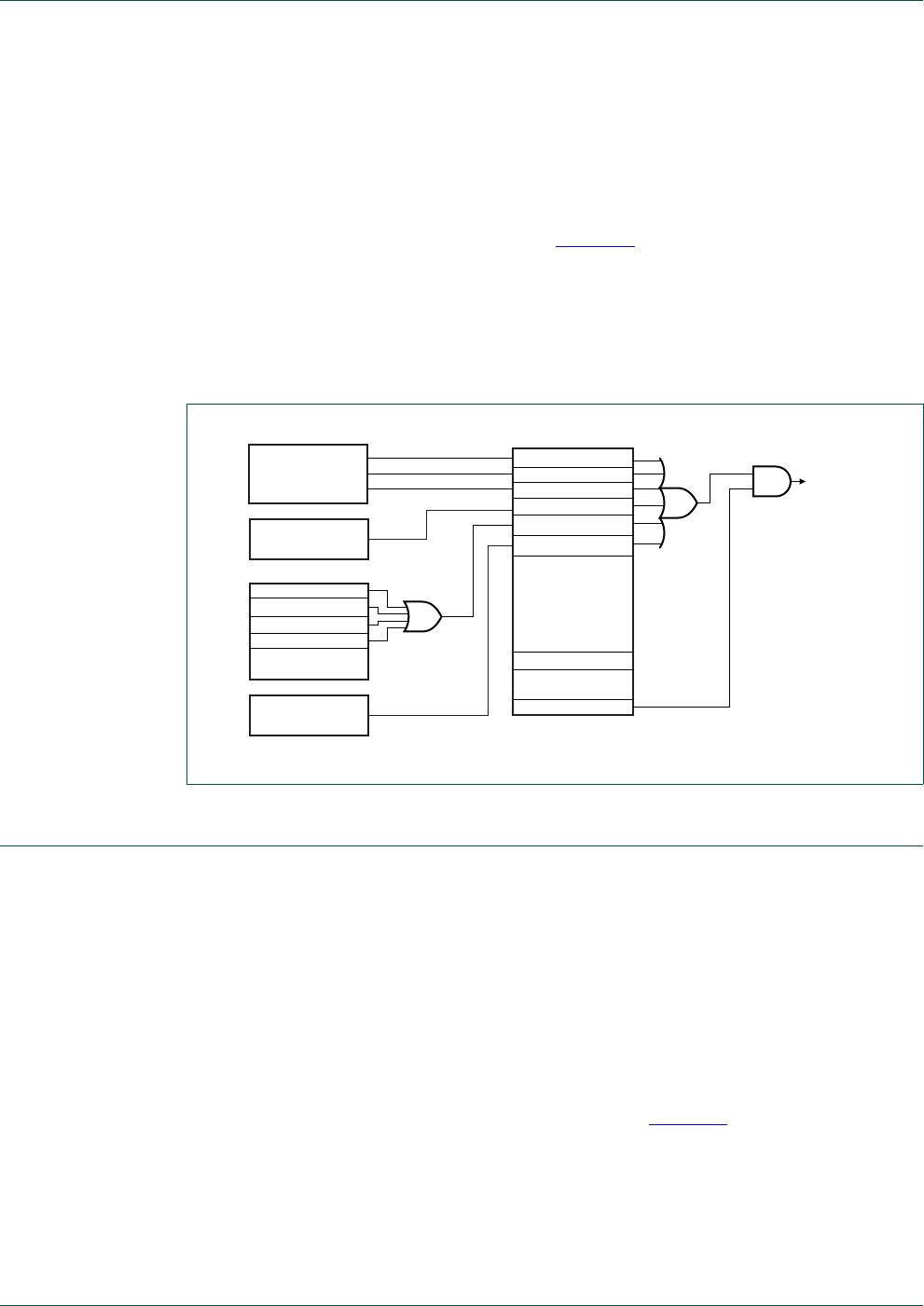
UM10360 All information provided in this document is subject to legal disclaimers. © NXP B.V. 2014. All rights reserved.
User manual Rev. 3.1 — 2 April 2014 295 of 849
NXP Semiconductors UM10360
Chapter 13: LPC176x/5x USB OTG
I2C related interrupts are set in the I2C_STS register and routed, if enabled by I2C_CTL,
to the USB_I2C_INT bit.
For more details on the interrupts created by device controller, see the USB device
chapter. For interrupts created by the host controllers, see the OHCI specification.
The EN_USB_INTS bit in the USBIntSt register enables the routing of any of the USB
related interrupts to the NVIC controller (see Figure 39).
Remark: During the HNP switching between host and device with the OTG stack active,
an action may raise several levels of interrupts. It is advised to let the OTG stack initiate
any actions based on interrupts and ignore device and host level interrupts. This means
that during HNP switching, the OTG stack provides the communication to the host and
device controllers.
13.9 HNP support
This section describes the hardware support for the Host Negotiation Protocol (HNP)
provided by the OTG controller.
When two dual-role OTG devices are connected to each other, the plug inserted into the
mini-AB receptacle determines the default role of each device. The device with the mini-A
plug inserted becomes the default Host (A-device), and the device with the mini-B plug
inserted becomes the default Peripheral (B-device).
Once connected, the default Host (A-device) and the default Peripheral (B-device) can
switch Host and Peripheral roles using HNP.
The context of the OTG controller operation is shown in Figure 40. Each controller (Host,
Device, or OTG) communicates with its software stack through a set of status and control
registers and interrupts. In addition, the OTG software stack communicates with the
external OTG transceiver through the I2C interface and the external transceiver interrupt
signal.
Fig 39. USB OTG interrupt handling
USB_INT_REQ_HP
USB_INT_REQ_LP
USB_INT_REQ_DMA
EN_USB_INTS
to NVIC
USB_HOST_INT
USB_OTG_INT
USB_I2C_INT
USB_NEED_CLOCK
USBIntSt
USB DEVICE
INTERRUPTS
USB HOST
INTERRUPTS
OTGIntSt
TMR
REMOVE_PU
HNP_SUCCESS
HNP_FAILURE
USB I2C
INTERRUPTS
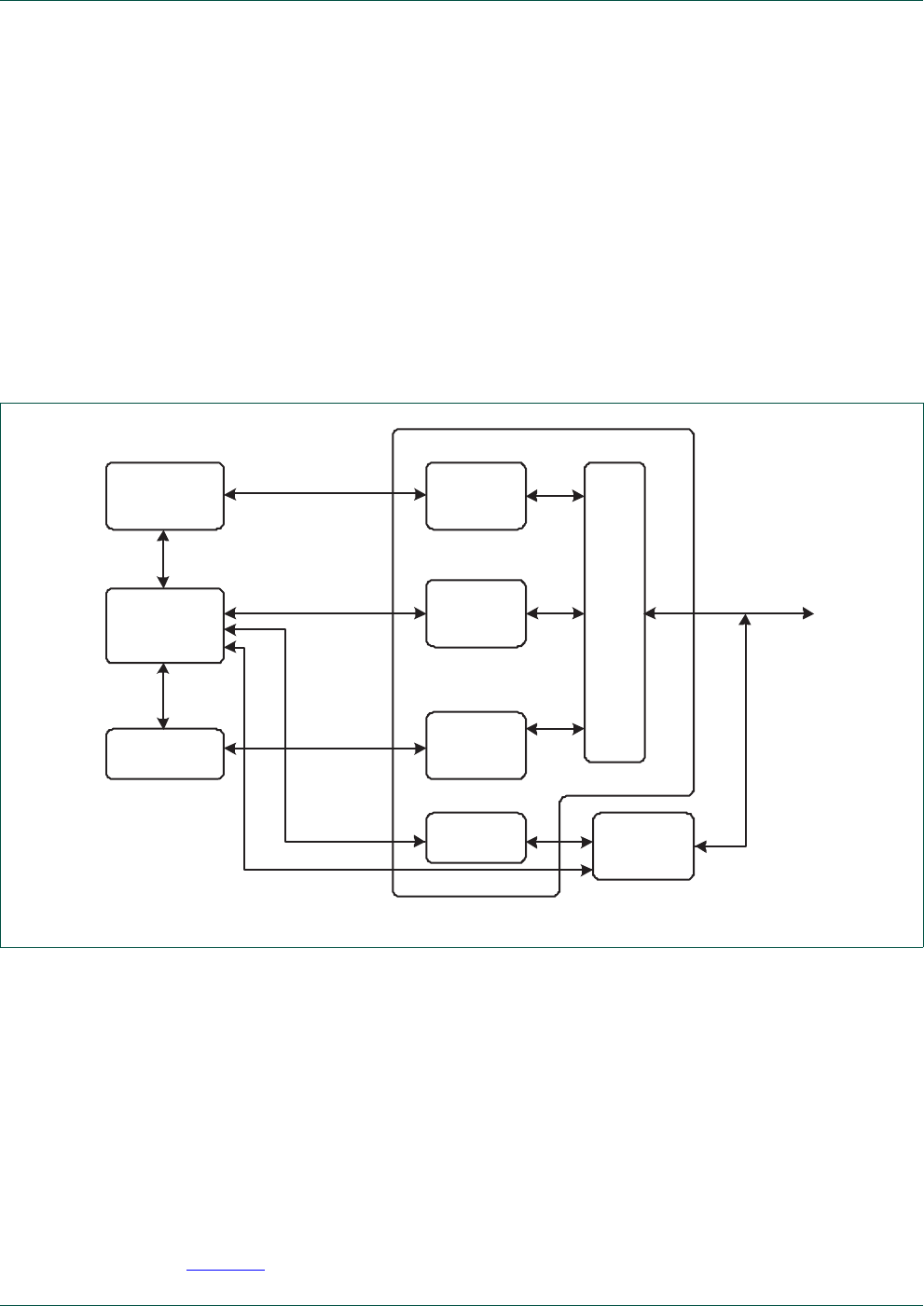
UM10360 All information provided in this document is subject to legal disclaimers. © NXP B.V. 2014. All rights reserved.
User manual Rev. 3.1 — 2 April 2014 296 of 849
NXP Semiconductors UM10360
Chapter 13: LPC176x/5x USB OTG
The OTG software stack is responsible for implementing the HNP state machines as
described in the On-The-Go Supplement to the USB 2.0 Specification.
The OTG controller hardware provides support for some of the state transitions in the
HNP state machines as described in the following subsections.
The USB state machines, the HNP switching, and the communications between the USB
controllers are described in more detail in the following documentation:
•USB OHCI specification
•USB OTG supplement, version 1.2
•USB 2.0 specification
•ISP1302 data sheet and user manual
13.9.1 B-device: peripheral to host switching
In this case, the default role of the OTG controller is peripheral (B-device), and it switches
roles from Peripheral to Host.
The On-The-Go Supplement defines the behavior of a dual-role B-device during HNP
using a state machine diagram. The OTG software stack is responsible for implementing
all of the states in the Dual-Role B-Device State Diagram.
The OTG controller hardware provides support for the state transitions between the states
b_peripheral, b_wait_acon, and b_host in the Dual-Role B-Device state diagram. Setting
B_HNP_TRACK in the OTGStCtrl register enables hardware support for the B-device
switching from peripheral to host. The hardware actions after setting this bit are shown in
Figure 41.
Fig 40. USB OTG controller with software stack
HOST
CONTROLLER
MUX
OHCI
STACK
OTG
STACK
DEVICE
STACK
USB BUS
ISP1302
OTG
CONTROLLER
DEVICE
CONTROLLER
I2C
CONTROLLER
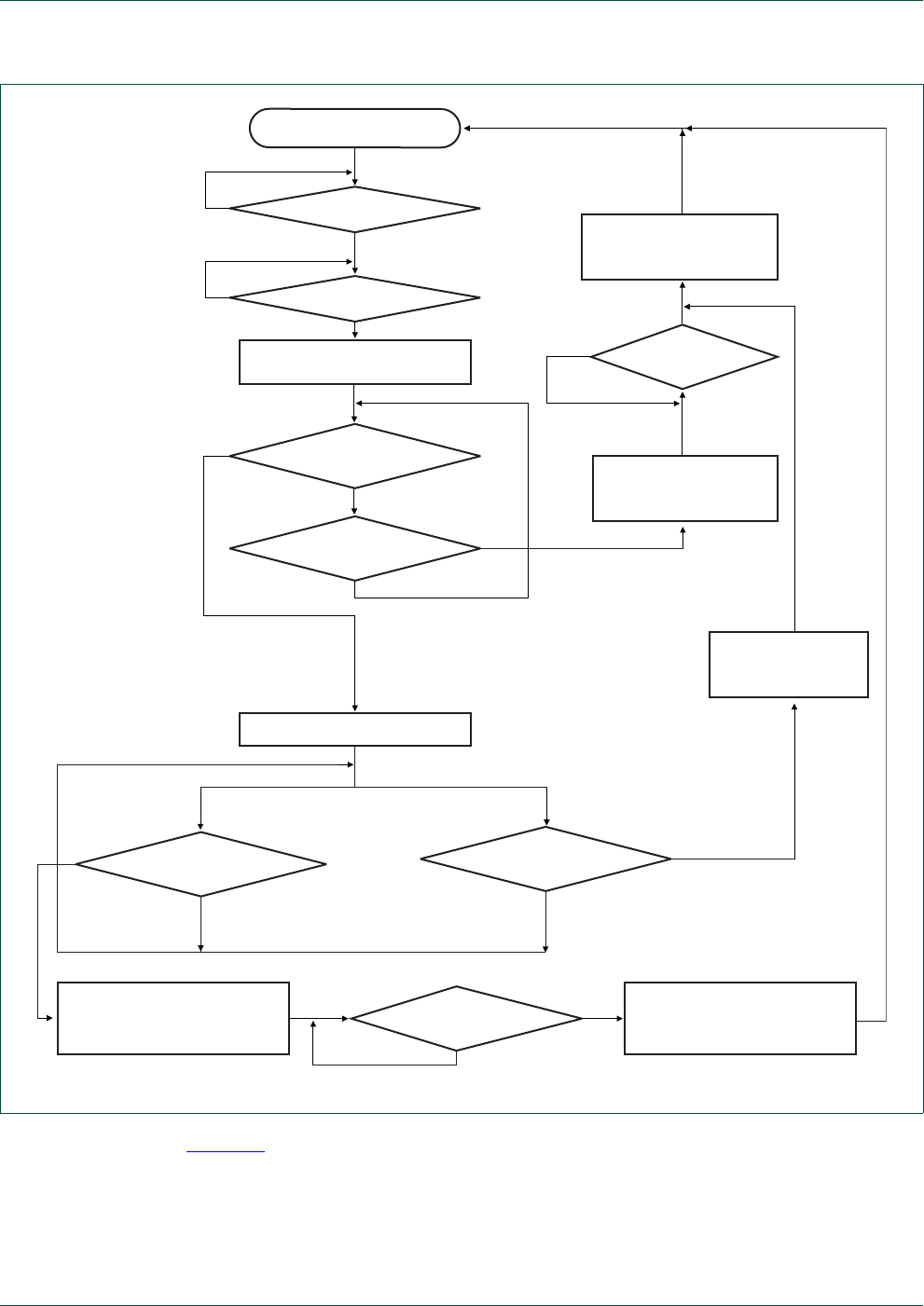
UM10360 All information provided in this document is subject to legal disclaimers. © NXP B.V. 2014. All rights reserved.
User manual Rev. 3.1 — 2 April 2014 297 of 849
NXP Semiconductors UM10360
Chapter 13: LPC176x/5x USB OTG
Figure 42 shows the actions that the OTG software stack should take in response to the
hardware actions setting REMOVE_PU, HNP_SUCCESS, AND HNP_FAILURE. The
relationship of the software actions to the Dual-Role B-Device states is also shown.
B-device states are in bold font with a circle around them.
Fig 41. Hardware support for B-device switching from peripheral state to host state
idle
set HNP_SUCCESS
set PORT_FUNC[0]
drive J on internal host controller port
and SE0 on U1
wait 25 s for bus to settle
disconnect device controller from U1
set REMOVE_PU
bus suspended ?
set HNP_FAILURE,
clear B_HNP_TRACK,
clear PU_REMOVED
reconnect port U1 to the
device controller
reconnect port U1 to the
device controller
connect U1 to host controller
clear B_HNP_TRACK
clear PU_REMOVED
PU_REMOVED set?
PU_REMOVED set?
bus reset/resume detected?
connect from A-device detected? bus reset/resume detected?
SE0 sent by host?
B_HNP_TRACK = 0
no
yes
yes
no no
yes yes
no
B_HNP_TRACK = 1 ?
no
no
no
yes
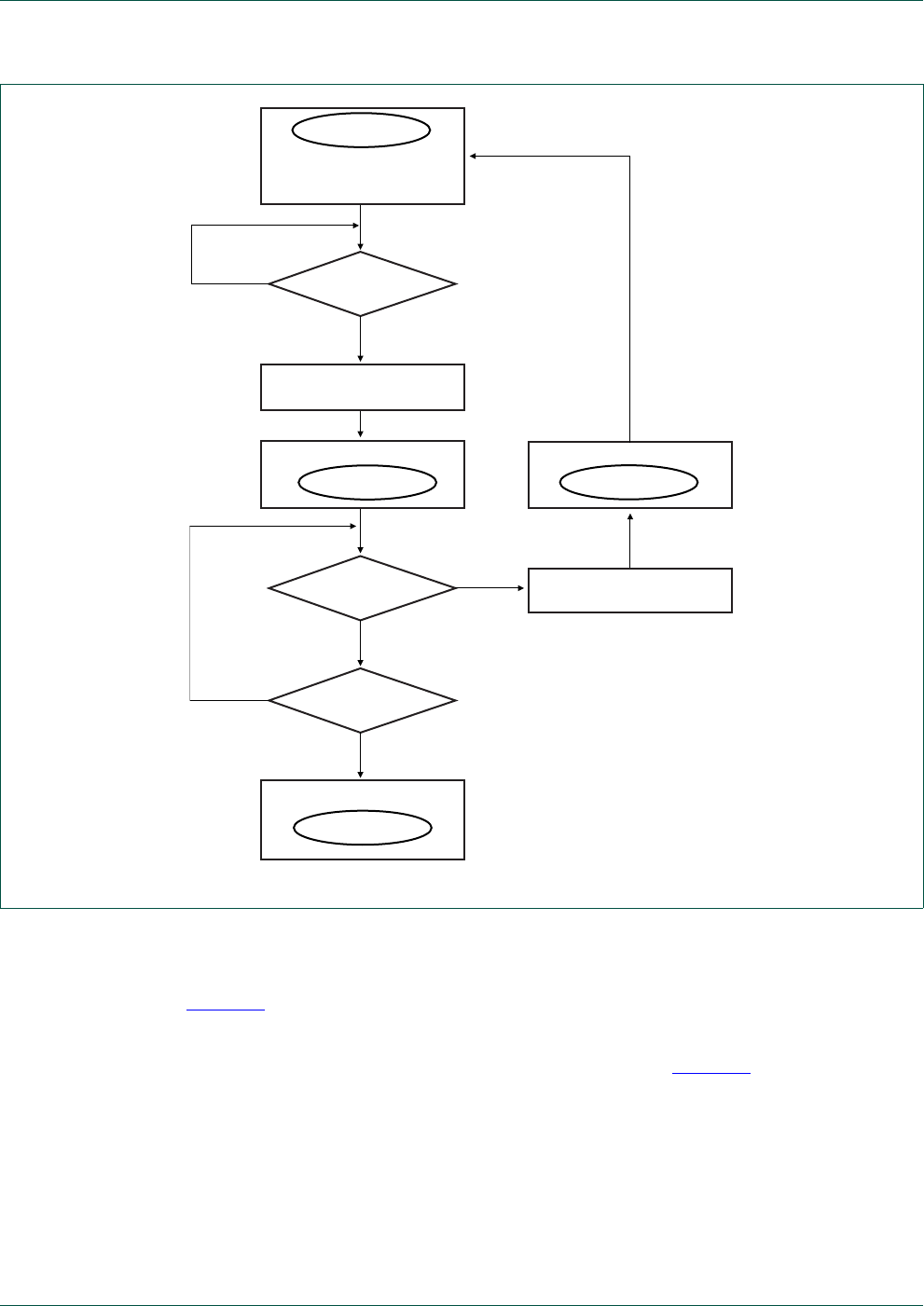
UM10360 All information provided in this document is subject to legal disclaimers. © NXP B.V. 2014. All rights reserved.
User manual Rev. 3.1 — 2 April 2014 298 of 849
NXP Semiconductors UM10360
Chapter 13: LPC176x/5x USB OTG
Note that only the subset of B-device HNP states and state transitions supported by
hardware are shown. Software is responsible for implementing all of the HNP states.
Figure 42 may appear to imply that the interrupt bits such as REMOVE_PU should be
polled, but this is not necessary if the corresponding interrupt is enabled.
Following are code examples that show how the actions in Figure 42 are accomplished.
The examples assume that ISP1302 is being used as the external OTG transceiver.
Remove D+ pull-up
/* Remove D+ pull-up through ISP1302 */
OTG_I2C_TX = 0x15A; // Send ISP1302 address, R/W=0
OTG_I2C_TX = 0x007; // Send OTG Control (Clear) register address
OTG_I2C_TX = 0x201; // Clear DP_PULLUP bit, send STOP condition
Fig 42. State transitions implemented in software during B-device switching from peripheral to host
REMOVE_PU set?
HNP_FAILURE set?
HNP_SUCCESS set?
b_peripheral
when host sends SET_FEATURE
with b_hnp_enable,
set B_HNP_TRACK
remove D+ pull-up,
set PU_REMOVED
b_peripheral
add D+ pull-up
b_wait_acon
b_host
no
yes
go to go to
go to
yes
no
no
yes

UM10360 All information provided in this document is subject to legal disclaimers. © NXP B.V. 2014. All rights reserved.
User manual Rev. 3.1 — 2 April 2014 299 of 849
NXP Semiconductors UM10360
Chapter 13: LPC176x/5x USB OTG
/* Wait for TDI to be set */
while (!(OTG_I2C_STS & TDI));
/* Clear TDI */
OTG_I2C_STS = TDI;
Add D+ pull-up
/* Add D+ pull-up through ISP1302 */
OTG_I2C_TX = 0x15A; // Send ISP1302 address, R/W=0
OTG_I2C_TX = 0x006; // Send OTG Control (Set) register address
OTG_I2C_TX = 0x201; // Set DP_PULLUP bit, send STOP condition
/* Wait for TDI to be set */
while (!(OTG_I2C_STS & TDI));
/* Clear TDI */
OTG_I2C_STS = TDI;
13.9.2 A-device: host to peripheral HNP switching
In this case, the role of the OTG controller is host (A-device), and the A-device switches
roles from host to peripheral.
The On-The-Go Supplement defines the behavior of a dual-role A-device during HNP
using a state machine diagram. The OTG software stack is responsible for implementing
all of the states in the Dual-Role A-Device State Diagram.
The OTG controller hardware provides support for the state transitions between a_host,
a_suspend, a_wait_vfall, and a_peripheral in the Dual-Role A-Device state diagram.
Setting A_HNP_TRACK in the OTGStCtrl register enables hardware support for switching
the A-device from the host state to the device state. The hardware actions after setting
this bit are shown in Figure 43.
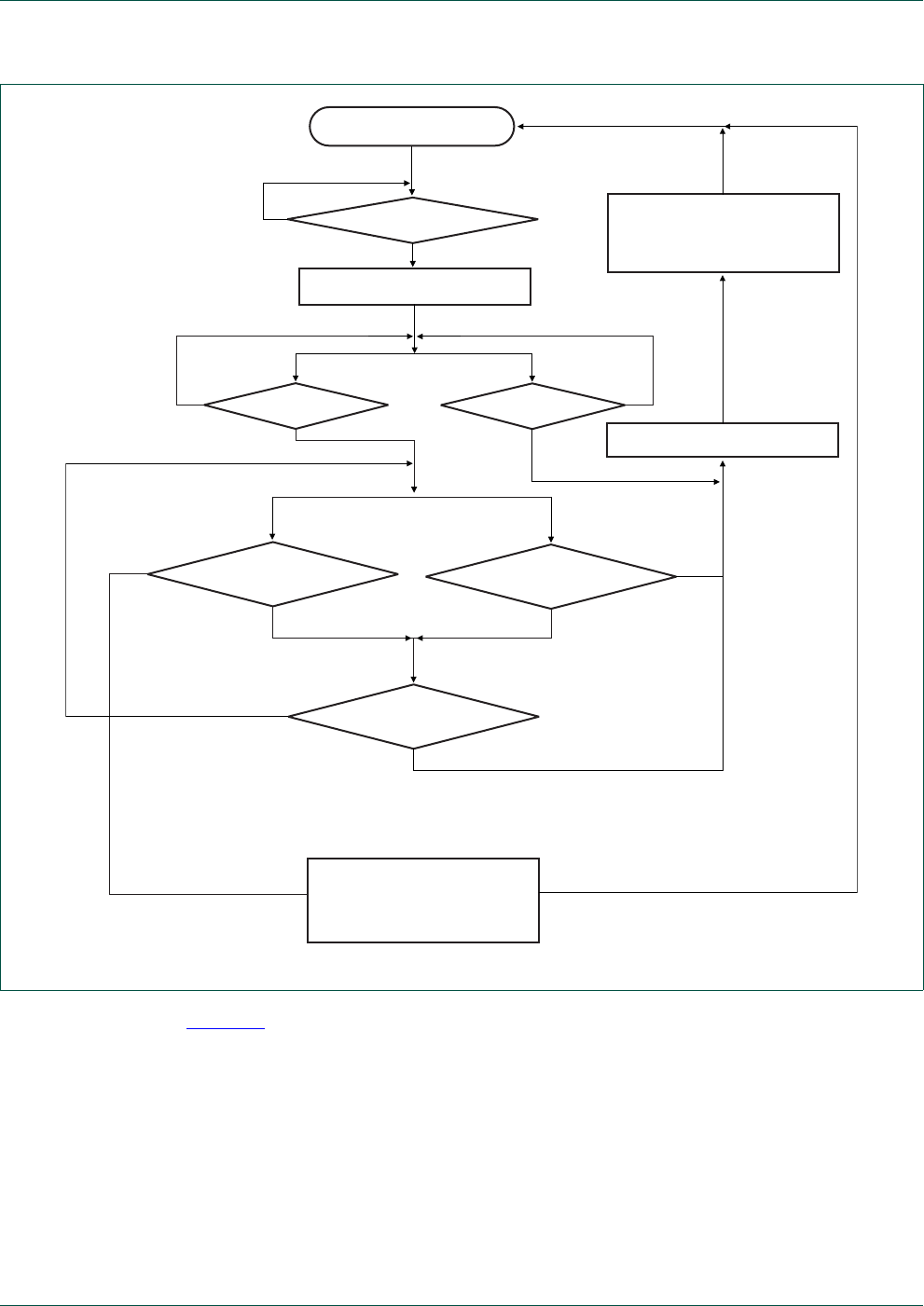
UM10360 All information provided in this document is subject to legal disclaimers. © NXP B.V. 2014. All rights reserved.
User manual Rev. 3.1 — 2 April 2014 300 of 849
NXP Semiconductors UM10360
Chapter 13: LPC176x/5x USB OTG
Figure 44 shows the actions that the OTG software stack should take in response to the
hardware actions setting TMR, HNP_SUCCESS, and HNP_FAILURE. The relationship of
the software actions to the Dual-Role A-Device states is also shown. A-device states are
shown in bold font with a circle around them.
Fig 43. Hardware support for A-device switching from host state to peripheral state
disconnect host controller from U1
set HNP_FAILURE,
clear A_HNP_TRACK
clear A_HNP_TRACK
set HNP_SUCCESS
connect device to U1 by clearing
PORT_FUNC[0]
bus reset detected?
OTG timer expired?
(TMR =1 )
resume detected?
connnect host controller back to U1
no no
no
yes
yes
yes
yes yes
idle
A_HNP_TRACK = 0
bus suspended ? resume detected ?
no no
A_HNP_TRACK = 1 ?
no
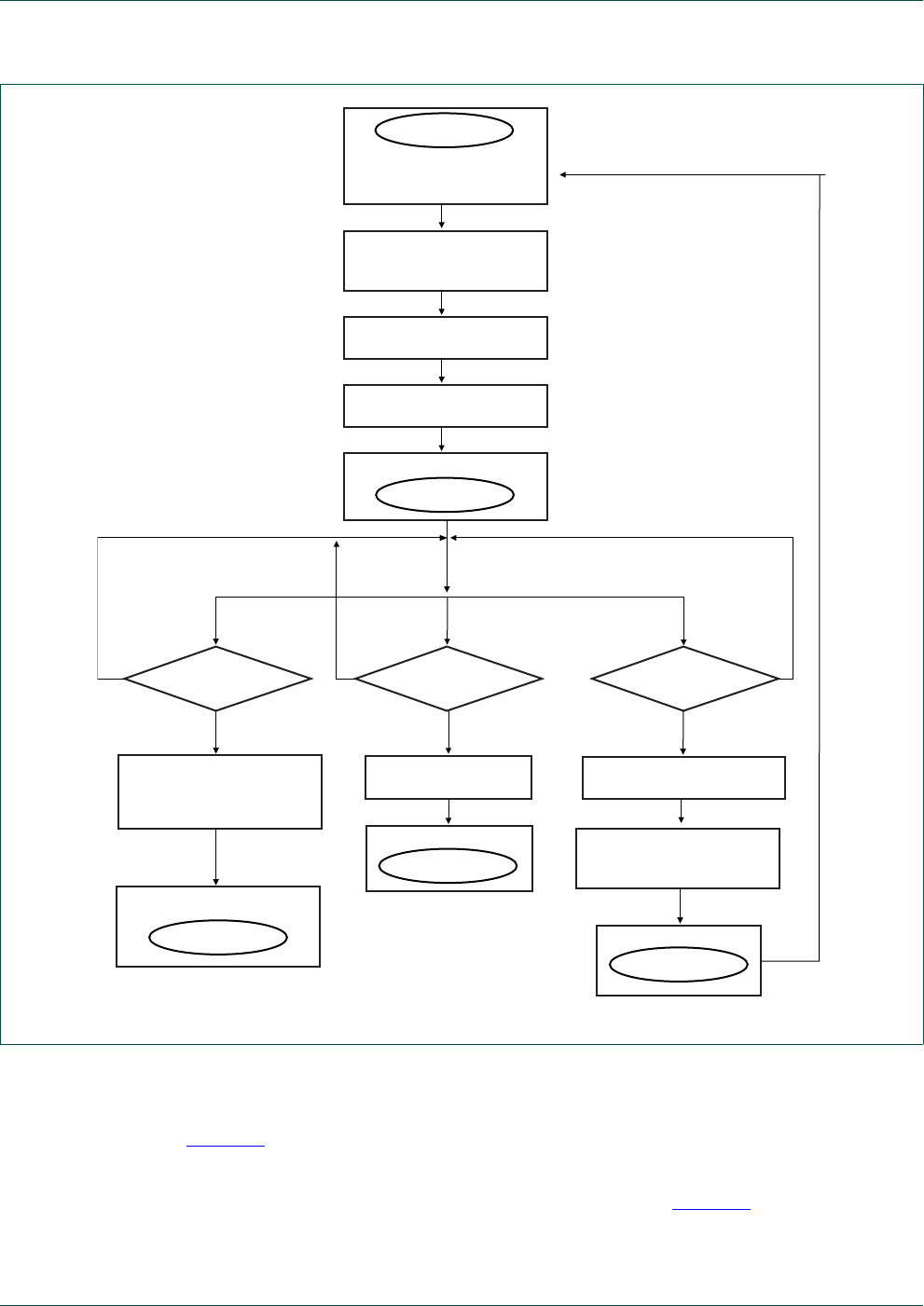
UM10360 All information provided in this document is subject to legal disclaimers. © NXP B.V. 2014. All rights reserved.
User manual Rev. 3.1 — 2 April 2014 301 of 849
NXP Semiconductors UM10360
Chapter 13: LPC176x/5x USB OTG
Note that only the subset of A-device HNP states and state transitions supported by
hardware are shown. Software is responsible for implementing all of the HNP states.
Figure 44 may appear to imply that the interrupt bits such as TMR should be polled, but
this is not necessary if the corresponding interrupt is enabled.
Following are code examples that show how the actions in Figure 44 are accomplished.
The examples assume that ISP1302 is being used as the external OTG transceiver.
Set BDIS_ACON_EN in external OTG transceiver
Fig 44. State transitions implemented in software during A-device switching from host to peripheral
HNP_SUCCESS set? HNP_FAILURE set?TMR set?
a_host
when host sends SET_FEATURE
with a_hnp_enable,
set A_HNP_TRACK
stop the OTG timer
a_suspend
a_host
a_wait_vfall
go to
a_peripheral
go to
go to
yes yes
yes
set BDIS_ACON_EN
in external OTG transceiver
load and enable OTG timer
clear BDIS_ACON_EN
bit in external OTG transceiver
clear BDIS_ACON_EN
bit in external OTG transceiver
discharge VBUS
stop OTG timer
suspend host on port 1
go to
no no
no

UM10360 All information provided in this document is subject to legal disclaimers. © NXP B.V. 2014. All rights reserved.
User manual Rev. 3.1 — 2 April 2014 302 of 849
NXP Semiconductors UM10360
Chapter 13: LPC176x/5x USB OTG
/* Set BDIS_ACON_EN in ISP1302 */
OTG_I2C_TX = 0x15A; // Send ISP1302 address, R/W=0
OTG_I2C_TX = 0x004; // Send Mode Control 1 (Set) register address
OTG_I2C_TX = 0x210; // Set BDIS_ACON_EN bit, send STOP condition
/* Wait for TDI to be set */
while (!(OTG_I2C_STS & TDI));
/* Clear TDI */
OTG_I2C_STS = TDI;
Clear BDIS_ACON_EN in external OTG transceiver
/* Set BDIS_ACON_EN in ISP1302 */
OTG_I2C_TX = 0x15A; // Send ISP1302 address, R/W=0
OTG_I2C_TX = 0x005; // Send Mode Control 1 (Clear) register address
OTG_I2C_TX = 0x210; // Clear BDIS_ACON_EN bit, send STOP condition
/* Wait for TDI to be set */
while (!(OTG_I2C_STS & TDI));
/* Clear TDI */
OTG_I2C_STS = TDI;
Discharge VBUS
/* Clear the VBUS_DRV bit in ISP1302 */
OTG_I2C_TX = 0x15A; // Send ISP1302 address, R/W=0
OTG_I2C_TX = 0x007; // Send OTG Control (Clear) register address
OTG_I2C_TX = 0x220; // Clear VBUS_DRV bit, send STOP condition
/* Wait for TDI to be set */
while (!(OTG_I2C_STS & TDI));
/* Clear TDI */
OTG_I2C_STS = TDI;
/* Set the VBUS_DISCHRG bit in ISP1302 */
OTG_I2C_TX = 0x15A; // Send ISP1302 address, R/W=0
OTG_I2C_TX = 0x006; // Send OTG Control (Set) register address
OTG_I2C_TX = 0x240; // Set VBUS_DISCHRG bit, send STOP condition
/* Wait for TDI to be set */
while (!(OTG_I2C_STS & TDI));
/* Clear TDI */
OTG_I2C_STS = TDI;

UM10360 All information provided in this document is subject to legal disclaimers. © NXP B.V. 2014. All rights reserved.
User manual Rev. 3.1 — 2 April 2014 303 of 849
NXP Semiconductors UM10360
Chapter 13: LPC176x/5x USB OTG
Load and enable OTG timer
/* The following assumes that the OTG timer has previously been */
/* configured for a time scale of 1 ms (TMR_SCALE = “10”) */
/* and monoshot mode (TMR_MODE = 0) */
/* Load the timeout value to implement the a_aidl_bdis_tmr timer */
/* the minimum value is 200 ms */
OTG_TIMER = 200;
/* Enable the timer */
OTG_STAT_CTRL |= TMR_EN;
Stop OTG timer
/* Disable the timer – causes TMR_CNT to be reset to 0 */
OTG_STAT_CTRL &= ~TMR_EN;
/* Clear TMR interrupt */
OTG_INT_CLR = TMR;
Suspend host on port 1
/* Write to PortSuspendStatus bit to suspend host port 1 – */
/* this example demonstrates the low-level action software needs to take. */
/* The host stack code where this is done will be somewhat more involved. */
HC_RH_PORT_STAT1 = PSS;
13.10 Clocking and power management
The OTG controller clocking is shown in Figure 45.
A clock switch controls each clock with the exception of ahb_slave_clk. When the enable
of the clock switch is asserted, its clock output is turned on and its CLK_ON output is
asserted. The CLK_ON signals are observable in the OTGClkSt register.
To conserve power, the clocks to the Device, Host, OTG, and I2C controllers can be
disabled when not in use by clearing the respective CLK_EN bit in the OTGClkCtrl
register. When the entire USB block is not in use, all of its clocks can be disabled by
clearing the PCUSB bit in the PCONP register.
When software wishes to access registers in one of the controllers, it should first ensure
that the respective controller’s 48 MHz clock is enabled by setting its CLK_EN bit in the
OTGClkCtrl register and then poll the corresponding CLK_ON bit in OTGClkSt until set.
Once set, the controller’s clock will remain enabled until CLK_EN is cleared by software.
Accessing the register of a controller when its 48 MHz clock is not enabled will result in a
data abort exception.
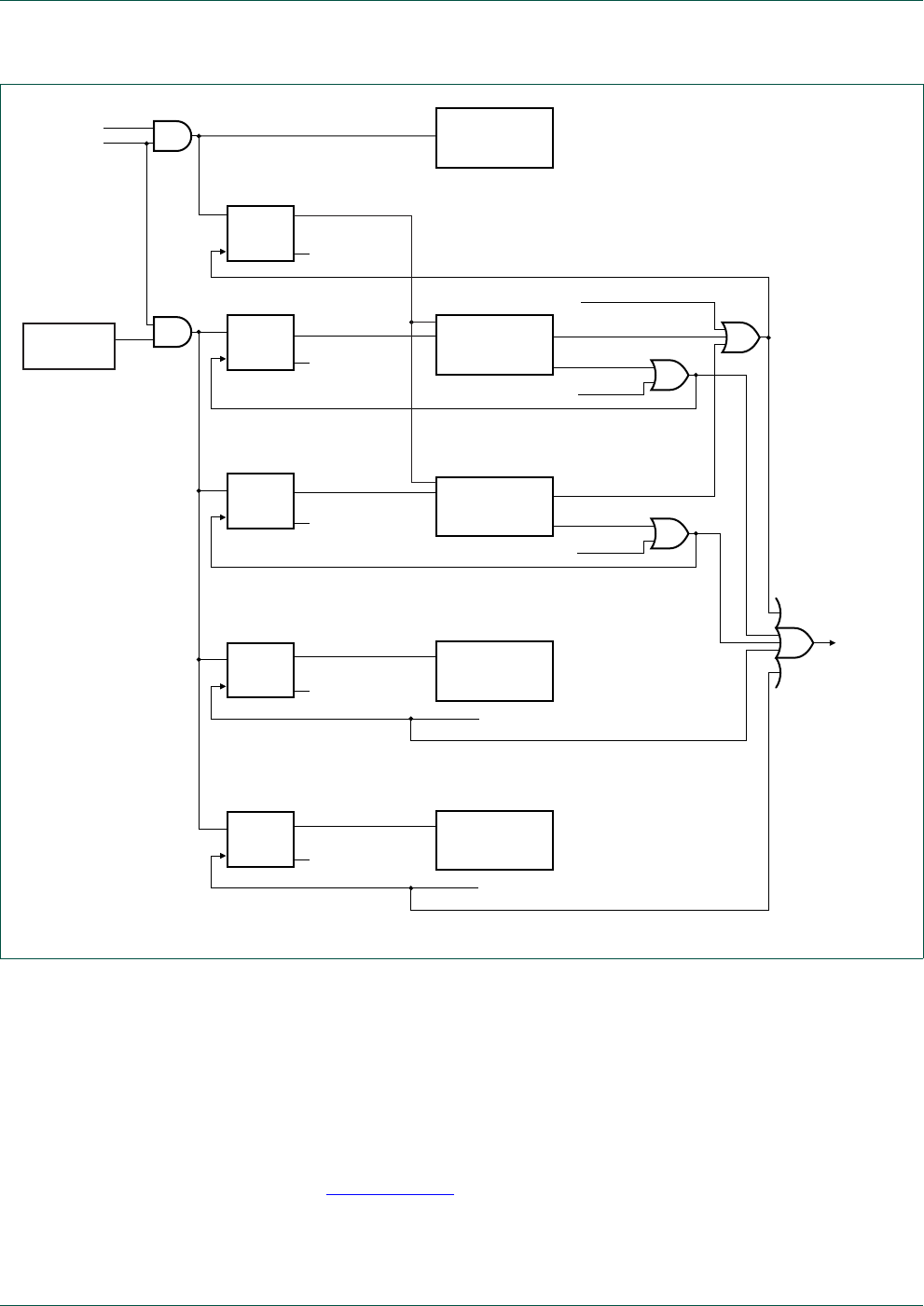
UM10360 All information provided in this document is subject to legal disclaimers. © NXP B.V. 2014. All rights reserved.
User manual Rev. 3.1 — 2 April 2014 304 of 849
NXP Semiconductors UM10360
Chapter 13: LPC176x/5x USB OTG
13.10.1 Device clock request signals
The Device controller has two clock request signals, dev_need_clk and
dev_dma_need_clk. When asserted, these signals turn on the device’s 48 MHz clock and
ahb_master_clk respectively.
The dev_need_clk signal is asserted while the device is not in the suspend state, or if the
device is in the suspend state and activity is detected on the USB bus. The dev_need_clk
signal is de-asserted if a disconnect is detected (CON bit is cleared in the SIE Get Device
Status register – Section 11.10.6). This signal allows DEV_CLK_EN to be cleared during
normal operation when software does not need to access the Device controller registers –
the Device will continue to function normally and automatically shut off its clock when it is
suspended or disconnected.
Fig 45. Clocking and power control
CLOCK
SWITCH
USB CLOCK
DIVIDER
REGISTER
INTERFACE
DEVICE
CONTROLLER
HOST
CONTROLLER
OTG
CONTROLLER
I2C
CONTROLLER
AHB_CLK_ON
ahb_slave_clk
ahb_master_clk
DEV_CLK_ON
HOST_CLK_ON
OTG_CLK_ON
I2C_CLK_ON
DEV_CLK_EN
HOST_CLK_EN
OTG_CLK_EN
I2C_CLK_EN
dev_dma_need_clk
host_dma_need_clk
dev_need_clk
host_need_clk
AHB_CLK_EN
ahb_need_clk
PCUSB
cclk
usbclk
(48 MHz)
EN
CLOCK
SWITCH
EN
CLOCK
SWITCH
EN
EN
CLOCK
SWITCH
CLOCK
SWITCH
EN
USB_NEED_CLK

UM10360 All information provided in this document is subject to legal disclaimers. © NXP B.V. 2014. All rights reserved.
User manual Rev. 3.1 — 2 April 2014 305 of 849
NXP Semiconductors UM10360
Chapter 13: LPC176x/5x USB OTG
The dev_dma_need_clk signal is asserted on any Device controller DMA access to
memory. Once asserted, it remains active for 2 ms (2 frames), to help assure that DMA
throughput is not affected by any latency associated with re-enabling ahb_master_clk.
2 ms after the last DMA access, dev_dma_need_clk is de-asserted to help conserve
power. This signal allows AHB_CLK_EN to be cleared during normal operation.
13.10.1.1 Host clock request signals
The Host controller has two clock request signals, host_need_clk and
host_dma_need_clk. When asserted, these signals turn on the host’s 48 MHz clock and
ahb_master_clk respectively.
The host_need_clk signal is asserted while the Host controller functional state is not
UsbSuspend, or if the functional state is UsbSuspend and resume signaling or a
disconnect is detected on the USB bus. This signal allows HOST_CLK_EN to be cleared
during normal operation when software does not need to access the Host controller
registers – the Host will continue to function normally and automatically shut off its clock
when it goes into the UsbSuspend state.
The host_dma_need_clk signal is asserted on any Host controller DMA access to
memory. Once asserted, it remains active for 2 ms (2 frames), to help assure that DMA
throughput is not affected by any latency associated with re-enabling ahb_master_clk.
2 ms after the last DMA access, host_dma_need_clk is de-asserted to help conserve
power. This signal allows AHB_CLK_EN to be cleared during normal operation.
13.10.2 Power-down mode support
The LPC176x/5x can be configured to wake up from Power-down mode on any USB bus
activity. When the chip is in Power-down mode and the USB interrupt is enabled, the
assertion of USB_NEED_CLK causes the chip to wake up from Power-down mode.
Before Power-down mode can be entered when the USB activity interrupt is enabled,
USB_NEED_CLK must be de-asserted. This is accomplished by clearing all of the
CLK_EN bits in OTGClkCtrl and putting the Host controller into the UsbSuspend
functional state. If it is necessary to wait for either of the dma_need_clk signals or the
dev_need_clk to be de-asserted, the status of USB_NEED_CLK can be polled in the
USBIntSt register to determine when they have all been de-asserted.
13.11 USB OTG controller initialization
The LPC176x/5x OTG device controller initialization includes the following steps:
1. Enable the device controller by setting the PCUSB bit of PCONP.
2. Configure and enable the USB PLL (PLL1) or Main PLL (PLL0) to provide 48 MHz for
usbclk and the desired frequency for cclk. For the procedure for determining the PLL
setting and configuration, see Section 4.5.11 “Procedure for determining PLL0
settings” or Section 4.6.9 “Procedure for determining PLL1 settings”.
3. Enable the desired controller clocks by setting their respective CLK_EN bits in the
USBClkCtrl register. Poll the corresponding CLK_ON bits in the USBClkSt register
until they are set.
4. Enable the desired USB pin functions by writing to the corresponding PINSEL
registers.

UM10360 All information provided in this document is subject to legal disclaimers. © NXP B.V. 2014. All rights reserved.
User manual Rev. 3.1 — 2 April 2014 306 of 849
NXP Semiconductors UM10360
Chapter 13: LPC176x/5x USB OTG
5. Follow the appropriate steps in Section 11.13 “USB device controller initialization” to
initialize the device controller.
6. Follow the guidelines given in the OpenHCI specification for initializing the host
controller.

UM10360 All information provided in this document is subject to legal disclaimers. © NXP B.V. 2014. All rights reserved.
User manual Rev. 3.1 — 2 April 2014 307 of 849
14.1 Basic configuration
The UART0/2/3 peripherals are configured using the following registers:
1. Power: In the PCONP register (Ta b le 46 ), set bits PCUART0/2/3.
Remark: On reset, UART0 is enabled (PCUART0 = 1), and UART2/3 are disabled
(PCUART2/3 = 0).
2. Peripheral clock: In the PCLKSEL0 register (Ta b l e 4 0 ), select PCLK_UART0; in the
PCLKSEL1 register (Ta b le 41 ), select PCLK_UART2/3.
3. Baud rate: In register U0/2/3LCR (Ta b l e 28 0 ), set bit DLAB =1. This enables access
to registers DLL (Tab le 2 7 4) and DLM (Ta bl e 2 7 5) for setting the baud rate. Also, if
needed, set the fractional baud rate in the fractional divider register (Ta b l e 2 8 6 ).
4. UART FIFO: Use bit FIFO enable (bit 0) in register U0/2/3FCR (Tab l e 279 ) to enable
FIFO.
5. Pins: Select UART pins through the PINSEL registers and pin modes through the
PINMODE registers (Section 8.5).
Remark: UART receive pins should not have pull-down resistors enabled.
6. Interrupts: To enable UART interrupts set bit DLAB =0 in register U0/2/3LCR
(Tab le 2 8 0). This enables access to U0/2/3IER (Ta b l e 2 7 6 ). Interrupts are enabled in
the NVIC using the appropriate Interrupt Set Enable register.
7. DMA: UART0/2/3 transmit and receive functions can operate with the GPDMA
controller (see Table 5 4 4 ).
14.2 Features
•Data sizes of 5, 6, 7, and 8 bits.
•Parity generation and checking: odd, even mark, space or none.
•One or two stop bits.
•16 byte Receive and Transmit FIFOs.
•Built-in baud rate generator, including a fractional rate divider for great versatility.
•Supports DMA for both transmit and receive.
•Auto-baud capability
•Break generation and detection.
•Multiprocessor addressing mode.
•IrDA mode to support infrared communication.
•Support for software flow control.
UM10360
Chapter 14: LPC176x/5x UART0/2/3
Rev. 3.1 — 2 April 2014 User manual

UM10360 All information provided in this document is subject to legal disclaimers. © NXP B.V. 2014. All rights reserved.
User manual Rev. 3.1 — 2 April 2014 308 of 849
NXP Semiconductors UM10360
Chapter 14: LPC176x/5x UART0/2/3
14.3 Pin description
14.4 Register description
Each UART contains registers as shown in Ta bl e 2 7 1 . The Divisor Latch Access Bit
(DLAB) is contained in UnLCR7 and enables access to the Divisor Latches.
Table 270: UARTn Pin description
Pin Type Description
RXD0, RXD2, RXD3 Input Serial Input. Serial receive data.
TXD0, TXD2, TXD3 Output Serial Output. Serial transmit data.

UM10360 All information provided in this document is subject to legal disclaimers. © NXP B.V. 2014. All rights reserved.
User manual Rev. 3.1 — 2 April 2014 309 of 849
NXP Semiconductors UM10360
Chapter 14: LPC176x/5x UART0/2/3
[1] Reset Value reflects the data stored in used bits only. It does not include reserved bits content.
Table 271. UART0/2/3 Register Map
Generic Name Description Access Reset
value[1]
UARTn Register
Name & Address
RBR (DLAB =0) Receiver Buffer Register. Contains the next received
character to be read.
RO NA U0RBR - 0x4000 C000
U2RBR - 0x4009 8000
U3RBR - 0x4009 C000
THR (DLAB =0) Transmit Holding Register. The next character to be
transmitted is written here.
WO NA U0THR - 0x4000 C000
U2THR - 0x4009 8000
U3THR - 0x4009 C000
DLL (DLAB =1) Divisor Latch LSB. Least significant byte of the baud
rate divisor value. The full divisor is used to generate a
baud rate from the fractional rate divider.
R/W 0x01 U0DLL - 0x4000 C000
U2DLL - 0x4009 8000
U3DLL - 0x4009 C000
DLM (DLAB =1) Divisor Latch MSB. Most significant byte of the baud
rate divisor value. The full divisor is used to generate a
baud rate from the fractional rate divider.
R/W 0x00 U0DLM - 0x4000 C004
U2DLM - 0x4009 8004
U3DLM - 0x4009 C004
IER (DLAB =0) Interrupt Enable Register. Contains individual interrupt
enable bits for the 7 potential UART interrupts.
R/W 0x00 U0IER - 0x4000 C004
U2IER - 0x4009 8004
U3IER - 0x4009 C004
IIR Interrupt ID Register. Identifies which interrupt(s) are
pending.
RO 0x01 U0IIR - 0x4000 C008
U2IIR - 0x4009 8008
U3IIR - 0x4009 C008
FCR FIFO Control Register. Controls UART FIFO usage and
modes.
WO 0x00 U0FCR - 0x4000 C008
U2FCR - 0x4009 8008
U3FCR - 0x4009 C008
LCR Line Control Register. Contains controls for frame
formatting and break generation.
R/W 0x00 U0LCR - 0x4000 C00C
U2LCR - 0x4009 800C
U3LCR - 0x4009 C00C
LSR Line Status Register. Contains flags for transmit and
receive status, including line errors.
RO 0x60 U0LSR - 0x4000 C014
U2LSR - 0x4009 8014
U3LSR - 0x4009 C014
SCR Scratch Pad Register. 8-bit temporary storage for
software.
R/W 0x00 U0SCR - 0x4000 C01C
U2SCR - 0x4009 801C
U3SCR - 0x4009 C01C
ACR Auto-baud Control Register. Contains controls for the
auto-baud feature.
R/W 0x00 U0ACR - 0x4000 C020
U2ACR - 0x4009 8020
U3ACR - 0x4009 C020
ICR IrDA Control Register. Enables and configures the
IrDA mode.
R/W 0x00 U0ICR - 0x4000 C024
U2ICR - 0x4009 8024
U3ICR - 0x4009 C024
FDR Fractional Divider Register. Generates a clock input for
the baud rate divider.
R/W 0x10 U0FDR - 0x4000 C028
U2FDR - 0x4009 8028
U3FDR - 0x4009 C028
TER Transmit Enable Register. Turns off UART transmitter
for use with software flow control.
R/W 0x80 U0TER - 0x4000 C030
U2TER - 0x4009 8030
U3TER - 0x4009 C030

UM10360 All information provided in this document is subject to legal disclaimers. © NXP B.V. 2014. All rights reserved.
User manual Rev. 3.1 — 2 April 2014 310 of 849
NXP Semiconductors UM10360
Chapter 14: LPC176x/5x UART0/2/3
14.4.1 UARTn Receiver Buffer Register (U0RBR - 0x4000 C000, U2RBR -
0x4009 8000, U3RBR - 0x4009 C000 when DLAB = 0)
The UnRBR is the top byte of the UARTn Rx FIFO. The top byte of the Rx FIFO contains
the oldest character received and can be read via the bus interface. The LSB (bit 0)
represents the “oldest” received data bit. If the character received is less than 8 bits, the
unused MSBs are padded with zeroes.
The Divisor Latch Access Bit (DLAB) in LCR must be zero in order to access the UnRBR.
The UnRBR is always read-only.
Since PE, FE and BI bits correspond to the byte sitting on the top of the RBR FIFO (i.e.
the one that will be read in the next read from the RBR), the right approach for fetching the
valid pair of received byte and its status bits is first to read the content of the U0LSR
register, and then to read a byte from the UnRBR.
14.4.2 UARTn Transmit Holding Register (U0THR - 0x4000 C000, U2THR -
0x4009 8000, U3THR - 0x4009 C000 when DLAB = 0)
The UnTHR is the top byte of the UARTn TX FIFO. The top byte is the newest character in
the TX FIFO and can be written via the bus interface. The LSB represents the first bit to
transmit.
The Divisor Latch Access Bit (DLAB) in UnLCR must be zero in order to access the
UnTHR. The UnTHR is always write-only.
14.4.3 UARTn Divisor Latch LSB register (U0DLL - 0x4000 C000, U2DLL -
0x4009 8000, U3DLL - 0x4009 C000 when DLAB = 1) and UARTn
Divisor Latch MSB register (U0DLM - 0x4000 C004, U2DLL -
0x4009 8004, U3DLL - 0x4009 C004 when DLAB = 1)
The UARTn Divisor Latch is part of the UARTn Baud Rate Generator and holds the value
used, along with the Fractional Divider, to divide the APB clock (PCLK) in order to produce
the baud rate clock, which must be 16 the desired baud rate. The UnDLL and UnDLM
registers together form a 16-bit divisor where UnDLL contains the lower 8 bits of the
divisor and UnDLM contains the higher 8 bits of the divisor. A 0x0000 value is treated like
a 0x0001 value as division by zero is not allowed. The Divisor Latch Access Bit (DLAB) in
UnLCR must be one in order to access the UARTn Divisor Latches. Details on how to
Table 272: UARTn Receiver Buffer Register (U0RBR - address 0x4000 C000, U2RBR - 0x4009 8000, U3RBR -
04009 C000 when DLAB = 0) bit description
Bit Symbol Description Reset Value
7:0 RBR The UARTn Receiver Buffer Register contains the oldest received byte in the UARTn Rx
FIFO.
Undefined
31:8 - Reserved, the value read from a reserved bit is not defined. NA
Table 273: UARTn Transmit Holding Register (U0THR - address 0x4000 C000, U2THR - 0x4009 8000, U3THR -
0x4009 C000 when DLAB = 0) bit description
Bit Symbol Description Reset Value
7:0 THR Writing to the UARTn Transmit Holding Register causes the data to be stored in the
UARTn transmit FIFO. The byte will be sent when it reaches the bottom of the FIFO and
the transmitter is available.
NA
31:8 - Reserved, user software should not write ones to reserved bits. NA
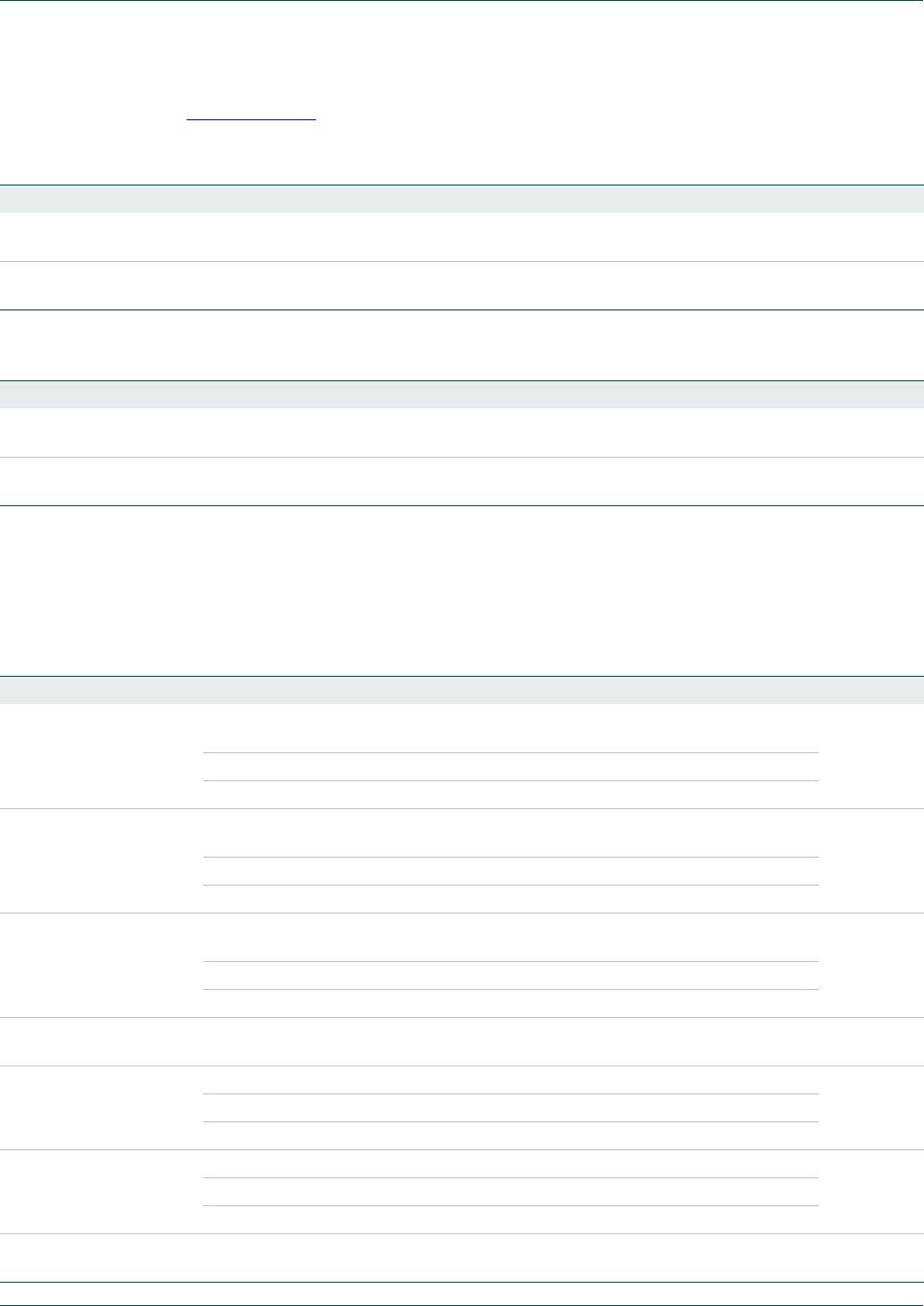
UM10360 All information provided in this document is subject to legal disclaimers. © NXP B.V. 2014. All rights reserved.
User manual Rev. 3.1 — 2 April 2014 311 of 849
NXP Semiconductors UM10360
Chapter 14: LPC176x/5x UART0/2/3
select the right value for UnDLL and UnDLM can be found later in this chapter, see
Section 14.4.12.
14.4.4 UARTn Interrupt Enable Register (U0IER - 0x4000 C004, U2IER -
0x4009 8004, U3IER - 0x4009 C004 when DLAB = 0)
The UnIER is used to enable the three UARTn interrupt sources.
Table 274: UARTn Divisor Latch LSB register (U0DLL - address 0x4000 C000, U2DLL - 0x4009 8000, U3DLL -
0x4009 C000 when DLAB = 1) bit description
Bit Symbol Description Reset Value
7:0 DLLSB The UARTn Divisor Latch LSB Register, along with the UnDLM register, determines the
baud rate of the UARTn.
0x01
31:8 - Reserved, user software should not write ones to reserved bits. The value read from a
reserved bit is not defined.
NA
Table 275: UARTn Divisor Latch MSB register (U0DLM - address 0x4000 C004, U2DLM - 0x4009 8004, U3DLM -
0x4009 C004 when DLAB = 1) bit description
Bit Symbol Description Reset Value
7:0 DLMSB The UARTn Divisor Latch MSB Register, along with the U0DLL register, determines the
baud rate of the UARTn.
0x00
31:8 - Reserved, user software should not write ones to reserved bits. The value read from a
reserved bit is not defined.
NA
Table 276: UARTn Interrupt Enable Register (U0IER - address 0x4000 C004, U2IER - 0x4009 8004, U3IER -
0x4009 C004 when DLAB = 0) bit description
Bit Symbol Value Description Reset Value
0RBR Interrupt
Enable
Enables the Receive Data Available interrupt for UARTn. It also controls
the Character Receive Time-out interrupt.
0
0Disable the RDA interrupts.
1Enable the RDA interrupts.
1THRE Interrupt
Enable
Enables the THRE interrupt for UARTn. The status of this can be read
from UnLSR[5].
0
0Disable the THRE interrupts.
1Enable the THRE interrupts.
2 RX Line Status
Interrupt Enable
Enables the UARTn RX line status interrupts. The status of this interrupt
can be read from UnLSR[4:1].
0
0Disable the RX line status interrupts.
1Enable the RX line status interrupts.
7:3 - Reserved, user software should not write ones to reserved bits. The value
read from a reserved bit is not defined.
NA
8ABEOIntEn Enables the end of auto-baud interrupt. 0
0Disable end of auto-baud Interrupt.
1Enable end of auto-baud Interrupt.
9ABTOIntEn Enables the auto-baud time-out interrupt. 0
0Disable auto-baud time-out Interrupt.
1Enable auto-baud time-out Interrupt.
31:10 - Reserved, user software should not write ones to reserved bits. The value
read from a reserved bit is not defined.
NA

UM10360 All information provided in this document is subject to legal disclaimers. © NXP B.V. 2014. All rights reserved.
User manual Rev. 3.1 — 2 April 2014 312 of 849
NXP Semiconductors UM10360
Chapter 14: LPC176x/5x UART0/2/3
14.4.5 UARTn Interrupt Identification Register (U0IIR - 0x4000 C008, U2IIR -
0x4009 8008, U3IIR - 0x4009 C008)
The UnIIR provides a status code that denotes the priority and source of a pending
interrupt. The interrupts are frozen during an UnIIR access. If an interrupt occurs during
an UnIIR access, the interrupt is recorded for the next UnIIR access.
Bit UnIIR[9:8] are set by the auto-baud function and signal a time-out or end of auto-baud
condition. The auto-baud interrupt conditions are cleared by setting the corresponding
Clear bits in the Auto-baud Control Register.
If the IntStatus bit is 1 no interrupt is pending and the IntId bits will be zero. If the IntStatus
is 0, a non auto-baud interrupt is pending in which case the IntId bits identify the type of
interrupt and handling as described in Tabl e 2 78 . Given the status of UnIIR[3:0], an
interrupt handler routine can determine the cause of the interrupt and how to clear the
active interrupt. The UnIIR must be read in order to clear the interrupt prior to exiting the
Interrupt Service Routine.
The UARTn RLS interrupt (UnIIR[3:1] = 011) is the highest priority interrupt and is set
whenever any one of four error conditions occur on the UARTn Rx input: overrun error
(OE), parity error (PE), framing error (FE) and break interrupt (BI). The UARTn Rx error
condition that set the interrupt can be observed via UnLSR[4:1]. The interrupt is cleared
upon an UnLSR read.
Table 277: UARTn Interrupt Identification Register (U0IIR - address 0x4000 C008, U2IIR - 0x4009 8008, U3IIR -
0x4009 C008) bit description
Bit Symbol Value Description Reset Value
0IntStatus Interrupt status. Note that UnIIR[0] is active low. The pending interrupt can be
determined by evaluating UnIIR[3:1].
1
0At least one interrupt is pending.
1No interrupt is pending.
3:1 IntId Interrupt identification. UnIER[3:1] identifies an interrupt corresponding to the
UARTn Rx or TX FIFO. All other combinations of UnIER[3:1] not listed below
are reserved (000,100,101,111).
0
011 1 - Receive Line Status (RLS).
010 2a - Receive Data Available (RDA).
110 2b - Character Time-out Indicator (CTI).
001 3 - THRE Interrupt
5:4 - Reserved, user software should not write ones to reserved bits. The value read
from a reserved bit is not defined.
NA
7:6 FIFO Enable Copies of UnFCR[0]. 0
8ABEOInt End of auto-baud interrupt. True if auto-baud has finished successfully and
interrupt is enabled.
0
9ABTOInt Auto-baud time-out interrupt. True if auto-baud has timed out and interrupt is
enabled.
0
31:10 - Reserved, user software should not write ones to reserved bits. The value read
from a reserved bit is not defined.
NA
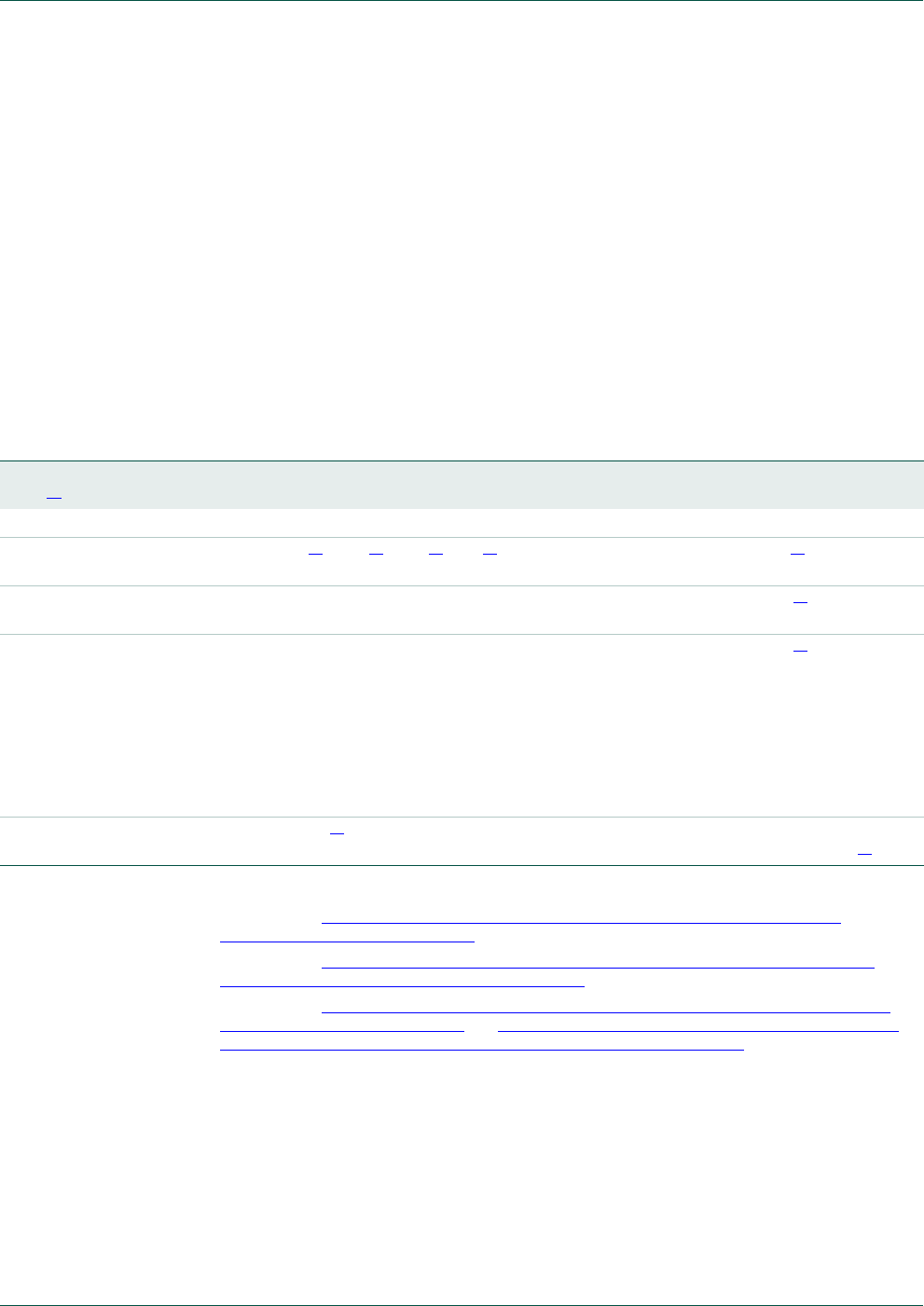
UM10360 All information provided in this document is subject to legal disclaimers. © NXP B.V. 2014. All rights reserved.
User manual Rev. 3.1 — 2 April 2014 313 of 849
NXP Semiconductors UM10360
Chapter 14: LPC176x/5x UART0/2/3
The UARTn RDA interrupt (UnIIR[3:1] = 010) shares the second level priority with the CTI
interrupt (UnIIR[3:1] = 110). The RDA is activated when the UARTn Rx FIFO reaches the
trigger level defined in UnFCR[7:6] and is reset when the UARTn Rx FIFO depth falls
below the trigger level. When the RDA interrupt goes active, the CPU can read a block of
data defined by the trigger level.
The CTI interrupt (UnIIR[3:1] = 110) is a second level interrupt and is set when the UARTn
Rx FIFO contains at least one character and no UARTn Rx FIFO activity has occurred in
3.5 to 4.5 character times. Any UARTn Rx FIFO activity (read or write of UARTn RSR) will
clear the interrupt. This interrupt is intended to flush the UARTn RBR after a message has
been received that is not a multiple of the trigger level size. For example, if a peripheral
wished to send a 105 character message and the trigger level was 10 characters, the
CPU would receive 10 RDA interrupts resulting in the transfer of 100 characters and 1 to 5
CTI interrupts (depending on the service routine) resulting in the transfer of the remaining
5 characters.
[1] Values "0000", “0011”, “0101”, “0111”, “1000”, “1001”, “1010”, “1011”,”1101”,”1110”,”1111” are reserved.
[2] For details see Section 14.4.8 “UARTn Line Status Register (U0LSR - 0x4000 C014, U2LSR -
0x4009 8014, U3LSR - 0x4009 C014)”
[3] For details see Section 14.4.1 “UARTn Receiver Buffer Register (U0RBR - 0x4000 C000, U2RBR -
0x4009 8000, U3RBR - 0x4009 C000 when DLAB = 0)”
[4] For details see Section 14.4.5 “UARTn Interrupt Identification Register (U0IIR - 0x4000 C008, U2IIR -
0x4009 8008, U3IIR - 0x4009 C008)” and Section 14.4.2 “UARTn Transmit Holding Register (U0THR -
0x4000 C000, U2THR - 0x4009 8000, U3THR - 0x4009 C000 when DLAB = 0)”
The UARTn THRE interrupt (UnIIR[3:1] = 001) is a third level interrupt and is activated
when the UARTn THR FIFO is empty provided certain initialization conditions have been
met. These initialization conditions are intended to give the UARTn THR FIFO a chance to
fill up with data to eliminate many THRE interrupts from occurring at system start-up. The
initialization conditions implement a one character delay minus the stop bit whenever
THRE = 1 and there have not been at least two characters in the UnTHR at one time
since the last THRE = 1 event. This delay is provided to give the CPU time to write data to
UnTHR without a THRE interrupt to decode and service. A THRE interrupt is set
Table 278: UARTn Interrupt Handling
U0IIR[3:0]
value[1]
Priority Interrupt
Type
Interrupt Source Interrupt Reset
0001 - None None -
0110 Highest RX Line
Status / Error
OE[2] or PE[2] or FE[2] or BI[2] UnLSR Read[2]
0100 Second RX Data
Available
Rx data available or trigger level reached in FIFO
(UnFCR0=1)
UnRBR Read[3] or UARTn
FIFO drops below trigger level
1100 Second Character
Time-out
indication
Minimum of one character in the Rx FIFO and no
character input or removed during a time period
depending on how many characters are in FIFO and
what the trigger level is set at (3.5 to 4.5 character
times).
The exact time will be:
[(word length) 7 - 2] 8 + [(trigger level - number of
characters) 8 + 1] RCLKs
UnRBR Read[3]
0010 Third THRE THRE[2] UnIIR Read (if source of
interrupt) or THR write[4]

UM10360 All information provided in this document is subject to legal disclaimers. © NXP B.V. 2014. All rights reserved.
User manual Rev. 3.1 — 2 April 2014 314 of 849
NXP Semiconductors UM10360
Chapter 14: LPC176x/5x UART0/2/3
immediately if the UARTn THR FIFO has held two or more characters at one time and
currently, the UnTHR is empty. The THRE interrupt is reset when a UnTHR write occurs or
a read of the UnIIR occurs and the THRE is the highest interrupt (UnIIR[3:1] = 001).
14.4.6 UARTn FIFO Control Register (U0FCR - 0x4000 C008, U2FCR -
0x4009 8008, U3FCR - 0x4009 C008)
The write-only UnFCR controls the operation of the UARTn Rx and TX FIFOs.
14.4.6.1 DMA Operation
The user can optionally operate the UART transmit and/or receive using DMA. The DMA
mode is determined by the DMA Mode Select bit in the FCR register. This bit only has an
affect when the FIFOs are enabled via the FIFO Enable bit in the FCR register.
UART receiver DMA
In DMA mode, the receiver DMA request is asserted on the event of the receiver FIFO
level becoming equal to or greater than trigger level, or if a character time-out occurs. See
the description of the RX Trigger Level above. The receiver DMA request is cleared by the
DMA controller.
Table 279: UARTn FIFO Control Register (U0FCR - address 0x4000 C008, U2FCR - 0x4009 8008, U3FCR -
0x4007 C008) bit description
Bit Symbol Value Description Reset Value
0FIFO Enable0 UARTn FIFOs are disabled. Must not be used in the application. 0
1Active high enable for both UARTn Rx and TX FIFOs and UnFCR[7:1] access.
This bit must be set for proper UART operation. Any transition on this bit will
automatically clear the related UART FIFOs.
1RX FIFO
Reset
0No impact on either of UARTn FIFOs. 0
1Writing a logic 1 to UnFCR[1] will clear all bytes in UARTn Rx FIFO, reset the
pointer logic. This bit is self-clearing.
2TX FIFO
Reset
0No impact on either of UARTn FIFOs. 0
1Writing a logic 1 to UnFCR[2] will clear all bytes in UARTn TX FIFO, reset the
pointer logic. This bit is self-clearing.
3DMA Mode
Select
When the FIFO enable bit (bit 0 of this register) is set, this bit selects the DMA
mode. See Section 14.4.6.1.
0
5:4 - - Reserved, user software should not write ones to reserved bits. The value read
from a reserved bit is not defined.
NA
7:6 RX Trigger
Level
These two bits determine how many receiver UARTn FIFO characters must be
written before an interrupt or DMA request is activated.
0
00 Trigger level 0 (1 character or 0x01)
01 Trigger level 1 (4 characters or 0x04)
10 Trigger level 2 (8 characters or 0x08)
11 Trigger level 3 (14 characters or 0x0E)
31:8 - Reserved, user software should not write ones to reserved bits. NA

UM10360 All information provided in this document is subject to legal disclaimers. © NXP B.V. 2014. All rights reserved.
User manual Rev. 3.1 — 2 April 2014 315 of 849
NXP Semiconductors UM10360
Chapter 14: LPC176x/5x UART0/2/3
UART transmitter DMA
In DMA mode, the transmitter DMA request is asserted on the event of the transmitter
FIFO transitioning to not full. The transmitter DMA request is cleared by the DMA
controller.
14.4.7 UARTn Line Control Register (U0LCR - 0x4000 C00C, U2LCR -
0x4009 800C, U3LCR - 0x4009 C00C)
The UnLCR determines the format of the data character that is to be transmitted or
received.
14.4.8 UARTn Line Status Register (U0LSR - 0x4000 C014, U2LSR -
0x4009 8014, U3LSR - 0x4009 C014)
The UnLSR is a read-only register that provides status information on the UARTn TX and
RX blocks.
Table 280: UARTn Line Control Register (U0LCR - address 0x4000 C00C, U2LCR - 0x4009 800C, U3LCR -
0x4009 C00C) bit description
Bit Symbol Value Description Reset Value
1:0 Word Length Select 00 5-bit character length 0
01 6-bit character length
10 7-bit character length
11 8-bit character length
2Stop Bit Select 01 stop bit. 0
1 2 stop bits (1.5 if UnLCR[1:0]=00).
3Parity Enable 0Disable parity generation and checking. 0
1Enable parity generation and checking.
5:4 Parity Select 00 Odd parity. Number of 1s in the transmitted character and the attached
parity bit will be odd.
0
01 Even Parity. Number of 1s in the transmitted character and the attached
parity bit will be even.
10 Forced "1" stick parity.
11 Forced "0" stick parity.
6Break Control 0Disable break transmission. 0
1Enable break transmission. Output pin UARTn TXD is forced to logic 0
when UnLCR[6] is active high.
7Divisor Latch
Access Bit (DLAB)
0Disable access to Divisor Latches. 0
1Enable access to Divisor Latches.
31:8 - Reserved, user software should not write ones to reserved bits. The
value read from a reserved bit is not defined.
NA

UM10360 All information provided in this document is subject to legal disclaimers. © NXP B.V. 2014. All rights reserved.
User manual Rev. 3.1 — 2 April 2014 316 of 849
NXP Semiconductors UM10360
Chapter 14: LPC176x/5x UART0/2/3
Table 281: UARTn Line Status Register (U0LSR - address 0x4000 C014, U2LSR - 0x4009 8014, U3LSR - 0x4009 C014)
bit description
Bit Symbol Value Description Reset
Value
0Receiver Data
Ready (RDR)
UnLSR0 is set when the UnRBR holds an unread character and is cleared when
the UARTn RBR FIFO is empty.
0
0The UARTn receiver FIFO is empty.
1The UARTn receiver FIFO is not empty.
1Overrun Error
(OE)
The overrun error condition is set as soon as it occurs. An UnLSR read clears
UnLSR1. UnLSR1 is set when UARTn RSR has a new character assembled and
the UARTn RBR FIFO is full. In this case, the UARTn RBR FIFO will not be
overwritten and the character in the UARTn RSR will be lost.
0
0Overrun error status is inactive.
1Overrun error status is active.
2Parity Error (PE) When the parity bit of a received character is in the wrong state, a parity error
occurs. An UnLSR read clears UnLSR[2]. Time of parity error detection is
dependent on UnFCR[0].
Note: A parity error is associated with the character at the top of the UARTn RBR
FIFO.
0
0Parity error status is inactive.
1Parity error status is active.
3Framing Error
(FE)
When the stop bit of a received character is a logic 0, a framing error occurs. An
UnLSR read clears UnLSR[3]. The time of the framing error detection is
dependent on UnFCR0. Upon detection of a framing error, the Rx will attempt to
resynchronize to the data and assume that the bad stop bit is actually an early
start bit. However, it cannot be assumed that the next received byte will be correct
even if there is no Framing Error.
Note: A framing error is associated with the character at the top of the UARTn
RBR FIFO.
0
0Framing error status is inactive.
1Framing error status is active.
4Break Interrupt
(BI)
When RXDn is held in the spacing state (all zeroes) for one full character
transmission (start, data, parity, stop), a break interrupt occurs. Once the break
condition has been detected, the receiver goes idle until RXDn goes to marking
state (all ones). An UnLSR read clears this status bit. The time of break detection
is dependent on UnFCR[0].
Note: The break interrupt is associated with the character at the top of the UARTn
RBR FIFO.
0
0Break interrupt status is inactive.
1Break interrupt status is active.
5Transmitter
Holding Register
Empty (THRE))
THRE is set immediately upon detection of an empty UARTn THR and is cleared
on a UnTHR write.
1
0UnTHR contains valid data.
1UnTHR is empty.
6Transmitter
Empty (TEMT)
TEMT is set when both UnTHR and UnTSR are empty; TEMT is cleared when
either the UnTSR or the UnTHR contain valid data.
1
0UnTHR and/or the UnTSR contains valid data.
1UnTHR and the UnTSR are empty.

UM10360 All information provided in this document is subject to legal disclaimers. © NXP B.V. 2014. All rights reserved.
User manual Rev. 3.1 — 2 April 2014 317 of 849
NXP Semiconductors UM10360
Chapter 14: LPC176x/5x UART0/2/3
14.4.9 UARTn Scratch Pad Register (U0SCR - 0x4000 C01C, U2SCR -
0x4009 801C U3SCR - 0x4009 C01C)
The UnSCR has no effect on the UARTn operation. This register can be written and/or
read at user’s discretion. There is no provision in the interrupt interface that would indicate
to the host that a read or write of the UnSCR has occurred.
14.4.10 UARTn Auto-baud Control Register (U0ACR - 0x4000 C020, U2ACR -
0x4009 8020, U3ACR - 0x4009 C020)
The UARTn Auto-baud Control Register (UnACR) controls the process of measuring the
incoming clock/data rate for the baud rate generation and can be read and written at
user’s discretion.
7Error in RX FIFO
(RXFE)
UnLSR[7] is set when a character with a Rx error such as framing error, parity
error or break interrupt, is loaded into the UnRBR. This bit is cleared when the
UnLSR register is read and there are no subsequent errors in the UARTn FIFO.
0
0UnRBR contains no UARTn RX errors or UnFCR[0]=0.
1UARTn RBR contains at least one UARTn RX error.
31:8 - Reserved, the value read from a reserved bit is not defined. NA
Table 281: UARTn Line Status Register (U0LSR - address 0x4000 C014, U2LSR - 0x4009 8014, U3LSR - 0x4009 C014)
bit description …continued
Bit Symbol Value Description Reset
Value
Table 282: UARTn Scratch Pad Register (U0SCR - address 0x4000 C01C, U2SCR - 0x4009 801C, U3SCR -
0x4009 C01C) bit description
Bit Symbol Description Reset Value
7:0 Pad A readable, writable byte. 0x00
31:8 - Reserved, user software should not write ones to reserved bits. The value read from a
reserved bit is not defined.
NA
Table 283: UARTn Auto-baud Control Register (U0ACR - address 0x4000 C020, U2ACR - 0x4009 8020, U3ACR -
0x4009 C020) bit description
Bit Symbol Value Description Reset value
0Start This bit is automatically cleared after auto-baud completion. 0
0Auto-baud stop (auto-baud is not running).
1Auto-baud start (auto-baud is running). Auto-baud run bit. This bit is
automatically cleared after auto-baud completion.
1Mode Auto-baud mode select bit. 0
0Mode 0.
1Mode 1.
2AutoRestart0 No restart. 0
1Restart in case of time-out (counter restarts at next UARTn Rx falling edge)0
7:3 - Reserved, user software should not write ones to reserved bits. The value
read from a reserved bit is not defined.
NA

UM10360 All information provided in this document is subject to legal disclaimers. © NXP B.V. 2014. All rights reserved.
User manual Rev. 3.1 — 2 April 2014 318 of 849
NXP Semiconductors UM10360
Chapter 14: LPC176x/5x UART0/2/3
14.4.10.1 Auto-baud
The UARTn auto-baud function can be used to measure the incoming baud-rate based on
the “AT” protocol (Hayes command). If enabled the auto-baud feature will measure the bit
time of the receive data stream and set the divisor latch registers UnDLM and UnDLL
accordingly.
Remark: the fractional rate divider is not connected during auto-baud operations, and
therefore should not be used when the auto-baud feature is needed.
Auto-baud is started by setting the UnACR Start bit. Auto-baud can be stopped by clearing
the UnACR Start bit. The Start bit will clear once auto-baud has finished and reading the
bit will return the status of auto-baud (pending/finished).
Two auto-baud measuring modes are available which can be selected by the UnACR
Mode bit. In mode 0 the baud-rate is measured on two subsequent falling edges of the
UARTn Rx pin (the falling edge of the start bit and the falling edge of the least significant
bit). In mode 1 the baud-rate is measured between the falling edge and the subsequent
rising edge of the UARTn Rx pin (the length of the start bit).
The UnACR AutoRestart bit can be used to automatically restart baud-rate measurement
if a time-out occurs (the rate measurement counter overflows). If this bit is set the rate
measurement will restart at the next falling edge of the UARTn Rx pin.
The auto-baud function can generate two interrupts.
•The UnIIR ABTOInt interrupt will get set if the interrupt is enabled (UnIER ABToIntEn
is set and the auto-baud rate measurement counter overflows).
•The UnIIR ABEOInt interrupt will get set if the interrupt is enabled (UnIER ABEOIntEn
is set and the auto-baud has completed successfully).
The auto-baud interrupts have to be cleared by setting the corresponding UnACR
ABTOIntClr and ABEOIntEn bits.
Typically the fractional baud-rate generator is disabled (DIVADDVAL = 0) during
auto-baud. However, if the fractional baud-rate generator is enabled (DIVADDVAL > 0), it
is going to impact the measuring of UARTn Rx pin baud-rate, but the value of the UnFDR
register is not going to be modified after rate measurement. Also, when auto-baud is used,
any write to UnDLM and UnDLL registers should be done before UnACR register write.
The minimum and the maximum baud rates supported by UARTn are function of pclk,
number of data bits, stop bits and parity bits.
(3)
8ABEOIntClr End of auto-baud interrupt clear bit (write-only accessible). Writing a 1 will
clear the corresponding interrupt in the UnIIR. Writing a 0 has no impact.
0
9ABTOIntClr Auto-baud time-out interrupt clear bit (write-only accessible). Writing a 1 will
clear the corresponding interrupt in the UnIIR. Writing a 0 has no impact.
0
31:10 - Reserved, user software should not write ones to reserved bits. The value
read from a reserved bit is not defined.
NA
Table 283: UARTn Auto-baud Control Register (U0ACR - address 0x4000 C020, U2ACR - 0x4009 8020, U3ACR -
0x4009 C020) bit description …continued
Bit Symbol Value Description Reset value
ratemin 2PCLK
16 215
-------------------------UARTnbaudrate
PCLK
16 2 databits paritybits stopbits++ +
------------------------------------------------------------------------------------------------------------
ratemax==

UM10360 All information provided in this document is subject to legal disclaimers. © NXP B.V. 2014. All rights reserved.
User manual Rev. 3.1 — 2 April 2014 319 of 849
NXP Semiconductors UM10360
Chapter 14: LPC176x/5x UART0/2/3
14.4.10.2 Auto-baud modes
When the software is expecting an “AT” command, it configures the UARTn with the
expected character format and sets the UnACR Start bit. The initial values in the divisor
latches UnDLM and UnDLM don‘t care. Because of the “A” or “a” ASCII coding
(”A" = 0x41, “a” = 0x61), the UARTn Rx pin sensed start bit and the LSB of the expected
character are delimited by two falling edges. When the UnACR Start bit is set, the
auto-baud protocol will execute the following phases:
1. On UnACR Start bit setting, the baud rate measurement counter is reset and the
UARTn UnRSR is reset. The UnRSR baud rate is switch to the highest rate.
2. A falling edge on UARTn Rx pin triggers the beginning of the start bit. The rate
measuring counter will start counting pclk cycles optionally pre-scaled by the
fractional baud-rate generator.
3. During the receipt of the start bit, 16 pulses are generated on the RSR baud input with
the frequency of the (fractional baud-rate pre-scaled) UARTn input clock,
guaranteeing the start bit is stored in the UnRSR.
4. During the receipt of the start bit (and the character LSB for mode = 0) the rate
counter will continue incrementing with the pre-scaled UARTn input clock (pclk).
5. If Mode = 0 then the rate counter will stop on next falling edge of the UARTn Rx pin. If
Mode = 1 then the rate counter will stop on the next rising edge of the UARTn Rx pin.
6. The rate counter is loaded into UnDLM/UnDLL and the baud-rate will be switched to
normal operation. After setting the UnDLM/UnDLL the end of auto-baud interrupt
UnIIR ABEOInt will be set, if enabled. The UnRSR will now continue receiving the
remaining bits of the “A/a” character.
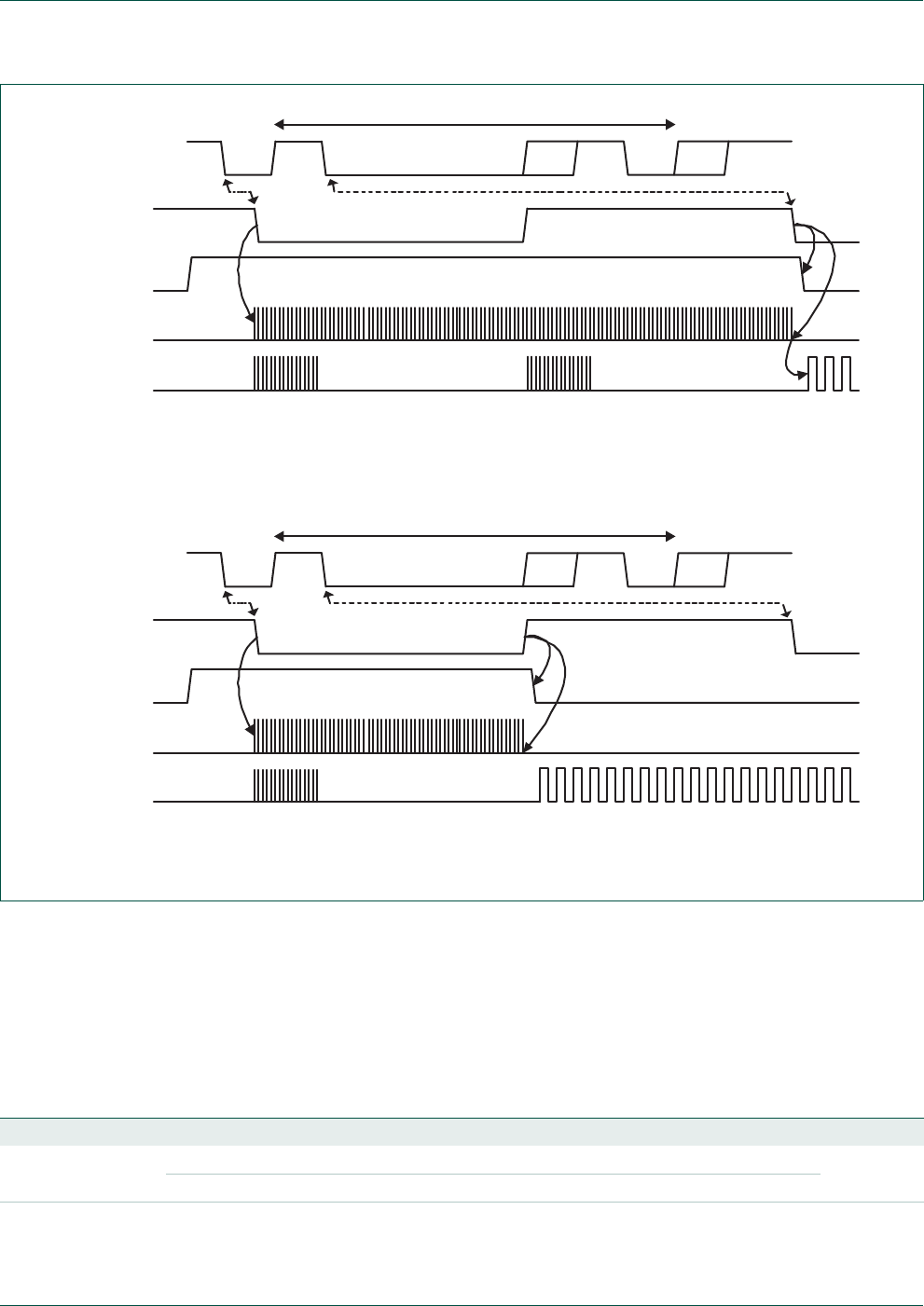
UM10360 All information provided in this document is subject to legal disclaimers. © NXP B.V. 2014. All rights reserved.
User manual Rev. 3.1 — 2 April 2014 320 of 849
NXP Semiconductors UM10360
Chapter 14: LPC176x/5x UART0/2/3
14.4.11 UARTn IrDA Control Register (U0ICR - 0x4000 C024, U2ICR - 0x4009
8024, U3ICR - 0x4009 C024)
The IrDA Control Register enables and configures the IrDA mode on each UART. The
value of UnICR should not be changed while transmitting or receiving data, or data loss or
corruption may occur.
a. Mode 0 (start bit and LSB are used for auto-baud)
b. Mode 1 (only start bit is used for auto-baud)
Fig 46. Auto-baud a) mode 0 and b) mode 1 waveform
UARTn RX
st ar t bi t LSB of 'A' or 'a'
UnACR st art
rate counter
st ar t b it 0 b i t 1 b it 2 b it 3 bi t 4 b it 5 b it 6 b it 7 parity stop
'A' (0x41) or 'a' (0x61)
16 cycles 16 cycles
16xbaud_rate
UARTn RX
st art b it LSB of 'A' or 'a'
rate counter
'A' (0x41) or 'a' (0x61)
st ar t b it 0 b i t 1 b it 2 b it 3 bi t 4 b it 5 b it 6 b it 7 parity stop
UnACR st art
16 cycles
16xbaud_rate
Table 284: UARTn IrDA Control Register (U0ICR - 0x4000 C024, U2ICR - 0x4009 8024, U3ICR - 0x4009 C024) bit
description
Bit Symbol Value Description Reset value
0IrDAEn 0 IrDA mode on UARTn is disabled, UARTn acts as a standard UART. 0
1IrDA mode on UARTn is enabled.
1IrDAInv When 1, the serial input is inverted. This has no effect on the serial output.
When 0, the serial input is not inverted.
0

UM10360 All information provided in this document is subject to legal disclaimers. © NXP B.V. 2014. All rights reserved.
User manual Rev. 3.1 — 2 April 2014 321 of 849
NXP Semiconductors UM10360
Chapter 14: LPC176x/5x UART0/2/3
The PulseDiv bits in UnICR are used to select the pulse width when the fixed pulse width
mode is used in IrDA mode (IrDAEn = 1 and FixPulseEn = 1). The value of these bits
should be set so that the resulting pulse width is at least 1.63 µs. Ta b l e 2 8 5 shows the
possible pulse widths.
14.4.12 UARTn Fractional Divider Register (U0FDR - 0x4000 C028, U2FDR -
0x4009 8028, U3FDR - 0x4009 C028)
The UART0/2/3 Fractional Divider Register (U0/2/3FDR) controls the clock pre-scaler for
the baud rate generation and can be read and written at the user’s discretion. This
pre-scaler takes the APB clock and generates an output clock according to the specified
fractional requirements.
Important: If the fractional divider is active (DIVADDVAL > 0) and DLM = 0, the value of
the DLL register must be greater than 2.
2FixPulseEn When 1, enabled IrDA fixed pulse width mode. 0
5:3 PulseDiv Configures the pulse when FixPulseEn = 1. See text below for details. 0
31:6 - NA Reserved, user software should not write ones to reserved bits. The value read
from a reserved bit is not defined.
0
Table 284: UARTn IrDA Control Register (U0ICR - 0x4000 C024, U2ICR - 0x4009 8024, U3ICR - 0x4009 C024) bit
description …continued
Bit Symbol Value Description Reset value
Table 285: IrDA Pulse Width
FixPulseEn PulseDiv IrDA Transmitter Pulse width (µs)
0 x 3 / (16 baud rate)
102
TPCLK
114 TPCLK
128 TPCLK
1 3 16 TPCLK
1 4 32 TPCLK
1 5 64 TPCLK
1 6 128 TPCLK
1 7 256 TPCLK
Table 286: UARTn Fractional Divider Register (U0FDR - address 0x4000 C028, U2FDR - 0x4009 8028, U3FDR -
0x4009 C028) bit description
Bit Function Value Description Reset value
3:0 DIVADDVAL 0 Baud-rate generation pre-scaler divisor value. If this field is 0, fractional
baud-rate generator will not impact the UARTn baudrate.
0
7:4 MULVAL 1 Baud-rate pre-scaler multiplier value. This field must be greater or equal 1 for
UARTn to operate properly, regardless of whether the fractional baud-rate
generator is used or not.
1
31:8 - NA Reserved, user software should not write ones to reserved bits. The value read
from a reserved bit is not defined.
0

UM10360 All information provided in this document is subject to legal disclaimers. © NXP B.V. 2014. All rights reserved.
User manual Rev. 3.1 — 2 April 2014 322 of 849
NXP Semiconductors UM10360
Chapter 14: LPC176x/5x UART0/2/3
This register controls the clock pre-scaler for the baud rate generation. The reset value of
the register keeps the fractional capabilities of UART0/2/3 disabled making sure that
UART0/2/3 is fully software and hardware compatible with UARTs not equipped with this
feature.
UART0/2/3 baud rate can be calculated as (n = 0/2/3):
(4)
Where PCLK is the peripheral clock, U0/2/3DLM and U0/2/3DLL are the standard
UART0/2/3 baud rate divider registers, and DIVADDVAL and MULVAL are UART0/2/3
fractional baud rate generator specific parameters.
The value of MULVAL and DIVADDVAL should comply to the following conditions:
1. 1 MULVAL 15
2. 0 DIVADDVAL 14
3. DIVADDVAL < MULVAL
The value of the U0/2/3FDR should not be modified while transmitting/receiving data or
data may be lost or corrupted.
If the U0/2/3FDR register value does not comply to these two requests, then the fractional
divider output is undefined. If DIVADDVAL is zero then the fractional divider is disabled,
and the clock will not be divided.
14.4.12.1 Baud rate calculation
UARTn can operate with or without using the Fractional Divider. In real-life applications it
is likely that the desired baud rate can be achieved using several different Fractional
Divider settings. The following algorithm illustrates one way of finding a set of DLM, DLL,
MULVAL, and DIVADDVAL values. Such set of parameters yields a baud rate with a
relative error of less than 1.1% from the desired one.
UARTnbaudrate
PCLK
16 256 UnDLMUnDLL+1DivAddVal
MulVal
-----------------------------
+
----------------------------------------------------------------------------------------------------------------------------------
=
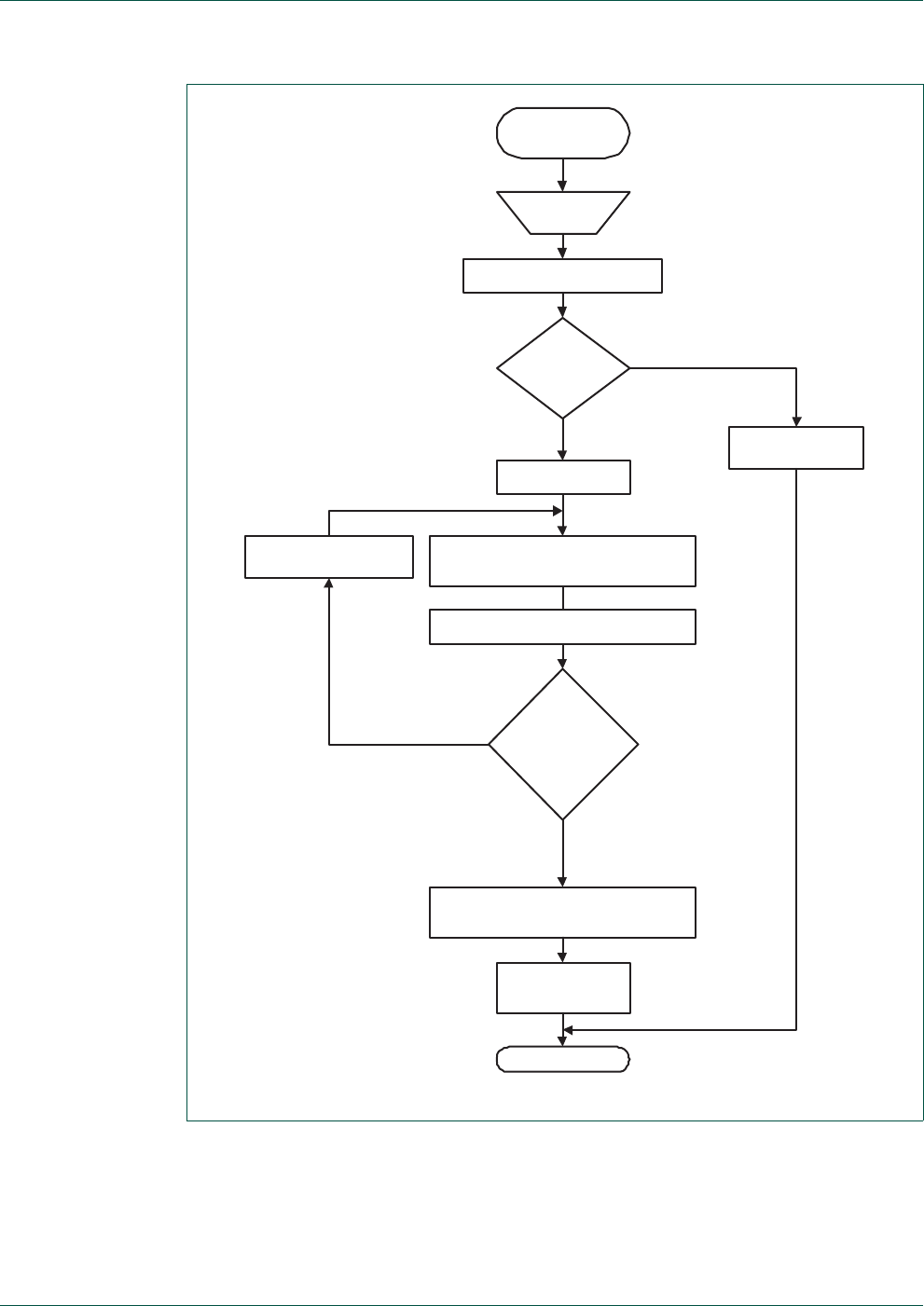
UM10360 All information provided in this document is subject to legal disclaimers. © NXP B.V. 2014. All rights reserved.
User manual Rev. 3.1 — 2 April 2014 323 of 849
NXP Semiconductors UM10360
Chapter 14: LPC176x/5x UART0/2/3
Fig 47. Algorithm for setting UART dividers
PCLK,
BR
Calculating UART
baudrate (BR)
DL est = PCLK/(16 x BR)
DLest is an
integer?
DIVADDVAL = 0
MULVAL = 1
True
FR est
= 1.5
DL est = Int(PCLK/(16 x BR x FR est))
1.1 < FR est < 1.9?
Pick another FR est from
the range [1.1, 1.9]
FRest = PCLK/(16 x BR x DL est)
DIVADDVAL = table(FR est )
MULVAL = table(FR est )
DLM = DLest [15:8]
DLL = DLest [7:0]
End
False
True
False

UM10360 All information provided in this document is subject to legal disclaimers. © NXP B.V. 2014. All rights reserved.
User manual Rev. 3.1 — 2 April 2014 324 of 849
NXP Semiconductors UM10360
Chapter 14: LPC176x/5x UART0/2/3
14.4.12.1.1 Example 1: PCLK = 14.7456 MHz, BR = 9600
According to the provided algorithm DLest = PCLK/(16 x BR) = 14.7456 MHz / (16 x 9600)
= 96. Since this DLest is an integer number, DIVADDVAL = 0, MULVAL = 1, DLM = 0, and
DLL = 96.
14.4.12.1.2 Example 2: PCLK = 12 MHz, BR = 115200
According to the provided algorithm DLest = PCLK/(16 x BR) = 12 MHz / (16 x 115200) =
6.51. This DLest is not an integer number and the next step is to estimate the FR
parameter. Using an initial estimate of FRest = 1.5 a new DL
est =4 is calculated and FR
est
is recalculated as FRest = 1.628. Since FRest = 1.628 is within the specified range of 1.1
and 1.9, DIVADDVAL and MULVAL values can be obtained from the attached look-up
table.
The closest value for FRest = 1.628 in the look-up Ta bl e 2 8 7 is FR = 1.625. It is
equivalent to DIVADDVAL = 5 and MULVAL = 8.
Based on these findings, the suggested UART setup would be: DLM = 0, DLL = 4,
DIVADDVAL = 5, and MULVAL = 8. According to Equation 4 the UART rate is 115384.
This rate has a relative error of 0.16% from the originally specified 115200.
14.4.13 UARTn Transmit Enable Register (U0TER - 0x4000 C030, U2TER -
0x4009 8030, U3TER - 0x4009 C030)
The UnTER register enables implementation of software flow control. When TXEn=1,
UARTn transmitter will keep sending data as long as they are available. As soon as TXEn
becomes 0, UARTn transmission will stop.
Table 287. Fractional Divider setting look-up table
FR DivAddVal/
MulVal
FR DivAddVal/
MulVal
FR DivAddVal/
MulVal
FR DivAddVal/
MulVal
1.000 0/1 1.250 1/4 1.500 1/2 1.750 3/4
1.067 1/15 1.267 4/15 1.533 8/15 1.769 10/13
1.071 1/14 1.273 3/11 1.538 7/13 1.778 7/9
1.077 1/13 1.286 2/7 1.545 6/11 1.786 11/14
1.083 1/12 1.300 3/10 1.556 5/9 1.800 4/5
1.091 1/11 1.308 4/13 1.571 4/7 1.818 9/11
1.100 1/10 1.333 1/3 1.583 7/12 1.833 5/6
1.111 1/9 1.357 5/14 1.600 3/5 1.846 11/13
1.125 1/8 1.364 4/11 1.615 8/13 1.857 6/7
1.133 2/15 1.375 3/8 1.625 5/8 1.867 13/15
1.143 1/7 1.385 5/13 1.636 7/11 1.875 7/8
1.154 2/13 1.400 2/5 1.643 9/14 1.889 8/9
1.167 1/6 1.417 5/12 1.667 2/3 1.900 9/10
1.182 2/11 1.429 3/7 1.692 9/13 1.909 10/11
1.200 1/5 1.444 4/9 1.700 7/10 1.917 11/12
1.214 3/14 1.455 5/11 1.714 5/7 1.923 12/13
1.222 2/9 1.462 6/13 1.727 8/11 1.929 13/14
1.231 3/13 1.467 7/15 1.733 11/15 1.933 14/15

UM10360 All information provided in this document is subject to legal disclaimers. © NXP B.V. 2014. All rights reserved.
User manual Rev. 3.1 — 2 April 2014 325 of 849
NXP Semiconductors UM10360
Chapter 14: LPC176x/5x UART0/2/3
Tab l e 2 88 describes how to use TXEn bit in order to achieve software flow control.
14.5 Architecture
The architecture of the UARTs 0, 2 and 3 are shown below in the block diagram.
The APB interface provides a communications link between the CPU or host and the
UART.
The UARTn receiver block, UnRX, monitors the serial input line, RXDn, for valid input.
The UARTn RX Shift Register (UnRSR) accepts valid characters via RXDn. After a valid
character is assembled in the UnRSR, it is passed to the UARTn RX Buffer Register FIFO
to await access by the CPU or host via the generic host interface.
The UARTn transmitter block, UnTX, accepts data written by the CPU or host and buffers
the data in the UARTn TX Holding Register FIFO (UnTHR). The UARTn TX Shift Register
(UnTSR) reads the data stored in the UnTHR and assembles the data to transmit via the
serial output pin, TXDn.
The UARTn Baud Rate Generator block, UnBRG, generates the timing enables used by
the UARTn TX block. The UnBRG clock input source is the APB clock (PCLK). The main
clock is divided down per the divisor specified in the UnDLL and UnDLM registers. This
divided down clock is the 16x oversample clock.
The interrupt interface contains registers UnIER and UnIIR. The interrupt interface
receives several one clock wide enables from the UnTX and UnRX blocks.
Status information from the UnTX and UnRX is stored in the UnLSR. Control information
for the UnTX and UnRX is stored in the UnLCR.
Table 288: UARTn Transmit Enable Register (U0TER - address 0x4000 C030, U2TER - 0x4009 8030, U3TER -
0x4009 C030) bit description
Bit Symbol Description Reset Value
6:0 - Reserved, user software should not write ones to reserved bits. The value read from a
reserved bit is not defined.
NA
7TXENWhen this bit is 1, as it is after a Reset, data written to the THR is output on the TXD pin as
soon as any preceding data has been sent. If this bit is cleared to 0 while a character is
being sent, the transmission of that character is completed, but no further characters are
sent until this bit is set again. In other words, a 0 in this bit blocks the transfer of characters
from the THR or TX FIFO into the transmit shift register. Software implementing
software-handshaking can clear this bit when it receives an XOFF character (DC3). Software
can set this bit again when it receives an XON (DC1) character.
1
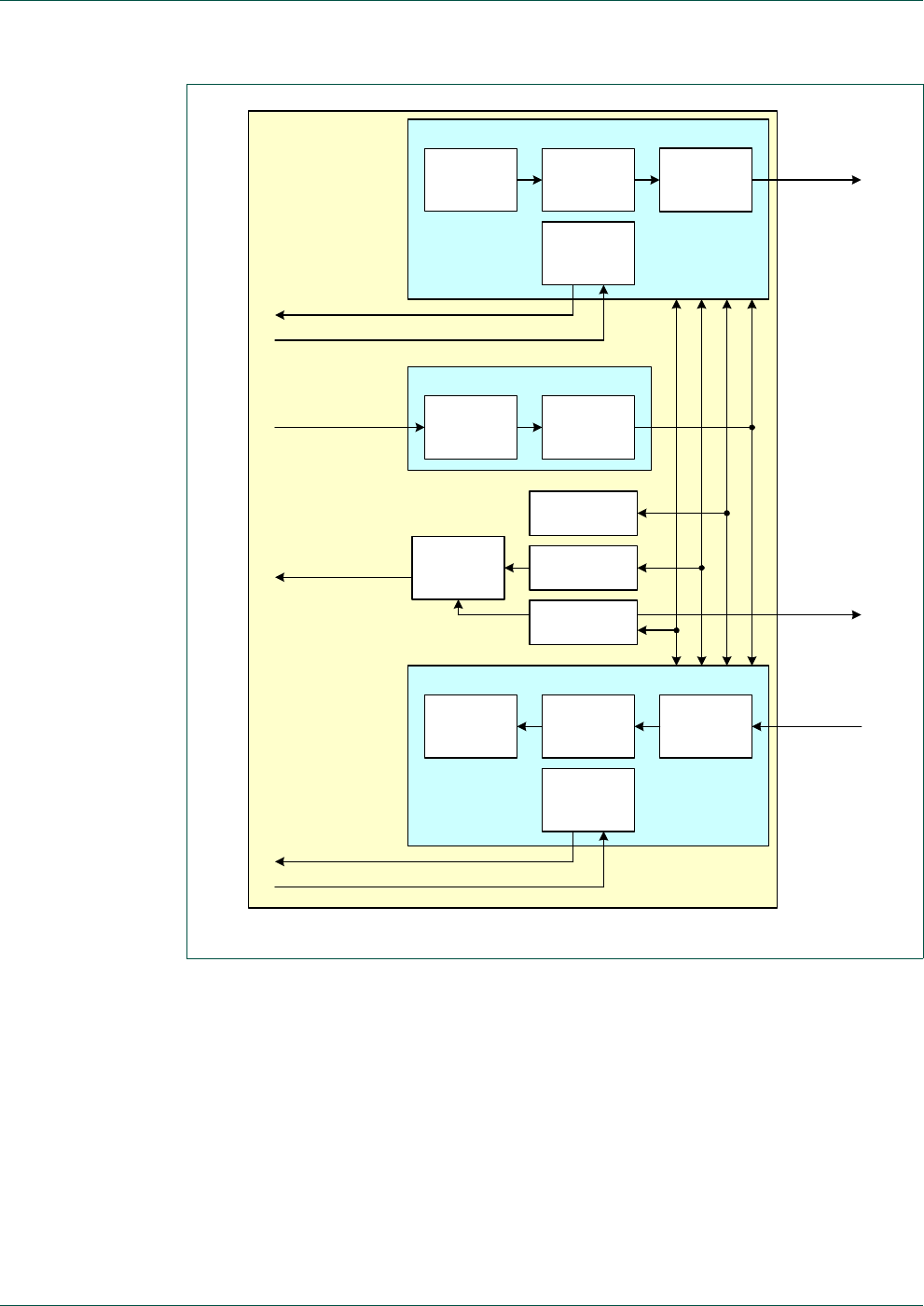
UM10360 All information provided in this document is subject to legal disclaimers. © NXP B.V. 2014. All rights reserved.
User manual Rev. 3.1 — 2 April 2014 326 of 849
NXP Semiconductors UM10360
Chapter 14: LPC176x/5x UART0/2/3
Fig 48. UART0, 2 and 3 block diagram
Transmitter
Shift
Register
Transmitter
Holding
Register
Transmitter
FIFO
Transmitter
Receiver
Shift
Register
Receiver
Buffer
Register
Receiver
FIFO
Receiver
TX_DMA_REQ
TX_DMA_CLR
RX_DMA_REQ
RX_DMA_CLR
Baud Rate Generator
Fractional
Rate
Divider
Main
Divider
(DLM, DLL)
Transmitter
DMA
Interface
Receiver
DMA
Interface
PCLK
Line Control
& Status
FIFO Control
& Status
Un_TXD
Un_RXD
Un_OE
IrDA, & Auto-
baud
UARTn interrupt
Interrupt
Control &
Status

UM10360 All information provided in this document is subject to legal disclaimers. © NXP B.V. 2014. All rights reserved.
User manual Rev. 3.1 — 2 April 2014 327 of 849
15.1 Basic configuration
The UART1 peripheral is configured using the following registers:
1. Power: In the PCONP register (Ta b le 46 ), set bits PCUART1.
Remark: On reset, UART1 is enabled (PCUART1 = 1).
2. Peripheral clock: In the PCLKSEL0 register (Ta b l e 4 0 ), select PCLK_UART1.
3. Baud rate: In register U1LCR (Ta b l e 2 9 9 ), set bit DLAB =1. This enables access to
registers DLL (Tab l e 29 3 ) and DLM (Table 2 9 4) for setting the baud rate. Also, if
needed, set the fractional baud rate in the fractional divider register (Ta b l e 3 0 6 ).
4. UART FIFO: Use bit FIFO enable (bit 0) in register U0FCR (Table 29 8) to enable
FIFO.
5. Pins: Select UART pins through PINSEL registers and pin modes through the
PINMODE registers (Section 8.5).
Remark: UART receive pins should not have pull-down resistors enabled.
6. Interrupts: To enable UART interrupts set bit DLAB =0 in register U1LCR (Ta b l e 2 99 ).
This enables access to U1IER (Ta ble 2 9 5). Interrupts are enabled in the NVIC using
the appropriate Interrupt Set Enable register.
7. DMA: UART1 transmit and receive functions can operated with the GPDMA controller
(see Ta b le 5 4 4).
15.2 Features
•Full modem control handshaking available
•Data sizes of 5, 6, 7, and 8 bits.
•Parity generation and checking: odd, even mark, space or none.
•One or two stop bits.
•16 byte Receive and Transmit FIFOs.
•Built-in baud rate generator, including a fractional rate divider for great versatility.
•Supports DMA for both transmit and receive.
•Auto-baud capability
•Break generation and detection.
•Multiprocessor addressing mode.
•RS-485 support.
UM10360
Chapter 15: LPC176x/5x UART1
Rev. 3.1 — 2 April 2014 User manual

UM10360 All information provided in this document is subject to legal disclaimers. © NXP B.V. 2014. All rights reserved.
User manual Rev. 3.1 — 2 April 2014 328 of 849
NXP Semiconductors UM10360
Chapter 15: LPC176x/5x UART1
15.3 Pin description
Table 289: UART1 Pin Description
Pin Type Description
RXD1 Input Serial Input. Serial receive data.
TXD1 Output Serial Output. Serial transmit data.
CTS1 Input Clear To Send. Active low signal indicates if the external modem is ready to accept transmitted data via
TXD1 from the UART1. In normal operation of the modem interface (U1MCR[4] = 0), the complement value
of this signal is stored in U1MSR[4]. State change information is stored in U1MSR[0] and is a source for a
priority level 4 interrupt, if enabled (U1IER[3] = 1).
Clear to send. CTS1 is an asynchronous, active low modem status signal. Its condition can be checked by
reading bit 4 (CTS) of the modem status register. Bit 0 (DCTS) of the Modem Status Register (MSR)
indicates that CTS1 has changed states since the last read from the MSR. If the modem status interrupt is
enabled when CTS1 changes levels and the auto-cts mode is not enabled, an interrupt is generated. CTS1
is also used in the auto-cts mode to control the transmitter.
DCD1 Input Data Carrier Detect. Active low signal indicates if the external modem has established a communication
link with the UART1 and data may be exchanged. In normal operation of the modem interface
(U1MCR[4]=0), the complement value of this signal is stored in U1MSR[7]. State change information is
stored in U1MSR3 and is a source for a priority level 4 interrupt, if enabled (U1IER[3] = 1).
DSR1 Input Data Set Ready. Active low signal indicates if the external modem is ready to establish a communications
link with the UART1. In normal operation of the modem interface (U1MCR[4] = 0), the complement value of
this signal is stored in U1MSR[5]. State change information is stored in U1MSR[1] and is a source for a
priority level 4 interrupt, if enabled (U1IER[3] = 1).
DTR1 Output Data Terminal Ready. Active low signal indicates that the UART1 is ready to establish connection with
external modem. The complement value of this signal is stored in U1MCR[0].
The DTR pin can also be used as an RS-485/EIA-485 output enable signal.
RI1 Input Ring Indicator. Active low signal indicates that a telephone ringing signal has been detected by the
modem. In normal operation of the modem interface (U1MCR[4] = 0), the complement value of this signal is
stored in U1MSR[6]. State change information is stored in U1MSR[2] and is a source for a priority level 4
interrupt, if enabled (U1IER[3] = 1).
RTS1 Output Request To Send. Active low signal indicates that the UART1 would like to transmit data to the external
modem. The complement value of this signal is stored in U1MCR[1].
In auto-rts mode, RTS1 is used to control the transmitter FIFO threshold logic.
Request to send. RTS1 is an active low signal informing the modem or data set that the UART is ready to
receive data. RTS1 is set to the active (low) level by setting the RTS modem control register bit and is set to
the inactive (high) level either as a result of a system reset or during loop-back mode operations or by
clearing bit 1 (RTS) of the MCR. In the auto-rts mode, RTS1 is controlled by the transmitter FIFO threshold
logic.
The RTS pin can also be used as an RS-485/EIA-485 output enable signal.

UM10360 All information provided in this document is subject to legal disclaimers. © NXP B.V. 2014. All rights reserved.
User manual Rev. 3.1 — 2 April 2014 329 of 849
NXP Semiconductors UM10360
Chapter 15: LPC176x/5x UART1
15.4 Register description
UART1 contains registers organized as shown in Tab l e 2 90 . The Divisor Latch Access Bit
(DLAB) is contained in U1LCR[7] and enables access to the Divisor Latches.
[1] Reset Value reflects the data stored in used bits only. It does not include reserved bits content.
Table 290: UART1 register map
Name Description Access Reset
Value[1]
Address
U1RBR
(when DLAB =0)
Receiver Buffer Register. Contains the next received character to
be read.
RO NA 0x4001 0000
(when DLAB=0)
U1THR
(when DLAB =0)
Transmit Holding Register. The next character to be transmitted is
written here.
WO NA 0x4001 0000
(when DLAB=0)
U1DLL
(when DLAB =1)
Divisor Latch LSB. Least significant byte of the baud rate divisor
value. The full divisor is used to generate a baud rate from the
fractional rate divider.
R/W 0x01 0x4001 0000
(when DLAB=1)
U1DLM
(when DLAB =1)
Divisor Latch MSB. Most significant byte of the baud rate divisor
value. The full divisor is used to generate a baud rate from the
fractional rate divider.
R/W 0x00 0x4001 0004
(when DLAB=1)
U1IER
(when DLAB =0)
Interrupt Enable Register. Contains individual interrupt enable bits
for the 7 potential UART1 interrupts.
R/W 0x00 0x4001 0004
(when DLAB=0)
U1IIR Interrupt ID Register. Identifies which interrupt(s) are pending. RO 0x01 0x4001 0008
U1FCR FIFO Control Register. Controls UART1 FIFO usage and modes. WO 0x00 0x4001 0008
U1LCR Line Control Register. Contains controls for frame formatting and
break generation.
R/W 0x00 0x4001 000C
U1MCR Modem Control Register. Contains controls for flow control
handshaking and loopback mode.
R/W 0x00 0x4001 0010
U1LSR Line Status Register. Contains flags for transmit and receive status,
including line errors.
RO 0x60 0x4001 0014
U1MSR Modem Status Register. Contains handshake signal status flags. RO 0x00 0x4001 0018
U1SCR Scratch Pad Register. 8-bit temporary storage for software. R/W 0x00 0x4001 001C
U1ACR Auto-baud Control Register. Contains controls for the auto-baud
feature.
R/W 0x00 0x4001 0020
U1FDR Fractional Divider Register. Generates a clock input for the baud
rate divider.
R/W 0x10 0x4001 0028
U1TER Transmit Enable Register. Turns off UART transmitter for use with
software flow control.
R/W 0x80 0x4001 0030
U1RS485CTRL RS-485/EIA-485 Control. Contains controls to configure various
aspects of RS-485/EIA-485 modes.
R/W 0x00 0x4001 004C
U1ADRMATCH RS-485/EIA-485 address match. Contains the address match value
for RS-485/EIA-485 mode.
R/W 0x00 0x4001 0050
U1RS485DLY RS-485/EIA-485 direction control delay. R/W 0x00 0x4001 0054

UM10360 All information provided in this document is subject to legal disclaimers. © NXP B.V. 2014. All rights reserved.
User manual Rev. 3.1 — 2 April 2014 330 of 849
NXP Semiconductors UM10360
Chapter 15: LPC176x/5x UART1
15.4.1 UART1 Receiver Buffer Register (U1RBR - 0x4001 0000, when
DLAB = 0)
The U1RBR is the top byte of the UART1 RX FIFO. The top byte of the RX FIFO contains
the oldest character received and can be read via the bus interface. The LSB (bit 0)
represents the “oldest” received data bit. If the character received is less than 8 bits, the
unused MSBs are padded with zeroes.
The Divisor Latch Access Bit (DLAB) in U1LCR must be zero in order to access the
U1RBR. The U1RBR is always read-only.
Since PE, FE and BI bits correspond to the byte sitting on the top of the RBR FIFO (i.e.
the one that will be read in the next read from the RBR), the right approach for fetching the
valid pair of received byte and its status bits is first to read the content of the U1LSR
register, and then to read a byte from the U1RBR.
15.4.2 UART1 Transmitter Holding Register (U1THR - 0x4001 0000 when
DLAB = 0)
The write-only U1THR is the top byte of the UART1 TX FIFO. The top byte is the newest
character in the TX FIFO and can be written via the bus interface. The LSB represents the
first bit to transmit.
The Divisor Latch Access Bit (DLAB) in U1LCR must be zero in order to access the
U1THR. The U1THR is write-only.
15.4.3 UART1 Divisor Latch LSB and MSB Registers (U1DLL - 0x4001 0000
and U1DLM - 0x4001 0004, when DLAB = 1)
The UART1 Divisor Latch is part of the UART1 Baud Rate Generator and holds the value
used, along with the Fractional Divider, to divide the APB clock (PCLK) in order to produce
the baud rate clock, which must be 16x the desired baud rate. The U1DLL and U1DLM
registers together form a 16-bit divisor where U1DLL contains the lower 8 bits of the
divisor and U1DLM contains the higher 8 bits of the divisor. A 0x0000 value is treated like
a 0x0001 value as division by zero is not allowed.The Divisor Latch Access Bit (DLAB) in
U1LCR must be one in order to access the UART1 Divisor Latches. Details on how to
select the right value for U1DLL and U1DLM can be found later in this chapter, see
Section 15.4.16.
Table 291: UART1 Receiver Buffer Register (U1RBR - address 0x4001 0000 when DLAB = 0) bit description
Bit Symbol Description Reset Value
7:0 RBR The UART1 Receiver Buffer Register contains the oldest received byte in the UART1 RX
FIFO.
undefined
31:8 - Reserved, the value read from a reserved bit is not defined. NA
Table 292: UART1 Transmitter Holding Register (U1THR - address 0x4001 0000 when DLAB = 0) bit description
Bit Symbol Description Reset Value
7:0 THR Writing to the UART1 Transmit Holding Register causes the data to be stored in the UART1
transmit FIFO. The byte will be sent when it reaches the bottom of the FIFO and the
transmitter is available.
NA
31:8 - Reserved, user software should not write ones to reserved bits. NA

UM10360 All information provided in this document is subject to legal disclaimers. © NXP B.V. 2014. All rights reserved.
User manual Rev. 3.1 — 2 April 2014 331 of 849
NXP Semiconductors UM10360
Chapter 15: LPC176x/5x UART1
15.4.4 UART1 Interrupt Enable Register (U1IER - 0x4001 0004, when
DLAB = 0)
The U1IER is used to enable the four UART1 interrupt sources.
Table 293: UART1 Divisor Latch LSB Register (U1DLL - address 0x4001 0000 when DLAB = 1) bit description
Bit Symbol Description Reset Value
7:0 DLLSB The UART1 Divisor Latch LSB Register, along with the U1DLM register, determines the
baud rate of the UART1.
0x01
31:8 - Reserved, user software should not write ones to reserved bits. The value read from a
reserved bit is not defined.
NA
Table 294: UART1 Divisor Latch MSB Register (U1DLM - address 0x4001 0004 when DLAB = 1) bit description
Bit Symbol Description Reset Value
7:0 DLMSB The UART1 Divisor Latch MSB Register, along with the U1DLL register, determines the
baud rate of the UART1.
0x00
31:8 - Reserved, user software should not write ones to reserved bits. The value read from a
reserved bit is not defined.
NA
Table 295: UART1 Interrupt Enable Register (U1IER - address 0x4001 0004 when DLAB = 0) bit description
Bit Symbol Value Description Reset
Value
0RBR
Interrupt
Enable
enables the Receive Data Available interrupt for UART1. It also controls the Character
Receive Time-out interrupt.
0
0Disable the RDA interrupts.
1Enable the RDA interrupts.
1THRE
Interrupt
Enable
enables the THRE interrupt for UART1. The status of this interrupt can be read from
U1LSR[5].
0
0Disable the THRE interrupts.
1Enable the THRE interrupts.
2RX Line
Interrupt
Enable
enables the UART1 RX line status interrupts. The status of this interrupt can be read
from U1LSR[4:1].
0
0Disable the RX line status interrupts.
1Enable the RX line status interrupts.
3Modem
Status
Interrupt
Enable
enables the modem interrupt. The status of this interrupt can be read from U1MSR[3:0]. 0
0Disable the modem interrupt.
1Enable the modem interrupt.
6:4 - Reserved, user software should not write ones to reserved bits. The value read from a
reserved bit is not defined.
NA
7CTS
Interrupt
Enable
If auto-cts mode is enabled this bit enables/disables the modem status interrupt
generation on a CTS1 signal transition. If auto-cts mode is disabled a CTS1 transition
will generate an interrupt if Modem Status Interrupt Enable (U1IER[3]) is set.
In normal operation a CTS1 signal transition will generate a Modem Status Interrupt
unless the interrupt has been disabled by clearing the U1IER[3] bit in the U1IER
register. In auto-cts mode a transition on the CTS1 bit will trigger an interrupt only if both
the U1IER[3] and U1IER[7] bits are set.
0
0Disable the CTS interrupt.
1Enable the CTS interrupt.

UM10360 All information provided in this document is subject to legal disclaimers. © NXP B.V. 2014. All rights reserved.
User manual Rev. 3.1 — 2 April 2014 332 of 849
NXP Semiconductors UM10360
Chapter 15: LPC176x/5x UART1
15.4.5 UART1 Interrupt Identification Register (U1IIR - 0x4001 0008)
The U1IIR provides a status code that denotes the priority and source of a pending
interrupt. The interrupts are frozen during an U1IIR access. If an interrupt occurs during
an U1IIR access, the interrupt is recorded for the next U1IIR access.
Bit U1IIR[9:8] are set by the auto-baud function and signal a time-out or end of auto-baud
condition. The auto-baud interrupt conditions are cleared by setting the corresponding
Clear bits in the Auto-baud Control Register.
If the IntStatus bit is 1 no interrupt is pending and the IntId bits will be zero. If the IntStatus
is 0, a non auto-baud interrupt is pending in which case the IntId bits identify the type of
interrupt and handling as described in Tabl e 2 97 . Given the status of U1IIR[3:0], an
8ABEOIntEn Enables the end of auto-baud interrupt. 0
0Disable end of auto-baud Interrupt.
1Enable end of auto-baud Interrupt.
9ABTOIntEn Enables the auto-baud time-out interrupt. 0
0Disable auto-baud time-out Interrupt.
1Enable auto-baud time-out Interrupt.
31:10 - Reserved, user software should not write ones to reserved bits. The value read from a
reserved bit is not defined.
NA
Table 295: UART1 Interrupt Enable Register (U1IER - address 0x4001 0004 when DLAB = 0) bit description …continued
Bit Symbol Value Description Reset
Value
Table 296: UART1 Interrupt Identification Register (U1IIR - address 0x4001 0008) bit description
Bit Symbol Value Description Reset
Value
0IntStatus Interrupt status. Note that U1IIR[0] is active low. The pending interrupt can be
determined by evaluating U1IIR[3:1].
1
0At least one interrupt is pending.
1No interrupt is pending.
3:1 IntId Interrupt identification. U1IER[3:1] identifies an interrupt corresponding to the UART1
Rx or TX FIFO. All other combinations of U1IER[3:1] not listed below are reserved
(100,101,111).
0
011 1 - Receive Line Status (RLS).
010 2a - Receive Data Available (RDA).
110 2b - Character Time-out Indicator (CTI).
001 3 - THRE Interrupt.
000 4 - Modem Interrupt.
5:4 - Reserved, user software should not write ones to reserved bits. The value read from a
reserved bit is not defined.
NA
7:6 FIFO Enable Copies of U1FCR[0]. 0
8ABEOInt End of auto-baud interrupt. True if auto-baud has finished successfully and interrupt is
enabled.
0
9ABTOInt Auto-baud time-out interrupt. True if auto-baud has timed out and interrupt is enabled. 0
31:10 - Reserved, the value read from a reserved bit is not defined. NA
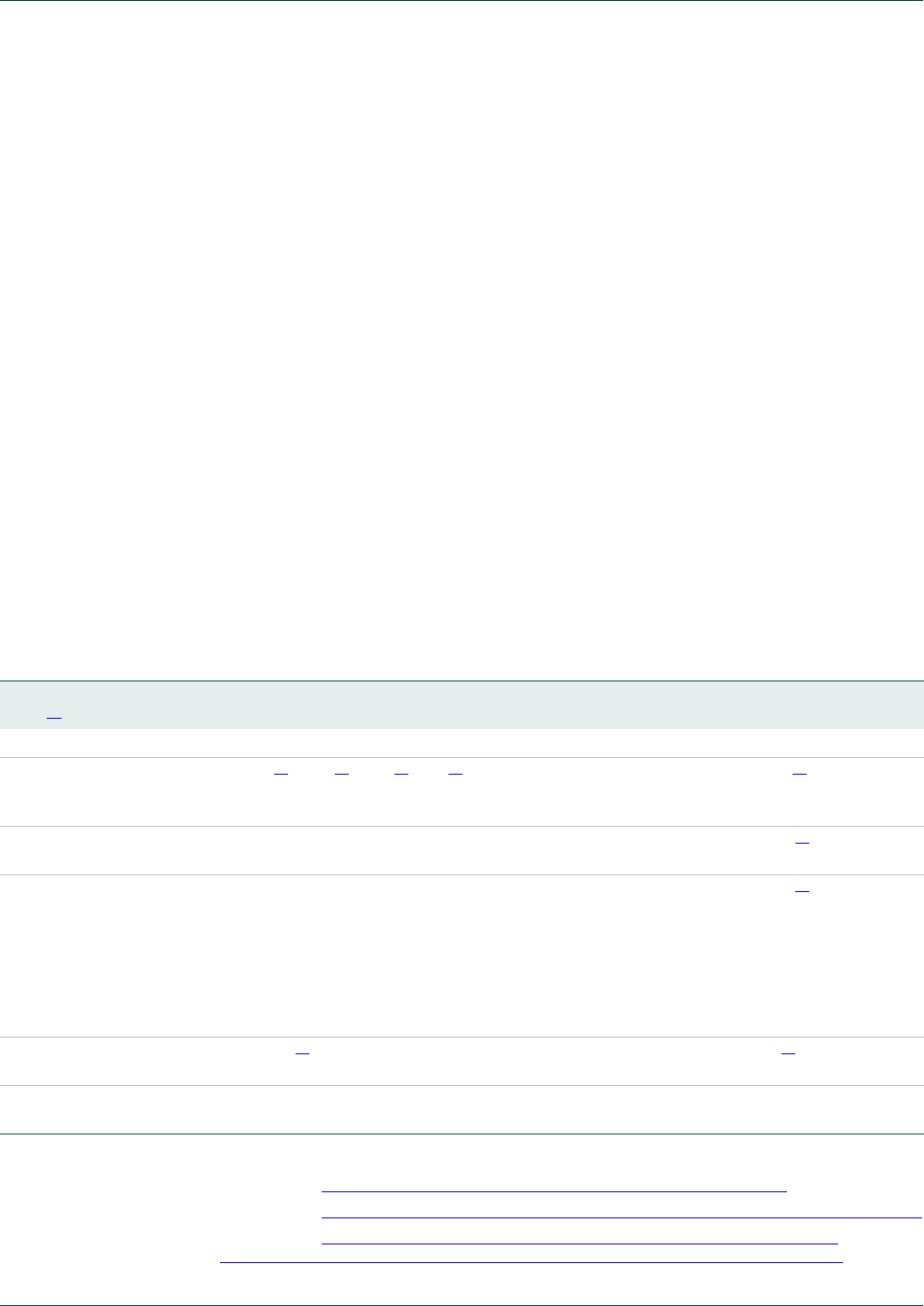
UM10360 All information provided in this document is subject to legal disclaimers. © NXP B.V. 2014. All rights reserved.
User manual Rev. 3.1 — 2 April 2014 333 of 849
NXP Semiconductors UM10360
Chapter 15: LPC176x/5x UART1
interrupt handler routine can determine the cause of the interrupt and how to clear the
active interrupt. The U1IIR must be read in order to clear the interrupt prior to exiting the
Interrupt Service Routine.
The UART1 RLS interrupt (U1IIR[3:1] = 011) is the highest priority interrupt and is set
whenever any one of four error conditions occur on the UART1RX input: overrun error
(OE), parity error (PE), framing error (FE) and break interrupt (BI). The UART1 Rx error
condition that set the interrupt can be observed via U1LSR[4:1]. The interrupt is cleared
upon an U1LSR read.
The UART1 RDA interrupt (U1IIR[3:1] = 010) shares the second level priority with the CTI
interrupt (U1IIR[3:1] = 110). The RDA is activated when the UART1 Rx FIFO reaches the
trigger level defined in U1FCR7:6 and is reset when the UART1 Rx FIFO depth falls below
the trigger level. When the RDA interrupt goes active, the CPU can read a block of data
defined by the trigger level.
The CTI interrupt (U1IIR[3:1] = 110) is a second level interrupt and is set when the UART1
Rx FIFO contains at least one character and no UART1 Rx FIFO activity has occurred in
3.5 to 4.5 character times. Any UART1 Rx FIFO activity (read or write of UART1 RSR) will
clear the interrupt. This interrupt is intended to flush the UART1 RBR after a message has
been received that is not a multiple of the trigger level size. For example, if a peripheral
wished to send a 105 character message and the trigger level was 10 characters, the
CPU would receive 10 RDA interrupts resulting in the transfer of 100 characters and 1 to 5
CTI interrupts (depending on the service routine) resulting in the transfer of the remaining
5 characters.
[1] Values "0000", “0011”, “0101”, “0111”, “1000”, “1001”, “1010”, “1011”,”1101”,”1110”,”1111” are reserved.
[2] For details see Section 15.4.10 “UART1 Line Status Register (U1LSR - 0x4001 0014)”
[3] For details see Section 15.4.1 “UART1 Receiver Buffer Register (U1RBR - 0x4001 0000, when DLAB = 0)”
[4] For details see Section 15.4.5 “UART1 Interrupt Identification Register (U1IIR - 0x4001 0008)” and
Section 15.4.2 “UART1 Transmitter Holding Register (U1THR - 0x4001 0000 when DLAB = 0)”
Table 297: UART1 Interrupt Handling
U1IIR[3:0]
value[1]
Priority Interrupt
Type
Interrupt Source Interrupt Reset
0001 - None None -
0110 Highest RX Line
Status /
Error
OE[2] or PE[2] or FE[2] or BI[2] U1LSR Read[2]
0100 Second RX Data
Available
Rx data available or trigger level reached in FIFO
(U1FCR0=1)
U1RBR Read[3] or UART1
FIFO drops below trigger level
1100 Second Character
Time-out
indication
Minimum of one character in the RX FIFO and no
character input or removed during a time period depending
on how many characters are in FIFO and what the trigger
level is set at (3.5 to 4.5 character times).
The exact time will be:
[(word length) 7 - 2] 8 + [(trigger level - number of
characters) 8 + 1] RCLKs
U1RBR Read[3]
0010 Third THRE THRE[2] U1IIR Read[4] (if source of
interrupt) or THR write
0000 Fourth Modem
Status
CTS or DSR or RI or DCD MSR Read

UM10360 All information provided in this document is subject to legal disclaimers. © NXP B.V. 2014. All rights reserved.
User manual Rev. 3.1 — 2 April 2014 334 of 849
NXP Semiconductors UM10360
Chapter 15: LPC176x/5x UART1
The UART1 THRE interrupt (U1IIR[3:1] = 001) is a third level interrupt and is activated
when the UART1 THR FIFO is empty provided certain initialization conditions have been
met. These initialization conditions are intended to give the UART1 THR FIFO a chance to
fill up with data to eliminate many THRE interrupts from occurring at system start-up. The
initialization conditions implement a one character delay minus the stop bit whenever
THRE = 1 and there have not been at least two characters in the U1THR at one time
since the last THRE = 1 event. This delay is provided to give the CPU time to write data to
U1THR without a THRE interrupt to decode and service. A THRE interrupt is set
immediately if the UART1 THR FIFO has held two or more characters at one time and
currently, the U1THR is empty. The THRE interrupt is reset when a U1THR write occurs or
a read of the U1IIR occurs and the THRE is the highest interrupt (U1IIR[3:1] = 001).
It is the lowest priority interrupt and is activated whenever there is any state change on
modem inputs pins, DCD, DSR or CTS. In addition, a low to high transition on modem
input RI will generate a modem interrupt. The source of the modem interrupt can be
determined by examining U1MSR[3:0]. A U1MSR read will clear the modem interrupt.
15.4.6 UART1 FIFO Control Register (U1FCR - 0x4001 0008)
The write-only U1FCR controls the operation of the UART1 RX and TX FIFOs.
15.4.6.1 DMA Operation
The user can optionally operate the UART transmit and/or receive using DMA. The DMA
mode is determined by the DMA Mode Select bit in the FCR register. This bit only has an
affect when the FIFOs are enabled via the FIFO Enable bit in the FCR register.
Table 298: UART1 FIFO Control Register (U1FCR - address 0x4001 0008) bit description
Bit Symbol Value Description Reset Value
0FIFO Enable0UART1 FIFOs are disabled. Must not be used in the application. 0
1Active high enable for both UART1 Rx and TX FIFOs and U1FCR[7:1] access.
This bit must be set for proper UART1 operation. Any transition on this bit will
automatically clear the UART1 FIFOs.
1RX FIFO
Reset
0No impact on either of UART1 FIFOs. 0
1Writing a logic 1 to U1FCR[1] will clear all bytes in UART1 Rx FIFO, reset the
pointer logic. This bit is self-clearing.
2TX FIFO
Reset
0No impact on either of UART1 FIFOs. 0
1Writing a logic 1 to U1FCR[2] will clear all bytes in UART1 TX FIFO, reset the
pointer logic. This bit is self-clearing.
3DMA Mode
Select
When the FIFO enable bit (bit 0 of this register) is set, this bit selects the DMA
mode. See Section 15.4.6.1.
0
5:4 - Reserved, user software should not write ones to reserved bits. The value read
from a reserved bit is not defined.
NA
7:6 RX Trigger
Level
These two bits determine how many receiver UART1 FIFO characters must be
written before an interrupt is activated.
0
00 Trigger level 0 (1 character or 0x01).
01 Trigger level 1 (4 characters or 0x04).
10 Trigger level 2 (8 characters or 0x08).
11 Trigger level 3 (14 characters or 0x0E).
31:8 - Reserved, user software should not write ones to reserved bits. NA

UM10360 All information provided in this document is subject to legal disclaimers. © NXP B.V. 2014. All rights reserved.
User manual Rev. 3.1 — 2 April 2014 335 of 849
NXP Semiconductors UM10360
Chapter 15: LPC176x/5x UART1
UART receiver DMA
In DMA mode, the receiver DMA request is asserted on the event of the receiver FIFO
level becoming equal to or greater than trigger level, or if a character time-out occurs. See
the description of the RX Trigger Level above. The receiver DMA request is cleared by the
DMA controller.
UART transmitter DMA
In DMA mode, the transmitter DMA request is asserted on the event of the transmitter
FIFO transitioning to not full. The transmitter DMA request is cleared by the DMA
controller.
15.4.7 UART1 Line Control Register (U1LCR - 0x4001 000C)
The U1LCR determines the format of the data character that is to be transmitted or
received.
15.4.8 UART1 Modem Control Register (U1MCR - 0x4001 0010)
The U1MCR enables the modem loopback mode and controls the modem output signals.
Table 299: UART1 Line Control Register (U1LCR - address 0x4001 000C) bit description
Bit Symbol Value Description Reset Value
1:0 Word Length
Select
00 5-bit character length. 0
01 6-bit character length.
10 7-bit character length.
11 8-bit character length.
2Stop Bit Select0 1 stop bit. 0
12 stop bits (1.5 if U1LCR[1:0]=00).
3Parity Enable 0 Disable parity generation and checking. 0
1Enable parity generation and checking.
5:4 Parity Select 00 Odd parity. Number of 1s in the transmitted character and the attached
parity bit will be odd.
0
01 Even Parity. Number of 1s in the transmitted character and the attached
parity bit will be even.
10 Forced "1" stick parity.
11 Forced "0" stick parity.
6Break Control 0 Disable break transmission. 0
1Enable break transmission. Output pin UART1 TXD is forced to logic 0
when U1LCR[6] is active high.
7Divisor Latch
Access Bit (DLAB)
0Disable access to Divisor Latches. 0
1Enable access to Divisor Latches.
31:8 - Reserved, user software should not write ones to reserved bits. The value
read from a reserved bit is not defined.
NA

UM10360 All information provided in this document is subject to legal disclaimers. © NXP B.V. 2014. All rights reserved.
User manual Rev. 3.1 — 2 April 2014 336 of 849
NXP Semiconductors UM10360
Chapter 15: LPC176x/5x UART1
15.4.9 Auto-flow control
If auto-RTS mode is enabled the UART1‘s receiver FIFO hardware controls the RTS1
output of the UART1. If the auto-CTS mode is enabled the UART1‘s U1TSR hardware will
only start transmitting if the CTS1 input signal is asserted.
15.4.9.1 Auto-RTS
The auto-RTS function is enabled by setting the RTSen bit. Auto-RTS data flow control
originates in the U1RBR module and is linked to the programmed receiver FIFO trigger
level. If auto-RTS is enabled, the data-flow is controlled as follows:
When the receiver FIFO level reaches the programmed trigger level, RTS1 is de-asserted
(to a high value). It is possible that the sending UART sends an additional byte after the
trigger level is reached (assuming the sending UART has another byte to send) because it
might not recognize the de-assertion of RTS1 until after it has begun sending the
additional byte. RTS1 is automatically reasserted (to a low value) once the receiver FIFO
has reached the previous trigger level. The re-assertion of RTS1 signals to the sending
UART to continue transmitting data.
Table 300: UART1 Modem Control Register (U1MCR - address 0x4001 0010) bit description
Bit Symbol Value Description Reset
value
0DTR Control Source for modem output pin, DTR. This bit reads as 0 when modem loopback mode
is active.
0
1RTS Control Source for modem output pin RTS. This bit reads as 0 when modem loopback mode is
active.
0
3-2 - NA Reserved, user software should not write ones to reserved bits. The value read from a
reserved bit is not defined.
0
4Loopback
Mode Select
The modem loopback mode provides a mechanism to perform diagnostic loopback
testing. Serial data from the transmitter is connected internally to serial input of the
receiver. Input pin, RXD1, has no effect on loopback and output pin, TXD1 is held in
marking state. The 4 modem inputs (CTS, DSR, RI and DCD) are disconnected
externally. Externally, the modem outputs (RTS, DTR) are set inactive. Internally, the 4
modem outputs are connected to the 4 modem inputs. As a result of these
connections, the upper 4 bits of the U1MSR will be driven by the lower 4 bits of the
U1MCR rather than the 4 modem inputs in normal mode. This permits modem status
interrupts to be generated in loopback mode by writing the lower 4 bits of U1MCR.
0
0Disable modem loopback mode.
1Enable modem loopback mode.
5- NAReserved, user software should not write ones to reserved bits. The value read from a
reserved bit is not defined.
0
6RTSen 0 Disable auto-rts flow control. 0
1Enable auto-rts flow control.
7CTSen 0 Disable auto-cts flow control. 0
1Enable auto-cts flow control.
31:8 - Reserved, user software should not write ones to reserved bits. The value read from a
reserved bit is not defined.
NA
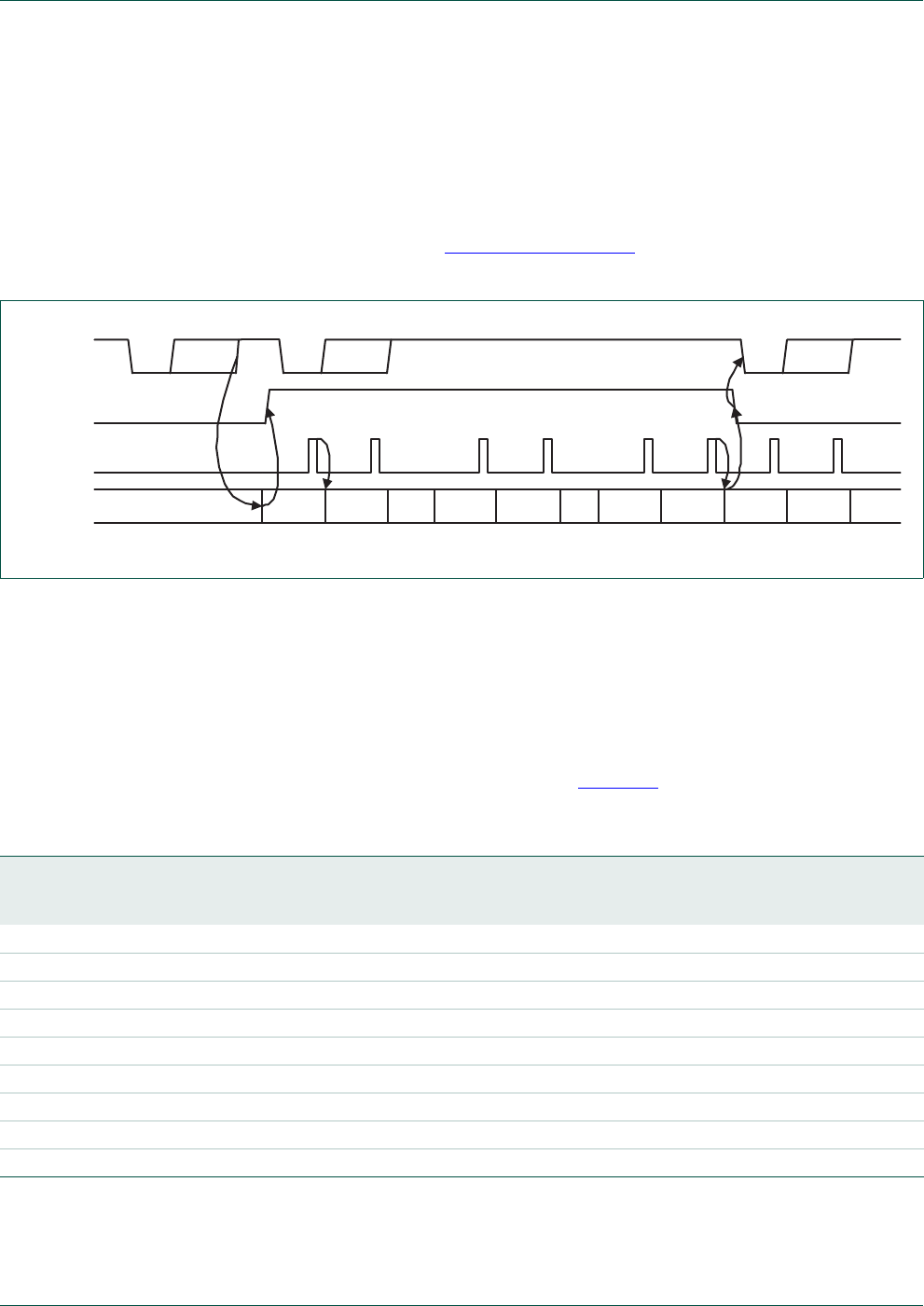
UM10360 All information provided in this document is subject to legal disclaimers. © NXP B.V. 2014. All rights reserved.
User manual Rev. 3.1 — 2 April 2014 337 of 849
NXP Semiconductors UM10360
Chapter 15: LPC176x/5x UART1
If Auto-RTS mode is disabled, the RTSen bit controls the RTS1 output of the UART1. If
Auto-RTS mode is enabled, hardware controls the RTS1 output, and the actual value of
RTS1 will be copied in the RTS Control bit of the UART1. As long as Auto-RTS is enabled,
the value of the RTS Control bit is read-only for software.
Example: Suppose the UART1 operating in ‘550 mode has trigger level in U1FCR set to
0x2 then if Auto-RTS is enabled the UART1 will de-assert the RTS1 output as soon as the
receive FIFO contains 8 bytes (Tab l e 29 8 on p a g e 3 3 4). The RTS1 output will be
reasserted as soon as the receive FIFO hits the previous trigger level: 4 bytes.
15.4.9.2 Auto-CTS
The Auto-CTS function is enabled by setting the CTSen bit. If Auto-CTS is enabled the
transmitter circuitry in the U1TSR module checks CTS1 input before sending the next
data byte. When CTS1 is active (low), the transmitter sends the next byte. To stop the
transmitter from sending the following byte, CTS1 must be released before the middle of
the last stop bit that is currently being sent. In Auto-CTS mode a change of the CTS1
signal does not trigger a modem status interrupt unless the CTS Interrupt Enable bit is set,
Delta CTS bit in the U1MSR will be set though. Tab le 30 1 lists the conditions for
generating a Modem Status interrupt.
The auto-CTS function reduces interrupts to the host system. When flow control is
enabled, a CTS1 state change does not trigger host interrupts because the device
automatically controls its own transmitter. Without Auto-CTS, the transmitter sends any
Fig 49. Auto-RTS Functional Timing
start byte N stop start bits0..7 stop start bits0..7 stop
N-1 NN-1 N-1N-2 N-2 M+2 M+1 M M-1
UART1 Rx
RTS1 pin
UART1 Rx
FIFO level
UART1 Rx
FIFO read
~
~~
~
~
~~
~~
~
Table 301: Modem status interrupt generation
Enable Modem Status
Interrupt (U1ER[3])
CTSen
(U1MCR[7])
CTS Interrupt
Enable (U1IER[7])
Delta CTS
(U1MSR[0])
Delta DCD or Trailing Edge RI
or Delta DSR (U1MSR[3] or
U1MSR[2] or U1MSR[1])
Modem Status
Interrupt
0xxxxNo
10x00No
10x1xYes
10xx1Yes
110x0No
110x1Yes
11100No
1111xYes
111x1Yes

UM10360 All information provided in this document is subject to legal disclaimers. © NXP B.V. 2014. All rights reserved.
User manual Rev. 3.1 — 2 April 2014 338 of 849
NXP Semiconductors UM10360
Chapter 15: LPC176x/5x UART1
data present in the transmit FIFO and a receiver overrun error can result. Figure 50
illustrates the Auto-CTS functional timing.
While starting transmission of the initial character the CTS1 signal is asserted.
Transmission will stall as soon as the pending transmission has completed. The UART will
continue transmitting a 1 bit as long as CTS1 is de-asserted (high). As soon as CTS1 gets
de-asserted transmission resumes and a start bit is sent followed by the data bits of the
next character.
15.4.10 UART1 Line Status Register (U1LSR - 0x4001 0014)
The U1LSR is a read-only register that provides status information on the UART1 TX and
RX blocks.
Fig 50. Auto-CTS Functional Timing
start bits0..7 start bits0..7 stop start bits0..7 stop
UART1 TX
CTS1 pin
~
~
~
~
~
~
~
~
stop
Table 302: UART1 Line Status Register (U1LSR - address 0x4001 0014) bit description
Bit Symbol Value Description Reset
Value
0Receiver Data
Ready (RDR)
U1LSR[0] is set when the U1RBR holds an unread character and is cleared when
the UART1 RBR FIFO is empty.
0
0The UART1 receiver FIFO is empty.
1The UART1 receiver FIFO is not empty.
1 Overrun Error
(OE)
The overrun error condition is set as soon as it occurs. An U1LSR read clears
U1LSR[1]. U1LSR[1] is set when UART1 RSR has a new character assembled
and the UART1 RBR FIFO is full. In this case, the UART1 RBR FIFO will not be
overwritten and the character in the UART1 RSR will be lost.
0
0Overrun error status is inactive.
1Overrun error status is active.
2Parity Error (PE) When the parity bit of a received character is in the wrong state, a parity error
occurs. An U1LSR read clears U1LSR[2]. Time of parity error detection is
dependent on U1FCR[0].
Note: A parity error is associated with the character at the top of the UART1 RBR
FIFO.
0
0Parity error status is inactive.
1Parity error status is active.

UM10360 All information provided in this document is subject to legal disclaimers. © NXP B.V. 2014. All rights reserved.
User manual Rev. 3.1 — 2 April 2014 339 of 849
NXP Semiconductors UM10360
Chapter 15: LPC176x/5x UART1
15.4.11 UART1 Modem Status Register (U1MSR - 0x4001 0018)
The U1MSR is a read-only register that provides status information on the modem input
signals. U1MSR[3:0] is cleared on U1MSR read. Note that modem signals have no direct
effect on UART1 operation, they facilitate software implementation of modem signal
operations.
3Framing Error
(FE)
When the stop bit of a received character is a logic 0, a framing error occurs. An
U1LSR read clears U1LSR[3]. The time of the framing error detection is
dependent on U1FCR0. Upon detection of a framing error, the RX will attempt to
resynchronize to the data and assume that the bad stop bit is actually an early
start bit. However, it cannot be assumed that the next received byte will be correct
even if there is no Framing Error.
Note: A framing error is associated with the character at the top of the UART1
RBR FIFO.
0
0Framing error status is inactive.
1Framing error status is active.
4Break Interrupt
(BI)
When RXD1 is held in the spacing state (all zeroes) for one full character
transmission (start, data, parity, stop), a break interrupt occurs. Once the break
condition has been detected, the receiver goes idle until RXD1 goes to marking
state (all ones). An U1LSR read clears this status bit. The time of break detection
is dependent on U1FCR[0].
Note: The break interrupt is associated with the character at the top of the UART1
RBR FIFO.
0
0Break interrupt status is inactive.
1Break interrupt status is active.
5Transmitter
Holding Register
Empty (THRE)
THRE is set immediately upon detection of an empty UART1 THR and is cleared
on a U1THR write.
1
0U1THR contains valid data.
1U1THR is empty.
6Transmitter
Empty (TEMT)
TEMT is set when both U1THR and U1TSR are empty; TEMT is cleared when
either the U1TSR or the U1THR contain valid data.
1
0U1THR and/or the U1TSR contains valid data.
1U1THR and the U1TSR are empty.
7Error in RX FIFO
(RXFE)
U1LSR[7] is set when a character with a RX error such as framing error, parity
error or break interrupt, is loaded into the U1RBR. This bit is cleared when the
U1LSR register is read and there are no subsequent errors in the UART1 FIFO.
0
0U1RBR contains no UART1 RX errors or U1FCR[0]=0.
1UART1 RBR contains at least one UART1 RX error.
31:8 - Reserved, the value read from a reserved bit is not defined. NA
Table 302: UART1 Line Status Register (U1LSR - address 0x4001 0014) bit description …continued
Bit Symbol Value Description Reset
Value
Table 303: UART1 Modem Status Register (U1MSR - address 0x4001 0018) bit description
Bit Symbol Value Description Reset Value
0Delta CTS Set upon state change of input CTS. Cleared on an U1MSR read. 0
0No change detected on modem input, CTS.
1State change detected on modem input, CTS.

UM10360 All information provided in this document is subject to legal disclaimers. © NXP B.V. 2014. All rights reserved.
User manual Rev. 3.1 — 2 April 2014 340 of 849
NXP Semiconductors UM10360
Chapter 15: LPC176x/5x UART1
15.4.12 UART1 Scratch Pad Register (U1SCR - 0x4001 001C)
The U1SCR has no effect on the UART1 operation. This register can be written and/or
read at user’s discretion. There is no provision in the interrupt interface that would indicate
to the host that a read or write of the U1SCR has occurred.
15.4.13 UART1 Auto-baud Control Register (U1ACR - 0x4001 0020)
The UART1 Auto-baud Control Register (U1ACR) controls the process of measuring the
incoming clock/data rate for the baud rate generation and can be read and written at
user’s discretion.
1Delta DSR Set upon state change of input DSR. Cleared on an U1MSR read. 0
0No change detected on modem input, DSR.
1State change detected on modem input, DSR.
2Trailing Edge RI Set upon low to high transition of input RI. Cleared on an U1MSR read.0
0No change detected on modem input, RI.
1Low-to-high transition detected on RI.
3Delta DCD Set upon state change of input DCD. Cleared on an U1MSR read. 0
0No change detected on modem input, DCD.
1State change detected on modem input, DCD.
4CTS Clear To Send State. Complement of input signal CTS. This bit is
connected to U1MCR[1] in modem loopback mode.
0
5DSR Data Set Ready State. Complement of input signal DSR. This bit is
connected to U1MCR[0] in modem loopback mode.
0
6RI Ring Indicator State. Complement of input RI. This bit is connected to
U1MCR[2] in modem loopback mode.
0
7DCD Data Carrier Detect State. Complement of input DCD. This bit is connected
to U1MCR[3] in modem loopback mode.
0
31:8 - Reserved, the value read from a reserved bit is not defined. NA
Table 303: UART1 Modem Status Register (U1MSR - address 0x4001 0018) bit description
Bit Symbol Value Description Reset Value
Table 304: UART1 Scratch Pad Register (U1SCR - address 0x4001 0014) bit description
Bit Symbol Description Reset Value
7:0 Pad A readable, writable byte. 0x00
Table 305: Auto-baud Control Register (U1ACR - address 0x4001 0020) bit description
Bit Symbol Value Description Reset value
0Start This bit is automatically cleared after auto-baud completion. 0
0Auto-baud stop (auto-baud is not running).
1Auto-baud start (auto-baud is running). Auto-baud run bit. This bit is
automatically cleared after auto-baud completion.
1 Mode Auto-baud mode select bit. 0
0Mode 0.
1Mode 1.

UM10360 All information provided in this document is subject to legal disclaimers. © NXP B.V. 2014. All rights reserved.
User manual Rev. 3.1 — 2 April 2014 341 of 849
NXP Semiconductors UM10360
Chapter 15: LPC176x/5x UART1
15.4.14 Auto-baud
The UART1 auto-baud function can be used to measure the incoming baud-rate based on
the “AT” protocol (Hayes command). If enabled the auto-baud feature will measure the bit
time of the receive data stream and set the divisor latch registers U1DLM and U1DLL
accordingly.
Remark: the fractional rate divider is not connected during auto-baud operations, and
therefore should not be used when the auto-baud feature is needed.
Auto-baud is started by setting the U1ACR Start bit. Auto-baud can be stopped by clearing
the U1ACR Start bit. The Start bit will clear once auto-baud has finished and reading the
bit will return the status of auto-baud (pending/finished).
Two auto-baud measuring modes are available which can be selected by the U1ACR
Mode bit. In mode 0 the baud-rate is measured on two subsequent falling edges of the
UART1 Rx pin (the falling edge of the start bit and the falling edge of the least significant
bit). In mode 1 the baud-rate is measured between the falling edge and the subsequent
rising edge of the UART1 Rx pin (the length of the start bit).
The U1ACR AutoRestart bit can be used to automatically restart baud-rate measurement
if a time-out occurs (the rate measurement counter overflows). If this bit is set the rate
measurement will restart at the next falling edge of the UART1 Rx pin.
The auto-baud function can generate two interrupts.
•The U1IIR ABTOInt interrupt will get set if the interrupt is enabled (U1IER ABToIntEn
is set and the auto-baud rate measurement counter overflows).
•The U1IIR ABEOInt interrupt will get set if the interrupt is enabled (U1IER ABEOIntEn
is set and the auto-baud has completed successfully).
The auto-baud interrupts have to be cleared by setting the corresponding U1ACR
ABTOIntClr and ABEOIntEn bits.
Typically the fractional baud-rate generator is disabled (DIVADDVAL = 0) during
auto-baud. However, if the fractional baud-rate generator is enabled (DIVADDVAL > 0), it
is going to impact the measuring of UART1 Rx pin baud-rate, but the value of the U1FDR
2AutoRestart0No restart 0
1Restart in case of time-out (counter restarts at next UART1 Rx falling edge)0
7:3 - NA Reserved, user software should not write ones to reserved bits. The value read
from a reserved bit is not defined.
0
8ABEOIntClr End of auto-baud interrupt clear bit (write-only accessible). 0
0Writing a 0 has no impact.
1Writing a 1 will clear the corresponding interrupt in the U1IIR.
9ABTOIntClr Auto-baud time-out interrupt clear bit (write-only accessible). 0
0Writing a 0 has no impact.
1Writing a 1 will clear the corresponding interrupt in the U1IIR.
31:10 - NA Reserved, user software should not write ones to reserved bits. The value read
from a reserved bit is not defined.
0
Table 305: Auto-baud Control Register (U1ACR - address 0x4001 0020) bit description …continued
Bit Symbol Value Description Reset value

UM10360 All information provided in this document is subject to legal disclaimers. © NXP B.V. 2014. All rights reserved.
User manual Rev. 3.1 — 2 April 2014 342 of 849
NXP Semiconductors UM10360
Chapter 15: LPC176x/5x UART1
register is not going to be modified after rate measurement. Also, when auto-baud is used,
any write to U1DLM and U1DLL registers should be done before U1ACR register write.
The minimum and the maximum baud rates supported by UART1 are function of pclk,
number of data bits, stop bits and parity bits.
(5)
15.4.15 Auto-baud modes
When the software is expecting an “AT” command, it configures the UART1 with the
expected character format and sets the U1ACR Start bit. The initial values in the divisor
latches U1DLM and U1DLM don‘t care. Because of the “A” or “a” ASCII coding
(”A" = 0x41, “a” = 0x61), the UART1 Rx pin sensed start bit and the LSB of the expected
character are delimited by two falling edges. When the U1ACR Start bit is set, the
auto-baud protocol will execute the following phases:
1. On U1ACR Start bit setting, the baud-rate measurement counter is reset and the
UART1 U1RSR is reset. The U1RSR baud rate is switch to the highest rate.
2. A falling edge on UART1 Rx pin triggers the beginning of the start bit. The rate
measuring counter will start counting pclk cycles optionally pre-scaled by the
fractional baud-rate generator.
3. During the receipt of the start bit, 16 pulses are generated on the RSR baud input with
the frequency of the (fractional baud-rate pre-scaled) UART1 input clock,
guaranteeing the start bit is stored in the U1RSR.
4. During the receipt of the start bit (and the character LSB for mode = 0) the rate
counter will continue incrementing with the pre-scaled UART1 input clock (pclk).
5. If Mode = 0 then the rate counter will stop on next falling edge of the UART1 Rx pin. If
Mode = 1 then the rate counter will stop on the next rising edge of the UART1 Rx pin.
6. The rate counter is loaded into U1DLM/U1DLL and the baud-rate will be switched to
normal operation. After setting the U1DLM/U1DLL the end of auto-baud interrupt
U1IIR ABEOInt will be set, if enabled. The U1RSR will now continue receiving the
remaining bits of the “A/a” character.
ratemin 2PCLK
16 215
-------------------------UART1baudrate
PCLK
16 2 databits paritybits stopbits++ +
------------------------------------------------------------------------------------------------------------
ratemax==
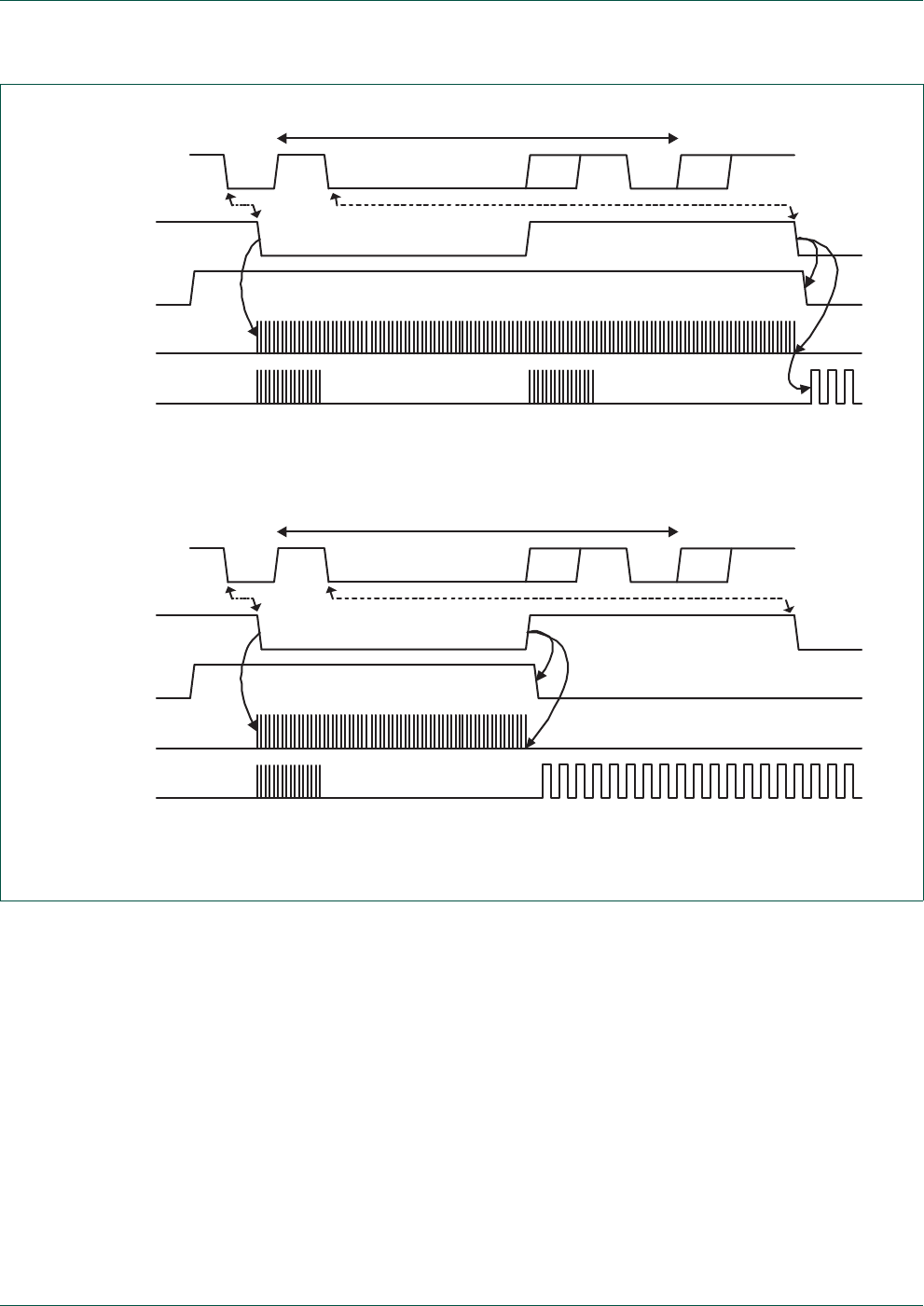
UM10360 All information provided in this document is subject to legal disclaimers. © NXP B.V. 2014. All rights reserved.
User manual Rev. 3.1 — 2 April 2014 343 of 849
NXP Semiconductors UM10360
Chapter 15: LPC176x/5x UART1
15.4.16 UART1 Fractional Divider Register (U1FDR - 0x4001 0028)
The UART1 Fractional Divider Register (U1FDR) controls the clock pre-scaler for the
baud rate generation and can be read and written at the user’s discretion. This pre-scaler
takes the APB clock and generates an output clock according to the specified fractional
requirements.
Important: If the fractional divider is active (DIVADDVAL > 0) and DLM = 0, the value of
the DLL register must be greater than 2.
a. Mode 0 (start bit and LSB are used for auto-baud)
b. Mode 1 (only start bit is used for auto-baud)
Fig 51. Auto-baud a) mode 0 and b) mode 1 waveform
UARTn RX
start bit LSB of 'A' or 'a'
U0ACR start
rate counter
start bit0 bit1 bit2 bit3 bit4 bit5 bit6 bit7 parity stop
'A' (0x41) or 'a' (0x61)
16 cycles 16 cycles
16xbaud_rate
UARTn RX
start bit LSB of 'A' or 'a'
rate counter
'A' (0x41) or 'a' (0x61)
start bit0 bit1 bit2 bit3 bit4 bit5 bit6 bit7 parity stop
U1ACR start
16 cycles
16xbaud_rate

UM10360 All information provided in this document is subject to legal disclaimers. © NXP B.V. 2014. All rights reserved.
User manual Rev. 3.1 — 2 April 2014 344 of 849
NXP Semiconductors UM10360
Chapter 15: LPC176x/5x UART1
This register controls the clock pre-scaler for the baud rate generation. The reset value of
the register keeps the fractional capabilities of UART1 disabled making sure that UART1
is fully software and hardware compatible with UARTs not equipped with this feature.
UART1 baud rate can be calculated as (n = 1):
(6)
Where PCLK is the peripheral clock, U1DLM and U1DLL are the standard UART1 baud
rate divider registers, and DIVADDVAL and MULVAL are UART1 fractional baud rate
generator specific parameters.
The value of MULVAL and DIVADDVAL should comply to the following conditions:
1. 1 MULVAL 15
2. 0 DIVADDVAL 14
3. DIVADDVAL < MULVAL
The value of the U1FDR should not be modified while transmitting/receiving data or data
may be lost or corrupted.
If the U1FDR register value does not comply to these two requests, then the fractional
divider output is undefined. If DIVADDVAL is zero then the fractional divider is disabled,
and the clock will not be divided.
15.4.16.1 Baud rate calculation
UART1 can operate with or without using the Fractional Divider. In real-life applications it
is likely that the desired baud rate can be achieved using several different Fractional
Divider settings. The following algorithm illustrates one way of finding a set of DLM, DLL,
MULVAL, and DIVADDVAL values. Such set of parameters yields a baud rate with a
relative error of less than 1.1% from the desired one.
Table 306: UART1 Fractional Divider Register (U1FDR - address 0x4001 0028) bit description
Bit Function Value Description Reset value
3:0 DIVADDVAL 0 Baud-rate generation pre-scaler divisor value. If this field is 0, fractional
baud-rate generator will not impact the UARTn baudrate.
0
7:4 MULVAL 1 Baud-rate pre-scaler multiplier value. This field must be greater or equal 1 for
UARTn to operate properly, regardless of whether the fractional baud-rate
generator is used or not.
1
31:8 - NA Reserved, user software should not write ones to reserved bits. The value read
from a reserved bit is not defined.
0
UART1baudrate
PCLK
16 256 U1DLMU1DLL+1DivAddVal
MulVal
-----------------------------
+
----------------------------------------------------------------------------------------------------------------------------------
=
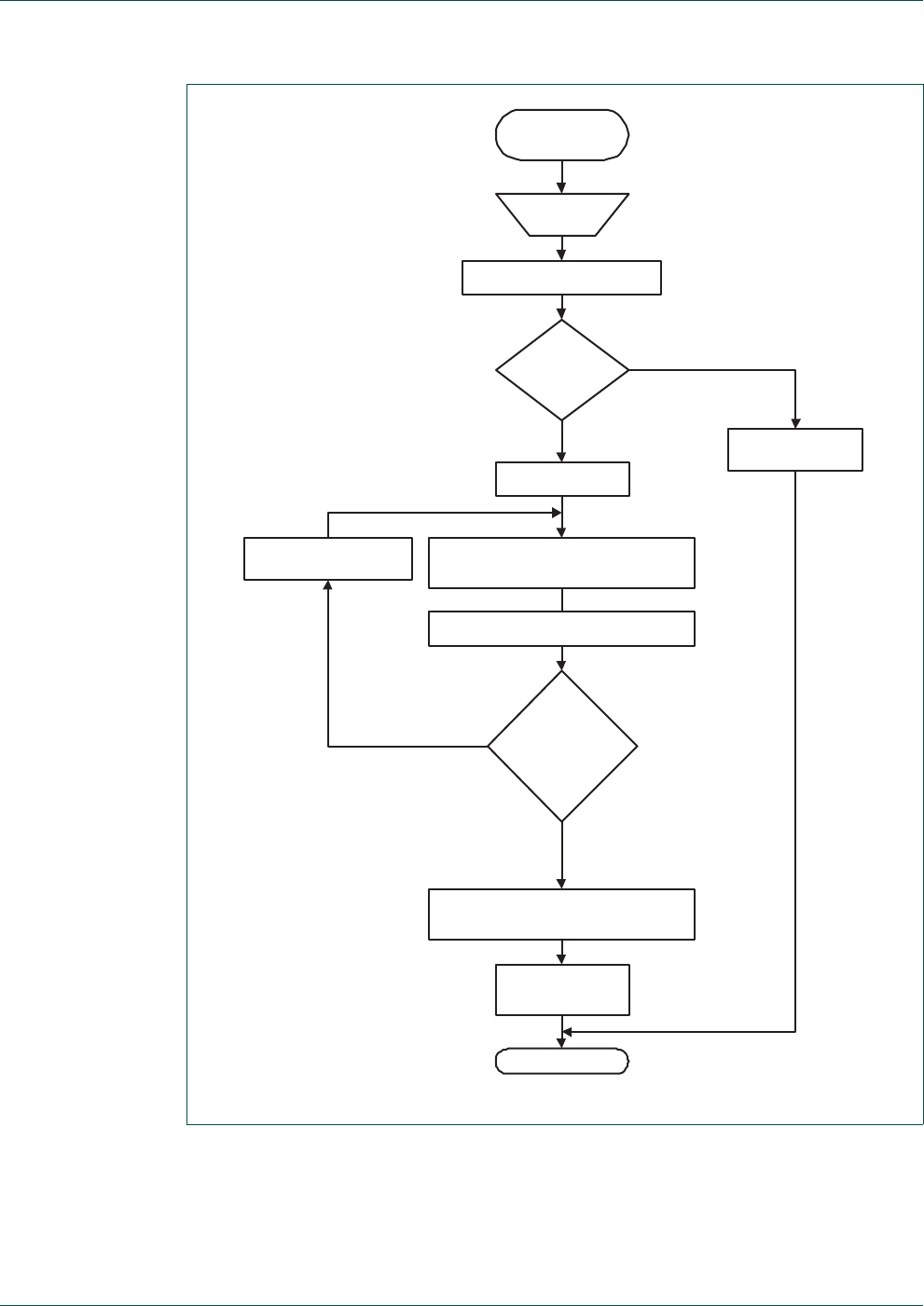
UM10360 All information provided in this document is subject to legal disclaimers. © NXP B.V. 2014. All rights reserved.
User manual Rev. 3.1 — 2 April 2014 345 of 849
NXP Semiconductors UM10360
Chapter 15: LPC176x/5x UART1
Fig 52. Algorithm for setting UART dividers
PCLK,
BR
Calculating UART
baudrate (BR)
DL est = PCLK/(16 x BR)
DLest is an
integer?
DIVADDVAL = 0
MULVAL = 1
True
FR est
= 1.5
DL est = Int(PCLK/(16 x BR x FR est))
1.1 < FR est < 1.9?
Pick another FR est from
the range [1.1, 1.9]
FRest = PCLK/(16 x BR x DL est)
DIVADDVAL = table(FR est )
MULVAL = table(FR est )
DLM = DLest [15:8]
DLL = DLest [7:0]
End
False
True
False

UM10360 All information provided in this document is subject to legal disclaimers. © NXP B.V. 2014. All rights reserved.
User manual Rev. 3.1 — 2 April 2014 346 of 849
NXP Semiconductors UM10360
Chapter 15: LPC176x/5x UART1
15.4.16.1.1 Example 1: PCLK = 14.7456 MHz, BR = 9600
According to the provided algorithm DLest = PCLK/(16 x BR) = 14.7456 MHz / (16 x 9600)
= 96. Since this DLest is an integer number, DIVADDVAL = 0, MULVAL = 1, DLM = 0, and
DLL = 96.
15.4.16.1.2 Example 2: PCLK = 12 MHz, BR = 115200
According to the provided algorithm DLest = PCLK/(16 x BR) = 12 MHz / (16 x 115200) =
6.51. This DLest is not an integer number and the next step is to estimate the FR
parameter. Using an initial estimate of FRest = 1.5 a new DL
est =4 is calculated and FR
est
is recalculated as FRest = 1.628. Since FRest = 1.628 is within the specified range of 1.1
and 1.9, DIVADDVAL and MULVAL values can be obtained from the attached look-up
table.
The closest value for FRest = 1.628 in the look-up Ta bl e 3 0 7 is FR = 1.625. It is
equivalent to DIVADDVAL = 5 and MULVAL = 8.
Based on these findings, the suggested UART setup would be: DLM = 0, DLL = 4,
DIVADDVAL = 5, and MULVAL = 8. According to Equation 6 the UART rate is 115384.
This rate has a relative error of 0.16% from the originally specified 115200.
15.4.17 UART1 Transmit Enable Register (U1TER - 0x4001 0030)
In addition to being equipped with full hardware flow control (auto-cts and auto-rts
mechanisms described above), U1TER enables implementation of software flow control,
too. When TxEn=1, UART1 transmitter will keep sending data as long as they are
available. As soon as TxEn becomes 0, UART1 transmission will stop.
Table 307. Fractional Divider setting look-up table
FR DivAddVal/
MulVal
FR DivAddVal/
MulVal
FR DivAddVal/
MulVal
FR DivAddVal/
MulVal
1.000 0/1 1.250 1/4 1.500 1/2 1.750 3/4
1.067 1/15 1.267 4/15 1.533 8/15 1.769 10/13
1.071 1/14 1.273 3/11 1.538 7/13 1.778 7/9
1.077 1/13 1.286 2/7 1.545 6/11 1.786 11/14
1.083 1/12 1.300 3/10 1.556 5/9 1.800 4/5
1.091 1/11 1.308 4/13 1.571 4/7 1.818 9/11
1.100 1/10 1.333 1/3 1.583 7/12 1.833 5/6
1.111 1/9 1.357 5/14 1.600 3/5 1.846 11/13
1.125 1/8 1.364 4/11 1.615 8/13 1.857 6/7
1.133 2/15 1.375 3/8 1.625 5/8 1.867 13/15
1.143 1/7 1.385 5/13 1.636 7/11 1.875 7/8
1.154 2/13 1.400 2/5 1.643 9/14 1.889 8/9
1.167 1/6 1.417 5/12 1.667 2/3 1.900 9/10
1.182 2/11 1.429 3/7 1.692 9/13 1.909 10/11
1.200 1/5 1.444 4/9 1.700 7/10 1.917 11/12
1.214 3/14 1.455 5/11 1.714 5/7 1.923 12/13
1.222 2/9 1.462 6/13 1.727 8/11 1.929 13/14
1.231 3/13 1.467 7/15 1.733 11/15 1.933 14/15
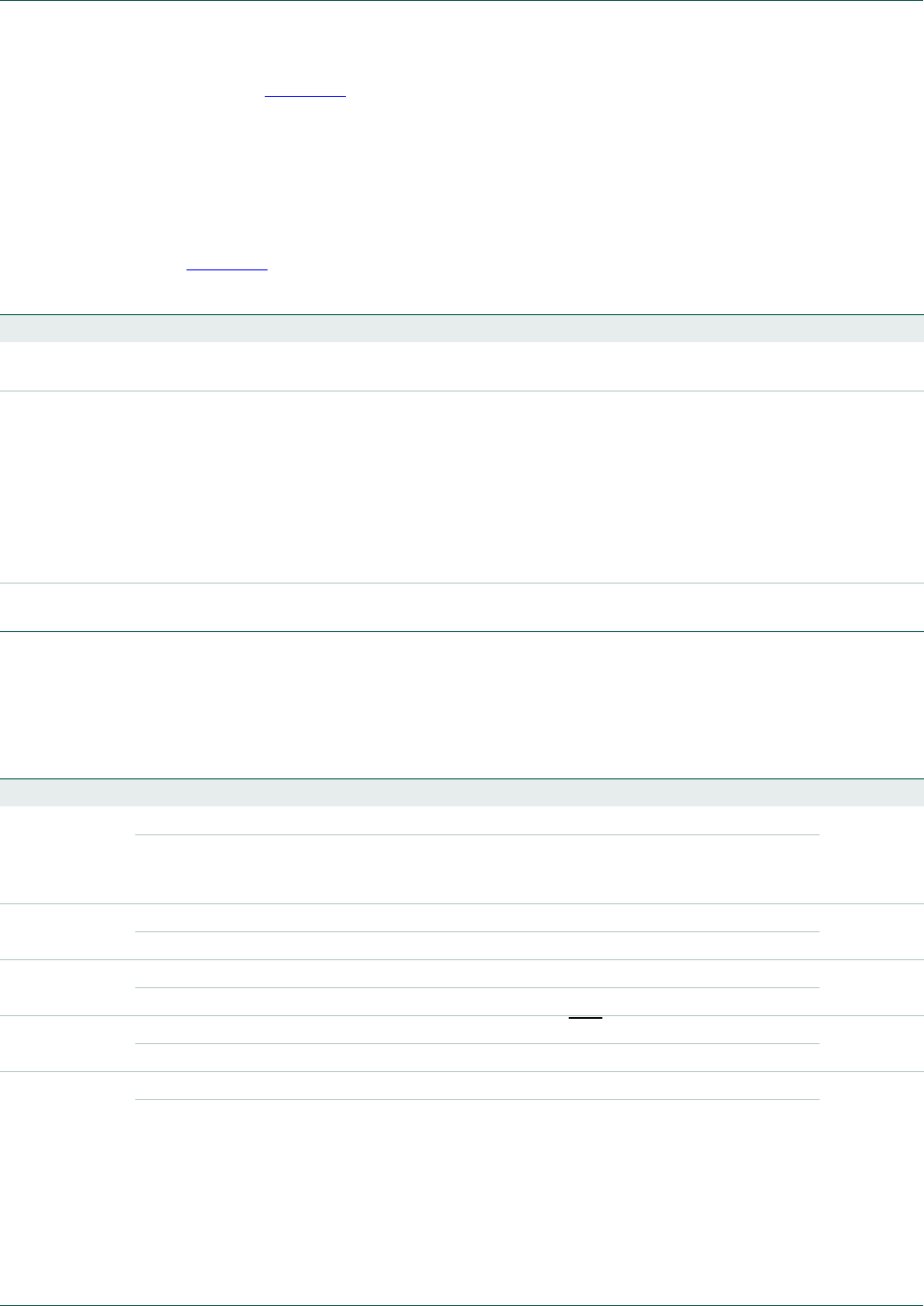
UM10360 All information provided in this document is subject to legal disclaimers. © NXP B.V. 2014. All rights reserved.
User manual Rev. 3.1 — 2 April 2014 347 of 849
NXP Semiconductors UM10360
Chapter 15: LPC176x/5x UART1
Although Ta bl e 3 0 8 describes how to use TxEn bit in order to achieve hardware flow
control, it is strongly suggested to let UART1 hardware implemented auto flow control
features take care of this, and limit the scope of TxEn to software flow control.
U1TER enables implementation of software and hardware flow control. When TXEn=1,
UART1 transmitter will keep sending data as long as they are available. As soon as TXEn
becomes 0, UART1 transmission will stop.
Tab l e 3 08 describes how to use TXEn bit in order to achieve software flow control.
15.4.18 UART1 RS485 Control register (U1RS485CTRL - 0x4001 004C)
The U1RS485CTRL register controls the configuration of the UART in RS-485/EIA-485
mode.
Table 308: UART1 Transmit Enable Register (U1TER - address 0x4001 0030) bit description
Bit Symbol Description Reset Value
6:0 - Reserved, user software should not write ones to reserved bits. The value read from a
reserved bit is not defined.
NA
7 TXEN When this bit is 1, as it is after a Reset, data written to the THR is output on the TXD pin as
soon as any preceding data has been sent. If this bit cleared to 0 while a character is being
sent, the transmission of that character is completed, but no further characters are sent until
this bit is set again. In other words, a 0 in this bit blocks the transfer of characters from the
THR or TX FIFO into the transmit shift register. Software can clear this bit when it detects
that the a hardware-handshaking TX-permit signal (CTS) has gone false, or with software
handshaking, when it receives an XOFF character (DC3). Software can set this bit again
when it detects that the TX-permit signal has gone true, or when it receives an XON (DC1)
character.
1
31:8 - Reserved, user software should not write ones to reserved bits. The value read from a
reserved bit is not defined.
NA
Table 309: UART1 RS485 Control register (U1RS485CTRL - address 0x4001 004C) bit description
Bit Symbol Value Description Reset value
0NMMEN0 RS-485/EIA-485 Normal Multidrop Mode (NMM) is disabled. 0
1 RS-485/EIA-485 Normal Multidrop Mode (NMM) is enabled. In this mode, an
address is detected when a received byte causes the UART to set the parity error
and generate an interrupt.
1RXDIS0 The receiver is enabled. 0
1The receiver is disabled.
2AADEN0 Auto Address Detect (AAD) is disabled. 0
1Auto Address Detect (AAD) is enabled.
3SEL 0 If direction control is enabled (bit DCTRL = 1), pin RTS
is used for direction control. 0
1If direction control is enabled (bit DCTRL = 1), pin DTR is used for direction control.
4DCTRL0 Disable Auto Direction Control. 0
1Enable Auto Direction Control.

UM10360 All information provided in this document is subject to legal disclaimers. © NXP B.V. 2014. All rights reserved.
User manual Rev. 3.1 — 2 April 2014 348 of 849
NXP Semiconductors UM10360
Chapter 15: LPC176x/5x UART1
15.4.19 UART1 RS-485 Address Match register (U1RS485ADRMATCH -
0x4001 0050)
The U1RS485ADRMATCH register contains the address match value for RS-485/EIA-485
mode.
15.4.20 UART1 RS-485 Delay value register (U1RS485DLY - 0x4001 0054)
The user may program the 8-bit RS485DLY register with a delay between the last stop bit
leaving the TXFIFO and the de-assertion of RTS (or DTR). This delay time is in periods of
the baud clock. Any delay time from 0 to 255 bit times may be programmed.
15.4.21 RS-485/EIA-485 modes of operation
The RS-485/EIA-485 feature allows the UART to be configured as an addressable slave.
The addressable slave is one of multiple slaves controlled by a single master.
The UART master transmitter will identify an address character by setting the parity (9th)
bit to ‘1’. For data characters, the parity bit is set to ‘0’.
Each UART slave receiver can be assigned a unique address. The slave can be
programmed to either manually or automatically reject data following an address which is
not theirs.
RS-485/EIA-485 Normal Multidrop Mode (NMM)
Setting the RS485CTRL bit 0 enables this mode. In this mode, an address is detected
when a received byte causes the UART to set the parity error and generate an interrupt.
5OINV This bit reverses the polarity of the direction control signal on the RTS (or DTR) pin. 0
0The direction control pin will be driven to logic ‘0’ when the transmitter has data to
be sent. It will be driven to logic ‘1’ after the last bit of data has been transmitted.
1The direction control pin will be driven to logic ‘1’ when the transmitter has data to
be sent. It will be driven to logic ‘0’ after the last bit of data has been transmitted.
31:6 - - Reserved, user software should not write ones to reserved bits. The value read
from a reserved bit is not defined.
NA
Table 309: UART1 RS485 Control register (U1RS485CTRL - address 0x4001 004C) bit description
Bit Symbol Value Description Reset value
Table 310. UART1 RS-485 Address Match register (U1RS485ADRMATCH - address 0x4001 0050) bit description
Bit Symbol Description Reset value
7:0 ADRMATCH Contains the address match value. 0x00
31:8 - Reserved, user software should not write ones to reserved bits. The value read from a
reserved bit is not defined.
NA
Table 311. UART1 RS-485 Delay value register (U1RS485DLY - address 0x4001 0054) bit description
Bit Symbol Description Reset value
7:0 DLY Contains the direction control (RTS or DTR) delay value. This register works in
conjunction with an 8-bit counter.
0x00
31:8 - Reserved, user software should not write ones to reserved bits. The value read from a
reserved bit is not defined.
NA

UM10360 All information provided in this document is subject to legal disclaimers. © NXP B.V. 2014. All rights reserved.
User manual Rev. 3.1 — 2 April 2014 349 of 849
NXP Semiconductors UM10360
Chapter 15: LPC176x/5x UART1
If the receiver is DISABLED (RS485CTRL bit 1 = ‘1’) any received data bytes will be
ignored and will not be stored in the RXFIFO. When an address byte is detected (parity bit
= ‘1’) it will be placed into the RXFIFO and an Rx Data Ready Interrupt will be generated.
The processor can then read the address byte and decide whether or not to enable the
receiver to accept the following data.
While the receiver is ENABLED (RS485CTRL bit 1 =’0’) all received bytes will be
accepted and stored in the RXFIFO regardless of whether they are data or address. When
an address character is received a parity error interrupt will be generated and the
processor can decide whether or not to disable the receiver.
RS-485/EIA-485 Auto Address Detection (AAD) mode
When both RS485CTRL register bits 0 (9-bit mode enable) and 2 (AAD mode enable) are
set, the UART is in auto address detect mode.
In this mode, the receiver will compare any address byte received (parity = ‘1’) to the 8-bit
value programmed into the RS485ADRMATCH register.
If the receiver is DISABLED (RS485CTRL bit 1 = ‘1’) any received byte will be discarded if
it is either a data byte OR an address byte which fails to match the RS485ADRMATCH
value.
When a matching address character is detected it will be pushed onto the RXFIFO along
with the parity bit, and the receiver will be automatically enabled (RS485CTRL bit 1 will be
cleared by hardware). The receiver will also generate n Rx Data Ready Interrupt.
While the receiver is ENABLED (RS485CTRL bit 1 = ‘0’) all bytes received will be
accepted and stored in the RXFIFO until an address byte which does not match the
RS485ADRMATCH value is received. When this occurs, the receiver will be automatically
disabled in hardware (RS485CTRL bit 1 will be set), The received non-matching address
character will not be stored in the RXFIFO.
RS-485/EIA-485 Auto Direction Control
RS485/EIA-485 Mode includes the option of allowing the transmitter to automatically
control the state of either the RTS pin or the DTR pin as a direction control output signal.
Setting RS485CTRL bit 4 = ‘1’ enables this feature.
Direction control, if enabled, will use the RTS pin when RS485CTRL bit 3 = ‘0’. It will use
the DTR pin when RS485CTRL bit 3 = ‘1’.
When Auto Direction Control is enabled, the selected pin will be asserted (driven low)
when the CPU writes data into the TXFIFO. The pin will be de-asserted (driven high) once
the last bit of data has been transmitted. See bits 4 and 5 in the RS485CTRL register.
The RS485CTRL bit 4 takes precedence over all other mechanisms controlling RTS (or
DTR) with the exception of loopback mode.
RS485/EIA-485 driver delay time
The driver delay time is the delay between the last stop bit leaving the TXFIFO and the
de-assertion of RTS (or DTR). This delay time can be programmed in the 8-bit RS485DLY
register. The delay time is in periods of the baud clock. Any delay time from 0 to 255 bit
times may be programmed.

UM10360 All information provided in this document is subject to legal disclaimers. © NXP B.V. 2014. All rights reserved.
User manual Rev. 3.1 — 2 April 2014 350 of 849
NXP Semiconductors UM10360
Chapter 15: LPC176x/5x UART1
RS485/EIA-485 output inversion
The polarity of the direction control signal on the RTS (or DTR) pins can be reversed by
programming bit 5 in the U1RS485CTRL register. When this bit is set, the direction control
pin will be driven to logic 1 when the transmitter has data waiting to be sent. The direction
control pin will be driven to logic 0 after the last bit of data has been transmitted.
15.5 Architecture
The architecture of the UART1 is shown below in the block diagram.
The APB interface provides a communications link between the CPU or host and the
UART1.
The UART1 receiver block, U1RX, monitors the serial input line, RXD1, for valid input.
The UART1 RX Shift Register (U1RSR) accepts valid characters via RXD1. After a valid
character is assembled in the U1RSR, it is passed to the UART1 RX Buffer Register FIFO
to await access by the CPU or host via the generic host interface.
The UART1 transmitter block, U1TX, accepts data written by the CPU or host and buffers
the data in the UART1 TX Holding Register FIFO (U1THR). The UART1 TX Shift Register
(U1TSR) reads the data stored in the U1THR and assembles the data to transmit via the
serial output pin, TXD1.
The UART1 Baud Rate Generator block, U1BRG, generates the timing enables used by
the UART1 TX block. The U1BRG clock input source is the APB clock (PCLK). The main
clock is divided down per the divisor specified in the U1DLL and U1DLM registers. This
divided down clock is the 16x oversample clock.
The modem interface contains registers U1MCR and U1MSR. This interface is
responsible for handshaking between a modem peripheral and the UART1.
The interrupt interface contains registers U1IER and U1IIR. The interrupt interface
receives several one clock wide enables from the U1TX and U1RX blocks.
Status information from the U1TX and U1RX is stored in the U1LSR. Control information
for the U1TX and U1RX is stored in the U1LCR.
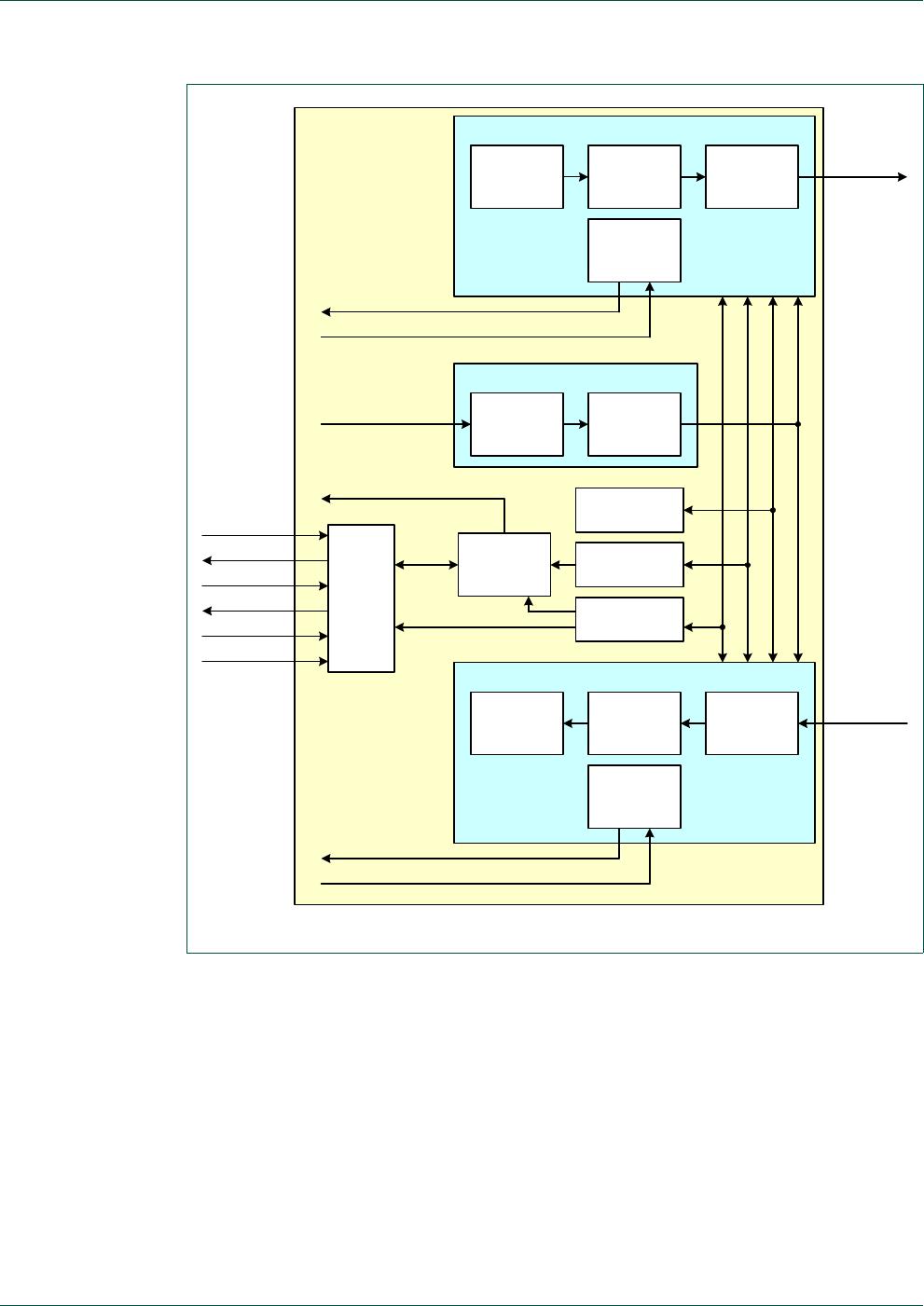
UM10360 All information provided in this document is subject to legal disclaimers. © NXP B.V. 2014. All rights reserved.
User manual Rev. 3.1 — 2 April 2014 351 of 849
NXP Semiconductors UM10360
Chapter 15: LPC176x/5x UART1
Fig 53. UART1 block diagram
Transmitter
Shift
Register
Transmitter
Holding
Register
Transmitter
FIFO
Transmitter
Receiver
Shift
Register
Receiver
Buffer
Register
Receiver
FIFO
Receiver
TX_DMA_REQ
TX_DMA_CLR
RX_DMA_REQ
RX_DMA_CLR
Baud Rate Generator
Fractional
Rate
Divider
Main
Divider
(DLM, DLL)
Modem
Control
&
Status
Transmitter
DMA
Interface
Receiver
DMA
Interface
PCLK
Line Control
& Status
FIFO Control
& Status
U1_TXD
U1_RXD
U1_OE
U1_CTS
U1_RTS
U1_DTR
U1_DSR
U1_RI
U1_DCD RS485, IrDA,
& Auto-baud
UART1 interrupt
Interrupt
Control &
Status

UM10360 All information provided in this document is subject to legal disclaimers. © NXP B.V. 2014. All rights reserved.
User manual Rev. 3.1 — 2 April 2014 352 of 849
16.1 Basic configuration
The CAN1/2 peripherals are configured using the following registers:
1. Power: In the PCONP register (Ta b le 46 ), set bits PCAN1/2.
Remark: On reset, the CAN1/2 blocks are disabled (PCAN1/2 = 0).
2. Peripheral clock: In the PCLKSEL0 register (Ta b l e 4 0 ), select PCLK_CAN1,
PCLK_CAN2, and, for the acceptance filter, PCLK_ACF. Note that these must all be
the same value.
Remark: If CAN baud rates above 100 kbit/s (see Ta b le 3 2 3 ) are needed, do not
select the IRC as the clock source (see Tab le 17 ).
3. Wake-up: CAN controllers are able to wake up the microcontroller from Power-down
mode, see Section 4.8.8.
4. Pins: Select CAN1/2 pins through the PINSEL registers and their pin modes through
the PINMODE registers (Section 8.5).
5. Interrupts: CAN interrupts are enabled using the CAN1/2IER registers (Table 322).
Interrupts are enabled in the NVIC using the appropriate Interrupt Set Enable register.
6. CAN controller initialization: see CANMOD register (Section 16.7.1).
16.2 CAN controllers
Controller Area Network (CAN) is the definition of a high performance communication
protocol for serial data communication. The CAN Controller is designed to provide a full
implementation of the CAN-Protocol according to the CAN Specification Version 2.0B.
Microcontrollers with this on-chip CAN controller are used to build powerful local networks
by supporting distributed real-time control with a very high level of security. The
applications are automotive, industrial environments, and high speed networks as well as
low cost multiplex wiring. The result is a strongly reduced wiring harness and enhanced
diagnostic and supervisory capabilities.
The CAN block is intended to support multiple CAN buses simultaneously, allowing the
device to be used as a gateway, switch, or router among a number of CAN buses in
various applications.
The CAN module consists of two elements: the controller and the Acceptance Filter. All
registers and the RAM are accessed as 32-bit words.
16.3 Features
16.3.1 General CAN features
•Compatible with CAN specification 2.0B, ISO 11898-1.
•Multi-master architecture with non destructive bit-wise arbitration.
•Bus access priority determined by the message identifier (11-bit or 29-bit).
UM10360
Chapter 16: LPC176x/5x CAN1/2
Rev. 3.1 — 2 April 2014 User manual

UM10360 All information provided in this document is subject to legal disclaimers. © NXP B.V. 2014. All rights reserved.
User manual Rev. 3.1 — 2 April 2014 353 of 849
NXP Semiconductors UM10360
Chapter 16: LPC176x/5x CAN1/2
•Guaranteed latency time for high priority messages.
•Programmable transfer rate (up to 1 Mbit/s).
•Multicast and broadcast message facility.
•Data length from 0 up to 8 bytes.
•Powerful error handling capability.
•Non-return-to-zero (NRZ) encoding/decoding with bit stuffing.
16.3.2 CAN controller features
•2 CAN controllers and buses.
•Supports 11-bit identifier as well as 29-bit identifier.
•Double Receive Buffer and Triple Transmit Buffer.
•Programmable Error Warning Limit and Error Counters with read/write access.
•Arbitration Lost Capture and Error Code Capture with detailed bit position.
•Single Shot Transmission (no re-transmission).
•Listen Only Mode (no acknowledge, no active error flags).
•Reception of "own" messages (Self Reception Request).
16.3.3 Acceptance filter features
•Fast hardware implemented search algorithm supporting a large number of CAN
identifiers.
•Global Acceptance Filter recognizes 11-bit and 29-bit Rx Identifiers for all CAN buses.
•Allows definition of explicit and groups for 11-bit and 29-bit CAN identifiers.
•Acceptance Filter can provide FullCAN-style automatic reception for selected
Standard Identifiers.
16.4 Pin description
16.5 CAN controller architecture
The CAN Controller is a complete serial interface with both Transmit and Receive Buffers
but without Acceptance Filter. CAN Identifier filtering is done for all CAN channels in a
separate block (Acceptance Filter). Except for message buffering and acceptance filtering
the functionality is similar to the PeliCAN concept.
The CAN Controller Block includes interfaces to the following blocks:
•APB Interface
•Acceptance Filter
Table 312. CAN Pin descriptions
Pin Name Type Description
RD1, RD2 Input Serial Inputs. From CAN transceivers.
TD1, TD2 Output Serial Outputs. To CAN transceivers.
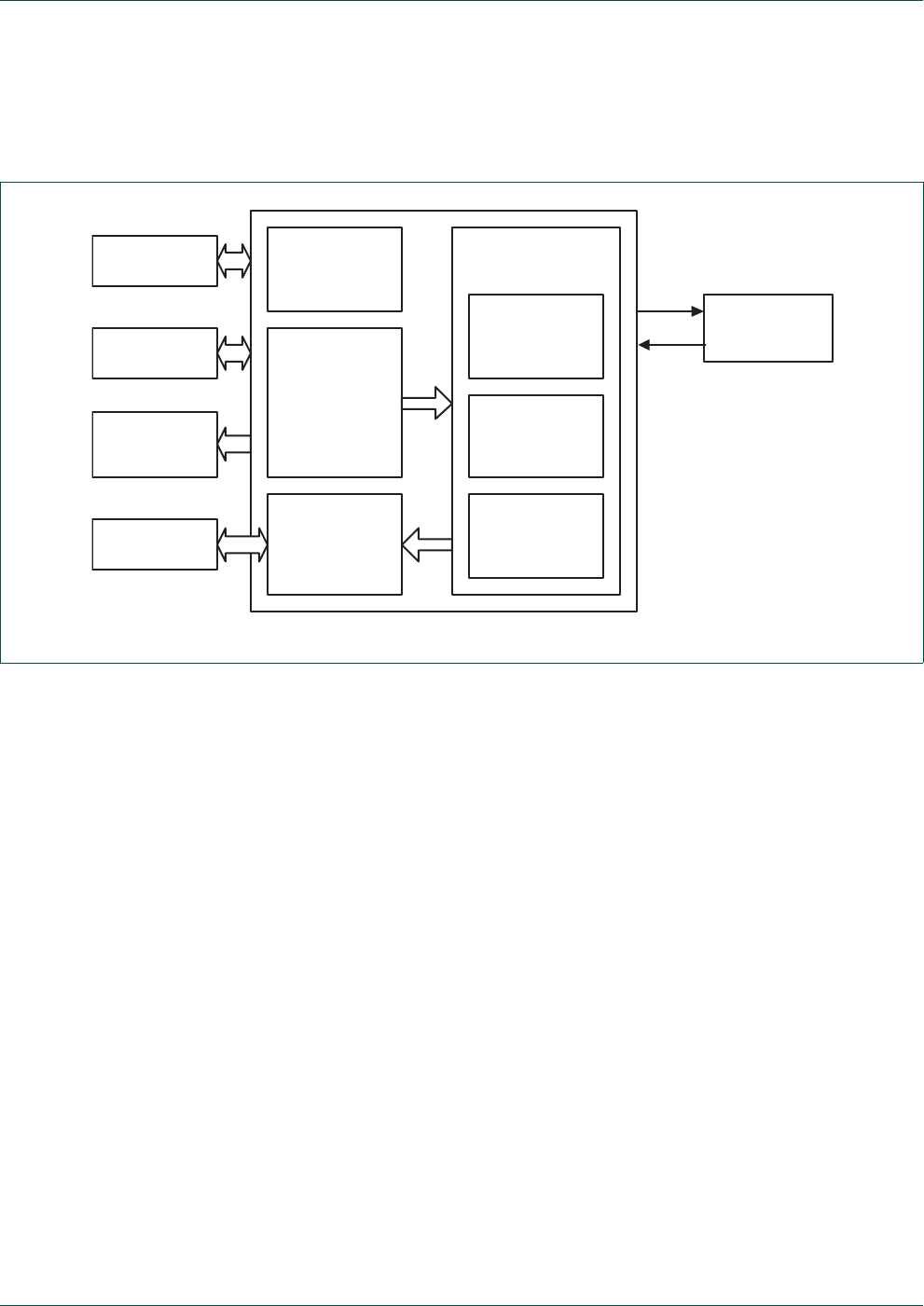
UM10360 All information provided in this document is subject to legal disclaimers. © NXP B.V. 2014. All rights reserved.
User manual Rev. 3.1 — 2 April 2014 354 of 849
NXP Semiconductors UM10360
Chapter 16: LPC176x/5x CAN1/2
•Nested Vectored Interrupt Controller (NVIC)
•CAN Transceiver
•Common Status Registers
16.5.1 APB Interface Block (AIB)
The APB Interface Block provides access to all CAN Controller registers.
16.5.2 Interface Management Logic (IML)
The Interface Management Logic interprets commands from the CPU, controls internal
addressing of the CAN Registers and provides interrupts and status information to the
CPU.
16.5.3 Transmit Buffers (TXB)
The TXB represents a Triple Transmit Buffer, which is the interface between the Interface
Management Logic (IML) and the Bit Stream Processor (BSP). Each Transmit Buffer is
able to store a complete message which can be transmitted over the CAN network. This
buffer is written by the CPU and read out by the BSP.
Fig 54. CAN controller block diagram
INTERFACE
MANAGEMENT
LOGIC
TRANSMIT
BUFFERS 1,2
AND 3
RECEIVE
BUFFERS 1
AND 2
BIT
TIMING
LOGIC
BIT
STREAM
PROCESSOR
ERROR
MANAGEMENT
LOGIC
CAN CORE
BLOCK
NVIC
APB BUS
ACCEPTANCE
FILTER
COMMON
STATUS
REGISTER
CAN
TRANSCEIVER
TX
RX
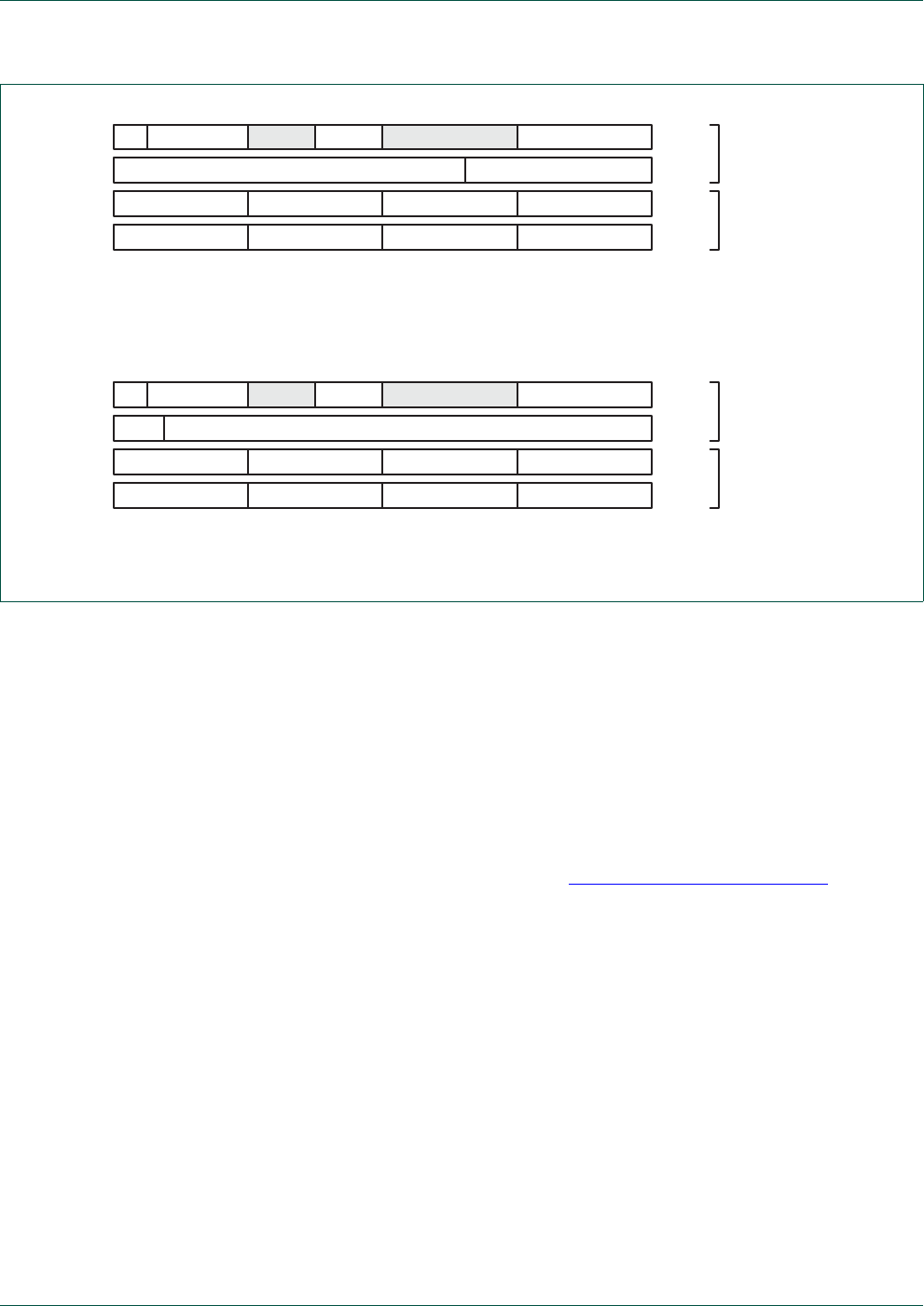
UM10360 All information provided in this document is subject to legal disclaimers. © NXP B.V. 2014. All rights reserved.
User manual Rev. 3.1 — 2 April 2014 355 of 849
NXP Semiconductors UM10360
Chapter 16: LPC176x/5x CAN1/2
16.5.4 Receive Buffer (RXB)
The Receive Buffer (RXB) represents a CPU accessible Double Receive Buffer. It is
located between the CAN Controller Core Block and APB Interface Block and stores all
received messages from the CAN Bus line. With the help of this Double Receive Buffer
concept the CPU is able to process one message while another message is being
received.
The global layout of the Receive Buffer is very similar to the Transmit Buffer described
earlier. Identifier, Frame Format, Remote Transmission Request bit and Data Length
Code have the same meaning as described for the Transmit Buffer. In addition, the
Receive Buffer includes an ID Index field (see Section 16.7.9.1 “ID index field”).
The received Data Length Code represents the real transmitted Data Length Code, which
may be greater than 8 depending on transmitting CAN node. Nevertheless, the maximum
number of received data bytes is 8. This should be taken into account by reading a
message from the Receive Buffer. If there is not enough space for a new message within
the Receive Buffer, the CAN Controller generates a Data Overrun condition when this
message becomes valid and the acceptance test was positive. A message that is partly
written into the Receive Buffer (when the Data Overrun situation occurs) is deleted. This
situation is signalled to the CPU via the Status Register and the Data Overrun Interrupt, if
enabled.
Fig 55. Transmit buffer layout for standard and extended frame format configurations
TX Frame info unused TX Priority
0 . . . 0 ID.28 ... ID.18
TX Data 4 TX Data 3 TX Data 2 TX Data 1
TX Data 8 TX Data 7 TX Data 6 TX Data 5
unused
31 24 23 16 15 8 7 0
TFS
TID
TDA
TDB
Descriptor
Field
Data Field
Standard Frame Format (11-bit Identifier)
Frame info unused TX DLC TX Priority
0 0 0 ID.28 ... ID.00
TX Data 4 TX Data 3 TX Data 2 TX Data 1
TX Data 8 TX Data 7 TX Data 6 TX Data 5
unused
31 24 23 16 15 8 7 0
TFS
TID
TDA
TDB
Descriptor
Field
Data Field
Extended Frame Format (29-bit Identifier)
TX DLC
TX
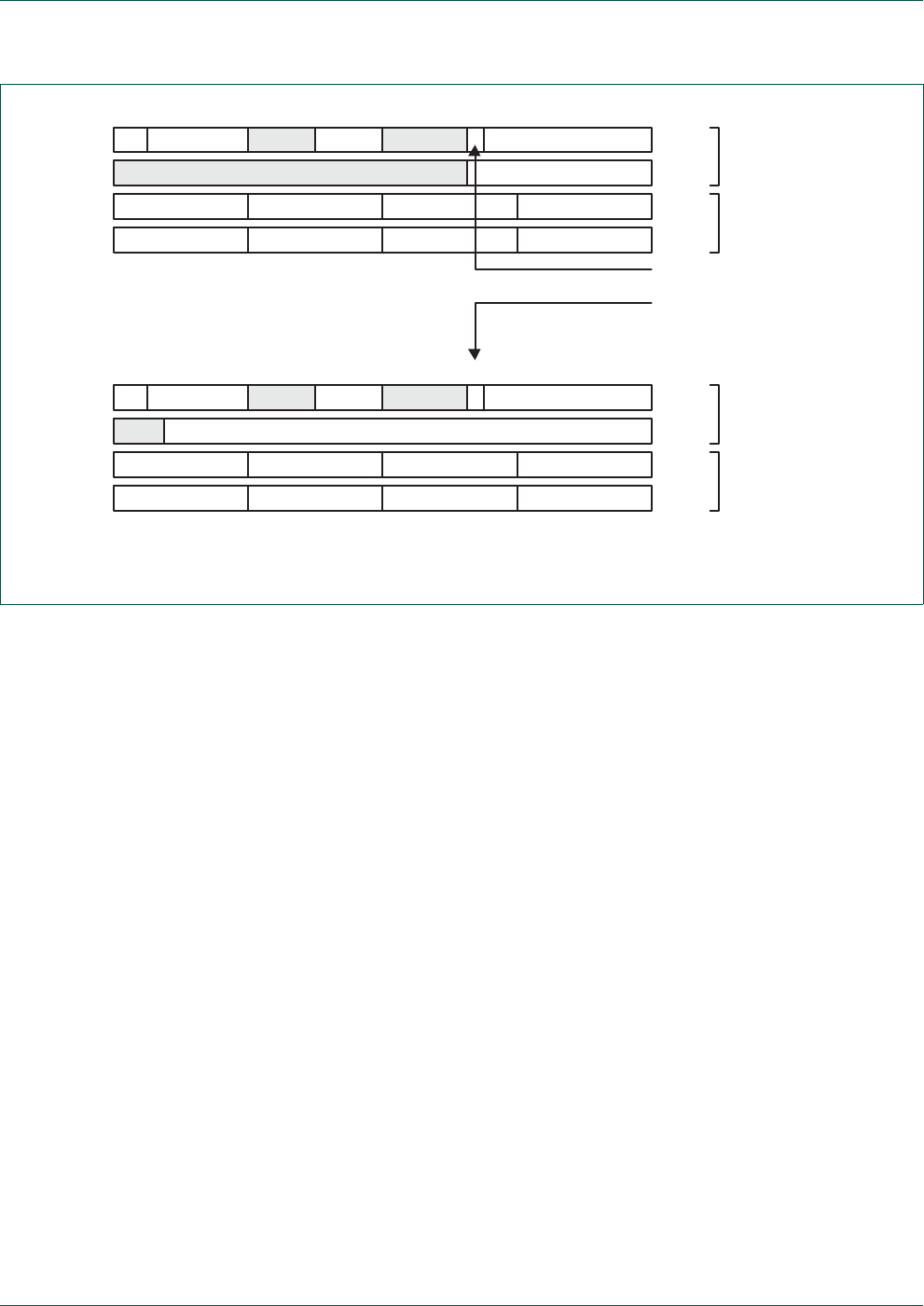
UM10360 All information provided in this document is subject to legal disclaimers. © NXP B.V. 2014. All rights reserved.
User manual Rev. 3.1 — 2 April 2014 356 of 849
NXP Semiconductors UM10360
Chapter 16: LPC176x/5x CAN1/2
16.5.5 Error Management Logic (EML)
The EML is responsible for the error confinement. It gets error announcements from the
BSP and then informs the BSP and IML about error statistics.
16.5.6 Bit Timing Logic (BTL)
The Bit Timing Logic monitors the serial CAN Bus line and handles the Bus line related bit
timing. It synchronizes to the bit stream on the CAN Bus on a "recessive" to "dominant"
Bus line transition at the beginning of a message (hard synchronization) and
re-synchronizes on further transitions during the reception of a message (soft
synchronization). The BTL also provides programmable time segments to compensate for
the propagation delay times and phase shifts (e.g. due to oscillator drifts) and to define the
sample point and the number of samples to be taken within a bit time.
16.5.7 Bit Stream Processor (BSP)
The Bit Stream Processor is a sequencer, controlling the data stream between the
Transmit Buffer, Receive Buffers and the CAN Bus. It also performs the error detection,
arbitration, stuffing and error handling on the CAN Bus.
16.5.8 CAN controller self-tests
The CAN controller supports two different options for self-tests:
•Global Self-Test (setting the self reception request bit in normal Operating Mode)
•Local Self-Test (setting the self reception request bit in Self Test Mode)
Fig 56. Receive buffer layout for standard and extended frame format configurations
RX Frame info unused ID Index
ID.28 ... ID.18
RX Data 4 RX Data 3 RX Data 2 RX Data 1
RX Data 8 RX Data 7 RX Data 6 RX Data 5
unused
31 24 23 16 15 10 9 8 7 0
RFS
RID
RDA
RDB
Descriptor
Field
Data Field
Standard Frame Format (11-bit Identifier)
Frame info unused RX DLC
ID.28 ... ID.00
RX Data 4 RX Data 3 RX Data 2 RX Data 1
RX Data 8 RX Data 7 RX Data 6 RX Data 5
31 24 23 16 15
RFS
RID
RDA
RDB
Descriptor
Field
Data Field
Extended Frame Format (29-bit Identifier)
RX DLC
RX
unused
unused
ID Indexunused
10 9 8 7 0
BPM=bypass
message
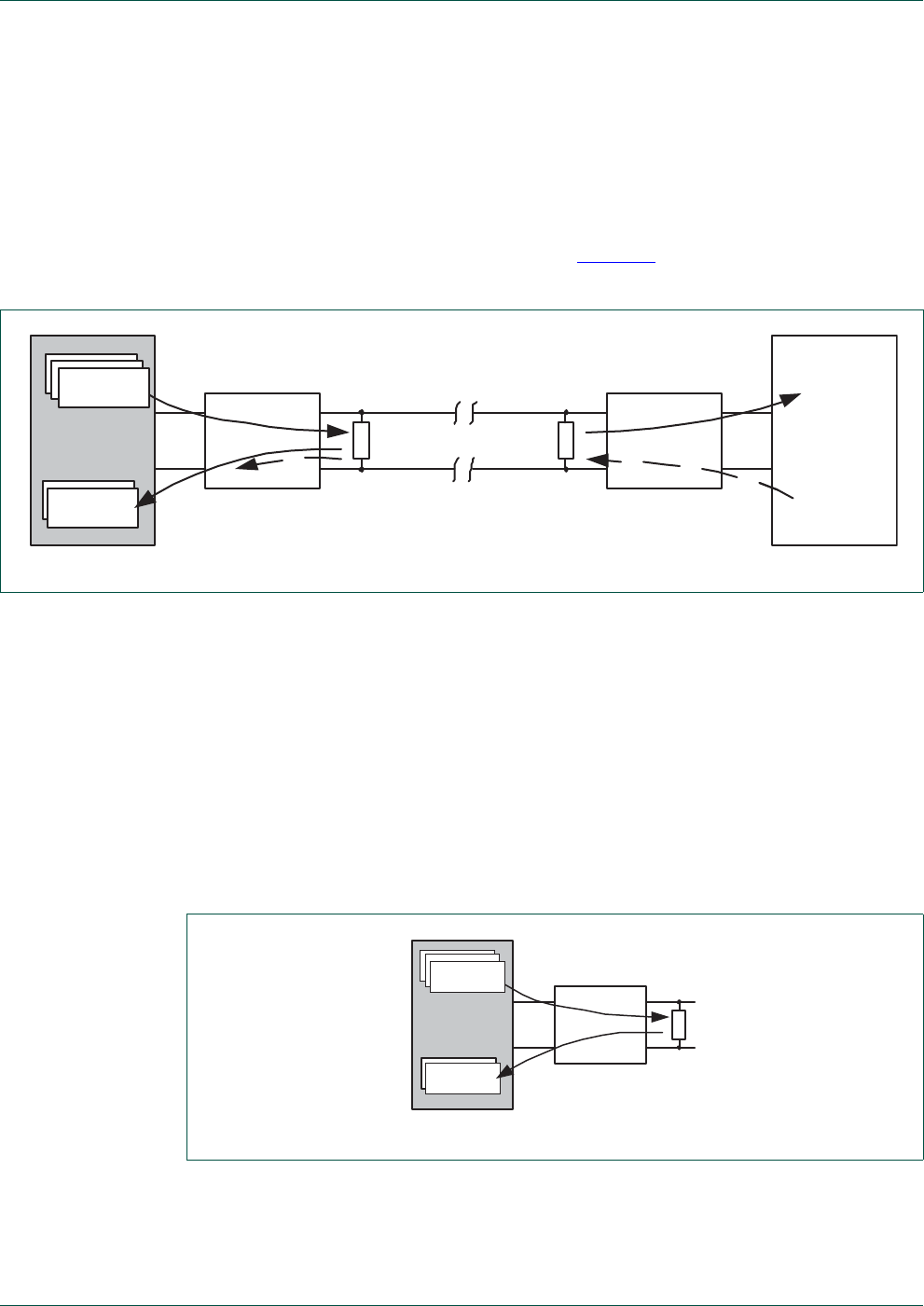
UM10360 All information provided in this document is subject to legal disclaimers. © NXP B.V. 2014. All rights reserved.
User manual Rev. 3.1 — 2 April 2014 357 of 849
NXP Semiconductors UM10360
Chapter 16: LPC176x/5x CAN1/2
Both self-tests are using the ‘Self Reception’ feature of the CAN Controller. With the Self
Reception Request, the transmitted message is also received and stored in the receive
buffer. Therefore the acceptance filter has to be configured accordingly. As soon as the
CAN message is transmitted, a transmit and a receive interrupt are generated, if enabled.
Global self test
A Global Self-Test can for example be used to verify the chosen configuration of the CAN
Controller in a given CAN system. As shown in Figure 57, at least one other CAN node,
which is acknowledging each CAN message has to be connected to the CAN bus.
Initiating a Global Self-Test is similar to a normal CAN transmission. In this case the
transmission of a CAN message(s) is initiated by setting Self Reception Request bit
(SRR) in conjunction with the selected Message Buffer bits (STB3, STB2, STB1) in the
CAN Controller Command register (CANCMR).
Local self test
The Local Self-Test perfectly fits for single node tests. In this case an acknowledge from
other nodes is not needed. As shown in the Figure below, a CAN transceiver with an
appropriate CAN bus termination has to be connected to the LPC176x/5x. The CAN
Controller has to be put into the 'Self Test Mode' by setting the STM bit in the CAN
Controller Mode register (CANMOD). Hint: Setting the Self Test Mode bit (STM) is
possible only when the CAN Controller is in Reset Mode.
A message transmission is initiated by setting Self Reception Request bit (SRR) in
conjunction with the selected Message Buffer(s) (STB3, STB2, STB1).
Fig 57. Global Self-Test (high-speed CAN Bus example)
Transceiver
TX Buffer
RX Buffer
ack
TX Buffer
TX Buffer CAN Bus
LPC17xx
Fig 58. Local self test (high-speed CAN Bus example)
Transceiver
RX Buffer
TX Buffer
TX Buffer
TX Buffer
LPC17xx

UM10360 All information provided in this document is subject to legal disclaimers. © NXP B.V. 2014. All rights reserved.
User manual Rev. 3.1 — 2 April 2014 358 of 849
NXP Semiconductors UM10360
Chapter 16: LPC176x/5x CAN1/2
16.6 Memory map of the CAN block
The CAN Controllers and Acceptance Filter occupy a number of APB slots, as follows:
16.7 CAN controller registers
CAN block implements the registers shown in Tab le 31 4 and Ta bl e 3 1 5 . More detailed
descriptions follow.
Table 313. Memory map of the CAN block
Address Range Used for
0x4003 8000 - 0x4003 87FF Acceptance Filter RAM.
0x4003 C000 - 0x4003 C017 Acceptance Filter Registers.
0x4004 0000 - 0x4004 000B Central CAN Registers.
0x4004 4000 - 0x4004 405F CAN Controller 1 Registers.
0x4004 8000 - 0x4004 805F CAN Controller 2 Registers.
0x400F C110 - 0x400F C114 CAN Wake and Sleep Registers.
Table 314. CAN acceptance filter and central CAN registers
Name Description Access Reset Value Address
AFMR Acceptance Filter Register R/W 1 0x4003 C000
SFF_sa Standard Frame Individual Start Address Register R/W 0 0x4003 C004
SFF_GRP_sa Standard Frame Group Start Address Register R/W 0 0x4003 C008
EFF_sa Extended Frame Start Address Register R/W 0 0x4003 C00C
EFF_GRP_sa Extended Frame Group Start Address Register R/W 0 0x4003 C010
ENDofTable End of AF Tables register R/W 0 0x4003 C014
LUTerrAd LUT Error Address register RO 0 0x4003 C018
LUTerr LUT Error Register RO 0 0x4003 C01C
CANTxSR CAN Central Transmit Status Register RO 0x0003 0300 0x4004 0000
CANRxSR CAN Central Receive Status Register RO 0 0x4004 0004
CANMSR CAN Central Miscellaneous Register RO 0 0x4004 0008
Table 315. CAN1 and CAN2 controller register map
Generic
Name
Description Access Reset
value
CAN1 & 2 Register Name
& Address
MOD Controls the operating mode of the CAN Controller. R/W 1 CAN1MOD - 0x4004 4000
CAN2MOD - 0x4004 8000
CMR Command bits that affect the state of the CAN Controller WO 0 CAN1CMR - 0x4004 4004
CAN2CMR - 0x4004 8004
GSR Global Controller Status and Error Counters RO[1] 0x3C CAN1GSR - 0x4004 4008
CAN2GSR - 0x4004 8008
ICR Interrupt status, Arbitration Lost Capture, Error Code Capture RO 0 CAN1ICR - 0x4004 400C
CAN2ICR - 0x4004 800C
IER Interrupt Enable R/W 0 CAN1IER - 0x4004 4010
CAN2IER - 0x4004 8010

UM10360 All information provided in this document is subject to legal disclaimers. © NXP B.V. 2014. All rights reserved.
User manual Rev. 3.1 — 2 April 2014 359 of 849
NXP Semiconductors UM10360
Chapter 16: LPC176x/5x CAN1/2
[1] The error counters can only be written when RM in CANMOD is 1.
[2] These registers can only be written when RM in CANMOD is 1.
BTR Bus Timing R/W[2] 0x1C0000 CAN1BTR - 0x4004 4014
CAN2BTR - 0x4004 8014
EWL Error Warning Limit R/W[2] 0x60 CAN1EWL - 0x4004 4018
CAN2EWL - 0x4004 8018
SR Status Register RO 0x3C3C3C CAN1SR - 0x4004 401C
CAN2SR - 0x4004 801C
RFS Receive frame status R/W[2] 0CAN1RFS - 0x4004 4020
CAN2RFS - 0x4004 8020
RID Received Identifier R/W[2] 0CAN1RID - 0x4004 4024
CAN2RID - 0x4004 8024
RDA Received data bytes 1-4 R/W[2] 0CAN1RDA - 0x4004 4028
CAN2RDA - 0x4004 8028
RDB Received data bytes 5-8 R/W[2] 0CAN1RDB - 0x4004 402C
CAN2RDB - 0x4004 802C
TFI1 Transmit frame info (Tx Buffer 1) R/W 0 CAN1TFI1 - 0x4004 4030
CAN2TFI1 - 0x4004 8030
TID1 Transmit Identifier (Tx Buffer 1) R/W 0 CAN1TID1 - 0x4004 4034
CAN2TID1 - 0x4004 8034
TDA1 Transmit data bytes 1-4 (Tx Buffer 1) R/W 0 CAN1TDA1 - 0x4004 4038
CAN2TDA1 - 0x4004 8038
TDB1 Transmit data bytes 5-8 (Tx Buffer 1) R/W 0 CAN1TDB1- 0x4004 403C
CAN2TDB1 - 0x4004 803C
TFI2 Transmit frame info (Tx Buffer 2) R/W 0 CAN1TFI2 - 0x4004 4040
CAN2TFI2 - 0x4004 8040
TID2 Transmit Identifier (Tx Buffer 2) R/W 0 CAN1TID2 - 0x4004 4044
CAN2TID2 - 0x4004 8044
TDA2 Transmit data bytes 1-4 (Tx Buffer 2) R/W 0 CAN1TDA2 - 0x4004 4048
CAN2TDA2 - 0x4004 8048
TDB2 Transmit data bytes 5-8 (Tx Buffer 2) R/W 0 CAN1TDB2 - 0x4004 404C
CAN2TDB2 - 0x4004 804C
TFI3 Transmit frame info (Tx Buffer 3) R/W 0 CAN1TFI3 - 0x4004 4050
CAN2TFI3 - 0x4004 8050
TID3 Transmit Identifier (Tx Buffer 3) R/W 0 CAN1TID3 - 0x4004 4054
CAN2TID3 - 0x4004 8054
TDA3 Transmit data bytes 1-4 (Tx Buffer 3) R/W 0 CAN1TDA3 - 0x4004 4058
CAN2TDA3 - 0x4004 8058
TDB3 Transmit data bytes 5-8 (Tx Buffer 3) R/W 0 CAN1TDB3 - 0x4004 405C
CAN2TDB3 - 0x4004 805C
Table 315. CAN1 and CAN2 controller register map …continued
Generic
Name
Description Access Reset
value
CAN1 & 2 Register Name
& Address

UM10360 All information provided in this document is subject to legal disclaimers. © NXP B.V. 2014. All rights reserved.
User manual Rev. 3.1 — 2 April 2014 360 of 849
NXP Semiconductors UM10360
Chapter 16: LPC176x/5x CAN1/2
The internal registers of each CAN Controller appear to the CPU as on-chip memory
mapped peripheral registers. Because the CAN Controller can operate in different modes
(Operating/Reset, see also Section 16.7.1 “CAN Mode register (CAN1MOD -
0x4004 4000, CAN2MOD - 0x4004 8000)”), one has to distinguish between different
internal address definitions. Note that write access to some registers is only allowed in
Reset Mode.
In the following register tables, the column “Reset Value” shows how a hardware reset
affects each bit or field, while the column “RM Set” indicates how each bit or field is
affected if software sets the RM bit, or RM is set because of a Bus-Off condition. Note that
while hardware reset sets RM, in this case the setting noted in the “Reset Value” column
prevails over that shown in the “RM Set” column, in the few bits where they differ. In both
columns, X indicates the bit or field is unchanged.
16.7.1 CAN Mode register (CAN1MOD - 0x4004 4000, CAN2MOD -
0x4004 8000)
The contents of the Mode Register are used to change the behavior of the CAN
Controller. Bits may be set or reset by the CPU that uses the Mode Register as a
read/write memory.
Table 316. CAN1 and CAN2 controller register summary
Generic
Name
Operating Mode Reset Mode
Read Write Read Write
MOD Mode Mode Mode Mode
CMR 0x00 Command 0x00 Command
GSR Global Status and Error Counters - Global Status and Error Counters Error Counters only
ICR Interrupt and Capture -Interrupt and Capture -
IER Interrupt Enable Interrupt Enable Interrupt Enable Interrupt Enable
BTR Bus Timing -Bus Timing Bus Timing
EWL Error Warning Limit -Error Warning Limit Error Warning Limit
SR Status -Status -
RFS Rx Info and Index -Rx Info and Index Rx Info and Index
RID Rx Identifier -Rx Identifier Rx Identifier
RDA Rx Data -Rx Data Rx Data
RDB Rx Info and Index -Rx Info and Index Rx Info and Index
TFI1 Tx Info1 Tx Info Tx Info Tx Info
TID1 Tx Identifier Tx Identifier Tx Identifier Tx Identifier
TDA1 Tx Data Tx Data Tx Data Tx Data
TDB1 Tx Data Tx Data Tx Data Tx Data
Table 317. CAN Wake and Sleep registers
Name Description Access Reset Value Address
CANSLEEPCLR Allows clearing the current CAN channel sleep state as well as
reading that state.
R/W 0 0x400F C110
CANWAKEFLAGS Allows reading the wake-up state of the CAN channels. R/W 0 0x400F C114
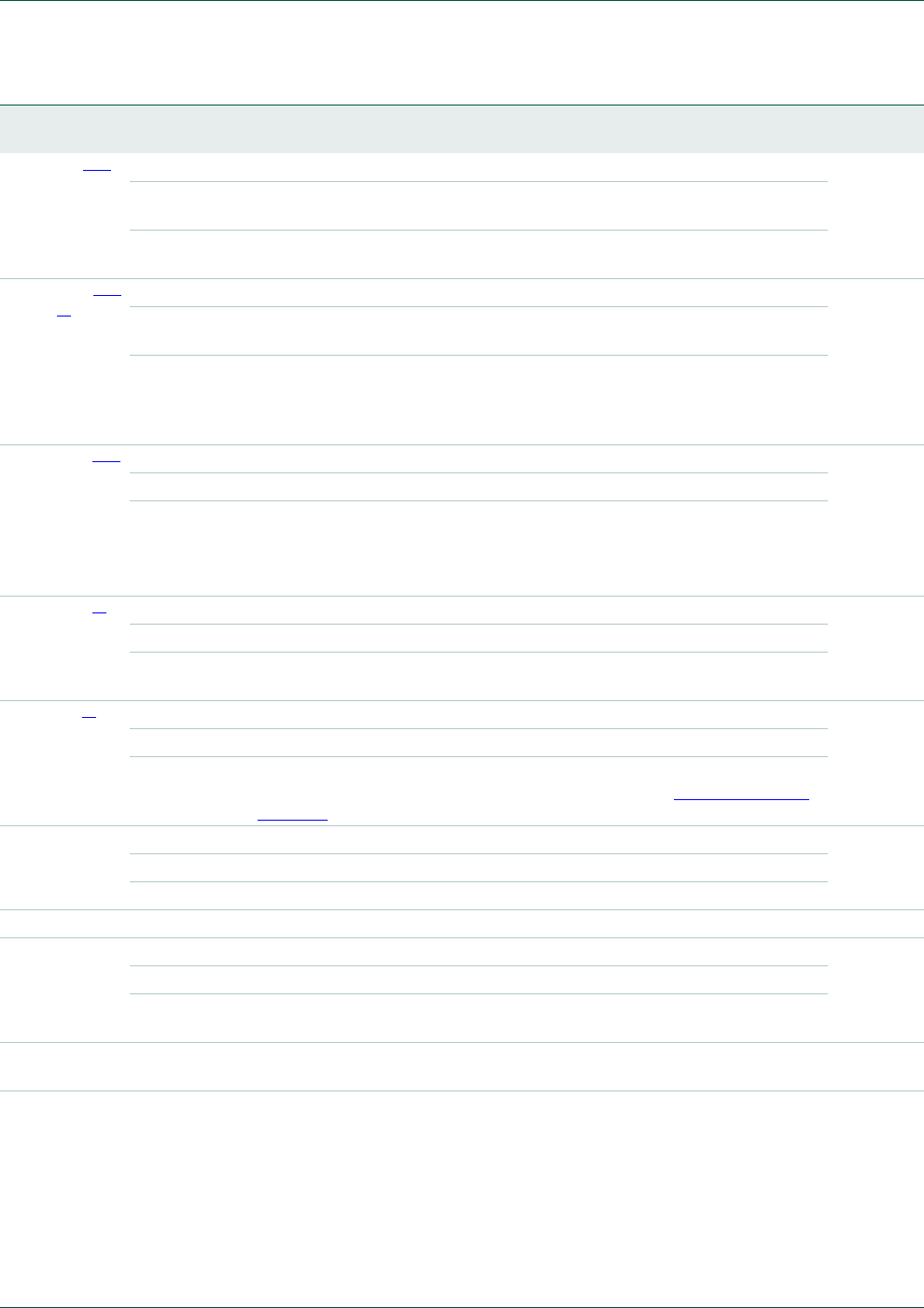
UM10360 All information provided in this document is subject to legal disclaimers. © NXP B.V. 2014. All rights reserved.
User manual Rev. 3.1 — 2 April 2014 361 of 849
NXP Semiconductors UM10360
Chapter 16: LPC176x/5x CAN1/2
[1] During a Hardware reset or when the Bus Status bit is set '1' (Bus-Off), the Reset Mode bit is set '1' (present). After the Reset Mode bit
is set '0' the CAN Controller will wait for:
- one occurrence of Bus-Free signal (11 recessive bits), if the preceding reset has been caused by a Hardware reset or a CPU-initiated
reset.
- 128 occurrences of Bus-Free, if the preceding reset has been caused by a CAN Controller initiated Bus-Off, before re-entering the
Bus-On mode.
[2] This mode of operation forces the CAN Controller to be error passive. Message Transmission is not possible. The Listen Only Mode can
be used e.g. for software driven bit rate detection and "hot plugging".
Table 318. CAN Mode register (CAN1MOD - address 0x4004 4000, CAN2MOD - address 0x4004 8000) bit description
Bit Symbol Value Function Reset
Value
RM
Set
0RM
[1][6] Reset Mode. 11
0 (normal) The CAN Controller is in the Operating Mode, and certain registers can not
be written.
1 (reset) CAN operation is disabled, writable registers can be written and the current
transmission/reception of a message is aborted.
1LOM
[3][2]
[6]
Listen Only Mode. 0x
0 (normal) The CAN controller acknowledges a successfully received message on the
CAN bus. The error counters are stopped at the current value.
1 (listen only) The controller gives no acknowledgment, even if a message is successfully
received. Messages cannot be sent, and the controller operates in “error
passive” mode. This mode is intended for software bit rate detection and
“hot plugging”.
2STM
[3][6] Self Test Mode. 0x
0 (normal) A transmitted message must be acknowledged to be considered successful.
1 (self test) The controller will consider a Tx message successful even if there is no
acknowledgment received.
In this mode a full node test is possible without any other active node on the
bus using the SRR bit in CANxCMR.
3TPM
[4] Transmit Priority Mode. 0x
0 (CAN ID) The transmit priority for 3 Transmit Buffers depends on the CAN Identifier.
1 (local prio) The transmit priority for 3 Transmit Buffers depends on the contents of the
Tx Priority register within the Transmit Buffer.
4SM
[5] Sleep Mode. 00
0 (wake-up) Normal operation.
1 (sleep) The CAN controller enters Sleep Mode if no CAN interrupt is pending and
there is no bus activity. See the Sleep Mode description Section 16.8.2 on
page 379.
5RPM Receive Polarity Mode. 0 x
0 (low active) RD input is active Low (dominant bit = 0).
1 (high active) RD input is active High (dominant bit = 1) -- reverse polarity.
6- - Reserved, user software should not write ones to reserved bits. 0 0
7TM Test Mode. 0 x
0 (disabled) Normal operation.
1 (enabled) The TD pin will reflect the bit, detected on RD pin, with the next positive
edge of the system clock.
31:8 - Reserved, user software should not write ones to reserved bits. The value
read from a reserved bit is not defined.
NA

UM10360 All information provided in this document is subject to legal disclaimers. © NXP B.V. 2014. All rights reserved.
User manual Rev. 3.1 — 2 April 2014 362 of 849
NXP Semiconductors UM10360
Chapter 16: LPC176x/5x CAN1/2
[3] A write access to the bits MOD.1 and MOD.2 is possible only if the Reset Mode is entered previously.
[4] Transmit Priority Mode is explained in more detail in Section 16.5.3 “Transmit Buffers (TXB)”.
[5] The CAN Controller will enter Sleep Mode, if the Sleep Mode bit is set '1' (sleep), there is no bus activity, and none of the CAN interrupts
is pending. Setting of SM with at least one of the previously mentioned exceptions valid will result in a wake-up interrupt. The CAN
Controller will wake up if SM is set LOW (wake-up) or there is bus activity. On wake-up, a Wake-up Interrupt is generated. A sleeping
CAN Controller which wakes up due to bus activity will not be able to receive this message until it detects 11 consecutive recessive bits
(Bus-Free sequence). Note that setting of SM is not possible in Reset Mode. After clearing of Reset Mode, setting of SM is possible only
when Bus-Free is detected again.
[6] The LOM and STM bits can only be written if the RM bit is 1 prior to the write operation.
16.7.2 CAN Command Register (CAN1CMR - 0x4004 x004, CAN2CMR -
0x4004 8004)
Writing to this write-only register initiates an action within the transfer layer of the CAN
Controller. Reading this register yields zeroes.
At least one internal clock cycle is needed for processing between two commands.
Table 319. CAN Command Register (CAN1CMR - address 0x4004 4004, CAN2CMR - address 0x4004 8004) bit
description
Bit Symbol Value Function Reset
Value
RM
Set
0[1][2] TR Transmission Request. 00
0 (absent) No transmission request.
1 (present) The message, previously written to the CANxTFI, CANxTID, and
optionally the CANxTDA and CANxTDB registers, is queued for
transmission from the selected Transmit Buffer. If at two or all three of
STB1, STB2 and STB3 bits are selected when TR=1 is written, Transmit
Buffer will be selected based on the chosen priority scheme (for details
see Section 16.5.3 “Transmit Buffers (TXB)”)
1[1][3] AT Abort Transmission. 00
0 (no action) Do not abort the transmission.
1 (present) if not already in progress, a pending Transmission Request for the
selected Transmit Buffer is cancelled.
2[4] RRB Release Receive Buffer. 00
0 (no action) Do not release the receive buffer.
1 (released) The information in the Receive Buffer (consisting of CANxRFS,
CANxRID, and if applicable the CANxRDA and CANxRDB registers) is
released, and becomes eligible for replacement by the next received
frame. If the next received frame is not available, writing this command
clears the RBS bit in the Status Register(s).
3[5] CDO Clear Data Overrun. 00
0 (no action) Do not clear the data overrun bit.
1 (clear) The Data Overrun bit in Status Register(s) is cleared.
4[1][6] SRR Self Reception Request. 00
0 (absent) No self reception request.
1 (present) The message, previously written to the CANxTFS, CANxTID, and
optionally the CANxTDA and CANxTDB registers, is queued for
transmission from the selected Transmit Buffer and received
simultaneously. This differs from the TR bit above in that the receiver is
not disabled during the transmission, so that it receives the message if its
Identifier is recognized by the Acceptance Filter.

UM10360 All information provided in this document is subject to legal disclaimers. © NXP B.V. 2014. All rights reserved.
User manual Rev. 3.1 — 2 April 2014 363 of 849
NXP Semiconductors UM10360
Chapter 16: LPC176x/5x CAN1/2
[1] - Setting the command bits TR and AT simultaneously results in transmitting a message once. No re-transmission will be performed in
case of an error or arbitration lost (single shot transmission).
- Setting the command bits SRR and TR simultaneously results in sending the transmit message once using the self-reception feature.
No re-transmission will be performed in case of an error or arbitration lost.
- Setting the command bits TR, AT and SRR simultaneously results in transmitting a message once as described for TR and AT. The
moment the Transmit Status bit is set within the Status Register, the internal Transmission Request Bit is cleared automatically.
- Setting TR and SRR simultaneously will ignore the set SRR bit.
[2] If the Transmission Request or the Self-Reception Request bit was set '1' in a previous command, it cannot be cancelled by resetting the
bits. The requested transmission may only be cancelled by setting the Abort Transmission bit.
[3] The Abort Transmission bit is used when the CPU requires the suspension of the previously requested transmission, e.g. to transmit a
more urgent message before. A transmission already in progress is not stopped. In order to see if the original message has been either
transmitted successfully or aborted, the Transmission Complete Status bit should be checked. This should be done after the Transmit
Buffer Status bit has been set to '1' or a Transmit Interrupt has been generated.
[4] After reading the contents of the Receive Buffer, the CPU can release this memory space by setting the Release Receive Buffer bit '1'.
This may result in another message becoming immediately available. If there is no other message available, the Receive Interrupt bit is
reset. If the RRB command is given, it will take at least 2 internal clock cycles before a new interrupt is generated.
[5] This command bit is used to clear the Data Overrun condition signalled by the Data Overrun Status bit. As long as the Data Overrun
Status bit is set no further Data Overrun Interrupt is generated.
[6] Upon Self Reception Request, a message is transmitted and simultaneously received if the Acceptance Filter is set to the corresponding
identifier. A receive and a transmit interrupt will indicate correct self reception (see also Self Test Mode in Section 16.7.1 “CAN Mode
register (CAN1MOD - 0x4004 4000, CAN2MOD - 0x4004 8000)”).
16.7.3 CAN Global Status Register (CAN1GSR - 0x4004 x008, CAN2GSR -
0x4004 8008)
The content of the Global Status Register reflects the status of the CAN Controller. This
register is read-only, except that the Error Counters can be written when the RM bit in the
CANMOD register is 1. Bits not listed read as 0 and should be written as 0.
5STB1 Select Tx Buffer 1. 00
0 (not selected) Tx Buffer 1 is not selected for transmission.
1 (selected) Tx Buffer 1 is selected for transmission.
6STB2 Select Tx Buffer 2. 00
0 (not selected) Tx Buffer 2 is not selected for transmission.
1 (selected) Tx Buffer 2 is selected for transmission.
7STB3 Select Tx Buffer 3. 00
0 (not selected) Tx Buffer 3 is not selected for transmission.
1 (selected) Tx Buffer 3 is selected for transmission.
31:8 - Reserved, user software should not write ones to reserved bits. NA
Table 319. CAN Command Register (CAN1CMR - address 0x4004 4004, CAN2CMR - address 0x4004 8004) bit
description
Bit Symbol Value Function Reset
Value
RM
Set

UM10360 All information provided in this document is subject to legal disclaimers. © NXP B.V. 2014. All rights reserved.
User manual Rev. 3.1 — 2 April 2014 364 of 849
NXP Semiconductors UM10360
Chapter 16: LPC176x/5x CAN1/2
[1] After reading all messages and releasing their memory space with the command 'Release Receive Buffer,' this bit is cleared.
Table 320. CAN Global Status Register (CAN1GSR - address 0x4004 4008, CAN2GSR - address 0x4004 8008) bit
description
Bit Symbol Value Function Reset
Value
RM
Set
0RBS
[1] Receive Buffer Status. 00
0 (empty) No message is available.
1 (full) At least one complete message is received by the Double Receive Buffer
and available in the CANxRFS, CANxRID, and if applicable the CANxRDA
and CANxRDB registers. This bit is cleared by the Release Receive Buffer
command in CANxCMR, if no subsequent received message is available.
1DOS
[2] Data Overrun Status. 00
0 (absent) No data overrun has occurred since the last Clear Data Overrun command
was given/written to CANxCMR (or since Reset).
1 (overrun) A message was lost because the preceding message to this CAN controller
was not read and released quickly enough (there was not enough space for
a new message in the Double Receive Buffer).
2TBS Transmit Buffer Status. 11
0 (locked) At least one of the Transmit Buffers is not available for the CPU, i.e. at least
one previously queued message for this CAN controller has not yet been
sent, and therefore software should not write to the CANxTFI, CANxTID,
CANxTDA, nor CANxTDB registers of that (those) Tx buffer(s).
1 (released) All three Transmit Buffers are available for the CPU. No transmit message is
pending for this CAN controller (in any of the 3 Tx buffers), and software may
write to any of the CANxTFI, CANxTID, CANxTDA, and CANxTDB registers.
3TCS
[3] Transmit Complete Status. 1x
0 (incomplete) At least one requested transmission has not been successfully completed
yet.
1 (complete) All requested transmission(s) has (have) been successfully completed.
4RS
[4] Receive Status. 10
0 (idle) The CAN controller is idle.
1 (receive) The CAN controller is receiving a message.
5TS
[4] Transmit Status. 10
0 (idle) The CAN controller is idle.
1 (transmit) The CAN controller is sending a message.
6ES
[5] Error Status. 00
0 (ok) Both error counters are below the Error Warning Limit.
1 (error) One or both of the Transmit and Receive Error Counters has reached the
limit set in the Error Warning Limit register.
7BS
[6] Bus Status. 00
0 (Bus-On) The CAN Controller is involved in bus activities
1 (Bus-Off) The CAN controller is currently not involved/prohibited from bus activity
because the Transmit Error Counter reached its limiting value of 255.
15:8 - - Reserved, user software should not write ones to reserved bits. The value
read from a reserved bit is not defined.
NA
23:16 RXERR - The current value of the Rx Error Counter (an 8-bit value). 0X
31:24 TXERR - The current value of the Tx Error Counter (an 8-bit value). 0X

UM10360 All information provided in this document is subject to legal disclaimers. © NXP B.V. 2014. All rights reserved.
User manual Rev. 3.1 — 2 April 2014 365 of 849
NXP Semiconductors UM10360
Chapter 16: LPC176x/5x CAN1/2
[2] If there is not enough space to store the message within the Receive Buffer, that message is dropped and the Data Overrun condition is
signalled to the CPU in the moment this message becomes valid. If this message is not completed successfully (e.g. because of an
error), no overrun condition is signalled.
[3] The Transmission Complete Status bit is set '0' (incomplete) whenever the Transmission Request bit or the Self Reception Request bit
is set '1' at least for one of the three Transmit Buffers. The Transmission Complete Status bit will remain '0' until all messages are
transmitted successfully.
[4] If both the Receive Status and the Transmit Status bits are '0' (idle), the CAN-Bus is idle. If both bits are set, the controller is waiting to
become idle again. After hardware reset 11 consecutive recessive bits have to be detected until idle status is reached. After Bus-off this
will take 128 times of 11 consecutive recessive bits.
[5] Errors detected during reception or transmission will effect the error counters according to the CAN specification. The Error Status bit is
set when at least one of the error counters has reached or exceeded the Error Warning Limit. An Error Warning Interrupt is generated, if
enabled. The default value of the Error Warning Limit after hardware reset is 96 decimal, see also Section 16.7.7 “CAN Error Warning
Limit register (CAN1EWL - 0x4004 4018, CAN2EWL - 0x4004 8018)”.
[6] Mode bit '1' (present) and an Error Warning Interrupt is generated, if enabled. Afterwards the Transmit Error Counter is set to '127', and
the Receive Error Counter is cleared. It will stay in this mode until the CPU clears the Reset Mode bit. Once this is completed the CAN
Controller will wait the minimum protocol-defined time (128 occurrences of the Bus-Free signal) counting down the Transmit Error
Counter. After that, the Bus Status bit is cleared (Bus-On), the Error Status bit is set '0' (ok), the Error Counters are reset, and an Error
Warning Interrupt is generated, if enabled. Reading the TX Error Counter during this time gives information about the status of the
Bus-Off recovery.
RX error counter
The RX Error Counter Register, which is part of the Status Register, reflects the current
value of the Receive Error Counter. After hardware reset this register is initialized to 0. In
Operating Mode this register appears to the CPU as a read-only memory. A write access
to this register is possible only in Reset Mode. If a Bus Off event occurs, the RX Error
Counter is initialized to 0. As long as Bus Off is valid, writing to this register has no
effect.The Rx Error Counter is determined as follows:
RX Error Counter = (CANxGSR AND 0x00FF0000) / 0x00010000
Note that a CPU-forced content change of the RX Error Counter is possible only if the
Reset Mode was entered previously. An Error Status change (Status Register), an Error
Warning or an Error Passive Interrupt forced by the new register content will not occur
until the Reset Mode is cancelled again.
TX error counter
The TX Error Counter Register, which is part of the Status Register, reflects the current
value of the Transmit Error Counter. In Operating Mode this register appears to the CPU
as a read-only memory. After hardware reset this register is initialized to 0. A write access
to this register is possible only in Reset Mode. If a bus-off event occurs, the TX Error
Counter is initialized to 127 to count the minimum protocol-defined time (128 occurrences
of the Bus-Free signal). Reading the TX Error Counter during this time gives information
about the status of the Bus-Off recovery. If Bus Off is active, a write access to TXERR in
the range of 0 to 254 clears the Bus Off Flag and the controller will wait for one occurrence
of 11 consecutive recessive bits (bus free) after clearing of Reset Mode. The Tx error
counter is determined as follows:
TX Error Counter = (CANxGSR AND 0xFF000000) / 0x01000000
Writing 255 to TXERR allows initiation of a CPU-driven Bus Off event. Note that a
CPU-forced content change of the TX Error Counter is possible only if the Reset Mode
was entered previously. An Error or Bus Status change (Status Register), an Error
Warning, or an Error Passive Interrupt forced by the new register content will not occur

UM10360 All information provided in this document is subject to legal disclaimers. © NXP B.V. 2014. All rights reserved.
User manual Rev. 3.1 — 2 April 2014 366 of 849
NXP Semiconductors UM10360
Chapter 16: LPC176x/5x CAN1/2
until the Reset Mode is cancelled again. After leaving the Reset Mode, the new TX
Counter content is interpreted and the Bus Off event is performed in the same way as if it
was forced by a bus error event. That means, that the Reset Mode is entered again, the
TX Error Counter is initialized to 127, the RX Counter is cleared, and all concerned Status
and Interrupt Register bits are set. Clearing of Reset Mode now will perform the protocol
defined Bus Off recovery sequence (waiting for 128 occurrences of the Bus-Free signal).
If the Reset Mode is entered again before the end of Bus Off recovery (TXERR>0), Bus
Off keeps active and TXERR is frozen.
16.7.4 CAN Interrupt and Capture Register (CAN1ICR - 0x4004 400C,
CAN2ICR - 0x4004 800C)
Bits in this register indicate information about events on the CAN bus. This register is
read-only.
The Interrupt flags of the Interrupt and Capture Register allow the identification of an
interrupt source. When one or more bits are set, a CAN interrupt will be indicated to the
CPU. After this register is read from the CPU all interrupt bits are reset except of the
Receive Interrupt bit. The Interrupt Register appears to the CPU as a read-only memory.
Bits 1 through 10 clear when they are read.
Bits 16-23 are captured when a bus error occurs. At the same time, if the BEIE bit in
CANIER is 1, the BEI bit in this register is set, and a CAN interrupt can occur.
Bits 24-31 are captured when CAN arbitration is lost. At the same time, if the ALIE bit in
CANIER is 1, the ALI bit in this register is set, and a CAN interrupt can occur. Once either
of these bytes is captured, its value will remain the same until it is read, at which time it is
released to capture a new value.
The clearing of bits 1 to 10 and the releasing of bits 16-23 and 24-31 all occur on any read
from CANxICR, regardless of whether part or all of the register is read. This means that
software should always read CANxICR as a word, and process and deal with all bits of the
register as appropriate for the application.
Table 321. CAN Interrupt and Capture Register (CAN1ICR - address 0x4004 400C, CAN2ICR - address 0x4004 800C)
bit description
Bit Symbol Value Function Reset
Value
RM
Set
0RI
[1] 0 (reset)
1 (set)
Receive Interrupt. This bit is set whenever the RBS bit in CANxSR and the RIE
bit in CANxIER are both 1, indicating that a new message was received and
stored in the Receive Buffer.
00
1TI1 0 (reset)
1 (set)
Transmit Interrupt 1. This bit is set when the TBS1 bit in CANxSR goes from 0 to
1 (whenever a message out of TXB1 was successfully transmitted or aborted),
indicating that Transmit buffer 1 is available, and the TIE1 bit in CANxIER is 1.
00
2EI 0 (reset)
1 (set)
Error Warning Interrupt. This bit is set on every change (set or clear) of either the
Error Status or Bus Status bit in CANxSR and the EIE bit bit is set within the
Interrupt Enable Register at the time of the change.
0X
3 DOI 0 (reset)
1 (set)
Data Overrun Interrupt. This bit is set when the DOS bit in CANxSR goes from 0
to 1 and the DOIE bit in CANxIER is 1.
00
4WUI
[2] 0 (reset)
1 (set)
Wake-Up Interrupt. This bit is set if the CAN controller is sleeping and bus activity
is detected and the WUIE bit in CANxIER is 1.
00

UM10360 All information provided in this document is subject to legal disclaimers. © NXP B.V. 2014. All rights reserved.
User manual Rev. 3.1 — 2 April 2014 367 of 849
NXP Semiconductors UM10360
Chapter 16: LPC176x/5x CAN1/2
5EPI 0 (reset)
1 (set)
Error Passive Interrupt. This bit is set if the EPIE bit in CANxIER is 1, and the
CAN controller switches between Error Passive and Error Active mode in either
direction.
This is the case when the CAN Controller has reached the Error Passive Status
(at least one error counter exceeds the CAN protocol defined level of 127) or if
the CAN Controller is in Error Passive Status and enters the Error Active Status
again.
00
6ALI 0 (reset)
1 (set)
Arbitration Lost Interrupt. This bit is set if the ALIE bit in CANxIER is 1, and the
CAN controller loses arbitration while attempting to transmit. In this case the
CAN node becomes a receiver.
00
7BEI 0 (reset)
1 (set)
Bus Error Interrupt -- this bit is set if the BEIE bit in CANxIER is 1, and the CAN
controller detects an error on the bus.
0X
8IDI 0 (reset)
1 (set)
ID Ready Interrupt -- this bit is set if the IDIE bit in CANxIER is 1, and a CAN
Identifier has been received (a message was successfully transmitted or
aborted). This bit is set whenever a message was successfully transmitted or
aborted and the IDIE bit is set in the IER register.
00
9TI2 0 (reset)
1 (set)
Transmit Interrupt 2. This bit is set when the TBS2 bit in CANxSR goes from 0 to
1 (whenever a message out of TXB2 was successfully transmitted or aborted),
indicating that Transmit buffer 2 is available, and the TIE2 bit in CANxIER is 1.
00
10 TI3 0 (reset)
1 (set)
Transmit Interrupt 3. This bit is set when the TBS3 bit in CANxSR goes from 0 to
1 (whenever a message out of TXB3 was successfully transmitted or aborted),
indicating that Transmit buffer 3 is available, and the TIE3 bit in CANxIER is 1.
00
15:11 - - Reserved, user software should not write ones to reserved bits. 0 0
Table 321. CAN Interrupt and Capture Register (CAN1ICR - address 0x4004 400C, CAN2ICR - address 0x4004 800C)
bit description …continued
Bit Symbol Value Function Reset
Value
RM
Set

UM10360 All information provided in this document is subject to legal disclaimers. © NXP B.V. 2014. All rights reserved.
User manual Rev. 3.1 — 2 April 2014 368 of 849
NXP Semiconductors UM10360
Chapter 16: LPC176x/5x CAN1/2
20:16 ERRBIT
4:0[3]
Error Code Capture: when the CAN controller detects a bus error, the location of
the error within the frame is captured in this field. The value reflects an internal
state variable, and as a result is not very linear:
0X
00011 Start of Frame
00010 ID28 ... ID21
00110 ID20 ... ID18
00100 SRTR Bit
00101 IDE bit
00111 ID17 ... 13
01111 ID12 ... ID5
01110 ID4 ... ID0
01100 RTR Bit
01101 Reserved Bit 1
01001 Reserved Bit 0
01011 Data Length Code
01010 Data Field
01000 CRC Sequence
11000 CRC Delimiter
11001 Acknowledge Slot
11011 Acknowledge Delimiter
11010 End of Frame
10010 Intermission
10001 Active Error Flag
10110 Passive Error Flag
10011 Tolerate Dominant Bits
10111 Error Delimiter
11100 Overload flag
21 ERRDIR When the CAN controller detects a bus error, the direction of the current bit is
captured in this bit.
0X
0Error occurred during transmitting.
1Error occurred during receiving.
23:22 ERRC1:0 When the CAN controller detects a bus error, the type of error is captured in this
field:
0X
00 Bit error
01 Form error
10 Stuff error
11 Other error
Table 321. CAN Interrupt and Capture Register (CAN1ICR - address 0x4004 400C, CAN2ICR - address 0x4004 800C)
bit description …continued
Bit Symbol Value Function Reset
Value
RM
Set

UM10360 All information provided in this document is subject to legal disclaimers. © NXP B.V. 2014. All rights reserved.
User manual Rev. 3.1 — 2 April 2014 369 of 849
NXP Semiconductors UM10360
Chapter 16: LPC176x/5x CAN1/2
[1] The Receive Interrupt Bit is not cleared upon a read access to the Interrupt Register. Giving the Command “Release Receive Buffer” will
clear RI temporarily. If there is another message available within the Receive Buffer after the release command, RI is set again.
Otherwise RI remains cleared.
[2] A Wake-Up Interrupt is also generated if the CPU tries to set the Sleep bit while the CAN controller is involved in bus activities or a CAN
Interrupt is pending. The WUI flag can also get asserted when the according enable bit WUIE is not set. In this case a Wake-Up Interrupt
does not get asserted.
[3] Whenever a bus error occurs, the corresponding bus error interrupt is forced, if enabled. At the same time, the current position of the Bit
Stream Processor is captured into the Error Code Capture Register. The content within this register is fixed until the user software has
read out its content once. From now on, the capture mechanism is activated again, i.e. reading the CANxICR enables another Bus Error
Interrupt.
[4] On arbitration lost, the corresponding arbitration lost interrupt is forced, if enabled. At that time, the current bit position of the Bit Stream
Processor is captured into the Arbitration Lost Capture Register. The content within this register is fixed until the user application has
read out its contents once. From now on, the capture mechanism is activated again.
16.7.5 CAN Interrupt Enable Register (CAN1IER - 0x40044010, CAN2IER -
0x4004 8010)
This read/write register controls whether various events on the CAN controller will result in
an interrupt or not. Bits 10:0 in this register correspond 1-to-1 with bits 10:0 in the
CANxICR register. If a bit in the CANxIER register is 0 the corresponding interrupt is
disabled; if a bit in the CANxIER register is 1 the corresponding source is enabled to
trigger an interrupt.
31:24 ALCBIT[4] -Each time arbitration is lost while trying to send on the CAN, the bit number
within the frame is captured into this field. After the content of ALCBIT is read,
the ALI bit is cleared and a new Arbitration Lost interrupt can occur.
0X
00 arbitration lost in the first bit (MS) of identifier
...
11 arbitration lost in SRTS bit (RTR bit for standard frame messages)
12 arbitration lost in IDE bit
13 arbitration lost in 12th bit of identifier (extended frame only)
...
30 arbitration lost in last bit of identifier (extended frame only)
31 arbitration lost in RTR bit (extended frame only)
Table 321. CAN Interrupt and Capture Register (CAN1ICR - address 0x4004 400C, CAN2ICR - address 0x4004 800C)
bit description …continued
Bit Symbol Value Function Reset
Value
RM
Set
Table 322. CAN Interrupt Enable Register (CAN1IER - address 0x4004 4010, CAN2IER - address 0x4004 8010) bit
description
Bit Symbol Function Reset
Value
RM
Set
0RIE Receiver Interrupt Enable. When the Receive Buffer Status is 'full', the CAN Controller
requests the respective interrupt.
0X
1TIE1Transmit Interrupt Enable for Buffer1. When a message has been successfully transmitted
out of TXB1 or Transmit Buffer 1 is accessible again (e.g. after an Abort Transmission
command), the CAN Controller requests the respective interrupt.
0X
2EIE Error Warning Interrupt Enable. If the Error or Bus Status change (see Status Register), the
CAN Controller requests the respective interrupt.
0X
3DOIEData Overrun Interrupt Enable. If the Data Overrun Status bit is set (see Status Register), the
CAN Controller requests the respective interrupt.
0X
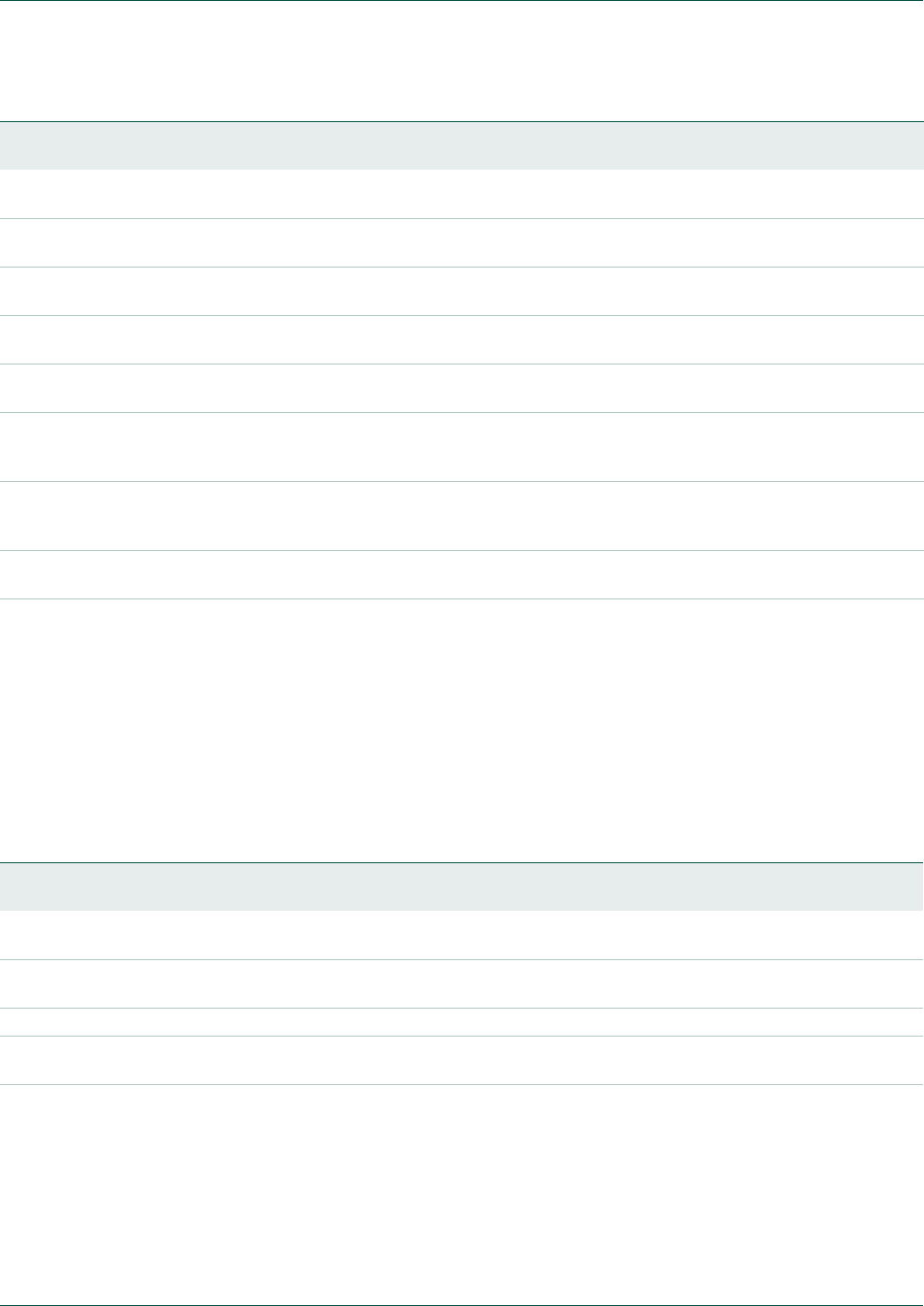
UM10360 All information provided in this document is subject to legal disclaimers. © NXP B.V. 2014. All rights reserved.
User manual Rev. 3.1 — 2 April 2014 370 of 849
NXP Semiconductors UM10360
Chapter 16: LPC176x/5x CAN1/2
16.7.6 CAN Bus Timing Register (CAN1BTR - 0x4004 4014, CAN2BTR -
0x4004 8014)
This register controls how various CAN timings are derived from the APB clock. It defines
the values of the Baud Rate Prescaler (BRP) and the Synchronization Jump Width (SJW).
Furthermore, it defines the length of the bit period, the location of the sample point and the
number of samples to be taken at each sample point. It can be read at any time but can
only be written if the RM bit in CANmod is 1.
4WUIEWake-Up Interrupt Enable. If the sleeping CAN controller wakes up, the respective interrupt
is requested.
0X
5EPIEError Passive Interrupt Enable. If the error status of the CAN Controller changes from error
active to error passive or vice versa, the respective interrupt is requested.
0X
6ALIEArbitration Lost Interrupt Enable. If the CAN Controller has lost arbitration, the respective
interrupt is requested.
0X
7BEIEBus Error Interrupt Enable. If a bus error has been detected, the CAN Controller requests the
respective interrupt.
0X
8IDIEID Ready Interrupt Enable. When a CAN identifier has been received, the CAN Controller
requests the respective interrupt.
0X
9TIE2Transmit Interrupt Enable for Buffer2. When a message has been successfully transmitted
out of TXB2 or Transmit Buffer 2 is accessible again (e.g. after an Abort Transmission
command), the CAN Controller requests the respective interrupt.
0X
10 TIE3 Transmit Interrupt Enable for Buffer3. When a message has been successfully transmitted
out of TXB3 or Transmit Buffer 3 is accessible again (e.g. after an Abort Transmission
command), the CAN Controller requests the respective interrupt.
0X
31:11 - Reserved, user software should not write ones to reserved bits. The value read from a
reserved bit is not defined.
NA
Table 322. CAN Interrupt Enable Register (CAN1IER - address 0x4004 4010, CAN2IER - address 0x4004 8010) bit
description …continued
Bit Symbol Function Reset
Value
RM
Set
Table 323. CAN Bus Timing Register (CAN1BTR - address 0x4004 4014, CAN2BTR - address 0x4004 8014) bit
description
Bit Symbol Value Function Reset
Value
RM
Set
9:0 BRP Baud Rate Prescaler. The APB clock is divided by (this value plus one) to produce the
CAN clock.
0X
13:10 - Reserved, user software should not write ones to reserved bits. The value read from a
reserved bit is not defined.
NA
15:14 SJW The Synchronization Jump Width is (this value plus one) CAN clocks. 0X
19:16 TESG1 The delay from the nominal Sync point to the sample point is (this value plus one)
CAN clocks.
1100 X
22:20 TESG2 The delay from the sample point to the next nominal sync point is (this value plus one)
CAN clocks. The nominal CAN bit time is (this value plus the value in TSEG1 plus 3)
CAN clocks.
001 X

UM10360 All information provided in this document is subject to legal disclaimers. © NXP B.V. 2014. All rights reserved.
User manual Rev. 3.1 — 2 April 2014 371 of 849
NXP Semiconductors UM10360
Chapter 16: LPC176x/5x CAN1/2
Baud rate prescaler
The period of the CAN system clock tSCL is programmable and determines the individual
bit timing. The CAN system clock tSCL is calculated using the following equation:
(7)
Synchronization jump width
To compensate for phase shifts between clock oscillators of different bus controllers, any
bus controller must re-synchronize on any relevant signal edge of the current
transmission. The synchronization jump width tSJW defines the maximum number of clock
cycles a certain bit period may be shortened or lengthened by one re-synchronization:
(8)
Time segment 1 and time segment 2
Time segments TSEG1 and TSEG2 determine the number of clock cycles per bit period
and the location of the sample point:
(9)
(10)
(11)
16.7.7 CAN Error Warning Limit register (CAN1EWL - 0x4004 4018,
CAN2EWL - 0x4004 8018)
This register sets a limit on Tx or Rx errors at which an interrupt can occur. It can be read
at any time but can only be written if the RM bit in CANmod is 1.
23 SAM Sampling
0The bus is sampled once (recommended for high speed buses) 0X
1The bus is sampled 3 times (recommended for low to medium speed buses to filter
spikes on the bus-line)
31:24 - Reserved, user software should not write ones to reserved bits. The value read from a
reserved bit is not defined.
NA
Table 323. CAN Bus Timing Register (CAN1BTR - address 0x4004 4014, CAN2BTR - address 0x4004 8014) bit
description …continued
Bit Symbol Value Function Reset
Value
RM
Set
tSCL tCANsuppliedCLK BRP 1+=
tSJW tSCL SJW 1+=
tSYNCSEG tSCL
=
tTSEG1 tSCL TSEG1 1+=
tTSEG2 tSCL TSEG2 1+=
Table 324. CAN Error Warning Limit register (CAN1EWL - address 0x4004 4018, CAN2EWL - address 0x4004 8018)
bit description
Bit Symbol Function Reset
Value
RM
Set
7:0 EWL During CAN operation, this value is compared to both the Tx and Rx Error Counters. If
either of these counter matches this value, the Error Status (ES) bit in CANSR is set.
9610 = 0x6
0
X
31:8 - Reserved, user software should not write ones to reserved bits. The value read from a
reserved bit is not defined.
NA

UM10360 All information provided in this document is subject to legal disclaimers. © NXP B.V. 2014. All rights reserved.
User manual Rev. 3.1 — 2 April 2014 372 of 849
NXP Semiconductors UM10360
Chapter 16: LPC176x/5x CAN1/2
Note that a content change of the Error Warning Limit Register is possible only if the
Reset Mode was entered previously. An Error Status change (Status Register) and an
Error Warning Interrupt forced by the new register content will not occur until the Reset
Mode is cancelled again.
16.7.8 CAN Status Register (CAN1SR - 0x4004 401C, CAN2SR -
0x4004 801C)
This read-only register contains three status bytes in which the bits not related to
transmission are identical to the corresponding bits in the Global Status Register, while
those relating to transmission reflect the status of each of the 3 Tx Buffers.
Table 325. CAN Status Register (CAN1SR - address 0x4004 401C, CAN2SR - address 0x4004 801C) bit
description
Bit Symbol Value Function Reset
Value
RM
Set
0RBS Receive Buffer Status. This bit is identical to the RBS bit in the CANxGSR. 0 0
1DOS Data Overrun Status. This bit is identical to the DOS bit in the CANxGSR. 0 0
2TBS1
[1] Transmit Buffer Status 1. 11
0(locked) Software cannot access the Tx Buffer 1 nor write to the corresponding
CANxTFI, CANxTID, CANxTDA, and CANxTDB registers because a
message is either waiting for transmission or is in transmitting process.
1(released) Software may write a message into the Transmit Buffer 1 and its CANxTFI,
CANxTID, CANxTDA, and CANxTDB registers.
3TCS1
[2] Transmission Complete Status. 1x
0(incomplete) The previously requested transmission for Tx Buffer 1 is not complete.
1(complete) The previously requested transmission for Tx Buffer 1 has been successfully
completed.
4RS Receive Status. This bit is identical to the RS bit in the GSR. 10
5TS1 Transmit Status 1. 10
0(idle) There is no transmission from Tx Buffer 1.
1(transmit) The CAN Controller is transmitting a message from Tx Buffer 1.
6ES Error Status. This bit is identical to the ES bit in the CANxGSR. 00
7BS Bus Status. This bit is identical to the BS bit in the CANxGSR. 00
8RBS Receive Buffer Status. This bit is identical to the RBS bit in the CANxGSR. 0 0
9DOS Data Overrun Status. This bit is identical to the DOS bit in the CANxGSR. 0 0
10 TBS2[1] Transmit Buffer Status 2. 11
0(locked) Software cannot access the Tx Buffer 2 nor write to the corresponding
CANxTFI, CANxTID, CANxTDA, and CANxTDB registers because a
message is either waiting for transmission or is in transmitting process.
1(released) Software may write a message into the Transmit Buffer 2 and its CANxTFI,
CANxTID, CANxTDA, and CANxTDB registers.
11 TCS2[2] Transmission Complete Status. 1x
0(incomplete) The previously requested transmission for Tx Buffer 2 is not complete.
1(complete) The previously requested transmission for Tx Buffer 2 has been successfully
completed.
12 RS Receive Status. This bit is identical to the RS bit in the GSR. 10

UM10360 All information provided in this document is subject to legal disclaimers. © NXP B.V. 2014. All rights reserved.
User manual Rev. 3.1 — 2 April 2014 373 of 849
NXP Semiconductors UM10360
Chapter 16: LPC176x/5x CAN1/2
[1] If the CPU tries to write to this Transmit Buffer when the Transmit Buffer Status bit is '0' (locked), the written byte is not accepted and is
lost without this being signalled.
[2] The Transmission Complete Status bit is set '0' (incomplete) whenever the Transmission Request bit or the Self Reception Request bit
is set '1' for this TX buffer. The Transmission Complete Status bit remains '0' until a message is transmitted successfully.
16.7.9 CAN Receive Frame Status register (CAN1RFS - 0x4004 4020,
This register defines the characteristics of the current received message. It is read-only in
normal operation but can be written for testing purposes if the RM bit in CANxMOD is 1.
13 TS2 Transmit Status 2. 10
0(idle) There is no transmission from Tx Buffer 2.
1(transmit) The CAN Controller is transmitting a message from Tx Buffer 2.
14 ES Error Status. This bit is identical to the ES bit in the CANxGSR. 00
15 BS Bus Status. This bit is identical to the BS bit in the CANxGSR. 00
16 RBS Receive Buffer Status. This bit is identical to the RBS bit in the CANxGSR. 0 0
17 DOS Data Overrun Status. This bit is identical to the DOS bit in the CANxGSR. 0 0
18 TBS3[1] Transmit Buffer Status 3. 11
0(locked) Software cannot access the Tx Buffer 3 nor write to the corresponding
CANxTFI, CANxTID, CANxTDA, and CANxTDB registers because a
message is either waiting for transmission or is in transmitting process.
1(released) Software may write a message into the Transmit Buffer 3 and its CANxTFI,
CANxTID, CANxTDA, and CANxTDB registers.
19 TCS3[2] Transmission Complete Status. 1x
0(incomplete) The previously requested transmission for Tx Buffer 3 is not complete.
1(complete) The previously requested transmission for Tx Buffer 3 has been successfully
completed.
20 RS Receive Status. This bit is identical to the RS bit in the GSR. 10
21 TS3 Transmit Status 3. 10
0(idle) There is no transmission from Tx Buffer 3.
1(transmit) The CAN Controller is transmitting a message from Tx Buffer 3.
22 ES Error Status. This bit is identical to the ES bit in the CANxGSR. 00
23 BS Bus Status. This bit is identical to the BS bit in the CANxGSR. 00
31:24 - Reserved, the value read from a reserved bit is not defined. NA
Table 325. CAN Status Register (CAN1SR - address 0x4004 401C, CAN2SR - address 0x4004 801C) bit
description …continued
Bit Symbol Value Function Reset
Value
RM
Set

UM10360 All information provided in this document is subject to legal disclaimers. © NXP B.V. 2014. All rights reserved.
User manual Rev. 3.1 — 2 April 2014 374 of 849
NXP Semiconductors UM10360
Chapter 16: LPC176x/5x CAN1/2
16.7.9.1 ID index field
The ID Index is a 10-bit field in the Info Register that contains the table position of the ID
Look-up Table if the currently received message was accepted. The software can use this
index to simplify message transfers from the Receive Buffer into the Shared Message
Memory. Whenever bit 10 (BP) of the ID Index in the CANRFS register is 1, the current
CAN message was received in acceptance filter bypass mode.
16.7.10 CAN Receive Identifier register (CAN1RID - 0x4004 4024, CAN2RID -
0x4004 8024)
This register contains the Identifier field of the current received message. It is read-only in
normal operation but can be written for testing purposes if the RM bit in CANmod is 1. It
has two different formats depending on the FF bit in CANRFS. See Table 3 1 4 for details
on specific CAN channel register address.
Table 326. CAN Receive Frame Status register (CAN1RFS - address 0x4004 4020, CAN2RFS - address 0x4004 8020)
bit description
Bit Symbol Function Reset
Value
RM
Set
9:0 ID Index If the BP bit (below) is 0, this value is the zero-based number of the Lookup Table RAM entry
at which the Acceptance Filter matched the received Identifier. Disabled entries in the
Standard tables are included in this numbering, but will not be matched. See Section 16.17
“Examples of acceptance filter tables and ID index values” on page 402 for examples of ID
Index values.
0X
10 BP If this bit is 1, the current message was received in AF Bypass mode, and the ID Index field
(above) is meaningless.
0X
15:11 - Reserved, user software should not write ones to reserved bits. The value read from a
reserved bit is not defined.
NA
19:16 DLC The field contains the Data Length Code (DLC) field of the current received message. When
RTR = 0, this is related to the number of data bytes available in the CANRDA and CANRDB
registers as follows:
0000-0111 = 0 to 7 bytes1000-1111 = 8 bytes
With RTR = 1, this value indicates the number of data bytes requested to be sent back, with
the same encoding.
0X
29:20 - Reserved, user software should not write ones to reserved bits. The value read from a
reserved bit is not defined.
NA
30 RTR This bit contains the Remote Transmission Request bit of the current received message. 0
indicates a Data Frame, in which (if DLC is non-zero) data can be read from the CANRDA
and possibly the CANRDB registers. 1 indicates a Remote frame, in which case the DLC
value identifies the number of data bytes requested to be sent using the same Identifier.
0X
31 FF A 0 in this bit indicates that the current received message included an 11-bit Identifier, while
a 1 indicates a 29-bit Identifier. This affects the contents of the CANid register described
below.
0X
Table 327. CAN Receive Identifier register (CAN1RID - address 0x4004 4024, CAN2RID - address 0x4004 8024) bit
description
Bit Symbol Function Reset Value RM Set
10:0 ID The 11-bit Identifier field of the current received message. In CAN 2.0A, these
bits are called ID10-0, while in CAN 2.0B they’re called ID29-18.
0X
31:11 - Reserved, user software should not write ones to reserved bits. The value read
from a reserved bit is not defined.
NA
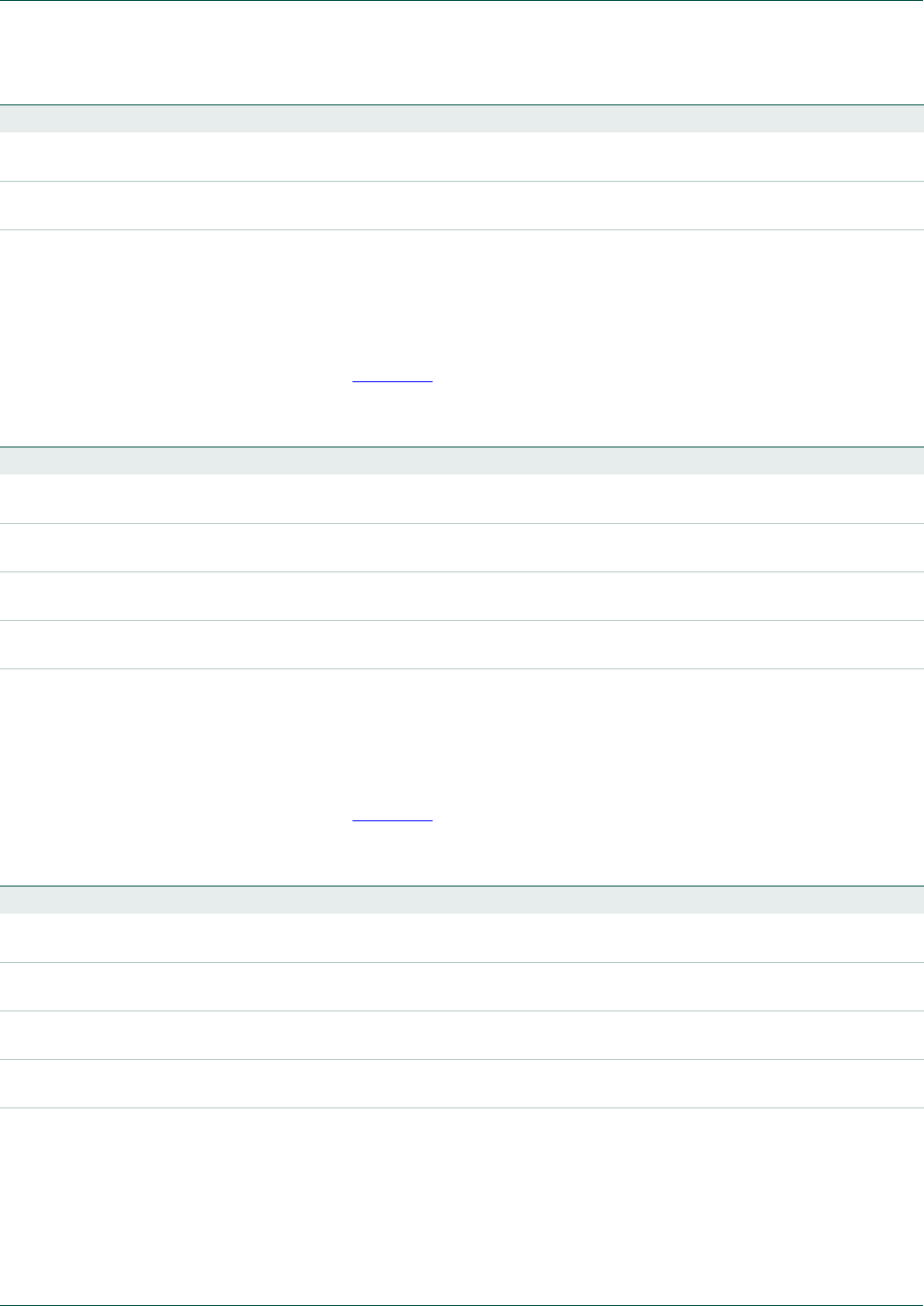
UM10360 All information provided in this document is subject to legal disclaimers. © NXP B.V. 2014. All rights reserved.
User manual Rev. 3.1 — 2 April 2014 375 of 849
NXP Semiconductors UM10360
Chapter 16: LPC176x/5x CAN1/2
16.7.11 CAN Receive Data register A (CAN1RDA - 0x4004 4028, CAN2RDA -
0x4004 8028)
This register contains the first 1-4 Data bytes of the current received message. It is
read-only in normal operation, but can be written for testing purposes if the RM bit in
CANMOD is 1. See Table 3 1 4 for details on specific CAN channel register address.
16.7.12 CAN Receive Data register B (CAN1RDB - 0x4004 402C, CAN2RDB -
0x4004 802C)
This register contains the 5th through 8th Data bytes of the current received message. It is
read-only in normal operation, but can be written for testing purposes if the RM bit in
CANMOD is 1. See Table 3 1 4 for details on specific CAN channel register address.
16.7.13 CAN Transmit Frame Information register (CAN1TFI[1/2/3] -
0x4004 40[30/ 40/50], CAN2TFI[1/2/3] - 0x4004 80[30/40/50])
When the corresponding TBS bit in CANSR is 1, software can write to one of these
registers to define the format of the next transmit message for that Tx buffer. Bits not listed
read as 0 and should be written as 0.
Table 328. RX Identifier register when FF = 1
Bit Symbol Function Reset Value RM Set
28:0 ID The 29-bit Identifier field of the current received message. In CAN 2.0B these bits
are called ID29-0.
0X
31:29 - Reserved, user software should not write ones to reserved bits. The value read
from a reserved bit is not defined.
NA
Table 329. CAN Receive Data register A (CAN1RDA - address 0x4004 4028, CAN2RDA - address 0x4004 8028) bit
description
Bit Symbol Function Reset Value RM Set
7:0 Data 1 If the DLC field in CANRFS ³ 0001, this contains the first Data byte of the current
received message.
0X
15:8 Data 2 If the DLC field in CANRFS ³ 0010, this contains the first Data byte of the current
received message.
0X
23:16 Data 3 If the DLC field in CANRFS ³ 0011, this contains the first Data byte of the current
received message.
0X
31:24 Data 4 If the DLC field in CANRFS ³ 0100, this contains the first Data byte of the current
received message.
0X
Table 330. CAN Receive Data register B (CAN1RDB - address 0x4004 402C, CAN2RDB - address 0x4004 802C) bit
description
Bit Symbol Function Reset Value RM Set
7:0 Data 5 If the DLC field in CANRFS ³ 0101, this contains the first Data byte of the current
received message.
0X
15:8 Data 6 If the DLC field in CANRFS ³ 0110, this contains the first Data byte of the current
received message.
0X
23:16 Data 7 If the DLC field in CANRFS ³ 0111, this contains the first Data byte of the current
received message.
0X
31:24 Data 8 If the DLC field in CANRFS ³ 1000, this contains the first Data byte of the current
received message.
0X
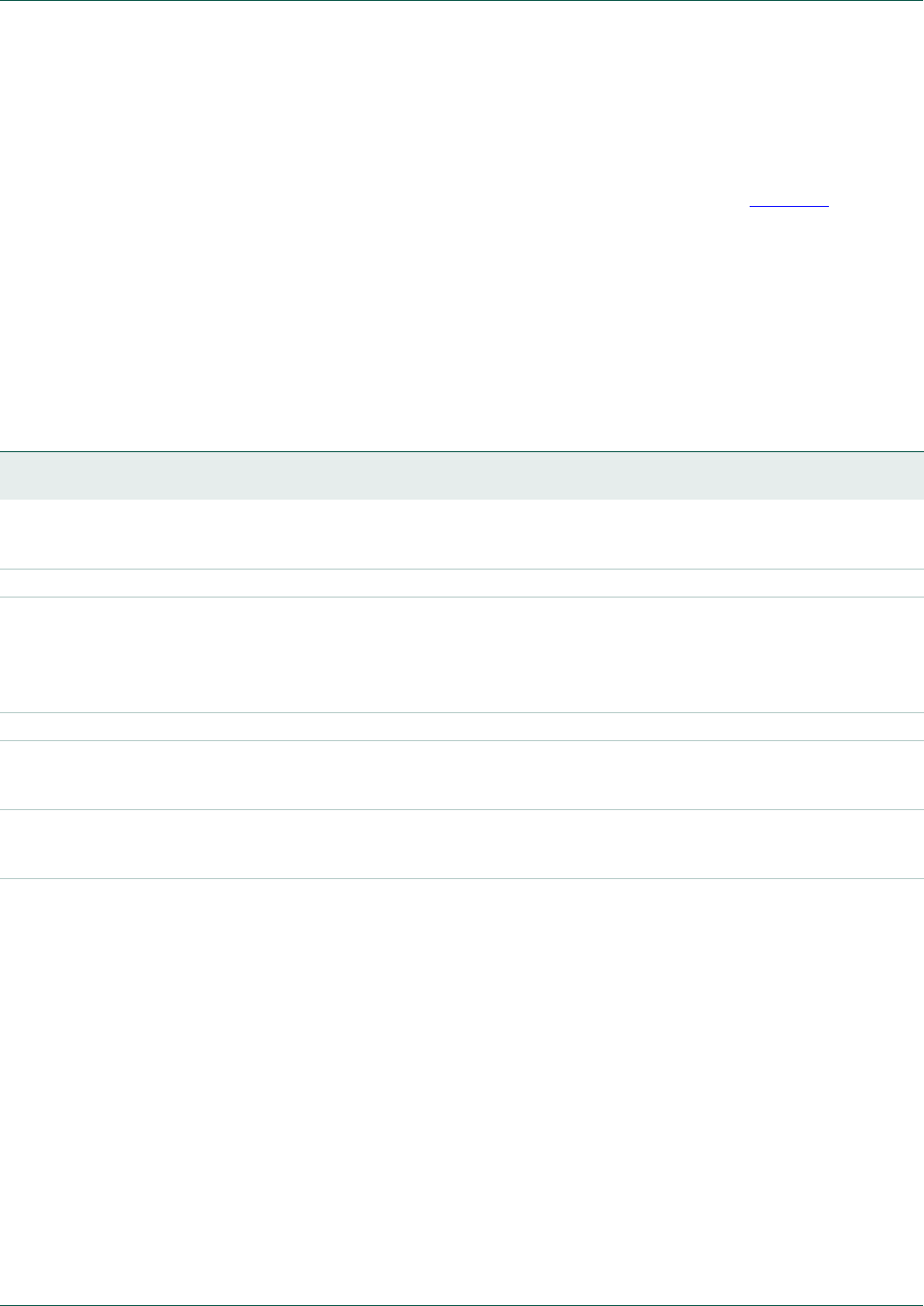
UM10360 All information provided in this document is subject to legal disclaimers. © NXP B.V. 2014. All rights reserved.
User manual Rev. 3.1 — 2 April 2014 376 of 849
NXP Semiconductors UM10360
Chapter 16: LPC176x/5x CAN1/2
The values for the reserved bits of the CANxTFI register in the Transmit Buffer should be
set to the values expected in the Receive Buffer for an easy comparison, when using the
Self Reception facility (self test), otherwise they are not defined.
The CAN Controller consist of three Transmit Buffers. Each of them has a length of 4
words and is able to store one complete CAN message as shown in Figure 55.
The buffer layout is subdivided into Descriptor and Data Field where the first word of the
Descriptor Field includes the TX Frame Info that describes the Frame Format, the Data
Length and whether it is a Remote or Data Frame. In addition, a TX Priority register allows
the definition of a certain priority for each transmit message. Depending on the chosen
Frame Format, an 11-bit identifier for Standard Frame Format (SFF) or an 29-bit identifier
for Extended Frame Format (EFF) follows. Note that unused bits in the TID field have to
be defined as 0. The Data Field in TDA and TDB contains up to eight data bytes.
Automatic transmit priority detection
To allow uninterrupted streams of transmit messages, the CAN Controller provides
Automatic Transmit Priority Detection for all Transmit Buffers. Depending on the selected
Transmit Priority Mode, internal prioritization is based on the CAN Identifier or a user
defined "local priority". If more than one message is enabled for transmission (TR=1) the
internal transmit message queue is organized such as that the transmit buffer with the
lowest CAN Identifier (TID) or the lowest "local priority" (TX Priority) wins the prioritization
and is sent first. The result of the internal scheduling process is taken into account short
before a new CAN message is sent on the bus. This is also true after the occurrence of a
transmission error and right before a re-transmission.
Tx DLC
The number of bytes in the Data Field of a message is coded with the Data Length Code
(DLC). At the start of a Remote Frame transmission the DLC is not considered due to the
RTR bit being '1 ' (remote). This forces the number of transmitted/received data bytes to
be 0. Nevertheless, the DLC must be specified correctly to avoid bus errors, if two CAN
Table 331. CAN Transmit Frame Information register (CAN1TFI[1/2/3] - address 0x4004 40[30/40/50], CAN2TFI[1/2/3] -
0x4004 80[30/40/50]) bit description
Bit Symbol Function Reset
Value
RM
Set
7:0 PRIO If the TPM (Transmit Priority Mode) bit in the CANxMOD register is set to 1, enabled Tx
Buffers contend for the right to send their messages based on this field. The buffer with the
lowest TX Priority value wins the prioritization and is sent first.
x
15:8 - Reserved. 0
19:16 DLC Data Length Code. This value is sent in the DLC field of the next transmit message. In
addition, if RTR = 0, this value controls the number of Data bytes sent in the next transmit
message, from the CANxTDA and CANxTDB registers:
0000-0111 = 0-7 bytes
1xxx = 8 bytes
0X
29:20 - Reserved. 0
30 RTR This value is sent in the RTR bit of the next transmit message. If this bit is 0, the number of
data bytes called out by the DLC field are sent from the CANxTDA and CANxTDB registers.
If this bit is 1, a Remote Frame is sent, containing a request for that number of bytes.
0X
31 FF If this bit is 0, the next transmit message will be sent with an 11-bit Identifier (standard frame
format), while if it’s 1, the message will be sent with a 29-bit Identifier (extended frame
format).
0X

UM10360 All information provided in this document is subject to legal disclaimers. © NXP B.V. 2014. All rights reserved.
User manual Rev. 3.1 — 2 April 2014 377 of 849
NXP Semiconductors UM10360
Chapter 16: LPC176x/5x CAN1/2
Controllers start a Remote Frame transmission with the same identifier simultaneously.
For reasons of compatibility no DLC > 8 should be used. If a value greater than 8 is
selected, 8 bytes are transmitted in the data frame with the Data Length Code specified in
DLC. The range of the Data Byte Count is 0 to 8 bytes and is coded as follows:
(12)
16.7.14 CAN Transmit Identifier register (CAN1TID[1/2/3] -
0x4004 40[34/44/54], CAN2TID[1/2/3] - 0x4004 80[34/44/54])
When the corresponding TBS bit in CANxSR is 1, software can write to one of these
registers to define the Identifier field of the next transmit message. Bits not listed read as 0
and should be written as 0. The register assumes two different formats depending on the
FF bit in CANTFI.
In Standard Frame Format messages, the CAN Identifier consists of 11 bits (ID.28 to
ID.18), and in Extended Frame Format messages, the CAN identifier consists of 29 bits
(ID.28 to ID.0). ID.28 is the most significant bit, and it is transmitted first on the bus during
the arbitration process. The Identifier acts as the message's name, used in a receiver for
acceptance filtering, and also determines the bus access priority during the arbitration
process.
16.7.15 CAN Transmit Data register A (CAN1TDA[1/2/3] - 0x4004 40[38/48/58],
CAN2TDA[1/2/3] - 0x4004 80[38/48/58])
When the corresponding TBS bit in CANSR is 1, software can write to one of these
registers to define the first 1 - 4 data bytes of the next transmit message. The Data Length
Code defines the number of transferred data bytes. The first bit transmitted is the most
significant bit of TX Data Byte 1.
DataByteCount DLC=
Table 332. CAN Transfer Identifier register (CAN1TID[1/2/3] - address 0x4004 40[34/44/54], CAN2TID[1/2/3] - address
0x4004 80[34/44/54]) bit description
Bit Symbol Function Reset Value RM Set
10:0 ID The 11-bit Identifier to be sent in the next transmit message. 0 X
31:11 - Reserved, user software should not write ones to reserved bits. The value read
from a reserved bit is not defined.
NA
Table 333. Transfer Identifier register when FF = 1
Bit Symbol Function Reset Value RM Set
28:0 ID The 29-bit Identifier to be sent in the next transmit message. 0 X
31:29 - Reserved, user software should not write ones to reserved bits. The value read
from a reserved bit is not defined.
NA
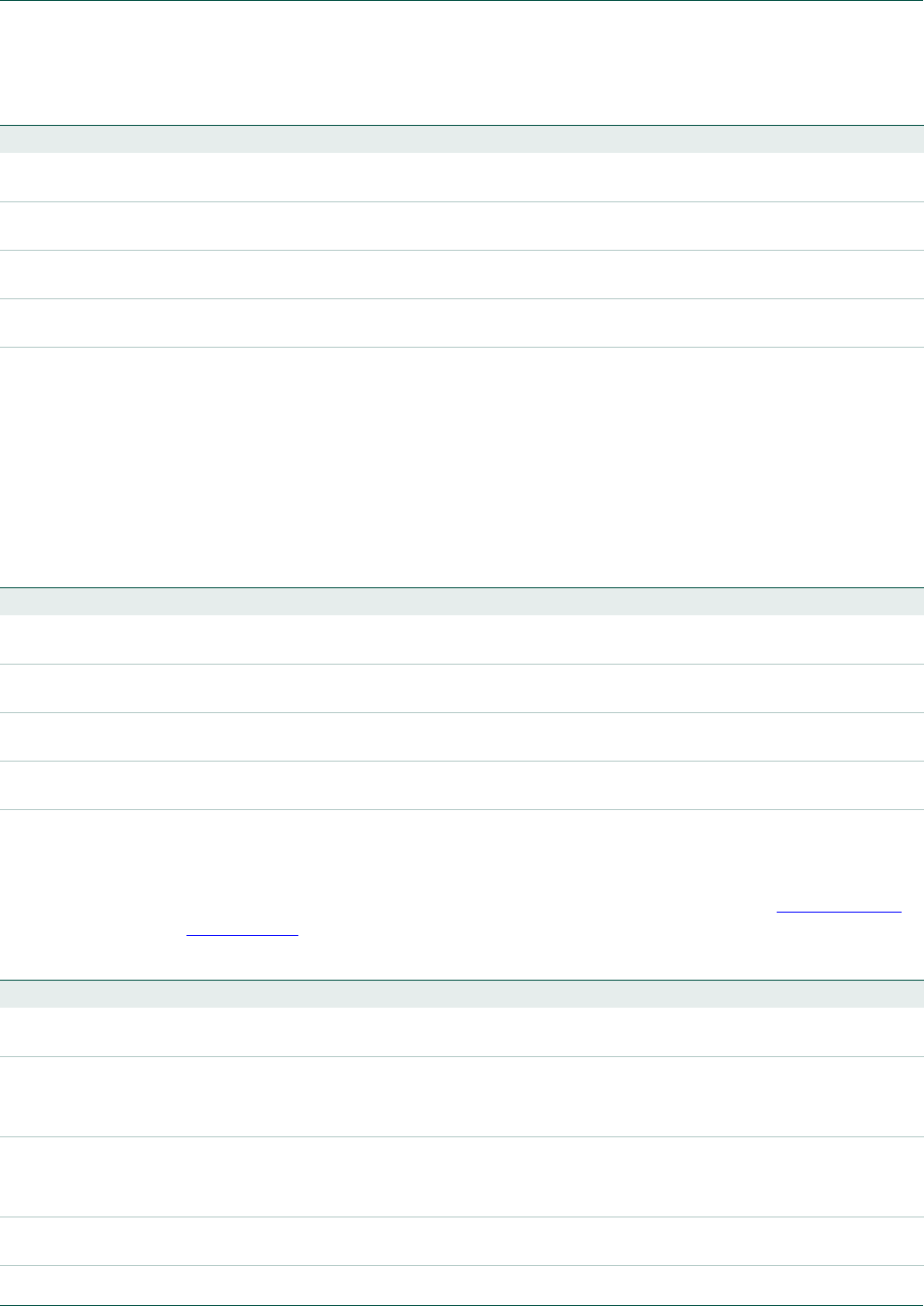
UM10360 All information provided in this document is subject to legal disclaimers. © NXP B.V. 2014. All rights reserved.
User manual Rev. 3.1 — 2 April 2014 378 of 849
NXP Semiconductors UM10360
Chapter 16: LPC176x/5x CAN1/2
16.7.16 CAN Transmit Data register B (CAN1TDB[1/2/3] -
0x4004 40[3C/4C/5C], CAN2TDB[1/2/3] - 0x4004 80[3C/4C/5C])
When the corresponding TBS bit in CANSR is 1, software can write to one of these
registers to define the 5th through 8th data bytes of the next transmit message. The Data
Length Code defines the number of transferred data bytes. The first bit transmitted is the
most significant bit of TX Data Byte 1.
16.7.17 CAN Sleep Clear register (CANSLEEPCLR - 0x400F C110)
This register provides the current sleep state of the two CAN channels and provides a
means to restore the clocks to that channel following wake-up. Refer to Section 16.8.2
“Sleep mode” for more information on the CAN sleep feature.
Table 334. CAN Transmit Data register A (CAN1TDA[1/2/3] - address 0x4004 40[38/48/58], CAN2TDA[1/2/3] - address
0x4004 80[38/48/58]) bit description
Bit Symbol Function Reset Value RM Set
7:0 Data 1 If RTR = 0 and DLC ³ 0001 in the corresponding CANxTFI, this byte is sent as the
first Data byte of the next transmit message.
0X
15;8 Data 2 If RTR = 0 and DLC ³ 0010 in the corresponding CANxTFI, this byte is sent as the
2nd Data byte of the next transmit message.
0X
23:16 Data 3 If RTR = 0 and DLC ³ 0011 in the corresponding CANxTFI, this byte is sent as the
3rd Data byte of the next transmit message.
0X
31:24 Data 4 If RTR = 0 and DLC ³ 0100 in the corresponding CANxTFI, this byte is sent as the
4th Data byte of the next transmit message.
0X
Table 335. CAN Transmit Data register B (CAN1TDB[1/2/3] - address 0x4004 40[3C/4C/5C], CAN2TDB[1/2/3] - address
0x4004 80[3C/4C/5C]) bit description
Bit Symbol Function Reset Value RM Set
7:0 Data 5 If RTR = 0 and DLC ³ 0101 in the corresponding CANTFI, this byte is sent as the
5th Data byte of the next transmit message.
0X
15;8 Data 6 If RTR = 0 and DLC ³ 0110 in the corresponding CANTFI, this byte is sent as the
6th Data byte of the next transmit message.
0X
23:16 Data 7 If RTR = 0 and DLC ³ 0111 in the corresponding CANTFI, this byte is sent as the
7th Data byte of the next transmit message.
0X
31:24 Data 8 If RTR = 0 and DLC ³ 1000 in the corresponding CANTFI, this byte is sent as the
8th Data byte of the next transmit message.
0X
Table 336. CAN Sleep Clear register (CANSLEEPCLR - address 0x400F C110) bit description
Bit Symbol Function Reset Value
0- Reserved, user software should not write ones to reserved bits. The value read from a
reserved bit is not defined.
NA
1CAN1SLEEPSleep status and control for CAN channel 1.
Read: when 1, indicates that CAN channel 1 is in the sleep mode.
Write: writing a 1 causes clocks to be restored to CAN channel 1.
0
2CAN2SLEEPSleep status and control for CAN channel 2.
Read: when 1, indicates that CAN channel 2 is in the sleep mode.
Write: writing a 1 causes clocks to be restored to CAN channel 2.
0
31:3 - Reserved, user software should not write ones to reserved bits. The value read from a
reserved bit is not defined.
NA

UM10360 All information provided in this document is subject to legal disclaimers. © NXP B.V. 2014. All rights reserved.
User manual Rev. 3.1 — 2 April 2014 379 of 849
NXP Semiconductors UM10360
Chapter 16: LPC176x/5x CAN1/2
16.7.18 CAN Wake-up Flags register (CANWAKEFLAGS - 0x400F C114)
This register provides the wake-up status for the two CAN channels and allows clearing
wake-up events. Refer to Section 16.8.2 “Sleep mode” for more information on the CAN
sleep feature.
16.8 CAN controller operation
16.8.1 Error handling
The CAN Controllers count and handle transmit and receive errors as specified in CAN
Spec 2.0B. The Transmit and Receive Error Counters are incriminated for each detected
error and are decremented when operation is error-free. If the Transmit Error counter
contains 255 and another error occurs, the CAN Controller is forced into a state called
Bus-Off. In this state, the following register bits are set: BS in CANxSR, BEI and EI in
CANxIR if these are enabled, and RM in CANxMOD. RM resets and disables much of the
CAN Controller. Also at this time the Transmit Error Counter is set to 127 and the Receive
Error Counter is cleared. Software must next clear the RM bit. Thereafter the Transmit
Error Counter will count down 128 occurrences of the Bus Free condition (11 consecutive
recessive bits). Software can monitor this countdown by reading the Tx Error Counter.
When this countdown is complete, the CAN Controller clears BS and ES in CANxSR, and
sets EI in CANxSR if EIE in IER is 1.
The Tx and Rx error counters can be written if RM in CANxMOD is 1. Writing 255 to the
Tx Error Counter forces the CAN Controller to Bus-Off state. If Bus-Off (BS in CANxSR) is
1, writing any value 0 through 254 to the Tx Error Counter clears Bus-Off. When software
clears RM in CANxMOD thereafter, only one Bus Free condition (11 consecutive
recessive bits) is needed before operation resumes.
16.8.2 Sleep mode
The CAN Controller will enter sleep mode if the SM bit in the CAN Mode register is 1, no
CAN interrupt is pending, and there is no activity on the CAN bus. Software can only set
SM when RM in the CAN Mode register is 0; it can also set the WUIE bit in the CAN
Interrupt Enable register to enable an interrupt on any wake-up condition.
Table 337. CAN Wake-up Flags register (CANWAKEFLAGS - address 0x400F C114) bit description
Bit Symbol Function Reset Value
0- Reserved, user software should not write ones to reserved bits. The value read from
a reserved bit is not defined.
NA
1CAN1WAKEWake-up status for CAN channel 1.
Read: when 1, indicates that a falling edge has occurred on the receive data line of
CAN channel 1.
Write: writing a 1 clears this bit.
0
2CAN2WAKEWake-up status for CAN channel 2.
Read: when 1, indicates that a falling edge has occurred on the receive data line of
CAN channel 2.
Write: writing a 1 clears this bit.
0
31:3 - Reserved, user software should not write ones to reserved bits. The value read from
a reserved bit is not defined.
NA

UM10360 All information provided in this document is subject to legal disclaimers. © NXP B.V. 2014. All rights reserved.
User manual Rev. 3.1 — 2 April 2014 380 of 849
NXP Semiconductors UM10360
Chapter 16: LPC176x/5x CAN1/2
The CAN Controller wakes up (and sets WUI in the CAN Interrupt register if WUIE in the
CAN Interrupt Enable register is 1) in response to a) a dominant bit on the CAN bus, or b)
software clearing SM in the CAN Mode register. A sleeping CAN Controller that wakes up
in response to bus activity is not able to receive an initial message until after it detects
Bus_Free (11 consecutive recessive bits). If an interrupt is pending or the CAN bus is
active when software sets SM, the wake-up is immediate.
Upon wake-up, software needs to do the following things:
1. Write a 1 to the relevant bit(s) in the CANSLEEPCLR register.
2. Write a 0 to the SM bit in the CAN1MOD and/or CAN2MOD register.
3. Write a 1 to the relevant bit(s) in the CANWAKEFLAGS register. Failure to perform
this step will prevent subsequent entry into Power-down mode.
If the LPC176x/5x is in Deep Sleep or Power-down mode, CAN activity will wake up the
device if the CAN activity interrupt is enabled. See Section 4.8 “Power control”.
16.8.3 Interrupts
Each CAN Controller produces 3 interrupt requests, Receive, Transmit, and “other status”.
The Transmit interrupt is the OR of the Transmit interrupts from the three Tx Buffers. Each
interrupt request will trigger the CAN common interrupt in the NVIC.The “other status”
interrupts from all of the CAN controllers, and the Acceptance Filter LUTerr condition, are
ORed into one NVIC channel.
16.8.4 Transmit priority
If the TPM bit in the CANxMOD register is 0, multiple enabled Tx Buffers contend for the
right to send their messages based on the value of their CAN Identifier (TID). If TPM is 1,
they contend based on the PRIO fields in bits 7:0 of their CANxTFS registers. In both
cases the smallest binary value has priority. If two (or three) transmit-enabled buffers have
the same smallest value, the lowest-numbered buffer sends first.
The CAN controller selects among multiple enabled Tx Buffers dynamically, just before it
sends each message.
16.9 Centralized CAN registers
For easy and fast access, all CAN Controller Status bits from each CAN Controller Status
register are bundled together. Each defined byte of the following registers contains one
particular status bit from each of the CAN controllers, in its LS bits.
All Status registers are read-only and allow byte, half word and word access.

UM10360 All information provided in this document is subject to legal disclaimers. © NXP B.V. 2014. All rights reserved.
User manual Rev. 3.1 — 2 April 2014 381 of 849
NXP Semiconductors UM10360
Chapter 16: LPC176x/5x CAN1/2
16.9.1 Central Transmit Status Register (CANTxSR - 0x4004 0000)
16.9.2 Central Receive Status Register (CANRxSR - 0x4004 0004)
Table 338. Central Transit Status Register (CANTxSR - address 0x4004 0000) bit description
Bit Symbol Description Reset Value
0TS1 When 1, the CAN controller 1 is sending a message (same as TS in the CAN1GSR). 0
1TS2 When 1, the CAN controller 2 is sending a message (same as TS in the CAN2GSR) 0
7:2 - Reserved, user software should not write ones to reserved bits. The value read from a
reserved bit is not defined.
NA
8TBS1When 1, all 3 Tx Buffers of the CAN1 controller are available to the CPU (same as TBS in
CAN1GSR).
1
9TBS2When 1, all 3 Tx Buffers of the CAN2 controller are available to the CPU (same as TBS in
CAN2GSR).
1
15:10 - Reserved, user software should not write ones to reserved bits. The value read from a
reserved bit is not defined.
NA
16 TCS1 When 1, all requested transmissions have been completed successfully by the CAN1
controller (same as TCS in CAN1GSR).
1
17:16 TCS2 When 1, all requested transmissions have been completed successfully by the CAN2
controller (same as TCS in CAN2GSR).
1
31:18 - Reserved, the value read from a reserved bit is not defined. NA
Table 339. Central Receive Status Register (CANRxSR - address 0x4004 0004) bit description
Bit Symbol Description Reset Value
0 RS1 When 1, CAN1 is receiving a message (same as RS in CAN1GSR). 0
1 RS2 When 1, CAN2 is receiving a message (same as RS in CAN2GSR). 0
7:2 - Reserved, user software should not write ones to reserved bits. The value read from a
reserved bit is not defined.
NA
8RB1 When 1, a received message is available in the CAN1 controller (same as RBS in
CAN1GSR).
0
9RB2 When 1, a received message is available in the CAN2 controller (same as RBS in
CAN2GSR).
0
15:10 - Reserved, user software should not write ones to reserved bits. The value read from a
reserved bit is not defined.
NA
16 DOS1 When 1, a message was lost because the preceding message to CAN1 controller was not
read out quickly enough (same as DOS in CAN1GSR).
0
17:16 DOS2 When 1, a message was lost because the preceding message to CAN2 controller was not
read out quickly enough (same as DOS in CAN2GSR).
0
31:18 - Reserved, the value read from a reserved bit is not defined. NA
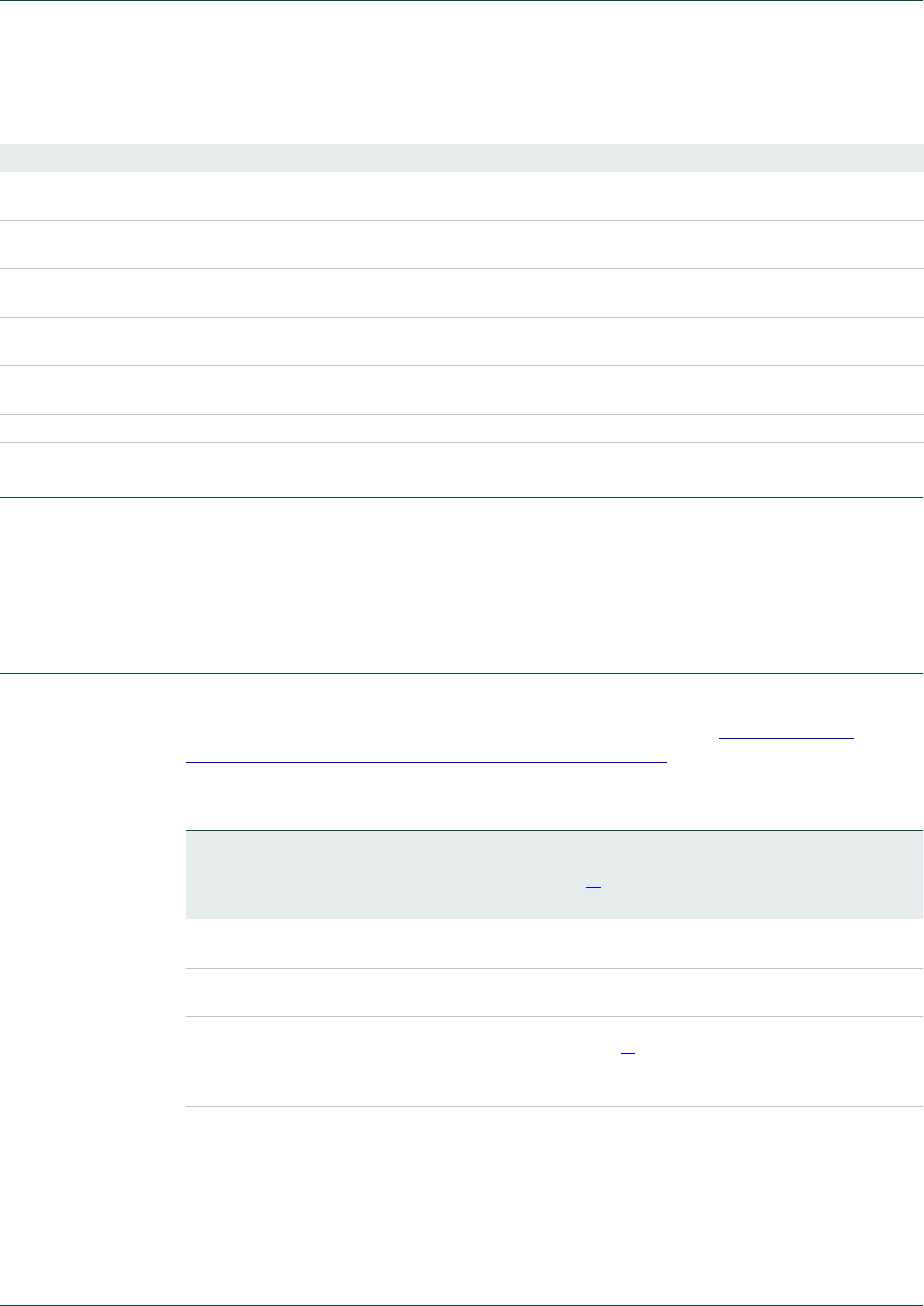
UM10360 All information provided in this document is subject to legal disclaimers. © NXP B.V. 2014. All rights reserved.
User manual Rev. 3.1 — 2 April 2014 382 of 849
NXP Semiconductors UM10360
Chapter 16: LPC176x/5x CAN1/2
16.9.3 Central Miscellaneous Status Register (CANMSR - 0x4004 0008)
16.10 Global acceptance filter
This block provides lookup for received Identifiers (called Acceptance Filtering in CAN
terminology) for all the CAN Controllers. It includes a 512 32 (2 kB) RAM in which
software maintains one to five tables of Identifiers. This RAM can contain up to 1024
Standard Identifiers or 512 Extended Identifiers, or a mixture of both types.
16.11 Acceptance filter modes
The Acceptance Filter can be put into different modes by setting the according AccOff,
AccBP, and eFCAN bits in the Acceptance Filter Mode Register (Section 16.14.1
“Acceptance Filter Mode Register (AFMR - 0x4003 C000)”). During each mode the
access to the Configuration Register and the ID Look-up table is handled differently.
[1] The whole ID Look-up Table RAM is only word accessible.
[2] During the Operating Mode of the Acceptance Filter the Look-up Table can be accessed only to disable or
enable Messages.
A write access to all section configuration registers is only possible during the Acceptance
Filter Off and Bypass Mode. Read access is allowed in all Acceptance Filter Modes.
Table 340. Central Miscellaneous Status Register (CANMSR - address 0x4004 0008) bit description
Bit Symbol Description Reset Value
0E1 When 1, one or both of the CAN1 Tx and Rx Error Counters has reached the limit set in the
CAN1EWL register (same as ES in CAN1GSR)
0
1E2 When 1, one or both of the CAN2 Tx and Rx Error Counters has reached the limit set in the
CAN2EWL register (same as ES in CAN2GSR)
0
7:2 - Reserved, user software should not write ones to reserved bits. The value read from a
reserved bit is not defined.
NA
8BS1 When 1, the CAN1 controller is currently involved in bus activities (same as BS in
CAN1GSR).
0
9BS2 When 1, the CAN2 controller is currently involved in bus activities (same as BS in
CAN2GSR).
0
31:10 - Reserved, the value read from a reserved bit is not defined. NA
Table 341. Acceptance filter modes and access control
Acceptance
filter mode
Bit
AccOff
Bit
AccBP
Acceptance
filter state
ID Look-up
table
RAM[1]
Acceptanc
e filter
config.
registers
CAN controller
message receive
interrupt
Off Mode 1 0 reset &
halted
r/w access
from CPU
r/w access
from CPU
no messages
accepted
Bypass
Mode
X1reset &
halted
r/w access
from CPU
r/w access
from CPU
all messages
accepted
Operating
Mode and
FullCAN
Mode
00runningread-only
from CPU[2]
access from
Acceptance
filter only
hardware
acceptance filtering

UM10360 All information provided in this document is subject to legal disclaimers. © NXP B.V. 2014. All rights reserved.
User manual Rev. 3.1 — 2 April 2014 383 of 849
NXP Semiconductors UM10360
Chapter 16: LPC176x/5x CAN1/2
16.11.1 Acceptance filter Off mode
The Acceptance Filter Off Mode is typically used during initialization. During this mode an
unconditional access to all registers and to the Look-up Table RAM is possible. With the
Acceptance Filter Off Mode, CAN messages are not accepted and therefore not stored in
the Receive Buffers of active CAN Controllers.
16.11.2 Acceptance filter Bypass mode
The Acceptance Filter Bypass Mode can be used for example to change the acceptance
filter configuration during a running system, e.g. change of identifiers in the ID-Look-up
Table memory. During this re-configuration, software acceptance filtering has to be used.
It is recommended to use the ID ready Interrupt (ID Index) and the Receive Interrupt (RI).
In this mode all CAN message are accepted and stored in the Receive Buffers of active
CAN Controllers.
16.11.3 Acceptance filter Operating mode
The Acceptance Filter is in Operating Mode when neither the AccOff nor the AccBP in the
Configuration Register is set and the eFCAN = 0.
16.11.4 FullCAN mode
The Acceptance Filter is in Operating Mode when neither the AccOff nor the AccBP in the
Configuration Register is set and the eFCAN = 1. More details on FullCAN mode are
available in Section 16.16 “FullCAN mode”.
16.12 Sections of the ID look-up table RAM
Four 12-bit section configuration registers (SFF_sa, SFF_GRP_sa, EFF_sa,
EFF_GRP_sa) are used to define the boundaries of the different identifier sections in the
ID-Look-up Table Memory. The fifth 12-bit section configuration register, the End of Table
address register (ENDofTable) is used to define the end of all identifier sections. The End
of Table address is also used to assign the start address of the section where FullCAN
Message Objects, if enabled are stored.
Table 342. Section configuration register settings
ID-Look up Table Section Register Value Section
status
FullCAN (Standard Frame Format) Identifier Section SFF_sa = 0x000 disabled
>0x000 enabled
Explicit Standard Frame Format Identifier Section SFF_GRP_sa = SFF_sa disabled
>SFF_sa enabled
Group of Standard Frame Format Identifier Section EFF_sa = SFF_GRP_sa disabled
>SFF_GRP_sa enabled
Explicit Extended Frame Format Identifier Section EFF_GRP_sa = EFF_sa disabled
>EFF_sa enabled
Group of Extended Frame Format Identifier Section ENDofTable = EFF_GRP_sa disabled
>EFF_GRP_sa enabled

UM10360 All information provided in this document is subject to legal disclaimers. © NXP B.V. 2014. All rights reserved.
User manual Rev. 3.1 — 2 April 2014 384 of 849
NXP Semiconductors UM10360
Chapter 16: LPC176x/5x CAN1/2
16.13 ID look-up table RAM
The Whole ID Look-up Table RAM is only word accessible. A write access is only possible
during the Acceptance Filter Off or Bypass Mode. Read access is allowed in all
Acceptance Filter Modes.
If Standard (11-bit) Identifiers are used in the application, at least one of 3 tables in
Acceptance Filter RAM must not be empty. If the optional “FullCAN mode” is enabled, the
first table contains Standard identifiers for which reception is to be handled in this mode.
The next table contains individual Standard Identifiers and the third contains ranges of
Standard Identifiers, for which messages are to be received via the CAN Controllers. The
tables of FullCAN and individual Standard Identifiers must be arranged in ascending
numerical order, one per halfword, two per word. Since each CAN bus has its own
address map, each entry also contains the number of the CAN Controller (SCC = 000
(CAN1) -or SCC = 001 (CAN2)) to which it applies.
The table of Standard Identifier Ranges contains paired upper and lower (inclusive)
bounds, one pair per word. These must also be arranged in ascending numerical order.
The disable bits in Standard entries provide a means to turn response, to particular CAN
Identifiers or ranges of Identifiers, on and off dynamically. When the Acceptance Filter
function is enabled, only the disable bits in Acceptance Filter RAM can be changed by
software. Response to a range of Standard addresses can be enabled by writing 32 zero
bits to its word in RAM, and turned off by writing 32 one bits (0xFFFF FFFF) to its word in
RAM. Only the disable bits are actually changed. Disabled entries must maintain the
ascending sequence of Identifiers.
If Extended (29-bit) Identifiers are used in the application, at least one of the other two
tables in Acceptance Filter RAM must not be empty, one for individual Extended Identifiers
and one for ranges of Extended Identifiers. The table of individual Extended Identifiers
must be arranged in ascending numerical order.
Fig 59. Entry in FullCAN and individual standard identifier tables
Fig 60. Entry in standard identifier range table
CONTROLLER # IDENTIFIER
DIS
ABLE
NOT
USED
31
15
29
13
26
10
16
0
CONTROLLER
#
LOWER IDENTIFIER
BOUND
DISABLE
NOT USED
UPPER IDENTIFIER
BOUND
DISABLE
NOT USED
CONTROLLER
#
31 29 26 16 10 0

UM10360 All information provided in this document is subject to legal disclaimers. © NXP B.V. 2014. All rights reserved.
User manual Rev. 3.1 — 2 April 2014 385 of 849
NXP Semiconductors UM10360
Chapter 16: LPC176x/5x CAN1/2
The table of ranges of Extended Identifiers must contain an even number of entries, of the
same form as in the individual Extended Identifier table. Like the Individual Extended
table, the Extended Range must be arranged in ascending numerical order. The first and
second (3rd and 4th …) entries in the table are implicitly paired as an inclusive range of
Extended addresses, such that any received address that falls in the inclusive range is
received (accepted). Software must maintain the table to consist of such word pairs.
There is no facility to receive messages to Extended identifiers using the FullCAN
method.
Five address registers point to the boundaries between the tables in Acceptance Filter
RAM: FullCAN Standard addresses, Standard Individual addresses, Standard address
ranges, Extended Individual addresses, and Extended address ranges. These tables
must be consecutive in memory. The start of each of the latter four tables is implicitly the
end of the preceding table. The end of the Extended range table is given in an End of
Tables register. If the start address of a table equals the start of the next table or the End
Of Tables register, that table is empty.
When the Receive side of a CAN controller has received a complete Identifier, it signals
the Acceptance Filter of this fact. The Acceptance Filter responds to this signal, and reads
the Controller number, the size of the Identifier, and the Identifier itself from the Controller.
It then proceeds to search its RAM to determine whether the message should be received
or ignored.
If FullCAN mode is enabled and the CAN controller signals that the current message
contains a Standard identifier, the Acceptance Filter first searches the table of identifiers
for which reception is to be done in FullCAN mode. Otherwise, or if the AF doesn’t find a
match in the FullCAN table, it searches its individual Identifier table for the size of Identifier
signalled by the CAN controller. If it finds an equal match, the AF signals the CAN
controller to retain the message, and provides it with an ID Index value to store in its
Receive Frame Status register.
If the Acceptance Filter does not find a match in the appropriate individual Identifier table,
it then searches the Identifier Range table for the size of Identifier signalled by the CAN
controller. If the AF finds a match to a range in the table, it similarly signals the CAN
controller to retain the message, and provides it with an ID Index value to store in its
Receive Frame Status register. If the Acceptance Filter does not find a match in either the
individual or Range table for the size of Identifier received, it signals the CAN controller to
discard/ignore the received message.
Fig 61. Entry in either extended identifier table
CONTROLLER # IDENTIFIER
31 29 28 0

UM10360 All information provided in this document is subject to legal disclaimers. © NXP B.V. 2014. All rights reserved.
User manual Rev. 3.1 — 2 April 2014 386 of 849
NXP Semiconductors UM10360
Chapter 16: LPC176x/5x CAN1/2
16.14 Acceptance filter registers
16.14.1 Acceptance Filter Mode Register (AFMR - 0x4003 C000)
The AccBP and AccOff bits of the acceptance filter mode register are used for putting the
acceptance filter into the Bypass and Off mode. The eFCAN bit of the mode register can
be used to activate a FullCAN mode enhancement for received 11-bit CAN ID messages.
[1] Acceptance Filter Bypass Mode (AccBP): By setting the AccBP bit in the Acceptance Filter Mode Register, the Acceptance filter is put
into the Acceptance Filter Bypass mode. During bypass mode, the internal state machine of the Acceptance Filter is reset and halted. All
received CAN messages are accepted, and acceptance filtering can be done by software.
[2] Acceptance Filter Off mode (AccOff): After power-up or hardware reset, the Acceptance filter will be in Off mode, the AccOff bit in the
Acceptance filter Mode register 0 will be set to 1. The internal state machine of the acceptance filter is reset and halted. If not in Off
mode, setting the AccOff bit, either by hardware or by software, will force the acceptance filter into Off mode.
[3] FullCAN Mode Enhancements: A FullCAN mode for received CAN messages can be enabled by setting the eFCAN bit in the
acceptance filter mode register.
16.14.2 Section configuration registers
The 10-bit section configuration registers are used for the ID look-up table RAM to
indicate the boundaries of the different sections for explicit and group of CAN identifiers
for 11-bit CAN and 29-bit CAN identifiers, respectively. The 10-bit wide section
configuration registers allow the use of a 512x32 (2 kB) look-up table RAM. The whole ID
Look-up Table RAM is only word accessible. All five section configuration registers contain
APB addresses for the acceptance filter RAM and do not include the APB base address.
A write access to all section configuration registers is only possible during the Acceptance
filter off and Bypass modes. Read access is allowed in all acceptance filter modes.
Table 343. Acceptance Filter Mode Register (AFMR - address 0x4003 C000) bit description
Bit Symbol Value Description Reset Value
0AccOff
[2] 1if AccBP is 0, the Acceptance Filter is not operational. All Rx messages on all CAN
buses are ignored.
1
1AccBP
[1] 1All Rx messages are accepted on enabled CAN controllers. Software must set this
bit before modifying the contents of any of the registers described below, and
before modifying the contents of Lookup Table RAM in any way other than setting
or clearing Disable bits in Standard Identifier entries. When both this bit and AccOff
are 0, the Acceptance filter operates to screen received CAN Identifiers.
0
2eFCAN
[3] 0Software must read all messages for all enabled IDs on all enabled CAN buses,
from the receiving CAN controllers.
0
1The Acceptance Filter itself will take care of receiving and storing messages for
selected Standard ID values on selected CAN buses. See Section 16.16 “FullCAN
mode” on page 391.
31:3 - Reserved, user software should not write ones to reserved bits. The value read
from a reserved bit is not defined.
NA

UM10360 All information provided in this document is subject to legal disclaimers. © NXP B.V. 2014. All rights reserved.
User manual Rev. 3.1 — 2 April 2014 387 of 849
NXP Semiconductors UM10360
Chapter 16: LPC176x/5x CAN1/2
16.14.3 Standard Frame Individual Start Address register (SFF_sa -
0x4003 C004)
[1] Write access to the look-up table section configuration registers are possible only during the Acceptance filter bypass mode or the
Acceptance filter off mode.
16.14.4 Standard Frame Group Start Address register (SFF_GRP_sa -
0x4003 C008)
[1] Write access to the look-up table section configuration registers are possible only during the Acceptance filter bypass mode or the
Acceptance filter off mode.
16.14.5 Extended Frame Start Address register (EFF_sa - 0x4003 C00C)
Table 344. Standard Frame Individual Start Address register (SFF_sa - address 0x4003 C004) bit description
Bit Symbol Description Reset Value
1:0 - Reserved, user software should not write ones to reserved bits. The value read from a
reserved bit is not defined.
NA
10:2 SFF_sa[1] The start address of the table of individual Standard Identifiers in AF Lookup RAM. If the
table is empty, write the same value in this register and the SFF_GRP_sa register
described below. For compatibility with possible future devices, write zeroes in bits 31:11
and 1:0 of this register. If the eFCAN bit in the AFMR is 1, this value also indicates the size
of the table of Standard IDs which the Acceptance Filter will search and (if found)
automatically store received messages in Acceptance Filter RAM.
0
31:11 - Reserved, user software should not write ones to reserved bits. The value read from a
reserved bit is not defined.
NA
Table 345. Standard Frame Group Start Address register (SFF_GRP_sa - address 0x4003 C008) bit description
Bit Symbol Description Reset Value
1:0 - Reserved, user software should not write ones to reserved bits. The value read from
a reserved bit is not defined.
NA
11:2 SFF_GRP_sa[1] The start address of the table of grouped Standard Identifiers in AF Lookup RAM. If
the table is empty, write the same value in this register and the EFF_sa register
described below. The largest value that should be written to this register is 0x800,
when only the Standard Individual table is used, and the last word (address 0x7FC)
in AF Lookup Table RAM is used. For compatibility with possible future devices,
please write zeroes in bits 31:12 and 1:0 of this register.
0
31:12 - Reserved, user software should not write ones to reserved bits. The value read from
a reserved bit is not defined.
NA
Table 346. Extended Frame Start Address register (EFF_sa - address 0x4003 C00C) bit description
Bit Symbol Description Reset Value
1:0 - Reserved, user software should not write ones to reserved bits. The value read from a
reserved bit is not defined.
NA
10:2 EFF_sa[1] The start address of the table of individual Extended Identifiers in AF Lookup RAM. If the
table is empty, write the same value in this register and the EFF_GRP_sa register
described below. The largest value that should be written to this register is 0x800, when
both Extended Tables are empty and the last word (address 0x7FC) in AF Lookup Table
RAM is used. For compatibility with possible future devices, please write zeroes in bits
31:11 and 1:0 of this register.
0
31:11 - Reserved, user software should not write ones to reserved bits. The value read from a
reserved bit is not defined.
NA

UM10360 All information provided in this document is subject to legal disclaimers. © NXP B.V. 2014. All rights reserved.
User manual Rev. 3.1 — 2 April 2014 388 of 849
NXP Semiconductors UM10360
Chapter 16: LPC176x/5x CAN1/2
[1] Write access to the look-up table section configuration registers are possible only during the Acceptance filter bypass mode or the
Acceptance filter off mode.
16.14.6 Extended Frame Group Start Address register (EFF_GRP_sa -
0x4003 C010)
[1] Write access to the look-up table section configuration registers are possible only during the Acceptance filter bypass mode or the
Acceptance filter off mode.
16.14.7 End of AF Tables register (ENDofTable - 0x4003 C014)
[1] Write access to the look-up table section configuration registers are possible only during the Acceptance filter bypass mode or the
Acceptance filter off mode.
16.14.8 Status registers
The look-up table error status registers, the error addresses, and the flag register provide
information if a programming error in the look-up table RAM during the ID screening was
encountered. The look-up table error address and flag register have only read access. If
an error is detected, the LUTerror flag is set, and the LUTerrorAddr register provides the
Table 347. Extended Frame Group Start Address register (EFF_GRP_sa - address 0x4003 C010) bit description
Bit Symbol Description Reset Value
1:0 - Reserved, user software should not write ones to reserved bits. The value read from
a reserved bit is not defined.
NA
11:2 Eff_GRP_sa[1] The start address of the table of grouped Extended Identifiers in AF Lookup RAM. If
the table is empty, write the same value in this register and the ENDofTable register
described below. The largest value that should be written to this register is 0x800,
when this table is empty and the last word (address 0x7FC) in AF Lookup Table RAM
is used. For compatibility with possible future devices, please write zeroes in bits
31:12 and 1:0 of this register.
0
31:12 - Reserved, user software should not write ones to reserved bits. The value read from
a reserved bit is not defined.
NA
Table 348. End of AF Tables register (ENDofTable - address 0x4003 C014) bit description
Bit Symbol Description Reset Value
1:0 - Reserved, user software should not write ones to reserved bits. The value read from a
reserved bit is not defined.
NA
11:2 EndofTable[1] The address above the last active address in the last active AF table. For compatibility
with possible future devices, please write zeroes in bits 31:12 and 1:0 of this register.
If the eFCAN bit in the AFMR is 0, the largest value that should be written to this
register is 0x800, which allows the last word (address 0x7FC) in AF Lookup Table RAM
to be used.
If the eFCAN bit in the AFMR is 1, this value marks the start of the area of Acceptance
Filter RAM, into which the Acceptance Filter will automatically receive messages for
selected IDs on selected CAN buses. In this case, the maximum value that should be
written to this register is 0x800 minus 6 times the value in SFF_sa. This allows 12 bytes
of message storage between this address and the end of Acceptance Filter RAM, for
each Standard ID that is specified between the start of Acceptance Filter RAM, and the
next active AF table.
0
31:12 - Reserved, user software should not write ones to reserved bits. The value read from a
reserved bit is not defined.
NA
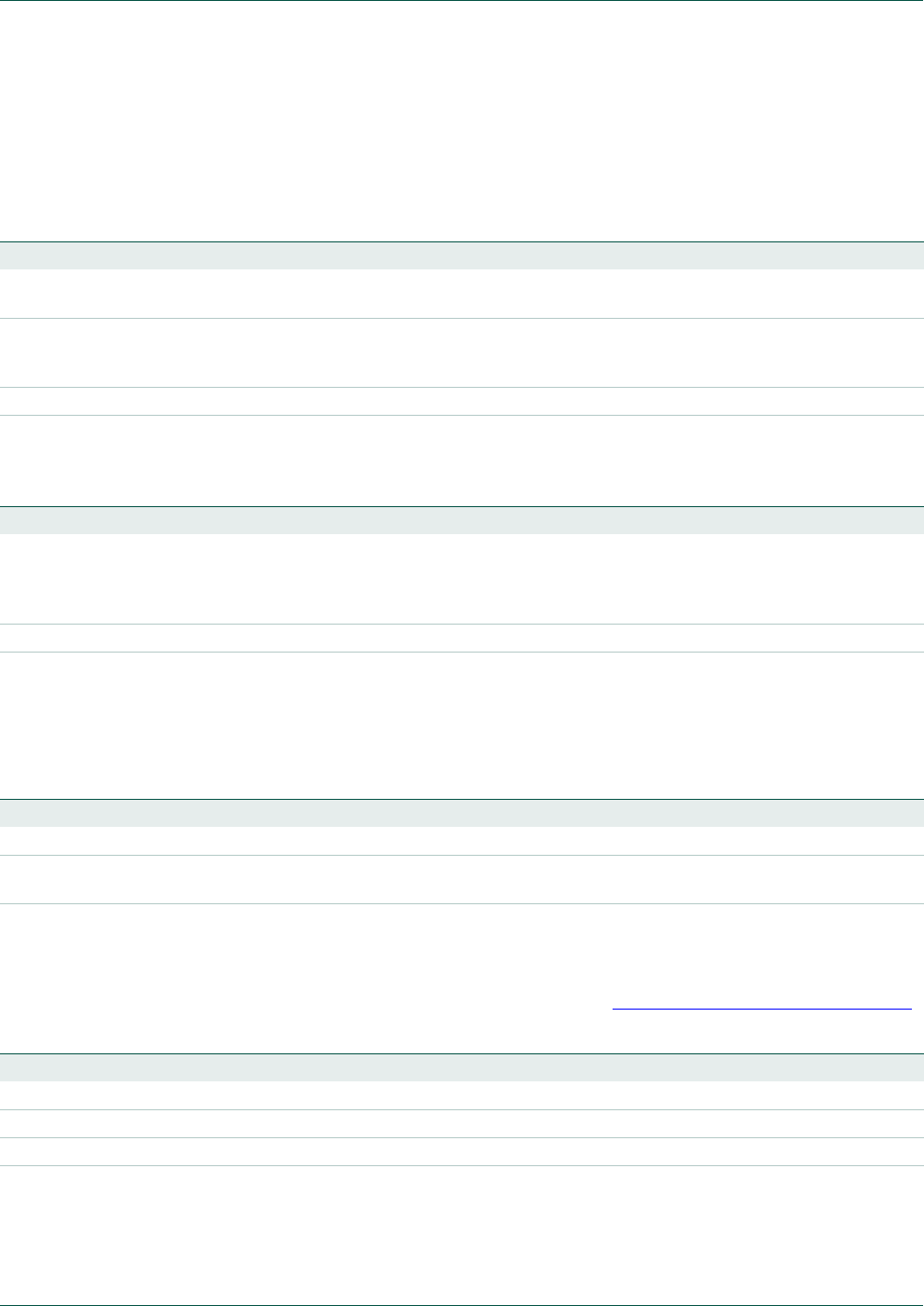
UM10360 All information provided in this document is subject to legal disclaimers. © NXP B.V. 2014. All rights reserved.
User manual Rev. 3.1 — 2 April 2014 389 of 849
NXP Semiconductors UM10360
Chapter 16: LPC176x/5x CAN1/2
information under which address during an ID screening an error in the look-up table was
encountered. Any read of the LUTerrorAddr Filter block can be used for a look-up table
interrupt.
16.14.9 LUT Error Address register (LUTerrAd - 0x4003 C018)
16.14.10 LUT Error register (LUTerr - 0x4003 C01C)
16.14.11 Global FullCANInterrupt Enable register (FCANIE - 0x4003 C020)
A write access to the Global FullCAN Interrupt Enable register is only possible when the
Acceptance Filter is in the off mode.
16.14.12 FullCAN Interrupt and Capture registers (FCANIC0 - 0x4003 C024 and
FCANIC1 - 0x4003 C028)
For detailed description on these two registers, see Section 16.16.2 “FullCAN interrupts”.
Table 349. LUT Error Address register (LUTerrAd - address 0x4003 C018) bit description
Bit Symbol Description Reset Value
1:0 - Reserved, user software should not write ones to reserved bits. The value read from a
reserved bit is not defined.
NA
10:2 LUTerrAd It the LUT Error bit (below) is 1, this read-only field contains the address in AF Lookup
Tabl e R AM, a t whi c h t he A c c ep t ance Fi l t e r en c o u nter e d a n e r r or i n t he c o n t e nt o f t h e
tables.
0
31:11 - Reserved, the value read from a reserved bit is not defined. NA
Table 350. LUT Error register (LUTerr - address 0x4003 C01C) bit description
Bit Symbol Description Reset Value
0LUTerrThis read-only bit is set to 1 if the Acceptance Filter encounters an error in the content of
the tables in AF RAM. It is cleared when software reads the LUTerrAd register. This
condition is ORed with the “other CAN” interrupts from the CAN controllers, to produce the
request that is connected to the NVIC.
0
31:1 - Reserved, the value read from a reserved bit is not defined. NA
Table 351. Global FullCAN Enable register (FCANIE - address 0x4003 C020) bit description
Bit Symbol Description Reset Value
0FCANIEGlobal FullCAN Interrupt Enable. When 1, this interrupt is enabled. 0
31:1 - Reserved, user software should not write ones to reserved bits. The value read from a
reserved bit is not defined.
NA
Table 352. FullCAN Interrupt and Capture register 0 (FCANIC0 - address 0x4003 C024) bit description
Bit Symbol Description Reset Value
0IntPnd0 FullCan Interrupt Pending bit 0. 0
... IntPndx (0<x<31) FullCan Interrupt Pending bit x. 0
31 IntPnd31 FullCan Interrupt Pending bit 31. 0

UM10360 All information provided in this document is subject to legal disclaimers. © NXP B.V. 2014. All rights reserved.
User manual Rev. 3.1 — 2 April 2014 390 of 849
NXP Semiconductors UM10360
Chapter 16: LPC176x/5x CAN1/2
16.15 Configuration and search algorithm
The CAN Identifier Look-up Table Memory can contain explicit identifiers and groups of
CAN identifiers for Standard and Extended CAN Frame Formats. They are organized as a
sorted list or table with an increasing order of the Source CAN Channel (SCC) together
with CAN Identifier in each section.
SCC value equals CAN_controller - 1, i.e., SCC = 0 matches CAN1 and SCC = 1
matches CAN2.
Every CAN identifier is linked to an ID Index number. In case of a CAN Identifier match,
the matching ID Index is stored in the Identifier Index of the Frame Status Register
(CANRFS) of the according CAN Controller.
16.15.1 Acceptance filter search algorithm
The identifier screening process of the acceptance filter starts in the following order:
1. FullCAN (Standard Frame Format) Identifier Section
2. Explicit Standard Frame Format Identifier Section
3. Group of Standard Frame Format Identifier Section
4. Explicit Extended Frame Format Identifier Section
5. Group of Extended Frame Format Identifier Section
Note: Only activated sections will take part in the screening process.
In cases where equal message identifiers of same frame format are defined in more than
one section, the first match will end the screening process for this identifier.
For example, if the same Source CAN Channel in conjunction with the identifier is defined
in the FullCAN, the Explicit Standard Frame Format and the Group of Standard Frame
Format Identifier Sections, the screening will already be finished with the match in the
FullCAN section.
In the example of Figure 62, Identifiers with their Source CAN Channel have been defined
in the FullCAN, Explicit and Group of Standard Frame Format Identifier Sections.
Table 353. FullCAN Interrupt and Capture register 1 (FCANIC1 - address 0x4003 C028) bit description
Bit Symbol Description Reset Value
0IntPnd32 FullCan Interrupt Pending bit 32. 0
... IntPndx (32<x<63) FullCan Interrupt Pending bit x. 0
31 IntPnd63 FullCan Interrupt Pending bit 63. 0
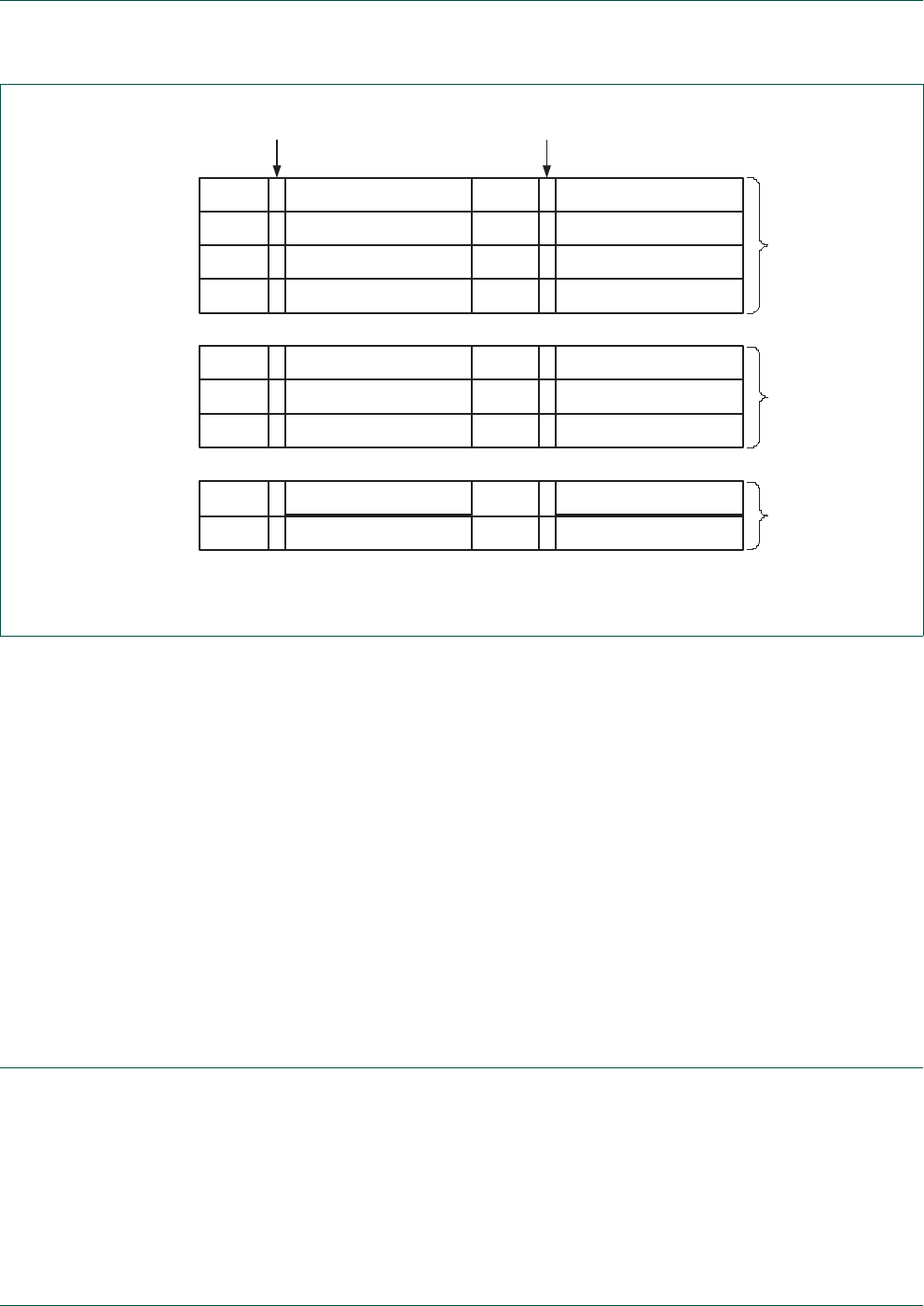
UM10360 All information provided in this document is subject to legal disclaimers. © NXP B.V. 2014. All rights reserved.
User manual Rev. 3.1 — 2 April 2014 391 of 849
NXP Semiconductors UM10360
Chapter 16: LPC176x/5x CAN1/2
The identifier 0x5A of the CAN Controller 1 with the Source CAN Channel SCC = 0, is
defined in all three sections. With this configuration incoming CAN messages on CAN
Controller 1 with a 0x5A identifier will find a match in the FullCAN section.
It is possible to disable the ‘0x5A identifier’ in the FullCAN section. With that, the
screening process would be finished with the match in the Explicit Identifier Section.
The first group in the Group Identifier Section has been defined such that incoming CAN
messages with identifiers of 0x5A up to 0x5F are accepted on CAN Controller 1 with the
Source CAN Channel SCC = 0. As stated above, the identifier 0x5A would find a match
already in the FullCAN or in the Explicit Identifier section if enabled. The rest of the
defined identifiers of this group (0x5B to 0x5F) will find a match in this Group Identifier
Section.
This way the user can switch dynamically between different filter modes for same
identifiers.
16.16 FullCAN mode
The FullCAN mode is based on capabilities provided by the CAN Gateway module. This
block uses the Acceptance Filter to provide filtering for both CAN channels.
The concept of the CAN Gateway block is mainly based on a BasicCAN functionality. This
concept fits perfectly in systems where a gateway is used to transfer messages or
message data between different CAN channels. A BasicCAN device is generating a
Fig 62. ID Look-up table example explaining the search algorithm
SCC = 0
SCC
SCC = 0
SCC
SCC
SCC
SCC
SCC = 0
SCC
SCC
0FullCAN
Explicit
Standard
Frame
Format
Identifier
Section
Explicit
Standard
Frame
Format
Identifier
Section
Group of
Standard
Frame
Format
Identifier
Section
ID = 0x5A ...
... ...
...
... ...
ID = 0x5A ID = 0x5A
...
SCC
SCC
SCC
SCC
SCC = 0
SCC
SCC
...SCC
0
0
0
0
0
0
0
0
0
0
0
0
0
0
0
0
0
Message
disable bit
ID = 0x5A
...
...
...
...
...
ID = 0x5F
...
Message
disable bit
Index 0, 1
Index 2, 3
Index 4, 5
Index 6, 7
Index 8, 9
Index 10, 11
Index 12, 13
Index 14
Index 15

UM10360 All information provided in this document is subject to legal disclaimers. © NXP B.V. 2014. All rights reserved.
User manual Rev. 3.1 — 2 April 2014 392 of 849
NXP Semiconductors UM10360
Chapter 16: LPC176x/5x CAN1/2
receive interrupt whenever a CAN message is accepted and received. Software has to
move the received message out of the receive buffer from the according CAN controller
into the user RAM.
To cover dashboard like applications where the controller typically receives data from
several CAN channels for further processing, the CAN Gateway block was extended by a
so-called FullCAN receive function. This additional feature uses an internal message
handler to move received FullCAN messages from the receive buffer of the according
CAN controller into the FullCAN message object data space of Look-up Table RAM.
When FullCAN mode is enabled, the Acceptance Filter itself takes care of receiving and
storing messages for selected Standard ID values on selected CAN buses, in the style of
“FullCAN” controllers.
In order to set this bit and use this mode, two other conditions must be met with respect to
the contents of Acceptance Filter RAM and the pointers into it:
•The Standard Frame Individual Start Address Register (SFF_sa) must be greater than
or equal to the number of IDs for which automatic receive storage is to be done, times
two. SFF_sa must be rounded up to a multiple of 4 if necessary.
•The EndOfTable register must be less than or equal to 0x800 minus 6 times the
SFF_sa value, to allow 12 bytes of message storage for each ID for which automatic
receive storage will be done.
When these conditions are met and eFCAN is set:
•The area between the start of Acceptance Filter RAM and the SFF_sa address, is
used for a table of individual Standard IDs and CAN Controller/bus identification,
sorted in ascending order and in the same format as in the Individual Standard ID
table (see Figure 59 “Entry in FullCAN and individual standard identifier tables” on
page 384). Entries can be marked as “disabled” as in the other Standard tables. If
there are an odd number of “FullCAN” ID’s, at least one entry in this table must be so
marked.
•The first (SFF_sa)/2 IDindex values are assigned to these automatically-stored ID’s.
That is, IDindex values stored in the Rx Frame Status Register, for IDs not handled in
this way, are increased by (SFF_sa)/2 compared to the values they would have when
eFCAN is 0.
•When a Standard ID is received, the Acceptance Filter searches this table before the
Standard Individual and Group tables.
•When a message is received for a controller and ID in this table, the Acceptance filter
reads the received message out of the CAN controller and stores it in Acceptance
Filter RAM, starting at (EndOfTable) + its IDindex*12.
•The format of such messages is shown in Tab l e 3 5 4 .

UM10360 All information provided in this document is subject to legal disclaimers. © NXP B.V. 2014. All rights reserved.
User manual Rev. 3.1 — 2 April 2014 393 of 849
NXP Semiconductors UM10360
Chapter 16: LPC176x/5x CAN1/2
16.16.1 FullCAN message layout
The FF, RTR, and DLC fields are as described in Tab le 32 6 .
Since the FullCAN message object section of the Look-up table RAM can be accessed
both by the Acceptance Filter and the CPU, there is a method for insuring that no CPU
reads from FullCAN message object occurs while the Acceptance Filter hardware is
writing to that object.
For this purpose the Acceptance Filter uses a 3-state semaphore, encoded with the two
semaphore bits SEM1 and SEM0 (see Tab le 3 5 4 “ Format of automatically stored Rx
messages”) for each message object. This mechanism provides the CPU with information
about the current state of the Acceptance Filter activity in the FullCAN message object
section.
The semaphore operates in the following manner:
Prior to writing the first data byte into a message object, the Acceptance Filter will write
the FrameInfo byte into the according buffer location with SEM[1:0] = 01.
After having written the last data byte into the message object, the Acceptance Filter will
update the semaphore bits by setting SEM[1:0] = 11.
Before reading a message object, the CPU should read SEM[1:0] to determine the current
state of the Acceptance Filter activity therein. If SEM[1:0] = 01, then the Acceptance Filter
is currently active in this message object. If SEM[1:0] = 11, then the message object is
available to be read.
Before the CPU begins reading from the message object, it should clear SEM[1:0] = 00.
When the CPU is finished reading, it can check SEM[1:0] again. At the time of this final
check, if SEM[1:0] = 01 or 11, then the Acceptance Filter has updated the message object
during the time when the CPU reads were taking place, and the CPU should discard the
data. If, on the other hand, SEM[1:0] = 00 as expected, then valid data has been
successfully read by the CPU.
Figure 63 shows how software should use the SEM field to ensure that all three words
read from the message are all from the same received message.
Table 354. Format of automatically stored Rx messages
Address 31 30 29 28 27 26 25 24 23 22 21 20 19 18 17 16 15 14 13 12 11 10 9 8 7 6 5 4 3 2 1 0
0F
F
R
T
R
0000 SEM
[1:0]
0000 DLC 00000 ID.28 ... ID.18
+4 Rx Data 4 Rx Data 3 Rx Data 2 Rx Data 1
+8 Rx Data 8 Rx Data 7 Rx Data 6 Rx Data 5
Table 355. FullCAN semaphore operation
SEM1 SEM0 activity
01Acceptance Filter is updating the content
11Acceptance Filter has finished updating the content
00CPU is in process of reading from the Acceptance Filter
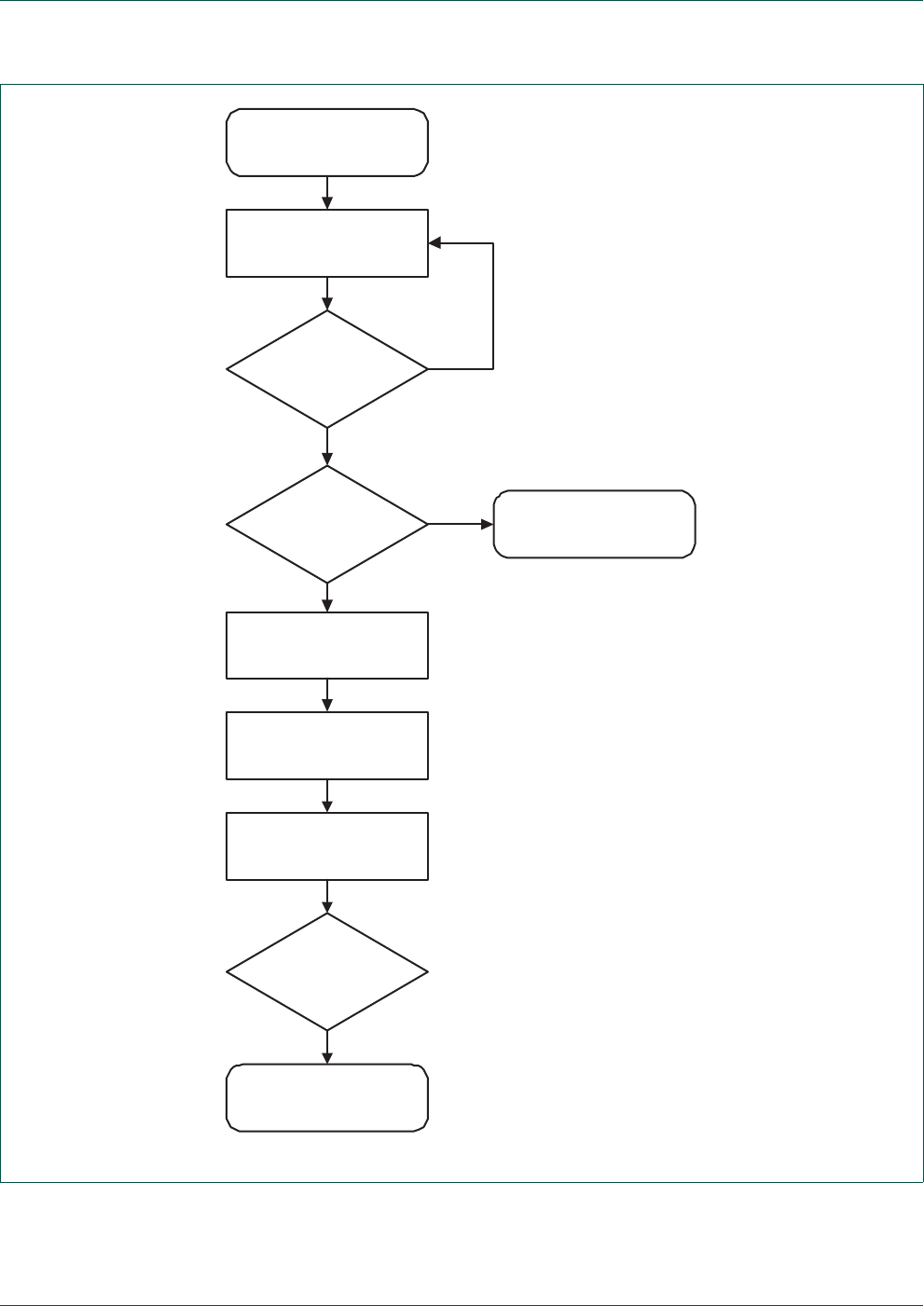
UM10360 All information provided in this document is subject to legal disclaimers. © NXP B.V. 2014. All rights reserved.
User manual Rev. 3.1 — 2 April 2014 394 of 849
NXP Semiconductors UM10360
Chapter 16: LPC176x/5x CAN1/2
Fig 63. Semaphore procedure for reading an auto-stored message
read 1st word
SEM == 01?
SEM == 11?
clear SEM, write back 1st word
read 2nd and 3rd words
read 1st word
SEM == 00?
START
most recently read 1st, 2nd, and
3rd words are from the same
message
this message has not been
received since last check

UM10360 All information provided in this document is subject to legal disclaimers. © NXP B.V. 2014. All rights reserved.
User manual Rev. 3.1 — 2 April 2014 395 of 849
NXP Semiconductors UM10360
Chapter 16: LPC176x/5x CAN1/2
16.16.2 FullCAN interrupts
The CAN Gateway Block contains a 2 kB ID Look-up Table RAM. With this size a
maximum number of 146 FullCAN objects can be defined if the whole Look-up Table RAM
is used for FullCAN objects only. Only the first 64 FullCAN objects can be configured to
participate in the interrupt scheme. It is still possible to define more than 64 FullCAN
objects. The only difference is, that the remaining FullCAN objects will not provide a
FullCAN interrupt.
The FullCAN Interrupt Register-set contains interrupt flags (IntPndx) for (pending)
FullCAN receive interrupts. As soon as a FullCAN message is received, the according
interrupt bit (IntPndx) in the FCAN Interrupt Register gets asserted. In case that the Global
FullCAN Interrupt Enable bit is set, the FullCAN Receive Interrupt is passed to the
Vectored Interrupt Controller.
Application Software has to solve the following:
1. Index/Object number calculation based on the bit position in the FCANIC Interrupt
Register for more than one pending interrupt.
2. Interrupt priority handling if more than one FullCAN receive interrupt is pending.
The software that covers the interrupt priority handling has to assign a receive interrupt
priority to every FullCAN object. If more than one interrupt is pending, then the software
has to decide, which received FullCAN object has to be served next.
To each FullCAN object a new FullCAN Interrupt Enable bit (FCANIntxEn) is added, so
that it is possible to enable or disable FullCAN interrupts for each object individually. The
new Message Lost flag (MsgLstx) is introduced to indicate whether more than one
FullCAN message has been received since last time this message object was read by the
CPU. The Interrupt Enable and the Message Lost bits reside in the existing Look-up Table
RAM.
16.16.2.1 FullCAN message interrupt enable bit
In Figure 64 8 FullCAN Identifiers with their Source CAN Channel are defined in the
FullCAN, Section. The new introduced FullCAN Message Interrupt enable bit can be used
to enable for each FullCAN message an Interrupt.
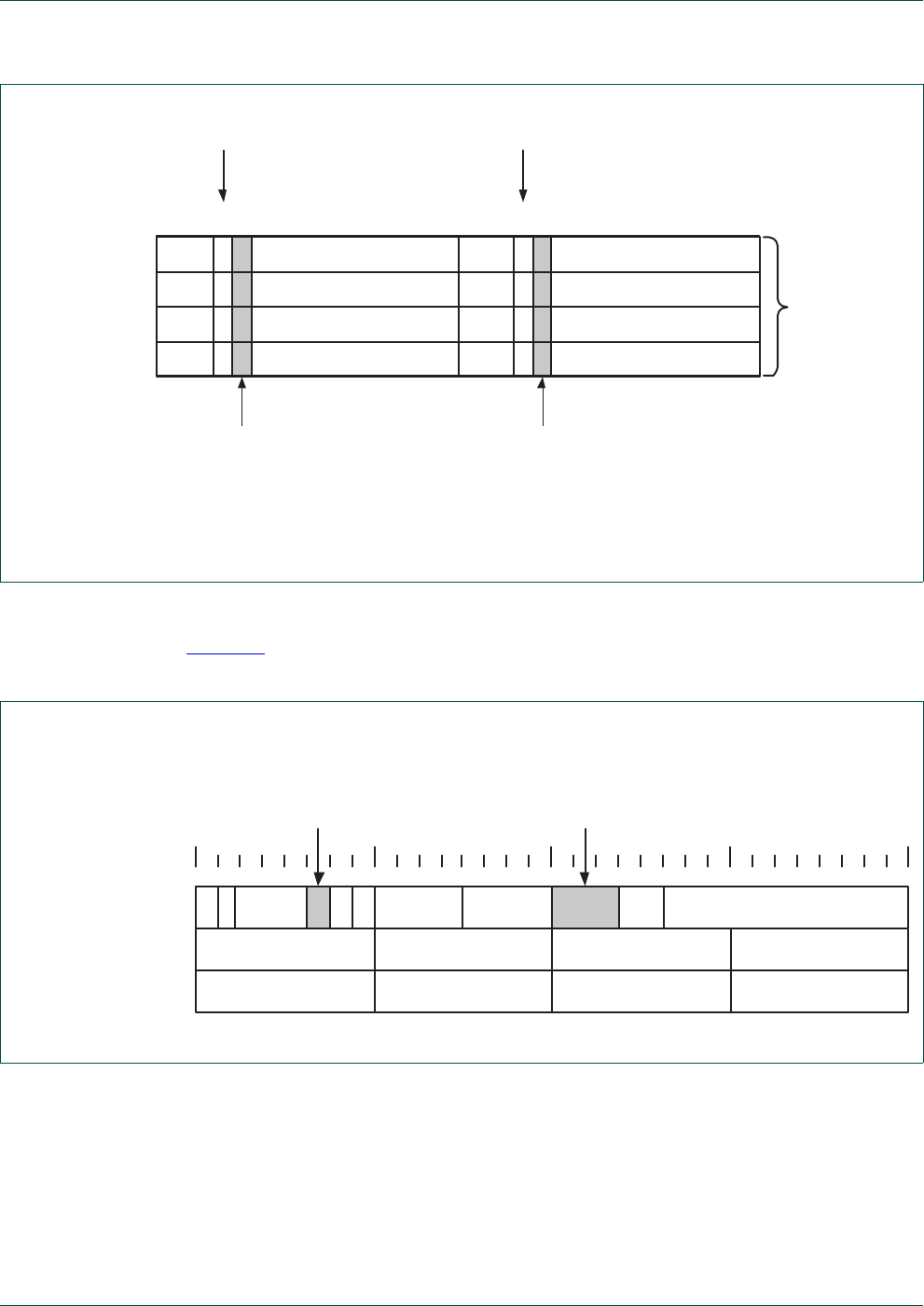
UM10360 All information provided in this document is subject to legal disclaimers. © NXP B.V. 2014. All rights reserved.
User manual Rev. 3.1 — 2 April 2014 396 of 849
NXP Semiconductors UM10360
Chapter 16: LPC176x/5x CAN1/2
16.16.2.2 Message lost bit and CAN channel number
Figure 65 is the detailed layout structure of one FullCAN message stored in the FullCAN
message object section of the Look-up Table.
The new message lost bit (MsgLst) is introduced to indicate whether more than one
FullCAN message has been received since last time this message object was read. For
more information the CAN Source Channel (SCC) of the received FullCAN message is
added to Message Object.
Fig 64. FullCAN section example of the ID look-up table
0
FullCAN
Explicit
Standard
Frame
Format
Identifier
Section
11-bit CAN ID SCC
0
Message
disable bit
Message
disable bit
Index 0, 1
Index 2, 3
Index 4, 5
Index 6, 7
0
SCC 11-bit CAN ID
1234567890
1
112345678901234 567890
23
0
11-bit CAN ID SCC
0
SCC 11-bit CAN ID
0
11-bit CAN ID SCC
0
SCC 11-bit CAN ID
0
11-bit CAN ID SCC
0
SCC 11-bit CAN ID
New:
FullCAN
Message
Interrupt
enable bit
New:
FullCAN
Message
Interrupt
enable bit
Fig 65. FullCAN message object layout
31 0
RX Data 4 RX Data 3 RX Data 2 RX Data 1
RX Data 8 RX Data 7 RX Data 6 RX Data 5
9 781516 102324
Msg_ObjAddr + 0
APB
Base +
F
FRX DLC
R
T
R
S
E
M
0
ID.2
8
ID.1
8
............................
Msg_ObjAddr + 4
Msg_ObjAddr + 8
S
E
M
1
New:
FullCAN
Message
lost bit
SCC
New:
CAN
Source
Channel
un-
used
unused unused

UM10360 All information provided in this document is subject to legal disclaimers. © NXP B.V. 2014. All rights reserved.
User manual Rev. 3.1 — 2 April 2014 397 of 849
NXP Semiconductors UM10360
Chapter 16: LPC176x/5x CAN1/2
16.16.2.3 Setting the interrupt pending bits (IntPnd 63 to 0)
The interrupt pending bit (IntPndx) gets asserted in case of an accepted FullCAN
message and if the interrupt of the according FullCAN Object is enabled (enable bit
FCANIntxEn) is set).
During the last write access from the data storage of a FullCAN message object the
interrupt pending bit of a FullCAN object (IntPndx) gets asserted.
16.16.2.4 Clearing the interrupt pending bits (IntPnd 63 to 0)
Each of the FullCAN Interrupt Pending requests gets cleared when the semaphore bits of
a message object are cleared by Software (ARM CPU).
16.16.2.5 Setting the message lost bit of a FullCAN message object (MsgLost 63 to 0)
The Message Lost bit of a FullCAN message object gets asserted in case of an accepted
FullCAN message and when the FullCAN Interrupt of the same object is asserted already.
During the first write access from the data storage of a FullCAN message object the
Message Lost bit of a FullCAN object (MsgLostx) gets asserted if the interrupt pending bit
is set already.
16.16.2.6 Clearing the message lost bit of a FullCAN message object (MsgLost 63 to
0)
The Message Lost bit of a FullCAN message object gets cleared when the FullCAN
Interrupt of the same object is not asserted.
During the first write access from the data storage of a FullCAN message object the
Message Lost bit of a FullCAN object (MsgLostx) gets cleared if the interrupt pending bit
is not set.
16.16.3 Set and clear mechanism of the FullCAN interrupt
Special precaution is needed for the built-in set and clear mechanism of the FullCAN
Interrupts. The following text illustrates how the already existing Semaphore Bits (see
Section 16.16.1 “FullCAN message layout” for more details) and how the new introduced
features (IntPndx, MsgLstx) will behave.
16.16.3.1 Scenario 1: Normal case, no message lost
Figure 66 below shows a typical “normal” scenario in which an accepted FullCAN
message is stored in the FullCAN Message Object Section. After storage the message is
read out by Software (ARM CPU).
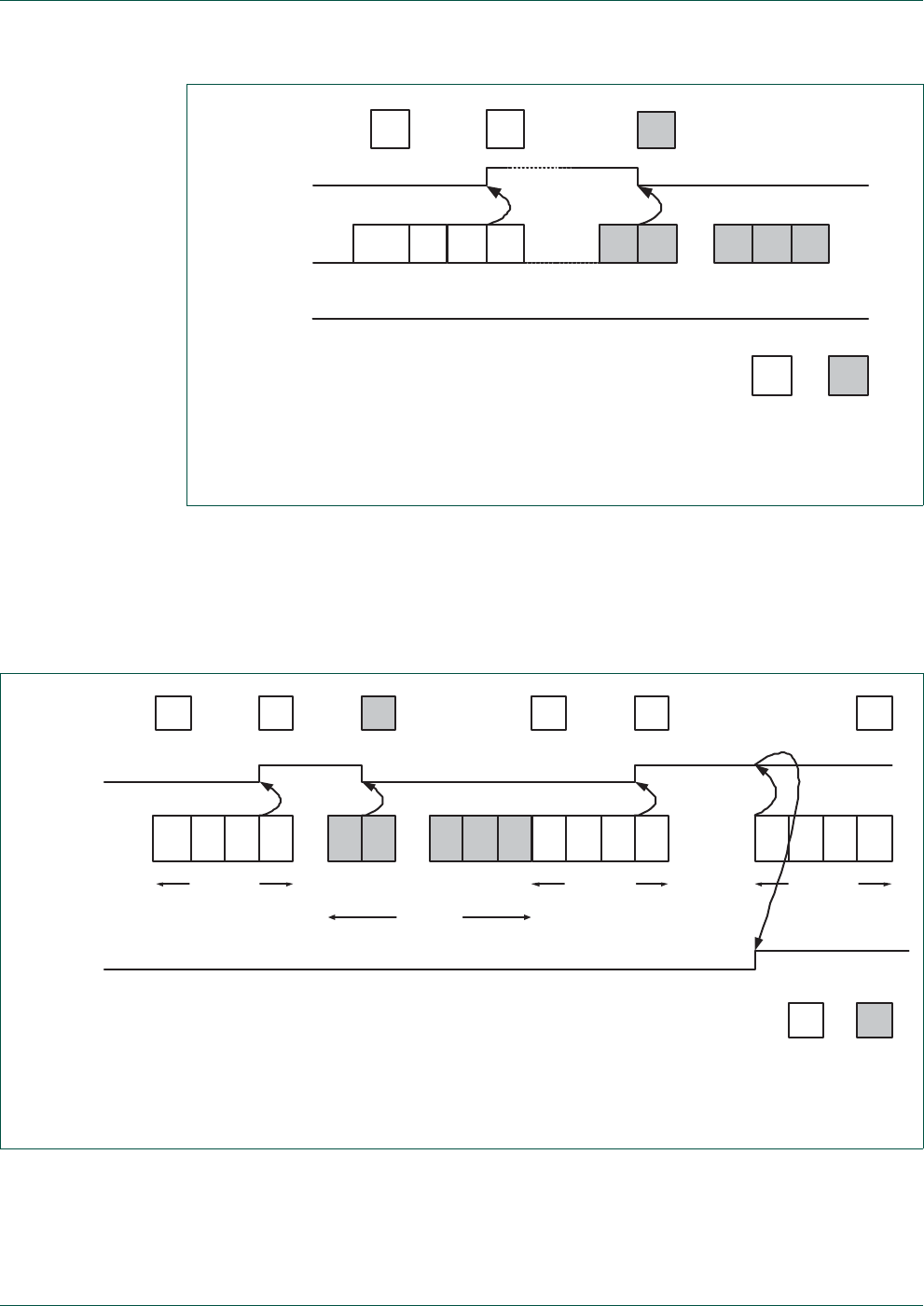
UM10360 All information provided in this document is subject to legal disclaimers. © NXP B.V. 2014. All rights reserved.
User manual Rev. 3.1 — 2 April 2014 398 of 849
NXP Semiconductors UM10360
Chapter 16: LPC176x/5x CAN1/2
16.16.3.2 Scenario 2: Message lost
In this scenario a first FullCAN Message is stored and read out by Software (1st Object
write and read). In a second course a second message is stored (2nd Object write) but not
read out before a third message gets stored (3rd Object write). Since the FullCAN Interrupt
of that Object (IntPndx) is already asserted, the Message Lost Signal gets asserted.
Fig 66. Normal case, no messages lost
01 11
IntPndx
semaphore
bits
look-up
table
access
00
MsgLostx
message
handler
access
ARM
processor
access
read
SEM
read
D2
read
D1
clear
SEM
read
SEM
write
SEM
write
D2
write
D1
Write
ID, SEM
Fig 67. Message lost
01 11
01 11 1100
1st Object
write
2nd Object
write
1st Object
read
3rd Object
write
IntPndx
semaphore
bits
look-up
table
access
MsgLostx
message
handler
access
ARM
processor
access
read
SEM
read
D2
read
D1
clear
SEM
read
SEM
write
SEM
write
D2
write
D1
write
ID,
SEM
write
SEM
write
D2
write
D1
write
ID,
SEM
write
SEM
write
D2
write
D1
write
ID,
SEM
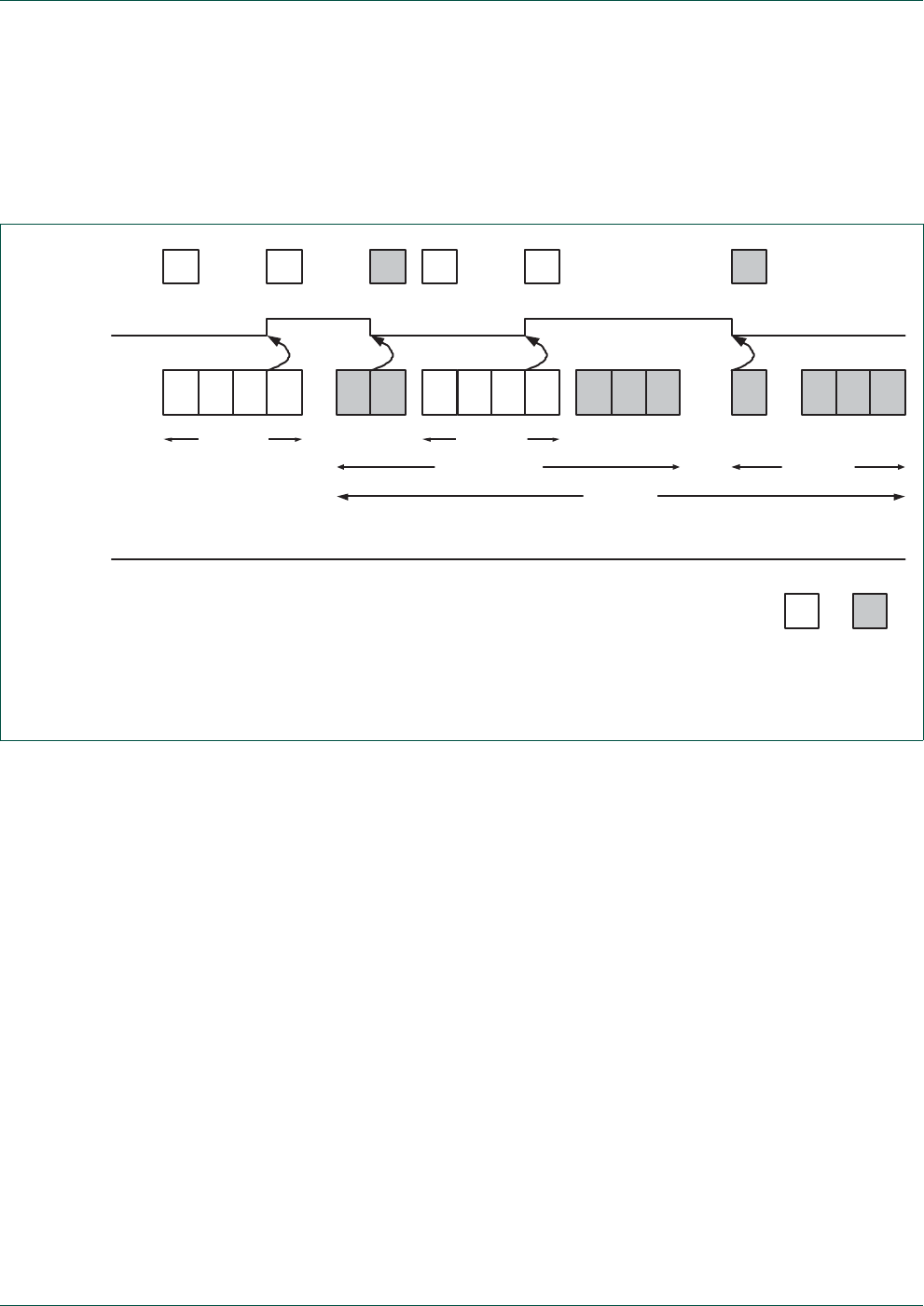
UM10360 All information provided in this document is subject to legal disclaimers. © NXP B.V. 2014. All rights reserved.
User manual Rev. 3.1 — 2 April 2014 399 of 849
NXP Semiconductors UM10360
Chapter 16: LPC176x/5x CAN1/2
16.16.3.3 Scenario 3: Message gets overwritten indicated by Semaphore bits
This scenario is a special case in which the lost message is indicated by the existing
semaphore bits. The scenario is entered, if during a Software read of a message object
another new message gets stored by the message handler. In this case, the FullCAN
Interrupt bit gets set for a second time with the 2nd Object write.
16.16.3.4 Scenario 3.1: Message gets overwritten indicated by Semaphore bits and
Message Lost
This scenario is a sub-case to Scenario 3 in which the lost message is indicated by the
existing semaphore bits and by Message Lost.
Fig 68. Message gets overwritten
01 11 01 1100 00
1st Object
write
2nd Object
write
2nd Object
read
1st Object read
Interrupt Service
Routine
IntPndx
semaphore
bits
look-up
table
access
MsgLostx
message
handler
access
ARM
processor
access
read
SEM
read
D2
read
D1
clear
SEM
read
SEM
write
SEM
write
D2
write
D1
write
ID,
SEM
write
SEM
write
D2
write
D1
write
ID,
SEM
read
SEM
read
D2
read
D1
clear
SEM
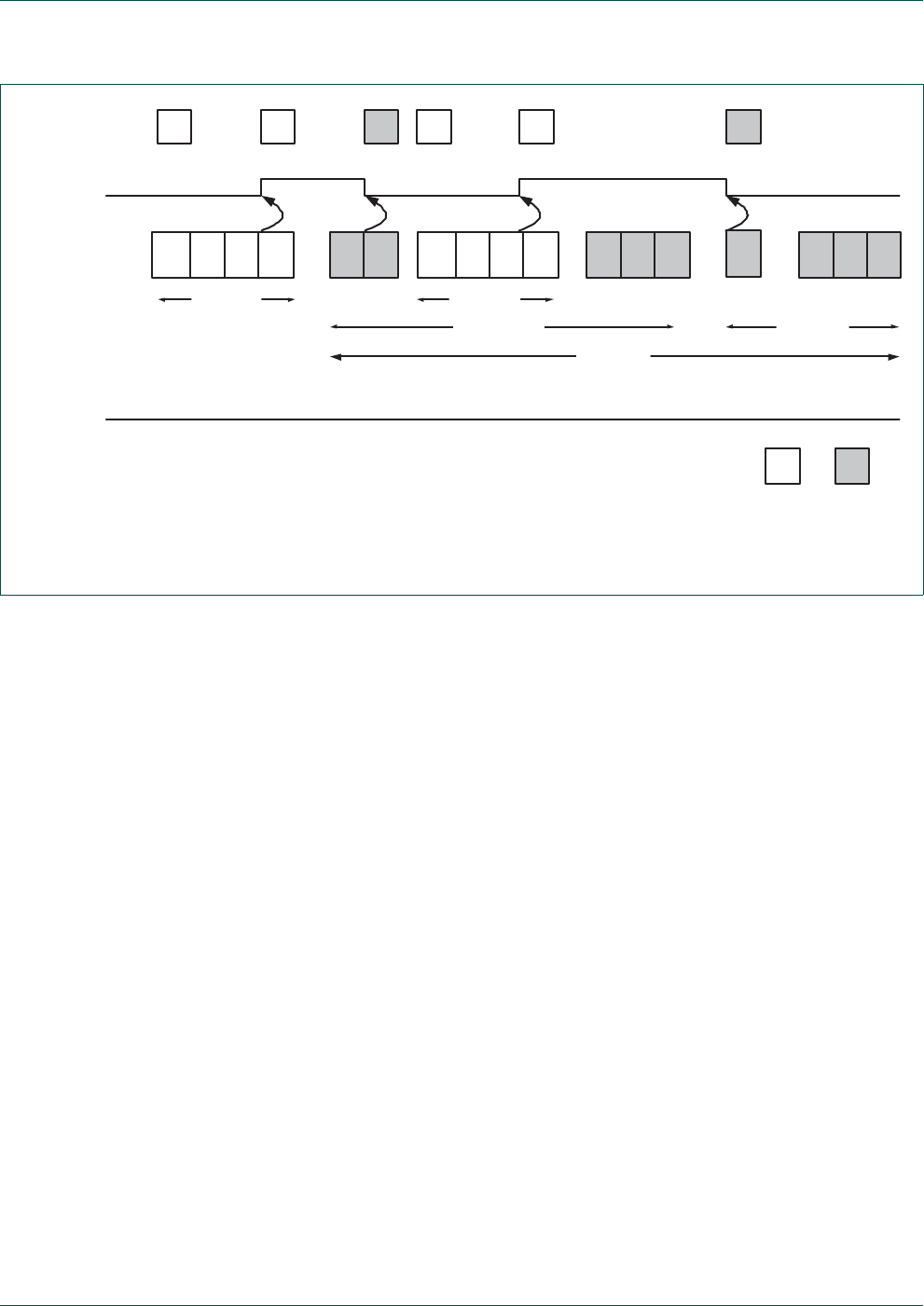
UM10360 All information provided in this document is subject to legal disclaimers. © NXP B.V. 2014. All rights reserved.
User manual Rev. 3.1 — 2 April 2014 400 of 849
NXP Semiconductors UM10360
Chapter 16: LPC176x/5x CAN1/2
16.16.3.5 Scenario 3.2: Message gets overwritten indicated by Message Lost
This scenario is a sub-case to Scenario 3 in which the lost message is indicated by
Message Lost.
Fig 69. Message overwritten indicated by semaphore bits and message lost
01 11 01 1100 00
1st Object
write
2nd Object
write
2nd Object
read
Interrupt Service
Routine
IntPndx
semaphore
bits
look-up
table
access
MsgLostx
message
handler
access
ARM
processor
access
clear
SEM
write
SEM
write
D2
write
D1
write
ID,
SEM
write
SEM
write
D2
write
D1
write
ID,
SEM
read
SEM
read
D2
clear
SEM
read
SEM
read
D1
read
SEM
read
D2
read
D1
1st Object read
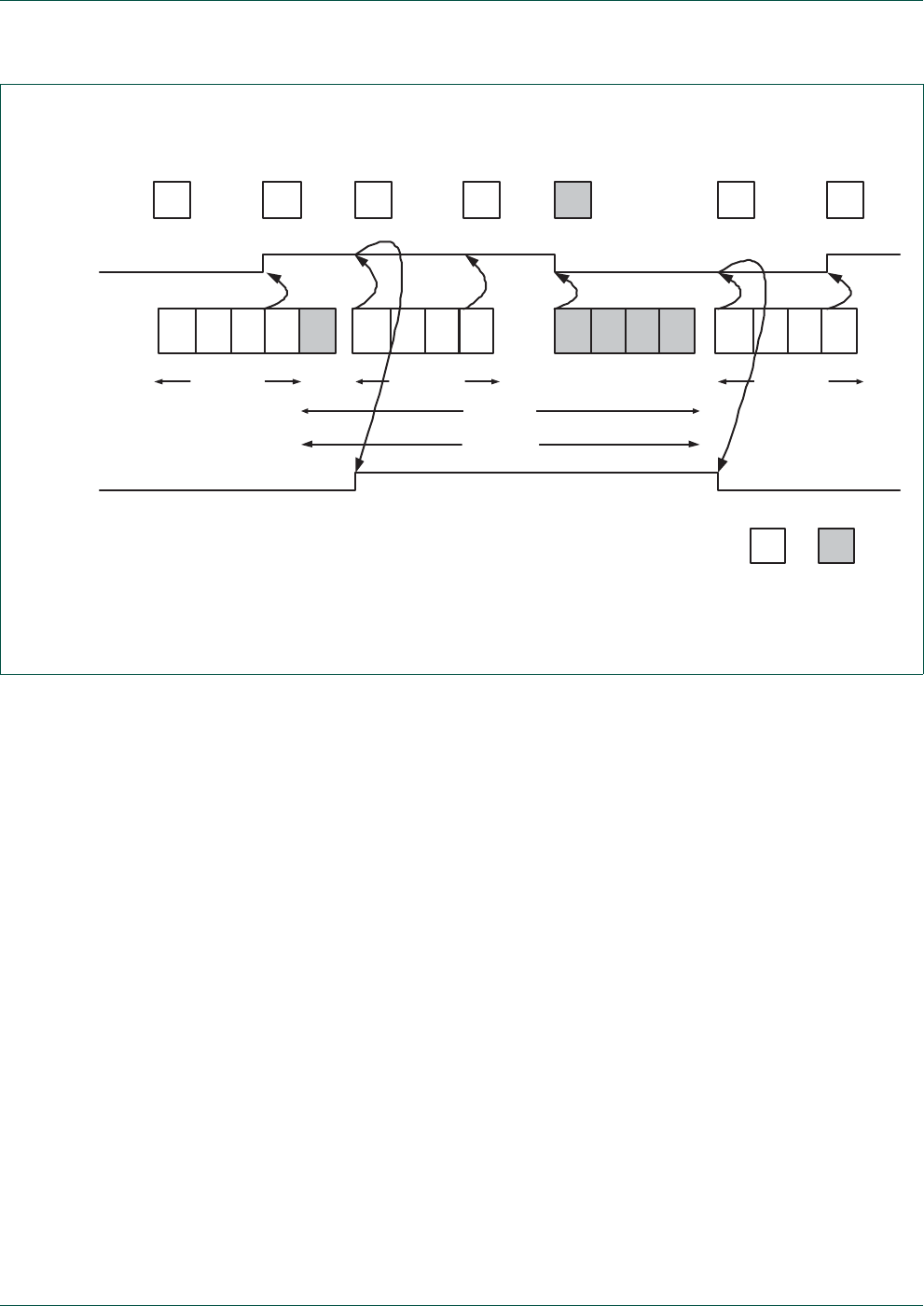
UM10360 All information provided in this document is subject to legal disclaimers. © NXP B.V. 2014. All rights reserved.
User manual Rev. 3.1 — 2 April 2014 401 of 849
NXP Semiconductors UM10360
Chapter 16: LPC176x/5x CAN1/2
16.16.3.6 Scenario 4: Clearing Message Lost bit
This scenario is a special case in which the lost message bit of an object gets set during
an overwrite of a none read message object (2nd Object write). The subsequent read out
of that object by Software (1st Object read) clears the pending Interrupt. The 3rd Object
write clears the Message Lost bit. Every “write ID, SEM” clears Message Lost bit if no
pending Interrupt of that object is set.
Fig 70. Message overwritten indicated by message lost
IntPndx
semaphore
bits
look-up
table
access
MsgLostx
message
handler
access
ARM
processor
access
write
SEM
write
D2
write
D1
write
ID,
SEM
01 11 01 11 00
1st Object
write
2nd Object
write
1st Object
read
Interrupt Service
Routine
01 11
3rd Object
write
write
SEM
write
D2
write
D1
write
ID,
SEM
write
SEM
write
D2
write
D1
write
ID,
SEM
read
SEM
read
D2
read
D1
read
SEM
clear
SEM
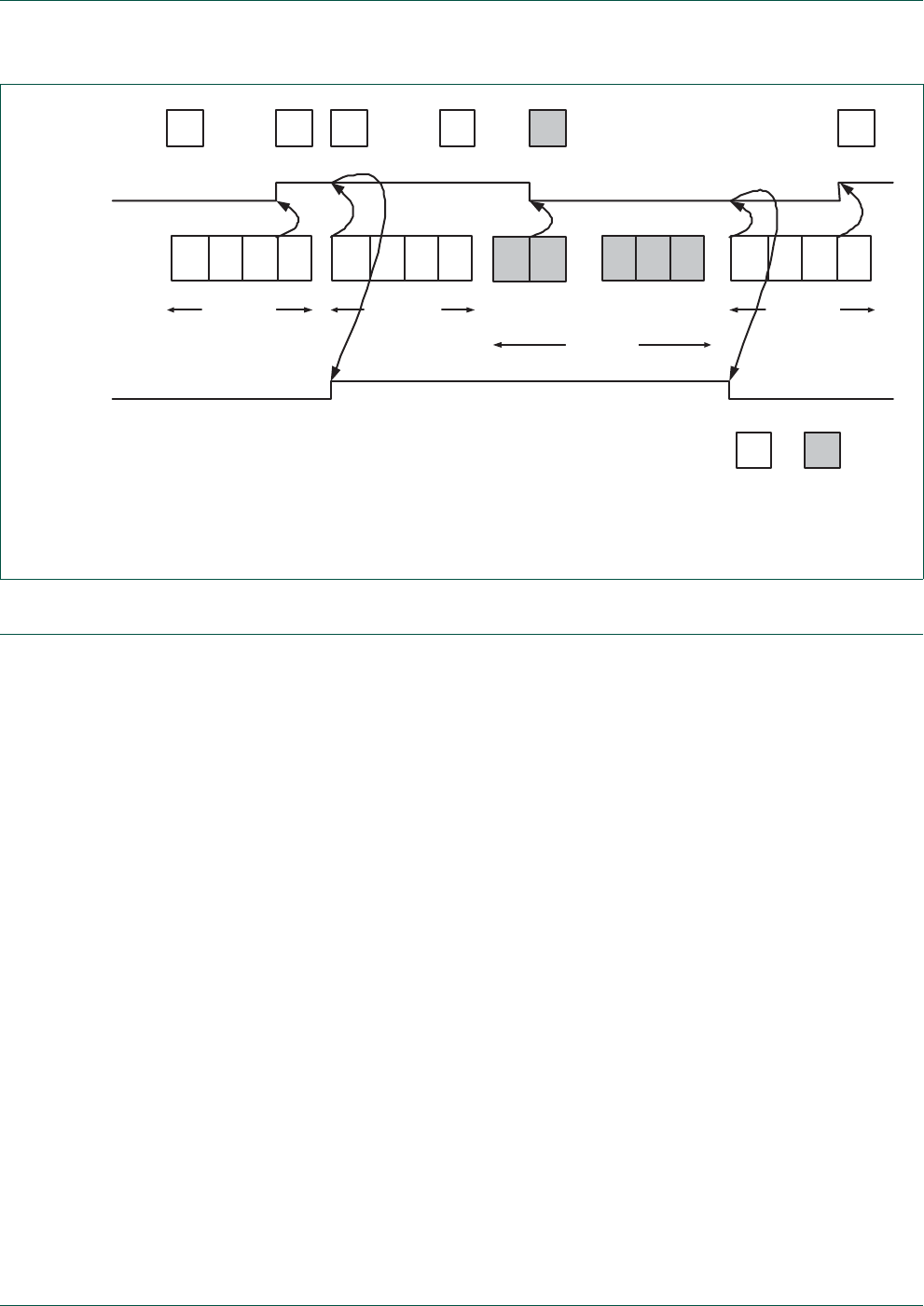
UM10360 All information provided in this document is subject to legal disclaimers. © NXP B.V. 2014. All rights reserved.
User manual Rev. 3.1 — 2 April 2014 402 of 849
NXP Semiconductors UM10360
Chapter 16: LPC176x/5x CAN1/2
16.17 Examples of acceptance filter tables and ID index values
16.17.1 Example 1: only one section is used
SFF_sa < ENDofTable OR
SFF_GRP_sa < ENDofTable OR
EFF_sa < ENDofTable OR
EFF_GRP_sa < ENDofTable
The start address of a section is lower than the end address of all programmed CAN
identifiers.
16.17.2 Example 2: all sections are used
SFF_sa < SFF_GRP_sa AND
SFF_GRP_sa < EFF_sa AND
EFF_sa < EFF_GRP_sa AND
EFF_GRP_sa < ENDofTable
In cases of a section not being used, the start address has to be set onto the value of the
next section start address.
16.17.3 Example 3: more than one but not all sections are used
If the SFF group is not used, the start address of the SFF Group Section (SFF_GRP_sa
register) has to be set to the same value of the next section start address, in this case the
start address of the Explicit SFF Section (SFF_sa register).
Fig 71. Clearing message lost
message
handler
access
ARM
processor
access
01 11 01 11
11
00
1st Object
write
2nd Object
write
1st Object
read
3rd Object
write
write
SEM
write
D2
write
D1
write
ID,
SEM
write
SEM
write
D2
write
D1
write
ID,
SEM
write
SEM
write
D2
write
D1
write
ID,
SEM
read
SEM
read
D2
read
D1
read
SEM
clear
SEM
IntPndx
semaphore
bits
look-up
table
access
MsgLostx

UM10360 All information provided in this document is subject to legal disclaimers. © NXP B.V. 2014. All rights reserved.
User manual Rev. 3.1 — 2 April 2014 403 of 849
NXP Semiconductors UM10360
Chapter 16: LPC176x/5x CAN1/2
In cases where explicit identifiers as well as groups of the identifiers are programmed, a
CAN identifier search has to start in the explicit identifier section first. If no match is found,
it continues the search in the group of identifier section. By this order it can be guaranteed
that in case where an explicit identifier match is found, the succeeding software can
directly proceed on this certain message whereas in case of a group of identifier match
the succeeding software needs more steps to identify the message.
16.17.4 Configuration example 4
Suppose that the five Acceptance Filter address registers contain the values shown in the
third column below. In this case each table contains the decimal number of words and
entries shown in the next two columns, and the ID Index field of the CANRFS register can
return the decimal values shown in the column ID Indexes for CAN messages whose
Identifiers match the entries in that table.
16.17.5 Configuration example 5
Figure 72 below is a more detailed and graphic example of the address registers, table
layout, and ID Index values. It shows:
•A Standard Individual table starting at the start of Acceptance Filter RAM and
containing 26 Identifiers, followed by:
•A Standard Group table containing 12 ranges of Identifiers, followed by:
•An Extended Individual table containing 3 Identifiers, followed by:
•An Extended Group table containing 2 ranges of Identifiers.
Table 356. Example of Acceptance Filter Tables and ID index Values
Table Register Value # Words # Entire ID Indexes
Standard Individual SFF_sa 0x040 810 1610 0-1510
Standard Group SFF_GRP_sa 0x060 410 410 16-1910
Extended Individual EFF_sa 0x070 810 1610 20-5510
Extended Group EFF_GRP_sa 0x100 810 1610 56-5710
ENDofTable 0x110
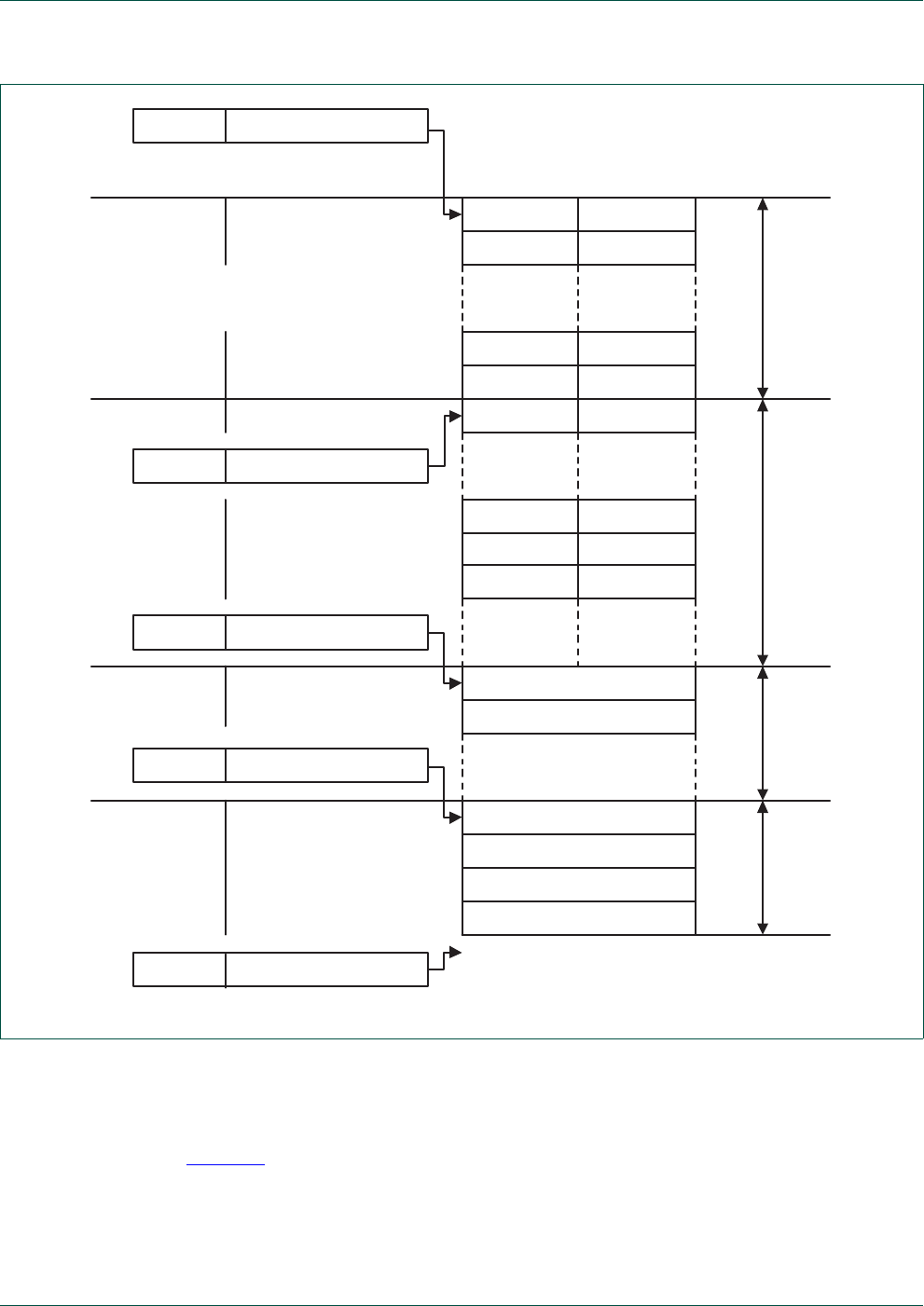
UM10360 All information provided in this document is subject to legal disclaimers. © NXP B.V. 2014. All rights reserved.
User manual Rev. 3.1 — 2 April 2014 404 of 849
NXP Semiconductors UM10360
Chapter 16: LPC176x/5x CAN1/2
16.17.6 Configuration example 6
The Table below shows which sections and therefore which types of CAN identifiers are
used and activated. The ID-Look-up Table configuration of this example is shown in
Figure 73.
Fig 72. Detailed example of acceptance filter tables and ID index values
SFF_sa 000 d := 000 h := 0 0000 0000 b
expli cit SFF table
lower_boundary 3 4 upper_boundary
lower_boundary 3
lower_boundary 3
5 upper_boundary
6 upper_boundary
01
32
0
1
2
3
22
23
24
25
26 d
22 23
2524
2 6
34 d
35 d
36 d
38 d
39 d
38
39
lower_boundary 41
upper_boundary
lower_boundary 42
upper_boundary
41 d
42 d
group SFF table
explicit EFF table
group EFF table
SFF_GRP_sa 52 d := 034 h := 0 0011 0100 b
EFF_sa 100 d := 064 h := 0 0110 0100 b
EFF_GRP_sa 112 d := 070 h := 0 0111 0000 b
ENDofTable 128 d := 080 h := 0 1000 0000 b
APB base +
address
00d = 00h
04d = 04h
44d = 2Ch
48d = 30h
52d = 34h
84d = 54h
88d = 58h
92d = 5Ch
100d = 64h
104d = 68h
112d = 70h
116d = 74h
120d = 78h
124d = 7Ch
column_lower column_upper
look-up table RAM ID index #

UM10360 All information provided in this document is subject to legal disclaimers. © NXP B.V. 2014. All rights reserved.
User manual Rev. 3.1 — 2 April 2014 405 of 849
NXP Semiconductors UM10360
Chapter 16: LPC176x/5x CAN1/2
Explicit standard frame format identifier section (11-bit CAN ID):
The start address of the Explicit Standard Frame Format section is defined in the SFF_sa
register with the value of 0x00. The end of this section is defined in the SFF_GRP_sa
register. In the Explicit Standard Frame Format section of the ID Look-up Table two CAN
Identifiers with their Source CAN Channels (SCC) share one 32-bit word. Not used or
disabled CAN Identifiers can be marked by setting the message disable bit.
Group of standard frame format identifier section (11-bit CAN ID):
The start address of the Group of Standard Frame Format section is defined with the
SFF_GRP_sa register with the value of 0x10. The end of this section is defined with the
EFF_sa register. In the Group of Standard Frame Format section two CAN Identifiers with
the same Source CAN Channel (SCC) share one 32-bit word and represent a range of
CAN Identifiers to be accepted. Bit 31 down to 16 represents the lower boundary and bit
15 down to 0 represents the upper boundary of the range of CAN Identifiers. All Identifiers
within this range (including the boundary identifiers) will be accepted. A whole group can
be disabled and not used by the acceptance filter by setting the message disable bit in the
upper and lower boundary identifier. To provide memory space for four Groups of
Standard Frame Format identifiers, the EFF_sa register value is set to 0x20. The identifier
group with the Index 9 of this section is not used and therefore disabled.
Explicit extended frame format identifier section (29-bit CAN ID, Figure 73)
The start address of the Explicit Extended Frame Format section is defined with the
EFF_sa register with the value of 0x20. The end of this section is defined with the
EFF_GRP_sa register. In the explicit Extended Frame Format section only one CAN
Identifier with its Source CAN Channel (SCC) is programmed per address line. To provide
memory space for four Explicit Extended Frame Format identifiers, the EFF_GRP_sa
register value is set to 0x30.
Group of extended frame format identifier section (29-bit CAN ID, Figure 73)
The start address of the Group of Extended Frame Format is defined with the
EFF_GRP_sa register with the value of 0x30. The end of this section is defined with the
End of Table address register (ENDofTable). In the Group of Extended Frame Format
section the boundaries are programmed with a pair of address lines; the first is the lower
boundary, the second the upper boundary. To provide memory space for two Groups of
Extended Frame Format Identifiers, the ENDofTable register value is set to 0x40.
Table 357. Used ID-Look-up Table sections
ID-Look-up Table Section Status
FullCAN not activated
Explicit Standard Frame Format activated
Group of Standard Frame Format activated
Explicit Extended Frame Format activated
Group of Extended Frame Format activated
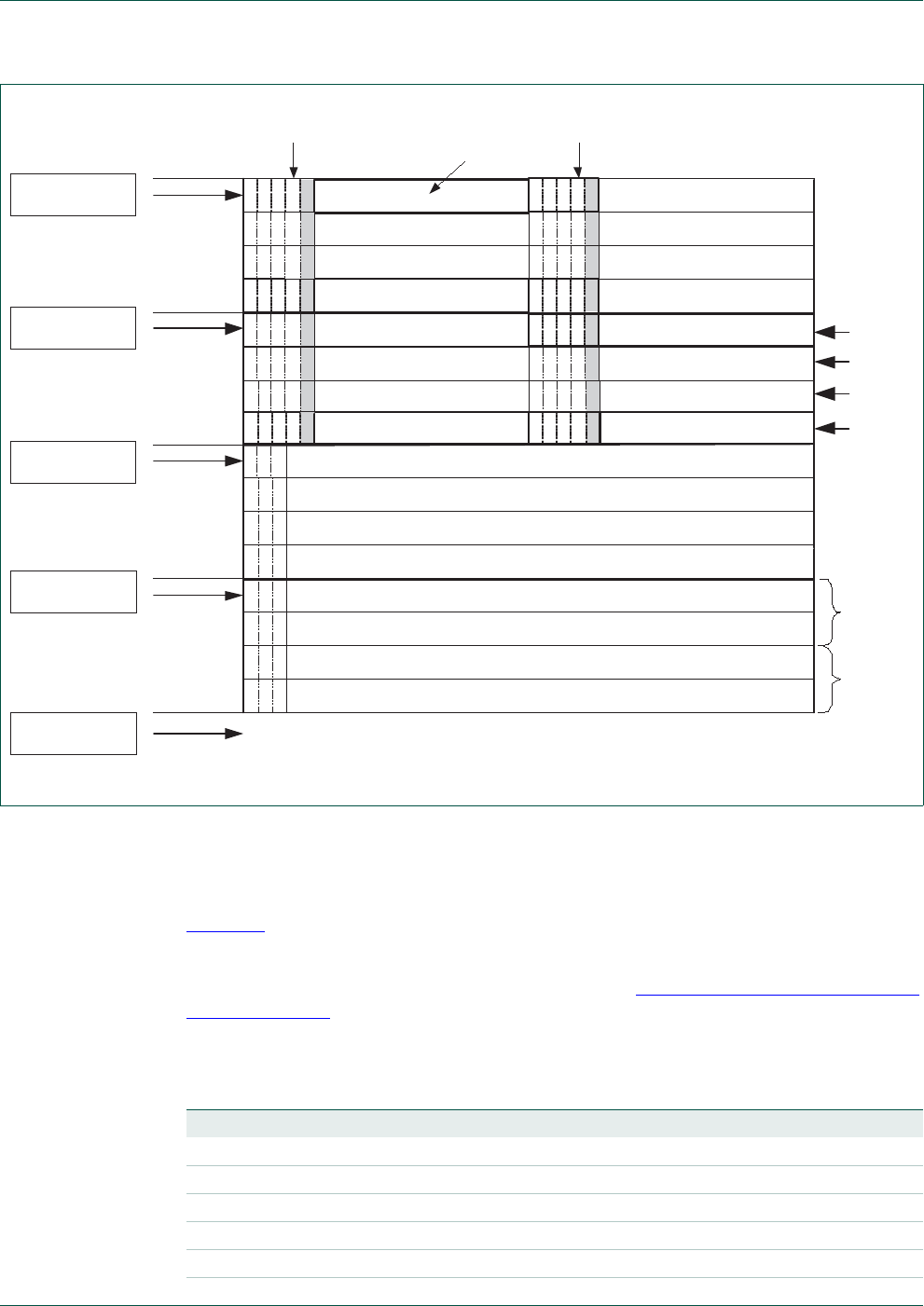
UM10360 All information provided in this document is subject to legal disclaimers. © NXP B.V. 2014. All rights reserved.
User manual Rev. 3.1 — 2 April 2014 406 of 849
NXP Semiconductors UM10360
Chapter 16: LPC176x/5x CAN1/2
16.17.7 Configuration example 7
The Table below shows which sections and therefore which types of CAN identifiers are
used and activated. The ID-Look-up Table configuration of this example is shown in
Figure 74.
This example uses a typical configuration in which FullCAN as well as Explicit Standard
Frame Format messages are defined. As described in Section 16.15.1 “Acceptance filter
search algorithm”, acceptance filtering takes place in a certain order. With the enabled
FullCAN section, the identifier screening process of the acceptance filter starts always in
the FullCAN section first, before it continues with the rest of enabled sections.e disabled.
Fig 73. ID Look-up table configuration example (no FullCAN)
11
0
SCC
11
0
SCC
0
SCC 0
1
SCC
8
0
SCC
6
0
SCC
0
SCC
...
...
1
Explicit
Standard
Frame
Format
Identifier
Section
Group of
Standard
Frame
Format
Identifier
Section
SFF_GRP_sa
= 0x10
SFF_sa
= 0x00
2
0
SCC 3
0
SCC
Disabled, 7
8
0
SCC
Disabled, 9Disabled, 9
1
SCC
1
SCC
Message
disable bit
Message
disable bit
12SCC
ENDofTable
= 0x40
Explicit
Extended
Frame
Format
Identifier
Section
EFF_sa
= 0x20
Group of
Extended
Frame
Format
Identifier
Section
EFF_GRP_sa
= 0x30
13SCC
15SCC
16SCC
16SCC
17SCC
17SCC
Group 8
Disabled
Group 9
Group 11
Group 16
Group 17
MSB
ID28
LSB
ID18
0
SCC4
0
SCC 5
1010
1
SCC
1
SCC
14SCC
Group 10
Index
MSB
ID28
MSB
ID28
MSB
ID28
MSB
ID28
MSB
ID28
MSB
ID28
MSB
ID28
LSB
ID18
LSB
ID18
LSB
ID18
LSB
ID18
LSB
ID18
LSB
ID18
LSB
ID18
MSB
ID28
MSB
ID28
MSB
ID28
MSB
ID28
MSB
ID28
MSB
ID28
MSB
ID28
MSB
ID28
LSB
ID0
LSB
ID18
LSB
ID18
LSB
ID18
LSB
ID18
LSB
ID18
LSB
ID18
LSB
ID18
MSB
ID28
MSB
ID28
MSB
ID28
MSB
ID28
MSB
ID28
MSB
ID28
MSB
ID28
MSB
ID28
LSB
ID0
LSB
ID0
LSB
ID0
LSB
ID0
LSB
ID0
LSB
ID0
LSB
ID0
LSB
ID18
Table 358. Used ID-Look-up Table sections
ID-Look-up Table Section Status
FullCAN activated and enabled
Explicit Standard Frame Format activated
Group of Standard Frame Format not activated
Explicit Extended Frame Format not activated
Group of Extended Frame Format not activated

UM10360 All information provided in this document is subject to legal disclaimers. © NXP B.V. 2014. All rights reserved.
User manual Rev. 3.1 — 2 April 2014 407 of 849
NXP Semiconductors UM10360
Chapter 16: LPC176x/5x CAN1/2
FullCAN explicit standard frame format identifier section (11-bit CAN ID)
The start address of the FullCAN Explicit Standard Frame Format Identifier section is
(automatically) set to 0x00. The end of this section is defined in the SFF_sa register. In the
FullCAN ID section only identifiers of FullCAN Object are stored for acceptance filtering.
In this section two CAN Identifiers with their Source CAN Channels (SCC) share one
32-bit word. Not used or disabled CAN Identifiers can be marked by setting the message
disable bit. The FullCAN Object data for each defined identifier can be found in the
FullCAN Message Object section. In case of an identifier match during the acceptance
filter process, the received FullCAN message object data is moved from the Receive
Buffer of the appropriate CAN Controller into the FullCAN Message Object section. To
provide memory space for eight FullCAN, Explicit Standard Frame Format identifiers, the
SFF_sa register value is set to 0x10. The identifier with the Index 1 of this section is not
used and therefore disabled.
Explicit standard frame format identifier section (11-bit CAN ID)
The start address of the Explicit Standard Frame Format section is defined in the SFF_sa
register with the value of 0x10. The end of this section is defined in the End of Table
address register (ENDofTable). In the explicit Standard Frame Format section of the ID
Look-up Table two CAN Identifiers with their Source CAN Channel (SCC) share one 32-bit
word. Not used or disabled CAN Identifiers can be marked by setting the message disable
bit. To provide memory space for eight Explicit Standard Frame Format identifiers, the
ENDofTable register value is set to 0x20.
FullCAN message object data section
The start address of the FullCAN Message Object Data section is defined with the
ENDofTable register. The number of enabled FullCAN identifiers is limited to the available
memory space in the FullCAN Message Object Data section. Each defined FullCAN
Message needs three address lines for the Message Data in the FullCAN Message Object
Data section. The FullCAN Message Object section is organized in that way, that each
Index number of the FullCAN Identifier section corresponds to a Message Object Number
in the FullCAN Message Object section.
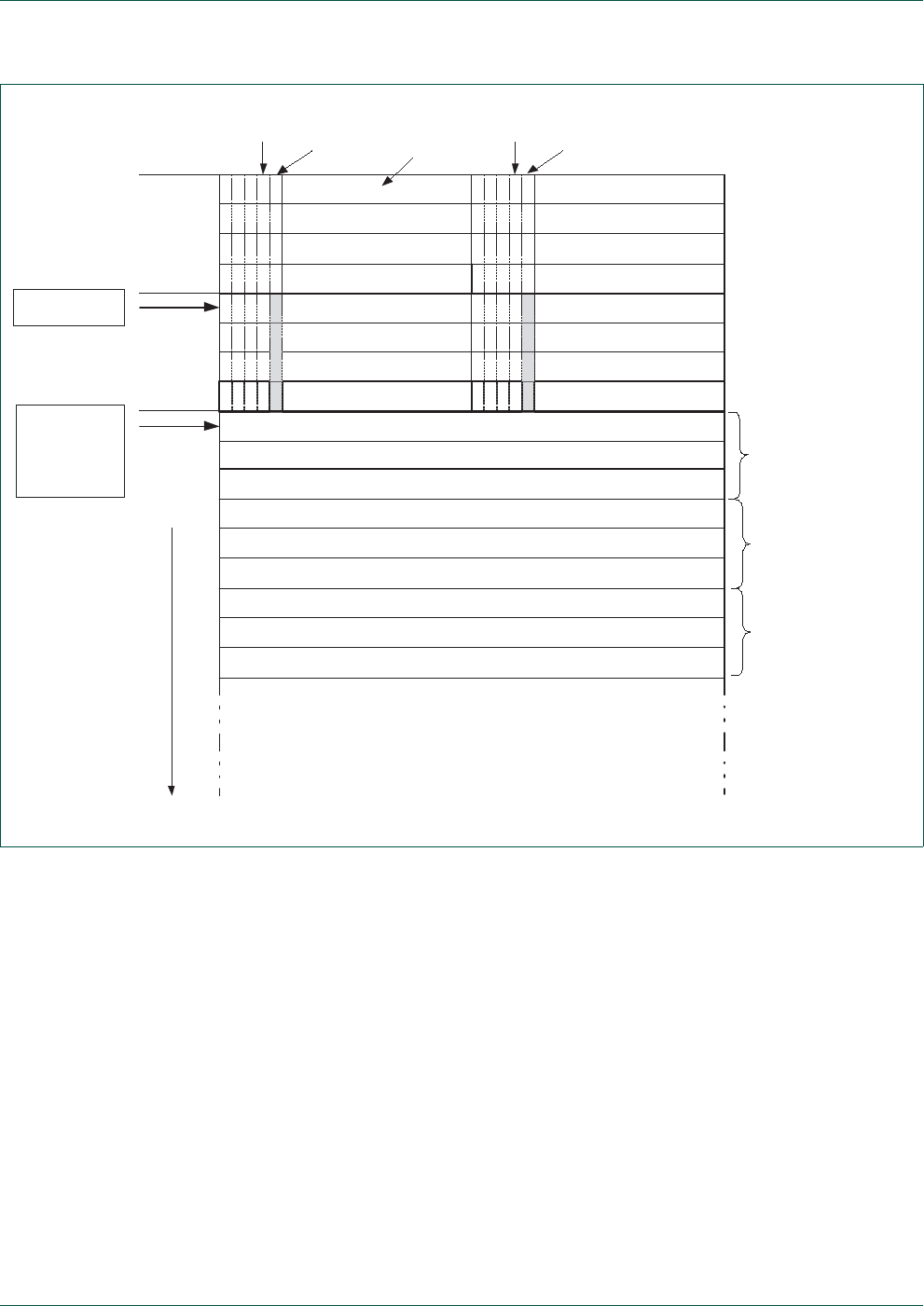
UM10360 All information provided in this document is subject to legal disclaimers. © NXP B.V. 2014. All rights reserved.
User manual Rev. 3.1 — 2 April 2014 408 of 849
NXP Semiconductors UM10360
Chapter 16: LPC176x/5x CAN1/2
16.17.8 Look-up table programming guidelines
All identifier sections of the ID Look-up Table have to be programmed in such a way, that
each active section is organized as a sorted list or table with an increasing order of the
Source CAN Channel (SCC) together with CAN Identifier in each section.
SCC value equals CAN_controller - 1, i.e., SCC = 0 matches CAN1 and SCC = 1
matches CAN2.
In cases, where a syntax error in the ID Look-up Table is encountered, the Look-up Table
address of the incorrect line is made available in the Look-up Table Error Address
Register (LUTerrAd).
The reporting process in the Look-up Table Error Address Register (LUTerrAd) is a
“run-time” process. Only those address lines with syntax error are reported, which were
passed through the acceptance filtering process.
The following general rules for programming the Look-up Table apply:
Fig 74. ID Look-up table configuration example (FullCAN activated and enabled)
15
0
SCC
0
14
0
SCC
0
...
...
FullCAN
Explicit
Standard
Frame
Format
Identifier
Section
Explicit
Standard
Frame
Format
Identifier
Section
SFF_sa
= 0x10
FF RTR SEM DLC CAN-ID
FullCAN
Message
Object
section
Section
ENDofTable =
SFF_GRP_sa =
EFF_sa =
EFF_GRP_sa =
0x20
RXDATA 4, 3, 2, 1
RXDATA 8, 7, 6, 5
No Message Data, disabled.
No Message Data, disabled.
No Message Data, disabled.
FF RTR SEM DLC CAN-ID
RXDATA 4, 3, 2, 1
RXDATA 8, 7, 6, 5
Message Object
Data 0
Message Object
Data 1
Message Object
Data 2
Index
FullCAN
Interrupt
Enable bit
FullCAN
Interrupt
Enable bit
0
0
SCC
0
Disabled, 1
1
SCC
1
2
0
SCC
1
4
0
SCC
1
6
0
SCC
1
3
0
SCC
0
5
0
SCC
0
7
0
SCC
0
12
0
SCC
0
11
0
SCC
0
13
0
SCC
0
10
0
SCC
0
8
0
SCC
0
9
0
SCC
0
Message
Disable bit
Message
Disable bit
MSB
ID28
MSB
ID28
MSB
ID28
MSB
ID28
MSB
ID28
MSB
ID28
MSB
ID28
MSB
ID28
MSB
ID28
MSB
ID28
MSB
ID28
MSB
ID28
MSB
ID28
MSB
ID28
MSB
ID28
MSB
ID28
LSB
ID18
LSB
ID18
LSB
ID18
LSB
ID18
LSB
ID18
LSB
ID18
LSB
ID18
LSB
ID18
LSB
ID18
LSB
ID18
LSB
ID18
LSB
ID18
LSB
ID18
LSB
ID18
LSB
ID18
LSB
ID18

UM10360 All information provided in this document is subject to legal disclaimers. © NXP B.V. 2014. All rights reserved.
User manual Rev. 3.1 — 2 April 2014 409 of 849
NXP Semiconductors UM10360
Chapter 16: LPC176x/5x CAN1/2
•Each section has to be organized as a sorted list or table with an increasing order of
the Source CAN Channel (SCC) in conjunction with the CAN Identifier (there is no
exception for disabled identifiers).
•The upper and lower bound in a Group of Identifiers definition has to be from the
same Source CAN Channel.
•To disable a Group of Identifiers the message disable bit has to be set for both, the
upper and lower bound.

UM10360 All information provided in this document is subject to legal disclaimers. © NXP B.V. 2014. All rights reserved.
User manual Rev. 3.1 — 2 April 2014 410 of 849
17.1 Basic configuration
The SPI is configured using the following registers:
1. Power: In the PCONP register (Ta b le 46 ), set bit PCSPI.
Remark: On reset, the SPI is enabled (PCSPI = 1).
2. Clock: In the PCLKSEL0 register (Tab l e 40), set bit PCLK_SPI. In master mode, the
clock must be an even number greater than or equal to 8 (see Section 17.7.4).
3. Pins: The SPI pins are configured using both PINSEL0 (Tab le 8 0 ) and PINSEL1
(Tab le 8 1 ), as well as the PINMODE (Section 8.4) register. PINSEL0[31:30] is used to
configure the SPI CLK pin. PINSEL1[1:0], PINSEL1[3:2] and PINSEL1[5:4] are used
to configure the pins SSEL, MISO and MOSI, respectively.
4. Interrupts: The SPI interrupt flag is enabled using the S0SPINT[0] bit (Section 17.7.7).
The SPI interrupt flag must be enabled in the NVIC, see Table 50 .
Remark: SSP0 is intended to be used as an alternative for the SPI interface. SPI is
included as a legacy peripheral.
17.2 Features
•Compliant with Serial Peripheral Interface (SPI) specification.
•Synchronous, Serial, Full Duplex Communication.
•SPI master or slave.
•Maximum data bit rate of one eighth of the peripheral clock rate.
•8 to 16 bits per transfer.
17.3 SPI overview
SPI is a full duplex serial interface. It can handle multiple masters and slaves being
connected to a given bus. Only a single master and a single slave can communicate on
the interface during a given data transfer. During a data transfer the master always sends
8 to 16 bits of data to the slave, and the slave always sends a byte of data to the master.
UM10360
Chapter 17: LPC176x/5x SPI
Rev. 3.1 — 2 April 2014 User manual

UM10360 All information provided in this document is subject to legal disclaimers. © NXP B.V. 2014. All rights reserved.
User manual Rev. 3.1 — 2 April 2014 411 of 849
NXP Semiconductors UM10360
Chapter 17: LPC176x/5x SPI
17.4 Pin description
17.5 SPI data transfers
Figure 75 is a timing diagram that illustrates the four different data transfer formats that
are available with the SPI port. This timing diagram illustrates a single 8-bit data transfer.
The first thing you should notice in this timing diagram is that it is divided into three
horizontal parts. The first part describes the SCK and SSEL signals. The second part
describes the MOSI and MISO signals when the Clock Phase control bit (CPHA) in the
SPI Control Register is 0. The third part describes the MOSI and MISO signals when the
CPHA variable is 1.
In the first part of the timing diagram, note two points. First, the SPI is illustrated with the
Clock Polarity control bit (CPOL) in the SPI Control Register set to both 0 and 1. The
second point to note is the activation and de-activation of the SSEL signal. When
CPHA = 0, the SSEL signal will always go inactive between data transfers. This is not
guaranteed when CPHA = 1 (the signal can remain active).
Table 359. SPI pin description
Pin
Name
Type Pin Description
SCK Input/
Output
Serial Clock. The SPI clock signal (SCK) is used to synchronize the transfer of
data across the SPI interface. The SPI is always driven by the master and
received by the slave. The clock is programmable to be active high or active
low. The SPI is only active during a data transfer. Any other time, it is either in its
inactive state, or tri-stated.
SSEL Input Slave Select. The SPI slave select signal (SSEL) is an active low signal that
indicates which slave is currently selected to participate in a data transfer. Each
slave has its own unique slave select signal input. The SSEL must be low before
data transactions begin and normally stays low for the duration of the
transaction. If the SSEL signal goes high any time during a data transfer, the
transfer is considered to be aborted. In this event, the slave returns to idle, and
any data that was received is thrown away. There are no other indications of this
exception. This signal is not directly driven by the master. It could be driven by a
simple general purpose I/O under software control.
MISO Input/
Output
Master In Slave Out. The SPI Master In Slave Out signal (MISO) is a
unidirectional signal used to transfer serial data from an SPI slave to an SPI
master. When a device is a slave, serial data is output on this pin. When a
device is a master, serial data is input on this pin. When a slave device is not
selected, the slave drives the signal high-impedance.
MOSI Input/
Output
Master Out Slave In. The SPI Master Out Slave In signal (MOSI) is a
unidirectional signal used to transfer serial data from an SPI master to an SPI
slave. When a device is a master, serial data is output on this pin. When a
device is a slave, serial data is input on this pin.
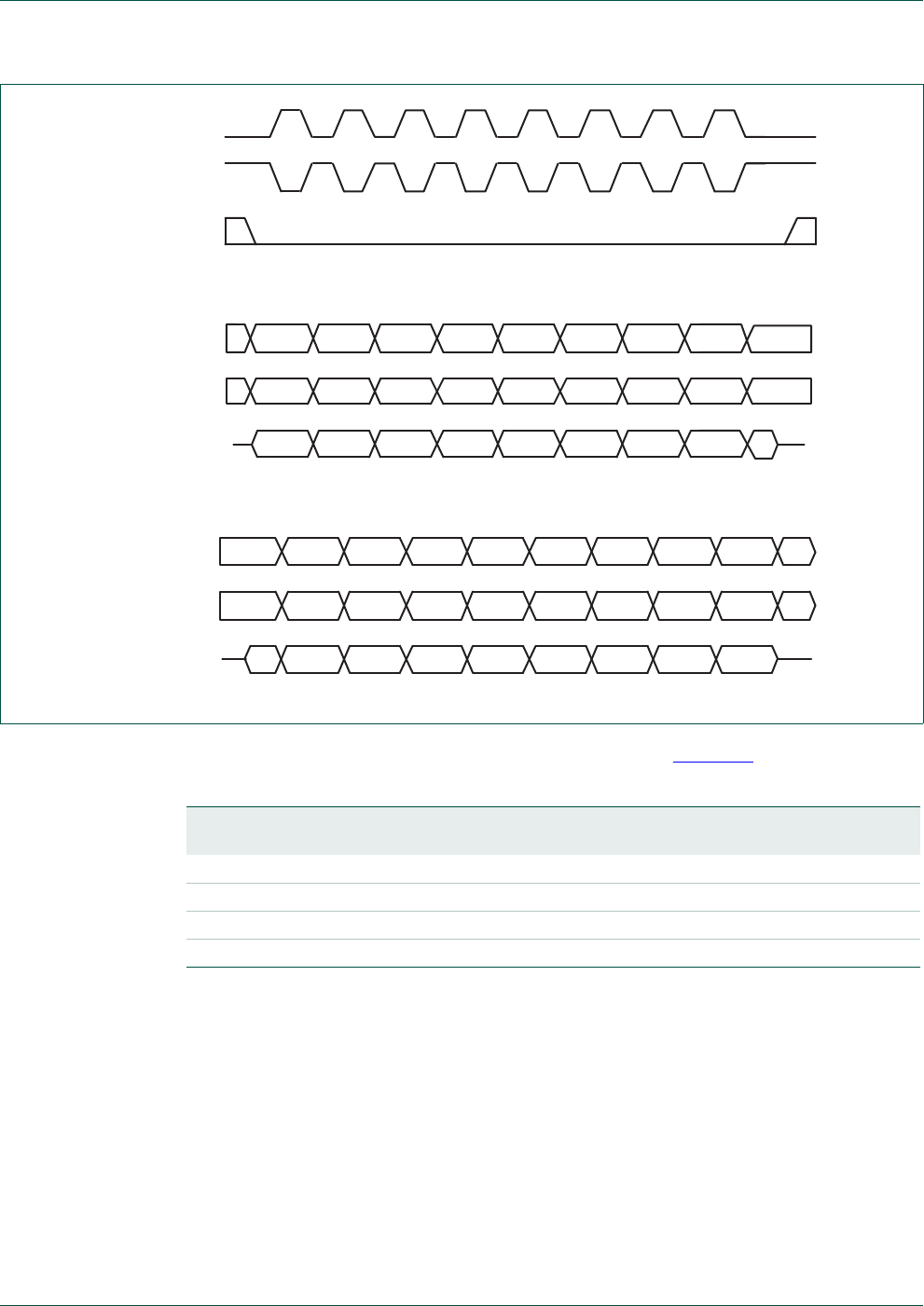
UM10360 All information provided in this document is subject to legal disclaimers. © NXP B.V. 2014. All rights reserved.
User manual Rev. 3.1 — 2 April 2014 412 of 849
NXP Semiconductors UM10360
Chapter 17: LPC176x/5x SPI
The data and clock phase relationships are summarized in Ta b le 3 6 0 .
The definition of when a transfer starts and stops is dependent on whether a device is a
master or a slave, and the setting of the CPHA variable.
When a device is a master, the start of a transfer is indicated by the master having a byte
of data that is ready to be transmitted. At this point, the master can activate the clock, and
begin the transfer. The transfer ends when the last clock cycle of the transfer is complete.
When a device is a slave and CPHA is set to 0, the transfer starts when the SSEL signal
goes active, and ends when SSEL goes inactive. When a device is a slave, and CPHA is
set to 1, the transfer starts on the first clock edge when the slave is selected, and ends on
the last clock edge where data is sampled.
Fig 75. SPI data transfer format (CPHA = 0 and CPHA = 1)
MISO (CPHA = 1)
MOSI (CPHA = 1)
Cycle # CPHA = 1
CPHA = 1
MISO (CPHA = 0)
MOSI (CPHA = 0)
Cycle # CPHA = 0
CPHA = 0
SSEL
SCK (CPOL = 1)
SCK (CPOL = 0)
123 87654
BIT 1 BIT 2 BIT 3 BIT 8BIT 7BIT 6BIT 5BIT 4
BIT 1 BIT 2 BIT 3 BIT 8BIT 7BIT 6BIT 5BIT 4
123 87654
BIT 1 BIT 2 BIT 3 BIT 8BIT 7BIT 6BIT 5BIT 4
BIT 1 BIT 2 BIT 3 BIT 8BIT 7BIT 6BIT 5BIT 4
Table 360. SPI Data To Clock Phase Relationship
CPOL and CPHA
settings
When the first data bit is
driven
When all other data
bits are driven
When data is
sampled
CPOL = 0, CPHA = 0 Prior to first SCK rising edge SCK falling edge SCK rising edge
CPOL = 0, CPHA = 1 First SCK rising edge SCK rising edge SCK falling edge
CPOL = 1, CPHA = 0 Prior to first SCK falling edge SCK rising edge SCK falling edge
CPOL = 1, CPHA = 1 First SCK falling edge SCK falling edge SCK rising edge

UM10360 All information provided in this document is subject to legal disclaimers. © NXP B.V. 2014. All rights reserved.
User manual Rev. 3.1 — 2 April 2014 413 of 849
NXP Semiconductors UM10360
Chapter 17: LPC176x/5x SPI
17.6 SPI peripheral details
17.6.1 General information
There are five control and status registers for the SPI port. They are described in detail in
Section 17.7 “Register description” on page 415.
The SPI Control Register (S0SPCR) contains a number of programmable bits used to
control the function of the SPI block. The settings for this register must be set up prior to a
given data transfer taking place.
The SPI Status Register (S0SPSR) contains read-only bits that are used to monitor the
status of the SPI interface, including normal functions, and exception conditions. The
primary purpose of this register is to detect completion of a data transfer. This is indicated
by the SPI Interrupt Flag (SPIF) in the S0SPINT register. The remaining bits in the register
are exception condition indicators. These exceptions will be described later in this section.
The SPI Data Register (S0SPDR) is used to provide the transmit and receive data bytes.
An internal shift register in the SPI block logic is used for the actual transmission and
reception of the serial data. Data is written to the SPI Data Register for the transmit case.
There is no buffer between the data register and the internal shift register. A write to the
data register goes directly into the internal shift register. Therefore, data should only be
written to this register when a transmit is not currently in progress. Read data is buffered.
When a transfer is complete, the receive data is transferred to a single byte data buffer,
where it is later read. A read of the SPI Data Register returns the value of the read data
buffer.
The SPI Clock Counter Register (S0SPCCR) controls the clock rate when the SPI block is
in master mode. This needs to be set prior to a transfer taking place, when the SPI block
is a master. This register has no function when the SPI block is a slave.
Prior to use, SPI configurations such as the master/slave settings, clock polarity, clock
rate, etc. must be set up in the SPI Control Register and SPI Clock Counter Register.
The I/Os for this implementation of SPI are standard CMOS I/Os. The open drain SPI
option is not implemented in this design. When a device is set up to be a slave, its I/Os are
only active when it is selected by the SSEL signal being active.
17.6.2 Master operation
The following sequence can be followed to set up the SPI prior to its first use as a master.
This is typically done during program initialization.
1. Set the SPI Clock Counter Register to the desired clock rate.
2. Set the SPI Control Register to the desired settings for master mode.
The following sequence describes how one should process a data transfer with the SPI
block when it is set up to be the master. This process assumes that any prior data transfer
has already completed.
1. Optionally, verify the SPI setup before starting the transfer.
2. Write the data to transmitted to the SPI Data Register. This write starts the SPI data
transfer.

UM10360 All information provided in this document is subject to legal disclaimers. © NXP B.V. 2014. All rights reserved.
User manual Rev. 3.1 — 2 April 2014 414 of 849
NXP Semiconductors UM10360
Chapter 17: LPC176x/5x SPI
3. Wait for the SPIF bit in the SPI Status Register to be set to 1. The SPIF bit will be set
after the last cycle of the SPI data transfer.
4. Read the SPI Status Register.
5. Read the received data from the SPI Data Register (optional).
6. Go to step 2 if more data is to be transmitted.
Note: A read or write of the SPI Data Register is required in order to clear the SPIF status
bit. Therefore, if the optional read of the SPI Data Register does not take place, a write to
this register is required in order to clear the SPIF status bit.
17.6.3 Slave operation
The following sequence can be followed to set up the SPI prior to its first use as a slave.
This is typically done during program initialization.
1. Set the SPI Control Register to the desired settings for slave mode.
The following sequence describes how one should process a data transfer with the SPI
block when it is set up to be a slave. This process assumes that any prior data transfer
has already completed. It is required that the system clock driving the SPI logic be at least
8X faster than the SPI.
1. Optionally, verify the SPI setup before starting the transfer.
2. Write the data to transmitted to the SPI Data Register (optional). Note that this can
only be done when a slave SPI transfer is not in progress.
3. Wait for the SPIF bit in the SPI Status Register to be set to 1. The SPIF bit will be set
after the last sampling clock edge of the SPI data transfer.
4. Read the SPI Status Register.
5. Read the received data from the SPI Data Register (optional).
6. Go to step 2 if more data is to be transferred.
Note: A read or write of the SPI Data Register is required in order to clear the SPIF status
bit. Therefore, at least one of the optional reads or writes of the SPI Data Register must
take place, in order to clear the SPIF status bit.
17.6.4 Exception conditions
Read Overrun
A read overrun occurs when the SPI block internal read buffer contains data that has not
been read by the processor, and a new transfer has completed. The read buffer
containing valid data is indicated by the SPIF bit in the SPI Interrupt Register being active.
When a transfer completes, the SPI block needs to move the received data to the read
buffer. If the SPIF bit is active (the read buffer is full), the new receive data will be lost, and
the read overrun (ROVR) bit in the SPI Status Register will be activated.
Write Collision
As stated previously, there is no write buffer between the SPI block bus interface, and the
internal shift register. As a result, data must not be written to the SPI Data Register when
a SPI data transfer is currently in progress. The time frame where data cannot be written
to the SPI Data Register is from when the transfer starts, until after the SPI Status

UM10360 All information provided in this document is subject to legal disclaimers. © NXP B.V. 2014. All rights reserved.
User manual Rev. 3.1 — 2 April 2014 415 of 849
NXP Semiconductors UM10360
Chapter 17: LPC176x/5x SPI
Register has been read when the SPIF status is active. If the SPI Data Register is written
in this time frame, the write data will be lost, and the write collision (WCOL) bit in the SPI
Status Register will be activated.
Mode Fault
If the SSEL signal goes active when the SPI block is a master, this indicates another
master has selected the device to be a slave. This condition is known as a mode fault.
When a mode fault is detected, the mode fault (MODF) bit in the SPI Status Register will
be activated, the SPI signal drivers will be de-activated, and the SPI mode will be changed
to be a slave.
If the SSEL function is assigned to its related pin in the relevant Pin Function Select
Register, the SSEL signal must always be inactive when the SPI controller is a master.
Slave Abort
A slave transfer is considered to be aborted if the SSEL signal goes inactive before the
transfer is complete. In the event of a slave abort, the transmit and receive data for the
transfer that was in progress are lost, and the slave abort (ABRT) bit in the SPI Status
Register will be activated.
17.7 Register description
The SPI contains 5 registers as shown in Tab le 36 1 . All registers are byte, half word and
word accessible.
[1] Reset Value reflects the data stored in used bits only. It does not include reserved bits content.
17.7.1 SPI Control Register (S0SPCR - 0x4002 0000)
The S0SPCR register controls the operation of SPI0 as per the configuration bits setting
shown in Ta b l e 36 2 .
Table 361. SPI register map
Name Description Access Reset
Value[1]
Address
S0SPCR SPI Control Register. This register controls the
operation of the SPI.
R/W 0x00 0x4002 0000
S0SPSR SPI Status Register. This register shows the
status of the SPI.
RO 0x00 0x4002 0004
S0SPDR SPI Data Register. This bi-directional register
provides the transmit and receive data for the
SPI. Transmit data is provided to the SPI0 by
writing to this register. Data received by the SPI0
can be read from this register.
R/W 0x00 0x4002 0008
S0SPCCR SPI Clock Counter Register. This register
controls the frequency of a master’s SCK0.
R/W 0x00 0x4002 000C
S0SPINT SPI Interrupt Flag. This register contains the
interrupt flag for the SPI interface.
R/W 0x00 0x4002 001C

UM10360 All information provided in this document is subject to legal disclaimers. © NXP B.V. 2014. All rights reserved.
User manual Rev. 3.1 — 2 April 2014 416 of 849
NXP Semiconductors UM10360
Chapter 17: LPC176x/5x SPI
Table 362: SPI Control Register (S0SPCR - address 0x4002 0000) bit description
Bit Symbol Value Description Reset
Value
1:0 - Reserved, user software should not write ones to reserved bits.
The value read from a reserved bit is not defined.
NA
2BitEnable0 The SPI controller sends and receives 8 bits of data per
transfer.
0
1The SPI controller sends and receives the number of bits
selected by bits 11:8.
3CPHA Clock phase control determines the relationship between the
data and the clock on SPI transfers, and controls when a slave
transfer is defined as starting and ending.
0
0Data is sampled on the first clock edge of SCK. A transfer starts
and ends with activation and deactivation of the SSEL signal.
1Data is sampled on the second clock edge of the SCK. A
transfer starts with the first clock edge, and ends with the last
sampling edge when the SSEL signal is active.
4CPOL Clock polarity control. 0
0SCK is active high.
1SCK is active low.
5 MSTR Master mode select. 0
0The SPI operates in Slave mode.
1The SPI operates in Master mode.
6LSBF LSB First controls which direction each byte is shifted when
transferred.
0
0SPI data is transferred MSB (bit 7) first.
1 SPI data is transferred LSB (bit 0) first.
7SPIE Serial peripheral interrupt enable. 0
0SPI interrupts are inhibited.
1A hardware interrupt is generated each time the SPIF or MODF
bits are activated.
11:8 BITS When bit 2 of this register is 1, this field controls the number of
bits per transfer:
0000
1000 8 bits per transfer
1001 9 bits per transfer
1010 10 bits per transfer
1011 11 bits per transfer
1100 12 bits per transfer
1101 13 bits per transfer
1110 14 bits per transfer
1111 15 bits per transfer
0000 16 bits per transfer
31:12 - Reserved, user software should not write ones to reserved bits.
The value read from a reserved bit is not defined.
NA

UM10360 All information provided in this document is subject to legal disclaimers. © NXP B.V. 2014. All rights reserved.
User manual Rev. 3.1 — 2 April 2014 417 of 849
NXP Semiconductors UM10360
Chapter 17: LPC176x/5x SPI
17.7.2 SPI Status Register (S0SPSR - 0x4002 0004)
The S0SPSR register controls the operation of SPI0 as per the configuration bits setting
shown in Ta b l e 36 3 .
17.7.3 SPI Data Register (S0SPDR - 0x4002 0008)
This bi-directional data register provides the transmit and receive data for the SPI.
Transmit data is provided to the SPI by writing to this register. Data received by the SPI
can be read from this register. When used as a master, a write to this register will start an
SPI data transfer. Writes to this register will be blocked when a data transfer starts, or
when the SPIF status bit is set, and the SPI Status Register has not been read.
17.7.4 SPI Clock Counter Register (S0SPCCR - 0x4002 000C)
This register controls the frequency of a master’s SCK. The register indicates the number
of SPI peripheral clock cycles that make up an SPI clock.
Table 363: SPI Status Register (S0SPSR - address 0x4002 0004) bit description
Bit Symbol Description Reset
Value
2:0 - Reserved, user software should not write ones to reserved bits. The
value read from a reserved bit is not defined.
NA
3ABRTSlave abort. When 1, this bit indicates that a slave abort has occurred.
This bit is cleared by reading this register.
0
4MODFMode fault. when 1, this bit indicates that a Mode fault error has
occurred. This bit is cleared by reading this register, then writing the
SPI0 control register.
0
5ROVRRead overrun. When 1, this bit indicates that a read overrun has
occurred. This bit is cleared by reading this register.
0
6WCOLWrite collision. When 1, this bit indicates that a write collision has
occurred. This bit is cleared by reading this register, then accessing the
SPI Data Register.
0
7SPIFSPI transfer complete flag. When 1, this bit indicates when a SPI data
transfer is complete. When a master, this bit is set at the end of the last
cycle of the transfer. When a slave, this bit is set on the last data
sampling edge of the SCK. This bit is cleared by first reading this
register, then accessing the SPI Data Register.
Note: this is not the SPI interrupt flag. This flag is found in the SPINT
register.
0
31:8 - Reserved, user software should not write ones to reserved bits. The
value read from a reserved bit is not defined.
NA
Table 364: SPI Data Register (S0SPDR - address 0x4002 0008) bit description
Bit Symbol Description Reset
Value
7:0 DataLow SPI Bi-directional data port. 0x00
15:8 DataHigh If bit 2 of the SPCR is 1 and bits 11:8 are other than 1000, some or all
of these bits contain the additional transmit and receive bits. When less
than 16 bits are selected, the more significant among these bits read
as zeroes.
0x00
31:16 - Reserved, user software should not write ones to reserved bits. The
value read from a reserved bit is not defined.
NA

UM10360 All information provided in this document is subject to legal disclaimers. © NXP B.V. 2014. All rights reserved.
User manual Rev. 3.1 — 2 April 2014 418 of 849
NXP Semiconductors UM10360
Chapter 17: LPC176x/5x SPI
In Master mode, this register must be an even number greater than or equal to 8.
Violations of this can result in unpredictable behavior. The SPI0 SCK rate may be
calculated as: PCLK_SPI / SPCCR0 value. The SPI peripheral clock is determined by the
PCLKSEL0 register contents for PCLK_SPI as described in Section 4.7.3.
In Slave mode, the SPI clock rate provided by the master must not exceed 1/8 of the SPI
peripheral clock selected in Section 4.7.3. The content of the S0SPCCR register is not
relevant.
17.7.5 SPI Test Control Register (SPTCR - 0x4002 0010)
Note that the bits in this register are intended for functional verification only. This register
should not be used for normal operation.
17.7.6 SPI Test Status Register (SPTSR - 0x4002 0014)
Note: The bits in this register are intended for functional verification only. This register
should not be used for normal operation.
This register is a replication of the SPI Status Register. The difference between the
registers is that a read of this register will not start the sequence of events required to
clear these status bits. A write to this register will set an interrupt if the write data for the
respective bit is a 1.
Table 365: SPI Clock Counter Register (S0SPCCR - address 0x4002 000C) bit description
Bit Symbol Description Reset
Value
7:0 Counter SPI0 Clock counter setting. 0x00
31:8 - Reserved, user software should not write ones to reserved bits. The
value read from a reserved bit is not defined.
NA
Table 366: SPI Test Control Register (SPTCR - address 0x4002 0010) bit description
Bit Symbol Description Reset
Value
0Test SPI test mode. When 0, the SPI operates normally. When 1, SCK will
always be on, independent of master mode select, and data availability
setting.
NA
31:1 - Reserved, user software should not write ones to reserved bits. The
value read from a reserved bit is not defined.
NA
Table 367: SPI Test Status Register (SPTSR - address 0x4002 0014) bit description
Bit Symbol Description Reset
Value
2:0 - Reserved, user software should not write ones to reserved bits. The
value read from a reserved bit is not defined.
NA
3ABRTSlave abort. 0
4MODFMode fault. 0
5ROVRRead overrun. 0

UM10360 All information provided in this document is subject to legal disclaimers. © NXP B.V. 2014. All rights reserved.
User manual Rev. 3.1 — 2 April 2014 419 of 849
NXP Semiconductors UM10360
Chapter 17: LPC176x/5x SPI
17.7.7 SPI Interrupt Register (S0SPINT - 0x4002 001C)
This register contains the interrupt flag for the SPI0 interface.
6WCOLWrite collision. 0
7SPIFSPI transfer complete flag. 0
31:8 - Reserved, user software should not write ones to reserved bits. The
value read from a reserved bit is not defined.
NA
Table 367: SPI Test Status Register (SPTSR - address 0x4002 0014) bit description
Bit Symbol Description Reset
Value
Table 368: SPI Interrupt Register (S0SPINT - address 0x4002 001C) bit description
Bit Symbol Description Reset
Value
0SPIFSPI interrupt flag. Set by the SPI interface to generate an interrupt.
Cleared by writing a 1 to this bit.
Note: this bit will be set once when SPIE = 1 and at least one of SPIF
and WCOL bits is 1. However, only when the SPI Interrupt bit is set and
SPI0 Interrupt is enabled in the NVIC, SPI based interrupt can be
processed by interrupt handling software.
0
7:1 - Reserved, user software should not write ones to reserved bits. The
value read from a reserved bit is not defined.
NA
31:8 - Reserved, user software should not write ones to reserved bits. The
value read from a reserved bit is not defined.
NA
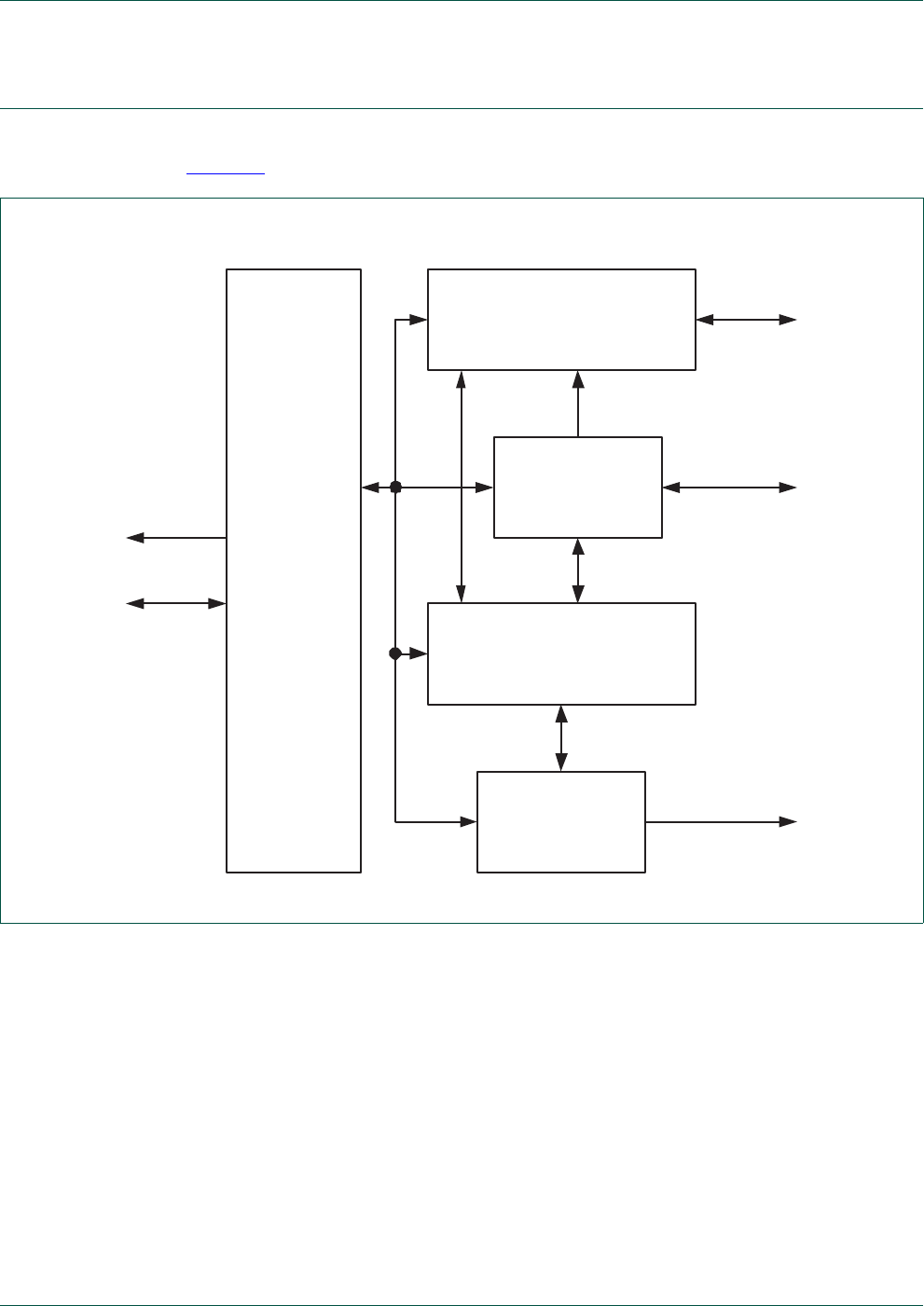
UM10360 All information provided in this document is subject to legal disclaimers. © NXP B.V. 2014. All rights reserved.
User manual Rev. 3.1 — 2 April 2014 420 of 849
NXP Semiconductors UM10360
Chapter 17: LPC176x/5x SPI
17.8 Architecture
The block diagram of the SPI solution implemented in SPI0 interface is shown in the
Figure 76.
Fig 76. SPI block diagram
MOSI_IN
MOSI_OUT
MISO_IN
MISO_OUT
OUTPUT
ENABLE
LOGIC
SPI REGISTER
INTERFACE
SPI Interrupt
APB Bus
SPI SHIFT REGISTER
SCK_OUT_EN
MOSI_OUT_EN
MISO_OUT_EN
SCK_IN
SCK_OUT
SS_IN
SPI STATE CONTROL
SPI CLOCK
GENERATOR &
DETECTOR

UM10360 All information provided in this document is subject to legal disclaimers. © NXP B.V. 2014. All rights reserved.
User manual Rev. 3.1 — 2 April 2014 421 of 849
18.1 Basic configuration
The two SSP interfaces, SSP0 and SSP1 are configured using the following registers:
1. Power: In the PCONP register (Ta b le 46 ), set bit PCSSP0 to enable SSP0 and bit
PCSSP1 to enable SSP1.
Remark: On reset, both SSP interfaces are enabled (PCSSP0/1 = 1).
2. Clock: In PCLKSEL0 select PCLK_SSP1; in PCLKSEL1 select PCLK_SSP0 (see
Section 4.7.3. In master mode, the clock must be scaled down (see Section 18.6.5).
3. Pins: Select the SSP pins through the PINSEL registers (Section 8.5) and pin modes
through the PINMODE registers (Section 8.4).
4. Interrupts: Interrupts are enabled in the SSP0IMSC register for SSP0 and SSP1IMSC
register for SSP1 Tab l e 37 6 . Interrupts are enabled in the NVIC using the appropriate
Interrupt Set Enable register, see Table 50.
5. Initialization: There are two control registers for each of the SSP ports to be
configured: SSP0CR0 and SSP0CR1 for SSP0, SSP1CR0 and SSP1CR1 for SSP1.
See Section 18.6.1 and Section 18.6.2.
6. DMA: The Rx and Tx FIFOs of the SSP interfaces can be connected to the GPDMA
controller (see Section 18.6.10). For GPDMA system connections, see Ta b le 5 4 4 .
Remark: SSP0 is intended to be used as an alternative for the SPI interface, which is
included as a legacy peripheral. Only one of these peripherals can be used at the any one
time.
18.2 Features
•Compatible with Motorola SPI, 4-wire TI SSI, and National Semiconductor Microwire
buses.
•Synchronous Serial Communication.
•Master or slave operation.
•8 frame FIFOs for both transmit and receive.
•4 to 16 bit data frame.
•DMA transfers supported by GPDMA.
18.3 Description
The SSP is a Synchronous Serial Port (SSP) controller capable of operation on a SPI,
4-wire SSI, or Microwire bus. It can interact with multiple masters and slaves on the bus.
Only a single master and a single slave can communicate on the bus during a given data
transfer. Data transfers are in principle full duplex, with frames of 4 to 16 bits of data
flowing from the master to the slave and from the slave to the master. In practice it is often
the case that only one of these data flows carries meaningful data.
The LPC176x/5x has two Synchronous Serial Port controllers -- SSP0 and SSP1.
UM10360
Chapter 18: LPC176x/5x SSP0/1
Rev. 3.1 — 2 April 2014 User manual

UM10360 All information provided in this document is subject to legal disclaimers. © NXP B.V. 2014. All rights reserved.
User manual Rev. 3.1 — 2 April 2014 422 of 849
NXP Semiconductors UM10360
Chapter 18: LPC176x/5x SSP0/1
18.4 Pin descriptions
18.5 Bus description
18.5.1 Texas Instruments synchronous serial frame format
Figure 77 shows the 4-wire Texas Instruments synchronous serial frame format supported
by the SSP module.
Table 369. SSP pin descriptions
Pin
Name Type
Interface pin
name/function Pin Description
SPI SSI Microwire
SCK0/1 I/O SCK CLK SK Serial Clock. SCK/CLK/SK is a clock signal used to synchronize the transfer
of data. It is driven by the master and received by the slave. When the SPI
interface is used, the clock is programmable to be active-high or active-low,
otherwise it is always active-high. SCK1 only switches during a data transfer.
Any other time, the SSPn interface either holds it in its inactive state, or does
not drive it (leaves it in high-impedance state).
SSEL0/1 I/O SSEL FS CS Frame Sync/Slave Select. When the SSPn interface is a bus master, it
drives this signal to an active state before the start of serial data, and then
releases it to an inactive state after the serial data has been sent. The active
state of this signal can be high or low depending upon the selected bus and
mode. When the SSPn is a bus slave, this signal qualifies the presence of
data from the Master, according to the protocol in use.
When there is just one bus master and one bus slave, the Frame Sync or
Slave Select signal from the Master can be connected directly to the slave's
corresponding input. When there is more than one slave on the bus, further
qualification of their Frame Select/Slave Select inputs will typically be
necessary to prevent more than one slave from responding to a transfer.
MISO0/1 I/O MISO DR(M)
DX(S)
SI(M)
SO(S)
Master In Slave Out. The MISO signal transfers serial data from the slave to
the master. When the SSPn is a slave, serial data is output on this signal.
When the SSPn is a master, it clocks in serial data from this signal. When the
SSPn is a slave and is not selected by FS/SSEL, it does not drive this signal
(leaves it in high-impedance state).
MOSI0/1 I/O MOSI DX(M)
DR(S)
SO(M)
SI(S)
Master Out Slave In. The MOSI signal transfers serial data from the master
to the slave. When the SSPn is a master, it outputs serial data on this signal.
When the SSPn is a slave, it clocks in serial data from this signal.
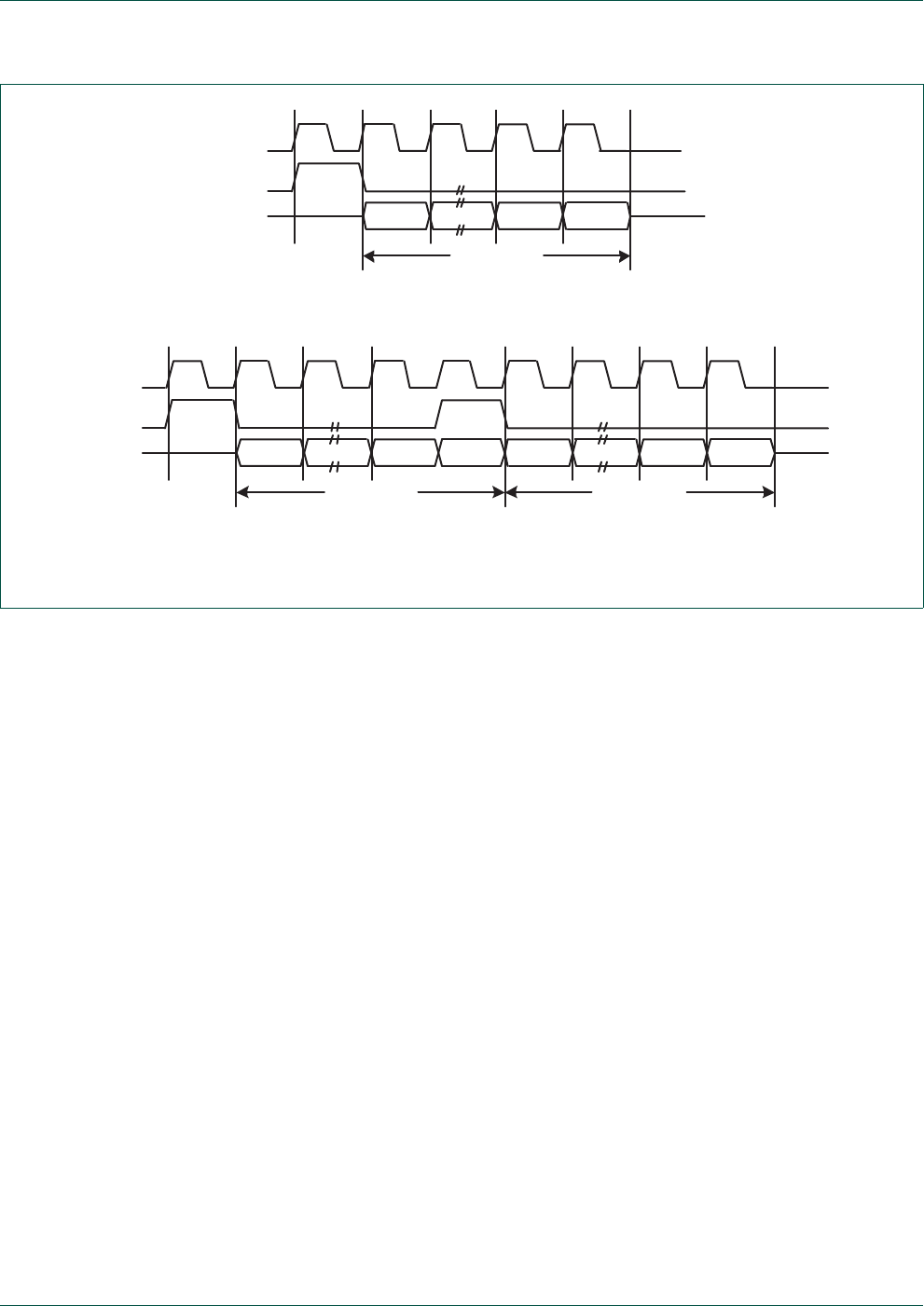
UM10360 All information provided in this document is subject to legal disclaimers. © NXP B.V. 2014. All rights reserved.
User manual Rev. 3.1 — 2 April 2014 423 of 849
NXP Semiconductors UM10360
Chapter 18: LPC176x/5x SSP0/1
For device configured as a master in this mode, CLK and FS are forced LOW, and the
transmit data line DX is tri-stated whenever the SSP is idle. Once the bottom entry of the
transmit FIFO contains data, FS is pulsed HIGH for one CLK period. The value to be
transmitted is also transferred from the transmit FIFO to the serial shift register of the
transmit logic. On the next rising edge of CLK, the MSB of the 4-bit to 16-bit data frame is
shifted out on the DX pin. Likewise, the MSB of the received data is shifted onto the DR
pin by the off-chip serial slave device.
Both the SSP and the off-chip serial slave device then clock each data bit into their serial
shifter on the falling edge of each CLK. The received data is transferred from the serial
shifter to the receive FIFO on the first rising edge of CLK after the LSB has been latched.
18.5.2 SPI frame format
The SPI interface is a four-wire interface where the SSEL signal behaves as a slave
select. The main feature of the SPI format is that the inactive state and phase of the SCK
signal are programmable through the CPOL and CPHA bits within the SSPCR0 control
register.
18.5.2.1 Clock Polarity (CPOL) and Phase (CPHA) control
When the CPOL clock polarity control bit is 0, it produces a steady state low value on the
SCK pin. If the CPOL clock polarity control bit is 1, a steady state high value is placed on
the CLK pin when data is not being transferred.
a. Single frame transfer
b. Continuous/back-to-back frames transfer
Fig 77. Texas Instruments Synchronous Serial Frame Format: a) Single and b) Continuous/back-to-back Two
Frames Transfer
CLK
FS
DX/DR
4 to 16 bits
MSB LSB
CLK
FS
DX/DR LSBMSB LSBMSB
4 to 16 bits 4 to 16 bits
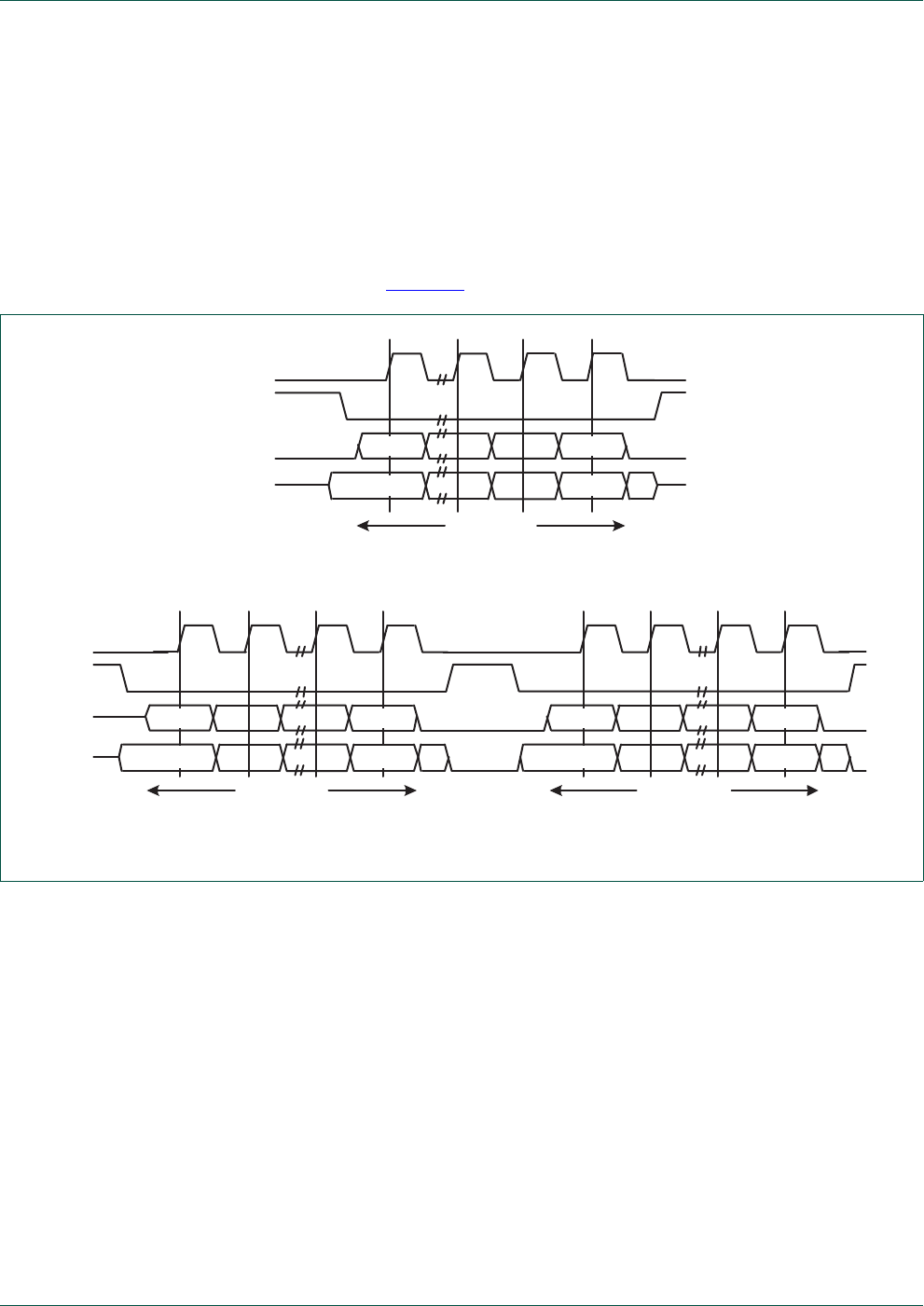
UM10360 All information provided in this document is subject to legal disclaimers. © NXP B.V. 2014. All rights reserved.
User manual Rev. 3.1 — 2 April 2014 424 of 849
NXP Semiconductors UM10360
Chapter 18: LPC176x/5x SSP0/1
The CPHA control bit selects the clock edge that captures data and allows it to change
state. It has the most impact on the first bit transmitted by either allowing or not allowing a
clock transition before the first data capture edge. When the CPHA phase control bit is 0,
data is captured on the first clock edge transition. If the CPHA clock phase control bit is 1,
data is captured on the second clock edge transition.
18.5.2.2 SPI format with CPOL=0,CPHA=0
Single and continuous transmission signal sequences for SPI format with CPOL = 0,
CPHA = 0 are shown in Figure 78.
In this configuration, during idle periods:
•The CLK signal is forced LOW.
•SSEL is forced HIGH.
•The transmit MOSI/MISO pad is in high impedance.
If the SSP is enabled and there is valid data within the transmit FIFO, the start of
transmission is signified by the SSEL master signal being driven LOW. This causes slave
data to be enabled onto the MISO input line of the master. Master’s MOSI is enabled.
One half SCK period later, valid master data is transferred to the MOSI pin. Now that both
the master and slave data have been set, the SCK master clock pin goes HIGH after one
further half SCK period.
The data is now captured on the rising and propagated on the falling edges of the SCK
signal.
a. Single transfer with CPOL=0 and CPHA=0
b. Continuous transfer with CPOL=0 and CPHA=0
Fig 78. SPI frame format with CPOL=0 and CPHA=0 (a) Single and b) Continuous Transfer)
SCK
SSEL
MOSI MSB LSB
QMSB LSB
4 to 16 bits
MISO
SCK
SSEL
MOSI
MISO
4 to 16 bits 4 to 16 bits
MSB LSBMSB LSB
QMSB LSB QMSB LSB
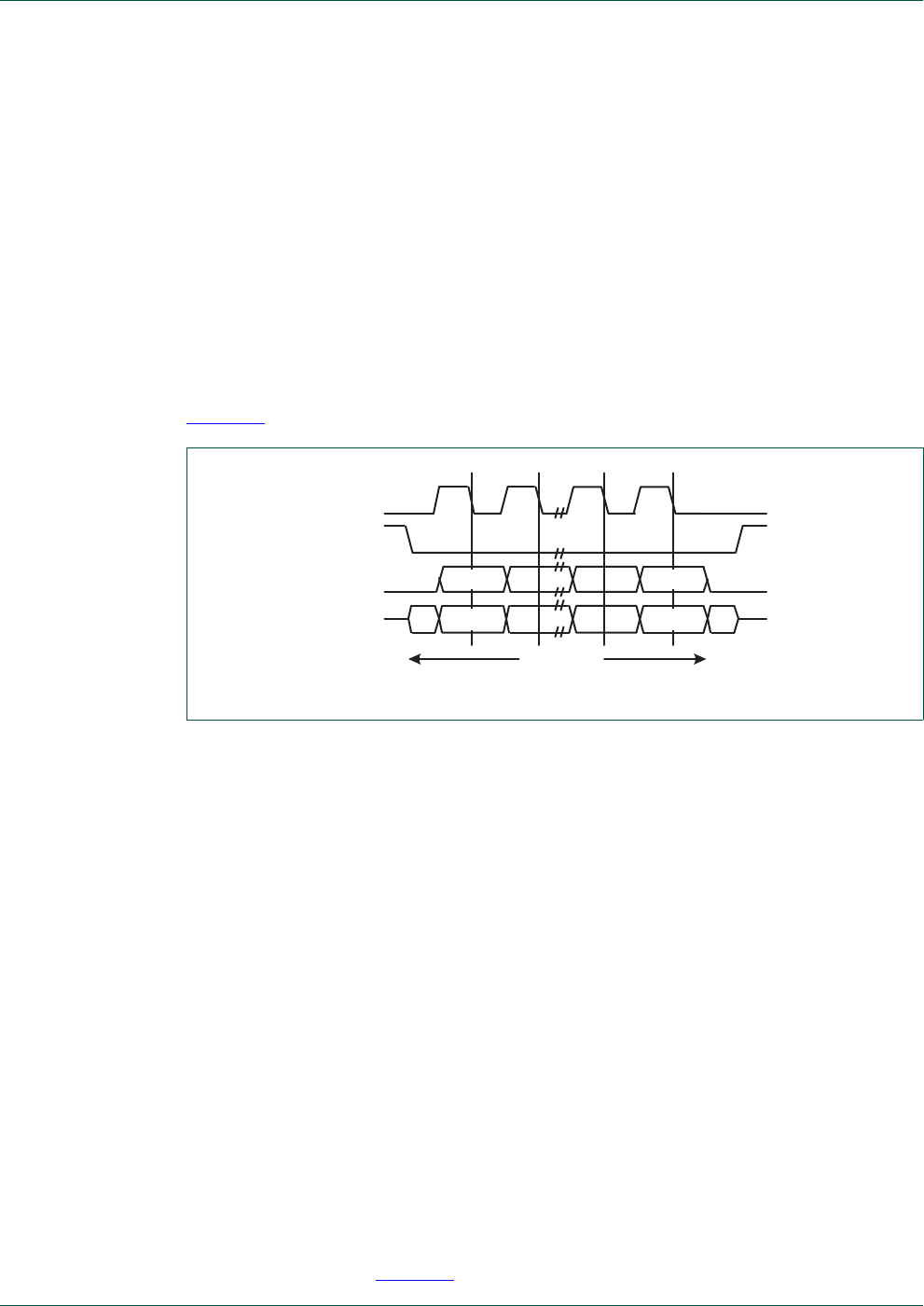
UM10360 All information provided in this document is subject to legal disclaimers. © NXP B.V. 2014. All rights reserved.
User manual Rev. 3.1 — 2 April 2014 425 of 849
NXP Semiconductors UM10360
Chapter 18: LPC176x/5x SSP0/1
In the case of a single word transmission, after all bits of the data word have been
transferred, the SSEL line is returned to its idle HIGH state one SCK period after the last
bit has been captured.
However, in the case of continuous back-to-back transmissions, the SSEL signal must be
pulsed HIGH between each data word transfer. This is because the slave select pin
freezes the data in its serial peripheral register and does not allow it to be altered if the
CPHA bit is logic zero. Therefore the master device must raise the SSEL pin of the slave
device between each data transfer to enable the serial peripheral data write. On
completion of the continuous transfer, the SSEL pin is returned to its idle state one SCK
period after the last bit has been captured.
18.5.2.3 SPI format with CPOL=0,CPHA=1
The transfer signal sequence for SPI format with CPOL = 0, CPHA = 1 is shown in
Figure 79, which covers both single and continuous transfers.
In this configuration, during idle periods:
•The CLK signal is forced LOW.
•SSEL is forced HIGH.
•The transmit MOSI/MISO pad is in high impedance.
If the SSP is enabled and there is valid data within the transmit FIFO, the start of
transmission is signified by the SSEL master signal being driven LOW. Master’s MOSI pin
is enabled. After a further one half SCK period, both master and slave valid data is
enabled onto their respective transmission lines. At the same time, the SCK is enabled
with a rising edge transition.
Data is then captured on the falling edges and propagated on the rising edges of the SCK
signal.
In the case of a single word transfer, after all bits have been transferred, the SSEL line is
returned to its idle HIGH state one SCK period after the last bit has been captured.
For continuous back-to-back transfers, the SSEL pin is held LOW between successive
data words and termination is the same as that of the single word transfer.
18.5.2.4 SPI format with CPOL = 1,CPHA = 0
Single and continuous transmission signal sequences for SPI format with CPOL=1,
CPHA=0 are shown in Figure 80.
Fig 79. SPI frame format with CPOL=0 and CPHA=1
SCK
SSEL
MOSI
Q
4 to 16 bits
MISO Q MSB
MSB LSB
LSB
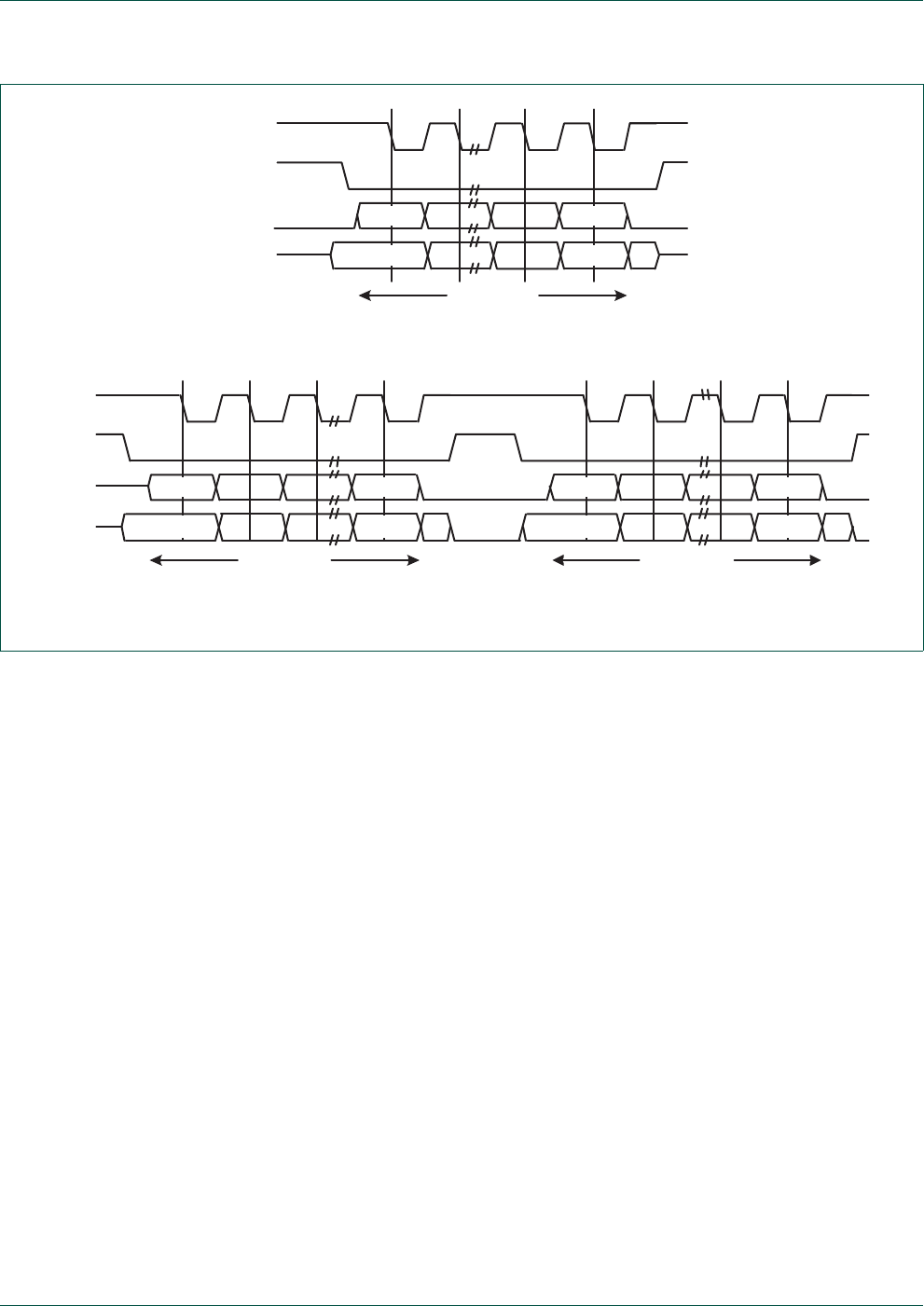
UM10360 All information provided in this document is subject to legal disclaimers. © NXP B.V. 2014. All rights reserved.
User manual Rev. 3.1 — 2 April 2014 426 of 849
NXP Semiconductors UM10360
Chapter 18: LPC176x/5x SSP0/1
In this configuration, during idle periods:
•The CLK signal is forced HIGH.
•SSEL is forced HIGH.
•The transmit MOSI/MISO pad is in high impedance.
If the SSP is enabled and there is valid data within the transmit FIFO, the start of
transmission is signified by the SSEL master signal being driven LOW, which causes
slave data to be immediately transferred onto the MISO line of the master. Master’s MOSI
pin is enabled.
One half period later, valid master data is transferred to the MOSI line. Now that both the
master and slave data have been set, the SCK master clock pin becomes LOW after one
further half SCK period. This means that data is captured on the falling edges and be
propagated on the rising edges of the SCK signal.
In the case of a single word transmission, after all bits of the data word are transferred, the
SSEL line is returned to its idle HIGH state one SCK period after the last bit has been
captured.
However, in the case of continuous back-to-back transmissions, the SSEL signal must be
pulsed HIGH between each data word transfer. This is because the slave select pin
freezes the data in its serial peripheral register and does not allow it to be altered if the
CPHA bit is logic zero. Therefore the master device must raise the SSEL pin of the slave
device between each data transfer to enable the serial peripheral data write. On
completion of the continuous transfer, the SSEL pin is returned to its idle state one SCK
period after the last bit has been captured.
a. Single transfer with CPOL=1 and CPHA=0
b. Continuous transfer with CPOL=1 and CPHA=0
Fig 80. SPI frame format with CPOL = 1 and CPHA = 0 (a) Single and b) Continuous Transfer)
SCK
SSEL
QMSB LSB
4 to 16 bits
MISO
MOSI MSB LSB
SCK
SSEL
MOSI
MISO
4 to 16 bits 4 to 16 bits
MSB LSBMSB LSB
QMSB LSB QMSB LSB
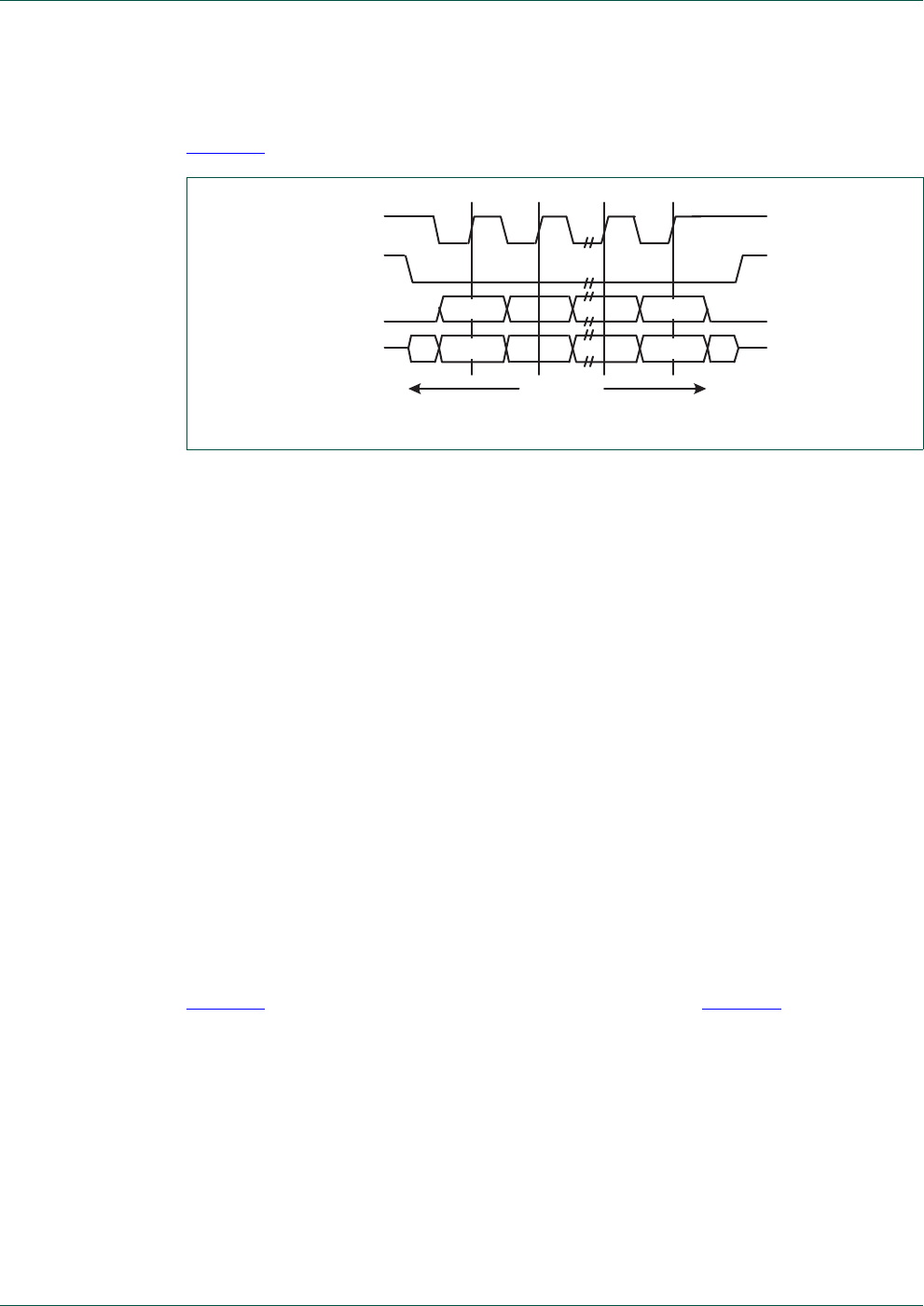
UM10360 All information provided in this document is subject to legal disclaimers. © NXP B.V. 2014. All rights reserved.
User manual Rev. 3.1 — 2 April 2014 427 of 849
NXP Semiconductors UM10360
Chapter 18: LPC176x/5x SSP0/1
18.5.2.5 SPI format with CPOL = 1,CPHA = 1
The transfer signal sequence for SPI format with CPOL = 1, CPHA = 1 is shown in
Figure 81, which covers both single and continuous transfers.
In this configuration, during idle periods:
•The CLK signal is forced HIGH.
•SSEL is forced HIGH.
•The transmit MOSI/MISO pad is in high impedance.
If the SSP is enabled and there is valid data within the transmit FIFO, the start of
transmission is signified by the SSEL master signal being driven LOW. Master’s MOSI is
enabled. After a further one half SCK period, both master and slave data are enabled onto
their respective transmission lines. At the same time, the SCK is enabled with a falling
edge transition. Data is then captured on the rising edges and propagated on the falling
edges of the SCK signal.
After all bits have been transferred, in the case of a single word transmission, the SSEL
line is returned to its idle HIGH state one SCK period after the last bit has been captured.
For continuous back-to-back transmissions, the SSEL pins remains in its active LOW
state, until the final bit of the last word has been captured, and then returns to its idle state
as described above. In general, for continuous back-to-back transfers the SSEL pin is
held LOW between successive data words and termination is the same as that of the
single word transfer.
18.5.3 National Semiconductor Microwire frame format
Figure 82 shows the Microwire frame format for a single frame. Figure 83 shows the same
format when back-to-back frames are transmitted.
Fig 81. SPI Frame Format with CPOL = 1 and CPHA = 1
SCK
SSEL
MOSI
Q
4 to 16 bits
MISO Q MSB
MSB LSB
LSB
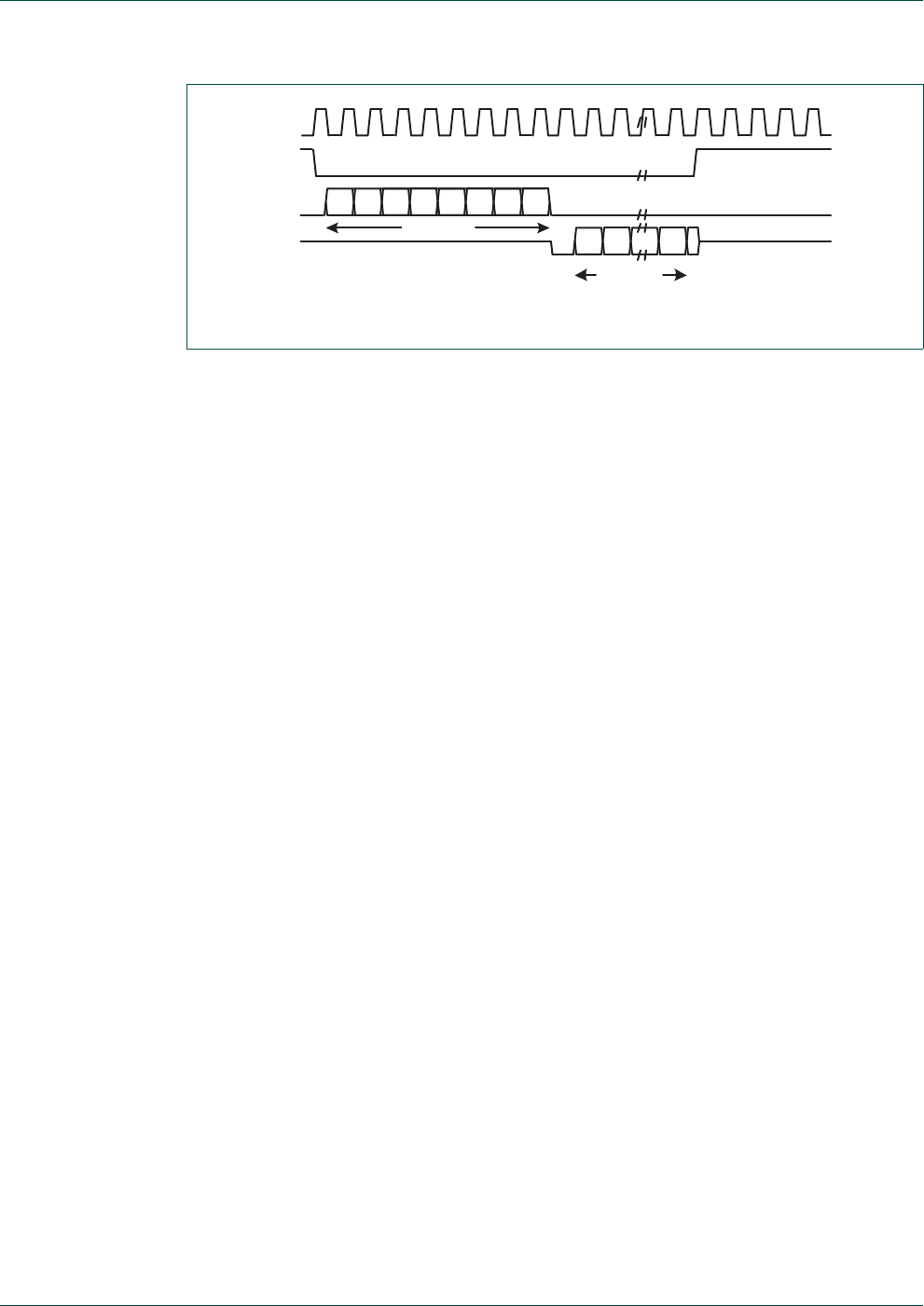
UM10360 All information provided in this document is subject to legal disclaimers. © NXP B.V. 2014. All rights reserved.
User manual Rev. 3.1 — 2 April 2014 428 of 849
NXP Semiconductors UM10360
Chapter 18: LPC176x/5x SSP0/1
Microwire format is very similar to SPI format, except that transmission is half-duplex
instead of full-duplex, using a master-slave message passing technique. Each serial
transmission begins with an 8-bit control word that is transmitted from the SSP to the
off-chip slave device. During this transmission, no incoming data is received by the SSP.
After the message has been sent, the off-chip slave decodes it and, after waiting one
serial clock after the last bit of the 8-bit control message has been sent, responds with the
required data. The returned data is 4 to 16 bits in length, making the total frame length
anywhere from 13 to 25 bits.
In this configuration, during idle periods:
•The SK signal is forced LOW.
•CS is forced HIGH.
•The transmit data line SO is arbitrarily forced LOW.
A transmission is triggered by writing a control byte to the transmit FIFO.The falling edge
of CS causes the value contained in the bottom entry of the transmit FIFO to be
transferred to the serial shift register of the transmit logic, and the MSB of the 8-bit control
frame to be shifted out onto the SO pin. CS remains LOW for the duration of the frame
transmission. The SI pin remains tristated during this transmission.
The off-chip serial slave device latches each control bit into its serial shifter on the rising
edge of each SK. After the last bit is latched by the slave device, the control byte is
decoded during a one clock wait-state, and the slave responds by transmitting data back
to the SSP. Each bit is driven onto SI line on the falling edge of SK. The SSP in turn
latches each bit on the rising edge of SK. At the end of the frame, for single transfers, the
CS signal is pulled HIGH one clock period after the last bit has been latched in the receive
serial shifter, that causes the data to be transferred to the receive FIFO.
Note: The off-chip slave device can tristate the receive line either on the falling edge of
SK after the LSB has been latched by the receive shiftier, or when the CS pin goes HIGH.
For continuous transfers, data transmission begins and ends in the same manner as a
single transfer. However, the CS line is continuously asserted (held LOW) and
transmission of data occurs back to back. The control byte of the next frame follows
directly after the LSB of the received data from the current frame. Each of the received
values is transferred from the receive shifter on the falling edge SK, after the LSB of the
frame has been latched into the SSP.
Fig 82. Microwire frame format (single transfer)
SK
CS
SO
4 to 16 bits
output data
SI 8-bit control
MSB LSB
0
MSB LSB
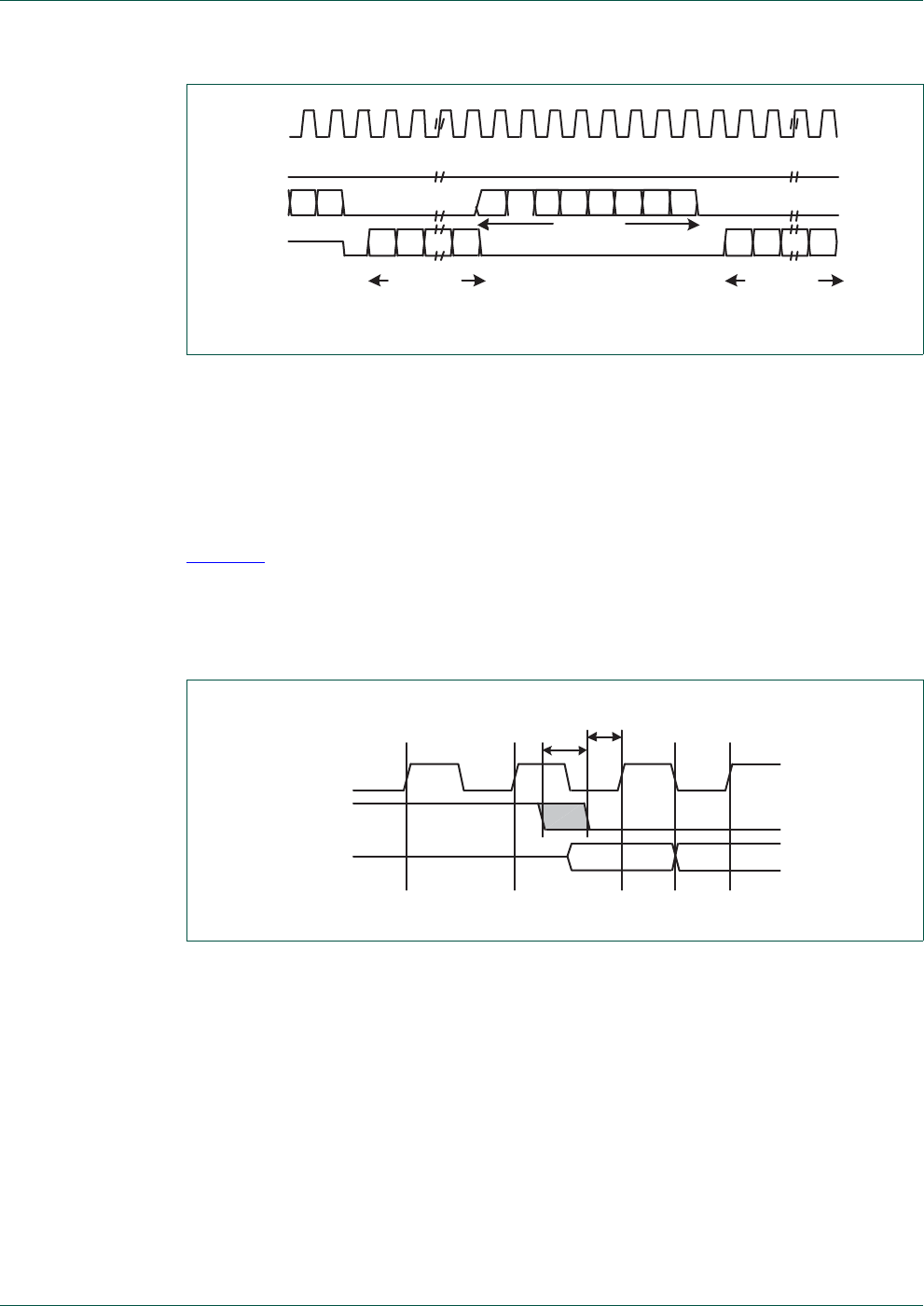
UM10360 All information provided in this document is subject to legal disclaimers. © NXP B.V. 2014. All rights reserved.
User manual Rev. 3.1 — 2 April 2014 429 of 849
NXP Semiconductors UM10360
Chapter 18: LPC176x/5x SSP0/1
18.5.3.1 Setup and hold time requirements on CS with respect to SK in Microwire
mode
In the Microwire mode, the SSP slave samples the first bit of receive data on the rising
edge of SK after CS has gone LOW. Masters that drive a free-running SK must ensure
that the CS signal has sufficient setup and hold margins with respect to the rising edge of
SK.
Figure 84 illustrates these setup and hold time requirements. With respect to the SK rising
edge on which the first bit of receive data is to be sampled by the SSP slave, CS must
have a setup of at least two times the period of SK on which the SSP operates. With
respect to the SK rising edge previous to this edge, CS must have a hold of at least one
SK period.
Fig 83. Microwire frame format (continuos transfers)
SK
CS
SO
SI
MSB LSB
4 to 16 bits
output data
8-bit control
4 to 16 bits
output data
MSB LSB
0MSB LSB
LSB
Fig 84. Microwire frame format setup and hold details
SK
CS
SI
tHOLD
= tSK
tSETUP=2*tSK

UM10360 All information provided in this document is subject to legal disclaimers. © NXP B.V. 2014. All rights reserved.
User manual Rev. 3.1 — 2 April 2014 430 of 849
NXP Semiconductors UM10360
Chapter 18: LPC176x/5x SSP0/1
18.6 Register description
The register addresses of the SSP controllers addresses are shown in Table 370.
[1] Reset Value reflects the data stored in used bits only. It does not include reserved bits content.
18.6.1 SSPn Control Register 0 (SSP0CR0 - 0x4008 8000, SSP1CR0 - 0x4003
0000)
This register controls the basic operation of the SSP controller.
Table 370. SSP Register Map
Generic
Name
Description Access Reset
Value[1]
SSPn Register
Name & Address
CR0 Control Register 0. Selects the
serial clock rate, bus type, and data
size.
R/W 0 SSP0CR0 - 0x4008 8000
SSP1CR0 - 0x4003 0000
CR1 Control Register 1. Selects
master/slave and other modes.
R/W 0 SSP0CR1 - 0x4008 8004
SSP1CR1 - 0x4003 0004
DR Data Register. Writes fill the
transmit FIFO, and reads empty
the receive FIFO.
R/W 0 SSP0DR - 0x4008 8008
SSP1DR - 0x4003 0008
SR Status Register RO SSP0SR - 0x4008 800C
SSP1SR - 0x4003 000C
CPSR Clock Prescale Register R/W 0 SSP0CPSR - 0x4008 8010
SSP1CPSR - 0x4003 0010
IMSC Interrupt Mask Set and Clear
Register
R/W 0 SSP0IMSC - 0x4008 8014
SSP1IMSC - 0x4003 0014
RIS Raw Interrupt Status Register R/W SSP0RIS - 0x4008 8018
SSP1RIS - 0x4003 0018
MIS Masked Interrupt Status Register R/W 0 SSP0MIS - 0x4008 801C
SSP1MIS - 0x4003 001C
ICR SSPICR Interrupt Clear Register R/W NA SSP0ICR - 0x4008 8020
SSP1ICR - 0x4003 0020
DMACR DMA Control Register R/W 0 SSP0DMACR - 0x4008 8024
SSP1DMACR - 0x4003 0024

UM10360 All information provided in this document is subject to legal disclaimers. © NXP B.V. 2014. All rights reserved.
User manual Rev. 3.1 — 2 April 2014 431 of 849
NXP Semiconductors UM10360
Chapter 18: LPC176x/5x SSP0/1
18.6.2 SSPn Control Register 1 (SSP0CR1 - 0x4008 8004, SSP1CR1 -
0x4003 0004)
This register controls certain aspects of the operation of the SSP controller.
Table 371: SSPn Control Register 0 (SSP0CR0 - address 0x4008 8000, SSP1CR0 -
0x4003 0000) bit description
Bit Symbol Value Description Reset
Value
3:0 DSS Data Size Select. This field controls the number of bits
transferred in each frame. Values 0000-0010 are not supported
and should not be used.
0000
0011 4-bit transfer
0100 5-bit transfer
0101 6-bit transfer
0110 7-bit transfer
0111 8-bit transfer
1000 9-bit transfer
1001 10-bit transfer
1010 11-bit transfer
1011 12-bit transfer
1100 13-bit transfer
1101 14-bit transfer
1110 15-bit transfer
1111 16-bit transfer
5:4 FRF Frame Format. 00
00 SPI
01 TI
10 Microwire
11 This combination is not supported and should not be used.
6CPOL Clock Out Polarity. This bit is only used in SPI mode. 0
0SSP controller maintains the bus clock low between frames.
1SSP controller maintains the bus clock high between frames.
7CPHA Clock Out Phase. This bit is only used in SPI mode. 0
0SSP controller captures serial data on the first clock transition of
the frame, that is, the transition away from the inter-frame state
of the clock line.
1SSP controller captures serial data on the second clock transition
of the frame, that is, the transition back to the inter-frame state of
the clock line.
15:8 SCR Serial Clock Rate. The number of prescaler-output clocks per bit
on the bus, minus one. Given that CPSDVSR is the prescale
divider, and the APB clock PCLK clocks the prescaler, the bit
frequency is PCLK / (CPSDVSR [SCR+1]).
0x00
31:8 - Reserved, user software should not write ones to reserved bits.
The value read from a reserved bit is not defined.
NA

UM10360 All information provided in this document is subject to legal disclaimers. © NXP B.V. 2014. All rights reserved.
User manual Rev. 3.1 — 2 April 2014 432 of 849
NXP Semiconductors UM10360
Chapter 18: LPC176x/5x SSP0/1
18.6.3 SSPn Data Register (SSP0DR - 0x4008 8008, SSP1DR - 0x4003 0008)
Software can write data to be transmitted to this register, and read data that has been
received.
Table 372: SSPn Control Register 1 (SSP0CR1 - address 0x4008 8004, SSP1CR1 -
0x4003 0004) bit description
Bit Symbol Value Description Reset
Value
0LBM Loop Back Mode. 0
0During normal operation.
1Serial input is taken from the serial output (MOSI or MISO) rather
than the serial input pin (MISO or MOSI respectively).
1SSE SSP Enable. 0
0The SSP controller is disabled.
1The SSP controller will interact with other devices on the serial
bus. Software should write the appropriate control information to
the other SSP registers and interrupt controller registers, before
setting this bit.
2MS Master/Slave Mode.This bit can only be written when the SSE bit
is 0.
0
0The SSP controller acts as a master on the bus, driving the
SCLK, MOSI, and SSEL lines and receiving the MISO line.
1The SSP controller acts as a slave on the bus, driving MISO line
and receiving SCLK, MOSI, and SSEL lines.
3SOD Slave Output Disable. This bit is relevant only in slave mode
(MS = 1). If it is 1, this blocks this SSP controller from driving the
transmit data line (MISO).
0
31:4 - Reserved, user software should not write ones to reserved bits.
The value read from a reserved bit is not defined.
NA
Table 373: SSPn Data Register (SSP0DR - address 0x4008 8008, SSP1DR - 0x4003 0008) bit
description
Bit Symbol Description Reset
Value
15:0 DATA Write: software can write data to be sent in a future frame to this
register whenever the TNF bit in the Status register is 1, indicating that
the Tx FIFO is not full. If the Tx FIFO was previously empty and the
SSP controller is not busy on the bus, transmission of the data will
begin immediately. Otherwise the data written to this register will be
sent as soon as all previous data has been sent (and received). If the
data length is less than 16 bits, software must right-justify the data
written to this register.
Read: software can read data from this register whenever the RNE bit
in the Status register is 1, indicating that the Rx FIFO is not empty.
When software reads this register, the SSP controller returns data from
the least recent frame in the Rx FIFO. If the data length is less than 16
bits, the data is right-justified in this field with higher order bits filled with
0s.
0x0000
31:16 - Reserved, user software should not write ones to reserved bits. The
value read from a reserved bit is not defined.
NA

UM10360 All information provided in this document is subject to legal disclaimers. © NXP B.V. 2014. All rights reserved.
User manual Rev. 3.1 — 2 April 2014 433 of 849
NXP Semiconductors UM10360
Chapter 18: LPC176x/5x SSP0/1
18.6.4 SSPn Status Register (SSP0SR - 0x4008 800C, SSP1SR -
0x4003 000C)
This read-only register reflects the current status of the SSP controller.
18.6.5 SSPn Clock Prescale Register (SSP0CPSR - 0x4008 8010, SSP1CPSR
- 0x4003 0010)
This register controls the factor by which the Prescaler divides the SSP peripheral clock
SSP_PCLK to yield the prescaler clock that is, in turn, divided by the SCR factor in
SSPnCR0, to determine the bit clock.
Important: the SSPnCPSR value must be properly initialized or the SSP controller will not
be able to transmit data correctly.
In Slave mode, the SSP clock rate provided by the master must not exceed 1/12 of the
SSP peripheral clock selected in Section 4.7.3. The content of the SSPnCPSR register is
not relevant.
In master mode, CPSDVSRmin = 2 or larger (even numbers only).
18.6.6 SSPn Interrupt Mask Set/Clear Register (SSP0IMSC - 0x4008 8014,
SSP1IMSC - 0x4003 0014)
This register controls whether each of the four possible interrupt conditions in the SSP
controller are enabled. Note that ARM uses the word “masked” in the opposite sense from
classic computer terminology, in which “masked” meant “disabled”. ARM uses the word
“masked” to mean “enabled”. To avoid confusion we will not use the word “masked”.
Table 374: SSPn Status Register (SSP0SR - address 0x4008 800C, SSP1SR - 0x4003 000C)
bit description
Bit Symbol Description Reset
Value
0TFETransmit FIFO Empty. This bit is 1 is the Transmit FIFO is empty, 0 if not. 1
1TNFTransmit FIFO Not Full. This bit is 0 if the Tx FIFO is full, 1 if not. 1
2RNEReceive FIFO Not Empty. This bit is 0 if the Receive FIFO is empty, 1 if
not.
0
3RFFReceive FIFO Full. This bit is 1 if the Receive FIFO is full, 0 if not. 0
4BSYBusy. This bit is 0 if the SSPn controller is idle, or 1 if it is currently
sending/receiving a frame and/or the Tx FIFO is not empty.
0
31:5 - Reserved, user software should not write ones to reserved bits. The
value read from a reserved bit is not defined.
NA
Table 375: SSPn Clock Prescale Register (SSP0CPSR - address 0x4008 8010, SSP1CPSR -
0x4003 0010) bit description
Bit Symbol Description Reset
Value
7:0 CPSDVSR This even value between 2 and 254, by which SSP_PCLK is divided
to yield the prescaler output clock. Bit 0 always reads as 0.
0
31:8 - Reserved, user software should not write ones to reserved bits. The
value read from a reserved bit is not defined.
NA

UM10360 All information provided in this document is subject to legal disclaimers. © NXP B.V. 2014. All rights reserved.
User manual Rev. 3.1 — 2 April 2014 434 of 849
NXP Semiconductors UM10360
Chapter 18: LPC176x/5x SSP0/1
18.6.7 SSPn Raw Interrupt Status Register (SSP0RIS - 0x4008 8018,
SSP1RIS - 0x4003 0018)
This read-only register contains a 1 for each interrupt condition that is asserted,
regardless of whether or not the interrupt is enabled in the SSPnIMSC.
18.6.8 SSPn Masked Interrupt Status Register (SSP0MIS - 0x4008 801C,
SSP1MIS - 0x4003 001C)
This read-only register contains a 1 for each interrupt condition that is asserted and
enabled in the SSPnIMSC. When an SSP interrupt occurs, the interrupt service routine
should read this register to determine the cause(s) of the interrupt.
Table 376: SSPn Interrupt Mask Set/Clear register (SSP0IMSC - address 0x4008 8014,
SSP1IMSC - 0x4003 0014) bit description
Bit Symbol Description Reset
Value
0RORIMSoftware should set this bit to enable interrupt when a Receive Overrun
occurs, that is, when the Rx FIFO is full and another frame is completely
received. The ARM spec implies that the preceding frame data is
overwritten by the new frame data when this occurs.
0
1RTIMSoftware should set this bit to enable interrupt when a Receive Time-out
condition occurs. A Receive Time-out occurs when the Rx FIFO is not
empty, and no has not been read for a "time-out period". The time-out
period is the same for master and slave modes and is determined by the
SSP bit rate: 32 bits at PCLK / (CPSDVSR [SCR+1]).
0
2RXIMSoftware should set this bit to enable interrupt when the Rx FIFO is at
least half full.
0
3 TXIM Software should set this bit to enable interrupt when the Tx FIFO is at
least half empty.
0
31:4 - Reserved, user software should not write ones to reserved bits. The
value read from a reserved bit is not defined.
NA
Table 377: SSPn Raw Interrupt Status register (SSP0RIS - address 0x4008 8018, SSP1RIS -
0x4003 0018) bit description
Bit Symbol Description Reset
Value
0RORRISThis bit is 1 if another frame was completely received while the RxFIFO
was full. The ARM spec implies that the preceding frame data is
overwritten by the new frame data when this occurs.
0
1RTRISThis bit is 1 if the Rx FIFO is not empty, and has not been read for a
"time-out period". The time-out period is the same for master and slave
modes and is determined by the SSP bit rate: 32 bits at PCLK /
(CPSDVSR [SCR+1]).
0
2RXRISThis bit is 1 if the Rx FIFO is at least half full. 0
3TXRISThis bit is 1 if the Tx FIFO is at least half empty. 1
31:4 - Reserved, user software should not write ones to reserved bits. The
value read from a reserved bit is not defined.
NA

UM10360 All information provided in this document is subject to legal disclaimers. © NXP B.V. 2014. All rights reserved.
User manual Rev. 3.1 — 2 April 2014 435 of 849
NXP Semiconductors UM10360
Chapter 18: LPC176x/5x SSP0/1
18.6.9 SSPn Interrupt Clear Register (SSP0ICR - 0x4008 8020, SSP1ICR -
0x4003 0020)
Software can write one or more one(s) to this write-only register, to clear the
corresponding interrupt condition(s) in the SSP controller. Note that the other two interrupt
conditions can be cleared by writing or reading the appropriate FIFO, or disabled by
clearing the corresponding bit in SSPnIMSC.
18.6.10 SSPn DMA Control Register (SSP0DMACR - 0x4008 8024,
SSP1DMACR - 0x4003 0024)
The SSPnDMACR register is the DMA control register. It is a read/write register.
Table 378: SSPn Masked Interrupt Status register (SSPnMIS -address 0x4008 801C, SSP1MIS
- 0x4003 001C) bit description
Bit Symbol Description Reset
Value
0RORMISThis bit is 1 if another frame was completely received while the RxFIFO
was full, and this interrupt is enabled.
0
1RTMISThis bit is 1 if the Rx FIFO is not empty, has not been read for a
"time-out period", and this interrupt is enabled. The time-out period is
the same for master and slave modes and is determined by the SSP bit
rate: 32 bits at PCLK / (CPSDVSR [SCR+1]).
0
2RXMISThis bit is 1 if the Rx FIFO is at least half full, and this interrupt is
enabled.
0
3TXMISThis bit is 1 if the Tx FIFO is at least half empty, and this interrupt is
enabled.
0
31:4 - Reserved, user software should not write ones to reserved bits. The
value read from a reserved bit is not defined.
NA
Table 379: SSPn interrupt Clear Register (SSP0ICR - address 0x4008 8020, SSP1ICR -
0x4003 0020) bit description
Bit Symbol Description Reset
Value
0RORICWriting a 1 to this bit clears the “frame was received when RxFIFO was
full” interrupt.
NA
1RTICWriting a 1 to this bit clears the "Rx FIFO was not empty and has not
been read for a time-out period" interrupt. The time-out period is the
same for master and slave modes and is determined by the SSP bit rate:
32 bits at PCLK / (CPSDVSR [SCR+1]).
NA
31:2 - Reserved, user software should not write ones to reserved bits. The
value read from a reserved bit is not defined.
NA

UM10360 All information provided in this document is subject to legal disclaimers. © NXP B.V. 2014. All rights reserved.
User manual Rev. 3.1 — 2 April 2014 436 of 849
NXP Semiconductors UM10360
Chapter 18: LPC176x/5x SSP0/1
Table 380: SSPn DMA Control Register (SSP0DMACR - address 0x4008 8024, SSP1DMACR -
0x4003 0024) bit description
Bit Symbol Description Reset
Value
0Receive DMA Enable
(RXDMAE)
When this bit is set to one 1, DMA for the receive FIFO is
enabled, otherwise receive DMA is disabled.
0
1Transmit DMA Enable
(TXDMAE)
When this bit is set to one 1, DMA for the transmit FIFO is
enabled, otherwise transmit DMA is disabled
0
31:2 - Reserved, user software should not write ones to reserved
bits. The value read from a reserved bit is not defined.
NA

UM10360 All information provided in this document is subject to legal disclaimers. © NXP B.V. 2014. All rights reserved.
User manual Rev. 3.1 — 2 April 2014 437 of 849
19.1 Basic configuration
The I2C0/1/2 interfaces are configured using the following registers:
1. Power: In the PCONP register (Ta b le 46 ), set bit PCI2C0/1/2.
Remark: On reset, all I2C interfaces are enabled (PCI2C0/1/2 = 1).
2. Clock: In PCLKSEL0 select PCLK_I2C0; in PCLKSEL1 select PCLK_I2C1 or
PCLK_I2C2 (see Section 4.7.3).
3. Pins: Select I2C0, I2C1, or I2C2 pins through the PINSEL registers. Select the pin
modes for the port pins with I2C1 or I2C2 functions through the PINMODE registers
(no pull-up, no pull-down resistors) and the PINMODE_OD registers (open drain)
(See Section 8.5).
Remark: I2C0 pins SDA0 and SCL0 are open-drain outputs and fully I2C-bus
compliant (see Table 73 ). I2C0 can be further configured through the I2CPADCFG
register to support Fast Mode Plus (See Tab l e 1 0 0).
Remark: I2C0 is not available in the 80-pin package.
Remark: I2C pins that do not use specialized I2C pads (as identified in Tab l e 7 3 ) can
be configured to an open-drain mode via the relevant IOCON registers, and can be
used with fast mode (400 kHz) and standard mode (100 kHz) I2C. These pins do not
include an analog filter to suppress line glitches, but a similar function is performed by
the digital filter in the I2C block itself. These pins should be configured as: no pull-up,
no pull-down, open drain mode.
4. Interrupts are enabled in the NVIC using the appropriate Interrupt Set Enable register.
5. Initialization: see Section 19.9.8.1 and Section 19.10.1.
19.2 Features
•Standard I2C compliant bus interfaces may be configured as Master, Slave, or
Master/Slave.
•Arbitration is handled between simultaneously transmitting masters without corruption
of serial data on the bus.
•Programmable clock allows adjustment of I2C transfer rates.
•Data transfer is bidirectional between masters and slaves.
•Serial clock synchronization allows devices with different bit rates to communicate via
one serial bus.
•Serial clock synchronization is used as a handshake mechanism to suspend and
resume serial transfer.
•Supports Fast Mode Plus (I2C0 only).
•Optional recognition of up to 4 distinct slave addresses.
•Monitor mode allows observing all I2C-bus traffic, regardless of slave address, without
affecting the actual I2C-bus traffic.
•The I2C-bus can be used for test and diagnostic purposes.
UM10360
Chapter 19: LPC176x/5x I2C0/1/2
Rev. 3.1 — 2 April 2014 User manual

UM10360 All information provided in this document is subject to legal disclaimers. © NXP B.V. 2014. All rights reserved.
User manual Rev. 3.1 — 2 April 2014 438 of 849
NXP Semiconductors UM10360
Chapter 19: LPC176x/5x I2C0/1/2
•I2C0 is a standard I2C compliant bus interface with open-drain pins. This interface
supports functions described in the I2C specification for speeds up to 1 MHz (Fast
Mode Plus). This includes multi-master operation and allows powering off this device
in a working system while leaving the I2C-bus functional.
19.3 Applications
Interfaces to external I2C standard parts, such as serial RAMs, LCDs, tone generators,
other microcontrollers, etc.
19.4 Description
A typical I2C-bus configuration is shown in Figure 85. Depending on the state of the
direction bit (R/W), two types of data transfers are possible on the I2C-bus:
•Data transfer from a master transmitter to a slave receiver. The first byte transmitted
by the master is the slave address. Next follows a number of data bytes. The slave
returns an acknowledge bit after each received byte, unless the slave device is unable
to accept more data.
•Data transfer from a slave transmitter to a master receiver. The first byte (the slave
address) is transmitted by the master. The slave then returns an acknowledge bit.
Next follows the data bytes transmitted by the slave to the master. The master returns
an acknowledge bit after all received bytes other than the last byte. At the end of the
last received byte, a “not acknowledge” is returned. The master device generates all
of the serial clock pulses and the START and STOP conditions. A transfer is ended
with a STOP condition or with a repeated START condition. Since a repeated START
condition is also the beginning of the next serial transfer, the I2C-bus will not be
released.
The LPC176x/5x I2C interfaces are byte oriented and have four operating modes: master
transmitter mode, master receiver mode, slave transmitter mode and slave receiver
mode.
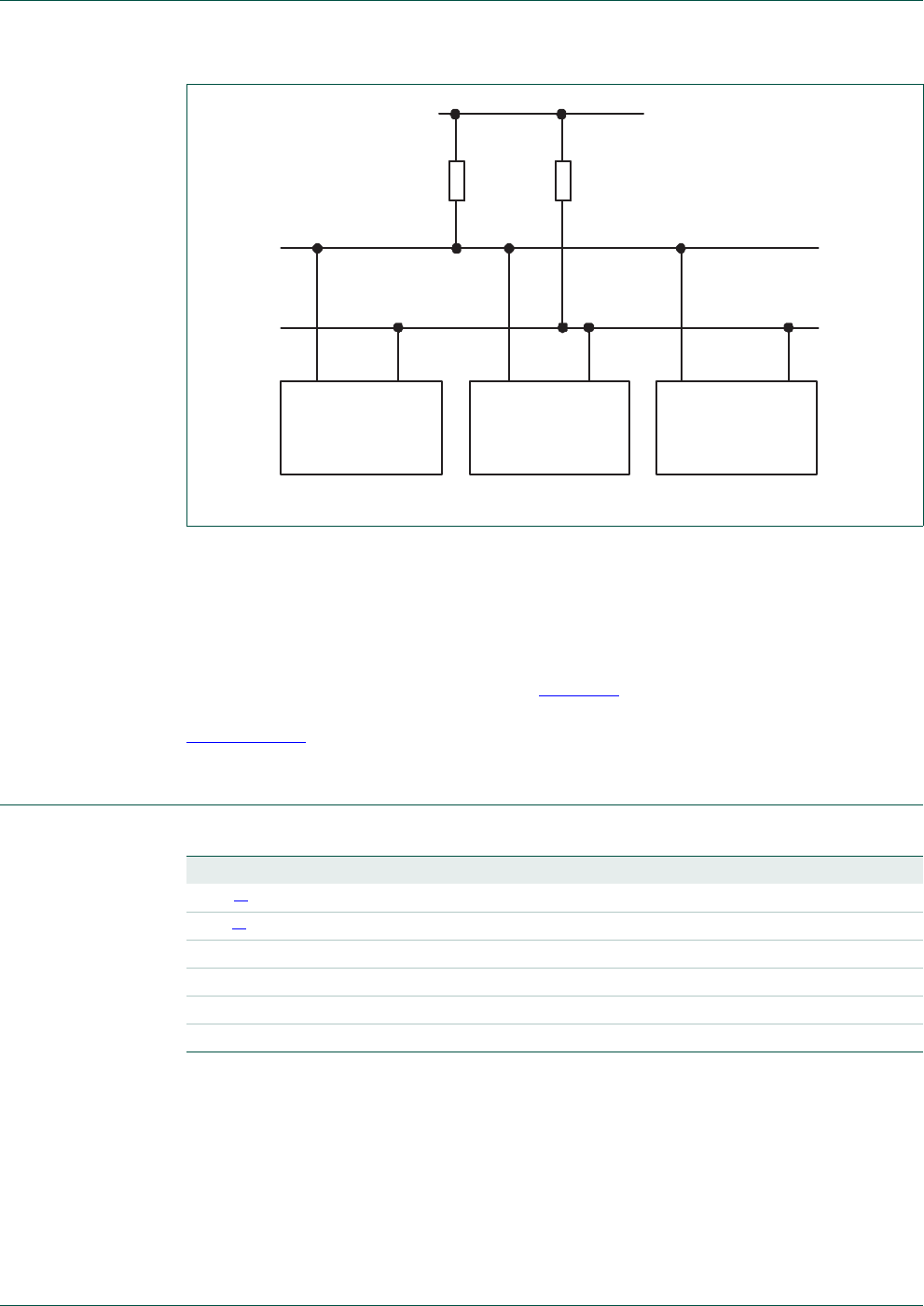
UM10360 All information provided in this document is subject to legal disclaimers. © NXP B.V. 2014. All rights reserved.
User manual Rev. 3.1 — 2 April 2014 439 of 849
NXP Semiconductors UM10360
Chapter 19: LPC176x/5x I2C0/1/2
19.4.1 I2C FAST Mode Plus
Fast Mode Plus is a 1 Mbit/sec transfer rate to communicate with the I2C products which
the NXP Semiconductors is now providing.
In order to use Fast Mode Plus, the I2C0 pins must be configured, then rates above 400
kHz and up to 1 Mhz may be selected, see Tab le 39 5 . To configure the pins for Fast Mode
Plus, the SDADRV0 and SCLDRV0 bits in the I2CPADCFG register must be set, see
Section 8.5.21.
19.5 Pin description
[1] I2C0 is only available in 100-pin LPC176x/5x devices. The SDA0 and SCL0 pins are open-drain pins to
comply with I2C specifications. The pins must be configured in the I2CPADCFG register for Fast Mode Plus.
The internal logic of the 3 I2C interfaces is identical. These interfaces can be brought out
to device pins in several ways, some of which have different pin I/O characteristics. I2C0
on pins P0[27] and P0[28] use specialized I2C pads that support fully spec compliant fast
mode, standard mode, and fast mode plus I2C.
Fig 85. I2C-bus configuration
OTHER DEVICE WITH
I 2C INTERFACE
pull-up
resistor
OTHER DEVICE WITH
I 2
C INTERFACE
LPCXXXX
SDA SCL
I 2
C bus
SCL
SDA
pull-up
resistor
Table 381. I2C Pin Description
Pin Type Description
SDA0[1] Input/Output I2C0 Serial Data
SCL0[1] Input/Output I2C0 Serial Clock
SDA1 Input/Output I2C1 Serial Data
SCL1 Input/Output I2C1 Serial Clock
SDA2 Input/Output I2C2 Serial Data
SCL2 Input/Output I2C2 Serial Clock

UM10360 All information provided in this document is subject to legal disclaimers. © NXP B.V. 2014. All rights reserved.
User manual Rev. 3.1 — 2 April 2014 440 of 849
NXP Semiconductors UM10360
Chapter 19: LPC176x/5x I2C0/1/2
Any of the I2C interfaces brought out to pins other than those just mentioned use standard
I/O pins. These pins also support I2C operation in fast mode and standard mode. The
primary difference is that these pins do not include an analog spike suppression filter that
exists on the specialized I2C pads. The I2C interfaces all include a digital filter that can
serve the same purpose.
19.6 I2C operating modes
In a given application, the I2C block may operate as a master, a slave, or both. In the slave
mode, the I2C hardware looks for any one of its four slave addresses and the General Call
address. If one of these addresses is detected, an interrupt is requested. If the processor
wishes to become the bus master, the hardware waits until the bus is free before the
master mode is entered so that a possible slave operation is not interrupted. If bus
arbitration is lost in the master mode, the I2C block switches to the slave mode
immediately and can detect any of its own configured slave addresses in the same serial
transfer.
19.6.1 Master Transmitter mode
In this mode data is transmitted from master to slave. Before the master transmitter mode
can be entered, the I2CONSET register must be initialized as shown in Ta bl e 3 8 2 . I2EN
must be set to 1 to enable the I2C function. If the AA bit is 0, the I2C interface will not
acknowledge any address when another device is master of the bus, so it can not enter
slave mode. The STA, STO and SI bits must be 0. The SI bit is cleared by writing 1 to the
SIC bit in the I2CONCLR register. THe STA bit should be cleared after writing the slave
address.
The first byte transmitted contains the slave address of the receiving device (7 bits) and
the data direction bit. In this mode the data direction bit (R/W) should be 0 which means
Write. The first byte transmitted contains the slave address and Write bit. Data is
transmitted 8 bits at a time. After each byte is transmitted, an acknowledge bit is received.
START and STOP conditions are output to indicate the beginning and the end of a serial
transfer.
The I2C interface will enter master transmitter mode when software sets the STA bit. The
I2C logic will send the START condition as soon as the bus is free. After the START
condition is transmitted, the SI bit is set, and the status code in the I2STAT register is
0x08. This status code is used to vector to a state service routine which will load the slave
address and Write bit to the I2DAT register, and then clear the SI bit. SI is cleared by
writing a 1 to the SIC bit in the I2CONCLR register.
When the slave address and R/W bit have been transmitted and an acknowledgment bit
has been received, the SI bit is set again, and the possible status codes now are 0x18,
0x20, or 0x38 for the master mode, or 0x68, 0x78, or 0xB0 if the slave mode was enabled
(by setting AA to 1). The appropriate actions to be taken for each of these status codes
are shown in Ta b l e 3 99 to Ta b le 4 0 2 .
Table 382. I2C0CONSET, I2C1CONSET and I2C2CONSET used to configure Master mode
Bit 7 6 5 4 3 2 1 0
Symbol - I2EN STA STO SI AA - -
Value - 1 0 0 0 0 - -
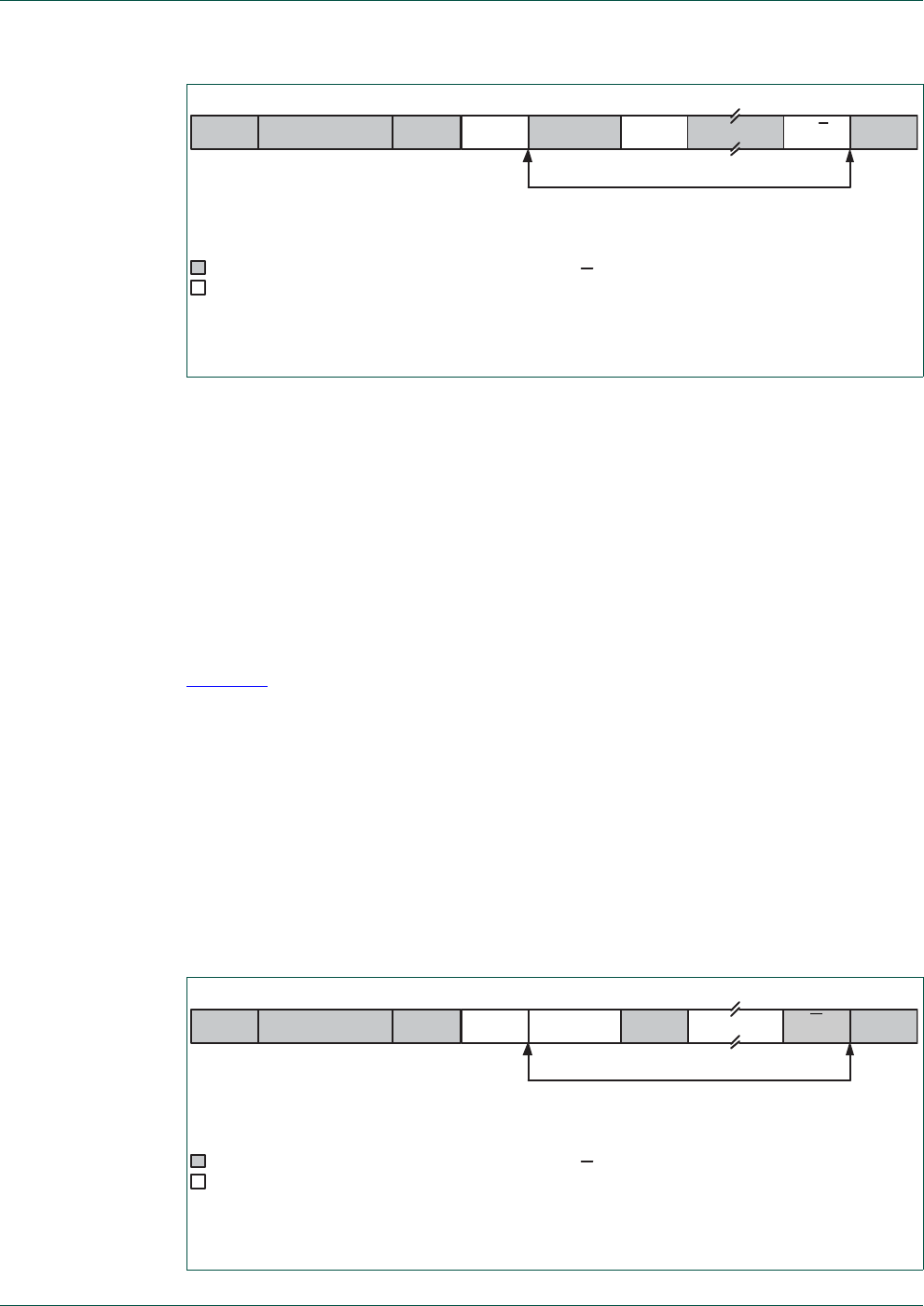
UM10360 All information provided in this document is subject to legal disclaimers. © NXP B.V. 2014. All rights reserved.
User manual Rev. 3.1 — 2 April 2014 441 of 849
NXP Semiconductors UM10360
Chapter 19: LPC176x/5x I2C0/1/2
19.6.2 Master Receiver mode
In the master receiver mode, data is received from a slave transmitter. The transfer is
initiated in the same way as in the master transmitter mode. When the START condition
has been transmitted, the interrupt service routine must load the slave address and the
data direction bit to the I2C Data register (I2DAT), and then clear the SI bit. In this case,
the data direction bit (R/W) should be 1 to indicate a read.
When the slave address and data direction bit have been transmitted and an
acknowledge bit has been received, the SI bit is set, and the Status Register will show the
status code. For master mode, the possible status codes are 0x40, 0x48, or 0x38. For
slave mode, the possible status codes are 0x68, 0x78, or 0xB0. For details, refer to
Tab l e 4 00 .
When the LPC176x/5x needs to acknowledge a received byte, the AA bit needs to be set
accordingly prior to clearing the SI bit and initiating the byte read. When the LPC176x/5x
needs to not acknowledge a received byte, the AA bit needs to be cleared prior to clearing
the SI bit and initiating the byte read.
Note that the last received byte is always followed by a "Not Acknowledge" from the
LPC176x/5x so that the master can signal the slave that the reading sequence is finished
and that it needs to issue a STOP or repeated START Command. Once the "Not
Acknowledge has been sent and the SI bit is set, the LPC176x/5x can send either a STOP
(STO bit is set) or a repeated START (STA bit is set). Then the SI bit is cleared to initiate
the requested operation.
Fig 86. Format in the Master Transmitter mode
A = Acknowledge (SDA low)
A = Not acknowledge (SDA high)
S = START condition
P = STOP condition
S SLAVE ADDRESS RW=0 A DATA AA/A P
from Master to Slave
from Slave to Master
DATA
n bytes data transmitted
Fig 87. Format of Master Receiver mode
DATA
A = Acknowledge (SDA low)
A = Not acknowledge (SDA high)
S = START condition
P = STOP condition
S SLAVE ADDRESS RW=1 A DATA P
n bytes data received
from Master to Slave
from Slave to Master
AA
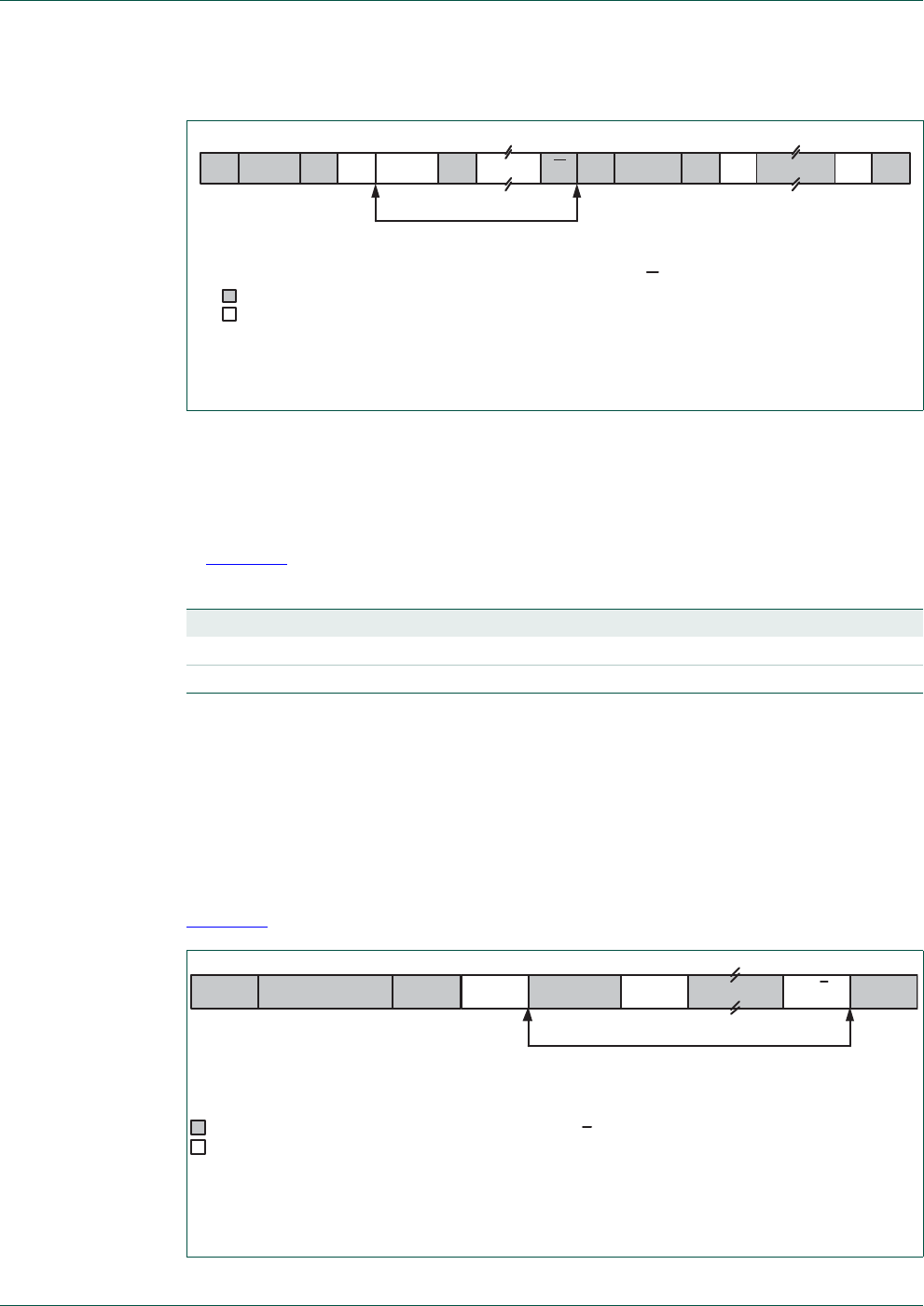
UM10360 All information provided in this document is subject to legal disclaimers. © NXP B.V. 2014. All rights reserved.
User manual Rev. 3.1 — 2 April 2014 442 of 849
NXP Semiconductors UM10360
Chapter 19: LPC176x/5x I2C0/1/2
After a repeated START condition, I2C may switch to the master transmitter mode.
19.6.3 Slave Receiver mode
In the slave receiver mode, data bytes are received from a master transmitter. To initialize
the slave receiver mode, write any of the Slave Address registers (I2ADR0-3) and Slave
Mask registers (I2MASK0-3) and write the I2C Control Set register (I2CONSET) as shown
in Ta bl e 3 8 3 .
I2EN must be set to 1 to enable the I2C function. AA bit must be set to 1 to acknowledge
any of its own slave addresses or the General Call address. The STA, STO and SI bits are
set to 0.
After I2ADR and I2CONSET are initialized, the I2C interface waits until it is addressed by
its any of its own slave addresses or General Call address followed by the data direction
bit. If the direction bit is 0 (W), it enters slave receiver mode. If the direction bit is 1 (R), it
enters slave transmitter mode. After the address and direction bit have been received, the
SI bit is set and a valid status code can be read from the Status register (I2STAT). Refer to
Tab l e 4 01 for the status codes and actions.
Fig 88. A Master Receiver switches to Master Transmitter after sending repeated START
A = Acknowledge (SDA low)
A = Not acknowledge (SDA high)
S = START condition
P = STOP condition
SLA = Slave Address
Sr = Repeated START condition
DATA
n bytes data transmitted
From master to slave
From slave to master
ADATA A ASLA R Sr W PS SLA DATAAA
Table 383. I2C0CONSET, I2C1CONSET and I2C2CONSET used to configure Slave mode
Bit 7 6 5 4 3 2 1 0
Symbol - I2EN STA STO SI AA - -
Value - 1 0 0 0 1 - -
Fig 89. Format of Slave Receiver mode
A
A = Acknowledge (SDA low)
A = Not acknowledge (SDA high)
S = START condition
P = STOP condition
Sr = Repeated START condition
AA/A
n bytes data received
from Master to Slave
from Slave to Master
S SLAVE ADDRESS RW=0 DATA P/SrDATA
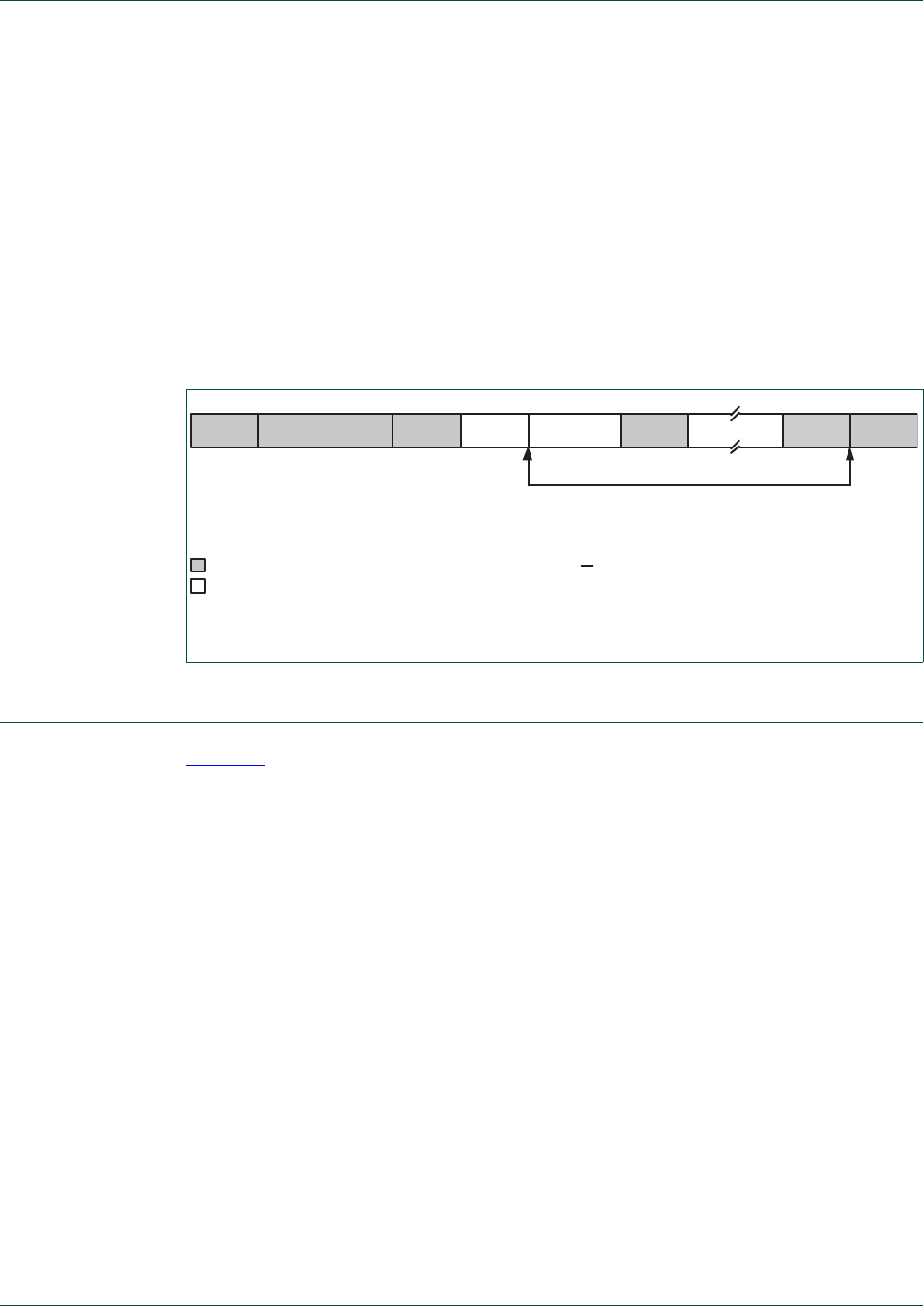
UM10360 All information provided in this document is subject to legal disclaimers. © NXP B.V. 2014. All rights reserved.
User manual Rev. 3.1 — 2 April 2014 443 of 849
NXP Semiconductors UM10360
Chapter 19: LPC176x/5x I2C0/1/2
19.6.4 Slave Transmitter mode
The first byte is received and handled as in the slave receiver mode. However, in this
mode, the direction bit will be 1, indicating a read operation. Serial data is transmitted via
SDA while the serial clock is input through SCL. START and STOP conditions are
recognized as the beginning and end of a serial transfer. In a given application, I2C may
operate as a master and as a slave. In the slave mode, the I2C hardware looks for any of
its own slave addresses and the General Call address. If one of these addresses is
detected, an interrupt is requested. When the microcontrollers wishes to become the bus
master, the hardware waits until the bus is free before the master mode is entered so that
a possible slave action is not interrupted. If bus arbitration is lost in the master mode, the
I2C interface switches to the slave mode immediately and can detect any of its own slave
addresses in the same serial transfer.
19.7 I2C implementation and operation
Figure 91 shows how the on-chip I2C-bus interface is implemented, and the following text
describes the individual blocks.
19.7.1 Input filters and output stages
Input signals are synchronized with the internal clock, and spikes shorter than three
clocks are filtered out.
The output for I2C is a special pad designed to conform to the I2C specification.
Fig 90. Format of Slave Transmitter mode
DATA
A = Acknowledge (SDA low)
A = Not acknowledge (SDA high)
S = START condition
P = STOP condition
ADATA
n bytes data transmitted
from Master to Slave
from Slave to Master
S SLAVE ADDRESS RW=1 A P
A
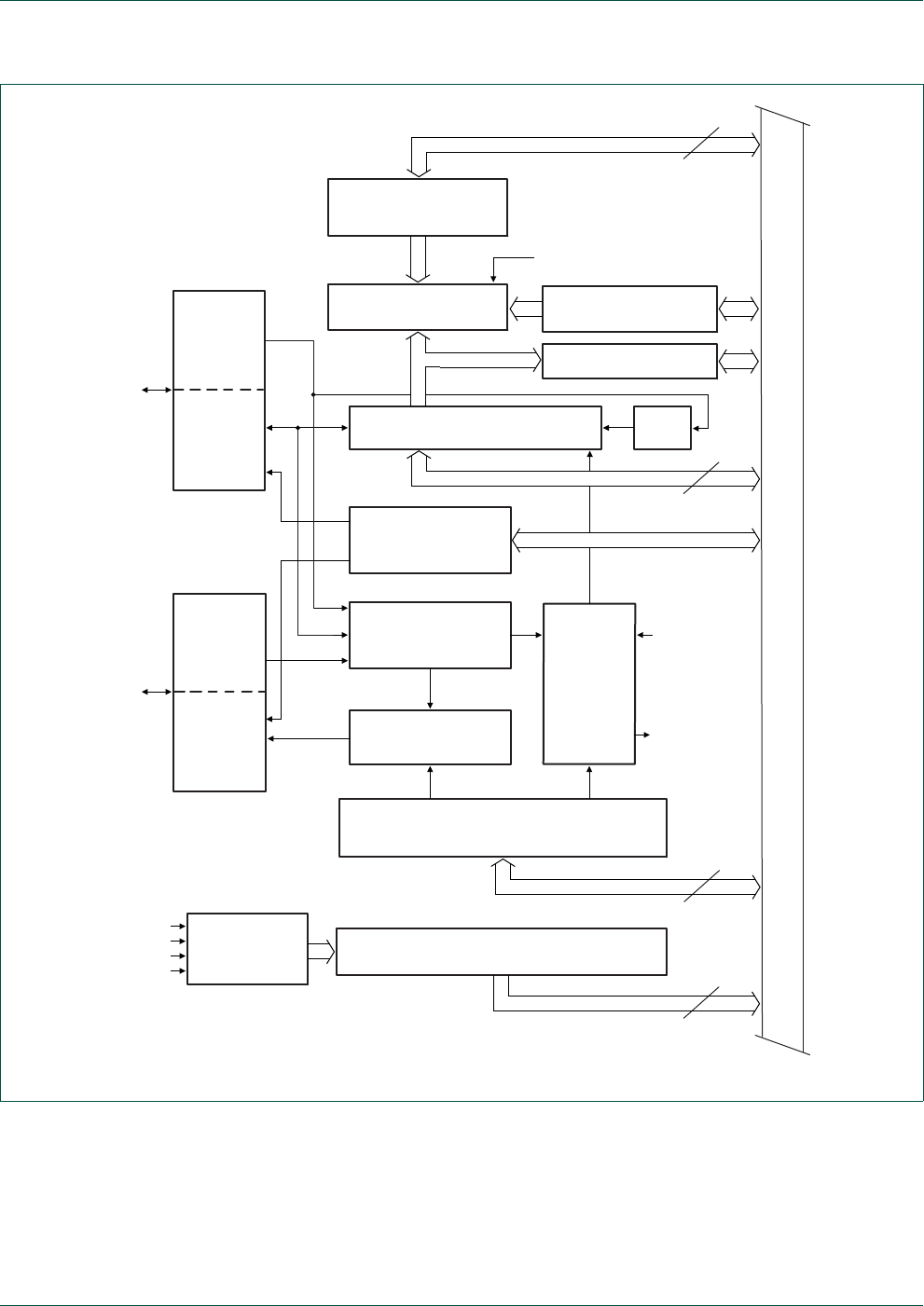
UM10360 All information provided in this document is subject to legal disclaimers. © NXP B.V. 2014. All rights reserved.
User manual Rev. 3.1 — 2 April 2014 444 of 849
NXP Semiconductors UM10360
Chapter 19: LPC176x/5x I2C0/1/2
19.7.2 Address Registers, I2ADR0 to I2ADR3
These registers may be loaded with the 7-bit slave address (7 most significant bits) to
which the I2C block will respond when programmed as a slave transmitter or receiver. The
LSB (GC) is used to enable General Call address (0x00) recognition. When multiple slave
addresses are enabled, the actual address received may be read from the I2DAT register
at the state where the “own slave address” has just been received.
Fig 91. I2C serial interface block diagram
APB BUS
STATUS REGISTER
I2CnSTAT
CONTROL REGISTER and
SCL DUTY CYLE REGISTERS
I2CnCONSET, I2CnCONCLR, I2CnSCLH, I2CnSCLL
ADDRESS REGISTERS
MASK and COMPARE
SHIFT REGISTER
I2CnDAT ACK
BIT COUNTER/
ARBITRATION and
MONITOR MODE
REGISTER
I2CnMMCTRL
SYNC LOGIC
SERIAL CLOCK
GENERATOR
TIMING and
CONTROL
LOGIC
STATUS
DECODER
status
bus
interrupt
PCLK
INPUT
FILTER
OUTPUT
STAGE
SCL
INPUT
FILTER
OUTPUT
STAGE
SDA
I2CnADDR0 to I2CnADDR3
MASK REGISTERS
I2CnMASK0 to I2CnMASK3
I2CnDATABUFFER
MATCHALL
I2CnMMCTRL[3]
8
8
8
16

UM10360 All information provided in this document is subject to legal disclaimers. © NXP B.V. 2014. All rights reserved.
User manual Rev. 3.1 — 2 April 2014 445 of 849
NXP Semiconductors UM10360
Chapter 19: LPC176x/5x I2C0/1/2
Remark: in the remainder of this chapter, when the phrase “own slave address” is used, it
refers to any of the four configured slave addresses after address masking.
19.7.3 Address mask registers, I2MASK0 to I2MASK3
The four mask registers each contain seven active bits (7:1). Any bit in these registers
which is set to ‘1’ will cause an automatic compare on the corresponding bit of the
received address when it is compared to the I2ADRn register associated with that mask
register. In other words, bits in an I2ADRn register which are masked are not taken into
account in determining an address match.
When an address-match interrupt occurs, the processor will have to read the data register
(I2DAT) to determine which received address actually caused the match.
19.7.4 Comparator
The comparator compares the received 7-bit slave address with any of the four configured
slave addresses in I2ADR0 through I2ADR3 after masking. It also compares the first
received 8-bit byte with the General Call address (0x00). If an a match is found, the
appropriate status bits are set and an interrupt is requested.
19.7.5 Shift register, I2DAT
This 8-bit register contains a byte of serial data to be transmitted or a byte which has just
been received. Data in I2DAT is always shifted from right to left; the first bit to be
transmitted is the MSB (bit 7) and, after a byte has been received, the first bit of received
data is located at the MSB of I2DAT. While data is being shifted out, data on the bus is
simultaneously being shifted in; I2DAT always contains the last byte present on the bus.
Thus, in the event of lost arbitration, the transition from master transmitter to slave
receiver is made with the correct data in I2DAT.
19.7.6 Arbitration and synchronization logic
In the master transmitter mode, the arbitration logic checks that every transmitted logic 1
actually appears as a logic 1 on the I2C-bus. If another device on the bus overrules a logic
1 and pulls the SDA line low, arbitration is lost, and the I2C block immediately changes
from master transmitter to slave receiver. The I2C block will continue to output clock
pulses (on SCL) until transmission of the current serial byte is complete.
Arbitration may also be lost in the master receiver mode. Loss of arbitration in this mode
can only occur while the I2C block is returning a “not acknowledge: (logic 1) to the bus.
Arbitration is lost when another device on the bus pulls this signal low. Since this can
occur only at the end of a serial byte, the I2C block generates no further clock pulses.
Figure 92 shows the arbitration procedure.
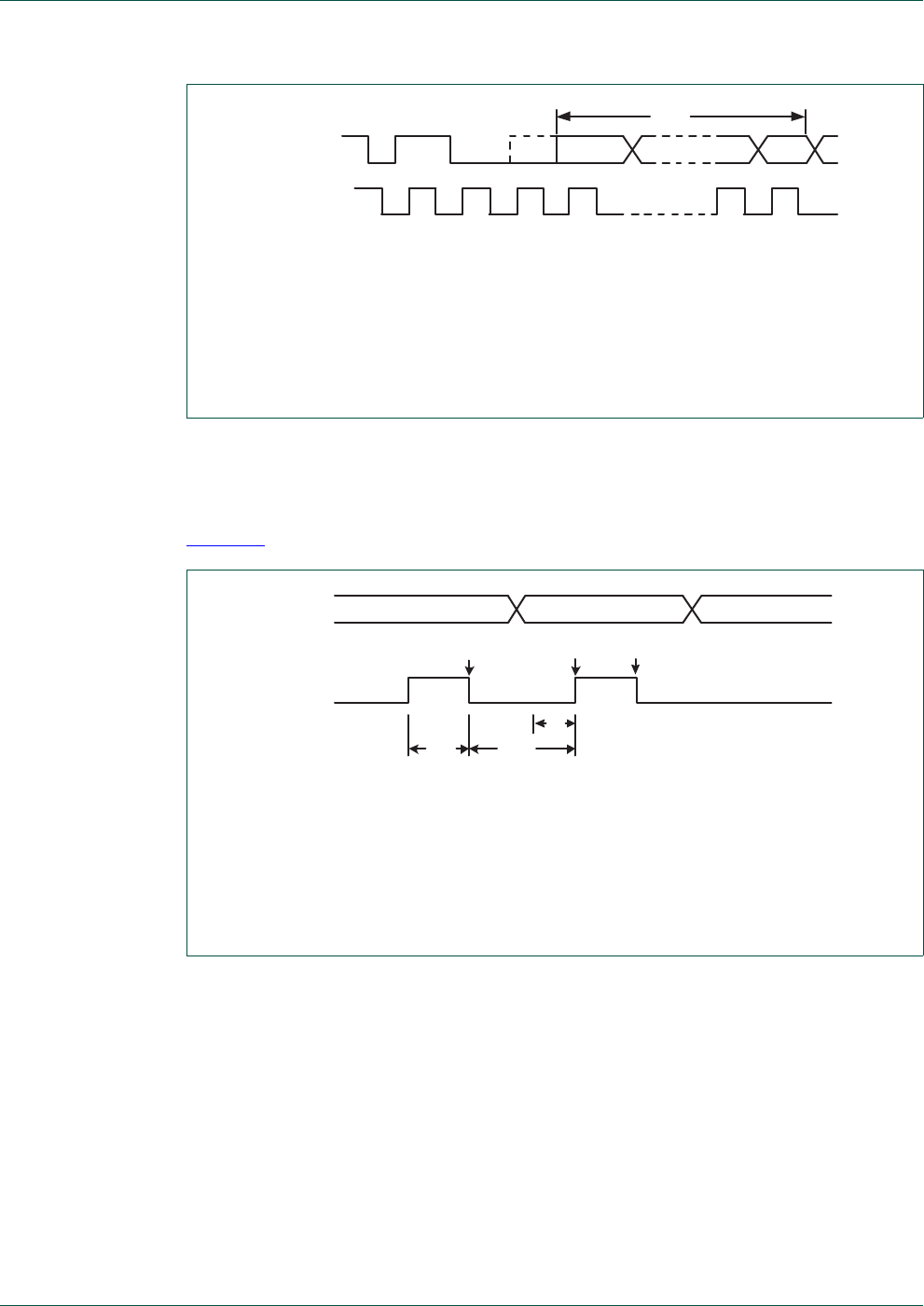
UM10360 All information provided in this document is subject to legal disclaimers. © NXP B.V. 2014. All rights reserved.
User manual Rev. 3.1 — 2 April 2014 446 of 849
NXP Semiconductors UM10360
Chapter 19: LPC176x/5x I2C0/1/2
The synchronization logic will synchronize the serial clock generator with the clock pulses
on the SCL line from another device. If two or more master devices generate clock pulses,
the “mark” duration is determined by the device that generates the shortest “marks,” and
the “space” duration is determined by the device that generates the longest “spaces”.
Figure 93 shows the synchronization procedure.
A slave may stretch the space duration to slow down the bus master. The space duration
may also be stretched for handshaking purposes. This can be done after each bit or after
a complete byte transfer. the I2C block will stretch the SCL space duration after a byte has
been transmitted or received and the acknowledge bit has been transferred. The serial
interrupt flag (SI) is set, and the stretching continues until the serial interrupt flag is
cleared.
19.7.7 Serial clock generator
This programmable clock pulse generator provides the SCL clock pulses when the I2C
block is in the master transmitter or master receiver mode. It is switched off when the I2C
block is in a slave mode. The I2C output clock frequency and duty cycle is programmable
(1) Another device transmits serial data.
(2) Another device overrules a logic (dotted line) transmitted this I2C master by pulling the SDA line
low. Arbitration is lost, and this I2C enters Slave Receiver mode.
(3) This I2C is in Slave Receiver mode but still generates clock pulses until the current byte has been
transmitted. This I2C will not generate clock pulses for the next byte. Data on SDA originates from
the new master once it has won arbitration.
Fig 92. Arbitration procedure
(1) Another device pulls the SCL line low before this I2C has timed a complete high time. The other
device effectively determines the (shorter) HIGH period.
(2) Another device continues to pull the SCL line low after this I2C has timed a complete low time and
released SCL. The I2C clock generator is forced to wait until SCL goes HIGH. The other device
effectively determines the (longer) LOW period.
(3) The SCL line is released , and the clock generator begins timing the HIGH time.
Fig 93. Serial clock synchronization
SDA line
SCL line 1234 89
ACK
(1) (2)(1) (3)
SDA line
SCL line
(2)
(1)(3)
high
period
low
period
(1)

UM10360 All information provided in this document is subject to legal disclaimers. © NXP B.V. 2014. All rights reserved.
User manual Rev. 3.1 — 2 April 2014 447 of 849
NXP Semiconductors UM10360
Chapter 19: LPC176x/5x I2C0/1/2
via the I2C Clock Control Registers. See the description of the I2CSCLL and I2CSCLH
registers for details. The output clock pulses have a duty cycle as programmed unless the
bus is synchronizing with other SCL clock sources as described above.
19.7.8 Timing and control
The timing and control logic generates the timing and control signals for serial byte
handling. This logic block provides the shift pulses for I2DAT, enables the comparator,
generates and detects START and STOP conditions, receives and transmits acknowledge
bits, controls the master and slave modes, contains interrupt request logic, and monitors
the I2C-bus status.
19.7.9 Control register, I2CONSET and I2CONCLR
The I2C control register contains bits used to control the following I2C block functions: start
and restart of a serial transfer, termination of a serial transfer, bit rate, address recognition,
and acknowledgment.
The contents of the I2C control register may be read as I2CONSET. Writing to I2CONSET
will set bits in the I2C control register that correspond to ones in the value written.
Conversely, writing to I2CONCLR will clear bits in the I2C control register that correspond
to ones in the value written.
19.7.10 Status decoder and status register
The status decoder takes all of the internal status bits and compresses them into a 5-bit
code. This code is unique for each I2C-bus status. The 5-bit code may be used to
generate vector addresses for fast processing of the various service routines. Each
service routine processes a particular bus status. There are 26 possible bus states if all
four modes of the I2C block are used. The 5-bit status code is latched into the five most
significant bits of the status register when the serial interrupt flag is set (by hardware) and
remains stable until the interrupt flag is cleared by software. The three least significant bits
of the status register are always zero. If the status code is used as a vector to service
routines, then the routines are displaced by eight address locations. Eight bytes of code is
sufficient for most of the service routines (see the software example in this section).

UM10360 All information provided in this document is subject to legal disclaimers. © NXP B.V. 2014. All rights reserved.
User manual Rev. 3.1 — 2 April 2014 448 of 849
NXP Semiconductors UM10360
Chapter 19: LPC176x/5x I2C0/1/2
19.8 Register description
Each I2C interface contains 16 registers as shown in Table 384 below.
Remark: In the LPC176x/5x, the following registers have been added to support response
to multiple addresses in Slave mode and a new Monitor mode: I2ADR1 to 3, I2MASK0 To
3, MMCTRL, and I2DATA_BUFFER.
Table 384. I2C register map
Generic
Name
Description Access Reset
value[1]
I2Cn Name & Address
I2CONSET I2C Control Set Register. When a one is written to
a bit of this register, the corresponding bit in the I2C
control register is set. Writing a zero has no effect on
the corresponding bit in the I2C control register.
R/W 0x00 I2C0CONSET - 0x4001 C000
I2C1CONSET - 0x4005 C000
I2C2CONSET - 0x400A 0000
I2STAT I2C Status Register. During I2C operation, this
register provides detailed status codes that allow
software to determine the next action needed.
RO 0xF8 I2C0STAT - 0x4001 C004
I2C1STAT - 0x4005 C004
I2C2STAT - 0x400A 0004
I2DAT I2C Data Register. During master or slave transmit
mode, data to be transmitted is written to this
register. During master or slave receive mode, data
that has been received may be read from this
register.
R/W 0x00 I2C0DAT - 0x4001 C008
I2C1DAT - 0x4005 C008
I2C2DAT - 0x400A 0008
I2ADR0 I2C Slave Address Register 0. Contains the 7-bit
slave address for operation of the I2C interface in
slave mode, and is not used in master mode. The
least significant bit determines whether a slave
responds to the General Call address.
R/W 0x00 I2C0ADR0 - 0x4001 C00C
I2C1ADR0 - 0x4005 C00C
I2C2ADR0 - 0x400A 000C
I2SCLH SCH Duty Cycle Register High Half Word.
Determines the high time of the I2C clock.
R/W 0x04 I2C0SCLH - 0x4001 C010
I2C1SCLH - 0x4005 C010
I2C2SCLH - 0x400A 0010
I2SCLL SCL Duty Cycle Register Low Half Word.
Determines the low time of the I2C clock. I2nSCLL
and I2nSCLH together determine the clock
frequency generated by an I2C master and certain
times used in slave mode.
R/W 0x04 I2C0SCLL - 0x4001 C014
I2C1SCLL - 0x4005 C014
I2C2SCLL - 0x400A 0014
I2CONCLR I2C Control Clear Register. When a one is written
to a bit of this register, the corresponding bit in the
I2C control register is cleared. Writing a zero has no
effect on the corresponding bit in the I2C control
register.
WO NA I2C0CONCLR - 0x4001 C018
I2C1CONCLR - 0x4005 C018
I2C2CONCLR - 0x400A 0018
MMCTRL Monitor mode control register. R/W0x00I2C0MMCTRL - 0x4001 C01C
I2C1MMCTRL - 0x4005 C01C
I2C2MMCTRL - 0x400A 001C
I2ADR1 I2C Slave Address Register 1. Contains the 7-bit
slave address for operation of the I2C interface in
slave mode, and is not used in master mode. The
least significant bit determines whether a slave
responds to the General Call address.
R/W 0x00 I2C0ADR1 - 0x4001 C020
I2C1ADR1 - 0x4005 C020
I2C2ADR1 - 0x400A 0020

UM10360 All information provided in this document is subject to legal disclaimers. © NXP B.V. 2014. All rights reserved.
User manual Rev. 3.1 — 2 April 2014 449 of 849
NXP Semiconductors UM10360
Chapter 19: LPC176x/5x I2C0/1/2
[1] Reset value reflects the data stored in used bits only. It does not include reserved bits content.
19.8.1 I2C Control Set register (I2CONSET: I2C0, I2C0CONSET -
0x4001 C000; I2C1, I2C1CONSET - 0x4005 C000; I2C2, I2C2CONSET -
0x400A 0000)
The I2CONSET registers control setting of bits in the I2CON register that controls
operation of the I2C interface. Writing a one to a bit of this register causes the
corresponding bit in the I2C control register to be set. Writing a zero has no effect.
Reading this register provides the current values of the control and flag bits.
I2ADR2 I2C Slave Address Register 2. Contains the 7-bit
slave address for operation of the I2C interface in
slave mode, and is not used in master mode. The
least significant bit determines whether a slave
responds to the General Call address.
R/W 0x00 I2C0ADR2 - 0x4001 C024
I2C1ADR2 - 0x4005 C024
I2C2ADR2 - 0x400A 0024
I2ADR3 I2C Slave Address Register 3. Contains the 7-bit
slave address for operation of the I2C interface in
slave mode, and is not used in master mode. The
least significant bit determines whether a slave
responds to the General Call address.
R/W 0x00 I2C0ADR3 - 0x4001 C028
I2C1ADR3 - 0x4005 C028
I2C2ADR3 - 0x400A 0028
I2DATA_
BUFFER
Data buffer register. The contents of the 8 MSBs of
the I2DAT shift register will be transferred to the
I2DATA_BUFFER automatically after every 9 bits (8
bits of data plus ACK or NACK) has been received
on the bus.
RO 0x00 I2C0DATA_ BUFFER - 0x4001 C02C
I2C1DATA_ BUFFER - 0x4005 C02C
I2C2DATA_ BUFFER - 0x400A 002C
I2MASK0 I2C Slave address mask register 0. This mask
register is associated with I2ADR0 to determine an
address match. The mask register has no effect
when comparing to the General Call address
(‘0000000’).
R/W 0x00 I2C0MASK0 - 0x4001 C030
I2C1MASK0 - 0x4005 C030
I2C2MASK0 - 0x400A 0030
I2MASK1 I2C Slave address mask register 1. This mask
register is associated with I2ADR0 to determine an
address match. The mask register has no effect
when comparing to the General Call address
(‘0000000’).
R/W 0x00 I2C0MASK1 - 0x4001 C034
I2C1MASK1 - 0x4005 C034
I2C2MASK1 - 0x400A 0034
I2MASK2 I2C Slave address mask register 2. This mask
register is associated with I2ADR0 to determine an
address match. The mask register has no effect
when comparing to the General Call address
(‘0000000’).
R/W 0x00 I2C0MASK2 - 0x4001 C038
I2C1MASK2 - 0x4005 C038
I2C2MASK2 - 0x400A 0038
I2MASK3 I2C Slave address mask register 3. This mask
register is associated with I2ADR0 to determine an
address match. The mask register has no effect
when comparing to the General Call address
(‘0000000’).
R/W 0x00 I2C0MASK3 - 0x4001 C03C
I2C1MASK3 - 0x4005 C03C
I2C2MASK3 - 0x400A 003C
Table 384. I2C register map
Generic
Name
Description Access Reset
value[1]
I2Cn Name & Address

UM10360 All information provided in this document is subject to legal disclaimers. © NXP B.V. 2014. All rights reserved.
User manual Rev. 3.1 — 2 April 2014 450 of 849
NXP Semiconductors UM10360
Chapter 19: LPC176x/5x I2C0/1/2
I2EN I2C Interface Enable. When I2EN is 1, the I2C interface is enabled. I2EN can be
cleared by writing 1 to the I2ENC bit in the I2CONCLR register. When I2EN is 0, the I2C
interface is disabled.
When I2EN is “0”, the SDA and SCL input signals are ignored, the I2C block is in the “not
addressed” slave state, and the STO bit is forced to “0”.
I2EN should not be used to temporarily release the I2C-bus since, when I2EN is reset, the
I2C-bus status is lost. The AA flag should be used instead.
STA is the START flag. Setting this bit causes the I2C interface to enter master mode and
transmit a START condition or transmit a repeated START condition if it is already in
master mode.
When STA is 1 and the I2C interface is not already in master mode, it enters master mode,
checks the bus and generates a START condition if the bus is free. If the bus is not free, it
waits for a STOP condition (which will free the bus) and generates a START condition
after a delay of a half clock period of the internal clock generator. If the I2C interface is
already in master mode and data has been transmitted or received, it transmits a repeated
START condition. STA may be set at any time, including when the I2C interface is in an
addressed slave mode.
STA can be cleared by writing 1 to the STAC bit in the I2CONCLR register. When STA is
0, no START condition or repeated START condition will be generated.
If STA and STO are both set, then a STOP condition is transmitted on the I2C-bus if the
interface is in master mode, and transmits a START condition thereafter. If the I2C
interface is in slave mode, an internal STOP condition is generated, but is not transmitted
on the bus.
STO is the STOP flag. Setting this bit causes the I2C interface to transmit a STOP
condition in master mode, or recover from an error condition in slave mode. When STO is
1 in master mode, a STOP condition is transmitted on the I2C-bus. When the bus detects
the STOP condition, STO is cleared automatically.
Table 385. I2C Control Set register (I2CONSET: I2C0, I2C0CONSET - address 0x4001 C000,
I2C1, I2C1CONSET - address 0x4005 C000, I2C2, I2C2CONSET - address
0x400A 0000) bit description
Bit Symbol Description Reset
value
1:0 - Reserved. User software should not write ones to reserved bits. The
value read from a reserved bit is not defined.
NA
2AA Assert acknowledge flag. 0
3SI I
2C interrupt flag. 0
4STOSTOP flag. 0
5STASTART flag. 0
6I2ENI
2C interface enable. 0
31:7 - Reserved. User software should not write ones to reserved bits. The
value read from a reserved bit is not defined.
NA

UM10360 All information provided in this document is subject to legal disclaimers. © NXP B.V. 2014. All rights reserved.
User manual Rev. 3.1 — 2 April 2014 451 of 849
NXP Semiconductors UM10360
Chapter 19: LPC176x/5x I2C0/1/2
In slave mode, setting this bit can recover from an error condition. In this case, no STOP
condition is transmitted to the bus. The hardware behaves as if a STOP condition has
been received and it switches to “not addressed” slave receiver mode. The STO flag is
cleared by hardware automatically.
SI is the I2C Interrupt Flag. This bit is set when the I2C state changes. However, entering
state F8 does not set SI since there is nothing for an interrupt service routine to do in that
case.
While SI is set, the low period of the serial clock on the SCL line is stretched, and the
serial transfer is suspended. When SCL is HIGH, it is unaffected by the state of the SI flag.
SI must be reset by software, by writing a 1 to the SIC bit in I2CONCLR register. The SI bit
should be cleared only after the required bit(s) has (have) been set and the value in I2DAT
has been loaded or read.
AA is the Assert Acknowledge Flag. When set to 1, an acknowledge (low level to SDA)
will be returned during the acknowledge clock pulse on the SCL line on the following
situations:
1. A matching address defined by registers I2ADR0 through I2ADR3, masked by
I2MASK0 though I2MASK3, has been received.
2. The General Call address has been received while the General Call bit (GC) in I2ADR
is set.
3. A data byte has been received while the I2C is in the master receiver mode.
4. A data byte has been received while the I2C is in the addressed slave receiver mode
The AA bit can be cleared by writing 1 to the AAC bit in the I2CONCLR register. When AA
is 0, a not acknowledge (HIGH level to SDA) will be returned during the acknowledge
clock pulse on the SCL line on the following situations:
1. A data byte has been received while the I2C is in the master receiver mode.
2. A data byte has been received while the I2C is in the addressed slave receiver mode.
19.8.2 I2C Control Clear register (I2CONCLR: I2C0, I2C0CONCLR -
0x4001 C018; I2C1, I2C1CONCLR - 0x4005 C018; I2C2, I2C2CONCLR -
0x400A 0018)
The I2CONCLR registers control clearing of bits in the I2CON register that controls
operation of the I2C interface. Writing a one to a bit of this register causes the
corresponding bit in the I2C control register to be cleared. Writing a zero has no effect.
I2CONCLR is a write-only register. The value of the related bits can be read from the
I2CONSET register.
Table 386. I2C Control Clear register (I2CONCLR: I2C0, I2C0CONCLR - 0x4001 C018;
I2C1, I2C1CONCLR - 0x4005 C018; I2C2, I2C2CONCLR - 0x400A 0018) bit
description
Bit Symbol Description
1:0 - Reserved. User software should not write ones to reserved bits. The value read
from a reserved bit is not defined.
2AACAssert acknowledge Clear bit.
3SIC I
2C interrupt Clear bit.

UM10360 All information provided in this document is subject to legal disclaimers. © NXP B.V. 2014. All rights reserved.
User manual Rev. 3.1 — 2 April 2014 452 of 849
NXP Semiconductors UM10360
Chapter 19: LPC176x/5x I2C0/1/2
AAC is the Assert Acknowledge Clear bit. Writing a 1 to this bit clears the AA bit in the
I2CONSET register. Writing 0 has no effect.
SIC is the I2C Interrupt Clear bit. Writing a 1 to this bit clears the SI bit in the I2CONSET
register. Writing 0 has no effect.
STAC is the START flag Clear bit. Writing a 1 to this bit clears the STA bit in the
I2CONSET register. Writing 0 has no effect.
I2ENC is the I2C Interface Disable bit. Writing a 1 to this bit clears the I2EN bit in the
I2CONSET register. Writing 0 has no effect.
19.8.3 I2C Status register (I2STAT: I2C0, I2C0STAT - 0x4001 C004; I2C1,
I2C1STAT - 0x4005 C004; I2C2, I2C2STAT - 0x400A 0004)
Each I2C Status register reflects the condition of the corresponding I2C interface. The I2C
Status register is read-only.
The three least significant bits are always 0. Taken as a byte, the status register contents
represent a status code. There are 26 possible status codes. When the status code is
0xF8, there is no relevant information available and the SI bit is not set. All other 25 status
codes correspond to defined I2C states. When any of these states entered, the SI bit will
be set. For a complete list of status codes, refer to tables from Table 399 to Tab le 40 2 .
19.8.4 I2C Data register (I2DAT: I2C0, I2C0DAT - 0x4001 C008; I2C1, I2C1DAT -
0x4005 C008; I2C2, I2C2DAT - 0x400A 0008)
This register contains the data to be transmitted or the data just received. The CPU can
read and write to this register only while it is not in the process of shifting a byte, when the
SI bit is set. Data in I2DAT remains stable as long as the SI bit is set. Data in I2DAT is
always shifted from right to left: the first bit to be transmitted is the MSB (bit 7), and after a
byte has been received, the first bit of received data is located at the MSB of I2DAT.
4- Reserved. User software should not write ones to reserved bits. The value read
from a reserved bit is not defined.
5STACSTART flag Clear bit.
6I2ENCI
2C interface Disable bit.
31:7 - Reserved. User software should not write ones to reserved bits. The value read
from a reserved bit is not defined.
Table 386. I2C Control Clear register (I2CONCLR: I2C0, I2C0CONCLR - 0x4001 C018;
I2C1, I2C1CONCLR - 0x4005 C018; I2C2, I2C2CONCLR - 0x400A 0018) bit
description …continued
Bit Symbol Description
Table 387. I2C Status register (I2STAT: I2C0, I2C0STAT - 0x4001 C004; I2C1, I2C1STAT -
0x4005 C004; I2C2, I2C2STAT - 0x400A 0004) bit description
Bit Symbol Description Reset
value
2:0 - These bits are unused and are always 0. 0
7:3 Status These bits give the actual status information about the I2C interface. 0x1F
31:8 - Reserved. The value read from a reserved bit is not defined. NA

UM10360 All information provided in this document is subject to legal disclaimers. © NXP B.V. 2014. All rights reserved.
User manual Rev. 3.1 — 2 April 2014 453 of 849
NXP Semiconductors UM10360
Chapter 19: LPC176x/5x I2C0/1/2
19.8.5 I2C Monitor mode control register (I2MMCTRL: I2C0, I2C0MMCTRL -
0x4001 C01C; I2C1, I2C1MMCTRL- 0x4005 C01C; I2C2, I2C2MMCTRL-
0x400A 001C)
This register controls the Monitor mode which allows the I2C module to monitor traffic on
the I2C-bus without actually participating in traffic or interfering with the I2C-bus.
Table 388. I2C Data register (I2DAT: I2C0, I2C0DAT - 0x4001 C008; I2C1, I2C1DAT -
0x4005 C008; I2C2, I2C2DAT - 0x400A 0008) bit description
Bit Symbol Description Reset
value
7:0 Data This register holds data values that have been received or are to be
transmitted.
0
31:8 - Reserved. User software should not write ones to reserved bits. The
value read from a reserved bit is not defined.
NA
Table 389. I2C Monitor mode control register (I2MMCTRL: I2C0, I2C0MMCTRL - 0x4001 C01C;
I2C1, I2C1MMCTRL- 0x4005 C01C; I2C2, I2C2MMCTRL- 0x400A 001C) bit
description
Bit Symbol Value Description Reset
value
0MM_ENA Monitor mode enable. 0
0Monitor mode disabled.
1The
I2C module will enter monitor mode. In this mode the
SDA output will be put in high impedance mode. This
prevents the I2C module from outputting data of any kind
(including ACK) onto the I2C data bus.
Depending on the state of the ENA_SCL bit, the output may
be also forced high, preventing the module from having
control over the I2C clock line.
1ENA_SCL SCL output enable. 0
0When this bit is cleared to ‘0’, the SCL output will be forced
high when the module is in monitor mode. As described
above, this will prevent the module from having any control
over the I2C clock line.
1When this bit is set, the
I2C module may exercise the same
control over the clock line that it would in normal operation.
This means that, acting as a slave peripheral, the I2C
module can “stretch” the clock line (hold it low) until it has
had time to respond to an I2C interrupt.[1]

UM10360 All information provided in this document is subject to legal disclaimers. © NXP B.V. 2014. All rights reserved.
User manual Rev. 3.1 — 2 April 2014 454 of 849
NXP Semiconductors UM10360
Chapter 19: LPC176x/5x I2C0/1/2
[1] When the ENA_SCL bit is cleared and the I2C no longer has the ability to stretch the clock, interrupt
response time becomes important. To give the part more time to respond to an I2C interrupt under these
conditions, an I2DATA_BUFFER register is used (Section 19.8.6) to hold received data for a full 9-bit word
transmission time.
Remark: The ENA_SCL and MATCH_ALL bits have no effect if the MM_ENA is ‘0’ (i.e. if
the module is NOT in monitor mode).
19.8.5.1 Interrupt in Monitor mode
All interrupts will occur as normal when the module is in monitor mode. This means that
the first interrupt will occur when an address-match is detected (any address received if
the MATCH_ALL bit is set, otherwise an address matching one of the four address
registers).
Subsequent to an address-match detection, interrupts will be generated after each data
byte is received for a slave-write transfer, or after each byte that the module believes it
has transmitted for a slave-read transfer. In this second case, the data register will actually
contain data transmitted by some other slave on the bus which was actually addressed by
the master.
Following all of these interrupts, the processor may read the data register to see what was
actually transmitted on the bus.
19.8.5.2 Loss of arbitration in Monitor mode
In monitor mode, the I2C module will not be able to respond to a request for information by
the bus master or issue an ACK. Some other slave on the bus will respond instead.
Software should be aware of the fact that the module is in monitor mode and should not
respond to any loss of arbitration state that is detected.
2MATCH_ALL Select interrupt register match. 0
0When this bit is cleared, an interrupt will only be generated
when a match occurs to one of the (up-to) four address
registers, I2ADR0 through I2ADR3. That is, the module will
respond as a normal slave as far as address-recognition is
concerned.
1When this bit is set to ‘1’ and the
I2C is in monitor mode, an
interrupt will be generated on ANY address received. This
will enable the part to monitor all traffic on the bus.
31:3 - Reserved. User software should not write ones to reserved
bits. The value read from a reserved bit is not defined.
NA
Table 389. I2C Monitor mode control register (I2MMCTRL: I2C0, I2C0MMCTRL - 0x4001 C01C;
I2C1, I2C1MMCTRL- 0x4005 C01C; I2C2, I2C2MMCTRL- 0x400A 001C) bit
description …continued
Bit Symbol Value Description Reset
value

UM10360 All information provided in this document is subject to legal disclaimers. © NXP B.V. 2014. All rights reserved.
User manual Rev. 3.1 — 2 April 2014 455 of 849
NXP Semiconductors UM10360
Chapter 19: LPC176x/5x I2C0/1/2
19.8.6 I2C Data buffer register (I2DATA_BUFFER: I2C0, I2CDATA_BUFFER -
0x4001 C02C; I2C1, I2C1DATA_BUFFER- 0x4005 C02C; I2C2,
I2C2DATA_BUFFER- 0x400A 002C)
In monitor mode, the I2C module may lose the ability to stretch the clock if the ENA_SCL
bit is not set. This means that the processor will have a limited amount of time to read the
contents of the data received on the bus. If the processor reads the I2DAT shift register, as
it ordinarily would, it could have only one bit-time to respond to the interrupt before the
received data is overwritten by new data.
To g ive t he p roc e ss o r mo r e ti m e t o re s pon d , a new 8-b i t , r e ad - o nly I2 DATA_ B UF F E R
register will be added. The contents of the 8 MSBs of the I2DAT shift register will be
transferred to the I2DATA_BUFFER automatically after every 9 bits (8 bits of data plus
ACK or NACK) has been received on the bus. This means that the processor will have 9
bit transmission times to respond to the interrupt and read the data before it is overwritten.
The processor will still have the ability to read I2DAT directly, as usual, and the behavior of
I2DAT will not be altered in any way.
Although the I2DATA_BUFFER register is primarily intended for use in monitor mode with
the ENA_SCL bit = ‘0’, it will be available for reading at any time under any mode of
operation.
19.8.7 I2C Slave Address registers (I2ADR0 to 3: I2C0, I2C0ADR[0, 1, 2, 3]-
0x4001 C0[0C, 20, 24, 28]; I2C1, I2C1ADR[0, 1, 2, 3] - address
0x4005 C0[0C, 20, 24, 28]; I2C2, I2C2ADR[0, 1, 2, 3] - address
0x400A 00[0C, 20, 24, 28])
These registers are readable and writable and are only used when an I2C interface is set
to slave mode. In master mode, this register has no effect. The LSB of I2ADR is the
General Call bit. When this bit is set, the General Call address (0x00) is recognized.
If these registers contain 0x00, the I2C will not acknowledge any address on the bus. All
four registers will be cleared to this disabled state on reset.
Table 390. I2C Data buffer register (I2DATA_BUFFER: I2C0, I2CDATA_BUFFER -
0x4001 C02C; I2C1, I2C1DATA_BUFFER- 0x4005 C02C; I2C2, I2C2DATA_BUFFER-
0x400A 002C) bit description
Bit Symbol Description Reset
value
7:0 Data This register holds contents of the 8 MSBs of the I2DAT shift register. 0
31:8 - Reserved. The value read from a reserved bit is not defined. NA
Table 391. I2C Slave Address registers (I2ADR0 to 3: I2C0, I2C0ADR[0, 1, 2, 3]- 0x4001 C0[0C,
20, 24, 28]; I2C1, I2C1ADR[0, 1, 2, 3] - address 0x4005 C0[0C, 20, 24, 28]; I2C2,
I2C2ADR[0, 1, 2, 3] - address 0x400A 00[0C, 20, 24, 28]) bit description
Bit Symbol Description Reset
value
0GC General Call enable bit. 0
7:1 Address The I2C device address for slave mode. 0x00
31:8 - Reserved. User software should not write ones to reserved bits. The
value read from a reserved bit is not defined.
NA

UM10360 All information provided in this document is subject to legal disclaimers. © NXP B.V. 2014. All rights reserved.
User manual Rev. 3.1 — 2 April 2014 456 of 849
NXP Semiconductors UM10360
Chapter 19: LPC176x/5x I2C0/1/2
19.8.8 I2C Mask registers (I2MASK0 to 3: I2C0, I2C0MASK[0, 1, 2, 3] -
0x4001 C0[30, 34, 38, 3C]; I2C1, I2C1MASK[0, 1, 2, 3] - address
0x4005 C0[30, 34, 38, 3C]; I2C2, I2C2MASK[0, 1, 2, 3] - address
0x400A 00[30, 34, 38, 3C])
The four mask registers each contain seven active bits (7:1). Any bit in these registers
which is set to ‘1’ will cause an automatic compare on the corresponding bit of the
received address when it is compared to the I2ADRn register associated with that mask
register. In other words, bits in an I2ADRn register which are masked are not taken into
account in determining an address match.
The mask register has no effect on comparison to the General Call address (“0000000”).
When an address-match interrupt occurs, the processor will have to read the data register
(I2DAT) to determine which received address actually caused the match.
19.8.9 I2C SCL HIGH duty cycle register (I2SCLH: I2C0, I2C0SCLH -
0x4001 C010; I2C1, I2C1SCLH - 0x4005 C010; I2C2, I2C2SCLH -
0x400A 0010)
19.8.10 I2C SCL Low duty cycle register (I2SCLL: I2C0 - I2C0SCLL:
0x4001 C014; I2C1 - I2C1SCLL: 0x4005 C014; I2C2 - I2C2SCLL:
0x400A 0014)
Table 392. I2C Mask registers (I2MASK0 to 3: I2C0, I2C0MASK[0, 1, 2, 3] - 0x4001 C0[30, 34,
38, 3C]; I2C1, I2C1MASK[0, 1, 2, 3] - address 0x4005 C0[30, 34, 38, 3C]; I2C2,
I2C2MASK[0, 1, 2, 3] - address 0x400A 00[30, 34, 38, 3C]) bit description
Bit Symbol Description Reset
value
0- Reserved. User software should not write ones to reserved bits. This bit
reads always back as 0.
0
7:1 MASK Mask bits. 0x00
31:8 - Reserved. User software should not write ones to reserved bits. These
bits read always back as zeroes.
0
Table 393. I2C SCL HIGH Duty Cycle register (I2SCLH: I2C0, I2C0SCLH - address
0x4001 C010; I2C1, I2C1SCLH - address 0x4005 C010; I2C2, I2C2SCLH -
0x400A 0010) bit description
Bit Symbol Description Reset value
15:0 SCLH Count for SCL HIGH time period selection. 0x0004
31:16 - Reserved. The value read from a reserved bit is not defined. NA
Table 394. I2C SCL Low duty cycle register (I2SCLL: I2C0 - I2C0SCLL: 0x4001 C014; I2C1 -
I2C1SCLL: 0x4005 C014; I2C2 - I2C2SCLL: 0x400A 0014) bit description
Bit Symbol Description Reset value
15:0 SCLL Count for SCL low time period selection. 0x0004
31:16 - Reserved. The value read from a reserved bit is not defined. NA
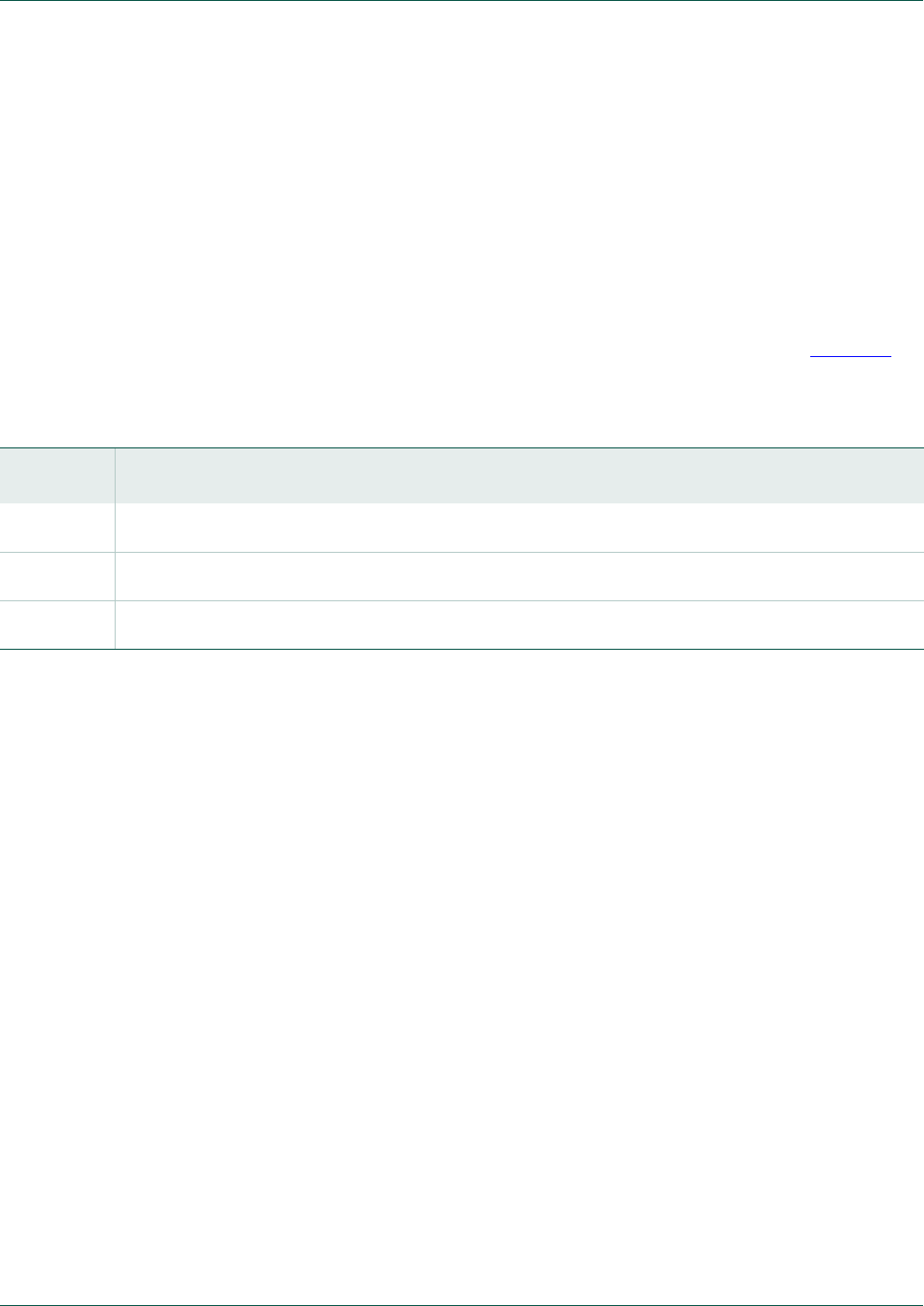
UM10360 All information provided in this document is subject to legal disclaimers. © NXP B.V. 2014. All rights reserved.
User manual Rev. 3.1 — 2 April 2014 457 of 849
NXP Semiconductors UM10360
Chapter 19: LPC176x/5x I2C0/1/2
19.8.11 Selecting the appropriate I2C data rate and duty cycle
Software must set values for the registers I2SCLH and I2SCLL to select the appropriate
data rate and duty cycle. I2SCLH defines the number of PCLK_I2C cycles for the SCL
HIGH time, I2SCLL defines the number of PCLK_I2C cycles for the SCL low time. The
frequency is determined by the following formula (PCLK_I2C is the frequency of the
peripheral bus APB):
(13)
The values for I2SCLL and I2SCLH must ensure that the data rate is in the appropriate
I2C data rate range. Each register value must be greater than or equal to 4. Table 395
gives some examples of I2C-bus rates based on PCLK_I2C frequency and I2SCLL and
I2SCLH values.
I2SCLL and I2SCLH values should not necessarily be the same. Software can set
different duty cycles on SCL by setting these two registers. For example, the I2C-bus
specification defines the SCL low time and high time at different values for a Fast Mode
and Fast Mode Plus I2C.
I2Cbitfrequency
PCLKI2C
I2CSCLH I2CSCLL+
---------------------------------------------------------
=
Table 395. Example I2C clock rates
I2C Rate I2SCLL + I2SCLH values at PCLK_I2C (MHz)
6 8 10 12 16 20 30 40 50 60 70 80 90 100
100 kHz
(Standard) 60 80 100 120 160 200 300 400 500 600 700 800 900 1000
400 kHz
(Fast Mode) 15 20 25 30 40 50 75 100 125 150 175 200 225 250
1 MHz (Fast
Mode Plus) -81012162030405060708090100

UM10360 All information provided in this document is subject to legal disclaimers. © NXP B.V. 2014. All rights reserved.
User manual Rev. 3.1 — 2 April 2014 458 of 849
NXP Semiconductors UM10360
Chapter 19: LPC176x/5x I2C0/1/2
19.9 Details of I2C operating modes
The four operating modes are:
•Master Transmitter
•Master Receiver
•Slave Receiver
•Slave Transmitter
Data transfers in each mode of operation are shown in Figure 94, Figure 95, Figure 96,
Figure 97, and Figure 98. Tab l e 3 9 6 lists abbreviations used in these figures when
describing the I2C operating modes.
In Figure 94 to Figure 98, circles are used to indicate when the serial interrupt flag is set.
The numbers in the circles show the status code held in the I2STAT register. At these
points, a service routine must be executed to continue or complete the serial transfer.
These service routines are not critical since the serial transfer is suspended until the serial
interrupt flag is cleared by software.
When a serial interrupt routine is entered, the status code in I2STAT is used to branch to
the appropriate service routine. For each status code, the required software action and
details of the following serial transfer are given in tables from Tab l e 3 9 9 to Tab l e 403 .
Table 396. Abbreviations used to describe an I2C operation
Abbreviation Explanation
SSTART condition
SLA 7-bit slave address
RRead bit (HIGH level at SDA)
WWrite bit (LOW level at SDA)
AAcknowledge bit (LOW level at SDA)
ANot acknowledge bit (HIGH level at SDA)
Data 8-bit data byte
PSTOP condition
Sr Repeated START condition

UM10360 All information provided in this document is subject to legal disclaimers. © NXP B.V. 2014. All rights reserved.
User manual Rev. 3.1 — 2 April 2014 459 of 849
NXP Semiconductors UM10360
Chapter 19: LPC176x/5x I2C0/1/2
19.9.1 Master Transmitter mode
In the master transmitter mode, a number of data bytes are transmitted to a slave receiver
(see Figure 94). Before the master transmitter mode can be entered, I2CON must be
initialized as follows:
The I2C rate must also be configured in the I2SCLL and I2SCLH registers. I2EN must be
set to logic 1 to enable the I2C block. If the AA bit is reset, the I2C block will not
acknowledge its own slave address or the General Call address in the event of another
device becoming master of the bus. In other words, if AA is reset, the I2C interface cannot
enter a slave mode. STA, STO, and SI must be reset.
The master transmitter mode may now be entered by setting the STA bit. The I2C logic will
now test the I2C-bus and generate a START condition as soon as the bus becomes free.
When a START condition is transmitted, the serial interrupt flag (SI) is set, and the status
code in the status register (I2STAT) will be 0x08. This status code is used by the interrupt
service routine to enter the appropriate state service routine that loads I2DAT with the
slave address and the data direction bit (SLA+W). The SI bit in I2CON must then be reset
before the serial transfer can continue.
When the slave address and the direction bit have been transmitted and an
acknowledgment bit has been received, the serial interrupt flag (SI) is set again, and a
number of status codes in I2STAT are possible. There are 0x18, 0x20, or 0x38 for the
master mode and also 0x68, 0x78, or 0xB0 if the slave mode was enabled (AA = logic 1).
The appropriate action to be taken for each of these status codes is detailed in Ta b l e 3 9 9 .
After a repeated START condition (state 0x10). The I2C block may switch to the master
receiver mode by loading I2DAT with SLA+R).
Table 397. I2CONSET used to initialize Master Transmitter mode
Bit 7 6 5 4 3 2 1 0
Symbol - I2EN STA STO SI AA - -
Value - 1 0 0 0 x - -
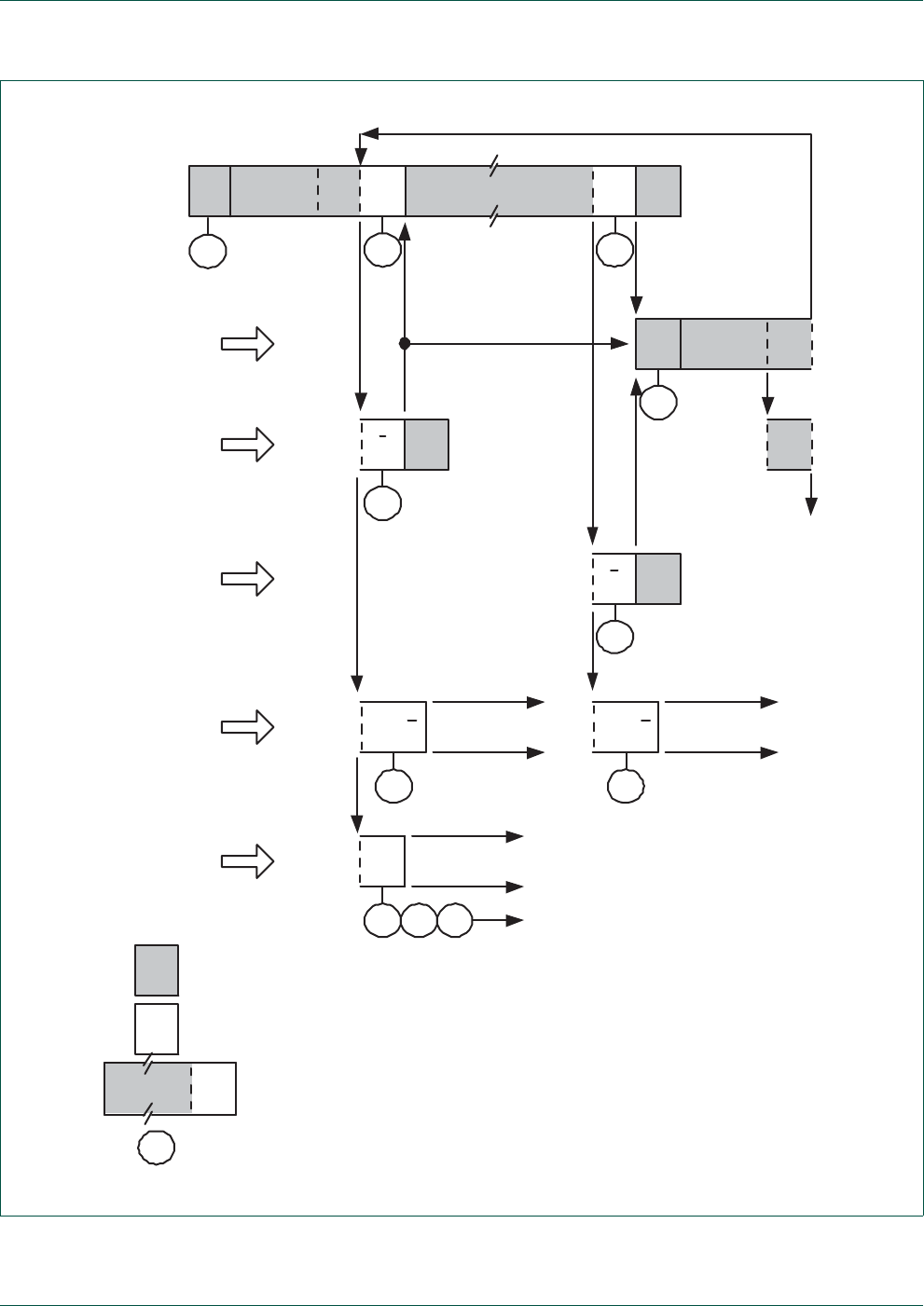
UM10360 All information provided in this document is subject to legal disclaimers. © NXP B.V. 2014. All rights reserved.
User manual Rev. 3.1 — 2 April 2014 460 of 849
NXP Semiconductors UM10360
Chapter 19: LPC176x/5x I2C0/1/2
Fig 94. Format and states in the Master Transmitter mode
DATA
A
R
WSLAS
DATAAW
SLA
to Master
receive
mode,
entry
= MR
MT
to corresponding
states in Slave mode
A OR AA OR A
A
other Master
continues
other Master
continues
Aother Master
continues
20H
08H 18H 28H
30H
10H
68H 78H B0H
38H 38H
arbitration lost
in Slave
address or
Data byte
Not
Acknowledge
received after a
Data byte
Not
Acknowledge
received after
the Slave
address
next transfer
started with a
Repeated Start
condition
arbitration lost
and
addressed as
Slave
successful
transmission
to a Slave
Receiver
from Master to Slave
from Slave to Master
any number of data bytes and their associated Acknowledge bits
nthis number (contained in I2STA) corresponds to a defined state of the
I2C bus
A P
P
S P

UM10360 All information provided in this document is subject to legal disclaimers. © NXP B.V. 2014. All rights reserved.
User manual Rev. 3.1 — 2 April 2014 461 of 849
NXP Semiconductors UM10360
Chapter 19: LPC176x/5x I2C0/1/2
19.9.2 Master Receiver mode
In the master receiver mode, a number of data bytes are received from a slave transmitter
(see Figure 95). The transfer is initialized as in the master transmitter mode. When the
START condition has been transmitted, the interrupt service routine must load I2DAT with
the 7-bit slave address and the data direction bit (SLA+R). The SI bit in I2CON must then
be cleared before the serial transfer can continue.
When the slave address and the data direction bit have been transmitted and an
acknowledgment bit has been received, the serial interrupt flag (SI) is set again, and a
number of status codes in I2STAT are possible. These are 0x40, 0x48, or 0x38 for the
master mode and also 0x68, 0x78, or 0xB0 if the slave mode was enabled (AA = 1). The
appropriate action to be taken for each of these status codes is detailed in Ta b le 4 0 0 . After
a repeated START condition (state 0x10), the I2C block may switch to the master
transmitter mode by loading I2DAT with SLA+W.
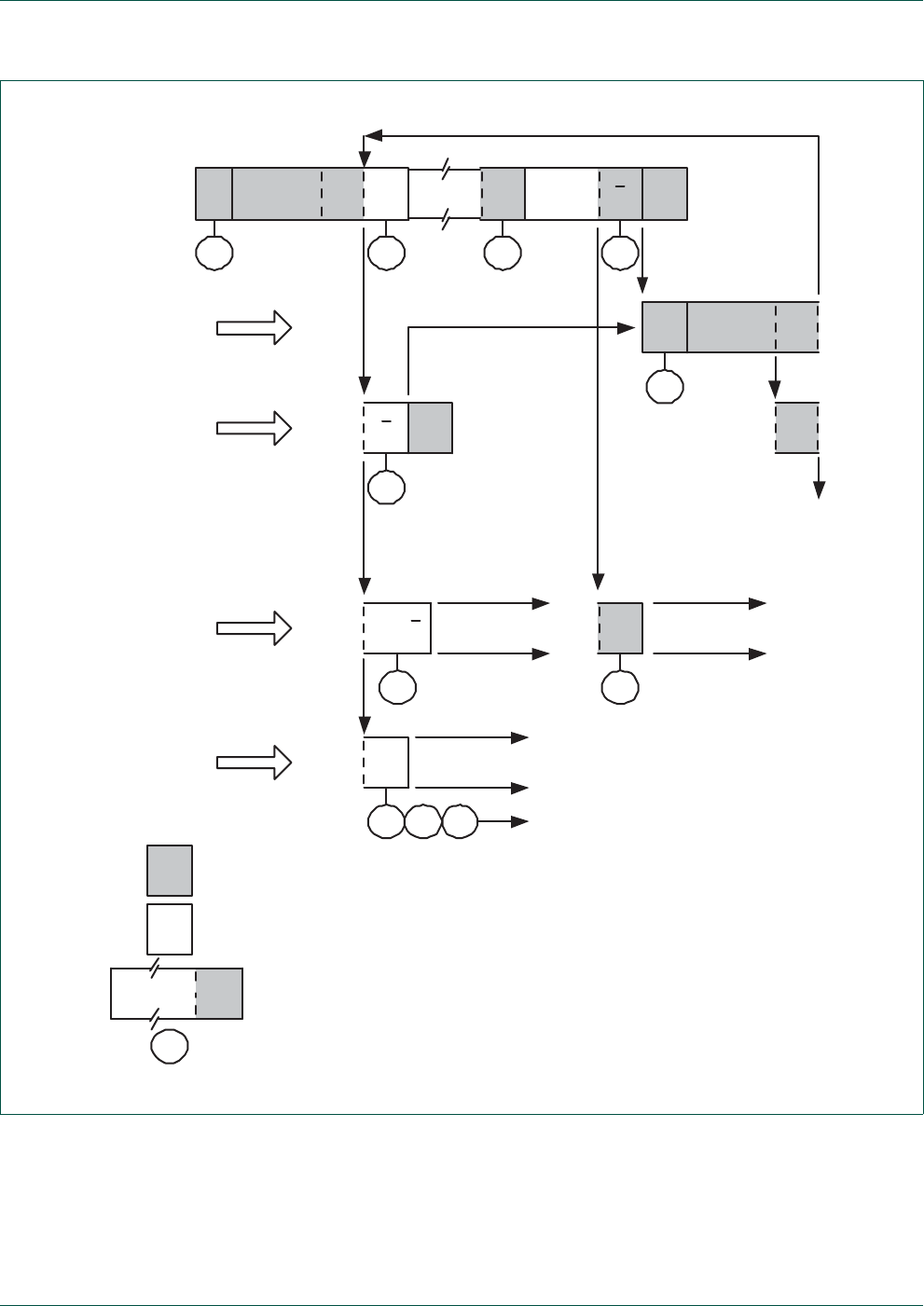
UM10360 All information provided in this document is subject to legal disclaimers. © NXP B.V. 2014. All rights reserved.
User manual Rev. 3.1 — 2 April 2014 462 of 849
NXP Semiconductors UM10360
Chapter 19: LPC176x/5x I2C0/1/2
Fig 95. Format and states in the Master Receiver mode
A
to Master
transmit
mode, entry
= MT
MR
to corresponding
states in Slave
mode
ARSLAS
RSLAS
W
AA OR A
AP
other Master
continues
other Master
continues
Aother Master
continues
48H
40H 58H
10H
68H 78H B0H
38H 38H
arbitration lost in
Slave address or
Acknowledge bit
Not Acknowledge
received after the
Slave address
next transfer
started with a
Repeated Start
condition
arbitration lost
and addressed
as Slave
successful
transmission to
a Slave
transmitter
from Master to Slave
from Slave to Master
any number of data bytes and their associated
Acknowledge bits
nthis number (contained in I2STA) corresponds to a defined state of
the I2C bus
DATAADATA
50H
ADATA
P
08H

UM10360 All information provided in this document is subject to legal disclaimers. © NXP B.V. 2014. All rights reserved.
User manual Rev. 3.1 — 2 April 2014 463 of 849
NXP Semiconductors UM10360
Chapter 19: LPC176x/5x I2C0/1/2
19.9.3 Slave Receiver mode
In the slave receiver mode, a number of data bytes are received from a master transmitter
(see Figure 96). To initiate the slave receiver mode, I2CON register, the I2ADR registers,
and the I2MASK registers must be configured.
The values on the four I2ADR registers combined with the values on the four I2MASK
registers determines which address(es) the I2C block will respond to when slave functions
are enabled. See sections 19.7.2, 19.7.3, 19.8.7, and 19.8.8 for details.
The I2C-bus rate settings do not affect the I2C block in the slave mode. I2EN must be set
to logic 1 to enable the I2C block. The AA bit must be set to enable the I2C block to
acknowledge its own slave address or the General Call address. STA, STO, and SI must
be reset.
When the I2ADR, I2MASK, and I2CON registers have been initialized, the I2C block waits
until it is addressed by its own slave address followed by the data direction bit which must
be “0” (W) for the I2C block to operate in the slave receiver mode. After its own slave
address and the W bit have been received, the serial interrupt flag (SI) is set and a valid
status code can be read from I2STAT. This status code is used to vector to a state service
routine. The appropriate action to be taken for each of these status codes is detailed in
Tab l e 4 01 . The slave receiver mode may also be entered if arbitration is lost while the I2C
block is in the master mode (see status 0x68 and 0x78).
If the AA bit is reset during a transfer, the I2C block will return a not acknowledge (logic 1)
to SDA after the next received data byte. While AA is reset, the I2C block does not
respond to its own slave address or a General Call address. However, the I2C-bus is still
monitored and address recognition may be resumed at any time by setting AA. This
means that the AA bit may be used to temporarily isolate the I2C block from the I2C-bus.
Table 398. I2CONSET used to initialize Slave Receiver mode
Bit 7 6 5 4 3 2 1 0
Symbol - I2EN STA STO SI AA - -
Value - 1 0 0 0 1 - -
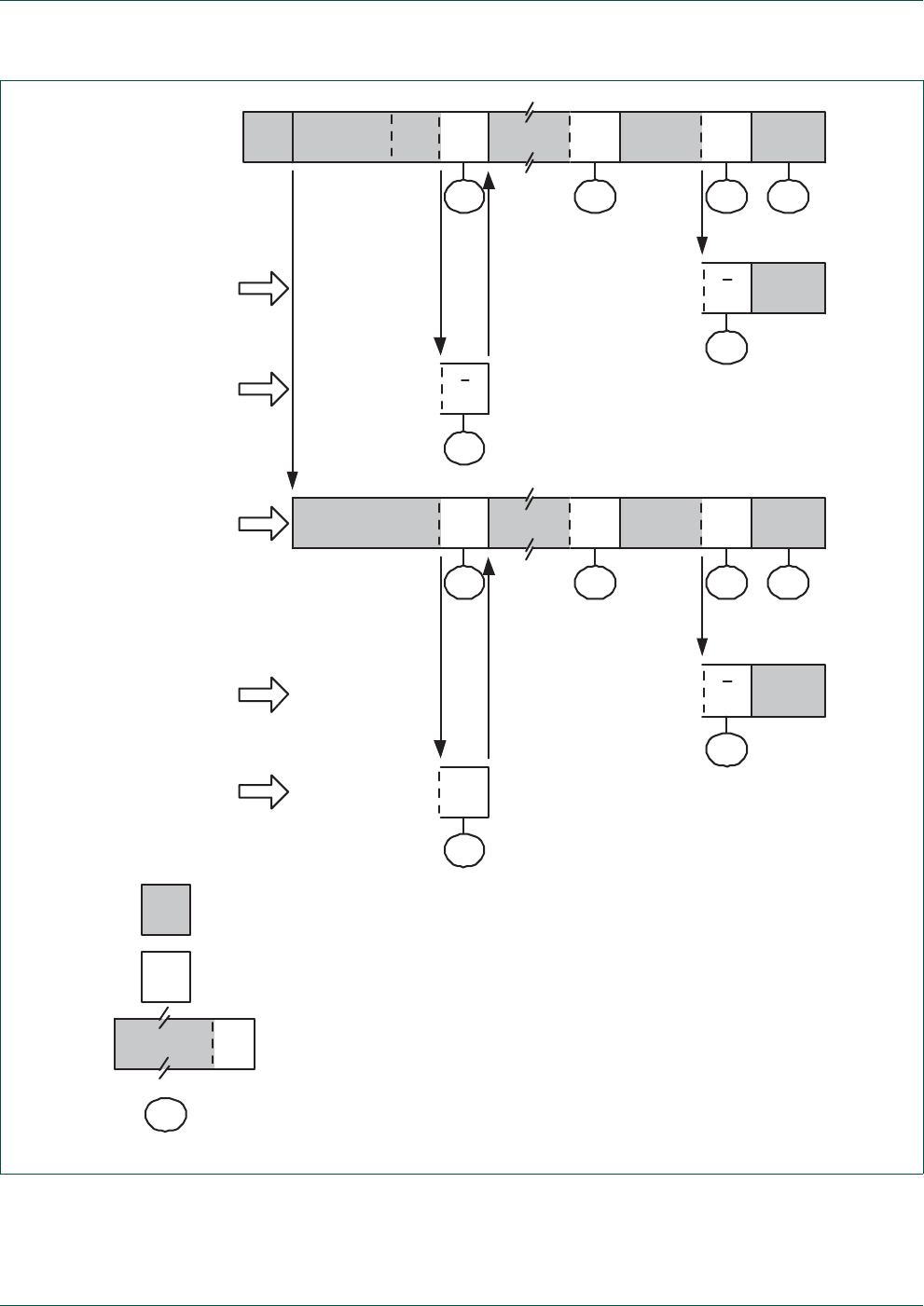
UM10360 All information provided in this document is subject to legal disclaimers. © NXP B.V. 2014. All rights reserved.
User manual Rev. 3.1 — 2 April 2014 464 of 849
NXP Semiconductors UM10360
Chapter 19: LPC176x/5x I2C0/1/2
Fig 96. Format and states in the Slave Receiver mode
A
A P OR SAWSLAS
P OR S
A
A
68H
60H 80H
88H
reception of the
General Call address
and one or more Data
bytes
arbitration lost as
Master and addressed
as Slave
last data byte
received is Not
acknowledged
arbitration lost as
Master and addressed
as Slave by General
Call
reception of the own
Slave address and one
or more Data bytes all
are acknowledged
from Master to Slave
from Slave to Master
any number of data bytes and their associated Acknowledge bits
nthis number (contained in I2STA) corresponds to a defined state of the I
2C
bus
DATAADATA
80H A0H
last data byte is Not
acknowledged
AP OR SA
70h 90h
DATAADATA
90h A0H
GENERAL CALL
A
98h
P OR S
A
78h
DATA
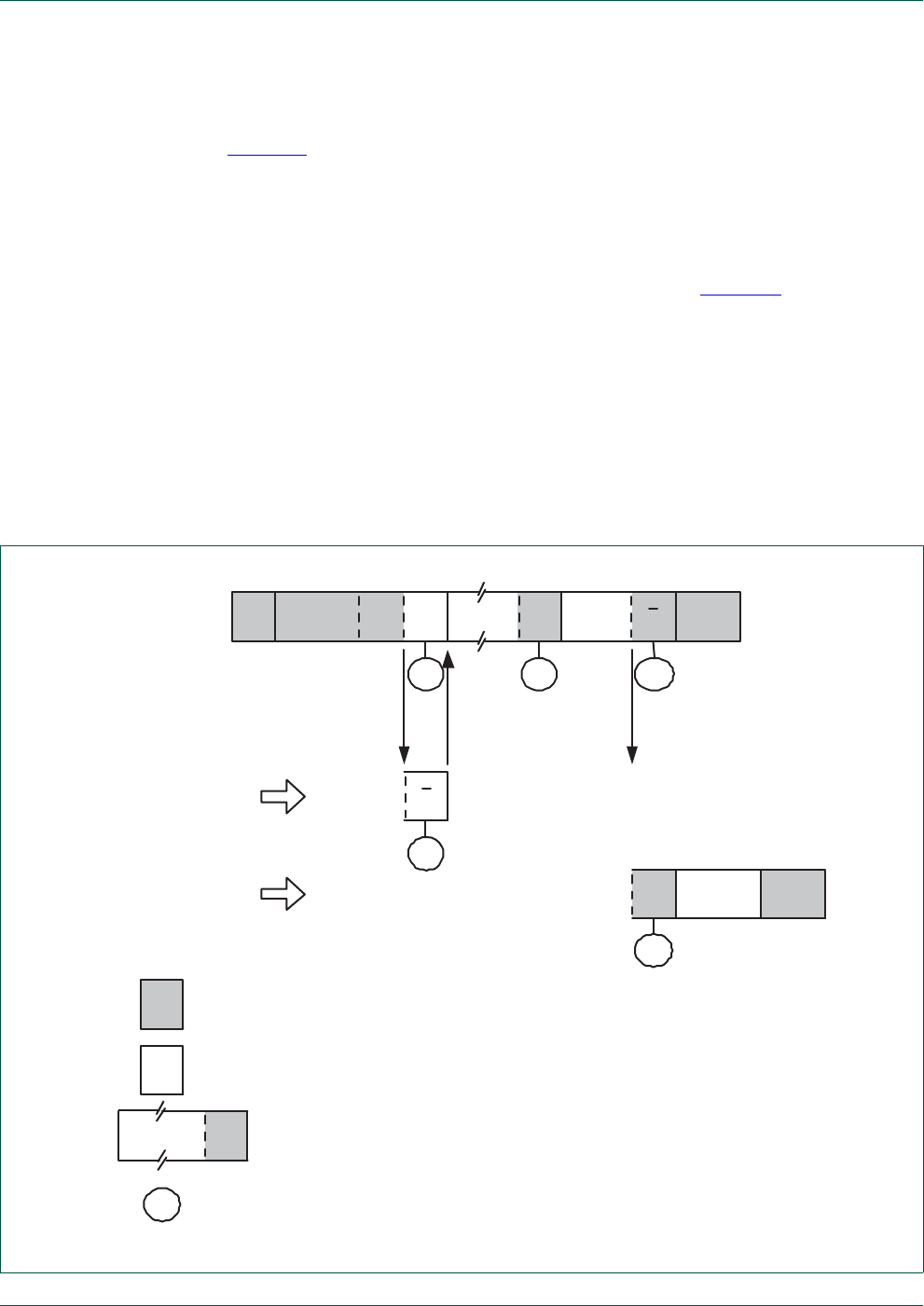
UM10360 All information provided in this document is subject to legal disclaimers. © NXP B.V. 2014. All rights reserved.
User manual Rev. 3.1 — 2 April 2014 465 of 849
NXP Semiconductors UM10360
Chapter 19: LPC176x/5x I2C0/1/2
19.9.4 Slave Transmitter mode
In the slave transmitter mode, a number of data bytes are transmitted to a master receiver
(see Figure 97). Data transfer is initialized as in the slave receiver mode. When I2ADR
and I2CON have been initialized, the I2C block waits until it is addressed by its own slave
address followed by the data direction bit which must be “1” (R) for the I2C block to
operate in the slave transmitter mode. After its own slave address and the R bit have been
received, the serial interrupt flag (SI) is set and a valid status code can be read from
I2STAT. This status code is used to vector to a state service routine, and the appropriate
action to be taken for each of these status codes is detailed in Table 402. The slave
transmitter mode may also be entered if arbitration is lost while the I2C block is in the
master mode (see state 0xB0).
If the AA bit is reset during a transfer, the I2C block will transmit the last byte of the transfer
and enter state 0xC0 or 0xC8. The I2C block is switched to the not addressed slave mode
and will ignore the master receiver if it continues the transfer. Thus the master receiver
receives all 1s as serial data. While AA is reset, the I2C block does not respond to its own
slave address or a General Call address. However, the I2C-bus is still monitored, and
address recognition may be resumed at any time by setting AA. This means that the AA
bit may be used to temporarily isolate the I2C block from the I2C-bus.
Fig 97. Format and states in the Slave Transmitter mode
DATA A
ARSLAS
P OR SA
A
B0H
A8H C0H
C8H
last data byte
transmitted. Switched
to Not Addressed
Slave (AA bit in
I2CON = “0”)
arbitration lost as
Master and
addressed as Slave
reception of the own
Slave address and
one or more Data
bytes all are
acknowledged
from Master to Slave
from Slave to Master
any number of data bytes and their associated
Acknowledge bits
nthis number (contained in I2STA) corresponds to a defined state of
the I2C bus
ADATA
B8H
ALL ONES
ADATA
P OR S

UM10360 All information provided in this document is subject to legal disclaimers. © NXP B.V. 2014. All rights reserved.
User manual Rev. 3.1 — 2 April 2014 466 of 849
NXP Semiconductors UM10360
Chapter 19: LPC176x/5x I2C0/1/2
19.9.5 Detailed state tables
The following tables show detailed state information for the four I2C operating modes.
Table 399. Master Transmitter mode
I2CSTAT
Status
Code
Status of the
I2C-bus and
hardware
Application software response Next action taken by I2C hardware
To/From I2DAT To I2CON
STA STO SI AA
0x08 A START condition
has been transmitted.
Load SLA+W; clear
STA
X00 XSLA+W will be transmitted; ACK bit will
be received.
0x10 A repeated START
condition has been
transmitted.
Load SLA+W or X 0 0 X As above.
Load SLA+R; Clear
STA
X00 XSLA+W will be transmitted; the I
2C block
will be switched to MST/REC mode.
0x18 SLA+W has been
transmitted; ACK has
been received.
Load data byte or 0 0 0 X Data byte will be transmitted; ACK bit will
be received.
No I2DAT action or 1 0 0 X Repeated START will be transmitted.
No I2DAT action or 0 1 0 X STOP condition will be transmitted; STO
flag will be reset.
No I2DAT action 1 1 0 X STOP condition followed by a START
condition will be transmitted; STO flag will
be reset.
0x20 SLA+W has been
transmitted; NOT
ACK has been
received.
Load data byte or 0 0 0 X Data byte will be transmitted; ACK bit will
be received.
No I2DAT action or 1 0 0 X Repeated START will be transmitted.
No I2DAT action or 0 1 0 X STOP condition will be transmitted; STO
flag will be reset.
No I2DAT action 1 1 0 X STOP condition followed by a START
condition will be transmitted; STO flag will
be reset.
0x28 Data byte in I2DAT
has been transmitted;
ACK has been
received.
Load data byte or 0 0 0 X Data byte will be transmitted; ACK bit will
be received.
No I2DAT action or 1 0 0 X Repeated START will be transmitted.
No I2DAT action or 0 1 0 X STOP condition will be transmitted; STO
flag will be reset.
No I2DAT action 1 1 0 X STOP condition followed by a START
condition will be transmitted; STO flag will
be reset.
0x30 Data byte in I2DAT
has been transmitted;
NOT ACK has been
received.
Load data byte or 0 0 0 X Data byte will be transmitted; ACK bit will
be received.
No I2DAT action or 1 0 0 X Repeated START will be transmitted.
No I2DAT action or 0 1 0 X STOP condition will be transmitted; STO
flag will be reset.
No I2DAT action 1 1 0 X STOP condition followed by a START
condition will be transmitted; STO flag will
be reset.
0x38 Arbitration lost in
SLA+R/W or Data
bytes.
No I2DAT action or 0 0 0 X I2C-bus will be released; not addressed
slave will be entered.
No I2DAT action 1 0 0 X A START condition will be transmitted
when the bus becomes free.

UM10360 All information provided in this document is subject to legal disclaimers. © NXP B.V. 2014. All rights reserved.
User manual Rev. 3.1 — 2 April 2014 467 of 849
NXP Semiconductors UM10360
Chapter 19: LPC176x/5x I2C0/1/2
Table 400. Master Receiver mode
I2CSTAT
Status
Code
Status of the
I2C-bus and
hardware
Application software response Next action taken by I2C hardware
To/From I2DAT To I2CON
STA STO SI AA
0x08 A START condition
has been transmitted.
Load SLA+R X 0 0 X SLA+R will be transmitted; ACK bit will be
received.
0x10 A repeated START
condition has been
transmitted.
Load SLA+R or X 0 0 X As above.
Load SLA+W X 0 0 X SLA+W will be transmitted; the I2C block
will be switched to MST/TRX mode.
0x38 Arbitration lost in
NOT ACK bit.
No I2DAT action or 0 0 0 X I2C-bus will be released; the I2C block will
enter a slave mode.
No I2DAT action 1 0 0 X A START condition will be transmitted
when the bus becomes free.
0x40 SLA+R has been
transmitted; ACK has
been received.
No I2DAT action or 0 0 0 0 Data byte will be received; NOT ACK bit
will be returned.
No I2DAT action 0 0 0 1 Data byte will be received; ACK bit will be
returned.
0x48 SLA+R has been
transmitted; NOT
ACK has been
received.
No I2DAT action or 1 0 0 X Repeated START condition will be
transmitted.
No I2DAT action or 0 1 0 X STOP condition will be transmitted; STO
flag will be reset.
No I2DAT action 1 1 0 X STOP condition followed by a START
condition will be transmitted; STO flag will
be reset.
0x50 Data byte has been
received; ACK has
been returned.
Read data byte or 0 0 0 0 Data byte will be received; NOT ACK bit
will be returned.
Read data byte 0 0 0 1 Data byte will be received; ACK bit will be
returned.
0x58 Data byte has been
received; NOT ACK
has been returned.
Read data byte or 1 0 0 X Repeated START condition will be
transmitted.
Read data byte or 0 1 0 X STOP condition will be transmitted; STO
flag will be reset.
Read data byte 1 1 0 X STOP condition followed by a START
condition will be transmitted; STO flag will
be reset.

UM10360 All information provided in this document is subject to legal disclaimers. © NXP B.V. 2014. All rights reserved.
User manual Rev. 3.1 — 2 April 2014 468 of 849
NXP Semiconductors UM10360
Chapter 19: LPC176x/5x I2C0/1/2
Table 401. Slave Receiver mode
I2CSTAT
Status
Code
Status of the I2C-bus
and hardware
Application software response Next action taken by I2C hardware
To/From I2DAT To I2CON
STA STO SI AA
0x60 Own SLA+W has been
received; ACK has been
returned.
No I2DAT action
or
X00 0Data byte will be received and NOT ACK
will be returned.
No I2DAT action X 0 0 1 Data byte will be received and ACK will be
returned.
0x68 Arbitration lost in
SLA+R/W as master;
Own SLA+W has been
received, ACK returned.
No I2DAT action
or
X00 0Data byte will be received and NOT ACK
will be returned.
No I2DAT action X 0 0 1 Data byte will be received and ACK will be
returned.
0x70 General Call address
(0x00) has been
received; ACK has been
returned.
No I2DAT action
or
X00 0Data byte will be received and NOT ACK
will be returned.
No I2DAT action X 0 0 1 Data byte will be received and ACK will be
returned.
0x78 Arbitration lost in
SLA+R/W as master;
General Call address
has been received, ACK
has been returned.
No I2DAT action
or
X00 0Data byte will be received and NOT ACK
will be returned.
No I2DAT action X 0 0 1 Data byte will be received and ACK will be
returned.
0x80 Previously addressed
with own SLA address;
DATA has been received;
ACK has been returned.
Read data byte
or
X00 0Data byte will be received and NOT ACK
will be returned.
Read data byte X 0 0 1 Data byte will be received and ACK will be
returned.
0x88 Previously addressed
with own SLA; DATA
byte has been received;
NOT ACK has been
returned.
Read data byte
or
0000Switched to not addressed SLV mode; no
recognition of own SLA or General Call
address.
Read data byte
or
0001Switched to not addressed SLV mode;
Own SLA will be recognized; General Call
address will be recognized if
I2ADR[0] = logic 1.
Read data byte
or
1000Switched to not addressed SLV mode; no
recognition of own SLA or General Call
address. A START condition will be
transmitted when the bus becomes free.
Read data byte 1 0 0 1 Switched to not addressed SLV mode;
Own SLA will be recognized; General Call
address will be recognized if
I2ADR[0] = logic 1. A START condition will
be transmitted when the bus becomes
free.
0x90 Previously addressed
with General Call; DATA
byte has been received;
ACK has been returned.
Read data byte
or
X00 0Data byte will be received and NOT ACK
will be returned.
Read data byte X 0 0 1 Data byte will be received and ACK will be
returned.

UM10360 All information provided in this document is subject to legal disclaimers. © NXP B.V. 2014. All rights reserved.
User manual Rev. 3.1 — 2 April 2014 469 of 849
NXP Semiconductors UM10360
Chapter 19: LPC176x/5x I2C0/1/2
0x98 Previously addressed
with General Call; DATA
byte has been received;
NOT ACK has been
returned.
Read data byte
or
0000Switched to not addressed SLV mode; no
recognition of own SLA or General Call
address.
Read data byte
or
0001Switched to not addressed SLV mode;
Own SLA will be recognized; General Call
address will be recognized if
I2ADR[0] = logic 1.
Read data byte
or
1000Switched to not addressed SLV mode; no
recognition of own SLA or General Call
address. A START condition will be
transmitted when the bus becomes free.
Read data byte 1 0 0 1 Switched to not addressed SLV mode;
Own SLA will be recognized; General Call
address will be recognized if
I2ADR[0] = logic 1. A START condition will
be transmitted when the bus becomes
free.
0xA0 A STOP condition or
repeated START
condition has been
received while still
addressed as Slave
Receiver or Slave
Transmitter.
No STDAT
action or
0000Switched to not addressed SLV mode; no
recognition of own SLA or General Call
address.
No STDAT
action or
0001Switched to not addressed SLV mode;
Own SLA will be recognized; General Call
address will be recognized if
I2ADR[0] = logic 1.
No STDAT
action or
1000Switched to not addressed SLV mode; no
recognition of own SLA or General Call
address. A START condition will be
transmitted when the bus becomes free.
No STDAT
action
1001Switched to not addressed SLV mode;
Own SLA will be recognized; General Call
address will be recognized if
I2ADR[0] = logic 1. A START condition will
be transmitted when the bus becomes
free.
Table 401. Slave Receiver mode
I2CSTAT
Status
Code
Status of the I2C-bus
and hardware
Application software response Next action taken by I2C hardware
To/From I2DAT To I2CON
STA STO SI AA

UM10360 All information provided in this document is subject to legal disclaimers. © NXP B.V. 2014. All rights reserved.
User manual Rev. 3.1 — 2 April 2014 470 of 849
NXP Semiconductors UM10360
Chapter 19: LPC176x/5x I2C0/1/2
Table 402. Slave Transmitter mode
I2CSTAT
Status
Code
Status of the I2C-bus
and hardware
Application software response Next action taken by I2C hardware
To/From I2DAT To I2CON
STA STO SI AA
0xA8 Own SLA+R has been
received; ACK has
been returned.
Load data byte or X 0 0 0 Last data byte will be transmitted and ACK
bit will be received.
Load data byte X 0 0 1 Data byte will be transmitted; ACK will be
received.
0xB0 Arbitration lost in
SLA+R/W as master;
Own SLA+R has been
received, ACK has
been returned.
Load data byte or X 0 0 0 Last data byte will be transmitted and ACK
bit will be received.
Load data byte X 0 0 1 Data byte will be transmitted; ACK bit will
be received.
0xB8 Data byte in I2DAT has
been transmitted; ACK
has been received.
Load data byte or X 0 0 0 Last data byte will be transmitted and ACK
bit will be received.
Load data byte X 0 0 1 Data byte will be transmitted; ACK bit will
be received.
0xC0 Data byte in I2DAT has
been transmitted; NOT
ACK has been
received.
No I2DAT action
or
0000Switched to not addressed SLV mode; no
recognition of own SLA or General Call
address.
No I2DAT action
or
0001Switched to not addressed SLV mode;
Own SLA will be recognized; General Call
address will be recognized if
I2ADR[0] = logic 1.
No I2DAT action
or
1000Switched to not addressed SLV mode; no
recognition of own SLA or General Call
address. A START condition will be
transmitted when the bus becomes free.
No I2DAT action 1 0 0 1 Switched to not addressed SLV mode;
Own SLA will be recognized; General Call
address will be recognized if
I2ADR[0] = logic 1. A START condition will
be transmitted when the bus becomes free.
0xC8 Last data byte in
I2DAT has been
transmitted (AA = 0);
ACK has been
received.
No I2DAT action
or
0000Switched to not addressed SLV mode; no
recognition of own SLA or General Call
address.
No I2DAT action
or
0001Switched to not addressed SLV mode;
Own SLA will be recognized; General Call
address will be recognized if
I2ADR[0] = logic 1.
No I2DAT action
or
1000Switched to not addressed SLV mode; no
recognition of own SLA or General Call
address. A START condition will be
transmitted when the bus becomes free.
No I2DAT action 1 0 0 01 Switched to not addressed SLV mode;
Own SLA will be recognized; General Call
address will be recognized if
I2ADR.0 = logic 1. A START condition will
be transmitted when the bus becomes free.

UM10360 All information provided in this document is subject to legal disclaimers. © NXP B.V. 2014. All rights reserved.
User manual Rev. 3.1 — 2 April 2014 471 of 849
NXP Semiconductors UM10360
Chapter 19: LPC176x/5x I2C0/1/2
19.9.6 Miscellaneous states
There are two I2STAT codes that do not correspond to a defined I2C hardware state (see
Tab l e 4 03 ). These are discussed below.
19.9.6.1 I2STAT = 0xF8
This status code indicates that no relevant information is available because the serial
interrupt flag, SI, is not yet set. This occurs between other states and when the I2C block
is not involved in a serial transfer.
19.9.6.2 I2STAT = 0x00
This status code indicates that a bus error has occurred during an I2C serial transfer. A
bus error is caused when a START or STOP condition occurs at an illegal position in the
format frame. Examples of such illegal positions are during the serial transfer of an
address byte, a data byte, or an acknowledge bit. A bus error may also be caused when
external interference disturbs the internal I2C block signals. When a bus error occurs, SI is
set. To recover from a bus error, the STO flag must be set and SI must be cleared. This
causes the I2C block to enter the “not addressed” slave mode (a defined state) and to
clear the STO flag (no other bits in I2CON are affected). The SDA and SCL lines are
released (a STOP condition is not transmitted).
19.9.7 Some special cases
The I2C hardware has facilities to handle the following special cases that may occur
during a serial transfer:
19.9.7.1 Simultaneous repeated START conditions from two masters
A repeated START condition may be generated in the master transmitter or master
receiver modes. A special case occurs if another master simultaneously generates a
repeated START condition (see Figure 98). Until this occurs, arbitration is not lost by
either master since they were both transmitting the same data.
Table 403. Miscellaneous States
Status
Code
(I2CSTAT)
Status of the I2C-bus
and hardware
Application software response Next action taken by I2C hardware
To/From I2DAT To I2CON
STA STO SI AA
0xF8 No relevant state
information available;
SI = 0.
No I2DAT action No I2CON action Wait or proceed current transfer.
0x00 Bus error during MST
or selected slave
modes, due to an
illegal START or
STOP condition. State
0x00 can also occur
when interference
causes the I2C block
to enter an undefined
state.
No I2DAT action 0 1 0 X Only the internal hardware is affected in
the MST or addressed SLV modes. In all
cases, the bus is released and the I2C
block is switched to the not addressed
SLV mode. STO is reset.

UM10360 All information provided in this document is subject to legal disclaimers. © NXP B.V. 2014. All rights reserved.
User manual Rev. 3.1 — 2 April 2014 472 of 849
NXP Semiconductors UM10360
Chapter 19: LPC176x/5x I2C0/1/2
If the I2C hardware detects a repeated START condition on the I2C-bus before generating
a repeated START condition itself, it will release the bus, and no interrupt request is
generated. If another master frees the bus by generating a STOP condition, the I2C block
will transmit a normal START condition (state 0x08), and a retry of the total serial data
transfer can commence.
19.9.7.2 Data transfer after loss of arbitration
Arbitration may be lost in the master transmitter and master receiver modes (see
Figure 92). Loss of arbitration is indicated by the following states in I2STAT; 0x38, 0x68,
0x78, and 0xB0 (see Figure 94 and Figure 95).
If the STA flag in I2CON is set by the routines which service these states, then, if the bus
is free again, a START condition (state 0x08) is transmitted without intervention by the
CPU, and a retry of the total serial transfer can commence.
19.9.7.3 Forced access to the I2C-bus
In some applications, it may be possible for an uncontrolled source to cause a bus
hang-up. In such situations, the problem may be caused by interference, temporary
interruption of the bus or a temporary short-circuit between SDA and SCL.
If an uncontrolled source generates a superfluous START or masks a STOP condition,
then the I2C-bus stays busy indefinitely. If the STA flag is set and bus access is not
obtained within a reasonable amount of time, then a forced access to the I2C-bus is
possible. This is achieved by setting the STO flag while the STA flag is still set. No STOP
condition is transmitted. The I2C hardware behaves as if a STOP condition was received
and is able to transmit a START condition. The STO flag is cleared by hardware
Figure 99.
19.9.7.4 I2C-bus obstructed by a LOW level on SCL or SDA
An I2C-bus hang-up can occur if either the SDA or SCL line is held LOW by any device on
the bus. If the SCL line is obstructed (pulled LOW) by a device on the bus, no further serial
transfer is possible, and the problem must be resolved by the device that is pulling the
SCL bus line LOW.
Typically, the SDA line may be obstructed by another device on the bus that has become
out of synchronization with the current bus master by either missing a clock, or by sensing
a noise pulse as a clock. In this case, the problem can be solved by transmitting additional
clock pulses on the SCL line Figure 100. The I2C interface does not include a dedicated
time-out timer to detect an obstructed bus, but this can be implemented using another
timer in the system. When detected, software can force clocks (up to 9 may be required)
on SCL until SDA is released by the offending device. At that point, the slave may still be
out of synchronization, so a START should be generated to insure that all I2C peripherals
are synchronized.
19.9.7.5 Bus error
A bus error occurs when a START or STOP condition is detected at an illegal position in
the format frame. Examples of illegal positions are during the serial transfer of an address
byte, a data bit, or an acknowledge bit.
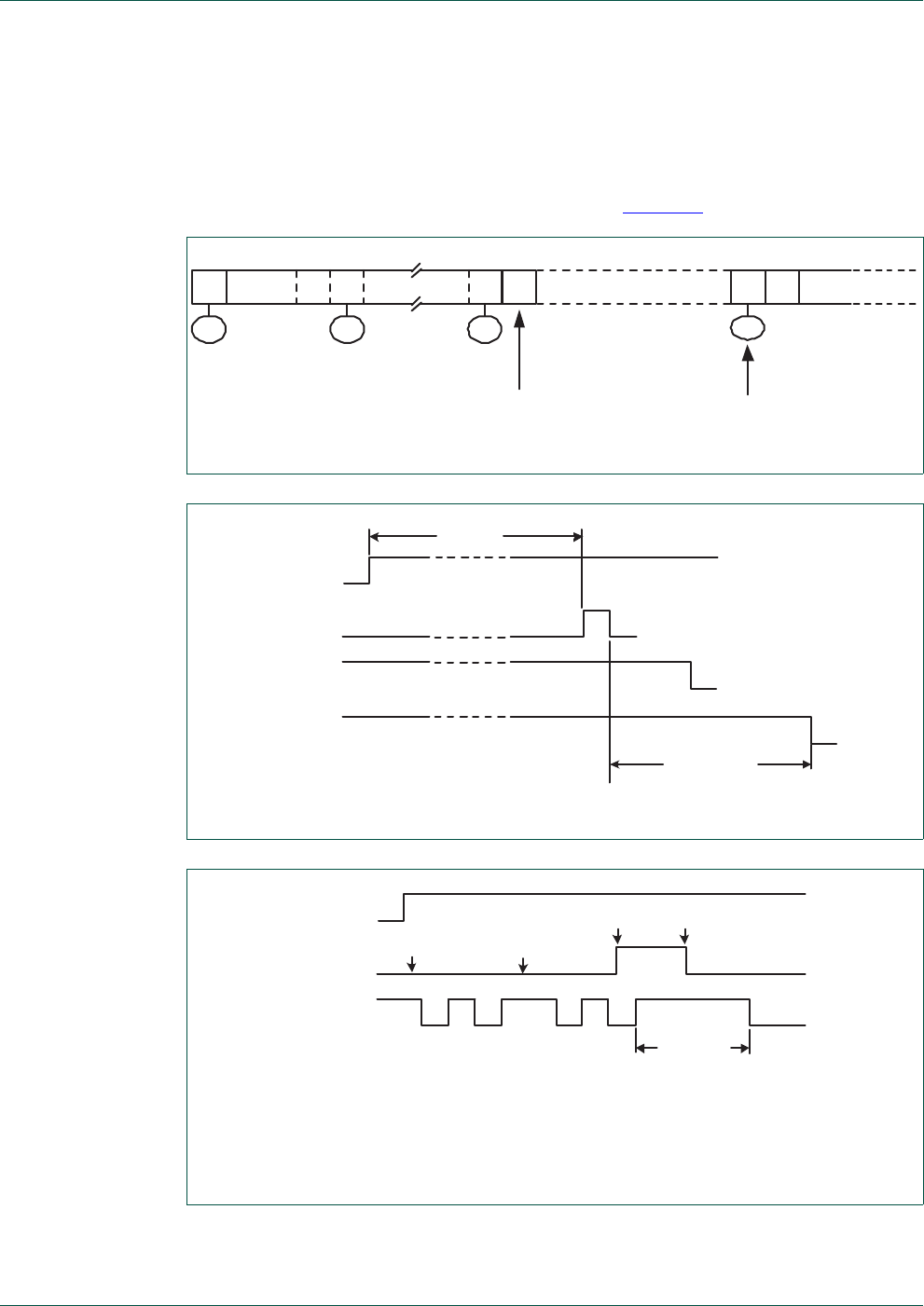
UM10360 All information provided in this document is subject to legal disclaimers. © NXP B.V. 2014. All rights reserved.
User manual Rev. 3.1 — 2 April 2014 473 of 849
NXP Semiconductors UM10360
Chapter 19: LPC176x/5x I2C0/1/2
The I2C hardware only reacts to a bus error when it is involved in a serial transfer either as
a master or an addressed slave. When a bus error is detected, the I2C block immediately
switches to the not addressed slave mode, releases the SDA and SCL lines, sets the
interrupt flag, and loads the status register with 0x00. This status code may be used to
vector to a state service routine which either attempts the aborted serial transfer again or
simply recovers from the error condition as shown in Tab le 4 0 3.
Fig 98. Simultaneous repeated START conditions from two masters
Fig 99. Forced access to a busy I2C-bus
(1) Unsuccessful attempt to send a START condition.
(2) SDA line is released.
(3) Successful attempt to send a START condition. State 08H is entered.
Fig 100. Recovering from a bus obstruction caused by a LOW level on SDA
SLAAWSLAS
18H 08H
ADATA
28H08H
OTHER MASTER
CONTINUES
other Master sends
repeated START earlier
S
retry
S P
SDA line
SCL line
STA flag
STO flag
time limit
start
condition
SDA line
SCL line
(1)
(2)
(1)
(3)
STA flag
start
condition

UM10360 All information provided in this document is subject to legal disclaimers. © NXP B.V. 2014. All rights reserved.
User manual Rev. 3.1 — 2 April 2014 474 of 849
NXP Semiconductors UM10360
Chapter 19: LPC176x/5x I2C0/1/2
19.9.8 I2C state service routines
This section provides examples of operations that must be performed by various I2C state
service routines. This includes:
•Initialization of the I2C block after a Reset.
•I2C Interrupt Service
•The 26 state service routines providing support for all four I2C operating modes.
19.9.8.1 Initialization
In the initialization example, the I2C block is enabled for both master and slave modes.
For each mode, a buffer is used for transmission and reception. The initialization routine
performs the following functions:
•The I2ADR registers and I2MASK registers are loaded with values to configure the
part’s own slave address(es) and the General Call bit (GC)
•The I2C interrupt enable and interrupt priority bits are set
•The slave mode is enabled by simultaneously setting the I2EN and AA bits in I2CON
and the serial clock frequency (for master modes) is defined by loading the I2SCLH
and I2SCLL registers. The master routines must be started in the main program.
The I2C hardware now begins checking the I2C-bus for its own slave address and General
Call. If the General Call or the own slave address is detected, an interrupt is requested
and I2STAT is loaded with the appropriate state information.
19.9.8.2 I2C interrupt service
When the I2C interrupt is entered, I2STAT contains a status code which identifies one of
the 26 state services to be executed.
19.9.8.3 The state service routines
Each state routine is part of the I2C interrupt routine and handles one of the 26 states.
19.9.8.4 Adapting state services to an application
The state service examples show the typical actions that must be performed in response
to the 26 I2C state codes. If one or more of the four I2C operating modes are not used, the
associated state services can be omitted, as long as care is taken that the those states
can never occur.
In an application, it may be desirable to implement some kind of time-out during I2C
operations, in order to trap an inoperative bus or a lost service routine.

UM10360 All information provided in this document is subject to legal disclaimers. © NXP B.V. 2014. All rights reserved.
User manual Rev. 3.1 — 2 April 2014 475 of 849
NXP Semiconductors UM10360
Chapter 19: LPC176x/5x I2C0/1/2
19.10 Software example
19.10.1 Initialization routine
Example to initialize I2C Interface as a Slave and/or Master.
1. Load the I2ADR registers and I2MASK registers with values to configure the own
Slave Address, enable General Call recognition if needed.
2. Enable I2C interrupt.
3. Write 0x44 to I2CONSET to set the I2EN and AA bits, enabling Slave functions. For
Master only functions, write 0x40 to I2CONSET.
19.10.2 Start Master Transmit function
Begin a Master Transmit operation by setting up the buffer, pointer, and data count, then
initiating a START.
1. Initialize Master data counter.
2. Set up the Slave Address to which data will be transmitted, and add the Write bit.
3. Write 0x20 to I2CONSET to set the STA bit.
4. Set up data to be transmitted in Master Transmit buffer.
5. Initialize the Master data counter to match the length of the message being sent.
6. Exit
19.10.3 Start Master Receive function
Begin a Master Receive operation by setting up the buffer, pointer, and data count, then
initiating a START.
1. Initialize Master data counter.
2. Set up the Slave Address to which data will be transmitted, and add the Read bit.
3. Write 0x20 to I2CONSET to set the STA bit.
4. Set up the Master Receive buffer.
5. Initialize the Master data counter to match the length of the message to be received.
6. Exit
19.10.4 I2C interrupt routine
Determine the I2C state and which state routine will be used to handle it.
1. Read the I2C status from I2STA.
2. Use the status value to branch to one of 26 possible state routines.
19.10.5 Non mode specific states
19.10.5.1 State: 0x00
Bus Error. Enter not addressed Slave mode and release bus.

UM10360 All information provided in this document is subject to legal disclaimers. © NXP B.V. 2014. All rights reserved.
User manual Rev. 3.1 — 2 April 2014 476 of 849
NXP Semiconductors UM10360
Chapter 19: LPC176x/5x I2C0/1/2
1. Write 0x14 to I2CONSET to set the STO and AA bits.
2. Write 0x08 to I2CONCLR to clear the SI flag.
3. Exit
19.10.5.2 Master States
State 0x08 and State 0x10 are for both Master Transmit and Master Receive modes. The
R/W bit decides whether the next state is within Master Transmit mode or Master Receive
mode.
19.10.5.3 State: 0x08
A START condition has been transmitted. The Slave Address + R/W bit will now be
transmitted.
1. Write Slave Address with R/W bit to I2DAT.
2. Write 0x04 to I2CONSET to set the AA bit.
3. Write 0x08 to I2CONCLR to clear the SI flag.
4. Set up Master Transmit mode data buffer.
5. Set up Master Receive mode data buffer.
6. Initialize Master data counter.
7. Exit
19.10.5.4 State: 0x10
A repeated START condition has been transmitted. The Slave Address + R/W bit will now
be transmitted.
1. Write Slave Address with R/W bit to I2DAT.
2. Write 0x04 to I2CONSET to set the AA bit.
3. Write 0x08 to I2CONCLR to clear the SI flag.
4. Set up Master Transmit mode data buffer.
5. Set up Master Receive mode data buffer.
6. Initialize Master data counter.
7. Exit
19.10.6 Master Transmitter states
19.10.6.1 State: 0x18
Previous state was State 0x08 or State 0x10, Slave Address + Write has been transmitted,
ACK has been received. The first data byte will be transmitted.
1. Load I2DAT with first data byte from Master Transmit buffer.
2. Write 0x04 to I2CONSET to set the AA bit.
3. Write 0x08 to I2CONCLR to clear the SI flag.
4. Increment Master Transmit buffer pointer.
5. Exit

UM10360 All information provided in this document is subject to legal disclaimers. © NXP B.V. 2014. All rights reserved.
User manual Rev. 3.1 — 2 April 2014 477 of 849
NXP Semiconductors UM10360
Chapter 19: LPC176x/5x I2C0/1/2
19.10.6.2 State: 0x20
Slave Address + Write has been transmitted, NOT ACK has been received. A STOP
condition will be transmitted.
1. Write 0x14 to I2CONSET to set the STO and AA bits.
2. Write 0x08 to I2CONCLR to clear the SI flag.
3. Exit
19.10.6.3 State: 0x28
Data has been transmitted, ACK has been received. If the transmitted data was the last
data byte then transmit a STOP condition, otherwise transmit the next data byte.
1. Decrement the Master data counter, skip to step 5 if not the last data byte.
2. Write 0x14 to I2CONSET to set the STO and AA bits.
3. Write 0x08 to I2CONCLR to clear the SI flag.
4. Exit
5. Load I2DAT with next data byte from Master Transmit buffer.
6. Write 0x04 to I2CONSET to set the AA bit.
7. Write 0x08 to I2CONCLR to clear the SI flag.
8. Increment Master Transmit buffer pointer
9. Exit
19.10.6.4 State: 0x30
Data has been transmitted, NOT ACK received. A STOP condition will be transmitted.
1. Write 0x14 to I2CONSET to set the STO and AA bits.
2. Write 0x08 to I2CONCLR to clear the SI flag.
3. Exit
19.10.6.5 State: 0x38
Arbitration has been lost during Slave Address + Write or data. The bus has been
released and not addressed Slave mode is entered. A new START condition will be
transmitted when the bus is free again.
1. Write 0x24 to I2CONSET to set the STA and AA bits.
2. Write 0x08 to I2CONCLR to clear the SI flag.
3. Exit
19.10.7 Master Receive states
19.10.7.1 State: 0x40
Previous state was State 08 or State 10. Slave Address + Read has been transmitted,
ACK has been received. Data will be received and ACK returned.
1. Write 0x04 to I2CONSET to set the AA bit.
2. Write 0x08 to I2CONCLR to clear the SI flag.

UM10360 All information provided in this document is subject to legal disclaimers. © NXP B.V. 2014. All rights reserved.
User manual Rev. 3.1 — 2 April 2014 478 of 849
NXP Semiconductors UM10360
Chapter 19: LPC176x/5x I2C0/1/2
3. Exit
19.10.7.2 State: 0x48
Slave Address + Read has been transmitted, NOT ACK has been received. A STOP
condition will be transmitted.
1. Write 0x14 to I2CONSET to set the STO and AA bits.
2. Write 0x08 to I2CONCLR to clear the SI flag.
3. Exit
19.10.7.3 State: 0x50
Data has been received, ACK has been returned. Data will be read from I2DAT. Additional
data will be received. If this is the last data byte then NOT ACK will be returned, otherwise
ACK will be returned.
1. Read data byte from I2DAT into Master Receive buffer.
2. Decrement the Master data counter, skip to step 5 if not the last data byte.
3. Write 0x0C to I2CONCLR to clear the SI flag and the AA bit.
4. Exit
5. Write 0x04 to I2CONSET to set the AA bit.
6. Write 0x08 to I2CONCLR to clear the SI flag.
7. Increment Master Receive buffer pointer
8. Exit
19.10.7.4 State: 0x58
Data has been received, NOT ACK has been returned. Data will be read from I2DAT. A
STOP condition will be transmitted.
1. Read data byte from I2DAT into Master Receive buffer.
2. Write 0x14 to I2CONSET to set the STO and AA bits.
3. Write 0x08 to I2CONCLR to clear the SI flag.
4. Exit
19.10.8 Slave Receiver states
19.10.8.1 State: 0x60
Own Slave Address + Write has been received, ACK has been returned. Data will be
received and ACK returned.
1. Write 0x04 to I2CONSET to set the AA bit.
2. Write 0x08 to I2CONCLR to clear the SI flag.
3. Set up Slave Receive mode data buffer.
4. Initialize Slave data counter.
5. Exit

UM10360 All information provided in this document is subject to legal disclaimers. © NXP B.V. 2014. All rights reserved.
User manual Rev. 3.1 — 2 April 2014 479 of 849
NXP Semiconductors UM10360
Chapter 19: LPC176x/5x I2C0/1/2
19.10.8.2 State: 0x68
Arbitration has been lost in Slave Address and R/W bit as bus Master. Own Slave Address
+ Write has been received, ACK has been returned. Data will be received and ACK will be
returned. STA is set to restart Master mode after the bus is free again.
1. Write 0x24 to I2CONSET to set the STA and AA bits.
2. Write 0x08 to I2CONCLR to clear the SI flag.
3. Set up Slave Receive mode data buffer.
4. Initialize Slave data counter.
5. Exit.
19.10.8.3 State: 0x70
General Call has been received, ACK has been returned. Data will be received and ACK
returned.
1. Write 0x04 to I2CONSET to set the AA bit.
2. Write 0x08 to I2CONCLR to clear the SI flag.
3. Set up Slave Receive mode data buffer.
4. Initialize Slave data counter.
5. Exit
19.10.8.4 State: 0x78
Arbitration has been lost in Slave Address + R/W bit as bus Master. General Call has
been received and ACK has been returned. Data will be received and ACK returned. STA
is set to restart Master mode after the bus is free again.
1. Write 0x24 to I2CONSET to set the STA and AA bits.
2. Write 0x08 to I2CONCLR to clear the SI flag.
3. Set up Slave Receive mode data buffer.
4. Initialize Slave data counter.
5. Exit
19.10.8.5 State: 0x80
Previously addressed with own Slave Address. Data has been received and ACK has
been returned. Additional data will be read.
1. Read data byte from I2DAT into the Slave Receive buffer.
2. Decrement the Slave data counter, skip to step 5 if not the last data byte.
3. Write 0x0C to I2CONCLR to clear the SI flag and the AA bit.
4. Exit.
5. Write 0x04 to I2CONSET to set the AA bit.
6. Write 0x08 to I2CONCLR to clear the SI flag.
7. Increment Slave Receive buffer pointer.
8. Exit

UM10360 All information provided in this document is subject to legal disclaimers. © NXP B.V. 2014. All rights reserved.
User manual Rev. 3.1 — 2 April 2014 480 of 849
NXP Semiconductors UM10360
Chapter 19: LPC176x/5x I2C0/1/2
19.10.8.6 State: 0x88
Previously addressed with own Slave Address. Data has been received and NOT ACK
has been returned. Received data will not be saved. Not addressed Slave mode is
entered.
1. Write 0x04 to I2CONSET to set the AA bit.
2. Write 0x08 to I2CONCLR to clear the SI flag.
3. Exit
19.10.8.7 State: 0x90
Previously addressed with General Call. Data has been received, ACK has been returned.
Received data will be saved. Only the first data byte will be received with ACK. Additional
data will be received with NOT ACK.
1. Read data byte from I2DAT into the Slave Receive buffer.
2. Write 0x0C to I2CONCLR to clear the SI flag and the AA bit.
3. Exit
19.10.8.8 State: 0x98
Previously addressed with General Call. Data has been received, NOT ACK has been
returned. Received data will not be saved. Not addressed Slave mode is entered.
1. Write 0x04 to I2CONSET to set the AA bit.
2. Write 0x08 to I2CONCLR to clear the SI flag.
3. Exit
19.10.8.9 State: 0xA0
A STOP condition or repeated START has been received, while still addressed as a
Slave. Data will not be saved. Not addressed Slave mode is entered.
1. Write 0x04 to I2CONSET to set the AA bit.
2. Write 0x08 to I2CONCLR to clear the SI flag.
3. Exit
19.10.9 Slave Transmitter states
19.10.9.1 State: 0xA8
Own Slave Address + Read has been received, ACK has been returned. Data will be
transmitted, ACK bit will be received.
1. Load I2DAT from Slave Transmit buffer with first data byte.
2. Write 0x04 to I2CONSET to set the AA bit.
3. Write 0x08 to I2CONCLR to clear the SI flag.
4. Set up Slave Transmit mode data buffer.
5. Increment Slave Transmit buffer pointer.
6. Exit

UM10360 All information provided in this document is subject to legal disclaimers. © NXP B.V. 2014. All rights reserved.
User manual Rev. 3.1 — 2 April 2014 481 of 849
NXP Semiconductors UM10360
Chapter 19: LPC176x/5x I2C0/1/2
19.10.9.2 State: 0xB0
Arbitration lost in Slave Address and R/W bit as bus Master. Own Slave Address + Read
has been received, ACK has been returned. Data will be transmitted, ACK bit will be
received. STA is set to restart Master mode after the bus is free again.
1. Load I2DAT from Slave Transmit buffer with first data byte.
2. Write 0x24 to I2CONSET to set the STA and AA bits.
3. Write 0x08 to I2CONCLR to clear the SI flag.
4. Set up Slave Transmit mode data buffer.
5. Increment Slave Transmit buffer pointer.
6. Exit
19.10.9.3 State: 0xB8
Data has been transmitted, ACK has been received. Data will be transmitted, ACK bit will
be received.
1. Load I2DAT from Slave Transmit buffer with data byte.
2. Write 0x04 to I2CONSET to set the AA bit.
3. Write 0x08 to I2CONCLR to clear the SI flag.
4. Increment Slave Transmit buffer pointer.
5. Exit
19.10.9.4 State: 0xC0
Data has been transmitted, NOT ACK has been received. Not addressed Slave mode is
entered.
1. Write 0x04 to I2CONSET to set the AA bit.
2. Write 0x08 to I2CONCLR to clear the SI flag.
3. Exit.
19.10.9.5 State: 0xC8
The last data byte has been transmitted, ACK has been received. Not addressed Slave
mode is entered.
1. Write 0x04 to I2CONSET to set the AA bit.
2. Write 0x08 to I2CONCLR to clear the SI flag.
3. Exit

UM10360 All information provided in this document is subject to legal disclaimers. © NXP B.V. 2014. All rights reserved.
User manual Rev. 3.1 — 2 April 2014 482 of 849
20.1 Basic configuration
The I2S interface is configured using the following registers:
1. Power: In the PCONP register (Ta b le 46 ), set bit PCI2S.
Remark: On reset, the I2S interface is disabled (PCI2S = 0).
2. Clock: In PCLKSEL1 select PCLK_I2S, see Ta b l e 41 .
3. Pins: Select I2S pins and their modes in PINSEL0 to PINSEL4 and PINMODE0 to
PINMODE4 (see Section 8.5).
4. Interrupts are enabled in the NVIC using the appropriate Interrupt Set Enable register.
5. DMA: The I2S interface supports two DMA requests, see Tab l e 411 and Table 4 1 2,
and Table 544.
20.2 Features
The I2S-bus provides a standard communication interface for digital audio applications.
The I2S-bus specification defines a 3-wire serial bus, having one data, one clock, and one
word select signal. The basic I2S connection has one master, which is always the master,
and one slave. The I2S interface on the LPC176x/5x provides a separate transmit and
receive channel, each of which can operate as either a master or a slave.
•The I2S input can operate in both master and slave mode.
The I2S output can operate in both master and slave mode, independent of the I2S
input.
•Capable of handling 8-bit, 16-bit, and 32-bit word sizes.
•Mono and stereo audio data supported.
•Versatile clocking includes independent transmit and receive fractional rate
generators, and an ability to use a single clock input or output for a 4-wire mode.
•The sampling frequency (fs) can range (in practice) from 16 to 96 kHz. (16, 22.05, 32,
44.1, 48, or 96 kHz) for audio applications.
•Separate Master Clock outputs for both transmit and receive channels support a clock
up to 512 times the I2S sampling frequency.
•Word Select period in master mode is configurable (separately for I2S input and I2S
output).
•Two 8 word (32 byte) FIFO data buffers are provided, one for transmit and one for
receive.
•Generates interrupt requests when buffer levels cross a programmable boundary.
•Two DMA requests, controlled by programmable buffer levels. These are connected
to the General Purpose DMA block.
•Controls include reset, stop and mute options separately for I2S input and I2S output.
UM10360
Chapter 20: LPC176x/5x I2S
Rev. 3.1 — 2 April 2014 User manual

UM10360 All information provided in this document is subject to legal disclaimers. © NXP B.V. 2014. All rights reserved.
User manual Rev. 3.1 — 2 April 2014 483 of 849
NXP Semiconductors UM10360
Chapter 20: LPC176x/5x I2S
20.3 Description
The I2S performs serial data out via the transmit channel and serial data in via the receive
channel. These support the NXP Inter IC Audio format for 8-bit, 16-bit and 32-bit audio
data, both for stereo and mono modes. Configuration, data access and control is
performed by a APB register set. Data streams are buffered by FIFOs with a depth of
8words.
The I2S receive and transmit stage can operate independently in either slave or master
mode. Within the I2S module the difference between these modes lies in the word select
(WS) signal which determines the timing of data transmissions. Data words start on the
next falling edge of the transmitting clock after a WS change. In stereo mode when WS is
low left data is transmitted and right data when WS is high. In mono mode the same data
is transmitted twice, once when WS is low and again when WS is high.
•In master mode, word select is generated internally with a 9-bit counter. The half
period count value of this counter can be set in the control register.
•In slave mode, word select is input from the relevant bus pin.
•When an I2S-bus is active, the word select, receive clock and transmit clock signals
are sent continuously by the bus master, while data is sent continuously by the
transmitter.
•Disabling the I2S can be done with the stop or mute control bits separately for the
transmit and receive.
•The stop bit will disable accesses by the transmit channel or the receive channel to
the FIFOs and will place the transmit channel in mute mode.
•The mute control bit will place the transmit channel in mute mode. In mute mode, the
transmit channel FIFO operates normally, but the output is discarded and replaced by
zeroes. This bit does not affect the receive channel, data reception can occur
normally.
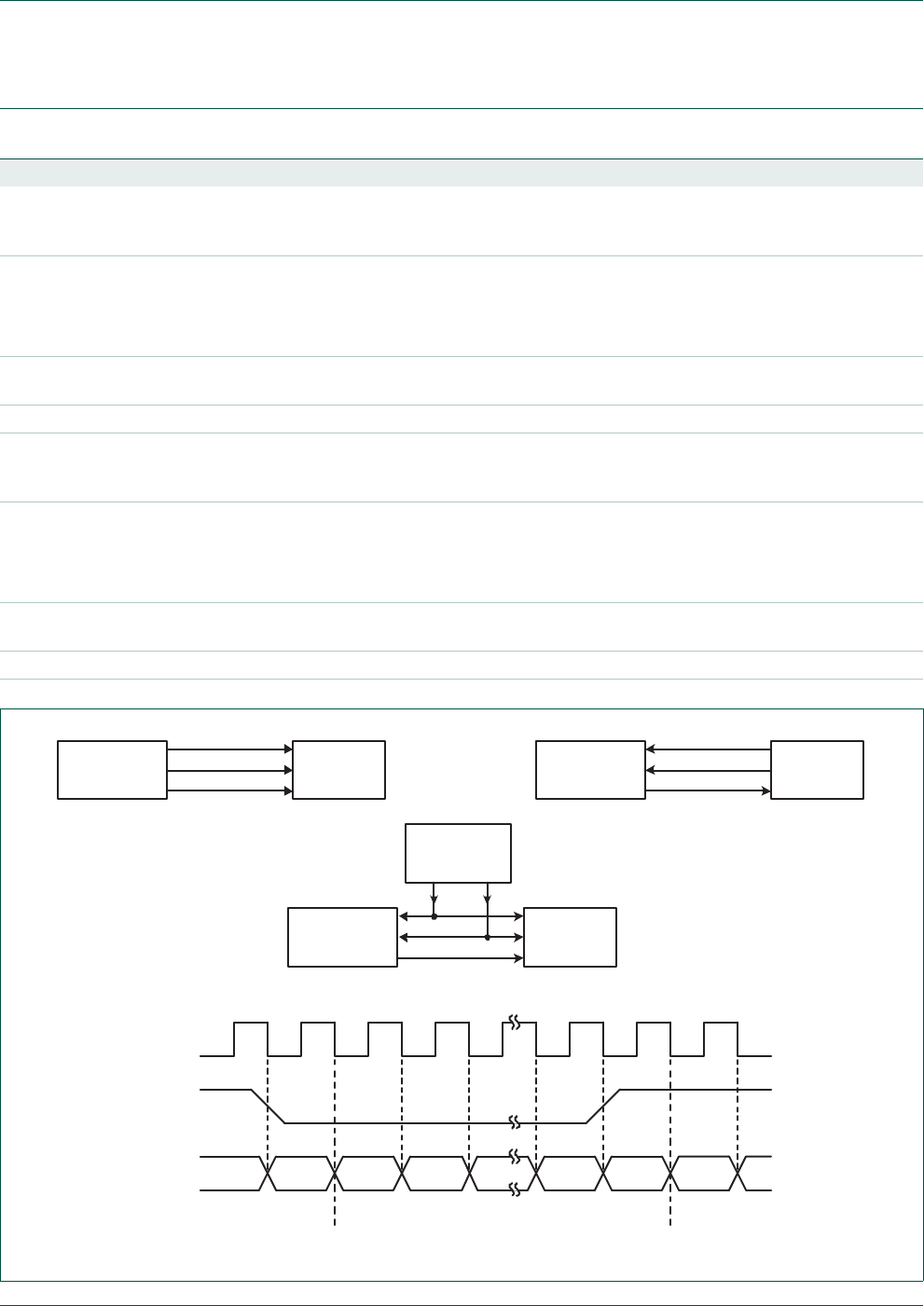
UM10360 All information provided in this document is subject to legal disclaimers. © NXP B.V. 2014. All rights reserved.
User manual Rev. 3.1 — 2 April 2014 484 of 849
NXP Semiconductors UM10360
Chapter 20: LPC176x/5x I2S
20.4 Pin descriptions
Table 404. Pin descriptions
Pin Name Type Description
I2SRX_CLK Input/
Output
Receive Clock. A clock signal used to synchronize the transfer of data on the receive channel. It is
driven by the master and received by the slave. Corresponds to the signal SCK in the I2S-bus
specification.
I2SRX_WS Input/
Output
Receive Word Select. Selects the channel from which data is to be received. It is driven by the
master and received by the slave. Corresponds to the signal WS in the I2S-bus specification.
WS = 0 indicates that data is being received by channel 1 (left channel).
WS = 1 indicates that data is being received by channel 2 (right channel).
I2SRX_SDA Input/
Output
Receive Data. Serial data, received MSB first. It is driven by the transmitter and read by the
receiver. Corresponds to the signal SD in the I2S-bus specification.
RX_MCLK Output Optional master clock output for the I2S receive function.
I2STX_CLK Input/
Output
Transmit Clock. A clock signal used to synchronize the transfer of data on the transmit channel. It
is driven by the master and received by the slave. Corresponds to the signal SCK in the I2S-bus
specification.
I2STX_WS Input/
Output
Transmit Word Select. Selects the channel to which data is being sent. It is driven by the master
and received by the slave. Corresponds to the signal WS in the I2S-bus specification.
WS = 0 indicates that data is being sent to channel 1 (left channel).
WS = 1 indicates that data is being sent to channel 2 (right channel).
I2STX_SDA Input/
Output
Transmit Data. Serial data, sent MSB first. It is driven by the transmitter and read by the receiver.
Corresponds to the signal SD in the I2S-bus specification.
TX_MCLK Output Optional master clock output for the I2S transmit function.
Fig 101. Simple I2S configurations and bus timing
TRANSMITTER
(MASTER)
CONTROLLER
(MASTER)
TRANSMITTER
(SLAVE)
RECEIVER
(MASTER)
SCK: serial clock
WS: word select
SD: serial data
TRANSMITTER
(SLAVE)
RECEIVER
(SLAVE)
SCK
WS
SD
SCK
WS
SD MSB LSB MSB
word n
left channel
word n+1
right channel
word n-1
right channel
RECEIVER
(SLAVE)
SCK: serial clock
WS: word select
SD: serial data

UM10360 All information provided in this document is subject to legal disclaimers. © NXP B.V. 2014. All rights reserved.
User manual Rev. 3.1 — 2 April 2014 485 of 849
NXP Semiconductors UM10360
Chapter 20: LPC176x/5x I2S
20.5 Register description
Tab l e 4 05 shows the registers associated with the I2S interface and a summary of their
functions. Following the table are details for each register.
[1] Reset Value reflects the data stored in used bits only. It does not include reserved bits content.
20.5.1 Digital Audio Output register (I2SDAO - 0x400A 8000)
The I2SDAO register controls the operation of the I2S transmit channel. The function of
bits in DAO are shown in Tab l e 4 06 .
Table 405. I2S register map
Name Description Access Reset
Value[1]
Address
I2SDAO Digital Audio Output Register. Contains control bits for the I2S transmit
channel.
R/W 0x87E1 0x400A 8000
I2SDAI Digital Audio Input Register. Contains control bits for the I2S receive
channel.
R/W 0x07E1 0x400A 8004
I2STXFIFO Transmit FIFO. Access register for the 8 32-bit transmitter FIFO. WO 0 0x400A 8008
I2SRXFIFO Receive FIFO. Access register for the 8 32-bit receiver FIFO. RO 0 0x400A 800C
I2SSTATE Status Feedback Register. Contains status information about the I2S
interface.
RO 0x7 0x400A 8010
I2SDMA1 DMA Configuration Register 1. Contains control information for DMA
request 1.
R/W 0 0x400A 8014
I2SDMA2 DMA Configuration Register 2. Contains control information for DMA
request 2.
R/W 0 0x400A 8018
I2SIRQ Interrupt Request Control Register. Contains bits that control how the
I2S interrupt request is generated.
R/W 0 0x400A 801C
I2STXRATE Transmit MCLK divider. This register determines the I2S TX MCLK rate
by specifying the value to divide PCLK by in order to produce MCLK.
R/W 0 0x400A 8020
I2SRXRATE Receive MCLK divider. This register determines the I2S RX MCLK rate
by specifying the value to divide PCLK by in order to produce MCLK.
R/W 0 0x400A 8024
I2STXBITRATE Transmit bit rate divider. This register determines the I2S transmit bit
rate by specifying the value to divide TX_MCLK by in order to produce
the transmit bit clock.
R/W 0 0x400A 8028
I2SRXBITRATE Receive bit rate divider. This register determines the I2S receive bit rate
by specifying the value to divide RX_MCLK by in order to produce the
receive bit clock.
R/W 0 0x400A 802C
I2STXMODE Transmit mode control. R/W 0 0x400A 8030
I2SRXMODE Receive mode control. R/W 0 0x400A 8034
Table 406: Digital Audio Output register (I2SDAO - address 0x400A 8000) bit description
Bit Symbol Value Description Reset
Value
1:0 wordwidth Selects the number of bytes in data as follows: 01
00 8-bit data
01 16-bit data
10 Reserved, do not use this setting
11 32-bit data

UM10360 All information provided in this document is subject to legal disclaimers. © NXP B.V. 2014. All rights reserved.
User manual Rev. 3.1 — 2 April 2014 486 of 849
NXP Semiconductors UM10360
Chapter 20: LPC176x/5x I2S
20.5.2 Digital Audio Input register (I2SDAI - 0x400A 8004)
The I2SDAI register controls the operation of the I2S receive channel. The function of bits
in DAI are shown in Table 407.
20.5.3 Transmit FIFO register (I2STXFIFO - 0x400A 8008)
The I2STXFIFO register provides access to the transmit FIFO. The function of bits in
I2STXFIFO are shown in Table 40 8 .
20.5.4 Receive FIFO register (I2SRXFIFO - 0x400A 800C)
The I2SRXFIFO register provides access to the receive FIFO. The function of bits in
I2SRXFIFO are shown in Tab l e 4 09 .
2mono When 1, data is of monaural format. When 0, the data is in stereo format. 0
3stop When 1, disables accesses on FIFOs, places the transmit channel in mute mode. 0
4reset When 1, asynchronously resets the transmit channel and FIFO. 0
5ws_sel When 0, the interface is in master mode. When 1, the interface is in slave mode. See
Section 20.7 for a summary of useful combinations for this bit with I2STXMODE.
1
14:6 ws_halfperiod Word select half period minus 1, i.e. WS 64clk period -> ws_halfperiod = 31. 0x1F
15 mute When 1, the transmit channel sends only zeroes. 1
31:16 - Reserved, user software should not write ones to reserved bits. The value read from
a reserved bit is not defined.
NA
Table 406: Digital Audio Output register (I2SDAO - address 0x400A 8000) bit description …continued
Bit Symbol Value Description Reset
Value
Table 407: Digital Audio Input register (I2SDAI - address 0x400A 8004) bit description
Bit Symbol Value Description Reset
Value
1:0 wordwidth Selects the number of bytes in data as follows: 01
00 8-bit data
01 16-bit data
10 Reserved, do not use this setting
11 32-bit data
2mono When 1, data is of monaural format. When 0, the data is in stereo format. 0
3stop When 1, disables accesses on FIFOs, places the transmit channel in mute mode. 0
4reset When 1, asynchronously reset the transmit channel and FIFO. 0
5ws_sel When 0, the interface is in master mode. When 1, the interface is in slave mode. See
Section 20.7 for a summary of useful combinations for this bit with I2SRXMODE.
1
14:6 ws_halfperiod Word select half period minus 1, i.e. WS 64clk period -> ws_halfperiod = 31. 0x1F
31:15 - Reserved, user software should not write ones to reserved bits. The value read from
a reserved bit is not defined.
NA
Table 408: Transmit FIFO register (I2STXFIFO - address 0x400A 8008) bit description
Bit Symbol Description Reset Value
31:0 I2STXFIFO 8 32-bit transmit FIFO. Level = 0
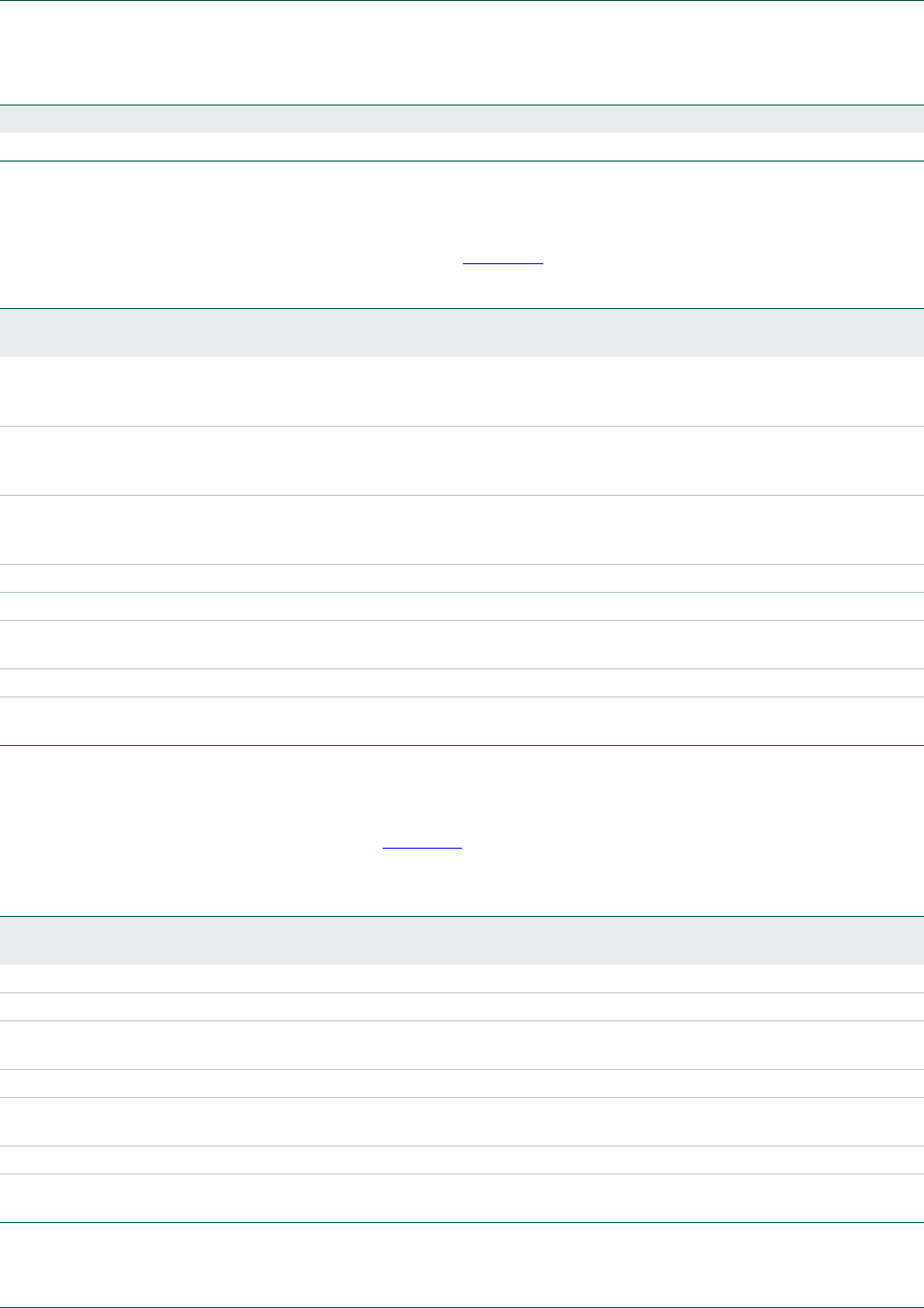
UM10360 All information provided in this document is subject to legal disclaimers. © NXP B.V. 2014. All rights reserved.
User manual Rev. 3.1 — 2 April 2014 487 of 849
NXP Semiconductors UM10360
Chapter 20: LPC176x/5x I2S
20.5.5 Status Feedback register (I2SSTATE - 0x400A 8010)
The I2SSTATE register provides status information about the I2S interface. The meaning
of bits in I2SSTATE are shown in Ta b l e 41 0 .
20.5.6 DMA Configuration Register 1 (I2SDMA1 - 0x400A 8014)
The I2SDMA1 register controls the operation of DMA request 1. The function of bits in
I2SDMA1 are shown in Tab l e 411 . Refer to the General Purpose DMA Controller chapter
for details of DMA operation.
Table 409: Receive FIFO register (I2RXFIFO - address 0x400A 800C) bit description
Bit Symbol Description Reset Value
31:0 I2SRXFIFO 8 32-bit transmit FIFO. level = 0
Table 410: Status Feedback register (I2SSTATE - address 0x400A 8010) bit description
Bit Symbol Description Reset
Value
0irq This bit reflects the presence of Receive Interrupt or Transmit Interrupt. This is determined by
comparing the current FIFO levels to the rx_depth_irq and tx_depth_irq fields in the I2SIRQ
register.
1
1dmareq1This bit reflects the presence of Receive or Transmit DMA Request 1. This is determined by
comparing the current FIFO levels to the rx_depth_dma1 and tx_depth_dma1 fields in the
I2SDMA1 register.
1
2dmareq2This bit reflects the presence of Receive or Transmit DMA Request 2. This is determined by
comparing the current FIFO levels to the rx_depth_dma2 and tx_depth_dma2 fields in the
I2SDMA2 register.
1
7:3 Unused Unused. 0
11:8 rx_level Reflects the current level of the Receive FIFO. 0
15:12 - Reserved, user software should not write ones to reserved bits. The value read from a reserved
bit is not defined.
NA
19:16 tx_level Reflects the current level of the Transmit FIFO. 0
31:20 - Reserved, user software should not write ones to reserved bits. The value read from a reserved
bit is not defined.
NA
Table 411: DMA Configuration register 1 (I2SDMA1 - address 0x400A 8014) bit description
Bit Symbol Description Reset
Value
0rx_dma1_enableWhen 1, enables DMA1 for I
2S receive. 0
1tx_dma1_enableWhen 1, enables DMA1 for I
2S transmit. 0
7:2 - Reserved, user software should not write ones to reserved bits. The value read from a
reserved bit is not defined.
0
11:8 rx_depth_dma1 Set the FIFO level that triggers a receive DMA request on DMA1. 0
15:12 - Reserved, user software should not write ones to reserved bits. The value read from a
reserved bit is not defined.
NA
19:16 tx_depth_dma1 Set the FIFO level that triggers a transmit DMA request on DMA1. 0
31:20 - Reserved, user software should not write ones to reserved bits. The value read from a
reserved bit is not defined.
NA

UM10360 All information provided in this document is subject to legal disclaimers. © NXP B.V. 2014. All rights reserved.
User manual Rev. 3.1 — 2 April 2014 488 of 849
NXP Semiconductors UM10360
Chapter 20: LPC176x/5x I2S
20.5.7 DMA Configuration Register 2 (I2SDMA2 - 0x400A 8018)
The I2SDMA2 register controls the operation of DMA request 2. The function of bits in
I2SDMA2 are shown in Tab l e 4 06 .
20.5.8 Interrupt Request Control register (I2SIRQ - 0x400A 801C)
The I2SIRQ register controls the operation of the I2S interrupt request. The function of bits
in I2SIRQ are shown in Tabl e 4 06 .
20.5.9 Transmit Clock Rate register (I2STXRATE - 0x400A 8020)
The MCLK rate for the I2S transmitter is determined by the values in the I2STXRATE
register. The required I2STXRATE setting depends on the desired audio sample rate
desired, the format (stereo/mono) used, and the data size.
The transmitter MCLK rate is generated using a fractional rate generator, dividing down
the frequency of PCLK_I2S. Values of the numerator (X) and the denominator (Y) must be
chosen to produce a frequency twice that desired for the transmitter MCLK, which must be
an integer multiple of the transmitter bit clock rate. Fractional rate generators have some
aspects that the user should be aware of when choosing settings. These are discussed in
Section 20.5.9.1. The equation for the fractional rate generator is:
I2STXMCLK = PCLK_I2S * (X/Y) /2
Table 412: DMA Configuration register 2 (I2SDMA2 - address 0x400A 8018) bit description
Bit Symbol Description Reset
Value
0rx_dma2_enableWhen 1, enables DMA1 for I
2S receive. 0
1tx_dma2_enableWhen 1, enables DMA1 for I
2S transmit. 0
7:2 Unused Unused. 0
11:8 rx_depth_dma2 Set the FIFO level that triggers a receive DMA request on DMA2. 0
15:12 - Reserved, user software should not write ones to reserved bits. The value read from a
reserved bit is not defined.
NA
19:16 tx_depth_dma2 Set the FIFO level that triggers a transmit DMA request on DMA2. 0
31:20 - Reserved, user software should not write ones to reserved bits. The value read from a
reserved bit is not defined.
NA
Table 413: Interrupt Request Control register (I2SIRQ - address 0x400A 801C) bit description
Bit Symbol Description Reset
Value
0rx_Irq_enableWhen 1, enables I2S receive interrupt. 0
1 tx_Irq_enable When 1, enables I2S transmit interrupt. 0
7:2 Unused Unused. 0
11:8 rx_depth_irq Set the FIFO level on which to create an irq request. 0
15:12 - Reserved, user software should not write ones to reserved bits. The value read from a
reserved bit is not defined.
NA
19:16 tx_depth_irq Set the FIFO level on which to create an irq request. 0
31:20 - Reserved, user software should not write ones to reserved bits. The value read from a
reserved bit is not defined.
NA

UM10360 All information provided in this document is subject to legal disclaimers. © NXP B.V. 2014. All rights reserved.
User manual Rev. 3.1 — 2 April 2014 489 of 849
NXP Semiconductors UM10360
Chapter 20: LPC176x/5x I2S
Note: If the value of X or Y is 0, then no clock is generated. Also, the value of Y must be
greater than or equal to X.
20.5.9.1 Notes on fractional rate generators
The nature of a fractional rate generator is that there will be some output jitter with some
divide settings. This is because the fractional rate generator is a fully digital function, so
output clock transitions are synchronous with the source clock, whereas a theoretical
perfect fractional rate may have edges that are not related to the source clock. So, output
jitter will not be greater than plus or minus one source clock between consecutive clock
edges.
For example, if X = 0x07 and Y = 0x11, the fractional rate generator will output 7 clocks for
every 17 (11 hex) input clocks, distributed as evenly as it can. In this example, there is no
way to distribute the output clocks in a perfectly even fashion, so some clocks will be
longer than others. The output is divided by 2 in order to square it up, which also helps
with the jitter. The frequency averages out to exactly (7/17) / 2, but some clocks will be a
slightly different length than their neighbors. It is possible to avoid jitter entirely by
choosing fractions such that X divides evenly into Y, such as 2/4, 2/6, 3/9, 1/N, etc.
20.5.10 Receive Clock Rate register (I2SRXRATE - 0x400A 8024)
The MCLK rate for the I2S receiver is determined by the values in the I2SRXRATE
register. The required I2SRXRATE setting depends on the peripheral clock rate
(PCLK_I2S) and the desired MCLK rate (such as 256 fs).
The receiver MCLK rate is generated using a fractional rate generator, dividing down the
frequency of PCLK_I2S. Values of the numerator (X) and the denominator (Y) must be
chosen to produce a frequency twice that desired for the receiver MCLK, which must be
an integer multiple of the receiver bit clock rate. Fractional rate generators have some
aspects that the user should be aware of when choosing settings. These are discussed in
Section 20.5.9.1. The equation for the fractional rate generator is:
I2SRXMCLK = PCLK_I2S * (X/Y) /2
Note: If the value of X or Y is 0, then no clock is generated. Also, the value of Y must be
greater than or equal to X.
Table 414: Transmit Clock Rate register (I2TXRATE - address 0x400A 8020) bit description
Bit Symbol Description Reset
Value
7:0 Y_divider I2S transmit MCLK rate denominator. This value is used to divide PCLK to produce the
transmit MCLK. Eight bits of fractional divide supports a wide range of possibilities. A value of
0 stops the clock.
0
15:8 X_divider I2S transmit MCLK rate numerator. This value is used to multiply PCLK by to produce the
transmit MCLK. A value of 0 stops the clock. Eight bits of fractional divide supports a wide
range of possibilities. Note: the resulting ratio X/Y is divided by 2.
0
31:16 - Reserved, user software should not write ones to reserved bits. The value read from a
reserved bit is not defined.
NA
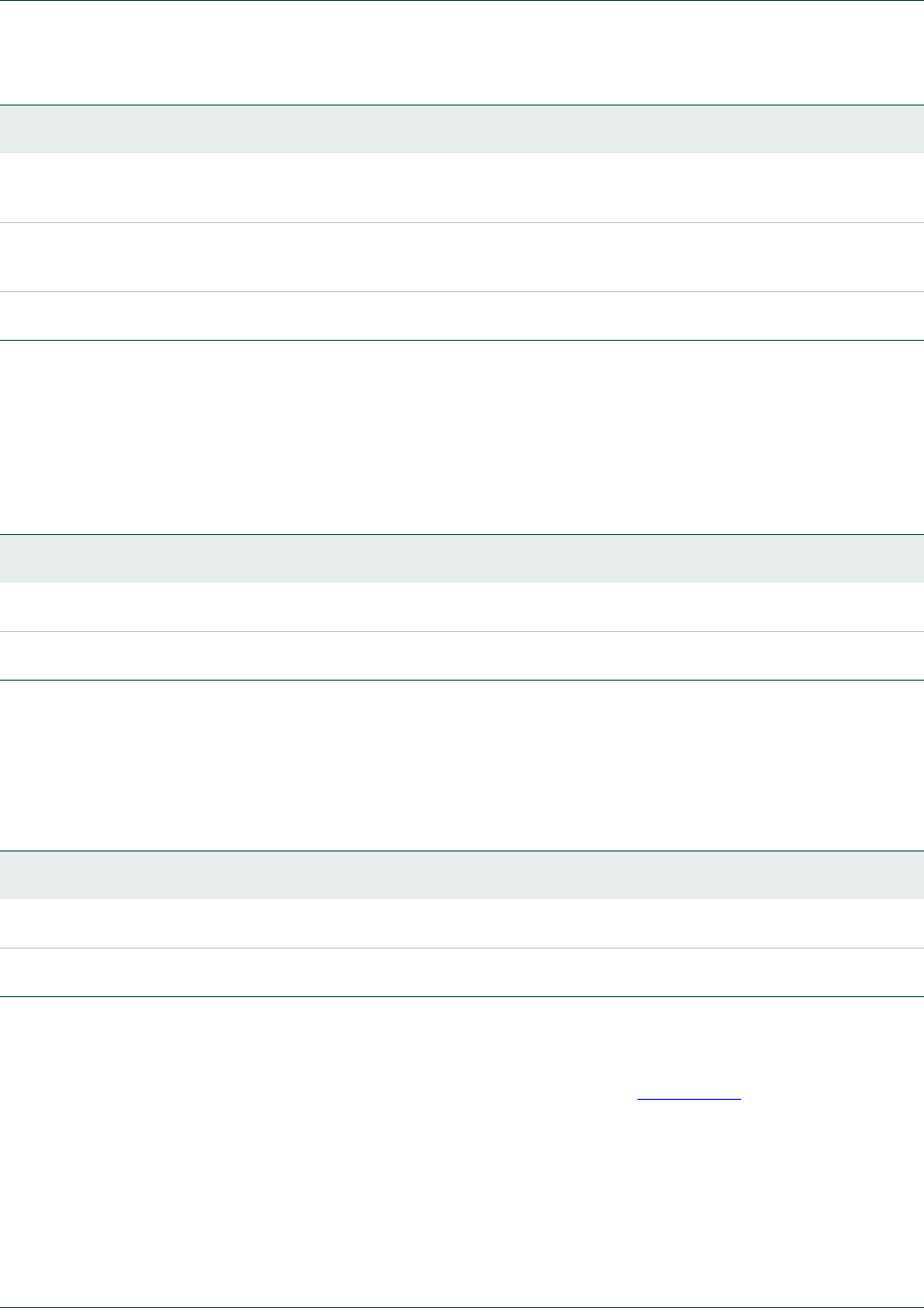
UM10360 All information provided in this document is subject to legal disclaimers. © NXP B.V. 2014. All rights reserved.
User manual Rev. 3.1 — 2 April 2014 490 of 849
NXP Semiconductors UM10360
Chapter 20: LPC176x/5x I2S
20.5.11 Transmit Clock Bit Rate register (I2STXBITRATE - 0x400A 8028)
The bit rate for the I2S transmitter is determined by the value of the I2STXBITRATE
register. The value depends on the audio sample rate desired, and the data size and
format (stereo/mono) used. For example, a 48 kHz sample rate for 16-bit stereo data
requires a bit rate of 48,000162=1.536MHz.
20.5.12 Receive Clock Bit Rate register (I2SRXBITRATE - 0x400A 802C)
The bit rate for the I2S receiver is determined by the value of the I2SRXBITRATE register.
The value depends on the audio sample rate, as well as the data size and format used.
The calculation is the same as for I2SRXBITRATE.
20.5.13 Transmit Mode Control register (I2STXMODE - 0x400A 8030)
The Transmit Mode Control register contains additional controls for transmit clock source,
enabling the 4-pin mode, and how MCLK is used. See Section 20.7 for a summary of
useful mode combinations.
Table 415: Receive Clock Rate register (I2SRXRATE - address 0x400A 8024) bit description
Bit Symbol Description Reset
Value
7:0 Y_divider I2S receive MCLK rate denominator. This value is used to divide PCLK to produce the
receive MCLK. Eight bits of fractional divide supports a wide range of possibilities. A value of
0 stops the clock.
0
15:8 X_divider I2S receive MCLK rate numerator. This value is used to multiply PCLK by to produce the
receive MCLK. A value of 0 stops the clock. Eight bits of fractional divide supports a wide
range of possibilities. Note: the resulting ratio X/Y is divided by 2.
0
31:16 - Reserved, user software should not write ones to reserved bits. The value read from a
reserved bit is not defined.
NA
Table 416: Transmit Clock Rate register (I2TXBITRATE - address 0x400A 8028) bit description
Bit Symbol Description Reset
Value
5:0 tx_bitrate I2S transmit bit rate. This value plus one is used to divide TX_MCLK to produce the transmit bit
clock.
0
31:6 - Reserved, user software should not write ones to reserved bits. The value read from a
reserved bit is not defined.
NA
Table 417: Receive Clock Rate register (I2SRXBITRATE - address 0x400A 802C) bit description
Bit Symbol Description Reset
Value
5:0 rx_bitrate I2S receive bit rate. This value plus one is used to divide RX_MCLK to produce the receive bit
clock.
0
31:6 - Reserved, user software should not write ones to reserved bits. The value read from a
reserved bit is not defined.
NA

UM10360 All information provided in this document is subject to legal disclaimers. © NXP B.V. 2014. All rights reserved.
User manual Rev. 3.1 — 2 April 2014 491 of 849
NXP Semiconductors UM10360
Chapter 20: LPC176x/5x I2S
20.5.14 Receive Mode Control register (I2SRXMODE - 0x400A 8034)
The Receive Mode Control register contains additional controls for receive clock source,
enabling the 4-pin mode, and how MCLK is used. See Section 20.7 for a summary of
useful mode combinations.
Table 418: Transmit Mode Control register (I2STXMODE - 0x400A 8030) bit description
Bit Symbol Value Description Reset
Value
1:0 TXCLKSEL Clock source selection for the transmit bit clock divider. 0
00 Select the TX fractional rate divider clock output as the source
01 Reserved
10 Select the RX_MCLK signal as the TX_MCLK clock source
11 Reserved
2TX4PIN Transmit 4-pin mode selection. When 1, enables 4-pin mode. 0
3TXMCENA Enable for the TX_MCLK output. When 0, output of TX_MCLK is not enabled. When 1,
output of TX_MCLK is enabled.
0
31:4 - Reserved, user software should not write ones to reserved bits. The value read from a
reserved bit is not defined.
NA
Table 419: Receive Mode Control register (I2SRXMODE - 0x400A 8034) bit description
Bit Symbol Value Description Reset
Value
1:0 RXCLKSEL Clock source selection for the receive bit clock divider. 0
00 Select the RX fractional rate divider clock output as the source
01 Reserved
10 Select the TX_MCLK signal as the RX_MCLK clock source
11 Reserved
2RX4PIN Receive 4-pin mode selection. When 1, enables 4-pin mode. 0
3RXMCENA Enable for the RX_MCLK output. When 0, output of RX_MCLK is not enabled. When 1,
output of RX_MCLK is enabled.
0
31:4 - Reserved, user software should not write ones to reserved bits. The value read from a
reserved bit is not defined.
NA

UM10360 All information provided in this document is subject to legal disclaimers. © NXP B.V. 2014. All rights reserved.
User manual Rev. 3.1 — 2 April 2014 492 of 849
NXP Semiconductors UM10360
Chapter 20: LPC176x/5x I2S
20.6 I2S transmit and receive interfaces
The I2S interface can transmit and receive 8-bit, 16-bit or 32-bit stereo or mono audio
information. Some details of I2S implementation are:
•When the FIFO is empty, the transmit channel will repeat transmitting the same data
until new data is written to the FIFO.
•When mute is true, the data value 0 is transmitted.
•When mono is false, two successive data words are respectively left and right data.
•Data word length is determined by the wordwidth value in the configuration register.
There is a separate wordwidth value for the receive channel and the transmit channel.
–0: word is considered to contain four 8-bit data words.
–1: word is considered to contain two 16-bit data words.
–3: word is considered to contain one 32-bit data word.
•When the transmit FIFO contains insufficient data the transmit channel will repeat
transmitting the last data until new data is available. This can occur when the
microprocessor or the DMA at some time is unable to provide new data fast enough.
Because of this delay in new data there is a need to fill the gap, which is
accomplished by continuing to transmit the last sample. The data is not muted as this
would produce an noticeable and undesirable effect in the sound.
•The transmit channel and the receive channel only handle 32-bit aligned words, data
chunks must be clipped or extended to a multiple of 32 bits.
When switching between data width or modes the I2S must be reset via the reset bit in the
control register in order to ensure correct synchronization. It is advisable to set the stop bit
also until sufficient data has been written in the transmit FIFO. Note that when stopped
data output is muted.
All data accesses to FIFOs are 32 bits. Figure 114 shows the possible data sequences.
A data sample in the FIFO consists of:
•132 bits in 8-bit or 16-bit stereo modes.
•132 bits in mono modes.
•232 bits, first left data, second right data, in 32-bit stereo modes.
Data is read from the transmit FIFO after the falling edge of WS, it will be transferred to
the transmit clock domain after the rising edge of WS. On the next falling edge of WS the
left data will be loaded in the shift register and transmitted and on the following rising edge
of WS the right data is loaded and transmitted.
The receive channel will start receiving data after a change of WS. When word select
becomes low it expects this data to be left data, when WS is high received data is
expected to be right data. Reception will stop when the bit counter has reached the limit
set by wordwidth. On the next change of WS the received data will be stored in the
appropriate hold register. When complete data is available it will be written into the receive
FIFO.

UM10360 All information provided in this document is subject to legal disclaimers. © NXP B.V. 2014. All rights reserved.
User manual Rev. 3.1 — 2 April 2014 493 of 849
NXP Semiconductors UM10360
Chapter 20: LPC176x/5x I2S
20.7 I2S operating modes
The clocking and WS usage of the I2S interface is configurable. In addition to master and
slave modes, which are independently configurable for the transmitter and the receiver,
several different clock sources are possible, including variations that share the clock
and/or WS between the transmitter and receiver. This last option allows using I2S with
fewer pins, typically four.
Many configurations are possible that are not considered useful, the following tables and
figures give details of the configurations that are most likely to be useful.
Table 420: I2S transmit modes
I2SDAO
[5]
I2STXMODE
[3:0]
Description
00 0 0 0Typical transmitter master mode. See Figure 102.
The I2S transmit function operates as a master.
The transmit clock source is the fractional rate divider.
The WS used is the internally generated TX_WS.
The TX_MCLK pin is not enabled for output.
00 0 1 0Transmitter master mode sharing the receiver reference clock. See Figure 103.
The I2S transmit function operates as a master.
The transmit clock source is RX_REF.
The WS used is the internally generated TX_WS.
The TX_MCLK pin is not enabled for output.
00 1 0 04-wire transmitter master mode sharing the receiver bit clock and WS. See Figure 104.
The I2S transmit function operates as a master.
The transmit clock source is the RX bit clock.
The WS used is the internally generated RX_WS.
The TX_MCLK pin is not enabled for output.
01 0 0 0Transmitter master mode with TX_MCLK output. See Figure 102.
The I2S transmit function operates as a master.
The transmit clock source is the fractional rate divider.
The WS used is the internally generated TX_WS.
The TX_MCLK pin is enabled for output.
10 0 0 0Typical transmitter slave mode. See Figure 105.
The I2S transmit function operates as a slave.
The transmit clock source is the TX_CLK pin.
The WS used is the TX_WS pin.
10 0 1 0Transmitter slave mode sharing the receiver reference clock. See Figure 106.
The I2S transmit function operates as a slave.
The transmit clock source is RX_REF.
The WS used is the TX_WS pin.
10 1 0 04-wire transmitter slave mode sharing the receiver bit clock and WS. See Figure 107.
The I2S transmit function operates as a slave.
The transmit clock source is the RX bit clock.
The WS used is RX_WS ref.
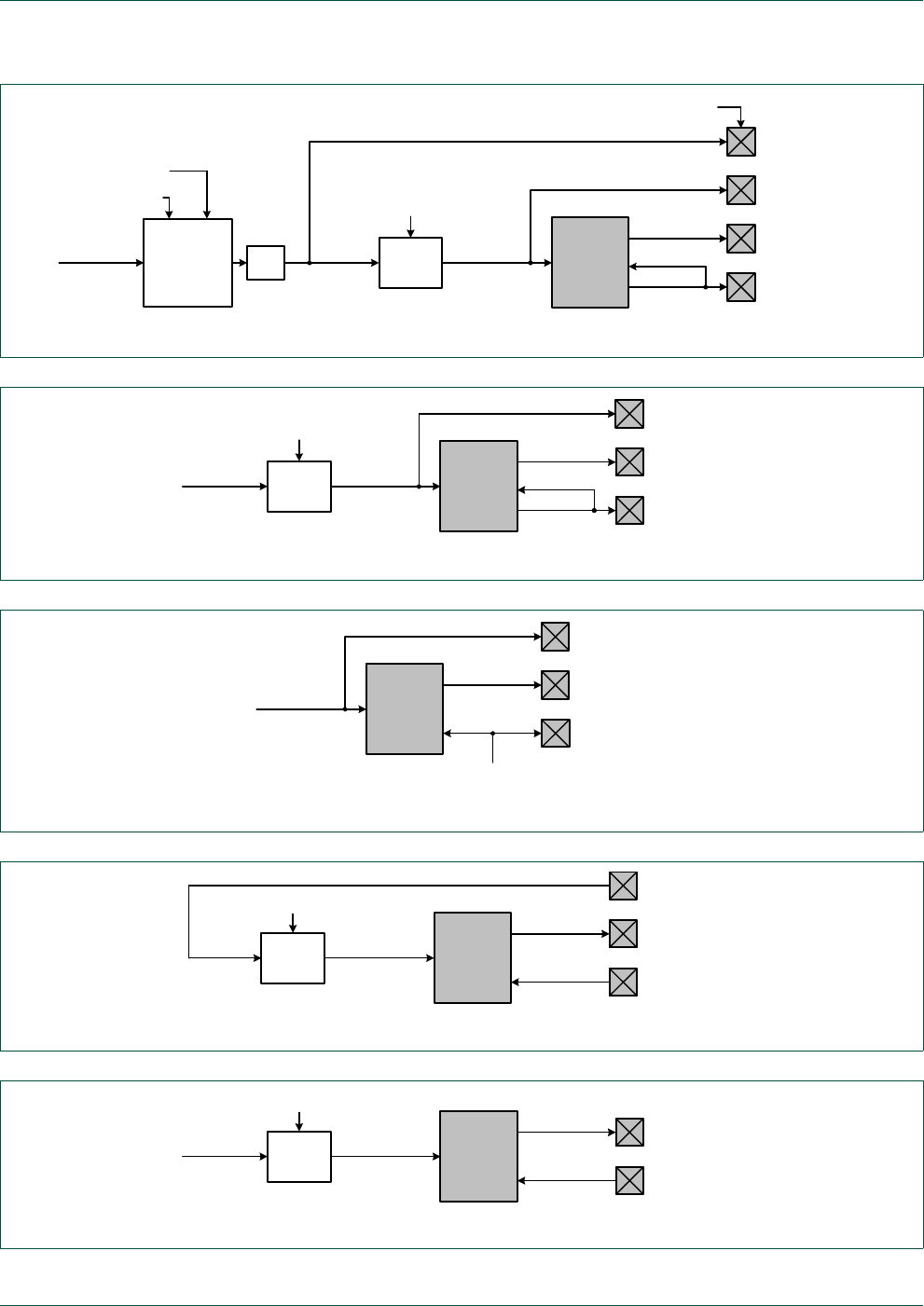
UM10360 All information provided in this document is subject to legal disclaimers. © NXP B.V. 2014. All rights reserved.
User manual Rev. 3.1 — 2 April 2014 494 of 849
NXP Semiconductors UM10360
Chapter 20: LPC176x/5x I2S
Fig 102. Typical transmitter master mode, with or without MCLK output
I2STXMODE[3]
I2S_PCLK ÷N
(1 to 64)
8-bit
Fractional
Rate Divider
÷2
XY
I2STX_MCLK
I2S
peripheral
block
(transmit)
I2STXBITRATE[5:0]
I2STX_WS
I2STX_SDA
I2STX_CLK
TX_REF TX bit clock
I2STX_RATE[7:0]
I2STX_RATE[15:8]
(Pin OE)
TX_WS ref
Fig 103. Transmitter master mode sharing the receiver reference clock
÷N
(1 to 64)
I2STXBITRATE[5:0]
I2STX_WS
I2STX_SDA
I2STX_CLK
RX_REF TX bit clock
TX_WS ref
I2S
peripheral
block
(transmit)
Fig 104. 4-wire transmitter master mode sharing the receiver bit clock and WS
I2STX_WS
I2STX_SDA
I2STX_CLK
RX bit clock
RX_WS ref
I2S
peripheral
block
(transmit)
Fig 105. Typical transmitter slave mode
÷N
(1 to 64)
I2S
peripheral
block
(transmit)
I2STXBITRATE[5:0]
I2STX_WS
I2STX_SDA
I2STX_CLK
TX_REF TX bit clock
Fig 106. Transmitter slave mode sharing the receiver reference clock
÷N
(1 to 64)
I2S
peripheral
block
(transmit)
I2STXBITRATE[5:0]
I2STX_WS
I2STX_SDA
RX_REF TX bit clock
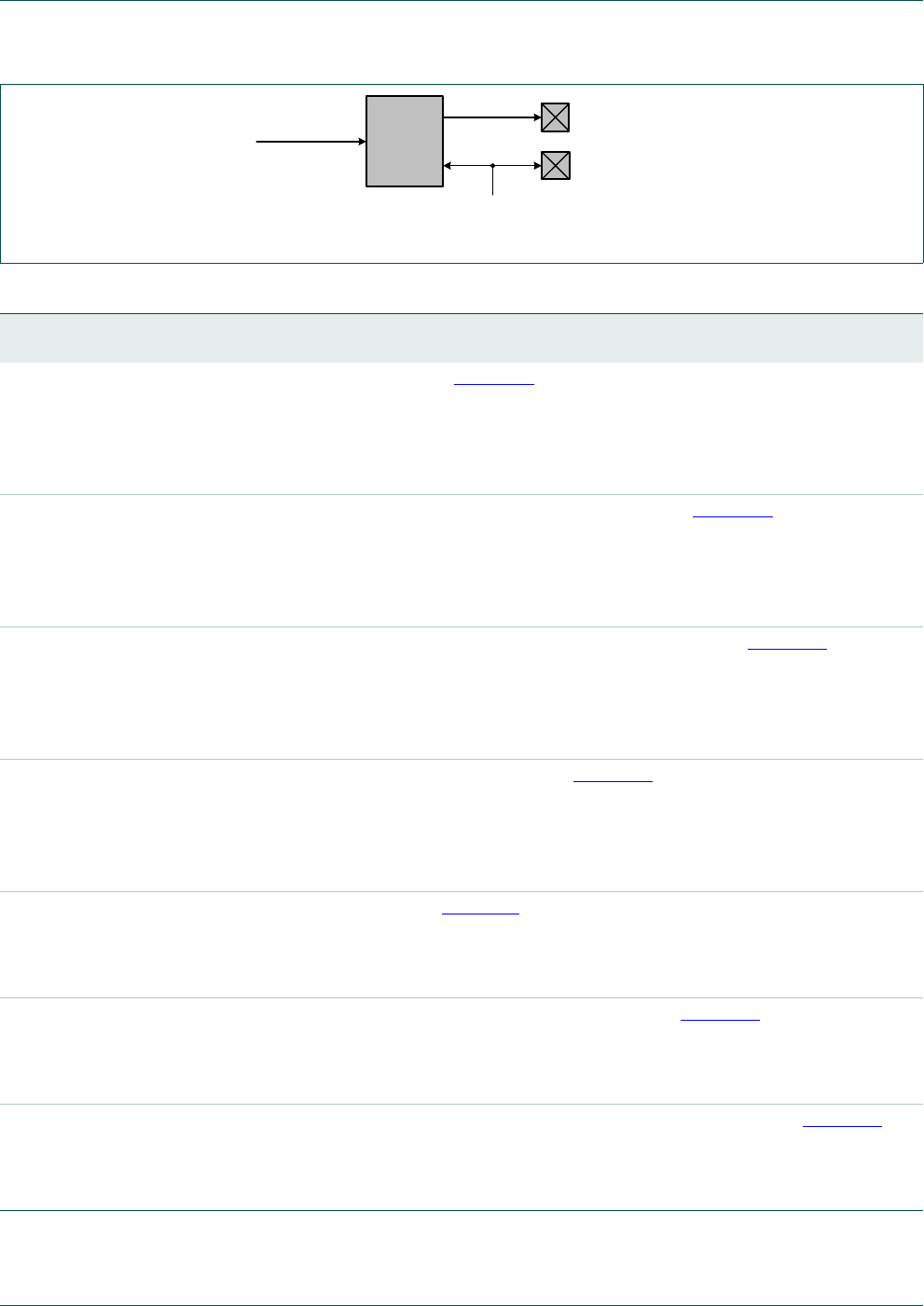
UM10360 All information provided in this document is subject to legal disclaimers. © NXP B.V. 2014. All rights reserved.
User manual Rev. 3.1 — 2 April 2014 495 of 849
NXP Semiconductors UM10360
Chapter 20: LPC176x/5x I2S
Fig 107. 4-wire transmitter slave mode sharing the receiver bit clock and WS
I2STX_WS
I2STX_SDA
RX bit clock
RX_WS ref
I2S
peripheral
block
(transmit)
Table 421: I2S receive modes
I2SDAI
[5]
I2SRXMODE
[3:0]
Description
00 0 0 0Typical receiver master mode. See Figure 108.
The I2S receive function operates as a master.
The receive clock source is the fractional rate divider.
The WS used is the internally generated RX_WS.
The RX_MCLK pin is not enabled for output.
00 0 1 0Receiver master mode sharing the transmitter reference clock. See Figure 109.
The I2S receive function operates as a master.
The receive clock source is TX_REF.
The WS used is the internally generated RX_WS.
The RX_MCLK pin is not enabled for output.
00 1 0 04-wire receiver master mode sharing the transmitter bit clock and WS. See Figure 110.
The I2S receive function operates as a master.
The receive clock source is the TX bit clock.
The WS used is the internally generated TX_WS.
The RX_MCLK pin is not enabled for output.
01 0 0 0Receiver master mode with RX_MCLK output. See Figure 108.
The I2S receive function operates as a master.
The receive clock source is the fractional rate divider.
The WS used is the internally generated RX_WS.
The RX_MCLK pin is enabled for output.
10 0 0 0Typical receiver slave mode. See Figure 111.
The I2S receive function operates as a slave.
The receive clock source is the RX_CLK pin.
The WS used is the RX_WS pin.
10 0 1 0Receiver slave mode sharing the transmitter reference clock. See Figure 112.
The I2S receive function operates as a slave.
The receive clock source is TX_REF.
The WS used is the RX_WS pin.
10 1 0 0This is a 4-wire receiver slave mode sharing the transmitter bit clock and WS. See Figure 113.
The I2S receive function operates as a slave.
The receive clock source is the TX bit clock.
The WS used is TX_WS ref.
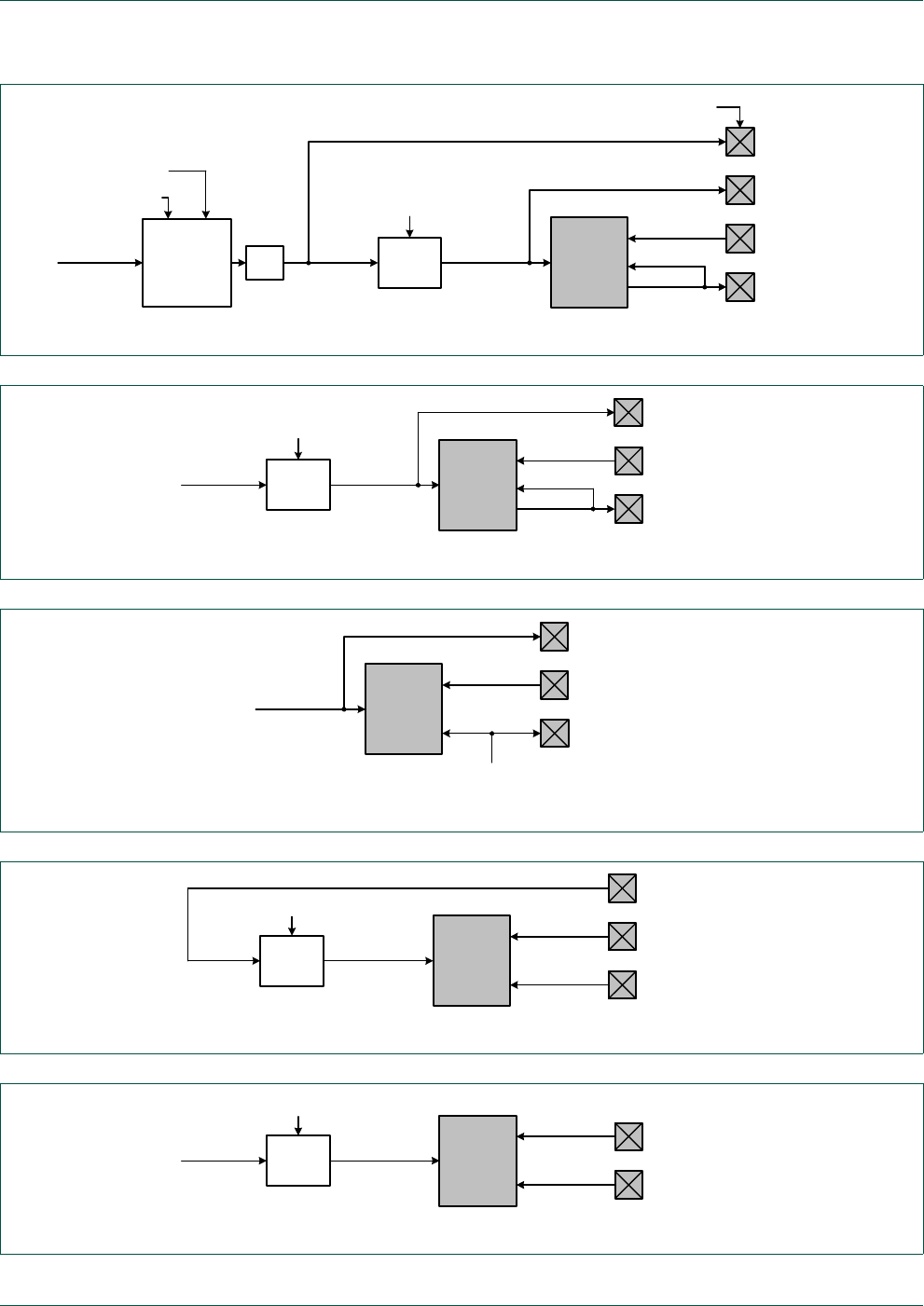
UM10360 All information provided in this document is subject to legal disclaimers. © NXP B.V. 2014. All rights reserved.
User manual Rev. 3.1 — 2 April 2014 496 of 849
NXP Semiconductors UM10360
Chapter 20: LPC176x/5x I2S
Fig 108. Typical receiver master mode, with or without MCLK output
I2SRXMODE[3]
I2S_PCLK ÷N
(1 to 64)
8-bit
Fractional
Rate Divider
÷2
XY
I2SRX_MCLK
I2S
peripheral
block
(receive)
I2SRXBITRATE[5:0]
I2SRX_WS
I2SRX_SDA
I2SRX_CLK
RX_REF RX bit clock
I2SRX_RATE[7:0]
I2SRX_RATE[15:8]
(Pin OE)
RX_WS ref
Fig 109. Receiver master mode sharing the transmitter reference clock
÷N
(1 to 64)
I2SRXBITRATE[5:0]
I2SRX_WS
I2SRX_SDA
I2SRX_CLK
TX_REF RX bit clock
RX_WS ref
I2S
peripheral
block
(receive)
Fig 110. 4-wire receiver master mode sharing the transmitter bit clock and WS
I2SRX_WS
I2SRX_SDA
I2SRX_CLK
TX bit clock
TX_WS ref
I2S
peripheral
block
(receive)
Fig 111. Typical receiver slave mode
÷N
(1 to 64)
I2S
peripheral
block
(receive)
I2SRXBITRATE[5:0]
I2SRX_WS
I2SRX_SDA
I2SRX_CLK
RX_REF RX bit clock
Fig 112. Receiver slave mode sharing the transmitter reference clock
÷N
(1 to 64)
I2S
peripheral
block
(receive)
I2SRXBITRATE[5:0]
I2SRX_WS
I2SRX_SDA
TX_REF RX bit clock
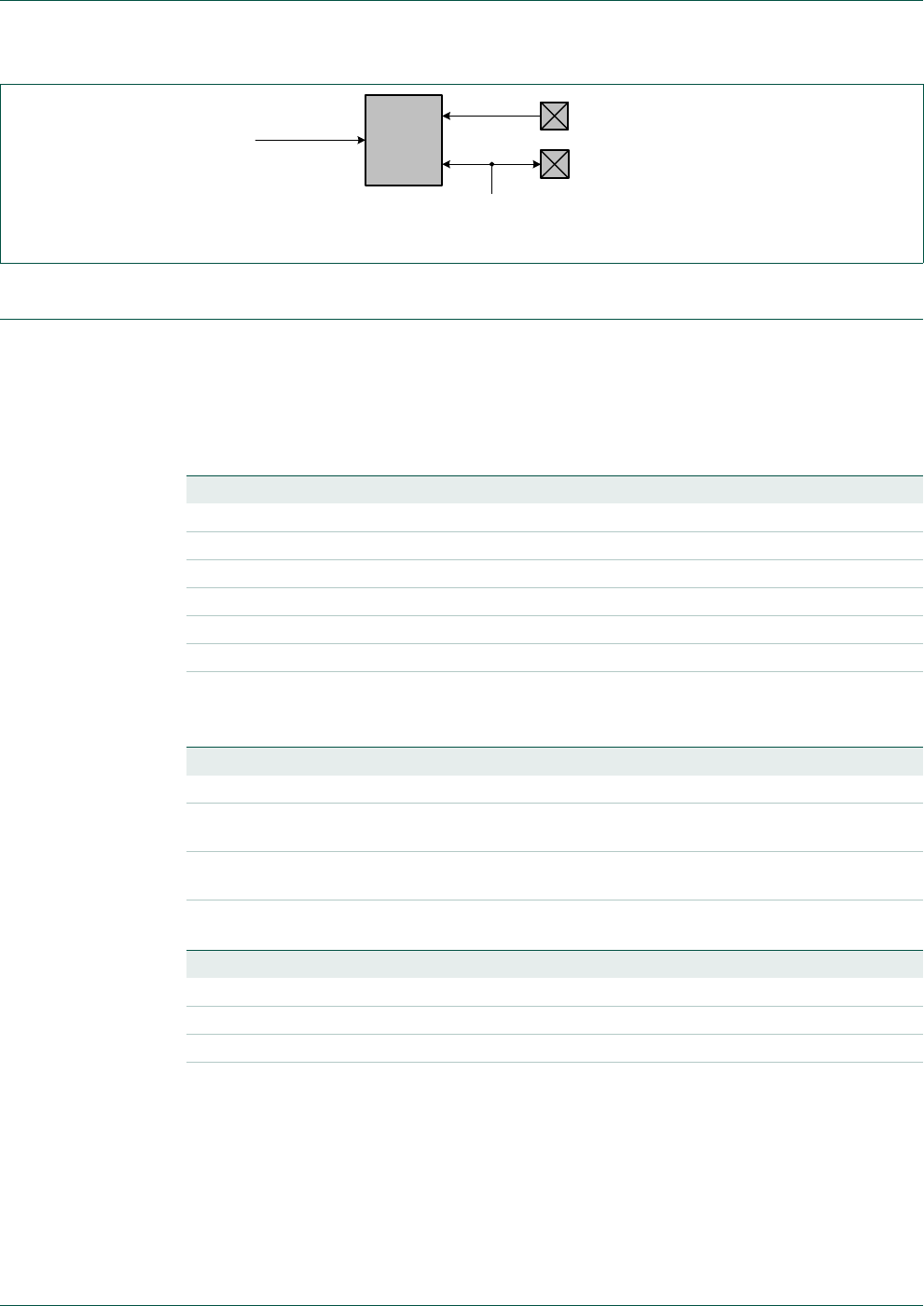
UM10360 All information provided in this document is subject to legal disclaimers. © NXP B.V. 2014. All rights reserved.
User manual Rev. 3.1 — 2 April 2014 497 of 849
NXP Semiconductors UM10360
Chapter 20: LPC176x/5x I2S
20.8 FIFO controller
Handling of data for transmission and reception is performed via the FIFO controller which
can generate two DMA requests and an interrupt request. The controller consists of a set
of comparators which compare FIFO levels with depth settings contained in registers. The
current status of the level comparators can be seen in the APB status register.
System signaling occurs when a level detection is true and enabled.
Fig 113. 4-wire receiver slave mode sharing the transmitter bit clock and WS
I2SRX_WS
I2SRX_SDA
TX bit clock
TX_WS ref
I2S
peripheral
block
(receive)
Table 422. Conditions for FIFO level comparison
Level Comparison Condition
dmareq_tx_1 tx_depth_dma1 >= tx_level
dmareq_rx_1 rx_depth_dma1 <= rx_level
dmareq_tx_2 tx_depth_dma2 >= tx_level
dmareq_rx_2 rx_depth_dma2 <= rx_level
irq_tx tx_depth_irq >= tx_level
irq_rx rx_depth_irq <= rx_level
Table 423. DMA and interrupt request generation
System Signaling Condition
irq (irq_rx & rx_irq_enable) | (irq_tx & tx_irq_enable)
dmareq[0] (dmareq_tx_1 & tx_dma1_enable ) | (dmareq_rx_1 &
rx_dma1_enable )
dmareq[1] ( dmareq_tx_2 & tx_dma2_enable ) | (dmareq_rx_2 &
rx_dma2_enable )
Table 424. Status feedback in the I2SSTATE register
Status Feedback Status
irq irq_rx | irq_tx
dmareq1 (dmareq_tx_1 | dmareq_rx_1)
dmareq2 (dmareq_rx_2 | dmareq_tx_2)

UM10360 All information provided in this document is subject to legal disclaimers. © NXP B.V. 2014. All rights reserved.
User manual Rev. 3.1 — 2 April 2014 498 of 849
NXP Semiconductors UM10360
Chapter 20: LPC176x/5x I2S
Fig 114. FIFO contents for various I2S modes
LEFT + 1
7 0 RIGHT + 1
7 0 LEFT
7 0 RIGHT
7 0
Stereo 8-bit data mode
N + 3
7 0 N + 2
7 0 N + 1
7 0 N
7 0
Mono 8-bit data mode
N + 1
15 0 N
15 0
Mono 16-bit data mode
LEFT
15 0 RIGHT
15 0
Stereo 16-bit data mode
N
31 0
Mono 32-bit data mode
LEFT
31 0
Stereo 32-bit data mode
N
RIGHT
31 0 N + 1

UM10360 All information provided in this document is subject to legal disclaimers. © NXP B.V. 2014. All rights reserved.
User manual Rev. 3.1 — 2 April 2014 499 of 849
21.1 Basic configuration
The Timer 0, 1, 2, and 3 peripherals are configured using the following registers:
1. Power: In the PCONP register (Ta b le 46 ), set bits PCTIM0/1/2/3.
Remark: On reset, Timer0/1 are enabled (PCTIM0/1 = 1), and Timer2/3 are disabled
(PCTIM2/3 = 0).
2. Peripheral clock: In the PCLKSEL0 register (Tab l e 40 ), select PCLK_TIMER0/1; in the
PCLKSEL1 register (Ta b le 41 ), select PCLK_TIMER2/3.
3. Pins: Select timer pins through the PINSEL registers. Select the pin modes for the
port pins with timer functions through the PINMODE registers (Section 8.5).
4. Interrupts: See register T0/1/2/3MCR (Ta b l e 4 3 0) and T0/1/2/3CCR (Ta b l e 4 31 ) for
match and capture events. Interrupts are enabled in the NVIC using the appropriate
Interrupt Set Enable register.
5. DMA: Up to two match conditions can be used to generate timed DMA requests, see
Tab l e 5 44 .
21.2 Features
Remark: The four Timer/Counters are identical except for the peripheral base address. A
minimum of two Capture inputs and two Match outputs are pinned out for all four timers,
with a choice of multiple pins for each. Timer 2 brings out all four Match outputs.
•A 32-bit Timer/Counter with a programmable 32-bit Prescaler.
•Counter or Timer operation
•Up to two 32-bit capture channels per timer, that can take a snapshot of the timer
value when an input signal transitions. A capture event may also optionally generate
an interrupt.
•Four 32-bit match registers that allow:
–Continuous operation with optional interrupt generation on match.
–Stop timer on match with optional interrupt generation.
–Reset timer on match with optional interrupt generation.
•Up to four external outputs corresponding to match registers, with the following
capabilities:
–Set low on match.
–Set high on match.
–Tog g l e o n ma t ch.
–Do nothing on match.
UM10360
Chapter 21: LPC176x/5x Timer 0/1/2/3
Rev. 3.1 — 2 April 2014 User manual
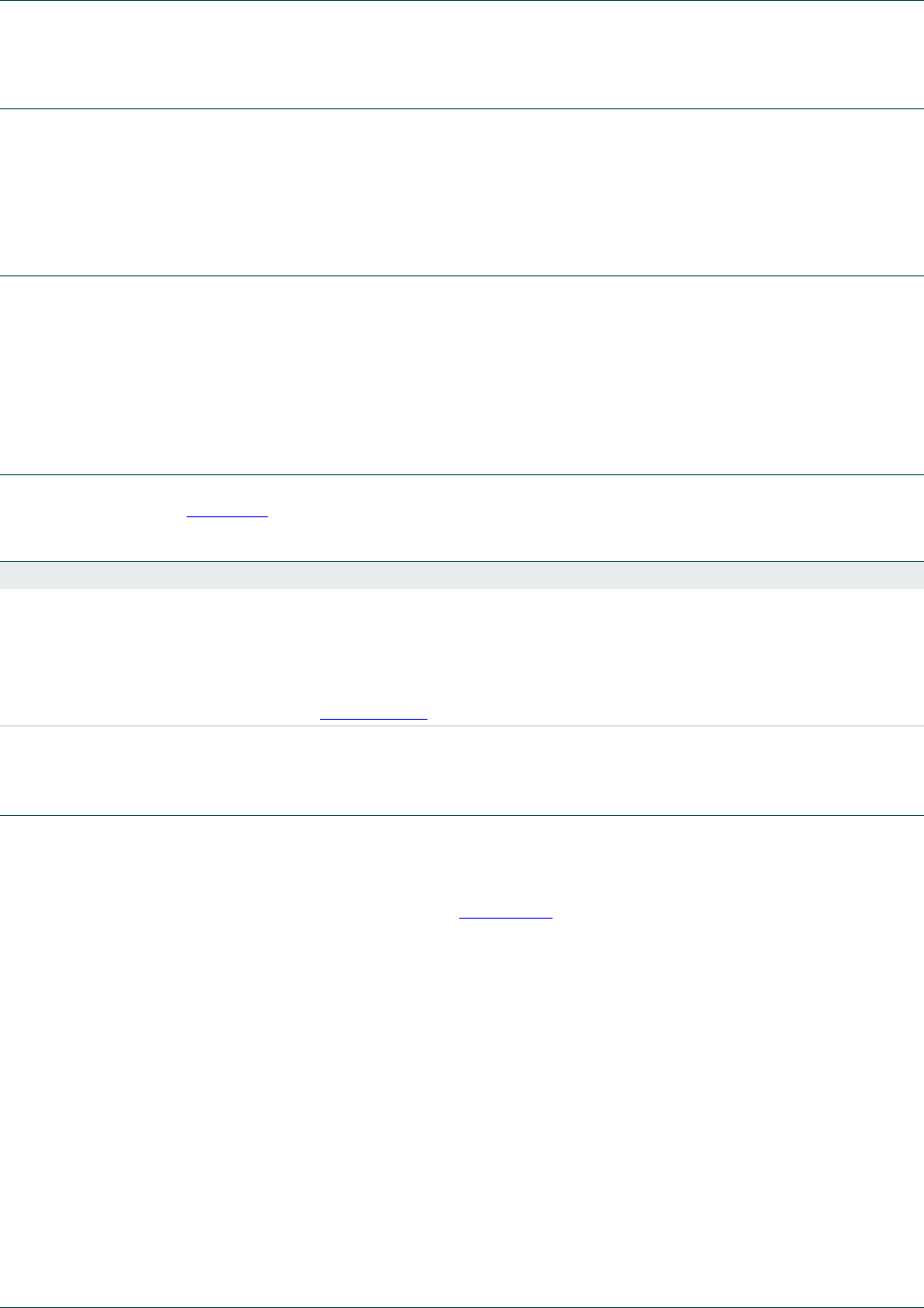
UM10360 All information provided in this document is subject to legal disclaimers. © NXP B.V. 2014. All rights reserved.
User manual Rev. 3.1 — 2 April 2014 500 of 849
NXP Semiconductors UM10360
Chapter 21: LPC176x/5x Timer 0/1/2/3
21.3 Applications
•Interval Timer for counting internal events.
•Pulse Width Demodulator via Capture inputs.
•Free running timer.
21.4 Description
The Timer/Counter is designed to count cycles of the peripheral clock (PCLK) or an
externally-supplied clock, and can optionally generate interrupts or perform other actions
at specified timer values, based on four match registers. It also includes four capture
inputs to trap the timer value when an input signal transitions, optionally generating an
interrupt.
21.5 Pin description
Tab l e 4 25 gives a brief summary of each of the Timer/Counter related pins.
21.5.1 Multiple CAP and MAT pins
Software can select from multiple pins for the CAP or MAT functions in the Pin Select
registers, which are described in Section 8.5. When more than one pin is selected for a
MAT output, all such pins are driven identically. When more than one pin is selected for a
CAP input, the pin with the lowest Port number is used. Note that match conditions may
be used internally without the use of a device pin.
Effective processing of the externally supplied clock to the counter has some limitations.
Since two successive rising edges of the PCLK clock are used to identify only one edge
on the CAP selected input, the frequency of the CAP input can not exceed one quarter of
the PCLK clock. Consequently, duration of the high/low levels on the same CAP input in
this case cannot be shorter than 1/(2 x PCLK).
Table 425. Timer/Counter pin description
Pin Type Description
CAP0[1:0]
CAP1[1:0]
CAP2[1:0]
CAP3[1:0]
Input Capture Signals- A transition on a capture pin can be configured to load one of the Capture Registers
with the value in the Timer Counter and optionally generate an interrupt. Capture functionality can be
selected from a number of pins. When more than one pin is selected for a Capture input on a single
TIMER0/1 channel, the pin with the lowest Port number is used
Timer/Counter block can select a capture signal as a clock source instead of the PCLK derived clock.
For more details see Section 21.6.3.
MAT0[1:0]
MAT1[1:0]
MAT2[3:0]
MAT3[1:0]
Output External Match Output - When a match register (MR3:0) equals the timer counter (TC) this output can
either toggle, go low, go high, or do nothing. The External Match Register (EMR) controls the
functionality of this output. Match Output functionality can be selected on a number of pins in parallel.

UM10360 All information provided in this document is subject to legal disclaimers. © NXP B.V. 2014. All rights reserved.
User manual Rev. 3.1 — 2 April 2014 501 of 849
NXP Semiconductors UM10360
Chapter 21: LPC176x/5x Timer 0/1/2/3
21.6 Register description
Each Timer/Counter contains the registers shown in Ta b le 4 2 6 ("Reset Value" refers to the
data stored in used bits only; it does not include reserved bits content). More detailed
descriptions follow.
Table 426. TIMER/COUNTER0-3 register map
Generic
Name
Description Access Reset
Value[1]
TIMERn Register/
Name & Address
IR Interrupt Register. The IR can be written to clear interrupts. The IR
can be read to identify which of eight possible interrupt sources are
pending.
R/W 0 T0IR - 0x4000 4000
T1IR - 0x4000 8000
T2IR - 0x4009 0000
T3IR - 0x4009 4000
TCR Timer Control Register. The TCR is used to control the Timer
Counter functions. The Timer Counter can be disabled or reset
through the TCR.
R/W 0 T0TCR - 0x4000 4004
T1TCR - 0x4000 8004
T2TCR - 0x4009 0004
T3TCR - 0x4009 4004
TC Timer Counter. The 32-bit TC is incremented every PR+1 cycles of
PCLK. The TC is controlled through the TCR.
R/W 0 T0TC - 0x4000 4008
T1TC - 0x4000 8008
T2TC - 0x4009 0008
T3TC - 0x4009 4008
PR Prescale Register. When the Prescale Counter (below) is equal to
this value, the next clock increments the TC and clears the PC.
R/W 0 T0PR - 0x4000 400C
T1PR - 0x4000 800C
T2PR - 0x4009 000C
T3PR - 0x4009 400C
PC Prescale Counter. The 32-bit PC is a counter which is incremented
to the value stored in PR. When the value in PR is reached, the TC
is incremented and the PC is cleared. The PC is observable and
controllable through the bus interface.
R/W 0 T0PC - 0x4000 4010
T1PC - 0x4000 8010
T2PC - 0x4009 0010
T3PC - 0x4009 4010
MCR Match Control Register. The MCR is used to control if an interrupt is
generated and if the TC is reset when a Match occurs.
R/W 0 T0MCR - 0x4000 4014
T1MCR - 0x4000 8014
T2MCR - 0x4009 0014
T3MCR - 0x4009 4014
MR0 Match Register 0. MR0 can be enabled through the MCR to reset
the TC, stop both the TC and PC, and/or generate an interrupt
every time MR0 matches the TC.
R/W 0 T0MR0 - 0x4000 4018
T1MR0 - 0x4000 8018
T2MR0 - 0x4009 0018
T3MR0 - 0x4009 4018
MR1 Match Register 1. See MR0 description. R/W 0 T0MR1 - 0x4000 401C
T1MR1 - 0x4000 801C
T2MR1 - 0x4009 001C
T3MR1 - 0x4009 401C
MR2 Match Register 2. See MR0 description. R/W 0 T0MR2 - 0x4000 4020
T1MR2 - 0x4000 8020
T2MR2 - 0x4009 0020
T3MR2 - 0x4009 4020
MR3 Match Register 3. See MR0 description. R/W 0 T0MR3 - 0x4000 4024
T1MR3 - 0x4000 8024
T2MR3 - 0x4009 0024
T3MR3 - 0x4009 4024
CCR Capture Control Register. The CCR controls which edges of the
capture inputs are used to load the Capture Registers and whether
or not an interrupt is generated when a capture takes place.
R/W 0 T0CCR - 0x4000 4028
T1CCR - 0x4000 8028
T2CCR - 0x4009 0028
T3CCR - 0x4009 4028

UM10360 All information provided in this document is subject to legal disclaimers. © NXP B.V. 2014. All rights reserved.
User manual Rev. 3.1 — 2 April 2014 502 of 849
NXP Semiconductors UM10360
Chapter 21: LPC176x/5x Timer 0/1/2/3
[1] Reset Value reflects the data stored in used bits only. It does not include reserved bits content.
21.6.1 Interrupt Register (T[0/1/2/3]IR - 0x4000 4000, 0x4000 8000,
0x4009 0000, 0x4009 4000)
The Interrupt Register consists of 4 bits for the match interrupts and 4 bits for the capture
interrupts. If an interrupt is generated then the corresponding bit in the IR will be high.
Otherwise, the bit will be low. Writing a logic one to the corresponding IR bit will reset the
interrupt. Writing a zero has no effect. The act of clearing an interrupt for a timer match
also clears any corresponding DMA request.
21.6.2 Timer Control Register (T[0/1/2/3]CR - 0x4000 4004, 0x4000 8004,
0x4009 0004, 0x4009 4004)
The Timer Control Register (TCR) is used to control the operation of the Timer/Counter.
CR0 Capture Register 0. CR0 is loaded with the value of TC when there
is an event on the CAPn.0(CAP0.0 or CAP1.0 respectively) input.
RO 0 T0CR0 - 0x4000 402C
T1CR0 - 0x4000 802C
T2CR0 - 0x4009 002C
T3CR0 - 0x4009 402C
CR1 Capture Register 1. See CR0 description. RO 0 T0CR1 - 0x4000 4030
T1CR1 - 0x4000 8030
T2CR1 - 0x4009 0030
T3CR1 - 0x4009 4030
EMR External Match Register. The EMR controls the external match pins
MATn.0-3 (MAT0.0-3 and MAT1.0-3 respectively).
R/W 0 T0EMR - 0x4000 403C
T1EMR - 0x4000 803C
T2EMR - 0x4009 003C
T3EMR - 0x4009 403C
CTCR Count Control Register. The CTCR selects between Timer and
Counter mode, and in Counter mode selects the signal and edge(s)
for counting.
R/W 0 T0CTCR - 0x4000 4070
T1CTCR - 0x4000 8070
T2CTCR - 0x4009 0070
T3CTCR - 0x4009 4070
Table 426. TIMER/COUNTER0-3 register map …continued
Generic
Name
Description Access Reset
Value[1]
TIMERn Register/
Name & Address
Table 427. Interrupt Register (T[0/1/2/3]IR - addresses 0x4000 4000, 0x4000 8000, 0x4009 0000, 0x4009 4000) bit
description
Bit Symbol Description Reset
Value
0MR0 InterruptInterrupt flag for match channel 0. 0
1MR1 InterruptInterrupt flag for match channel 1. 0
2MR2 InterruptInterrupt flag for match channel 2. 0
3MR3 InterruptInterrupt flag for match channel 3. 0
4CR0 InterruptInterrupt flag for capture channel 0 event. 0
5CR1 InterruptInterrupt flag for capture channel 1 event. 0
31:6 - Reserved -

UM10360 All information provided in this document is subject to legal disclaimers. © NXP B.V. 2014. All rights reserved.
User manual Rev. 3.1 — 2 April 2014 503 of 849
NXP Semiconductors UM10360
Chapter 21: LPC176x/5x Timer 0/1/2/3
21.6.3 Count Control Register (T[0/1/2/3]CTCR - 0x4000 4070, 0x4000 8070,
0x4009 0070, 0x4009 4070)
The Count Control Register (CTCR) is used to select between Timer and Counter mode,
and in Counter mode to select the pin and edge(s) for counting.
When Counter Mode is chosen as a mode of operation, the CAP input (selected by the
CTCR bits 3:2) is sampled on every rising edge of the PCLK clock. After comparing two
consecutive samples of this CAP input, one of the following four events is recognized:
rising edge, falling edge, either of edges or no changes in the level of the selected CAP
input. Only if the identified event occurs and the event corresponds to the one selected by
bits 1:0 in the CTCR register, will the Timer Counter register be incremented.
Effective processing of the externally supplied clock to the counter has some limitations.
Since two successive rising edges of the PCLK clock are used to identify only one edge
on the CAP selected input, the frequency of the CAP input can not exceed one quarter of
the PCLK clock. Consequently, duration of the high/low levels on the same CAP input in
this case can not be shorter than 1/(2 PCLK).
Table 428. Timer Control Register (TCR, TIMERn: TnTCR - addresses 0x4000 4004, 0x4000 8004, 0x4009 0004,
0x4009 4004) bit description
Bit Symbol Description Reset
Value
0Counter EnableWhen one, the Timer Counter and Prescale Counter are enabled for counting. When zero,
the counters are disabled.
0
1Counter ResetWhen one, the Timer Counter and the Prescale Counter are synchronously reset on the
next positive edge of PCLK. The counters remain reset until TCR[1] is returned to zero.
0
31:2 - Reserved, user software should not write ones to reserved bits. The value read from a
reserved bit is not defined.
NA
Table 429. Count Control Register (T[0/1/2/3]CTCR - addresses 0x4000 4070, 0x4000 8070, 0x4009 0070,
0x4009 4070) bit description
Bit Symbol Value Description Reset
Value
1:0 Counter/
Timer
Mode
This field selects which rising PCLK edges can increment the Timer’s Prescale Counter
(PC), or clear the PC and increment the Timer Counter (TC).
00
00 Timer Mode: the TC is incremented when the Prescale Counter matches the Prescale
Register. The Prescale Counter is incremented on every rising PCLK edge.
01 Counter Mode: TC is incremented on rising edges on the CAP input selected by bits 3:2.
10 Counter Mode: TC is incremented on falling edges on the CAP input selected by bits 3:2.
11 Counter Mode: TC is incremented on both edges on the CAP input selected by bits 3:2.

UM10360 All information provided in this document is subject to legal disclaimers. © NXP B.V. 2014. All rights reserved.
User manual Rev. 3.1 — 2 April 2014 504 of 849
NXP Semiconductors UM10360
Chapter 21: LPC176x/5x Timer 0/1/2/3
21.6.4 Timer Counter registers (T0TC - T3TC, 0x4000 4008, 0x4000 8008,
0x4009 0008, 0x4009 4008)
The 32-bit Timer Counter register is incremented when the prescale counter reaches its
terminal count. Unless it is reset before reaching its upper limit, the Timer Counter will
count up through the value 0xFFFF FFFF and then wrap back to the value 0x0000 0000.
This event does not cause an interrupt, but a match register can be used to detect an
overflow if needed.
21.6.5 Prescale register (T0PR - T3PR, 0x4000 400C, 0x4000 800C,
0x4009 000C, 0x4009 400C)
The 32-bit Prescale register specifies the maximum value for the Prescale Counter.
21.6.6 Prescale Counter register (T0PC - T3PC, 0x4000 4010, 0x4000 8010,
0x4009 0010, 0x4009 4010)
The 32-bit Prescale Counter controls division of PCLK by some constant value before it is
applied to the Timer Counter. This allows control of the relationship of the resolution of the
timer versus the maximum time before the timer overflows. The Prescale Counter is
incremented on every PCLK. When it reaches the value stored in the Prescale register,
the Timer Counter is incremented and the Prescale Counter is reset on the next PCLK.
This causes the Timer Counter to increment on every PCLK when PR = 0, every 2 pclks
when PR = 1, etc.
3:2 Count
Input
Select
When bits 1:0 in this register are not 00, these bits select which CAP pin is sampled for
clocking.
00
00 CAPn.0 for TIMERn
01 CAPn.1 for TIMERn
10 Reserved
11 Reserved
Note: If Counter mode is selected for a particular CAPn input in the TnCTCR, the 3 bits
for that input in the Capture Control Register (TnCCR) must be programmed as 000.
However, capture and/or interrupt can be selected for the other 3 CAPn inputs in the
same timer.
31:4 - - Reserved, user software should not write ones to reserved bits. The value read from a
reserved bit is not defined.
NA
Table 429. Count Control Register (T[0/1/2/3]CTCR - addresses 0x4000 4070, 0x4000 8070, 0x4009 0070,
0x4009 4070) bit description …continued
Bit Symbol Value Description Reset
Value

UM10360 All information provided in this document is subject to legal disclaimers. © NXP B.V. 2014. All rights reserved.
User manual Rev. 3.1 — 2 April 2014 505 of 849
NXP Semiconductors UM10360
Chapter 21: LPC176x/5x Timer 0/1/2/3
21.6.7 Match Registers (MR0 - MR3)
The Match register values are continuously compared to the Timer Counter value. When
the two values are equal, actions can be triggered automatically. The action possibilities
are to generate an interrupt, reset the Timer Counter, or stop the timer. Actions are
controlled by the settings in the MCR register.
21.6.8 Match Control Register (T[0/1/2/3]MCR - 0x4000 4014, 0x4000 8014,
0x4009 0014, 0x4009 4014)
The Match Control Register is used to control what operations are performed when one of
the Match Registers matches the Timer Counter. The function of each of the bits is shown
in Ta b le 4 3 0 .
Table 430. Match Control Register (T[0/1/2/3]MCR - addresses 0x4000 4014, 0x4000 8014, 0x4009 0014, 0x4009 4014)
bit description
Bit Symbol Value Description Reset
Value
0MR0I1 Interrupt on MR0: an interrupt is generated when MR0 matches the value in the TC. 0
0This interrupt is disabled
1MR0R1 Reset on MR0: the TC will be reset if MR0 matches it. 0
0Feature disabled.
2MR0S1 Stop on MR0: the TC and PC will be stopped and TCR[0] will be set to 0 if MR0 matches
the TC.
0
0Feature disabled.
3MR1I1 Interrupt on MR1: an interrupt is generated when MR1 matches the value in the TC. 0
0This interrupt is disabled
4MR1R1 Reset on MR1: the TC will be reset if MR1 matches it. 0
0Feature disabled.
5MR1S1 Stop on MR1: the TC and PC will be stopped and TCR[0] will be set to 0 if MR1 matches
the TC.
0
0Feature disabled.
6MR2I1 Interrupt on MR2: an interrupt is generated when MR2 matches the value in the TC. 0
0This interrupt is disabled
7MR2R1 Reset on MR2: the TC will be reset if MR2 matches it. 0
0Feature disabled.
8MR2S1 Stop on MR2: the TC and PC will be stopped and TCR[0] will be set to 0 if MR2 matches
the TC.
0
0Feature disabled.
9MR3I1 Interrupt on MR3: an interrupt is generated when MR3 matches the value in the TC. 0
0This interrupt is disabled
10 MR3R 1 Reset on MR3: the TC will be reset if MR3 matches it. 0
0Feature disabled.
11 MR3S 1 Stop on MR3: the TC and PC will be stopped and TCR[0] will be set to 0 if MR3 matches
the TC.
0
0Feature disabled.
31:12 - Reserved, user software should not write ones to reserved bits. The value read from a
reserved bit is not defined.
NA

UM10360 All information provided in this document is subject to legal disclaimers. © NXP B.V. 2014. All rights reserved.
User manual Rev. 3.1 — 2 April 2014 506 of 849
NXP Semiconductors UM10360
Chapter 21: LPC176x/5x Timer 0/1/2/3
21.6.9 Capture Registers (CR0 - CR1)
Each Capture register is associated with a device pin and may be loaded with the Timer
Counter value when a specified event occurs on that pin. The settings in the Capture
Control Register register determine whether the capture function is enabled, and whether
a capture event happens on the rising edge of the associated pin, the falling edge, or on
both edges.
21.6.10 Capture Control Register (T[0/1/2/3]CCR - 0x4000 4028, 0x4000 8028,
0x4009 0028, 0x4009 4028)
The Capture Control Register is used to control whether one of the four Capture Registers
is loaded with the value in the Timer Counter when the capture event occurs, and whether
an interrupt is generated by the capture event. Setting both the rising and falling bits at the
same time is a valid configuration, resulting in a capture event for both edges. In the
description below, "n" represents the Timer number, 0 or 1.
Note: If Counter mode is selected for a particular CAP input in the CTCR, the 3 bits for
that input in this register should be programmed as 000, but capture and/or interrupt can
be selected for the other 3 CAP inputs.
21.6.11 External Match Register (T[0/1/2/3]EMR - 0x4000 403C, 0x4000 803C,
0x4009 003C, 0x4009 403C)
The External Match Register provides both control and status of the external match pins.
In the descriptions below, “n” represents the Timer number, 0 or 1, and “m” represent a
Match number, 0 through 3.
Table 431. Capture Control Register (T[0/1/2/3]CCR - addresses 0x4000 4028, 0x4000 8020, 0x4009 0028,
0x4009 4028) bit description
Bit Symbol Value Description Reset
Value
0CAP0RE1Capture on CAPn.0 rising edge: a sequence of 0 then 1 on CAPn.0 will cause CR0 to be
loaded with the contents of TC.
0
0This feature is disabled.
1CAP0FE1Capture on CAPn.0 falling edge: a sequence of 1 then 0 on CAPn.0 will cause CR0 to be
loaded with the contents of TC.
0
0This feature is disabled.
2CAP0I1 Interrupt on CAPn.0 event: a CR0 load due to a CAPn.0 event will generate an interrupt.0
0This feature is disabled.
3CAP1RE1Capture on CAPn.1 rising edge: a sequence of 0 then 1 on CAPn.1 will cause CR1 to be
loaded with the contents of TC.
0
0This feature is disabled.
4CAP1FE1Capture on CAPn.1 falling edge: a sequence of 1 then 0 on CAPn.1 will cause CR1 to be
loaded with the contents of TC.
0
0This feature is disabled.
5CAP1I1 Interrupt on CAPn.1 event: a CR1 load due to a CAPn.1 event will generate an interrupt.0
0This feature is disabled.
31:6 - Reserved, user software should not write ones to reserved bits. The value read from a
reserved bit is not defined.
NA
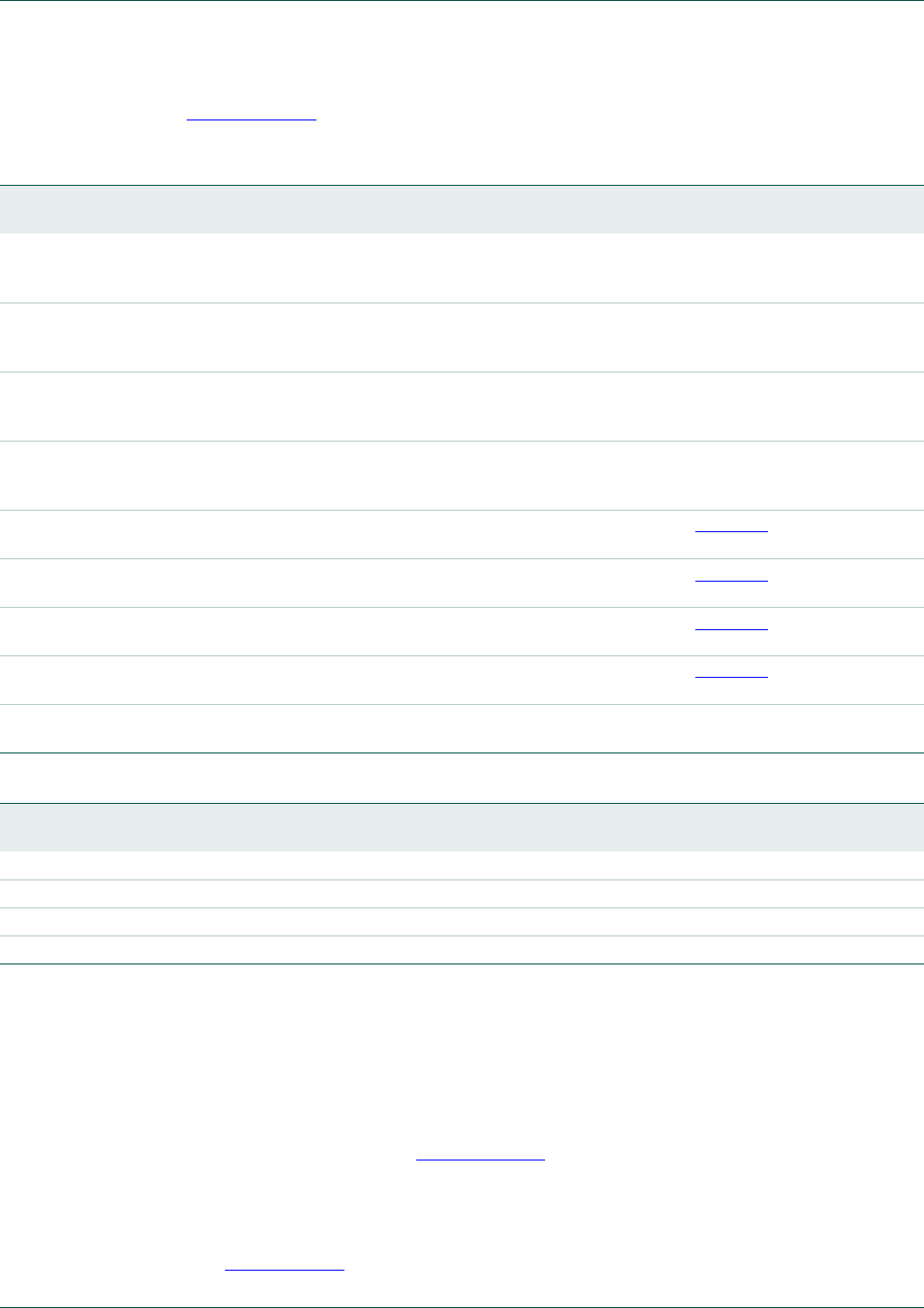
UM10360 All information provided in this document is subject to legal disclaimers. © NXP B.V. 2014. All rights reserved.
User manual Rev. 3.1 — 2 April 2014 507 of 849
NXP Semiconductors UM10360
Chapter 21: LPC176x/5x Timer 0/1/2/3
Match events for Match 0 and Match 1 in each timer can cause a DMA request, see
Section 21.6.12.
21.6.12 DMA operation
DMA requests are generated by a match of the Timer Counter (TC) register value to either
Match Register 0 (MR0) or Match Register 1 (MR1). This is not connected to the operation
of the Match outputs controlled by the EMR register. Each match sets a DMA request flag,
which is connected to the DMA controller. In order to have an effect, the GPDMA must be
configured and the relevant timer DMA request selected as a DMA source via the
DMAREQSEL register, see Section 31.5.15.
When a timer is initially set up to generate a DMA request, the request may already be
asserted before a match condition occurs. An initial DMA request may be avoided by
having software write a one to the interrupt flag location, as if clearing a timer interrupt.
See Section 21.6.1. A DMA request will be cleared automatically when it is acted upon by
Table 432. External Match Register (T[0/1/2/3]EMR - addresses 0x4000 403C, 0x4000 803C, 0x4009 003C,
0x4009 403C) bit description
Bit Symbol Description Reset
Value
0EM0External Match 0. When a match occurs between the TC and MR0, this bit can either toggle, go
low, go high, or do nothing, depending on bits 5:4 of this register. This bit can be driven onto a
MATn.0 pin, in a positive-logic manner (0 = low, 1 = high).
0
1EM1External Match 1. When a match occurs between the TC and MR1, this bit can either toggle, go
low, go high, or do nothing, depending on bits 7:6 of this register. This bit can be driven onto a
MATn.1 pin, in a positive-logic manner (0 = low, 1 = high).
0
2EM2External Match 2. When a match occurs between the TC and MR2, this bit can either toggle, go
low, go high, or do nothing, depending on bits 9:8 of this register. This bit can be driven onto a
MATn.2 pin, in a positive-logic manner (0 = low, 1 = high).
0
3EM3External Match 3. When a match occurs between the TC and MR3, this bit can either toggle, go
low, go high, or do nothing, depending on bits 11:10 of this register. This bit can be driven onto a
MATn.3 pin, in a positive-logic manner (0 = low, 1 = high).
0
5:4 EMC0 External Match Control 0. Determines the functionality of External Match 0. Table 4 3 3 shows the
encoding of these bits.
00
7:6 EMC1 External Match Control 1. Determines the functionality of External Match 1. Table 4 3 3 shows the
encoding of these bits.
00
9:8 EMC2 External Match Control 2. Determines the functionality of External Match 2. Table 4 3 3 shows the
encoding of these bits.
00
11:10 EMC3 External Match Control 3. Determines the functionality of External Match 3. Tab l e 4 3 3 shows the
encoding of these bits.
00
15:12 - Reserved, user software should not write ones to reserved bits. The value read from a reserved
bit is not defined.
NA
Table 433. External Match Control
EMR[11:10], EMR[9:8],
EMR[7:6], or EMR[5:4]
Function
00 Do Nothing.
01 Clear the corresponding External Match bit/output to 0 (MATn.m pin is LOW if pinned out).
10 Set the corresponding External Match bit/output to 1 (MATn.m pin is HIGH if pinned out).
11 Tog g l e th e c or r e spo n d i ng E x tern a l Mat c h bit / o u tput .
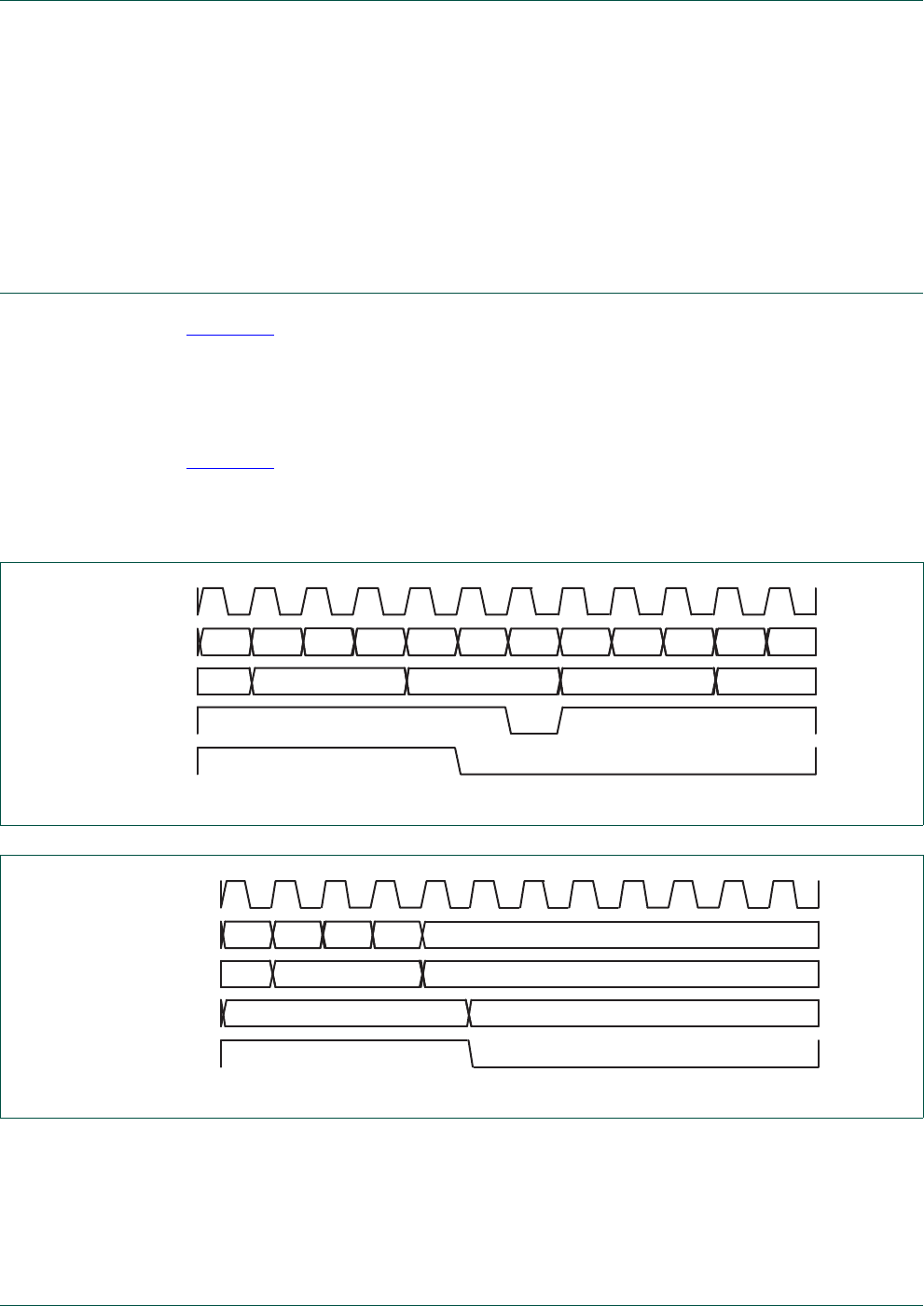
UM10360 All information provided in this document is subject to legal disclaimers. © NXP B.V. 2014. All rights reserved.
User manual Rev. 3.1 — 2 April 2014 508 of 849
NXP Semiconductors UM10360
Chapter 21: LPC176x/5x Timer 0/1/2/3
the GPDMA controller.
Remark: Because timer DMA requests are generated whenever the timer value is equal
to the related Match Register value, DMA requests are always generated when the timer
is running, unless the Match Register value is higher than the upper count limit of the
timer. It is important not to select and enable timer DMA requests in the GPDMA block
unless the timer is correctly configured to generate valid DMA requests.
21.7 Example timer operation
Figure 115 shows a timer configured to reset the count and generate an interrupt on
match. The prescaler is set to 2 and the match register set to 6. At the end of the timer
cycle where the match occurs, the timer count is reset. This gives a full length cycle to the
match value. The interrupt indicating that a match occurred is generated in the next clock
after the timer reached the match value.
Figure 116 shows a timer configured to stop and generate an interrupt on match. The
prescaler is again set to 2 and the match register set to 6. In the next clock after the timer
reaches the match value, the timer enable bit in TCR is cleared, and the interrupt
indicating that a match occurred is generated.
Fig 115. A timer cycle in which PR=2, MRx=6, and both interrupt and reset on match are enabled.
PCLK
prescale
counter
interrupt
timer
counter
timer counter
reset
22220 0 0 011 1 1
45 6 0 1
Fig 116. A timer Cycle in Which PR=2, MRx=6, and both interrupt and stop on match are enabled
PCLK
prescale counter
interrupt
timer counter
TCR[0]
(counter enable)
220 01
45 6
1 0
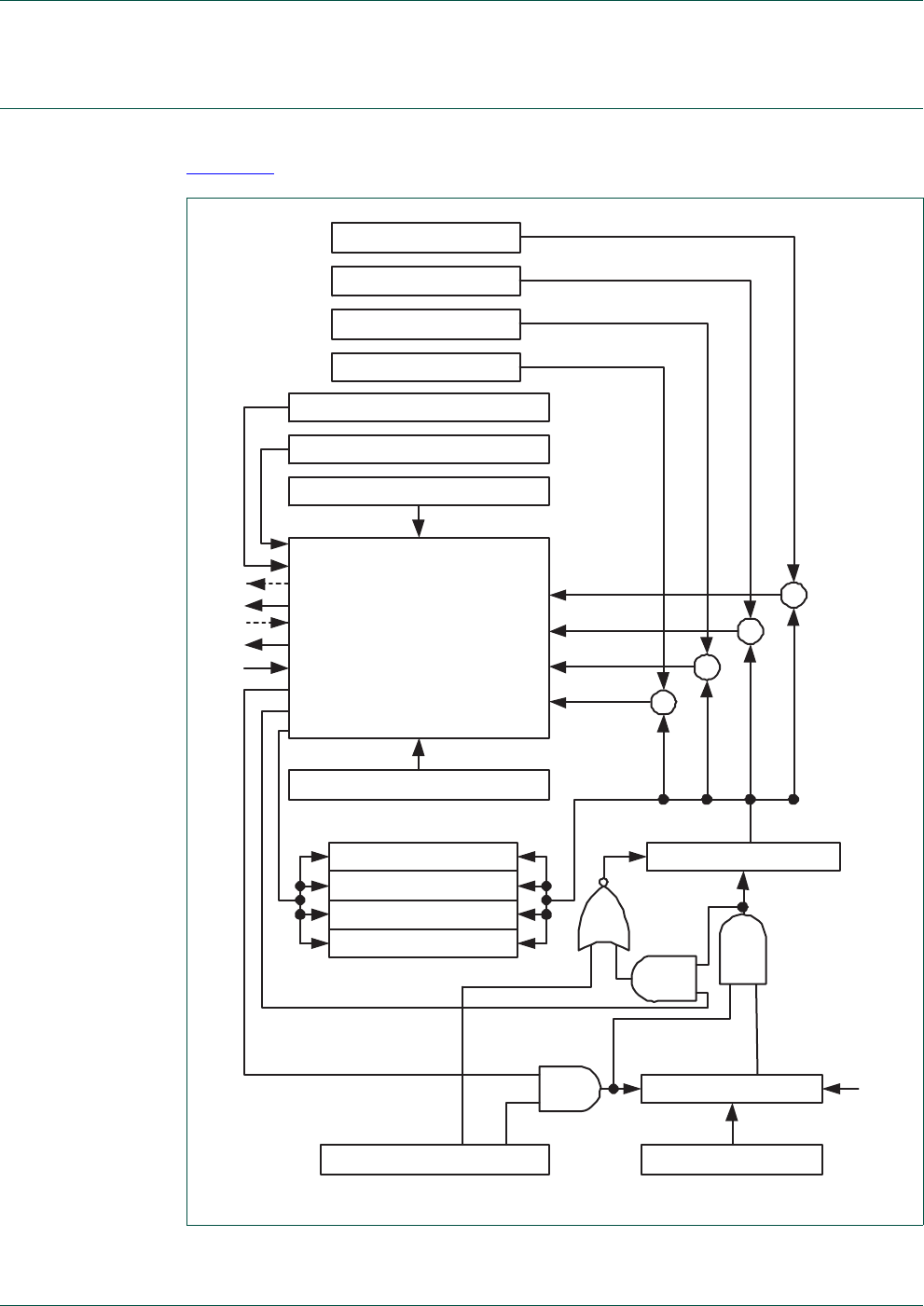
UM10360 All information provided in this document is subject to legal disclaimers. © NXP B.V. 2014. All rights reserved.
User manual Rev. 3.1 — 2 April 2014 509 of 849
NXP Semiconductors UM10360
Chapter 21: LPC176x/5x Timer 0/1/2/3
21.8 Architecture
The block diagram for TIMER/COUNTER0 and TIMER/COUNTER1 is shown in
Figure 117.
Fig 117. Timer block diagram
reset MAXVAL
TIMER CONTROL REGISTER PRESCALE REGISTER
PRESCALE COUNTER PCLK
enable
RESERVED
RESERVED
CAPTURE REGISTER 1
CAPTURE REGISTER 0
MATCH REGISTER 3
MATCH REGISTER 2
MATCH REGISTER 1
MATCH REGISTER 0
CAPTURE CONTROL REGISTER
CONTROL
TIMER COUNTER
CSN
TCI
CE
=
=
=
=
INTERRUPT REGISTER
EXTERNAL MATCH REGISTER
MATCH CONTROL REGISTER
MAT[3:0]
INTERRUPT
CAP[3:0]
STOP ON MATCH
DMA CLEAR[1:0]
DMA REQUEST[1:0]
RESET ON MATCH
LOAD[3:0]

UM10360 All information provided in this document is subject to legal disclaimers. © NXP B.V. 2014. All rights reserved.
User manual Rev. 3.1 — 2 April 2014 510 of 849
22.1 Features
•32-bit counter running from PCLK. Counter can be free-running, or be reset by a
generated interrupt.
•32-bit compare value.
•32-bit compare mask. An interrupt is generated when the counter value equals the
compare value, after masking. This allows for combinations not possible with a simple
compare.
22.2 Description
The Repetitive Interrupt Timer provides a versatile means of generating interrupts at
specified time intervals, without using a standard timer. It is intended for repeating
interrupts that aren’t related to Operating System interrupts. However, it could be used as
an alternative to the Cortex-M3 System Tick Timer (Section 23.1) if there are different
system requirements.
22.3 Register description
[1] Reset Value reflects the data stored in used bits only. It does not include content of reserved bits.
22.3.1 RI Compare Value register (RICOMPVAL - 0x400B 0000)
22.3.2 RI Mask register (RIMASK - 0x400B 0004)
UM10360
Chapter 22: LPC176x/5x Repetitive Interrupt Timer (RIT)
Rev. 3.1 — 2 April 2014 User manual
Table 434. Repetitive Interrupt Timer register map
Name Description Access Reset value[1] Address
RICOMPVAL Compare register R/W 0xFFFF FFFF 0x400B 0000
RIMASK Mask register. This register holds the 32-bit mask value. R/W 0 0x400B 0004
RICTRL Control register. R/W 0xC 0x400B 0008
RICOUNTER 32-bit counter R/W 0 0x400B 000C
Table 435. RI Compare Value register (RICOMPVAL - address 0x400B 0000) bit description
Bit Symbol Description Reset value
31:0 RICOMP Compare register. Holds the compare value which is compared to the counter. 0xFFFF FFFF
Table 436. RI Mask register (RIMASK - address 0x400B 0004) bit description
Bit Symbol Description Reset value
31:0 RIMASK Mask register. This register holds the 32-bit mask value. A one written to any bit overrides
the result of the comparison for the corresponding bit of the counter and compare register
(causes the comparison of the register bits to be always true).
0

UM10360 All information provided in this document is subject to legal disclaimers. © NXP B.V. 2014. All rights reserved.
User manual Rev. 3.1 — 2 April 2014 511 of 849
NXP Semiconductors UM10360
Chapter 22: LPC176x/5x Repetitive Interrupt Timer (RIT)
22.3.3 RI Control register (RICTRL - 0x400B 0008)
22.3.4 RI Counter register (RICOUNTER - 0x400B 000C)
22.4 RI timer operation
Following reset, the counter begins counting up from 00000000h. Whenever the counter
value equals the value programmed into the RICOMPVAL register the interrupt flag will be
set. Any bit or combination of bits can be removed from this comparison (i.e. forced to
compare) by writing a ‘1’ to the corresponding bit(s) in the RIMASK register. If the
enable_clr bit is low (default state), a valid comparison ONLY causes the interrupt flag to
be set. It has no effect on the count sequence. Counting continues as usual. When the
counter reaches FFFFFFFFh it rolls-over to 00000000h on the next clock and continues
counting. If the enable_clr bit is set to ‘1’ a valid comparison will also cause the counter to
be reset to zero. Counting will resume from there on the next clock edge.
Table 437. RI Control register (RICTRL - address 0x400B 0008) bit description
Bit Symbol Value Description Reset
value
0RITINT Interrupt flag 0
1This bit is set to 1 by hardware whenever the counter value equals the masked
compare value specified by the contents of RICOMPVAL and RIMASK registers.
Writing a 1 to this bit will clear it to 0. Writing a 0 has no effect.
0The counter value does not equal the masked compare value.
1RITENCLR Timer enable clear
1The timer will be cleared to 0 whenever the counter value equals the masked compare
value specified by the contents of RICOMPVAL and RIMASK registers. This will occur
on the same clock that sets the interrupt flag.
0
0The timer will not be cleared to 0.
2RITENBR Timer enable for debug 1
1The timer is halted when the processor is halted for debugging.
0Debug has no effect on the timer operation.
3RITEN Timer enable. 1
1Timer enabled.
Remark: This can be overruled by a debug halt if enabled in bit 2.
0Timer disabled.
31:4 - - Reserved, user software should not write ones to reserved bits. The value read from a
reserved bit is not defined.
NA
Table 438. RI Counter register (RICOUNTER - address 0x400B 000C) bit description
Bit Symbol Description Reset
value
31:0 RICOUNTER 32-bit up counter. Counts continuously unless RITEN bit in RICTRL register is cleared or
debug mode is entered (if enabled by the RITNEBR bit in RICTRL). Can be loaded to any
value in software.
0
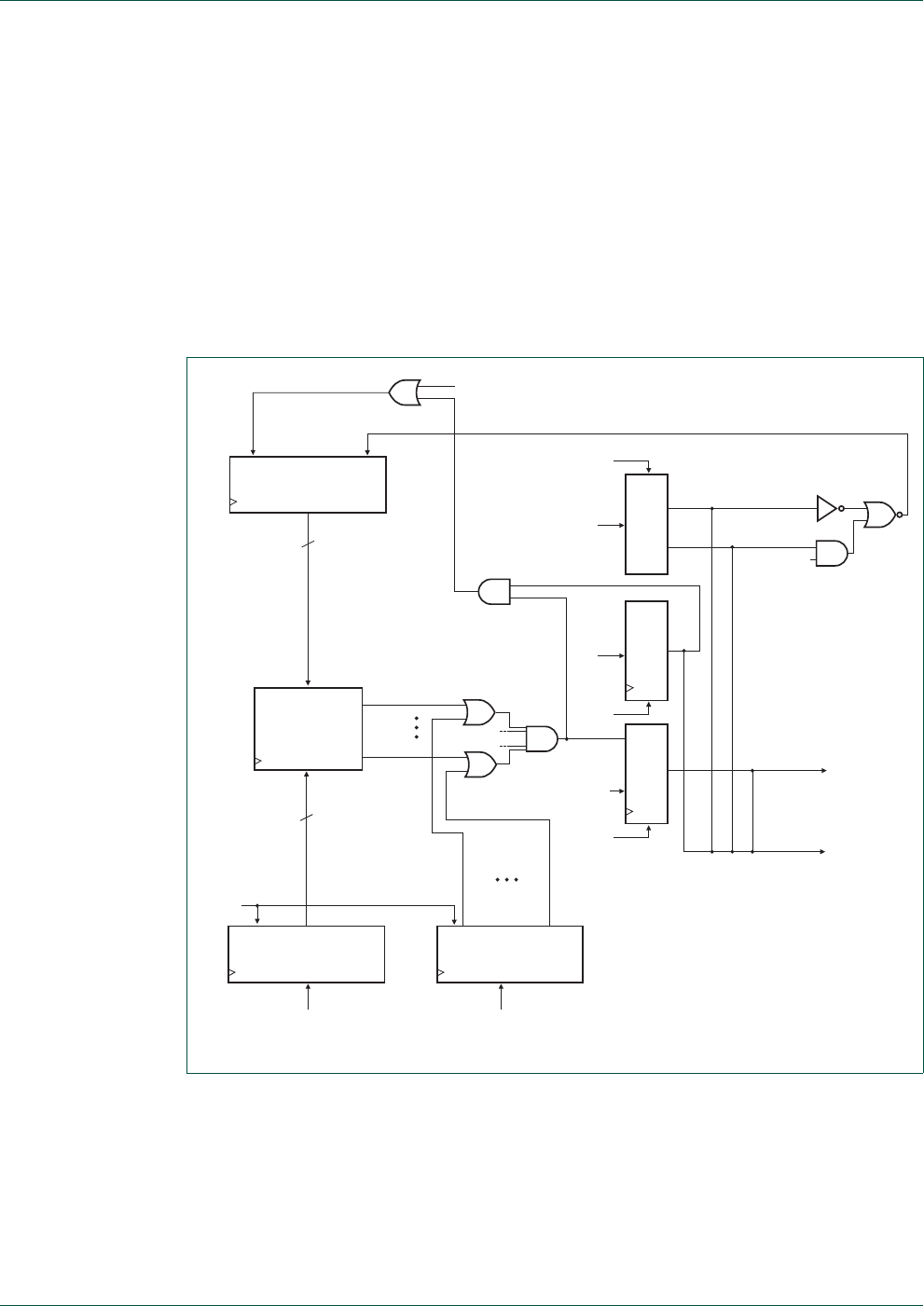
UM10360 All information provided in this document is subject to legal disclaimers. © NXP B.V. 2014. All rights reserved.
User manual Rev. 3.1 — 2 April 2014 512 of 849
NXP Semiconductors UM10360
Chapter 22: LPC176x/5x Repetitive Interrupt Timer (RIT)
Counting can be halted in software by writing a ‘0’ to the Enable_Timer bit - RICTRL(3).
Counting will also be halted when the processor is halted for debugging provided the
Enable_Break bit – RICTRL(2) is set. Both the Enable_Timer and Enable_Break bits are
set on reset.
The interrupt flag can be cleared in software by writing a ‘1’ to the Interrupt bit –
RICTRL(0).
Software can load the counter to any value at any time by writing to RICOUNTER.
The counter (RICOUNTER), RICOMPVAL register, RIMASK register and RICTRL register
can all be read by software at any time.
Fig 118. RI timer block diagram
32-bit COUNTER
CLR ENA
COMPARATOR
SET
SET
3
2
S
C
CLR
EQ
EQ
0
ENABLE_TIMER
ENABLE_BREAK
BREAK
INTR
PBUS
PBUS
PBUS
RESET
RESET
RESET
SET_INT
32
32
PBUS
write '1' to
clear
PBUS
PBUS
CLR
RESET
CNT_ENA
CTRL
register
CLR
RESET
ENABLE_CLK
COMPARE
register
MASK
register
bit 0
(MASK)
bit 31
(MASK)
32 X
32 Xbit 0
compare
bit 32
compare
.
.
.

UM10360 All information provided in this document is subject to legal disclaimers. © NXP B.V. 2014. All rights reserved.
User manual Rev. 3.1 — 2 April 2014 513 of 849
23.1 Basic configuration
The System Tick Timer is configured using the following registers:
1. Clock Source: Select either the internal CCLK or external STCLK (P3.26) clock as the
source in the STCTRL register.
2. Pins: If STCLK (P3.26) was selected as clock source enable the STCLK pin function
in the PINMODE register (Section 8.5).
3. Interrupt: The System Tick Timer Interrupt is enabled in the NVIC using the
appropriate Interrupt Set Enable register.
23.2 Features
•Times intervals of 10 milliseconds
•Dedicated exception vector
•Can be clocked internally by the CPU clock or by a clock input from a pin (STCLK)
23.3 Description
The System Tick Timer is an integral part of the Cortex-M3. The System Tick Timer is
intended to generate a fixed 10 millisecond interrupt for use by an operating system or
other system management software.
Since the System Tick Timer is a part of the Cortex-M3, it facilitates porting of software by
providing a standard timer that is available on Cortex-M3 based devices.
Refer to the Cortex-M3 User Guide appended to this manual (Section 34.4.4) for details of
System Tick Timer operation.
23.4 Operation
The System Tick Timer is a 24-bit timer that counts down to zero and generates an
interrupt. The intent is to provide a fixed 10 millisecond time interval between interrupts.
The System Tick Timer may be clocked either from the CPU clock or from the external pin
STCLK. The STCLK function shares pin P3.26 with other functions, and must be selected
for use as the System Tick Timer clock. In order to generate recurring interrupts at a
specific interval, the STRELOAD register must be initialized with the correct value for the
desired interval. A default value is provided in the STCALIB register and may be changed
by software. The default value gives a 10 millisecond interrupt rate if the CPU clock is set
to 100 MHz.
Remark: The maximum allowable STCLK frequency is 1/4 of CCLK.
The block diagram of the System Tick Timer is shown below in the Figure 119.
UM10360
Chapter 23: LPC176x/5x System Tick Timer
Rev. 3.1 — 2 April 2014 User manual
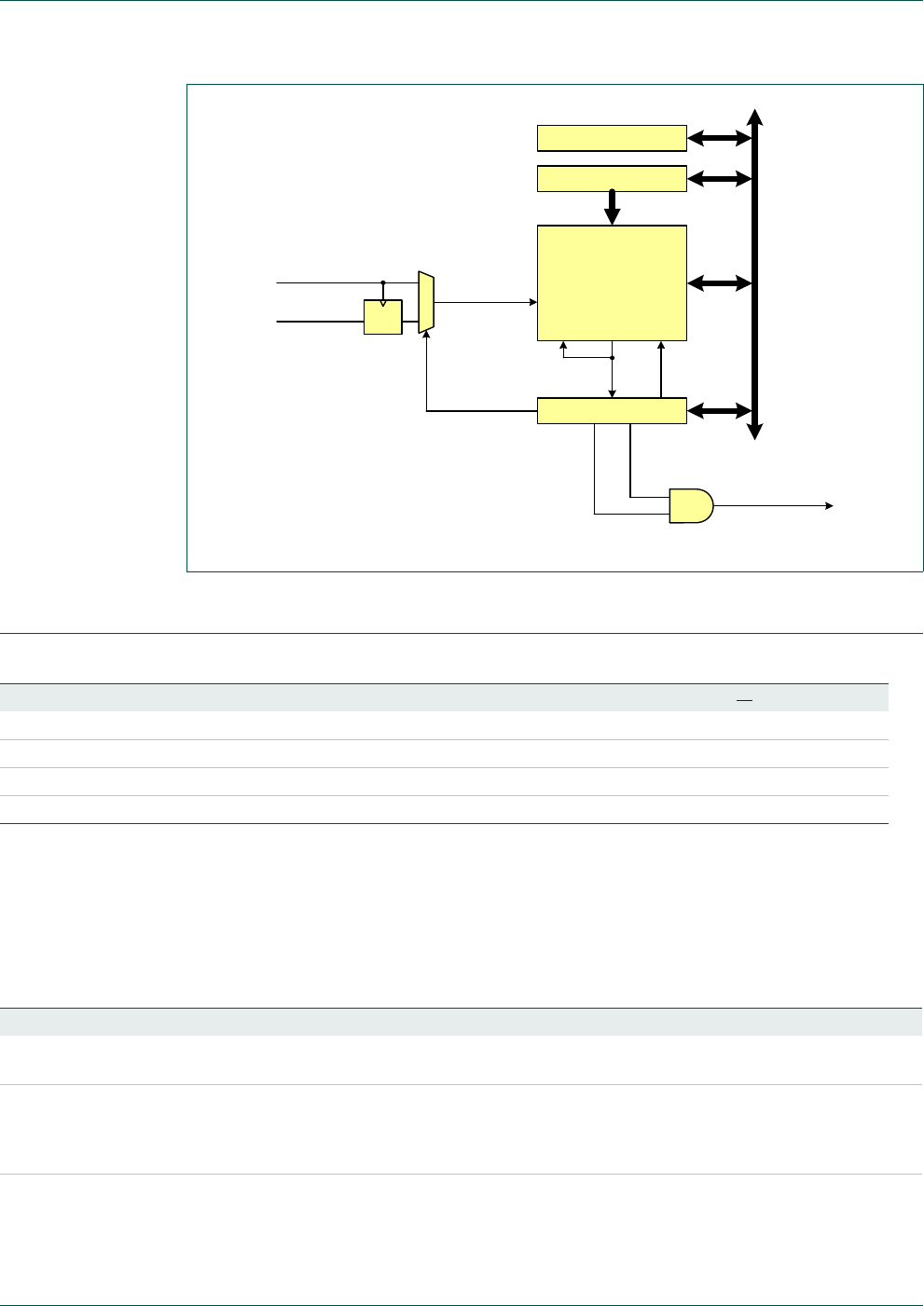
UM10360 All information provided in this document is subject to legal disclaimers. © NXP B.V. 2014. All rights reserved.
User manual Rev. 3.1 — 2 April 2014 514 of 849
NXP Semiconductors UM10360
Chapter 23: LPC176x/5x System Tick Timer
23.5 Register description
[1] Reset Value reflects the data stored in used bits only. It does not include content of reserved bits.
23.5.1 System Timer Control and status register (STCTRL - 0xE000 E010)
The STCTRL register contains control information for the System Tick Timer, and provides
a status flag.
Fig 119. System Tick Timer block diagram
cclk
STCALIB
STRELOAD
STCURR
24-bit down counter
ENABLE
STCTRL
private
peripheral
bus
System Tick
interrupt
STCLK pin
CLKSOURCE
TICKINTCOUNTFLAG
load
under-
flow
count
enable
clock
DQ
load data
Table 439. System Tick Timer register map
Name Description Access Reset value[1] Address
STCTRL System Timer Control and status register R/W 0x4 0xE000 E010
STRELOAD System Timer Reload value register R/W 0 0xE000 E014
STCURR System Timer Current value register R/W 0 0xE000 E018
STCALIB System Timer Calibration value register R/W 0x000F 423F 0xE000 E01C
Table 440. System Timer Control and status register (STCTRL - 0xE000 E010) bit description
Bit Symbol Description Reset value
0ENABLE System Tick counter enable. When 1, the counter is enabled. When 0,
the counter is disabled.
0
1TICKINT System Tick interrupt enable. When 1, the System Tick interrupt is
enabled. When 0, the System Tick interrupt is disabled. When enabled,
the interrupt is generated when the System Tick counter counts down to
0.
0
2CLKSOURCE System Tick clock source selection. When 1, the CPU clock is selected.
When 0, the external clock pin (STCLK) is selected.
1
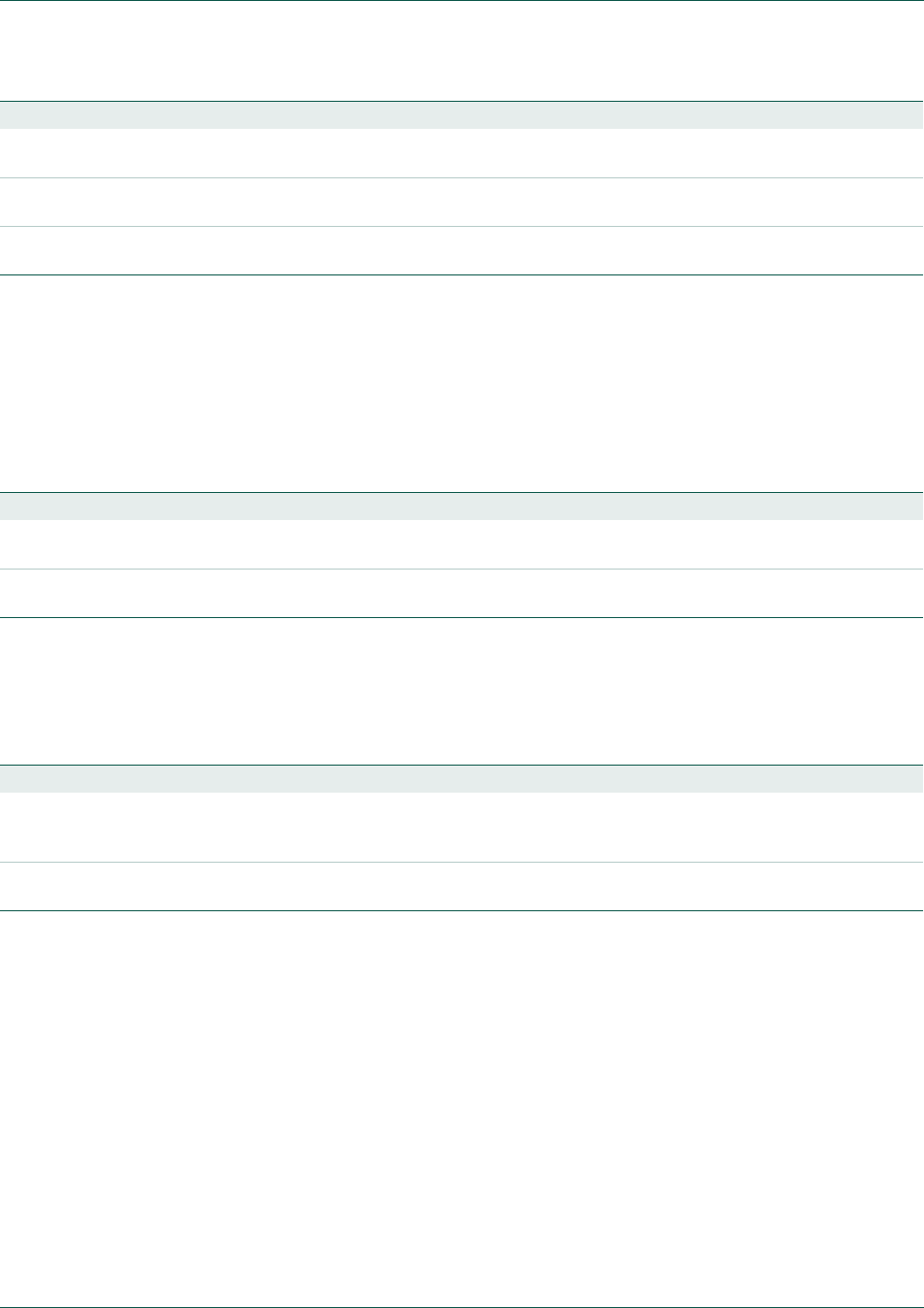
UM10360 All information provided in this document is subject to legal disclaimers. © NXP B.V. 2014. All rights reserved.
User manual Rev. 3.1 — 2 April 2014 515 of 849
NXP Semiconductors UM10360
Chapter 23: LPC176x/5x System Tick Timer
23.5.2 System Timer Reload value register (STRELOAD - 0xE000 E014)
The STRELOAD register is set to the value that will be loaded into the System Tick Timer
whenever it counts down to zero. This register is loaded by software as part of timer
initialization. The STCALIB register may be read and used as the value for STRELOAD if
the CPU or external clock is running at the frequency intended for use with the STCALIB
value.
23.5.3 System Timer Current value register (STCURR - 0xE000 E018)
The STCURR register returns the current count from the System Tick counter when it is
read by software.
23.5.4 System Timer Calibration value register (STCALIB - 0xE000 E01C)
The STCALIB register contains a value that is initialized by the Boot Code to a factory
programmed value that is appropriate for generating an interrupt every 10 milliseconds if
the System Tick Timer is clocked at a frequency of 100 MHz. This is the intended use of
the System Tick Timer by ARM. It can be used to generate interrupts at other frequencies
by selecting the correct reload value.
15:3 - Reserved, user software should not write ones to reserved bits. The
value read from a reserved bit is not defined.
NA
16 COUNTFLAG System Tick counter flag. This flag is set when the System Tick counter
counts down to 0, and is cleared by reading this register.
0
31:17 - Reserved, user software should not write ones to reserved bits. The
value read from a reserved bit is not defined.
NA
Table 440. System Timer Control and status register (STCTRL - 0xE000 E010) bit description …continued
Bit Symbol Description Reset value
Table 441. System Timer Reload value register (STRELOAD - 0xE000 E014) bit description
Bit Symbol Description Reset value
23:0 RELOAD This is the value that is loaded into the System Tick counter when it
counts down to 0.
0
31:24 - Reserved, user software should not write ones to reserved bits. The
value read from a reserved bit is not defined.
NA
Table 442. System Timer Current value register (STCURR - 0xE000 E018) bit description
Bit Symbol Description Reset value
23:0 CURRENT Reading this register returns the current value of the System Tick
counter. Writing any value clears the System Tick counter and the
COUNTFLAG bit in STCTRL.
0
31:24 - Reserved, user software should not write ones to reserved bits. The
value read from a reserved bit is not defined.
NA

UM10360 All information provided in this document is subject to legal disclaimers. © NXP B.V. 2014. All rights reserved.
User manual Rev. 3.1 — 2 April 2014 516 of 849
NXP Semiconductors UM10360
Chapter 23: LPC176x/5x System Tick Timer
Table 443. System Timer Calibration value register (STCALIB - 0xE000 E01C) bit description
Bit Symbol Value Description Reset value
23:0 TENMS Reload value to get a 10 millisecond System Tick underflow rate when running
at 100 MHz. This value initialized at reset with a factory supplied value selected
for the LPC176x/5x. The provided values of TENMS, SKEW, and NOREF are
applicable only when using a CPU clock or external STCLK source of 100 MHz.
0x0F 423F
29:24 - Reserved, user software should not write ones to reserved bits. The value read
from a reserved bit is not defined.
NA
30 SKEW Indicates whether the TENMS value will generate a precise 10 millisecond time,
or an approximation. This bit is initialized at reset with a factory supplied value
selected for the LPC176x/5x. See the description of TENMS above.
When 0, the value of TENMS is considered to be precise. When 1, the value of
TENMS is not considered to be precise.
0
31 NOREF Indicates whether an external reference clock is available. This bit is initialized
at reset with a factory supplied value selected for the LPC176x/5x. See the
description of TENMS above.
When 0, a separate reference clock is available. When 1, a separate reference
clock is not available.
0

UM10360 All information provided in this document is subject to legal disclaimers. © NXP B.V. 2014. All rights reserved.
User manual Rev. 3.1 — 2 April 2014 517 of 849
NXP Semiconductors UM10360
Chapter 23: LPC176x/5x System Tick Timer
23.6 Example timer calculations
The following examples illustrate selecting System Tick Timer values for different system
configurations. All of the examples calculate an interrupt interval of 10 milliseconds, as the
System Tick Timer is intended to be used.
Example 1)
This example is for the System Tick Timer running from the CPU clock (cclk), which is
100 MHz.
STCTRL = 7. This enables the timer and its interrupt, and selects cclk as the clock source.
RELOAD = (cclk / 100) - 1 = 1,000,000 - 1 = 999,999 = 0xF423F
In this case, there is no rounding error, so the result is as accurate as cclk.
Example 2)
This example is for the System Tick Timer running from the CPU clock (cclk), which is
80 MHz.
STCTRL = 7. This enables the timer and its interrupt, and selects cclk as the clock source.
RELOAD = (cclk / 100) - 1 = 800,000 - 1 = 799,999 = 0xC34FF
In this case, there is no rounding error, so the result is as accurate as cclk.
Example 3)
This example is for the CPU clock (cclk) is taken from the Internal RC Oscillator (IRC),
factory trimmed to 4 MHz.
STCTRL = 7. This enables the timer and its interrupt, and selects cclk as the clock source.
RELOAD = (FIRC / 100) - 1 = 40,000 - 1 = 39,999 = 0x9C3F
In this case, there is no rounding error, so the result is as accurate as the IRC.
Example 4)
This example is for the System Tick Timer running from an external clock source (the
STCLK pin), which in this case happens to be 32.768 kHz.
STCTRL = 3. This enables the timer and its interrupt, and selects the STCLK pin as the
clock source. STCLK must be selected as the function of the relevant pin. See
Section 8.5.6.
RELOAD = (cclk / 100) - 1 = 327.6 - 1 = 327 (rounded up) = 0x0147
In this case, there is rounding error, so the interrupt rate will drift slightly relative to the
input frequency.

UM10360 All information provided in this document is subject to legal disclaimers. © NXP B.V. 2014. All rights reserved.
User manual Rev. 3.1 — 2 April 2014 518 of 849
24.1 Basic configuration
The PWM is configured using the following registers:
1. Power: In the PCONP register (Ta b le 46 ), set bit PCPWM1.
Remark: On reset, the PWM is enabled (PCPWM1 = 1).
2. Peripheral clock: In the PCLKSEL0 register (Tab l e 40 ), select PCLK_PWM1.
3. Pins: Select PWM pins through the PINSEL registers. Select pin modes for port pins
with PWM1 functions through the PINMODE registers (Section 8.5).
4. Interrupts: See registers PWM1MCR (Ta b l e 45 0 ) and PWM1CCR (Ta b l e 45 1 ) for
match and capture events. Interrupts are enabled in the NVIC using the appropriate
Interrupt Set Enable register.
24.2 Features
•Counter or Timer operation (may use the peripheral clock or one of the capture inputs
as the clock source).
•Seven match registers allow up to 6 single edge controlled or 3 double edge
controlled PWM outputs, or a mix of both types. The match registers also allow:
–Continuous operation with optional interrupt generation on match.
–Stop timer on match with optional interrupt generation.
–Reset timer on match with optional interrupt generation.
•Supports single edge controlled and/or double edge controlled PWM outputs. Single
edge controlled PWM outputs all go high at the beginning of each cycle unless the
output is a constant low. Double edge controlled PWM outputs can have either edge
occur at any position within a cycle. This allows for both positive going and negative
going pulses.
•Pulse period and width can be any number of timer counts. This allows complete
flexibility in the trade-off between resolution and repetition rate. All PWM outputs will
occur at the same repetition rate.
•Double edge controlled PWM outputs can be programmed to be either positive going
or negative going pulses.
•Match register updates are synchronized with pulse outputs to prevent generation of
erroneous pulses. Software must "release" new match values before they can
become effective.
•May be used as a standard timer if the PWM mode is not enabled.
•A 32-bit Timer/Counter with a programmable 32-bit prescaler.
•Two 32-bit capture channels take a snapshot of the timer value when an input signal
transitions. A capture event may also optionally generate an interrupt.
UM10360
Chapter 24: LPC176x/5x Pulse Width Modulator (PWM)
Rev. 3.1 — 2 April 2014 User manual

UM10360 All information provided in this document is subject to legal disclaimers. © NXP B.V. 2014. All rights reserved.
User manual Rev. 3.1 — 2 April 2014 519 of 849
NXP Semiconductors UM10360
Chapter 24: LPC176x/5x Pulse Width Modulator (PWM)
24.3 Description
The PWM is based on the standard Timer block and inherits all of its features, although
only the PWM function is pinned out on the LPC176x/5x. The Timer is designed to count
cycles of the peripheral clock (PCLK) and optionally generate interrupts or perform other
actions when specified timer values occur, based on seven match registers. The PWM
function is in addition to these features, and is based on match register events.
The ability to separately control rising and falling edge locations allows the PWM to be
used for more applications. For instance, multi-phase motor control typically requires
three non-overlapping PWM outputs with individual control of all three pulse widths and
positions.
Two match registers can be used to provide a single edge controlled PWM output. One
match register (PWMMR0) controls the PWM cycle rate, by resetting the count upon
match. The other match register controls the PWM edge position. Additional single edge
controlled PWM outputs require only one match register each, since the repetition rate is
the same for all PWM outputs. Multiple single edge controlled PWM outputs will all have a
rising edge at the beginning of each PWM cycle, when an PWMMR0 match occurs.
Three match registers can be used to provide a PWM output with both edges controlled.
Again, the PWMMR0 match register controls the PWM cycle rate. The other match
registers control the two PWM edge positions. Additional double edge controlled PWM
outputs require only two match registers each, since the repetition rate is the same for all
PWM outputs.
With double edge controlled PWM outputs, specific match registers control the rising and
falling edge of the output. This allows both positive going PWM pulses (when the rising
edge occurs prior to the falling edge), and negative going PWM pulses (when the falling
edge occurs prior to the rising edge).
Figure 120 shows the block diagram of the PWM. The portions that have been added to
the standard timer block are on the right hand side and at the top of the diagram.
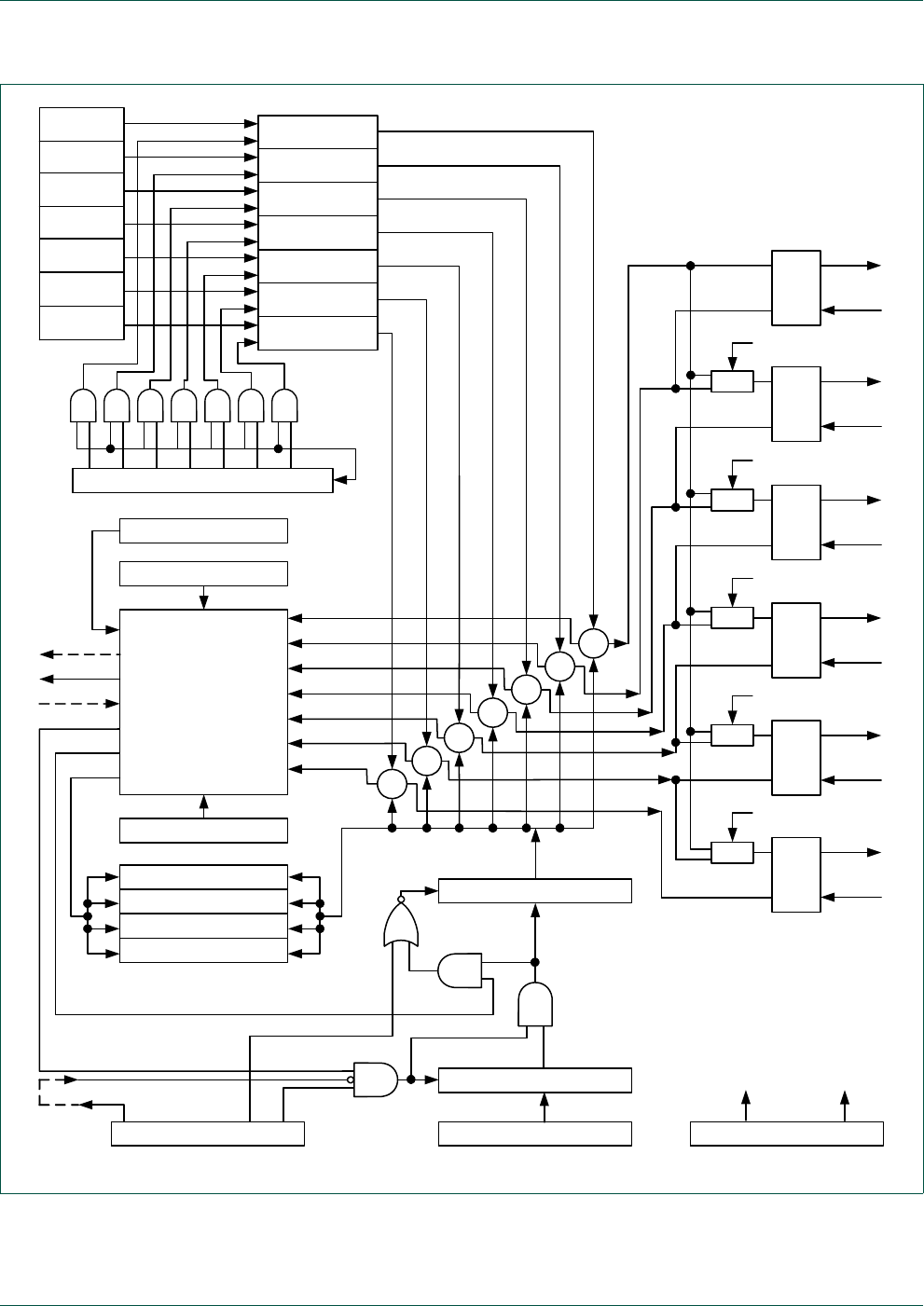
UM10360 All information provided in this document is subject to legal disclaimers. © NXP B.V. 2014. All rights reserved.
User manual Rev. 3.1 — 2 April 2014 520 of 849
NXP Semiconductors UM10360
Chapter 24: LPC176x/5x Pulse Width Modulator (PWM)
Fig 120. PWM block diagram
LOAD ENABLE REGISTER CLEAR
Match 0
CONTROL
M[6:0]
INTERRUPT
STOP ON MATCH
RESET ON MATCH
CAPTURE[1:0]
CAPTURE CONTROL REGISTER
LOAD[1:0] =
=
=
=
=
=
=
PWMSEL2..6
MUX
MUX
MUX
MUX
MUX
PWMSEL2
PWMSEL3
PWMSEL4
PWMSEL5
PWMSEL6
Match 0
Match 1
Match 3
Match 4
Match 5
Match 6
Match 2
TIMER CONTROL REGISTER
PRESCALE REGISTER
PWM CONTROL REGISTER
PRESCALE COUNTER
TIMER COUNTER
PWMENA1..6
MAXVAL
TCI
CE
CSN
enable
reset
master
disable
MATCH CONTROL REGISTER
INTERRUPT REGISTER
PWM6
PWM5
PWM4
PWM3
PWM2
PWM1
MATCH
REGISTER 3
MATCH
REGISTER 2
MATCH
REGISTER 0
MATCH
REGISTER 4
MATCH
REGISTER 5
MATCH
REGISTER 6
MATCH
REGISTER 1
CAPTURE REGISTER 0
CAPTURE REGISTER 1
RESERVED
RESERVED
PWMENA6
PWMENA5
PWMENA4
PWMENA3
PWMENA2
PWMENA1
SHADOW REGISTER 6
LOAD ENABLE
SHADOW REGISTER 5
LOAD ENABLE
SHADOW REGISTER 3
LOAD ENABLE
SHADOW REGISTER 2
LOAD ENABLE
SHADOW REGISTER 0
LOAD ENABLE
SHADOW REGISTER 4
LOAD ENABLE
SHADOW REGISTER 1
LOAD ENABLE
R
SQ
EN
R
SQ
EN
R
SQ
EN
R
SQ
EN
R
SQ
EN
R
SQ
EN
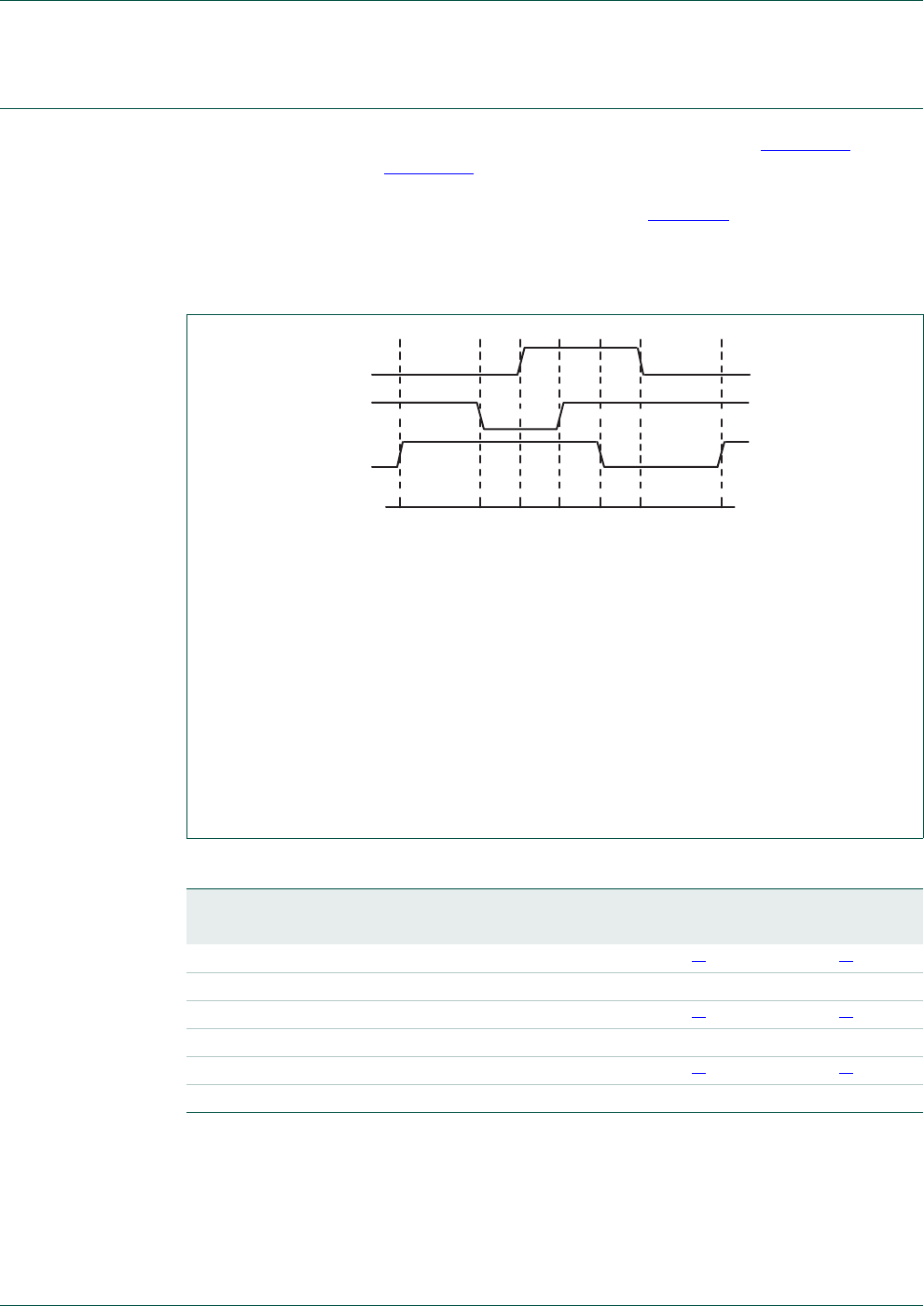
UM10360 All information provided in this document is subject to legal disclaimers. © NXP B.V. 2014. All rights reserved.
User manual Rev. 3.1 — 2 April 2014 521 of 849
NXP Semiconductors UM10360
Chapter 24: LPC176x/5x Pulse Width Modulator (PWM)
24.4 Sample waveform with rules for single and double edge control
A sample of how PWM values relate to waveform outputs is shown in Figure 121. PWM
output logic is shown in Figure 120 that allows selection of either single or double edge
controlled PWM outputs via the muxes controlled by the PWMSELn bits. The match
register selections for various PWM outputs is shown in Tabl e 4 4 4 . This implementation
supports up to N-1 single edge PWM outputs or (N-1)/2 double edge PWM outputs, where
N is the number of match registers that are implemented. PWM types can be mixed if
desired.
[1] Identical to single edge mode in this case since Match 0 is the neighboring match register. Essentially,
PWM1 cannot be a double edged output.
[2] It is generally not advantageous to use PWM channels 3 and 5 for double edge PWM outputs because it
would reduce the number of double edge PWM outputs that are possible. Using PWM 2, PWM4, and
PWM6 for double edge PWM outputs provides the most pairings.
The waveforms show one PWM cycle and demonstrate PWM outputs under the following
conditions:
The timer is configured for PWM mode (counter resets to 1).
Match 0 is configured to reset the timer/counter when a match event occurs.
Control bits PWMSEL2 and PWMSEL4 are set.
The Match register values are as follows:
MR0 = 100 (PWM rate)
MR1 = 41, MR2 = 78 (PWM2 output)
MR3 = 53, MR4 = 27 (PWM4 output)
MR5 = 65 (PWM5 output)
Fig 121. Sample PWM waveforms
Table 444. Set and reset inputs for PWM Flip-Flops
PWM Channel Single Edge PWM (PWMSELn = 0) Double Edge PWM (PWMSELn = 1)
Set by Reset by Set by Reset by
1 Match 0 Match 1 Match 0[1] Match 1[1]
2Match 0 Match 2 Match 1 Match 2
3 Match 0 Match 3 Match 2[2] Match 3[2]
4Match 0 Match 4 Match 3 Match 4
5 Match 0 Match 5 Match 4[2] Match 5[2]
6Match 0 Match 6 Match 5 Match 6
PWM2
PWM4
PWM5
100
(counter is reset)
1 27 41 53 65 78

UM10360 All information provided in this document is subject to legal disclaimers. © NXP B.V. 2014. All rights reserved.
User manual Rev. 3.1 — 2 April 2014 522 of 849
NXP Semiconductors UM10360
Chapter 24: LPC176x/5x Pulse Width Modulator (PWM)
24.4.1 Rules for Single Edge Controlled PWM Outputs
1. All single edge controlled PWM outputs go high at the beginning of a PWM cycle
unless their match value is equal to 0.
2. Each PWM output will go low when its match value is reached. If no match occurs (i.e.
the match value is greater than the PWM rate), the PWM output remains continuously
high.
24.4.2 Rules for Double Edge Controlled PWM Outputs
Five rules are used to determine the next value of a PWM output when a new cycle is
about to begin:
1. The match values for the next PWM cycle are used at the end of a PWM cycle (a time
point which is coincident with the beginning of the next PWM cycle), except as noted
in rule 3.
2. A match value equal to 0 or the current PWM rate (the same as the Match channel 0
value) have the same effect, except as noted in rule 3. For example, a request for a
falling edge at the beginning of the PWM cycle has the same effect as a request for a
falling edge at the end of a PWM cycle.
3. When match values are changing, if one of the "old" match values is equal to the
PWM rate, it is used again once if the neither of the new match values are equal to 0
or the PWM rate, and there was no old match value equal to 0.
4. If both a set and a clear of a PWM output are requested at the same time, clear takes
precedence. This can occur when the set and clear match values are the same as in,
or when the set or clear value equals 0 and the other value equals the PWM rate.
5. If a match value is out of range (i.e. greater than the PWM rate value), no match event
occurs and that match channel has no effect on the output. This means that the PWM
output will remain always in one state, allowing always low, always high, or
"no change" outputs.
24.5 Pin description
Tab l e 4 45 gives a brief summary of each of PWM related pins.
Table 445. Pin summary
Pin Type Description
PWM1[1] Output Output from PWM channel 1.
PWM1[2] Output Output from PWM channel 2.
PWM1[3] Output Output from PWM channel 3.
PWM1[4] Output Output from PWM channel 4.
PWM1[5] Output Output from PWM channel 5.
PWM1[6] Output Output from PWM channel 6.
PCAP1[1:0] Input Capture Inputs. A transition on a capture pin can be configured to load
the corresponding Capture Register with the value of the Timer
Counter and optionally generate an interrupt. The PWM brings out 2
capture inputs.

UM10360 All information provided in this document is subject to legal disclaimers. © NXP B.V. 2014. All rights reserved.
User manual Rev. 3.1 — 2 April 2014 523 of 849
NXP Semiconductors UM10360
Chapter 24: LPC176x/5x Pulse Width Modulator (PWM)
Effective processing of the externally supplied clock to the counter has some limitations.
Since two successive rising edges of the PCLK clock are used to identify only one edge
on the CAP selected input, the frequency of the CAP input can not exceed one quarter of
the PCLK clock. Consequently, duration of the high/low levels on the same CAP input in
this case can not be shorter than 1/(2 PCLK).
24.6 Register description
The PWM1 function includes registers as shown in Tab l e 44 6 below.
Table 446. PWM1 register map
Generic
Name
Description Access Reset
Value[1]
PWMn Register
Name & Address
IR Interrupt Register. The IR can be written to clear interrupts. The IR can be
read to identify which of eight possible interrupt sources are pending.
R/W 0 PWM1IR -
0x4001 8000
TCR Timer Control Register. The TCR is used to control the Timer Counter
functions. The Timer Counter can be disabled or reset through the TCR.
R/W 0 PWM1TCR -
0x4001 8004
TC Timer Counter. The 32-bit TC is incremented every PR+1 cycles of PCLK.
The TC is controlled through the TCR.
R/W 0 PWM1TC -
0x4001 8008
PR Prescale Register. The TC is incremented every PR+1 cycles of PCLK. R/W 0 PWM1PR -
0x4001 800C
PC Prescale Counter. The 32-bit PC is a counter which is incremented to the
value stored in PR. When the value in PR is reached, the TC is
incremented. The PC is observable and controllable through the bus
interface.
R/W 0 PWM1PC -
0x4001 8010
MCR Match Control Register. The MCR is used to control if an interrupt is
generated and if the TC is reset when a Match occurs.
R/W 0 PWM1MCR -
0x4001 8014
MR0 Match Register 0. MR0 can be enabled in the MCR to reset the TC, stop
both the TC and PC, and/or generate an interrupt when it matches the TC.
In addition, a match between this value and the TC sets any PWM output
that is in single-edge mode, and sets PWM1 if it’s in double-edge mode.
R/W 0 PWM1MR0 -
0x4001 8018
MR1 Match Register 1. MR1 can be enabled in the MCR to reset the TC, stop
both the TC and PC, and/or generate an interrupt when it matches the TC.
In addition, a match between this value and the TC clears PWM1 in either
edge mode, and sets PWM2 if it’s in double-edge mode.
R/W 0 PWM1MR1 -
0x4001 801C
MR2 Match Register 2. MR2 can be enabled in the MCR to reset the TC, stop
both the TC and PC, and/or generate an interrupt when it matches the TC.
In addition, a match between this value and the TC clears PWM2 in either
edge mode, and sets PWM3 if it’s in double-edge mode.
R/W 0 PWM1MR2 -
0x4001 8020
MR3 Match Register 3. MR3 can be enabled in the MCR to reset the TC, stop
both the TC and PC, and/or generate an interrupt when it matches the TC.
In addition, a match between this value and the TC clears PWM3 in either
edge mode, and sets PWM4 if it’s in double-edge mode.
R/W 0 PWM1MR3 -
0x4001 8024
CCR Capture Control Register. The CCR controls which edges of the capture
inputs are used to load the Capture Registers and whether or not an
interrupt is generated when a capture takes place.
R/W 0 PWM1CCR -
0x4001 8028
CR0 Capture Register 0. CR0 is loaded with the value of the TC when there is
an event on the CAPn.0 input.
RO 0 PWM1CR0 -
0x4001 802C
CR1 Capture Register 1. See CR0 description. RO 0 PWM1CR1 -
0x4001 8030
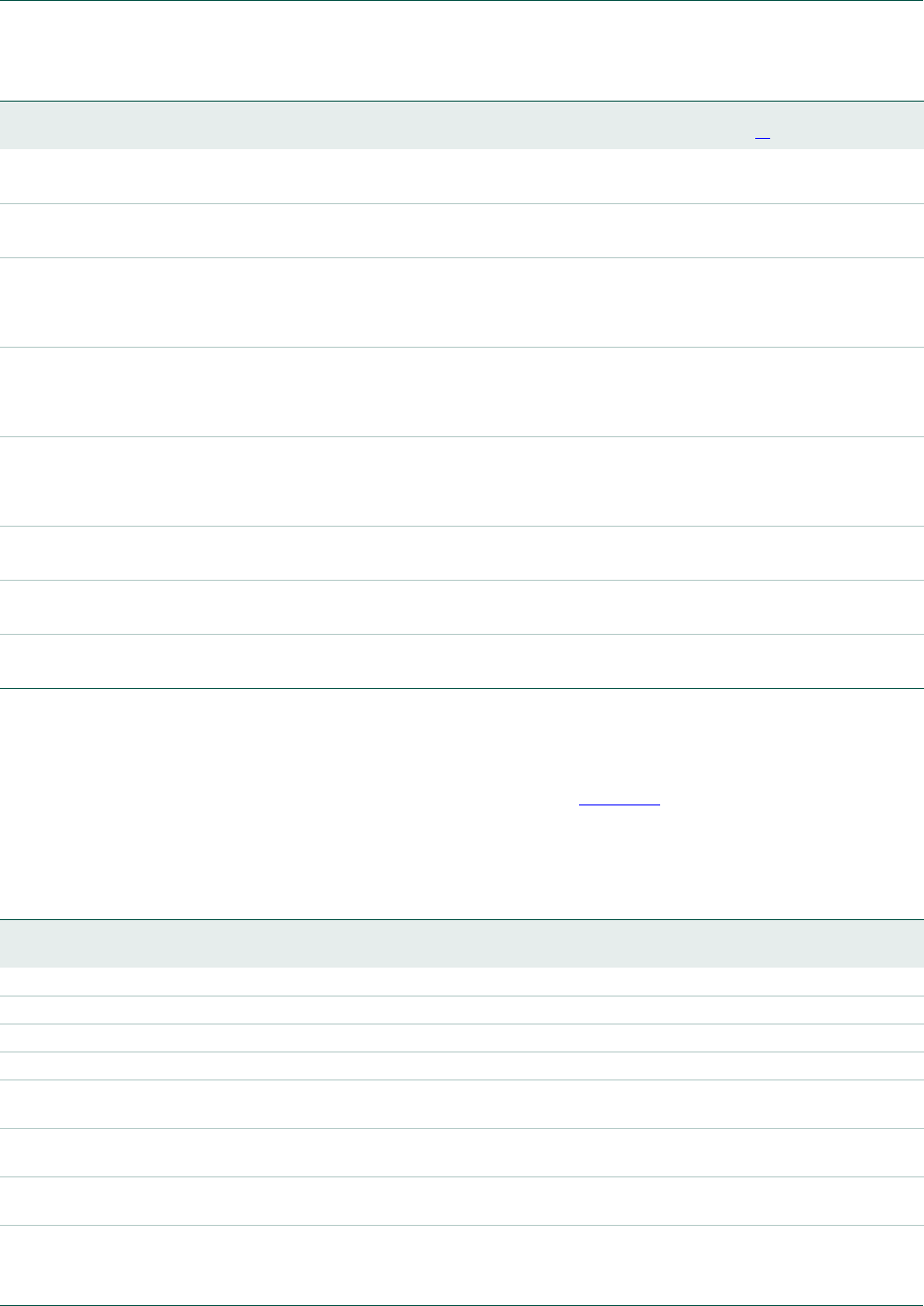
UM10360 All information provided in this document is subject to legal disclaimers. © NXP B.V. 2014. All rights reserved.
User manual Rev. 3.1 — 2 April 2014 524 of 849
NXP Semiconductors UM10360
Chapter 24: LPC176x/5x Pulse Width Modulator (PWM)
[1] Reset Value reflects the data stored in used bits only. It does not include reserved bits content.
24.6.1 PWM Interrupt Register (PWM1IR - 0x4001 8000)
The PWM Interrupt Register consists of 11 bits (Ta b l e 4 47 ), 7 for the match interrupts and
4 reserved for the future use. If an interrupt is generated then the corresponding bit in the
PWMIR will be high. Otherwise, the bit will be low. Writing a logic 1 to the corresponding
IR bit will reset the interrupt. Writing a 0 has no effect.
CR2 Capture Register 2. See CR0 description. RO 0 PWM1CR2 -
0x4001 8034
CR3 Capture Register 3. See CR0 description. RO 0 PWM1CR3 -
0x4001 8038
MR4 Match Register 4. MR4 can be enabled in the MCR to reset the TC, stop
both the TC and PC, and/or generate an interrupt when it matches the TC.
In addition, a match between this value and the TC clears PWM4 in either
edge mode, and sets PWM5 if it’s in double-edge mode.
R/W 0 PWM1MR4 -
0x4001 8040
MR5 Match Register 5. MR5 can be enabled in the MCR to reset the TC, stop
both the TC and PC, and/or generate an interrupt when it matches the TC.
In addition, a match between this value and the TC clears PWM5 in either
edge mode, and sets PWM6 if it’s in double-edge mode.
R/W 0 PWM1MR5 -
0x4001 8044
MR6 Match Register 6. MR6 can be enabled in the MCR to reset the TC, stop
both the TC and PC, and/or generate an interrupt when it matches the TC.
In addition, a match between this value and the TC clears PWM6 in either
edge mode.
R/W 0 PWM1MR6 -
0x4001 8048
PCR PWM Control Register. Enables PWM outputs and selects PWM channel
types as either single edge or double edge controlled.
R/W 0 PWM1PCR -
0x4001 804C
LER Load Enable Register. Enables use of new PWM match values. R/W 0 PWM1LER -
0x4001 8050
CTCR Count Control Register. The CTCR selects between Timer and Counter
mode, and in Counter mode selects the signal and edge(s) for counting.
R/W 0 PWM1CTCR -
0x4001 8070
Table 446. PWM1 register map …continued
Generic
Name
Description Access Reset
Value[1]
PWMn Register
Name & Address
Table 447: PWM Interrupt Register (PWM1IR - address 0x4001 8000) bit description
Bit Symbol Description Reset
Value
0PWMMR0 InterruptInterrupt flag for PWM match channel 0. 0
1PWMMR1 InterruptInterrupt flag for PWM match channel 1. 0
2PWMMR2 InterruptInterrupt flag for PWM match channel 2. 0
3PWMMR3 InterruptInterrupt flag for PWM match channel 3. 0
4PWMCAP0
Interrupt
Interrupt flag for capture input 0 0
5PWMCAP1
Interrupt
Interrupt flag for capture input 1. 0
7:6 - Reserved, user software should not write ones to reserved bits. The value read from a
reserved bit is not defined.
NA
8PWMMR4 InterruptInterrupt flag for PWM match channel 4. 0
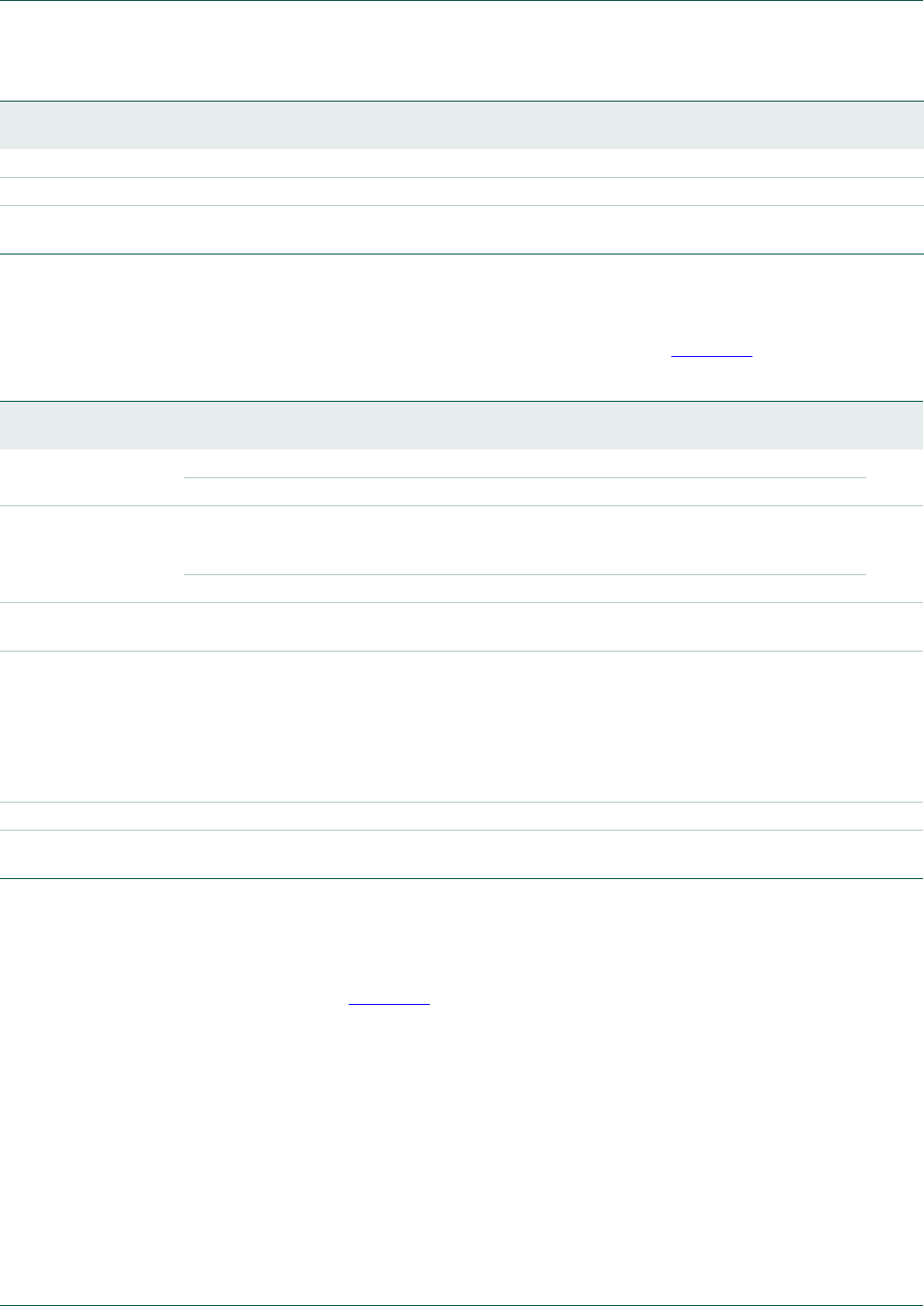
UM10360 All information provided in this document is subject to legal disclaimers. © NXP B.V. 2014. All rights reserved.
User manual Rev. 3.1 — 2 April 2014 525 of 849
NXP Semiconductors UM10360
Chapter 24: LPC176x/5x Pulse Width Modulator (PWM)
24.6.2 PWM Timer Control Register (PWM1TCR 0x4001 8004)
The PWM Timer Control Register (PWMTCR) is used to control the operation of the PWM
Timer Counter. The function of each of the bits is shown in Ta b l e 4 4 8 .
24.6.3 PWM Count Control Register (PWM1CTCR - 0x4001 8070)
The Count Control Register (CTCR) is used to select between Timer and Counter mode,
and in Counter mode to select the pin and edge(s) for counting. The function of each of
the bits is shown in Tab l e 449.
9PWMMR5 InterruptInterrupt flag for PWM match channel 5. 0
10 PWMMR6 Interrupt Interrupt flag for PWM match channel 6. 0
31:11 - Reserved, user software should not write ones to reserved bits. The value read from a
reserved bit is not defined.
NA
Table 447: PWM Interrupt Register (PWM1IR - address 0x4001 8000) bit description …continued
Bit Symbol Description Reset
Value
Table 448. PWM Timer Control Register (PWM1TCR address 0x4001 8004) bit description
Bit Symbol Value Description Reset
Value
0Counter Enable1 The PWM Timer Counter and PWM Prescale Counter are enabled for counting. 0
0The counters are disabled.
1Counter Reset1 The PWM Timer Counter and the PWM Prescale Counter are synchronously reset
on the next positive edge of PCLK. The counters remain reset until this bit is
returned to zero.
0
0Clear reset.
2- Reserved, user software should not write ones to reserved bits. The value read
from a reserved bit is not defined.
NA
3PWM Enable1 PWM mode is enabled (counter resets to 1). PWM mode causes the shadow
registers to operate in connection with the Match registers. A program write to a
Match register will not have an effect on the Match result until the corresponding bit
in PWMLER has been set, followed by the occurrence of a PWM Match 0 event.
Note that the PWM Match register that determines the PWM rate (PWM Match
Register 0 - MR0) must be set up prior to the PWM being enabled. Otherwise a
Match event will not occur to cause shadow register contents to become effective.
0
0Timer mode is enabled (counter resets to 0).
31:4 - Reserved, user software should not write ones to reserved bits. The value read
from a reserved bit is not defined.
NA

UM10360 All information provided in this document is subject to legal disclaimers. © NXP B.V. 2014. All rights reserved.
User manual Rev. 3.1 — 2 April 2014 526 of 849
NXP Semiconductors UM10360
Chapter 24: LPC176x/5x Pulse Width Modulator (PWM)
24.6.4 PWM Match Control Register (PWM1MCR - 0x4001 8014)
The PWM Match Control Registers are used to control what operations are performed
when one of the PWM Match Registers matches the PWM Timer Counter. The function of
each of the bits is shown in Ta b le 4 5 0 .
Table 449. PWM Count control Register (PWM1CTCR - address 0x4001 8070) bit description
Bit Symbol Value Description Reset
Value
1:0 Counter/
Timer Mode
00 Timer Mode: the TC is incremented when the Prescale Counter matches the Prescale
Register.
00
01 Counter Mode: the TC is incremented on rising edges of the PCAP input selected by
bits 3:2.
10 Counter Mode: the TC is incremented on falling edges of the PCAP input selected by
bits 3:2.
11 Counter Mode: the TC is incremented on both edges of the PCAP input selected by
bits 3:2.
3:2 Count Input
Select
When bits 1:0 of this register are not 00, these bits select which PCAP pin which
carries the signal used to increment the TC.
00
00 PCAP1.0
01 PCAP1.1 (Other combinations are reserved)
31:4 - Reserved, user software should not write ones to reserved bits. The value read from a
reserved bit is not defined.
NA
Table 450: Match Control Register (PWM1MCR - address 0x4001 8014) bit description
Bit Symbol Value Description Reset
Value
0PWMMR0I1Interrupt on PWMMR0: an interrupt is generated when PWMMR0 matches the value in
the PWMTC.
0
0This interrupt is disabled.
1PWMMR0R1Reset on PWMMR0: the PWMTC will be reset if PWMMR0 matches it. 0
0This feature is disabled.
2PWMMR0S1Stop on PWMMR0: the PWMTC and PWMPC will be stopped and PWMTCR[0] will be
set to 0 if PWMMR0 matches the PWMTC.
0
0This feature is disabled
3PWMMR1I1Interrupt on PWMMR1: an interrupt is generated when PWMMR1 matches the value in
the PWMTC.
0
0This interrupt is disabled.
4PWMMR1R1Reset on PWMMR1: the PWMTC will be reset if PWMMR1 matches it. 0
0This feature is disabled.
5PWMMR1S1Stop on PWMMR1: the PWMTC and PWMPC will be stopped and PWMTCR[0] will be
set to 0 if PWMMR1 matches the PWMTC.
0
0This feature is disabled.
6PWMMR2I1Interrupt on PWMMR2: an interrupt is generated when PWMMR2 matches the value in
the PWMTC.
0
0This interrupt is disabled.
7PWMMR2R1Reset on PWMMR2: the PWMTC will be reset if PWMMR2 matches it. 0
0This feature is disabled.

UM10360 All information provided in this document is subject to legal disclaimers. © NXP B.V. 2014. All rights reserved.
User manual Rev. 3.1 — 2 April 2014 527 of 849
NXP Semiconductors UM10360
Chapter 24: LPC176x/5x Pulse Width Modulator (PWM)
24.6.5 PWM Capture Control Register (PWM1CCR - 0x4001 8028)
The Capture Control Register is used to control whether one of the four Capture Registers
is loaded with the value in the Timer Counter when a capture event occurs, and whether
an interrupt is generated by the capture event. Setting both the rising and falling bits at the
same time is a valid configuration, resulting in a capture event for both edges. In the
descriptions below, “n” represents the Timer number, 0 or 1.
8PWMMR2S1Stop on PWMMR2: the PWMTC and PWMPC will be stopped and PWMTCR[0] will be
set to 0 if PWMMR2 matches the PWMTC.
0
0This feature is disabled
9PWMMR3I1Interrupt on PWMMR3: an interrupt is generated when PWMMR3 matches the value in
the PWMTC.
0
0This interrupt is disabled.
10 PWMMR3R 1 Reset on PWMMR3: the PWMTC will be reset if PWMMR3 matches it. 0
0This feature is disabled
11 PWMMR3S 1 Stop on PWMMR3: The PWMTC and PWMPC will be stopped and PWMTCR[0] will
be set to 0 if PWMMR3 matches the PWMTC.
0
0This feature is disabled
12 PWMMR4I 1 Interrupt on PWMMR4: An interrupt is generated when PWMMR4 matches the value
in the PWMTC.
0
0This interrupt is disabled.
13 PWMMR4R 1 Reset on PWMMR4: the PWMTC will be reset if PWMMR4 matches it. 0
0This feature is disabled.
14 PWMMR4S 1 Stop on PWMMR4: the PWMTC and PWMPC will be stopped and PWMTCR[0] will be
set to 0 if PWMMR4 matches the PWMTC.
0
0This feature is disabled
15 PWMMR5I 1 Interrupt on PWMMR5: An interrupt is generated when PWMMR5 matches the value
in the PWMTC.
0
0This interrupt is disabled.
16 PWMMR5R 1 Reset on PWMMR5: the PWMTC will be reset if PWMMR5 matches it. 0
0This feature is disabled.
17 PWMMR5S 1 Stop on PWMMR5: the PWMTC and PWMPC will be stopped and PWMTCR[0] will be
set to 0 if PWMMR5 matches the PWMTC.
0
0This feature is disabled
18 PWMMR6I 1 Interrupt on PWMMR6: an interrupt is generated when PWMMR6 matches the value in
the PWMTC.
0
0This interrupt is disabled.
19 PWMMR6R 1 Reset on PWMMR6: the PWMTC will be reset if PWMMR6 matches it. 0
0This feature is disabled.
20 PWMMR6S 1 Stop on PWMMR6: the PWMTC and PWMPC will be stopped and PWMTCR[0] will be
set to 0 if PWMMR6 matches the PWMTC.
0
31:21 - Reserved, user software should not write ones to reserved bits. The value read from a
reserved bit is not defined.
NA
Table 450: Match Control Register (PWM1MCR - address 0x4001 8014) bit description …continued
Bit Symbol Value Description Reset
Value
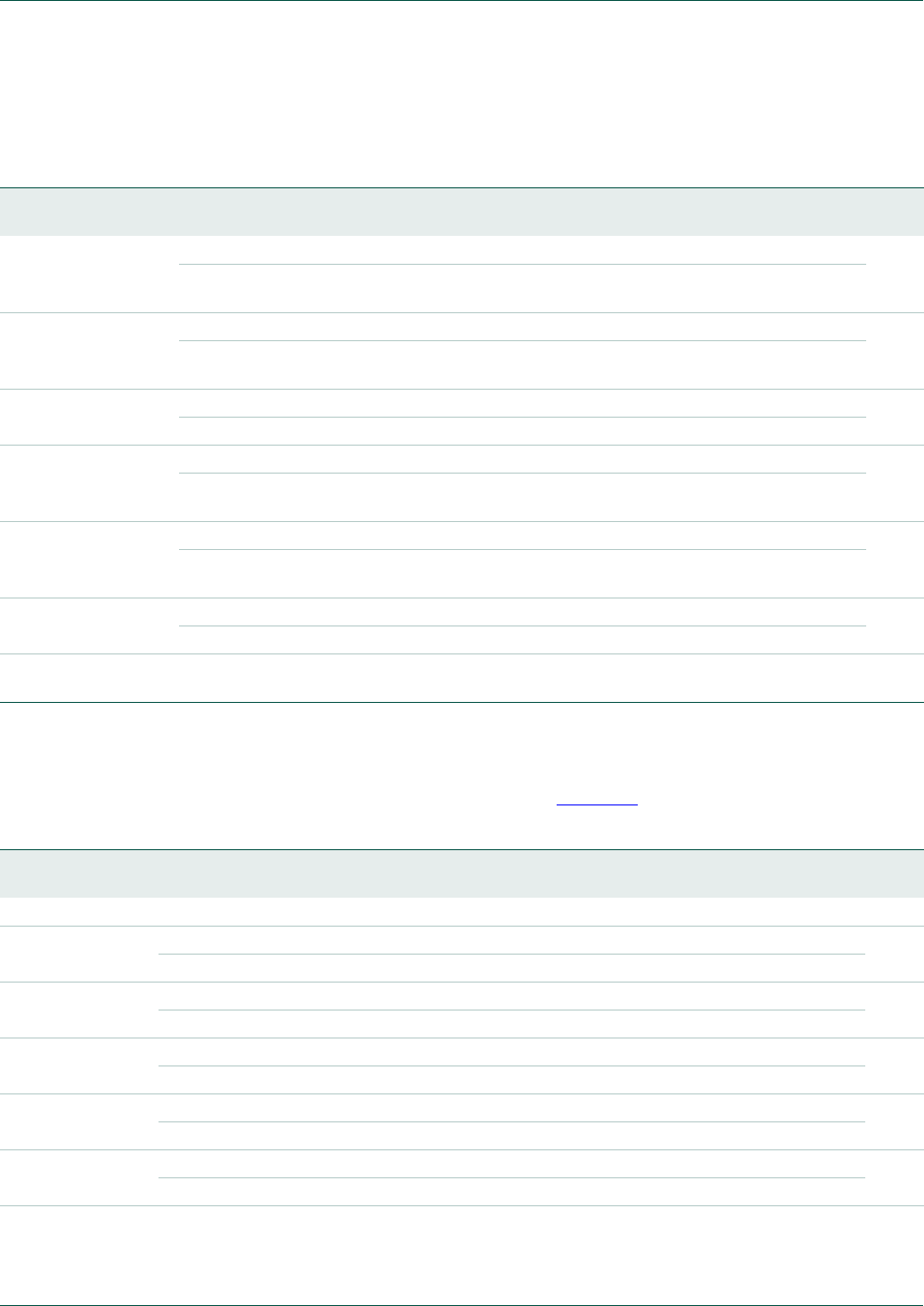
UM10360 All information provided in this document is subject to legal disclaimers. © NXP B.V. 2014. All rights reserved.
User manual Rev. 3.1 — 2 April 2014 528 of 849
NXP Semiconductors UM10360
Chapter 24: LPC176x/5x Pulse Width Modulator (PWM)
Note: If Counter mode is selected for a particular CAP input in the CTCR, the 3 bits for
that input in this register should be programmed as 000, but capture and/or interrupt can
be selected for the other 3 CAP inputs.
24.6.6 PWM Control Register (PWM1PCR - 0x4001 804C)
The PWM Control Register is used to enable and select the type of each PWM channel.
The function of each of the bits are shown in Table 452 .
Table 451: PWM Capture Control Register (PWM1CCR - address 0x4001 8028) bit description
Bit Symbol Value Description Reset
Value
0Capture on
CAPn.0 rising
edge
0This feature is disabled. 0
1A synchronously sampled rising edge on the CAPn.0 input will cause CR0 to be
loaded with the contents of the TC.
1Capture on
CAPn.0 falling
edge
0This feature is disabled. 0
1A synchronously sampled falling edge on CAPn.0 will cause CR0 to be loaded with
the contents of TC.
2Interrupt on
CAPn.0 event
0This feature is disabled. 0
1A CR0 load due to a CAPn.0 event will generate an interrupt.
3Capture on
CAPn.1rising
edge
0This feature is disabled. 0
1A synchronously sampled rising edge on the CAPn.1 input will cause CR1 to be
loaded with the contents of the TC.
4Capture on
CAPn.1falling
edge
0This feature is disabled. 0
1A synchronously sampled falling edge on CAPn.1 will cause CR1 to be loaded with
the contents of TC.
5Interrupt on
CAPn.1 event
0This feature is disabled. 0
1A CR1 load due to a CAPn.1 event will generate an interrupt.
31:6 - Reserved, user software should not write ones to reserved bits. The value read from
a reserved bit is not defined.
NA
Table 452: PWM Control Register (PWM1PCR - address 0x4001 804C) bit description
Bit Symbol Value Description Reset
Value
1:0 Unused Unused, always zero. NA
2PWMSEL21Selects double edge controlled mode for the PWM2 output. 0
0Selects single edge controlled mode for PWM2.
3PWMSEL31Selects double edge controlled mode for the PWM3 output. 0
0Selects single edge controlled mode for PWM3.
4PWMSEL41Selects double edge controlled mode for the PWM4 output. 0
0Selects single edge controlled mode for PWM4.
5PWMSEL51Selects double edge controlled mode for the PWM5 output. 0
0Selects single edge controlled mode for PWM5.
6PWMSEL61Selects double edge controlled mode for the PWM6 output. 0
0Selects single edge controlled mode for PWM6.
8:7 - Reserved, user software should not write ones to reserved bits. The value read from a
reserved bit is not defined.
NA

UM10360 All information provided in this document is subject to legal disclaimers. © NXP B.V. 2014. All rights reserved.
User manual Rev. 3.1 — 2 April 2014 529 of 849
NXP Semiconductors UM10360
Chapter 24: LPC176x/5x Pulse Width Modulator (PWM)
24.6.7 PWM Latch Enable Register (PWM1LER - 0x4001 8050)
The PWM Latch Enable Registers are used to control the update of the PWM Match
registers when they are used for PWM generation. When software writes to the location of
a PWM Match register while the Timer is in PWM mode, the value is captured, but not
used immediately.
When a PWM Match 0 event occurs (normally also resetting the timer in PWM mode), the
contents of shadow registers will be transferred to the shadow registers if the
corresponding bit in the Latch Enable Register has been set. At that point, the new values
will take effect and determine the course of the next PWM cycle. Once the transfer of new
values has taken place, all bits of the LER are automatically cleared. Until the
corresponding bit in the PWMLER is set and a PWM Match 0 event occurs, any value
written to the PWM Match registers has no effect on PWM operation.
For example, if PWM2 is configured for double edge operation and is currently running, a
typical sequence of events for changing the timing would be:
•Write a new value to the PWM Match1 register.
•Write a new value to the PWM Match2 register.
•Write to the PWMLER, setting bits 1 and 2 at the same time.
•The altered values will become effective at the next reset of the timer (when a PWM
Match 0 event occurs).
The order of writing the two PWM Match registers is not important, since neither value will
be used until after the write to LER. This insures that both values go into effect at the
same time, if that is required. A single value may be altered in the same way if needed.
The function of each of the bits in the LER is shown in Tab le 45 3 .
9PWMENA11The PWM1 output enabled. 0
0The PWM1 output disabled.
10 PWMENA2 1 The PWM2 output enabled. 0
0The PWM2 output disabled.
11 PWMENA3 1 The PWM3 output enabled. 0
0The PWM3 output disabled.
12 PWMENA4 1 The PWM4 output enabled. 0
0The PWM4 output disabled.
13 PWMENA5 1 The PWM5 output enabled. 0
0The PWM5 output disabled.
14 PWMENA6 1 The PWM6 output enabled. 0
0The PWM6 output disabled.
31:15 Unused Unused, always zero. NA
Table 452: PWM Control Register (PWM1PCR - address 0x4001 804C) bit description …continued
Bit Symbol Value Description Reset
Value
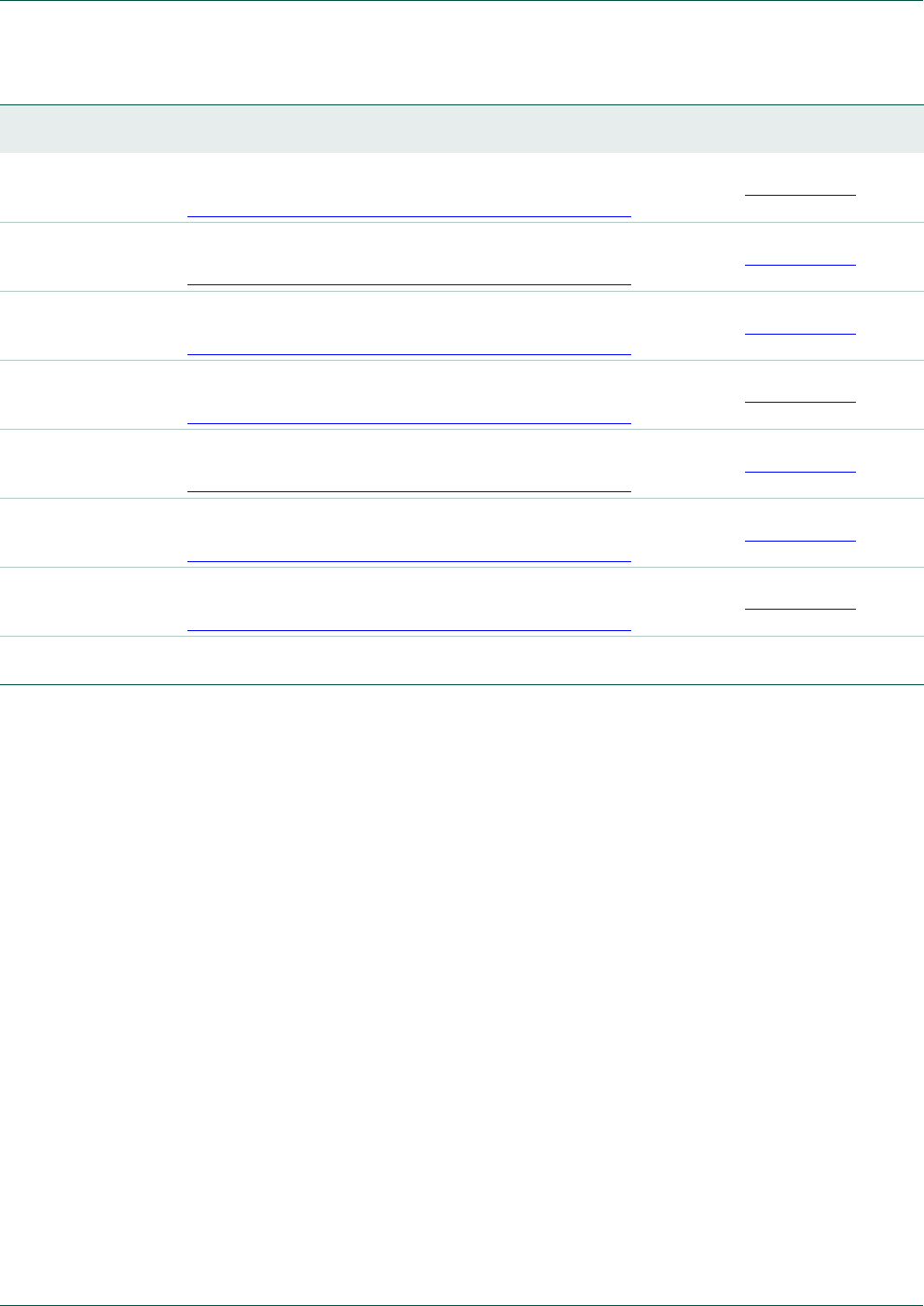
UM10360 All information provided in this document is subject to legal disclaimers. © NXP B.V. 2014. All rights reserved.
User manual Rev. 3.1 — 2 April 2014 530 of 849
NXP Semiconductors UM10360
Chapter 24: LPC176x/5x Pulse Width Modulator (PWM)
Table 453: PWM Latch Enable Register (PWM1LER - address 0x4001 8050) bit description
Bit Symbol Description Reset
Value
0Enable PWM
Match 0 Latch
Writing a one to this bit allows the last value written to the PWM Match 0 register to be
become effective when the timer is next reset by a PWM Match event. See Section 24.6.4
“PWM Match Control Register (PWM1MCR - 0x4001 8014)”.
0
1Enable PWM
Match 1 Latch
Writing a one to this bit allows the last value written to the PWM Match 1 register to be
become effective when the timer is next reset by a PWM Match event. See Section 24.6.4
“PWM Match Control Register (PWM1MCR - 0x4001 8014)”.
0
2Enable PWM
Match 2 Latch
Writing a one to this bit allows the last value written to the PWM Match 2 register to be
become effective when the timer is next reset by a PWM Match event. See Section 24.6.4
“PWM Match Control Register (PWM1MCR - 0x4001 8014)”.
0
3Enable PWM
Match 3 Latch
Writing a one to this bit allows the last value written to the PWM Match 3 register to be
become effective when the timer is next reset by a PWM Match event. See Section 24.6.4
“PWM Match Control Register (PWM1MCR - 0x4001 8014)”.
0
4Enable PWM
Match 4 Latch
Writing a one to this bit allows the last value written to the PWM Match 4 register to be
become effective when the timer is next reset by a PWM Match event. See Section 24.6.4
“PWM Match Control Register (PWM1MCR - 0x4001 8014)”.
0
5Enable PWM
Match 5 Latch
Writing a one to this bit allows the last value written to the PWM Match 5 register to be
become effective when the timer is next reset by a PWM Match event. See Section 24.6.4
“PWM Match Control Register (PWM1MCR - 0x4001 8014)”.
0
6Enable PWM
Match 6 Latch
Writing a one to this bit allows the last value written to the PWM Match 6 register to be
become effective when the timer is next reset by a PWM Match event. See Section 24.6.4
“PWM Match Control Register (PWM1MCR - 0x4001 8014)”.
0
31:7 - Reserved, user software should not write ones to reserved bits. The value read from a
reserved bit is not defined.
NA

UM10360 All information provided in this document is subject to legal disclaimers. © NXP B.V. 2014. All rights reserved.
User manual Rev. 3.1 — 2 April 2014 531 of 849
25.1 Introduction
The Motor Control PWM (MCPWM) is optimized for three-phase AC and DC motor control
applications, but can be used in many other applications that need timing, counting,
capture, and comparison.
25.2 Description
The MCPWM contains three independent channels, each including:
•a 32-bit Timer/Counter (TC)
•a 32-bit Limit register (LIM)
•a 32-bit Match register (MAT)
•a 10-bit dead-time register (DT) and an associated 10-bit dead-time counter
•a 32-bit capture register (CAP)
•two modulated outputs (MCOA and MCOB) with opposite polarities
•a period interrupt, a pulse-width interrupt, and a capture interrupt
Input pins MCI0-2 can trigger TC capture or increment a channel’s TC. A global Abort
input can force all of the channels into “A passive” state and cause an interrupt.
25.3 Pin description
Tab l e 4 54 lists the MCPWM pins.
UM10360
Chapter 25: LPC176x/5x Motor control PWM
Rev. 3.1 — 2 April 2014 User manual
Table 454. Pin summary
Pin Type Description
MCOA0, MCOA1, MCOA2 O Output A for channels 0, 1, 2
MCOB0, MCOB1, MCOB2 O Output B for channels 0, 1, 2
MCABORT ILow-active Fast Abort
MCI0, MCI1, MCI2 I Input for channels 0, 1, 2
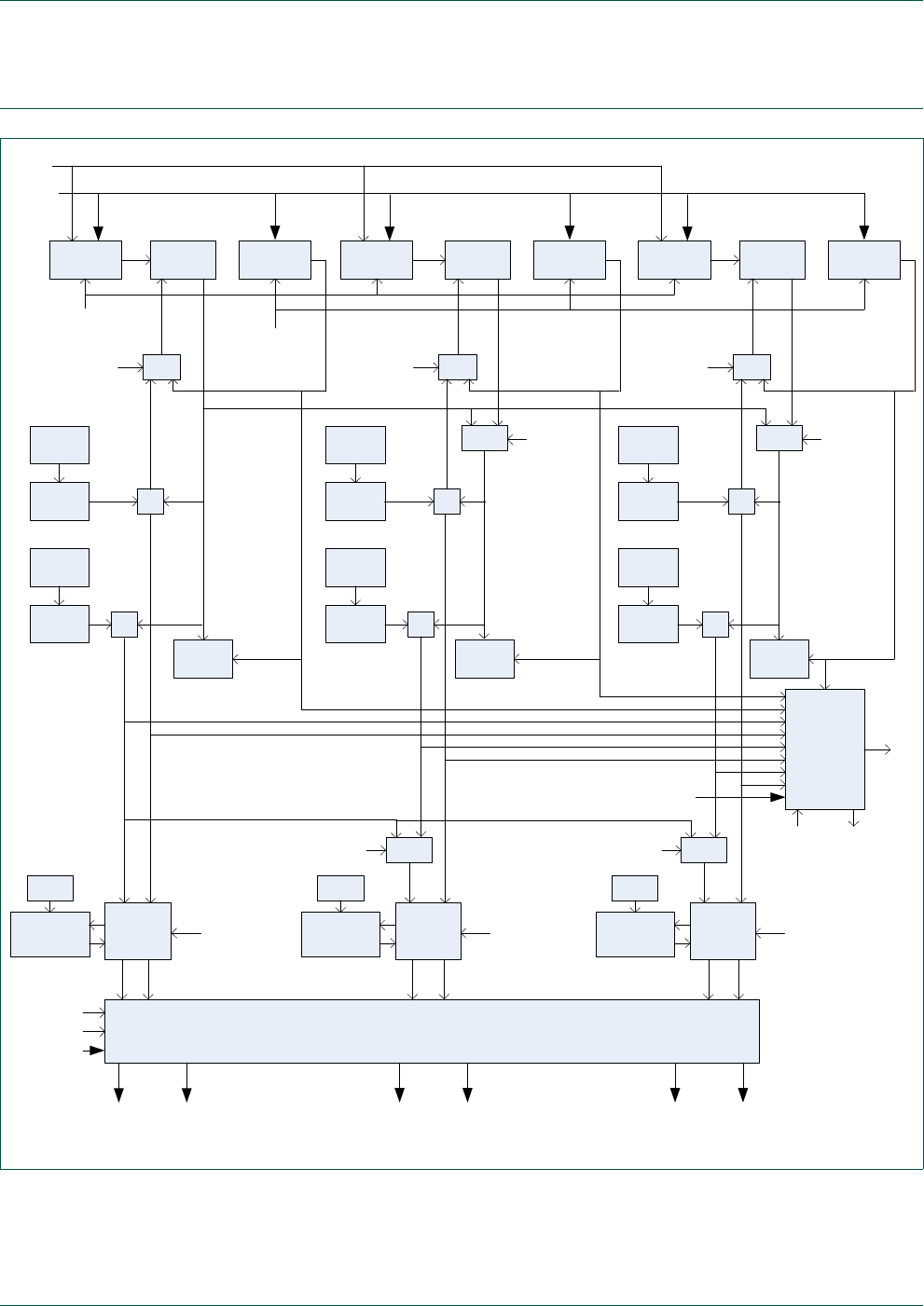
UM10360 All information provided in this document is subject to legal disclaimers. © NXP B.V. 2014. All rights reserved.
User manual Rev. 3.1 — 2 April 2014 532 of 849
NXP Semiconductors UM10360
Chapter 25: LPC176x/5x Motor control PWM
25.4 Block Diagram
Fig 122. MCPWM Block Diagram
Clock
selection
PCLK
MCI0-2
Clock
selection
Clock
selection
TC0 Event
selection TC1 Event
selection TC2 Event
selection
MCCNTCON
MCCAPCON
=
MAT0
(oper )
MAT0
(write)
LIM0
(oper )
LIM0
(write)
=
CAP0
channel
output
control
dead-time
counter
DT0
A0 B0
MCCON
RT0 cntl
=
MAT1
(oper)
MAT1
(write)
LIM1
(oper)
LIM1
(write)
=
CAP1
channel
output
control
dead-time
counter
DT1
A1 B1
MCCON
RT1
MAT2
(oper )
MAT2
(write)
LIM2
(oper )
LIM2
(write)
global output control
MCCON
MCCP
MCABORT
MCOA0 MCOB0 MCOA1 MCOB1 MCOA2 MCOB2
mux ACMODE
cntl cntl
=
=
CAP2
channel
output
control
dead-time
counter
DT2
A2 B2
MCCON
RT2
mux ACMODE
interrupt
logic
MCABORT
MCINTEN MCINTF
mux mux
ACMODE ACMODE

UM10360 All information provided in this document is subject to legal disclaimers. © NXP B.V. 2014. All rights reserved.
User manual Rev. 3.1 — 2 April 2014 533 of 849
NXP Semiconductors UM10360
Chapter 25: LPC176x/5x Motor control PWM
25.5 Configuring other modules for MCPWM use
Configure the following registers in other modules before using the Motor Control PWM:
1. Power: in the PCONP register (Tabl e 4 6), set bit PCMCPWM.
Remark: On reset the MCPWM is disabled (PCMCPWM = 0).
2. Peripheral clock: in the PCLKSEL1 register (Tab le 40 ) select PCLK_MCPWM.
3. Pins: select MCPWM functions through the PINSEL registers. Select modes for these
pins through the PINMODE registers (Section 8.5).
4. Interrupts: See Section 25.7.3 for motor control PWM related interrupts. Interrupts can
be enabled in the NVIC using the appropriate Interrupt Set Enable register.
25.6 General Operation
Section 25.8 includes detailed descriptions of the various modes of MCPWM operation,
but a quick preview here will provide background for the register descriptions below.
The MCPWM includes 3 channels, each of which controls a pair of outputs that in turn can
control something off-chip, like one set of coils in a motor. Each channel includes a
Timer/Counter (TC) register that is incremented by a processor clock (timer mode) or by
an input pin (counter mode).
Each channel has a Limit register that is compared to the TC value, and when a match
occurs the TC is “recycled” in one of two ways. In “edge-aligned mode” the TC is reset to
0, while in “centered mode” a match switches the TC into a state in which it decrements on
each processor clock or input pin transition until it reaches 0, at which time it starts
counting up again.
Each channel also includes a Match register that holds a smaller value than the Limit
register. In edge-aligned mode the channel’s outputs are switched whenever the TC
matches either the Match or Limit register, while in center-aligned mode they are switched
only when it matches the Match register.
So the Limit register controls the period of the outputs, while the Match register controls
how much of each period the outputs spend in each state. Having a small value in the
Limit register minimizes “ripple” if the output is integrated into a voltage, and allows the
MCPWM to control devices that operate at high speed.
The “downside” of small values in the Limit register is that they reduce the resolution of
the duty cycle controlled by the Match register. If you have 8 in the Limit register, the
Match register can only select the duty cycle among 0%, 12.5%, 25%, …, 87.5%, or
100%. In general, the resolution of each step in the Match value is 1 divided by the Limit
value.
This trade-off between resolution and period/frequency is inherent in the design of pulse
width modulators.

UM10360 All information provided in this document is subject to legal disclaimers. © NXP B.V. 2014. All rights reserved.
User manual Rev. 3.1 — 2 April 2014 534 of 849
NXP Semiconductors UM10360
Chapter 25: LPC176x/5x Motor control PWM
25.7 Register description
“Control” registers and “interrupt” registers have separate read, set, and clear addresses.
Reading such a register’s read address(e.g. MCCON) yields the state of the register bits.
Writing ones to the set address (e.g. MCCON_SET) sets register bit(s), and writing ones
to the clear address (e.g. MCCON_CLR) clears register bit(s).
The Capture registers (MCCAP) are read-only, and the write-only MCCAP_CLR address
can be used to clear one or more of them. All the other MCPWM registers (MCTIM,
MCPER, MCPW, MCDEADTIME, and MCCP) are normal read-write registers.
Table 455. Motor Control Pulse Width Modulator (MCPWM) register map
Name Description Access Reset value Address
MCCON PWM Control read address RO 00x400B 8000
MCCON_SET PWM Control set address WO -0x400B 8004
MCCON_CLR PWM Control clear address WO -0x400B 8008
MCCAPCON Capture Control read address RO 00x400B 800C
MCCAPCON_SET Capture Control set address WO -0x400B 8010
MCCAPCON_CLR Event Control clear address WO -0x400B 8014
MCTC0 Timer Counter register, channel 0 R/W 00x400B 8018
MCTC1 Timer Counter register, channel 1 R/W 00x400B 801C
MCTC2 Timer Counter register, channel 2 R/W 00x400B 8020
MCLIM0 Limit register, channel 0 R/W 0xFFFF FFFF 0x400B 8024
MCLIM1 Limit register, channel 1 R/W 0xFFFF FFFF 0x400B 8028
MCLIM2 Limit register, channel 2 R/W 0xFFFF FFFF 0x400B 802C
MCMAT0 Match register, channel 0 R/W 0xFFFF FFFF 0x400B 8030
MCMAT1 Match register, channel 1 R/W 0xFFFF FFFF 0x400B 8034
MCMAT2 Match register, channel 2 R/W 0xFFFF FFFF 0x400B 8038
MCDT Dead time register R/W 0x3FFF FFFF 0x400B 803C
MCCP Commutation Pattern register R/W 00x400B 8040
MCCAP0 Capture register, channel 0 RO 00x400B 8044
MCCAP1 Capture register, channel 1 RO 00x400B 8048
MCCAP2 Capture register, channel 2 RO 00x400B 804C
MCINTEN Interrupt Enable read address RO 00x400B 8050
MCINTEN_SET Interrupt Enable set address WO -0x400B 8054
MCINTEN_CLR Interrupt Enable clear address WO -0x400B 8058
MCCNTCON Count Control read address RO 00x400B 805C
MCCNTCON_SET Count Control set address WO -0x400B 8060
MCCNTCON_CLR Count Control clear address WO -0x400B 8064
MCINTF Interrupt flags read address RO 00x400B 8068
MCINTF_SET Interrupt flags set address WO -0x400B 806C
MCINTF_CLR Interrupt flags clear address WO -0x400B 8070
MCCAP_CLR Capture clear address WO -0x400B 8074
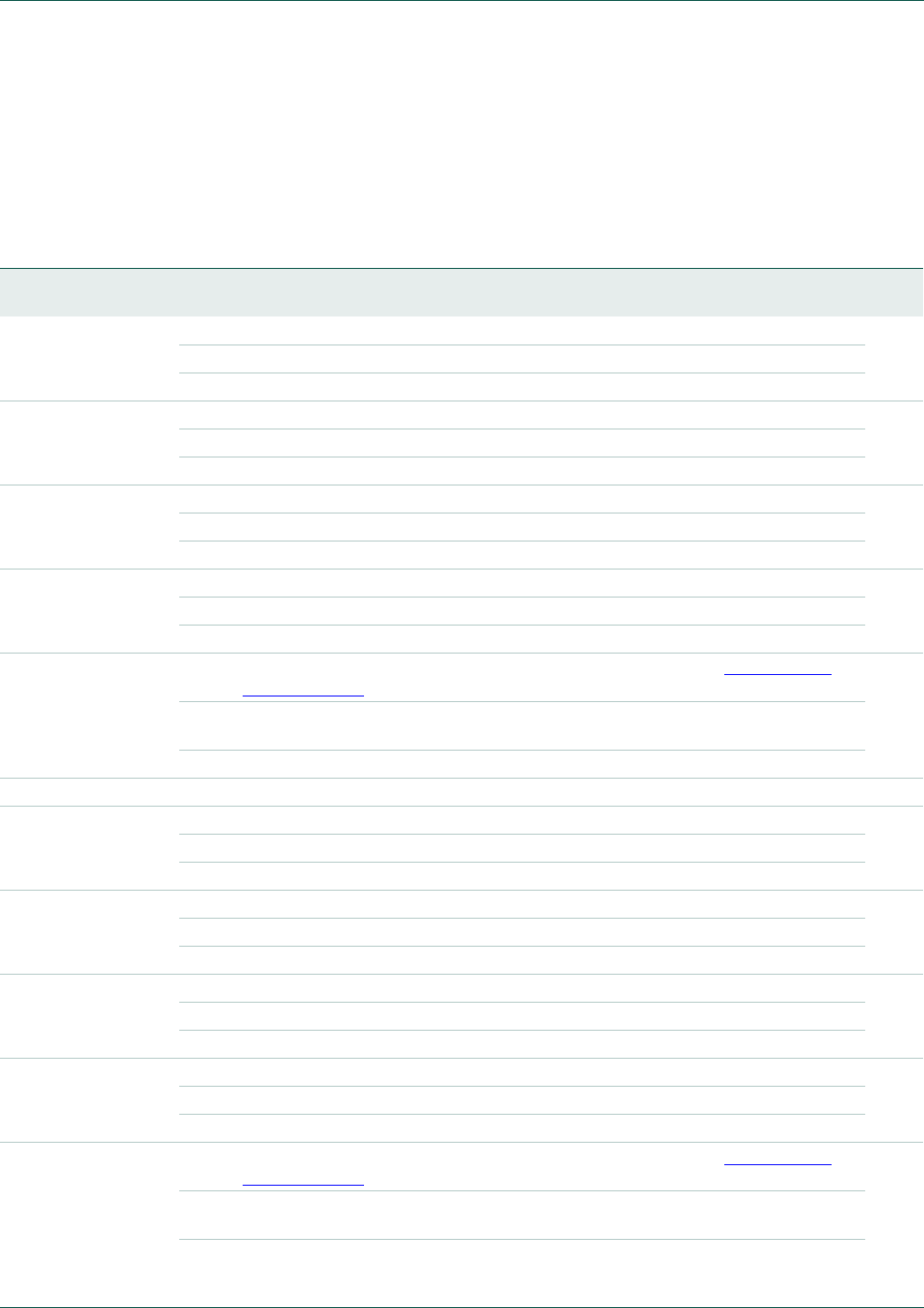
UM10360 All information provided in this document is subject to legal disclaimers. © NXP B.V. 2014. All rights reserved.
User manual Rev. 3.1 — 2 April 2014 535 of 849
NXP Semiconductors UM10360
Chapter 25: LPC176x/5x Motor control PWM
25.7.1 MCPWM Control register
25.7.1.1 MCPWM Control read address (MCCON - 0x400B 8000)
The MCCON register controls the operation of all channels of the PWM. This address is
read-only, but the underlying register can be modified by writing to addresses
MCCON_SET and MCCON_CLR.
Table 456. MCPWM Control read address (MCCON - 0x400B 8000) bit description
Bit Symbol Value Description Reset
value
0RUN0 Stops/starts timer channel 0. 0
0Stop.
1Run.
1CENTER0 Edge/center aligned operation for channel 0. 0
0Edge-aligned.
1Center-aligned.
2POLA0 Selects polarity of the MCOA0 and MCOB0 pins. 0
0Passive state is LOW, active state is HIGH.
1Passive state is HIGH, active state is LOW.
3DTE0 Controls the dead-time feature for channel 0. 0
0Dead-time disabled.
1Dead-time enabled.
4DISUP0 Enable/disable updates of functional registers for channel 0 (see Section 25.8.2,
Section 25.7.6.1).
0
0Functional registers are updated from the write registers at the end of each PWM
cycle.
1Functional registers remain the same as long as the timer is running.
7:5 - - Reserved.
8RUN1 Stops/starts timer channel 1. 0
0Stop.
1Run.
9CENTER1 Edge/center aligned operation for channel 1. 0
0Edge-aligned.
1Center-aligned.
10 POLA1 Selects polarity of the MCOA1 and MCOB1 pins. 0
0Passive state is LOW, active state is HIGH.
1Passive state is HIGH, active state is LOW.
11 DTE1 Controls the dead-time feature for channel 1. 0
0Dead-time disabled.
1Dead-time enabled.
12 DISUP1 Enable/disable updates of functional registers for channel 1 (see Section 25.8.2,
Section 25.7.6.1).
0
0Functional registers are updated from the write registers at the end of each PWM
cycle.
1Functional registers remain the same as long as the timer is running.

UM10360 All information provided in this document is subject to legal disclaimers. © NXP B.V. 2014. All rights reserved.
User manual Rev. 3.1 — 2 April 2014 536 of 849
NXP Semiconductors UM10360
Chapter 25: LPC176x/5x Motor control PWM
25.7.1.2 MCPWM Control set address (MCCON_SET - 0x400B 8004)
Writing ones to this write-only address sets the corresponding bits in MCCON.
15:13 - -Reserved. 0
16 RUN2 Stops/starts timer channel 2. 0
0Stop.
1Run.
17 CENTER2 Edge/center aligned operation for channel 2. 0
0Edge-aligned.
1Center-aligned.
18 POLA2 Selects polarity of the MCOA2 and MCOB2 pins. 0
0Passive state is LOW, active state is HIGH.
1Passive state is HIGH, active state is LOW.
19 DTE2 Controls the dead-time feature for channel 1. 0
0Dead-time disabled.
1Dead-time enabled.
20 DISUP2 Enable/disable updates of functional registers for channel 2 (see Section 25.8.2,
Section 25.7.6.1).
0
0Functional registers are updated from the write registers at the end of each PWM
cycle.
1Functional registers remain the same as long as the timer is running.
28:21 - - Reserved.
29 INVBDC Controls the polarity of the MCOB outputs for all 3 channels. This bit is typically set
to 1 only in 3-phase DC mode.
0The MCOB outputs have opposite polarity from the MCOA outputs (aside from
dead time).
1The MCOB outputs have the same basic polarity as the MCOA outputs. (see
Section 25.8.6)
30 ACMODE 3-phase AC mode select (see Section 25.8.7). 0
03-phase AC-mode off: Each PWM channel uses its own timer-counter and period
register.
13-phase AC-mode on: All PWM channels use the timer-counter and period register
of channel 0.
31 DCMODE 3-phase DC mode select (see Section 25.8.6). 0
03-phase DC mode off: PWM channels are independent (unless bit ACMODE = 1)
13-phase DC mode on: The internal MCOA0 output is routed through the MCCP (i.e.
a mask) register to all six PWM outputs.
Table 456. MCPWM Control read address (MCCON - 0x400B 8000) bit description …continued
Bit Symbol Value Description Reset
value
Table 457. MCPWM Control set address (MCCON_SET - 0x400B 8004) bit description
Bit Description
31:0 Writing ones to this address sets the corresponding bits in the MCCON register. See Tab l e 45 6 .
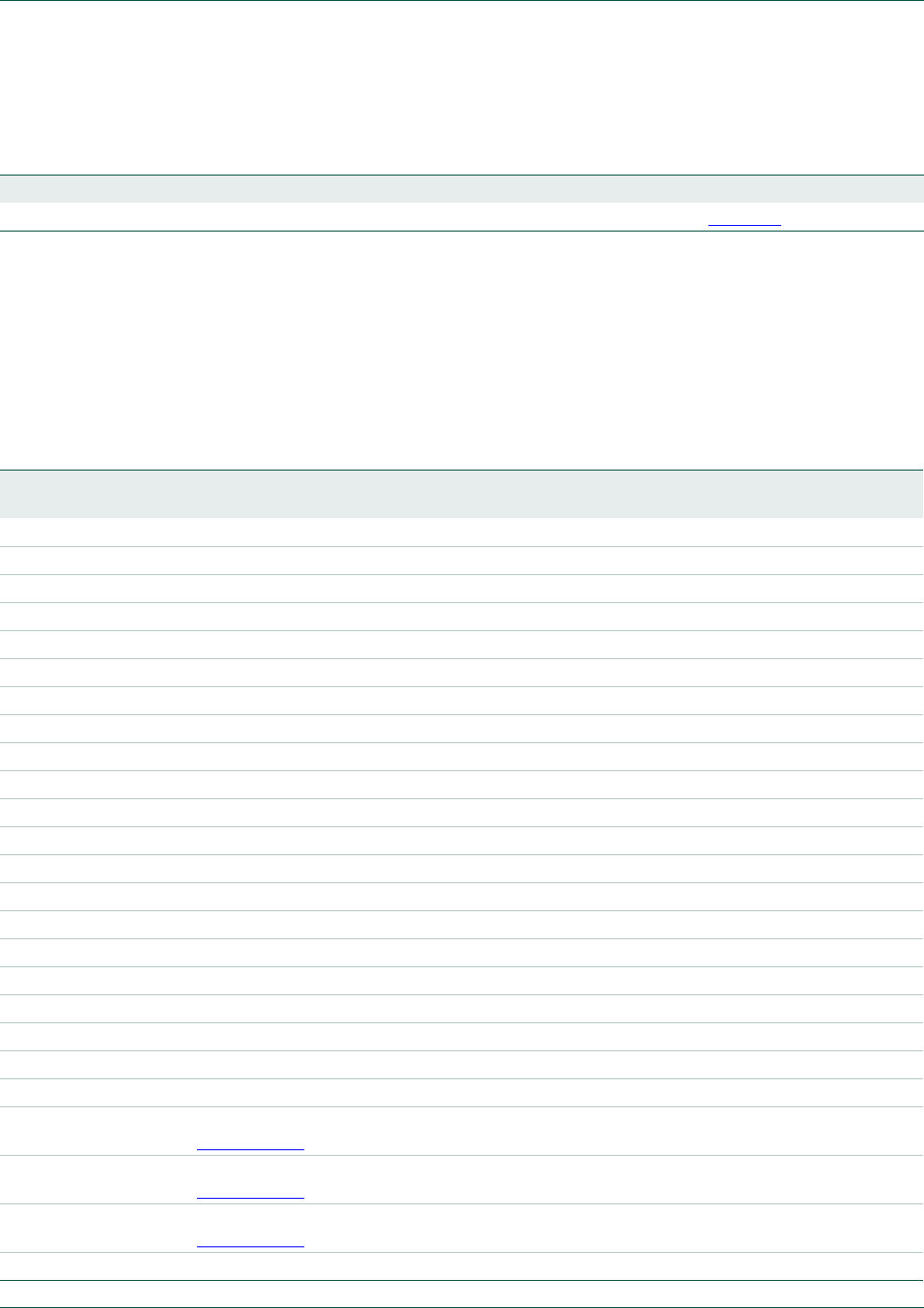
UM10360 All information provided in this document is subject to legal disclaimers. © NXP B.V. 2014. All rights reserved.
User manual Rev. 3.1 — 2 April 2014 537 of 849
NXP Semiconductors UM10360
Chapter 25: LPC176x/5x Motor control PWM
25.7.1.3 MCPWM Control clear address (MCCON_CLR - 0x400B 8008)
Writing ones to this write-only address clears the corresponding bits in MCCON.
25.7.2 MCPWM Capture Control register
25.7.2.1 MCPWM Capture Control read address (MCCAPCON - 0x400B 800C)
The MCCAPCON register controls detection of events on the MCI0-2 inputs for all
MCPWM channels. Any of the three MCI inputs can be used to trigger a capture event on
any or all of the three channels. This address is read-only, but the underlying register can
be modified by writing to addresses MCCAPCON_SET and MCCAPCON_CLR.
Table 458. MCPWM Control clear address (MCCON_CLR - 0x400B 8008) bit description
Bit Description
31:0 Writing ones to this address clears the corresponding bits in the MCCON register. See Ta b l e 45 6 .
Table 459. MCPWM Capture Control read address (MCCAPCON - 0x400B 800C) bit description
Bit Symbol Description Reset
Value
0 CAP0MCI0_RE A 1 in this bit enables a channel 0 capture event on a rising edge on MCI0. 0
1 CAP0MCI0_FE A 1 in this bit enables a channel 0 capture event on a falling edge on MCI0. 0
2 CAP0MCI1_RE A 1 in this bit enables a channel 0 capture event on a rising edge on MCI1. 0
3 CAP0MCI1_FE A 1 in this bit enables a channel 0 capture event on a falling edge on MCI1. 0
4 CAP0MCI2_RE A 1 in this bit enables a channel 0 capture event on a rising edge on MCI2. 0
5 CAP0MCI2_FE A 1 in this bit enables a channel 0 capture event on a falling edge on MCI2. 0
6 CAP1MCI0_RE A 1 in this bit enables a channel 1 capture event on a rising edge on MCI0. 0
7 CAP1MCI0_FE A 1 in this bit enables a channel 1 capture event on a falling edge on MCI0. 0
8 CAP1MCI1_RE A 1 in this bit enables a channel 1 capture event on a rising edge on MCI1. 0
9 CAP1MCI1_FE A 1 in this bit enables a channel 1 capture event on a falling edge on MCI1. 0
10 CAP1MCI2_RE A 1 in this bit enables a channel 1 capture event on a rising edge on MCI2. 0
11 CAP1MCI2_FE A 1 in this bit enables a channel 1 capture event on a falling edge on MCI2. 0
12 CAP2MCI0_RE A 1 in this bit enables a channel 2 capture event on a rising edge on MCI0. 0
13 CAP2MCI0_FE A 1 in this bit enables a channel 2 capture event on a falling edge on MCI0. 0
14 CAP2MCI1_RE A 1 in this bit enables a channel 2 capture event on a rising edge on MCI1. 0
15 CAP2MCI1_FE A 1 in this bit enables a channel 2 capture event on a falling edge on MCI1. 0
16 CAP2MCI2_RE A 1 in this bit enables a channel 2 capture event on a rising edge on MCI2. 0
17 CAP2MCI2_FE A 1 in this bit enables a channel 2 capture event on a falling edge on MCI2. 0
18 RT0 If this bit is 1, TC0 is reset by a channel 0 capture event. 0
19 RT1 If this bit is 1, TC1 is reset by a channel 1 capture event. 0
20 RT2 If this bit is 1, TC2 is reset by a channel 2 capture event. 0
21 HNFCAP0 Hardware noise filter: if this bit is 1, channel 0 capture events are delayed as described in
Section 25.8.4.
0
22 HNFCAP1 Hardware noise filter: if this bit is 1, channel 1 capture events are delayed as described in
Section 25.8.4.
0
23 HNFCAP2 Hardware noise filter: if this bit is 1, channel 2 capture events are delayed as described in
Section 25.8.4.
0
31:24 - Reserved. -
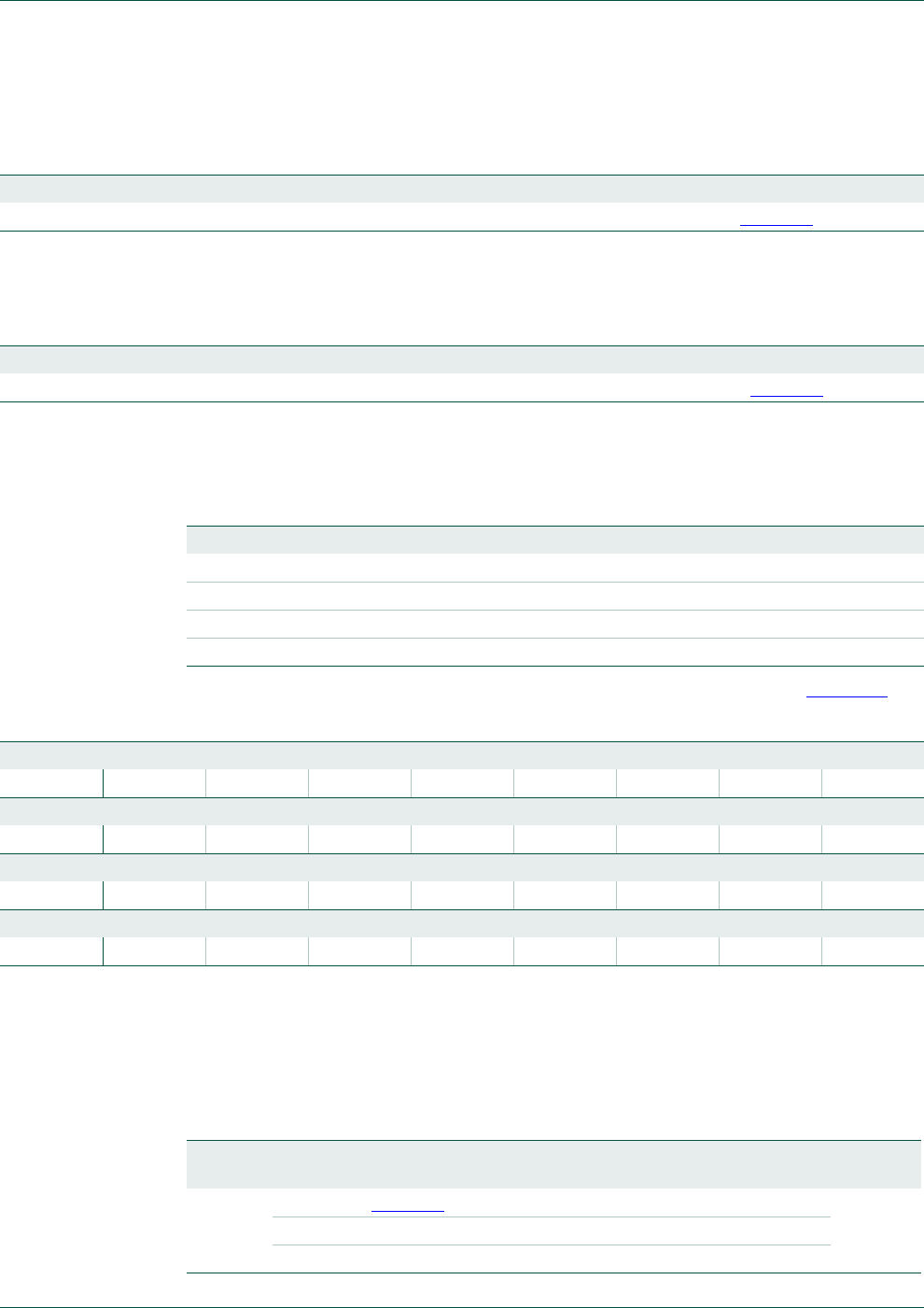
UM10360 All information provided in this document is subject to legal disclaimers. © NXP B.V. 2014. All rights reserved.
User manual Rev. 3.1 — 2 April 2014 538 of 849
NXP Semiconductors UM10360
Chapter 25: LPC176x/5x Motor control PWM
25.7.2.2 MCPWM Capture Control set address (MCCAPCON_SET - 0x400B 8010)
Writing ones to this write-only address sets the corresponding bits in MCCAPCON.
25.7.2.3 MCPWM Capture control clear address (MCCAPCON_CLR - 0x400B 8014)
Writing ones to this write-only address clears the corresponding bits in MCCAPCON.
25.7.3 MCPWM Interrupt registers
The Motor Control PWM module includes the following interrupt sources:
All MCPWM interrupt registers contain one bit for each source as shown in Tab l e 4 63 .
7.3.1 MCPWM Interrupt Enable read address (MCINTEN - 0x400B 8050)
The MCINTEN register controls which of the MCPWM interrupts are enabled. This
address is read-only, but the underlying register can be modified by writing to addresses
MCINTEN_SET and MCINTEN_CLR.
Table 460. MCPWM Capture Control set address (MCCAPCON_SET - 0x400B 8010) bit description
Bit Description
31:0 Writing ones to this address sets the corresponding bits in the MCCAPCON register. See Ta b l e 459.
Table 461. MCPWM Capture control clear register (MCCAPCON_CLR - address 0x400B 8014) bit description
Bit Description
31:0 Writing ones to this address clears the corresponding bits in the MCCAPCON register. See Tab l e 4 59.
Table 462. Motor Control PWM interrupts
Symbol Description
ILIM0/1/2 Limit interrupts for channels 0, 1, 2.
IMAT0/1/2 Match interrupts for channels 0, 1, 2.
ICAP0/1/2 Capture interrupts for channels 0, 1, 2.
ABORT Fast abort interrupt
Table 463. Interrupt sources bit allocation table
Bit 31 30 29 28 27 26 25 24
Symbol --------
Bit 23 22 21 20 19 18 17 16
Symbol --------
Bit 15 14 13 12 11 10 9 8
Symbol ABORT - - - -ICAP2IMAT2ILIM2
Bit 7 6 5 4 3 2 1 0
Symbol -ICAP1IMAT1ILIM1 -ICAP0IMAT0ILIM0
Table 464. MCPWM Interrupt Enable read address (MCINTEN - 0x400B 8050) bit description
Bit Value Description Reset
value
31:0 See Tab l e 4 6 3 for the bit allocation. 0
1Interrupt enabled.
0Interrupt disabled.

UM10360 All information provided in this document is subject to legal disclaimers. © NXP B.V. 2014. All rights reserved.
User manual Rev. 3.1 — 2 April 2014 539 of 849
NXP Semiconductors UM10360
Chapter 25: LPC176x/5x Motor control PWM
25.7.3.2 MCPWM Interrupt Enable set address (MCINTEN_SET - 0x400B 8054)
Writing ones to this write-only address sets the corresponding bits in MCINTEN, thus
enabling interrupts.
25.7.3.3 MCPWM Interrupt Enable clear address (MCINTEN_CLR - 0x400B 8058)
Writing ones to this write-only address clears the corresponding bits in MCINTEN, thus
disabling interrupts.
25.7.3.4 MCPWM Interrupt Flags read address (MCINTF - 0x400B 8068)
The MCINTF register includes all MCPWM interrupt flags, which are set when the
corresponding hardware event occurs, or when ones are written to the MCINTF_SET
address. When corresponding bits in this register and MCINTEN are both 1, the MCPWM
asserts its interrupt request to the Interrupt Controller module. This address is read-only,
but the bits in the underlying register can be modified by writing ones to addresses
MCINTF_SET and MCINTF_CLR.
25.7.3.5 MCPWM Interrupt Flags set address (MCINTF_SET - 0x400B 806C)
Writing one(s) to this write-only address sets the corresponding bit(s) in MCINTF, thus
possibly simulating hardware interrupt(s).
25.7.3.6 MCPWM Interrupt Flags clear address (MCINTF_CLR - 0x400B 8070)
Writing one(s) to this write-only address sets the corresponding bit(s) in MCINTF, thus
clearing the corresponding interrupt request(s). This is typically done in interrupt service
routines.
Table 465. PWM interrupt enable set register (MCINTEN_SET - address 0x400B 8054) bit
description
Bit Description
31:0 Writing ones to this address sets the corresponding bits in MCINTEN, thus enabling
interrupts. See Table 4 6 3 .
Table 466. PWM interrupt enable clear register (MCINTEN_CLR - address 0x400B 8058) bit
description
Bit Description
31:0 Writing ones to this address clears the corresponding bits in MCINTEN, thus disabling
interrupts. See Table 4 6 3 .
Table 467. MCPWM Interrupt Flags read address (MCINTF - 0x400B 8068) bit description
Bit Value Description Reset
value
31:0 See Tab l e 4 63 for the bit allocation. 0
1If the corresponding bit in MCINTEN is 1, the MCPWM module is asserting its interrupt request to
the Interrupt Controller.
0This interrupt source is not contributing to the MCPWM interrupt request.
Table 468. MCPWM Interrupt Flags set address (PWMINTF_SET - 0x400B 806C) bit
description
Bit Description
31:0 Writing one(s) to this write-only address sets the corresponding bit(s) in the MCINTF
register, thus possibly simulating hardware interrupt(s). See Ta b l e 4 63 .

UM10360 All information provided in this document is subject to legal disclaimers. © NXP B.V. 2014. All rights reserved.
User manual Rev. 3.1 — 2 April 2014 540 of 849
NXP Semiconductors UM10360
Chapter 25: LPC176x/5x Motor control PWM
25.7.4 MCPWM Count Control register
25.7.4.1 MCPWM Count Control read address (MCCNTCON - 0x400B 805C)
The MCCNTCON register controls whether the MCPWM channels are in timer or counter
mode, and in counter mode whether the counter advances on rising and/or falling edges
on any or all of the three MCI inputs. If timer mode is selected, the counter advances
based on the PCLK clock.
This address is read-only. To set or clear the register bits, write ones to the
MCCNTCON_SET or MCCNTCON_CLR address.
Table 469. MCPWM Interrupt Flags clear address (PWMINTF_CLR - 0x400B 8070) bit
description
Bit Description
31:0 Writing one(s) to this write-only address sets the corresponding bit(s) in the MCINTF
register, thus clearing the corresponding interrupt request(s). See Ta b le 4 6 3 .
Table 470. MCPWM Count Control read address (MCCNTCON - 0x400B 805C) bit description
Bit Symbol Value Description Reset
Value
0TC0MCI0_RE1 If MODE0 is 1, counter 0 advances on a rising edge on MCI0. 0
0A rising edge on MCI0 does not affect counter 0.
1TC0MCI0_FE1 If MODE0 is 1, counter 0 advances on a falling edge on MCI0. 0
0A falling edge on MCI0 does not affect counter 0.
2TC0MCI1_RE1 If MODE0 is 1, counter 0 advances on a rising edge on MCI1. 0
0A rising edge on MCI1 does not affect counter 0.
3TC0MCI1_FE1 If MODE0 is 1, counter 0 advances on a falling edge on MCI1. 0
0A falling edge on MCI1 does not affect counter 0.
4TC0MCI2_RE1 If MODE0 is 1, counter 0 advances on a rising edge on MCI2. 0
0A rising edge on MCI0 does not affect counter 0.
5TC0MCI2_FE1 If MODE0 is 1, counter 0 advances on a falling edge on MCI2. 0
0A falling edge on MCI0 does not affect counter 0.
6TC1MCI0_RE1 If MODE1 is 1, counter 1 advances on a rising edge on MCI0. 0
0A rising edge on MCI0 does not affect counter 1.
7TC1MCI0_FE1 If MODE1 is 1, counter 1 advances on a falling edge on MCI0. 0
0A falling edge on MCI0 does not affect counter 1.
8TC1MCI1_RE1 If MODE1 is 1, counter 1 advances on a rising edge on MCI1. 0
0A rising edge on MCI1 does not affect counter 1.
9TC1MCI1_FE1 If MODE1 is 1, counter 1 advances on a falling edge on MCI1. 0
0A falling edge on MCI0 does not affect counter 1.
10 TC1MCI2_RE 1 If MODE1 is 1, counter 1 advances on a rising edge on MCI2. 0
0A rising edge on MCI2 does not affect counter 1.
11 TC1MCI2_FE 1 If MODE1 is 1, counter 1 advances on a falling edge on MCI2. 0
0A falling edge on MCI2 does not affect counter 1.
12 TC2MCI0_RE 1 If MODE2 is 1, counter 2 advances on a rising edge on MCI0. 0
0A rising edge on MCI0 does not affect counter 2.
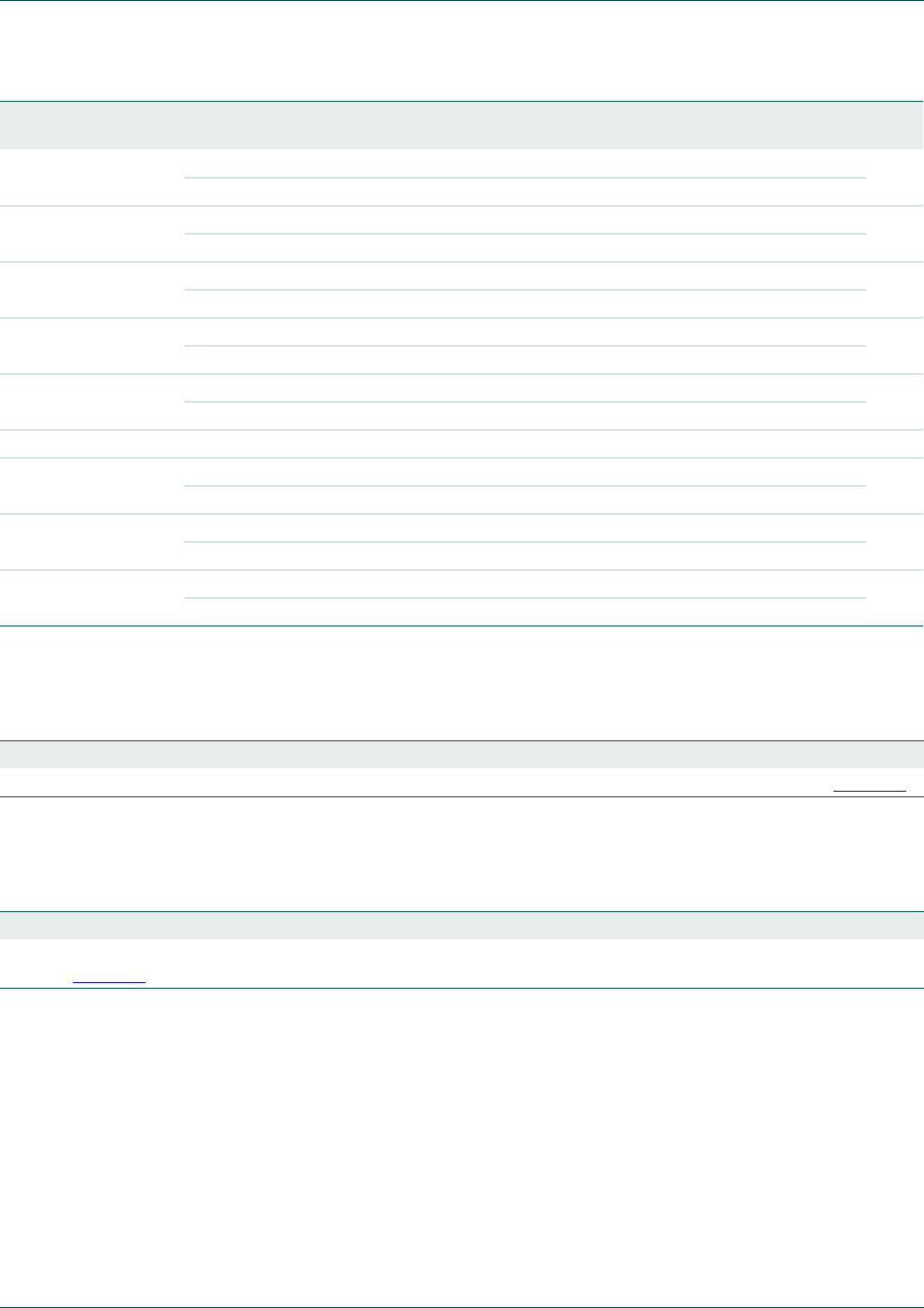
UM10360 All information provided in this document is subject to legal disclaimers. © NXP B.V. 2014. All rights reserved.
User manual Rev. 3.1 — 2 April 2014 541 of 849
NXP Semiconductors UM10360
Chapter 25: LPC176x/5x Motor control PWM
25.7.4.2 MCPWM Count Control set address (MCCNTCON_SET - 0x400B 8060)
Writing one(s) to this write-only address sets the corresponding bit(s) in MCCNTCON.
25.7.4.3 MCPWM Count Control clear address (MCCNTCON_CLR - 0x400B 8064)
Writing one(s) to this write-only address clears the corresponding bit(s) in MCCNTCON.
25.7.5 MCPWM Timer/Counter 0-2 registers (MCTC0-2 - 0x400B 8018,
0x400B 801C, 0x400B 8020)
These registers hold the current values of the 32-bit counter/timers for channels 0-2. Each
value is incremented on every PCLK, or by edges on the MCI0-2 pins, as selected by
MCCNTCON. The timer/counter counts up from 0 until it reaches the value in its
corresponding MCPER register (or is stopped by writing to MCCON_CLR).
A TC register can be read at any time. In order to write to the TC register, its channel must
be stopped. If not, the write will not take place, no exception is generated.
13 TC2MCI0_FE 1 If MODE2 is 1, counter 2 advances on a falling edge on MCI0. 0
0A falling edge on MCI0 does not affect counter 2.
14 TC2MCI1_RE 1 If MODE2 is 1, counter 2 advances on a rising edge on MCI1. 0
0A rising edge on MCI1 does not affect counter 2.
15 TC2MCI1_FE 1 If MODE2 is 1, counter 2 advances on a falling edge on MCI1. 0
0A falling edge on MCI1 does not affect counter 2.
16 TC2MCI2_RE 1 If MODE2 is 1, counter 2 advances on a rising edge on MCI2. 0
0A rising edge on MCI2 does not affect counter 2.
17 TC2MCI2_FE 1 If MODE2 is 1, counter 2 advances on a falling edge on MCI2. 0
0A falling edge on MCI2 does not affect counter 2.
28:18 - -Reserved. -
29 CNTR0 1 Channel 0 is in counter mode. 0
0Channel 0 is in timer mode.
30 CNTR1 1 Channel 1 is in counter mode. 0
0Channel 1 is in timer mode.
31 CNTR2 1 Channel 2 is in counter mode. 0
0Channel 2 is in timer mode.
Table 470. MCPWM Count Control read address (MCCNTCON - 0x400B 805C) bit description …continued
Bit Symbol Value Description Reset
Value
Table 471. MCPWM Count Control set address (MCCNTCON_SET - 0x400B 8060) bit description
Bit Description
31:0 Writing one(s) to this write-only address sets the corresponding bit(s) in the MCCNTCON register. See Tab l e 4 7 0 .
Table 472. MCPWM Count Control clear address (MCCAPCON_CLR - 0x400B 8064) bit description
Bit Description
31:0 Writing one(s) to this write-only address clears the corresponding bit(s) in the MCCNTCON register. See
Tab l e 4 7 0.

UM10360 All information provided in this document is subject to legal disclaimers. © NXP B.V. 2014. All rights reserved.
User manual Rev. 3.1 — 2 April 2014 542 of 849
NXP Semiconductors UM10360
Chapter 25: LPC176x/5x Motor control PWM
25.7.6 MCPWM Limit 0-2 registers (MCLIM0-2 - 0x400B 8024, 0x400B 8028,
0x400B 802C)
These registers hold the limiting values for timer/counters 0-2. When a timer/counter
reaches its corresponding limiting value: 1) in edge-aligned mode, it is reset and starts
over at 0; 2) in center-aligned mode, it begins counting down until it reaches 0, at which
time it begins counting up again.
If the channel’s CENTER bit in MCCON is 0 selecting edge-aligned mode, the match
between TC and LIM switches the channel’s A output from “active” to “passive” state. If
the channel’s CENTER and DTE bits in MCCON are both 0, the match simultaneously
switches the channel’s B output from “passive” to “active” state.
If the channel’s CENTER bit is 0 but the DTE bit is 1, the match triggers the channel’s
deadtime counter to begin counting -- when the deadtime counter expires, the channel’s B
output switches from “passive” to “active” state.
In center-aligned mode, matches between a channel’s TC and LIM registers have no
effect on its A and B outputs.
25.7.6.1 Match and Limit write and operating registers
Writing to either a Limit or a Match register loads a “write” register, and, if the channel is
stopped, it also loads a shadow “operating” register that is compared to the TC. If the
channel is running and its “disable update” bit in MCCON is 0, the operating registers are
loaded from the write registers as follows:
1. in edge-aligned mode, when the TC matches the operating Limit register;
2. in center-aligned mode, when the TC counts back down to 0. If the channel is running
and the “disable update” bit is 1, the operating registers are not loaded from the write
registers until software stops the channel.
Reading an MCLIM register address always returns the operating value.
Simultaneous update of the Limit and Match registers can be achieved by writing the
MCLIMx and MCMATx registers and then clearing the DISUPx bits in the MCCON register
(see Ta b le 4 5 8). The simultaneous update will occur at the beginning of the next PWM
cycle (also see Section 25.8.2).
Remark: In timer mode, the period of a channel’s modulated MCO outputs is determined
by its Limit register, and the pulse width at the start of the period is determined by its
Match register. You can consider the Limit register to be a “Period register” and the Match
register to be a “Pulse Width register”.
Table 473. MCPWM Timer/Counter 0-2 registers (MCTC0-2 - 0x400B 8018, 0x400B 801C, 0x400B 8020) bit description
Bit Symbol Description Reset value
31:0 MCTC0/1/2 Timer/Counter values for channels 0, 1, 2. 0
Table 474. MCPWM Limit 0-2 registers (MCLIM0-2 - 0x400B 8024, 0x400B 8028, 0x400B 802C) bit description
Bit Symbol Description Reset value
31:0 MCLIM0/1/2 Limit values for TC0, 1, 2. 0xFFFF FFFF

UM10360 All information provided in this document is subject to legal disclaimers. © NXP B.V. 2014. All rights reserved.
User manual Rev. 3.1 — 2 April 2014 543 of 849
NXP Semiconductors UM10360
Chapter 25: LPC176x/5x Motor control PWM
25.7.7 MCPWM Match 0-2 registers (MCMAT0-2 - 0x400B 8030, 0x400B 8034,
0x400B 8038)
These registers also have “write” and “operating” versions as described above for the
Limit registers, and the operating registers are also compared to the channels’ TCs. See
25.7.6 above for details of reading and writing both Limit and Match registers.
The Match and Limit registers control the MCO0-2 outputs. If a Match register is to have
any effect on its channel’s operation, it must contain a smaller value than the
corresponding Limit register.
25.7.7.1 Match register in Edge-Aligned mode
If the channel’s CENTER bit in MCCON is 0 selecting edge-aligned mode, a match
between TC and MAT switches the channel’s B output from “active” to “passive” state. If
the channel’s CENTER and DTE bits in MCCON are both 0, the match simultaneously
switches the channel’s A output from “passive” to “active” state.
If the channel’s CENTER bit is 0 but the DTE bit is 1, the match triggers the channel’s
deadtime counter to begin counting -- when the deadtime counter expires, the channel’s A
output switches from “passive” to “active” state.
25.7.7.2 Match register in Center-Aligned mode
If the channel’s CENTER bit in MCCON is 1 selecting center-aligned mode, a match
between TC and MAT while the TC is incrementing switches the channel’s B output from
“active” to “passive” state, and a match while the TC is decrementing switches the A
output from “active” to “passive”. If the channel’s CENTER bit in MCCON is 1 but the DTE
bit is 0, a match simultaneously switches the channel’s other output in the opposite
direction.
If the channel’s CENTER and DTE bits are both 1, a match between TC and MAT triggers
the channel’s deadtime counter to begin counting -- when the deadtime counter expires,
the channel’s B output switches from “passive” to “active” if the TC was counting up at the
time of the match, and the channel’s A output switches from “passive” to “active” if the TC
was counting down at the time of the match.
25.7.7.3 0 and 100% duty cycle
To lock a channel’s MCO outputs at the state “B active, A passive”, write its Match register
with a higher value than you write to its Limit register. The match never occurs.
To lock a channel’s MCO outputs at the opposite state, “A active, B passive”, simply write
0 to its Match register.
Table 475. MCPWM Match 0-2 registers (MCMAT0-2 - addresses 0x400B 8030, 0x400B 8034, 0x400B 8038) bit
description
Bit Symbol Description Reset value
31:0 MCMAT0/1/2 Match values for TC0, 1, 2. 0xFFFF FFFF
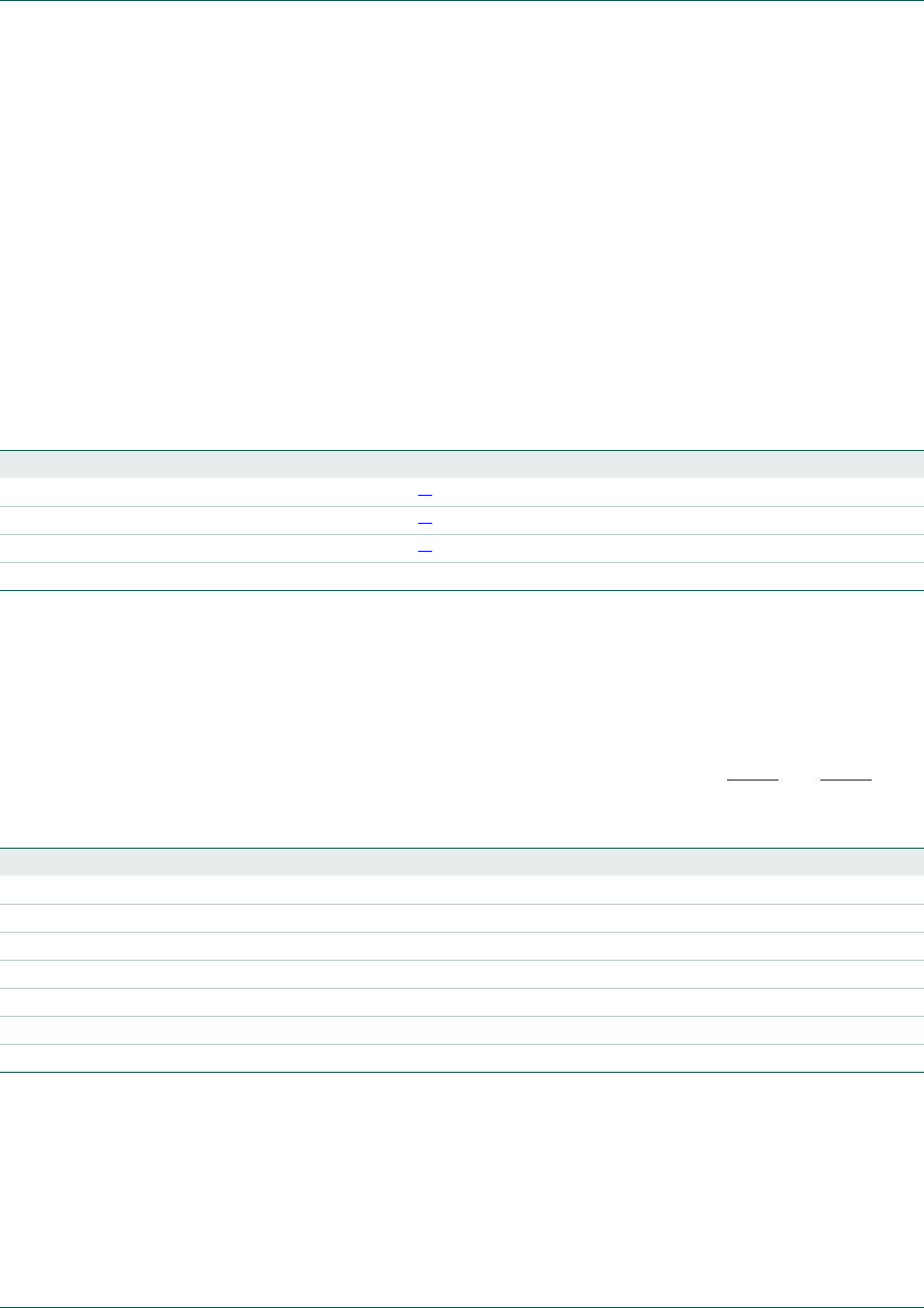
UM10360 All information provided in this document is subject to legal disclaimers. © NXP B.V. 2014. All rights reserved.
User manual Rev. 3.1 — 2 April 2014 544 of 849
NXP Semiconductors UM10360
Chapter 25: LPC176x/5x Motor control PWM
25.7.8 MCPWM Dead-time register (MCDT - 0x400B 803C)
This register holds the dead-time values for the three channels. If a channel’s DTE bit in
MCCON is 1 to enable its dead-time counter, the counter counts down from this value
whenever one its channel’s outputs changes from “active” to “passive” state. When the
dead-time counter reaches 0, the channel changes its other output from “passive” to
“active” state.
The motivation for the dead-time feature is that power transistors, like those driven by the
A and B outputs in a motor-control application, take longer to fully turn off than they take to
start to turn on. If the A and B transistors are ever turned on at the same time, a wasteful
and damaging current will flow between the power rails through the transistors. In such
applications, the dead-time register should be programmed with the number of PCLK
periods that is greater than or equal to the transistors’ maximum turn-off time minus their
minimum turn-on time.
[1] If ACMODE is 1 selecting AC-mode, this field controls the dead time for all three channels.
[2] If ACMODE is 0.
25.7.9 MCPWM Commutation Pattern register (MCCP - 0x400B 8040)
This register is used in DC mode only. The internal MCOA0 signal is routed to any or all of
the six output pins under the control of the bits in this register. Like the Match and Limit
registers, this register has “write” and “operational” versions. See 25.7.6 and 25.8.2 for
more about this subject.
Table 476. MCPWM Dead-time register (MCDT - address 0x400B 803C) bit description
Bit Symbol Description Reset value
9:0 DT0 Dead time for channel 0.[1] 0x3FF
19:10 DT1 Dead time for channel 1.[2] 0x3FF
29:20 DT2 Dead time for channel 2.[2] 0x3FF
31:30 - reserved
Table 477. MCPWM Commutation Pattern register (MCCP - address 0x400B 8040) bit description
Bit Symbol Description Reset value
0CCPA00 = MCOA0 passive, 1 = internal MCOA0. 0
1CCPB00 = MCOB0 passive, 1 = MCOB0 tracks internal MCOA0. 0
2CCPA10 = MCOA1 passive, 1 = MCOA1 tracks internal MCOA0. 0
3CCPB10 = MCOB1 passive, 1 = MCOB1 tracks internal MCOA0. 0
4CCPA20 = MCOA2 passive, 1 = MCOA2 tracks internal MCOA0. 0
5CCPB20 = MCOB2 passive, 1 = MCOB2 tracks internal MCOA0. 0
31:6 - Reserved.

UM10360 All information provided in this document is subject to legal disclaimers. © NXP B.V. 2014. All rights reserved.
User manual Rev. 3.1 — 2 April 2014 545 of 849
NXP Semiconductors UM10360
Chapter 25: LPC176x/5x Motor control PWM
25.7.10 MCPWM Capture Registers
25.7.10.1 MCPWM Capture read addresses (MCCAP0-2 - 0x400B 8044, 0x400B 8048,
0x400B 804C)
The MCCAPCON register (Tabl e 4 59) allows software to select any edge(s) on any of the
MCI0-2 inputs as a capture event for each channel. When a channel’s capture event
occurs, the current TC value for that channel is stored in its read-only Capture register.
These addresses are read-only, but the underlying registers can be cleared by writing to
the CAP_CLR address
25.7.10.2 MCPWM Capture clear address (MCCAP_CLR - 0x400B 8074)
Writing ones to this write-only address clears the selected CAP register(s).
Table 478. MCPWM Capture read addresses (MCCAP0/1/2 - 0x400B 8044, 0x400B 8048, 0x400B 804C) bit description
Bit Symbol Description Reset value
31:0 CAP0/1/2 TC value at a capture event for channels 0, 1, 2. 0x0000 0000
Table 479. MCPWM Capture clear address (CAP_CLR - 0x400B 8074) bit description
Bit Symbol Description
0CAP_CLR0Writing a 1 to this bit clears the MCCAP0 register.
1CAP_CLR1Writing a 1 to this bit clears the MCCAP1 register.
2CAP_CLR2Writing a 1 to this bit clears the MCCAP2 register.
31:3 - Reserved

UM10360 All information provided in this document is subject to legal disclaimers. © NXP B.V. 2014. All rights reserved.
User manual Rev. 3.1 — 2 April 2014 546 of 849
NXP Semiconductors UM10360
Chapter 25: LPC176x/5x Motor control PWM
25.8 PWM operation
25.8.1 Pulse-width modulation
Each channel of the MCPWM has two outputs, A and B, that can drive a pair of transistors
to switch a controlled point between two power rails. Most of the time the two outputs have
opposite polarity, but a dead-time feature can be enabled (on a per-channel basis) to
delay both signals’ transitions from “passive” to “active” state so that the transistors are
never both turned on simultaneously. In a more general view, the states of each output
pair can be thought of “high”, “low”, and “floating” or “up”, “down”, and “center-off”.
Each channel’s mapping from “active” and “passive” to “high” and “low” is programmable.
After Reset, the three A outputs are passive/low, and the B outputs are active/high.
The MCPWM can perform edge-aligned and center-aligned pulse-width modulation.
Note: In timer mode, the period of a channel’s modulated MCO outputs is determined by
its Limit register, and the pulse width at the start of the period is determined by its Match
register. If it suits your way of thinking, consider the Limit register to be the “Period register”
and the Match register to be the “Pulse Width register”.
Edge-aligned PWM without dead-time
In this mode the timer TC counts up from 0 to the value in the LIM register. As shown in
Figure 123, the MCO state is “A passive” until the TC matches the Match register, at which
point it changes to “A active”. When the TC matches the Limit register, the MCO state
changes back to “A passive”, and the TC is reset and starts counting up again.
Center-aligned PWM without dead-time
In this mode the timer TC counts up from 0 to the value in the LIM register, then counts
back down to 0 and repeats. As shown in Figure 124, while the timer counts up, the MCO
state is “A passive” until the TC matches the Match register, at which point it changes to “A
active”. When the TC matches the Limit register it starts counting down. When the TC
matches the Match register on the way down, the MCO state changes back to “A passive”.
Fig 123. Edge-aligned PWM waveform without dead time, POLA = 0
MAT MATLIM LIM
0
POLA = 0
timer reset timer reset
MCOA
MCOB
active activepassive passive
passive passiveactive active
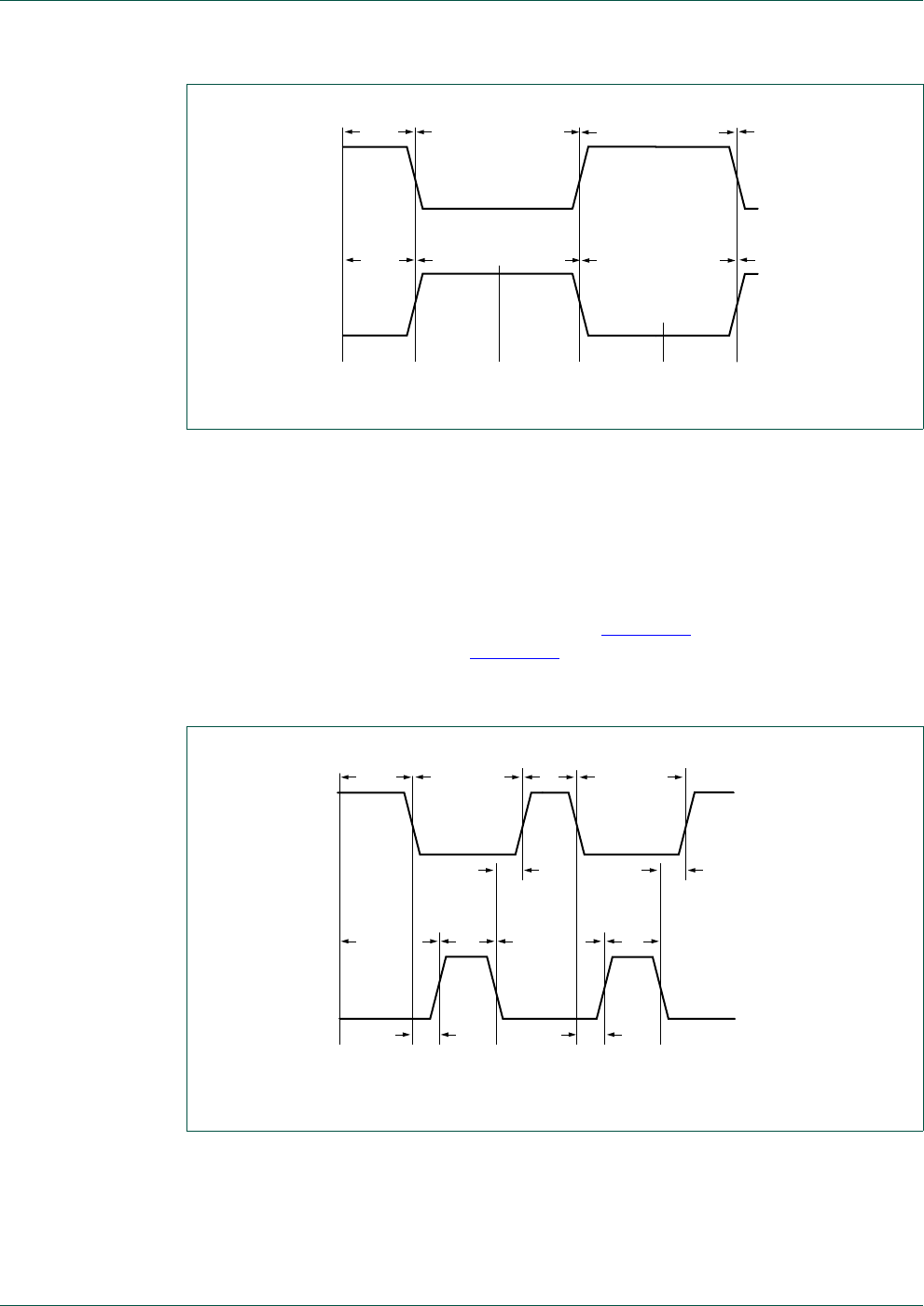
UM10360 All information provided in this document is subject to legal disclaimers. © NXP B.V. 2014. All rights reserved.
User manual Rev. 3.1 — 2 April 2014 547 of 849
NXP Semiconductors UM10360
Chapter 25: LPC176x/5x Motor control PWM
Dead-time counter
When the a channel’s DTE bit is set in MCCON, the dead-time counter delays the
passive-to-active transitions of both MCO outputs. The dead-time counter starts counting
down, from the channel’s DT value (in the MCDT register) to 0, whenever the channel’s A
or B output changes from active to passive. The transition of the other output from passive
to active is delayed until the dead-time counter reaches 0. During the dead time, the
MCOA and MCOB output levels are both passive. Figure 125 shows operation in edge
aligned mode with dead time, and Figure 126 shows center-aligned operation with dead
time.
Fig 124. Center-aligned PWM waveform without dead time, POLA = 0
Fig 125. Edge-aligned PWM waveform with dead time, POLA = 0
MAT MAT LIMLIM 0
0
POLA = 0
MCOA
MCOB
active active
passive passive
passive passiveactive active
MAT MATLIM LIM
0
POLA = 0
timer reset timer reset
MCOA
MCOB
active active
passive passive
passive passive
active active
DT
DT DT
DT
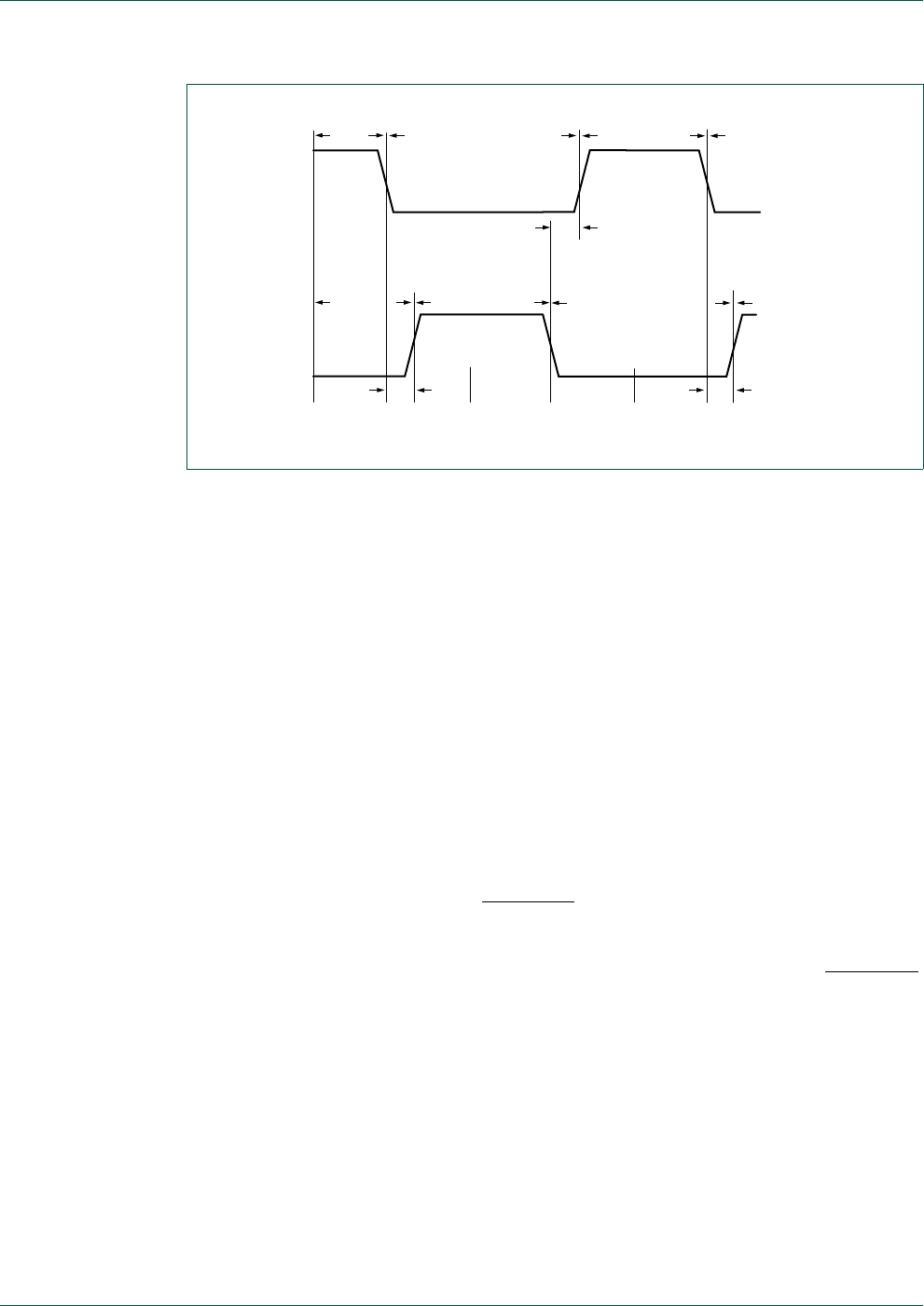
UM10360 All information provided in this document is subject to legal disclaimers. © NXP B.V. 2014. All rights reserved.
User manual Rev. 3.1 — 2 April 2014 548 of 849
NXP Semiconductors UM10360
Chapter 25: LPC176x/5x Motor control PWM
25.8.2 Shadow registers and simultaneous updates
The Limit, Match, and Commutation Pattern registers (MCLIM, MCMAT, and MCCP) are
implemented as register pairs, each consisting of a write register and an operational
register. Software writes into the write registers. The operational registers control the
actual operation of each channel and are loaded with the current value in the write
registers when the TC starts counting up from 0.
Updating of the functional registers can be disabled by setting a channel’s DISUP bit in
the MCCON register. If the DISUP bits are set, the functional registers are not updated
until software stops the channel.
If a channel is not running when software writes to its LIM or MAT register, the functional
register is updated immediately.
Software can write to a TC register only when its channel is stopped.
25.8.3 Fast Abort (ABORT)
The MCPWM has an external input MCABORT. When this input goes low, all six MCO
outputs assume their “A passive” states, and the Abort interrupt is generated if enabled.
The outputs remain locked in “A passive” state until the ABORT interrupt flag is cleared or
the Abort interrupt is disabled. The ABORT flag may not be cleared before the MCABORT
input goes high.
In order to clear an ABORT flag, a 1 must be written to bit 15 of the MCINTF_CLR
register. This will remove the interrupt request. The interrupt can also be disabled by
writing a 1 to bit 15 of the MCINTEN_CLR register.
25.8.4 Capture events
Each PWM channel can take a snapshot of its TC when an input signal transitions. Any
channel may use any combination of rising and/or falling edges on any or all of the MCI0-2
inputs as a capture event, under control of the MCCAPCON register. Rising or falling
edges on the inputs are detected synchronously with respect to PCLK.
Fig 126. Center-aligned waveform with dead time, POLA = 0
MAT MAT LIMLIM 0
0
POLA = 0
MCOA
MCOB
active active
passive passive
passive passive
active active
DT
DT
DT

UM10360 All information provided in this document is subject to legal disclaimers. © NXP B.V. 2014. All rights reserved.
User manual Rev. 3.1 — 2 April 2014 549 of 849
NXP Semiconductors UM10360
Chapter 25: LPC176x/5x Motor control PWM
If a channel’s HNF bit in the MCCAPCON register is set to enable “noise filtering”, a
selected edge on an MCI pin starts the dead-time counter for that channel, and the
capture event actions described below are delayed until the dead-time counter reaches 0.
This function is targeted specifically for performing three-phase brushless DC motor
control with Hall sensors.
A capture event on a channel (possibly delayed by HNF) causes the following:
•The current value of the TC is stored in the Capture register (CAP).
•If the channel’s capture event interrupt is enabled (see Table 464), the capture event
interrupt flag is set.
•If the channel’s RT bit is set in the MCCAPCON register, enabling reset on a capture
event, the input event has the same effect as matching the channel’s TC to its LIM
register. This includes resetting the TC and switching the MCO pin(s) in edge-aligned
mode as described in 25.7.6 and 25.8.1.
25.8.5 External event counting (Counter mode)
If a channel’s MODE bit is 1 in MCCNTCON, its TC is incremented by rising and/or falling
edge(s) (synchronously detected) on the MCI0-2 input(s), rather than by PCLK. The PWM
functions and capture functions are unaffected.
25.8.6 Three-phase DC mode
The three-phase DC mode is selected by setting the DCMODE bit in the MCCON register.
In this mode, the internal MCOA0 signal can be routed to any or all of the MCO outputs.
Each MCO output is masked by a bit in the current Commutation Pattern register MCCP. If
a bit in the MCCP register is 0, its output pin has the logic level for the passive state of
output MCOA0. The polarity of the off state is determined by the POLA0 bit.
All MCO outputs that have 1 bits in the MCCP register are controlled by the internal
MCOA0 signal.
The three MCOB output pins are inverted when the INVBDC bit is 1 in the MCCON
register. This feature accommodates bridge-drivers that have active-low inputs for the
low-side switches.
The MCCP register is implemented as a shadow register pair, so that changes to the
active commutation pattern occur at the beginning of a new PWM cycle. See 25.7.6 and
25.8.2 for more about writing and reading such registers.
Figure 127 shows sample waveforms of the MCO outputs in three-phase DC mode. Bits 1
and 3 in the MCCP register (corresponding to outputs MCOB1 and MCOB0) are set to 0
so that these outputs are masked and in the off state. Their logic level is determined by
the POLA0 bit (here, POLA0 = 0 so the passive state is logic LOW). The INVBDC bit is set
to 0 (logic level not inverted) so that the B output have the same polarity as the A outputs.
Note that this mode differs from other modes in that the MCOB outputs are not the
opposite of the MCOA outputs.
In the situation shown in Figure 127, bits 0, 2, 4, and 5 in the MCCP register are set to 1.
That means that MCOA1 and both MCO outputs for channel 2 follow the MCOA0 signal.
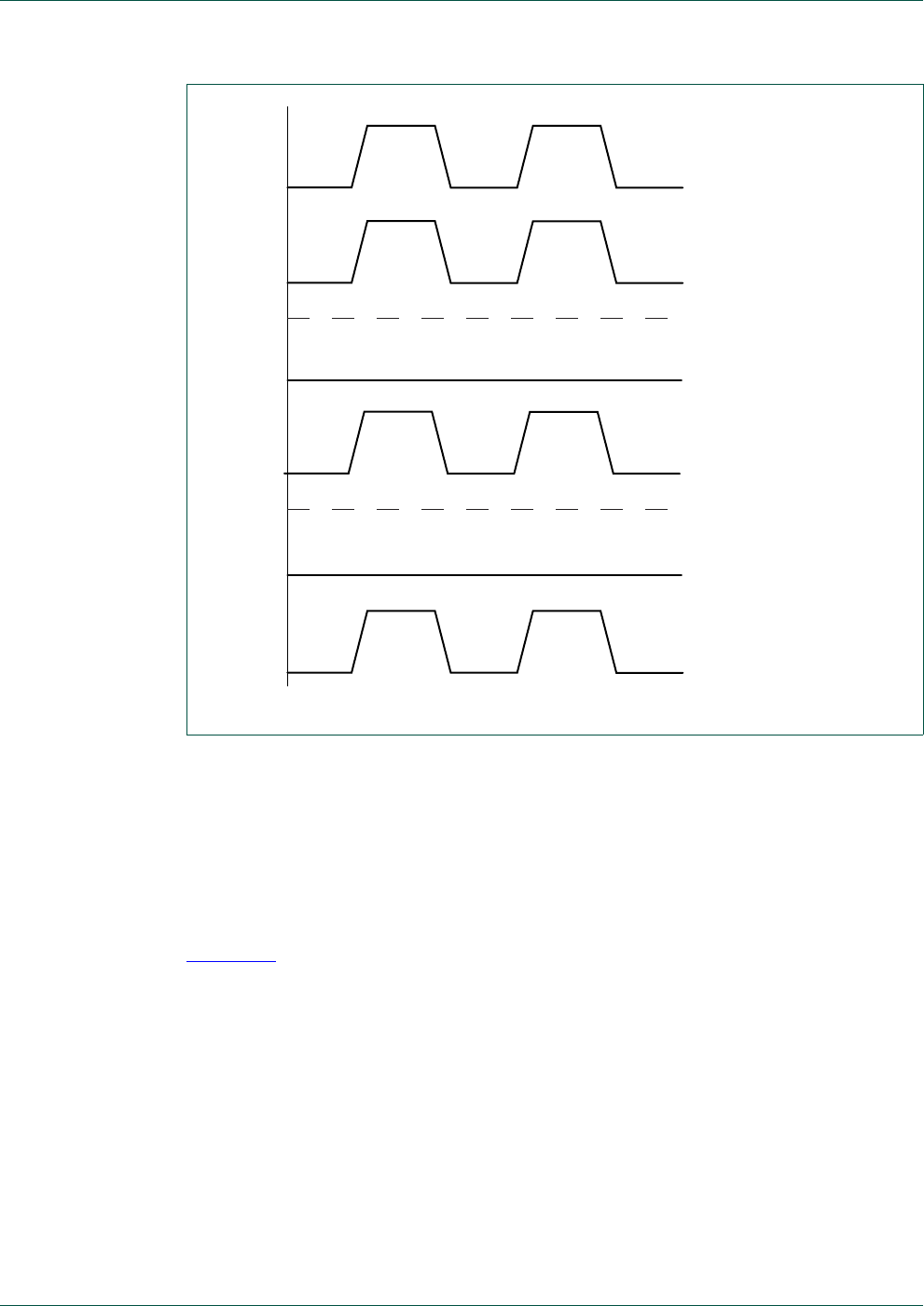
UM10360 All information provided in this document is subject to legal disclaimers. © NXP B.V. 2014. All rights reserved.
User manual Rev. 3.1 — 2 April 2014 550 of 849
NXP Semiconductors UM10360
Chapter 25: LPC176x/5x Motor control PWM
25.8.7 Three phase AC mode
The three-phase AC-mode is selected by setting the ACMODE bit in the MCCON register.
In this mode, the value of channel 0’s TC is routed to all channels for comparison with
their MAT registers. (The LIM1-2 registers are not used.)
Each channel controls its MCO output by comparing its MAT value to TC0.
Figure 128 shows sample waveforms for the six MCO outputs in three-phase AC mode.
The POLA bits are set to 0 for all three channels, so that for all MCO outputs the active
levels are high and the passive levels are low. Each channel has a different MAT value
which is compared to the MCTC0 value. In this mode the period value is identical for all
three channels and is determined by MCLIM0. The dead-time mode is disabled.
Fig 127. Three-phase DC mode sample waveforms
POLA0 = 0, INVBDC = 0
MCOA2
MCOB1
MCOA1
MCOB0
MCOA0
MCOB2
CCPB1 = 0, off-state
CCPB0 = 0, off-state
CCPA0 = 1, on-state
CCPA2 = 1, on-state
CCPA1 = 1, on-state
CCPB2 = 1, on-state
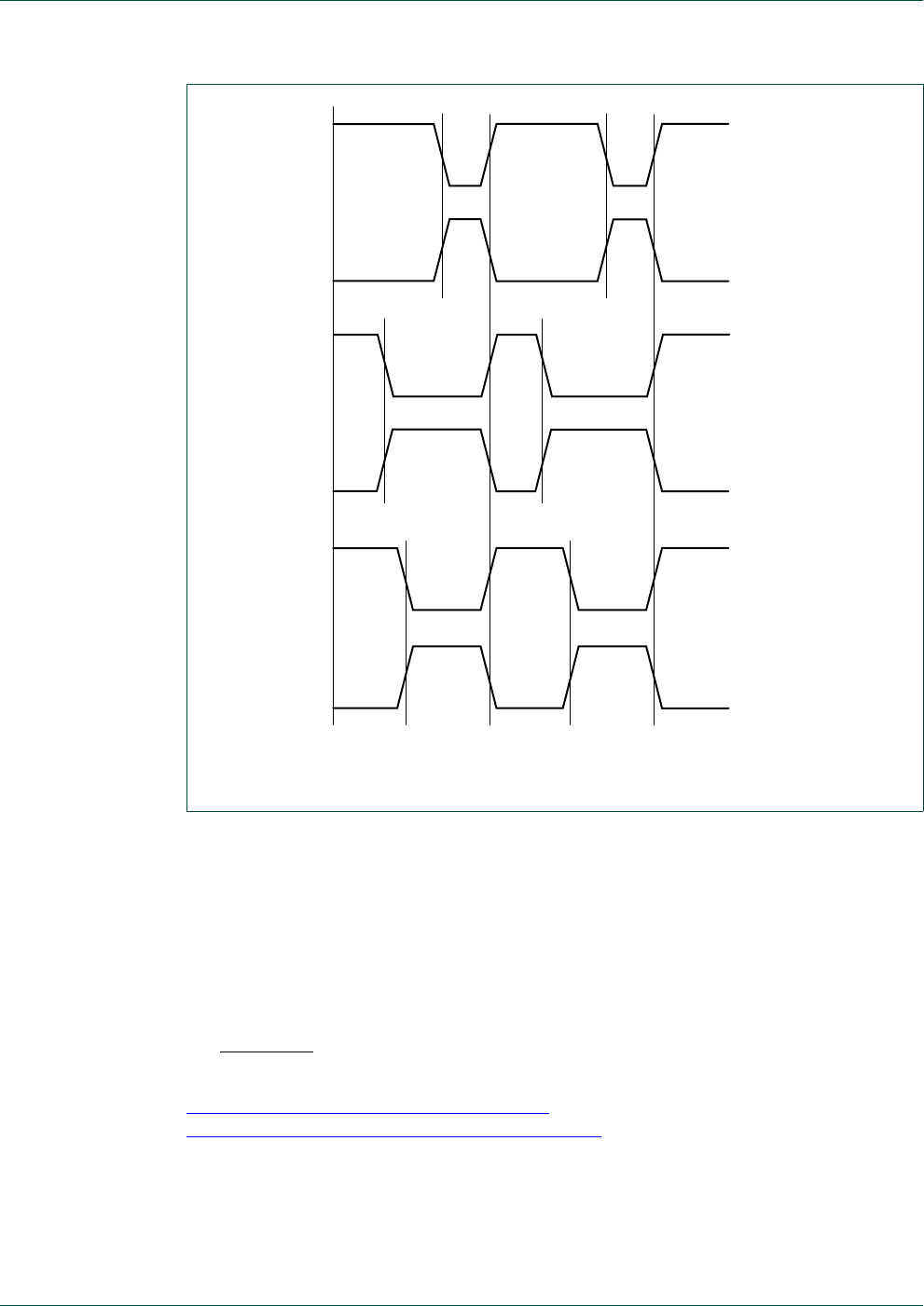
UM10360 All information provided in this document is subject to legal disclaimers. © NXP B.V. 2014. All rights reserved.
User manual Rev. 3.1 — 2 April 2014 551 of 849
NXP Semiconductors UM10360
Chapter 25: LPC176x/5x Motor control PWM
25.8.8 Interrupts
The MCPWM includes 10 possible interrupt sources:
•When any channel’s TC matches its Match register.
•When any channel’s TC matches its Limit register.
•When any channel captures the value of its TC into its Capture register, because a
selected edge occurs on any of MCI0-2.
•When all three channels’ outputs are forced to “A passive” state because the
MCABORT pin goes low.
Section 25.7.3 “MCPWM Interrupt registers” explains how to enable these interrupts, and
Section 25.7.2 “MCPWM Capture Control register” describes how to map edges on the
MCI0-2 inputs to “capture events” on the three channels.
Fig 128. Three-phase AC mode sample waveforms, edge aligned PWM mode
POLA0 = 0
POLA2 = 0
POLA1 = 0
MCOA2
MCOB1
MCOA1
MCOB0
MCOA0
MCOB2
MAT0
MAT1 MAT1
MAT2 MAT2
LIM0 LIM0
0
timer reset timer reset

UM10360 All information provided in this document is subject to legal disclaimers. © NXP B.V. 2014. All rights reserved.
User manual Rev. 3.1 — 2 April 2014 552 of 849
26.1 Basic configuration
The QEI is configured using the following registers:
1. Power: In the PCONP register (Tab l e 4 6), set bit PCQEI.
Remark: On reset, the QEI is disabled (PCQEI = 0).
2. Peripheral clock: In the PCLKSEL0 register (Ta b l e 4 0 ), select PCLK_QEI.
3. Pins: Select QEI pins through the PINSEL registers. Select pin modes for port pins
with QEI functions through the PINMODE registers (Section 8.5).
4. Interrupts: See Section 26.6.4. The QEI interrupt is enabled in the NVIC using the
appropriate Interrupt Set Enable register.
26.2 Features
This Quadrature Encoder Interface (QEI) has the following features:
•tracks encoder position.
•increments/ decrements depending on direction.
•programmable for 2X or 4X position counting.
•velocity capture using built-in timer.
•velocity compare function with less than interrupt.
•uses 32-bit registers for position and velocity.
•three position compare registers with interrupts.
•index counter for revolution counting.
•index compare register with interrupts.
•can combine index and position interrupts to produce an interrupt for whole and partial
revolution displacement.
•digital filter with programmable delays for encoder input signals.
•can accept decoded signal inputs (clock and direction).
26.3 Introduction
A quadrature encoder, also known as a 2-channel incremental encoder, converts angular
displacement into two pulse signals. By monitoring both the number of pulses and the
relative phase of the two signals, you can track the position, direction of rotation, and
velocity. In addition, a third channel, or index signal, can be used to reset the position
counter. This quadrature encoder interface module decodes the digital pulses from a
quadrature encoder wheel to integrate position over time and determine direction of
rotation. In addition, it can capture the velocity of the encoder wheel.
UM10360
Chapter 26: LPC176x/5x Quadrature Encoder Interface (QEI)
Rev. 3.1 — 2 April 2014 User manual
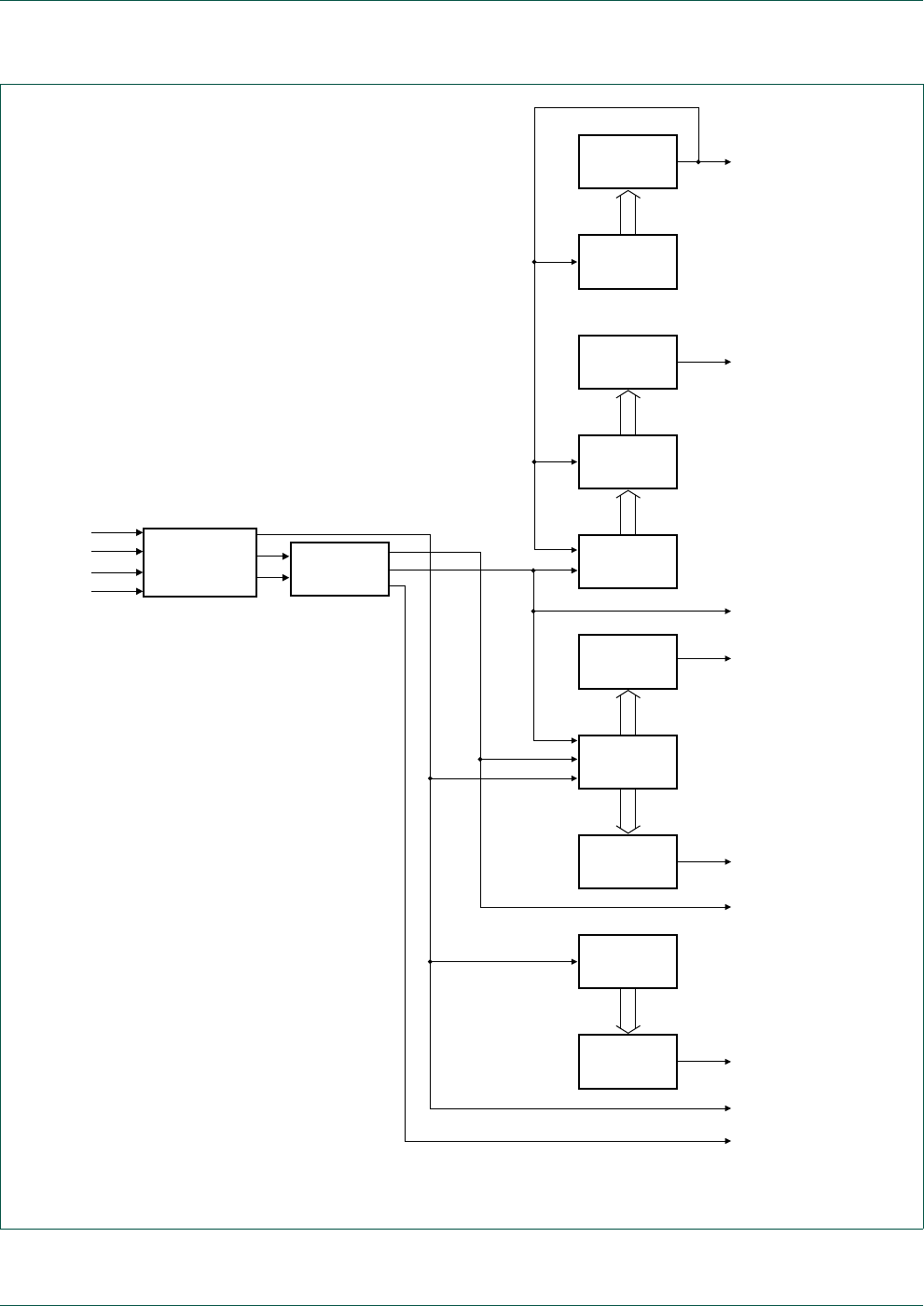
UM10360 All information provided in this document is subject to legal disclaimers. © NXP B.V. 2014. All rights reserved.
User manual Rev. 3.1 — 2 April 2014 553 of 849
NXP Semiconductors UM10360
Chapter 26: LPC176x/5x Quadrature Encoder Interface (QEI)
Fig 129.Encoder interface block diagram
002aad520
index
Ph A
Ph B
PCLK
DIGITAL
FILTER QUAD
DECODER
VELOCITY
TIMER
velocity interrupt
(TIM_Int)
low velocity interrupt
(LVEL_Int)
encoder clock interrupt
(ENCLK_Int)
position 0 interrupt
(POS0_Int)
position 1 interrupt
(POS1_Int)
direction interrupt
(DIR_Int)
revolution interrupt
(REV_Int)
index interrupt
(INX_Int)
phase error interrupt
(ERR_Int)
VELOCITY
RELOAD
VELOCITY
COMPARE
VELOCITY
CAPTURE
VELOCITY
COUNTER
POSITION
COMPARE 0
POSITION
COUNTER
POSITION
COMPARE 1
INDEX
COUNTER
INDEX
COMPARE
INX
ERR
DIR
CLK
RST
RST
CLK

UM10360 All information provided in this document is subject to legal disclaimers. © NXP B.V. 2014. All rights reserved.
User manual Rev. 3.1 — 2 April 2014 554 of 849
NXP Semiconductors UM10360
Chapter 26: LPC176x/5x Quadrature Encoder Interface (QEI)
26.4 Functional description
The QEI module interprets the two-bit gray code produced by a quadrature encoder wheel
to integrate position over time and determine direction of rotation. In addition, it can
capture the velocity of the encoder wheel.
26.4.1 Input signals
The QEI module supports two modes of signal operation: quadrature phase mode and
clock/direction mode. In quadrature phase mode, the encoder produces two clocks that
are 90 degrees out of phase; the edge relationship is used to determine the direction of
rotation. In clock/direction mode, the encoder produces a clock signal to indicate steps
and a direction signal to indicate the direction of rotation.).
This mode is determined by the SigMode bit of the QEI Configuration (QEICONF) register
(See Ta ble 4 8 6). When the SigMode bit = 1, the quadrature decoder is bypassed and the
PhA pin functions as the direction signal and PhB pin functions as the clock signal for the
counters, etc. When the SigMode bit = 0, the PhA pin and PhB pins are decoded by the
quadrature decoder. In this mode the quadrature decoder produces the direction and
clock signals for the counters, etc. In both modes the direction signal is subject to the
effects of the direction invert (DIRINV) bit.
26.4.1.1 Quadrature input signals
When edges on PhA lead edges on PhB, the position counter is incremented. When
edges on PhB lead edges on PhA, the position counter is decremented. When a rising
and falling edge pair is seen on one of the phases without any edges on the other, the
direction of rotation has changed.
[1] All other state transitions are illegal and should set the ERR bit.
Interchanging of the PhA and PhB input signals are compensated by complementing the
DIR bit. When set = 1, the direction inversion bit (DIRINV) complements the DIR bit.
Table 480. Encoder states
Phase A Phase B state
101
112
013
004
Table 481. Encoder state transitions[1]
from state to state Direction
1 2 positive
23
34
41
4 3 negative
32
21
14
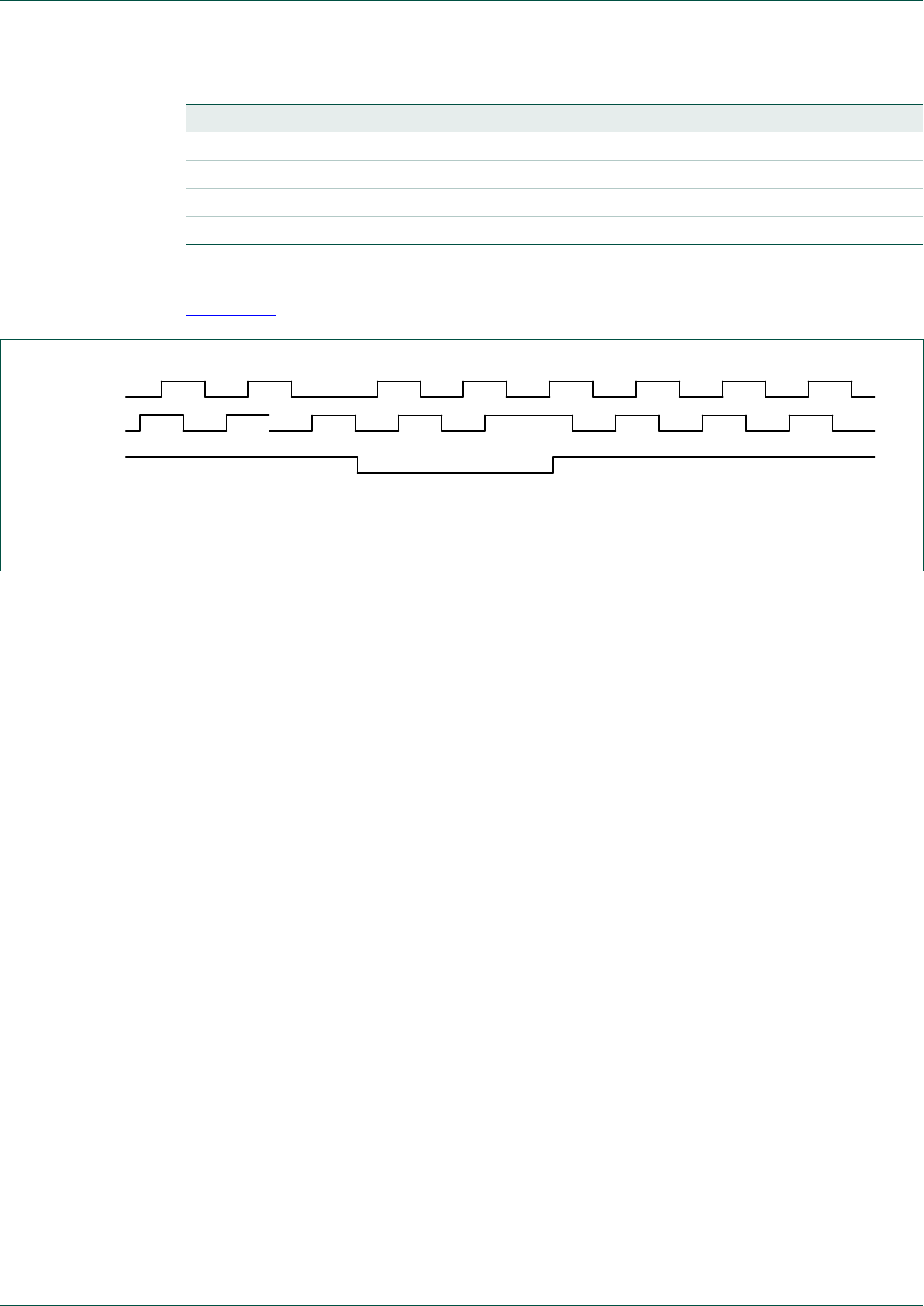
UM10360 All information provided in this document is subject to legal disclaimers. © NXP B.V. 2014. All rights reserved.
User manual Rev. 3.1 — 2 April 2014 555 of 849
NXP Semiconductors UM10360
Chapter 26: LPC176x/5x Quadrature Encoder Interface (QEI)
Figure 130 shows how quadrature encoder signals equate to direction and count.
26.4.1.2 Digital input filtering
All three encoder inputs (PhA, PhB, and index) require digital filtering. The number of
sample clocks is user programmable from 1 to 4,294,967,295 (0xFFFF FFFF). In order for
a transition to be accepted, the input signal must remain in new state for the programmed
number of sample clocks.
26.4.2 Position capture
The capture mode for the position integrator can be set to update the position counter on
every edge of the PhA signal or to update on every edge of both PhA and PhB. Updating
the position counter on every PhA and PhB provides more positional resolution at the cost
of less range in the positional counter.
The position integrator and velocity capture can be independently enabled. Alternatively,
the phase signals can be interpreted as a clock and direction signal as output by some
encoders.
The position counter is automatically reset on one of two conditions. Incrementing past
the maximum position value (QEIMAXPOS) will reset the position counter to zero. If the
reset on index bit (RESPI) is set, sensing the index pulse will reset the position counter to
zero.
26.4.3 Velocity capture
The velocity capture has a programmable timer and a capture register. It counts the
number of phase edges (using the same configuration as for the position integrator) in a
given time period. When the velocity timer (QEITIME) overflows the contents of the
velocity counter (QEIVEL) are transferred to the capture (QEICAP) register. The velocity
counter is then cleared. The velocity timer is loaded with the contents of the velocity
reload register (QEILOAD). Finally, the velocity interrupt (TIM_Int) is asserted. The
Table 482. Encoder direction
DIR bit DIRINV bit direction
00forward
10reverse
01reverse
11forward
Fig 130.Quadrature Encoder Basic Operation
PhA
PhB
direction
position -1 -1 -1 -1 -1-1 -1 -1 -1 -1-1 -1 -1 -1-1-1 -1 -1 -1 -1-1 -1 -1 -1 +1 +1 +1 +1 +1 +1 +1 +1

UM10360 All information provided in this document is subject to legal disclaimers. © NXP B.V. 2014. All rights reserved.
User manual Rev. 3.1 — 2 April 2014 556 of 849
NXP Semiconductors UM10360
Chapter 26: LPC176x/5x Quadrature Encoder Interface (QEI)
number of edges counted in a given time period is directly proportional to the velocity of
the encoder. Setting the reset velocity bit (RESV) has the same effect as an overflow of
the velocity timer, except that the setting the RESV bit will not generate a velocity
interrupt.
The following equation converts the velocity counter value into an RPM value:
RPM = (PCLK * QEICAP * 60) ÷ (QEILOAD * PPR * Edges)
where:
•PCLK is the peripheral clock rate for the QEI block. See Section 4.7.3 for more on the
possibilities for PCLK).
•QEICAP is the captured velocity counter value for the last velocity timer period.
•QEILOAD is the velocity timer reload value.
•PPR is the number of pulses per revolution of the physical encoder used in the
application
•Edges is 2 or 4, based on the capture mode set in the QEICON register (2 for
CapMode set to 0 and 4 for CapMode set to 1)
For example, consider a motor running at 600 RPM. A 2048 pulse per revolution
quadrature encoder is attached to the motor, producing 8192 phase edges per revolution
(PPR * Edges). This results in 81,920 pulses per second (the motor turns 10 times per
second at 600 RPM and there are 8,192 edges per revolution). If the timer were clocked at
10,000 Hz, and the QEILOAD was 2,500 (corresponding to ¼ of a second), it would count
20,480 pulses per update. Using the above equation:
RPM = (10000 * 1 * 20480 * 60) ÷ (2500 * 2048 * 4) = 600 RPM
Now, consider that the motor is sped up to 3000 RPM. This results in 409,600 pulses per
second, or 102,400 every ¼ of a second. Again, the above equation gives:
RPM = (10000 * 1 * 102400 * 60) ÷ (2500 * 2048 * 4) = 3000 RPM
These are simple examples, real-world values will have a higher rate for PCLK, and
probably a larger value for QEILOAD as well.
26.4.4 Velocity compare
In addition to velocity capture, the velocity measurement system includes a
programmable velocity compare register. After every velocity capture event the contents
of the velocity capture register (QEICAP) is compared with the contents of the velocity
compare register (VELCOMP). If the captured velocity is less than the compare value an
interrupt is asserted provided that the velocity compare interrupt enable bit is set. This can
be used to determine if a motor shaft is either stalled or moving too slow.

UM10360 All information provided in this document is subject to legal disclaimers. © NXP B.V. 2014. All rights reserved.
User manual Rev. 3.1 — 2 April 2014 557 of 849
NXP Semiconductors UM10360
Chapter 26: LPC176x/5x Quadrature Encoder Interface (QEI)
26.5 Pin description
[1] The Quadrature Encoder Interface uses the same pin functions as the Motor Control PWM feedback inputs
and are connected when the Motor Control PWM function is selected on these pins. If used as part of motor
control, the QEI is an alternative to feedback directly to the MCPWM.
Table 483. QEI pin description
Pin name I/O Description
MCI0 [1] IUsed as the Phase A (PhA) input to the Quadrature Encoder Interface.
MCI1 [1] IUsed as the Phase B (PhB) input to the Quadrature Encoder Interface.
MCI2 [1] IUsed as the Index (IDX) input to the Quadrature Encoder Interface.

UM10360 All information provided in this document is subject to legal disclaimers. © NXP B.V. 2014. All rights reserved.
User manual Rev. 3.1 — 2 April 2014 558 of 849
NXP Semiconductors UM10360
Chapter 26: LPC176x/5x Quadrature Encoder Interface (QEI)
26.6 Register description
26.6.1 Register summary
Table 484. QEI Register summary
Name Description Access Reset
value
Address
Control registers
QEICON Control register WO 0 0x400B C000
QEICONF Configuration register R/W 0 0x400B C008
QEISTAT Encoder status register RO 0 0x400B C004
Position, index, and timer registers
QEIPOS Position register RO 0 0x400B C00C
QEIMAXPOS Maximum position register R/W 0 0x400B C010
CMPOS0 position compare register 0 R/W 0 0x400B C014
CMPOS1 position compare register 1 R/W 0 0x400B C018
CMPOS2 position compare register 2 R/W 0 0x400B C01C
INXCNT Index count register RO 0 0x400B C020
INXCMP Index compare register R/W 0 0x400B C024
QEILOAD Velocity timer reload register R/W 0 0x400B C028
QEITIME Velocity timer register RO 0 0x400B C02C
QEIVEL Velocity counter register RO 0 0x400B C030
QEICAP Velocity capture register RO 0 0x400B C034
VELCOMP Velocity compare register R/W 0 0x400B C038
FILTER Digital filter register R/W 0 0x400B C03C
Interrupt registers
QEIINTSTAT Interrupt status register RO 0 0x400B CFE0
QEISET Interrupt status set register WO 0 0x400B CFEC
QEICLR Interrupt status clear register WO 0 0x400B CFE8
QEIIE Interrupt enable register RO 0 0x400B CFE4
QEIIES Interrupt enable set register WO 0 0x400B CFDC
QEIIEC Interrupt enable clear register WO 0 0x400B CFD8

UM10360 All information provided in this document is subject to legal disclaimers. © NXP B.V. 2014. All rights reserved.
User manual Rev. 3.1 — 2 April 2014 559 of 849
NXP Semiconductors UM10360
Chapter 26: LPC176x/5x Quadrature Encoder Interface (QEI)
26.6.2 Control registers
26.6.2.1 QEI Control register (QEICON - 0x400B C000)
This register contains bits which control the operation of the position and velocity counters
of the QEI module.
26.6.2.2 QEI Configuration register (QEICONF - 0x400B C008)
This register contains the configuration of the QEI module.
26.6.2.3 QEI Status register (QEISTAT - 0x400B C004)
This register provides the status of the encoder interface.
Table 485: QEI Control register (QEICON - address 0x400B C000) bit description
Bit Symbol Description Reset
value
0RESPReset position counter. When set = 1, resets the position counter to all zeros. Autoclears when
the position counter is cleared.
0
1RESPIReset position counter on index. When set = 1, resets the position counter to all zeros when an
index pulse occurs. Autoclears when the position counter is cleared.
0
2RESVReset velocity. When set = 1, resets the velocity counter to all zeros and reloads the velocity
timer. Autoclears when the velocity counter is cleared.
0
3RESIReset index counter. When set = 1, resets the index counter to all zeros. Autoclears when the
index counter is cleared.
0
31:4 - reserved 0
Table 486: QEI Configuration register (QEICONF - address 0x400B C008) bit description
Bit Symbol Description Reset
value
0DIRINVDirection invert. When = 1, complements the DIR bit. 0
1SIGMODESignal Mode. When = 0, PhA and PhB function as quadrature encoder inputs. When = 1, PhA
functions as the direction signal and PhB functions as the clock signal.
0
2 CAPMODE Capture Mode. When = 0, only PhA edges are counted (2X). When = 1, BOTH PhA and PhB
edges are counted (4X), increasing resolution but decreasing range.
0
3INVINXInvert Index. When set, inverts the sense of the index input. 0
31:4 - reserved 0
Table 487: QEI Interrupt Status register (QEISTAT - address 0x400B C004) bit description
Bit Symbol Description Reset
value
0 DIR Direction bit. In combination with DIRINV bit indicates forward or reverse direction. See
Tab l e 4 82.
31:1 - reserved 0

UM10360 All information provided in this document is subject to legal disclaimers. © NXP B.V. 2014. All rights reserved.
User manual Rev. 3.1 — 2 April 2014 560 of 849
NXP Semiconductors UM10360
Chapter 26: LPC176x/5x Quadrature Encoder Interface (QEI)
26.6.3 Position, index and timer registers
26.6.3.1 QEI Position register (QEIPOS - 0x400B C00C)
This register contains the current value of the encoder position. Increments or decrements
when encoder counts occur, depending on the direction of rotation.
26.6.3.2 QEI Maximum Position register (QEIMAXPOS - 0x400B C010)
This register contains the maximum value of the encoder position. In forward rotation the
position register resets to zero when the position register exceeds this value. In reverse
rotation the position register resets to this value when the position register decrements
from zero.
26.6.3.3 QEI Position Compare register 0 (CMPOS0 - 0x400B C014)
This register contains a position compare value. This value is compared against the
current value of the position register. Interrupts can be enabled to interrupt when the
compare value is equal to the current value of the position register.
26.6.3.4 QEI Position Compare register 1 (CMPOS1 - 0x400B C018)
This register contains a position compare value. This value is compared against the
current value of the position register. Interrupts can be enabled to interrupt when the
compare value is equal to the current value of the position register.
Table 488: QEI Position register (QEIPOS - address 0x400B C00C) bit description
Bit Symbol Description Reset
value
31:0 - Current position value. 0
Table 489: QEI Maximum Position register (QEIMAXPOS - address 0x400B C010) bit description
Bit Symbol Description Reset
value
31:0 - Current maximum position value. 0
Table 490: QEI Position Compare register 0 (CMPOS0 - address 0x400B C014) bit description
Bit Symbol Description Reset
value
31:0 - Position compare value 0. 0
Table 491: QEI Position Compare register 1 (CMPOS1 - address 0x400B C018) bit description
Bit Symbol Description Reset
value
31:0 - Position compare value 1. 0

UM10360 All information provided in this document is subject to legal disclaimers. © NXP B.V. 2014. All rights reserved.
User manual Rev. 3.1 — 2 April 2014 561 of 849
NXP Semiconductors UM10360
Chapter 26: LPC176x/5x Quadrature Encoder Interface (QEI)
26.6.3.5 QEI Position Compare register 2 (CMPOS2 - 0x400B C01C)
This register contains a position compare value. This value is compared against the
current value of the position register. Interrupts can be enabled to interrupt when the
compare value is equal to the current value of the position register.
26.6.3.6 QEI Index Count register (INXCNT - 0x400B C020)
This register contains the current value of the index counter. It is updated when an index
count occurs. This can be an increment when the position counter overflows the MAXPOS
value or a decrement when the position counter underflows zero, depending on the
direction of rotation. In case (re)calibration occurs due to an index pulse, the
over/underflow is forced internally.
26.6.3.7 QEI Index Compare register (INXCMP - 0x400B C024)
This register contains an index compare value. This value is compared against the current
value of the index count register. Interrupts can be enabled to interrupt when the compare
value is equal to the current value of the index count register.
26.6.3.8 QEI Timer Reload register (QEILOAD - 0x400B C028)
This register contains the reload value of the velocity timer. When the timer (QEITIME)
overflows or the RESV bit is asserted, this value is loaded into the timer (QEITIME).
26.6.3.9 QEI Timer register (QEITIME - 0x400B C02C)
This register contains the current value of the velocity timer. When this timer overflows the
value of velocity counter (QEIVEL) is stored in the velocity capture register (QEICAP), the
velocity counter is reset to zero, the timer is reloaded with the value stored in the velocity
reload register (QEILOAD), and the velocity interrupt (TIM_Int) is asserted.
Table 492: QEI Position Compare register 2 (CMPOS2 - address 0x400B C01C) bit description
Bit Symbol Description Reset
value
31:0 - Position compare value 2. 0
Table 493: QEI Index Count register (INXCNT - address 0x400B C020) bit description
Bit Symbol Description Reset
value
31:0 - Current index counter value. 0
Table 494: QEI Index Compare register (INXCMP - address 0x400B C024) bit description
Bit Symbol Description Reset
value
31:0 - Index compare value. 0
Table 495: QEI Timer Load register (QEILOAD - address 0x400B C028) bit description
Bit Symbol Description Reset
value
31:0 - Velocity timer reload value. 0

UM10360 All information provided in this document is subject to legal disclaimers. © NXP B.V. 2014. All rights reserved.
User manual Rev. 3.1 — 2 April 2014 562 of 849
NXP Semiconductors UM10360
Chapter 26: LPC176x/5x Quadrature Encoder Interface (QEI)
26.6.3.10 QEI Velocity register (QEIVEL - 0x400B C030)
This register contains the running count of velocity pulses for the current time period.
When the velocity timer (QEITIME) overflows the contents of this register is captured in
the velocity capture register (QEICAP). After capture, this register is set to zero. This
register is also reset when the velocity reset bit (RESV) is asserted.
26.6.3.11 QEI Velocity Capture register (QEICAP - 0x400B C034)
This register contains the most recently measured velocity of the encoder. This
corresponds to the number of velocity pulses counted in the previous velocity timer
period.The current velocity count is latched into this register when the velocity timer
overflows.
26.6.3.12 QEI Velocity Compare register (VELCOMP - 0x400B C038)
This register contains a velocity compare value. This value is compared against the
captured velocity in the velocity capture register. If the capture velocity is less than the
value in this compare register, a velocity compare interrupt (VELC_Int) will be asserted, if
enabled.
26.6.3.13 QEI Digital Filter register (FILTER - 0x400B C03C)
This register contains the sampling count for the digital filter. A sampling count of zero
bypasses the filter.
Table 496: QEI Timer register (QEITIME - address 0x400B C02C) bit description
Bit Symbol Description Reset
value
31:0 - Current velocity timer value. 0
Table 497: QEI Velocity register (QEIVEL - address 0x400B C030) bit description
Bit Symbol Description Reset
value
31:0 - Current velocity pulse count. 0
Table 498: QEI Velocity Capture register (QEICAP - address 0x400B C034) bit description
Bit Symbol Description Reset
value
31:0 - Captured velocity pulse count. 0
Table 499: QEI Velocity Compare register (VELCOMP - address 0x400B C038) bit description
Bit Symbol Description Reset
value
31:0 - Velocity compare value. 0
Table 500: QEI Digital Filter register (FILTER - address 0x400B C03C) bit description
Bit Symbol Description Reset
value
31:0 - Digital filter sampling delay 0x0

UM10360 All information provided in this document is subject to legal disclaimers. © NXP B.V. 2014. All rights reserved.
User manual Rev. 3.1 — 2 April 2014 563 of 849
NXP Semiconductors UM10360
Chapter 26: LPC176x/5x Quadrature Encoder Interface (QEI)
26.6.4 Interrupt registers
26.6.4.1 QEI Interrupt Status register (QEIINTSTAT)
This register provides the status of the encoder interface and the current set of interrupt
sources that are asserted to the controller. Bits set to 1 indicate the latched events that
have occurred; a zero bit indicates that the event in question has not occurred. Writing a 0
to a bit position clears the corresponding interrupt.
26.6.4.2 QEI Interrupt Set register (QEISET - 0x400B CFEC)
Writing a one to a bit in this register sets the corresponding bit in the QEI Interrupt Status
register (QEISTAT).
Table 501: QEI Interrupt Status register (QEIINTSTAT - address 0x400B CFE0) bit description
Bit Symbol Description Reset
value
0INX_Int Indicates that an index pulse was detected. 0
1TIM_Int Indicates that a velocity timer overflow occurred 0
2VELC_IntIndicates that captured velocity is less than compare velocity. 0
3DIR_Int Indicates that a change of direction was detected. 0
4ERR_Int Indicates that an encoder phase error was detected. 0
5ENCLK_IntIndicates that and encoder clock pulse was detected.
6POS0_IntIndicates that the position 0 compare value is equal to the current position. 0
7POS1_IntIndicates that the position 1compare value is equal to the current position. 0
8POS2_IntIndicates that the position 2 compare value is equal to the current position. 0
9REV_Int Indicates that the index compare value is equal to the current index count. 0
10 POS0REV_Int Combined position 0 and revolution count interrupt. Set when both the POS0_Int bit is set
and the REV_Int is set.
0
11 POS1REV_Int Combined position 1 and revolution count interrupt. Set when both the POS1_Int bit is set
and the REV_Int is set.
0
12 POS2REV_Int Combined position 2 and revolution count interrupt. Set when both the POS2_Int bit is set
and the REV_Int is set.
0
31:13 - reserved 0
Table 502: QEI Interrupt Set register (QEISET - address 0x400B CFEC) bit description
Bit Symbol Description Reset
value
0INX_Int Indicates that an index pulse was detected. 0
1TIM_Int Indicates that a velocity timer overflow occurred 0
2VELC_IntIndicates that captured velocity is less than compare velocity. 0
3DIR_Int Indicates that a change of direction was detected. 0
4ERR_Int Indicates that an encoder phase error was detected. 0
5ENCLK_IntIndicates that and encoder clock pulse was detected.
6POS0_IntIndicates that the position 0 compare value is equal to the current position. 0
7POS1_IntIndicates that the position 1compare value is equal to the current position. 0
8POS2_IntIndicates that the position 2 compare value is equal to the current position. 0
9REV_Int Indicates that the index compare value is equal to the current index count. 0
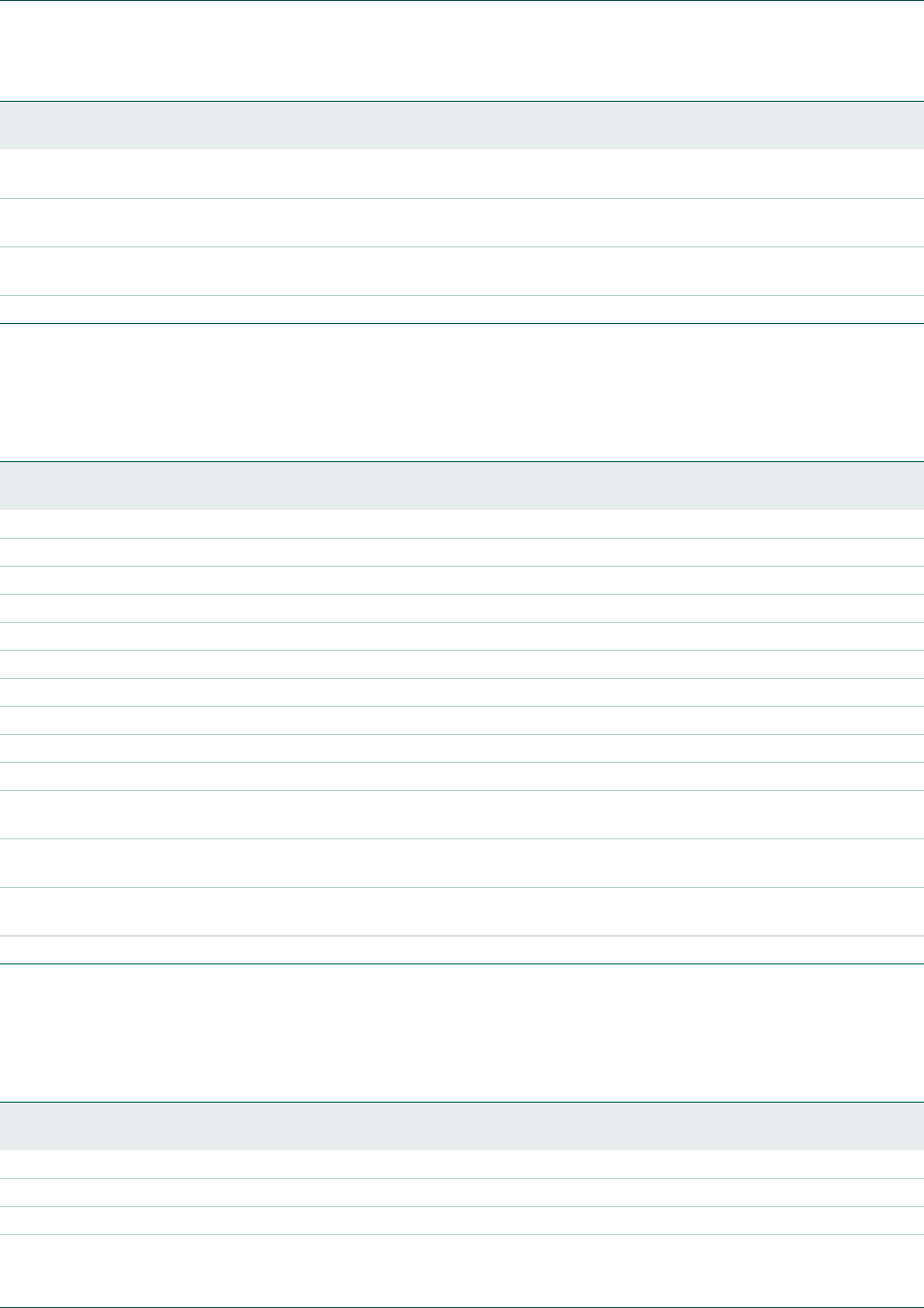
UM10360 All information provided in this document is subject to legal disclaimers. © NXP B.V. 2014. All rights reserved.
User manual Rev. 3.1 — 2 April 2014 564 of 849
NXP Semiconductors UM10360
Chapter 26: LPC176x/5x Quadrature Encoder Interface (QEI)
26.6.4.3 QEI Interrupt Clear register (QEICLR - 0x400B CFE8)
Writing a 1 to a bit in this register clears the corresponding bit in the QEI Interrupt Status
register (QEISTAT).
26.6.4.4 QEI Interrupt Enable register (QEIIE - 0x400B CFE4)
This register enables interrupt sources. Bits set to 1 enable the corresponding interrupt; a
0 bit disables the corresponding interrupt.
10 POS0REV_Int Combined position 0 and revolution count interrupt. Set when both the POS0_Int bit is set
and the REV_Int is set.
0
11 POS1REV_Int Combined position 1 and revolution count interrupt. Set when both the POS1_Int bit is set
and the REV_Int is set.
0
12 POS2REV_Int Combined position 2 and revolution count interrupt. Set when both the POS2_Int bit is set
and the REV_Int is set.
0
31:13 - reserved 0
Table 502: QEI Interrupt Set register (QEISET - address 0x400B CFEC) bit description …continued
Bit Symbol Description Reset
value
Table 503: QEI Interrupt Clear register (QEICLR - 0x400B CFE8) bit description
Bit Symbol Description Reset
value
0INX_Int Indicates that an index pulse was detected. 0
1TIM_Int Indicates that a velocity timer overflow occurred 0
2VELC_IntIndicates that captured velocity is less than compare velocity. 0
3DIR_Int Indicates that a change of direction was detected. 0
4ERR_IntIndicates that an encoder phase error was detected. 0
5ENCLK_IntIndicates that and encoder clock pulse was detected.
6POS0_IntIndicates that the position 0 compare value is equal to the current position. 0
7POS1_IntIndicates that the position 1compare value is equal to the current position. 0
8POS2_IntIndicates that the position 2 compare value is equal to the current position. 0
9REV_IntIndicates that the index compare value is equal to the current index count. 0
10 POS0REV_Int Combined position 0 and revolution count interrupt. Set when both the POS0_Int bit is set
and the REV_Int is set.
0
11 POS1REV_Int Combined position 1 and revolution count interrupt. Set when both the POS1_Int bit is set
and the REV_Int is set.
0
12 POS2REV_Int Combined position 2 and revolution count interrupt. Set when both the POS2_Int bit is set
and the REV_Int is set.
0
31:13 - reserved 0
Table 504: QEI Interrupt Enable register (QEIIE - address 0x400B CFE4) bit description
Bit Symbol Description Reset
value
0INX_Int Indicates that an index pulse was detected. 0
1TIM_Int Indicates that a velocity timer overflow occurred 0
2VELC_IntIndicates that captured velocity is less than compare velocity. 0
3DIR_Int Indicates that a change of direction was detected. 0

UM10360 All information provided in this document is subject to legal disclaimers. © NXP B.V. 2014. All rights reserved.
User manual Rev. 3.1 — 2 April 2014 565 of 849
NXP Semiconductors UM10360
Chapter 26: LPC176x/5x Quadrature Encoder Interface (QEI)
26.6.4.5 QEI Interrupt Enable Set register (QEIIES - 0x400B CFDC)
Writing a 1 to a bit in this register sets the corresponding bit in the QEI Interrupt Enable
register (QEIIE).
4ERR_Int Indicates that an encoder phase error was detected. 0
5ENCLK_IntIndicates that and encoder clock pulse was detected. 0
6POS0_IntIndicates that the position 0 compare value is equal to the current position. 0
7POS1_IntIndicates that the position 1compare value is equal to the current position. 0
8POS2_IntIndicates that the position 2 compare value is equal to the current position. 0
9REV_Int Indicates that the index compare value is equal to the current index count. 0
10 POS0REV_Int Combined position 0 and revolution count interrupt. Set when both the POS0_Int bit is set
and the REV_Int is set.
0
11 POS1REV_Int Combined position 1 and revolution count interrupt. Set when both the POS1_Int bit is set
and the REV_Int is set.
0
12 POS2REV_Int Combined position 2 and revolution count interrupt. Set when both the POS2_Int bit is set
and the REV_Int is set.
0
31:13 - reserved 0
Table 504: QEI Interrupt Enable register (QEIIE - address 0x400B CFE4) bit description …continued
Bit Symbol Description Reset
value
Table 505: QEI Interrupt Enable Set register (QEIIES - address 0x400B CFDC) bit description
Bit Symbol Description Reset
value
0INX_EN Indicates that an index pulse was detected. 0
1TIM_EN Indicates that a velocity timer overflow occurred 0
2VELC_ENIndicates that captured velocity is less than compare velocity. 0
3DIR_EN Indicates that a change of direction was detected. 0
4ERR_ENIndicates that an encoder phase error was detected. 0
5ENCLK_ENIndicates that and encoder clock pulse was detected. 0
6POS0_IntIndicates that the position 0 compare value is equal to the current position. 0
7POS1_IntIndicates that the position 1compare value is equal to the current position. 0
8POS2_IntIndicates that the position 2 compare value is equal to the current position. 0
9REV_Int Indicates that the index compare value is equal to the current index count. 0
10 POS0REV_Int Combined position 0 and revolution count interrupt. Set when both the POS0_Int bit is set
and the REV_Int is set.
0
11 POS1REV_Int Combined position 1 and revolution count interrupt. Set when both the POS1_Int bit is set
and the REV_Int is set.
0
12 POS2REV_Int Combined position 2 and revolution count interrupt. Set when both the POS2_Int bit is set
and the REV_Int is set.
0
31:13 - reserved 0

UM10360 All information provided in this document is subject to legal disclaimers. © NXP B.V. 2014. All rights reserved.
User manual Rev. 3.1 — 2 April 2014 566 of 849
NXP Semiconductors UM10360
Chapter 26: LPC176x/5x Quadrature Encoder Interface (QEI)
26.6.4.6 QEI Interrupt Enable Clear register (QEIIEC - 0x400B CFD8)
Writing a 1 to a bit in this register clears the corresponding bit in the QEI Interrupt Enable
register (QEIIE).
Table 506: QEI Interrupt Enable Clear register (QEIIEC - address 0x400B CFD8) bit description
Bit Symbol Description Reset
value
0INX_EN Indicates that an index pulse was detected. 0
1TIM_EN Indicates that a velocity timer overflow occurred 0
2VELC_ENIndicates that captured velocity is less than compare velocity. 0
3DIR_EN Indicates that a change of direction was detected. 0
4ERR_ENIndicates that an encoder phase error was detected. 0
5ENCLK_ENIndicates that and encoder clock pulse was detected. 0
6POS0_IntIndicates that the position 0 compare value is equal to the current position. 0
7POS1_IntIndicates that the position 1compare value is equal to the current position. 0
8POS2_IntIndicates that the position 2 compare value is equal to the current position. 0
9REV_IntIndicates that the index compare value is equal to the current index count. 0
10 POS0REV_Int Combined position 0 and revolution count interrupt. Set when both the POS0_Int bit is set
and the REV_Int is set.
0
11 POS1REV_Int Combined position 1 and revolution count interrupt. Set when both the POS1_Int bit is set
and the REV_Int is set.
0
12 POS2REV_Int Combined position 2 and revolution count interrupt. Set when both the POS2_Int bit is set
and the REV_Int is set.
0
31:13 - reserved 0

UM10360 All information provided in this document is subject to legal disclaimers. © NXP B.V. 2014. All rights reserved.
User manual Rev. 3.1 — 2 April 2014 567 of 849
27.1 Basic configuration
The RTC is configured using the following registers:
1. Power: In the PCONP register (Ta b le 46 ), set bits PCRTC.
Remark: On reset, the RTC is enabled. See Section 27.7 for power saving options.
2. Clock: The RTC uses the 1 Hz clock output from the RTC oscillator as the only clock
source. The peripheral clock rate for accessing registers is CCLK/8.
3. Interrupts: See Section 27.6.1 for RTC interrupt handling. Interrupts are enabled in
the NVIC using the appropriate Interrupt Set Enable register. The RTC interrupt can
wake up the device from deep-sleep, power-down, or deep power-down modes. See
Section 27.6.1.
27.2 Features
•Measures the passage of time to maintain a calendar and clock. Provides seconds,
minutes, hours, day of month, month, year, day of week, and day of year.
•Ultra-low power design to support battery powered systems. Less than 1 microamp
required for battery operation. Uses power from the CPU power supply when it is
present.
•20 bytes of Battery-backed storage and RTC operation when power is removed from
the CPU.
•Dedicated 32 kHz ultra low power oscillator.
•Dedicated battery power supply pin.
•RTC power supply is isolated from the rest of the chip.
•Calibration counter allows adjustment to better than 1 sec/day with 1 sec resolution.
•Periodic interrupts can be generated from increments of any field of the time registers.
•Alarm interrupt can be generated for a specific date/time.
27.3 Description
The Real Time Clock (RTC) is a set of counters for measuring time when system power is
on, and optionally when it is off. It uses very little power when its registers are not being
accessed by the CPU, especially reduced power modes. On the LPC176x/5x, the RTC is
clocked by a separate 32 kHz oscillator that produces a 1 Hz internal time reference. The
RTC is powered by its own power supply pin, VBAT, which can be connected to a battery,
externally tied to a 3V supply, or left floating.
The RTC power domain is shown in conceptual form in Figure 131. A detailed view of the
time keeping portion of the RTC is shown in Figure 132.
UM10360
Chapter 27: LPC176x/5x Real-Time Clock (RTC) and backup
registers
Rev. 3.1 — 2 April 2014 User manual
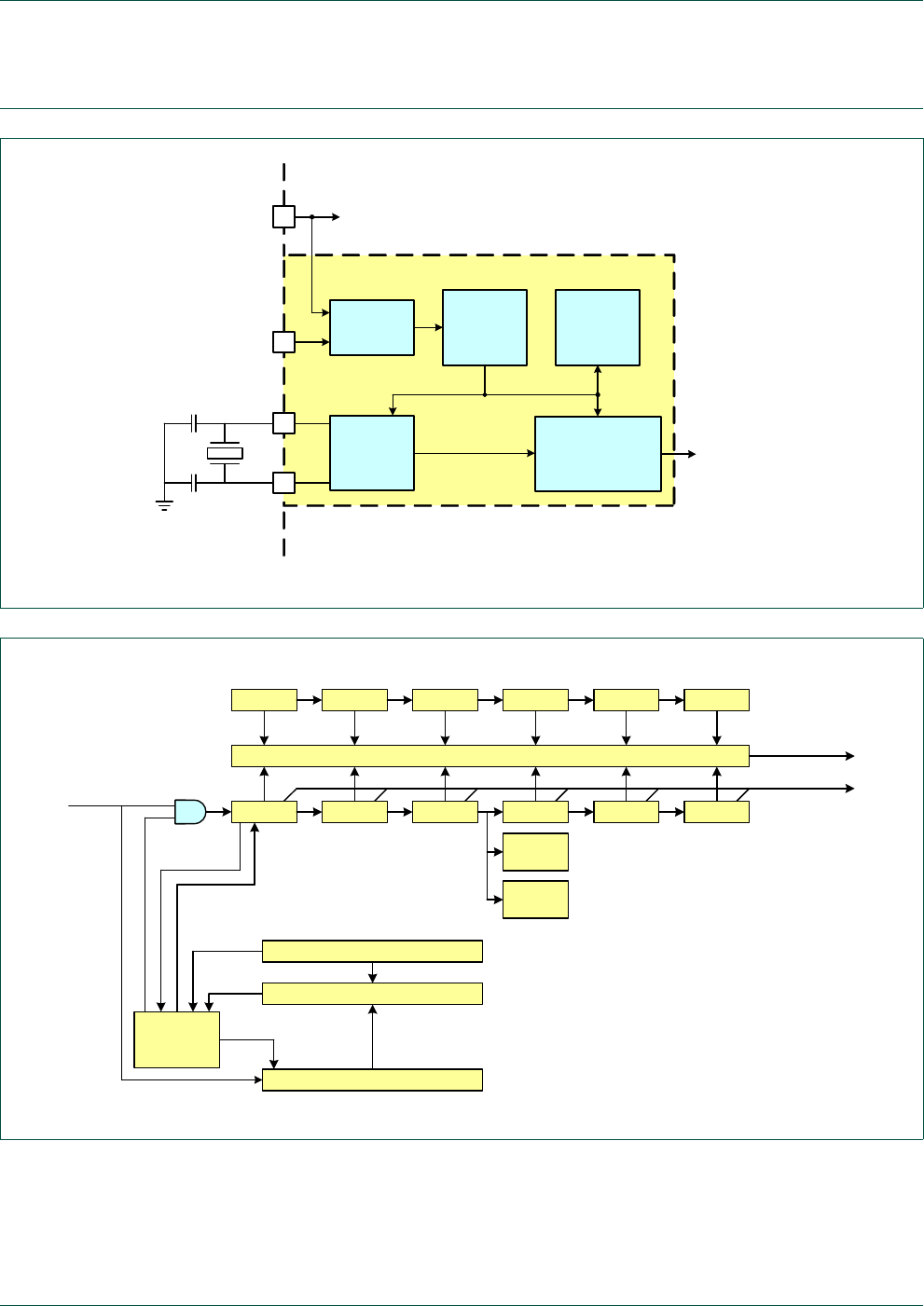
UM10360 All information provided in this document is subject to legal disclaimers. © NXP B.V. 2014. All rights reserved.
User manual Rev. 3.1 — 2 April 2014 568 of 849
NXP Semiconductors UM10360
Chapter 27: LPC176x/5x Real-Time Clock (RTC) and backup registers
27.4 Architecture
Fig 131. RTC domain conceptual diagram
VBAT pin
Ultra-low
power
regulator
Power
selector
VDD(REG)(3v3) pin
Ultra-low
power
oscillator
to main regulator
1 Hz clock
RTC power
Backup
Registers
Real Time Clock
Functional Block
RTC power domain
RTCX1
RTCX2
RTC Alarm
& Interrupt
Fig 132. RTC functional block diagram
day of
year
second minute hour day month year
alarm compare
second minute hour day month year
day of
week
calibration counter
calibration compare register
calibration
control
logic
calibration compare
sign
bit
match
counter
reset
LSB
set
LSB
out Time Registers
Alarm Registers
Calibration
Alarm out
and Alarm
Interrupts
Counter
Increment
Interrupts
1 Hz
Clock

UM10360 All information provided in this document is subject to legal disclaimers. © NXP B.V. 2014. All rights reserved.
User manual Rev. 3.1 — 2 April 2014 569 of 849
NXP Semiconductors UM10360
Chapter 27: LPC176x/5x Real-Time Clock (RTC) and backup registers
27.5 Pin description
27.6 Register description
The RTC includes a number of registers, shown in Ta b l e 5 0 8. Detailed descriptions of the
registers follow. In these descriptions, for most of the registers the Reset Value column
shows "NC", meaning that these registers are Not Changed by a Reset. Software must
initialize these registers between power-on and setting the RTC into operation. The
registers are split into five sections by functionality.
Table 507. RTC pin description
Name Type Description
RTCX1 I Input to the RTC oscillator circuit.
RTCX2 O Output from the RTC oscillator circuit.
Remark: If the RTC is not used, the RTCX1/2 pins can be left floating.
VBAT IRTC power supply: Typically connected to an external 3V battery. If this pin is not
powered, the RTC is still powered internally if VDD(REG)(3V3) is present.

UM10360 All information provided in this document is subject to legal disclaimers. © NXP B.V. 2014. All rights reserved.
User manual Rev. 3.1 — 2 April 2014 570 of 849
NXP Semiconductors UM10360
Chapter 27: LPC176x/5x Real-Time Clock (RTC) and backup registers
[1] Reset values apply only to a power-up of the RTC block, other types of reset have no effect on this block.
Since the RTC is powered whenever either of the VDD(REG)(3V3), or VBAT supplies are present, power-up
reset occurs only when both supplies were absent and then one is turned on. Most registers are not
affected by power-up of the RTC and must be initialized by software if the RTC is enabled. The Reset Value
reflects the data stored in used bits only. It does not include reserved bits content.
Table 508. Real-Time Clock register map
Name Description Access Reset
Value[1]
Address
Miscellaneous registers (see Section 27.6.2)
ILR Interrupt Location Register R/W 0 0x4002 4000
CCR Clock Control Register R/W NC 0x4002 4008
CIIR Counter Increment Interrupt Register R/W 0 0x4002 400C
AMR Alarm Mask Register R/W 0 0x4002 4010
RTC_AUX RTC Auxiliary control register R/W 0x10 0x4002 405C
RTC_AUXEN RTC Auxiliary Enable register R/W 0 0x4002 4058
Consolidated time registers (see Section 27.6.3)
CTIME0 Consolidated Time Register 0 RO NC 0x4002 4014
CTIME1 Consolidated Time Register 1 RO NC 0x4002 4018
CTIME2 Consolidated Time Register 2 RO NC 0x4002 401C
Time counter registers (see Section 27.6.4)
SEC Seconds Counter R/W NC 0x4002 4020
MIN Minutes Register R/W NC 0x4002 4024
HOUR Hours Register R/W NC 0x4002 4028
DOM Day of Month Register R/W NC 0x4002 402C
DOW Day of Week Register R/W NC 0x4002 4030
DOY Day of Year Register R/W NC 0x4002 4034
MONTH Months Register R/W NC 0x4002 4038
YEAR Years Register R/W NC 0x4002 403C
CALIBRATION Calibration Value Register R/W NC 0x4002 4040
General purpose registers (see Section 27.6.6)
GPREG0 General Purpose Register 0 R/W NC 0x4002 4044
GPREG1 General Purpose Register 1 R/W NC 0x4002 4048
GPREG2 General Purpose Register 2 R/W NC 0x4002 404C
GPREG3 General Purpose Register 3 R/W NC 0x4002 4050
GPREG4 General Purpose Register 4 R/W NC 0x4002 4054
Alarm register group (see Section 27.6.7)
ALSEC Alarm value for Seconds R/W NC 0x4002 4060
ALMIN Alarm value for Minutes R/W NC 0x4002 4064
ALHOUR Alarm value for Hours R/W NC 0x4002 4068
ALDOM Alarm value for Day of Month R/W NC 0x4002 406C
ALDOW Alarm value for Day of Week R/W NC 0x4002 4070
ALDOY Alarm value for Day of Year R/W NC 0x4002 4074
ALMON Alarm value for Months R/W NC 0x4002 4078
ALYEAR Alarm value for Year R/W NC 0x4002 407C

UM10360 All information provided in this document is subject to legal disclaimers. © NXP B.V. 2014. All rights reserved.
User manual Rev. 3.1 — 2 April 2014 571 of 849
NXP Semiconductors UM10360
Chapter 27: LPC176x/5x Real-Time Clock (RTC) and backup registers
27.6.1 RTC interrupts
Interrupt generation is controlled through the Interrupt Location Register (ILR), Counter
Increment Interrupt Register (CIIR), the alarm registers, and the Alarm Mask Register
(AMR). Interrupts are generated only by the transition into the interrupt state. The ILR
separately enables CIIR and AMR interrupts. Each bit in CIIR corresponds to one of the
time counters. If CIIR is enabled for a particular counter, then every time the counter is
incremented an interrupt is generated. The alarm registers allow the user to specify a date
and time for an interrupt to be generated. The AMR provides a mechanism to mask alarm
compares. If all non-masked alarm registers match the value in their corresponding time
counter, then an interrupt is generated.
The RTC interrupt can bring the microcontroller out of Power-down mode when the RTC
is operating from its own oscillator on the RTCX1-2 pins. When the RTC interrupt is
enabled for wake-up and its selected event occurs, the oscillator wake-up cycle
associated with the XTAL1/2 pins is started. For details on the RTC based wake-up
process see Section 4.8.8 “Wake-up from Reduced Power Modes” on page 63 and
Section 4.9 “Wake-up timer” on page 66.
27.6.2 Miscellaneous register group
27.6.2.1 Interrupt Location Register (ILR - 0x4002 4000)
The Interrupt Location Register is a 2-bit register that specifies which blocks are
generating an interrupt (see Tab le 5 09 ). Writing a one to the appropriate bit clears the
corresponding interrupt. Writing a zero has no effect. This allows the programmer to read
this register and write back the same value to clear only the interrupt that is detected by
the read.
27.6.2.2 Clock Control Register (CCR - 0x4002 4008)
The clock register is a 4-bit register that controls the operation of the clock divide circuit.
Each bit of the clock register is described in Tab l e 5 1 0 . All NC bits in this register should
be initialized when the RTC is first turned on.
Table 509. Interrupt Location Register (ILR - address 0x4002 4000) bit description
Bit Symbol Description Reset
value
0RTCCIFWhen one, the Counter Increment Interrupt block generated an interrupt. Writing a one to this bit
location clears the counter increment interrupt.
0
1RTCALFWhen one, the alarm registers generated an interrupt. Writing a one to this bit location clears the
alarm interrupt.
0
31:21 - Reserved, user software should not write ones to reserved bits. The value read from a reserved
bit is not defined.
NA
Table 510. Clock Control Register (CCR - address 0x4002 4008) bit description
Bit Symbol Value Description Reset
value
0CLKEN Clock Enable. NC
1The time counters are enabled.
0The time counters are disabled so that they may be initialized.
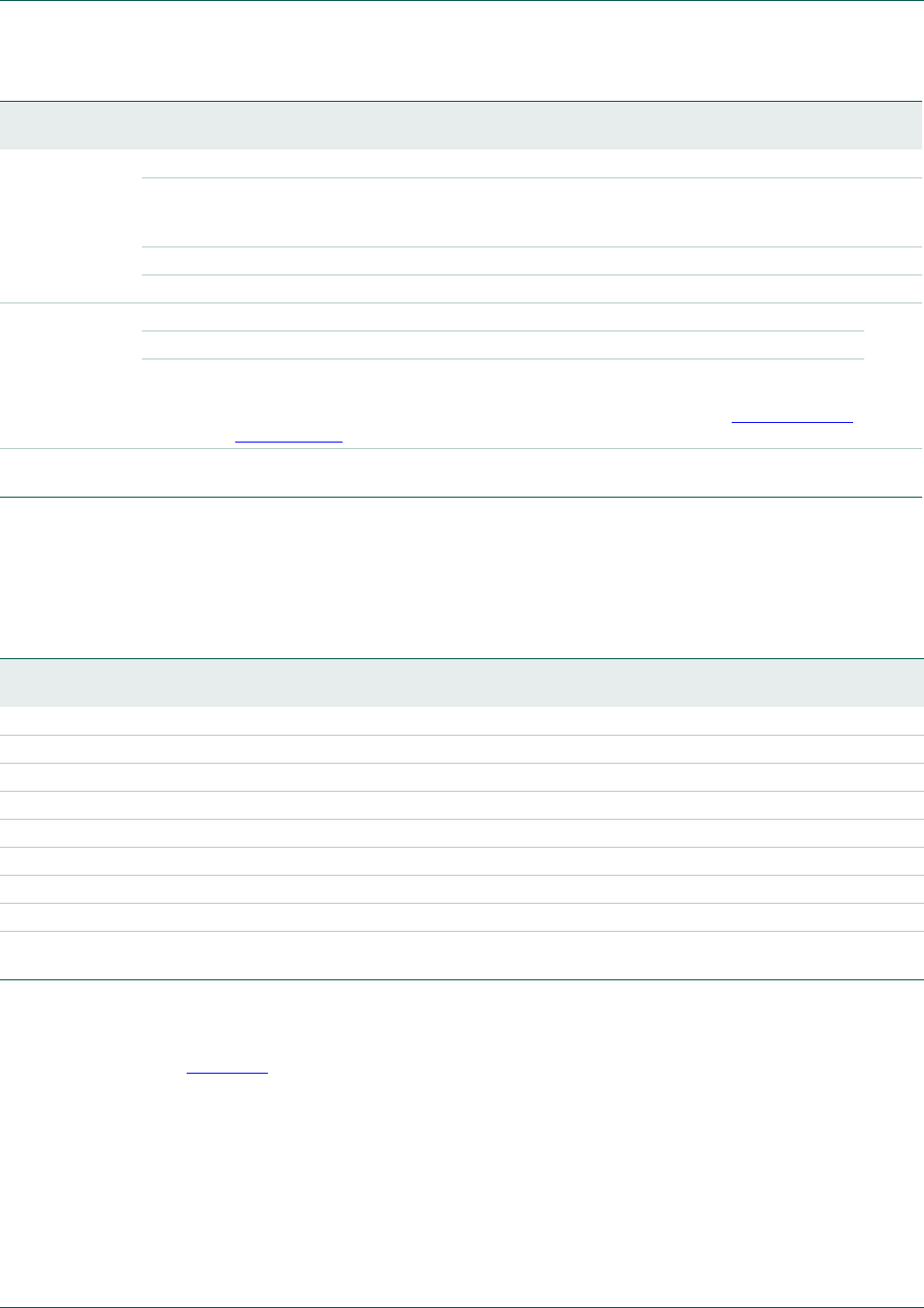
UM10360 All information provided in this document is subject to legal disclaimers. © NXP B.V. 2014. All rights reserved.
User manual Rev. 3.1 — 2 April 2014 572 of 849
NXP Semiconductors UM10360
Chapter 27: LPC176x/5x Real-Time Clock (RTC) and backup registers
27.6.2.3 Counter Increment Interrupt Register (CIIR - 0x4002 400C)
The Counter Increment Interrupt Register (CIIR) gives the ability to generate an interrupt
every time a counter is incremented. This interrupt remains valid until cleared by writing a
1 to bit 0 of the Interrupt Location Register (ILR[0]).
27.6.2.4 Alarm Mask Register (AMR - 0x4002 4010)
The Alarm Mask Register (AMR) allows the user to mask any of the alarm registers.
Tab l e 5 12 shows the relationship between the bits in the AMR and the alarms. For the
alarm function, every non-masked alarm register must match the corresponding time
counter for an interrupt to be generated. The interrupt is generated only when the counter
comparison first changes from no match to match. The interrupt is removed when a one is
written to the appropriate bit of the Interrupt Location Register (ILR). If all mask bits are
set, then the alarm is disabled.
1CTCRST CTC Reset. 0
1When one, the elements in the internal oscillator divider are reset, and remain reset until
CCR[1] is changed to zero. This is the divider that generates the 1 Hz clock from the
32.768 kHz crystal. The state of the divider is not visible to software.
0No effect.
3:2 - Internal test mode controls. These bits must be 0 for normal RTC operation. NC
4CCALEN Calibration counter enable. NC
1The calibration counter is disabled and reset to zero.
0The calibration counter is enabled and counting, using the 1Hz clock. When the
calibration counter is equal to the value of the CALIBRATION register, the counter resets
and repeats counting up to the value of the CALIBRATION register. See Section 27.6.4.2
and Section 27.6.5.
31:5 - Reserved, user software should not write ones to reserved bits. The value read from a
reserved bit is not defined.
NA
Table 510. Clock Control Register (CCR - address 0x4002 4008) bit description …continued
Bit Symbol Value Description Reset
value
Table 511. Counter Increment Interrupt Register (CIIR - address 0x4002 400C) bit description
Bit Symbol Description Reset
value
0IMSECWhen 1, an increment of the Second value generates an interrupt. 0
1IMMINWhen 1, an increment of the Minute value generates an interrupt. 0
2IMHOURWhen 1, an increment of the Hour value generates an interrupt. 0
3IMDOMWhen 1, an increment of the Day of Month value generates an interrupt. 0
4IMDOWWhen 1, an increment of the Day of Week value generates an interrupt. 0
5IMDOYWhen 1, an increment of the Day of Year value generates an interrupt. 0
6IMMONWhen 1, an increment of the Month value generates an interrupt. 0
7IMYEARWhen 1, an increment of the Year value generates an interrupt. 0
31:8 - Reserved, user software should not write ones to reserved bits. The value read from a reserved
bit is not defined.
NA
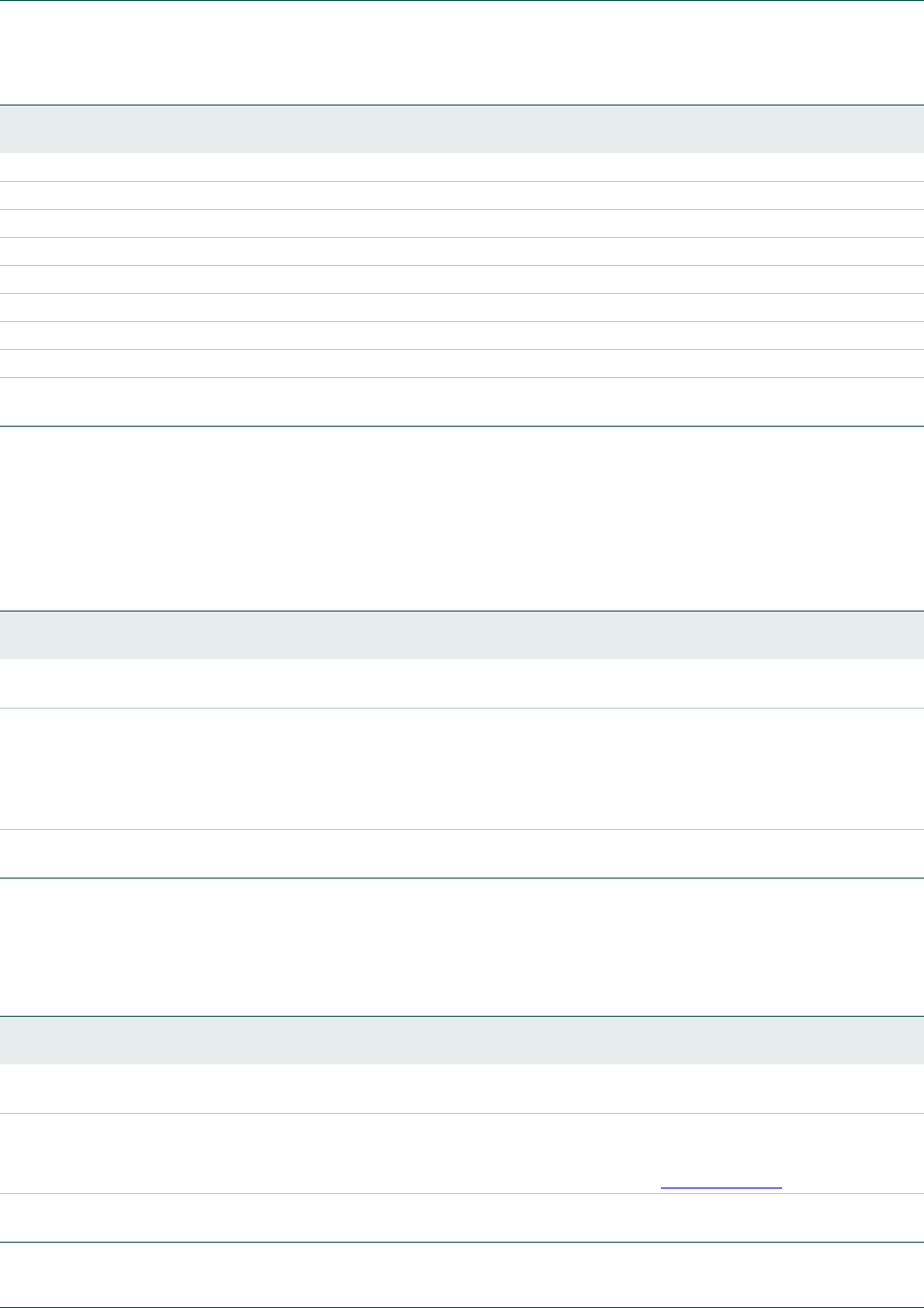
UM10360 All information provided in this document is subject to legal disclaimers. © NXP B.V. 2014. All rights reserved.
User manual Rev. 3.1 — 2 April 2014 573 of 849
NXP Semiconductors UM10360
Chapter 27: LPC176x/5x Real-Time Clock (RTC) and backup registers
27.6.2.5 RTC Auxiliary control register (RTC_AUX - 0x4002 405C)
The RTC Auxiliary Control register contains added interrupt flags for functions that are not
part of the Real Time Clock itself (the part recording the passage of time and generating
other time related functions). On the LPC176x/5x, the only added interrupt flag is for
failure of the RTC oscillator.
27.6.2.6 RTC Auxiliary Enable register (RTC_AUXEN - 0x4002 4058)
The RTC Auxiliary Enable Register controls whether additional interrupt sources
represented in the RTC Auxiliary control register are enabled.
Table 512. Alarm Mask Register (AMR - address 0x4002 4010) bit description
Bit Symbol Description Reset
value
0AMRSECWhen 1, the Second value is not compared for the alarm. 0
1AMRMINWhen 1, the Minutes value is not compared for the alarm. 0
2AMRHOURWhen 1, the Hour value is not compared for the alarm. 0
3AMRDOMWhen 1, the Day of Month value is not compared for the alarm. 0
4AMRDOWWhen 1, the Day of Week value is not compared for the alarm. 0
5AMRDOYWhen 1, the Day of Year value is not compared for the alarm. 0
6AMRMONWhen 1, the Month value is not compared for the alarm. 0
7AMRYEARWhen 1, the Year value is not compared for the alarm. 0
31:8 - Reserved, user software should not write ones to reserved bits. The value read from a
reserved bit is not defined.
NA
Table 513. RTC Auxiliary control register (RTC_AUX - address 0x4002 405C) bit description
Bit Symbol Description Reset
value
3:0 - Reserved, user software should not write ones to reserved bits. The value read from a
reserved bit is not defined.
NA
4RTC_OSCFRTC Oscillator Fail detect flag.
Read: this bit is set if the RTC oscillator stops, and when RTC power is first turned on. An
interrupt will occur when this bit is set, the RTC_OSCFEN bit in RTC_AUXEN is a 1, and the
RTC interrupt is enabled in the NVIC.
Write: writing a 1 to this bit clears the flag.
1
31:5 - Reserved, user software should not write ones to reserved bits. The value read from a
reserved bit is not defined.
NA
Table 514. RTC Auxiliary Enable register (RTC_AUXEN - address 0x4002 4058) bit description
Bit Symbol Description Reset
value
3:0 - Reserved, user software should not write ones to reserved bits. The value read from a
reserved bit is not defined.
NA
4RTC_OSCFENOscillator Fail Detect interrupt enable.
When 0: the RTC Oscillator Fail detect interrupt is disabled.
When 1: the RTC Oscillator Fail detect interrupt is enabled. See Section 27.6.2.5.
0
31:5 - Reserved, user software should not write ones to reserved bits. The value read from a
reserved bit is not defined.
NA
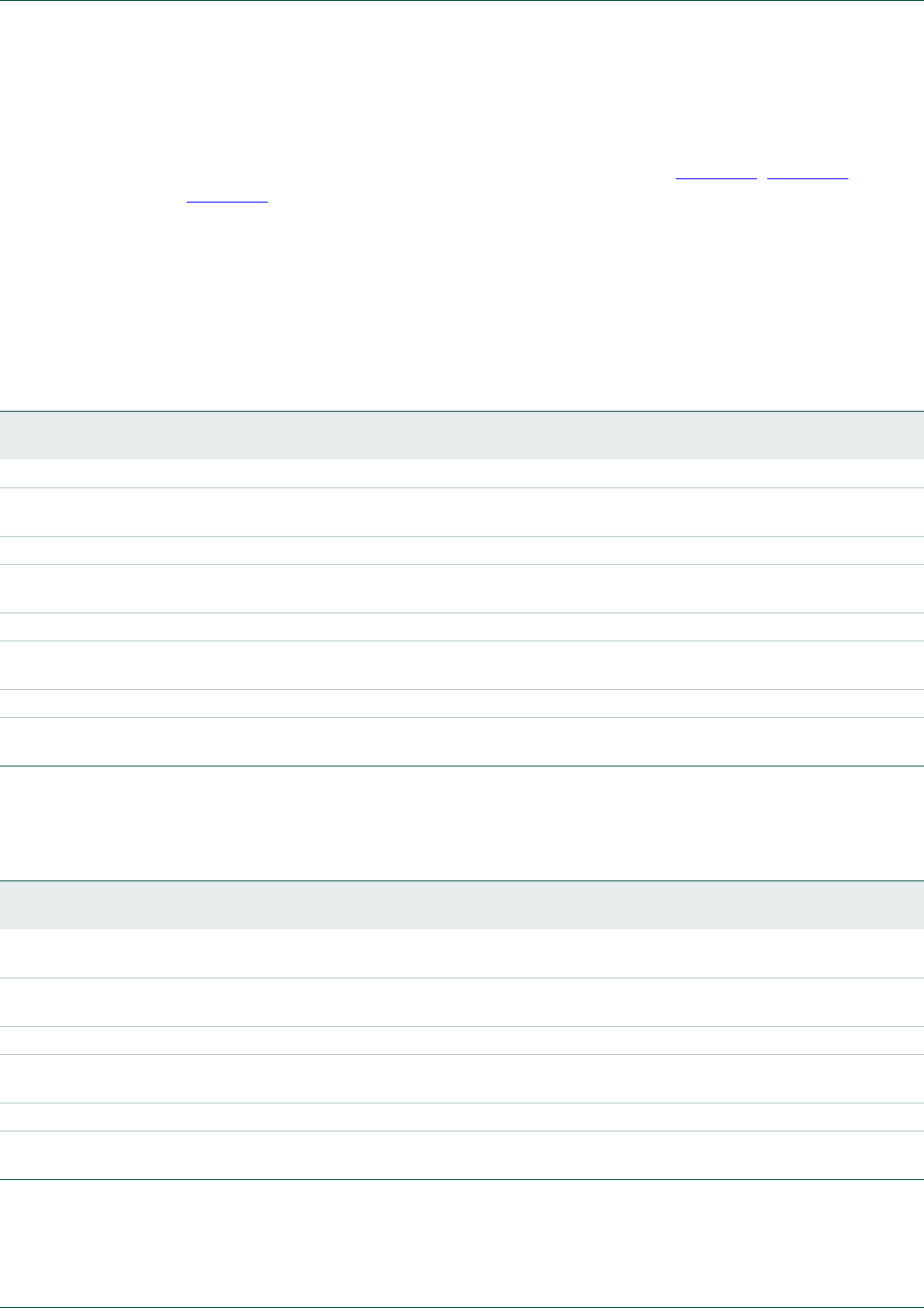
UM10360 All information provided in this document is subject to legal disclaimers. © NXP B.V. 2014. All rights reserved.
User manual Rev. 3.1 — 2 April 2014 574 of 849
NXP Semiconductors UM10360
Chapter 27: LPC176x/5x Real-Time Clock (RTC) and backup registers
27.6.3 Consolidated time registers
The values of the Time Counters can optionally be read in a consolidated format which
allows the programmer to read all time counters with only three read operations. The
various registers are packed into 32-bit values as shown in Tab l e 5 15 , Ta b le 5 1 6, and
Tab l e 5 17 . The least significant bit of each register is read back at bit 0, 8, 16, or 24.
The Consolidated Time Registers are read-only. To write new values to the Time
Counters, the Time Counter addresses should be used.
27.6.3.1 Consolidated Time Register 0 (CTIME0 - 0x4002 4014)
The Consolidated Time Register 0 contains the low order time values: Seconds, Minutes,
Hours, and Day of Week.
27.6.3.2 Consolidated Time Register 1 (CTIME1 - 0x4002 4018)
The Consolidate Time Register 1 contains the Day of Month, Month, and Year values.
27.6.3.3 Consolidated Time Register 2 (CTIME2 - 0x4002 401C)
The Consolidate Time Register 2 contains just the Day of Year value.
Table 515. Consolidated Time register 0 (CTIME0 - address 0x4002 4014) bit description
Bit Symbol Description Reset
value
5:0 Seconds Seconds value in the range of 0 to 59 NC
7:6 - Reserved, user software should not write ones to reserved bits. The value read from a
reserved bit is not defined.
NA
13:8 Minutes Minutes value in the range of 0 to 59 NC
15:14 - Reserved, user software should not write ones to reserved bits. The value read from a
reserved bit is not defined.
NA
20:16 Hours Hours value in the range of 0 to 23 NC
23:21 - Reserved, user software should not write ones to reserved bits. The value read from a
reserved bit is not defined.
NC
26:24 Day Of Week Day of week value in the range of 0 to 6 NA
31:27 - Reserved, user software should not write ones to reserved bits. The value read from a
reserved bit is not defined.
NC
Table 516. Consolidated Time register 1 (CTIME1 - address 0x4002 4018) bit description
Bit Symbol Description Reset
value
4:0 Day of Month Day of month value in the range of 1 to 28, 29, 30, or 31 (depending on the month and
whether it is a leap year).
NC
7:5 - Reserved, user software should not write ones to reserved bits. The value read from a
reserved bit is not defined.
NA
11:8 Month Month value in the range of 1 to 12. NC
15:12 - Reserved, user software should not write ones to reserved bits. The value read from a
reserved bit is not defined.
NA
27:16 Year Year value in the range of 0 to 4095. NC
31:28 - Reserved, user software should not write ones to reserved bits. The value read from a
reserved bit is not defined.
NA

UM10360 All information provided in this document is subject to legal disclaimers. © NXP B.V. 2014. All rights reserved.
User manual Rev. 3.1 — 2 April 2014 575 of 849
NXP Semiconductors UM10360
Chapter 27: LPC176x/5x Real-Time Clock (RTC) and backup registers
27.6.4 Time Counter Group
The time value consists of the eight counters shown in Ta bl e 5 1 8 and Tab l e 51 9 . These
counters can be read or written at the locations shown in Tab l e 5 19 .
[1] These values are simply incremented at the appropriate intervals and reset at the defined overflow point.
They are not calculated and must be correctly initialized in order to be meaningful.
27.6.4.1 Leap year calculation
The RTC does a simple bit comparison to see if the two lowest order bits of the year
counter are zero. If true, then the RTC considers that year a leap year. The RTC considers
all years evenly divisible by 4 as leap years. This algorithm is accurate from the year 1901
through the year 2099, but fails for the year 2100, which is not a leap year. The only effect
of leap year on the RTC is to alter the length of the month of February for the month, day
of month, and year counters.
27.6.4.2 Calibration register (CALIBRATION - address 0x4002 4040)
The following register is used to calibrate the time counter.
Table 517. Consolidated Time register 2 (CTIME2 - address 0x4002 401C) bit description
Bit Symbol Description Reset
value
11:0 Day of Year Day of year value in the range of 1 to 365 (366 for leap years). NC
31:12 - Reserved, user software should not write ones to reserved bits. The value read from a
reserved bit is not defined.
NA
Table 518. Time Counter relationships and values
Counter Size Enabled by Minimum value Maximum value
Second 6 1 Hz Clock 0 59
Minute 6 Second 0 59
Hour 5 Minute 0 23
Day of Month 5 Hour 1 28, 29, 30 or 31
Day of Week 3 Hour 0 6
Day of Year 9 Hour 1 365 or 366 (for leap year)
Month 4 Day of Month 1 12
Year 12 Mont h or day of Year 0 4095
Table 519. Time Counter registers
Name Size Description Access Address
SEC 6 Seconds value in the range of 0 to 59 R/W 0x4002 4020
MIN 6 Minutes value in the range of 0 to 59 R/W 0x4002 4024
HOUR 5 Hours value in the range of 0 to 23 R/W 0x4002 4028
DOM 5 Day of month value in the range of 1 to 28, 29, 30, or 31 (depending on the
month and whether it is a leap year).[1]
R/W 0x4002 402C
DOW 3 Day of week value in the range of 0 to 6[1] R/W 0x4002 4030
DOY 9 Day of year value in the range of 1 to 365 (366 for leap years)[1] R/W 0x4002 4034
MONTH 4 Month value in the range of 1 to 12 R/W 0x4002 4038
YEAR 12 Year value in the range of 0 to 4095 R/W 0x4002 403C

UM10360 All information provided in this document is subject to legal disclaimers. © NXP B.V. 2014. All rights reserved.
User manual Rev. 3.1 — 2 April 2014 576 of 849
NXP Semiconductors UM10360
Chapter 27: LPC176x/5x Real-Time Clock (RTC) and backup registers
27.6.5 Calibration procedure
The calibration logic can periodically adjust the time counter either by not incrementing
the counter, or by incrementing the counter by 2 instead of 1. This allows calibrating the
RTC oscillator under some typical voltage and temperature conditions without the need to
externally trim the RTC oscillator.
A recommended method for determining the calibration value is to use the CLKOUT
feature to unintrusively observe the RTC oscillator frequency under the conditions it is to
be trimmed for, and calculating the number of clocks that will be seen before the time is off
by one second. That value is used to determine CALVAL.
If the RTC oscillator is trimmed externally, the same method of unintrusively observing the
RTC oscillator frequency may be helpful in that process.
Backward calibration
Enable the RTC timer and calibration in the CCR register (set bits CLKEN = 1 and
CCALEN = 0). In the CALIBRATION register, set the calibration value CALVAL 1 and
select CALDIR = 1.
•The SEC timer and the calibration counter count up for every 1 Hz clock cycle.
•When the calibration counter reaches CALVAL, a calibration match occurs and all
RTC timers will be stopped for one clock cycle so that the timers will not increment in
the next cycle.
•If an alarm match event occurs in the same cycle as the calibration match, the alarm
interrupt will be delayed by one cycle to avoid a double alarm interrupt.
Forward calibration
Enable the RTC timer and calibration in the CCR register (set bits CLKEN = 1 and
CCALEN = 0). In the CALIBRATION register, set the calibration value CALVAL 1 and
select CALDIR = 0.
•The SEC timer and the calibration counter count up for every 1 Hz clock cycle.
•When the calibration counter reaches CALVAL, a calibration match occurs and the
RTC timers are incremented by 2.
•When the calibration event occurs, the LSB of the ALSEC register is forced to be one
so that the alarm interrupt will not be missed when skipping a second.
Table 520. Calibration register (CALIBRATION - address 0x4002 4040) bit description
Bit Symbol Value Description Reset
value
16:0 CALVAL - If enabled, the calibration counter counts up to this value. The maximum value is 131,
072 corresponding to about 36.4 hours. Calibration is disabled if CALVAL = 0.
NC
17 CALDIR Calibration direction NC
1Backward calibration. When CALVAL is equal to the calibration counter, the RTC
timers will stop incrementing for 1 second.
0Forward calibration. When CALVAL is equal to the calibration counter, the RTC timers
will jump by 2 seconds.
31:12 Reserved, user software should not write ones to reserved bits. The value read from a
reserved bit is not defined.
NA

UM10360 All information provided in this document is subject to legal disclaimers. © NXP B.V. 2014. All rights reserved.
User manual Rev. 3.1 — 2 April 2014 577 of 849
NXP Semiconductors UM10360
Chapter 27: LPC176x/5x Real-Time Clock (RTC) and backup registers
27.6.6 General purpose registers
27.6.6.1 General purpose registers 0 to 4 (GPREG0 to GPREG4 - addresses
0x4002 4044 to 0x4002 4054)
These registers can be used to store important information when the main power supply is
off. The value in these registers is not affected by chip reset.
27.6.7 Alarm register group
The alarm registers are shown in Ta bl e 5 2 2 . The values in these registers are compared
with the time counters. If all the unmasked (See Section 27.6.2.4 “Alarm Mask Register
(AMR - 0x4002 4010)” on page 572) alarm registers match their corresponding time
counters then an interrupt is generated. The interrupt is cleared when a 1 is written to bit 1
of the Interrupt Location Register (ILR[1]).
27.7 RTC usage notes
If the RTC is used, VBAT may be connected to an independent power supply (typically an
external battery), or left floating. The RTC domain will always be internally powered if
VDD(REG)(3V3) is present, even if there is no power applied to VBAT. As long as power is
available on either VDD(REG)(3V3) or VBAT, the RTC will retain its time value and the backup
register contents. If both VDD(REG)(3V3) and VBAT are not present, all RTC information will
be lost. RTC incrementation will stop or be unpredictable if the clock source is lost,
interrupted, or altered.
Table 521. General purpose registers 0 to 4 (GPREG0 to GPREG4 - addresses 0x4002 4044
to 0x4002 4054) bit description
Bit Symbol Description Reset
value
31:0 GP0 to GP4 General purpose storage. N/A
Table 522. Alarm registers
Name Size Description Access Address
ALSEC 6 Alarm value for Seconds R/W 0x4002 4060
ALMIN 6 Alarm value for Minutes R/W 0x4002 4064
ALHOUR 5 Alarm value for Hours R/W 0x4002 4068
ALDOM 5 Alarm value for Day of Month R/W 0x4002 406C
ALDOW 3 Alarm value for Day of Week R/W 0x4002 4070
ALDOY 9 Alarm value for Day of Year R/W 0x4002 4074
ALMON 4 Alarm value for Months R/W 0x4002 4078
ALYEAR 12 Alarm value for Years R/W 0x4002 407C

UM10360 All information provided in this document is subject to legal disclaimers. © NXP B.V. 2014. All rights reserved.
User manual Rev. 3.1 — 2 April 2014 578 of 849
28.1 Features
•Internally resets chip if not periodically reloaded.
•Debug mode.
•Enabled by software but requires a hardware reset or a Watchdog reset/interrupt to be
disabled.
•Incorrect/Incomplete feed sequence causes reset/interrupt if enabled.
•Flag to indicate Watchdog reset.
•Programmable 32-bit timer with internal pre-scaler.
•Selectable time period from (TWDCLK 256 4) to (TWDCLK 232 4) in multiples of
TWDCLK 4.
•The Watchdog clock (WDCLK) source can be selected from the Internal RC oscillator
(IRC), the APB peripheral clock (PCLK, see Ta b l e 4 0 ), or the RTC oscillator. This
gives a wide range of potential timing choices for Watchdog operation under different
power reduction conditions. For increased reliability, it also provides the ability to run
the Watchdog timer from an entirely internal source that is not dependent on an
external crystal and its associated components and wiring.
•The Watchdog timer can be configured to run in Deep Sleep mode when using the
IRC as the clock source.
28.2 Applications
The purpose of the Watchdog is to reset the microcontroller within a reasonable amount of
time if it enters an erroneous state. When enabled, the Watchdog will generate a system
reset if the user program fails to "feed" (or reload) the Watchdog within a predetermined
amount of time.
For interaction of the on-chip watchdog and other peripherals, especially the reset and
boot-up procedures, please read Section 3.4 “Reset” on page 19 of this document.
UM10360
Chapter 28: LPC176x/5x Watchdog Timer (WDT)
Rev. 3.1 — 2 April 2014 User manual

UM10360 All information provided in this document is subject to legal disclaimers. © NXP B.V. 2014. All rights reserved.
User manual Rev. 3.1 — 2 April 2014 579 of 849
NXP Semiconductors UM10360
Chapter 28: LPC176x/5x Watchdog Timer (WDT)
28.3 Description
The Watchdog consists of a divide by 4 fixed pre-scaler and a 32-bit counter. The clock is
fed to the timer via a pre-scaler. The timer decrements when clocked. The minimum value
from which the counter decrements is 0xFF. Setting a value lower than 0xFF causes 0xFF
to be loaded in the counter. Hence the minimum Watchdog interval is (TWDCLK 256 4)
and the maximum Watchdog interval is (TWDCLK 232 4) in multiples of (TWDCLK 4).
The Watchdog should be used in the following manner:
•Set the Watchdog timer constant reload value in WDTC register.
•Setup the Watchdog timer operating mode in WDMOD register.
•Enable the Watchdog by writing 0xAA followed by 0x55 to the WDFEED register.
•The Watchdog should be fed again before the Watchdog counter underflows to
prevent reset/interrupt.
When the Watchdog is in the reset mode and the counter underflows, the CPU will be
reset, loading the stack pointer and program counter from the vector table as in the case
of external reset. The Watchdog time-out flag (WDTOF) can be examined to determine if
the Watchdog has caused the reset condition. The WDTOF flag must be cleared by
software.
The watchdog timer block uses two clocks: PCLK and WDCLK. PCLK is used for the APB
accesses to the watchdog registers. The WDCLK is used for the watchdog timer counting.
There is some synchronization logic between these two clock domains. When the
WDMOD and WDTC registers are updated by APB operations, the new value will take
effect in 3 WDCLK cycles on the logic in the WDCLK clock domain. When the watchdog
timer is counting on WDCLK, the synchronization logic will first lock the value of the
counter on WDCLK and then synchronize it with the PCLK for reading as the WDTV
register by the CPU.
28.4 Register description
The Watchdog contains 4 registers as shown in Tab l e 5 2 3 below.
[1] Reset Value reflects the data stored in used bits only. It does not include reserved bits content.
Table 523. Watchdog register map
Name Description Access Reset
Value[1]
Address
WDMOD Watchdog mode register. This register contains the basic mode and
status of the Watchdog Timer.
R/W 0 0x4000 0000
WDTC Watchdog timer constant register. This register determines the time-out
value.
R/W 0xFF 0x4000 0004
WDFEED Watchdog feed sequence register. Writing 0xAA followed by 0x55 to this
register reloads the Watchdog timer with the value contained in WDTC.
WO NA 0x4000 0008
WDTV Watchdog timer value register. This register reads out the current value of
the Watchdog timer.
RO 0xFF 0x4000 000C
WDCLKSEL Watchdog clock source selection register. R/W 0 0x4000 0010

UM10360 All information provided in this document is subject to legal disclaimers. © NXP B.V. 2014. All rights reserved.
User manual Rev. 3.1 — 2 April 2014 580 of 849
NXP Semiconductors UM10360
Chapter 28: LPC176x/5x Watchdog Timer (WDT)
28.4.1 Watchdog Mode register (WDMOD - 0x4000 0000)
The WDMOD register controls the operation of the Watchdog as per the combination of
WDEN and RESET bits. Note that a watchdog feed must be performed before any
changes to the WDMOD register take effect.
Once the WDEN and/or WDRESET bits are set they can not be cleared by software. Both
flags are cleared by an external reset or a Watchdog timer underflow.
WDTOF The Watchdog time-out flag is set when the Watchdog times out. This flag is
cleared by software.
WDINT The Watchdog interrupt flag is set when the Watchdog times out. This flag is
cleared when any reset occurs. Once the watchdog interrupt is serviced, it can be
disabled in the NVIC or the watchdog interrupt request will be generated indefinitely. the
intent of the watchdog interrupt is to allow debugging watchdog activity without resetting
the device when the watchdog overflows.
Watchdog reset or interrupt will occur any time the watchdog is running and has an
operating clock source. Any clock source works in Sleep mode, and the IRC works in
Deep Sleep mode. If a watchdog interrupt occurs in Sleep or Deep Sleep mode, it will
wake up the device.
Table 524: Watchdog Mode register (WDMOD, address 0x4000 0000) bit description
Bit Symbol Description Reset Value
0WDEN WDEN Watchdog enable bit (set-only). When 1, the watchdog timer is running. 0
1WDRESETWDRESET Watchdog reset enable bit (set -only). When 1, a watchdog time-out will
cause a chip reset.
0
2 WDTOF WDTOF Watchdog time-out flag. Set when the watchdog timer times out, cleared by
software.
0 (Only after
external reset)
3WDINTWDINT Watchdog interrupt flag (read-only, not clearable by software). 0
31:4 - Reserved, user software should not write ones to reserved bits. The value read from a
reserved bit is not defined.
NA
Table 525. Watchdog operating modes selection
WDEN WDRESET Mode of Operation
0X (0 or 1)Debug/Operate without the Watchdog running.
10 Watchdog interrupt mode: debug with the Watchdog interrupt but no WDRESET enabled.
When this mode is selected, a watchdog counter underflow will set the WDINT flag and the
Watchdog interrupt request will be generated.
11 Watchdog reset mode: operate with the Watchdog interrupt and WDRESET enabled.
When this mode is selected, a watchdog counter underflow will reset the microcontroller. Although
the Watchdog interrupt is also enabled in this case (WDEN = 1) it will not be recognized since the
watchdog reset will clear the WDINT flag.

UM10360 All information provided in this document is subject to legal disclaimers. © NXP B.V. 2014. All rights reserved.
User manual Rev. 3.1 — 2 April 2014 581 of 849
NXP Semiconductors UM10360
Chapter 28: LPC176x/5x Watchdog Timer (WDT)
28.4.2 Watchdog Timer Constant register (WDTC - 0x4000 0004)
The WDTC register determines the time-out value. Every time a feed sequence occurs
the WDTC content is reloaded in to the Watchdog timer. It’s a 32-bit register with 8 LSB
set to 1 on reset. Writing values below 0xFF will cause 0x0000 00FF to be loaded to the
WDTC. Thus the minimum time-out interval is TWDCLK 256 4.
28.4.3 Watchdog Feed register (WDFEED - 0x4000 0008)
Writing 0xAA followed by 0x55 to this register will reload the Watchdog timer with the
WDTC value. This operation will also start the Watchdog if it is enabled via the WDMOD
register. Setting the WDEN bit in the WDMOD register is not sufficient to enable the
Watchdog. A valid feed sequence must be completed after setting WDEN before the
Watchdog is capable of generating a reset. Until then, the Watchdog will ignore feed
errors. After writing 0xAA to WDFEED, access to any Watchdog register other than writing
0x55 to WDFEED causes an immediate reset/interrupt when the Watchdog is enabled.
The reset will be generated during the second PCLK following an incorrect access to a
Watchdog register during a feed sequence.
28.4.4 Watchdog Timer Value register (WDTV - 0x4000 000C)
The WDTV register is used to read the current value of Watchdog timer.
When reading the value of the 32-bit timer, the lock and synchronization procedure takes
up to 6 WDCLK cycles plus 6 PCLK cycles, so the value of WDTV is older than the actual
value of the timer when it's being read by the CPU.
28.4.5 Watchdog Timer Clock Source Selection register (WDCLKSEL -
0x4000 0010)
This register allows selecting the clock source for the Watchdog timer. The possibilities are the
Internal RC oscillator (IRC) or the APB peripheral clock (pclk). The function of bits in WDCLKSEL
are shown in Table 529. The clock source selection can be locked by software, so that it cannot be
modified. On reset, the clock source selection bits are always unlocked.
When the IRC is chosen as the watchdog clock source, the watchdog timer can remain
running in deep sleep mode, and can reset or wake up the device from that mode.
Table 526: Watchdog Constant register (WDTC, address 0x4000 0004) bit description
Bit Symbol Description Reset Value
31:0 Count Watchdog time-out interval. 0x0000 00FF
Table 527: Watchdog Feed register (WDFEED, address 0x4000 0008) bit description
Bit Symbol Description Reset
Value
7:0 Feed Feed value should be 0xAA followed by 0x55. NA
31:8 - Reserved, user software should not write ones to reserved bits. The
value read from a reserved bit is not defined.
NA
Table 528: Watchdog Timer Value register (WDTV, address 0x4000 000C) bit description
Bit Symbol Description Reset Value
31:0 Count Counter timer value. 0x0000 00FF
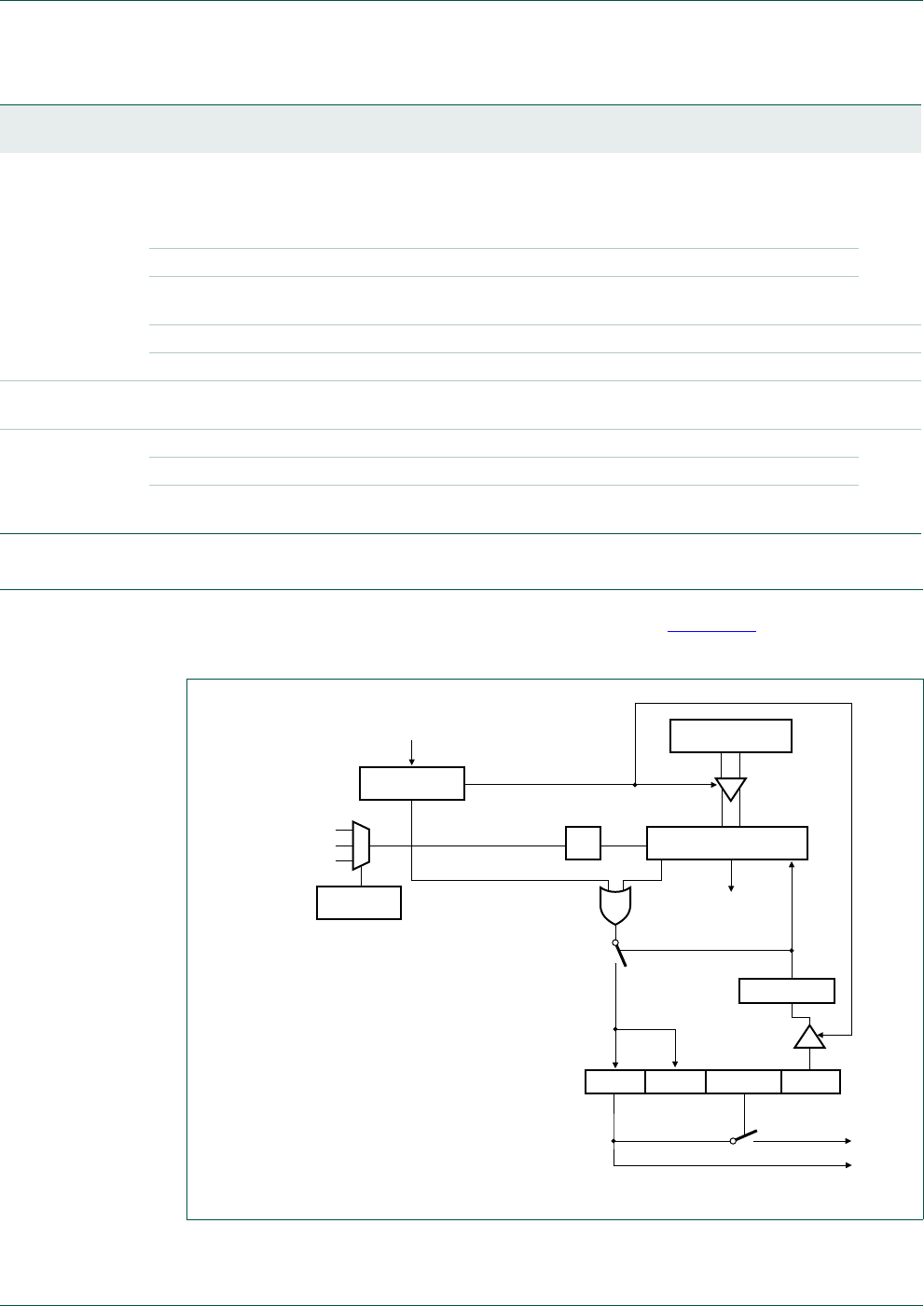
UM10360 All information provided in this document is subject to legal disclaimers. © NXP B.V. 2014. All rights reserved.
User manual Rev. 3.1 — 2 April 2014 582 of 849
NXP Semiconductors UM10360
Chapter 28: LPC176x/5x Watchdog Timer (WDT)
28.5 Block diagram
The block diagram of the Watchdog is shown below in the Figure 133. The
synchronization logic (PCLK - WDCLK) is not shown in the block diagram.
Table 529: Watchdog Timer Clock Source Selection register (WDCLKSEL, address 0x4000 0010) bit description
Bit Symbol Value Description Reset
Value
1:0 WDSEL These bits select the clock source for the Watchdog timer as described below.
Warning: Improper setting of this value may result in incorrect operation of the
Watchdog timer, which could adversely affect system operation. If the WDLOCK bit in
this register is set, the WDSEL bit cannot be modified.
0
0x0 IRC. Selects the Internal RC oscillator (irc_clk) as the Watchdog clock source (default).
0x1 PCLK. Selects the APB peripheral clock (watchdog pclk) as the Watchdog clock
source.
0x2 RTC. Selects the RTC oscillator (rtc_clk) as the Watchdog clock source.
0x3 Reserved, this setting should not be used.
30:2 - - Reserved, user software should not write ones to reserved bits. The value read from a
reserved bit is not defined.
NA
31 WDLOCK WDT locking. 0
0Unlocked. This bit is set to 0 on any reset. It cannot be cleared by software.
1 Locked. Software can set this bit to 1 at any time. Once WDLOCK is set, the bits of this
register cannot be modified.
Fig 133. Watchdog block diagram
WDTC
32-BIT DOWN COUNTER
WDINT WDTOF WDRESET WDEN
SHADOW BIT
reset
interrupt
4
WDFEED
WDCLKSEL
pclk
RTC oscillator
internal RC oscillator
feed ok
feed error
wdclk
underflow enable
count
WMOD register
feed sequence
WDTV

UM10360 All information provided in this document is subject to legal disclaimers. © NXP B.V. 2014. All rights reserved.
User manual Rev. 3.1 — 2 April 2014 583 of 849
29.1 Basic configuration
The ADC is configured using the following registers:
1. Power: In the PCONP register (Ta b le 46 ), set the PCADC bit.
Remark: On reset, the ADC is disabled. To enable the ADC, first set the PCADC bit,
and then enable the ADC in the AD0CR register (bit PDN Ta b l e 5 32 ). To disable the
ADC, first clear the PDN bit, and then clear the PCADC bit.
2. Clock: In the PCLKSEL0 register (Tab l e 40), select PCLK_ADC. To scale the clock for
the ADC, see bits CLKDIV in Tabl e 5 32.
3. Pins: Enable ADC0 pins through PINSEL registers. Select the pin modes for the port
pins with ADC0 functions through the PINMODE registers (Section 8.5).
4. Interrupts: To enable interrupts in the ADC, see Ta b le 5 3 6 . Interrupts are enabled in
the NVIC using the appropriate Interrupt Set Enable register. Disable the ADC
interrupt in the NVIC using the appropriate Interrupt Set Enable register.
5. DMA: See Section 29.6.4. For GPDMA system connections, see Table 544.
29.2 Features
•12-bit successive approximation analog to digital converter.
•Input multiplexing among 8 pins.
•Power-down mode.
•Measurement range VREFN to VREFP (typically 3 V; not to exceed VDDA voltage level).
•12-bit conversion rate of 200 kHz.
•Burst conversion mode for single or multiple inputs.
•Optional conversion on transition on input pin or Timer Match signal.
29.3 Description
Basic clocking for the A/D converters is provided by the APB clock. A programmable
divider is included in each converter to scale this clock to the clock (maximum 13 MHz)
needed by the successive approximation process. A fully accurate conversion requires 65
of these clocks.
UM10360
Chapter 29: LPC176x/5x Analog-to-Digital Converter (ADC)
Rev. 3.1 — 2 April 2014 User manual

UM10360 All information provided in this document is subject to legal disclaimers. © NXP B.V. 2014. All rights reserved.
User manual Rev. 3.1 — 2 April 2014 584 of 849
NXP Semiconductors UM10360
Chapter 29: LPC176x/5x Analog-to-Digital Converter (ADC)
29.4 Pin description
Tab l e 5 30 gives a brief summary of each of ADC related pins.
Table 530. ADC pin description
Pin Type Description
AD0.7 to AD0.0 Input Analog Inputs. The ADC cell can measure the voltage on any of these input signals.
Digital signals are disconnected from the ADC input pins when the ADC function is
selected on that pin in the Pin Select register.
Warning: if the ADC is used, signal levels on analog input pins must not be above the
level of VDDA at any time. Otherwise, A/D converter readings will be invalid. If the A/D
converter is not used in an application then the pins associated with A/D inputs can be
used as 5 V tolerant digital IO pins.
VREFP, VREFN Reference Voltage References. These pins provide a voltage reference level for the ADC and
DAC. Note: VREFP should be tied to VDD(3V3) and VREFN should be tied to VSS if
the ADC and DAC are not used.
VDDA, VSSA Power Analog Power and Ground. These should typically be the same voltages as VDD and
VSS, but should be isolated to minimize noise and error. Note: VDDA should be tied
to VDD(3V3) and VSSA should be tied to VSS if the ADC and DAC are not used.

UM10360 All information provided in this document is subject to legal disclaimers. © NXP B.V. 2014. All rights reserved.
User manual Rev. 3.1 — 2 April 2014 585 of 849
NXP Semiconductors UM10360
Chapter 29: LPC176x/5x Analog-to-Digital Converter (ADC)
29.5 Register description
The A/D Converter registers are shown in Tabl e 5 3 1 .
[1] Reset value reflects the data stored in used bits only. It does not include reserved bits content.
Table 531. ADC registers
Generic
Name
Description Access Reset
value[1]
AD0 Name &
Address
ADCR A/D Control Register. The ADCR register must be written to select the
operating mode before A/D conversion can occur.
R/W 1 AD0CR -
0x4003 4000
ADGDR A/D Global Data Register. This register contains the ADC’s DONE bit and
the result of the most recent A/D conversion.
R/W NA AD0GDR -
0x4003 4004
ADINTEN A/D Interrupt Enable Register. This register contains enable bits that allow
the DONE flag of each A/D channel to be included or excluded from
contributing to the generation of an A/D interrupt.
R/W 0x100 AD0INTEN -
0x4003 400C
ADDR0 A/D Channel 0 Data Register. This register contains the result of the most
recent conversion completed on channel 0.
RO NA AD0DR0 -
0x4003 4010
ADDR1 A/D Channel 1 Data Register. This register contains the result of the most
recent conversion completed on channel 1.
RO NA AD0DR1 -
0x4003 4014
ADDR2 A/D Channel 2 Data Register. This register contains the result of the most
recent conversion completed on channel 2.
RO NA AD0DR2 -
0x4003 4018
ADDR3 A/D Channel 3 Data Register. This register contains the result of the most
recent conversion completed on channel 3.
RO NA AD0DR3 -
0x4003 401C
ADDR4 A/D Channel 4 Data Register. This register contains the result of the most
recent conversion completed on channel 4.
RO NA AD0DR4 -
0x4003 4020
ADDR5 A/D Channel 5 Data Register. This register contains the result of the most
recent conversion completed on channel 5.
RO NA AD0DR5 -
0x4003 4024
ADDR6 A/D Channel 6 Data Register. This register contains the result of the most
recent conversion completed on channel 6.
RO NA AD0DR6 -
0x4003 4028
ADDR7 A/D Channel 7 Data Register. This register contains the result of the most
recent conversion completed on channel 7.
RO NA AD0DR7 -
0x4003 402C
ADSTAT A/D Status Register. This register contains DONE and OVERRUN flags
for all of the A/D channels, as well as the A/D interrupt/DMA flag.
RO 0 AD0STAT -
0x4003 4030
ADTRM ADC trim register. R/W 0x0000
0F00
AD0TRM -
0x4003 4034

UM10360 All information provided in this document is subject to legal disclaimers. © NXP B.V. 2014. All rights reserved.
User manual Rev. 3.1 — 2 April 2014 586 of 849
NXP Semiconductors UM10360
Chapter 29: LPC176x/5x Analog-to-Digital Converter (ADC)
29.5.1 A/D Control Register (AD0CR - 0x4003 4000)
Table 532: A/D Control Register (AD0CR - address 0x4003 4000) bit description
Bit Symbol Value Description Reset
value
7:0 SEL Selects which of the AD0.7:0 pins is (are) to be sampled and converted. For AD0, bit 0
selects Pin AD0.0, and bit 7 selects pin AD0.7. In software-controlled mode, only one of
these bits should be 1. In hardware scan mode, any value containing 1 to 8 ones is
allowed. All zeroes is equivalent to 0x01.
0x01
15:8 CLKDIV The APB clock (PCLK_ADC0) is divided by (this value plus one) to produce the clock for
the A/D converter, which should be less than or equal to 13 MHz. Typically, software
should program the smallest value in this field that yields a clock of 13 MHz or slightly
less, but in certain cases (such as a high-impedance analog source) a slower clock may
be desirable.
0
16 BURST 1 The AD converter does repeated conversions at up to 200 kHz, scanning (if necessary)
through the pins selected by bits set to ones in the SEL field. The first conversion after the
start corresponds to the least-significant 1 in the SEL field, then higher numbered 1-bits
(pins) if applicable. Repeated conversions can be terminated by clearing this bit, but the
conversion that’s in progress when this bit is cleared will be completed.
Remark: START bits must be 000 when BURST = 1 or conversions will not start. If
BURST is set to 1, the ADGINTEN bit in the AD0INTEN register (Ta ble 53 4 ) must be set
to 0.
0
0Conversions are software controlled and require 65 clocks.
20:17 - Reserved, user software should not write ones to reserved bits. The value read from a
reserved bit is not defined.
NA
21 PDN 1 The A/D converter is operational. 0
0The A/D converter is in power-down mode.
23:22 - Reserved, user software should not write ones to reserved bits. The value read from a
reserved bit is not defined.
NA
26:24 START When the BURST bit is 0, these bits control whether and when an A/D conversion is
started:
0
000 No start (this value should be used when clearing PDN to 0).
001 Start conversion now.
010 Start conversion when the edge selected by bit 27 occurs on the P2.10 / EINT0 / NMI pin.
011 Start conversion when the edge selected by bit 27 occurs on the P1.27 / CLKOUT /
USB_OVRCRn / CAP0.1 pin.
100 Start conversion when the edge selected by bit 27 occurs on MAT0.1. Note that this does
not require that the MAT0.1 function appear on a device pin.
101 Start conversion when the edge selected by bit 27 occurs on MAT0.3. Note that it is not
possible to cause the MAT0.3 function to appear on a device pin.
110 Start conversion when the edge selected by bit 27 occurs on MAT1.0. Note that this does
not require that the MAT1.0 function appear on a device pin.
111 Start conversion when the edge selected by bit 27 occurs on MAT1.1. Note that this does
not require that the MAT1.1 function appear on a device pin.
27 EDGE This bit is significant only when the START field contains 010-111. In these cases: 0
1Start conversion on a falling edge on the selected CAP/MAT signal.
0Start conversion on a rising edge on the selected CAP/MAT signal.
31:28 - Reserved, user software should not write ones to reserved bits. The value read from a
reserved bit is not defined.
NA

UM10360 All information provided in this document is subject to legal disclaimers. © NXP B.V. 2014. All rights reserved.
User manual Rev. 3.1 — 2 April 2014 587 of 849
NXP Semiconductors UM10360
Chapter 29: LPC176x/5x Analog-to-Digital Converter (ADC)
29.5.2 A/D Global Data Register (AD0GDR - 0x4003 4004)
The A/D Global Data Register holds the result of the most recent A/D conversion that has
completed, and also includes copies of the status flags that go with that conversion.
Results of ADC conversion can be read in one of two ways. One is to use the A/D Global
Data Register to read all data from the ADC. Another is to use the A/D Channel Data
Registers. It is important to use one method consistently because the DONE and
OVERRUN flags can otherwise get out of synch between the AD0GDR and the A/D
Channel Data Registers, potentially causing erroneous interrupts or DMA activity.
29.5.3 A/D Interrupt Enable register (AD0INTEN - 0x4003 400C)
This register allows control over which A/D channels generate an interrupt when a
conversion is complete. For example, it may be desirable to use some A/D channels to
monitor sensors by continuously performing conversions on them. The most recent
results are read by the application program whenever they are needed. In this case, an
interrupt is not desirable at the end of each conversion for some A/D channels.
Table 533: A/D Global Data Register (AD0GDR - address 0x4003 4004) bit description
Bit Symbol Description Reset
value
3:0 - Reserved, user software should not write ones to reserved bits. The value read from
a reserved bit is not defined.
NA
15:4 RESULT When DONE is 1, this field contains a binary fraction representing the voltage on
the AD0[n] pin selected by the SEL field, as it falls within the range of VREFP to
VREFN. Zero in the field indicates that the voltage on the input pin was less than,
equal to, or close to that on VREFN, while 0xFFF indicates that the voltage on the
input was close to, equal to, or greater than that on VREFP.
NA
23:16 - Reserved, user software should not write ones to reserved bits. The value read from
a reserved bit is not defined.
NA
26:24 CHN These bits contain the channel from which the RESULT bits were converted (e.g.
000 identifies channel 0, 001 channel 1...).
NA
29:27 - Reserved, user software should not write ones to reserved bits. The value read from
a reserved bit is not defined.
NA
30 OVERRUN This bit is 1 in burst mode if the results of one or more conversions was (were) lost
and overwritten before the conversion that produced the result in the RESULT bits.
This bit is cleared by reading this register.
0
31 DONE This bit is set to 1 when an A/D conversion completes. It is cleared when this
register is read and when the ADCR is written. If the ADCR is written while a
conversion is still in progress, this bit is set and a new conversion is started.
0
Table 534: A/D Interrupt Enable register (AD0INTEN - address 0x4003 400C) bit description
Bit Symbol Value Description Reset
value
0ADINTEN00 Completion of a conversion on ADC channel 0 will not generate an interrupt.0
1Completion of a conversion on ADC channel 0 will generate an interrupt.
1ADINTEN10 Completion of a conversion on ADC channel 1 will not generate an interrupt.0
1Completion of a conversion on ADC channel 1 will generate an interrupt.
2ADINTEN20 Completion of a conversion on ADC channel 2 will not generate an interrupt.0
1Completion of a conversion on ADC channel 2 will generate an interrupt.
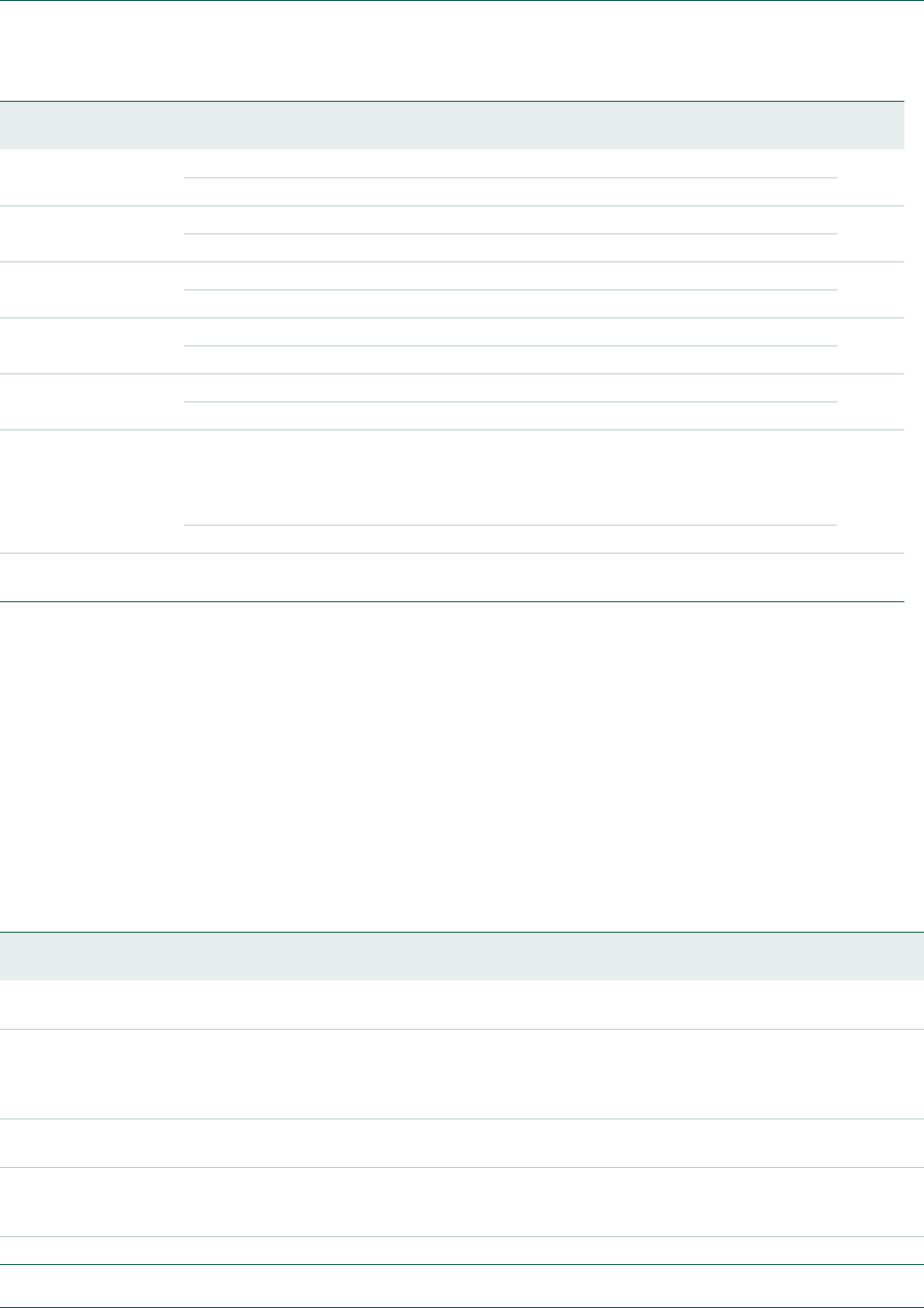
UM10360 All information provided in this document is subject to legal disclaimers. © NXP B.V. 2014. All rights reserved.
User manual Rev. 3.1 — 2 April 2014 588 of 849
NXP Semiconductors UM10360
Chapter 29: LPC176x/5x Analog-to-Digital Converter (ADC)
29.5.4 A/D Data Registers (AD0DR0 to AD0DR7 - 0x4003 4010 to
0x4003 402C)
The A/D Data Registers hold the result of the last conversion for each A/D channel, when
an A/D conversion is complete. They also include the flags that indicate when a
conversion has been completed and when a conversion overrun has occurred.
Results of ADC conversion can be read in one of two ways. One is to use the A/D Global
Data Register to read all data from the ADC. Another is to use the A/D Channel Data
Registers. It is important to use one method consistently because the DONE and
OVERRUN flags can otherwise get out of synch between the AD0GDR and the A/D
Channel Data Registers, potentially causing erroneous interrupts or DMA activity.
3ADINTEN30 Completion of a conversion on ADC channel 3 will not generate an interrupt.0
1Completion of a conversion on ADC channel 3 will generate an interrupt.
4ADINTEN40 Completion of a conversion on ADC channel 4 will not generate an interrupt.0
1Completion of a conversion on ADC channel 4 will generate an interrupt.
5ADINTEN50 Completion of a conversion on ADC channel 5 will not generate an interrupt.0
1Completion of a conversion on ADC channel 5 will generate an interrupt.
6ADINTEN60 Completion of a conversion on ADC channel 6 will not generate an interrupt.0
1Completion of a conversion on ADC channel 6 will generate an interrupt.
7ADINTEN70 Completion of a conversion on ADC channel 7 will not generate an interrupt.0
1Completion of a conversion on ADC channel 7 will generate an interrupt.
8ADGINTEN0 Only the individual ADC channels enabled by ADINTEN7:0 will generate
interrupts.
Remark: This bit must be set to 0 in burst mode (BURST = 1 in the AD0CR
register).
1
1Only the global DONE flag in ADDR is enabled to generate an interrupt.
31:17 - Reserved, user software should not write ones to reserved bits. The value
read from a reserved bit is not defined.
NA
Table 534: A/D Interrupt Enable register (AD0INTEN - address 0x4003 400C) bit description …continued
Bit Symbol Value Description Reset
value
Table 535: A/D Data Registers (AD0DR0 to AD0DR7 - 0x4003 4010 to 0x4003 402C) bit description
Bit Symbol Description Reset
value
3:0 - Reserved, user software should not write ones to reserved bits. The value read from a
reserved bit is not defined.
NA
15:4 RESULT When DONE is 1, this field contains a binary fraction representing the voltage on the AD0[n]
pin, as it falls within the range of VREFP to VREFN. Zero in the field indicates that the voltage on
the input pin was less than, equal to, or close to that on VREFN, while 0xFFF indicates that the
voltage on the input was close to, equal to, or greater than that on VREFP.
NA
29:16 - Reserved, user software should not write ones to reserved bits. The value read from a
reserved bit is not defined.
NA
30 OVERRUN This bit is 1 in burst mode if the results of one or more conversions was (were) lost and
overwritten before the conversion that produced the result in the RESULT bits.This bit is
cleared by reading this register.
31 DONE This bit is set to 1 when an A/D conversion completes. It is cleared when this register is read. NA

UM10360 All information provided in this document is subject to legal disclaimers. © NXP B.V. 2014. All rights reserved.
User manual Rev. 3.1 — 2 April 2014 589 of 849
NXP Semiconductors UM10360
Chapter 29: LPC176x/5x Analog-to-Digital Converter (ADC)
29.5.5 A/D Status register (ADSTAT - 0x4003 4030)
The A/D Status register allows checking the status of all A/D channels simultaneously.
The DONE and OVERRUN flags appearing in the ADDRn register for each A/D channel
are mirrored in ADSTAT. The interrupt flag (the logical OR of all DONE flags) is also found
in ADSTAT.
29.5.6 A/D Trim register (ADTRIM - 0x4003 4034)
This register will be set by the bootcode on start-up. It contains the trim values for the DAC
and the ADC. The offset trim values for the ADC can be overwritten by the user. All 12 bits
are visible when this register is read.
Table 536: A/D Status register (AD0STAT - address 0x4003 4030) bit description
Bit Symbol Description Reset
value
0DONE0 This bit mirrors the DONE status flag from the result register for A/D channel 0. 0
1DONE1 This bit mirrors the DONE status flag from the result register for A/D channel 1. 0
2DONE2 This bit mirrors the DONE status flag from the result register for A/D channel 2. 0
3DONE3 This bit mirrors the DONE status flag from the result register for A/D channel 3. 0
4DONE4 This bit mirrors the DONE status flag from the result register for A/D channel 4. 0
5DONE5 This bit mirrors the DONE status flag from the result register for A/D channel 5. 0
6DONE6 This bit mirrors the DONE status flag from the result register for A/D channel 6. 0
7DONE7 This bit mirrors the DONE status flag from the result register for A/D channel 7. 0
8OVERRUN0This bit mirrors the OVERRRUN status flag from the result register for A/D channel 0. 0
9OVERRUN1This bit mirrors the OVERRRUN status flag from the result register for A/D channel 1. 0
10 OVERRUN2 This bit mirrors the OVERRRUN status flag from the result register for A/D channel 2. 0
11 OVERRUN3 This bit mirrors the OVERRRUN status flag from the result register for A/D channel 3. 0
12 OVERRUN4 This bit mirrors the OVERRRUN status flag from the result register for A/D channel 4. 0
13 OVERRUN5 This bit mirrors the OVERRRUN status flag from the result register for A/D channel 5. 0
14 OVERRUN6 This bit mirrors the OVERRRUN status flag from the result register for A/D channel 6. 0
15 OVERRUN7 This bit mirrors the OVERRRUN status flag from the result register for A/D channel 7. 0
16 ADINT This bit is the A/D interrupt flag. It is one when any of the individual A/D channel Done
flags is asserted and enabled to contribute to the A/D interrupt via the ADINTEN register.
0
31:17 - Reserved, user software should not write ones to reserved bits. The value read from a
reserved bit is not defined.
NA
Table 537: A/D Trim register (ADTRM - address 0x4003 4034) bit description
Bit Symbol Description Reset
value
3:0 - reserved. NA
7:4 ADCOFFS Offset trim bits for ADC operation. Initialized by the boot code. Can be overwritten by the user. 0
11:8 TRIM written-to by boot code. Can not be overwritten by the user. These bits are locked after boot
code write.
1111
31:12 - Reserved, user software should not write ones to reserved bits. The value read from a
reserved bit is not defined.
NA

UM10360 All information provided in this document is subject to legal disclaimers. © NXP B.V. 2014. All rights reserved.
User manual Rev. 3.1 — 2 April 2014 590 of 849
NXP Semiconductors UM10360
Chapter 29: LPC176x/5x Analog-to-Digital Converter (ADC)
29.6 Operation
Once an ADC conversion is started, it cannot be interrupted. A new software write to
launch a new conversion or a new edge-trigger event will be ignored while the previous
conversion is in progress.
29.6.1 Hardware-triggered conversion
If the BURST bit in the ADCR is 0 and the START field contains 010-111, the ADC will
start a conversion when a transition occurs on a selected pin or Timer Match signal. The
choices include conversion on a specified edge of any of 4 Match signals, or conversion
on a specified edge of either of 2 Capture/Match pins. The pin state from the selected pad
or the selected Match signal, XORed with ADCR bit 27, is used in the edge detection
logic.
29.6.2 Interrupts
An interrupt request is asserted to the NVIC when the DONE bit is 1. Software can use the
Interrupt Enable bit for the A/D Converter in the NVIC to control whether this assertion
results in an interrupt. DONE is negated when the ADDR is read.
29.6.3 Accuracy vs. digital receiver
The ADC function must be selected via the PINSEL registers in order to get accurate
voltage readings on the monitored pin. The PINMODE should also be set to the mode for
which neither pull-up nor pull-down resistor is enabled. For a pin hosting an ADC input, it
is not possible to have a have a digital function selected and yet get valid ADC readings.
An inside circuit disconnects ADC hardware from the associated pin whenever a digital
function is selected on that pin.
29.6.4 DMA control
A DMA transfer request is generated from the ADC interrupt request line. To generate a
DMA transfer the same conditions must be met as the conditions for generating an
interrupt (see Section 29.6.2 and Section 29.5.3).
Remark: If the DMA is used, the ADC interrupt must be disabled in the NVIC.
For DMA transfers, only burst requests are supported. The burst size can be set to one in
the DMA channel control register (see Section 31.5.20). If the number of ADC channels is
not equal to one of the other DMA-supported burst sizes (applicable DMA burst sizes are
1, 4, 8 - see Section 31.5.20), set the burst size to one.
The DMA transfer size determines when a DMA interrupt is generated. The transfer size
can be set to the number of ADC channels being converted (see Section 31.5.20).
Non-contiguous channels can be transferred by the DMA using the scatter/gather linked
lists (see Section 31.5.19).

UM10360 All information provided in this document is subject to legal disclaimers. © NXP B.V. 2014. All rights reserved.
User manual Rev. 3.1 — 2 April 2014 591 of 849
30.1 Basic configuration
The DAC is configured using the following registers:
1. Power: The DAC is always connected to VDDA. Register access is determined by
PINSEL and PINMODE settings (see below).
2. Clock: In the PCLKSEL0 register (Tab l e 40), select PCLK_DAC.
3. Pins: Enable the DAC pin through the PINSEL registers. Select pin mode for port pin
with DAC through the PINMODE registers (Section 8.5). This must be done before
accessing any DAC registers.
4. DMA: The DAC can be connected to the GPDMA controller (see Section 30.4.2). For
GPDMA connections, see Tab l e 54 4 .
30.2 Features
•10-bit digital to analog converter
•Resistor string architecture
•Buffered output
•Selectable speed vs. power
•Maximum update rate of 1 MHz.
30.3 Pin description
Tab l e 5 38 gives a brief summary of each of DAC related pins.
UM10360
Chapter 30: LPC176x/5x Digital-to-Analog Converter (DAC)
Rev. 3.1 — 2 April 2014 User manual
Table 538. D/A Pin Description
Pin Type Description
AOUT Output Analog Output. After the selected settling time after the DACR is written with a new value,
the voltage on this pin (with respect to VSSA) is VALUE ((VREFP - VREFN)/1024) + VREFN.
Remark: The DAC output is disabled when the device is in deep-sleep, power-down, or deep
power-down mode.
VREFP, VREFN Reference Voltage References. These pins provide a voltage reference level for the ADC and DAC.
Note: VREFP should be tied to VDD(3V3) and VREFN should be tied to VSS if the ADC and
DAC are not used.
VDDA, VSSA Power Analog Power and Ground. These should typically be the same voltages as VDD and VSS,
but should be isolated to minimize noise and error. Note: VDDA should be tied to VDD(3V3)
and VSSA should be tied to VSS if the ADC and DAC are not used.
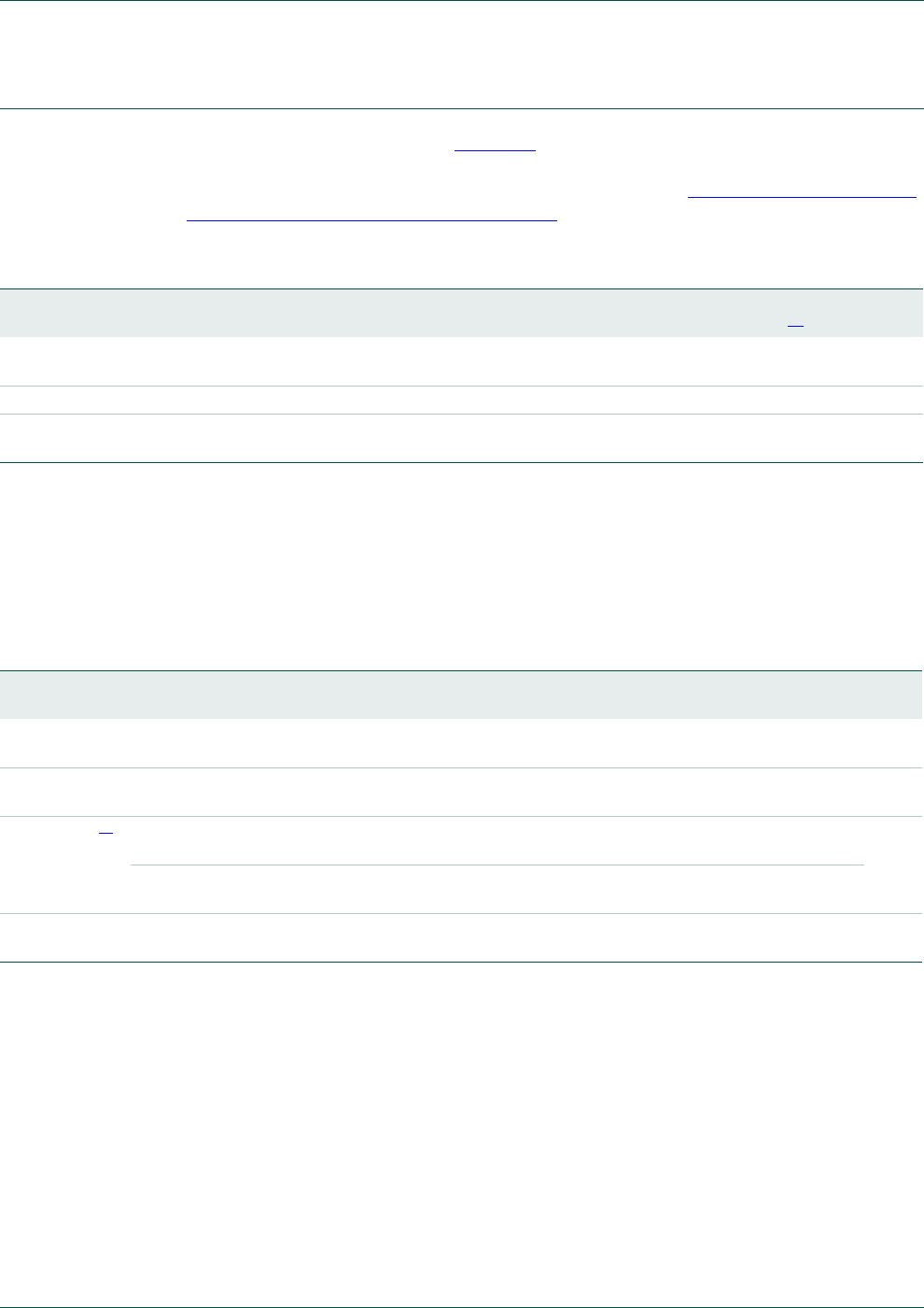
UM10360 All information provided in this document is subject to legal disclaimers. © NXP B.V. 2014. All rights reserved.
User manual Rev. 3.1 — 2 April 2014 592 of 849
NXP Semiconductors UM10360
Chapter 30: LPC176x/5x Digital-to-Analog Converter (DAC)
30.4 Register description
The DAC registers are shown in Ta ble 5 3 9. Note that the DAC does not have a control bit
in the PCONP register. To enable the DAC, its output must be selected to appear on the
related pin, P0.26, by configuring the PINSEL1 register. See Section 8.5.2 “Pin Function
Select Register 1 (PINSEL1 - 0x4002 C004)”. the DAC must be enabled in this manner
prior to accessing any DAC registers.
[1] Reset value reflects the data stored in used bits only. It does not include reserved bits content.
30.4.1 D/A Converter Register (DACR - 0x4008 C000)
This read/write register includes the digital value to be converted to analog, and a bit that
trades off performance vs. power. Bits 5:0 are reserved for future, higher-resolution D/A
converters.
[1] The settling times noted in the description of the BIAS bit are valid for a capacitance load on the AOUT pin
not exceeding 100 pF. A load impedance value greater than that value will cause settling time longer than
the specified time. One or more graph(s) of load impedance vs. settling time will be included in the final data
sheet.
30.4.2 D/A Converter Control register (DACCTRL - 0x4008 C004)
This read/write register enables the DMA operation and controls the DMA timer.
Table 539. DAC registers
Name Description Access Reset
value[1]
Address
DACR D/A Converter Register. This register contains the digital value to be
converted to analog and a power control bit.
R/W 0 0x4008 C000
DACCTRL DAC Control register. This register controls DMA and timer operation. R/W 0 0x4008 C004
DACCNTVAL DAC Counter Value register. This register contains the reload value for
the DAC DMA/Interrupt timer.
R/W 0 0x4008 C008
Table 540: D/A Converter Register (DACR - address 0x4008 C000) bit description
Bit Symbol Value Description Reset
Value
5:0 - Reserved, user software should not write ones to reserved bits. The value read from a
reserved bit is not defined.
NA
15:6 VALUE After the selected settling time after this field is written with a new VALUE, the voltage on
the AOUT pin (with respect to VSSA) is VALUE ((VREFP - VREFN)/1024) + VREFN.
0
16 BIAS[1] 0The settling time of the DAC is 1s max, and the maximum current is 700 A. This allows
a maximum update rate of 1 MHz.
0
1The settling time of the DAC is 2.5
s and the maximum current is 350 A. This allows a
maximum update rate of 400 kHz.
31:17 - Reserved, user software should not write ones to reserved bits. The value read from a
reserved bit is not defined.
NA

UM10360 All information provided in this document is subject to legal disclaimers. © NXP B.V. 2014. All rights reserved.
User manual Rev. 3.1 — 2 April 2014 593 of 849
NXP Semiconductors UM10360
Chapter 30: LPC176x/5x Digital-to-Analog Converter (DAC)
30.4.3 D/A Converter Counter Value register (DACCNTVAL - 0x4008 C008)
This read/write register contains the reload value for the Interrupt/DMA counter.
30.5 Operation
30.5.1 DMA counter
When the counter enable bit CNT_ENA in DACCTRL is set, a 16-bit counter will begin
counting down, at the rate selected by PCLK_DAC (see Tab l e 40), from the value
programmed into the DACCNTVAL register. The counter is decremented Each time the
counter reaches zero, the counter will be reloaded by the value of DACCNTVAL and the
DMA request bit INT_DMA_REQ will be set in hardware.
Note that the contents of the DACCTRL and DACCNTVAL registers are read and write
accessible, but the timer itself is not accessible for either read or write.
If the DMA_ENA bit is set in the DACCTRL register, the DAC DMA request will be routed
to the GPDMA. When the DMA_ENA bit is cleared, the default state after a reset, DAC
DMA requests are blocked.
30.5.2 Double buffering
Double-buffering is enabled only if both, the CNT_ENA and the DBLBUF_ENA bits are set
in DACCTRL. In this case, any write to the DACR register will only load the pre-buffer,
which shares its register address with the DACR register. The DACR itself will be loaded
from the pre-buffer whenever the counter reaches zero and the DMA request is set. At the
same time the counter is reloaded with the COUNTVAL register value.
Reading the DACR register will only return the contents of the DACR register itself, not the
contents of the pre-buffer register.
Table 541. D/A Control register (DACCTRL - address 0x4008 C004) bit description
Bit Symbol Value Description Reset
Value
0INT_DMA_REQ0 This bit is cleared on any write to the DACR register. 0
1This bit is set by hardware when the timer times out.
1DBLBUF_ENA0 DACR double-buffering is disabled. 0
1When this bit and the CNT_ENA bit are both set, the double-buffering feature in the
DACR register will be enabled. Writes to the DACR register are written to a
pre-buffer and then transferred to the DACR on the next time-out of the counter.
2CNT_ENA 0 Time-out counter operation is disabled. 0
1Time-out counter operation is enabled.
3DMA_ENA 0 DMA access is disabled. 0
1DMA Burst Request Input 7 is enabled for the DAC (see Tab l e 5 4 4).
31:4 - Reserved, user software should not write ones to reserved bits. The value read
from a reserved bit is not defined.
NA
Table 542: D/A Converter register (DACR - address 0x4008 C008) bit description
Bit Symbol Description Reset Value
15:0 VALUE 16-bit reload value for the DAC interrupt/DMA timer. 0
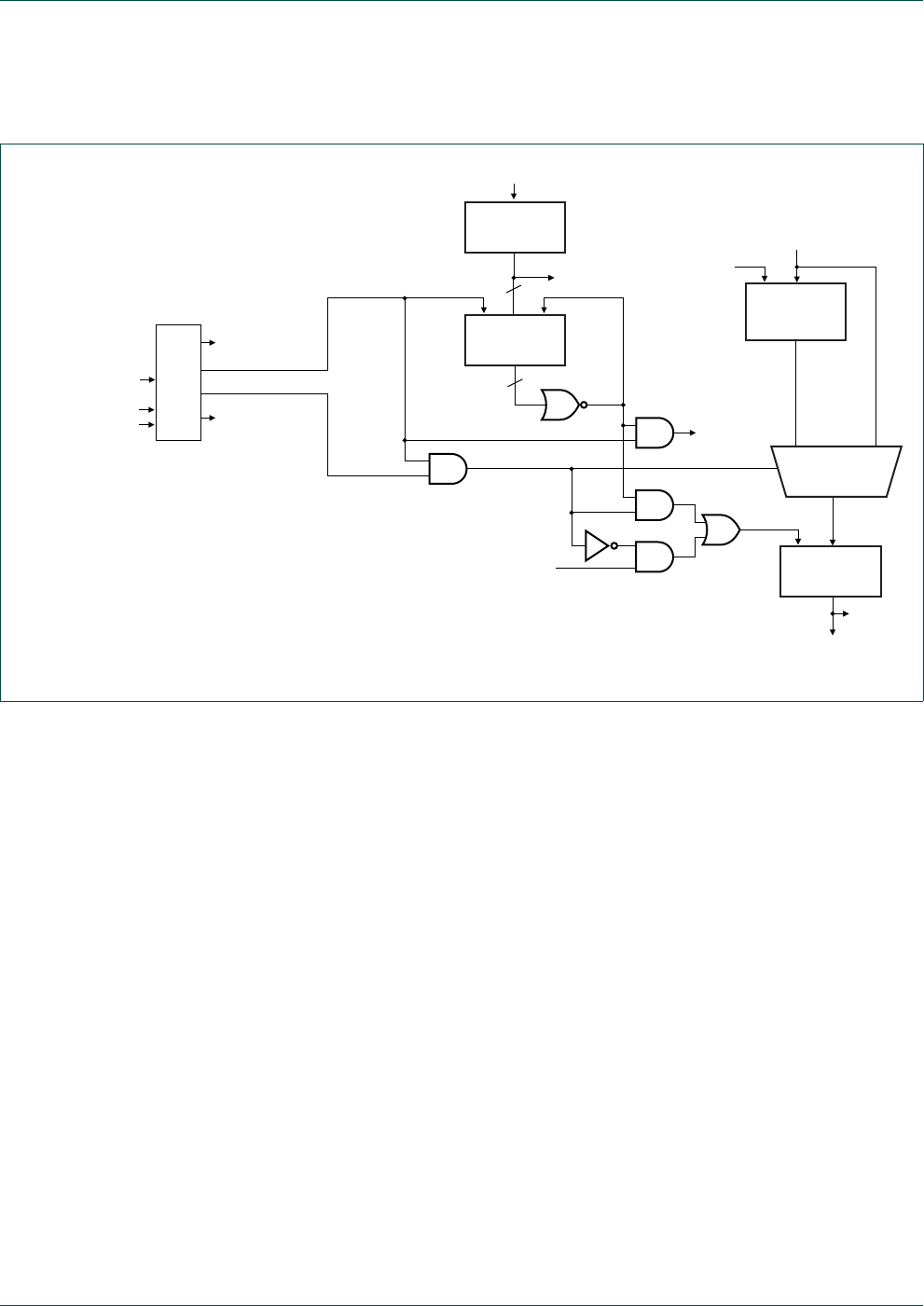
UM10360 All information provided in this document is subject to legal disclaimers. © NXP B.V. 2014. All rights reserved.
User manual Rev. 3.1 — 2 April 2014 594 of 849
NXP Semiconductors UM10360
Chapter 30: LPC176x/5x Digital-to-Analog Converter (DAC)
If either the CNT_ENA or the DBLBUF_ENA bits are 0, any writes to the DACR address
will go directly to the DACR register.
Fig 134. DAC control with DMA interrupt and timer
CNTVAL
COUNTER
PRE-BUFFER
MUX
DACR
LD
LD
LDEN
16
16
pbus
pbus
set_intrpt
dblbuf_ena
cnt_ena
ena_cnt_and_dblbuf
pbus_wr_to_DACR
10
pbus
pbus
pbus_wr_toDACR
zero
DAC value
3
2
1
0
S
C
set_intrpt
pbus
pbus_wr_to_DACR
DMA_ena
intrptDMA_req

UM10360 All information provided in this document is subject to legal disclaimers. © NXP B.V. 2014. All rights reserved.
User manual Rev. 3.1 — 2 April 2014 595 of 849
31.1 Basic configuration
The GPDMA is configured using the following registers:
1. Power: In the PCONP register (Ta b le 46 ), set bit PCGPDMA.
Remark: On reset, the GPDMA is disabled (PCGPDMA = 0).
2. Clock: see Ta bl e 38 .
3. Interrupts: Interrupts are enabled in the NVIC using the appropriate Interrupt Set
Enable register.
4. Programming: see Section 31.6.
31.2 Introduction
The DMA controller allows peripheral-to memory, memory-to-peripheral, and
memory-to-memory transactions. Each DMA stream provides unidirectional serial DMA
transfers for a single source and destination. For example, a bi-directional port requires
one stream for transmit and one for receives. The source and destination areas can each
be either a memory region or a peripheral.
31.3 Features
•Eight DMA channels. Each channel can support an unidirectional transfer.
•16 DMA request lines.
•Memory-to-memory, memory-to-peripheral, and peripheral-to-memory transfers are
supported.
•GPDMA supports the SSP, I2S, UART, A/D Converter, and D/A Converter peripherals.
DMA can also be triggered by a timer match condition. Memory-to-memory transfers
and transfers to or from GPIO are also supported.
•Scatter or gather DMA is supported through the use of linked lists. This means that
the source and destination areas do not have to occupy contiguous areas of memory.
•Hardware DMA channel priority.
•AHB slave DMA programming interface. The DMA Controller is programmed by
writing to the DMA control registers over the AHB slave interface.
•One AHB bus master for transferring data. The interface transfers data when a DMA
request goes active.
•32-bit AHB master bus width.
•Incrementing or non-incrementing addressing for source and destination.
•Programmable DMA burst size. The DMA burst size can be programmed to more
efficiently transfer data.
•Internal four-word FIFO per channel.
•Supports 8-bit, 16-bit, and 32-bit wide transactions.
UM10360
Chapter 31: LPC176x/5x General Purpose DMA (GPDMA)
Rev. 3.1 — 2 April 2014 User manual
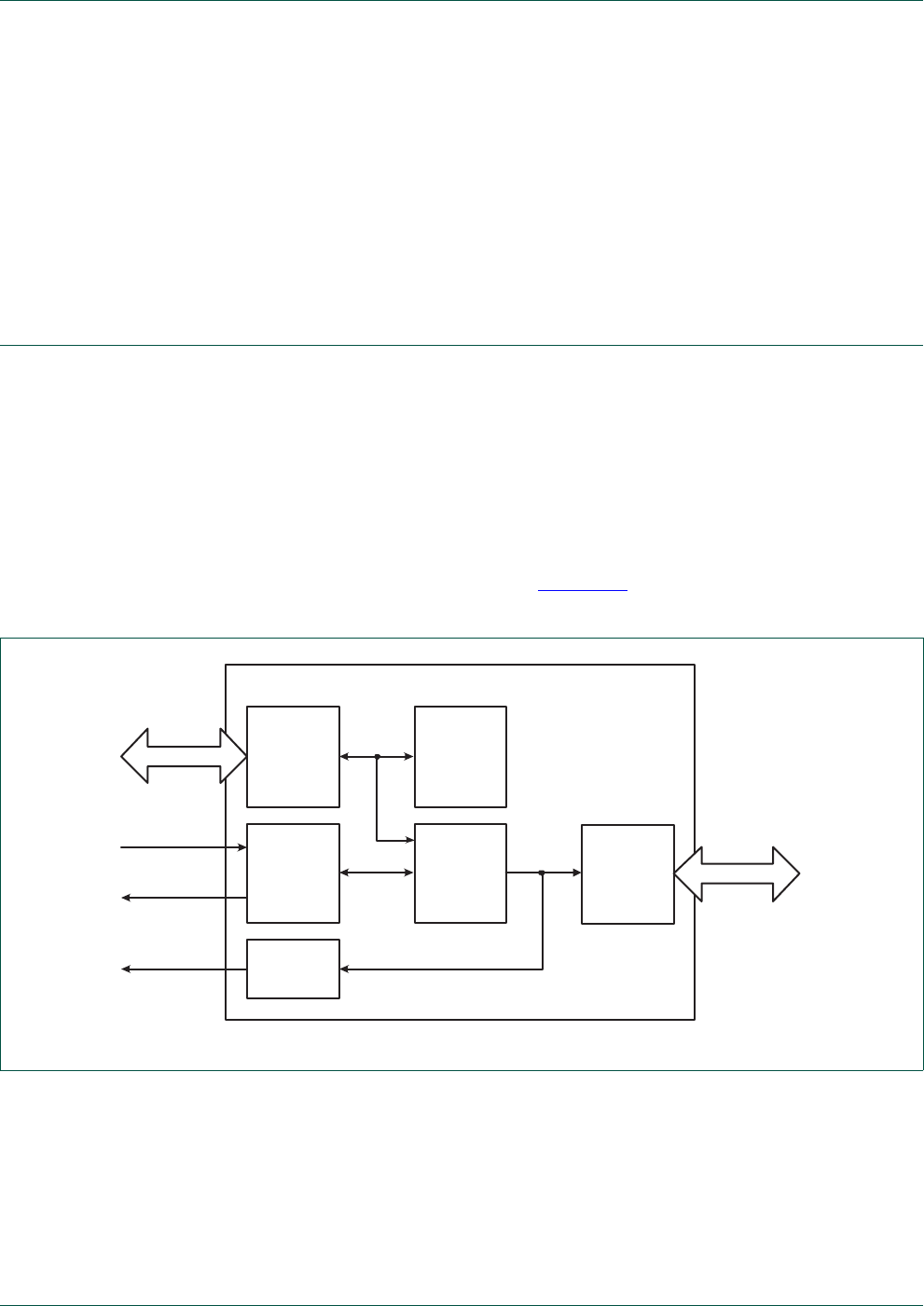
UM10360 All information provided in this document is subject to legal disclaimers. © NXP B.V. 2014. All rights reserved.
User manual Rev. 3.1 — 2 April 2014 596 of 849
NXP Semiconductors UM10360
Chapter 31: LPC176x/5x General Purpose DMA (GPDMA)
•Big-endian and little-endian support. The DMA Controller defaults to little-endian
mode on reset.
•An interrupt to the processor can be generated on a DMA completion or when a DMA
error has occurred.
•Raw interrupt status. The DMA error and DMA count raw interrupt status can be read
prior to masking.
•DMA can operate in Sleep mode. (Note that in Sleep mode the GPDMA cannot
access the flash memory).
31.4 Functional description
This section describes the major functional blocks of the DMA Controller.
31.4.1 DMA controller functional description
The DMA Controller enables peripheral-to-memory, memory-to-peripheral,
peripheral-to-peripheral, and memory-to-memory transactions. Each DMA stream
provides unidirectional serial DMA transfers for a single source and destination. For
example, a bidirectional port requires one stream for transmit and one for receive. The
source and destination areas can each be either a memory region or a peripheral, and
can be accessed through the AHB master. Figure 135 shows a block diagram of the DMA
Controller.
The functions of the DMA Controller are described in the following sections.
31.4.1.1 AHB slave interface
All transactions to DMA Controller registers on the AHB slave interface are 32 bits wide.
8-bit and 16-bit accesses are not supported and will result in an exception.
Fig 135. DMA controller block diagram
GPDMA
AHB SLAVE
INTERFACE
CONTROL
LOGIC AND
REGISTERS
DMA
REQUEST
AND
RESPONSE
INTERFACE
CHANNEL
LOGIC AND
REGISTERS
INTERRUPT
REQUEST
DMA
requests
DMA
responses
DMA
Interrupts
AHB BUS
AHB
MASTER
INTERFACE
AHB BUS

UM10360 All information provided in this document is subject to legal disclaimers. © NXP B.V. 2014. All rights reserved.
User manual Rev. 3.1 — 2 April 2014 597 of 849
NXP Semiconductors UM10360
Chapter 31: LPC176x/5x General Purpose DMA (GPDMA)
31.4.1.2 Control logic and register bank
The register block stores data written or to be read across the AHB interface.
31.4.1.3 DMA request and response interface
See Section 31.4.2 for information on the DMA request and response interface.
31.4.1.4 Channel logic and channel register bank
The channel logic and channel register bank contains registers and logic required for each
DMA channel.
31.4.1.5 Interrupt request
The interrupt request generates the interrupt to the ARM processor.
31.4.1.6 AHB master interface
The DMA Controller contains one AHB master interface. The AHB master is capable of
dealing with all types of AHB transactions, including:
•Split, retry, and error responses from slaves. If a peripheral performs a split or retry,
the DMA Controller stalls and waits until the transaction can complete.
•Locked transfers for source and destination of each stream.
•Setting of protection bits for transfers on each stream.
31.4.1.6.1 Bus and transfer widths
The physical width of the AHB bus is 32 bits. Source and destination transfers can be of
differing widths and can be the same width or narrower than the physical bus width. The
DMA Controller packs or unpacks data as appropriate.
31.4.1.6.2 Endian behavior
The DMA Controller can cope with both little-endian and big-endian addressing.
Internally the DMA Controller treats all data as a stream of bytes instead of 16-bit or 32-bit
quantities. This means that when performing mixed-endian activity, where the endianness
of the source and destination are different, byte swapping of the data within the 32-bit data
bus is observed.
Note: If byte swapping is not required, then use of different endianness between the
source and destination addresses must be avoided. Ta b l e 5 43 shows endian behavior for
different source and destination combinations.

UM10360 All information provided in this document is subject to legal disclaimers. © NXP B.V. 2014. All rights reserved.
User manual Rev. 3.1 — 2 April 2014 598 of 849
NXP Semiconductors UM10360
Chapter 31: LPC176x/5x General Purpose DMA (GPDMA)
Table 543. Endian behavior
Source
endian
Destination
endian
Source
width
Destination
width
Source
transfer
no/byte lane
Source data Destination
transfer
no/byte lane
Destination data
Little Little 8 8 1/[7:0]
2/[15:8]
3/[23:16]
4/[31:24]
21
43
65
87
1/[7:0]
2/[15:8]
3/[23:16]
4/[31:24]
21212121
43434343
65656565
87878787
Little Little 8 16 1/[7:0]
2/[15:8]
3/[23:16]
4/[31:24]
21
43
65
87
1/[15:0]
2/[31:16]
43214321
87658765
Little Little 8 32 1/[7:0]
2/[15:8]
3/[23:16]
4/[31:24]
21
43
65
87
1/[31:0] 87654321
Little Little 16 8 1/[7:0]
1/[15:8]
2/[23:16]
2/[31:24]
21
43
65
87
1/[7:0]
2/[15:8]
3/[23:16]
4/[31:24]
21212121
43434343
65656565
87878787
Little Little 16 16 1/[7:0]
1/[15:8]
2/[23:16]
2/[31:24]
21
43
65
87
1/[15:0]
2/[31:16]
43214321
87658765
Little Little 16 32 1/[7:0]
1/[15:8]
2/[23:16]
2/[31:24]
21
43
65
87
1/[31:0] 87654321
Little Little 32 8 1/[7:0]
1/[15:8]
1/[23:16]
1/[31:24]
21
43
65
87
1/[7:0]
2/[15:8]
3/[23:16]
4/[31:24]
21212121
43434343
65656565
87878787
Little Little 32 16 1/[7:0]
1/[15:8]
1/[23:16]
1/[31:24]
21
43
65
87
1/[15:0]
2/[31:16]
43214321
87658765
Little Little 32 32 1/[7:0]
1/[15:8]
1/[23:16]
1/[31:24]
21
43
65
87
1/[31:0] 87654321
Big Big 881/[31:24]
2/[23:16]
3/[15:8]
4/[7:0]
12
34
56
78
1/[31:24]
2/[23:16]
3/[15:8]
4/[7:0]
12121212
34343434
56565656
78787878

UM10360 All information provided in this document is subject to legal disclaimers. © NXP B.V. 2014. All rights reserved.
User manual Rev. 3.1 — 2 April 2014 599 of 849
NXP Semiconductors UM10360
Chapter 31: LPC176x/5x General Purpose DMA (GPDMA)
31.4.1.6.3 Error conditions
An error during a DMA transfer is flagged directly by the peripheral by asserting an Error
response on the AHB bus during the transfer. The DMA Controller automatically disables
the DMA stream after the current transfer has completed, and can optionally generate an
error interrupt to the CPU. This error interrupt can be masked.
Big Big 816 1/[31:24]
2/[23:16]
3/[15:8]
4/[7:0]
12
34
56
78
1/[15:0]
2/[31:16]
12341234
56785678
Big Big 832 1/[31:24]
2/[23:16]
3/[15:8]
4/[7:0]
12
34
56
78
1/[31:0] 12345678
Big Big 16 81/[31:24]
1/[23:16]
2/[15:8]
2/[7:0]
12
34
56
78
1/[31:24]
2/[23:16]
3/[15:8]
4/[7:0]
12121212
34343434
56565656
78787878
Big Big 16 16 1/[31:24]
1/[23:16]
2/[15:8]
2/[7:0]
12
34
56
78
1/[15:0]
2/[31:16]
12341234
56785678
Big Big 16 32 1/[31:24]
1/[23:16]
2/[15:8]
2/[7:0]
12
34
56
78
1/[31:0] 12345678
Big Big 32 81/[31:24]
1/[23:16]
1/[15:8]
1/[7:0]
12
34
56
78
1/[31:24]
2/[23:16]
3/[15:8]
4/[7:0]
12121212
34343434
56565656
78787878
Big Big 32 16 1/[31:24]
1/[23:16]
1/[15:8]
1/[7:0]
12
34
56
78
1/[15:0]
2/[31:16]
12341234
56785678
Big Big 32 32 1/[31:24]
1/[23:16]
1/[15:8]
1/[7:0]
12
34
56
78
1/[31:0] 12345678
Table 543. Endian behavior …continued
Source
endian
Destination
endian
Source
width
Destination
width
Source
transfer
no/byte lane
Source data Destination
transfer
no/byte lane
Destination data

UM10360 All information provided in this document is subject to legal disclaimers. © NXP B.V. 2014. All rights reserved.
User manual Rev. 3.1 — 2 April 2014 600 of 849
NXP Semiconductors UM10360
Chapter 31: LPC176x/5x General Purpose DMA (GPDMA)
31.4.1.7 Channel hardware
Each stream is supported by a dedicated hardware channel, including source and
destination controllers, as well as a FIFO. This enables better latency than a DMA
controller with only a single hardware channel shared between several DMA streams and
simplifies the control logic.
31.4.1.8 DMA request priority
DMA channel priority is fixed. DMA channel 0 has the highest priority and DMA channel 7
has the lowest priority.
If the DMA Controller is transferring data for the lower priority channel and then the higher
priority channel goes active, it completes the number of transfers delegated to the master
interface by the lower priority channel before switching over to transfer data for the higher
priority channel. Transfers delegated to the master interface are staged in the DMA
channel FIFO, so the amount of data that needs to transfer could be as large as a 4
words.
It is recommended that memory-to-memory transactions use the lowest priority channel.
31.4.1.9 Interrupt generation
A combined interrupt output is generated as an OR function of the individual interrupt
requests of the DMA Controller and is connected to the interrupt controller.
31.4.2 DMA system connections
31.4.2.1 DMA request signals
The DMA request signals are used by peripherals to request a data transfer. The DMA
request signals indicate whether a single or burst transfer of data is required. The DMA
available request signals are:
DMACBREQ[15:0] — Burst request signals. These cause a programmed burst number
of data to be transferred.
DMACSREQ[15:0] — Single transfer request signals. These cause a single data to be
transferred. The DMA controller transfers a single transfer to or from the peripheral.
DMACLBREQ[15:0] — Last burst request signals.
DMACLSREQ[15:0] — Last single transfer request signals.
Note that peripherals on this device do not support “last” request types, and many do not
support both single and burst request types. See Section 31.4.2.3.
31.4.2.2 DMA response signals
The DMA response signals indicate whether the transfer initiated by the DMA request
signal has completed. The response signals can also be used to indicate whether a
complete packet has been transferred. The DMA response signals from the DMA
controller are:
DMACCLR[15:0] — DMA clear or acknowledge signals. The DMACCLR signal is used by
the DMA controller to acknowledge a DMA request from the peripheral.

UM10360 All information provided in this document is subject to legal disclaimers. © NXP B.V. 2014. All rights reserved.
User manual Rev. 3.1 — 2 April 2014 601 of 849
NXP Semiconductors UM10360
Chapter 31: LPC176x/5x General Purpose DMA (GPDMA)
DMACTC[15:0] — DMA terminal count signals. The DMACTC signal can be used by the
DMA controller to indicate to the peripheral that the DMA transfer is complete.
31.4.2.3 DMA request connections
The connection of the GPDMA to the supported peripheral devices depends on the DMA
functions implemented in those peripherals. Tab l e 5 4 4 shows the DMA Request numbers
used by the supported peripherals. UART and timer DMA requests on channels 8 through
15 are chosen via the DMAREQSEL register, see Section 31.5.15.
[1] Generates an interrupt and/or DMA request depending on software setup.
Table 544. DMA Connections
Peripheral Function DMA Single Request
Input (DMACSREQ)
DMA Burst Request
Input (DMACBREQ)
DMA Request Signal
SSP0 Tx 0 0 Dedicated DMA requests
SSP0 Rx 1 1 Dedicated DMA requests
SSP1 Tx 2 2 Dedicated DMA requests
SSP1 Rx 3 3 Dedicated DMA requests
ADC 4 4 ADC interrupt request [1]
I2S channel 0 - 5Dedicated DMA request
I2S channel 1 - 6Dedicated DMA request
DAC - 7 Dedicated DMA request
UART0 Tx / MAT0.0 - 8Dedicated DMA requests
UART0 Rx / MAT0.1 - 9Dedicated DMA requests
UART1 Tx / MAT1.0 - 10 Dedicated DMA requests
UART1 Rx / MAT1.1 - 11 Dedicated DMA requests
UART2 Tx / MAT2.0 - 12 Dedicated DMA requests
UART2 Rx / MAT2.1 - 13 Dedicated DMA requests
UART3 Tx / MAT3.0 - 14 Dedicated DMA requests
UART3 Rx / MAT3.1 - 15 Dedicated DMA requests

UM10360 All information provided in this document is subject to legal disclaimers. © NXP B.V. 2014. All rights reserved.
User manual Rev. 3.1 — 2 April 2014 602 of 849
NXP Semiconductors UM10360
Chapter 31: LPC176x/5x General Purpose DMA (GPDMA)
31.5 Register description
The DMA Controller supports 8 channels. Each channel has registers specific to the
operation of that channel. Other registers controls aspects of how source peripherals
relate to the DMA Controller. There are also global DMA control and status registers.
The DMA Controller registers are shown in Ta bl e 5 4 5 .
Table 545. GPDMA register map
Name Description Access Reset
state
Address
General registers
DMACIntStat DMA Interrupt Status Register RO 0 0x5000 4000
DMACIntTCStat DMA Interrupt Terminal Count Request Status Register RO 0 0x5000 4004
DMACIntTCClear DMA Interrupt Terminal Count Request Clear Register WO - 0x5000 4008
DMACIntErrStat DMA Interrupt Error Status Register RO 0 0x5000 400C
DMACIntErrClr DMA Interrupt Error Clear Register WO - 0x5000 4010
DMACRawIntTCStat DMA Raw Interrupt Terminal Count Status Register RO 0 0x5000 4014
DMACRawIntErrStat DMA Raw Error Interrupt Status Register RO 0 0x5000 4018
DMACEnbldChns DMA Enabled Channel Register RO 0 0x5000 401C
DMACSoftBReq DMA Software Burst Request Register R/W 0 0x5000 4020
DMACSoftSReq DMA Software Single Request Register R/W 0 0x5000 4024
DMACSoftLBReq DMA Software Last Burst Request Register R/W 0 0x5000 4028
DMACSoftLSReq DMA Software Last Single Request Register R/W 0 0x5000 402C
DMACConfig DMA Configuration Register R/W 0 0x5000 4030
DMACSync DMA Synchronization Register R/W 0 0x5000 4034
DMAREQSEL Selects between UART and timer DMA requests on
channels 8 through 15
R/W 0 0x400F C1C4
Channel 0 registers
DMACC0SrcAddr DMA Channel 0 Source Address Register R/W 0 0x5000 4100
DMACC0DestAddr DMA Channel 0 Destination Address Register R/W 0 0x5000 4104
DMACC0LLI DMA Channel 0 Linked List Item Register R/W 0 0x5000 4108
DMACC0Control DMA Channel 0 Control Register R/W 0 0x5000 410C
DMACC0Config DMA Channel 0 Configuration Register R/W 0 [1] 0x5000 4110
Channel 1 registers
DMACC1SrcAddr DMA Channel 1 Source Address Register R/W 0 0x5000 4120
DMACC1DestAddr DMA Channel 1 Destination Address Register R/W 0 0x5000 4124
DMACC1LLI DMA Channel 1 Linked List Item Register R/W 0 0x5000 4128
DMACC1Control DMA Channel 1 Control Register R/W 0 0x5000 412C
DMACC1Config DMA Channel 1 Configuration Register R/W 0 [1] 0x5000 4130
Channel 2 registers
DMACC2SrcAddr DMA Channel 2 Source Address Register R/W 0 0x5000 4140
DMACC2DestAddr DMA Channel 2 Destination Address Register R/W 0 0x5000 4144
DMACC2LLI DMA Channel 2 Linked List Item Register R/W 0 0x5000 4148
DMACC2Control DMA Channel 2 Control Register R/W 0 0x5000 414C

UM10360 All information provided in this document is subject to legal disclaimers. © NXP B.V. 2014. All rights reserved.
User manual Rev. 3.1 — 2 April 2014 603 of 849
NXP Semiconductors UM10360
Chapter 31: LPC176x/5x General Purpose DMA (GPDMA)
[1] Bit 17 of this register is a read-only status flag.
DMACC2Config DMA Channel 2 Configuration Register R/W 0 [1] 0x5000 4150
Channel 3 registers
DMACC3SrcAddr DMA Channel 3 Source Address Register R/W 0 0x5000 4160
DMACC3DestAddr DMA Channel 3 Destination Address Register R/W 0 0x5000 4164
DMACC3LLI DMA Channel 3 Linked List Item Register R/W 0 0x5000 4168
DMACC3Control DMA Channel 3 Control Register R/W 0 0x5000 416C
DMACC3Config DMA Channel 3 Configuration Register R/W 0 [1] 0x5000 4170
Channel 4 registers
DMACC4SrcAddr DMA Channel 4 Source Address Register R/W 0 0x5000 4180
DMACC4DestAddr DMA Channel 4 Destination Address Register R/W 0 0x5000 4184
DMACC4LLI DMA Channel 4 Linked List Item Register R/W 0 0x5000 4188
DMACC4Control DMA Channel 4 Control Register R/W 0 0x5000 418C
DMACC4Config DMA Channel 4 Configuration Register R/W 0 [1] 0x5000 4190
Channel 5 registers
DMACC5SrcAddr DMA Channel 5 Source Address Register R/W 0 0x5000 41A0
DMACC5DestAddr DMA Channel 5 Destination Address Register R/W 0 0x5000 41A4
DMACC5LLI DMA Channel 5 Linked List Item Register R/W 0 0x5000 41A8
DMACC5Control DMA Channel 5 Control Register R/W 0 0x5000 41AC
DMACC5Config DMA Channel 5 Configuration Register R/W 0 [1] 0x5000 41B0
Channel 6 registers
DMACC6SrcAddr DMA Channel 6 Source Address Register R/W 0 0x5000 41C0
DMACC6DestAddr DMA Channel 6 Destination Address Register R/W 0 0x5000 41C4
DMACC6LLI DMA Channel 6 Linked List Item Register R/W 0 0x5000 41C8
DMACC6Control DMA Channel 6 Control Register R/W 0 0x5000 41CC
DMACC6Config DMA Channel 6 Configuration Register R/W 0 [1] 0x5000 41D0
Channel 7 registers
DMACC7SrcAddr DMA Channel 7 Source Address Register R/W 0 0x5000 41E0
DMACC7DestAddr DMA Channel 7 Destination Address Register R/W 0 0x5000 41E4
DMACC7LLI DMA Channel 7 Linked List Item Register R/W 0 0x5000 41E8
DMACC7Control DMA Channel 7 Control Register R/W 0 0x5000 41EC
DMACC7Config DMA Channel 7 Configuration Register R/W 0 [1] 0x5000 41F0
Table 545. GPDMA register map
Name Description Access Reset
state
Address

UM10360 All information provided in this document is subject to legal disclaimers. © NXP B.V. 2014. All rights reserved.
User manual Rev. 3.1 — 2 April 2014 604 of 849
NXP Semiconductors UM10360
Chapter 31: LPC176x/5x General Purpose DMA (GPDMA)
31.5.1 DMA Interrupt Status register (DMACIntStat - 0x5000 4000)
The DMACIntStat Register is read-only and shows the status of the interrupts after
masking. A 1 bit indicates that a specific DMA channel interrupt request is active. The
request can be generated from either the error or terminal count interrupt requests.
Tab l e 5 46 shows the bit assignments of the DMACIntStat Register.
31.5.2 DMA Interrupt Terminal Count Request Status register
(DMACIntTCStat - 0x5000 4004)
The DMACIntTCStat Register is read-only and indicates the status of the terminal count
after masking. Tab l e 54 7 shows the bit assignments of the DMACIntTCStat Register.
31.5.3 DMA Interrupt Terminal Count Request Clear register
(DMACIntTCClear - 0x5000 4008)
The DMACIntTCClear Register is write-only and clears one or more terminal count
interrupt requests. When writing to this register, each data bit that contains a 1 causes the
corresponding bit in the status register (DMACIntTCStat) to be cleared. Data bits that are
0 have no effect. Tab l e 548 shows the bit assignments of the DMACIntTCClear Register.
31.5.4 DMA Interrupt Error Status register (DMACIntErrStat - 0x5000 400C)
The DMACIntErrStat Register is read-only and indicates the status of the error request
after masking. Tab l e 54 9 shows the bit assignments of the DMACIntErrStat Register.
Table 546. DMA Interrupt Status register (DMACIntStat - 0x5000 4000)
Bit Name Function
7:0 IntStat Status of DMA channel interrupts after masking. Each bit represents one channel:
0 - the corresponding channel has no active interrupt request.
1 - the corresponding channel does have an active interrupt request.
31:8 - Reserved, user software should not write ones to reserved bits. The value read from a
reserved bit is not defined.
Table 547. DMA Interrupt Terminal Count Request Status register (DMACIntTCStat - 0x5000 4004)
Bit Name Function
7:0 IntTCStat Terminal count interrupt request status for DMA channels. Each bit represents one
channel:
0 - the corresponding channel has no active terminal count interrupt request.
1 - the corresponding channel does have an active terminal count interrupt request.
31:8 - Reserved, user software should not write ones to reserved bits. The value read from a
reserved bit is not defined.
Table 548. DMA Interrupt Terminal Count Request Clear register (DMACIntTCClear - 0x5000 4008)
Bit Name Function
7:0 IntTCClear Allows clearing the Terminal count interrupt request (IntTCStat) for DMA channels.
Each bit represents one channel:
0 - writing 0 has no effect.
1 - clears the corresponding channel terminal count interrupt.
31:8 - Reserved, user software should not write ones to reserved bits. The value read from a
reserved bit is not defined.
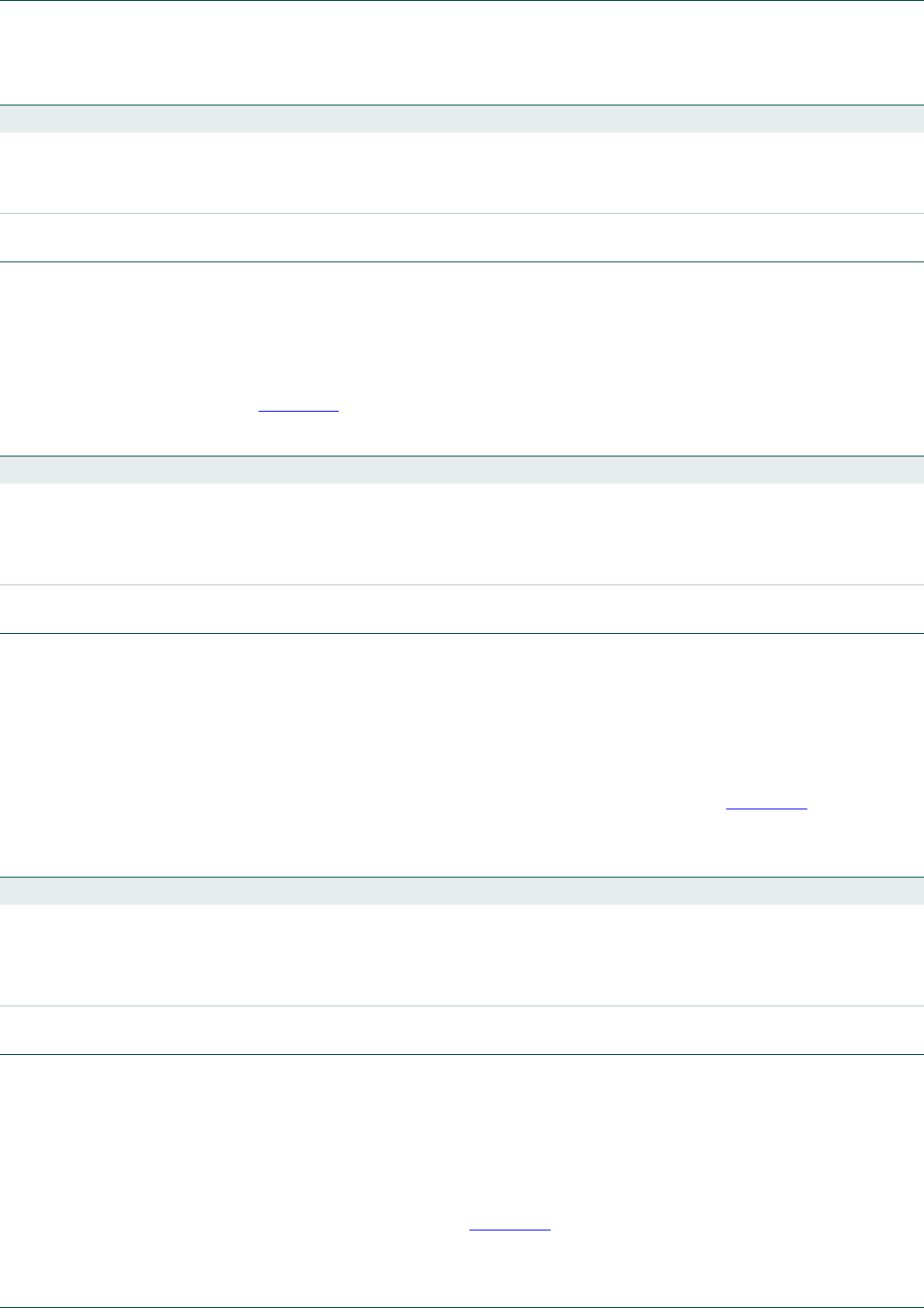
UM10360 All information provided in this document is subject to legal disclaimers. © NXP B.V. 2014. All rights reserved.
User manual Rev. 3.1 — 2 April 2014 605 of 849
NXP Semiconductors UM10360
Chapter 31: LPC176x/5x General Purpose DMA (GPDMA)
31.5.5 DMA Interrupt Error Clear register (DMACIntErrClr - 0x5000 4010)
The DMACIntErrClr Register is write-only and clears the error interrupt requests. When
writing to this register, each data bit that is 1 causes the corresponding bit in the status
register to be cleared. Data bits that are 0 have no effect on the corresponding bit in the
register. Ta b l e 5 50 shows the bit assignments of the DMACIntErrClr Register.
31.5.6 DMA Raw Interrupt Terminal Count Status register
(DMACRawIntTCStat - 0x5000 4014)
The DMACRawIntTCStat Register is read-only and indicates which DMA channel is
requesting a transfer complete (terminal count interrupt) prior to masking. (Note: the
DMACIntTCStat Register contains the same information after masking.) A 1 bit indicates
that the terminal count interrupt request is active prior to masking. Ta b l e 55 1 shows the bit
assignments of the DMACRawIntTCStat Register.
31.5.7 DMA Raw Error Interrupt Status register (DMACRawIntErrStat -
0x5000 4018)
The DMACRawIntErrStat Register is read-only and indicates which DMA channel is
requesting an error interrupt prior to masking. (Note: the DMACIntErrStat Register
contains the same information after masking.) A 1 bit indicates that the error interrupt
request is active prior to masking. Tab l e 5 5 2 shows the bit assignments of register of the
DMACRawIntErrStat Register.
Table 549. DMA Interrupt Error Status register (DMACIntErrStat - 0x5000 400C)
Bit Name Function
7:0 IntErrStat Interrupt error status for DMA channels. Each bit represents one channel:
0 - the corresponding channel has no active error interrupt request.
1 - the corresponding channel does have an active error interrupt request.
31:8 - Reserved, user software should not write ones to reserved bits. The value read from a
reserved bit is not defined.
Table 550. DMA Interrupt Error Clear register (DMACIntErrClr - 0x5000 4010)
Bit Name Function
7:0 IntErrClr Writing a 1 clears the error interrupt request (IntErrStat) for DMA channels. Each bit
represents one channel:
0 - writing 0 has no effect.
1 - clears the corresponding channel error interrupt.
31:8 - Reserved, user software should not write ones to reserved bits. The value read from a
reserved bit is not defined.
Table 551. DMA Raw Interrupt Terminal Count Status register (DMACRawIntTCStat - 0x5000 4014)
Bit Name Function
7:0 RawIntTCStat Status of the terminal count interrupt for DMA channels prior to masking. Each bit
represents one channel:
0 - the corresponding channel has no active terminal count interrupt request.
1 - the corresponding channel does have an active terminal count interrupt request.
31:8 - Reserved, user software should not write ones to reserved bits. The value read from a
reserved bit is not defined.

UM10360 All information provided in this document is subject to legal disclaimers. © NXP B.V. 2014. All rights reserved.
User manual Rev. 3.1 — 2 April 2014 606 of 849
NXP Semiconductors UM10360
Chapter 31: LPC176x/5x General Purpose DMA (GPDMA)
31.5.8 DMA Enabled Channel register (DMACEnbldChns - 0x5000 401C)
The DMACEnbldChns Register is read-only and indicates which DMA channels are
enabled, as indicated by the Enable bit in the DMACCxConfig Register. A 1 bit indicates
that a DMA channel is enabled. A bit is cleared on completion of the DMA transfer.
Tab l e 5 53 shows the bit assignments of the DMACEnbldChns Register.
31.5.9 DMA Software Burst Request register (DMACSoftBReq - 0x5000 4020)
The DMACSoftBReq Register is read/write and enables DMA burst requests to be
generated by software. A DMA request can be generated for each source by writing a 1 to
the corresponding register bit. A register bit is cleared when the transaction has
completed. Reading the register indicates which sources are requesting DMA burst
transfers. A request can be generated from either a peripheral or the software request
register. Each bit is cleared when the related transaction has completed. Table 554 shows
the bit assignments of the DMACSoftBReq Register.
Note: It is recommended that software and hardware peripheral requests are not used at
the same time.
Table 552. DMA Raw Error Interrupt Status register (DMACRawIntErrStat - 0x5000 4018)
Bit Name Function
7:0 RawIntErrStat Status of the error interrupt for DMA channels prior to masking. Each bit represents
one channel:
0 - the corresponding channel has no active error interrupt request.
1 - the corresponding channel does have an active error interrupt request.
31:8 - Reserved, user software should not write ones to reserved bits. The value read from a
reserved bit is not defined.
Table 553. DMA Enabled Channel register (DMACEnbldChns - 0x5000 401C)
Bit Name Function
7:0 EnabledChannels Enable status for DMA channels. Each bit represents one channel:
0 - DMA channel is disabled.
1 - DMA channel is enabled.
31:8 - Reserved, user software should not write ones to reserved bits. The value read from a
reserved bit is not defined.
Table 554. DMA Software Burst Request register (DMACSoftBReq - 0x5000 4020)
Bit Name Function
15:0 SoftBReq Software burst request flags for each of 16 possible sources. Each bit represents one
DMA request line or peripheral function (refer to Ta b le 5 4 4 for peripheral hardware
connections to the DMA controller):
0 - writing 0 has no effect.
1 - writing 1 generates a DMA burst request for the corresponding request line.
31:16 - Reserved, user software should not write ones to reserved bits. The value read from a
reserved bit is not defined.

UM10360 All information provided in this document is subject to legal disclaimers. © NXP B.V. 2014. All rights reserved.
User manual Rev. 3.1 — 2 April 2014 607 of 849
NXP Semiconductors UM10360
Chapter 31: LPC176x/5x General Purpose DMA (GPDMA)
31.5.10 DMA Software Single Request register (DMACSoftSReq - 0x5000
4024)
The DMACSoftSReq Register is read/write and enables DMA single transfer requests to
be generated by software. A DMA request can be generated for each source by writing a
1 to the corresponding register bit. A register bit is cleared when the transaction has
completed. Reading the register indicates which sources are requesting single DMA
transfers. A request can be generated from either a peripheral or the software request
register. Ta b l e 5 55 shows the bit assignments of the DMACSoftSReq Register.
31.5.11 DMA Software Last Burst Request register (DMACSoftLBReq - 0x5000
4028)
The DMACSoftLBReq Register is read/write and enables DMA last burst requests to be
generated by software. A DMA request can be generated for each source by writing a 1 to
the corresponding register bit. A register bit is cleared when the transaction has
completed. Reading the register indicates which sources are requesting last burst DMA
transfers. A request can be generated from either a peripheral or the software request
register. Ta b l e 5 56 shows the bit assignments of the DMACSoftLBReq Register.
31.5.12 DMA Software Last Single Request register (DMACSoftLSReq -
0x5000 402C)
The DMACSoftLSReq Register is read/write and enables DMA last single requests to be
generated by software. A DMA request can be generated for each source by writing a 1 to
the corresponding register bit. A register bit is cleared when the transaction has
completed. Reading the register indicates which sources are requesting last single DMA
transfers. A request can be generated from either a peripheral or the software request
register. Ta b l e 5 57 shows the bit assignments of the DMACSoftLSReq Register.
Table 555. DMA Software Single Request register (DMACSoftSReq - 0x5000 4024)
Bit Name Function
15:0 SoftSReq Software single transfer request flags for each of 16 possible sources. Each bit
represents one DMA request line or peripheral function:
0 - writing 0 has no effect.
1 - writing 1 generates a DMA single transfer request for the corresponding request
line.
31:16 - Reserved, user software should not write ones to reserved bits. The value read from a
reserved bit is not defined.
Table 556. DMA Software Last Burst Request register (DMACSoftLBReq - 0x5000 4028)
Bit Name Function
15:0 SoftLBReq Software last burst request flags for each of 16 possible sources. Each bit represents
one DMA request line or peripheral function:
0 - writing 0 has no effect.
1 - writing 1 generates a DMA last burst request for the corresponding request line.
31:16 - Reserved, user software should not write ones to reserved bits. The value read from a
reserved bit is not defined.
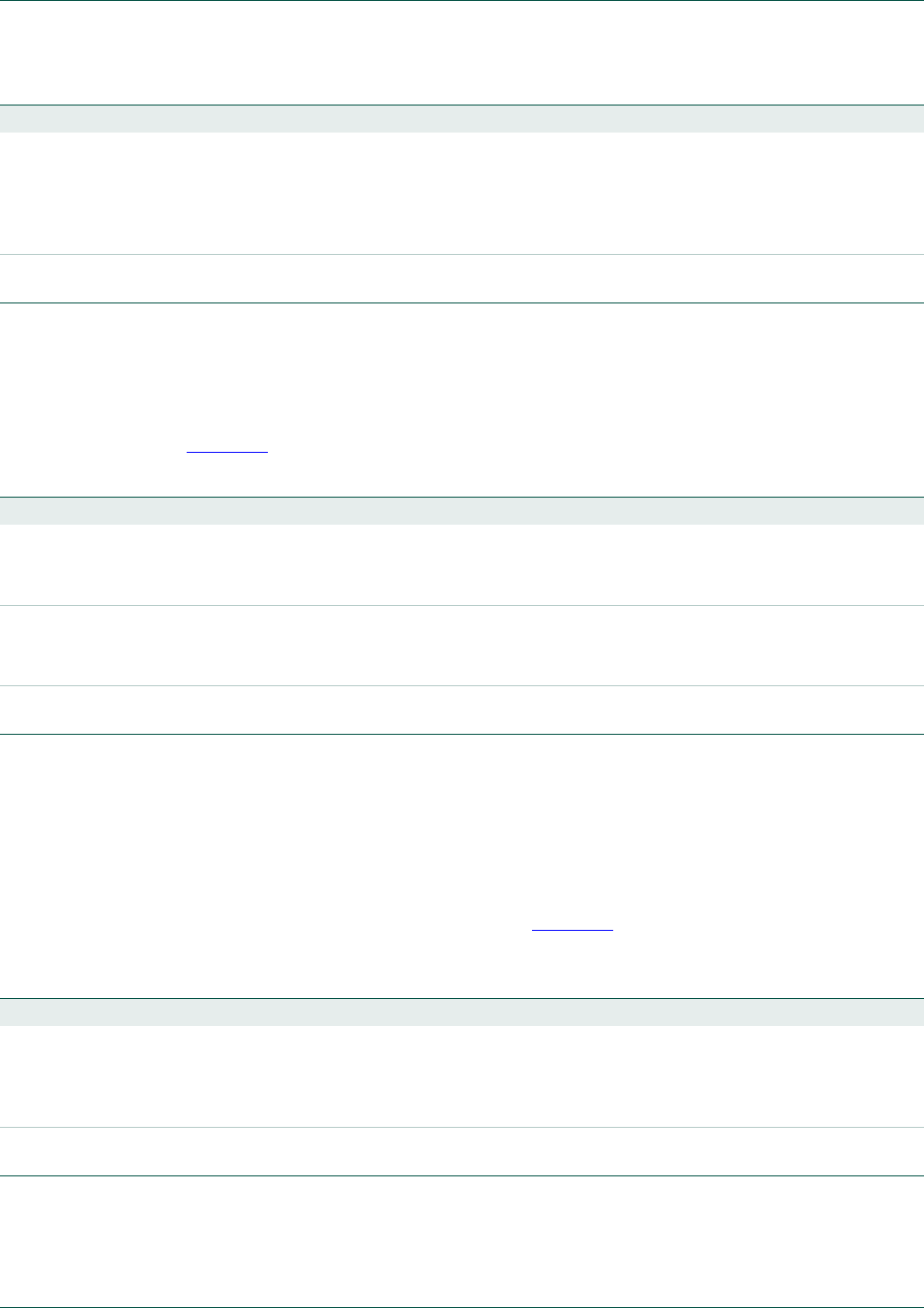
UM10360 All information provided in this document is subject to legal disclaimers. © NXP B.V. 2014. All rights reserved.
User manual Rev. 3.1 — 2 April 2014 608 of 849
NXP Semiconductors UM10360
Chapter 31: LPC176x/5x General Purpose DMA (GPDMA)
31.5.13 DMA Configuration register (DMACConfig - 0x5000 4030)
The DMACConfig Register is read/write and configures the operation of the DMA
Controller. The endianness of the AHB master interface can be altered by writing to the M
bit of this register. The AHB master interface is set to little-endian mode on reset.
Tab l e 5 58 shows the bit assignments of the DMACConfig Register.
31.5.14 DMA Synchronization register (DMACSync - 0x5000 4034)
The DMACSync Register is read/write and enables or disables synchronization logic for
the DMA request signals. The DMA request signals consist of the DMACBREQ[15:0],
DMACSREQ[15:0], DMACLBREQ[15:0], and DMACLSREQ[15:0]. A bit set to 0 enables
the synchronization logic for a particular group of DMA requests. A bit set to 1 disables the
synchronization logic for a particular group of DMA requests. This register is reset to 0,
enabling synchronization logic by default. Tab l e 5 59 shows the bit assignments of the
DMACSync Register.
Table 557. DMA Software Last Single Request register (DMACSoftLSReq - 0x5000 402C)
Bit Name Function
15:0 SoftLSReq Software last single transfer request flags for each of 16 possible sources. Each bit
represents one DMA request line or peripheral function:
0 - writing 0 has no effect.
1 - writing 1 generates a DMA last single transfer request for the corresponding
request line.
31:16 - Reserved, user software should not write ones to reserved bits. The value read from a
reserved bit is not defined.
Table 558. DMA Configuration register (DMACConfig - 0x5000 4030)
Bit Name Function
0E DMA Controller enable:
0 = disabled (default). Disabling the DMA Controller reduces power consumption.
1 = enabled.
1M AHB Master endianness configuration:
0 = little-endian mode (default).
1 = big-endian mode.
31:2 - Reserved, user software should not write ones to reserved bits. The value read from a
reserved bit is not defined.
Table 559. DMA Synchronization register (DMACSync - 0x5000 4034)
Bit Name Function
15:0 DMACSync Controls the synchronization logic for DMA request signals. Each bit represents one
set of DMA request lines as described in the preceding text:
0 - synchronization logic for the corresponding DMA request signals are enabled.
1 - synchronization logic for the corresponding request line signals are disabled.
31:16 - Reserved, user software should not write ones to reserved bits. The value read from a
reserved bit is not defined.

UM10360 All information provided in this document is subject to legal disclaimers. © NXP B.V. 2014. All rights reserved.
User manual Rev. 3.1 — 2 April 2014 609 of 849
NXP Semiconductors UM10360
Chapter 31: LPC176x/5x General Purpose DMA (GPDMA)
31.5.15 DMA Request Select register (DMAReqSel - 0x400F C1C4)
DMAReqSel is a read/write register that allows selecting between UART or Timer DMA
requests for DMA inputs 8 through 15. Tab le 5 6 0 shows the bit assignments of the
DMAReqSel Register.
31.5.16 DMA Channel registers
The channel registers are used to program the eight DMA channels. These registers
consist of:
•Eight DMACCxSrcAddr Registers.
•Eight DMACCxDestAddr Registers.
•Eight DMACCxLLI Registers.
•Eight DMACCxControl Registers.
•Eight DMACCxConfig Registers.
When performing scatter/gather DMA, the first four of these are automatically updated.
Table 560. DMA Request Select register (DMAReqSel - 0x400F C1C4)
Bit Name Function
0DMASEL08 Selects the DMA request for GPDMA input 8:
0 - UART0 TX is selected.
1 - Timer 0 match 0 is selected.
1DMASEL09 Selects the DMA request for GPDMA input 9:
0 - UART0 RX is selected.
1 - Timer 0 match 1 is selected.
2DMASEL10 Selects the DMA request for GPDMA input 10:
0 - UART1 TX is selected.
1 - Timer 1match 0 is selected.
3DMASEL11 Selects the DMA request for GPDMA input 11:
0 - UART1 RX is selected.
1 - Timer 1match 1 is selected.
4DMASEL12 Selects the DMA request for GPDMA input 12:
0 - UART2 TX is selected.
1 - Timer 2 match 0 is selected.
5DMASEL13 Selects the DMA request for GPDMA input 13:
0 - UART2 RX is selected.
1 - Timer 2 match 1 is selected.
6DMASEL14 Selects the DMA request for GPDMA input 14:
0 - UART3 TX is selected.
1 - Timer 3 match 0 is selected.
7DMASEL15 Selects the DMA request for GPDMA input 15:
0 - UART3 RX is selected.
1 - Timer 3 match 1 is selected.
31:8 - Reserved, user software should not write ones to reserved bits. The value read from a
reserved bit is not defined.

UM10360 All information provided in this document is subject to legal disclaimers. © NXP B.V. 2014. All rights reserved.
User manual Rev. 3.1 — 2 April 2014 610 of 849
NXP Semiconductors UM10360
Chapter 31: LPC176x/5x General Purpose DMA (GPDMA)
31.5.17 DMA Channel Source Address registers (DMACCxSrcAddr -
0x5000 41x0)
The eight read/write DMACCxSrcAddr Registers (DMACC0SrcAddr to DMACC7SrcAddr)
contain the current source address (byte-aligned) of the data to be transferred. Each
register is programmed directly by software before the appropriate channel is enabled.
When the DMA channel is enabled this register is updated:
•As the source address is incremented.
•By following the linked list when a complete packet of data has been transferred.
Reading the register when the channel is active does not provide useful information. This
is because by the time software has processed the value read, the address may have
progressed. It is intended to be read-only when the channel has stopped, in which case it
shows the source address of the last item read.
Note: The source and destination addresses must be aligned to the source and
destination widths.
Tab l e 5 61 shows the bit assignments of the DMACCxSrcAddr Registers.
31.5.18 DMA Channel Destination Address registers (DMACCxDestAddr -
0x5000 41x4)
The eight read/write DMACCxDestAddr Registers (DMACC0DestAddr to
DMACC7DestAddr) contain the current destination address (byte-aligned) of the data to
be transferred. Each register is programmed directly by software before the channel is
enabled. When the DMA channel is enabled the register is updated as the destination
address is incremented and by following the linked list when a complete packet of data
has been transferred. Reading the register when the channel is active does not provide
useful information. This is because by the time that software has processed the value
read, the address may have progressed. It is intended to be read-only when a channel
has stopped, in which case it shows the destination address of the last item read.
Tab l e 5 62 shows the bit assignments of the DMACCxDestAddr Register.
31.5.19 DMA Channel Linked List Item registers (DMACCxLLI - 0x5000 41x8)
The eight read/write DMACCxLLI Registers (DMACC0LLI to DMACC7LLI) contain a
word-aligned address of the next Linked List Item (LLI). If the LLI is 0, then the current LLI
is the last in the chain, and the DMA channel is disabled when all DMA transfers
associated with it are completed. Programming this register when the DMA channel is
enabled may have unpredictable side effects. Ta bl e 5 6 3 shows the bit assignments of the
DMACCxLLI Register.
Table 561. DMA Channel Source Address registers (DMACCxSrcAddr - 0x5000 41x0)
Bit Name Function
31:0 SrcAddr DMA source address. Reading this register will return the current source address.
Table 562. DMA Channel Destination Address registers (DMACCxDestAddr - 0x5000 41x4)
Bit Name Function
31:0 DestAddr DMA Destination address. Reading this register will return the current destination
address.

UM10360 All information provided in this document is subject to legal disclaimers. © NXP B.V. 2014. All rights reserved.
User manual Rev. 3.1 — 2 April 2014 611 of 849
NXP Semiconductors UM10360
Chapter 31: LPC176x/5x General Purpose DMA (GPDMA)
31.5.20 DMA channel control registers (DMACCxControl - 0x5000 41xC)
The eight read/write DMACCxControl Registers (DMACC0Control to DMACC7Control)
contain DMA channel control information such as the transfer size, burst size, and transfer
width. Each register is programmed directly by software before the DMA channel is
enabled. When the channel is enabled the register is updated by following the linked list
when a complete packet of data has been transferred. Reading the register while the
channel is active does not give useful information. This is because by the time software
has processed the value read, the channel may have advanced. It is intended to be
read-only when a channel has stopped. Ta bl e 5 6 4 shows the bit assignments of the
DMACCxControl Register.
31.5.20.1 Protection and access information
AHB access information is provided to the source and/or destination peripherals when a
transfer occurs, although on the LPC176x/5x this has no effect. The transfer information is
provided by programming the DMA channel (the Prot bits of the DMACCxControl
Register, and the Lock bit of the DMACCxConfig Register). These bits are programmed
by software, and can be used by peripherals. Three bits of information are provided, and
are used as shown in Ta b le 56 4 .
Table 563. DMA Channel Linked List Item registers (DMACCxLLI - 0x5000 41x8)
Bit Name Function
1:0 - Reserved, and must be written as 0.
31:2 LLI Linked list item. Bits [31:2] of the address for the next LLI. Address bits [1:0] are 0.

UM10360 All information provided in this document is subject to legal disclaimers. © NXP B.V. 2014. All rights reserved.
User manual Rev. 3.1 — 2 April 2014 612 of 849
NXP Semiconductors UM10360
Chapter 31: LPC176x/5x General Purpose DMA (GPDMA)
Table 564. DMA channel control registers (DMACCxControl - 0x5000 41xC)
Bit Name Function
11:0 TransferSize Transfer size. This field sets the size of the transfer. The transfer size value must be set before the
channel is enabled. Transfer size is updated as data transfers are completed.
A read from this field indicates the number of transfers completed on the destination bus. Reading
the register when the channel is active does not give useful information because by the time that the
software has processed the value read, the channel might have progressed. It is intended to be used
only when a channel is enabled and then disabled.
14:12 SBSize Source burst size. Indicates the number of transfers that make up a source burst. This value must be
set to the burst size of the source peripheral, or if the source is memory, to the memory boundary
size. The burst size is the amount of data that is transferred when the DMACBREQ signal goes
active in the source peripheral.
000 - 1
001 - 4
010 - 8
011 - 16
100 - 32
101 - 64
110 - 128
111 - 256
17:15 DBSize Destination burst size. Indicates the number of transfers that make up a destination burst transfer
request. This value must be set to the burst size of the destination peripheral or, if the destination is
memory, to the memory boundary size. The burst size is the amount of data that is transferred when
the DMACBREQ signal goes active in the destination peripheral.
000 - 1
001 - 4
010 - 8
011 - 16
100 - 32
101 - 64
110 - 128
111 - 256
20:18 SWidth Source transfer width. Transfers wider than the AHB master bus width are illegal. The source and
destination widths can be different from each other. The hardware automatically packs and unpacks
the data as required.
000 - Byte (8-bit)
001 - Halfword (16-bit)
010 - Word (32-bit)
011 to 111 - Reserved
23:21 DWidth Destination transfer width. Transfers wider than the AHB master bus width are not supported. The
source and destination widths can be different from each other. The hardware automatically packs
and unpacks the data as required.
000 - Byte (8-bit)
001 - Halfword (16-bit)
010 - Word (32-bit)
011 to 111 - Reserved
25:24 - Reserved, and must be written as 0.

UM10360 All information provided in this document is subject to legal disclaimers. © NXP B.V. 2014. All rights reserved.
User manual Rev. 3.1 — 2 April 2014 613 of 849
NXP Semiconductors UM10360
Chapter 31: LPC176x/5x General Purpose DMA (GPDMA)
31.5.21 DMA Channel Configuration registers (DMACCxConfig - 0x5000 41x0)
The eight DMACCxConfig Registers (DMACC0Config to DMACC7Config) are read/write
with the exception of bit[17] which is read-only. These registers configure each DMA
channel. The registers are not updated when a new LLI is requested. Ta b le 5 6 5 shows the
bit assignments of the DMACCxConfig Register.
26 SI Source increment:
0 - the source address is not incremented after each transfer.
1 - the source address is incremented after each transfer.
27 DI Destination increment:
0 - the destination address is not incremented after each transfer.
1 - the destination address is incremented after each transfer.
28 Prot1 This is provided to the peripheral during a DMA bus access and indicates that the access is in user
mode or privileged mode. This information is not used in the LPC176x/5x.
0 - access is in user mode.
1 - access is in privileged mode.
29 Prot2 This is provided to the peripheral during a DMA bus access and indicates to the peripheral that the
access is bufferable or not bufferable. This information is not used in the LPC176x/5x.
0 - access is not bufferable.
1 - access is bufferable.
30 Prot3 This is provided to the peripheral during a DMA bus access and indicates to the peripheral that the
access is cacheable or not cacheable. This information is not used in the LPC176x/5x.
0 - access is not cacheable.
1 - access is cacheable.
31 I Te rm i n a l co u n t inte r r u pt ena b l e bit .
0 - the terminal count interrupt is disabled.
1 - the terminal count interrupt is enabled.
Table 564. DMA channel control registers (DMACCxControl - 0x5000 41xC) …continued
Bit Name Function
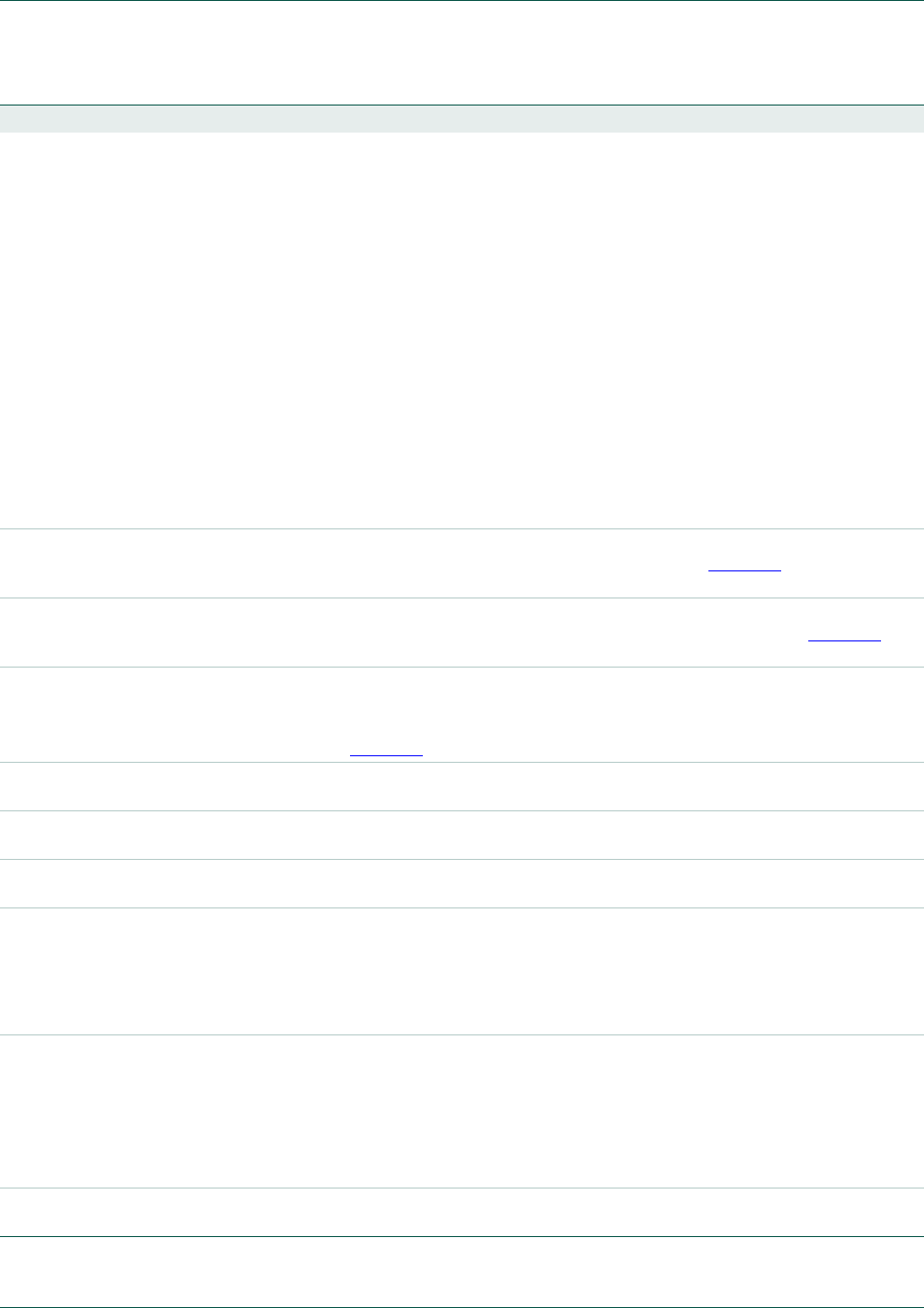
UM10360 All information provided in this document is subject to legal disclaimers. © NXP B.V. 2014. All rights reserved.
User manual Rev. 3.1 — 2 April 2014 614 of 849
NXP Semiconductors UM10360
Chapter 31: LPC176x/5x General Purpose DMA (GPDMA)
Table 565. DMA Channel Configuration registers (DMACCxConfig - 0x5000 41x0)
Bit Name Function
0E Channel enable. Reading this bit indicates whether a channel is currently enabled or
disabled:
0 = channel disabled.
1 = channel enabled.
The Channel Enable bit status can also be found by reading the DMACEnbldChns
Register.
A channel is enabled by setting this bit.
A channel can be disabled by clearing the Enable bit. This causes the current AHB
transfer (if one is in progress) to complete and the channel is then disabled. Any data
in the FIFO of the relevant channel is lost. Restarting the channel by setting the
Channel Enable bit has unpredictable effects, the channel must be fully re-initialized.
The channel is also disabled, and Channel Enable bit cleared, when the last LLI is
reached, the DMA transfer is completed, or if a channel error is encountered.
If a channel must be disabled without losing data in the FIFO, the Halt bit must be set
so that further DMA requests are ignored. The Active bit must then be polled until it
reaches 0, indicating that there is no data left in the FIFO. Finally, the Channel Enable
bit can be cleared.
5:1 SrcPeripheral Source peripheral. This value selects the DMA source request peripheral. This field is
ignored if the source of the transfer is from memory. See Tabl e 5 4 4 for peripheral
identification.
10:6 DestPeripheral Destination peripheral. This value selects the DMA destination request peripheral.
This field is ignored if the destination of the transfer is to memory. See Ta b l e 544 for
peripheral identification.
13:11 TransferType This value indicates the type of transfer. The transfer type can be
memory-to-memory, memory-to-peripheral, peripheral-to-memory, or
peripheral-to-peripheral.
Refer to Tabl e 5 6 6 for the encoding of this field.
14 IE Interrupt error mask. When cleared, this bit masks out the error interrupt of the
relevant channel.
15 ITC Terminal count interrupt mask. When cleared, this bit masks out the terminal count
interrupt of the relevant channel.
16 L Lock. When set, this bit enables locked transfers. This information is not used in the
LPC176x/5x.
17 A Active:
0 = there is no data in the FIFO of the channel.
1 = the channel FIFO has data.
This value can be used with the Halt and Channel Enable bits to cleanly disable a
DMA channel. This is a read-only bit.
18 H Halt:
0 = enable DMA requests.
1 = ignore further source DMA requests.
The contents of the channel FIFO are drained.
This value can be used with the Active and Channel Enable bits to cleanly disable a
DMA channel.
31:19 Reserved Reserved, user software should not write ones to reserved bits. The value read from a
reserved bit is not defined.

UM10360 All information provided in this document is subject to legal disclaimers. © NXP B.V. 2014. All rights reserved.
User manual Rev. 3.1 — 2 April 2014 615 of 849
NXP Semiconductors UM10360
Chapter 31: LPC176x/5x General Purpose DMA (GPDMA)
31.5.21.1 Lock control
The lock control may set the lock bit by writing a 1 to bit 16 of the DMACCxConfig
Register. When a burst occurs, the AHB arbiter will not de-grant the master during the
burst until the lock is de-asserted. The DMA Controller can be locked for a a single burst
such as a long source fetch burst or a long destination drain burst. The DMA Controller
does not usually assert the lock continuously for a source fetch burst followed by a
destination drain burst.
There are situations when the DMA Controller asserts the lock for source transfers
followed by destination transfers. This is possible when internal conditions in the DMA
Controller permit it to perform a source fetch followed by a destination drain back-to-back.
31.5.21.2 Transfer type
Tab l e 5 66 lists the bit values of the transfer type bits identified in Tabl e 5 6 5 .
Table 566. Transfer type bits
Bit value Transfer type Controller
000 Memory to memory DMA
001 Memory to peripheral DMA
010 Peripheral to memory DMA
011 Source peripheral to destination peripheral DMA
100 to 111 Reserved, do not use these combinations -

UM10360 All information provided in this document is subject to legal disclaimers. © NXP B.V. 2014. All rights reserved.
User manual Rev. 3.1 — 2 April 2014 616 of 849
NXP Semiconductors UM10360
Chapter 31: LPC176x/5x General Purpose DMA (GPDMA)
31.6 Using the DMA controller
31.6.1 Programming the DMA controller
All accesses to the DMA Controller internal register must be word (32-bit) reads and
writes.
31.6.1.1 Enabling the DMA controller
To enable the DMA controller set the Enable bit in the DMACConfig register.
31.6.1.2 Disabling the DMA controller
To disable the DMA controller:
•Read the DMACEnbldChns register and ensure that all the DMA channels have been
disabled. If any channels are active, see Disabling a DMA channel.
•Disable the DMA controller by writing 0 to the DMA Enable bit in the DMACConfig
register.
31.6.1.3 Enabling a DMA channel
To enable the DMA channel set the channel enable bit in the relevant DMA channel
configuration register. Note that the channel must be fully initialized before it is enabled.
31.6.1.4 Disabling a DMA channel
A DMA channel can be disabled in three ways:
•By writing directly to the channel enable bit. Any outstanding data in the FIFO’s is lost
if this method is used.
•By using the active and halt bits in conjunction with the channel enable bit.
•By waiting until the transfer completes. This automatically clears the channel.
Disabling a DMA channel and losing data in the FIFO
Clear the relevant channel enable bit in the relevant channel configuration register. The
current AHB transfer (if one is in progress) completes and the channel is disabled. Any
data in the FIFO is lost.
Disabling the DMA channel without losing data in the FIFO
•Set the halt bit in the relevant channel configuration register. This causes any future
DMA request to be ignored.
•Poll the active bit in the relevant channel configuration register until it reaches 0. This
bit indicates whether there is any data in the channel that has to be transferred.
•Clear the channel enable bit in the relevant channel configuration register
31.6.1.5 Setting up a new DMA transfer
To s et u p a new D MA tra n s fe r :
If the channel is not set aside for the DMA transaction:

UM10360 All information provided in this document is subject to legal disclaimers. © NXP B.V. 2014. All rights reserved.
User manual Rev. 3.1 — 2 April 2014 617 of 849
NXP Semiconductors UM10360
Chapter 31: LPC176x/5x General Purpose DMA (GPDMA)
1. Read the DMACEnbldChns controller register and find out which channels are
inactive.
2. Choose an inactive channel that has the required priority.
3. Program the DMA controller
31.6.1.6 Halting a DMA channel
Set the halt bit in the relevant DMA channel configuration register. The current source
request is serviced. Any further source DMA request is ignored until the halt bit is cleared.
31.6.1.7 Programming a DMA channel
1. Choose a free DMA channel with the priority needed. DMA channel 0 has the highest
priority and DMA channel 7 the lowest priority.
2. Clear any pending interrupts on the channel to be used by writing to the
DMACIntTCClear and DMACIntErrClear register. The previous channel operation
might have left interrupt active.
3. Write the source address into the DMACCxSrcAddr register.
4. Write the destination address into the DMACCxDestAddr register.
5. Write the address of the next LLI into the DMACCxLLI register. If the transfer
comprises of a single packet of data then 0 must be written into this register.
6. Write the control information into the DMACCxControl register.
7. Write the channel configuration information into the DMACCxConfig register. If the
enable bit is set then the DMA channel is automatically enabled.
31.6.2 Flow control
The device that controls the length of the packet is known as the flow controller. On the
LPC176x/5x, the flow controller is always the DMA Controller, and the packet length is
programmed by software before the DMA channel is enabled.
When the DMA transfer is completed:
1. The DMA Controller issues an acknowledge to the peripheral in order to indicate that
the transfer has finished.
2. A TC interrupt is generated, if enabled.
3. The DMA Controller moves on to the next LLI.
The following sections describe the DMA Controller data flow sequences for the four
allowed transfer types:
•Memory-to-peripheral.
•Peripheral-to-memory.
•Memory-to-memory.
•Peripheral-to-peripheral.
Tab l e 5 67 indicates the request signals used for each type of transfer.

UM10360 All information provided in this document is subject to legal disclaimers. © NXP B.V. 2014. All rights reserved.
User manual Rev. 3.1 — 2 April 2014 618 of 849
NXP Semiconductors UM10360
Chapter 31: LPC176x/5x General Purpose DMA (GPDMA)
31.6.2.1 Peripheral-to-memory or memory-to-peripheral DMA flow
For a peripheral-to-memory or memory-to-peripheral DMA flow, the following sequence
occurs:
1. Program and enable the DMA channel.
2. Wait for a DMA request.
3. The DMA Controller starts transferring data when:
–The DMA request goes active.
–The DMA stream has the highest pending priority.
–The DMA Controller is the bus master of the AHB bus.
4. If an error occurs while transferring the data, an error interrupt is generated and
disables the DMA stream, and the flow sequence ends.
5. Decrement the transfer count.
6. If the transfer has completed (indicated by the transfer count reaching 0):
–The DMA Controller responds with a DMA acknowledge.
–The terminal count interrupt is generated (this interrupt can be masked).
–If the DMACCxLLI Register is not 0, then reload the DMACCxSrcAddr,
DMACCxDestAddr, DMACCxLLI, and DMACCxControl registers and go to back to
step 2. However, if DMACCxLLI is 0, the DMA stream is disabled and the flow
sequence ends.
31.6.2.2 Peripheral-to-peripheral DMA flow
For a peripheral-to-peripheral DMA flow, the following sequence occurs:
1. Program and enable the DMA channel.
2. Wait for a source DMA request.
3. The DMA Controller starts transferring data when:
–The DMA request goes active.
–The DMA stream has the highest pending priority.
–The DMA Controller is the bus master of the AHB bus.
4. If an error occurs while transferring the data an error interrupt is generated, the DMA
stream is disabled, and the flow sequence ends.
5. Decrement the transfer count.
6. If the transfer has completed (indicated by the transfer count reaching 0):
–The DMA Controller responds with a DMA acknowledge to the source peripheral.
–Further source DMA requests are ignored.
Table 567. DMA request signal usage
Transfer direction Request generator Flow controller
Memory-to-peripheral Peripheral DMA Controller
Peripheral-to-memory Peripheral DMA Controller
Memory-to-memory DMA Controller DMA Controller
Source peripheral to destination peripheral Source peripheral and destination peripheral DMA Controller

UM10360 All information provided in this document is subject to legal disclaimers. © NXP B.V. 2014. All rights reserved.
User manual Rev. 3.1 — 2 April 2014 619 of 849
NXP Semiconductors UM10360
Chapter 31: LPC176x/5x General Purpose DMA (GPDMA)
7. When the destination DMA request goes active and there is data in the DMA
Controller FIFO, transfer data into the destination peripheral.
8. If an error occurs while transferring the data, an error interrupt is generated, the DMA
stream is disabled, and the flow sequence ends.
9. If the transfer has completed it is indicated by the transfer count reaching 0. The
following happens:
–The DMA Controller responds with a DMA acknowledge to the destination
peripheral.
–The terminal count interrupt is generated (this interrupt can be masked).
–If the DMACCxLLI Register is not 0, then reload the DMACCxSrcAddr,
DMACCxDestAddr, DMACCxLLI, and DMACCxControl Registers and go to back
to step 2. However, if DMACCxLLI is 0, the DMA stream is disabled and the flow
sequence ends.
31.6.2.3 Memory-to-memory DMA flow
For a memory-to-memory DMA flow the following sequence occurs:
1. Program and enable the DMA channel.
2. Transfer data whenever the DMA channel has the highest pending priority and the
DMA Controller gains mastership of the AHB bus.
3. If an error occurs while transferring the data, generate an error interrupt and disable
the DMA stream.
4. Decrement the transfer count.
5. If the count has reached zero:
–Generate a terminal count interrupt (the interrupt can be masked).
–If the DMACCxLLI Register is not 0, then reload the DMACCxSrcAddr,
DMACCxDestAddr, DMACCxLLI, and DMACCxControl Registers and go to back
to step 2. However, if DMACCxLLI is 0, the DMA stream is disabled and the flow
sequence ends.
Note: Memory-to-memory transfers should be programmed with a low channel priority,
otherwise other DMA channels cannot access the bus until the memory-to-memory
transfer has finished, or other AHB masters cannot perform any transaction.
31.6.3 Interrupt requests
Interrupt requests can be generated when an AHB error is encountered or at the end of a
transfer (terminal count), after all the data corresponding to the current LLI has been
transferred to the destination. The interrupts can be masked by programming bits in the
relevant DMACCxControl and DMACCxConfig Channel Registers. The interrupt requests
from all DMA channels can be found in the DMACRawIntTCStat and DMACRawIntErrStat
registers. The masked versions of the DMA interrupt data is contained in the
DMACIntTCStat and DMACIntErrStat registers. The DMACIntStat register then combines
the DMACIntTCStat and DMACIntErrStat requests into a single register to enable the
source of an interrupt to be found quickly. Writing to the DMACIntTCClear or the
DMACIntErrClr Registers with a bit set to 1 enables selective clearing of interrupts.

UM10360 All information provided in this document is subject to legal disclaimers. © NXP B.V. 2014. All rights reserved.
User manual Rev. 3.1 — 2 April 2014 620 of 849
NXP Semiconductors UM10360
Chapter 31: LPC176x/5x General Purpose DMA (GPDMA)
31.6.3.1 Hardware interrupt sequence flow
When a DMA interrupt request occurs, the Interrupt Service Routine needs to:
1. Read the DMACIntTCStat Register to determine whether the interrupt was generated
due to the end of the transfer (terminal count). A 1 bit indicates that the transfer
completed. If more than one request is active, it is recommended that the highest
priority channels be checked first.
2. Read the DMACIntErrStat Register to determine whether the interrupt was generated
due to an error occurring. A 1 bit indicates that an error occurred.
3. Service the interrupt request.
4. For a terminal count interrupt, write a 1 to the relevant bit of the DMACIntTCClr
Register. For an error interrupt write a 1 to the relevant bit of the DMACIntErrClr
Register to clear the interrupt request.
31.6.4 Address generation
Address generation can be either incrementing or non-incrementing (address wrapping is
not supported).
Some devices, especially memories, disallow burst accesses across certain address
boundaries. The DMA controller assumes that this is the case with any source or
destination area, which is configured for incrementing addressing. This boundary is
assumed to be aligned with the specified burst size. For example, if the channel is set for
16-transfer burst to a 32-bit wide device then the boundary is 64-bytes aligned (that is
address bits [5:0] equal 0). If a DMA burst is to cross one of these boundaries, then,
instead of a burst, that transfer is split into separate AHB transactions.
31.6.4.1 Word-aligned transfers across a boundary
The channel is configured for 16-transfer bursts, each transfer 32-bits wide, to a
destination for which address incrementing is enabled. The start address for the current
burst is 0x0C000024, the next boundary (calculated from the burst size and transfer
width) is 0x0C000040.
The transfer will be split into two AHB transactions:
•a 7-transfer burst starting at address 0x0C000024
•a 9-transfer burst starting at address 0x0C000040.
31.6.5 Scatter/gather
Scatter/gather is supported through the use of linked lists. This means that the source and
destination areas do not have to occupy contiguous areas in memory. Where
scatter/gather is not required, the DMACCxLLI Register must be set to 0.
The source and destination data areas are defined by a series of linked lists. Each Linked
List Item (LLI) controls the transfer of one block of data, and then optionally loads another
LLI to continue the DMA operation, or stops the DMA stream. The first LLI is programmed
into the DMA Controller.
The data to be transferred described by an LLI (referred to as the packet of data) usually
requires one or more DMA bursts (to each of the source and destination).

UM10360 All information provided in this document is subject to legal disclaimers. © NXP B.V. 2014. All rights reserved.
User manual Rev. 3.1 — 2 April 2014 621 of 849
NXP Semiconductors UM10360
Chapter 31: LPC176x/5x General Purpose DMA (GPDMA)
31.6.5.1 Linked list items
A Linked List Item (LLI) consists of four words. These words are organized in the following
order:
1. DMACCxSrcAddr.
2. DMACCxDestAddr.
3. DMACCxLLI.
4. DMACCxControl.
Note: The DMACCxConfig DMA channel Configuration Register is not part of the linked
list item.
31.6.5.1.1 Programming the DMA controller for scatter/gather DMA
To p rog r am t h e D M A C o ntr o ller for scatter/gather DMA:
1. Write the LLIs for the complete DMA transfer to memory. Each linked list item contains
four words:
–Source address.
–Destination address.
–Pointer to next LLI.
–Control word.
The last LLI has its linked list word pointer set to 0.
2. Choose a free DMA channel with the priority required. DMA channel 0 has the highest
priority and DMA channel 7 the lowest priority.
3. Write the first linked list item, previously written to memory, to the relevant channel in
the DMA Controller.
4. Write the channel configuration information to the channel Configuration Register and
set the Channel Enable bit. The DMA Controller then transfers the first and then
subsequent packets of data as each linked list item is loaded.
5. An interrupt can be generated at the end of each LLI depending on the Terminal
Count bit in the DMACCxControl Register. If this bit is set an interrupt is generated at
the end of the relevant LLI. The interrupt request must then be serviced and the
relevant bit in the DMACIntTCClear Register must be set to clear the interrupt.
31.6.5.1.2 Example of scatter/gather DMA
See Figure 136 for an example of an LLI. A section of memory is to be transferred to a
peripheral. The addresses of each LLI entry are given, in hexadecimal, at the left-hand
side of the figure. In this example, the LLIs describing the transfer are to be stored
contiguously from address 0x2002 0000, but they could be located anywhere. The right
side of the figure shows the memory containing the data to be transferred.
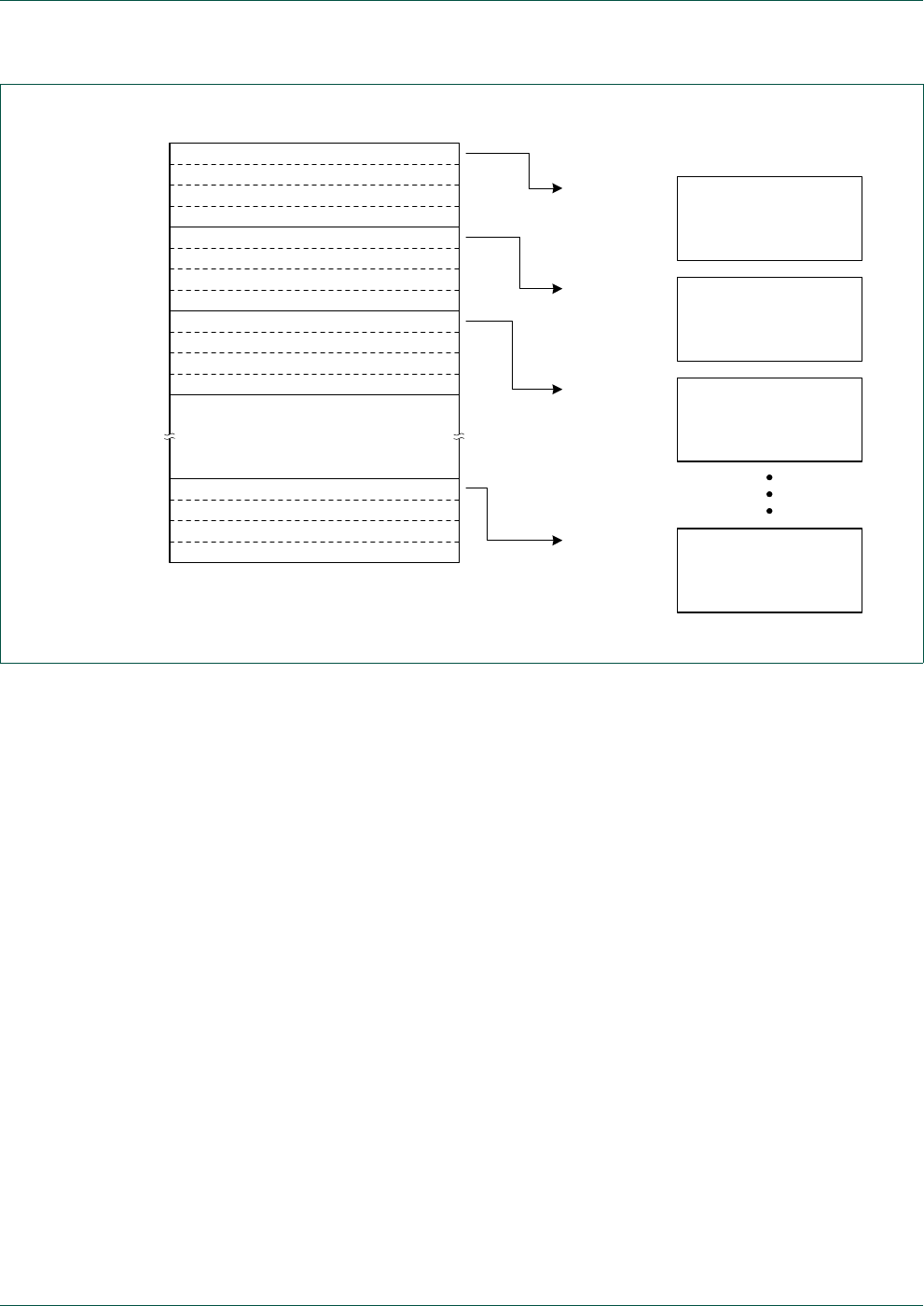
UM10360 All information provided in this document is subject to legal disclaimers. © NXP B.V. 2014. All rights reserved.
User manual Rev. 3.1 — 2 April 2014 622 of 849
NXP Semiconductors UM10360
Chapter 31: LPC176x/5x General Purpose DMA (GPDMA)
The first LLI, stored at 0x2002 0000, defines the first block of data to be transferred, which
is the data stored from address 0x2002 A200 to 0x2002 ADFF:
•Source start address 0x2002 A200.
•Destination address set to the destination peripheral address.
•Transfer width, word (32-bit).
•Transfer size, 3072 bytes (0XC00).
•Source and destination burst sizes, 16 transfers.
•Next LLI address, 0x2002 0010.
The second LLI, stored at 0x2002 0010, describes the next block of data to be transferred:
•Source start address 0x2002 B200.
•Destination address set to the destination peripheral address.
•Transfer width, word (32-bit).
•Transfer size, 3072 bytes (0xC00).
•Source and destination burst sizes, 16 transfers.
•Next LLI address, 0x2002 0020.
A chain of descriptors is built up, each one pointing to the next in the series. To initialize
the DMA stream, the first LLI, 0x2002 0000, is programmed into the DMA Controller.
When the first packet of data has been transferred the next LLI is automatically loaded.
The final LLI is stored at 0x2002 0070 and contains:
Fig 136. LLI example
LLI1
0x2002 0000
Source address = 0x 2002 A200
Destination address = peripheral
Next LLI address = 0x2002 0010
Control information = length 3072
Source address = 0x 2002 B200
Destination address = peripheral
Next LLI address = 0x2002 0020
Control information = length 3072
Source address = 0x 2002 C200
Destination address = peripheral
Next LLI address = 0x2002 0030
Control information = length 3072
Source address = 0x 2003 1200
Destination address = peripheral
Next LLI address = 0 (end of list)
Control information = length 3072
LLI2
0x2002 0010
LLI3
0x2002 0020
LLI8
0x2002 0070
Linked List Array
3072 bytes of data
0x2002 A200
0x2002 ADFF
3072 bytes of data
0x2002 B200
0x2002 BDFF
3072 bytes of data
0x2002 C200
0x2002 CDFF
3072 bytes of data
0x2003 1200
0x2003 1DFF

UM10360 All information provided in this document is subject to legal disclaimers. © NXP B.V. 2014. All rights reserved.
User manual Rev. 3.1 — 2 April 2014 623 of 849
NXP Semiconductors UM10360
Chapter 31: LPC176x/5x General Purpose DMA (GPDMA)
•Source start address 0x2003 1200.
•Destination address set to the destination peripheral address.
•Transfer width, word (32-bit).
•Transfer size, 3072 bytes (0xC00).
•Source and destination burst sizes, 16 transfers.
•Next LLI address, 0x0.
Because the next LLI address is set to zero, this is the last descriptor, and the DMA
channel is disabled after transferring the last item of data. The channel is probably set to
generate an interrupt at this point to indicate to the ARM processor that the channel can
be reprogrammed.

UM10360 All information provided in this document is subject to legal disclaimers. © NXP B.V. 2014. All rights reserved.
User manual Rev. 3.1 — 2 April 2014 624 of 849
32.1 Introduction
The boot loader controls initial operation after reset and also provides the tools for
programming the flash memory. This could be initial programming of a blank device,
erasure and re-programming of a previously programmed device, or programming of the
flash memory by the application program in a running system.
32.2 Features
•In-System Programming: In-System programming (ISP) is programming or
reprogramming the on-chip flash memory, using the boot loader software and UART0
serial port. This can be done when the part resides in the end-user board.
•In Application Programming: In-Application (IAP) programming is performing erase
and write operation on the on-chip flash memory, as directed by the end-user
application code.
•Flash signature generation: built-in hardware can generate a signature for a range of
flash addresses, or for the entire flash memory.
32.3 Description
The flash boot loader code is executed every time the part is powered on or reset. The
loader can execute the ISP command handler or the user application code. A LOW level
after reset at pin P2.10 is considered an external hardware request to start the ISP
command handler. Assuming that power supply pins are on their nominal levels when the
rising edge on RESET pin is generated, it may take up to 3 ms before P2.10 is sampled
and the decision on whether to continue with user code or ISP handler is made. If P2.10 is
sampled low and the watchdog overflow flag is set, the external hardware request to start
the ISP command handler is ignored. If there is no request for the ISP command handler
execution (P2.10 is sampled HIGH after reset), a search is made for a valid user program.
If a valid user program is found then the execution control is transferred to it. If a valid user
program is not found, the auto-baud routine is invoked.
Pin P2.10 is used as a hardware request signal for ISP and therefore requires special
attention. Since P2.10 is in high impedance mode after reset, it is important that the user
provides external hardware (a pull-up resistor or other device) to put the pin in a defined
state. Otherwise unintended entry into ISP mode may occur.
When ISP mode is entered after a power on reset, the IRC and PLL are used to generate
the CCLK of 14.748 MHz. The baud rates that can easily be obtained in this case are:
9600 baud, 19200 baud, 38400 baud, 57600 baud, 115200 baud, and 230400 baud. This
may not be the case when ISP is invoked by the user application (see Section 32.8.9
“Re-invoke ISP” on page 645).
UM10360
Chapter 32: LPC176x/5x Flash memory interface and
programming
Rev. 3.1 — 2 April 2014 User manual
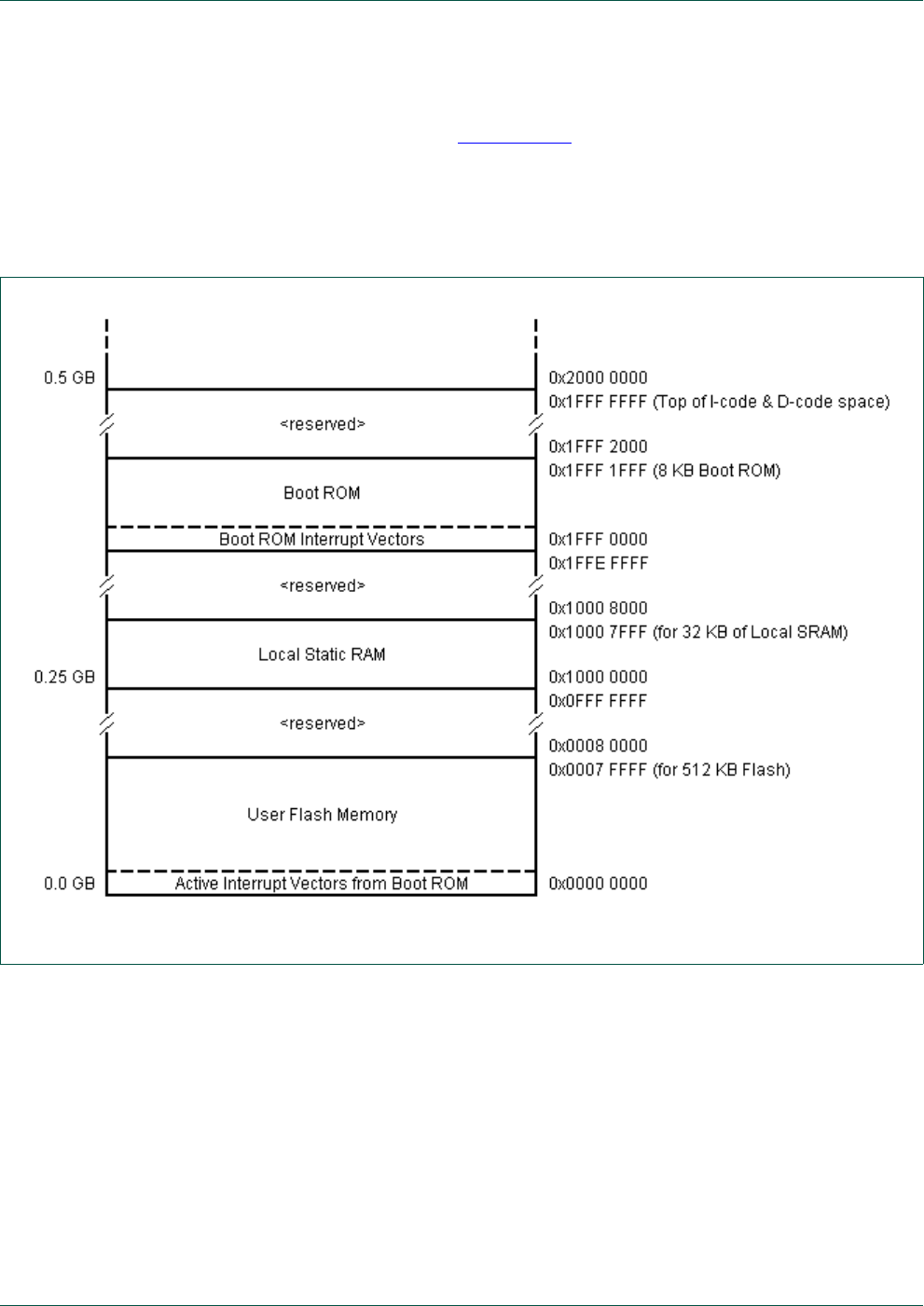
UM10360 All information provided in this document is subject to legal disclaimers. © NXP B.V. 2014. All rights reserved.
User manual Rev. 3.1 — 2 April 2014 625 of 849
NXP Semiconductors UM10360
Chapter 32: LPC176x/5x Flash memory interface and programming
A hardware flash signature generation capability is built into the flash memory. this feature
can be used to create a signature that can then be used to verify flash contents. Details of
flash signature generation are in Section 32.10.
32.3.1 Memory map after any reset
When a user program begins execution after reset, the interrupt vectors are set to point to
the beginning of flash memory.
32.3.1.1 Criterion for Valid User Code
The reserved Cortex-M3 exception vector location 7 (offset 0x 001C in the vector table)
should contain the 2’s complement of the check-sum of table entries 0 through 6. This
causes the checksum of the first 8 table entries to be 0. The boot loader code checksums
the first 8 locations in sector 0 of the flash. If the result is 0, then execution control is
transferred to the user code.
If the signature is not valid, the auto-baud routine synchronizes with the host via serial port
0. The host should send a “?” (0x3F) as a synchronization character and wait for a
response. The host side serial port settings should be 8 data bits, 1 stop bit and no parity.
The auto-baud routine measures the bit time of the received synchronization character in
terms of its own frequency and programs the baud rate generator of the serial port. It also
Fig 137. Map of lower memory

UM10360 All information provided in this document is subject to legal disclaimers. © NXP B.V. 2014. All rights reserved.
User manual Rev. 3.1 — 2 April 2014 626 of 849
NXP Semiconductors UM10360
Chapter 32: LPC176x/5x Flash memory interface and programming
sends an ASCII string ("Synchronized<CR><LF>") to the host. In response to this the host
should send the same string ("Synchronized<CR><LF>"). The auto-baud routine looks at
the received characters to verify synchronization. If synchronization is verified then
"OK<CR><LF>" string is sent to the host. The host should respond by sending the crystal
frequency (in kHz) at which the part is running. For example, if the part is running at 10
MHz, the response from the host should be "10000<CR><LF>". "OK<CR><LF>" string is
sent to the host after receiving the crystal frequency. If synchronization is not verified then
the auto-baud routine waits again for a synchronization character. For auto-baud to work
correctly in case of user invoked ISP, the CCLK frequency should be greater than or equal
to 10 MHz.
For more details on Reset, PLL and startup/boot code interaction see Section 4.5.1.1
“PLL0 and startup/boot code interaction”.
Once the crystal frequency is received the part is initialized and the ISP command handler
is invoked. For safety reasons an "Unlock" command is required before executing the
commands resulting in flash erase/write operations and the "Go" command. The rest of
the commands can be executed without the unlock command. The Unlock command is
required to be executed once per ISP session. The Unlock command is explained in
Section 32.7 “ISP commands” on page 632.
32.3.2 Communication protocol
All ISP commands should be sent as single ASCII strings. Strings should be terminated
with Carriage Return (CR) and/or Line Feed (LF) control characters. Extra <CR> and
<LF> characters are ignored. All ISP responses are sent as <CR><LF> terminated ASCII
strings. Data is sent and received in UU-encoded format.
32.3.2.1 ISP command format
"Command Parameter_0 Parameter_1 … Parameter_n<CR><LF>" "Data" (Data only for
Write commands).
32.3.2.2 ISP response format
"Return_Code<CR><LF>Response_0<CR><LF>Response_1<CR><LF> …
Response_n<CR><LF>" "Data" (Data only for Read commands).
32.3.2.3 ISP data format
The data stream is in UU-encoded format. The UU-encode algorithm converts 3 bytes of
binary data in to 4 bytes of printable ASCII character set. It is more efficient than Hex
format which converts 1 byte of binary data in to 2 bytes of ASCII hex. The sender should
send the check-sum after transmitting 20 UU-encoded lines. The length of any
UU-encoded line should not exceed 61 characters (bytes) i.e. it can hold 45 data bytes.
The receiver should compare it with the check-sum of the received bytes. If the
check-sum matches then the receiver should respond with "OK<CR><LF>" to continue
further transmission. If the check-sum does not match the receiver should respond with
"RESEND<CR><LF>". In response the sender should retransmit the bytes.

UM10360 All information provided in this document is subject to legal disclaimers. © NXP B.V. 2014. All rights reserved.
User manual Rev. 3.1 — 2 April 2014 627 of 849
NXP Semiconductors UM10360
Chapter 32: LPC176x/5x Flash memory interface and programming
32.3.2.4 ISP flow control
A software XON/XOFF flow control scheme is used to prevent data loss due to buffer
overrun. When the data arrives rapidly, the ASCII control character DC3 (0x13) is sent to
stop the flow of data. Data flow is resumed by sending the ASCII control character DC1
(0x11). The host should also support the same flow control scheme.
32.3.2.5 ISP command abort
Commands can be aborted by sending the ASCII control character "ESC" (0x1B). This
feature is not documented as a command under "ISP Commands" section. Once the
escape code is received the ISP command handler waits for a new command.
32.3.2.6 Interrupts during IAP
The on-chip flash memory is not accessible during erase/write operations. When the user
application code starts executing the interrupt vectors from the user flash area are active.
The user should either disable interrupts, or ensure that user interrupt vectors are active in
RAM and that the interrupt handlers reside in RAM, before making a flash erase/write IAP
call. The IAP code does not use or disable interrupts.
32.3.2.7 RAM used by ISP command handler
ISP commands use on-chip RAM from 0x1000 0118 to 0x1000 01FF. The user could use
this area, but the contents may be lost upon reset. Flash programming commands use the
top 32 bytes of on-chip RAM. The stack is located at RAM top - 32. The maximum stack
usage is 256 bytes and it grows downwards.
32.3.2.8 RAM used by IAP command handler
Flash programming commands use the top 32 bytes of on-chip RAM. The maximum stack
usage in the user allocated stack space is 128 bytes and it grows downwards.
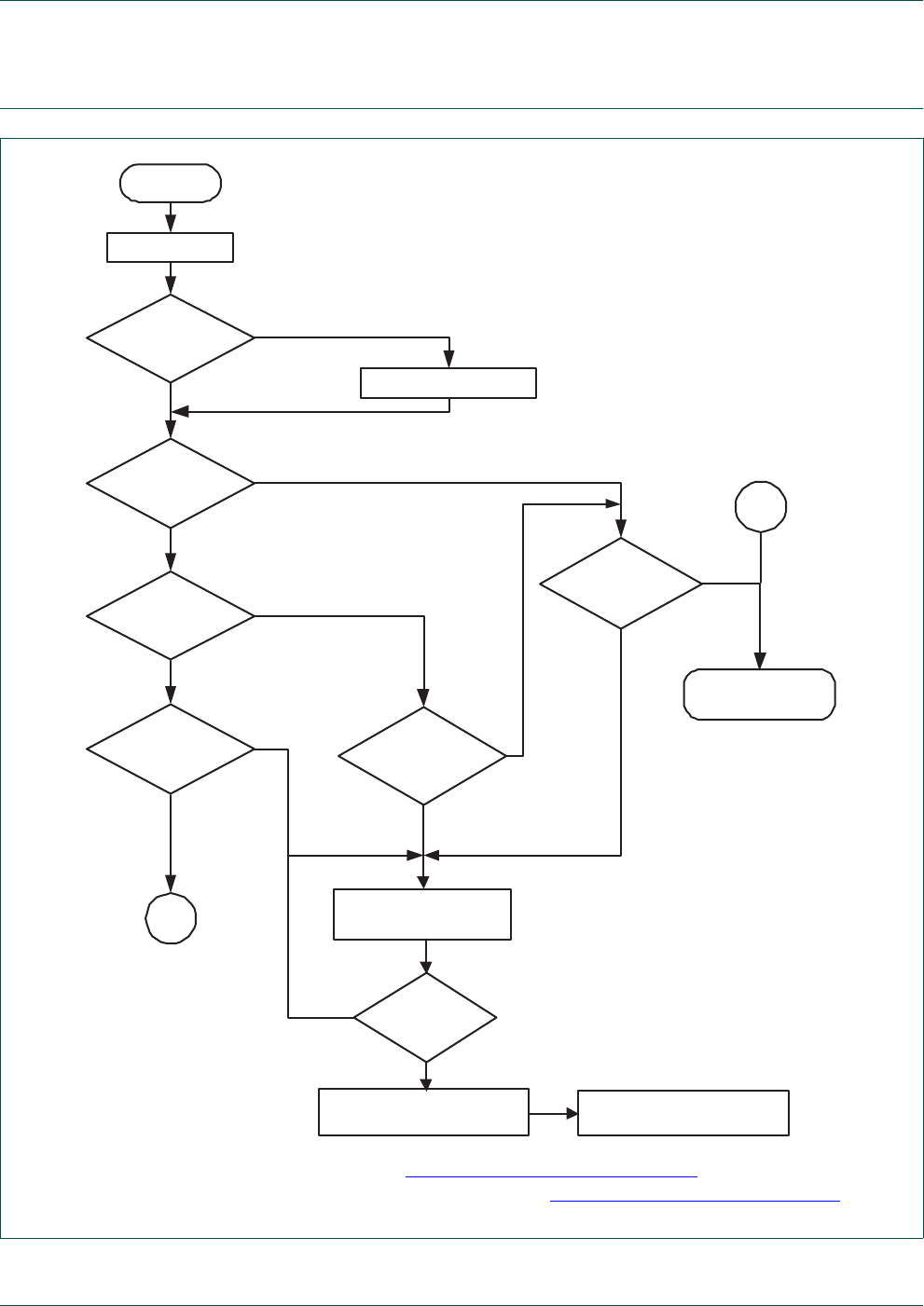
UM10360 All information provided in this document is subject to legal disclaimers. © NXP B.V. 2014. All rights reserved.
User manual Rev. 3.1 — 2 April 2014 628 of 849
NXP Semiconductors UM10360
Chapter 32: LPC176x/5x Flash memory interface and programming
32.4 Boot process flowchart
(1) For details on handling the crystal frequency, see Section 32.8.9 “Re-invoke ISP” on page 645
(2) For details on available ISP commands based on the CRP settings see Section 32.6 “Code Read Protection (CRP)”
Fig 138. Boot process flowchart
WATCHDOG
FLAG SET?
CRP1/2/3 ENABLED?
yes
no
INITIALIZE
RESET
ENABLE DEBUG
yes
RUN ISP COMMAND
HANDLER
2
RECEIVE CRYSTAL
FREQUENCY
1
no AUTO-BAUD
SUCCESSFUL?
yes
RUN AUTO-BAUD
USER CODE
VALID?
yes
no
CRP3 ENABLED?
Enter ISP
MODE?
(P2.10=LOW)
USER CODE VALID?
yes
yes
no
yes
no no
A
A
EXECUTE INTERNAL
USER CODE

UM10360 All information provided in this document is subject to legal disclaimers. © NXP B.V. 2014. All rights reserved.
User manual Rev. 3.1 — 2 April 2014 629 of 849
NXP Semiconductors UM10360
Chapter 32: LPC176x/5x Flash memory interface and programming
32.5 Sector numbers
Some IAP and ISP commands operate on "sectors" and specify sector numbers. The
following table indicate the correspondence between sector numbers and memory
addresses for LPC176x/5x devices containing 32, 64, 128, 256 and 512 kB of flash
respectively. IAP and ISP routines are located in the Boot ROM.
Table 568. Sectors in a LPC176x/5x device
Sector
Number
Sector
Size [kB]
Start Address End Address 32 kB
Part
64 kB
Part
128 kB
Part
256 kB
Part
512 kB
Part
0 4 0X0000 0000 0X0000 0FFF x x x x x
1 4 0X0000 1000 0X0000 1FFF x x x x x
2 4 0X0000 2000 0X0000 2FFF x x x x x
3 4 0X0000 3000 0X0000 3FFF x x x x x
4 4 0X0000 4000 0X0000 4FFF x x x x x
5 4 0X0000 5000 0X0000 5FFF x x x x x
6 4 0X0000 6000 0X0000 6FFF x x x x x
7 4 0X0000 7000 0X0000 7FFF x x x x x
8 4 0x0000 8000 0X0000 8FFF xxxx
9 4 0x0000 9000 0X0000 9FFF xxxx
10 (0x0A) 4 0x0000 A000 0X0000 AFFF xxxx
11 (0x0B) 4 0x0000 B000 0X0000 BFFF xxxx
12 (0x0C) 4 0x0000 C000 0X0000 CFFF xxxx
13 (0x0D) 4 0x0000 D000 0X0000 DFFF xxxx
14 (0X0E) 4 0x0000 E000 0X0000 EFFF xxxx
15 (0x0F) 4 0x0000 F000 0X0000 FFFF xxxx
16 (0x10) 32 0x0001 0000 0x0001 7FFF xxx
17 (0x11) 32 0x0001 8000 0x0001 FFFF xxx
18 (0x12) 32 0x0002 0000 0x0002 7FFF xx
19 (0x13) 32 0x0002 8000 0x0002 FFFF xx
20 (0x14) 32 0x0003 0000 0x0003 7FFF xx
21 (0x15) 32 0x0003 8000 0x0003 FFFF xx
22 (0x16) 32 0x0004 0000 0x0004 7FFF x
23 (0x17) 32 0x0004 8000 0x0004 FFFF x
24 (0x18) 32 0x0005 0000 0x0005 7FFF x
25 (0x19) 32 0x0005 8000 0x0005 FFFF x
26 (0x1A) 32 0x0006 0000 0x0006 7FFF x
27 (0x1B) 32 0x0006 8000 0x0006 FFFF x
28 (0x1C) 32 0x0007 0000 0x0007 7FFF x
29 (0x1D) 32 0x0007 8000 0x0007 FFFF x

UM10360 All information provided in this document is subject to legal disclaimers. © NXP B.V. 2014. All rights reserved.
User manual Rev. 3.1 — 2 April 2014 630 of 849
NXP Semiconductors UM10360
Chapter 32: LPC176x/5x Flash memory interface and programming
32.6 Code Read Protection (CRP)
Code Read Protection is a mechanism that allows user to enable different levels of
security in the system so that access to the on-chip flash and use of the ISP can be
restricted. When needed, CRP is invoked by programming a specific pattern in flash
location at 0x000002FC. IAP commands are not affected by the code read protection.
Important: Any CRP change becomes effective only after the device has gone
through a power cycle.
[1] CRP is supported by all LPC176x/5x parts with the exception of part LPC1751 with
partID 0x2500 1110. Part LPC1751 with partID 0x2500 1118 supports all three CRP
levels (see Errata note).
Table 569. Code Read Protection options[1]
Name Pattern
programmed in
0x000002FC
Description
CRP1 0x12345678 Access to chip via the JTAG pins is disabled. This mode allows partial
flash update using the following ISP commands and restrictions:
•Write to RAM command can not access RAM below 0x10000200.
This is due to use of the RAM by the ISP code, see
Section 32.3.2.7.
•Read Memory command: disabled.
•Copy RAM to Flash command: cannot write to Sector 0.
•Go command: disabled.
•Erase sector(s) command: can erase any individual sector except
sector 0 only, or can erase all sectors at once.
•Compare command: disabled
This mode is useful when CRP is required and flash field updates are
needed but all sectors can not be erased. The compare command is
disabled, so in the case of partial flash updates the secondary loader
should implement a checksum mechanism to verify the integrity of the
flash.
CRP2 0x87654321 This is similar to CRP1 with the following additions:
•Write to RAM command: disabled.
•Copy RAM to Flash: disabled.
•Erase command: only allows erase of all sectors.
CRP3 0x43218765 This is similar to CRP2, but ISP entry by pulling P2.10 LOW is
disabled if a valid user code is present in flash sector 0.
This mode effectively disables ISP override using the P2.10 pin. It is
up to the user’s application to provide for flash updates by using IAP
calls or by invoking ISP with UART0.
Caution: If CRP3 is selected, no future factory testing can be
performed on the device.

UM10360 All information provided in this document is subject to legal disclaimers. © NXP B.V. 2014. All rights reserved.
User manual Rev. 3.1 — 2 April 2014 631 of 849
NXP Semiconductors UM10360
Chapter 32: LPC176x/5x Flash memory interface and programming
If any CRP mode is enabled and access to the chip is allowed via the ISP, an unsupported
or restricted ISP command will be terminated with return code
CODE_READ_PROTECTION_ENABLED.
Table 570. Code Read Protection hardware/software interaction
CRP option User Code
Valid
P2.10 pin at
reset
JTAG enabled LPC176x/5x
enters ISP
mode
partial flash
update in ISP
mode
None No XYes Yes Yes
Yes High Yes No NA
Yes Low Yes Yes Yes
CRP1 No xNo Yes Yes
YesHighNoNoNA
Yes Low No Yes Yes
CRP2 No xNo Yes No
YesHighNoNoNA
Yes Low No Yes No
CRP3 No xNo Yes No
Yes xNo No NA

UM10360 All information provided in this document is subject to legal disclaimers. © NXP B.V. 2014. All rights reserved.
User manual Rev. 3.1 — 2 April 2014 632 of 849
NXP Semiconductors UM10360
Chapter 32: LPC176x/5x Flash memory interface and programming
32.7 ISP commands
The following commands are accepted by the ISP command handler. Detailed status
codes are supported for each command. The command handler sends the return code
INVALID_COMMAND when an undefined command is received. Commands and return
codes are in ASCII format.
CMD_SUCCESS is sent by ISP command handler only when received ISP command has
been completely executed and the new ISP command can be given by the host.
Exceptions from this rule are "Set Baud Rate", "Write to RAM", "Read Memory", and "Go"
commands.
32.7.1 Unlock <Unlock code>
Table 571. ISP command summary
ISP Command Usage Described in
Unlock U <Unlock Code> Tab l e 5 7 2
Set Baud Rate B <Baud Rate> <stop bit> Ta ble 57 3
Echo A <setting> Tab l e 5 7 5
Write to RAM W <start address> <number of bytes> Ta ble 57 6
Read Memory R <address> <number of bytes> Tab l e 577
Prepare sector(s) for
write operation
P <start sector number> <end sector number> Tabl e 5 7 8
Copy RAM to Flash C <flash address> <RAM address> <number of bytes> Ta b l e 579
Go G <address> <Mode> Ta bl e 5 8 0
Erase sector(s) E <start sector number> <end sector number> Ta b l e 5 81
Blank check sector(s) I <start sector number> <end sector number> Tab l e 582
Read Part ID JTab l e 5 83
Read Boot Code version K Table 58 5
Read serial number N Tab l e 5 8 6
Compare M <address1> <address2> <number of bytes> Ta b l e 5 87
Table 572. ISP Unlock command
Command U
Input Unlock code: 2313010
Return Code CMD_SUCCESS |
INVALID_CODE |
PARAM_ERROR
Description This command is used to unlock Flash Write, Erase, and Go commands.
Example "U 23130<CR><LF>" unlocks the Flash Write/Erase & Go commands.

UM10360 All information provided in this document is subject to legal disclaimers. © NXP B.V. 2014. All rights reserved.
User manual Rev. 3.1 — 2 April 2014 633 of 849
NXP Semiconductors UM10360
Chapter 32: LPC176x/5x Flash memory interface and programming
32.7.2 Set Baud Rate <Baud Rate> <stop bit>
[1] ISP entry after reset uses the on chip IRC and PLL to run the device at CCLK = 14.748 MHz
32.7.3 Echo <setting>
32.7.4 Write to RAM <start address> <number of bytes>
The host should send the data only after receiving the CMD_SUCCESS return code. The
host should send the check-sum after transmitting 20 UU-encoded lines. The checksum is
generated by adding raw data (before UU-encoding) bytes and is reset after transmitting
20 UU-encoded lines. The length of any UU-encoded line should not exceed
61 characters (bytes) i.e. it can hold 45 data bytes. When the data fits in less than
20 UU-encoded lines then the check-sum should be of the actual number of bytes sent.
Table 573. ISP Set Baud Rate command
Command B
Input Baud Rate: 9600 | 19200 | 38400 | 57600 | 115200 | 230400
Stop bit: 1 | 2
Return Code CMD_SUCCESS |
INVALID_BAUD_RATE |
INVALID_STOP_BIT |
PARAM_ERROR
Description This command is used to change the baud rate. The new baud rate is effective
after the command handler sends the CMD_SUCCESS return code.
Example "B 57600 1<CR><LF>" sets the serial port to baud rate 57600 bps and 1 stop bit.
Table 574. Correlation between possible ISP baudrates and CCLK frequency (in MHz)
ISP Baudrate .vs.
CCLK Frequency
9600 19200 38400 57600 115200 230400
10.0000 +++
11.0592 ++ +
12.2880 +++
14.7456[1] ++++++
15.3600 +
18.4320 ++ +
19.6608 +++
24.5760 +++
25.0000 +++
Table 575. ISP Echo command
Command A
Input Setting: ON = 1 | OFF = 0
Return Code CMD_SUCCESS |
PARAM_ERROR
Description The default setting for echo command is ON. When ON the ISP command handler
sends the received serial data back to the host.
Example "A 0<CR><LF>" turns echo off.

UM10360 All information provided in this document is subject to legal disclaimers. © NXP B.V. 2014. All rights reserved.
User manual Rev. 3.1 — 2 April 2014 634 of 849
NXP Semiconductors UM10360
Chapter 32: LPC176x/5x Flash memory interface and programming
The ISP command handler compares it with the check-sum of the received bytes. If the
check-sum matches, the ISP command handler responds with "OK<CR><LF>" to
continue further transmission. If the check-sum does not match, the ISP command
handler responds with "RESEND<CR><LF>". In response the host should retransmit the
bytes.
32.7.5 Read Memory <address> <no. of bytes>
The data stream is followed by the command success return code. The check-sum is sent
after transmitting 20 UU-encoded lines. The checksum is generated by adding raw data
(before UU-encoding) bytes and is reset after transmitting 20 UU-encoded lines. The
length of any UU-encoded line should not exceed 61 characters (bytes) i.e. it can hold
45 data bytes. When the data fits in less than 20 UU-encoded lines then the check-sum is
of actual number of bytes sent. The host should compare it with the checksum of the
received bytes. If the check-sum matches then the host should respond with
"OK<CR><LF>" to continue further transmission. If the check-sum does not match then
the host should respond with "RESEND<CR><LF>". In response the ISP command
handler sends the data again.
Table 576. ISP Write to RAM command
Command W
Input Start Address: RAM address where data bytes are to be written. This address
should be a word boundary.
Number of Bytes: Number of bytes to be written. Count should be a multiple of 4
Return Code CMD_SUCCESS |
ADDR_ERROR (Address not on word boundary) |
ADDR_NOT_MAPPED |
COUNT_ERROR (Byte count is not multiple of 4) |
PARAM_ERROR |
CODE_READ_PROTECTION_ENABLED
Description This command is used to download data to RAM. Data should be in UU-encoded
format. This command is blocked when code read protection levels CRP2 or
CRP3 are enabled.
Example "W 268435968 4<CR><LF>" writes 4 bytes of data to address 0x1000 0200.
Table 577. ISP Read Memory command
Command R
Input Start Address: Address from where data bytes are to be read. This address
should be a word boundary.
Number of Bytes: Number of bytes to be read. Count should be a multiple of 4.
Return Code CMD_SUCCESS followed by <actual data (UU-encoded)> |
ADDR_ERROR (Address not on word boundary) |
ADDR_NOT_MAPPED |
COUNT_ERROR (Byte count is not a multiple of 4) |
PARAM_ERROR |
CODE_READ_PROTECTION_ENABLED
Description This command is used to read data from RAM or flash memory. This command is
blocked when any level of code read protection is enabled.
Example "R 268435968 4<CR><LF>" reads 4 bytes of data from address 0x1000 0200.

UM10360 All information provided in this document is subject to legal disclaimers. © NXP B.V. 2014. All rights reserved.
User manual Rev. 3.1 — 2 April 2014 635 of 849
NXP Semiconductors UM10360
Chapter 32: LPC176x/5x Flash memory interface and programming
32.7.6 Prepare sector(s) for write operation <start sector number> <end
sector number>
This command makes flash write/erase operation a two step process.
32.7.7 Copy RAM to Flash <flash address> <RAM address> <no of bytes>
Table 578. ISP Prepare sector(s) for write operation command
Command P
Input Start Sector Number
End Sector Number: Should be greater than or equal to start sector number.
Return Code CMD_SUCCESS |
BUSY |
INVALID_SECTOR |
PARAM_ERROR
Description This command must be executed before executing "Copy RAM to Flash" or
"Erase Sector(s)" command. Successful execution of the "Copy RAM to Flash" or
"Erase Sector(s)" command causes relevant sectors to be protected again. To
prepare a single sector use the same "Start" and "End" sector numbers.
Example "P 0 0<CR><LF>" prepares the flash sector 0.
Table 579. ISP Copy command
Command C
Input Flash Address(DST): Destination flash address where data bytes are to be
written. The destination address should be a 256 byte boundary.
RAM Address(SRC): Source RAM address from where data bytes are to be read.
Number of Bytes: Number of bytes to be written. Should be 256 | 512 | 1024 |
4096.
Return Code CMD_SUCCESS |
SRC_ADDR_ERROR (Address not on word boundary) |
DST_ADDR_ERROR (Address not on correct boundary) |
SRC_ADDR_NOT_MAPPED |
DST_ADDR_NOT_MAPPED |
COUNT_ERROR (Byte count is not 256 | 512 | 1024 | 4096) |
SECTOR_NOT_PREPARED_FOR WRITE_OPERATION |
BUSY |
CMD_LOCKED |
PARAM_ERROR |
CODE_READ_PROTECTION_ENABLED
Description This command is used to program the flash memory. The "Prepare Sector(s) for
Write Operation" command should precede this command. The affected sectors are
automatically protected again once the copy command is successfully executed.
This command is blocked when code read protection levels CRP2 or CRP3 are
enabled. When code read protection level CRP1 is enabled, individual sectors
other than sector 0 can be written.
Example "C 0 268468224 512<CR><LF>" copies 512 bytes from the RAM address
0x1000 8000 to the flash address 0.

UM10360 All information provided in this document is subject to legal disclaimers. © NXP B.V. 2014. All rights reserved.
User manual Rev. 3.1 — 2 April 2014 636 of 849
NXP Semiconductors UM10360
Chapter 32: LPC176x/5x Flash memory interface and programming
32.7.8 Go <address> <mode>
When the GO command is used, execution begins at the specified address (assuming it is
an executable address) with the device left as it was configured for the ISP code. This
means that some things are different than they would be for entering user code directly
following a chip reset. Most importantly, the main PLL will be running and connected,
configured to generate a CPU clock with a frequency of approximately 14.7456 MHz.
32.7.9 Erase sector(s) <start sector number> <end sector number>
Table 580. ISP Go command
Command G
Input Address: Flash or RAM address from which the code execution is to be started.
This address should be on a word boundary.
Mode (retained for backward compatibility): T (Execute program in Thumb
Mode) | A (not allowed).
Return Code CMD_SUCCESS |
ADDR_ERROR |
ADDR_NOT_MAPPED |
CMD_LOCKED |
PARAM_ERROR |
CODE_READ_PROTECTION_ENABLED
Description This command is used to execute a program residing in RAM or flash memory. It
may not be possible to return to the ISP command handler once this command is
successfully executed. This command is blocked when any level of code read
protection is enabled.
Example "G 0 T<CR><LF>" branches to address 0x0000 0000.
Table 581. ISP Erase sector command
Command E
Input Start Sector Number
End Sector Number: Should be greater than or equal to start sector number.
Return Code CMD_SUCCESS |
BUSY |
INVALID_SECTOR |
SECTOR_NOT_PREPARED_FOR_WRITE_OPERATION |
CMD_LOCKED |
PARAM_ERROR |
CODE_READ_PROTECTION_ENABLED
Description This command is used to erase one or more sector(s) of on-chip flash memory. This
command is blocked when code read protection level CRP3 is enabled. When code
read protection level CRP1 is enabled, individual sectors other than sector 0 can be
erased. All sectors can be erased at once in CRP1 and CRP2.
Example "E 2 3<CR><LF>" erases the flash sectors 2 and 3.

UM10360 All information provided in this document is subject to legal disclaimers. © NXP B.V. 2014. All rights reserved.
User manual Rev. 3.1 — 2 April 2014 637 of 849
NXP Semiconductors UM10360
Chapter 32: LPC176x/5x Flash memory interface and programming
32.7.10 Blank check sector(s) <sector number> <end sector number>
32.7.11 Read Part Identification number
[1] This part does not support CRP (see Errata note).
Table 582. ISP Blank check sector command
Command I
Input Start Sector Number:
End Sector Number: Should be greater than or equal to start sector number.
Return Code CMD_SUCCESS |
SECTOR_NOT_BLANK (followed by <Offset of the first non blank word location>
<Contents of non blank word location>) |
INVALID_SECTOR |
PARAM_ERROR |
Description This command is used to blank check one or more sectors of on-chip flash memory.
Example "I 2 3<CR><LF>" blank checks the flash sectors 2 and 3.
Table 583. ISP Read Part Identification command
Command J
Input None.
Return Code CMD_SUCCESS followed by part identification number in ASCII (see Tab l e 58 4
“LPC176x/5x part identification numbers”).
Description This command is used to read the part identification number. The part identification
number maps to a feature subset within a device family. This number will not
normally change as a result of technical revisions.
Table 584. LPC176x/5x part identification numbers
Device ASCII/dec coding Hex coding
LPC1769 638664503 0x2611 3F37
LPC1768 637615927 0x2601 3F37
LPC1767 637610039 0x2601 2837
LPC1766 637615923 0x2601 3F33
LPC1765 637613875 0x2601 3733
LPC1764 637606178 0x2601 1922
LPC1763 637607987 0x2601 2033
LPC1759 621885239 0x2511 3737
LPC1758 620838711 0x2501 3F37
LPC1756 620828451 0x2501 1723
LPC1754 620828450 0x2501 1722
LPC1752 620761377 0x2500 1121
LPC1751 620761368 0x2500 1118
LPC1751[1] 620761360 0x2500 1110

UM10360 All information provided in this document is subject to legal disclaimers. © NXP B.V. 2014. All rights reserved.
User manual Rev. 3.1 — 2 April 2014 638 of 849
NXP Semiconductors UM10360
Chapter 32: LPC176x/5x Flash memory interface and programming
32.7.12 Read Boot Code version number
32.7.13 Read device serial number
32.7.14 Compare <address1> <address2> <no of bytes>
Table 585. ISP Read Boot Code version number command
Command K
Input None
Return Code CMD_SUCCESS followed by 2 bytes of boot code version number in ASCII format.
It is to be interpreted as <byte1(Major)>.<byte0(Minor)>.
Description This command is used to read the boot code version number.
Table 586. ISP Read device serial number command
Command N
Input None.
Return Code CMD_SUCCESS followed by the device serial number in 4 decimal ASCII groups,
each representing a 32-bit value.
Description This command is used to read the device serial number. The serial number may be
used to uniquely identify a single unit among all LPC176x/5x devices.
Table 587. ISP Compare command
Command M
Input Address1 (DST): Starting flash or RAM address of data bytes to be compared.
This address should be a word boundary.
Address2 (SRC): Starting flash or RAM address of data bytes to be compared.
This address should be a word boundary.
Number of Bytes: Number of bytes to be compared; should be a multiple of 4.
Return Code CMD_SUCCESS | (Source and destination data are equal)
COMPARE_ERROR | (Followed by the offset of first mismatch)
COUNT_ERROR (Byte count is not a multiple of 4) |
ADDR_ERROR |
ADDR_NOT_MAPPED |
PARAM_ERROR |
Description This command is used to compare the memory contents at two locations. This
command is blocked when any level of code read protection is enabled.
Example "M 8192 268435968 4<CR><LF>" compares 4 bytes from the RAM address
0x1000 0200 to the 4 bytes from the flash address 0x2000.

UM10360 All information provided in this document is subject to legal disclaimers. © NXP B.V. 2014. All rights reserved.
User manual Rev. 3.1 — 2 April 2014 639 of 849
NXP Semiconductors UM10360
Chapter 32: LPC176x/5x Flash memory interface and programming
32.7.15 ISP Return Codes
Table 588. ISP Return Codes Summary
Return
Code
Mnemonic Description
0CMD_SUCCESS Command is executed successfully. Sent by ISP
handler only when command given by the host has
been completely and successfully executed.
1INVALID_COMMAND Invalid command.
2SRC_ADDR_ERROR Source address is not on word boundary.
3DST_ADDR_ERROR Destination address is not on a correct boundary.
4SRC_ADDR_NOT_MAPPED Source address is not mapped in the memory map.
Count value is taken into consideration where
applicable.
5DST_ADDR_NOT_MAPPED Destination address is not mapped in the memory
map. Count value is taken into consideration where
applicable.
6COUNT_ERROR Byte count is not multiple of 4 or is not a permitted
value.
7INVALID_SECTOR Sector number is invalid or end sector number is
greater than start sector number.
8SECTOR_NOT_BLANK Sector is not blank.
9SECTOR_NOT_PREPARED_FOR_
WRITE_OPERATION
Command to prepare sector for write operation
was not executed.
10 COMPARE_ERROR Source and destination data not equal.
11 BUSY Flash programming hardware interface is busy.
12 PARAM_ERROR Insufficient number of parameters or invalid
parameter.
13 ADDR_ERROR Address is not on word boundary.
14 ADDR_NOT_MAPPED Address is not mapped in the memory map. Count
value is taken in to consideration where applicable.
15 CMD_LOCKED Command is locked.
16 INVALID_CODE Unlock code is invalid.
17 INVALID_BAUD_RATE Invalid baud rate setting.
18 INVALID_STOP_BIT Invalid stop bit setting.
19 CODE_READ_PROTECTION_
ENABLED
Code read protection enabled.

UM10360 All information provided in this document is subject to legal disclaimers. © NXP B.V. 2014. All rights reserved.
User manual Rev. 3.1 — 2 April 2014 640 of 849
NXP Semiconductors UM10360
Chapter 32: LPC176x/5x Flash memory interface and programming
32.8 IAP commands
For in-application programming the IAP routine should be called with a word pointer in
register r0 pointing to memory (RAM) containing command code and parameters. The
result from the IAP command is returned in the table pointed to by register r1. The user
can reuse the command table for the result by passing the same pointer in registers r0
and r1. The parameter table should be large enough to hold all of the results in case the
number of results are greater than the number of parameters. Parameter passing is
illustrated in the Figure 139. The number of parameters and results vary according to the
IAP command. The maximum number of parameters is 5, passed to the "Copy RAM to
Flash" command. The maximum number of results is 4, returned by the "Read device
serial number" command. The command handler sends the status code
INVALID_COMMAND when an undefined command is received. The IAP routine resides
at location 0x1FFF 1FF0.
The IAP function could be called in the following way using C.
Define the IAP location entry point. Bit 0 of the IAP location is set since the Cortex-M3
uses only Thumb mode.
#define IAP_LOCATION 0x1FFF1FF1
Define data structure or pointers to pass IAP command table and result table to the IAP
function:
unsigned long command[5];
unsigned long output[5];
or
unsigned long * command;
unsigned long * output;
command=(unsigned long *) 0x...
output= (unsigned long *) 0x...
Define a pointer to function type, which takes two parameters and returns void. Note the
IAP returns the result with the base address of the table residing in R1.
typedef void (*IAP)(unsigned int [],unsigned int[]);
IAP iap_entry;
Setting function pointer:
iap_entry=(IAP) IAP_LOCATION;
Whenever you wish to call IAP you could use the following statement.
iap_entry (command, output);
The IAP call could be simplified further by using the symbol definition file feature
supported by ARM Linker in ADS (ARM Developer Suite). You could also call the IAP
routine using assembly code.

UM10360 All information provided in this document is subject to legal disclaimers. © NXP B.V. 2014. All rights reserved.
User manual Rev. 3.1 — 2 April 2014 641 of 849
NXP Semiconductors UM10360
Chapter 32: LPC176x/5x Flash memory interface and programming
Note that the first entry in the command table is the IAP command, followed by any
required command parameters, starting with Param0. The first entry in the output table is
the Return Code, followed by any other results, starting with Result0.
As per the ARM specification (The ARM Thumb Procedure Call Standard SWS ESPC
0002 A-05) up to 4 parameters can be passed in the r0, r1, r2 and r3 registers
respectively. Additional parameters are passed on the stack. Up to 4 parameters can be
returned in the r0, r1, r2 and r3 registers respectively. Additional parameters are returned
indirectly via memory. Some of the IAP calls require more than 4 parameters. If the ARM
suggested scheme is used for the parameter passing/returning then it might create
problems due to difference in the C compiler implementation from different vendors. The
suggested parameter passing scheme reduces such risk.
The flash memory is not accessible during a write or erase operation. IAP commands,
which results in a flash write/erase operation, use 32 bytes of space in the top portion of
the on-chip RAM for execution. The user program should not be use this space if IAP flash
programming is permitted in the application.
Table 589. IAP Command Summary
IAP Command Command Code Described in
Prepare sector(s) for write operation 5010 Ta b l e 59 0
Copy RAM to Flash 5110 Tab l e 5 9 1
Erase sector(s) 5210 Ta b le 59 2
Blank check sector(s) 5310 Table 5 9 3
Read part ID 5410 Tab l e 5 94
Read Boot Code version 5510 Ta b l e 595
Read device serial number 5810 Tab le 59 6
Compare 5610 Tab l e 5 97
Reinvoke ISP 5710 Tabl e 5 9 8
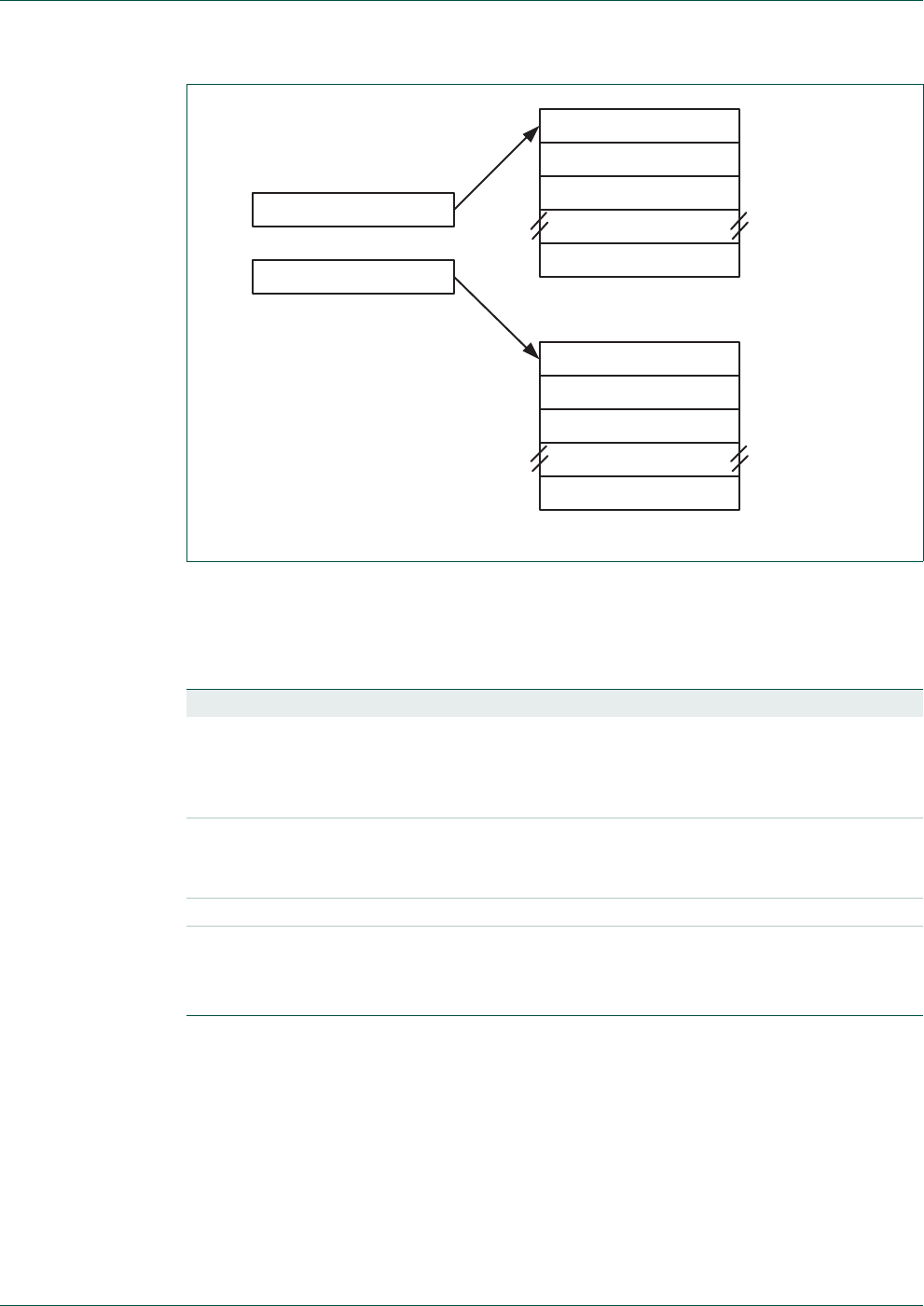
UM10360 All information provided in this document is subject to legal disclaimers. © NXP B.V. 2014. All rights reserved.
User manual Rev. 3.1 — 2 April 2014 642 of 849
NXP Semiconductors UM10360
Chapter 32: LPC176x/5x Flash memory interface and programming
32.8.1 Prepare sector(s) for write operation
This command makes flash write/erase operation a two step process.
Fig 139. IAP parameter passing
COMMAND CODE
PARAMETER 1
PARAMETER 2
PARAMETER n
STATUS CODE
RESULT 1
RESULT 2
RESULT n
command
parameter table
command
result table
ARM REGISTER r0
ARM REGISTER r1
Table 590. IAP Prepare sector(s) for write operation command
Command Prepare sector(s) for write operation
Input Command code: 50(decimal)
Param0: Start Sector Number
Param1: End Sector Number (should be greater than or equal to start sector
number).
Return Code CMD_SUCCESS |
BUSY |
INVALID_SECTOR
Result None
Description This command must be executed before executing "Copy RAM to Flash" or
"Erase Sector(s)" command. Successful execution of the "Copy RAM to Flash" or
"Erase Sector(s)" command causes relevant sectors to be protected again. To
prepare a single sector use the same "Start" and "End" sector numbers.

UM10360 All information provided in this document is subject to legal disclaimers. © NXP B.V. 2014. All rights reserved.
User manual Rev. 3.1 — 2 April 2014 643 of 849
NXP Semiconductors UM10360
Chapter 32: LPC176x/5x Flash memory interface and programming
32.8.2 Copy RAM to Flash
32.8.3 Erase Sector(s)
Table 591. IAP Copy RAM to Flash command
Command Copy RAM to Flash
Input Command code: 51(decimal)
Param0(DST): Destination flash address where data bytes are to be written. This
address should be a 256 byte boundary.
Param1(SRC): Source RAM address from which data bytes are to be read. This
address should be a word boundary.
Param2: Number of bytes to be written. Should be 256 | 512 | 1024 | 4096.
Param3: CPU Clock Frequency (CCLK) in kHz.
Return Code CMD_SUCCESS |
SRC_ADDR_ERROR (Address not a word boundary) |
DST_ADDR_ERROR (Address not on correct boundary) |
SRC_ADDR_NOT_MAPPED |
DST_ADDR_NOT_MAPPED |
COUNT_ERROR (Byte count is not 256 | 512 | 1024 | 4096) |
SECTOR_NOT_PREPARED_FOR_WRITE_OPERATION |
BUSY |
Result None
Description This command is used to program the flash memory. The affected sectors should
be prepared first by calling "Prepare Sector for Write Operation" command. The
affected sectors are automatically protected again once the copy command is
successfully executed.
Table 592. IAP Erase Sector(s) command
Command Erase Sector(s)
Input Command code: 52(decimal)
Param0: Start Sector Number
Param1: End Sector Number (should be greater than or equal to start sector
number).
Param2: CPU Clock Frequency (CCLK) in kHz.
Return Code CMD_SUCCESS |
BUSY |
SECTOR_NOT_PREPARED_FOR_WRITE_OPERATION |
INVALID_SECTOR
Result None
Description This command is used to erase a sector or multiple sectors of on-chip flash
memory. To erase a single sector use the same "Start" and "End" sector numbers.

UM10360 All information provided in this document is subject to legal disclaimers. © NXP B.V. 2014. All rights reserved.
User manual Rev. 3.1 — 2 April 2014 644 of 849
NXP Semiconductors UM10360
Chapter 32: LPC176x/5x Flash memory interface and programming
32.8.4 Blank check sector(s)
32.8.5 Read part identification number
32.8.6 Read Boot Code version number
Table 593. IAP Blank check sector(s) command
Command Blank check sector(s)
Input Command code: 53(decimal)
Param0: Start Sector Number
Param1: End Sector Number (should be greater than or equal to start sector
number).
Return Code CMD_SUCCESS |
BUSY |
SECTOR_NOT_BLANK |
INVALID_SECTOR
Result Result0: Offset of the first non blank word location if the Status Code is
SECTOR_NOT_BLANK.
Result1: Contents of non blank word location.
Description This command is used to blank check a sector or multiple sectors of on-chip flash
memory. To blank check a single sector use the same "Start" and "End" sector
numbers.
Table 594. IAP Read part identification number command
Command Read part identification number
Input Command code: 54(decimal)
Parameters: None
Return Code CMD_SUCCESS |
Result Result0: Part Identification Number.
Description This command is used to read the part identification number. The value returned
is the hexadecimal version of the part ID. See Ta ble 58 4 “LPC176x/5x part
identification numbers”.
Table 595. IAP Read Boot Code version number command
Command Read boot code version number
Input Command code: 55(decimal)
Parameters: None
Return Code CMD_SUCCESS |
Result Result0: 2 bytes of boot code version number. It is to be interpreted as
<byte1(Major)>.<byte0(Minor)>
Description This command is used to read the boot code version number.

UM10360 All information provided in this document is subject to legal disclaimers. © NXP B.V. 2014. All rights reserved.
User manual Rev. 3.1 — 2 April 2014 645 of 849
NXP Semiconductors UM10360
Chapter 32: LPC176x/5x Flash memory interface and programming
32.8.7 Read device serial number
32.8.8 Compare <address1> <address2> <no of bytes>
32.8.9 Re-invoke ISP
Table 596. IAP Read device serial number command
Command Read device serial number
Input Command code: 58(decimal)
Parameters: None
Return Code CMD_SUCCESS |
Result Result0: First 32-bit word of Device Identification Number (at the lowest address)
Result1: Second 32-bit word of Device Identification Number
Result2: Third 32-bit word of Device Identification Number
Result3: Fourth 32-bit word of Device Identification Number
Description This command is used to read the device identification number. The serial number
may be used to uniquely identify a single unit among all LPC176x/5x devices.
Table 597. IAP Compare command
Command Compare
Input Command code: 56(decimal)
Param0(DST): Starting flash or RAM address of data bytes to be compared. This
address should be a word boundary.
Param1(SRC): Starting flash or RAM address of data bytes to be compared. This
address should be a word boundary.
Param2: Number of bytes to be compared; should be a multiple of 4.
Return Code CMD_SUCCESS |
COMPARE_ERROR |
COUNT_ERROR (Byte count is not a multiple of 4) |
ADDR_ERROR |
ADDR_NOT_MAPPED
Result Result0: Offset of the first mismatch if the Status Code is COMPARE_ERROR.
Description This command is used to compare the memory contents at two locations.
The result may not be correct when the source or destination includes any
of the first 64 bytes starting from address zero. The first 64 bytes can be
re-mapped to RAM.
Table 598. Re-invoke ISP
Command Compare
Input Command code: 57(decimal)

UM10360 All information provided in this document is subject to legal disclaimers. © NXP B.V. 2014. All rights reserved.
User manual Rev. 3.1 — 2 April 2014 646 of 849
NXP Semiconductors UM10360
Chapter 32: LPC176x/5x Flash memory interface and programming
32.8.10 IAP Status Codes
32.9 JTAG flash programming interface
Debug tools can write parts of the flash image to the RAM and then execute the IAP call
"Copy RAM to Flash" repeatedly with proper offset.
Return Code None
Result None.
Description This command is used to invoke the boot loader in ISP mode. It maps boot
vectors, sets PCLK = CCLK / 4, configures UART0 pins Rx and Tx, resets
TIMER1 and resets the U0FDR (see Section 14.4.12). This command may be
used when a valid user program is present in the internal flash memory and the
P2.10 pin is not accessible to force the ISP mode. The command does not disable
the PLL hence it is possible to invoke the boot loader when the part is running off
the PLL. In such case the ISP utility should pass the CCLK (crystal or PLL output
depending on the clock source selection Section 4.4.1) frequency after auto-baud
handshake.
Another option is to disable the PLL and select the IRC as the clock source before
making this IAP call. In this case frequency sent by ISP is ignored and IRC and
PLL are used to generate CCLK = 14.748 MHz.
Table 598. Re-invoke ISP
Command Compare
Table 599. IAP Status Codes Summary
Status
Code
Mnemonic Description
0CMD_SUCCESS Command is executed successfully.
1INVALID_COMMAND Invalid command.
2SRC_ADDR_ERROR Source address is not on a word boundary.
3DST_ADDR_ERROR Destination address is not on a correct boundary.
4SRC_ADDR_NOT_MAPPEDSource address is not mapped in the memory map.
Count value is taken in to consideration where
applicable.
5DST_ADDR_NOT_MAPPEDDestination address is not mapped in the memory
map. Count value is taken in to consideration where
applicable.
6COUNT_ERROR Byte count is not multiple of 4 or is not a permitted
value.
7INVALID_SECTOR Sector number is invalid.
8SECTOR_NOT_BLANK Sector is not blank.
9SECTOR_NOT_PREPARED_
FOR_WRITE_OPERATION
Command to prepare sector for write operation was
not executed.
10 COMPARE_ERROR Source and destination data is not same.
11 BUSY Flash programming hardware interface is busy.
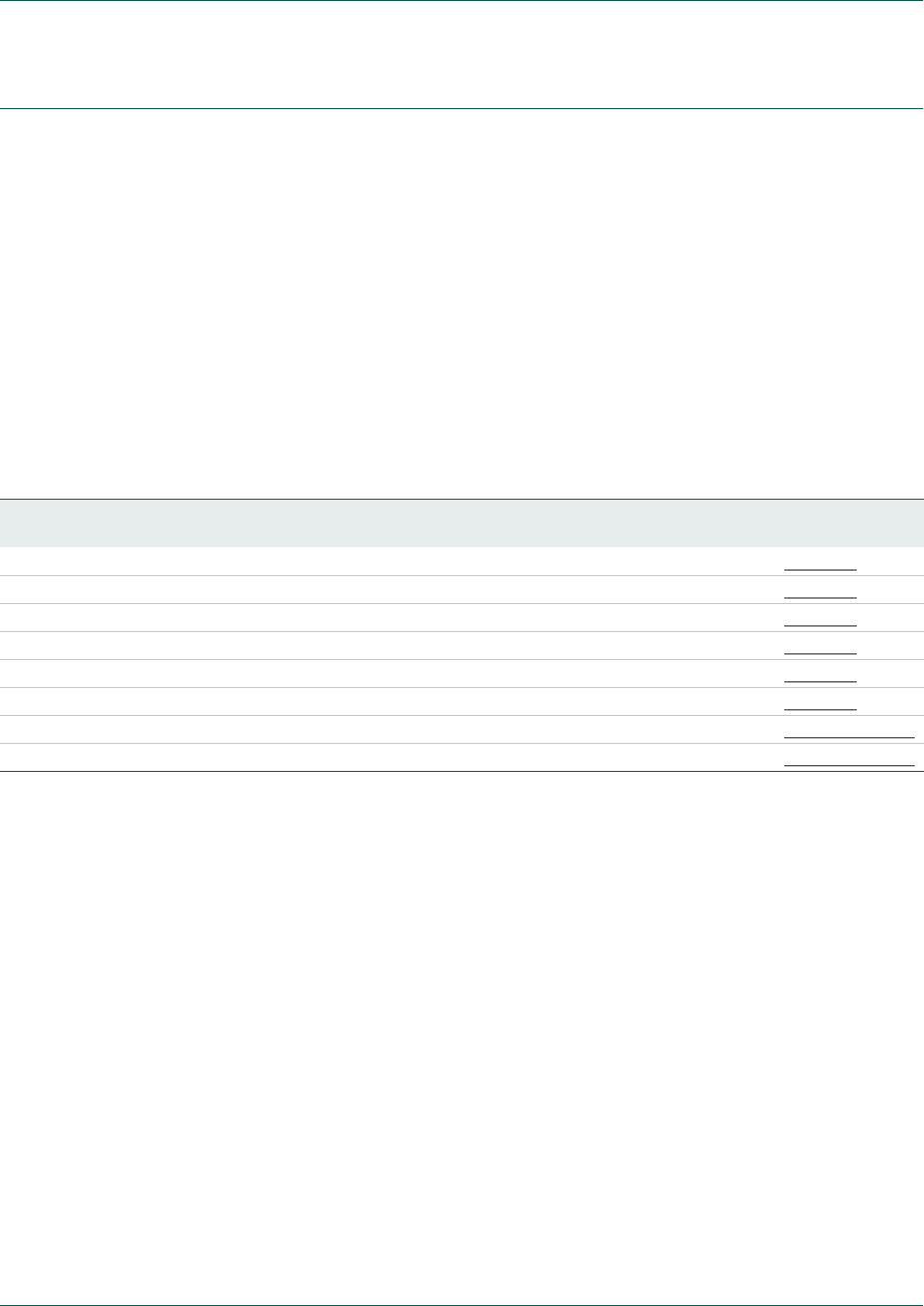
UM10360 All information provided in this document is subject to legal disclaimers. © NXP B.V. 2014. All rights reserved.
User manual Rev. 3.1 — 2 April 2014 647 of 849
NXP Semiconductors UM10360
Chapter 32: LPC176x/5x Flash memory interface and programming
32.10 Flash signature generation
The flash module contains a built-in signature generator. This generator can produce a
128-bit signature from a range of flash memory. A typical usage is to verify the flashed
contents against a calculated signature (e.g. during programming).
The address range for generating a signature must be aligned on flash-word boundaries,
i.e. 128-bit boundaries. Once started, signature generation completes independently.
While signature generation is in progress, the flash memory cannot be accessed for other
purposes, and an attempted read will cause a wait state to be asserted until signature
generation is complete. Code outside of the flash (e.g. internal RAM) can be executed
during signature generation. This can include interrupt services, if the interrupt vector
table is re-mapped to memory other than the flash memory. The code that initiates
signature generation should also be placed outside of the flash memory.
32.10.1 Register description for signature generation
Table 600. Register overview: FMC (base address 0x4008 4000)
Name Description Access Reset
Value
Address Reference
FMSSTART Signature start address register R/W 0 0x4008 4020 Ta b l e 6 0 1
FMSSTOP Signature stop-address register R/W 0 0x4008 4024 Tab l e 6 0 2
FMSW0 128-bit signature Word 0 R-0x4008 402C Ta b l e 6 0 3
FMSW1 128-bit signature Word 1 R-0x4008 4030 Ta b l e 6 0 4
FMSW2 128-bit signature Word 2 R-0x4008 4034 Ta b l e 6 0 5
FMSW3 128-bit signature Word 3 R-0x4008 4038 Ta b l e 6 0 6
FMSTAT Signature generation status register R 0 0x4008 4FE0 Section 32.10.1.3
FMSTATCLR Signature generation status clear register W - 0x4008 4FE8 Section 32.10.1.4
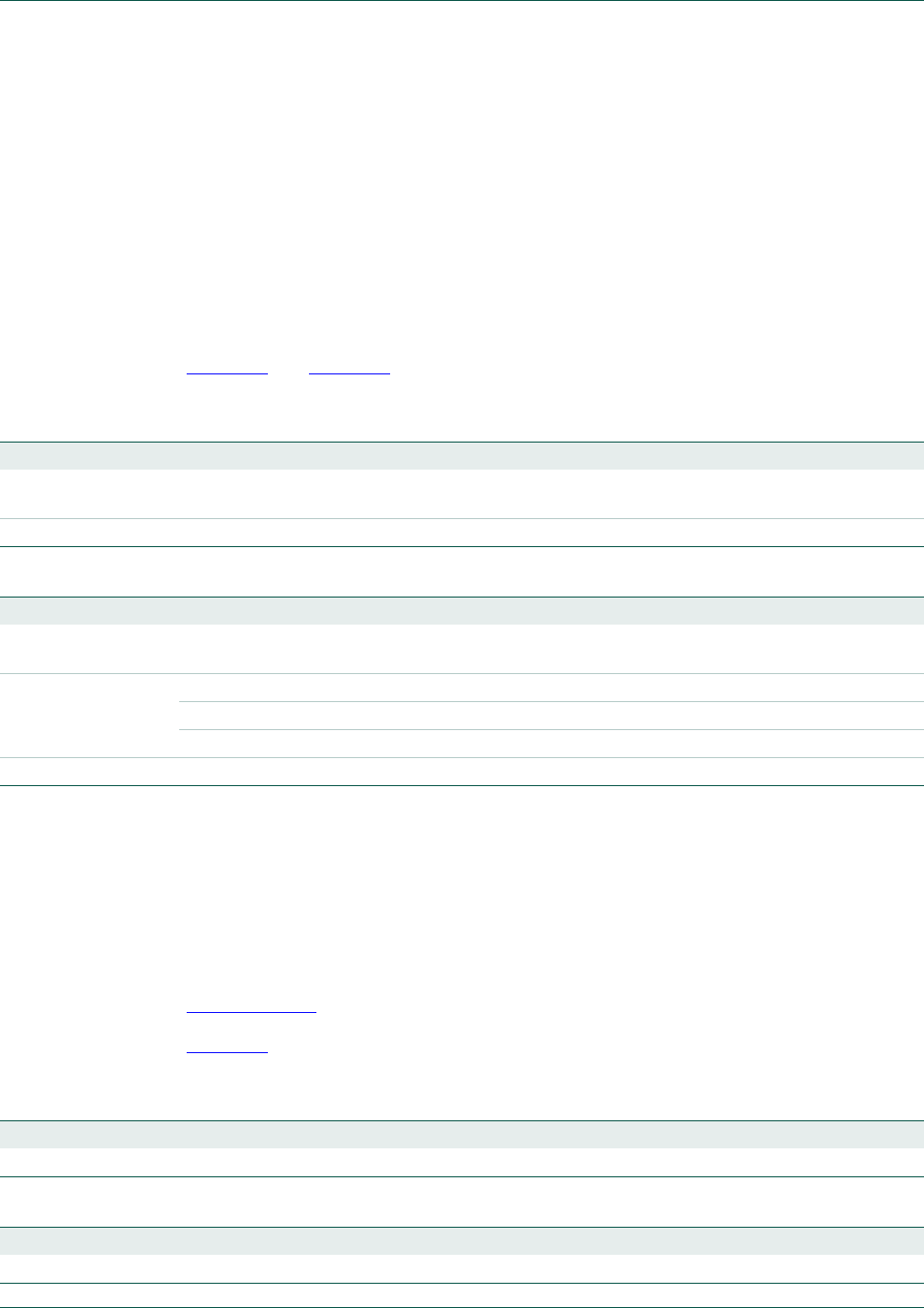
UM10360 All information provided in this document is subject to legal disclaimers. © NXP B.V. 2014. All rights reserved.
User manual Rev. 3.1 — 2 April 2014 648 of 849
NXP Semiconductors UM10360
Chapter 32: LPC176x/5x Flash memory interface and programming
32.10.1.1 Signature generation address and control registers
These registers control automatic signature generation. A signature can be generated for
any part of the flash memory contents. The address range to be used for generation is
defined by writing the start address to the signature start address register (FMSSTART)
and the stop address to the signature stop address register (FMSSTOP. The start and
stop addresses must be aligned to 128-bit boundaries and can be derived by dividing the
byte address by 16.
Signature generation is started by setting the SIG_START bit in the FMSSTOP register.
Setting the SIG_START bit is typically combined with the signature stop address in a
single write.
Tab l e 6 01 and Ta bl e 6 0 2 show the bit assignments in the FMSSTART and FMSSTOP
registers respectively.
32.10.1.2 Signature generation result registers
The signature generation result registers return the flash signature produced by the
embedded signature generator. The 128-bit signature is reflected by the four registers
FMSW0, FMSW1, FMSW2 and FMSW3.
The generated flash signature can be used to verify the flash memory contents. The
generated signature can be compared with an expected signature and thus makes saves
time and code space. The method for generating the signature is described in
Section 32.10.2.
Tab l e 6 06 show bit assignment of the FMSW0 and FMSW1, FMSW2, FMSW3 registers
respectively.
Table 601. Flash Module Signature Start register (FMSSTART - 0x4008 4020) bit description
Bit Symbol Description Reset Value
31:17 - Reserved, user software should not write ones to reserved bits. The value read from a
reserved bit is not defined.
NA
16:0 START Signature generation start address (corresponds to AHB byte address bits[20:4]). 0
Table 602. Flash Module Signature Stop register (FMSSTOP - 0x4008 4024) bit description
Bit Symbol Value Description Reset Value
31:18 - Reserved, user software should not write ones to reserved bits. The value
read from a reserved bit is not defined.
NA
17 SIG_START Start control bit for signature generation. 0
0Signature generation is stopped
1Initiate signature generation
16:0 STOP BIST stop address divided by 16 (corresponds to AHB byte address [20:4]). 0
Table 603. FMSW0 register bit description (FMSW0, address: 0x4008 402C)
Bit Symbol Description Reset Value
31:0 SW0[31:0] Word 0 of 128-bit signature (bits 31 to 0). -
Table 604. FMSW1 register bit description (FMSW1, address: 0x4008 4030)
Bit Symbol Description Reset Value
31:0 SW1[63:32] Word 1 of 128-bit signature (bits 63 to 32). -
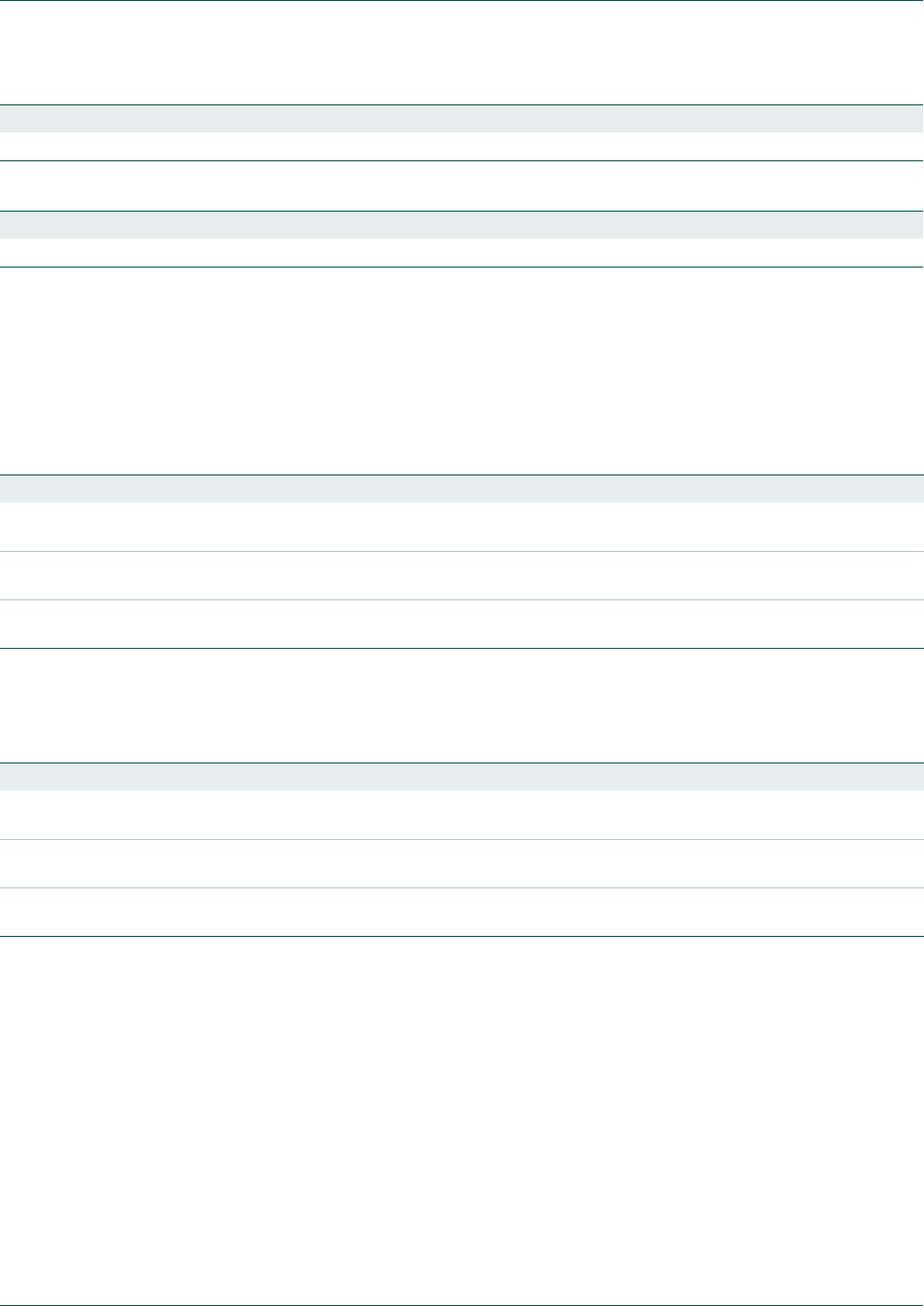
UM10360 All information provided in this document is subject to legal disclaimers. © NXP B.V. 2014. All rights reserved.
User manual Rev. 3.1 — 2 April 2014 649 of 849
NXP Semiconductors UM10360
Chapter 32: LPC176x/5x Flash memory interface and programming
32.10.1.3 Flash Module Status register (FMSTAT - 0x0x4008 4FE0)
The read-only FMSTAT register provides a means of determining when signature
generation has completed. Completion of signature generation can be checked by polling
the SIG_DONE bit in FMSTAT. SIG_DONE should be cleared via the FMSTATCLR
register before starting a signature generation operation, otherwise the status might
indicate completion of a previous operation.
32.10.1.4 Flash Module Status Clear register (FMSTATCLR - 0x0x4008 4FE8)
The FMSTATCLR register is used to clear the signature generation completion flag.
Table 605. FMSW2 register bit description (FMSW2, address: 0x4008 4034)
Bit Symbol Description Reset Value
31:0 SW2[95:64] Word 2 of 128-bit signature (bits 95 to 64). -
Table 606. FMSW3 register bit description (FMSW3, address: 0x4008 4038)
Bit Symbol Description Reset Value
31:0 SW3[127:96] Word 3 of 128-bit signature (bits 127 to 96). -
Table 607. Flash module Status register (FMSTAT - 0x4008 4FE0) bit description
Bit Symbol Description Reset Value
31:2 - Reserved, user software should not write ones to reserved bits. The value read
from a reserved bit is not defined.
NA
2SIG_DONE When 1, a previously started signature generation has completed. See
FMSTATCLR register description for clearing this flag.
0
1:0 - Reserved, user software should not write ones to reserved bits. The value read
from a reserved bit is not defined.
NA
Table 608. Flash Module Status Clear register (FMSTATCLR - 0x0x4008 4FE8) bit description
Bit Symbol Description Reset Value
31:2 - Reserved, user software should not write ones to reserved bits. The value read
from a reserved bit is not defined.
NA
2SIG_DONE_CLRWriting a 1 to this bits clears the signature generation completion flag
(SIG_DONE) in the FMSTAT register.
0
1:0 - Reserved, user software should not write ones to reserved bits. The value read
from a reserved bit is not defined.
NA

UM10360 All information provided in this document is subject to legal disclaimers. © NXP B.V. 2014. All rights reserved.
User manual Rev. 3.1 — 2 April 2014 650 of 849
NXP Semiconductors UM10360
Chapter 32: LPC176x/5x Flash memory interface and programming
32.10.2 Algorithm and procedure for signature generation
Signature generation
A signature can be generated for any part of the flash contents. The address range to be
used for signature generation is defined by writing the start address to the FMSSTART
register, and the stop address to the FMSSTOP register.
The signature generation is started by writing a ‘1’ to FMSSTOP.MISR_START. Starting
the signature generation is typically combined with defining the stop address, which is
done in another field FMSSTOP.FMSSTOP of the same register.
The time that the signature generation takes is proportional to the address range for which
the signature is generated. Reading of the flash memory for signature generation uses a
self-timed read mechanism and does not depend on any configurable timing settings for
the flash. A safe estimation for the duration of the signature generation is:
Duration = int( (60 / tcy) + 3 ) x (FMSSTOP - FMSSTART + 1)
When signature generation is triggered via software, the duration is in AHB clock cycles,
and tcy is the time in ns for one AHB clock. The SIG_DONE bit in FMSTAT can be polled
by software to determine when signature generation is complete.
If signature generation is triggered via JTAG, the duration is in JTAG tck cycles, and tcy is
the time in ns for one JTAG clock. Polling the SIG_DONE bit in FMSTAT is not possible in
this case.
After signature generation, a 128-bit signature can be read from the FMSW0 to FMSW3
registers. The 128-bit signature reflects the corrected data read from the flash. The 128-bit
signature reflects flash parity bits and check bit values.
Content verification
The signature as it is read from the FMSW0 to FMSW3 registers must be equal to the
reference signature. The algorithms to derive the reference signature is given in
Figure 140.
Fig 140. Algorithm for generating a 128 bit signature
sign = 0
FOR address = FMSTART.FMSTART TO FMSTOP.FMSTOP
{
FOR i = 0 TO 126
nextSign[i] = f_Q[address][i] XOR sign[i+1]
nextSign[127] = f_Q[address][127] XOR sign[0] XOR sign[2] XOR
sign[27] XOR sign[29]
sign = nextSign
}
signature128 = sign

UM10360 All information provided in this document is subject to legal disclaimers. © NXP B.V. 2014. All rights reserved.
User manual Rev. 3.1 — 2 April 2014 651 of 849
33.1 Features
•Supports both standard JTAG and ARM Serial Wire Debug modes.
•Direct debug access to all memories, registers, and peripherals.
•No target resources are required for the debugging session.
•Trace port provides CPU instruction trace capability. Output can be via a 4-bit trace
data port, or Serial Wire Viewer.
•Eight Breakpoints. Six instruction breakpoints that can also be used to remap
instruction addresses for code patches. Two data comparators that can be used to
remap addresses for patches to literal values.
•Four data Watchpoints that can also be used as trace triggers.
•Instrumentation Trace Macrocell allows additional software controlled trace.
33.2 Introduction
Debug and trace functions are integrated into the ARM Cortex-M3. Serial wire debug and
trace functions are supported in addition to a standard JTAG debug and parallel trace
functions. The ARM Cortex-M3 is configured to support up to eight breakpoints and four
watchpoints.
33.3 Description
Debugging with the LPC176x/5x defaults to JTAG. Once in the JTAG debug mode, the
debug tool can switch to Serial Wire Debug mode.
Trace can be done using either a 4-bit parallel interface or the Serial Wire Output. When
the Serial Wire Output is used, less data can be traced, but it uses no application related
pins. Parallel trace has a greater bandwidth, but uses 5 functional pins that may be
needed in the application. Note that the trace function available for the Cortex-M3 is
functionally very different than the trace that was available for previous ARM7 based
devices, using only 5 pins instead of 10.
33.4 Pin Description
The tables below indicate the various pin functions related to debug and trace. Some of
these functions share pins with other functions which therefore may not be used at the
same time. Use of the JTAG port excludes use of Serial Wire Debug and Serial Wire
Output. Use of the parallel trace requires 5 pins that may be part of the user application,
limiting debug possibilities for those features. Trace using the Serial Wire Output does not
have this limitation, but has a limited bandwidth.
UM10360
Chapter 33: LPC176x/5x JTAG, Serial Wire Debug (SWD), and
Trace
Rev. 3.1 — 2 April 2014 User manual

UM10360 All information provided in this document is subject to legal disclaimers. © NXP B.V. 2014. All rights reserved.
User manual Rev. 3.1 — 2 April 2014 652 of 849
NXP Semiconductors UM10360
Chapter 33: LPC176x/5x JTAG, Serial Wire Debug (SWD), and Trace
33.5 Debug Notes
Important: The user should be aware of certain limitations during debugging. The most
important is that, due to limitations of the Cortex-M3 integration, the LPC176x/5x cannot
wake up in the usual manner from Deep Sleep and Power-down modes. It is
recommended not to use these modes during debug.
Table 609. JTAG pin description
Pin Name Type Description
TCK Input JTAG Test Clock. This pin is the clock for debug logic when in the
JTAG debug mode.
TMS Input JTAG Test Mode Select. The TMS pin selects the next state in the
TAP state machine.
TDI Input JTAG Test Data In. This is the serial data input for the shift register.
TDO Output JTAG Test Data Output. This is the serial data output from the shift
register. Data is shifted out of the device on the negative edge of the
TCK signal.
TRST Input JTAG Test Reset. The TRST pin can be used to reset the test logic
within the debug logic.
RTCK Output JTAG Returned Test Clock. This is an extra signal added to the
JTAG port, and is included for backward pin compatibility with
LPC23xx series devices that share the same pinout as this device.
RTCK is not normally used with the Cortex-M3.
For designs based on ARM7TDMI-S processor core, this signal
could be used by external JTAG host interface logic to maintain
synchronization with targets having a slow or varying clock
frequency. For details refer to "Multi-ICE System Design
considerations Application Note 72 (ARM DAI 0072A)".
Table 610. Serial Wire Debug pin description
Pin Name Type Description
SWDCLK Input Serial Wire Clock. This pin is the clock for debug logic when in the
Serial Wire Debug mode.
SWDIO Input /
Output
Serial wire debug data input/output. The SWDIO pin is used by an
external debug tool to communicate with and control the Cortex-M3
CPU.
SWO Output Serial Wire Output. The SWO pin can deliver Serial Wire Viewer
data only. Serial Wire Viewer data includes ITM and DWT trace data.
Table 611. Parallel Trace pin description
Pin Name Type Description
TRACECLK Input Trace Clock. This pin provides the sample clock for trace data on
the TRACEDATA pins when tracing is enabled by an external debug
tool.
TRACEDATA[3:0] Output Trace Data bits 3 to 0. These pins provide ETM trace data when
tracing is enabled by an external debug tool. The debug tool can
then interpret the compressed information and make it available to
the user.

UM10360 All information provided in this document is subject to legal disclaimers. © NXP B.V. 2014. All rights reserved.
User manual Rev. 3.1 — 2 April 2014 653 of 849
NXP Semiconductors UM10360
Chapter 33: LPC176x/5x JTAG, Serial Wire Debug (SWD), and Trace
Another issue is that debug mode changes the way in which reduced power modes are
handled by the Cortex-M3 CPU. This causes power modes at the device level to be
different from normal modes operation. These differences mean that power
measurements should not be made while debugging, the results will be higher than during
normal operation in an application.
During a debugging session, the System Tick Timer and the Repetitive Interrupt Timers
are automatically stopped whenever the CPU is stopped. Other peripherals are not
affected. If the Repetitive Interrupt Timer is configured such that its PCLK rate is lower
than the CPU clock rate, the RIT may not increment predictably during some debug
operations, such as single stepping.
Debugging is disabled if code read protection is enabled.
The bootloader uses the SRAM during execution. When a system reset is issued to the
core and peripherals during a debug session, SRAM 0x10000120 will be used by the
bootloader.The boot code uses a complete word (“0x10000120…0x10000123” or “32-bit
SRAM word 0x10000120”).
33.6 Debug memory re-mapping
Following chip reset, a portion of the Boot ROM is mapped to address 0 so that it will be
automatically executed. The Boot ROM switches the map to point to Flash memory prior
to user code being executed. In this way a user normally does not need to know that this
re-mapping occurs.
However, when a debugger halts CPU execution immediately following reset, the Boot
ROM is still mapped to address 0 and can cause confusion. Ideally, the debugger should
correct the mapping automatically in this case, so that a user does not need to deal with it.
33.6.1 Memory Mapping Control register (MEMMAP - 0x400F C040)
The MEMMAP register allows switch the mapping of the bottom of memory, including
default reset and interrupt vectors, between the Boot ROM and the bottom of on-chip
Flash memory.
33.7 JTAG TAP Identification
The JTAG TAP controller contains device ID that can be used by debugging software to
identify the general type of device. More detailed device information is available through
ISP/IAP commands (see Section 32.7 and Section 32.8). For the LPC176x/5x family, this
ID value is 0x4BA0 0477.
Table 612. Memory Mapping Control register (MEMMAP - 0x400F C040) bit description
Bit Symbol Value Description Reset
value
0MAP Memory map control. 0
0Boot mode. A portion of the Boot ROM is mapped to address 0.
1User mode. The on-chip Flash memory is mapped to address 0.
31:1 - Reserved. The value read from a reserved bit is not defined. NA
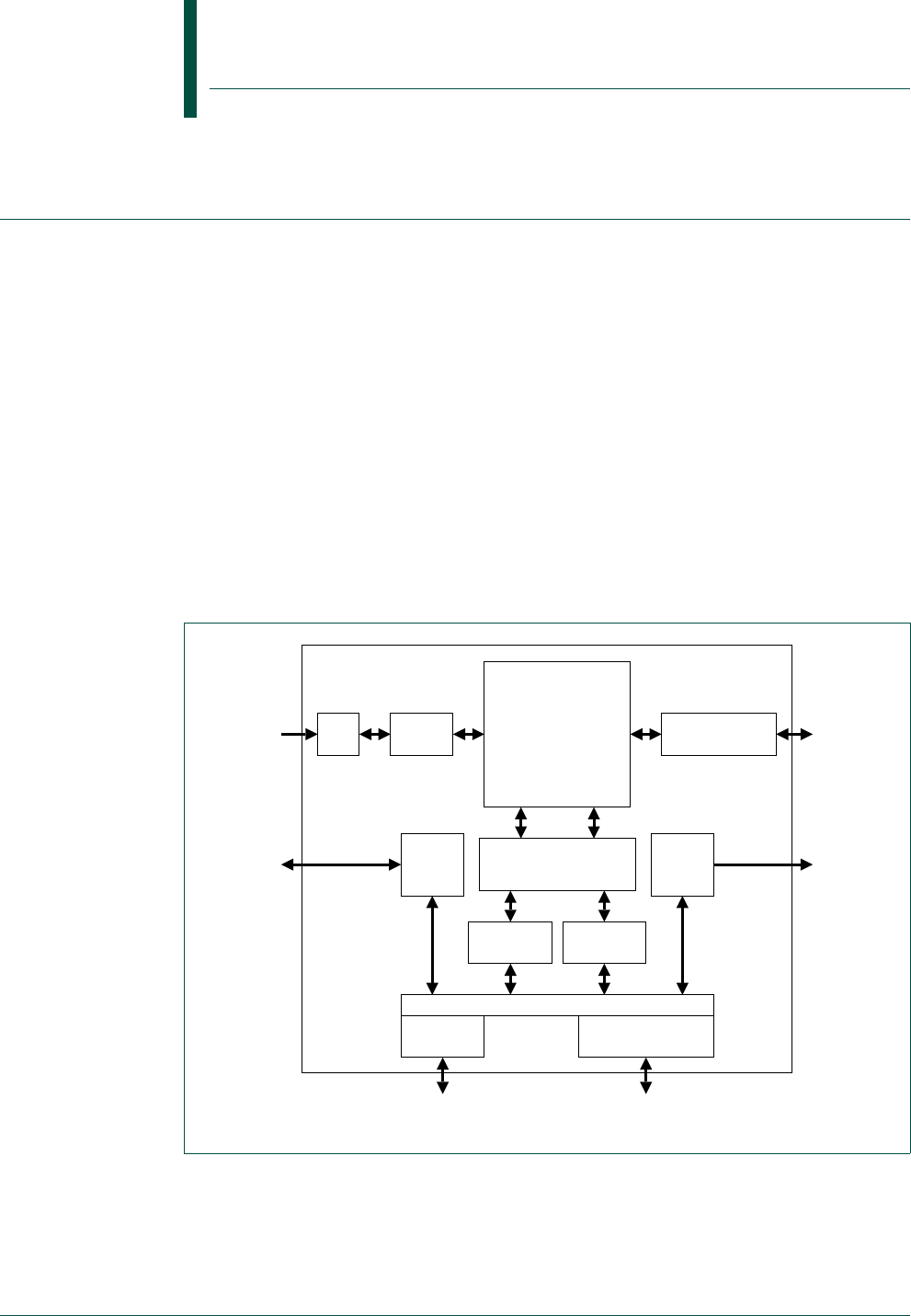
UM10360 All information provided in this document is subject to legal disclaimers. © NXP B.V. 2014. All rights reserved.
User manual Rev. 3.1 — 2 April 2014 654 of 849
34.1 ARM Cortex-M3 User Guide: Introduction
The material in this appendix is provided by ARM Limited for inclusion in the User
Manuals of devices containing the Cortex-M3 CPU. Minimal changes have been
made to reflect implementation options and other distinctions that apply
specifically to LPC176x/5x devices.
34.1.1 About the processor and core peripherals
The Cortex-M3 processor is a high performance 32-bit processor designed for the
microcontroller market. It offers significant benefits to developers, including:
•outstanding processing performance combined with fast interrupt handling
•enhanced system debug with extensive breakpoint and trace capabilities
•efficient processor core, system and memories
•ultra-low power consumption with integrated sleep modes
•platform security, with optional integrated memory protection unit (MPU).
The Cortex-M3 processor is built on a high-performance processor core, with a 3-stage
pipeline Harvard architecture, making it ideal for demanding embedded applications. The
processor delivers exceptional power efficiency through an efficient instruction set and
extensively optimized design, providing high-end processing hardware including
single-cycle 32x32 multiplication and dedicated hardware division.
UM10360
Chapter 34: Appendix: Cortex-M3 user guide
Rev. 3.1 — 2 April 2014 User manual
Fig 141. Typical Cortex-M3 implementation
3URFHVVRU
FRUH
(PEHGGHG
7UDFH0DFURFHOO
19,&
'HEXJ
$FFHVV
3RUW
0HPRU\
SURWHFWLRQXQLW
:,&
6HULDO
:LUH
YLHZHU
%XVPDWUL[
&RGH
LQWHUIDFH
65$0DQG
SHULSKHUDOLQWHUIDFH
'DWD
ZDWFKSRLQWV
)ODVK
SDWFK
&RUWH[0
SURFHVVRU

UM10360 All information provided in this document is subject to legal disclaimers. © NXP B.V. 2014. All rights reserved.
User manual Rev. 3.1 — 2 April 2014 655 of 849
NXP Semiconductors UM10360
Chapter 34: Appendix: Cortex-M3 user guide
To facilitate the design of cost-sensitive devices, the Cortex-M3 processor implements
tightly-coupled system components that reduce processor area while significantly
improving interrupt handling and system debug capabilities. The Cortex-M3 processor
implements a version of the Thumb instruction set, ensuring high code density and
reduced program memory requirements. The Cortex-M3 instruction set provides the
exceptional performance expected of a modern 32-bit architecture, with the high code
density of 8-bit and 16-bit microcontrollers.
The Cortex-M3 processor closely integrates a configurable nested interrupt controller
(NVIC), to deliver industry-leading interrupt performance. The NVIC includes a
non-maskable interrupt (NMI), and provides up to 256 interrupt priority levels. The tight
integration of the processor core and NVIC provides fast execution of interrupt service
routines (ISRs), dramatically reducing the interrupt latency. This is achieved through the
hardware stacking of registers, and the ability to suspend load-multiple and store-multiple
operations. Interrupt handlers do not require any assembler stubs, removing any code
overhead from the ISRs. Tail-chaining optimization also significantly reduces the overhead
when switching from one ISR to another.
To optimize low-power designs, the NVIC integrates with the sleep modes, that include a
deep sleep function that enables the entire device to be rapidly powered down.
LPC176x/5x devices support additional reduced power modes, see Section 4.8 “Power
control” for details.
34.1.1.1 System level interface
The Cortex-M3 processor provides multiple interfaces using AMBA technology to provide
high speed, low latency memory accesses. It supports unaligned data accesses and
implements atomic bit manipulation that enables faster peripheral controls, system
spinlocks and thread-safe Boolean data handling.
The Cortex-M3 processor has an optional memory protection unit (MPU) that provides
fine grain memory control, enabling applications to implement security privilege levels,
separating code, data and stack on a task-by-task basis. Such requirements are
becoming critical in many embedded applications such as automotive. The MPU is
included in LPC176x/5x devices.
34.1.1.2 Integrated configurable debug
The Cortex-M3 processor implements a complete hardware debug solution. This provides
high system visibility of the processor and memory through either a traditional JTAG port
or a 2-pin Serial Wire Debug (SWD) port that is ideal for microcontrollers and other small
package devices. The MCU vendor determines the debug feature configuration and
therefore this can differ across different devices and families.
For system trace the processor integrates an Instrumentation Trace Macrocell (ITM)
alongside data watchpoints and a profiling unit. To enable simple and cost-effective
profiling of the system events these generate, a Serial Wire Viewer (SWV) can export a
stream of software-generated messages, data trace, and profiling information through a
single pin.
The optional Embedded Trace Macrocell (ETM) delivers unrivalled instruction trace
capture in an area far smaller than traditional trace units, enabling many low cost MCUs to
implement full instruction trace for the first time.

UM10360 All information provided in this document is subject to legal disclaimers. © NXP B.V. 2014. All rights reserved.
User manual Rev. 3.1 — 2 April 2014 656 of 849
NXP Semiconductors UM10360
Chapter 34: Appendix: Cortex-M3 user guide
LPC176x/5x devices support JTAG and Serial Wire Debug, Serial Wire Viewer, and
include the Embedded Trace Macrocell. See Section 33.1 for additional information.
34.1.1.3 Cortex-M3 processor features and benefits summary
•tight integration of system peripherals reduces area and development costs
•Thumb instruction set combines high code density with 32-bit performance
•code-patch ability for ROM system updates
•power control optimization of system components
•integrated sleep modes for low power consumption
•fast code execution permits slower processor clock or increases sleep mode time
•hardware division and fast multiplier
•deterministic, high-performance interrupt handling for time-critical applications
•optional memory protection unit (MPU) for safety-critical applications
•extensive debug and trace capabilities:
–Serial Wire Debug and Serial Wire Trace reduce the number of pins required for
debugging and tracing.
34.1.1.4 Cortex-M3 core peripherals
These are:
•Nested Vectored Interrupt Controller
The Nested Vectored Interrupt Controller (NVIC) is an embedded interrupt
controller that supports low latency interrupt processing.
•System control block
The System control block (SCB) is the programmers model interface to the
processor. It provides system implementation information and system control,
including configuration, control, and reporting of system exceptions.
•System timer
The system timer, SysTick, is a 24-bit count-down timer. Use this as a Real Time
Operating System (RTOS) tick timer or as a simple counter.
•Memory protection unit
The Memory protection unit (MPU) improves system reliability by defining the
memory attributes for different memory regions. It provides up to eight different
regions, and an optional predefined background region.
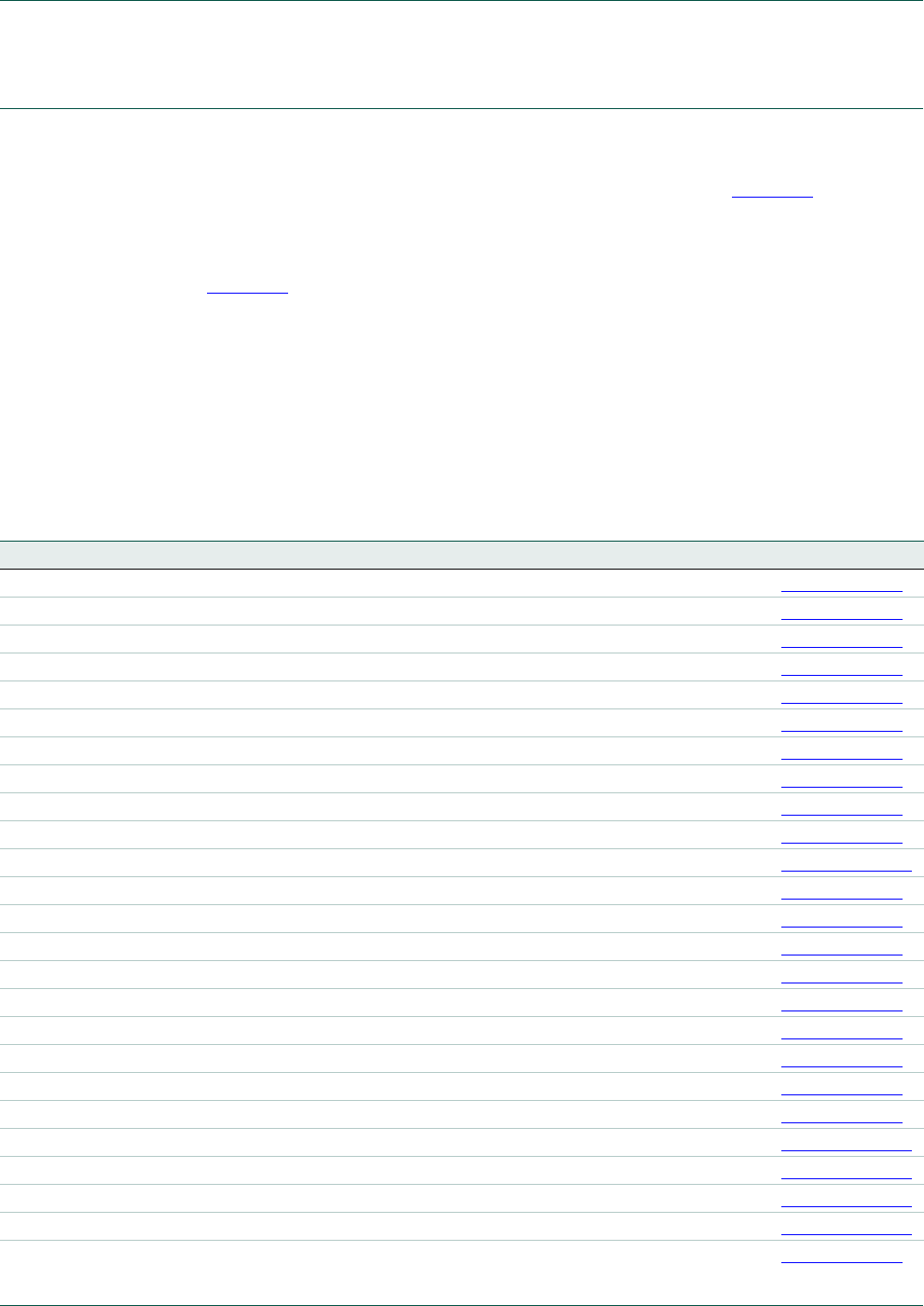
UM10360 All information provided in this document is subject to legal disclaimers. © NXP B.V. 2014. All rights reserved.
User manual Rev. 3.1 — 2 April 2014 657 of 849
NXP Semiconductors UM10360
Chapter 34: Appendix: Cortex-M3 user guide
34.2 ARM Cortex-M3 User Guide: Instruction Set
34.2.1 Instruction set summary
The processor implements a version of the Thumb instruction set. Ta b le 6 1 3 lists the
supported instructions.
Note
In Tab l e 61 3:
•angle brackets, <>, enclose alternative forms of the operand
•braces, {}, enclose optional operands
•the Operands column is not exhaustive
•
Op2
is a flexible second operand that can be either a register or a constant
•most instructions can use an optional condition code suffix.
For more information on the instructions and operands, see the instruction descriptions.
Table 613. Cortex-M3 instructions
Mnemonic Operands Brief description Flags Page
ADC, ADCS {Rd,}
Rn,
Op2
Add with Carry N,Z,C,V Section 34.2.5.1
ADD, ADDS {Rd,}
Rn, Op2
Add N,Z,C,V Section 34.2.5.1
ADD, ADDW {Rd,}
Rn, #imm12
Add N,Z,C,V Section 34.2.5.1
ADR Rd, label
Load PC-relative address -Section 34.2.4.1
AND, ANDS {Rd,} Rn, Op2
Logical AND N,Z,C Section 34.2.5.2
ASR, ASRS Rd, Rm, <Rs|#n>
Arithmetic Shift Right N,Z,C Section 34.2.5.3
Blabel
Branch -Section 34.2.9.1
BFC Rd, #lsb, #width
Bit Field Clear -Section 34.2.8.1
BFI Rd, Rn, #lsb, #width
Bit Field Insert -Section 34.2.8.1
BIC, BICS {Rd,}
Rn, Op2
Bit Clear N,Z,C Section 34.2.5.2
BKPT #imm
Breakpoint -Section 34.2.10.1
BL label
Branch with Link -Section 34.2.9.1
BLX Rm
Branch indirect with Link -Section 34.2.9.1
BX Rm
Branch indirect -Section 34.2.9.1
CBNZ Rn, label
Compare and Branch if Non Zero -Section 34.2.9.2
CBZ Rn, label
Compare and Branch if Zero -Section 34.2.9.2
CLREX
-Clear Exclusive -Section 34.2.4.9
CLZ Rd, Rm
Count leading zeros -Section 34.2.5.4
CMN, CMNS Rn, Op2
Compare Negative N,Z,C,V Section 34.2.5.5
CMP, CMPS Rn, Op2
Compare N,Z,C,V Section 34.2.5.5
CPSID iflags
Change Processor State, Disable Interrupts - Section 34.2.10.2
CPSIE iflags
Change Processor State, Enable Interrupts - Section 34.2.10.2
DMB -
Data Memory Barrier -Section 34.2.10.3
DSB -
Data Synchronization Barrier -Section 34.2.10.4
EOR, EORS {Rd,} Rn, Op2
Exclusive OR N,Z,C Section 34.2.5.2

UM10360 All information provided in this document is subject to legal disclaimers. © NXP B.V. 2014. All rights reserved.
User manual Rev. 3.1 — 2 April 2014 658 of 849
NXP Semiconductors UM10360
Chapter 34: Appendix: Cortex-M3 user guide
ISB -
Instruction Synchronization Barrier -Section 34.2.10.5
IT
-If-Then condition block -Section 34.2.9.3
LDM Rn{!}, reglist
Load Multiple registers, increment after - Section 34.2.4.6
LDMDB, LDMEA Rn{!}, reglist
Load Multiple registers, decrement before - Section 34.2.4.6
LDMFD, LDMIA Rn{!}, reglist
Load Multiple registers, increment after - Section 34.2.4.6
LDR Rt, [Rn, #offset]
Load Register with word -Section 34.2.4
LDRB, LDRBT Rt, [Rn, #offset]
Load Register with byte -Section 34.2.4
LDRD Rt, Rt2, [Rn, #offset]
Load Register with double word -Section 34.2.4.2
LDREX Rt, [Rn, #offset]
Load Register Exclusive -Section 34.2.4.8
LDREXB Rt, [Rn]
Load Register Exclusive with byte -Section 34.2.4.8
LDREXH Rt, [Rn]
Load Register Exclusive with halfword -Section 34.2.4.8
LDRH, LDRHT Rt, [Rn, #offset]
Load Register with halfword -Section 34.2.4
LDRSB, LDRSBT Rt, [Rn, #offset]
Load Register with signed byte -Section 34.2.4
LDRSH, LDRSHT Rt, [Rn, #offset]
Load Register with signed halfword -Section 34.2.4
LDRT Rt, [Rn, #offset]
Load Register with word -Section 34.2.4
LSL, LSLS Rd, Rm, <Rs|#n>
Logical Shift Left N,Z,C Section 34.2.5.3
LSR, LSRS Rd, Rm, <Rs|#n>
Logical Shift Right N,Z,C Section 34.2.5.3
MLA Rd, Rn, Rm, Ra
Multiply with Accumulate, 32-bit result -Section 34.2.6.1
MLS Rd, Rn, Rm, Ra
Multiply and Subtract, 32-bit result -Section 34.2.6.1
MOV, MOVS Rd, Op2
Move N,Z,C Section 34.2.5.6
MOVT Rd, #imm16
Move Top -Section 34.2.5.7
MOVW, MOV Rd, #imm16
Move 16-bit constant N,Z,C Section 34.2.5.6
MRS Rd, spec_reg
Move from special register to general register - Section 34.2.10.6
MSR spec_reg, Rm
Move from general register to special register N,Z,C,V Section 34.2.10.7
MUL, MULS {Rd,} Rn, Rm
Multiply, 32-bit result N,Z Section 34.2.6.1
MVN, MVNS Rd, Op2
Move NOT N,Z,C Section 34.2.5.6
NOP
-No Operation -Section 34.2.10.8
ORN, ORNS {Rd,} Rn, Op2
Logical OR NOT N,Z,C Section 34.2.5.2
ORR, ORRS {Rd,} Rn, Op2
Logical OR N,Z,C Section 34.2.5.2
POP reglist
Pop registers from stack -Section 34.2.4.7
PUSH reglist
Push registers onto stack -Section 34.2.4.7
RBIT Rd, Rn
Reverse Bits -Section 34.2.5.8
REV Rd, Rn
Reverse byte order in a word -Section 34.2.5.8
REV16 Rd, Rn
Reverse byte order in each halfword -Section 34.2.5.8
REVSH Rd, Rn
Reverse byte order in bottom halfword and sign
extend
-Section 34.2.5.8
ROR, RORS Rd, Rm, <Rs|#n>
Rotate Right N,Z,C Section 34.2.5.3
RRX, RRXS Rd, Rm
Rotate Right with Extend N,Z,C Section 34.2.5.3
RSB, RSBS {Rd,} Rn, Op2
Reverse Subtract N,Z,C,V Section 34.2.5.1
SBC, SBCS {Rd,} Rn, Op2
Subtract with Carry N,Z,C,V Section 34.2.5.1
SBFX Rd, Rn, #lsb, #width
Signed Bit Field Extract -Section 34.2.8.2
Table 613. Cortex-M3 instructions …continued
Mnemonic Operands Brief description Flags Page

UM10360 All information provided in this document is subject to legal disclaimers. © NXP B.V. 2014. All rights reserved.
User manual Rev. 3.1 — 2 April 2014 659 of 849
NXP Semiconductors UM10360
Chapter 34: Appendix: Cortex-M3 user guide
SDIV {Rd,} Rn, Rm
Signed Divide -Section 34.2.6.3
SEV
-Send Event -Section 34.2.10.9
SMLAL RdLo, RdHi, Rn, Rm
Signed Multiply with Accumulate (32 x 32 + 64),
64-bit result
-Section 34.2.6.2
SMULL RdLo, RdHi, Rn, Rm
Signed Multiply (32 x 32), 64-bit result -Section 34.2.6.2
SSAT Rd, #n, Rm {,shift #s}
Signed Saturate QSection 34.2.7.1
STM Rn{!}, reglist
Store Multiple registers, increment after - Section 34.2.4.6
STMDB, STMEA Rn{!}, reglist
Store Multiple registers, decrement before - Section 34.2.4.6
STMFD, STMIA Rn{!}, reglist
Store Multiple registers, increment after - Section 34.2.4.6
STR Rt, [Rn, #offset]
Store Register word -Section 34.2.4
STRB, STRBT Rt, [Rn, #offset]
Store Register byte -Section 34.2.4
STRD Rt, Rt2, [Rn, #offset]
Store Register two words -Section 34.2.4.2
STREX Rd, Rt, [Rn, #offset]
Store Register Exclusive -Section 34.2.4.8
STREXB Rd, Rt, [Rn]
Store Register Exclusive byte -Section 34.2.4.8
STREXH Rd, Rt, [Rn]
Store Register Exclusive halfword -Section 34.2.4.8
STRH, STRHT Rt, [Rn, #offset]
Store Register halfword -Section 34.2.4
STRT Rt, [Rn, #offset]
Store Register word -Section 34.2.4
SUB, SUBS {Rd,} Rn, Op2
Subtract N,Z,C,V Section 34.2.5.1
SUB, SUBW {Rd,} Rn, #imm12
Subtract N,Z,C,V Section 34.2.5.1
SVC #imm
Supervisor Call -Section 34.2.10.1
0
SXTB {Rd,} Rm {,ROR #n}
Sign extend a byte - Section 34.2.8.3
SXTH {Rd,} Rm {,ROR #n}
Sign extend a halfword -Section 34.2.8.3
TBB [Rn, Rm]
Tab l e Bra n c h Byt e -Section 34.2.9.4
TBH [Rn, Rm, LSL #1]
Tab l e Bra n c h Ha l f w ord -Section 34.2.9.4
TEQ Rn, Op2
Tes t E qui v a l enc e N,Z,C Section 34.2.5.9
TST Rn, Op2
Tes t N,Z,C Section 34.2.5.9
UBFX Rd, Rn, #lsb, #width
Unsigned Bit Field Extract -Section 34.2.8.2
UDIV {Rd,} Rn, Rm
Unsigned Divide -Section 34.2.6.3
UMLAL RdLo, RdHi, Rn, Rm
Unsigned Multiply with Accumulate
(32 x 32 + 64), 64-bit result
-Section 34.2.6.2
UMULL RdLo, RdHi, Rn, Rm
Unsigned Multiply (32 x 32), 64-bit result - Section 34.2.6.2
USAT Rd, #n, Rm {,shift #s}
Unsigned Saturate QSection 34.2.7.1
UXTB {Rd,} Rm {,ROR #n}
Zero extend a byte -Section 34.2.8.3
UXTH {Rd,} Rm {,ROR #n}
Zero extend a halfword -Section 34.2.8.3
WFE
-Wait For Event -Section 34.2.10.1
1
WFI
-Wait For Interrupt -Section 34.2.10.1
2
Table 613. Cortex-M3 instructions …continued
Mnemonic Operands Brief description Flags Page

UM10360 All information provided in this document is subject to legal disclaimers. © NXP B.V. 2014. All rights reserved.
User manual Rev. 3.1 — 2 April 2014 660 of 849
NXP Semiconductors UM10360
Chapter 34: Appendix: Cortex-M3 user guide
34.2.2 Intrinsic functions
ANSI cannot directly access some Cortex-M3 instructions. This section describes intrinsic
functions that can generate these instructions, provided by the CMIS and that might be
provided by a C compiler. If a C compiler does not support an appropriate intrinsic
function, you might have to use inline assembler to access some instructions.
The CMSIS provides the following intrinsic functions to generate instructions that ANSI
cannot directly access:
The CMSIS also provides a number of functions for accessing the special registers using
MRS
and
MSR
instructions:
34.2.3 About the instruction descriptions
The following sections give more information about using the instructions:
Table 614. CMSIS intrinsic functions to generate some Cortex-M3 instructions
Instruction CMSIS intrinsic function
CPSIE I void __enable_irq(void)
CPSID I void __disable_irq(void)
CPSIE F void __enable_fault_irq(void)
CPSID F void __disable_fault_irq(void)
ISB void __ISB(void)
DSB void __DSB(void)
DMB void __DMB(void)
REV uint32_t __REV(uint32_t int value)
REV16 uint32_t __REV16(uint32_t int value)
REVSH uint32_t __REVSH(uint32_t int value)
RBIT uint32_t __RBIT(uint32_t int value)
SEV void __SEV(void)
WFE void __WFE(void)
WFI void __WFI(void)
Table 615. CMSIS intrinsic functions to access the special registers
Special register Access CMSIS function
PRIMASK Read
uint32_t __get_PRIMASK (void)
Write
void __set_PRIMASK (uint32_t value)
FAULTMASK Read
uint32_t __get_FAULTMASK (void)
Write
void __set_FAULTMASK (uint32_t value)
BASEPRI Read
uint32_t __get_BASEPRI (void)
Write
void __set_BASEPRI (uint32_t value)
CONTROL Read
uint32_t __get_CONTROL (void)
Write
void __set_CONTROL (uint32_t value)
MSP Read
uint32_t __get_MSP (void)
Write
void __set_MSP (uint32_t TopOfMainStack)
PSP Read
uint32_t __get_PSP (void)
Write
void __set_PSP (uint32_t TopOfProcStack)

UM10360 All information provided in this document is subject to legal disclaimers. © NXP B.V. 2014. All rights reserved.
User manual Rev. 3.1 — 2 April 2014 661 of 849
NXP Semiconductors UM10360
Chapter 34: Appendix: Cortex-M3 user guide
•Section 34.2.3.1 “Operands”
•Section 34.2.3.2 “Restrictions when using PC or SP”
•Section 34.2.3.3 “Flexible second operand”
•Section 34.2.3.4 “Shift Operations”
•Section 34.2.3.5 “Address alignment”
•Section 34.2.3.6 “PC-relative expressions”
•Section 34.2.3.7 “Conditional execution”
•Section 34.2.3.8 “Instruction width selection”.
34.2.3.1 Operands
An instruction operand can be an ARM register, a constant, or another instruction-specific
parameter. Instructions act on the operands and often store the result in a destination
register. When there is a destination register in the instruction, it is usually specified before
the operands.
Operands in some instructions are flexible in that they can either be a register or a
constant. See Section 34.2.3.3.
34.2.3.2 Restrictions when using PC or SP
Many instructions have restrictions on whether you can use the Program Counter (PC)
or Stack Pointer (SP) for the operands or destination register. See instruction
descriptions for more information.
Remark: Bit[0] of any address you write to the PC with a
BX
,
BLX
,
LDM
,
LDR
, or
POP
instruction
must be 1 for correct execution, because this bit indicates the required instruction set, and
the Cortex-M3 processor only supports Thumb instructions.
34.2.3.3 Flexible second operand
Many general data processing instructions have a flexible second operand. This is shown
as Operand2 in the descriptions of the syntax of each instruction.
Operand2 can be a:
•Section 34.2.3.3.1 “Constant”
•Section 34.2.3.3.2 “Register with optional shift”
34.2.3.3.1 Constant
You specify an Operand2 constant in the form:
#
constant
where
constant
can be:
•any constant that can be produced by shifting an 8-bit value left by any number of bits
within a 32-bit word
•any constant of the form
0x00XY00XY
•any constant of the form
0xXY00XY00
•any constant of the form
0xXYXYXYXY
.

UM10360 All information provided in this document is subject to legal disclaimers. © NXP B.V. 2014. All rights reserved.
User manual Rev. 3.1 — 2 April 2014 662 of 849
NXP Semiconductors UM10360
Chapter 34: Appendix: Cortex-M3 user guide
Remark: In the constants shown above,
X
and
Y
are hexadecimal digits.
In addition, in a small number of instructions,
constant
can take a wider range of values.
These are described in the individual instruction descriptions.
When an Operand2 constant is used with the instructions
MOVS
,
MVNS
,
ANDS
,
ORRS
,
ORNS
,
EORS
,
BICS
,
TEQ
or
TST
, the carry flag is updated to bit[31] of the constant, if the constant is greater
than 255 and can be produced by shifting an 8-bit value. These instructions do not affect
the carry flag if Operand2 is any other constant.
Instruction substitution: Your assembler might be able to produce an equivalent
instruction in cases where you specify a constant that is not permitted. For example, an
assembler might assemble the instruction
CMP Rd, #0xFFFFFFFE
as the equivalent
instruction
CMN Rd, #0x2
.
34.2.3.3.2 Register with optional shift
You specify an Operand2 register in the form:
Rm {, shift}
where:
Rm is the register holding the data for the second operand.
shift is an optional shift to be applied to Rm. It can be one of:
ASR#n: arithmetic shift right n bits, 1 n 32.
LSL#n: logical shift left n bits, 1 n 31.
LSR#n: logical shift right n bits, 1 n 32.
ROR#n: rotate right n bits, 1 n 31.
RRX: rotate right one bit, with extend.
—: if omitted, no shift occurs, equivalent to LSL#0.
If you omit the shift, or specify LSL #0, the instruction uses the value in Rm.
If you specify a shift, the shift is applied to the value in Rm, and the resulting 32-bit value
is used by the instruction. However, the contents in the register Rm remains unchanged.
Specifying a register with shift also updates the carry flag when used with certain
instructions. For information on the shift operations and how they affect the carry flag, see
Section 34.2.3.4 “Shift Operations”
34.2.3.4 Shift Operations
Register shift operations move the bits in a register left or right by a specified number of
bits, the shift length. Register shift can be performed:
•directly by the instructions
ASR
,
LSR
,
LSL
,
ROR
, and
RRX
, and the result is written to a
destination register
•during the calculation of Operand2 by the instructions that specify the second
operand as a register with shift, see Section 34.2.3.3. The result is used by the
instruction.
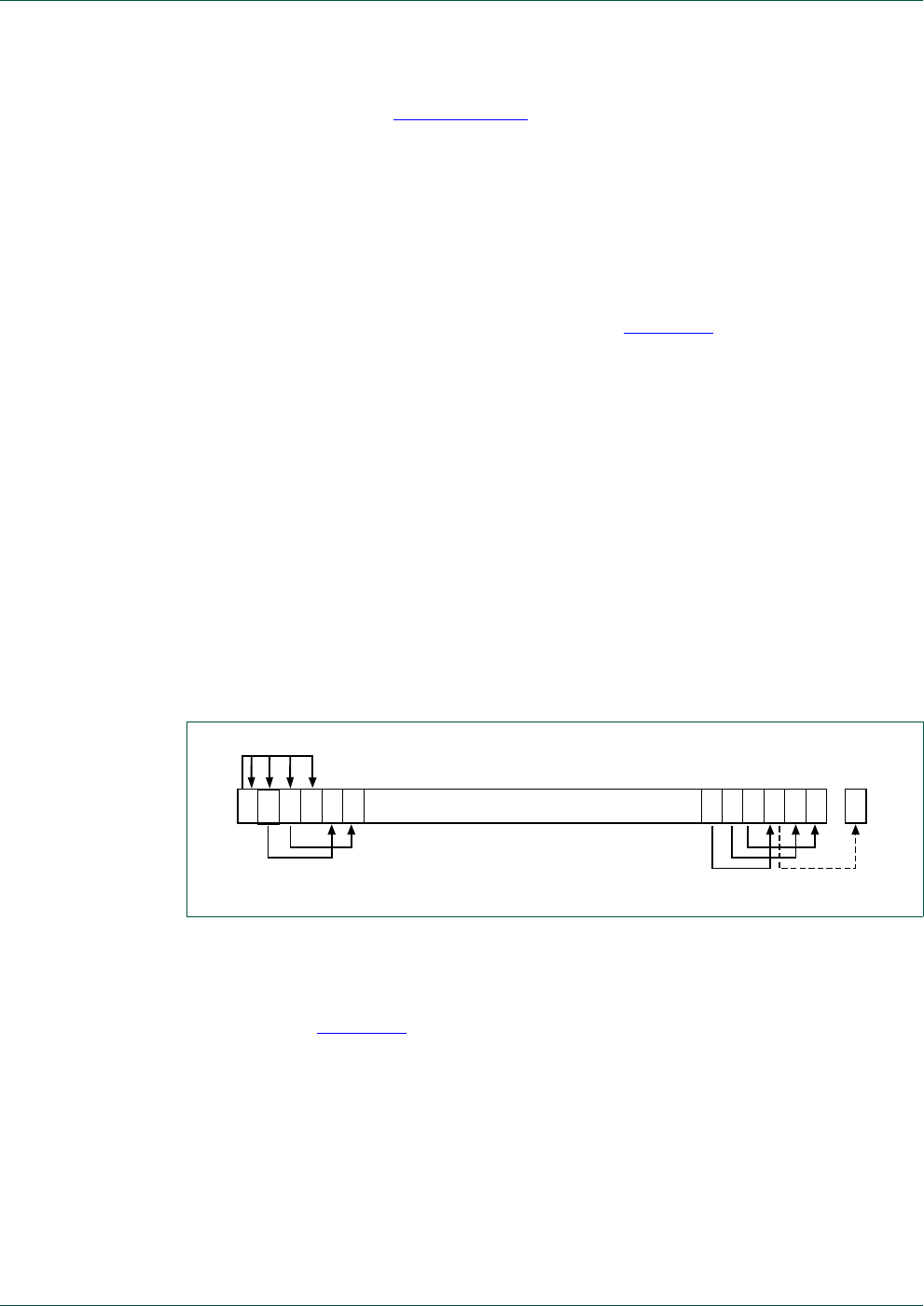
UM10360 All information provided in this document is subject to legal disclaimers. © NXP B.V. 2014. All rights reserved.
User manual Rev. 3.1 — 2 April 2014 663 of 849
NXP Semiconductors UM10360
Chapter 34: Appendix: Cortex-M3 user guide
The permitted shift lengths depend on the shift type and the instruction, see the individual
instruction description or Section 34.2.3.3. If the shift length is 0, no shift occurs. Register
shift operations update the carry flag except when the specified shift length is 0. The
following sub-sections describe the various shift operations and how they affect the carry
flag. In these descriptions, Rm is the register containing the value to be shifted, and n is
the shift length.
34.2.3.4.1 ASR
Arithmetic shift right by n bits moves the left-hand
32
-n bits of the register Rm, to the right
by n places, into the right-hand
32
-n bits of the result. And it copies the original bit[31] of
the register into the left-hand n bits of the result. See Figure 142.
You can use the ASR #n operation to divide the value in the register Rm by 2n, with the
result being rounded towards negative-infinity.
When the instruction is
ASRS
or when ASR #n is used in Operand2 with the instructions
MOVS
,
MVNS
,
ANDS
,
ORRS
,
ORNS
,
EORS
,
BICS
,
TEQ
or
TST
, the carry flag is updated to the last bit
shifted out, bit[n-1], of the register Rm.
Note
•If n is 32 or more, then all the bits in the result are set to the value of bit[31] of Rm.
•If n is 32 or more and the carry flag is updated, it is updated to the value of bit[31] of
Rm.
34.2.3.4.2 LSR
Logical shift right by n bits moves the left-hand
32
-n bits of the register Rm, to the right by
n places, into the right-hand
32
-n bits of the result. And it sets the left-hand n bits of the
result to 0. See Figure 143.
You can use the LSR #n operation to divide the value in the register Rm by 2n, if the value
is regarded as an unsigned integer.
When the instruction is
LSRS
or when LSR #n is used in Operand2 with the instructions
MOVS
,
MVNS
,
ANDS
,
ORRS
,
ORNS
,
EORS
,
BICS
,
TEQ
or
TST
, the carry flag is updated to the last bit
shifted out, bit[n-1], of the register Rm.
Note
•If n is 32 or more, then all the bits in the result are cleared to 0.
Fig 142. ASR #3
&DUU\
)ODJ
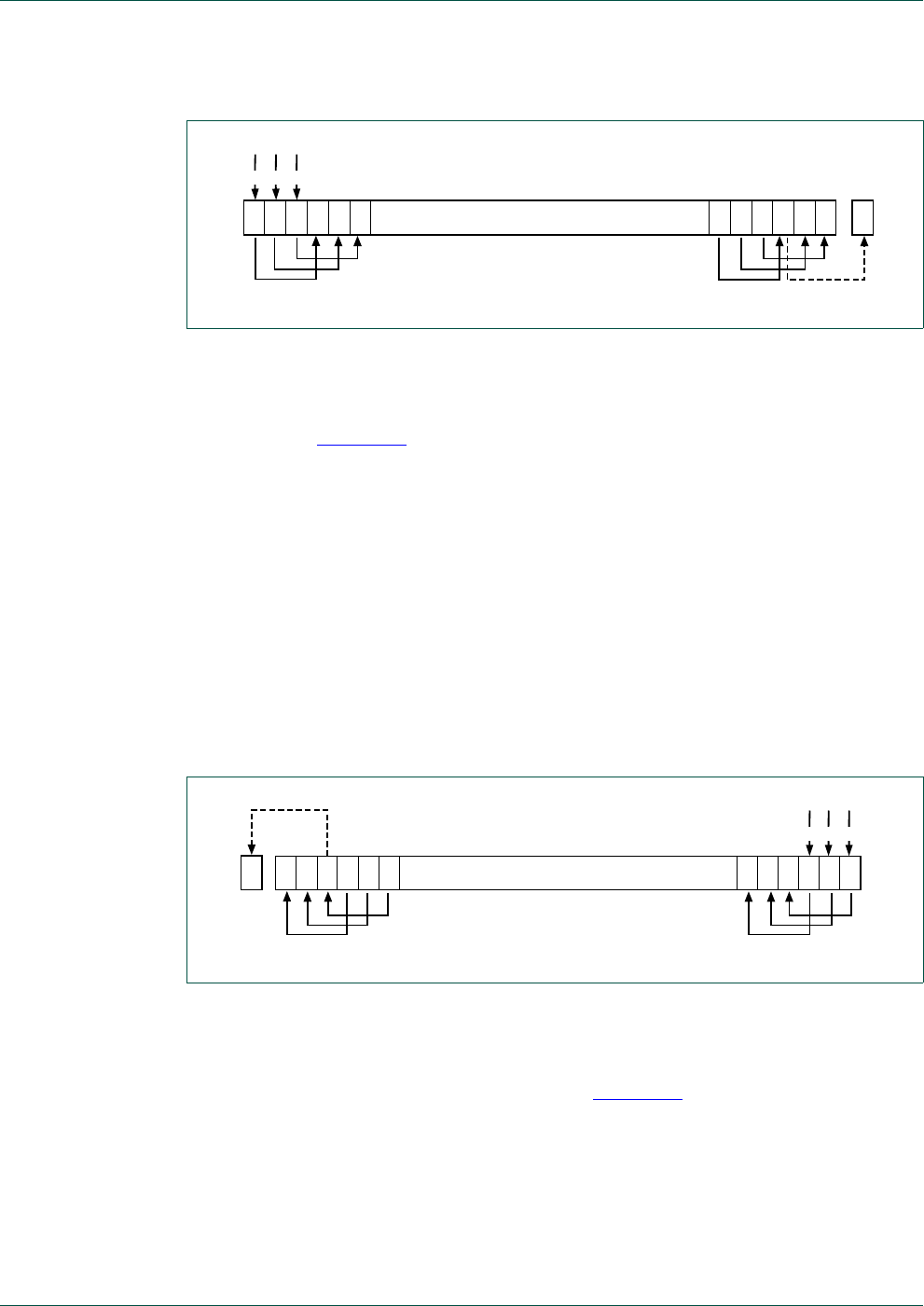
UM10360 All information provided in this document is subject to legal disclaimers. © NXP B.V. 2014. All rights reserved.
User manual Rev. 3.1 — 2 April 2014 664 of 849
NXP Semiconductors UM10360
Chapter 34: Appendix: Cortex-M3 user guide
•If n is 33 or more and the carry flag is updated, it is updated to 0.
34.2.3.4.3 LSL
Logical shift left by n bits moves the right-hand
32
-n bits of the register Rm, to the left by n
places, into the left-hand
32
-n bits of the result. And it sets the right-hand n bits of the
result to 0. See Figure 144.
You can use he LSL #n operation to multiply the value in the register Rm by 2n, if the value
is regarded as an unsigned integer or a two’s complement signed integer. Overflow can
occur without warning.
When the instruction is
LSLS
or when LSL #n, with non-zero n, is used in Operand2 with
the instructions
MOVS
,
MVNS
,
ANDS
,
ORRS
,
ORNS
,
EORS
,
BICS
,
TEQ
or
TST
, the carry flag is updated
to the last bit shifted out, bit[
32
-n], of the register Rm. These instructions do not affect the
carry flag when used with LSL #0.
Note
•If n is 32 or more, then all the bits in the result are cleared to 0.
•If n is 33 or more and the carry flag is updated, it is updated to 0.
34.2.3.4.4 ROR
Rotate right by n bits moves the left-hand
32
-n bits of the register Rm, to the right by n
places, into the right-hand
32
-n bits of the result. And it moves the right-hand n bits of the
register into the left-hand n bits of the result. See Figure 145.
When the instruction is
RORS
or when ROR #n is used in Operand2 with the instructions
MOVS
,
MVNS
,
ANDS
,
ORRS
,
ORNS
,
EORS
,
BICS
,
TEQ
or
TST
, the carry flag is updated to the last bit
rotation, bit[n-1], of the register Rm.
Note
Fig 143. LSR#3
&DUU\
)ODJ
Fig 144. LSL#3
&DUU\
)ODJ
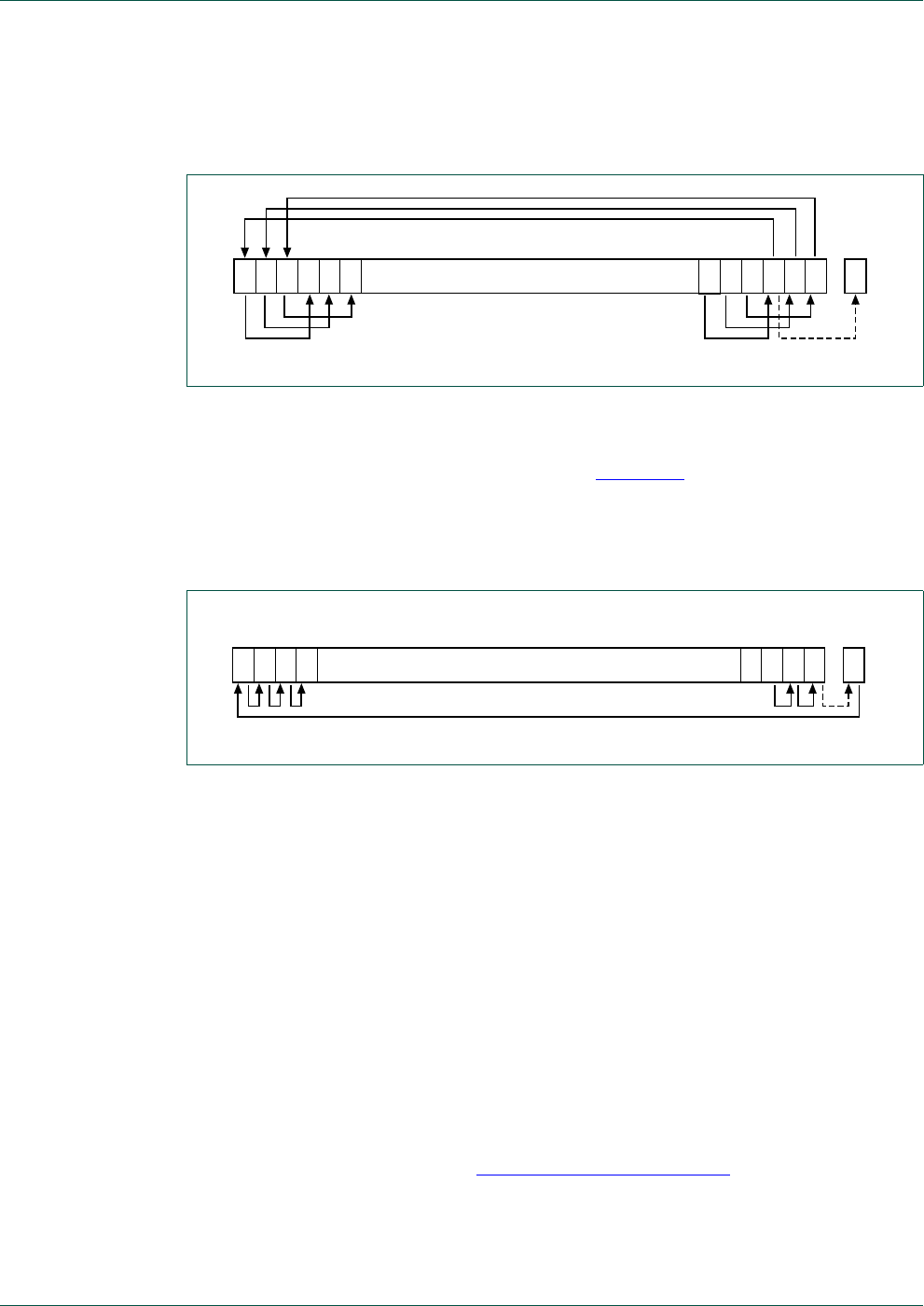
UM10360 All information provided in this document is subject to legal disclaimers. © NXP B.V. 2014. All rights reserved.
User manual Rev. 3.1 — 2 April 2014 665 of 849
NXP Semiconductors UM10360
Chapter 34: Appendix: Cortex-M3 user guide
•If n is 32, then the value of the result is same as the value in Rm, and if the carry flag
is updated, it is updated to bit[31] of Rm.
•
ROR
with shift length, n, more than 32 is the same as
ROR
with shift length n-32.
34.2.3.4.5 RRX
Rotate right with extend moves the bits of the register Rm to the right by one bit. And it
copies the carry flag into bit[31] of the result. See Figure 146.
When the instruction is
RRXS
or when RRX is used in Operand2 with the instructions
MOVS
,
MVNS
,
ANDS
,
ORRS
,
ORNS
,
EORS
,
BICS
,
TEQ
or
TST
, the carry flag is updated to bit[0] of the register
Rm.
34.2.3.5 Address alignment
An aligned access is an operation where a word-aligned address is used for a word, dual
word, or multiple word access, or where a halfword-aligned address is used for a halfword
access. Byte accesses are always aligned.
The Cortex-M3 processor supports unaligned access only for the following instructions:
•
LDR
,
LDRT
•
LDRH
,
LDRHT
•
LDRSH
,
LDRSHT
•
STR
,
STRT
•
STRH
,
STRHT
All other load and store instructions generate a usage fault exception if they perform an
unaligned access, and therefore their accesses must be address aligned. For more
information about usage faults see Section 34.3.4 “Fault handling”.
Unaligned accesses are usually slower than aligned accesses. In addition, some memory
regions might not support unaligned accesses. Therefore, ARM recommends that
programmers ensure that accesses are aligned. To avoid accidental generation of
Fig 145. ROR#3
&DUU\
)ODJ
Fig 146. RRX
&DUU\
)ODJ

UM10360 All information provided in this document is subject to legal disclaimers. © NXP B.V. 2014. All rights reserved.
User manual Rev. 3.1 — 2 April 2014 666 of 849
NXP Semiconductors UM10360
Chapter 34: Appendix: Cortex-M3 user guide
unaligned accesses, use the UNALIGN_TRP bit in the Configuration and Control Register
to trap all unaligned accesses, see Section 34.4.3.8 “Configuration and Control Register”.
34.2.3.6 PC-relative expressions
A PC-relative expression or label is a symbol that represents the address of an instruction
or literal data. It is represented in the instruction as the PC value plus or minus a numeric
offset. The assembler calculates the required offset from the label and the address of the
current instruction. If the offset is too big, the assembler produces an error.
Note
•For
B
,
BL
,
CBNZ
, and
CBZ
instructions, the value of the PC is the address of the current
instruction plus 4 bytes.
•For all other instructions that use labels, the value of the PC is the address of the
current instruction plus 4 bytes, with bit[1] of the result cleared to 0 to make it
word-aligned.
•Your assembler might permit other syntaxes for PC-relative expressions, such as a
label plus or minus a number, or an expression of the form
[PC, #number]
.
34.2.3.7 Conditional execution
Most data processing instructions can optionally update the condition flags in the
Application Program Status Register (APSR) according to the result of the operation,
see Section 34.3.1.3.5 “Program Status Register”. Some instructions update all flags, and
some only update a subset. If a flag is not updated, the original value is preserved. See
the instruction descriptions for the flags they affect.
You can execute an instruction conditionally, base d on the condition flags set in another
instruction, either:
•immediately after the instruction that updated the flags
•after any number of intervening instructions that have not updated the flags.
Conditional execution is available by using conditional branches or by adding condition
code suffixes to instructions. See Tab l e 6 1 6 for a list of the suffixes to add to instructions
to make them conditional instructions. The condition code suffix enables the processor to
test a condition based on the flags. If the condition test of a conditional instruction fails,
the instruction:
•does not execute
•does not write any value to its destination register
•does not affect any of the flags
•does not generate any exception.
Conditional instructions, except for conditional branches, must be inside an If-Then
instruction block. See Section 34.2.9.3 for more information and restrictions when using
the
IT
instruction. Depending on the vendor, the assembler might automatically insert an
IT
instruction if you have conditional instructions outside the IT block.
Use the
CBZ
and
CBNZ
instructions to compare the value of a register against zero and
branch on the result.

UM10360 All information provided in this document is subject to legal disclaimers. © NXP B.V. 2014. All rights reserved.
User manual Rev. 3.1 — 2 April 2014 667 of 849
NXP Semiconductors UM10360
Chapter 34: Appendix: Cortex-M3 user guide
This section describes:
•Section 34.2.3.7.1 “The condition flags”
•Section 34.2.3.7.2 “Condition code suffixes”.
34.2.3.7.1 The condition flags
The APSR contains the following condition flags:
N — Set to 1 when the result of the operation was negative, cleared to 0 otherwise.
Z — Set to 1 when the result of the operation was zero, cleared to 0 otherwise.
C — Set to 1 when the operation resulted in a carry, cleared to 0 otherwise.
V — Set to 1 when the operation caused overflow, cleared to 0 otherwise.
For more information about the APSR see Section 34.3.1.3.5 “Program Status Register”.
A carry occurs:
•if the result of an addition is greater than or equal to 232
•if the result of a subtraction is positive or zero
•as the result of an inline barrel shifter operation in a move or logical instruction.
Overflow occurs if the result of an add, subtract, or compare is greater than or equal to
231, or less than –231.
Remark: Most instructions update the status flags only if the S suffix is specified. See the
instruction descriptions for more information.
34.2.3.7.2 Condition code suffixes
The instructions that can be conditional have an optional condition code, shown in syntax
descriptions as {cond}. Conditional execution requires a preceding
IT
instruction. An
instruction with a condition code is only executed if the condition code flags in the APSR
meet the specified condition. Tab l e 6 1 6 shows the condition codes to use.
You can use conditional execution with the
IT
instruction to reduce the number of branch
instructions in code.
Tab l e 6 16 also shows the relationship between condition code suffixes and the N, Z, C,
and V flags.
Table 616. Condition code suffixes
Suffix Flags Meaning
EQ
Z = 1 Equal
NE
Z = 0 Not equal
CS or HS
C = 1 Higher or same, unsigned
CC or LO
C = 0 Lower, unsigned <
MI
N = 1 Negative
PL
N = 0 Positive or zero
VS
V = 1 Overflow
VC
V = 0 No overflow

UM10360 All information provided in this document is subject to legal disclaimers. © NXP B.V. 2014. All rights reserved.
User manual Rev. 3.1 — 2 April 2014 668 of 849
NXP Semiconductors UM10360
Chapter 34: Appendix: Cortex-M3 user guide
Section shows the use of a conditional instruction to find the absolute value of a number.
R0 = ABS(R1).
Section shows the use of conditional instructions to update the value of R4 if the signed
values R0 is greater than R1 and R2 is greater than R3.
Example: Absolute value:
MOVS R0, R1 ; R0 = R1, setting flags
IT MI ; IT instruction for the negative condition
RSBMI R0, R1, #0 ; If negative, R0 = -R1
Example: Compare and update value:
CMP R0, R1 ; Compare R0 and R1,
setting flags
ITT GT ; IT instruction for the two GT conditions
CMPGT R2, R3 ; If 'greater than', compare R2 and R3, setting flags
MOVGT R4, R5 ; If still 'greater than', do R4 = R5
34.2.3.8 Instruction width selection
There are many instructions that can generate either a 16-bit encoding or a 32-bit
encoding depending on the operands and destination register specified. For some of
these instructions, you can force a specific instruction size by using an instruction width
suffix. The
.W
suffix forces a 32-bit instruction encoding. The
.N
suffix forces a 16-bit
instruction encoding.
If you specify an instruction width suffix and the assembler cannot generate an instruction
encoding of the requested width, it generates an error.
Remark: In some cases it might be necessary to specify the
.W
suffix, for example if the
operand is the label of an instruction or literal data, as in the case of branch instructions.
This is because the assembler might not automatically generate the right size encoding.
To use an instruction width suffix, place it immediately after the instruction mnemonic and
condition code, if any. Section 34.2.3.8.1 shows instructions with the instruction width
suffix.
34.2.3.8.1 Example: Instruction width selection
BCS.W label ; creates a 32-bit instruction even for a short branch
ADDS.W R0, R0, R1 ; creates a 32-bit instruction even though the same
; operation can be done by a 16-bit instruction
HI
C = 1 and Z = 0 Higher, unsigned >
LS
C = 0 or Z = 1 Lower or same, unsigned
GE
N = V Greater than or equal, signed
LT
N = V Less than, signed <
GT
Z = 0 and N = V Greater than, signed >
LE
Z = 1 and N = V Less than or equal, signed
AL
Can have any
value
Always. This is the default when no suffix is specified.
Table 616. Condition code suffixes
Suffix Flags Meaning

UM10360 All information provided in this document is subject to legal disclaimers. © NXP B.V. 2014. All rights reserved.
User manual Rev. 3.1 — 2 April 2014 669 of 849
NXP Semiconductors UM10360
Chapter 34: Appendix: Cortex-M3 user guide
34.2.4 Memory access instructions
Tab l e 6 17 shows the memory access instructions:
Table 617. Memory access instructions
Mnemonic Brief description See
ADR
Load PC-relative address Section 34.2.4.1
CLREX
Clear Exclusive Section 34.2.4.9
LDM{mode}
Load Multiple registers Section 34.2.4.6
LDR{type}
Load Register using immediate offset Section 34.2.4.2
LDR{type}
Load Register using register offset Section 34.2.4.3
LDR{type}T
Load Register with unprivileged access Section 34.2.4.4
LDR
Load Register using PC-relative address Section 34.2.4.5
LDREX{type}
Load Register Exclusive Section 34.2.4.8
POP
Pop registers from stack Section 34.2.4.7
PUSH
Push registers onto stack Section 34.2.4.7
STM{mode}
Store Multiple registers Section 34.2.4.6
STR{type}
Store Register using immediate offset Section 34.2.4.2
STR{type}
Store Register using register offset Section 34.2.4.3
STR{type}T
Store Register with unprivileged access Section 34.2.4.4
STREX{type}
Store Register Exclusive Section 34.2.4.8

UM10360 All information provided in this document is subject to legal disclaimers. © NXP B.V. 2014. All rights reserved.
User manual Rev. 3.1 — 2 April 2014 670 of 849
NXP Semiconductors UM10360
Chapter 34: Appendix: Cortex-M3 user guide
34.2.4.1 ADR
Load PC-relative address.
34.2.4.1.1 Syntax
ADR
{cond} Rd, label
where:
cond is an optional condition code, see Section 34.2.3.7 “Conditional execution”.
Rd is the destination register.
label is a PC-relative expression. See Section 34.2.3.6 “PC-relative expressions”.
34.2.4.1.2 Operation
ADR
determines the address by adding an immediate value to the PC, and writes the result
to the destination register.
ADR
produces position-independent code, because the address is PC-relative.
If you use
ADR
to generate a target address for a
BX
or
BLX
instruction, you must ensure that
bit[0] of the address you generate is set to1 for correct execution.
Values of label must be within the range of 4095 to +4095 from the address in the PC.
Remark: You might have to use the
.W
suffix to get the maximum offset range or to
generate addresses that are not word-aligned. See Section 34.2.3.8 “Instruction width
selection”.
34.2.4.1.3 Restrictions
Rd must not be SP and must not be PC.
34.2.4.1.4 Condition flags
This instruction does not change the flags.
34.2.4.1.5 Examples
ADR R1, TextMessage ; Write address value of a location labelled as
; TextMessage to R1

UM10360 All information provided in this document is subject to legal disclaimers. © NXP B.V. 2014. All rights reserved.
User manual Rev. 3.1 — 2 April 2014 671 of 849
NXP Semiconductors UM10360
Chapter 34: Appendix: Cortex-M3 user guide
34.2.4.2 LDR and STR, immediate offset
Load and Store with immediate offset, pre-indexed immediate offset, or post-indexed
immediate offset.
34.2.4.2.1 Syntax
op{type}{cond} Rt, [Rn {, #offset}] ; immediate offset
op{type}{cond} Rt, [Rn, #offset]! ; pre-indexed
op{type}{cond} Rt, [Rn], #offset ; post-indexed
opD{cond} Rt, Rt2, [Rn {, #offset}] ; immediate offset, two words
opD{cond} Rt, Rt2, [Rn, #offset]! ; pre-indexed, two words
opD{cond} Rt, Rt2, [Rn], #offset ; post-indexed, two words
where:
op is one of:
LDR
: Load register.
STR
: Store register.
type is one of:
B
: unsigned byte, zero extend to 32 bits on loads.
SB
: signed byte, sign extend to 32 bits (
LDR
only).
H
: unsigned halfword, zero extend to 32 bits on loads.
SH
: signed halfword, sign extend to 32 bits (
LDR
only).
—: omit, for word.
cond is an optional condition code, see Section 34.2.3.7 “Conditional execution”.
Rt is the register to load or store.
Rn is the register on which the memory address is based.
offset is an offset from Rn. If offset is omitted, the address is the contents of Rn.
Rt2 is the additional register to load or store for two-word operations.
34.2.4.2.2 Operation
LDR
instructions load one or two registers with a value from memory.
STR
instructions store one or two register values to memory.
Load and store instructions with immediate offset can use the following addressing
modes:
•Offset addressing
The offset value is added to or subtracted from the address obtained from the register
Rn. The result is used as the address for the memory access. The register Rn is
unaltered. The assembly language syntax for this mode is:

UM10360 All information provided in this document is subject to legal disclaimers. © NXP B.V. 2014. All rights reserved.
User manual Rev. 3.1 — 2 April 2014 672 of 849
NXP Semiconductors UM10360
Chapter 34: Appendix: Cortex-M3 user guide
[Rn, #offset]
•Pre-indexed addressing
The offset value is added to or subtracted from the address obtained from the register
Rn. The result is used as the address for the memory access and written back into the
register Rn. The assembly language syntax for this mode is:
[Rn, #offset]!
•Post-indexed addressing
The address obtained from the register Rn is used as the address for the memory
access. The offset value is added to or subtracted from the address, and written back
into the register Rn. The assembly language syntax for this mode is:
[Rn], #offset
The value to load or store can be a byte, halfword, word, or two words. Bytes and
halfwords can either be signed or unsigned. See Section 34.2.3.5 “Address alignment”.
Tab l e 6 18 shows the ranges of offset for immediate, pre-indexed and post-indexed forms.
34.2.4.2.3 Restrictions
For load instructions:
•Rt can be SP or PC for word loads only
•Rt must be different from Rt2 for two-word loads
•Rn must be different from Rt and Rt2 in the pre-indexed or post-indexed forms.
When Rt is PC in a word load instruction:
•bit[0] of the loaded value must be 1 for correct execution
•a branch occurs to the address created by changing bit[0] of the loaded value to 0
•if the instruction is conditional, it must be the last instruction in the IT block.
For store instructions:
•Rt can be SP for word stores only
•Rt must not be PC
•Rn must not be PC
•Rn must be different from Rt and Rt2 in the pre-indexed or post-indexed forms.
34.2.4.2.4 Condition flags
These instructions do not change the flags.
Table 618. Offset ranges
Instruction type Immediate offset Pre-indexed Post-indexed
Word, halfword, signed
halfword, byte, or
signed byte
255 to 4095 255 to 255 255 to 255
Two words multiple of 4 in the
range 1020 to 1020
multiple of 4 in the
range -1020 to 1020
multiple of 4 in the
range 1020 to 1020

UM10360 All information provided in this document is subject to legal disclaimers. © NXP B.V. 2014. All rights reserved.
User manual Rev. 3.1 — 2 April 2014 673 of 849
NXP Semiconductors UM10360
Chapter 34: Appendix: Cortex-M3 user guide
34.2.4.2.5 Examples
LDR R8, [R10] ; Loads R8 from the address in R10.
LDRNE R2, [R5, #960]! ; Loads (conditionally) R2 from a word
; 960 bytes above the address in R5, and
; increments R5 by 960.
STR R2, [R9,#const-struc] ; const-struc is an expression evaluating
; to a constant in the range 0-4095.
STRH R3, [R4], #4 ; Store R3 as halfword data into address in
; R4, then increment R4 by 4
LDRD R8, R9, [R3, #0x20] ; Load R8 from a word 32 bytes above the
; address in R3, and load R9 from a word 36
; bytes above the address in R3
STRD R0, R1, [R8], #-16 ; Store R0 to address in R8, and store R1 to
; a word 4 bytes above the address in R8,
; and then decrement R8 by 16.

UM10360 All information provided in this document is subject to legal disclaimers. © NXP B.V. 2014. All rights reserved.
User manual Rev. 3.1 — 2 April 2014 674 of 849
NXP Semiconductors UM10360
Chapter 34: Appendix: Cortex-M3 user guide
34.2.4.3 LDR and STR, register offset
Load and Store with register offset.
34.2.4.3.1 Syntax
op{type}{cond} Rt, [Rn, Rm {, LSL #n}]
where:
op is one of:
LDR
: Load Register.
STR
: Store Register.
type is one of:
B
: unsigned byte, zero extend to 32 bits on loads.
SB
: signed byte, sign extend to 32 bits (
LDR
only).
H
: unsigned halfword, zero extend to 32 bits on loads.
SH
: signed halfword, sign extend to 32 bits (
LDR
only).
—: omit, for word.
cond is an optional condition code, see Section 34.2.3.7 “Conditional execution”.
Rt is the register to load or store.
Rn is the register on which the memory address is based.
Rm is a register containing a value to be used as the offset.
LSL
#n is an optional shift, with n in the range 0 to 3.
34.2.4.3.2 Operation
LDR
instructions load a register with a value from memory.
STR
instructions store a register value into memory.
The memory address to load from or store to is at an offset from the register Rn. The
offset is specified by the register Rm and can be shifted left by up to 3 bits using
LSL
.
The value to load or store can be a byte, halfword, or word. For load instructions, bytes
and halfwords can either be signed or unsigned. See Section 34.2.3.5 “Address
alignment”.
34.2.4.3.3 Restrictions
In these instructions:
•Rn must not be PC
•Rm must not be SP and must not be PC
•Rt can be SP only for word loads and word stores
•Rt can be PC only for word loads.
When Rt is PC in a word load instruction:

UM10360 All information provided in this document is subject to legal disclaimers. © NXP B.V. 2014. All rights reserved.
User manual Rev. 3.1 — 2 April 2014 675 of 849
NXP Semiconductors UM10360
Chapter 34: Appendix: Cortex-M3 user guide
•bit[0] of the loaded value must be 1 for correct execution, and a branch occurs to this
halfword-aligned address
•if the instruction is conditional, it must be the last instruction in the IT block.
34.2.4.3.4 Condition flags
These instructions do not change the flags.
34.2.4.3.5 Examples
STR R0, [R5, R1] ; Store value of R0 into an address equal to
; sum of R5 and R1
LDRSB R0, [R5, R1, LSL #1] ; Read byte value from an address equal to
; sum of R5 and two times R1, sign extended it
; to a word value and put it in R0
STR R0, [R1, R2, LSL #2] ; Stores R0 to an address equal to sum of R1
; and four times R2

UM10360 All information provided in this document is subject to legal disclaimers. © NXP B.V. 2014. All rights reserved.
User manual Rev. 3.1 — 2 April 2014 676 of 849
NXP Semiconductors UM10360
Chapter 34: Appendix: Cortex-M3 user guide
34.2.4.4 LDR and STR, unprivileged
Load and Store with unprivileged access.
34.2.4.4.1 Syntax
op{type}T{cond} Rt, [Rn {, #offset}] ; immediate offset
where:
op is one of:
LDR
: Load Register.
STR
: Store Register.
type is one of:
B
: unsigned byte, zero extend to 32 bits on loads.
SB
: signed byte, sign extend to 32 bits (
LDR
only).
H
: unsigned halfword, zero extend to 32 bits on loads.
SH
: signed halfword, sign extend to 32 bits (
LDR
only).
—: omit, for word.
cond is an optional condition code, see Section 34.2.3.7 “Conditional execution”.
Rt is the register to load or store.
Rn is the register on which the memory address is based.
offset is an offset from Rn and can be 0 to 255. If offset is omitted, the address is the value
in Rn.
34.2.4.4.2 Operation
These load and store instructions perform the same function as the memory access
instructions with immediate offset, see Section 34.2.4.2. The difference is that these
instructions have only unprivileged access even when used in privileged software.
When used in unprivileged software, these instructions behave in exactly the same way
as normal memory access instructions with immediate offset.
34.2.4.4.3 Restrictions
In these instructions:
•Rn must not be PC
•Rt must not be SP and must not be PC.
34.2.4.4.4 Condition flags
These instructions do not change the flags.

UM10360 All information provided in this document is subject to legal disclaimers. © NXP B.V. 2014. All rights reserved.
User manual Rev. 3.1 — 2 April 2014 677 of 849
NXP Semiconductors UM10360
Chapter 34: Appendix: Cortex-M3 user guide
34.2.4.4.5 Examples
STRBTEQ R4, [R7] ; Conditionally store least significant byte in
; R4 to an address in R7, with unprivileged access
LDRHT R2, [R2, #8] ; Load halfword value from an address equal to
; sum of R2 and 8 into R2, with unprivileged access

UM10360 All information provided in this document is subject to legal disclaimers. © NXP B.V. 2014. All rights reserved.
User manual Rev. 3.1 — 2 April 2014 678 of 849
NXP Semiconductors UM10360
Chapter 34: Appendix: Cortex-M3 user guide
34.2.4.5 LDR, PC-relative
Load register from memory.
34.2.4.5.1 Syntax
LDR{type}{cond} Rt, label
LDRD{cond} Rt, Rt2, label ; Load two words
type is one of:
B
: unsigned byte, zero extend to 32 bits on loads.
SB
: signed byte, sign extend to 32 bits (
LDR
only).
H
: unsigned halfword, zero extend to 32 bits on loads.
SH
: signed halfword, sign extend to 32 bits (
LDR
only).
—: omit, for word.
cond is an optional condition code, see Section 34.2.3.7 “Conditional execution”.
Rt is the register to load or store.
Rt2 is the second register to load or store.
label is a PC-relative expression. See Section 34.2.3.6 “PC-relative expressions”.
34.2.4.5.2 Operation
LDR
loads a register with a value from a PC-relative memory address. The memory
address is specified by a label or by an offset from the PC.
The value to load or store can be a byte, halfword, or word. For load instructions, bytes
and halfwords can either be signed or unsigned. See Section 34.2.3.5 “Address
alignment”.
label must be within a limited range of the current instruction. Tab l e 6 1 9 shows the
possible offsets between label and the PC.
Remark: You might have to use the
.W
suffix to get the maximum offset range. See
Section 34.2.3.8 “Instruction width selection”.
34.2.4.5.3 Restrictions
In these instructions:
•Rt can be SP or PC only for word loads
•Rt2 must not be SP and must not be PC
•Rt must be different from Rt2.
When Rt is PC in a word load instruction:
Table 619. Offset ranges
Instruction type Offset range
Word, halfword, signed halfword, byte, signed byte 4095 to 4095
Two words 1020 to 1020

UM10360 All information provided in this document is subject to legal disclaimers. © NXP B.V. 2014. All rights reserved.
User manual Rev. 3.1 — 2 April 2014 679 of 849
NXP Semiconductors UM10360
Chapter 34: Appendix: Cortex-M3 user guide
•bit[0] of the loaded value must be 1 for correct execution, and a branch occurs to this
halfword-aligned address
•if the instruction is conditional, it must be the last instruction in the IT block.
34.2.4.5.4 Condition flags
These instructions do not change the flags.
34.2.4.5.5 Examples
LDR R0, LookUpTable ; Load R0 with a word of data from an address
; labelled as LookUpTable
LDRSB R7, localdata ; Load a byte value from an address labelled
; as localdata, sign extend it to a word
; value, and put it in R7

UM10360 All information provided in this document is subject to legal disclaimers. © NXP B.V. 2014. All rights reserved.
User manual Rev. 3.1 — 2 April 2014 680 of 849
NXP Semiconductors UM10360
Chapter 34: Appendix: Cortex-M3 user guide
34.2.4.6 LDM and STM
Load and Store Multiple registers.
34.2.4.6.1 Syntax
op{addr_mode}{cond} Rn{!}, reglist
where:
op is one of:
LDM
: Load Multiple registers.
STM
: Store Multiple registers.
addr_mode is any one of the following:
IA
: Increment address After each access. This is the default.
DB
: Decrement address Before each access.
cond is an optional condition code, see Section 34.2.3.7 “Conditional execution”.
Rn is the register on which the memory addresses are based.
! is an optional writeback suffix. If ! is present the final address, that is loaded from or
stored to, is written back into Rn.
reglist is a list of one or more registers to be loaded or stored, enclosed in braces. It can
contain register ranges. It must be comma separated if it contains more than one register
or register range, see Section 34.2.4.6.5.
LDM
and
LDMFD
are synonyms for
LDMIA
.
LDMFD
refers to its use for popping data from Full
Descending stacks.
LDMEA
is a synonym for
LDMDB
, and refers to its use for popping data from Empty Ascending
stacks.
STM
and
STMEA
are synonyms for
STMIA
.
STMEA
refers to its use for pushing data onto Empty
Ascending stacks.
STMFD
is s synonym for
STMDB
, and refers to its use for pushing data onto Full Descending
stacks
34.2.4.6.2 Operation
LDM
instructions load the registers in reglist with word values from memory addresses
based on Rn.
STM
instructions store the word values in the registers in reglist to memory addresses
based on Rn.
For
LDM
,
LDMIA
,
LDMFD
,
STM
,
STMIA
, and
STMEA
the memory addresses used for the accesses
are at 4-byte intervals ranging from Rn to Rn + 4 * (n-1), where n is the number of
registers in reglist. The accesses happens in order of increasing register numbers, with
the lowest numbered register using the lowest memory address and the highest number
register using the highest memory address. If the writeback suffix is specified, the value of
Rn + 4 * (n-1) is written back to Rn.

UM10360 All information provided in this document is subject to legal disclaimers. © NXP B.V. 2014. All rights reserved.
User manual Rev. 3.1 — 2 April 2014 681 of 849
NXP Semiconductors UM10360
Chapter 34: Appendix: Cortex-M3 user guide
For
LDMDB
,
LDMEA
,
STMDB
, and
STMFD
the memory addresses used for the accesses are at
4-byte intervals ranging from Rn to Rn - 4 * (n-1), where n is the number of registers in
reglist. The accesses happen in order of decreasing register numbers, with the highest
numbered register using the highest memory address and the lowest number register
using the lowest memory address. If the writeback suffix is specified, the value of
Rn - 4 * (n-1) is written back to Rn.
The
PUSH
and
POP
instructions can be expressed in this form. See Section 34.2.4.7 for
details.
34.2.4.6.3 Restrictions
In these instructions:
•Rn must not be PC
•reglist must not contain SP
•in any
STM
instruction, reglist must not contain PC
•in any
LDM
instruction, reglist must not contain PC if it contains LR
•reglist must not contain Rn if you specify the writeback suffix.
When PC is in reglist in an
LDM
instruction:
•bit[0] of the value loaded to the PC must be 1 for correct execution, and a branch
occurs to this halfword-aligned address
•if the instruction is conditional, it must be the last instruction in the IT block.
34.2.4.6.4 Condition flags
These instructions do not change the flags.
34.2.4.6.5 Examples
LDM R8,{R0,R2,R9} ; LDMIA is a synonym for LDM
STMDB R1!,{R3-R6,R11,R12}
34.2.4.6.6 Incorrect examples
STM R5!,{R5,R4,R9} ; Value stored for R5 is unpredictable
LDM R2, {} ; There must be at least one register in the list

UM10360 All information provided in this document is subject to legal disclaimers. © NXP B.V. 2014. All rights reserved.
User manual Rev. 3.1 — 2 April 2014 682 of 849
NXP Semiconductors UM10360
Chapter 34: Appendix: Cortex-M3 user guide
34.2.4.7 PUSH and POP
Push registers onto, and pop registers off a full-descending stack.
34.2.4.7.1 Syntax
PUSH
{cond} reglist
POP
{cond} reglist
where:
cond is an optional condition code, see Section 34.2.3.7 “Conditional execution”.
reglist is a non-empty list of registers, enclosed in braces. It can contain register ranges. It
must be comma separated if it contains more than one register or register range.
PUSH
and
POP
are synonyms for
STMDB
and
LDM
(or
LDMIA
) with the memory addresses for the
access based on SP, and with the final address for the access written back to the SP.
PUSH
and
POP
are the preferred mnemonics in these cases.
34.2.4.7.2 Operation
PUSH
stores registers on the stack in order of decreasing the register numbers, with the
highest numbered register using the highest memory address and the lowest numbered
register using the lowest memory address.
POP
loads registers from the stack in order of increasing register numbers, with the lowest
numbered register using the lowest memory address and the highest numbered register
using the highest memory address.
See Section 34.2.4.6 for more information.
34.2.4.7.3 Restrictions
In these instructions:
•reglist must not contain SP
•for the
PUSH
instruction, reglist must not contain PC
•for the
POP
instruction, reglist must not contain PC if it contains LR.
When PC is in reglist in a
POP
instruction:
•bit[0] of the value loaded to the PC must be 1 for correct execution, and a branch
occurs to this halfword-aligned address
•if the instruction is conditional, it must be the last instruction in the IT block.
34.2.4.7.4 Condition flags
These instructions do not change the flags.
34.2.4.7.5 Examples
PUSH {R0,R4-R7}
PUSH {R2,LR}
POP {R0,R10,PC}

UM10360 All information provided in this document is subject to legal disclaimers. © NXP B.V. 2014. All rights reserved.
User manual Rev. 3.1 — 2 April 2014 683 of 849
NXP Semiconductors UM10360
Chapter 34: Appendix: Cortex-M3 user guide
34.2.4.8 LDREX and STREX
Load and Store Register Exclusive.
34.2.4.8.1 Syntax
LDREX{cond} Rt, [Rn {, #offset}]
STREX{cond} Rd, Rt, [Rn {, #offset}]
LDREXB{cond} Rt, [Rn]
STREXB{cond} Rd, Rt, [Rn]
LDREXH{cond} Rt, [Rn]
STREXH{cond} Rd, Rt, [Rn]
where:
cond is an optional condition code, see Section 34.2.3.7 “Conditional execution”.
Rd is the destination register for the returned status.
Rt is the register to load or store.
Rn is the register on which the memory address is based.
offset is an optional offset applied to the value in Rn. If offset is omitted, the address is the
value in Rn.
34.2.4.8.2 Operation
LDREX
,
LDREXB
, and
LDREXH
load a word, byte, and halfword respectively from a memory
address.
STREX
,
STREXB
, and
STREXH
attempt to store a word, byte, and halfword respectively to a
memory address. The address used in any Store-Exclusive instruction must be the same
as the address in the most recently executed Load-exclusive instruction. The value stored
by the Store-Exclusive instruction must also have the same data size as the value loaded
by the preceding Load-exclusive instruction. This means software must always use a
Load-exclusive instruction and a matching Store-Exclusive instruction to perform a
synchronization operation, see Section 34.3.2.7 “Synchronization primitives”
If an Store-Exclusive instruction performs the store, it writes 0 to its destination register. If
it does not perform the store, it writes 1 to its destination register. If the Store-Exclusive
instruction writes 0 to the destination register, it is guaranteed that no other process in the
system has accessed the memory location between the Load-exclusive and
Store-Exclusive instructions.
For reasons of performance, keep the number of instructions between corresponding
Load-Exclusive and Store-Exclusive instruction to a minimum.
Remark: The result of executing a Store-Exclusive instruction to an address that is
different from that used in the preceding Load-Exclusive instruction is unpredictable.
34.2.4.8.3 Restrictions
In these instructions:

UM10360 All information provided in this document is subject to legal disclaimers. © NXP B.V. 2014. All rights reserved.
User manual Rev. 3.1 — 2 April 2014 684 of 849
NXP Semiconductors UM10360
Chapter 34: Appendix: Cortex-M3 user guide
•do not use PC
•do not use SP for Rd and Rt
•for
STREX
, Rd must be different from both Rt and Rn
•the value of offset must be a multiple of four in the range 0-1020.
34.2.4.8.4 Condition flags
These instructions do not change the flags.
34.2.4.8.5 Examples
MOV R1, #0x1 ; Initialize the ‘lock taken’ value
try
LDREX R0, [LockAddr] ; Load the lock value
CMP R0, #0 ; Is the lock free?
ITT EQ ; IT instruction for STREXEQ and CMPEQ
STREXEQ R0, R1, [LockAddr] ; Try and claim the lock
CMPEQ R0, #0 ; Did this succeed?
BNE try ; No – try again
.... ; Yes – we have the lock

UM10360 All information provided in this document is subject to legal disclaimers. © NXP B.V. 2014. All rights reserved.
User manual Rev. 3.1 — 2 April 2014 685 of 849
NXP Semiconductors UM10360
Chapter 34: Appendix: Cortex-M3 user guide
34.2.4.9 CLREX
Clear Exclusive.
34.2.4.9.1 Syntax
CLREX{cond}
where:
cond is an optional condition code, see Section 34.2.3.7 “Conditional execution”.
34.2.4.9.2 Operation
Use
CLREX
to make the next
STREX
,
STREXB
, or
STREXH
instruction write 1 to its destination
register and fail to perform the store. It is useful in exception handler code to force the
failure of the store exclusive if the exception occurs between a load exclusive instruction
and the matching store exclusive instruction in a synchronization operation.
See Section 34.3.2.7 “Synchronization primitives” for more information.
34.2.4.9.3 Condition flags
These instructions do not change the flags.
34.2.4.9.4 Examples
CLREX

UM10360 All information provided in this document is subject to legal disclaimers. © NXP B.V. 2014. All rights reserved.
User manual Rev. 3.1 — 2 April 2014 686 of 849
NXP Semiconductors UM10360
Chapter 34: Appendix: Cortex-M3 user guide
34.2.5 General data processing instructions
Tab l e 6 20 shows the data processing instructions:
Table 620. Data processing instructions
Mnemonic Brief description See
ADC
Add with Carry Section 34.2.5.1
ADD
Add Section 34.2.5.1
ADDW
Add Section 34.2.5.1
AND
Logical AND Section 34.2.5.2
ASR
Arithmetic Shift Right Section 34.2.5.3
BIC
Bit Clear Section 34.2.5.2
CLZ
Count leading zeros Section 34.2.5.4
CMN
Compare Negative Section 34.2.5.5
CMP
Compare Section 34.2.5.5
EOR
Exclusive OR Section 34.2.5.2
LSL
Logical Shift Left Section 34.2.5.3
LSR
Logical Shift Right Section 34.2.5.3
MOV
Move Section 34.2.5.6
MOVT
Move Top Section 34.2.5.7
MOVW
Move 16-bit constant Section 34.2.5.6
MVN
Move NOT Section 34.2.5.6
ORN
Logical OR NOT Section 34.2.5.2
ORR
Logical OR Section 34.2.5.2
RBIT
Reverse Bits Section 34.2.5.8
REV
Reverse byte order in a word Section 34.2.5.8
REV16
Reverse byte order in each halfword Section 34.2.5.8
REVSH
Reverse byte order in bottom halfword and sign extend Section 34.2.5.8
ROR
Rotate Right Section 34.2.5.3
RRX
Rotate Right with Extend Section 34.2.5.3
RSB
Reverse Subtract Section 34.2.5.1
SBC
Subtract with Carry Section 34.2.5.1
SUB
Subtract Section 34.2.5.1
SUBW
Subtract Section 34.2.5.1
TEQ
Tes t Equ i v a len c e Section 34.2.5.9
TST
Tes t Section 34.2.5.9

UM10360 All information provided in this document is subject to legal disclaimers. © NXP B.V. 2014. All rights reserved.
User manual Rev. 3.1 — 2 April 2014 687 of 849
NXP Semiconductors UM10360
Chapter 34: Appendix: Cortex-M3 user guide
34.2.5.1 ADD, ADC, SUB, SBC, and RSB
Add, Add with carry, Subtract, Subtract with carry, and Reverse Subtract.
34.2.5.1.1 Syntax
op{S}{cond} {Rd,} Rn, Operand2
op{cond} {Rd,} Rn, #imm12 ; ADD and SUB only
where:
op is one of:
ADD:
Add.
ADC:
Add with Carry.
SUB:
Subtract.
RSB:
Reverse Subtract.
S: is an optional suffix. If S is specified, the condition code flags are updated on the result
of the operation, see Section 34.2.3.7 “Conditional execution”.
cond: is an optional condition code, see Section 34.2.3.7 “Conditional execution”.
Rd is the destination register. If Rd is omitted, the destination register is Rn.
Rn is the register holding the first operand.
Operand2 is a flexible second operand. See Section 34.2.3.3 for details of the options.
imm12 is any value in the range 0-4095.
34.2.5.1.2 Operation
The
ADD
instruction adds the value of Operand2 or imm12 to the value in Rn.
The
ADC
instruction adds the values in Rn and Operand2, together with the carry flag.
The
SUB
instruction subtracts the value of Operand2 or imm12 from the value in Rn.
The
SBC
instruction subtracts the value of Operand2 from the value in Rn. If the carry flag
is clear, the result is reduced by one.
The
RSB
instruction subtracts the value in Rn from the value of Operand2. This is useful
because of the wide range of options for Operand2.
Use
ADC
and
SBC
to synthesize multiword arithmetic, see Section 34.2.5.1.6.
See also Section 34.2.4.1.
Remark:
ADDW
is equivalent to the
ADD
syntax that uses the imm12 operand.
SUBW
is
equivalent to the
SUB
syntax that uses the imm12 operand.
34.2.5.1.3 Restrictions
•Operand2 must not be SP and must not be PC
•Rd can be SP only in
ADD
and
SUB
, and only with the additional restrictions:

UM10360 All information provided in this document is subject to legal disclaimers. © NXP B.V. 2014. All rights reserved.
User manual Rev. 3.1 — 2 April 2014 688 of 849
NXP Semiconductors UM10360
Chapter 34: Appendix: Cortex-M3 user guide
–Rn must also be SP
–any shift in Operand2 must be limited to a maximum of 3 bits using
LSL
•Rn can be SP only in
ADD
and
SUB
•Rd can be PC only in the cond instruction where:
–you must not specify the S suffix
–Rm must not be PC and must not be SP
–if the instruction is conditional, it must be the last instruction in the IT block
•with the exception of the cond instruction, Rn can be PC only in
ADD
and
SUB
, and only
with the additional restrictions:
–you must not specify the S suffix
–the second operand must be a constant in the range 0 to 4095.
Note
•When using the PC for an addition or a subtraction, bits[1:0] of the PC are rounded to
b00 before performing the calculation, making the base address for the calculation
word-aligned.
•If you want to generate the address of an instruction, you have to adjust the constant
based on the value of the PC. ARM recommends that you use the
ADR
instruction
instead of
ADD
or
SUB
with Rn equal to the PC, because your assembler automatically
calculates the correct constant for the
ADR
instruction.
When Rd is PC in the cond instruction:
•bit[0] of the value written to the PC is ignored
•a branch occurs to the address created by forcing bit[0] of that value to 0.
34.2.5.1.4 Condition flags
If S is specified, these instructions update the N, Z, C and V flags according to the result.
34.2.5.1.5 Examples
ADD R2, R1, R3
SUBS R8, R6, #240 ; Sets the flags on the result
RSB R4, R4, #1280 ; Subtracts contents of R4 from 1280
ADCHI R11, R0, R3 ; Only executed if C flag set and Z
; flag clear
34.2.5.1.6 Multiword arithmetic examples
Section shows two instructions that add a 64-bit integer contained in R2 and R3 to
another 64-bit integer contained in R0 and R1, and place the result in R4 and R5.
Multiword values do not have to use consecutive registers. Section shows instructions
that subtract a 96-bit integer contained in R9, R1, and R11 from another contained in R6,
R2, and R8. The example stores the result in R6, R9, and R2.
64-bit addition:
ADDS R4, R0, R2 ; add the least significant words
ADC R5, R1, R3 ; add the most significant words with carry

UM10360 All information provided in this document is subject to legal disclaimers. © NXP B.V. 2014. All rights reserved.
User manual Rev. 3.1 — 2 April 2014 689 of 849
NXP Semiconductors UM10360
Chapter 34: Appendix: Cortex-M3 user guide
96-bit subtraction:
SUBS R6, R6, R9 ; subtract the least significant words
SBCS R9, R2, R1 ; subtract the middle words with carry
SBC R2, R8, R11 ; subtract the most significant words with carry

UM10360 All information provided in this document is subject to legal disclaimers. © NXP B.V. 2014. All rights reserved.
User manual Rev. 3.1 — 2 April 2014 690 of 849
NXP Semiconductors UM10360
Chapter 34: Appendix: Cortex-M3 user guide
34.2.5.2 AND, ORR, EOR, BIC, and ORN
Logical AND, OR, Exclusive OR, Bit Clear, and OR NOT.
34.2.5.2.1 Syntax
op{S}{cond} {Rd,} Rn, Operand2
where:
op is one of:
AND:
logical AND.
ORR:
logical OR, or bit set.
EOR:
logical Exclusive OR.
BIC:
logical AND NOT, or bit clear.
ORN:
logical OR NOT.
S is an optional suffix. If S is specified, the condition code flags are updated on the result
of the operation, see Section 34.2.3.7 “Conditional execution”.
cond is an optional condition code, see Section 34.2.3.7 “Conditional execution”.
Rd is the destination register.
Rn is the register holding the first operand.
Operand2 is a flexible second operand. See Section 34.2.3.3 for details of the options.
34.2.5.2.2 Operation
The
AND
,
EOR
, and
ORR
instructions perform bitwise AND, Exclusive OR, and OR operations
on the values in Rn and Operand2.
The
BIC
instruction performs an AND operation on the bits in Rn with the complements of
the corresponding bits in the value of Operand2.
The
ORN
instruction performs an OR operation on the bits in Rn with the complements of
the corresponding bits in the value of Operand2.
34.2.5.2.3 Restrictions
Do not use SP and do not use PC.
34.2.5.2.4 Condition flags
If S is specified, these instructions:
•update the N and Z flags according to the result
•can update the C flag during the calculation of Operand2, see Section 34.2.3.3
•do not affect the V flag.
34.2.5.2.5 Examples
AND R9, R2, #0xFF00
ORREQ R2, R0, R5
ANDS R9, R8, #0x19

UM10360 All information provided in this document is subject to legal disclaimers. © NXP B.V. 2014. All rights reserved.
User manual Rev. 3.1 — 2 April 2014 691 of 849
NXP Semiconductors UM10360
Chapter 34: Appendix: Cortex-M3 user guide
EORS R7, R11, #0x18181818
BIC R0, R1, #0xab
ORN R7, R11, R14, ROR #4
ORNS R7, R11, R14, ASR #32

UM10360 All information provided in this document is subject to legal disclaimers. © NXP B.V. 2014. All rights reserved.
User manual Rev. 3.1 — 2 April 2014 692 of 849
NXP Semiconductors UM10360
Chapter 34: Appendix: Cortex-M3 user guide
34.2.5.3 ASR, LSL, LSR, ROR, and RRX
Arithmetic Shift Right, Logical Shift Left, Logical Shift Right, Rotate Right, and Rotate
Right with Extend.
34.2.5.3.1 Syntax
op{S}{cond} Rd, Rm, Rs
op{S}{cond} Rd, Rm, #n
RRX{S}{cond} Rd, Rm
where:
op is one of:
ASR:
Arithmetic Shift Right.
LSL:
Logical Shift Left.
LSR
: Logical Shift Right.
ROR:
Rotate Right.
S is an optional suffix. If S is specified, the condition code flags are updated on the result
of the operation, see Section 34.2.3.7 “Conditional execution”.
Rd is the destination register.
Rm is the register holding the shift length to apply to the value in Rm. Only the least
significant byte is used and can be in the range 0 to 255.
Rs s the register holding the shift length to apply to the value in Rm. Only the least
significant byte is used and can be in the range 0 to 255.
n is the shift length. The range of shift length depends on the instruction:
ASR:
shift length from 1 to 32
LSL:
shift length from 0 to 31
LSR:
shift length from 1 to 32
ROR:
shift length from 1 to 31
Remark:
MOV{S}{cond} Rd, Rm
is the preferred syntax for
LSL{S}{cond} Rd, Rm, #0
.
34.2.5.3.2 Operation
ASR
,
LSL
,
LSR
, and
ROR
move the bits in the register Rm to the left or right by the number of
places specified by constant n or register Rs.
RRX
moves the bits in register Rm to the right by 1.
In all these instructions, the result is written to Rd, but the value in register Rm remains
unchanged. For details on what result is generated by the different instructions, see
Section 34.2.3.4 “Shift Operations”.
34.2.5.3.3 Restrictions
Do not use SP and do not use PC.

UM10360 All information provided in this document is subject to legal disclaimers. © NXP B.V. 2014. All rights reserved.
User manual Rev. 3.1 — 2 April 2014 693 of 849
NXP Semiconductors UM10360
Chapter 34: Appendix: Cortex-M3 user guide
34.2.5.3.4 Condition flags
If S is specified:
•these instructions update the N and Z flags according to the result
•the C flag is updated to the last bit shifted out, except when the shift length is 0, see
Section 34.2.3.4 “Shift Operations”.
34.2.5.3.5 Examples
ASR R7, R8, #9 ; Arithmetic shift right by 9 bits
LSLS R1, R2, #3 ; Logical shift left by 3 bits with flag update
LSR R4, R5, #6 ; Logical shift right by 6 bits
ROR R4, R5, R6 ; Rotate right by the value in the bottom byte of R6
RRX R4, R5 ; Rotate right with extend

UM10360 All information provided in this document is subject to legal disclaimers. © NXP B.V. 2014. All rights reserved.
User manual Rev. 3.1 — 2 April 2014 694 of 849
NXP Semiconductors UM10360
Chapter 34: Appendix: Cortex-M3 user guide
34.2.5.4 CLZ
Count Leading Zeros.
34.2.5.4.1 Syntax
CLZ{cond} Rd, Rm
where:
cond is an optional condition code, see Section 34.2.3.7.
Rd is the destination register.
Rm is the operand register.
34.2.5.4.2 Operation
The
CLZ
instruction counts the number of leading zeros in the value in Rm and returns the
result in Rd. The result value is 32 if no bits are set in the source register, and zero if
bit[31] is set.
34.2.5.4.3 Restrictions
Do not use SP and do not use PC.
34.2.5.4.4 Condition flags
This instruction does not change the flags.
34.2.5.4.5 Examples
CLZ R4,R9
CLZNE R2,R3

UM10360 All information provided in this document is subject to legal disclaimers. © NXP B.V. 2014. All rights reserved.
User manual Rev. 3.1 — 2 April 2014 695 of 849
NXP Semiconductors UM10360
Chapter 34: Appendix: Cortex-M3 user guide
34.2.5.5 CMP and CMN
Compare and Compare Negative.
34.2.5.5.1 Syntax
CMP{cond} Rn, Operand2
CMN{cond} Rn, Operand2
where:
cond is an optional condition code, see Section 34.2.3.7.
Rn is the register holding the first operand.
Operand2 is a flexible second operand. See Flexible second operand on page 3-10for
details of the options.
34.2.5.5.2 Operation
These instructions compare the value in a register with Operand2. They update the
condition flags on the result, but do not write the result to a register.
The
CMP
instruction subtracts the value of Operand2 from the value in Rn. This is the same
as a
SUBS
instruction, except that the result is discarded.
The
CMN
instruction adds the value of Operand2 to the value in Rn. This is the same as an
ADDS
instruction, except that the result is discarded.
34.2.5.5.3 Restrictions
In these instructions:
•do not use PC
•Operand2 must not be SP.
34.2.5.5.4 Condition flags
These instructions update the N, Z, C and V flags according to the result.
34.2.5.5.5 Examples
CMP R2, R9
CMN R0, #6400
CMPGT SP, R7, LSL #2

UM10360 All information provided in this document is subject to legal disclaimers. © NXP B.V. 2014. All rights reserved.
User manual Rev. 3.1 — 2 April 2014 696 of 849
NXP Semiconductors UM10360
Chapter 34: Appendix: Cortex-M3 user guide
34.2.5.6 MOV and MVN
Move and Move NOT.
34.2.5.6.1 Syntax
MOV{S}{cond} Rd, Operand2
MOV{cond} Rd, #imm16
MVN{S}{cond} Rd, Operand2
where:
S is an optional suffix. If S is specified, the condition code flags are updated on the result
of the operation, see Section 34.2.3.7.
cond is an optional condition code, see Section 34.2.3.7.
Rd is the destination register.
Operand2 is a flexible second operand. See Flexible second operand on page 3-10for
details of the options.
imm16 is any value in the range 0-65535.
34.2.5.6.2 Operation
The
MOV
instruction copies the value of Operand2 into Rd.
When Operand2 in a
MOV
instruction is a register with a shift other than
LSL #0
, the
preferred syntax is the corresponding shift instruction:
•
ASR{S}{cond} Rd, Rm, #n
is the preferred syntax for
MOV{S}{cond} Rd, Rm, ASR #n
•
LSL{S}{cond} Rd, Rm, #n
is the preferred syntax for
MOV{S}{cond} Rd, Rm, LSL #n
n if !=
0
•
LSR{S}{cond} Rd, Rm, #n
is the preferred syntax for
MOV{S}{cond} Rd, Rm, LSR #n
•
ROR{S}{cond} Rd, Rm, #n
is the preferred syntax for
MOV{S}{cond} Rd, Rm, ROR #n
•
RRX{S}{cond} Rd, Rm
is the preferred syntax for
MOV{S}{cond} Rd, Rm, RRX
.
Also, the
MOV
instruction permits additional forms of Operand2 as synonyms for shift
instructions:
•
MOV{S}{cond} Rd, Rm, ASR Rs
is a synonym for
ASR{S}{cond} Rd, Rm, Rs
•
MOV{S}{cond} Rd, Rm, LSL Rs
is a synonym for
LSL{S}{cond} Rd, Rm, Rs
•
MOV{S}{cond} Rd, Rm, LSR Rs
is a synonym for
LSR{S}{cond} Rd, Rm, Rs
•
MOV{S}{cond} Rd, Rm, ROR Rs
is a synonym for
ROR{S}{cond} Rd, Rm, Rs
See Section 34.2.5.3.
The
MVN
instruction takes the value of Operand2, performs a bitwise logical NOT operation
on the value, and places the result into Rd.
Remark: The
MOVW
instruction provides the same function as
MOV
, but is restricted to using
the imm16 operand.

UM10360 All information provided in this document is subject to legal disclaimers. © NXP B.V. 2014. All rights reserved.
User manual Rev. 3.1 — 2 April 2014 697 of 849
NXP Semiconductors UM10360
Chapter 34: Appendix: Cortex-M3 user guide
34.2.5.6.3 Restrictions
You can use SP and PC only in the
MOV
instruction, with the following restrictions:
•the second operand must be a register without shift
•you must not specify the S suffix.
When Rd is PC in a
MOV
instruction:
•bit[0] of the value written to the PC is ignored
•a branch occurs to the address created by forcing bit[0] of that value to 0.
Remark: Though it is possible to use
MOV
as a branch instruction, ARM strongly
recommends the use of a
BX
or
BLX
instruction to branch for software portability to the ARM
instruction set.
34.2.5.6.4 Condition flags
If S is specified, these instructions:
•update the N and Z flags according to the result
•can update the C flag during the calculation of Operand2, see Section 34.2.3.3
•do not affect the V flag.
34.2.5.6.5 Example
MOVS R11, #0x000B ; Write value of 0x000B to R11, flags get updated
MOV R1, #0xFA05 ; Write value of 0xFA05 to R1, flags are not updated
MOVS R10, R12 ; Write value in R12 to R10, flags get updated
MOV R3, #23 ; Write value of 23 to R3
MOV R8, SP ; Write value of stack pointer to R8
MVNS R2, #0xF ; Write value of 0xFFFFFFF0 (bitwise inverse of 0xF)
; to the R2 and update flags

UM10360 All information provided in this document is subject to legal disclaimers. © NXP B.V. 2014. All rights reserved.
User manual Rev. 3.1 — 2 April 2014 698 of 849
NXP Semiconductors UM10360
Chapter 34: Appendix: Cortex-M3 user guide
34.2.5.7 MOVT
Move Top.
34.2.5.7.1 Syntax
MOVT{cond} Rd, #imm16
where:
cond is an optional condition code, see Section 34.2.3.7.
Rd is the destination register.
imm16 is a 16-bit immediate constant.
34.2.5.7.2 Operation
MOVT
writes a 16-bit immediate value, imm16, to the top halfword, Rd[31:16], of its
destination register. The write does not affect Rd[15:0].
The
MOV
,
MOVT
instruction pair enables you to generate any 32-bit constant.
34.2.5.7.3 Restrictions
Rd must not be SP and must not be PC.
34.2.5.7.4 Condition flags
This instruction does not change the flags.
34.2.5.7.5 Examples
MOVT R3, #0xF123 ; Write 0xF123 to upper halfword of R3, lower halfword
; and APSR are unchanged

UM10360 All information provided in this document is subject to legal disclaimers. © NXP B.V. 2014. All rights reserved.
User manual Rev. 3.1 — 2 April 2014 699 of 849
NXP Semiconductors UM10360
Chapter 34: Appendix: Cortex-M3 user guide
34.2.5.8 REV, REV16, REVSH, and RBIT
Reverse bytes and Reverse bits.
34.2.5.8.1 Syntax
op{cond} Rd, Rn
where:
op is any of:
REV
Reverse byte order in a word.
REV16
Reverse byte order in each halfword independently.
REVSH
Reverse byte order in the bottom halfword, and sign extend to
RBIT
Reverse the bit order in a 32-bit word.
cond is an optional condition code, see Section 34.2.3.7.
Rd is the destination register.
Rn is the register holding the operand.
34.2.5.8.2 Operation
Use these instructions to change endianness of data:
REV:
converts 32-bit big-endian data into little-endian data or 32-bit little-endian data into
big-endian data.
REV16
converts 16-bit big-endian data into little-endian data or 16-bit little-endian data
into big-endian data.
REVSH
converts either:
16-bit signed big-endian data into 32-bit signed little-endian data
16-bit signed little-endian data into 32-bit signed big-endian data.
34.2.5.8.3 Restrictions
Do not use SP and do not use PC.
34.2.5.8.4 Condition flags
These instructions do not change the flags.
34.2.5.8.5 Examples
REV R3, R7 ; Reverse byte order of value in R7 and write it to R3
REV16 R0, R0 ; Reverse byte order of each 16-bit halfword in R0
REVSH R0, R5 ; Reverse Signed Halfword
REVHS R3, R7 ; Reverse with Higher or Same condition
RBIT R7, R8 ; Reverse bit order of value in R8 and write the result to R7

UM10360 All information provided in this document is subject to legal disclaimers. © NXP B.V. 2014. All rights reserved.
User manual Rev. 3.1 — 2 April 2014 700 of 849
NXP Semiconductors UM10360
Chapter 34: Appendix: Cortex-M3 user guide
34.2.5.9 TST and TEQ
Tes t bits a nd Te st E quiv a len c e.
34.2.5.9.1 Syntax
TST
{cond} Rn, Operand2
TEQ
{cond} Rn, Operand2
where:
cond is an optional condition code, see Section 34.2.3.7 “Conditional execution”.
Rn is the register holding the first operand.
Operand2 is a flexible second operand. See Section 34.2.3.3 for details of the options.
34.2.5.9.2 Operation
These instructions test the value in a register against Operand2. They update the
condition flags based on the result, but do not write the result to a register.
The
TST
instruction performs a bitwise AND operation on the value in Rn and the value of
Operand2. This is the same as the
ANDS
instruction, except that it discards the result.
To test whether a bit of Rn is 0 or 1, use the
TST
instruction with an Operand2 constant that
has that bit set to 1 and all other bits cleared to 0.
The
TEQ
instruction performs a bitwise Exclusive OR operation on the value in Rn and the
value of Operand2. This is the same as the
EORS
instruction, except that it discards the
result.
Use the
TEQ
instruction to test if two values are equal without affecting the V or C flags.
TEQ
is also useful for testing the sign of a value. After the comparison, the N flag is the
logical Exclusive OR of the sign bits of the two operands.
34.2.5.9.3 Restrictions
Do not use SP and do not use PC.
34.2.5.9.4 Condition flags
These instructions:
•update the N and Z flags according to the result
•can update the C flag during the calculation of Operand2, see Section 34.2.3.3
•do not affect the V flag.
34.2.5.9.5 Examples
TST R0, #0x3F8 ; Perform bitwise AND of R0 value to 0x3F8,
; APSR is updated but result is discarded
TEQEQ R10, R9 ; Conditionally test if value in R10 is equal to
; value in R9, APSR is updated but result is discarded

UM10360 All information provided in this document is subject to legal disclaimers. © NXP B.V. 2014. All rights reserved.
User manual Rev. 3.1 — 2 April 2014 701 of 849
NXP Semiconductors UM10360
Chapter 34: Appendix: Cortex-M3 user guide
34.2.6 Multiply and divide instructions
Tab l e 6 21 shows the multiply and divide instructions:
Table 621. Multiply and divide instructions
Mnemonic Brief description See
MLA
Multiply with Accumulate, 32-bit result Section 34.2.6.1
MLS
Multiply and Subtract, 32-bit result Section 34.2.6.1
MUL
Multiply, 32-bit result Section 34.2.6.1
SDIV
Signed Divide Section 34.2.6.3
SMLAL
Signed Multiply with Accumulate (32x32+64), 64-bit result Section 34.2.6.2
SMULL
Signed Multiply (32x32), 64-bit result Section 34.2.6.2
UDIV
Unsigned Divide Section 34.2.6.3
UMLAL
Unsigned Multiply with Accumulate (32x32+64), 64-bit result Section 34.2.6.2
UMULL
Unsigned Multiply (32x32), 64-bit result Section 34.2.6.2

UM10360 All information provided in this document is subject to legal disclaimers. © NXP B.V. 2014. All rights reserved.
User manual Rev. 3.1 — 2 April 2014 702 of 849
NXP Semiconductors UM10360
Chapter 34: Appendix: Cortex-M3 user guide
34.2.6.1 MUL, MLA, and MLS
Multiply, Multiply with Accumulate, and Multiply with Subtract, using 32-bit operands, and
producing a 32-bit result.
34.2.6.1.1 Syntax
MUL{S}
{cond} {Rd,} Rn, Rm ; Multiply
MLA
{cond} Rd, Rn, Rm, Ra ; Multiply with accumulate
MLS{cond} Rd, Rn, Rm, Ra ; Multiply with subtract
where:
cond is an optional condition code, see Section 34.2.3.7 “Conditional execution”.
S is an optional suffix. If S is specified, the condition code flags are updated on the result
of the operation, see Section 34.2.3.7 “Conditional execution”.
Rd is the destination register. If Rd is omitted, the destination register is Rn.
Rn, Rm are registers holding the values to be multiplied.
Ra is a register holding the value to be added or subtracted from.
34.2.6.1.2 Operation
The
MUL
instruction multiplies the values from Rn and Rm, and places the least significant
32 bits of the result in Rd.
The
MLA
instruction multiplies the values from Rn and Rm, adds the value from Ra, and
places the least significant 32 bits of the result in Rd.
The
MLS
instruction multiplies the values from Rn and Rm, subtracts the product from the
value from Ra, and places the least significant 32 bits of the result in Rd.
The results of these instructions do not depend on whether the operands are signed or
unsigned.
34.2.6.1.3 Restrictions
In these instructions, do not use SP and do not use PC.
If you use the S suffix with the
MUL
instruction:
•Rd, Rn, and Rm must all be in the range
R0
to
R7
•Rd must be the same as Rm
•you must not use the cond suffix.
34.2.6.1.4 Condition flags
If S is specified, the
MUL
instruction:
•updates the N and Z flags according to the result
•does not affect the C and V flags.

UM10360 All information provided in this document is subject to legal disclaimers. © NXP B.V. 2014. All rights reserved.
User manual Rev. 3.1 — 2 April 2014 703 of 849
NXP Semiconductors UM10360
Chapter 34: Appendix: Cortex-M3 user guide
34.2.6.1.5 Examples
MUL R10, R2, R5 ; Multiply, R10 = R2 x R5
MLA R10, R2, R1, R5 ; Multiply with accumulate, R10 = (R2 x R1) + R5
MULS R0, R2, R2 ; Multiply with flag update, R0 = R2 x R2
MULLT R2, R3, R2 ; Conditionally multiply, R2 = R3 x R2
MLS R4, R5, R6, R7 ; Multiply with subtract, R4 = R7 - (R5 x R6)

UM10360 All information provided in this document is subject to legal disclaimers. © NXP B.V. 2014. All rights reserved.
User manual Rev. 3.1 — 2 April 2014 704 of 849
NXP Semiconductors UM10360
Chapter 34: Appendix: Cortex-M3 user guide
34.2.6.2 UMULL, UMLAL, SMULL, and SMLAL
Signed and Unsigned Long Multiply, with optional Accumulate, using 32-bit operands and
producing a 64-bit result.
34.2.6.2.1 Syntax
op{cond} RdLo, RdHi, Rn, Rm
where:
op is one of:
UMULL:
Unsigned Long Multiply.
UMLAL:
Unsigned Long Multiply, with Accumulate.
SMULL:
Signed Long Multiply.
SMLAL:
Signed Long Multiply, with Accumulate.
cond is an optional condition code, see Section 34.2.3.7 “Conditional execution”.
RdHi, RdLo are the destination registers. For
UMLAL
and
SMLAL
they also hold the
accumulating value.
Rn, Rm are registers holding the operands.
34.2.6.2.2 Operation
The
UMULL
instruction interprets the values from Rn and Rm as unsigned integers. It
multiplies these integers and places the least significant 32 bits of the result in RdLo, and
the most significant 32 bits of the result in RdHi.
The
UMLAL
instruction interprets the values from Rn and Rm as unsigned integers. It
multiplies these integers, adds the 64-bit result to the 64-bit unsigned integer contained in
RdHi and RdLo, and writes the result back to RdHi and RdLo.
The
SMULL
instruction interprets the values from Rn and Rm as two’s complement signed
integers. It multiplies these integers and places the least significant 32 bits of the result in
RdLo, and the most significant 32 bits of the result in RdHi.
The
SMLAL
instruction interprets the values from Rn and Rm as two’s complement signed
integers. It multiplies these integers, adds the 64-bit result to the 64-bit signed integer
contained in RdHi and RdLo, and writes the result back to RdHi and RdLo.
34.2.6.2.3 Restrictions
In these instructions:
•do not use SP and do not use PC
•RdHi and RdLo must be different registers.
34.2.6.2.4 Condition flags
These instructions do not affect the condition code flags.

UM10360 All information provided in this document is subject to legal disclaimers. © NXP B.V. 2014. All rights reserved.
User manual Rev. 3.1 — 2 April 2014 705 of 849
NXP Semiconductors UM10360
Chapter 34: Appendix: Cortex-M3 user guide
34.2.6.2.5 Examples
UMULL R0, R4, R5, R6 ; Unsigned (R4,R0) = R5 x R6
SMLAL R4, R5, R3, R8 ; Signed (R5,R4) = (R5,R4) + R3 x R8

UM10360 All information provided in this document is subject to legal disclaimers. © NXP B.V. 2014. All rights reserved.
User manual Rev. 3.1 — 2 April 2014 706 of 849
NXP Semiconductors UM10360
Chapter 34: Appendix: Cortex-M3 user guide
34.2.6.3 SDIV and UDIV
Signed Divide and Unsigned Divide.
34.2.6.3.1 Syntax
SDIV{cond} {Rd,} Rn, Rm
UDIV{cond} {Rd,} Rn, Rm
where:
cond is an optional condition code, see Section 34.2.3.7 “Conditional execution”.
Rd is the destination register. If Rd is omitted, the destination register is Rn.
Rn is the register holding the value to be divided.
Rm is a register holding the divisor.
34.2.6.3.2 Operation
SDIV
performs a signed integer division of the value in Rn by the value in Rm.
UDIV
performs an unsigned integer division of the value in Rn by the value in Rm.
For both instructions, if the value in Rn is not divisible by the value in Rm, the result is
rounded towards zero.
34.2.6.3.3 Restrictions
Do not use SP and do not use PC.
34.2.6.3.4 Condition flags
These instructions do not change the flags.
34.2.6.3.5 Examples
SDIV R0, R2, R4 ; Signed divide, R0 = R2/R4
UDIV R8, R8, R1 ; Unsigned divide, R8 = R8/R1

UM10360 All information provided in this document is subject to legal disclaimers. © NXP B.V. 2014. All rights reserved.
User manual Rev. 3.1 — 2 April 2014 707 of 849
NXP Semiconductors UM10360
Chapter 34: Appendix: Cortex-M3 user guide
34.2.7 Saturating instructions
This section describes the saturating instructions,
SSAT
and
USAT
.
34.2.7.1 SSAT and USAT
Signed Saturate and Unsigned Saturate to any bit position, with optional shift before
saturating.
34.2.7.1.1 Syntax
op{cond} Rd, #n, Rm {, shift #s}
where:
op is one of:
SSAT
Saturates a signed value to a signed range.
USAT
Saturates a signed value to an unsigned range.
cond is an optional condition code, see Section 34.2.3.7 “Conditional execution”.
Rd is the destination register.
n specifies the bit position to saturate to:
•n ranges from 1 to 32 for
SSAT
.
•n ranges from 0 to 31 for
USAT
.
Rm is the register containing the value to saturate.
shift #s is an optional shift applied to Rm before saturating. It must be one of the following:
ASR #
s: where s is in the range 1 to 31
LSL #
s: where s is in the range 0 to 31.
34.2.7.1.2 Operation
These instructions saturate to a signed or unsigned n-bit value.
The
SSAT
instruction applies the specified shift, then saturates to the signed range
2n–1 x2n–11.
The
USAT
instruction applies the specified shift, then saturates to the unsigned range
0x2n1.
For signed n-bit saturation using
SSAT
, this means that:
•if the value to be saturated is less than 2n-1, the result returned is 2n-1
•if the value to be saturated is greater than 2n-11, the result returned is 2n-11
•otherwise, the result returned is the same as the value to be saturated.
For unsigned n-bit saturation using
USAT
, this means that:
•if the value to be saturated is less than 0, the result returned is 0
•if the value to be saturated is greater than 2n1, the result returned is 2n1

UM10360 All information provided in this document is subject to legal disclaimers. © NXP B.V. 2014. All rights reserved.
User manual Rev. 3.1 — 2 April 2014 708 of 849
NXP Semiconductors UM10360
Chapter 34: Appendix: Cortex-M3 user guide
•otherwise, the result returned is the same as the value to be saturated.
If the returned result is different from the value to be saturated, it is called saturation. If
saturation occurs, the instruction sets the Q flag to 1 in the APSR. Otherwise, it leaves the
Q flag unchanged. To clear the Q flag to 0, you must use the
MSR
instruction, see
Section 34.2.10.7.
To r ead the sta te o f t h e Q fla g , u s e t h e
MRS
instruction, see Section 34.2.10.6.
34.2.7.1.3 Restrictions
Do not use SP and do not use PC.
34.2.7.1.4 Condition flags
These instructions do not affect the condition code flags.
If saturation occurs, these instructions set the Q flag to 1.
34.2.7.1.5 Examples
SSAT R7, #16, R7, LSL #4 ; Logical shift left value in R7 by 4, then
; saturate it as a signed 16-bit value and
; write it back to R7
USATNE R0, #7, R5 ; Conditionally saturate value in R5 as an
; unsigned 7 bit value and write it to R0

UM10360 All information provided in this document is subject to legal disclaimers. © NXP B.V. 2014. All rights reserved.
User manual Rev. 3.1 — 2 April 2014 709 of 849
NXP Semiconductors UM10360
Chapter 34: Appendix: Cortex-M3 user guide
34.2.8 Bitfield instructions
Tab l e 6 22 shows the instructions that operate on adjacent sets of bits in registers or
bitfields:
Table 622. Packing and unpacking instructions
Mnemonic Brief description See
BFC
Bit Field Clear Section 34.2.8.1
BFI
Bit Field Insert Section 34.2.8.1
SBFX
Signed Bit Field Extract Section 34.2.8.2
SXTB
Sign extend a byte Section 34.2.8.3
SXTH
Sign extend a halfword Section 34.2.8.3
UBFX
Unsigned Bit Field Extract Section 34.2.8.2
UXTB
Zero extend a byte Section 34.2.8.3
UXTH
Zero extend a halfword Section 34.2.8.3

UM10360 All information provided in this document is subject to legal disclaimers. © NXP B.V. 2014. All rights reserved.
User manual Rev. 3.1 — 2 April 2014 710 of 849
NXP Semiconductors UM10360
Chapter 34: Appendix: Cortex-M3 user guide
34.2.8.1 BFC and BFI
Bit Field Clear and Bit Field Insert.
34.2.8.1.1 Syntax
BFC{cond} Rd, #lsb, #width
BFI{cond} Rd, Rn, #lsb, #width
where:
cond is an optional condition code, see Section 34.2.3.7 “Conditional execution”.
Rd is the destination register.
Rn is the source register.
lsb is the position of the least significant bit of the bitfield. lsb must be in the range 0 to 31.
width is the width of the bitfield and must be in the range 1 to 32lsb.
34.2.8.1.2 Operation
BFC
clears a bitfield in a register. It clears width bits in Rd, starting at the low bit position
lsb
. Other bits in Rd are unchanged.
BFI
copies a bitfield into one register from another register. It replaces width bits in Rd
starting at the low bit position
lsb
, with width bits from Rn starting at bit[0]. Other bits in Rd
are unchanged.
34.2.8.1.3 Restrictions
Do not use SP and do not use PC.
34.2.8.1.4 Condition flags
These instructions do not affect the flags.
34.2.8.1.5 Examples
BFC R4, #8, #12 ; Clear bit 8 to bit 19 (12 bits) of R4 to 0
BFI R9, R2, #8, #12 ; Replace bit 8 to bit 19 (12 bits) of R9 with
; bit 0 to bit 11 from R2

UM10360 All information provided in this document is subject to legal disclaimers. © NXP B.V. 2014. All rights reserved.
User manual Rev. 3.1 — 2 April 2014 711 of 849
NXP Semiconductors UM10360
Chapter 34: Appendix: Cortex-M3 user guide
34.2.8.2 SBFX and UBFX
Signed Bit Field Extract and Unsigned Bit Field Extract.
34.2.8.2.1 Syntax
SBFX{cond} Rd, Rn, #lsb, #width
UBFX{cond} Rd, Rn, #lsb, #width
where:
cond is an optional condition code, see Section 34.2.3.7 “Conditional execution”.
Rd is the destination register.
Rn is the source register.
lsb is the position of the least significant bit of the bitfield. lsb must be in the range 0 to 31.
width is the width of the bitfield and must be in the range 1 to 32lsb.
34.2.8.2.2 Operation
SBFX
extracts a bitfield from one register, sign extends it to 32 bits, and writes the result to
the destination register.
UBFX
extracts a bitfield from one register, zero extends it to 32 bits, and writes the result to
the destination register.
34.2.8.2.3 Restrictions
Do not use SP and do not use PC.
34.2.8.2.4 Condition flags
These instructions do not affect the flags.
34.2.8.2.5 Examples
SBFX R0, R1, #20, #4 ; Extract bit 20 to bit 23 (4 bits) from R1 and sign
; extend to 32 bits and then write the result to R0.
UBFX R8, R11, #9, #10 ; Extract bit 9 to bit 18 (10 bits) from R11 and zero
; extend to 32 bits and then write the result to R8

UM10360 All information provided in this document is subject to legal disclaimers. © NXP B.V. 2014. All rights reserved.
User manual Rev. 3.1 — 2 April 2014 712 of 849
NXP Semiconductors UM10360
Chapter 34: Appendix: Cortex-M3 user guide
34.2.8.3 SXT and UXT
Sign extend and Zero extend.
34.2.8.3.1 Syntax
SXTextend{cond} {Rd,} Rm {, ROR #n}
UXTextend{cond} {Rd}, Rm {, ROR #n}
where:
extend is one of:
B:
Extends an 8-bit value to a 32-bit value.
H:
Extends a 16-bit value to a 32-bit value.
cond is an optional condition code, see Section 34.2.3.7 “Conditional execution”.
Rd is the destination register.
Rm is the register holding the value to extend.
ROR #n is one of:
ROR #8:
Value from Rm is rotated right 8 bits.
ROR #16:
Value from Rm is rotated right 16 bits.
ROR #24:
Value from Rm is rotated right 24 bits.
If ROR #n is omitted, no rotation is performed.
34.2.8.3.2 Operation
These instructions do the following:
1. Rotate the value from Rm right by 0, 8, 16 or 24 bits.
2. Extract bits from the resulting value:
–
SXTB
extracts bits[7:0] and sign extends to 32 bits.
–
UXTB
extracts bits[7:0] and zero extends to 32 bits.
–
SXTH
extracts bits[15:0] and sign extends to 32 bits.
–
UXTH
extracts bits[15:0] and zero extends to 32 bits.
34.2.8.3.3 Restrictions
Do not use SP and do not use PC.
34.2.8.3.4 Condition flags
These instructions do not affect the flags.

UM10360 All information provided in this document is subject to legal disclaimers. © NXP B.V. 2014. All rights reserved.
User manual Rev. 3.1 — 2 April 2014 713 of 849
NXP Semiconductors UM10360
Chapter 34: Appendix: Cortex-M3 user guide
34.2.8.3.5 Examples
SXTH R4, R6, ROR #16 ; Rotate R6 right by 16 bits, then obtain the lower
; halfword of the result and then sign extend to
; 32 bits and write the result to R4.
UXTB R3, R10 ; Extract lowest byte of the value in R10 and zero
; extend it, and write the result to R3

UM10360 All information provided in this document is subject to legal disclaimers. © NXP B.V. 2014. All rights reserved.
User manual Rev. 3.1 — 2 April 2014 714 of 849
NXP Semiconductors UM10360
Chapter 34: Appendix: Cortex-M3 user guide
34.2.9 Branch and control instructions
Tab l e 6 23 shows the branch and control instructions:
Table 623. Branch and control instructions
Mnemonic Brief description See
B
Branch Section 34.2.9.1
BL
Branch with Link Section 34.2.9.1
BLX
Branch indirect with Link Section 34.2.9.1
BX
Branch indirect Section 34.2.9.1
CBNZ
Compare and Branch if Non Zero Section 34.2.9.2
CBZ
Compare and Branch if Non Zero Section 34.2.9.2
IT
If-Then Section 34.2.9.3
TBB
Tab l e Bra n c h By t e Section 34.2.9.4
TBH
Tab l e Bra nch H al f w o r d Section 34.2.9.4

UM10360 All information provided in this document is subject to legal disclaimers. © NXP B.V. 2014. All rights reserved.
User manual Rev. 3.1 — 2 April 2014 715 of 849
NXP Semiconductors UM10360
Chapter 34: Appendix: Cortex-M3 user guide
34.2.9.1 B, BL, BX, and BLX
Branch instructions.
34.2.9.1.1 Syntax
B{cond} label
BL{cond} label
BX{cond} Rm
BLX{cond} Rm
where:
B is branch (immediate).
BL is branch with link (immediate).
BX is branch indirect (register).
BLX is branch indirect with link (register).
cond is an optional condition code, see Section 34.2.3.7 “Conditional execution”.
label is a PC-relative expression. See Section 34.2.3.6 “PC-relative expressions”.
Rm is a register that indicates an address to branch to. Bit[0] of the value in Rm must be
1, but the address to branch to is created by changing bit[0] to 0.
34.2.9.1.2 Operation
All these instructions cause a branch to label, or to the address indicated in Rm. In
addition:
•The
BL
and
BLX
instructions write the address of the next instruction to LR (the link
register, R14).
•The
BX
and
BLX
instructions cause a UsageFault exception if bit[0] of Rm is 0.
Bcond label is the only conditional instruction that can be either inside or outside an IT
block. All other branch instructions must be conditional inside an IT block, and must be
unconditional outside the IT block, see Section 34.2.9.3.
Tab l e 6 24 shows the ranges for the various branch instructions.
Remark: You might have to use the .W suffix to get the maximum branch range. See
Section 34.2.3.8 “Instruction width selection”.
Table 624. Branch ranges
Instruction Branch range
B label
16 MB to +16 MB
B
cond
label
(outside IT block) 1 MB to +1 MB
B
cond
label
(inside IT block) 16 MB to +16 MB
BL
{cond}
label
16 MB to +16 MB
BX
{cond}
Rm
Any value in register
BLX
{cond}
Rm
Any value in register

UM10360 All information provided in this document is subject to legal disclaimers. © NXP B.V. 2014. All rights reserved.
User manual Rev. 3.1 — 2 April 2014 716 of 849
NXP Semiconductors UM10360
Chapter 34: Appendix: Cortex-M3 user guide
34.2.9.1.3 Restrictions
The restrictions are:
•do not use PC in the
BLX
instruction
•for
BX
and
BLX
, bit[0] of Rm must be 1 for correct execution but a branch occurs to the
target address created by changing bit[0] to 0
•when any of these instructions is inside an IT block, it must be the last instruction of
the IT block.
Bcond is the only conditional instruction that is not required to be inside an IT block.
However, it has a longer branch range when it is inside an IT block.
34.2.9.1.4 Condition flags
These instructions do not change the flags.
34.2.9.1.5 Examples
B loopA ; Branch to loopA
BLE ng ; Conditionally branch to label ng
B.W target ; Branch to target within 16MB range
BEQ target ; Conditionally branch to target
BEQ.W target ; Conditionally branch to target within 1MB
BL funC ; Branch with link (Call) to function funC, return address
; stored in LR
BX LR ; Return from function call
BXNE R0 ; Conditionally branch to address stored in R0
BLX R0 ; Branch with link and exchange (Call) to a address stored
; in R0

UM10360 All information provided in this document is subject to legal disclaimers. © NXP B.V. 2014. All rights reserved.
User manual Rev. 3.1 — 2 April 2014 717 of 849
NXP Semiconductors UM10360
Chapter 34: Appendix: Cortex-M3 user guide
34.2.9.2 CBZ and CBNZ
Compare and Branch on Zero, Compare and Branch on Non-Zero.
34.2.9.2.1 Syntax
CBZ Rn, label
CBNZ Rn, label
where:
Rn is the register holding the operand.
label is the branch destination.
34.2.9.2.2 Operation
Use the
CBZ
or
CBNZ
instructions to avoid changing the condition code flags and to reduce
the number of instructions.
CBZ Rn, label
does not change condition flags but is otherwise equivalent to:
CMP Rn, #0
BEQ label
CBNZ Rn, label
does not change condition flags but is otherwise equivalent to:
CMP Rn, #0
BNE label
34.2.9.2.3 Restrictions
The restrictions are:
•Rn must be in the range of
R0
to
R7
•the branch destination must be within 4 to 130 bytes after the instruction
•these instructions must not be used inside an IT block.
34.2.9.2.4 Condition flags
These instructions do not change the flags.
34.2.9.2.5 Examples
CBZ R5, target ; Forward branch if R5 is zero
CBNZ R0, target ; Forward branch if R0 is not zero

UM10360 All information provided in this document is subject to legal disclaimers. © NXP B.V. 2014. All rights reserved.
User manual Rev. 3.1 — 2 April 2014 718 of 849
NXP Semiconductors UM10360
Chapter 34: Appendix: Cortex-M3 user guide
34.2.9.3 IT
If-Then condition instruction.
34.2.9.3.1 Syntax
IT{x{y{z}}} cond
where:
x specifies the condition switch for the second instruction in the IT block.
y specifies the condition switch for the third instruction in the IT block.
z specifies the condition switch for the fourth instruction in the IT block.
cond specifies the condition for the first instruction in the IT block.
The condition switch for the second, third and fourth instruction in the IT block can be
either:
T:
Then. Applies the condition cond to the instruction.
E:
Else. Applies the inverse condition of cond to the instruction.
Remark: It is possible to use
AL
(the always condition) for cond in an
IT
instruction. If this
is done, all of the instructions in the IT block must be unconditional, and each of x, y, and
z must be
T
or omitted but not
E
.
34.2.9.3.2 Operation
The
IT
instruction makes up to four following instructions conditional. The conditions can
be all the same, or some of them can be the logical inverse of the others. The conditional
instructions following the
IT
instruction form the IT block.
The instructions in the IT block, including any branches, must specify the condition in the
{cond} part of their syntax.
Remark: You r a ssem bler might be a ble to gene rate th e requi red
IT
instructions for
conditional instructions automatically, so that you do not need to write them yourself. See
your assembler documentation for details.
A
BKPT
instruction in an IT block is always executed, even if its condition fails.
Exceptions can be taken between an
IT
instruction and the corresponding IT block, or
within an IT block. Such an exception results in entry to the appropriate exception handler,
with suitable return information in LR and stacked PSR.
Instructions designed for use for exception returns can be used as normal to return from
the exception, and execution of the IT block resumes correctly. This is the only way that a
PC-modifying instruction is permitted to branch to an instruction in an IT block.
34.2.9.3.3 Restrictions
The following instructions are not permitted in an IT block:
•
IT
•
CBZ
and
CBNZ

UM10360 All information provided in this document is subject to legal disclaimers. © NXP B.V. 2014. All rights reserved.
User manual Rev. 3.1 — 2 April 2014 719 of 849
NXP Semiconductors UM10360
Chapter 34: Appendix: Cortex-M3 user guide
•
CPSID
and
CPSIE.
Other restrictions when using an IT block are:
•a branch or any instruction that modifies the PC must either be outside an IT block or
must be the last instruction inside the IT block. These are:
–
ADD PC, PC, Rm
–
MOV PC, Rm
–
B
,
BL
,
BX
,
BLX
–any
LDM
,
LDR
, or
POP
instruction that writes to the PC
–
TBB
and
TBH
•do not branch to any instruction inside an IT block, except when returning from an
exception handler
•all conditional instructions except Bcond must be inside an IT block. Bcond can be
either outside or inside an IT block but has a larger branch range if it is inside one
•each instruction inside the IT block must specify a condition code suffix that is either
the same or logical inverse as for the other instructions in the block.
Remark: Your assembler might place extra restrictions on the use of IT blocks, such as
prohibiting the use of assembler directives within them.
34.2.9.3.4 Condition flags
This instruction does not change the flags.
34.2.9.3.5 Example
ITTE NE ; Next 3 instructions are conditional
ANDNE R0, R0, R1 ; ANDNE does not update condition flags
ADDSNE R2, R2, #1 ; ADDSNE updates condition flags
MOVEQ R2, R3 ; Conditional move
CMP R0, #9 ; Convert R0 hex value (0 to 15) into ASCII
; ('0'-'9', 'A'-'F')
ITE GT ; Next 2 instructions are conditional
ADDGT R1, R0, #55 ; Convert 0xA -> 'A'
ADDLE R1, R0, #48 ; Convert 0x0 -> '0'
IT GT ; IT block with only one conditional instruction
ADDGT R1, R1, #1 ; Increment R1 conditionally
ITTEE EQ ; Next 4 instructions are conditional
MOVEQ R0, R1 ; Conditional move
ADDEQ R2, R2, #10 ; Conditional add
ANDNE R3, R3, #1 ; Conditional AND
BNE.W dloop ; Branch instruction can only be used in the last
; instruction of an IT block

UM10360 All information provided in this document is subject to legal disclaimers. © NXP B.V. 2014. All rights reserved.
User manual Rev. 3.1 — 2 April 2014 720 of 849
NXP Semiconductors UM10360
Chapter 34: Appendix: Cortex-M3 user guide
IT NE ; Next instruction is conditional
ADD R0, R0, R1 ; Syntax error: no condition code used in IT block

UM10360 All information provided in this document is subject to legal disclaimers. © NXP B.V. 2014. All rights reserved.
User manual Rev. 3.1 — 2 April 2014 721 of 849
NXP Semiconductors UM10360
Chapter 34: Appendix: Cortex-M3 user guide
34.2.9.4 TBB and TBH
Tab l e B r an ch Byt e an d Ta bl e Br a nc h H alf w ord .
34.2.9.4.1 Syntax
TBB [Rn, Rm]
TBH [Rn, Rm, LSL #1]
where:
Rn is the register containing the address of the table of branch lengths.
If Rn is PC, then the address of the table is the address of the byte immediately following
the
TBB
or
TBH
instruction.
Rm is the index register. This contains an index into the table. For halfword tables,
LSL #1
doubles the value in Rm to form the right offset into the table.
34.2.9.4.2 Operation
These instructions cause a PC-relative forward branch using a table of single byte offsets
for
TBB
, or halfword offsets for
TBH
. Rn provides a pointer to the table, and Rm supplies an
index into the table. For
TBB
the branch offset is twice the unsigned value of the byte
returned from the table. and for
TBH
the branch offset is twice the unsigned value of the
halfword returned from the table. The branch occurs to the address at that offset from the
address of the byte immediately after the
TBB
or
TBH
instruction.
34.2.9.4.3 Restrictions
The restrictions are:
•Rn must not be SP
•Rm must not be SP and must not be PC
•when any of these instructions is used inside an IT block, it must be the last
instruction of the IT block.
34.2.9.4.4 Condition flags
These instructions do not change the flags.
34.2.9.4.5 Examples
ADR.W R0, BranchTable_Byte
TBB [R0, R1] ; R1 is the index, R0 is the base address of the
; branch table
Case1
; an instruction sequence follows
Case2
; an instruction sequence follows
Case3
; an instruction sequence follows
BranchTable_Byte
DCB 0 ; Case1 offset calculation
DCB ((Case2-Case1)/2) ; Case2 offset calculation
DCB ((Case3-Case1)/2) ; Case3 offset calculation

UM10360 All information provided in this document is subject to legal disclaimers. © NXP B.V. 2014. All rights reserved.
User manual Rev. 3.1 — 2 April 2014 722 of 849
NXP Semiconductors UM10360
Chapter 34: Appendix: Cortex-M3 user guide
TBH [PC, R1, LSL #1] ; R1 is the index, PC is used as base of the
; branch table
BranchTable_H
DCI ((CaseA - BranchTable_H)/2) ; CaseA offset calculation
DCI ((CaseB - BranchTable_H)/2) ; CaseB offset calculation
DCI ((CaseC - BranchTable_H)/2) ; CaseC offset calculation
CaseA
; an instruction sequence follows
CaseB
; an instruction sequence follows
CaseC
; an instruction sequence follows

UM10360 All information provided in this document is subject to legal disclaimers. © NXP B.V. 2014. All rights reserved.
User manual Rev. 3.1 — 2 April 2014 723 of 849
NXP Semiconductors UM10360
Chapter 34: Appendix: Cortex-M3 user guide
34.2.10 Miscellaneous instructions
Tab l e 6 25 shows the remaining Cortex-M3 instructions:
Table 625. Miscellaneous instructions
Mnemonic Brief description See
BKPT
Breakpoint Section 34.2.10.1
CPSID
Change Processor State, Disable Interrupts Section 34.2.10.2
CPSIE
Change Processor State, Enable Interrupts Section 34.2.10.2
DMB
Data Memory Barrier Section 34.2.10.3
DSB
Data Synchronization Barrier Section 34.2.10.4
ISB
Instruction Synchronization Barrier Section 34.2.10.5
MRS
Move from special register to register Section 34.2.10.6
MSR
Move from register to special register Section 34.2.10.7
NOP
No Operation Section 34.2.10.8
SEV
Send Event Section 34.2.10.9
SVC
Supervisor Call Section 34.2.10.10
WFE
Wait For Event Section 34.2.10.11
WFI
Wait For Interrupt Section 34.2.10.12

UM10360 All information provided in this document is subject to legal disclaimers. © NXP B.V. 2014. All rights reserved.
User manual Rev. 3.1 — 2 April 2014 724 of 849
NXP Semiconductors UM10360
Chapter 34: Appendix: Cortex-M3 user guide
34.2.10.1 BKPT
Breakpoint.
34.2.10.1.1 Syntax
BKPT
#imm
where:
imm is an expression evaluating to an integer in the range 0-255 (8-bit value).
34.2.10.1.2 Operation
The
BKPT
instruction causes the processor to enter Debug state. Debug tools can use this
to investigate system state when the instruction at a particular address is reached.
imm is ignored by the processor. If required, a debugger can use it to store additional
information about the breakpoint.
The
BKPT
instruction can be placed inside an IT block, but it executes unconditionally,
unaffected by the condition specified by the
IT
instruction.
34.2.10.1.3 Condition flags
This instruction does not change the flags.
34.2.10.1.4 Examples
BKPT 0xAB ; Breakpoint with immediate value set to 0xAB (debugger can
; extract the immediate value by locating it using the PC)

UM10360 All information provided in this document is subject to legal disclaimers. © NXP B.V. 2014. All rights reserved.
User manual Rev. 3.1 — 2 April 2014 725 of 849
NXP Semiconductors UM10360
Chapter 34: Appendix: Cortex-M3 user guide
34.2.10.2 CPS
Change Processor State.
34.2.10.2.1 Syntax
CPSeffect iflags
where:
effect is one of:
IE
Clears the special purpose register.
ID
Sets the special purpose register
iflags is a sequence of one or more flags:
i
Set or clear PRIMASK.
f
Set or clear FAULTMASK.
34.2.10.2.2 Operation
CPS
changes the PRIMASK and FAULTMASK special register values. See
Section 34.3.1.3.6 “Exception mask registers” for more information about these registers.
34.2.10.2.3 Restrictions
The restrictions are:
•use
CPS
only from privileged software, it has no effect if used in unprivileged software.
•
CPS
cannot be conditional and so must not be used inside an IT block.
34.2.10.2.4 Condition flags
This instruction does not change the condition flags.
34.2.10.2.5 Examples
CPSID i ; Disable interrupts and configurable fault handlers (set PRIMASK)
CPSID f ; Disable interrupts and all fault handlers (set FAULTMASK)
CPSIE i ; Enable interrupts and configurable fault handlers (clear PRIMASK)
CPSIE f ; Enable interrupts and fault handlers (clear FAULTMASK)

UM10360 All information provided in this document is subject to legal disclaimers. © NXP B.V. 2014. All rights reserved.
User manual Rev. 3.1 — 2 April 2014 726 of 849
NXP Semiconductors UM10360
Chapter 34: Appendix: Cortex-M3 user guide
34.2.10.3 DMB
Data Memory Barrier.
34.2.10.3.1 Syntax
DMB{cond}
where:
cond is an optional condition code, see Section 34.2.3.7 “Conditional execution”.
34.2.10.3.2 Operation
DMB
acts as a data memory barrier. It ensures that all explicit memory accesses that
appear, in program order, before the
DMB
instruction are completed before any explicit
memory accesses that appear, in program order, after the
DMB
instruction.
DMB
does not
affect the ordering or execution of instructions that do not access memory.
34.2.10.3.3 Condition flags
This instruction does not change the flags.
34.2.10.3.4 Examples
DMB ; Data Memory Barrier

UM10360 All information provided in this document is subject to legal disclaimers. © NXP B.V. 2014. All rights reserved.
User manual Rev. 3.1 — 2 April 2014 727 of 849
NXP Semiconductors UM10360
Chapter 34: Appendix: Cortex-M3 user guide
34.2.10.4 DSB
Data Synchronization Barrier.
34.2.10.4.1 Syntax
DSB{cond}
where:
cond is an optional condition code, see Section 34.2.3.7 “Conditional execution”.
34.2.10.4.2 Operation
DSB
acts as a special data synchronization memory barrier. Instructions that come after the
DSB
, in program order, do not execute until the
DSB
instruction completes. The
DSB
instruction completes when all explicit memory accesses before it complete.
34.2.10.4.3 Condition flags
This instruction does not change the flags.
34.2.10.4.4 Examples
DSB ; Data Synchronisation Barrier

UM10360 All information provided in this document is subject to legal disclaimers. © NXP B.V. 2014. All rights reserved.
User manual Rev. 3.1 — 2 April 2014 728 of 849
NXP Semiconductors UM10360
Chapter 34: Appendix: Cortex-M3 user guide
34.2.10.5 ISB
Instruction Synchronization Barrier.
34.2.10.5.1 Syntax
ISB{cond}
where:
cond is an optional condition code, see Section 34.2.3.7 “Conditional execution”.
34.2.10.5.2 Operation
ISB
acts as an instruction synchronization barrier. It flushes the pipeline of the processor,
so that all instructions following the
ISB
are fetched from cache or memory again, after the
ISB
instruction has been completed.
34.2.10.5.3 Condition flags
This instruction does not change the flags.
34.2.10.5.4 Examples
ISB ; Instruction Synchronisation Barrier

UM10360 All information provided in this document is subject to legal disclaimers. © NXP B.V. 2014. All rights reserved.
User manual Rev. 3.1 — 2 April 2014 729 of 849
NXP Semiconductors UM10360
Chapter 34: Appendix: Cortex-M3 user guide
34.2.10.6 MRS
Move the contents of a special register to a general-purpose register.
34.2.10.6.1 Syntax
MRS
{cond} Rd, spec_reg
where:
cond is an optional condition code, see Section 34.2.3.7 “Conditional execution”.
Rd is the destination register.
spec_reg can be any of:
APSR
,
IPSR
,
EPSR
,
IEPSR
,
IAPSR
,
EAPSR
,
PSR
,
MSP
,
PSP
,
PRIMASK
,
BASEPRI
,
BASEPRI_MAX
,
FAULTMASK
, or
CONTROL
.
34.2.10.6.2 Operation
Use
MRS
in combination with
MSR
as part of a read-modify-write sequence for updating a
PSR, for example to clear the Q flag.
In process swap code, the programmers model state of the process being swapped out
must be saved, including relevant PSR contents. Similarly, the state of the process being
swapped in must also be restored. These operations use
MRS
in the state-saving
instruction sequence and
MSR
in the state-restoring instruction sequence.
Remark:
BASEPRI_MAX
is an alias of
BASEPRI
when used with the
MRS
instruction.
See Section 34.2.10.7.
34.2.10.6.3 Restrictions
Rd must not be SP and must not be PC.
34.2.10.6.4 Condition flags
This instruction does not change the flags.
34.2.10.6.5 Examples
MRS R0, PRIMASK ; Read PRIMASK value and write it to R0

UM10360 All information provided in this document is subject to legal disclaimers. © NXP B.V. 2014. All rights reserved.
User manual Rev. 3.1 — 2 April 2014 730 of 849
NXP Semiconductors UM10360
Chapter 34: Appendix: Cortex-M3 user guide
34.2.10.7 MSR
Move the contents of a general-purpose register into the specified special register.
34.2.10.7.1 Syntax
MSR
{cond} spec_reg, Rn
where:
cond is an optional condition code, see Section 34.2.3.7 “Conditional execution”.
Rn is the source register.
spec_reg can be any of:
APSR
,
IPSR
,
EPSR
,
IEPSR
,
IAPSR
,
EAPSR
,
PSR
,
MSP
,
PSP
,
PRIMASK
,
BASEPRI
,
BASEPRI_MAX
,
FAULTMASK
, or
CONTROL
.
34.2.10.7.2 Operation
The register access operation in
MSR
depends on the privilege level. Unprivileged software
can only access the
APSR
, see Ta b le 629 “ APSR bit assignments”. Privileged software can
access all special registers.
In unprivileged software writes to unallocated or execution state bits in the
PSR
are
ignored.
Note
When you write to
BASEPRI_MAX
, the instruction writes to
BASEPRI
only if either:
•Rn is non-zero and the current
BASEPRI
value is 0
•Rn is non-zero and less than the current
BASEPRI
value.
See Section 34.2.10.6.
34.2.10.7.3 Restrictions
Rn must not be SP and must not be PC.
34.2.10.7.4 Condition flags
This instruction updates the flags explicitly based on the value in Rn.
34.2.10.7.5 Examples
MSR CONTROL, R1 ; Read R1 value and write it to the CONTROL register

UM10360 All information provided in this document is subject to legal disclaimers. © NXP B.V. 2014. All rights reserved.
User manual Rev. 3.1 — 2 April 2014 731 of 849
NXP Semiconductors UM10360
Chapter 34: Appendix: Cortex-M3 user guide
34.2.10.8 NOP
No Operation.
34.2.10.8.1 Syntax
NOP{cond}
where:
cond is an optional condition code, see Section 34.2.3.7 “Conditional execution”.
34.2.10.8.2 Operation
NOP
does nothing.
NOP
is not necessarily a time-consuming
NOP
. The processor might
remove it from the pipeline before it reaches the execution stage.
Use
NOP
for padding, for example to place the following instruction on a 64-bit boundary.
34.2.10.8.3 Condition flags
This instruction does not change the flags.
34.2.10.8.4 Examples
NOP ; No operation

UM10360 All information provided in this document is subject to legal disclaimers. © NXP B.V. 2014. All rights reserved.
User manual Rev. 3.1 — 2 April 2014 732 of 849
NXP Semiconductors UM10360
Chapter 34: Appendix: Cortex-M3 user guide
34.2.10.9 SEV
Send Event.
34.2.10.9.1 Syntax
SEV{cond}
where:
cond is an optional condition code, see Section 34.2.3.7 “Conditional execution”.
34.2.10.9.2 Operation
SEV
is a hint instruction that causes an event to be signaled to all processors within a
multiprocessor system. It also sets the local event register to 1, see Section 34.3.5 “Power
management”.
34.2.10.9.3 Condition flags
This instruction does not change the flags.
34.2.10.9.4 Examples
SEV ; Send Event

UM10360 All information provided in this document is subject to legal disclaimers. © NXP B.V. 2014. All rights reserved.
User manual Rev. 3.1 — 2 April 2014 733 of 849
NXP Semiconductors UM10360
Chapter 34: Appendix: Cortex-M3 user guide
34.2.10.10 SVC
Supervisor Call.
34.2.10.10.1 Syntax
SVC
{cond} #imm
where:
cond is an optional condition code, see Section 34.2.3.7 “Conditional execution”.
imm is an expression evaluating to an integer in the range 0-255 (8-bit value).
34.2.10.10.2 Operation
The
SVC
instruction causes the
SVC
exception.
imm is ignored by the processor. If required, it can be retrieved by the exception handler to
determine what service is being requested.
34.2.10.10.3 Condition flags
This instruction does not change the flags.
34.2.10.10.4 Examples
SVC 0x32 ; Supervisor Call (SVC handler can extract the immediate value
; by locating it via the stacked PC)

UM10360 All information provided in this document is subject to legal disclaimers. © NXP B.V. 2014. All rights reserved.
User manual Rev. 3.1 — 2 April 2014 734 of 849
NXP Semiconductors UM10360
Chapter 34: Appendix: Cortex-M3 user guide
34.2.10.11 WFE
Wait For Event.
34.2.10.11.1 Syntax
WFE{cond}
where:
cond is an optional condition code, see Section 34.2.3.7 “Conditional execution”
34.2.10.11.2 Operation
WFE
is a hint instruction.
If the event register is 0,
WFE
suspends execution until one of the following events occurs:
•an exception, unless masked by the exception mask registers or the current priority
level
•an exception enters the Pending state, if
SEVONPEND
in the System Control Register is
set
•a Debug Entry request, if Debug is enabled
•an event signaled by a peripheral or another processor in a multiprocessor system
using the
SEV
instruction.
If the event register is 1,
WFE
clears it to 0 and returns immediately.
For more information see Section 34.3.5 “Power management”.
34.2.10.11.3 Condition flags
This instruction does not change the flags.
34.2.10.11.4 Examples
WFE ; Wait for event

UM10360 All information provided in this document is subject to legal disclaimers. © NXP B.V. 2014. All rights reserved.
User manual Rev. 3.1 — 2 April 2014 735 of 849
NXP Semiconductors UM10360
Chapter 34: Appendix: Cortex-M3 user guide
34.2.10.12 WFI
Wait for Interrupt.
34.2.10.12.1 Syntax
WFI{cond}
where:
cond is an optional condition code, see Section 34.2.3.7 “Conditional execution”.
34.2.10.12.2 Operation
WFI
is a hint instruction that suspends execution until one of the following events occurs:
•an exception
•a Debug Entry request, regardless of whether Debug is enabled.
34.2.10.12.3 Condition flags
This instruction does not change the flags.
34.2.10.12.4 Examples
WFI ; Wait for interrupt

UM10360 All information provided in this document is subject to legal disclaimers. © NXP B.V. 2014. All rights reserved.
User manual Rev. 3.1 — 2 April 2014 736 of 849
NXP Semiconductors UM10360
Chapter 34: Appendix: Cortex-M3 user guide
34.3 ARM Cortex-M3 User Guide: Processor
34.3.1 Programmers model
This section describes the Cortex-M3 programmers model. In addition to the individual
core register descriptions, it contains information about the processor modes and privilege
levels for software execution and stacks.
34.3.1.1 Processor mode and privilege levels for software execution
The processor modes are:
•Thread mode
Used to execute application software. The processor enters Thread mode when it
comes out of reset.
•Handler mode
Used to handle exceptions. The processor returns to Thread mode when it has
finished exception processing.
The privilege levels for software execution are:
•Unprivileged
The software:
–has limited access to the
MSR
and
MRS
instructions, and cannot use the
CPS
instruction
–cannot access the system timer, NVIC, or system control block
–might have restricted access to memory or peripherals.
Unprivileged software executes at the unprivileged level.
•Privileged
The software can use all the instructions and has access to all resources.
Privileged software executes at the privileged level.
In Thread mode, the CONTROL register controls whether software execution is privileged
or unprivileged, see Ta bl e 6 3 5 . In Handler mode, software execution is always privileged.
Only privileged software can write to the CONTROL register to change the privilege level
for software execution in Thread mode. Unprivileged software can use the
SVC
instruction
to make a supervisor call to transfer control to privileged software.
34.3.1.2 Stacks
The processor uses a full descending stack. This means the stack pointer indicates the
last stacked item on the stack memory. When the processor pushes a new item onto the
stack, it decrements the stack pointer and then writes the item to the new memory
location. The processor implements two stacks, the main stack and the process stack,
with independent copies of the stack pointer, see Section 34.3.1.3.2.
In Thread mode, the CONTROL register controls whether the processor uses the main
stack or the process stack, see Tab le 6 3 5. In Handler mode, the processor always uses
the main stack. The options for processor operations are:
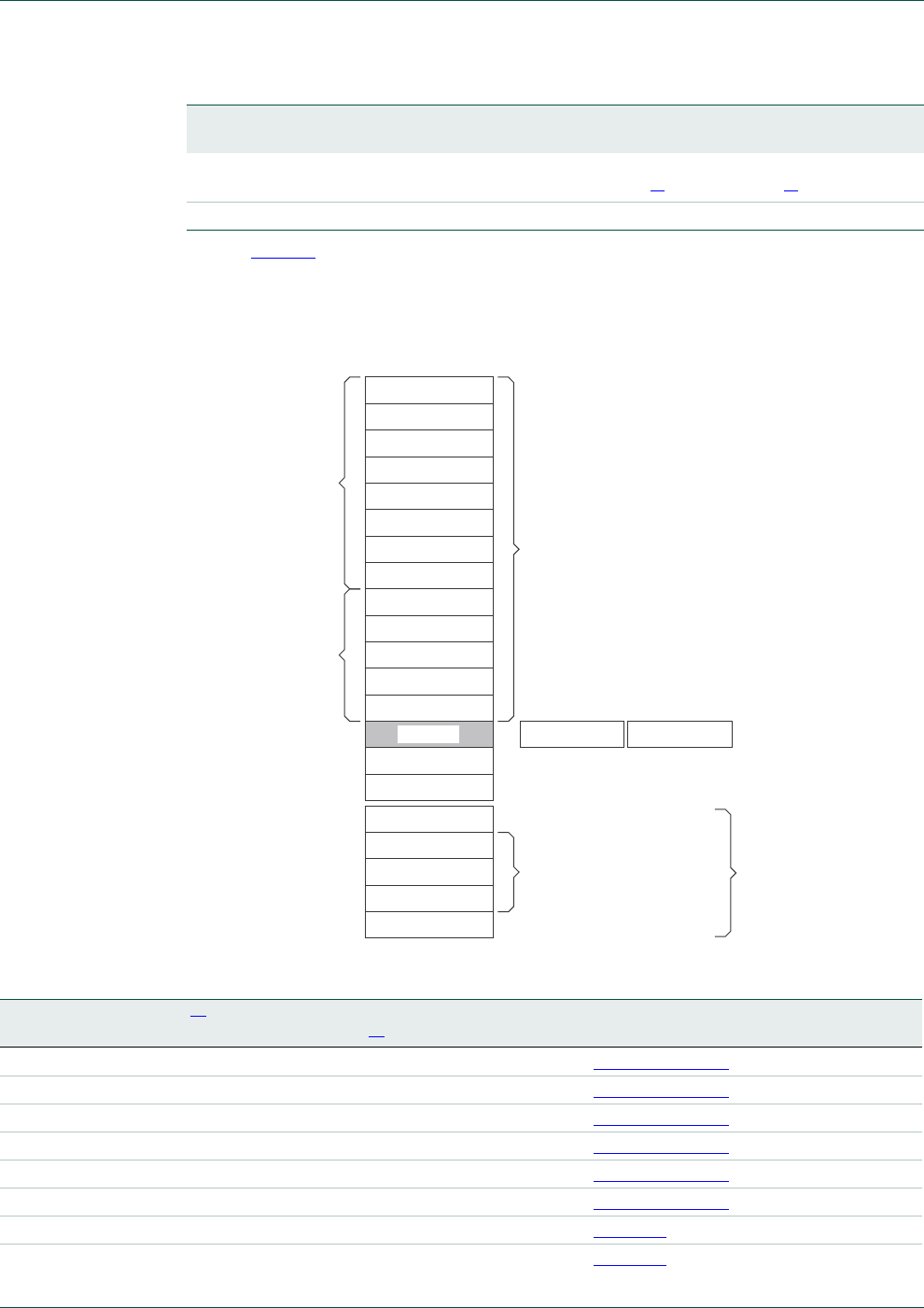
UM10360 All information provided in this document is subject to legal disclaimers. © NXP B.V. 2014. All rights reserved.
User manual Rev. 3.1 — 2 April 2014 737 of 849
NXP Semiconductors UM10360
Chapter 34: Appendix: Cortex-M3 user guide
[1] See Tab l e 63 5 .
34.3.1.3 Core registers
The processor core registers are:
Table 626. Summary of processor mode, execution privilege level, and stack use options
Processor
mode
Used to
execute
Privilege level for
software execution
Stack used
Thread Applications Privileged or
unprivileged[1]
Main stack or process
stack[1]
Handler Exception handlers Always privileged Main stack
635
/55
3&5
5
5
5
5
5
5
5
5
5
5
5
5
5
/RZUHJLVWHUV
+LJKUHJLVWHUV
063Á
363Á
365
35,0$6.
)$8/70$6.
%$6(35,
&21752/
*HQHUDOSXUSRVHUHJLVWHUV
6WDFN3RLQWHU
/LQN5HJLVWHU
3URJUDP&RXQWHU
3URJUDPVWDWXVUHJLVWHU
([FHSWLRQPDVNUHJLVWHUV
&21752/UHJLVWHU
6SHFLDOUHJLVWHUV
Á%DQNHGYHUVLRQRI63
Table 627. Core register set summary
Name Type [1] Required
privilege[2]
Reset
value
Description
R0-R12 RW Either Undefined Section 34.3.1.3.1
MSP RW Privileged See description Section 34.3.1.3.2
PSP RW Either Undefined Section 34.3.1.3.2
LR RW Either
0xFFFFFFFF
Section 34.3.1.3.3
PC RW Either See description Section 34.3.1.3.4
PSR RW Privileged
0x01000000
Section 34.3.1.3.5
ASPR RW Either
0x00000000
Tabl e 6 2 9
IPSR RO Privileged
0x00000000
Tabl e 6 3 0

UM10360 All information provided in this document is subject to legal disclaimers. © NXP B.V. 2014. All rights reserved.
User manual Rev. 3.1 — 2 April 2014 738 of 849
NXP Semiconductors UM10360
Chapter 34: Appendix: Cortex-M3 user guide
[1] Describes access type during program execution in thread mode and Handler mode. Debug access can differ.
[2] An entry of Either means privileged and unprivileged software can access the register.
34.3.1.3.1 General-purpose registers
R0-R12 are 32-bit general-purpose registers for data operations.
34.3.1.3.2 Stack Pointer
The Stack Pointer (SP) is register R13. In Thread mode, bit[1] of the CONTROL register
indicates the stack pointer to use:
On reset, the processor loads the MSP with the value from address
0x00000000
.
•0 = Main Stack Pointer (MSP). This is the reset value.
•1 = Process Stack Pointer (PSP).
34.3.1.3.3 Link Register
The Link Register (LR) is register R14. It stores the return information for subroutines,
function calls, and exceptions. On reset, the processor loads the LR value
0xFFFFFFFF.
34.3.1.3.4 Program Counter
The Program Counter (PC) is register R15. It contains the current program address.
Bit[0] is always 0 because instruction fetches must be halfword aligned. On reset, the
processor loads the PC with the value of the reset vector, which is at address
0x00000004
.
34.3.1.3.5 Program Status Register
The Program Status Register (PSR) combines:
•Application Program Status Register (APSR)
•Interrupt Program Status Register (IPSR)
•Execution Program Status Register (EPSR).
These registers are mutually exclusive bitfields in the 32-bit PSR. The bit assignments
are:
EPSR RO Privileged
0x01000000
Tabl e 6 3 1
PRIMASK RW Privileged
0x00000000
Tabl e 6 3 2
FAULTMASK RW Privileged
0x00000000
Tabl e 6 3 3
BASEPRI RW Privileged
0x00000000
Tabl e 6 3 4
CONTROL RW Privileged
0x00000000
Tabl e 6 3 5
Table 627. Core register set summary …continued
Name Type [1] Required
privilege[2]
Reset
value
Description
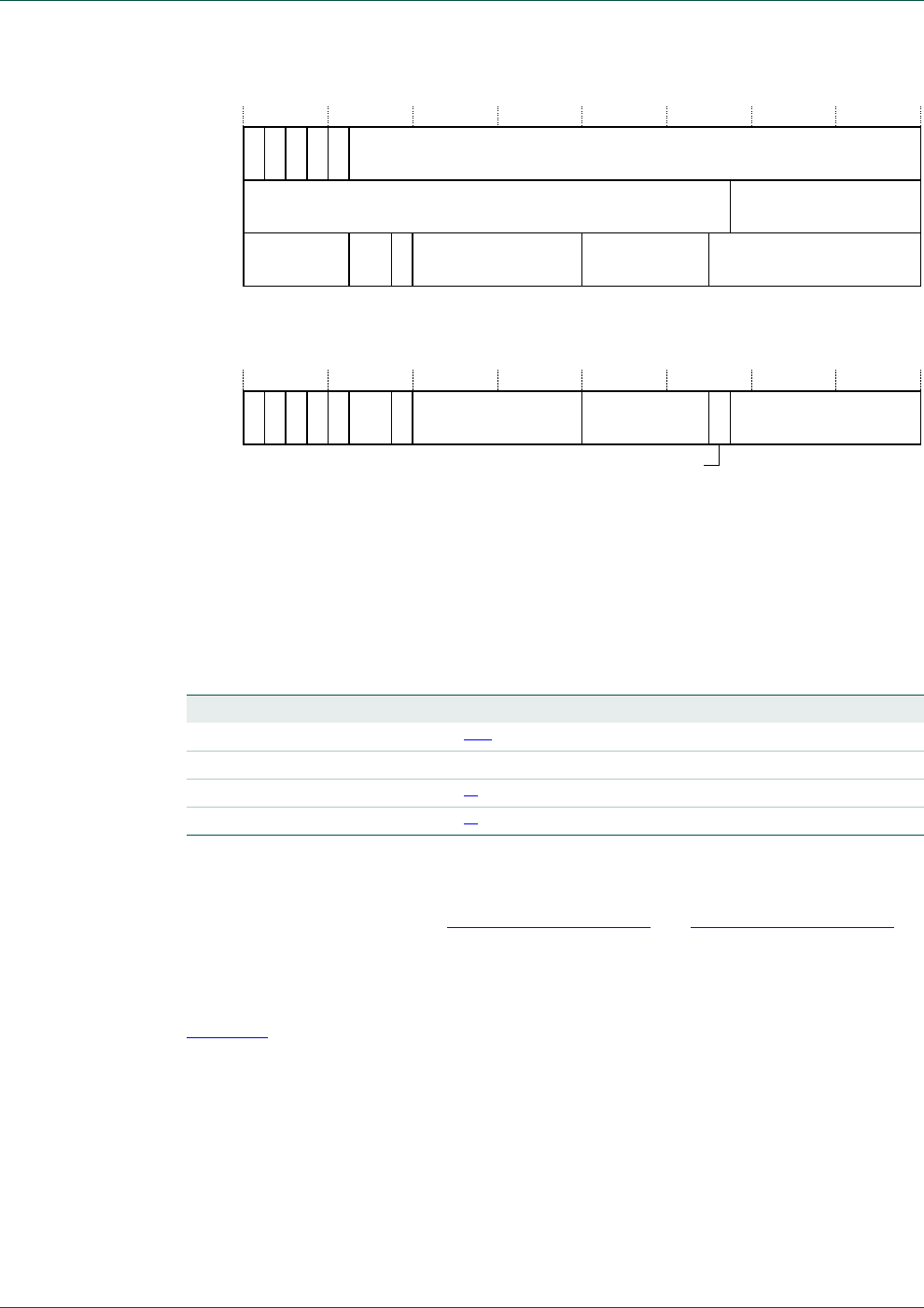
UM10360 All information provided in this document is subject to legal disclaimers. © NXP B.V. 2014. All rights reserved.
User manual Rev. 3.1 — 2 April 2014 739 of 849
NXP Semiconductors UM10360
Chapter 34: Appendix: Cortex-M3 user guide
The PSR bit assignments are:
Access these registers individually or as a combination of any two or all three registers,
using the register name as an argument to the
MSR
or
MRS
instructions. For example:
•read all of the registers using
PSR
with the
MRS
instruction
•write to the APSR using
APSR
with the
MSR
instruction.
The PSR combinations and attributes are:
[1] The processor ignores writes to the IPSR bits.
[2] Reads of the EPSR bits return zero, and the processor ignores writes to the these bits
See the instruction descriptions Section 34.2.10.6 “MRS” and Section 34.2.10.7 “MSR” for
more information about how to access the program status registers.
Application Program Status Register: The APSR contains the current state of the
condition flags from previous instruction executions. See the register summary in
Tab l e 6 27 for its attributes. The bit assignments are:
5HVHUYHG ,65B180%(5
1=&9
5HVHUYHG
$365
,365
(365 5HVHUYHG 5HVHUYHG
5HVHUYHG,&,,7 ,&,,77
4
Table 628. PSR register combinations
Register Type Combination
PSR RW[1][2] APSR, EPSR, and IPSR
IEPSR RO EPSR and IPSR
IAPSR RW[1] APSR and IPSR
EAPSR RW[2] APSR and EPSR
1
= & 9 4 ,&,,7 7 5HVHUYHG ,&,,7 ,65B180%(5
5HVHUYHG

UM10360 All information provided in this document is subject to legal disclaimers. © NXP B.V. 2014. All rights reserved.
User manual Rev. 3.1 — 2 April 2014 740 of 849
NXP Semiconductors UM10360
Chapter 34: Appendix: Cortex-M3 user guide
Interrupt Program Status Register: The IPSR contains the exception type number of
the current Interrupt Service Routine (ISR). See the register summary in Ta b l e 62 7 for
its attributes. The bit assignments are:
Table 629. APSR bit assignments
Bits Name Function
[31] N Negative or less than flag:
0 = operation result was positive, zero, greater than, or equal
1 = operation result was negative or less than.
[30] Z Zero flag:
0 = operation result was not zero
1 = operation result was zero.
[29] C Carry or borrow flag:
0 = add operation did not result in a carry bit or subtract operation resulted in
a borrow bit
1 = add operation resulted in a carry bit or subtract operation did not result in
a borrow bit.
[28] V Overflow flag:
0 = operation did not result in an overflow
1 = operation resulted in an overflow.
[27] Q Sticky saturation flag:
0 = indicates that saturation has not occurred since reset or since the bit was
last cleared to zero
1 = indicates when an
SSAT
or
USAT
instruction results in saturation.
This bit is cleared to zero by software using an
MRS
instruction.
[26:0] - Reserved.

UM10360 All information provided in this document is subject to legal disclaimers. © NXP B.V. 2014. All rights reserved.
User manual Rev. 3.1 — 2 April 2014 741 of 849
NXP Semiconductors UM10360
Chapter 34: Appendix: Cortex-M3 user guide
Execution Program Status Register: The EPSR contains the Thumb state bit, and the
execution state bits for either the:
•If-Then (IT) instruction
•Interruptible-Continuable Instruction (ICI) field for an interrupted load multiple or
store multiple instruction.
See the register summary in Ta b l e 62 7 for the EPSR attributes. The bit assignments are:
Attempts to read the EPSR directly through application software using the
MSR
instruction
always return zero. Attempts to write the EPSR using the
MSR
instruction in application
software are ignored. Fault handlers can examine EPSR value in the stacked PSR to
indicate the operation that is at fault. See Section 34.3.3.7
Table 630. IPSR bit assignments
Bits Name Function
[31:9] - Reserved
[8:0] ISR_NUMBER This is the number of the current exception:
0 = Thread mode
1 = Reserved
2 = NMI
3 = Hard fault
4 = Memory management fault
5 = Bus fault
6 = Usage fault
7-10 = Reserved
11 = SVCall
12 = Reserved for Debug
13 = Reserved
14 = PendSV
15 = SysTick
16 = IRQ0
17 = IRQ1, first device specific interrupt
.
.
255 = IRQ243 (last implemented interrupt depends on device)
see Section 34.3.3.2 for more information.
Table 631. EPSR bit assignments
Bits Name Function
[31:27] -Reserved.
[26:25], [15:10] ICI Interruptible-continuable instruction bits, see Section .
[26:25], [15:10] IT Indicates the execution state bits of the
IT
instruction, see
Section 34.2.9.3 “IT”.
[24] TAlways set to 1.
[23:16] -Reserved.
[9:0] -Reserved.

UM10360 All information provided in this document is subject to legal disclaimers. © NXP B.V. 2014. All rights reserved.
User manual Rev. 3.1 — 2 April 2014 742 of 849
NXP Semiconductors UM10360
Chapter 34: Appendix: Cortex-M3 user guide
Interruptible-continuable instructions: When an interrupt occurs during the execution
of an
LDM
or
STM
instruction, the processor:
After servicing the interrupt, the processor:
•stops the load multiple or store multiple instruction operation temporarily.
•stores the next register operand in the multiple operation to EPSR bits[15:12].
•returns to the register pointed to by bits[15:12].
•resumes execution of the multiple load or store instruction.
When the EPSR holds ICI execution state, bits[26:25,11:10] are zero.
If-Then block: The If-Then block contains up to four instructions following a 16-bit
IT
instruction. Each instruction in the block is conditional. The conditions for the instructions
are either all the same, or some can be the inverse of others. See Section 34.2.9.3 “IT” for
more information.
34.3.1.3.6 Exception mask registers
The exception mask registers disable the handling of exceptions by the processor.
Disable exceptions where they might impact on timing critical tasks.
To access the exception mask registers use the
MSR
and
MRS
instructions, or the
CPS
instruction to change the value of PRIMASK or FAULTMASK. See Section 34.2.10.6
“MRS”, Section 34.2.10.7 “MSR”, and Section 34.2.10.2 “CPS” for more information.
Priority Mask Register: The PRIMASK register prevents activation of all exceptions with
configurable priority. See the register summary in Tab l e 62 7 for its attributes. The bit
assignments are shown in Ta b le 6 3 2 .
Fault Mask Register: The FAULTMASK register prevents activation of all exceptions
except for Non-Maskable Interrupt (NMI). See the register summary in Tab l e 6 2 7 for its
attributes. The bit assignments are shown in Tab l e 63 3 .
The processor clears the FAULTMASK bit to 0 on exit from any exception handler except
the NMI handler.
Base Priority Mask Register: The BASEPRI register defines the minimum priority for
exception processing. When BASEPRI is set to a nonzero value, it prevents the activation
of all exceptions with same or lower priority level as the BASEPRI value. See the register
summary in Tab l e 6 27 for its attributes. The bit assignments are shown in Ta bl e 6 3 4 .
Table 632. PRIMASK register bit assignments
Bits Name Function
[31:1] - Reserved
[0] PRIMASK 0 = no effect
1 = prevents the activation of all exceptions with configurable priority.
Table 633. FAULTMASK register bit assignments
Bits Name Function
[31:1] - Reserved
[0] FAULTMASK 0 = no effect
1 = prevents the activation of all exceptions except for NMI.

UM10360 All information provided in this document is subject to legal disclaimers. © NXP B.V. 2014. All rights reserved.
User manual Rev. 3.1 — 2 April 2014 743 of 849
NXP Semiconductors UM10360
Chapter 34: Appendix: Cortex-M3 user guide
[1] This field is similar to the priority fields in the interrupt priority registers. The processor implements only
bits[7:M] of this field, bits[M-1:0] read as zero and ignore writes. The value of M depends on the specific
device. See Section 34.4.2.7 “Interrupt Priority Registers” for more information. Remember that higher
priority field values correspond to lower exception priorities.
34.3.1.3.7 CONTROL register
The CONTROL register controls the stack used and the privilege level for software
execution when the processor is in Thread mode. See the register summary in Table 627
for its attributes. The bit assignments are shown in Tabl e 6 35.
Handler mode always uses the MSP, so the processor ignores explicit writes to the active
stack pointer bit of the CONTROL register when in Handler mode. The exception entry
and return mechanisms update the CONTROL register.
In an OS environment, ARM recommends that threads running in Thread mode use the
process stack and the kernel and exception handlers use the main stack.
By default, Thread mode uses the MSP. To switch the stack pointer used in Thread mode
to the PSP, use the
MSR
instruction to set the Active stack pointer bit to 1, see
Section 34.2.10.7 “MSR”.
Remark: When changing the stack pointer, software must use an
ISB
instruction
immediately after the
MSR
instruction. This ensures that instructions after the ISB execute
using the new stack pointer. See Section 34.2.10.5 “ISB”
34.3.1.4 Exceptions and interrupts
The Cortex-M3 processor supports interrupts and system exceptions. The processor and
the Nested Vectored Interrupt Controller (NVIC) prioritize and handle all exceptions. An
exception changes the normal flow of software control. The processor uses handler mode
to handle all exceptions except for reset. See Section 34.3.3.7.1 and Section 34.3.3.7.2
for more information.
Table 634. BASEPRI register bit assignments
Bits Name Function
[31:8] - Reserved
[7:0] BASEPRI[1] Priority mask bits:
0x0000
= no effect
Nonzero = defines the base priority for exception processing.
The processor does not process any exception with a priority value
greater than or equal to BASEPRI.
Table 635. CONTROL register bit assignments
Bits Name Function
[31:2] - Reserved
[1] Active stack
pointer
Defines the current stack:
0 = MSP is the current stack pointer
1 = PSP is the current stack pointer.
In Handler mode this bit reads as zero and ignores writes.
[0] Thread mode
privilege level
Defines the Thread mode privilege level:
0 = privileged
1 = unprivileged.

UM10360 All information provided in this document is subject to legal disclaimers. © NXP B.V. 2014. All rights reserved.
User manual Rev. 3.1 — 2 April 2014 744 of 849
NXP Semiconductors UM10360
Chapter 34: Appendix: Cortex-M3 user guide
The NVIC registers control interrupt handling. See Section 34.4.2 “Nested Vectored
Interrupt Controller” for more information.
34.3.1.5 Data types
The processor:
•supports the following data types:
–32-bit words
–16-bit halfwords
–8-bit bytes
•supports 64-bit data transfer instructions.
•manages all data memory accesses as little-endian. See Section 34.3.2.1.
34.3.1.6 The Cortex Microcontroller Software Interface Standard
For a Cortex-M3 microcontroller system, the Cortex Microcontroller Software Interface
Standard (CMSIS) defines:
•a common way to:
–access peripheral registers
–define exception vectors
•the names of:
–the registers of the core peripherals
–the core exception vectors
•a device-independent interface for RTOS kernels, including a debug channel.
The CMSIS includes address definitions and data structures for the core peripherals in the
Cortex-M3 processor. It also includes optional interfaces for middleware components
comprising a TCP/IP stack and a Flash file system.
CMSIS simplifies software development by enabling the reuse of template code and the
combination of CMSIS-compliant software components from various middleware vendors.
Software vendors can expand the CMSIS to include their peripheral definitions and
access functions for those peripherals.
This document includes the register names defined by the CMSIS, and gives short
descriptions of the CMSIS functions that address the processor core and the core
peripherals.
Remark: This document uses the register short names defined by the CMSIS. In a few
cases these differ from the architectural short names that might be used in other
documents.
The following sections give more information about the CMSIS:
•Section 34.3.5.4
•Section 34.2.2 “Intrinsic functions”
•Section 34.4.2.1 “The CMSIS mapping of the Cortex-M3 NVIC registers”
•Section 34.4.2.10.1 “NVIC programming hints”.
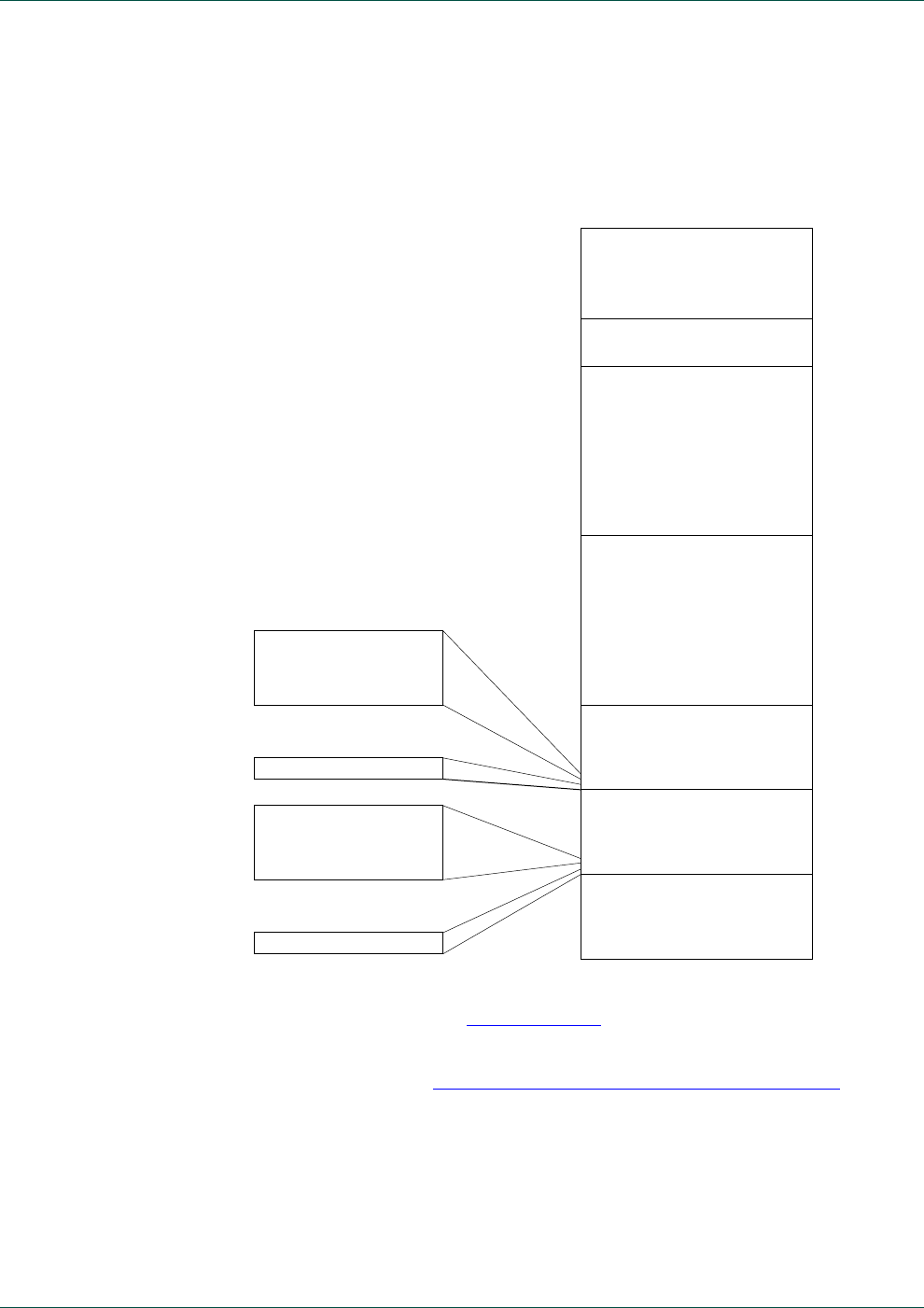
UM10360 All information provided in this document is subject to legal disclaimers. © NXP B.V. 2014. All rights reserved.
User manual Rev. 3.1 — 2 April 2014 745 of 849
NXP Semiconductors UM10360
Chapter 34: Appendix: Cortex-M3 user guide
34.3.2 Memory model
This section describes the processor memory map, the behavior of memory accesses,
and the bit-banding features. The processor has a fixed memory map that provides up to
4GB of addressable memory. The memory map is:
The regions for SRAM and peripherals include bit-band regions. Bit-banding provides
atomic operations to bit data, see Section 34.3.2.5.
The processor reserves regions of the Private peripheral bus (PPB) address range for
core peripheral registers, see Section 34.4.1 “About the Cortex-M3 peripherals”.
34.3.2.1 Memory regions, types and attributes
The memory map and the programming of the MPU split the memory map into regions.
Each region has a defined memory type, and some regions have additional memory
attributes. The memory type and attributes determine the behavior of accesses to the
region.
The memory types are:
9HQGRUVSHFLILF
PHPRU\
([WHUQDOGHYLFH
([WHUQDO5$0
3HULSKHUDO
65$0
&RGH
[))))))))
3ULYDWHSHULSKHUDO
EXV
[(
[()))))
[)))))))
[$
[)))))))
[
[)))))))
[
[)))))))
[
[
[ %LWEDQGUHJLRQ
%LWEDQGDOLDV
0%
0%
[)))))
[
[))))))
%LWEDQGUHJLRQ
%LWEDQGDOLDV
0%
0%
[
[)))))
[
[))))))
*%
*%
*%
*%
*%
[')))))))
[(
0%
0%

UM10360 All information provided in this document is subject to legal disclaimers. © NXP B.V. 2014. All rights reserved.
User manual Rev. 3.1 — 2 April 2014 746 of 849
NXP Semiconductors UM10360
Chapter 34: Appendix: Cortex-M3 user guide
•Normal: The processor can re-order transactions for efficiency, or perform speculative
reads.
•Device: The processor preserves transaction order relative to other transactions to
Device or Strongly-ordered memory.
•Strongly-ordered: The processor preserves transaction order relative to all other
transactions.
The different ordering requirements for Device and Strongly-ordered memory mean that
the memory system can buffer a write to Device memory, but must not buffer a write to
Strongly-ordered memory.
The additional memory attributes include.
•Shareable
For a shareable memory region, the memory system provides data synchronization
between bus masters in a system with multiple bus masters, for example, a processor
with a DMA controller.
Strongly-ordered memory is always shareable.
If multiple bus masters can access a non-shareable memory region, software must
ensure data coherency between the bus masters.
•Execute Never (XN)
Means the processor prevents instruction accesses. Any attempt to fetch an
instruction from an XN region causes a memory management fault exception.
34.3.2.2 Memory system ordering of memory accesses
For most memory accesses caused by explicit memory access instructions, the memory
system does not guarantee that the order in which the accesses complete matches the
program order of the instructions, providing this does not affect the behavior of the
instruction sequence. Normally, if correct program execution depends on two memory
accesses completing in program order, software must insert a memory barrier instruction
between the memory access instructions, see Section 34.3.2.4.
However, the memory system does guarantee some ordering of accesses to Device and
Strongly-ordered memory. For two memory access instructions A1 and A2, if A1 occurs
before A2 in program order, the ordering of the memory accesses caused by two
instructions is:
Where:
‘—’ means that the memory system does not guarantee the ordering of the accesses.
1RUPDODFFHVV
'HYLFHDFFHVVQRQVKDUHDEOH
'HYLFHDFFHVVVKDUHDEOH
6WURQJO\RUGHUHGDFFHVV
1RUPDO
DFFHVV 1RQVKDUHDEOH 6KDUHDEOH
6WURQJO\
RUGHUHG
DFFHVV
'HYLFHDFFHVV
$
$
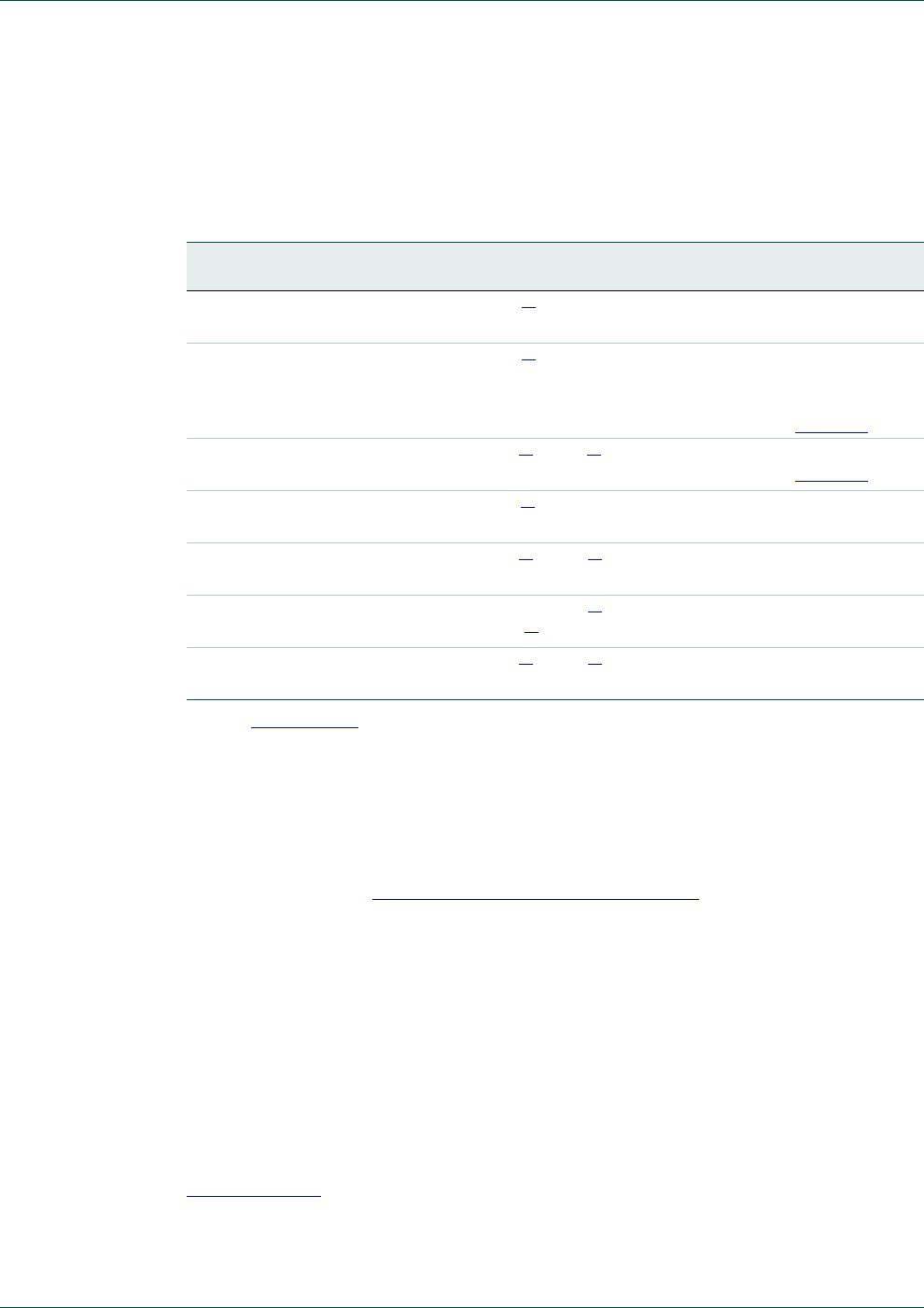
UM10360 All information provided in this document is subject to legal disclaimers. © NXP B.V. 2014. All rights reserved.
User manual Rev. 3.1 — 2 April 2014 747 of 849
NXP Semiconductors UM10360
Chapter 34: Appendix: Cortex-M3 user guide
‘<‘ means that accesses are observed in program order, that is, A1 is always observed
before A2.
34.3.2.3 Behavior of memory accesses
The behavior of accesses to each region in the memory map is:
[1] See Section 34.3.2.1 for more information.
The Code, SRAM, and external RAM regions can hold programs. However, the most
efficient access to programs is from the Code region. This is because the processor has
separate buses that enable instruction fetches and data accesses to occur
simultaneously.
The MPU can override the default memory access behavior described in this section. For
more information, see Section 34.4.5 “Memory protection unit”.
34.3.2.4 Software ordering of memory accesses
The order of instructions in the program flow does not always guarantee the order of the
corresponding memory transactions. This is because:
•the processor can reorder some memory accesses to improve efficiency, providing
this does not affect the behavior of the instruction sequence.
•the processor has multiple bus interfaces
•memory or devices in the memory map have different wait states
•some memory accesses are buffered or speculative.
Section 34.3.2.2 describes the cases where the memory system guarantees the order of
memory accesses. Otherwise, if the order of memory accesses is critical, software must
include memory barrier instructions to force that ordering. The processor provides the
following memory barrier instructions:
Table 636. Memory access behavior
Address
range
Memory
region
Memory
type
XN Description
0x00000000
-
0x1FFFFFFF
Code Normal[1] -Executable region for program code.
You can also put data here.
0x20000000
-
0x3FFFFFFF
SRAM Normal[1] -Executable region for data. You can
also put code here.
This region includes bit band and bit
band alias areas, see Ta b l e 637 .
0x40000000
-
0x5FFFFFFF
Peripheral Device[1] XN[1] This region includes bit band and bit
band alias areas, see Ta b l e 638 .
0x60000000
-
0x9FFFFFFF
External
RAM
Normal[1] -Executable region for data.
0xA0000000
-
0xDFFFFFFF
External
device
Device[1] XN[1] External Device memory
0xE0000000
-
0xE00FFFFF
Private Peripheral
Bus
Strongly-
ordered[1]
XN[1] This region includes the NVIC, System
timer, and system control block.
0xE0100000
-
0xFFFFFFFF
Vendor-
specific device
Device[1] XN[1] Not used for NXP devices.

UM10360 All information provided in this document is subject to legal disclaimers. © NXP B.V. 2014. All rights reserved.
User manual Rev. 3.1 — 2 April 2014 748 of 849
NXP Semiconductors UM10360
Chapter 34: Appendix: Cortex-M3 user guide
•
DMB
The Data Memory Barrier (DMB) instruction ensures that outstanding memory
transactions complete before subsequent memory transactions. See
Section 34.2.10.3 “DMB”.
•
DSB
The Data Synchronization Barrier (DSB) instruction ensures that outstanding
memory transactions complete before subsequent instructions execute. See
Section 34.2.10.4 “DSB”.
•
ISB
The Instruction Synchronization Barrier (ISB) ensures that the effect of all
completed memory transactions is recognizable by subsequent instructions. See
Section 34.2.10.5 “ISB”.
Use memory barrier instructions in, for example:
Memory accesses to Strongly-ordered memory, such as the system control block, do not
require the use of
DMB
instructions.
•MPU programming:
–Use a
DSB
instruction to ensure the effect of the MPU takes place immediately at
the end of context switching.
–Use an
ISB
instruction to ensure the new MPU setting takes effect immediately
after programming the MPU region or regions, if the MPU configuration code was
accessed using a branch or call. If the MPU configuration code is entered using
exception mechanisms, then an
ISB
instruction is not required.
•Vector table. If the program changes an entry in the vector table, and then enables the
corresponding exception, use a
DMB
instruction between the operations. This ensures
that if the exception is taken immediately after being enabled the processor uses the
new exception vector.
•Self-modifying code. If a program contains self-modifying code, use an
ISB
instruction
immediately after the code modification in the program. This ensures subsequent
instruction execution uses the updated program.
•Memory map switching. If the system contains a memory map switching mechanism,
use a
DSB
instruction after switching the memory map in the program. This ensures
subsequent instruction execution uses the updated memory map.
•Dynamic exception priority change. When an exception priority has to change when
the exception is pending or active, use
DSB
instructions after the change. This ensures
the change takes effect on completion of the
DSB
instruction.
•Using a semaphore in multi-master system. If the system contains more than one bus
master, for example, if another processor is present in the system, each processor
must use a
DMB
instruction after any semaphore instructions, to ensure other bus
masters see the memory transactions in the order in which they were executed.
34.3.2.5 Bit-banding
A bit-band region maps each word in a bit-band alias region to a single bit in the
bit-band region. The bit-band regions occupy the lowest 1MB of the SRAM and
peripheral memory regions.

UM10360 All information provided in this document is subject to legal disclaimers. © NXP B.V. 2014. All rights reserved.
User manual Rev. 3.1 — 2 April 2014 749 of 849
NXP Semiconductors UM10360
Chapter 34: Appendix: Cortex-M3 user guide
The memory map has two 32MB alias regions that map to two 1MB bit-band regions:
•accesses to the 32MB SRAM alias region map to the 1MB SRAM bit-band region, as
shown in Ta ble 6 3 7
•accesses to the 32MB peripheral alias region map to the 1MB peripheral bit-band
region, as shown in Tabl e 6 3 8 .
Remark: A word access to the SRAM or peripheral bit-band alias regions map to a single
bit in the SRAM or peripheral bit-band region.
The following formula shows how the alias region maps onto the bit-band region:
bit_word_offset = (byte_offset x 32) + (bit_number x 4)
bit_word_addr = bit_band_base + bit_word_offset
where:
•
Bit_word_offset
is the position of the target bit in the bit-band memory region.
•
Bit_word_addr
is the address of the word in the alias memory region that maps to the
targeted bit.
•
Bit_band_base
is the starting address of the alias region.
•
Byte_offset
is the number of the byte in the bit-band region that contains the targeted
bit.
•
Bit_number
is the bit position, 0-7, of the targeted bit.
Figure 147 shows examples of bit-band mapping between the SRAM bit-band alias region
and the SRAM bit-band region:
•The alias word at
0x23FFFFE0
maps to bit[0] of the bit-band byte at
0x200FFFFF
:
0x23FFFFE0
=
0x22000000
+ (
0xFFFFF
*32) + (0*4).
Table 637. SRAM memory bit-banding regions
Address
range
Memory
region
Instruction and data accesses
0x20000000 -
0x200FFFFF
SRAM bit-band
region
Direct accesses to this memory range behave as SRAM
memory accesses, but this region is also bit addressable
through bit-band alias.
0x22000000 -
0x23FFFFFF0
SRAM bit-band
alias
Data accesses to this region are remapped to bit band
region. A write operation is performed as
read-modify-write. Instruction accesses are not
remapped.
Table 638. Peripheral memory bit-banding regions
Address
range
Memory
region
Instruction and data accesses
0x40000000 -
0x400FFFFF
Peripheral
bit-band alias
Direct accesses to this memory range behave as
peripheral memory accesses, but this region is also bit
addressable through bit-band alias.
0x42000000 -
0x44FFFFFF
Peripheral
bit-band region
Data accesses to this region are remapped to bit band
region. A write operation is performed as
read-modify-write. Instruction accesses are not permitted.
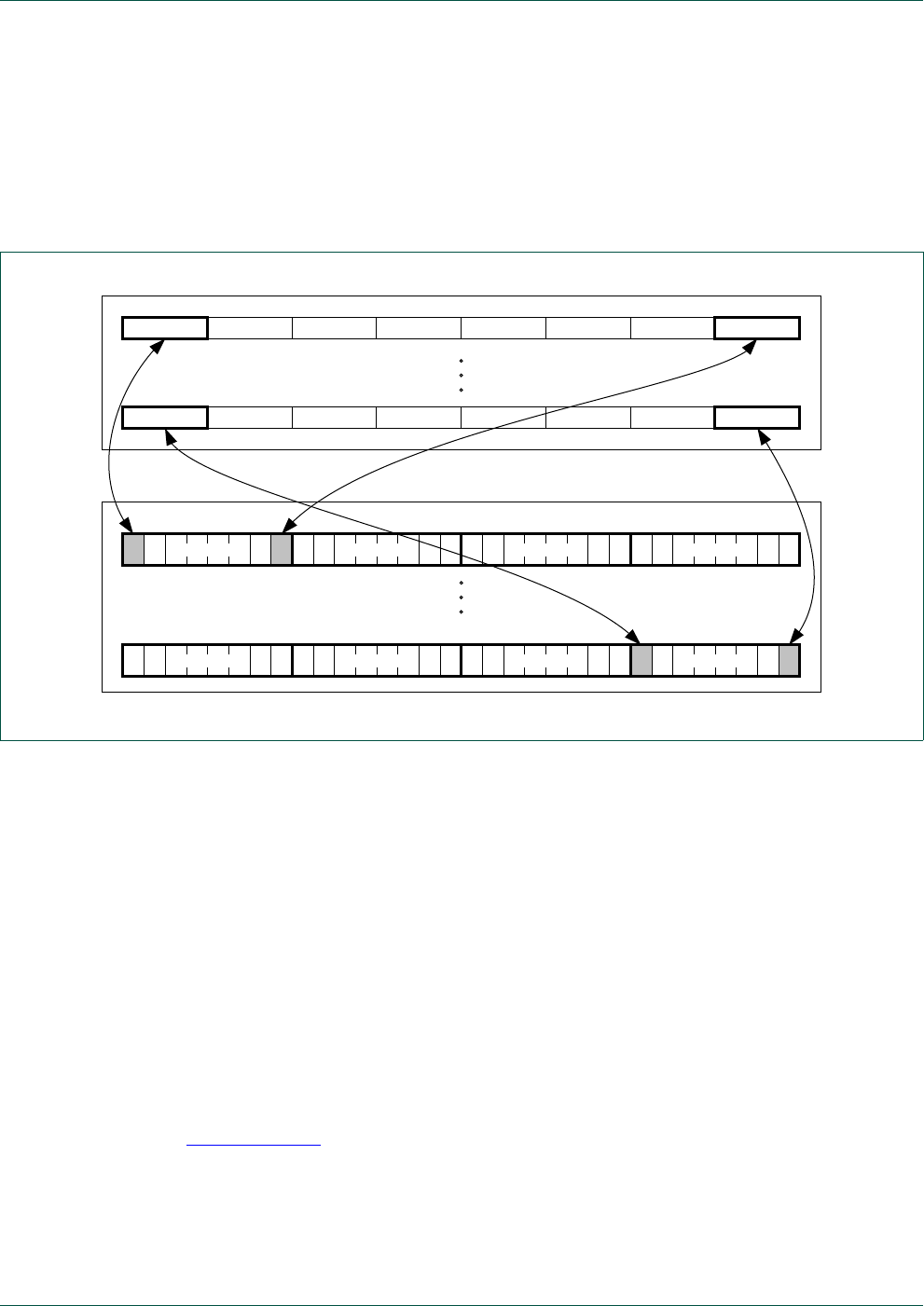
UM10360 All information provided in this document is subject to legal disclaimers. © NXP B.V. 2014. All rights reserved.
User manual Rev. 3.1 — 2 April 2014 750 of 849
NXP Semiconductors UM10360
Chapter 34: Appendix: Cortex-M3 user guide
•The alias word at
0x23FFFFFC
maps to bit[7] of the bit-band byte at
0x200FFFFF
:
0x23FFFFFC
=
0x22000000
+ (
0xFFFFF
*32) + (7*4).
•The alias word at
0x22000000
maps to bit[0] of the bit-band byte at
0x20000000
:
0x22000000
=
0x22000000
+ (0*32) + (0 *4).
•The alias word at
0x2200001C
maps to bit[7] of the bit-band byte at
0x20000000
:
0x2200001C
=
0x22000000
+ (0*32) + (7*4).
34.3.2.5.1 Directly accessing an alias region
Writing to a word in the alias region updates a single bit in the bit-band region.
Bit[0] of the value written to a word in the alias region determines the value written to the
targeted bit in the bit-band region. Writing a value with bit[0] set to 1 writes a 1 to the
bit-band bit, and writing a value with bit[0] set to 0 writes a 0 to the bit-band bit.
Bits[31:1] of the alias word have no effect on the bit-band bit. Writing
0x01
has the same
effect as writing
0xFF
. Writing
0x00
has the same effect as writing
0x0E
.
Reading a word in the alias region:
•
0x00000000
indicates that the targeted bit in the bit-band region is set to zero
•
0x00000001
indicates that the targeted bit in the bit-band region is set to 1
34.3.2.5.2 Directly accessing a bit-band region
Section 34.3.2.3 describes the behavior of direct byte, halfword, or word accesses to the
bit-band regions.
Fig 147. Bit-band mapping
[))))(
[
[))))([))))([))))(&[)))))[)))))[)))))[)))))&
[[[[& [[ [&
0%DOLDVUHJLRQ
[[[[
[))))&[))))'[))))([)))))
0%65$0ELWEDQGUHJLRQ
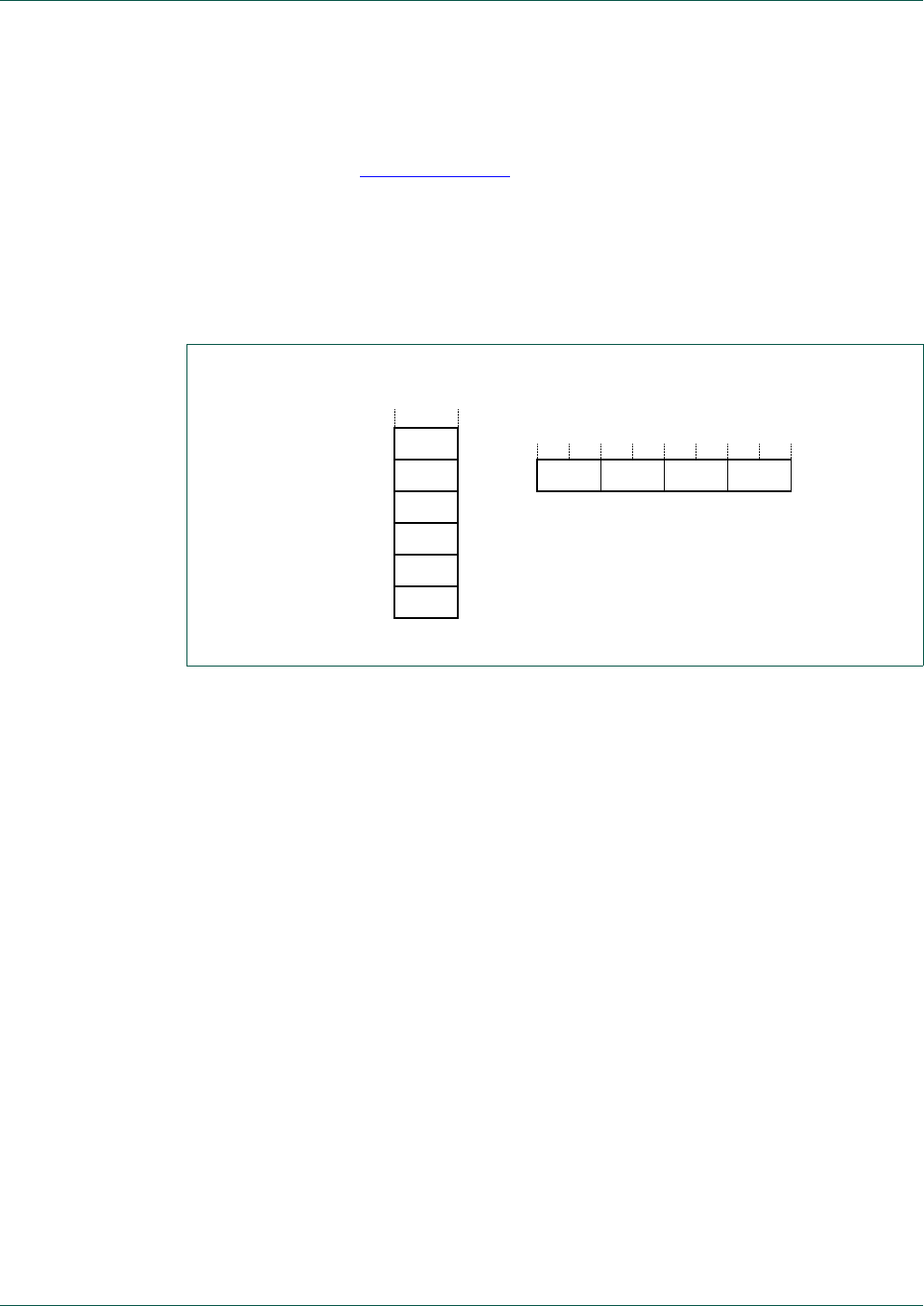
UM10360 All information provided in this document is subject to legal disclaimers. © NXP B.V. 2014. All rights reserved.
User manual Rev. 3.1 — 2 April 2014 751 of 849
NXP Semiconductors UM10360
Chapter 34: Appendix: Cortex-M3 user guide
34.3.2.6 Memory endianness
The processor views memory as a linear collection of bytes numbered in ascending order
from zero. For example, bytes 0-3 hold the first stored word, and bytes 4-7 hold the
second stored word. Section 34.3.2.6.1 describes how words of data are stored in
memory.
34.3.2.6.1 Little-endian format
In little-endian format, the processor stores the least significant byte of a word at the
lowest-numbered byte, and the most significant byte at the highest-numbered byte. For
example:
34.3.2.7 Synchronization primitives
The Cortex-M3 instruction set includes pairs of synchronization primitives. These
provide a non-blocking mechanism that a thread or process can use to obtain exclusive
access to a memory location. Software can use them to perform a guaranteed
read-modify-write memory update sequence, or for a semaphore mechanism.
A pair of synchronization primitives comprises:
•A Load-Exclusive instruction
Used to read the value of a memory location, requesting exclusive access to that
location.
•A Store-Exclusive instruction
Used to attempt to write to the same memory location, returning a status bit to a
register. If this bit is:
–0: it indicates that the thread or process gained exclusive access to the memory,
and the write succeeds,
–1: it indicates that the thread or process did not gain exclusive access to the
memory, and no write is performed,
The pairs of Load-Exclusive and Store-Exclusive instructions are:
•the word instructions
LDREX
and
STREX
•the halfword instructions
LDREXH
and
STREXH
•the byte instructions
LDREXB
and
STREXB
.
Fig 148. Little-endian format
0HPRU\ 5HJLVWHU
$GGUHVV$
$
OVE\WH
PVE\WH
$
$
%%% %
%
%
%
%

UM10360 All information provided in this document is subject to legal disclaimers. © NXP B.V. 2014. All rights reserved.
User manual Rev. 3.1 — 2 April 2014 752 of 849
NXP Semiconductors UM10360
Chapter 34: Appendix: Cortex-M3 user guide
Software must use a Load-Exclusive instruction with the corresponding Store-Exclusive
instruction.
To perform a guaranteed read-modify-write of a memory location, software must:
1. Use a Load-Exclusive instruction to read the value of the location.
2. Update the value, as required.
3. Use a Store-Exclusive instruction to attempt to write the new value back to the
memory location, and tests the returned status bit. If this bit is:
–0: The read-modify-write completed successfully,
–1: No write was performed. This indicates that the value returned at step 1 might
be out of date. The software must retry the read-modify-write sequence,
Software can use the synchronization primitives to implement a semaphores as follows:
1. Use a Load-Exclusive instruction to read from the semaphore address to check
whether the semaphore is free.
2. If the semaphore is free, use a Store-Exclusive to write the claim value to the
semaphore address.
3. If the returned status bit from step 2 indicates that the Store-Exclusive succeeded
then the software has claimed the semaphore. However, if the Store-Exclusive failed,
another process might have claimed the semaphore after the software performed
step 1.
The Cortex-M3 includes an exclusive access monitor, that tags the fact that the processor
has executed a Load-Exclusive instruction.
The processor removes its exclusive access tag if:
•It executes a
CLREX
instruction
•It executes a Store-Exclusive instruction, regardless of whether the write succeeds.
•An exception occurs. This means the processor can resolve semaphore conflicts
between different threads.
For more information about the synchronization primitive instructions, see
Section 34.2.4.8 “LDREX and STREX” and Section 34.2.4.9.
34.3.2.8 Programming hints for the synchronization primitives
ANSI C cannot directly generate the exclusive access instructions. Some C compilers
provide intrinsic functions for generation of these instructions:
The actual exclusive access instruction generated depends on the data type of the pointer
passed to the intrinsic function. For example, the following C code generates the require
LDREXB
operation:
Table 639. C compiler intrinsic functions for exclusive access instructions
Instruction Intrinsic function
LDREX
,
LDREXH
, or
LDREXB unsigned int __ldrex(volatile void *ptr)
STREX
,
STREXH
, or
STREXB int __strex(unsigned int val, volatile void *ptr)
CLREX void __clrex(void)

UM10360 All information provided in this document is subject to legal disclaimers. © NXP B.V. 2014. All rights reserved.
User manual Rev. 3.1 — 2 April 2014 754 of 849
NXP Semiconductors UM10360
Chapter 34: Appendix: Cortex-M3 user guide
34.3.3 Exception model
This section describes the exception model.
34.3.3.1 Exception states
Each exception is in one of the following states:
•Inactive
The exception is not active and not pending.
•Pending
The exception is waiting to be serviced by the processor.
An interrupt request from a peripheral or from software can change the state of the
corresponding interrupt to pending.
•Active
An exception that is being serviced by the processor but has not completed.
Remark: An exception handler can interrupt the execution of another exception
handler. In this case both exceptions are in the active state.
•Active and pending
The exception is being serviced by the processor and there is a pending exception
from the same source.
34.3.3.2 Exception types
The exception types are:
•Reset
Reset is invoked on power up or a warm reset. The exception model treats reset as a
special form of exception. When reset is asserted, the operation of the processor
stops, potentially at any point in an instruction. When reset is deasserted, execution
restarts from the address provided by the reset entry in the vector table. Execution
restarts as privileged execution in Thread mode.
•NMI
A NonMaskable Interrupt (NMI) can be signalled by a peripheral or triggered by
software. This is the highest priority exception other than reset. It is permanently
enabled and has a fixed priority of -2. NMIs cannot be:
–masked or prevented from activation by any other exception
–preempted by any exception other than Reset.
•Hard fault
A hard fault is an exception that occurs because of an error during exception
processing, or because an exception cannot be managed by any other exception
mechanism. Hard faults have a fixed priority of -1, meaning they have higher priority
than any exception with configurable priority.
•Memory management fault

UM10360 All information provided in this document is subject to legal disclaimers. © NXP B.V. 2014. All rights reserved.
User manual Rev. 3.1 — 2 April 2014 755 of 849
NXP Semiconductors UM10360
Chapter 34: Appendix: Cortex-M3 user guide
A memory management fault is an exception that occurs because of a memory
protection related fault. The MPU or the fixed memory protection constraints
determines this fault, for both instruction and data memory transactions. This fault is
used to abort instruction accesses to Execute Never (XN) memory regions, even if
the MPU is disabled.
•Bus fault
A bus fault is an exception that occurs because of a memory related fault for an
instruction or data memory transaction. This might be from an error detected on a bus
in the memory system.
•Usage fault
A usage fault is an exception that occurs because of a fault related to instruction
execution. This includes:
–an undefined instruction
–an illegal unaligned access
–invalid state on instruction execution
–an error on exception return.
The following can cause a usage fault when the core is configured to report them:
–an unaligned address on word and halfword memory access
–division by zero.
•SVCall
A supervisor call (SVC) is an exception that is triggered by the
SVC
instruction. In an
OS environment, applications can use
SVC
instructions to access OS kernel functions
and device drivers.
•PendSV
PendSV is an interrupt-driven request for system-level service. In an OS environment,
use PendSV for context switching when no other exception is active.
•SysTick
A SysTick exception is an exception the system timer generates when it reaches zero.
Software can also generate a SysTick exception. In an OS environment, the
processor can use this exception as system tick.
•Interrupt (IRQ)
A interrupt, or IRQ, is an exception signalled by a peripheral, or generated by a
software request. All interrupts are asynchronous to instruction execution. In the
system, peripherals use interrupts to communicate with the processor.
Table 640. Properties of the different exception types
Exception
number[1]
IRQ
number[1]
Exception
type
Priority Vector address
or offset[2]
Activation
1 - Reset -3, the highest
0x00000004
Asynchronous
2-14NMI -2
0x00000008
Asynchronous
3-13Hard fault-1
0x0000000C
-
4 -12 Memory
management fault
Configurable[3]
0x00000010
Synchronous
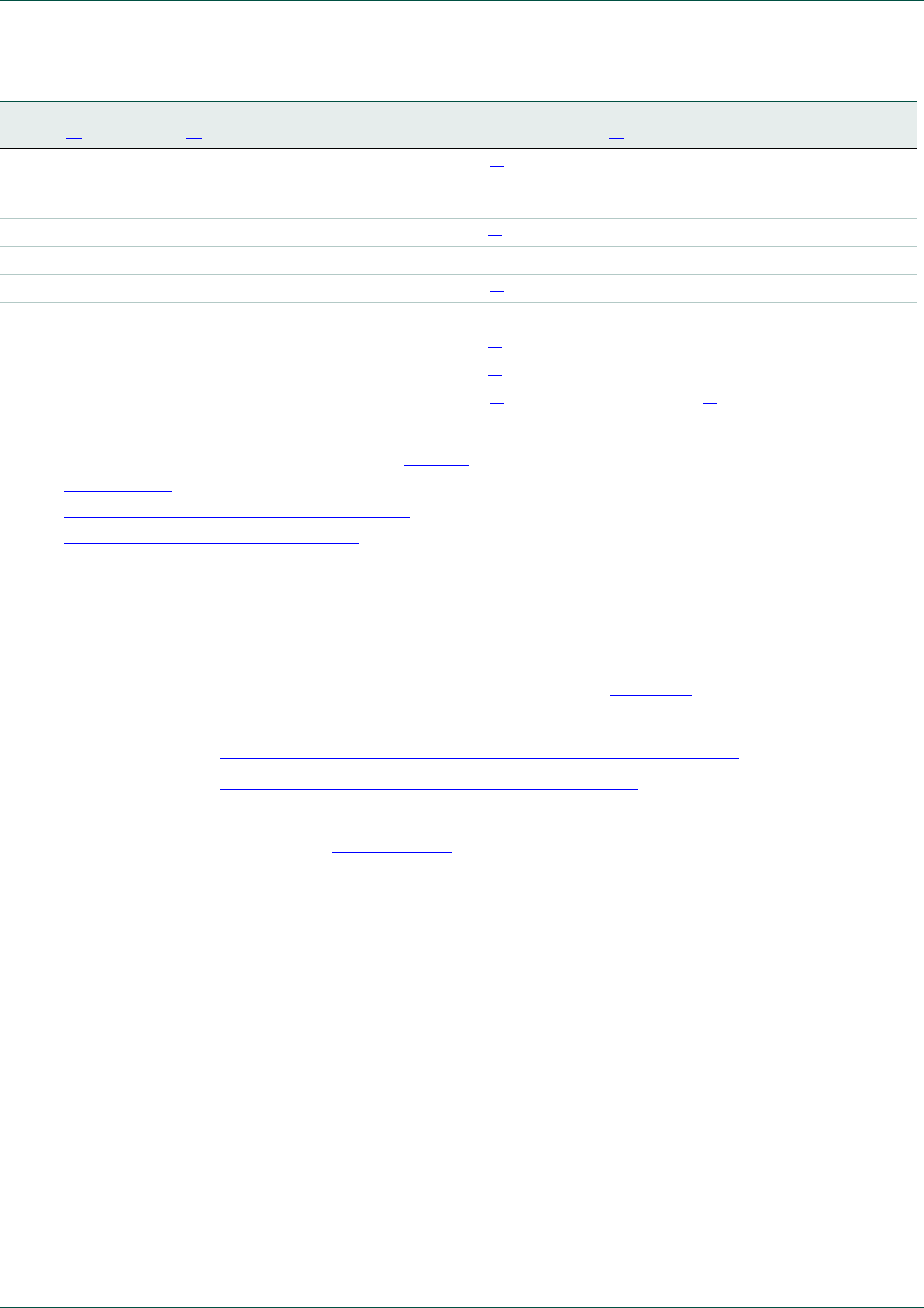
UM10360 All information provided in this document is subject to legal disclaimers. © NXP B.V. 2014. All rights reserved.
User manual Rev. 3.1 — 2 April 2014 756 of 849
NXP Semiconductors UM10360
Chapter 34: Appendix: Cortex-M3 user guide
[1] To simplify the software layer, the CMSIS only uses IRQ numbers and therefore uses negative values for exceptions other than
interrupts. The IPSR returns the Exception number, see Tab l e 63 0.
[2] See Section 34.3.3.4 for more information.
[3] See Section 34.4.3.9 “System Handler Priority Registers”.
[4] See Section 34.4.2.7 “Interrupt Priority Registers”.
[5] Increasing in steps of 4.
For an asynchronous exception, other than reset, the processor can execute another
instruction between when the exception is triggered and when the processor enters the
exception handler.
Privileged software can disable the exceptions that Table 640 shows as having
configurable priority, see:
•Section 34.4.3.10 “System Handler Control and State Register”
•Section 34.4.2.3 “Interrupt Clear-enable Registers”.
For more information about hard faults, memory management faults, bus faults, and
usage faults, see Section 34.3.4.
34.3.3.3 Exception handlers
The processor handles exceptions using:
•Interrupt Service Routines (ISRs)
Interrupts IRQ0 and up are the exceptions handled by ISRs.
•Fault handlers
Hard fault, memory management fault, usage fault, bus fault are fault exceptions
handled by the fault handlers.
•System handlers
NMI, PendSV, SVCall SysTick, and the fault exceptions are all system exceptions that
are handled by system handlers.
5-11 Bus fault Configurable[3]
0x00000014
Synchronous when
precise, asynchronous
when imprecise
6-10Usage fault Configurable
[3]
0x00000018
Synchronous
7-10 - - - Reserved -
11 -5 SVCall Configurable[3]
0x0000002C
Synchronous
12-13 - - - Reserved -
14 -2 PendSV Configurable[3]
0x00000038
Asynchronous
15 -1 SysTick Configurable[3]
0x0000003C
Asynchronous
16 and above 0 and above Interrupt (IRQ) Configurable[4]
0x00000040
and above[5] Asynchronous
Table 640. Properties of the different exception types
Exception
number[1]
IRQ
number[1]
Exception
type
Priority Vector address
or offset[2]
Activation

UM10360 All information provided in this document is subject to legal disclaimers. © NXP B.V. 2014. All rights reserved.
User manual Rev. 3.1 — 2 April 2014 757 of 849
NXP Semiconductors UM10360
Chapter 34: Appendix: Cortex-M3 user guide
34.3.3.4 Vector table
The vector table contains the reset value of the stack pointer, and the start addresses,
also called exception vectors, for all exception handlers. Figure 149 shows the order of
the exception vectors in the vector table. The least-significant bit of each vector must be 1,
indicating that the exception handler is Thumb code. Note that the upper limit of the IRQ
number is device dependent.
On system reset, the vector table is fixed at address
0x00000000
. Privileged software can
write to the VTOR to relocate the vector table start address to a different memory location,
in the range
0x00000080
to
0x3FFFFF80
, see Section 34.4.3.5 “Vector Table Offset Register”.
34.3.3.5 Exception priorities
As Ta b le 6 4 0 shows, all exceptions have an associated priority, with:
•a lower priority value indicating a higher priority
•configurable priorities for all exceptions except Reset, Hard fault, and NMI.
If software does not configure any priorities, then all exceptions with a configurable priority
have a priority of 0. For information about configuring exception priorities see
Fig 149. Vector table
Exception
number
IRQ
number Offset Vector
0x1FC
.
.
.
0x004C
0x0048
0x0044
0x0040
0x003C
0x0038
0x002C
0x0018
0x0014
0x0010
0x000C
0x0008
0x0004
0x0000
IRQ111
.
.
.
IRQ2
IRQ1
IRQ0
Systick
PendSV
Reserved
Reserved for debug
SVCall
Usage fault
Bus fault
Memory management fault
Hard fault
NMI
Reset
Initial SP value.
111
2
1
0
-1
-2
-5
-10
-11
-12
-13
-14
127
.
.
.
18
17
16
15
14
13
12
11
10
9
8
7
6
5
4
3
2
1
Reserved

UM10360 All information provided in this document is subject to legal disclaimers. © NXP B.V. 2014. All rights reserved.
User manual Rev. 3.1 — 2 April 2014 758 of 849
NXP Semiconductors UM10360
Chapter 34: Appendix: Cortex-M3 user guide
•Section 34.4.3.9 “System Handler Priority Registers”
•Section 34.4.2.7 “Interrupt Priority Registers”.
Remark: Configurable priority values are in the range 0 to 31. This means that the Reset,
Hard fault, and NMI exceptions, with fixed negative priority values, always have higher
priority than any other exception.
For example, assigning a higher priority value to IRQ[0] and a lower priority value to
IRQ[1] means that IRQ[1] has higher priority than IRQ[0]. If both IRQ[1] and IRQ[0] are
asserted, IRQ[1] is processed before IRQ[0].
If multiple pending exceptions have the same priority, the pending exception with the
lowest exception number takes precedence. For example, if both IRQ[0] and IRQ[1] are
pending and have the same priority, then IRQ[0] is processed before IRQ[1].
When the processor is executing an exception handler, the exception handler is
preempted if a higher priority exception occurs. If an exception occurs with the same
priority as the exception being handled, the handler is not preempted, irrespective of the
exception number. However, the status of the new interrupt changes to pending.
34.3.3.6 Interrupt priority grouping
To increase priority control in systems with interrupts, the NVIC supports priority grouping.
This divides each interrupt priority register entry into two fields:
Only the group priority determines preemption of interrupt exceptions. When the
processor is executing an interrupt exception handler, another interrupt with the same
group priority as the interrupt being handled does not preempt the handler,
•an upper field that defines the group priority
•a lower field that defines a subpriority within the group.
If multiple pending interrupts have the same group priority, the subpriority field determines
the order in which they are processed. If multiple pending interrupts have the same group
priority and subpriority, the interrupt with the lowest IRQ number is processed first.
For information about splitting the interrupt priority fields into group priority and subpriority,
see Section 34.4.3.6 “Application Interrupt and Reset Control Register”.
34.3.3.7 Exception entry and return
Descriptions of exception handling use the following terms:
•Preemption
When the processor is executing an exception handler, an exception can preempt the
exception handler if its priority is higher than the priority of the exception being
handled. See Section 34.3.3.6 for more information about preemption by an interrupt.
When one exception preempts another, the exceptions are called nested exceptions.
See Section 34.3.3.7.1 more information.
•Return
This occurs when the exception handler is completed, and:

UM10360 All information provided in this document is subject to legal disclaimers. © NXP B.V. 2014. All rights reserved.
User manual Rev. 3.1 — 2 April 2014 759 of 849
NXP Semiconductors UM10360
Chapter 34: Appendix: Cortex-M3 user guide
–there is no pending exception with sufficient priority to be serviced
–the completed exception handler was not handling a late-arriving exception.
The processor pops the stack and restores the processor state to the state it had
before the interrupt occurred. See Section 34.3.3.7.2 for more information.
•Tail-chaining
This mechanism speeds up exception servicing. On completion of an exception
handler, if there is a pending exception that meets the requirements for exception
entry, the stack pop is skipped and control transfers to the new exception handler.
•Late-arriving
This mechanism speeds up preemption. If a higher priority exception occurs during
state saving for a previous exception, the processor switches to handle the higher
priority exception and initiates the vector fetch for that exception. State saving is not
affected by late arrival because the state saved is the same for both exceptions.
Therefore the state saving continues uninterrupted. The processor can accept a late
arriving exception until the first instruction of the exception handler of the original
exception enters the execute stage of the processor. On return from the exception
handler of the late-arriving exception, the normal tail-chaining rules apply.
34.3.3.7.1 Exception entry
Exception entry occurs when there is a pending exception with sufficient priority and
either:
•the processor is in Thread mode
•the new exception is of higher priority than the exception being handled, in which case
the new exception preempts the original exception.
When one exception preempts another, the exceptions are nested.
Sufficient priority means the exception has more priority than any limits set by the mask
registers, see Section 34.3.1.3.6. An exception with less priority than this is pending but is
not handled by the processor.
When the processor takes an exception, unless the exception is a tail-chained or a
late-arriving exception, the processor pushes information onto the current stack. This
operation is referred as stacking and the structure of eight data words is referred as
stack frame. The stack frame contains the following information:
•R0-R3, R12
•Return address
•PSR
•LR.
Immediately after stacking, the stack pointer indicates the lowest address in the stack
frame. Unless stack alignment is disabled, the stack frame is aligned to a double-word
address. If the STKALIGN bit of the Configuration Control Register (CCR) is set to 1,
stack align adjustment is performed during stacking.

UM10360 All information provided in this document is subject to legal disclaimers. © NXP B.V. 2014. All rights reserved.
User manual Rev. 3.1 — 2 April 2014 760 of 849
NXP Semiconductors UM10360
Chapter 34: Appendix: Cortex-M3 user guide
The stack frame includes the return address. This is the address of the next instruction in
the interrupted program. This value is restored to the PC at exception return so that the
interrupted program resumes.
In parallel to the stacking operation, the processor performs a vector fetch that reads the
exception handler start address from the vector table. When stacking is complete, the
processor starts executing the exception handler. At the same time, the processor writes
an EXC_RETURN value to the LR. This indicates which stack pointer corresponds to the
stack frame and what operation mode the was processor was in before the entry
occurred.
If no higher priority exception occurs during exception entry, the processor starts
executing the exception handler and automatically changes the status of the
corresponding pending interrupt to active.
If another higher priority exception occurs during exception entry, the processor starts
executing the exception handler for this exception and does not change the pending
status of the earlier exception. This is the late arrival case.
34.3.3.7.2 Exception return
Exception return occurs when the processor is in Handler mode and executes one of the
following instructions to load the EXC_RETURN value into the PC:
•a
POP
instruction that includes the PC
•a
BX
instruction with any register.
•an
LDR
or
LDM
instruction with the PC as the destination.
EXC_RETURN is the value loaded into the LR on exception entry. The exception
mechanism relies on this value to detect when the processor has completed an exception
handler. The lowest four bits of this value provide information on the return stack and
processor mode. Tab l e 6 4 1 shows the EXC_RETURN[3:0] values with a description of the
exception return behavior.
The processor sets EXC_RETURN bits[31:4] to
0xFFFFFFF
. When this value is loaded into
the PC it indicates to the processor that the exception is complete, and the processor
initiates the exception return sequence.
Table 641. Exception return behavior
EXC_RETURN[3:0] Description
bXXX0 Reserved.
b0001 Return to Handler mode.
Exception return gets state from MSP.
Execution uses MSP after return.
b0011 Reserved.
b01X1 Reserved.

UM10360 All information provided in this document is subject to legal disclaimers. © NXP B.V. 2014. All rights reserved.
User manual Rev. 3.1 — 2 April 2014 761 of 849
NXP Semiconductors UM10360
Chapter 34: Appendix: Cortex-M3 user guide
b1001 Return to Thread mode.
Exception return gets state from MSP.
Execution uses MSP after return.
b1101 Return to Thread mode.
Exception return gets state from PSP.
Execution uses PSP after return.
b1X11 Reserved.
Table 641. Exception return behavior …continued
EXC_RETURN[3:0] Description

UM10360 All information provided in this document is subject to legal disclaimers. © NXP B.V. 2014. All rights reserved.
User manual Rev. 3.1 — 2 April 2014 762 of 849
NXP Semiconductors UM10360
Chapter 34: Appendix: Cortex-M3 user guide
34.3.4 Fault handling
Faults are a subset of the exceptions, see Section 34.3.3. The following generate a fault:
•a bus error on:
–an instruction fetch or vector table load
–a data access
•an internally-detected error such as an undefined instruction or an attempt to change
state with a
BX
instruction
•attempting to execute an instruction from a memory region marked as
Non-Executable (XN)
•an MPU fault because of a privilege violation or an attempt to access an unmanaged
region
34.3.4.1 Fault types
Tab l e 6 42 shows the types of fault, the handler used for the fault, the corresponding fault
status register, and the register bit that indicates that the fault has occurred. See
Section 34.4.3.11 “Configurable Fault Status Register” for more information about the fault
status registers.
[1] Occurs on an access to an XN region even if the MPU is disabled.
[2] Attempting to use an instruction set other than the Thumb instruction set.
Table 642. Faults
Fault Handler Bit name Fault status register
Bus error on a vector read Hard fault VECTTBL Section 34.4.3.12 “Hard Fault
Status Register”
Fault escalated to a hard fault FORCED
MPU mismatch: Memory
management
fault
--
on instruction access IACCVIOL[1] Section 34.4.3.13 “Memory
Management Fault Address
Register”
on data access DACCVIOL
during exception stacking MSTKERR
during exception unstacking MUNSKERR
Bus error: Bus fault - -
during exception stacking STKERR Section 34.4.3.14 “Bus Fault
Address Register”
during exception unstacking UNSTKERR
during instruction prefetch IBUSERR
Precise data bus error PRECISERR
Imprecise data bus error IMPRECISERR
Attempt to access a coprocessor Usage fault NOCP Section 34.4.3.11.3 “Usage Fault
Status Register”
Undefined instruction UNDEFINSTR
Attempt to enter an invalid instruction set state[2] INVSTATE
Invalid EXC_RETURN value INVPC
Illegal unaligned load or store UNALIGNED
Divide By 0 DIVBYZERO

UM10360 All information provided in this document is subject to legal disclaimers. © NXP B.V. 2014. All rights reserved.
User manual Rev. 3.1 — 2 April 2014 763 of 849
NXP Semiconductors UM10360
Chapter 34: Appendix: Cortex-M3 user guide
34.3.4.2 Fault escalation and hard faults
All faults exceptions except for hard fault have configurable exception priority, see
Section 34.4.3.9 “System Handler Priority Registers”. Software can disable execution of
the handlers for these faults, see Section 34.4.3.10 “System Handler Control and State
Register”.
Usually, the exception priority, together with the values of the exception mask registers,
determines whether the processor enters the fault handler, and whether a fault handler
can preempt another fault handler. as described in Section 34.3.3.
In some situations, a fault with configurable priority is treated as a hard fault. This is called
priority escalation, and the fault is described as escalated to hard fault. Escalation to
hard fault occurs when:
•A fault handler causes the same kind of fault as the one it is servicing. This escalation
to hard fault occurs because a fault handler cannot preempt itself because it must
have the same priority as the current priority level.
•A fault handler causes a fault with the same or lower priority as the fault it is servicing.
This is because the handler for the new fault cannot preempt the currently executing
fault handler.
•An exception handler causes a fault for which the priority is the same as or lower than
the currently executing exception.
•A fault occurs and the handler for that fault is not enabled.
If a bus fault occurs during a stack push when entering a bus fault handler, the bus fault
does not escalate to a hard fault. This means that if a corrupted stack causes a fault, the
fault handler executes even though the stack push for the handler failed. The fault handler
operates but the stack contents are corrupted.
Remark: Only Reset and NMI can preempt the fixed priority hard fault. A hard fault can
preempt any exception other than Reset, NMI, or another hard fault.
34.3.4.3 Fault status registers and fault address registers
The fault status registers indicate the cause of a fault. For bus faults and memory
management faults, the fault address register indicates the address accessed by the
operation that caused the fault, as shown in Tab l e 64 3 .
Table 643. Fault status and fault address registers
Handler Status register
name
Address register
name
Register description
Hard fault HFSR -Section 34.4.3.12 “Hard Fault Status Register”
Memory
management
fault
MMFSR MMFAR Section 34.4.3.13 “Memory Management Fault Address Register”
Section 34.4.3.11.1 “Memory Management Fault Status Register”
Bus fault BFSR BFAR Section 34.4.3.11.2 “Bus Fault Status Register”
Section 34.4.3.14 “Bus Fault Address Register”
Usage fault UFSR -Section 34.4.3.11.3 “Usage Fault Status Register”

UM10360 All information provided in this document is subject to legal disclaimers. © NXP B.V. 2014. All rights reserved.
User manual Rev. 3.1 — 2 April 2014 764 of 849
NXP Semiconductors UM10360
Chapter 34: Appendix: Cortex-M3 user guide
34.3.4.4 Lockup
The processor enters a lockup state if a hard fault occurs when executing the NMI or hard
fault handlers. When the processor is in lockup state it does not execute any instructions.
The processor remains in lockup state until either:
•it is reset
•an NMI occurs.
Remark: If lockup state occurs from the NMI handler a subsequent NMI does not cause
the processor to leave lockup state.

UM10360 All information provided in this document is subject to legal disclaimers. © NXP B.V. 2014. All rights reserved.
User manual Rev. 3.1 — 2 April 2014 765 of 849
NXP Semiconductors UM10360
Chapter 34: Appendix: Cortex-M3 user guide
34.3.5 Power management
Note: NXP devices based on the Cortex-M3 processor, including the LPC176x/5x,
support additional reduced power modes. See Section 4.8 “Power control” for
information on all available reduced power modes.
The Cortex-M3 processor sleep modes reduce power consumption:
•Sleep mode stops the processor clock
•Deep sleep mode stops the system clock and switches off the PLL and flash memory.
The SLEEPDEEP bit of the SCR selects which sleep mode is used, see Section 34.4.3.7
“System Control Register”. For more information about the behavior of the sleep modes
see Section 4.8 “Power control”.
This section describes the mechanisms for entering sleep mode, and the conditions for
waking up from sleep mode.
34.3.5.1 Entering sleep mode
This section describes the mechanisms software can use to put the processor into sleep
mode.
The system can generate spurious wakeup events, for example a debug operation wakes
up the processor. Therefore software must be able to put the processor back into sleep
mode after such an event. A program might have an idle loop to put the processor back to
sleep mode.
34.3.5.1.1 Wait for interrupt
The wait for interrupt instruction,
WFI
, causes immediate entry to sleep mode. When the
processor executes a
WFI
instruction it stops executing instructions and enters sleep
mode. See Section 34.2.10.12 “WFI” for more information.
34.3.5.1.2 Wait for event
Note: LPC176x/5x devices based on the Cortex-M3 processor do not implement
external events.
The wait for event instruction,
WFE
, causes entry to sleep mode conditional on the value of
an one-bit event register. When the processor executes a
WFE
instruction, it checks this
register:
•if the register is 0 the processor stops executing instructions and enters sleep mode
•if the register is 1 the processor clears the register to 0 and continues executing
instructions without entering sleep mode.
See Section 34.2.10.11 “WFE” for more information.
If the event register is 1, this indicate that the processor must not enter sleep mode on
execution of a
WFE
instruction. Typically, this is because an external event signal is
asserted, or a processor in the system has executed an
SEV
instruction, see
Section 34.2.10.9 “SEV”. Software cannot access this register directly.

UM10360 All information provided in this document is subject to legal disclaimers. © NXP B.V. 2014. All rights reserved.
User manual Rev. 3.1 — 2 April 2014 766 of 849
NXP Semiconductors UM10360
Chapter 34: Appendix: Cortex-M3 user guide
34.3.5.1.3 Sleep-on-exit
If the SLEEPONEXIT bit of the SCR is set to 1, when the processor completes the
execution of an exception handler it returns to Thread mode and immediately enters sleep
mode. Use this mechanism in applications that only require the processor to run when an
exception occurs.
34.3.5.2 Wakeup from sleep mode
The conditions for the processor to wakeup depend on the mechanism that cause it to
enter sleep mode.
34.3.5.2.1 Wakeup from WFI or sleep-on-exit
Normally, the processor wakes up only when it detects an exception with sufficient priority
to cause exception entry.
Some embedded systems might have to execute system restore tasks after the processor
wakes up, and before it executes an interrupt handler. To achieve this set the PRIMASK
bit to 1 and the FAULTMASK bit to 0. If an interrupt arrives that is enabled and has a
higher priority than current exception priority, the processor wakes up but does not
execute the interrupt handler until the processor sets PRIMASK to zero. For more
information about PRIMASK and FAULTMASK see Section 34.3.1.3.6.
34.3.5.2.2 Wakeup from WFE
The processor wakes up if:
•it detects an exception with sufficient priority to cause exception entry
In addition, if the SEVONPEND bit in the SCR is set to 1, any new pending interrupt
triggers an event and wakes up the processor, even if the interrupt is disabled or has
insufficient priority to cause exception entry. For more information about the SCR see
Section 34.4.3.7 “System Control Register”.
34.3.5.3 The Wake-up Interrupt Controller
The Wake-up Interrupt Controller (WIC) is a peripheral that can detect an interrupt and
wake the processor from Deep sleep mode, Power-down mode, or Deep power-down
mode. The WIC is enabled only when the DEEPSLEEP bit in the SCR is set to 1, see
Section 34.4.3.7 “System Control Register”.
Details of wake-up possibilities on the LPC176x/5x can be found in Section 4.8 “Power
control”.
The WIC is not programmable, and does not have any registers or user interface. It
operates entirely from hardware signals.
When the WIC is enabled and the processor enters deep sleep mode or Power-down
mode, the power management unit in the system can power down most of the Cortex-M3
processor. This has the side effect of stopping the SysTick timer. When the WIC receives
an interrupt, it takes a number of clock cycles to wakeup the processor and restore its
state, before it can process the interrupt. This means interrupt latency is increased in deep
sleep mode. Wake-up from Power-down mode requires startup of many other portions of
the device, and takes longer. Wake-up from Deep Power-down mode adds time to
re-establish the on-chip regulator voltage as well.

UM10360 All information provided in this document is subject to legal disclaimers. © NXP B.V. 2014. All rights reserved.
User manual Rev. 3.1 — 2 April 2014 767 of 849
NXP Semiconductors UM10360
Chapter 34: Appendix: Cortex-M3 user guide
Remark: If the processor detects a connection to a debugger it disables the WIC.
34.3.5.4 Power management programming hints
ANSI C cannot directly generate the
WFI
and
WFE
instructions. The CMSIS provides the
following intrinsic functions for these instructions:
void __WFE(void) // Wait for Event
void __WFI(void) // Wait for Interrupt

UM10360 All information provided in this document is subject to legal disclaimers. © NXP B.V. 2014. All rights reserved.
User manual Rev. 3.1 — 2 April 2014 768 of 849
NXP Semiconductors UM10360
Chapter 34: Appendix: Cortex-M3 user guide
34.4 ARM Cortex-M3 User Guide: Peripherals
34.4.1 About the Cortex-M3 peripherals
The address map of the Private peripheral bus (PPB) is:
In register descriptions:
•the register type is described as follows:
–RW: Read and write.
–RO: Read-only.
–WO: Write-only.
•the required privilege gives the privilege level required to access the register, as
follows:
–Privileged: Only privileged software can access the register
– Unprivileged: Both unprivileged and privileged software can access the register.
Table 644. Core peripheral register regions
Address Core peripheral Description
0xE000E008
-
0xE000E00F
System control block Table 65 5 “Summary of the
system control block registers”
0xE000E010
-
0xE000E01F
System timer Ta b l e 6 75 “System timer registers
summary”
0xE000E100
-
0xE000E4EF
Nested Vectored Interrupt
Controller
Tab l e 645 “ NVIC register
summary”
0xE000ED00
-
0xE000ED3F
System control block Table 65 5 “Summary of the
system control block registers”
0xE000ED90
-
0xE000EDB8
Memory Protection Unit Table 68 1 “MPU registers
summary”
0xE000EF00
-
0xE000EF03
Nested Vectored Interrupt
Controller
Tab l e 645 “ NVIC register
summary”
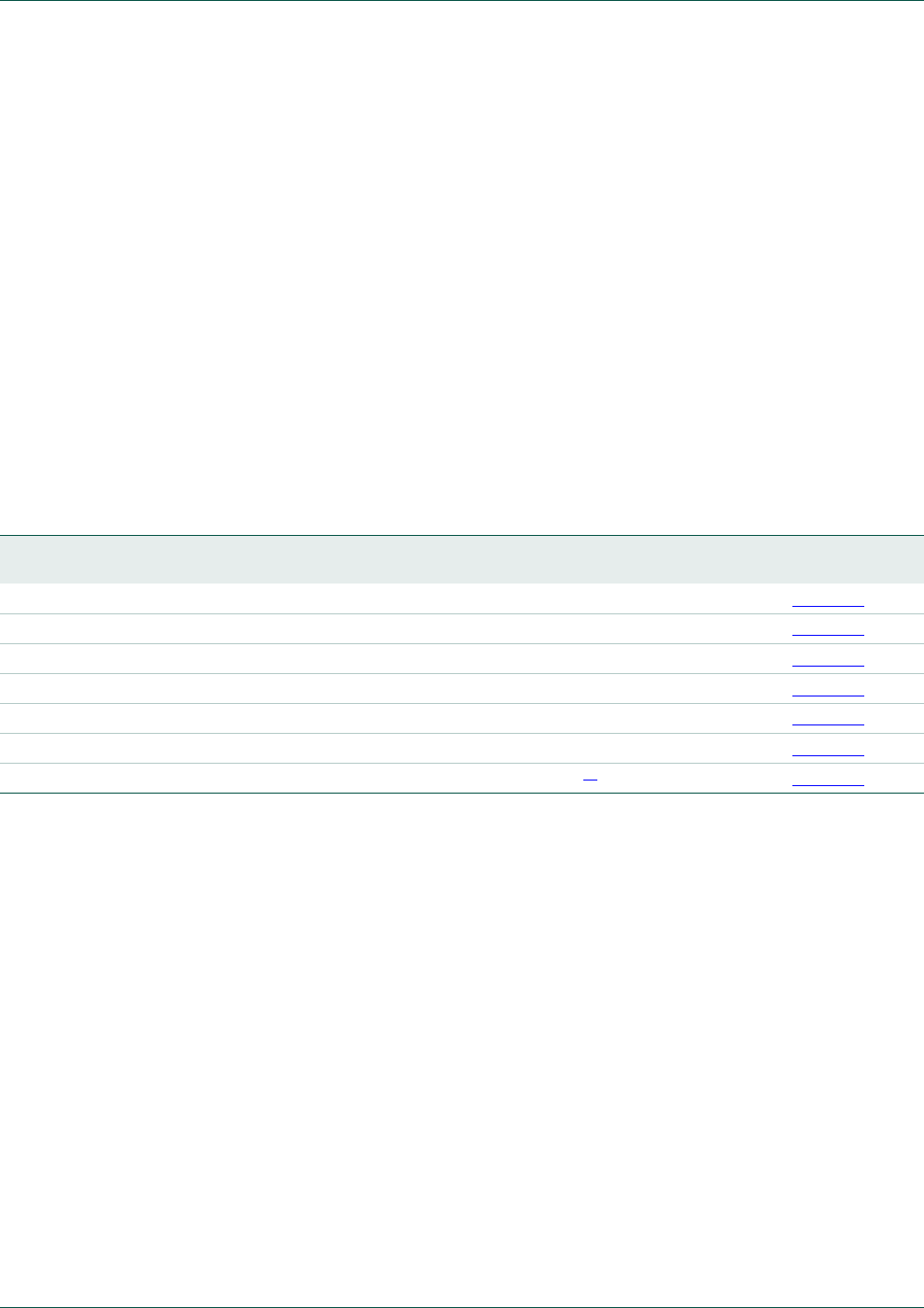
UM10360 All information provided in this document is subject to legal disclaimers. © NXP B.V. 2014. All rights reserved.
User manual Rev. 3.1 — 2 April 2014 769 of 849
NXP Semiconductors UM10360
Chapter 34: Appendix: Cortex-M3 user guide
34.4.2 Nested Vectored Interrupt Controller
This section describes the Nested Vectored Interrupt Controller (NVIC) and the registers it
uses. The NVIC supports:
•Up to 112 interrupts. The number of interrupts implemented is device dependent.
•A programmable priority level of 0 to 31 for each interrupt. A higher level corresponds
to a lower priority, so level 0 is the highest interrupt priority.
•Level and pulse detection of interrupt signals.
•Dynamic reprioritization of interrupts.
•Grouping of priority values into group priority and subpriority fields.
•Interrupt tail-chaining.
•An external Non-maskable interrupt (NMI).
The processor automatically stacks its state on exception entry and unstacks this state on
exception exit, with no instruction overhead. This provides low latency exception handling.
The hardware implementation of the NVIC registers is:
[1] Each array element corresponds to a single NVIC register, for example the element
ICER[1]
corresponds to the ICER1 register.
34.4.2.1 The CMSIS mapping of the Cortex-M3 NVIC registers
To improve software efficiency, the CMSIS simplifies the NVIC register presentation. In the
CMSIS:
•the Set-enable, Clear-enable, Set-pending, Clear-pending and Active Bit registers
map to arrays of 32-bit integers, so that:
–the array
ISER[0]
to
ISER[3]
corresponds to the registers ISER0 - ISER3
–the array
ICER[0]
to
ICER[3]
corresponds to the registers ICER0 - ICER3
–the array
ISPR[0]
to
ISPR[3]
corresponds to the registers ISPR0 - ISPR3
–the array
ICPR[0]
to
ICPR[3]
corresponds to the registers ICPR0 - ICPR3
–the array
IABR[0]
to
IABR[3]
corresponds to the registers IABR0 - IABR3.
•the 8-bit fields of the Interrupt Priority Registers map to an array of 8-bit integers, so
that the array
IP[0]
to
IP[112]
corresponds to the registers IPR0 - IPR59, and the
array entry
IP[n]
holds the interrupt priority for interrupt n.
Table 645. NVIC register summary
Address Name Type Required
privilege
Reset
value
Description
0xE000E100
-
0xE000E10C
ISER0 - ISER3 RW Privileged
0x00000000
Tab l e 6 4 7
0XE000E180
-
0xE000E18C
ICER0 - ICER3 RW Privileged
0x00000000
Tab l e 6 4 8
0XE000E200
-
0xE000E20C
ISPR0 - ISPR3 RW Privileged
0x00000000
Tab l e 6 4 9
0XE000E280
-
0xE000E28C
ICPR0 - ICPR3 RW Privileged
0x00000000
Tab l e 6 5 0
0xE000E300
-
0xE000E30C
IABR0 - IABR3 RO Privileged
0x00000000
Tab l e 6 5 1
0xE000E400
-
0xE000E46C
IPR0 - IPR27 RW Privileged
0x00000000
Tab l e 6 5 2
0xE000EF00
STIR WO Configurable[1]
0x00000000
Tab l e 6 5 3

UM10360 All information provided in this document is subject to legal disclaimers. © NXP B.V. 2014. All rights reserved.
User manual Rev. 3.1 — 2 April 2014 770 of 849
NXP Semiconductors UM10360
Chapter 34: Appendix: Cortex-M3 user guide
The CMSIS provides thread-safe code that gives atomic access to the Interrupt Priority
Registers. For more information see the description of the
NVIC_SetPriority
function in
Section 34.4.2.10.1 “NVIC programming hints”. Table 64 6 shows how the interrupts, or
IRQ numbers, map onto the interrupt registers and corresponding CMSIS variables that
have one bit per interrupt.
[1] Each array element corresponds to a single NVIC register, for example the element
ICER[1]
corresponds to the ICER1 register.
34.4.2.2 Interrupt Set-enable Registers
The ISER0-ISER3 registers enable interrupts, and show which interrupts are enabled.
See:
•the register summary in Tab l e 6 4 5 for the register attributes
•Tab l e 6 46 for which interrupts are controlled by each register.
The bit assignments are shown in Tab l e 6 47.
If a pending interrupt is enabled, the NVIC activates the interrupt based on its priority. If an
interrupt is not enabled, asserting its interrupt signal changes the interrupt state to
pending, but the NVIC never activates the interrupt, regardless of its priority.
34.4.2.3 Interrupt Clear-enable Registers
The ICER0-ICER3 registers disable interrupts, and show which interrupts are enabled.
See:
•the register summary in Tab l e 6 4 5 for the register attributes
•Tab l e 6 46 for which interrupts are controlled by each register.
The bit assignments are shown in Tab l e 6 48.
Table 646. Mapping of interrupts to the interrupt variables
Interrupts CMSIS array elements[1]
Set-enable Clear-enable Set-pending Clear-pending Active Bit
0-31
ISER[0] ICER[0] ISPR[0] ICPR[0] IABR[0]
32-63
ISER[1] ICER[1] ISPR[1] ICPR[1] IABR[1]
64-95
ISER[2] ICER[2] ISPR[2] ICPR[2] IABR[2]
96-127
ISER[3] ICER[3] ISPR[3] ICPR[3] IABR[3]
Table 647. ISER bit assignments
Bits Name Function
[31:0] SETENA Interrupt set-enable bits.
Write:
0 = no effect
1 = enable interrupt.
Read:
0 = interrupt disabled
1 = interrupt enabled.

UM10360 All information provided in this document is subject to legal disclaimers. © NXP B.V. 2014. All rights reserved.
User manual Rev. 3.1 — 2 April 2014 771 of 849
NXP Semiconductors UM10360
Chapter 34: Appendix: Cortex-M3 user guide
34.4.2.4 Interrupt Set-pending Registers
The ISPR0-ISPR3 registers force interrupts into the pending state, and show which
interrupts are pending. See:
•the register summary in Tab l e 6 4 5 for the register attributes
•Tab l e 6 46 for which interrupts are controlled by each register.
The bit assignments are shown in Tab l e 6 49.
Remark: Writing 1 to the ISPR bit corresponding to:
•an interrupt that is pending has no effect
•a disabled interrupt sets the state of that interrupt to pending.
34.4.2.5 Interrupt Clear-pending Registers
The ICPR0-ICPR3 registers remove the pending state from interrupts, and show which
interrupts are pending. See:
•the register summary in Tab l e 6 4 5 for the register attributes
•Tab l e 6 46 for which interrupts are controlled by each register.
The bit assignments are shown in Tab l e 6 50.
Table 648. ICER bit assignments
Bits Name Function
[31:0] CLRENA Interrupt clear-enable bits.
Write:
0 = no effect
1 = disable interrupt.
Read:
0 = interrupt disabled
1 = interrupt enabled.
Table 649. ISPR bit assignments
Bits Name Function
[31:0] SETPEND Interrupt set-pending bits.
Write:
0 = no effect
1 = changes interrupt state to pending.
Read:
0 = interrupt is not pending
1 = interrupt is pending.

UM10360 All information provided in this document is subject to legal disclaimers. © NXP B.V. 2014. All rights reserved.
User manual Rev. 3.1 — 2 April 2014 772 of 849
NXP Semiconductors UM10360
Chapter 34: Appendix: Cortex-M3 user guide
Remark: Writing 1 to an ICPR bit does not affect the active state of the corresponding
interrupt.
34.4.2.6 Interrupt Active Bit Registers
The IABR0-IABR3 registers indicate which interrupts are active. See:
•the register summary in Tab l e 6 4 5 for the register attributes
•Tab l e 6 46 for which interrupts are controlled by each register.
The bit assignments are shown in Tab l e 6 51.
A bit reads as one if the status of the corresponding interrupt is active or active and
pending.
34.4.2.7 Interrupt Priority Registers
The IPR0-IPR27 registers provide a 5-bit priority field for each interrupt. These registers
are byte-accessible. See the register summary in Ta b le 6 4 5 for their attributes. Each
register holds four priority fields, that map to four elements in the CMSIS interrupt priority
array
IP[0]
to
IP[111]
, as shown:
Table 650. ICPR bit assignments
Bits Name Function
[31:0] CLRPEND Interrupt clear-pending bits.
Write:
0 = no effect
1 = removes pending state an interrupt.
Read:
0 = interrupt is not pending
1 = interrupt is pending.
Table 651. IABR bit assignments
Bits Name Function
[31:0] ACTIVE Interrupt active flags:
0 = interrupt not active
1 = interrupt active.
IPR0
IPRm
IPR27
31 24 1623 15 780
.
.
.
IP[111] IP[109] IP[108]IP[110]
IP[4m+3] IP[4m+1] IP[4m]IP[4m+2]
IP[3] IP[1] IP[0]IP[2]
.
.
.
.
.
.
.
.
.

UM10360 All information provided in this document is subject to legal disclaimers. © NXP B.V. 2014. All rights reserved.
User manual Rev. 3.1 — 2 April 2014 773 of 849
NXP Semiconductors UM10360
Chapter 34: Appendix: Cortex-M3 user guide
See Ta b le 6 4 6 for more information about the
IP[0]
to
IP[111]
interrupt priority array, that
provides the software view of the interrupt priorities.
Find the IPR number and byte offset for interrupt N as follows:
•the corresponding IPR number, M, is given by M = N DIV 4
•the byte offset of the required Priority field in this register is N MOD 4, where:
–byte offset 0 refers to register bits[7:0]
–byte offset 1 refers to register bits[15:8]
–byte offset 2 refers to register bits[23:16]
–byte offset 3 refers to register bits[31:24].
34.4.2.8 Software Trigger Interrupt Register
Write to the STIR to generate a Software Generated Interrupt (SGI). See the register
summary in Tab l e 6 45 for the STIR attributes.
When the USERSETMPEND bit in the CCR is set to 1, unprivileged software can access
the STIR, see Section 34.4.3.8 “Configuration and Control Register”.
Remark: Only privileged software can enable unprivileged access to the STIR.
The bit assignments are shown in Tab l e 6 53.
34.4.2.9 Level-sensitive and pulse interrupts
The processor supports both level-sensitive and pulse interrupts. Pulse interrupts are also
described as edge-triggered interrupts.
A level-sensitive interrupt is held asserted until the peripheral deasserts the interrupt
signal. Typically this happens because the ISR accesses the peripheral, causing it to clear
the interrupt request. A pulse interrupt is an interrupt signal sampled synchronously on the
rising edge of the processor clock. To ensure the NVIC detects the interrupt, the
peripheral must assert the interrupt signal for at least one clock cycle, during which the
NVIC detects the pulse and latches the interrupt.
Table 652. IPR bit assignments
Bits Name Function
[31:24] Priority, byte offset 3 Each priority field holds a priority value, 0-31. The lower the
value, the greater the priority of the corresponding interrupt.
The processor implements only bits[7:3] of each field, bits[2:0]
read as zero and ignore writes.
[23:16] Priority, byte offset 2
[15:8] Priority, byte offset 1
[7:0] Priority, byte offset 0
Table 653. STIR bit assignments
Bits Field Function
[31:9] - Reserved.
[8:0] INTID Interrupt ID of the required SGI, in the range 0-111. For example, a value
of b000000011 specifies interrupt IRQ3.

UM10360 All information provided in this document is subject to legal disclaimers. © NXP B.V. 2014. All rights reserved.
User manual Rev. 3.1 — 2 April 2014 774 of 849
NXP Semiconductors UM10360
Chapter 34: Appendix: Cortex-M3 user guide
When the processor enters the ISR, it automatically removes the pending state from the
interrupt, see Section 34.4.2.9.1. For a level-sensitive interrupt, if the signal is not
deasserted before the processor returns from the ISR, the interrupt becomes pending
again, and the processor must execute its ISR again. This means that the peripheral can
hold the interrupt signal asserted until it no longer needs servicing.
34.4.2.9.1 Hardware and software control of interrupts
The Cortex-M3 latches all interrupts. A peripheral interrupt becomes pending for one of
the following reasons:
•the NVIC detects that the interrupt signal is HIGH and the interrupt is not active
•the NVIC detects a rising edge on the interrupt signal
•software writes to the corresponding interrupt set-pending register bit, see Tab l e 6 4 9 ,
or to the STIR to make an SGI pending, see Table 653.
A pending interrupt remains pending until one of the following:
•The processor enters the ISR for the interrupt. This changes the state of the interrupt
from pending to active. Then:
–For a level-sensitive interrupt, when the processor returns from the ISR, the NVIC
samples the interrupt signal. If the signal is asserted, the state of the interrupt
changes to pending, which might cause the processor to immediately re-enter the
ISR. Otherwise, the state of the interrupt changes to inactive.
–For a pulse interrupt, the NVIC continues to monitor the interrupt signal, and if this
is pulsed the state of the interrupt changes to pending and active. In this case,
when the processor returns from the ISR the state of the interrupt changes to
pending, which might cause the processor to immediately re-enter the ISR.
If the interrupt signal is not pulsed while the processor is in the ISR, when the
processor returns from the ISR the state of the interrupt changes to inactive.
•Software writes to the corresponding interrupt clear-pending register bit.
For a level-sensitive interrupt, if the interrupt signal is still asserted, the state of the
interrupt does not change. Otherwise, the state of the interrupt changes to inactive.
For a pulse interrupt, state of the interrupt changes to:
–inactive, if the state was pending
–active, if the state was active and pending.
34.4.2.10 NVIC design hints and tips
Ensure software uses correctly aligned register accesses. The processor does not
support unaligned accesses to NVIC registers. See the individual register descriptions for
the supported access sizes.
A interrupt can enter pending state even it is disabled.
Before programming VTOR to relocate the vector table, ensure the vector table entries of
the new vector table are setup for fault handlers, NMI and all enabled exception like
interrupts. For more information see Ta b l e 6 59 .

UM10360 All information provided in this document is subject to legal disclaimers. © NXP B.V. 2014. All rights reserved.
User manual Rev. 3.1 — 2 April 2014 775 of 849
NXP Semiconductors UM10360
Chapter 34: Appendix: Cortex-M3 user guide
34.4.2.10.1 NVIC programming hints
Software uses the CPSIE I and CPSID I instructions to enable and disable interrupts. The
CMSIS provides the following intrinsic functions for these instructions:
void __disable_irq(void) // Disable Interrupts
void __enable_irq(void) // Enable Interrupts
In addition, the CMSIS provides a number of functions for NVIC control, including:
For more information about these functions see the CMSIS documentation.
Table 654. CMSIS functions for NVIC control
CMSIS interrupt control function Description
void NVIC_SetPriorityGrouping(uint32_t priority_grouping)
Set the priority grouping
void NVIC_EnableIRQ(IRQn_t IRQn)
Enable IRQn
void NVIC_DisableIRQ(IRQn_t IRQn)
Disable IRQn
uint32_t NVIC_GetPendingIRQ (IRQn_t IRQn)
Return true (IRQ-Number) if IRQn is pending
void NVIC_SetPendingIRQ (IRQn_t IRQn)
Set IRQn pending
void NVIC_ClearPendingIRQ (IRQn_t IRQn)
Clear IRQn pending status
uint32_t NVIC_GetActive (IRQn_t IRQn)
Return the IRQ number of the active interrupt
void NVIC_SetPriority (IRQn_t IRQn, uint32_t priority)
Set priority for IRQn
uint32_t NVIC_GetPriority (IRQn_t IRQn)
Read priority of IRQn
void NVIC_SystemReset (void)
Reset the system
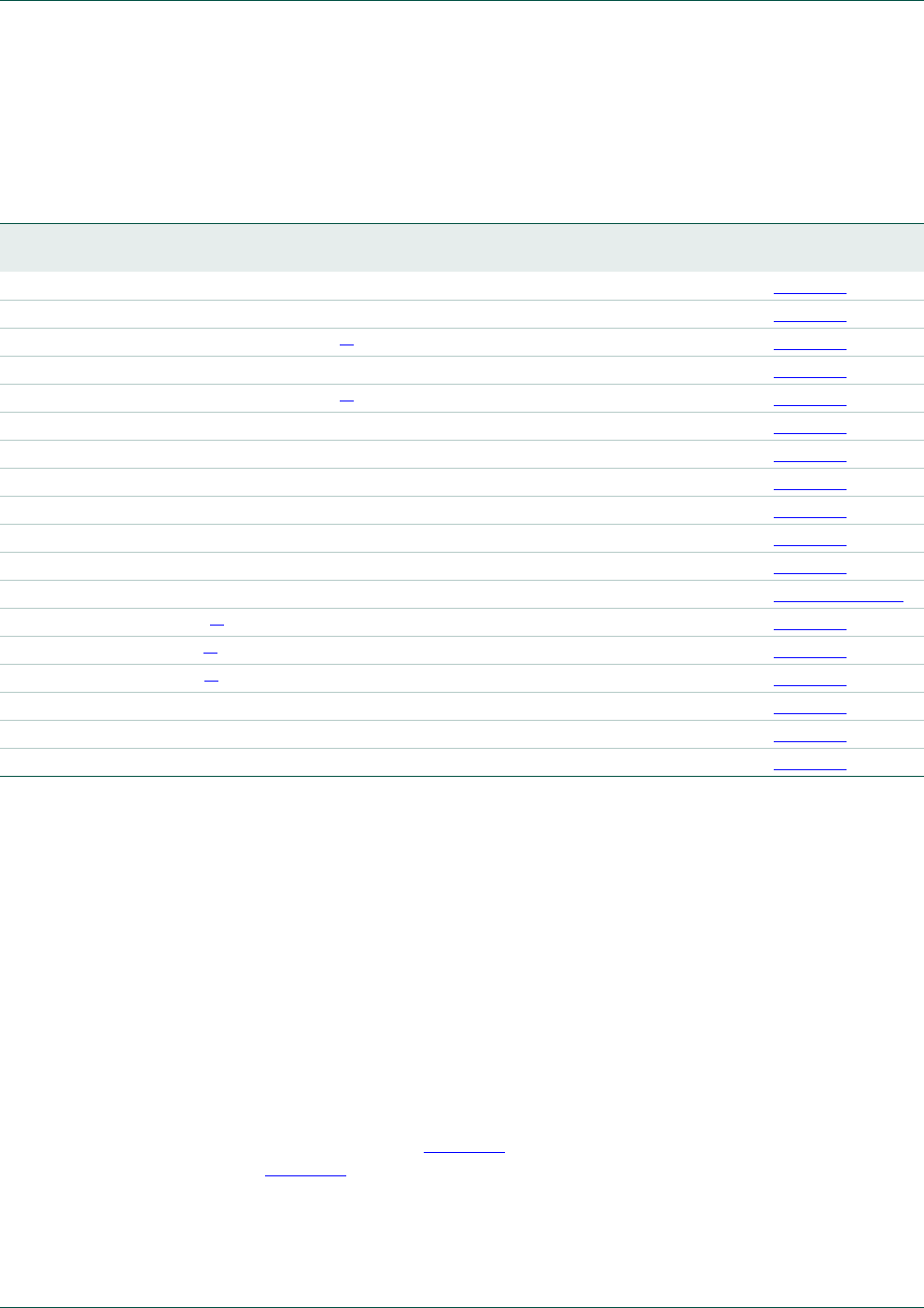
UM10360 All information provided in this document is subject to legal disclaimers. © NXP B.V. 2014. All rights reserved.
User manual Rev. 3.1 — 2 April 2014 776 of 849
NXP Semiconductors UM10360
Chapter 34: Appendix: Cortex-M3 user guide
34.4.3 System control block
The System control block (SCB) provides system implementation information, and
system control. This includes configuration, control, and reporting of the system
exceptions. The system control block registers are:
[1] See the register description for more information.
[2] A subregister of the CFSR.
34.4.3.1 The CMSIS mapping of the Cortex-M3 SCB registers
To improve software efficiency, the CMSIS simplifies the SCB register presentation. In the
CMSIS, the byte array
SHP[0]
to
SHP[12]
corresponds to the registers SHPR1-SHPR3.
34.4.3.2 Auxiliary Control Register
The ACTLR provides disable bits for the following processor functions:
•IT folding
•write buffer use for accesses to the default memory map
•interruption of multi-cycle instructions.
See the register summary in Ta b l e 6 5 5 for the ACTLR attributes. The bit assignments are
shown in Ta b l e 65 6 .
Table 655. Summary of the system control block registers
Address Name Type Required
privilege
Reset
value
Description
0xE000E008
ACTLR RW Privileged
0x00000000
Tab l e 6 56
0xE000ED00
CPUID RO Privileged
0x412FC230
Tab l e 6 57
0xE000ED04
ICSR RW[1] Privileged
0x00000000
Tab l e 6 58
0xE000ED08
VTOR RW Privileged
0x00000000
Tab l e 6 59
0xE000ED0C
AIRCR RW[1] Privileged
0xFA050000
Tab l e 6 60
0xE000ED10
SCR RW Privileged
0x00000000
Tab l e 6 62
0xE000ED14
CCR RW Privileged
0x00000200
Tab l e 6 63
0xE000ED18
SHPR1 RW Privileged
0x00000000
Tab l e 6 65
0xE000ED1C
SHPR2 RW Privileged
0x00000000
Tab l e 6 66
0xE000ED20
SHPR3 RW Privileged
0x00000000
Tab l e 6 67
0xE000ED24
SHCRS RW Privileged
0x00000000
Tab l e 6 68
0xE000ED28
CFSR RW Privileged
0x00000000
Section 34.4.3.11
0xE000ED28
MMSR[2] RW Privileged
0x00
Tab l e 6 69
0xE000ED29
BFSR[2] RW Privileged
0x00
Tab l e 6 70
0xE000ED2A
UFSR[2] RW Privileged
0x0000
Tab l e 6 71
0xE000ED2C
HFSR RW Privileged
0x00000000
Tab l e 6 72
0xE000ED34
MMFAR RW Privileged Undefined Tabl e 6 7 3
0xE000ED38
BFAR RW Privileged Undefined Tab l e 6 7 4

UM10360 All information provided in this document is subject to legal disclaimers. © NXP B.V. 2014. All rights reserved.
User manual Rev. 3.1 — 2 April 2014 777 of 849
NXP Semiconductors UM10360
Chapter 34: Appendix: Cortex-M3 user guide
34.4.3.2.1 About IT folding
In some situations, the processor can start executing the first instruction in an IT block
while it is still executing the
IT
instruction. This behavior is called IT folding, and improves
performance, However, IT folding can cause jitter in looping. If a task must avoid jitter, set
the DISFOLD bit to 1 before executing the task, to disable IT folding.
34.4.3.3 CPUID Base Register
The CPUID register contains the processor part number, version, and implementation
information. See the register summary in Tab l e 6 55 for its attributes. The bit assignments
are shown in Ta b l e 6 57 .
34.4.3.4 Interrupt Control and State Register
The ICSR:
•provides:
–a set-pending bit for the Non-Maskable Interrupt (NMI) exception
–set-pending and clear-pending bits for the PendSV and SysTick exceptions
•indicates:
–the exception number of the exception being processed
Table 656. ACTLR bit assignments
Bits Name Function
[31:3] - Reserved
[2] DISFOLD When set to 1, disables IT folding. see Section 34.4.3.2.1 for more
information.
[1] DISDEFWBUF When set to 1, disables write buffer use during default memory map
accesses. This causes all bus faults to be precise bus faults but
decreases performance because any store to memory must complete
before the processor can execute the next instruction.
Remark: This bit only affects write buffers implemented in the
Cortex-M3 processor.
[0] DISMCYCINT When set to 1, disables interruption of load multiple and store multiple
instructions. This increases the interrupt latency of the processor
because any LDM or STM must complete before the processor can
stack the current state and enter the interrupt handler.
Table 657. CPUID register bit assignments
Bits Name Function
[31:24] Implementer Implementer code:
0x41
= ARM
[23:20] Variant Variant number, the r value in the rnpn product revision identifier:
0x2 = r2p0
[19:16] Constant Reads as
0xF
[15:4] PartNo Part number of the processor:
0xC23
= Cortex-M3
[3:0] Revision Revision number, the p value in the rnpn product revision identifier:
0x0 = r2p0

UM10360 All information provided in this document is subject to legal disclaimers. © NXP B.V. 2014. All rights reserved.
User manual Rev. 3.1 — 2 April 2014 778 of 849
NXP Semiconductors UM10360
Chapter 34: Appendix: Cortex-M3 user guide
–whether there are preempted active exceptions
–the exception number of the highest priority pending exception
–whether any interrupts are pending.
See the register summary in Ta b le 65 5 , and the Type descriptions in Tab l e 6 58 , for the
ICSR attributes. The bit assignments are shown in Tab le 65 8 .
Table 658. ICSR bit assignments
Bits Name Type Function
[31] NMIPENDSET RW NMI set-pending bit.
Write:
0 = no effect
1 = changes NMI exception state to pending.
Read:
0 = NMI exception is not pending
1 = NMI exception is pending.
Because NMI is the highest-priority exception, normally the
processor enter the NMI exception handler as soon as it
registers a write of 1 to this bit, and entering the handler clears
this bit to 0. A read of this bit by the NMI exception handler
returns 1 only if the NMI signal is reasserted while the
processor is executing that handler.
[30:29] - - Reserved.
[28] PENDSVSET RW PendSV set-pending bit.
Write:
0 = no effect
1 = changes PendSV exception state to pending.
Read:
0 = PendSV exception is not pending
1 = PendSV exception is pending.
Writing 1 to this bit is the only way to set the PendSV
exception state to pending.
[27] PENDSVCLR WO PendSV clear-pending bit.
Write:
0 = no effect
1 = removes the pending state from the PendSV exception.
[26] PENDSTSET RW SysTick exception set-pending bit.
Write:
0 = no effect
1 = changes SysTick exception state to pending.
Read:
0 = SysTick exception is not pending
1 = SysTick exception is pending.

UM10360 All information provided in this document is subject to legal disclaimers. © NXP B.V. 2014. All rights reserved.
User manual Rev. 3.1 — 2 April 2014 779 of 849
NXP Semiconductors UM10360
Chapter 34: Appendix: Cortex-M3 user guide
[1] This is the same value as IPSR bits[8:0], see Tab l e 6 3 0 “ IPSR bit assignments”.
When you write to the ICSR, the effect is unpredictable if you:
•write 1 to the PENDSVSET bit and write 1 to the PENDSVCLR bit
•write 1 to the PENDSTSET bit and write 1 to the PENDSTCLR bit.
34.4.3.5 Vector Table Offset Register
The VTOR indicates the offset of the vector table base address from memory address
0x00000000
. See the register summary in Tab l e 655 for its attributes.
The bit assignments are shown in Tab l e 6 59.
[25] PENDSTCLR WO SysTick exception clear-pending bit.
Write:
0 = no effect
1 = removes the pending state from the SysTick exception.
This bit is WO. On a register read its value is Unknown.
[24] - - Reserved.
[23] Reserved for
Debug use
RO This bit is reserved for Debug use and reads-as-zero when
the processor is not in Debug.
[22] ISRPENDING RO Interrupt pending flag, excluding NMI and Faults:
0 = interrupt not pending
1 = interrupt pending.
[21:18] - -Reserved.
[17:12] VECTPENDING RO Indicates the exception number of the highest priority pending
enabled exception:
0 = no pending exceptions
Nonzero = the exception number of the highest priority
pending enabled exception.
The value indicated by this field includes the effect of the
BASEPRI and FAULTMASK registers, but not any effect of the
PRIMASK register.
[11] RETTOBASE RO Indicates whether there are preempted active exceptions:
0 = there are preempted active exceptions to execute
1 = there are no active exceptions, or the currently-executing
exception is the only active exception.
[10:9] - -Reserved.
[8:0] VECTACTIVE[1] RO Contains the active exception number:
0 = Thread mode
Nonzero = The exception number[1] of the currently active
exception.
Remark: Subtract 16 from this value to obtain the IRQ
number required to index into the Interrupt Clear-Enable,
Set-Enable, Clear-Pending, Set-Pending, or Priority
Registers, see Tabl e 63 0 “ IPSR bit assignments”.
Table 658. ICSR bit assignments …continued
Bits Name Type Function

UM10360 All information provided in this document is subject to legal disclaimers. © NXP B.V. 2014. All rights reserved.
User manual Rev. 3.1 — 2 April 2014 780 of 849
NXP Semiconductors UM10360
Chapter 34: Appendix: Cortex-M3 user guide
When setting TBLOFF, you must align the offset to the number of exception entries in the
vector table. The recommended alignment is 256 words, allowing for 128 interrupts.
Remark: Tab l e a l ign m en t r equ i rem e n ts me a n t h a t b i ts [ 7: 0 ] of the t a ble o ff s et a re a lwa y s
zero.
34.4.3.6 Application Interrupt and Reset Control Register
The AIRCR provides priority grouping control for the exception model, endian status for
data accesses, and reset control of the system. See the register summary in Table 6 5 5
and Table 660 for its attributes.
To write to this register, you must write
0x5FA
to the VECTKEY field, otherwise the
processor ignores the write.
The bit assignments are shown in Tab l e 6 60.
Table 659. VTOR bit assignments
Bits Name Function
[31:30] - Reserved.
[29:8] TBLOFF Vector table base offset field. It contains bits[29:8] of the offset of the table
base from the bottom of the memory map.
Remark: Bit[29] determines whether the vector table is in the code or
SRAM memory region:
Bit[29] is sometimes called the TBLBASE bit.
•0 = code
•1 = SRAM.
[7:0] - Reserved.
Table 660. AIRCR bit assignments
Bits Name Type Function
[31:16] Write:
VECTKEYSTAT
Read: VECTKEY
RW Register key:
Reads as
0x05FA
On writes, write
0x5FA
to VECTKEY, otherwise the write is
ignored.
[15] ENDIANESS RO Data endianness bit:
0 = Little-endian.
[14:11] - - Reserved
[10:8] PRIGROUP R/W Interrupt priority grouping field. This field determines the
split of group priority from subpriority, see
Section 34.4.3.6.1.
[7:3] - - Reserved.

UM10360 All information provided in this document is subject to legal disclaimers. © NXP B.V. 2014. All rights reserved.
User manual Rev. 3.1 — 2 April 2014 781 of 849
NXP Semiconductors UM10360
Chapter 34: Appendix: Cortex-M3 user guide
34.4.3.6.1 Binary point
The PRIGROUP field indicates the position of the binary point that splits the PRI_n fields
in the Interrupt Priority Registers into separate group priority and subpriority fields.
Tab l e 6 61 shows how the PRIGROUP value controls this split.
[1] PRI_n[7:0] field showing the binary point. x denotes a group priority field bit, and y denotes a subpriority field bit. Bits [2:0] are not used
in LPC176x/5x devices.
Remark: Determining preemption of an exception uses only the group priority field, see
Section 34.3.3.6 “Interrupt priority grouping”.
34.4.3.7 System Control Register
The SCR controls features of entry to and exit from low power state. See the register
summary in Tab l e 6 55 for its attributes. The bit assignments are shown in Ta bl e 6 6 2 .
[2] SYSRESETREQ WO System reset request:
0 = no system reset request
1 = asserts a signal to the outer system that requests a
reset.
This is intended to force a large system reset of all major
components except for debug.
This bit reads as 0.
[1] VECTCLRACTIVE WO Reserved for Debug use. This bit reads as 0. When writing
to the register you must write 0 to this bit, otherwise
behavior is Unpredictable.
[0] VECTRESET WO Reserved for Debug use. This bit reads as 0. When writing
to the register you must write 0 to this bit, otherwise
behavior is Unpredictable.
Table 660. AIRCR bit assignments …continued
Bits Name Type Function
Table 661. Priority grouping
Interrupt priority level value, PRI_N[7:0] Number of
PRIGROUP Binary point[1] Group priority
bits
Subpriority bits Group priorities Subpriorities
b010 bxxxxx.000 [7:3] none 32 1
b011 bxxxx.y000 [7:4] [3] 16 2
b100 bxxx.yy000 [7:5] [4:3] 8 4
b101 bxx.yyy000 [7:6] [5:3] 4 8
b110 bx.yyyy000 [7] [6:3] 216
b111 b.yyyyy000 None [7:3] 132

UM10360 All information provided in this document is subject to legal disclaimers. © NXP B.V. 2014. All rights reserved.
User manual Rev. 3.1 — 2 April 2014 782 of 849
NXP Semiconductors UM10360
Chapter 34: Appendix: Cortex-M3 user guide
34.4.3.8 Configuration and Control Register
The CCR controls entry to Thread mode and enables:
•the handlers for NMI, hard fault and faults escalated by FAULTMASK to ignore bus
faults
•trapping of divide by zero and unaligned accesses
•access to the STIR by unprivileged software, see Tab l e 6 5 3 .
See the register summary in Ta b le 65 5 for the CCR attributes.
The bit assignments are shown in Tab l e 6 63.
Table 662. SCR bit assignments
Bits Name Function
[31:5] - Reserved.
[4] SEVONPEND Send Event on Pending bit:
0 = only enabled interrupts or events can wakeup the processor,
disabled interrupts are excluded
1 = enabled events and all interrupts, including disabled interrupts,
can wakeup the processor.
When an event or interrupt enters pending state, the event signal
wakes up the processor from WFE. If the processor is not waiting
for an event, the event is registered and affects the next WFE.
The processor also wakes up on execution of an
SEV
instruction or
an external event.
[3] - Reserved.
[2] SLEEPDEEP Controls whether the processor uses sleep or deep sleep as its low
power mode:
0 = sleep
1 = deep sleep.
[1] SLEEPONEXIT Indicates sleep-on-exit when returning from Handler mode to
Thread mode:
0 = do not sleep when returning to Thread mode.
1 = enter sleep, or deep sleep, on return from an ISR.
Setting this bit to 1 enables an interrupt driven application to avoid
returning to an empty main application.
[0] - Reserved.

UM10360 All information provided in this document is subject to legal disclaimers. © NXP B.V. 2014. All rights reserved.
User manual Rev. 3.1 — 2 April 2014 783 of 849
NXP Semiconductors UM10360
Chapter 34: Appendix: Cortex-M3 user guide
34.4.3.9 System Handler Priority Registers
The SHPR1-SHPR3 registers set the priority level, 0 to 31 of the exception handlers that
have configurable priority.
SHPR1-SHPR3 are byte accessible. See the register summary in Table 655 for their
attributes.
The system fault handlers and the priority field and register for each handler are:
Table 663. CCR bit assignments
Bits Name Function
[31:10] - Reserved.
[9] STKALIGN Indicates stack alignment on exception entry:
0 = 4-byte aligned
1 = 8-byte aligned.
On exception entry, the processor uses bit[9] of the stacked PSR to
indicate the stack alignment. On return from the exception it uses this
stacked bit to restore the correct stack alignment.
[8] BFHFNMIGN Enables handlers with priority -1 or -2 to ignore data bus faults caused
by load and store instructions. This applies to the hard fault, NMI, and
FAULTMASK escalated handlers:
0 = data bus faults caused by load and store instructions cause a lock-up
1 = handlers running at priority -1 and -2 ignore data bus faults caused
by load and store instructions.
Set this bit to 1 only when the handler and its data are in absolutely safe
memory. The normal use of this bit is to probe system devices and
bridges to detect control path problems and fix them.
[7:5] - Reserved.
[4] DIV_0_TRP Enables faulting or halting when the processor executes an
SDIV
or
UDIV
instruction with a divisor of 0:
0 = do not trap divide by 0
1 = trap divide by 0.
When this bit is set to 0,a divide by zero returns a quotient of 0.
[3] UNALIGN_T
RP
Enables unaligned access traps:
0 = do not trap unaligned halfword and word accesses
1 = trap unaligned halfword and word accesses.
If this bit is set to 1, an unaligned access generates a usage fault.
Unaligned
LDM
,
STM
,
LDRD
, and
STRD
instructions always fault irrespective
of whether UNALIGN_TRP is set to 1.
[2] - Reserved.
[1] USERSETM
PEND
Enables unprivileged software access to the STIR, see Tab l e 6 53:
0 = disable
1 = enable.
[0] NONEBASE
THRDENA
Indicates how the processor enters Thread mode:
0 = processor can enter Thread mode only when no exception is active.
1 = processor can enter Thread mode from any level under the control of
an EXC_RETURN value, see Section 34.3.3.7.2 “Exception return”.

UM10360 All information provided in this document is subject to legal disclaimers. © NXP B.V. 2014. All rights reserved.
User manual Rev. 3.1 — 2 April 2014 784 of 849
NXP Semiconductors UM10360
Chapter 34: Appendix: Cortex-M3 user guide
Each PRI_N field is 8 bits wide, but the processor implements only bits[7:3] of each field,
and bits[2:0] read as zero and ignore writes.
34.4.3.9.1 System Handler Priority Register 1
The bit assignments are shown in Tab l e 6 65.
34.4.3.9.2 System Handler Priority Register 2
The bit assignments are shown in Tab l e 6 66.
34.4.3.9.3 System Handler Priority Register 3
The bit assignments are shown in Tab l e 6 67.
34.4.3.10 System Handler Control and State Register
The SHCSR enables the system handlers, and indicates:
•the pending status of the bus fault, memory management fault, and SVC exceptions
•the active status of the system handlers.
See the register summary in Ta b le 6 5 5 for the SHCSR attributes. The bit assignments are
shown in Ta b l e 66 8 .
Table 664. System fault handler priority fields
Handler Field Register description
Memory management fault PRI_4 Ta b l e 6 6 5
Bus fault PRI_5
Usage fault PRI_6
SVCall PRI_11 Ta b l e 6 6 6
PendSV PRI_14 Ta b l e 6 6 7
SysTick PRI_15
Table 665. SHPR1 register bit assignments
Bits Name Function
[31:24] PRI_7 Reserved
[23:16] PRI_6 Priority of system handler 6, usage fault
[15:8] PRI_5 Priority of system handler 5, bus fault
[7:0] PRI_4 Priority of system handler 4, memory management fault
Table 666. SHPR2 register bit assignments
Bits Name Function
[31:24] PRI_11 Priority of system handler 11, SVCall
[23:0] -Reserved
Table 667. SHPR3 register bit assignments
Bits Name Function
[31:24] PRI_15 Priority of system handler 15, SysTick exception
[23:16] PRI_14 Priority of system handler 14, PendSV
[15:0] -Reserved

UM10360 All information provided in this document is subject to legal disclaimers. © NXP B.V. 2014. All rights reserved.
User manual Rev. 3.1 — 2 April 2014 785 of 849
NXP Semiconductors UM10360
Chapter 34: Appendix: Cortex-M3 user guide
[1] Enable bits, set to 1 to enable the exception, or set to 0 to disable the exception.
[2] Pending bits, read as 1 if the exception is pending, or as 0 if it is not pending. You can write to these bits to
change the pending status of the exceptions.
[3] Active bits, read as 1 if the exception is active, or as 0 if it is not active. You can write to these bits to change
the active status of the exceptions, but see the Caution in this section.
If you disable a system handler and the corresponding fault occurs, the processor treats
the fault as a hard fault.
You can write to this register to change the pending or active status of system exceptions.
An OS kernel can write to the active bits to perform a context switch that changes the
current exception type.
Caution
•Software that changes the value of an active bit in this register without correct
adjustment to the stacked content can cause the processor to generate a fault
exception. Ensure software that writes to this register retains and subsequently
restores the current active status.
•After you have enabled the system handlers, if you have to change the value of a bit
in this register you must use a read-modify-write procedure to ensure that you change
only the required bit.
Table 668. SHCSR bit assignments
Bits Name Function
[31:19] - Reserved
[18] USGFAULTENA Usage fault enable bit, set to 1 to enable[1]
[17] BUSFAULTENA Bus fault enable bit, set to 1 to enable[1]
[16] MEMFAULTENA Memory management fault enable bit, set to 1 to enable[1]
[15] SVCALLPENDED SVC call pending bit, reads as 1 if exception is pending[2]
[14] BUSFAULTPENDED Bus fault exception pending bit, reads as 1 if exception is
pending[2]
[13] MEMFAULTPENDED Memory management fault exception pending bit, reads as 1 if
exception is pending[2]
[12] USGFAULTPENDED Usage fault exception pending bit, reads as 1 if exception is
pending[2]
[11] SYSTICKACT SysTick exception active bit, reads as 1 if exception is active[3]
[10] PENDSVACT PendSV exception active bit, reads as 1 if exception is active
[9] - Reserved
[8] MONITORACT Debug monitor active bit, reads as 1 if Debug monitor is active
[7] SVCALLACT SVC call active bit, reads as 1 if SVC call is active
[6:4] - Reserved
[3] USGFAULTACT Usage fault exception active bit, reads as 1 if exception is
active
[2] - Reserved
[1] BUSFAULTACT Bus fault exception active bit, reads as 1 if exception is active
[0] MEMFAULTACT Memory management fault exception active bit, reads as 1 if
exception is active

UM10360 All information provided in this document is subject to legal disclaimers. © NXP B.V. 2014. All rights reserved.
User manual Rev. 3.1 — 2 April 2014 786 of 849
NXP Semiconductors UM10360
Chapter 34: Appendix: Cortex-M3 user guide
34.4.3.11 Configurable Fault Status Register
The CFSR indicates the cause of a memory management fault, bus fault, or usage fault.
See the register summary in Ta b le 65 5 for its attributes. The bit assignments are:
The following subsections describe the subregisters that make up the CFSR:
•Tab l e 6 6 9 “MMFSR bit assignments”
•Tab l e 6 7 4 “BFAR bit assignments”
•Tab l e 6 7 1 “UFSR bit assignments”.
The CFSR is byte accessible. You can access the CFSR or its subregisters as follows:
•access the complete CFSR with a word access to
0xE000ED28
•access the MMFSR with a byte access to
0xE000ED28
•access the MMFSR and BFSR with a halfword access to
0xE000ED28
•access the BFSR with a byte access to
0xE000ED29
•access the UFSR with a halfword access to
0xE000ED2A
.
34.4.3.11.1 Memory Management Fault Status Register
The flags in the MMFSR indicate the cause of memory access faults. The bit assignments
are shown in Ta b l e 6 69 .
Fig 150. CFSR bit assignments
0HPRU\0DQDJHPHQW
)DXOW6WDWXV5HJLVWHU
8VDJH)DXOW6WDWXV5HJLVWHU %XV)DXOW6WDWXV
5HJLVWHU
8)65 %)65 00)65
Table 669. MMFSR bit assignments
Bits Name Function
[7] MMARVALID Memory Management Fault Address Register (MMAR) valid flag:
0 = value in MMAR is not a valid fault address
1 = MMAR holds a valid fault address.
If a memory management fault occurs and is escalated to a hard
fault because of priority, the hard fault handler must set this bit to 0.
This prevents problems on return to a stacked active memory
management fault handler whose MMAR value has been
overwritten.
[6:5] - Reserved.
[4] MSTKERR Memory manager fault on stacking for exception entry:
0 = no stacking fault
1 = stacking for an exception entry has caused one or more access
violations.
When this bit is 1, the SP is still adjusted but the values in the
context area on the stack might be incorrect. The processor has not
written a fault address to the MMAR.

UM10360 All information provided in this document is subject to legal disclaimers. © NXP B.V. 2014. All rights reserved.
User manual Rev. 3.1 — 2 April 2014 787 of 849
NXP Semiconductors UM10360
Chapter 34: Appendix: Cortex-M3 user guide
34.4.3.11.2 Bus Fault Status Register
The flags in the BFSR indicate the cause of a bus access fault. The bit assignments are
shown in Ta b l e 67 0 .
[3] MUNSTKERR Memory manager fault on unstacking for a return from exception:
0 = no unstacking fault
1 = unstack for an exception return has caused one or more access
violations.
This fault is chained to the handler. This means that when this bit is
1, the original return stack is still present. The processor has not
adjusted the SP from the failing return, and has not performed a new
save. The processor has not written a fault address to the MMAR.
[2] - Reserved
[1] DACCVIOL Data access violation flag:
0 = no data access violation fault
1 = the processor attempted a load or store at a location that does
not permit the operation.
When this bit is 1, the PC value stacked for the exception return
points to the faulting instruction. The processor has loaded the
MMAR with the address of the attempted access.
[0] IACCVIOL Instruction access violation flag:
0 = no instruction access violation fault
1 = the processor attempted an instruction fetch from a location that
does not permit execution.
This fault occurs on any access to an XN region, even when the
MPU is disabled.
When this bit is 1, the PC value stacked for the exception return
points to the faulting instruction. The processor has not written a
fault address to the MMAR.
Table 669. MMFSR bit assignments …continued
Bits Name Function
Table 670. BFSR bit assignments
Bits Name Function
[7] BFARVALID Bus Fault Address Register (BFAR) valid flag:
0 = value in BFAR is not a valid fault address
1 = BFAR holds a valid fault address.
The processor sets this bit to 1 after a bus fault where the address is
known. Other faults can set this bit to 0, such as a memory management
fault occurring later.
If a bus fault occurs and is escalated to a hard fault because of priority,
the hard fault handler must set this bit to 0. This prevents problems if
returning to a stacked active bus fault handler whose BFAR value has
been overwritten.
[6:5] - Reserved.

UM10360 All information provided in this document is subject to legal disclaimers. © NXP B.V. 2014. All rights reserved.
User manual Rev. 3.1 — 2 April 2014 788 of 849
NXP Semiconductors UM10360
Chapter 34: Appendix: Cortex-M3 user guide
34.4.3.11.3 Usage Fault Status Register
The UFSR indicates the cause of a usage fault. The bit assignments are shown in
Tab l e 6 71 .
[4] STKERR Bus fault on stacking for exception entry:
0 = no stacking fault
1 = stacking for an exception entry has caused one or more bus faults.
When the processor sets this bit to 1, the SP is still adjusted but the
values in the context area on the stack might be incorrect. The
processor does not write a fault address to the BFAR.
[3] UNSTKERR Bus fault on unstacking for a return from exception:
0 = no unstacking fault
1 = unstack for an exception return has caused one or more bus faults.
This fault is chained to the handler. This means that when the processor
sets this bit to 1, the original return stack is still present. The processor
does not adjust the SP from the failing return, does not performed a new
save, and does not write a fault address to the BFAR.
[2] IMPRECISERR Imprecise data bus error:
0 = no imprecise data bus error
1 = a data bus error has occurred, but the return address in the stack
frame is not related to the instruction that caused the error.
When the processor sets this bit to 1, it does not write a fault address to
the BFAR.
This is an asynchronous fault. Therefore, if it is detected when the
priority of the current process is higher than the bus fault priority, the bus
fault becomes pending and becomes active only when the processor
returns from all higher priority processes. If a precise fault occurs before
the processor enters the handler for the imprecise bus fault, the handler
detects both IMPRECISERR set to 1 and one of the precise fault status
bits set to 1.
[1] PRECISERR Precise data bus error:
0 = no precise data bus error
1 = a data bus error has occurred, and the PC value stacked for the
exception return points to the instruction that caused the fault.
When the processor sets this bit is 1, it writes the faulting address to the
BFAR.
[0] IBUSERR Instruction bus error:
0 = no instruction bus error
1 = instruction bus error.
The processor detects the instruction bus error on prefetching an
instruction, but it sets the IBUSERR flag to 1 only if it attempts to issue
the faulting instruction.
When the processor sets this bit is 1, it does not write a fault address to
the BFAR.
Table 670. BFSR bit assignments …continued
Bits Name Function

UM10360 All information provided in this document is subject to legal disclaimers. © NXP B.V. 2014. All rights reserved.
User manual Rev. 3.1 — 2 April 2014 789 of 849
NXP Semiconductors UM10360
Chapter 34: Appendix: Cortex-M3 user guide
Remark: The UFSR bits are sticky. This means as one or more fault occurs, the
associated bits are set to 1. A bit that is set to 1 is cleared to 0 only by writing 1 to that bit,
or by a reset.
Table 671. UFSR bit assignments
Bits Name Function
[15:10] - Reserved.
[9] DIVBYZERO Divide by zero usage fault:
0 = no divide by zero fault, or divide by zero trapping not enabled
1 = the processor has executed an
SDIV
or
UDIV
instruction with a divisor
of 0.
When the processor sets this bit to 1, the PC value stacked for the
exception return points to the instruction that performed the divide by
zero.
Enable trapping of divide by zero by setting the DIV_0_TRP bit in the
CCR to 1, see Tab l e 6 63.
[8] UNALIGNED Unaligned access usage fault:
0 = no unaligned access fault, or unaligned access trapping not enabled
1 = the processor has made an unaligned memory access.
Enable trapping of unaligned accesses by setting the UNALIGN_TRP
bit in the CCR to 1, see Tabl e 6 6 3 .
Unaligned
LDM
,
STM
,
LDRD
, and
STRD
instructions always fault irrespective
of the setting of UNALIGN_TRP.
[7:4] - Reserved.
[3] NOCP No coprocessor usage fault. The processor does not support
coprocessor instructions:
0 = no usage fault caused by attempting to access a coprocessor
1 = the processor has attempted to access a coprocessor.
[2] INVPC Invalid PC load usage fault, caused by an invalid PC load by
EXC_RETURN:
0 = no invalid PC load usage fault
1 = the processor has attempted an illegal load of EXC_RETURN to the
PC, as a result of an invalid context, or an invalid EXC_RETURN value.
When this bit is set to 1, the PC value stacked for the exception return
points to the instruction that tried to perform the illegal load of the PC.
[1] INVSTATE Invalid state usage fault:
0 = no invalid state usage fault
1 = the processor has attempted to execute an instruction that makes
illegal use of the EPSR.
When this bit is set to 1, the PC value stacked for the exception return
points to the instruction that attempted the illegal use of the EPSR.
This bit is not set to 1 if an undefined instruction uses the EPSR.
[0] UNDEFINSTR Undefined instruction usage fault:
0 = no undefined instruction usage fault
1 = the processor has attempted to execute an undefined instruction.
When this bit is set to 1, the PC value stacked for the exception return
points to the undefined instruction.
An undefined instruction is an instruction that the processor cannot
decode.

UM10360 All information provided in this document is subject to legal disclaimers. © NXP B.V. 2014. All rights reserved.
User manual Rev. 3.1 — 2 April 2014 790 of 849
NXP Semiconductors UM10360
Chapter 34: Appendix: Cortex-M3 user guide
34.4.3.12 Hard Fault Status Register
The HFSR gives information about events that activate the hard fault handler. See the
register summary in Tab l e 6 5 5 for its attributes.
This register is read, write to clear. This means that bits in the register read normally, but
writing 1 to any bit clears that bit to 0. The bit assignments are shown in Tab l e 6 7 2 .
Remark: The HFSR bits are sticky. This means as one or more fault occurs, the
associated bits are set to 1. A bit that is set to 1 is cleared to 0 only by writing 1 to that bit,
or by a reset.
34.4.3.13 Memory Management Fault Address Register
The MMFAR contains the address of the location that generated a memory management
fault. See the register summary in Tab l e 6 5 5 for its attributes. The bit assignments are:
When an unaligned access faults, the address is the actual address that faulted. Because
a single read or write instruction can be split into multiple aligned accesses, the fault
address can be any address in the range of the requested access size.
Flags in the MMFSR indicate the cause of the fault, and whether the value in the MMFAR
is valid. See Ta b l e 66 9 .
34.4.3.14 Bus Fault Address Register
The BFAR contains the address of the location that generated a bus fault. See the register
summary in Tab l e 6 55 for its attributes. The bit assignments are:
Table 672. HFSR bit assignments
Bits Name Function
[31] DEBUGEVT Reserved for Debug use. When writing to the register you must write 0 to
this bit, otherwise behavior is Unpredictable.
[30] FORCED Indicates a forced hard fault, generated by escalation of a fault with
configurable priority that cannot be handles, either because of priority or
because it is disabled:
0 = no forced hard fault
1 = forced hard fault.
When this bit is set to 1, the hard fault handler must read the other fault
status registers to find the cause of the fault.
[29:2] - Reserved.
[1] VECTTBL Indicates a bus fault on a vector table read during exception processing:
0 = no bus fault on vector table read
1 = bus fault on vector table read.
This error is always handled by the hard fault handler.
When this bit is set to 1, the PC value stacked for the exception return
points to the instruction that was preempted by the exception.
[0] - Reserved.
Table 673. MMFAR bit assignments
Bits Name Function
[31:0] ADDRESS When the MMARVALID bit of the MMFSR is set to 1, this field holds the
address of the location that generated the memory management fault

UM10360 All information provided in this document is subject to legal disclaimers. © NXP B.V. 2014. All rights reserved.
User manual Rev. 3.1 — 2 April 2014 791 of 849
NXP Semiconductors UM10360
Chapter 34: Appendix: Cortex-M3 user guide
When an unaligned access faults the address in the BFAR is the one requested by the
instruction, even if it is not the address of the fault.
Flags in the BFSR indicate the cause of the fault, and whether the value in the BFAR is
valid. See Ta bl e 6 7 0 .
34.4.3.15 System control block design hints and tips
Ensure software uses aligned accesses of the correct size to access the system control
block registers:
•except for the CFSR and SHPR1-SHPR3, it must use aligned word accesses
•for the CFSR and SHPR1-SHPR3 it can use byte or aligned halfword or word
accesses.
The processor does not support unaligned accesses to system control block registers.
In a fault handler. to determine the true faulting address:
1. Read and save the MMFAR or BFAR value.
2. Read the MMARVALID bit in the MMFSR, or the BFARVALID bit in the BFSR. The
MMFAR or BFAR address is valid only if this bit is 1.
Software must follow this sequence because another higher priority exception might
change the MMFAR or BFAR value. For example, if a higher priority handler preempts the
current fault handler, the other fault might change the MMFAR or BFAR value.
Table 674. BFAR bit assignments
Bits Name Function
[31:0] ADDRESS When the BFARVALID bit of the BFSR is set to 1, this field holds the
address of the location that generated the bus fault

UM10360 All information provided in this document is subject to legal disclaimers. © NXP B.V. 2014. All rights reserved.
User manual Rev. 3.1 — 2 April 2014 792 of 849
NXP Semiconductors UM10360
Chapter 34: Appendix: Cortex-M3 user guide
34.4.4 System timer, SysTick
The processor has a 24-bit system timer, SysTick, that counts down from the reload value
to zero, reloads (wraps to) the value in the LOAD register on the next clock edge, then
counts down on subsequent clocks.
Note: refer to the separate chapter in the LPC176x/5x User Manual Section 23.1 for
device specific information on the System Timer.
Remark: when the processor is halted for debugging the counter does not decrement.
The system timer registers are:
[1] SysTick calibration value. This value is specific to LPC176x/5x devices.
34.4.4.1 SysTick Control and Status Register
The SysTick CTRL register enables the SysTick features. See the register summary in
Tab l e 6 75 for its attributes. The bit assignments are shown in Ta bl e 6 7 6 .
When ENABLE is set to 1, the counter loads the RELOAD value from the LOAD register
and then counts down. On reaching 0, it sets the COUNTFLAG to 1 and optionally asserts
the SysTick depending on the value of TICKINT. It then loads the RELOAD value again,
and begins counting.
Table 675. System timer registers summary
Address Name Type Required
privilege
Reset
value
Description
0xE000E010
CTRL RW Privileged
0x00000004
Tab l e 6 7 6
0xE000E014
LOAD RW Privileged
0x00000000
Tab l e 6 7 7
0xE000E018
VAL RW Privileged
0x00000000
Tab l e 6 7 8
0xE000E01C
CALIB RO Privileged
0x000F423F
[1] Tab l e 679
Table 676. SysTick CTRL register bit assignments
Bits Name Function
[31:17] - Reserved.
[16] COUNTFLAG Returns 1 if timer counted to 0 since last time this was read.
[15:3] - Reserved.
[2] CLKSOURCE Indicates the clock source:
0 = external clock
1 = processor clock.
[1] TICKINT Enables SysTick exception request:
0 = counting down to zero does not assert the SysTick exception
request
1 = counting down to zero to asserts the SysTick exception request.
Software can use COUNTFLAG to determine if SysTick has ever
counted to zero.
[0] ENABLE Enables the counter:
0 = counter disabled
1 = counter enabled.

UM10360 All information provided in this document is subject to legal disclaimers. © NXP B.V. 2014. All rights reserved.
User manual Rev. 3.1 — 2 April 2014 793 of 849
NXP Semiconductors UM10360
Chapter 34: Appendix: Cortex-M3 user guide
34.4.4.2 SysTick Reload Value Register
The LOAD register specifies the start value to load into the VAL register. See the register
summary in Tab l e 6 75 for its attributes. The bit assignments are shown in Ta bl e 6 7 7 .
34.4.4.2.1 Calculating the RELOAD value
The RELOAD value can be any value in the range
0x00000001
-
0x00FFFFFF
. A start value of
0 is possible, but has no effect because the SysTick exception request and COUNTFLAG
are activated when counting from 1 to 0.
The RELOAD value is calculated according to its use:
•To generate a multi-shot timer with a period of N processor clock cycles, use a
RELOAD value of N-1. For example, if the SysTick interrupt is required every 100
clock pulses, set RELOAD to 99.
•To deliver a single SysTick interrupt after a delay of N processor clock cycles, use a
RELOAD of value N. For example, if a SysTick interrupt is required after 400 clock
pulses, set RELOAD to 400.
34.4.4.3 SysTick Current Value Register
The VAL register contains the current value of the SysTick counter. See the register
summary in Tab l e 6 75 for its attributes. The bit assignments are shown in Ta bl e 6 7 8 .
34.4.4.4 SysTick Calibration Value Register
The CALIB register indicates the SysTick calibration properties. See the register summary
in Ta b le 6 7 5 for its attributes. The bit assignments are shown in Ta bl e 6 7 9 .
Table 677. LOAD register bit assignments
Bits Name Function
[31:24] -Reserved.
[23:0] RELOAD Value to load into the VAL register when the counter is
enabled and when it reaches 0, see Section 34.4.4.2.1.
Table 678. VAL register bit assignments
Bits Name Function
[31:24] - Reserved.
[23:0] CURRENT Reads return the current value of the SysTick counter.
A write of any value clears the field to 0, and also clears the
SysTick CTRL.COUNTFLAG bit to 0.
Table 679. CALIB register bit assignments
Bits Name Function
[31] NOREF Indicates whether a separate reference clock is available. This value is
factory preset as described in Section 23.1.
[30] SKEW Indicates whether the value of TENMS is precise. This can affect the
suitability of SysTick as a software real time clock. This value is factory
preset as described in Section 23.1.
[29:24] - Reserved.
[23:0] TENMS This value is factory preset as described in Section 23.1.

UM10360 All information provided in this document is subject to legal disclaimers. © NXP B.V. 2014. All rights reserved.
User manual Rev. 3.1 — 2 April 2014 794 of 849
NXP Semiconductors UM10360
Chapter 34: Appendix: Cortex-M3 user guide
If a different frequency is used than that intended by the factory preset value, calculate the
calibration value required from the frequency of the processor clock or external clock.
34.4.4.5 SysTick design hints and tips
The SysTick counter runs on the processor clock. If this clock signal is stopped for low
power mode while the SysTick counter is running from it, the SysTick counter will stop.
Ensure software uses aligned word accesses to access the SysTick registers.

UM10360 All information provided in this document is subject to legal disclaimers. © NXP B.V. 2014. All rights reserved.
User manual Rev. 3.1 — 2 April 2014 795 of 849
NXP Semiconductors UM10360
Chapter 34: Appendix: Cortex-M3 user guide
34.4.5 Memory protection unit
This section describes the Memory protection unit (MPU).
The MPU divides the memory map into a number of regions, and defines the location,
size, access permissions, and memory attributes of each region. It supports:
•independent attribute settings for each region
•overlapping regions
•export of memory attributes to the system.
The memory attributes affect the behavior of memory accesses to the region. The
Cortex-M3 MPU defines:
•eight separate memory regions, 0-7
•a background region.
When memory regions overlap, a memory access is affected by the attributes of the
region with the highest number. For example, the attributes for region 7 take precedence
over the attributes of any region that overlaps region 7.
The background region has the same memory access attributes as the default memory
map, but is accessible from privileged software only.
The Cortex-M3 MPU memory map is unified. This means instruction accesses and data
accesses have same region settings.
If a program accesses a memory location that is prohibited by the MPU, the processor
generates a memory management fault. This causes a fault exception, and might cause
termination of the process in an OS environment.
In an OS environment, the kernel can update the MPU region setting dynamically based
on the process to be executed. Typically, an embedded OS uses the MPU for memory
protection.
Configuration of MPU regions is based on memory types, see Section 34.3.2.1 “Memory
regions, types and attributes”.
Tab l e 6 80 shows the possible MPU region attributes. These include Shareability and
cache behavior attributes that are not relevant to most microcontroller implementations.
See Ta b le 6 91 for guidelines for programming such an implementation.
Table 680. Memory attributes summary
Memory type Shareability Other attributes Description
Strongly- ordered - -All accesses to Strongly-ordered
memory occur in program order. All
Strongly-ordered regions are
assumed to be shared.
Device Shared -Memory-mapped peripherals that
several processors share.

UM10360 All information provided in this document is subject to legal disclaimers. © NXP B.V. 2014. All rights reserved.
User manual Rev. 3.1 — 2 April 2014 796 of 849
NXP Semiconductors UM10360
Chapter 34: Appendix: Cortex-M3 user guide
Use the MPU registers to define the MPU regions and their attributes. The MPU registers
are:
34.4.5.1 MPU Type Register
The TYPE register indicates whether the MPU is present, and if so, how many regions it
supports. See the register summary in Ta b le 68 1 for its attributes. The bit assignments are
shown in Ta b l e 68 2 .
Non-shared - Memory-mapped peripherals that only
a single processor uses.
Normal Shared Non-cacheable
Write-through
Cacheable
Write-back
Cacheable
Normal memory that is shared
between several processors.
Non-shared Non-cacheable
Write-through
Cacheable
Write-back
Cacheable
Normal memory that only a single
processor uses.
Table 680. Memory attributes summary …continued
Memory type Shareability Other attributes Description
Table 681. MPU registers summary
Address Name Type Required
privilege
Reset
value
Description
0xE000ED90
TYPE RO Privileged
0x00000800
Tab l e 6 82
0xE000ED94
CTRL RW Privileged
0x00000000
Tab l e 6 83
0xE000ED98
RNR RW Privileged
0x00000000
Tab l e 6 84
0xE000ED9C
RBAR RW Privileged
0x00000000
Tab l e 6 85
0xE000EDA0
RASR RW Privileged
0x00000000
Tab l e 6 86
0xE000EDA4
RBAR_A1 RW Privileged
0x00000000
Alias of RBAR, see Tab le 68 5
0xE000EDA8
RASR_A1 RW Privileged
0x00000000
Alias of RASR, see Tab le 68 6
0xE000EDAC
RBAR_A2 RW Privileged
0x00000000
Alias of RBAR, see Tab le 68 5
0xE000EDB0
RASR_A2 RW Privileged
0x00000000
Alias of RASR, see Tab le 68 6
0xE000EDB4
RBAR_A3 RW Privileged
0x00000000
Alias of RBAR, see Tab le 68 5
0xE000EDB8
RASR_A3 RW Privileged
0x00000000
Alias of RASR, see Tab le 68 6
Table 682. TYPE register bit assignments
Bits Name Function
[31:24] -Reserved.
[23:16] IREGION Indicates the number of supported MPU instruction
regions.
Always contains
0x00
. The MPU memory map is unified
and is described by the DREGION field.

UM10360 All information provided in this document is subject to legal disclaimers. © NXP B.V. 2014. All rights reserved.
User manual Rev. 3.1 — 2 April 2014 797 of 849
NXP Semiconductors UM10360
Chapter 34: Appendix: Cortex-M3 user guide
34.4.5.2 MPU Control Register
The MPU CTRL register:
•enables the MPU
•enables the default memory map background region
•enables use of the MPU when in the hard fault, Non-maskable Interrupt (NMI), and
FAULTMASK escalated handlers.
See the register summary in Ta b l e 6 8 1 for the MPU CTRL attributes. The bit assignments
are shown in Ta b l e 6 83 .
When ENABLE and PRIVDEFENA are both set to 1:
[15:8] DREGION Indicates the number of supported MPU data regions:
0x08
= Eight MPU regions.
[7:0] - Reserved.
[0] SEPARATE Indicates support for unified or separate instruction and
date memory maps:
0 = unified.
Table 682. TYPE register bit assignments …continued
Bits Name Function
Table 683. MPU CTRL register bit assignments
Bits Name Function
[31:3] - Reserved.
[2] PRIVDEFENA Enables privileged software access to the default memory map:
0 = If the MPU is enabled, disables use of the default memory map.
Any memory access to a location not covered by any enabled
region causes a fault.
1 = If the MPU is enabled, enables use of the default memory map
as a background region for privileged software accesses.
When enabled, the background region acts as if it is region number
-1. Any region that is defined and enabled has priority over this
default map.
If the MPU is disabled, the processor ignores this bit.
[1] HFNMIENA Enables the operation of MPU during hard fault, NMI, and
FAULTMASK handlers.
When the MPU is enabled:
0 = MPU is disabled during hard fault, NMI, and FAULTMASK
handlers, regardless of the value of the ENABLE bit
1 = the MPU is enabled during hard fault, NMI, and FAULTMASK
handlers.
When the MPU is disabled, if this bit is set to 1 the behavior is
Unpredictable.
[0] ENABLE Enables the MPU:
0 = MPU disabled
1 = MPU enabled.

UM10360 All information provided in this document is subject to legal disclaimers. © NXP B.V. 2014. All rights reserved.
User manual Rev. 3.1 — 2 April 2014 798 of 849
NXP Semiconductors UM10360
Chapter 34: Appendix: Cortex-M3 user guide
•For privileged accesses, the default memory map is as described in Section 34.3.2
“Memory model”. Any access by privileged software that does not address an enabled
memory region behaves as defined by the default memory map.
•Any access by unprivileged software that does not address an enabled memory
region causes a memory management fault.
XN and Strongly-ordered rules always apply to the System Control Space regardless of
the value of the ENABLE bit.
When the ENABLE bit is set to 1, at least one region of the memory map must be enabled
for the system to function unless the PRIVDEFENA bit is set to 1. If the PRIVDEFENA bit
is set to 1 and no regions are enabled, then only privileged software can operate.
When the ENABLE bit is set to 0, the system uses the default memory map. This has the
same memory attributes as if the MPU is not implemented, see Table 63 6 “ Memory
access behavior”. The default memory map applies to accesses from both privileged and
unprivileged software.
When the MPU is enabled, accesses to the System Control Space and vector table are
always permitted. Other areas are accessible based on regions and whether
PRIVDEFENA is set to 1.
Unless HFNMIENA is set to 1, the MPU is not enabled when the processor is executing
the handler for an exception with priority –1 or –2. These priorities are only possible when
handling a hard fault or NMI exception, or when FAULTMASK is enabled. Setting the
HFNMIENA bit to 1 enables the MPU when operating with these two priorities.
34.4.5.3 MPU Region Number Register
The RNR selects which memory region is referenced by the RBAR and RASR registers.
See the register summary in Tabl e 6 8 1 for its attributes. The bit assignments are shown in
Tab l e 6 84 .
Normally, you write the required region number to this register before accessing the
RBAR or RASR. However you can change the region number by writing to the RBAR with
the VALID bit set to 1, see Tab l e 68 5 . This write updates the value of the REGION field.
34.4.5.4 MPU Region Base Address Register
The RBAR defines the base address of the MPU region selected by the RNR, and can
update the value of the RNR. See the register summary in Ta bl e 6 8 1 for its attributes.
Write RBAR with the VALID bit set to 1 to change the current region number and update
the RNR. The bit assignments are shown in Tab l e 6 8 5 .
Table 684. RNR bit assignments
Bits Name Function
[31:8] - Reserved.
[7:0] REGION Indicates the MPU region referenced by the RBAR and RASR registers.
The MPU supports 8 memory regions, so the permitted values of this field
are 0-7.

UM10360 All information provided in this document is subject to legal disclaimers. © NXP B.V. 2014. All rights reserved.
User manual Rev. 3.1 — 2 April 2014 799 of 849
NXP Semiconductors UM10360
Chapter 34: Appendix: Cortex-M3 user guide
34.4.5.4.1 The ADDR field
The ADDR field is bits[31:N] of the RBAR. The region size, as specified by the SIZE field
in the RASR, defines the value of N:
N = Log2(Region size in bytes),
If the region size is configured to 4GB, in the RASR, there is no valid ADDR field. In this
case, the region occupies the complete memory map, and the base address is
0x00000000
.
The base address is aligned to the size of the region. For example, a 64KB region must
be aligned on a multiple of 64KB, for example, at
0x00010000
or
0x00020000
.
34.4.5.5 MPU Region Attribute and Size Register
The RASR defines the region size and memory attributes of the MPU region specified by
the RNR, and enables that region and any subregions. See the register summary in
Tab l e 6 81 for its attributes.
RASR is accessible using word or halfword accesses:
The bit assignments are shown in Tab l e 6 86.
•the most significant halfword holds the region attributes
•the least significant halfword holds the region size and the region and subregion
enable bits.
Table 685. RBAR bit assignments
[31:N] ADDR Region base address field. The value of N depends on the region size. For
more information see Section 34.4.5.4.1.
[(N-1):5] - Reserved.
[4] VALID MPU Region Number valid bit:
Write:
0 = RNR not changed, and the processor:
•updates the base address for the region specified in the RNR
•ignores the value of the REGION field
1 = the processor:
•updates the value of the RNR to the value of the REGION field
•updates the base address for the region specified in the REGION field.
Always reads as zero.
[3:0] REGION MPU region field:
For the behavior on writes, see the description of the VALID field.
On reads, returns the current region number, as specified by the RNR.

UM10360 All information provided in this document is subject to legal disclaimers. © NXP B.V. 2014. All rights reserved.
User manual Rev. 3.1 — 2 April 2014 800 of 849
NXP Semiconductors UM10360
Chapter 34: Appendix: Cortex-M3 user guide
For information about access permission, see Section 34.4.5.6.
34.4.5.5.1 SIZE field values
The SIZE field defines the size of the MPU memory region specified by the RNR. as
follows:
(Region size in bytes) = 2(SIZE+1)
The smallest permitted region size is 32B, corresponding to a SIZE value of 4. Ta bl e 6 8 7
gives example SIZE values, with the corresponding region size and value of N in the
RBAR.
[1] In the RBAR, see Ta b l e 6 8 5 .
Table 686. RASR bit assignments
Bits Name Function
[31:29] - Reserved.
[28] XN Instruction access disable bit:
0 = instruction fetches enabled
1 = instruction fetches disabled.
[27] -Reserved.
[26:24] AP Access permission field, see Tab l e 6 9 0.
[23:22] - Reserved.
[21:19, 17, 16] TEX, C, B Memory access attributes, see Tabl e 6 8 8.
[18] SShareable bit, see Ta b l e 6 8 8 .
[15:8] SRD Subregion disable bits. For each bit in this field:
0 = corresponding sub-region is enabled
1 = corresponding sub-region is disabled
See Section 34.4.5.8.3 for more information.
Region sizes of 128 bytes and less do not support subregions.
When writing the attributes for such a region, write the SRD field as
0x00
.
[7:6] -Reserved.
[5:1] SIZE Specifies the size of the MPU protection region. The minimum
permitted value is 3 (b00010), see See Section 34.4.5.5.1 for more
information.
[0] ENABLE Region enable bit.
Table 687. Example SIZE field values
SIZE value Region size Value of N[1] Note
b00100 (4) 32B 5Minimum permitted
size
b01001 (9) 1KB 10 -
b10011 (19) 1MB 20 -
b11101 (29) 1GB 30 -
b11111 (31) 4GB b01100 Maximum possible size

UM10360 All information provided in this document is subject to legal disclaimers. © NXP B.V. 2014. All rights reserved.
User manual Rev. 3.1 — 2 April 2014 801 of 849
NXP Semiconductors UM10360
Chapter 34: Appendix: Cortex-M3 user guide
34.4.5.6 MPU access permission attributes
This section describes the MPU access permission attributes. The access permission
bits, TEX, C, B, S, AP, and XN, of the RASR, control access to the corresponding memory
region. If an access is made to an area of memory without the required permissions, then
the MPU generates a permission fault.
Tab l e 6 88 shows the encodings for the TEX, C, B, and S access permission bits.
[1] The MPU ignores the value of this bit.
[2] See Tab l e 68 9 for the encoding of the AA and BB bits.
Tab l e 6 89 shows the cache policy for memory attribute encodings with a TEX value is in
the range 4-7.
Tab l e 6 90 shows the AP encodings that define the access permissions for privileged and
unprivileged software.
Table 688. TEX, C, B, and S encoding
TEX C B S Memory type Shareability Other attributes
b000 0
0 x[1] Strongly-ordered Shareable -
1 x[1] Device Shareable -
1 0 0 Normal Not shareable Outer and inner write-through.
No write allocate.
1Shareable
1 0 Normal Not shareable Outer and inner write-back. No
write allocate.
1Shareable
b001 0
0 0 Normal Not shareable Outer and inner noncacheable.
1Shareable
1 x[1] Reserved encoding -
1 0 x[1] Implementation defined attributes. -
1 0 Normal Not shareable Outer and inner write-back. Write
and read allocate.
1Shareable
b010 0 0 x[1] Device Not shareable Nonshared Device.
1 x[1] Reserved encoding -
1x
[1] x[1] Reserved encoding -
b1BB A A 0 Normal Not shareable Cached memory[2], BB = outer
policy, AA = inner policy.
1Shareable
Table 689. Cache policy for memory attribute encoding
Encoding, AA or BB Corresponding cache policy
00 Non-cacheable
01 Write back, write and read allocate
10 Write through, no write allocate
11 Write back, no write allocate

UM10360 All information provided in this document is subject to legal disclaimers. © NXP B.V. 2014. All rights reserved.
User manual Rev. 3.1 — 2 April 2014 802 of 849
NXP Semiconductors UM10360
Chapter 34: Appendix: Cortex-M3 user guide
34.4.5.7 MPU mismatch
When an access violates the MPU permissions, the processor generates a memory
management fault, see Section 34.3.1.4 “Exceptions and interrupts”. The MMFSR
indicates the cause of the fault. See Table 66 9 for more information.
34.4.5.8 Updating an MPU region
To update the attributes for an MPU region, update the RNR, RBAR and RASR registers.
You can program each register separately, or use a multiple-word write to program all of
these registers. You can use the RBAR and RASR aliases to program up to four regions
simultaneously using an
STM
instruction.
34.4.5.8.1 Updating an MPU region using separate words
Simple code to configure one region:
; R1 = region number
; R2 = size/enable
; R3 = attributes
; R4 = address
LDR R0,=MPU_RNR ; 0xE000ED98, MPU region number register
STR R1, [R0, #0x0] ; Region Number
STR R4, [R0, #0x4] ; Region Base Address
STRH R2, [R0, #0x8] ; Region Size and Enable
STRH R3, [R0, #0xA] ; Region Attribute
Disable a region before writing new region settings to the MPU if you have previously
enabled the region being changed. For example:
; R1 = region number
; R2 = size/enable
Table 690. AP encoding
AP[2:0] Privileged
permissions
Unprivileged
permissions
Description
000 No access No access All accesses generate a permission fault
001 RW No access Access from privileged software only
010 RW RO Writes by unprivileged software generate a
permission fault
011 RW RW Full access
100 Unpredictable Unpredictable Reserved
101 RO No access Reads by privileged software only
110 RO RO Read only, by privileged or unprivileged software
111 RO RO Read only, by privileged or unprivileged software

UM10360 All information provided in this document is subject to legal disclaimers. © NXP B.V. 2014. All rights reserved.
User manual Rev. 3.1 — 2 April 2014 803 of 849
NXP Semiconductors UM10360
Chapter 34: Appendix: Cortex-M3 user guide
; R3 = attributes
; R4 = address
LDR R0,=MPU_RNR ; 0xE000ED98, MPU region number register
STR R1, [R0, #0x0] ; Region Number
BIC R2, R2, #1 ; Disable
STRH R2, [R0, #0x8] ; Region Size and Enable
STR R4, [R0, #0x4] ; Region Base Address
STRH R3, [R0, #0xA] ; Region Attribute
ORR R2, #1 ; Enable
STRH R2, [R0, #0x8] ; Region Size and Enable
Software must use memory barrier instructions:
•before MPU setup if there might be outstanding memory transfers, such as buffered
writes, that might be affected by the change in MPU settings
•after MPU setup if it includes memory transfers that must use the new MPU settings.
However, memory barrier instructions are not required if the MPU setup process starts by
entering an exception handler, or is followed by an exception return, because the
exception entry and exception return mechanism cause memory barrier behavior.
Software does not need any memory barrier instructions during MPU setup, because it
accesses the MPU through the PPB, which is a Strongly-Ordered memory region.
For example, if you want all of the memory access behavior to take effect immediately
after the programming sequence, use a
DSB
instruction and an
ISB
instruction. A
DSB
is
required after changing MPU settings, such as at the end of context switch. An
ISB
is
required if the code that programs the MPU region or regions is entered using a branch or
call. If the programming sequence is entered using a return from exception, or by taking
an exception, then you do not require an
ISB
.
34.4.5.8.2 Updating an MPU region using multi-word writes
You can program directly using multi-word writes, depending on how the information is
divided. Consider the following reprogramming:
; R1 = region number
; R2 = address
; R3 = size, attributes in one
LDR R0, =MPU_RNR ; 0xE000ED98, MPU region number register
STR R1, [R0, #0x0] ; Region Number
STR R2, [R0, #0x4] ; Region Base Address
STR R3, [R0, #0x8] ; Region Attribute, Size and Enable

UM10360 All information provided in this document is subject to legal disclaimers. © NXP B.V. 2014. All rights reserved.
User manual Rev. 3.1 — 2 April 2014 804 of 849
NXP Semiconductors UM10360
Chapter 34: Appendix: Cortex-M3 user guide
Use an
STM
instruction to optimize this:
; R1 = region number
; R2 = address
; R3 = size, attributes in one
LDR R0, =MPU_RNR ; 0xE000ED98, MPU region number register
STM R0, {R1-R3} ; Region Number, address, attribute, size and enable
You can do this in two words for pre-packed information. This means that the RBAR
contains the required region number and had the VALID bit set to 1, see Tab l e 6 8 5 . Use
this when the data is statically packed, for example in a boot loader:
; R1 = address and region number in one
; R2 = size and attributes in one
LDR R0, =MPU_RBAR ; 0xE000ED9C, MPU Region Base register
STR R1, [R0, #0x0] ; Region base address and
; region number combined with VALID (bit 4) set to 1
STR R2, [R0, #0x4] ; Region Attribute, Size and Enable
Use an
STM
instruction to optimize this:
; R1 = address and region number in one
; R2 = size and attributes in one
LDR R0,=MPU_RBAR ; 0xE000ED9C, MPU Region Base register
STM R0, {R1-R2} ; Region base address, region number and VALID bit,
; and Region Attribute, Size and Enable
34.4.5.8.3 Subregions
Regions of 256 bytes or more are divided into eight equal-sized subregions. Set the
corresponding bit in the SRD field of the RASR to disable a subregion, see Ta b l e 68 6 . The
least significant bit of SRD controls the first subregion, and the most significant bit controls
the last subregion. Disabling a subregion means another region overlapping the disabled
range matches instead. If no other enabled region overlaps the disabled subregion the
MPU issues a fault.
Regions of 32, 64, and 128 bytes do not support subregions, With regions of these sizes,
you must set the SRD field to
0x00
, otherwise the MPU behavior is Unpredictable.
Example of SRD use: Two regions with the same base address overlap. Region one is
128KB, and region two is 512KB. To ensure the attributes from region one apply to the
first128KB region, set the SRD field for region two to b00000011 to disable the first two
subregions, as the figure shows.

UM10360 All information provided in this document is subject to legal disclaimers. © NXP B.V. 2014. All rights reserved.
User manual Rev. 3.1 — 2 April 2014 805 of 849
NXP Semiconductors UM10360
Chapter 34: Appendix: Cortex-M3 user guide
34.4.5.9 MPU design hints and tips
To a voi d un e xpe c ted beh a vi o r, d isa b le t he i nte r rup ts be f o re u pda t ing the att r ibu t es o f a
region that the interrupt handlers might access.
Ensure software uses aligned accesses of the correct size to access MPU registers:
•except for the RASR, it must use aligned word accesses
•for the RASR it can use byte or aligned halfword or word accesses.
The processor does not support unaligned accesses to MPU registers.
When setting up the MPU, and if the MPU has previously been programmed, disable
unused regions to prevent any previous region settings from affecting the new MPU
setup.
34.4.5.9.1 MPU configuration for a microcontroller
Usually, a microcontroller system has only a single processor and no caches. In such a
system, program the MPU as follows:
In most microcontroller implementations, the shareability and cache policy attributes do
not affect the system behavior. However, using these settings for the MPU regions can
make the application code more portable. The values given are for typical situations. In
special systems, such as multiprocessor designs or designs with a separate DMA engine,
the shareability attribute might be important. In these cases refer to the recommendations
of the memory device manufacturer.
Fig 151. SRD example
5HJLRQ
'LVDEOHGVXEUHJLRQ
'LVDEOHGVXEUHJLRQ
5HJLRQZLWK
VXEUHJLRQV
%DVHDGGUHVVRIERWKUHJLRQV
2IIVHWIURP
EDVHDGGUHVV
.%
.%
.%
.%
.%
.%
.%
.%
Table 691. Memory region attributes for a microcontroller
Memory region TEX C B S Memory type and attributes
Flash memory b000 1 0 0 Normal memory, Non-shareable, write-through
Internal SRAM b000 1 0 1 Normal memory, Shareable, write-through
External SRAM b000 1 1 1 Normal memory, Shareable, write-back,
write-allocate
Peripherals b000 0 1 1 Device memory, Shareable

UM10360 All information provided in this document is subject to legal disclaimers. © NXP B.V. 2014. All rights reserved.
User manual Rev. 3.1 — 2 April 2014 806 of 849
NXP Semiconductors UM10360
Chapter 34: Appendix: Cortex-M3 user guide
34.5 ARM Cortex-M3 User Guide: Glossary
Abort — A mechanism that indicates to a processor that the value associated with a
memory access is invalid. An abort can be caused by the external or internal memory
system as a result of attempting to access invalid instruction or data memory.
Aligned — A data item stored at an address that is divisible by the number of bytes that
defines the data size is said to be aligned. Aligned words and halfwords have addresses
that are divisible by four and two respectively. The terms word-aligned and
halfword-aligned therefore stipulate addresses that are divisible by four and two
respectively.
Banked register — A register that has multiple physical copies, where the state of the
processor determines which copy is used. The Stack Pointer, SP (R13) is a banked
register.
Base register — In instruction descriptions, a register specified by a load or store
instruction that is used to hold the base value for the instruction’s address calculation.
Depending on the instruction and its addressing mode, an offset can be added to or
subtracted from the base register value to form the address that is sent to memory. See
also Index register.
Big-endian (BE) — Byte ordering scheme in which bytes of decreasing significance in a
data word are stored at increasing addresses in memory. See also Byte-invariant,
Endianness, Little-endian.
Big-endian memory — Memory in which:
•a byte or halfword at a word-aligned address is the most significant byte or halfword
within the word at that address
•a byte at a halfword-aligned address is the most significant byte within the halfword at
that address.
See also Little-endian memory.
Breakpoint — A breakpoint is a mechanism provided by debuggers to identify an
instruction at which program execution is to be halted. Breakpoints are inserted by the
programmer to enable inspection of register contents, memory locations, variable values
at fixed points in the program execution to test that the program is operating correctly.
Breakpoints are removed after the program is successfully tested.
Byte-invariant — In a byte-invariant system, the address of each byte of memory
remains unchanged when switching between little-endian and big-endian operation.
When a data item larger than a byte is loaded from or stored to memory, the bytes making
up that data item are arranged into the correct order depending on the endianness of the
memory access.
An ARM byte-invariant implementation also supports unaligned halfword and word
memory accesses. It expects multi-word accesses to be word-aligned.
Cache — A block of on-chip or off-chip fast access memory locations, situated between
the processor and main memory, used for storing and retrieving copies of often used
instructions, data, or instructions and data. This is done to greatly increase the average
speed of memory accesses and so improve processor performance.

UM10360 All information provided in this document is subject to legal disclaimers. © NXP B.V. 2014. All rights reserved.
User manual Rev. 3.1 — 2 April 2014 807 of 849
NXP Semiconductors UM10360
Chapter 34: Appendix: Cortex-M3 user guide
Condition field — A four-bit field in an instruction that specifies a condition under which
the instruction can execute.
Context — The environment that each process operates in for a multitasking operating
system. In ARM processors, this is limited to mean the physical address range that it can
access in memory and the associated memory access permissions.
Coprocessor — A processor that supplements the main processor. Cortex-M3 does not
support any coprocessors.
Debugger — A debugging system that includes a program, used to detect, locate, and
correct software faults, together with custom hardware that supports software debugging.
Direct Memory Access (DMA) — An operation that accesses main memory directly,
without the processor performing any accesses to the data concerned.
Doubleword — A 64-bit data item. The contents are taken as being an unsigned integer
unless otherwise stated.
Doubleword-aligned — A data item having a memory address that is divisible by eight.
Endianness — Byte ordering. The scheme that determines the order that successive
bytes of a data word are stored in memory. An aspect of the system’s memory mapping.
See also Little-endian and Big-endian.
Exception — An event that interrupts program execution. When an exception occurs, the
processor suspends the normal program flow and starts execution at the address
indicated by the corresponding exception vector. The indicated address contains the first
instruction of the handler for the exception.
An exception can be an interrupt request, a fault, or a software-generated system
exception. Faults include attempting an invalid memory access, attempting to execute an
instruction in an invalid processor state, and attempting to execute an undefined
instruction.
Exception service routine — See also Interrupt handler.
Exception vector — See also Interrupt vector.
Flat address mapping — A system of organizing memory in which each physical
address in the memory space is the same as the corresponding virtual address.
Halfword — A 16-bit data item.
Illegal instruction — An instruction that is architecturally Undefined.
Implementation-defined — The behavior is not architecturally defined, but is defined and
documented by individual implementations.
Implementation-specific — The behavior is not architecturally defined, and does not
have to be documented by individual implementations. Used when there are a number of
implementation options available and the option chosen does not affect software
compatibility.

UM10360 All information provided in this document is subject to legal disclaimers. © NXP B.V. 2014. All rights reserved.
User manual Rev. 3.1 — 2 April 2014 808 of 849
NXP Semiconductors UM10360
Chapter 34: Appendix: Cortex-M3 user guide
Index register — In some load and store instruction descriptions, the value of this
register is used as an offset to be added to or subtracted from the base register value to
form the address that is sent to memory. Some addressing modes optionally enable the
index register value to be shifted prior to the addition or subtraction. See also Base
register.
Instruction cycle count — The number of cycles that an instruction occupies the
Execute stage of the pipeline.
Interrupt handler — A program that control of the processor is passed to when an
interrupt occurs.
Interrupt vector — One of a number of fixed addresses in low memory, or in high
memory if high vectors are configured, that contains the first instruction of the
corresponding interrupt handler.
Little-endian (LE) — Byte ordering scheme in which bytes of increasing significance in a
data word are stored at increasing addresses in memory. See also Big-endian,
Byte-invariant, Endianness.
Little-endian memory — Memory in which:
•a byte or halfword at a word-aligned address is the least significant byte or halfword
within the word at that address
•a byte at a halfword-aligned address is the least significant byte within the halfword at
that address.
See also Big-endian memory.
Load/store architecture — A processor architecture where data-processing operations
only operate on register contents, not directly on memory contents.
Memory Protection Unit (MPU) — Hardware that controls access permissions to blocks
of memory. An MPU does not perform any address translation.
Prefetching — In pipelined processors, the process of fetching instructions from memory
to fill up the pipeline before the preceding instructions have finished executing.
Prefetching an instruction does not mean that the instruction has to be executed.
Read — Reads are defined as memory operations that have the semantics of a load.
Reads include the Thumb instructions
LDM
,
LDR
,
LDRSH
,
LDRH
,
LDRSB
,
LDRB
, and
POP
.
Region — A partition of memory space.
Reserved — A field in a control register or instruction format is reserved if the field is to be
defined by the implementation, or produces Unpredictable results if the contents of the
field are not zero. These fields are reserved for use in future extensions of the architecture
or are implementation-specific. All reserved bits not used by the implementation must be
written as 0 and read as 0.
Should Be One (SBO) — Write as 1, or all 1s for bit fields, by software. Writing as 0
produces Unpredictable results.
Should Be Zero (SBZ) — Write as 0, or all 0s for bit fields, by software. Writing as 1
produces Unpredictable results.

UM10360 All information provided in this document is subject to legal disclaimers. © NXP B.V. 2014. All rights reserved.
User manual Rev. 3.1 — 2 April 2014 809 of 849
NXP Semiconductors UM10360
Chapter 34: Appendix: Cortex-M3 user guide
Should Be Zero or Preserved (SBZP) — Write as 0, or all 0s for bit fields, by software,
or preserved by writing the same value back that has been previously read from the same
field on the same processor.
Thread-safe — In a multi-tasking environment, thread-safe functions use safeguard
mechanisms when accessing shared resources, to ensure correct operation without the
risk of shared access conflicts.
Thumb instruction — One or two halfwords that specify an operation for a processor to
perform. Thumb instructions must be halfword-aligned.
Unaligned — A data item stored at an address that is not divisible by the number of bytes
that defines the data size is said to be unaligned. For example, a word stored at an
address that is not divisible by four.
Unpredictable (UNP) — You cannot rely on the behavior. Unpredictable behavior must
not represent security holes. Unpredictable behavior must not halt or hang the processor,
or any parts of the system.
Warm reset — Also known as a core reset. Initializes the majority of the processor
excluding the debug controller and debug logic. This type of reset is useful if you are using
the debugging features of a processor.
WA — See Write-allocate.
WB — See Write-back.
Word — A 32-bit data item.
Write — Writes are defined as operations that have the semantics of a store. Writes
include the Thumb instructions
STM
,
STR
,
STRH
,
STRB
, and
PUSH
.
Write-allocate (WA) — In a write-allocate cache, a cache miss on storing data causes a
cache line to be allocated into the cache.
Write-back (WB) — In a write-back cache, data is only written to main memory when it is
forced out of the cache on line replacement following a cache miss. Otherwise, writes by
the processor only update the cache. This is also known as copyback.
Write buffer — A block of high-speed memory, arranged as a FIFO buffer, between the
data cache and main memory, whose purpose is to optimize stores to main memory.
Write-through (WT) — In a write-through cache, data is written to main memory at the
same time as the cache is updated.

UM10360 All information provided in this document is subject to legal disclaimers. © NXP B.V. 2014. All rights reserved.
User manual Rev. 3.1 — 2 April 2014 810 of 849
35.1 Abbreviations
UM10360
Chapter 35: Supplementary information
Rev. 3.1 — 2 April 2014 User manual
Table 692. Abbreviations
Acronym Description
ADC Analog-to-Digital Converter
AHB Advanced High-performance Bus
AMBA Advanced Microcontroller Bus Architecture
APB Advanced Peripheral Bus
BOD BrownOut Detection
CAN Controller Area Network
DAC Digital-to-Analog Converter
DCC Debug Communication Channel
DMA Direct Memory Access
DSP Digital Signal Processing
EOP End Of Packet
ETM Embedded Trace Macrocell
GPIO General Purpose Input/Output
IrDA Infrared Data Association
JTAG Joint Test Action Group
MIIM Media Independent Interface Management
PHY Physical Layer
PLL Phase-Locked Loop
PWM Pulse Width Modulator
RMII Reduced Media Independent Interface
SE0 Single Ended Zero
SPI Serial Peripheral Interface
SSI Serial Synchronous Interface
SSP Synchronous Serial Port
TTL Transistor-Transistor Logic
UART Universal Asynchronous Receiver/Transmitter
USB Universal Serial Bus

UM10360 All information provided in this document is subject to legal disclaimers. © NXP B.V. 2014. All rights reserved.
User manual Rev. 3.1 — 2 April 2014 811 of 849
NXP Semiconductors UM10360
Chapter 35: Supplementary information
35.2 Legal information
35.2.1 Definitions
Draft — The document is a draft version only. The content is still under
internal review and subject to formal approval, which may result in
modifications or additions. NXP Semiconductors does not give any
representations or warranties as to the accuracy or completeness of
information included herein and shall have no liability for the consequences of
use of such information.
35.2.2 Disclaimers
Limited warranty and liability — Information in this document is believed to
be accurate and reliable. However, NXP Semiconductors does not give any
representations or warranties, expressed or implied, as to the accuracy or
completeness of such information and shall have no liability for the
consequences of use of such information. NXP Semiconductors takes no
responsibility for the content in this document if provided by an information
source outside of NXP Semiconductors.
In no event shall NXP Semiconductors be liable for any indirect, incidental,
punitive, special or consequential damages (including - without limitation - lost
profits, lost savings, business interruption, costs related to the removal or
replacement of any products or rework charges) whether or not such
damages are based on tort (including negligence), warranty, breach of
contract or any other legal theory.
Notwithstanding any damages that customer might incur for any reason
whatsoever, NXP Semiconductors’ aggregate and cumulative liability towards
customer for the products described herein shall be limited in accordance
with the Terms and conditions of commercial sale of NXP Semiconductors.
Right to make changes — NXP Semiconductors reserves the right to make
changes to information published in this document, including without
limitation specifications and product descriptions, at any time and without
notice. This document supersedes and replaces all information supplied prior
to the publication hereof.
Suitability for use — NXP Semiconductors products are not designed,
authorized or warranted to be suitable for use in life support, life-critical or
safety-critical systems or equipment, nor in applications where failure or
malfunction of an NXP Semiconductors product can reasonably be expected
to result in personal injury, death or severe property or environmental
damage. NXP Semiconductors and its suppliers accept no liability for
inclusion and/or use of NXP Semiconductors products in such equipment or
applications and therefore such inclusion and/or use is at the customer’s own
risk.
Applications — Applications that are described herein for any of these
products are for illustrative purposes only. NXP Semiconductors makes no
representation or warranty that such applications will be suitable for the
specified use without further testing or modification.
Customers are responsible for the design and operation of their applications
and products using NXP Semiconductors products, and NXP Semiconductors
accepts no liability for any assistance with applications or customer product
design. It is customer’s sole responsibility to determine whether the NXP
Semiconductors product is suitable and fit for the customer’s applications and
products planned, as well as for the planned application and use of
customer’s third party customer(s). Customers should provide appropriate
design and operating safeguards to minimize the risks associated with their
applications and products.
NXP Semiconductors does not accept any liability related to any default,
damage, costs or problem which is based on any weakness or default in the
customer’s applications or products, or the application or use by customer’s
third party customer(s). Customer is responsible for doing all necessary
testing for the customer’s applications and products using NXP
Semiconductors products in order to avoid a default of the applications and
the products or of the application or use by customer’s third party
customer(s). NXP does not accept any liability in this respect.
Export control — This document as well as the item(s) described herein
may be subject to export control regulations. Export might require a prior
authorization from competent authorities.
35.2.3 Trademarks
Notice: All referenced brands, product names, service names and trademarks
are the property of their respective owners.
I2C-bus — logo is a trademark of NXP B.V.

UM10360 All information provided in this document is subject to legal disclaimers. © NXP B.V. 2014. All rights reserved.
User manual Rev. 3.1 — 2 April 2014 812 of 849
NXP Semiconductors UM10360
Chapter 35: Supplementary information
35.3 Tables
Tab l e 1. Or der i n g i nf o r m a tion . . . . . . . . . . . . . . . . . . . . . 8
Tab l e 2 . Or der i n g opt i o n s f o r LP C 1 7 6x/ 5 x pa r ts . . . . . . . 8
Tab l e 3 . LP C 176 x / 5 x m e m ory u s age a n d det ail s . . . . . . 1 3
Tab l e 4 . AP B0 per i p h e rals a n d b a s e a ddr e s s es . . . . . . 1 5
Tab l e 5 . AP B1 per i p h e rals a n d b a s e a ddr e s s es . . . . . . 1 6
Tab l e 6 . Pi n s um mar y . . . . . . . . . . . . . . . . . . . . . . . . . . . 1 8
Tab l e 7. S umm a r y of s y ste m c ont rol registers . . . . . . . .19
Tab l e 8. Re set S ourc e Ide n t i fica t i o n re g i ste r (RS I D -
address 0x400F C180) bit description . . . . . . .22
Tab l e 9 . Ex t e r na l I n t er rup t r e gis t e r s . . . . . . . . . . . . . . . . 2 5
Tab l e 1 0. E x t er n a l I n te rru p t F l ag re gis t e r (EX T I N T - ad dre s s
0x400F C140) bit description . . . . . . . . . . . . . .26
Tab l e 11 . Ex t e r nal I n t er r u p t Mo d e re g i s ter ( E XTM O D E -
address 0x400F C148) bit description . . . . . . .27
Tab l e 1 2. E x t er n a l Int e r rup t P o larity register (EXTPOLAR -
address 0x400F C14C) bit description . . . . . . .27
Tab l e 1 3. S y stem Cont r o l s and Statu s r e g ist e r (SC S -
address 0x400F C1A0) bit description . . . . . . .29
Tab l e 14. S u mma r y of s y s tem c ont rol registers . . . . . . . .31
Tab l e 1 5. R e c omm e n d e d v a l u es f o r C X1/X2 in oscillation
mode (crystal and external components
parameters) low frequency mode (OSCRANGE =
0, see Ta ble 13 ) . . . . . . . . . . . . . . . . . . . . . . . .33
Tab l e 1 6. R e c omm e n d e d v a l u es f o r C X1/X2 in oscillation
mode (crystal and external components
parameters) high frequency mode (OSCRANGE =
1, see Ta ble 13 ) . . . . . . . . . . . . . . . . . . . . . . . .33
Tab l e 1 7. C l o ck S o u rc e S e lec t r e gi s t e r (C LKS R C SE L -
address 0x400F C10C) bit description . . . . . . .35
Table 18. PLL0 registers . . . . . . . . . . . . . . . . . . . . . . . . .37
Tab l e 1 9. P L L C o n t r ol r e g ist e r (PL L 0 C O N - a d d ress
0x400F C080) bit description . . . . . . . . . . . . . .38
Tab l e 2 0. P L L 0 C onf i g u rati o n r e g ist e r ( P L L 0C F G - a d d r e ss
0x400F C084) bit description . . . . . . . . . . . . . .38
Tab l e 2 1. M u l t ipli e r val u e s for P L L 0 w i t h a 3 2 kH z in put . 3 9
Tab l e 2 2. PL L Stat u s re gis t e r ( P L L 0STAT - a d d res s
0x400F C088) bit description . . . . . . . . . . . . . .40
Tab l e 2 3. P L L con t r o l bi t c o m b i nat i o n s . . . . . . . . . . . . . . 4 1
Tab l e 2 4. P L L Fee d r e gi s t e r ( P L L 0FEE D - add r e s s
0x400F C08C) bit description . . . . . . . . . . . . . .41
Tab l e 2 5. P L L fre q u e ncy pa r ame t e r . . . . . . . . . . . . . . . . . 42
Tab l e 26. A ddit i o nal M u l tip l i e r Va lue s for u s e w i t h a L o w
Frequency Clock Input . . . . . . . . . . . . . . . . . . .42
Tab l e 2 7. S u m m ary of PL L 0 exa m p les . . . . . . . . . . . . . . 4 4
Tab l e 28. P o ten t i a l val u e s fo r P L L exa m p l e . . . . . . . . . . . 4 6
Table 29. PLL1 registers . . . . . . . . . . . . . . . . . . . . . . . . .48
Tab l e 3 0. P L L 1 C o n t rol r e gist e r (PL L 1 C ON - a dd re s s
0x400F C0A0) bit description . . . . . . . . . . . . . .50
Tab l e 3 1. P L L C o n f i gura t i o n re g i s t er ( P L L1CF G - add r e s s
0x400F C0A4) bit description . . . . . . . . . . . . . .50
Tab l e 3 2. P L L 1 Sta t us r e g ist e r (PL L1S TAT - a d d res s
0x400F C0A8) bit description . . . . . . . . . . . . . .51
Tab l e 33. P L L1 c o n trol b i t co m b i nat i o ns . . . . . . . . . . . . . 5 1
Tab l e 3 4. P L L 1 F e e d reg i s t er ( P L L 1F EED - addr e s s
0x400F C0AC) bit description. . . . . . . . . . . . . .52
Table 35. Elements determining PLL frequency. . . . . . . .53
Tab l e 3 6 . P L L 1 Div ider v a l ues . . . . . . . . . . . . . . . . . . . . 54
Tab l e 37. P L L1 M u l t i pl i e r va lue s . . . . . . . . . . . . . . . . . . . 54
Tab l e 3 8 . C P U Cloc k Conf i g u rati o n r egi ste r ( CCL K C F G -
address 0x400F C104) bit description . . . . . . . 56
Tab l e 3 9 . U S B C l o ck Conf i g u rati o n r e g ist e r ( U S BCL K C F G -
address 0x400F C108) bit description . . . . . . . 57
Tab l e 4 0 . P e r i p he ra l Cl ock Se l e c ti on regi s t e r 0 (P C L KSE L 0
- address 0x400F C1A8) bit description. . . . . . 57
Tab l e 4 1 . P e r i p he ra l Cl ock Se l e c ti on regi s t e r 1 (P C L KSE L 1
- address 0x400F C1AC) bit description . . . . . 58
Tab l e 4 2 . P e r i p he ra l Cl o c k Se l e cti o n regi s t e r bi t valu e s . 5 8
Table 43. Power Control registers . . . . . . . . . . . . . . . . . . 61
Tab l e 4 4 . P o w e r Mo de C o n tro l r egis t e r (P C O N - add r e s s
0x400F C0C0) bit description . . . . . . . . . . . . . 62
Tab l e 45. E n c o di n g o f r e d uce d pow er m o de s . . . . . . . . . 63
Tab l e 4 6 . P o w e r Co n t r ol f o r Pe riph e r a l s re g i s t er ( P C O NP -
address 0x400F C0C4) bit description. . . . . . . 64
Tab l e 4 7 . C l o c k O u t put C o n fig u r a t io n r egis t e r
(CLKOUTCFG - 0x400F C1C8) bit description 67
Tab l e 48. S u mma r y of f l ash a c cel e r ator r egi s t ers . . . . . . 7 0
Tab l e 4 9 . F las h Acc e l e rat or C o n fig u r a ti on r e g i ste r
(FLASHCFG - address 0x400F C000) bit
description . . . . . . . . . . . . . . . . . . . . . . . . . . . . 71
Tab l e 50. C o nne c t ion o f in ter r u p t s o u rce s to t h e Vect o r e d
Interrupt Controller . . . . . . . . . . . . . . . . . . . . . . 74
Tab l e 5 1 . N V I C r egi ste r m a p . . . . . . . . . . . . . . . . . . . . . 77
Tab l e 5 2 . I n t e rru p t Set -En a b l e Reg i s t er 0 r egi s t e r ( I S ER0 -
0xE000 E100) . . . . . . . . . . . . . . . . . . . . . . . . . 78
Tab l e 5 3 . I n t e rru p t Set -En a b l e Reg i s t er 1 r egi s t e r ( I S ER1 -
0xE000 E104) . . . . . . . . . . . . . . . . . . . . . . . . . 79
Tab l e 54. I n t er r u p t C l e ar- E n a bl e R e g i ste r 0 (I C E R 0 -
0xE000 E180) . . . . . . . . . . . . . . . . . . . . . . . . . 80
Tab l e 5 5 . I n t e rru p t Cl e a r- E n a b le R egis t e r 1 re g i ster (I C E R 1
- 0xE000 E184) . . . . . . . . . . . . . . . . . . . . . . . . 81
Tab l e 56. I n t er rup t Set- P e n din g R e g i s ter 0 r e g ist e r ( I S P R 0 -
0xE000 E200) . . . . . . . . . . . . . . . . . . . . . . . . . 82
Tab l e 57. I n t er rup t Set- P e n din g R e g i s ter 1 r e g ist e r ( I S P R 1 -
0xE000 E204) . . . . . . . . . . . . . . . . . . . . . . . . . 83
Tab l e 58. I n ter r u p t Cl e a r - Pe ndi n g Re g i s ter 0 r egis t e r
(ICPR0 - 0xE000 E280) . . . . . . . . . . . . . . . . . 84
Tab l e 59. I n t er rup t Set- P e n din g R e g i s ter 1 r e g ist e r ( I S P R 1 -
0xE000 E204) . . . . . . . . . . . . . . . . . . . . . . . . . 85
Tab l e 60. I n t er rup t A c tive B i t Re g i s te r 0 ( I A BR0 - 0xE 0 0 0
E300) . . . . . . . . . . . . . . . . . . . . . . . . . . . . . . . 86
Tab l e 61. I n t er rup t A c tive B i t Re g i s te r 1 ( I A BR1 - 0xE 0 0 0
E304) . . . . . . . . . . . . . . . . . . . . . . . . . . . . . . . 87
Tab l e 6 2 . I n t e rru p t Pri o r i ty Re g ist e r 0 ( I P R 0 - 0x E00 0 E40 0)
88
Tab l e 6 3 . I n t e rru p t Pri o r i ty Re g ist e r 1 ( I P R 1 - 0x E00 0 E40 4)
88
Tab l e 6 4 . I n t e rru p t Pri o r i ty Re g ist e r 2 ( I P R 2 - 0x E00 0 E40 8)
88
Table 65. Interrupt Priority Register 3 (IPR3 - 0xE000
E40C) . . . . . . . . . . . . . . . . . . . . . . . . . . . . . . . 89
Tab l e 6 6 . I n t e rru p t Pri o r i ty Re g ist e r 4 ( I P R 4 - 0x E00 0 E41 0)
89

UM10360 All information provided in this document is subject to legal disclaimers. © NXP B.V. 2014. All rights reserved.
User manual Rev. 3.1 — 2 April 2014 813 of 849
NXP Semiconductors UM10360
Chapter 35: Supplementary information
Table 67. Interrupt Priority Register 5 (IPR5 - 0xE000 E414)
89
Table 68. Interrupt Priority Register 6 (IPR6 - 0xE000 E418)
90
Tab l e 6 9. I n t err u p t Pr i o r i ty R e g ist e r 7 (I P R 7 - 0 x E 000
E41C) . . . . . . . . . . . . . . . . . . . . . . . . . . . . . . .90
Table 70. Interrupt Priority Register 8 (IPR8 - 0xE000 E420)
90
Tab l e 7 1. S o ft w a re Tr igg er Interrupt Register (STIR -
0xE000 EF00) . . . . . . . . . . . . . . . . . . . . . . . . .91
Tab l e 72. P i n a l l o cati o n ta b le T F B GA1 0 0 pa c k age . . . . . 9 3
Tab l e 73. P i n d e s c r i pti o n ( LP C 1 7 5 x) . . . . . . . . . . . . . . . . 9 5
Tab l e 74. P i n d e s c r i pti o n ( LP C 1 7 6 x) . . . . . . . . . . . . . . . 1 0 2
Tab l e 75. S u mmar y o f P I N S E L reg i s t ers . . . . . . . . . . . . 11 3
Tab l e 7 6. P i n f un c t i o n se l e c t reg i s t e r b i t s . . . . . . . . . . . . 11 3
Tab l e 7 7. P i n M od e S e l e c t r e g i s t er B i ts . . . . . . . . . . . . . 11 4
Tab l e 7 8. O p en D r a i n Pi n M ode S e l ect r e g ist e r Bit s . . . 11 4
Tab l e 79. P in C o n nect B l ock R egi s t e r M a p . . . . . . . . . . 11 6
Table 80. Pin function select register 0 (PINSEL0 - address
0x4002 C000) bit description . . . . . . . . . . . . . 117
Table 81. Pin function select register 1 (PINSEL1 - address
0x4002 C004) bit
description . . . . . . . . . . . . . . . . . . . . . . . . . . . 117
Table 82. Pin function select register 2 (PINSEL2 - address
0x4002 C008) bit description . . . . . . . . . . . . . 118
Table 83. Pin function select register 3 (PINSEL3 - address
0x4002 C00C) bit
description . . . . . . . . . . . . . . . . . . . . . . . . . . . 118
Table 84. Pin function select register 4 (PINSEL4 - address
0x4002 C010) bit description . . . . . . . . . . . . . 119
Table 85. Pin function select register 7 (PINSEL7 - address
0x4002 C01C) bit description . . . . . . . . . . . .120
Table 86. Pin function select register 9 (PINSEL9 - address
0x4002 C024) bit description . . . . . . . . . . . . .120
Tab l e 8 7. P i n f unc t i o n se l e c t r e g i ster 1 0 (P I N SEL 1 0 -
address 0x4002 C028) bit description . . . . . .120
Tab l e 8 8. P i n Mo de s e lect r e g is t e r 0 (P I N MOD E 0 - a d d ress
0x4002 C040) bit description . . . . . . . . . . . . .121
Tab l e 8 9. P i n Mo de s e lect r e g is t e r 1 (P I N MOD E 1 - a d d ress
0x4002 C044) bit description . . . . . . . . . . . . .121
Tab l e 9 0. P i n Mo de s e lect r e g is t e r 2 (P I N MOD E 2 - a d d ress
0x4002 C048) bit description . . . . . . . . . . . . .122
Tab l e 9 1. P i n Mo de s e lect r e g is t e r 3 (P I N MOD E 3 - a d d ress
0x4002 C04C) bit description . . . . . . . . . . . . .122
Tab l e 9 2. P i n Mo de s e lect r e g is t e r 4 (P I N MOD E 4 - a d d ress
0x4002 C050) bit description . . . . . . . . . . . . .123
Tab l e 9 3. P i n Mo de s e lect r e g is t e r 7 (P I N MOD E 7 - a d d ress
0x4002 C05C) bit description . . . . . . . . . . . . .124
Tab l e 9 4. P i n Mo de s e lect r e g is t e r 9 (P I N MOD E 9 - a d d ress
0x4002 C064) bit description . . . . . . . . . . . . .124
Tab l e 9 5. O p en D r a i n Pi n M ode s e l ect r e gist e r 0
(PINMODE_OD0 - address 0x4002 C068) bit
description . . . . . . . . . . . . . . . . . . . . . . . . . . .124
Tab l e 9 6. O p en D r a i n Pi n M ode s e l ect r e gist e r 1
(PINMODE_OD1 - address 0x4002 C06C) bit
description . . . . . . . . . . . . . . . . . . . . . . . . . . .125
Tab l e 9 7. O p en D r a i n Pi n M ode s e l ect r e gist e r 2
(PINMODE_OD2 - address 0x4002 C070) bit
description . . . . . . . . . . . . . . . . . . . . . . . . . . . 126
Tab l e 98. O pen D rain P in M o de s e l ect r egis t e r 3
(PINMODE_OD3 - address 0x4002 C074) bit
description . . . . . . . . . . . . . . . . . . . . . . . . . . . 127
Tab l e 99. O pen D rain P in M o de s e l ect r egis t e r 4
(PINMODE_OD4 - address 0x4002 C078) bit
description . . . . . . . . . . . . . . . . . . . . . . . . . . . 127
Tab l e 1 0 0. I 2 C Pi n C onfi g u r ati o n regi s t e r ( I 2 CPA DCFG -
address 0x4002 C07C) bit description. . . . . . 128
Tab l e 1 0 1. G P I O p in des c r i p ti on . . . . . . . . . . . . . . . . . . . 1 3 0
Tab l e 1 0 2. G P I O r e g i ste r m a p ( l o cal b u s a c ces s i ble r e gist e r s
- enhanced GPIO features) . . . . . . . . . . . . . . 131
Tab l e 1 0 3. G P I O i n t e r rup t r egi s t e r ma p . . . . . . . . . . . . . 1 3 2
Tab l e 1 0 4. F a s t GP I O por t D i rect i o n reg i s t er F I O 0DI R t o
FIO4DIR - addresses 0x2009 C000 to 0x2009
C080) bit description . . . . . . . . . . . . . . . . . . . 132
Tab l e 105. F a st G P IO p o rt D i r e ct i o n co n t r ol b y t e a n d
half-word accessible register description . . . . 133
Tab l e 106. F a st G P IO p o rt o u t put S et r e g ist e r (FI O 0 S ET to
FIO4SET - addresses 0x2009 C018 to 0x2009
C098) bit description . . . . . . . . . . . . . . . . . . . 134
Tab l e 107. F a st G P IO p o rt o u t put S et b y t e a nd h a lf- w o r d
accessible register description. . . . . . . . . . . . 134
Tab l e 1 0 8. F a s t GP I O p ort o u t p ut C l e a r reg i s t er ( F I O0CL R t o
FIO4CLR- addresses 0x2009 C01C to 0x2009
C09C) bit description . . . . . . . . . . . . . . . . . . . 135
Tab l e 109. F a st G P IO p o rt o u t put C l ear b yte a n d h a l f -wo r d
accessible register
description . . . . . . . . . . . . . . . . . . . . . . . . . . . 135
Tab l e 11 0 . Fa s t G PI O p o r t Pin v a l ue reg i s t er (FI O 0 P I N to
FIO4PIN- addresses 0x2009 C014 to 0x2009
C094) bit description . . . . . . . . . . . . . . . . . . . 137
Tab l e 111 . Fast G PIO p o rt P i n va l u e by t e an d h a lf - w o rd
accessible register
description . . . . . . . . . . . . . . . . . . . . . . . . . . . 137
Tab l e 11 2 . F a s t GP I O po r t Mas k r e gis t e r (FI O 0 MA S K t o
FIO4MASK - addresses 0x2009 C010 to 0x2009
C090) bit description . . . . . . . . . . . . . . . . . . . 138
Tab l e 11 3 . F a s t GP I O por t Mas k byt e a nd h a l f-w o r d
accessible register description. . . . . . . . . . . . 139
Tab l e 11 4 . GP I O o ver a l l Int e r rup t Sta tu s r e g ist er ( I O Int Sta t us
- address 0x4002 8080) bit description . . . . . 140
Tab l e 11 5 . GP I O Int e r r upt E n able f o r p ort 0 Ris i n g Edg e
(IO0IntEnR - 0x4002 8090) bit description . . 140
Tab l e 11 6 . GP I O Int e r r upt E n able f o r p ort 2 Ris i n g Edg e
(IO2IntEnR - 0x4002 80B0) bit description . . 141
Tab l e 11 7 . G P I O I n ter r u p t E n a b le for p o rt 0 F a lli n g Edg e
(IO0IntEnF - address 0x4002 8094) bit
description . . . . . . . . . . . . . . . . . . . . . . . . . . . 142
Tab l e 11 8 . G P I O I n ter r u p t E n a b le for p o rt 2 F a lli n g Edg e
(IO2IntEnF - 0x4002 80B4) bit description. . . 143
Tab l e 11 9 . GP I O Int e r r upt Status f o r p o r t 0 Ris i n g Ed g e
Interrupt (IO0IntStatR - 0x4002 8084) bit
description . . . . . . . . . . . . . . . . . . . . . . . . . . . 144
Tab l e 1 2 0. G P IO I n t err u p t Stat u s f or p o rt 2 R isi ng E d g e
Interrupt (IO2IntStatR - 0x4002 80A4) bit
description . . . . . . . . . . . . . . . . . . . . . . . . . . . 145
Tab l e 1 2 1. G P IO I n t err u p t Stat u s f or p o rt 0 F a lli n g E dg e

UM10360 All information provided in this document is subject to legal disclaimers. © NXP B.V. 2014. All rights reserved.
User manual Rev. 3.1 — 2 April 2014 814 of 849
NXP Semiconductors UM10360
Chapter 35: Supplementary information
Interrupt (IO0IntStatF - 0x4002 8088) bit
description . . . . . . . . . . . . . . . . . . . . . . . . . . .145
Tab l e 1 22. G P IO I n ter r u pt Sta tus f o r p o r t 2 F a l l in g Edg e
Interrupt (IO2IntStatF - 0x4002 80A8) bit
description . . . . . . . . . . . . . . . . . . . . . . . . . . .146
Tab l e 123 . G PIO I nt err u p t C l ear reg i s ter f or port 0 (I O 0 Int C l r
- 0x4002 808C)) bit
description . . . . . . . . . . . . . . . . . . . . . . . . . . .147
Tab l e 124 . G PIO I nt err u p t C l ear reg i s ter f or port 2 (I O 2 Int C l r
- 0x4002 80AC) bit description . . . . . . . . . . . .148
Tab l e 1 25. E t h ern e t a cro n y ms, ab b r evi ati o n s , a nd
definitions . . . . . . . . . . . . . . . . . . . . . . . . . . .150
Tab l e 126 . E x amp l e PHY D e v i ce s . . . . . . . . . . . . . . . . . . 156
Tab l e 127 . E t h ern e t RMI I p in d e s cri pti o n s . . . . . . . . . . . . 1 5 6
Table 128. Ethernet MIIM pin descriptions . . . . . . . . . . .156
Tab l e 129 . E t h ern e t reg i s t e r def i n i tio n s . . . . . . . . . . . . . 1 5 7
Tab l e 1 30. M A C C onf i g u r a ti on reg i s t er 1 ( M AC 1 - addr e s s
0x5000 0000) bit description . . . . . . . . . . . . .159
Tab l e 1 31. M A C C onf i g u r a ti on reg i s t er 2 ( M AC 2 - addr e s s
0x5000 0004) bit description . . . . . . . . . . . . .160
Tab l e 1 32 . P a d ope r a tion . . . . . . . . . . . . . . . . . . . . . . . . 1 61
Tab l e 1 33. B a c k-t o - b ack I n t e r-pa ck e t - g ap r e g i ste r ( IPG T -
address 0x5000 0008) bit description. . . . . . .161
Tab l e 134 . N on B a ck - t o -ba c k In t e r -pa cke t - g ap r e gi ste r
(IPGR - address 0x5000 000C) bit description . . .
161
Tab l e 1 35. C o l l is i o n Wi ndo w / R e t ry r e gist e r (C L RT - a d d ress
0x5000 0010) bit description . . . . . . . . . . . . .162
Tab l e 136 . M a x imu m F ram e r egi s t e r (MA X F - a d d res s
0x5000 0014) bit description . . . . . . . . . . . . .162
Tab l e 1 37. P H Y Su ppo r t reg i s t e r (S U P P - a ddre s s
0x5000 0018) bit description . . . . . . . . . . . . .162
Tab l e 1 38. Te s t r e g i s ter ( T EST - addr e s s 0 x 5 0 00 ) bi t
description . . . . . . . . . . . . . . . . . . . . . . . . . . .163
Tab l e 1 39. M I I M g m t C o n f igu r a t i on r egis t e r ( M C F G - a ddr e s s
0x5000 0020) bit description . . . . . . . . . . . . .163
Tab l e 140 . C l o c k se l e c t en c o d i ng . . . . . . . . . . . . . . . . . . 163
Tab l e 1 41. M I I Mgmt C o mm a n d re g i s t er ( MCM D - add r e ss
0x5000 0024) bit description . . . . . . . . . . . . .164
Tab l e 1 42. M I I Mgmt A d dr e s s re g i s ter ( M ADR - ad dre s s
0x5000 0028) bit description . . . . . . . . . . . . .164
Tab l e 143 . M II M g m t Write D a ta re g i s ter ( MWT D - ad dre s s
0x5000 002C) bit description . . . . . . . . . . . . .165
Tab l e 144 . M II Mgm t R ea d D a ta regi s t er ( MRD D - ad d r e ss
0x5000 0030) bit description . . . . . . . . . . . . .165
Tab l e 145 . M I I Mgmt I n dic a t ors r egi s t e r (M I ND - a ddre s s
0x5000 0034) bit description . . . . . . . . . . . . .165
Tab l e 1 46 . Sta t ion A d dre s s reg i s t er ( S A 0 - a d dr e s s
0x5000 0040) bit description . . . . . . . . . . . . .166
Tab l e 1 47 . Sta t ion A d dre s s reg i s t er ( S A 1 - a d dr e s s
0x5000 0044) bit description . . . . . . . . . . . . .166
Tab l e 1 48 . Sta t ion A d dre s s reg i s t er ( S A 2 - a d dr e s s
0x5000 0048) bit description . . . . . . . . . . . . .166
Tab l e 1 49. C o m man d regi s t e r (C omm a n d - a d d res s
0x5000 0100) bit description . . . . . . . . . . . . .167
Tab l e 1 50. Sta tus r e g ist e r (Stat u s - a d d r ess 0 x 5 000 01 0 4 ) bit
description . . . . . . . . . . . . . . . . . . . . . . . . . . .167
Tab l e 1 51. R e ceiv e D esc r i ptor B a se A d dre s s reg i s t er
(RxDescriptor - address 0x5000 0108) bit
description . . . . . . . . . . . . . . . . . . . . . . . . . . . 168
Tab l e 1 5 2. r e cei ve Status Base A d d res s re g i s ter ( R xStat u s -
address 0x5000 010C) bit description . . . . . . 168
Tab l e 1 5 3. R e c e ive N u mbe r o f D esc r i ptor s reg i s t er
(RxDescriptor - address 0x5000 0110) bit
description . . . . . . . . . . . . . . . . . . . . . . . . . . . 169
Tab l e 1 5 4. R e c e ive P r odu c e Ind ex r e gis t e r
(RxProduceIndex - address 0x5000 0114) bit
description . . . . . . . . . . . . . . . . . . . . . . . . . . . 169
Tab l e 1 5 5. R e c e i ve C o n sume I n d ex r e gis t e r
(RxConsumeIndex - address 0x5000 0118) bit
description . . . . . . . . . . . . . . . . . . . . . . . . . . . 169
Table 156. Transmit Descriptor Base Address register
(TxDescriptor - address 0x5000 011C) bit
description . . . . . . . . . . . . . . . . . . . . . . . . . . . 170
Tab l e 1 5 7. Tr ansm i t Sta tu s Base A d dre ss r e g i st er ( T x Stat u s
- address 0x5000 0120) bit description . . . . . 170
Tab l e 1 5 8. Tr ansm i t Num b e r of D e s cri p t ors r e gis t e r
(TxDescriptorNumber - address 0x5000 0124) bit
description . . . . . . . . . . . . . . . . . . . . . . . . . . . 170
Tab l e 1 5 9. Tr ansm i t Pro d u ce I n d e x r e g i ster
(TxProduceIndex - address 0x5000 0128) bit
description . . . . . . . . . . . . . . . . . . . . . . . . . . . 171
Tab l e 1 6 0. Tr ansm i t Con s u me I n d e x r e g i ste r
(TxConsumeIndex - address 0x5000 012C) bit
description . . . . . . . . . . . . . . . . . . . . . . . . . . . 171
Tab l e 1 6 1. Tran s m i t Sta t u s Vec t or 0 r egi s t e r (T S V 0 -
address 0x5000 0158) bit description . . . . . . 172
Table 162. Transmit Status Vector 1 register (TSV1 - address
0x5000 015C) bit description . . . . . . . . . . . . . 173
Tab l e 1 6 3. R e c e ive Status Vec tor r e g ist e r (R S V - a d d r ess
0x5000 0160) bit
description . . . . . . . . . . . . . . . . . . . . . . . . . . . 173
Tab l e 164. F l ow C o n tr o l Cou n t er r e gist e r
(FlowControlCounter - address 0x5000 0170) bit
description . . . . . . . . . . . . . . . . . . . . . . . . . . . 174
Tab l e 1 6 5. F l o w Co n tro l Stat u s re g is t e r (F l o wCo n t r olSt a t us -
address 0x5000 0174) bit description . . . . . . 174
Tab l e 1 6 6. R e c e i ve F i l t e r C o n t r ol r e g ist e r ( Rx F i l t e rCt r l -
address 0x5000 0200) bit description . . . . . . 175
Table 167. Receive Filter WoL Status register
(RxFilterWoLStatus - address 0x5000 0204) bit
description . . . . . . . . . . . . . . . . . . . . . . . . . . . 175
Tab l e 168. R e ceiv e Filt e r WoL C l e ar r e gis t e r
(RxFilterWoLClear - address 0x5000 0208) bit
description . . . . . . . . . . . . . . . . . . . . . . . . . . . 176
Table 169. Hash Filter Table LSBs register (HashFilterL -
address 0x5000 0210) bit description . . . . . . 176
Tab l e 170. H a sh Fil t e r MS Bs re g i st e r (Hash F i l t erH - ad d ress
0x5000 0214) bit description . . . . . . . . . . . . . 177
Table 171. Interrupt Status register (IntStatus - address
0x5000 0FE0) bit description . . . . . . . . . . . . . 177
Tab l e 1 7 2. I n t err u p t Ena b l e regi s t e r (in t E nab l e - ad d r e ss
0x5000 0FE4) bit description . . . . . . . . . . . . . 178
Table 173. Interrupt Clear register (IntClear - address
0x5000 0FE8) bit description . . . . . . . . . . . . . 179
Tab l e 174. I n ter r u pt Se t reg i s t e r ( I n tSe t - ad d r ess

UM10360 All information provided in this document is subject to legal disclaimers. © NXP B.V. 2014. All rights reserved.
User manual Rev. 3.1 — 2 April 2014 815 of 849
NXP Semiconductors UM10360
Chapter 35: Supplementary information
0x5000 0FEC) bit description . . . . . . . . . . . . .179
Tab l e 1 75. P o wer- D o w n re g i s t er ( P o wer D o w n - a d dre s s
0x5000 0FF4) bit description . . . . . . . . . . . . .180
Tab l e 176 . R e c e i ve D e s c r ipt o r Fiel d s . . . . . . . . . . . . . . . 18 2
Tab l e 177 . R e c e i ve D e s c r ipt o r C ont r o l W ord . . . . . . . . . 1 8 2
Tab l e 1 78. R e c e i ve Sta t us Fie l d s . . . . . . . . . . . . . . . . . . 18 2
Tab l e 179 . R e c e i ve Sta tus H a s hCR C Wo r d . . . . . . . . . . 1 8 3
Tab l e 180 . R e c e i ve s ta t u s inf o r m a tion w ord . . . . . . . . . . 1 8 3
Tab l e 181 . Tra n s m i t de s c r ipt o r f i eld s . . . . . . . . . . . . . . . . 1 8 5
Tab l e 182 . Tr ans m i t d es c r i p t or c o n t rol w o r d . . . . . . . . . . 1 8 5
Tab l e 1 83 . Tr ans m i t s ta t u s fi e l d s . . . . . . . . . . . . . . . . . . . 1 85
Tab l e 184 . Tra n s m i t st at u s i nfor m a t i on w o rd . . . . . . . . . . 1 8 6
Tab l e 185 . U SB r e l ated a cr o n y ms, a b b re via t i on s, a n d
definitions used in this chapter . . . . . . . . . . . .223
Tab l e 186 . F i x e d e n dpo i n t co n f igur a t ion . . . . . . . . . . . . . 2 2 4
Tab l e 1 87 . U S B ext e r nal i n terf ace . . . . . . . . . . . . . . . . . . 2 2 7
Tab l e 1 88. U S B de v i ce c o n t ro l l e r cl o c k so u r ces . . . . . . . 2 2 8
Tab l e 189 . U S B d evi c e r egi s t e r m a p . . . . . . . . . . . . . . . 2 2 9
Tab l e 1 90. U S BCl k C t rl r e g i ste r ( USB C l kCt rl - addr e s s
0x5000 CFF4) bit description . . . . . . . . . . . .230
Tab l e 191 . U S B Clo c k Stat u s re g i ste r ( USB C l kSt - a d d res s
0x5000 CFF8) bit description . . . . . . . . . . . . .231
Tab l e 1 92. U S B I nter r u p t Stat u s r e g i s ter (US B I ntSt - a d d res s
0x5000 C1C0) bit description . . . . . . . . . . . .231
Tab l e 1 93. U S B De v i c e I nte r r upt Sta tus r e g ist e r
(USBDevIntSt - address 0x5000 C200) bit
allocation . . . . . . . . . . . . . . . . . . . . . . . . . . . .232
Tab l e 1 94. U S B De v i c e I nte r r upt Sta tus r e g ist e r
(USBDevIntSt - address 0x5000 C200) bit
description . . . . . . . . . . . . . . . . . . . . . . . . . . .232
Tab l e 1 95. U S B De v i ce I n t e rru p t En abl e regi s t e r
(USBDevIntEn - address 0x5000 C204) bit
allocation . . . . . . . . . . . . . . . . . . . . . . . . . . . .233
Tab l e 1 96. U S B De v i ce I n t e rru p t En abl e regi s t e r
(USBDevIntEn - address 0x5000 C204) bit
description . . . . . . . . . . . . . . . . . . . . . . . . . . .233
Tab l e 1 97. U S B De v i ce I n t e rru p t Cle a r reg i s t e r
(USBDevIntClr - address 0x5000 C208) bit
allocation . . . . . . . . . . . . . . . . . . . . . . . . . . . .234
Tab l e 1 98. U S B De v i ce I n t e rru p t Cle a r reg i s t e r
(USBDevIntClr - address 0x5000 C208) bit
description . . . . . . . . . . . . . . . . . . . . . . . . . . .234
Tab l e 1 99 . U S B D evi c e I nte r r upt S e t r egi s t e r (U S B D evI n t S et
- address 0x5000 C20C) bit allocation . . . . .234
Tab l e 2 00 . U S B D evi c e I nte r r upt S e t r egi s t e r (U S B D evI n t S et
- address 0x5000 C20C) bit description . . . .234
Tab l e 2 01. U S B De v i ce I n t e rru p t Pr i o r ity r e g ist e r
(USBDevIntPri - address 0x5000 C22C) bit
description . . . . . . . . . . . . . . . . . . . . . . . . . . .235
Tab l e 202 . U S B En dpo int I n ter r u p t Sta tus r e gi ste r
(USBEpIntSt - address 0x5000 C230) bit
allocation . . . . . . . . . . . . . . . . . . . . . . . . . . . .235
Tab l e 203 . U S B En dpo int I n ter r u p t Sta tus r e gi ste r
(USBEpIntSt - address 0x5000 C230) bit
description . . . . . . . . . . . . . . . . . . . . . . . . . . .236
Tab l e 204 . U S B En dpo int I n ter r u p t E n a b le r e gi ste r
(USBEpIntEn - address 0x5000 C234) bit
allocation . . . . . . . . . . . . . . . . . . . . . . . . . . . .237
Tab l e 2 0 5. U S B En dpo i n t Int e r r up t E n a b le reg i s t e r
(USBEpIntEn - address 0x5000 C234) bit
description . . . . . . . . . . . . . . . . . . . . . . . . . . . 237
Tab l e 2 0 6. U S B En dpo i n t Int e r r up t C l e a r re gis t e r
(USBEpIntClr - address 0x5000 C238) bit
allocation . . . . . . . . . . . . . . . . . . . . . . . . . . . . 238
Tab l e 2 0 7. U S B En dpo i n t Int e r r up t C l e a r re gis t e r
(USBEpIntClr - address 0x5000 C238) bit
description . . . . . . . . . . . . . . . . . . . . . . . . . . . 238
Tab l e 2 0 8. U S B En dpo int I n t err u p t Se t r e g ist e r
(USBEpIntSet - address 0x5000 C23C) bit
allocation . . . . . . . . . . . . . . . . . . . . . . . . . . . . 238
Tab l e 2 0 9. U S B En dpo int I n t err u p t Se t r e g ist e r
(USBEpIntSet - address 0x5000 C23C) bit
description . . . . . . . . . . . . . . . . . . . . . . . . . . . 238
Tab l e 2 1 0. U S B En dpo i n t Int e r r up t P r i ori t y r egi s t e r
(USBEpIntPri - address 0x5000 C240) bit
allocation . . . . . . . . . . . . . . . . . . . . . . . . . . . . 239
Tab l e 2 11 . US B End poin t I nte r r upt P r i or i t y regi s t e r
(USBEpIntPri - address 0x5000 C240) bit
description . . . . . . . . . . . . . . . . . . . . . . . . . . . 239
Tab l e 2 1 2. U S B Re a l i ze E n dp o i n t re g i s t er ( U S BR e E p -
address 0x5000 C244) bit allocation . . . . . . 240
Tab l e 2 1 3. U S B Re a l i ze E n dp o i n t re g i s t er ( U S BR e E p -
address 0x5000 C244) bit description . . . . . 240
Tab l e 214 . U S B E n dp o i n t I n d e x register (USBEpIn - address
0x5000 C248) bit description . . . . . . . . . . . . 241
Tab l e 2 1 5. U S B Ma x P ack e t S ize r e gis t e r (U S B MaxP S i z e -
address 0x5000 C24C) bit description . . . . . 241
Tab l e 2 16. U S B Re c e i ve D a ta regi s t e r ( U SBR x D a ta -
address 0x5000 C218) bit description . . . . . 242
Tab l e 2 1 7. U S B Re c e i v e P a c ket L e n g th r e g ist e r
(USBRxPlen - address 0x5000 C220) bit
description . . . . . . . . . . . . . . . . . . . . . . . . . . . 242
Tab l e 2 1 8. U S B Tra n sm i t D at a r e g i s ter ( USB T x D ata -
address 0x5000 C21C) bit description . . . . . 243
Tab l e 2 1 9. U S B Tra n sm i t Pack e t Leng t h reg i s t er
(USBTxPLen - address 0x5000 C224) bit
description . . . . . . . . . . . . . . . . . . . . . . . . . . . 243
Tab l e 2 2 0. U S B C o n t r o l r e g i ste r ( U SB C t r l - a d dre s s 0 x 5 0 0 0
C228) bit description . . . . . . . . . . . . . . . . . . . 243
Tab l e 2 2 1. U S B Co m m and Co d e reg i s t er ( U S BCm d C ode -
address 0x5000 C210) bit description . . . . . 244
Tab l e 2 2 2. U S B Co m m a nd D a ta r egis t e r (U S B C md D a ta -
address 0x5000 C214) bit description . . . . . 244
Tab l e 2 2 3. U S B DMA Re qu e s t Sta t u s r e g i ster (U S BD MA R St
- address 0x5000 C250) bit allocation . . . . . 245
Table 224. USB DMA Request Status register (USBDMARSt
- address 0x5000 C250) bit description . . . . 245
Tab l e 2 2 5. U S B D M A R e q u e st Cl e a r re g ist e r (U SBD M A RClr
- address 0x5000 C254) bit description . . . . 245
Table 226. USB DMA Request Set register (USBDMARSet -
address 0x5000 C258) bit description . . . . . 246
Tab l e 2 2 7. U S B UD C A Hea d regi s t e r ( U S BUD CAH -
address 0x5000 C280) bit description . . . . . 246
Tab l e 2 2 8. USB E P DM A Status r e g ist e r ( USB E p D MASt -
address 0x5000 C284) bit description . . . . . 247
Tab l e 2 29. U S B EP DMA E n abl e r e gis t e r (U S B EpD M A En -

UM10360 All information provided in this document is subject to legal disclaimers. © NXP B.V. 2014. All rights reserved.
User manual Rev. 3.1 — 2 April 2014 816 of 849
NXP Semiconductors UM10360
Chapter 35: Supplementary information
address 0x5000 C288) bit description . . . . . .247
Tab l e 230 . U S B EP D M A Di s a b le r e g ist e r (US B E p DMA D i s -
address 0x5000 C28C) bit description. . . . . .247
Tab l e 231 . U SB D M A I nte r r up t Stat u s regi s t er
(USBDMAIntSt - address 0x5000 C290) bit
description . . . . . . . . . . . . . . . . . . . . . . . . . . .248
Tab l e 232 . U S B DM A I nter r upt E n a ble r e g ist e r
(USBDMAIntEn - address 0x5000 C294) bit
description . . . . . . . . . . . . . . . . . . . . . . . . . . .248
Tab l e 233 . U SB E n d of Tran s f e r I n t e rru p t Stat u s re g i ster
(USBEoTIntSt - address 0x5000 C2A0s) bit
description . . . . . . . . . . . . . . . . . . . . . . . . . . .248
Table 234. USB End of Transfer Interrupt Clear register
(USBEoTIntClr - address 0x5000 C2A4) bit
description . . . . . . . . . . . . . . . . . . . . . . . . . . .249
Tab l e 235 . U S B En d o f Tra n s fer I n t err u p t Se t r egis t e r
(USBEoTIntSet - address 0x5000 C2A8) bit
description . . . . . . . . . . . . . . . . . . . . . . . . . . .249
Tab l e 2 36. U S B Ne w D D R e q u e st In t e rru p t Stat u s reg i s t er
(USBNDDRIntSt - address 0x5000 C2AC) bit
description . . . . . . . . . . . . . . . . . . . . . . . . . . .249
Tab l e 2 37. U S B Ne w D D R e q u e st In t e rru p t C lea r reg ist e r
(USBNDDRIntClr - address 0x5000 C2B0) bit
description . . . . . . . . . . . . . . . . . . . . . . . . . . .249
Tab l e 2 38. U S B Ne w D D R e q u e st In t e rru p t S et r e g ist e r
(USBNDDRIntSet - address 0x5000 C2B4) bit
description . . . . . . . . . . . . . . . . . . . . . . . . . . .250
Tab l e 2 39. U S B Sy s t e m E r r o r Int e r rup t Statu s r egi s t e r
(USBSysErrIntSt - address 0x5000 C2B8) bit
description . . . . . . . . . . . . . . . . . . . . . . . . . . .250
Tab l e 240 . U SB S y ste m E rro r I nter r u pt C l ear r e g ist e r
(USBSysErrIntClr - address 0x5000 C2BC) bit
description . . . . . . . . . . . . . . . . . . . . . . . . . . .250
Tab l e 2 41. U S B Sy s t e m Er r o r I nt err u p t Se t r egis t e r
(USBSysErrIntSet - address 0x5000 C2C0) bit
description . . . . . . . . . . . . . . . . . . . . . . . . . . .250
Tab l e 2 42 . S I E c om m a nd c o d e ta ble . . . . . . . . . . . . . . . . 2 5 4
Tab l e 243 . S et A d d re s s co mma n d bi t d esc r i pti o n . . . . . . 2 5 4
Tab l e 244 . C onfi g u re D e vice c o mm a n d bi t d esc r i pt ion . . 2 55
Tab l e 245 . S e t Mo d e com m a nd b i t des c r ip tio n . . . . . . . . 2 5 5
Tab l e 246 . S et D e v ic e Stat u s co m m and b i t d e s c rip t i o n . . 2 5 6
Tab l e 2 47. G e t E rr o r C od e c omm a n d bit d e scr i p t ion . . . . 2 5 8
Tab l e 248 . R e a d Er r o r Stat u s co m man d b it d e s cri p t i on . 25 8
Tab l e 249 . S ele c t Endpoi n t com m a nd b i t de s c rip t i o n . . . 2 5 9
Tab l e 2 50. S e t En dpo i nt Sta tus c o mma n d b it d e s c ri p t i o n 26 0
Tab l e 251 . C lear Buf fe r c o mma n d bit d e sc r i p t io n . . . . . . 2 6 1
Tab l e 2 52. D M A d es crip t o r . . . . . . . . . . . . . . . . . . . . . . . 265
Tab l e 2 53. U S B (O HCI ) re l a t e d acro n y m s an d ab b rev i a t i o ns
used in this chapter . . . . . . . . . . . . . . . . . . . .278
Tab l e 2 54. U S B H o st p o r t pi n s . . . . . . . . . . . . . . . . . . . . 2 8 0
Tab l e 2 55. U S B Ho s t reg ist e r a ddr e s s de f i ni ti ons . . . . . 2 8 0
Table 256. USB OTG port pins . . . . . . . . . . . . . . . . . . . .284
Tab l e 257 . U SB O T G an d I 2C r e g ist e r ad dre s s de f i niti o n s . .
286
Tab l e 25 8 . USB I n t err u p t Stat u s r e g iste r - (U S B I ntSt -
address 0x5000 C1C0) bit
description . . . . . . . . . . . . . . . . . . . . . . . . . . .286
Tab l e 2 59. O T G I nte r r upt Status r e gis t e r (O T G I ntSt -
address 0x5000 C100) bit description . . . . . . 287
Tab l e 260. O T G Status Con t r o l r e g ist e r (O T G StCtr l - a d d ress
0x5000 C110) bit
description . . . . . . . . . . . . . . . . . . . . . . . . . . . 288
Table 261. OTG Timer register (OTGTmr - address
0x5000 C114) bit description . . . . . . . . . . . . . 289
Tab l e 2 62. O T G c l o ck c ont r o l r e g i ster ( OT G_c l o ck_ c o n tr o l -
address 0x5000 CFF4) bit description . . . . . 289
Tab l e 2 6 3. OTG c l o ck s ta t u s re gis t e r ( OTG C l k St - a d d r e ss
0x5000 CFF8) bit description. . . . . . . . . . . . . 290
Tab l e 264. I 2 C R e c eive r e gis t e r (I 2 C _ RX - a d dre s s
0x5000 C300) bit description . . . . . . . . . . . . . 291
Table 265. I2C Transmit register (I2C_TX - address
0x5000 C300) bit description . . . . . . . . . . . . . 291
Tab l e 2 6 6. I 2 C st a tu s r e g i ste r ( I2C _ S T S - a d d re s s
0x5000 C304) bit description . . . . . . . . . . . . 291
Tab l e 2 6 7. I 2 C Co n t r ol r e g i ster (I2C _ C T L - a d d ress
0x5000 C308) bit description . . . . . . . . . . . . 293
Tab l e 2 6 8. I 2 C _CLK H I re g i s t er ( I 2C_ C L K HI - a ddre s s
0x5000 C30C) bit description. . . . . . . . . . . . . 294
Tab l e 269. I 2 C_C LKL O re g i s t er ( I 2C_ C L K LO - addr e s s
0x5000 C310) bit description . . . . . . . . . . . . . 294
Tab l e 2 7 0: U A RT n P i n d e s c r i pt ion . . . . . . . . . . . . . . . . . 3 0 8
Tab l e 271. U A RT 0/2/ 3 R egis t e r Ma p . . . . . . . . . . . . . . . 30 9
Tab l e 2 7 2: U A RT n Re ceiv e r Buffe r R e gis t e r (U 0 R BR -
address 0x4000 C000, U2RBR - 0x4009 8000,
U3RBR - 04009 C000 when DLAB = 0) bit
description . . . . . . . . . . . . . . . . . . . . . . . . . . . 310
Tab l e 273: U ARTn Tr ansm i t Ho l d i ng R e g is t e r (U 0TH R -
address 0x4000 C000, U2THR - 0x4009 8000,
U3THR - 0x4009 C000 when DLAB = 0) bit
description . . . . . . . . . . . . . . . . . . . . . . . . . . . 310
Tab l e 274: U A RT n Di vis o r L atc h L SB r e g i s te r ( U 0 D LL -
address 0x4000 C000, U2DLL - 0x4009 8000,
U3DLL - 0x4009 C000 when DLAB = 1) bit
description . . . . . . . . . . . . . . . . . . . . . . . . . . . 311
Tab l e 2 7 5: U A RT n Di viso r Lat c h MS B r egi s t e r (U 0 D LM -
address 0x4000 C004, U2DLM - 0x4009 8004,
U3DLM - 0x4009 C004 when DLAB = 1) bit
description . . . . . . . . . . . . . . . . . . . . . . . . . . . 311
Tab l e 276: U ART n Int e r rup t E n abl e R e g i st er ( U 0I ER -
address 0x4000 C004, U2IER - 0x4009 8004,
U3IER - 0x4009 C004 when DLAB = 0) bit
description . . . . . . . . . . . . . . . . . . . . . . . . . . . 311
Tab l e 2 7 7: U A RT n I nter r u pt Iden t i f i ca t i o n Re gis t e r (U 0II R -
address 0x4000 C008, U2IIR - 0x4009 8008,
U3IIR - 0x4009 C008) bit description. . . . . . . 312
Tab l e 278: U A RT n In t e r r up t H a ndli n g . . . . . . . . . . . . . . . 3 1 3
Tab l e 2 7 9: U A RT n FI F O Cont r o l Re gis t e r (U 0 FCR - add r e ss
0x4000 C008, U2FCR - 0x4009 8008, U3FCR -
0x4007 C008) bit description . . . . . . . . . . . . . 314
Tab l e 2 8 0: U A RT n Li ne C o n t rol R e gis t e r (U0 L C R - a d d ress
0x4000 C00C, U2LCR - 0x4009 800C, U3LCR -
0x4009 C00C) bit description. . . . . . . . . . . . . 315
Tab l e 281: U ARTn L i n e Stat us R e g ist e r (U 0 L S R - a d dre s s
0x4000 C014, U2LSR - 0x4009 8014, U3LSR -
0x4009 C014) bit description . . . . . . . . . . . . 316
Tab l e 2 8 2: U A RT n S c r a t ch Pa d R e g ist e r ( U 0 S C R - a d d r ess

UM10360 All information provided in this document is subject to legal disclaimers. © NXP B.V. 2014. All rights reserved.
User manual Rev. 3.1 — 2 April 2014 817 of 849
NXP Semiconductors UM10360
Chapter 35: Supplementary information
0x4000 C01C, U2SCR - 0x4009 801C, U3SCR -
0x4009 C01C) bit description . . . . . . . . . . . . .317
Tab l e 2 83: U A RT n Aut o - b a ud C o n tro l R e gis t e r (U0A C R -
address 0x4000 C020, U2ACR - 0x4009 8020,
U3ACR - 0x4009 C020) bit description . . . . .317
Tab l e 284 : U A RT n IrD A Cont r o l Reg i s t er ( U 0IC R - 0 x40 0 0
C024, U2ICR - 0x4009 8024, U3ICR - 0x4009
C024) bit description . . . . . . . . . . . . . . . . . . .320
Table 285: IrDA Pulse Width . . . . . . . . . . . . . . . . . . . . . .321
Tab l e 286 : U ARTn F r a c ti o n a l D i v i d er R e g ist e r (U 0 F DR -
address 0x4000 C028, U2FDR - 0x4009 8028,
U3FDR - 0x4009 C028) bit description. . . . . .321
Tab l e 287 . F r a c tio n a l Di v i d er s e tti n g loo k - u p ta b le . . . . . 3 2 4
Tab l e 288 : U ARTn Tr ans m it En a ble R e gist e r (U0 T E R -
address 0x4000 C030, U2TER - 0x4009 8030,
U3TER - 0x4009 C030) bit description . . . . . .325
Tab l e 289 : U A RT 1 Pi n D e scri p t i o n . . . . . . . . . . . . . . . . . 3 2 8
Tab l e 2 90: U A RT 1 r egi ste r m a p . . . . . . . . . . . . . . . . . . . 3 2 9
Tab l e 2 91: U A RT 1 Re c e i v er B u ff e r Re gis t e r ( U 1 R BR -
address 0x4001 0000 when DLAB = 0) bit
description . . . . . . . . . . . . . . . . . . . . . . . . . . .330
Tab l e 2 92: U A RT 1 Tra n smi t t e r H old i n g Re g i s t e r ( U 1 THR -
address 0x4001 0000 when DLAB = 0) bit
description . . . . . . . . . . . . . . . . . . . . . . . . . . .330
Tab l e 2 93: U A RT 1 Di v i s o r L a t ch L S B Re g i s t er ( U 1 DLL -
address 0x4001 0000 when DLAB = 1) bit
description . . . . . . . . . . . . . . . . . . . . . . . . . . .331
Tab l e 2 94 : U A RT 1 Div i s o r L a t c h M S B Reg i s t er ( U 1DL M -
address 0x4001 0004 when DLAB = 1) bit
description . . . . . . . . . . . . . . . . . . . . . . . . . . .331
Tab l e 2 95: U A RT 1 Int e r r up t E n abl e R egi s t e r (U 1 I E R -
address 0x4001 0004 when DLAB = 0) bit
description . . . . . . . . . . . . . . . . . . . . . . . . . . .331
Tab l e 2 96: U A RT 1 I nt err u p t I d e n t ifi cat i o n Re g i s t er ( U 1 II R -
address 0x4001 0008) bit description. . . . . . .332
Tab l e 2 97 : U A RT 1 I nte r r upt H a ndl ing . . . . . . . . . . . . . . . 333
Tab l e 2 98: U A RT 1 FI F O Cont r o l Re g is t e r (U1FC R - ad d r ess
0x4001 0008) bit description . . . . . . . . . . . . .334
Tab l e 2 99: U A RT 1 Li n e C ont r o l Re gis t e r ( U 1 L CR - a d dre s s
0x4001 000C) bit description . . . . . . . . . . . . .335
Tab l e 3 00: U A RT 1 Mo d e m Con tro l R egi s t e r (U 1 M CR -
address 0x4001 0010) bit description. . . . . . .336
Tab l e 3 01 : M o d e m statu s i n te rru p t g en e r a tion . . . . . . . . 33 7
Tab l e 3 02: U A RT 1 Li n e Stat u s R eg i s t e r (U 1 L S R - a ddre s s
0x4001 0014) bit description . . . . . . . . . . . . .338
Tab l e 3 03: U A RT 1 Mod e m Statu s R eg ist e r (U 1 M S R -
address 0x4001 0018) bit description. . . . . . .339
Tab l e 3 04: U A RT 1 S c r a t ch P ad R e gis t e r ( U 1 SCR - a d d re s s
0x4001 0014) bit description . . . . . . . . . . . . .340
Tab l e 3 05: A u t o-b a u d Con t r ol R e g i ster ( U 1 ACR - add r e ss
0x4001 0020) bit description . . . . . . . . . . . . .340
Tab l e 306 : U ART1 F r a c ti o n a l D i v i d er R e g ist e r (U 1 F DR -
address 0x4001 0028) bit description. . . . . . .344
Tab l e 307 . F r a c tio n a l Di v i d er s e tti n g loo k - u p ta b le . . . . . 3 4 6
Tab l e 308 : U ART1 Tr ans m it En a ble R e gist e r (U1 T E R -
address 0x4001 0030) bit description. . . . . . .347
Tab l e 3 09: U A RT 1 RS4 8 5 Cont r o l reg i s t e r ( U 1 R S 485 C T R L -
address 0x4001 004C) bit description . . . . . .347
Tab l e 310. U ART1 R S -48 5 A d dre s s Ma t c h re g i ste r
(U1RS485ADRMATCH - address 0x4001 0050)
bit description. . . . . . . . . . . . . . . . . . . . . . . . . 348
Tab l e 3 11 . UA RT 1 R S-4 8 5 Del a y val u e r eg i s t er
(U1RS485DLY - address 0x4001 0054) bit
description . . . . . . . . . . . . . . . . . . . . . . . . . . . 348
Tab l e 312. C A N Pin d e s cr i p t i ons . . . . . . . . . . . . . . . . . . 3 5 3
Tab l e 313. M emo r y ma p o f t he C A N b l o c k . . . . . . . . . . . 358
Tab l e 3 1 4. C A N ac c e p ta n c e fil t e r an d c e n t ral C A N re g i ste r s
358
Tab l e 315. C AN1 a n d C A N 2 c o n t ro l l e r re g i ste r m a p . . . 3 5 8
Tab l e 316. C AN1 an d CAN 2 con t r o ll er r e g ist e r su mma r y 3 6 0
Tab l e 317. C AN Wa ke a n d S l e e p r e g i ste r s . . . . . . . . . . . 36 0
Tab l e 3 18. C A N Mo d e re g i s t er ( CAN 1 M OD - a ddr e s s
0x4004 4000, CAN2MOD - address
0x4004 8000) bit description . . . . . . . . . . . . . 361
Tab l e 3 19. C A N Co m m and R e gis t e r (C A N 1 CM R - ad d r e ss
0x4004 4004, CAN2CMR - address 0x4004 8004)
bit description. . . . . . . . . . . . . . . . . . . . . . . . . 362
Tab l e 320. C AN G l oba l Stat u s Reg i s t er ( C AN1 G SR -
address 0x4004 4008, CAN2GSR - address
0x4004 8008) bit description . . . . . . . . . . . . . 364
Tab l e 3 2 1. C A N I n t er r u p t a nd Cap t u r e R e gi ster ( C A N 1IC R -
address 0x4004 400C, CAN2ICR - address
0x4004 800C) bit description . . . . . . . . . . . . 366
Tab l e 3 2 2. C A N Int e r rup t Enab l e R egi s t e r ( C A N 1IE R -
address 0x4004 4010, CAN2IER - address
0x4004 8010) bit description . . . . . . . . . . . . . 369
Tab l e 323. C AN B u s Ti min g Regi s t er ( C A N 1BT R - ad d r e ss
0x4004 4014, CAN2BTR - address 0x4004 8014)
bit description . . . . . . . . . . . . . . . . . . . . . . . . 370
Tab l e 324 . C A N Er r o r Wa r nin g Limit register (CAN1EWL -
address 0x4004 4018, CAN2EWL - address
0x4004 8018) bit description . . . . . . . . . . . . . 371
Tab l e 3 2 5. C A N Stat u s Reg i s t er ( C AN1 S R - a d d r ess
0x4004 401C, CAN2SR - address 0x4004 801C)
bit
description . . . . . . . . . . . . . . . . . . . . . . . . . . . 372
Tab l e 3 2 6. C A N Rece i v e Fram e St a tus re g i ste r (C AN1R F S -
address 0x4004 4020, CAN2RFS - address
0x4004 8020) bit description . . . . . . . . . . . . . 374
Tab l e 3 2 7. C A N Re c e i ve I d e n t if ier r egi ster ( C AN 1 R I D -
address 0x4004 4024, CAN2RID - address
0x4004 8024) bit description . . . . . . . . . . . . . 374
Tab l e 328. R X Id e n t ifie r reg i s ter w hen F F = 1 . . . . . . . . 3 75
Tab l e 3 2 9. C A N Re c e i ve D a ta r e g ist e r A ( C A N1RD A -
address 0x4004 4028, CAN2RDA - address
0x4004 8028) bit description . . . . . . . . . . . . . 375
Tab l e 3 3 0. C A N Re c e i ve D a ta r e g ist e r B ( C A N1RD B -
address 0x4004 402C, CAN2RDB - address
0x4004 802C) bit description . . . . . . . . . . . . . 375
Tab l e 3 3 1. C A N Tra n smi t F ram e I nfor m a tion r e gist e r
(CAN1TFI[1/2/3] - address 0x4004 40[30/40/50],
CAN2TFI[1/2/3] - 0x4004 80[30/40/50]) bit
description . . . . . . . . . . . . . . . . . . . . . . . . . . . 376
Tab l e 3 3 2. C A N Tra n s f er Id ent i f i er re g i ster ( C A N 1T ID[ 1 / 2 /3]
- address 0x4004 40[34/44/54], CAN2TID[1/2/3] -
address 0x4004 80[34/44/54]) bit description 377

UM10360 All information provided in this document is subject to legal disclaimers. © NXP B.V. 2014. All rights reserved.
User manual Rev. 3.1 — 2 April 2014 818 of 849
NXP Semiconductors UM10360
Chapter 35: Supplementary information
Table 333. Transfer Identifier register when FF = 1. . . . .377
Tab l e 3 34. C A N Trans m i t D a ta r e g i s ter A ( C AN1 T D A [1/ 2 / 3 ] -
address 0x4004 40[38/48/58], CAN2TDA[1/2/3] -
address 0x4004 80[38/48/58]) bit description.378
Tab l e 3 35. C A N Trans m i t D a ta r e g i s ter B ( C AN1 T D B [1/ 2 / 3 ] -
address 0x4004 40[3C/4C/5C], CAN2TDB[1/2/3] -
address 0x4004 80[3C/4C/5C]) bit description . . .
378
Tab l e 3 36. C A N Sl e e p Cle a r re g i s t e r ( C A NS L E E PCL R -
address 0x400F C110) bit description . . . . . .378
Tab l e 337 . C A N Wake - u p Flags re g i ste r (C A N WAK E F LA G S
- address 0x400F C114) bit description . . . . .379
Tab l e 3 38. C e n tra l Tra n s i t Sta t u s R e g i ster ( CAN T x S R -
address 0x4004 0000) bit description. . . . . . .381
Tab l e 3 39. C e n tra l R e cei v e Stat u s Re gis t e r ( C A N R xSR -
address 0x4004 0004) bit description. . . . . . .381
Tab l e 3 40. C e n tra l Mis c e l lan eou s Stat u s R e g i s ter ( CAN M S R
- address 0x4004 0008) bit description . . . . .382
Tab l e 3 41. A c cep t anc e f ilt e r m od e s and a c c ess c on tro l . 3 8 2
Tab l e 3 42. S e c tio n c onfi gur a t ion re g i s ter s e tti n g s . . . . . . 3 8 3
Tab l e 3 43. A c c ept anc e F i lter M o d e R e g i s te r ( A F M R -
address 0x4003 C000) bit description . . . . . .386
Tab l e 3 44. Sta n da r d F ram e I ndiv i d u al Sta r t Ad d r ess r egi ster
(SFF_sa - address 0x4003 C004) bit description .
387
Tab l e 3 45. Sta nda r d F ram e G rou p Star t A dd res s regi s t e r
(SFF_GRP_sa - address 0x4003 C008) bit
description . . . . . . . . . . . . . . . . . . . . . . . . . . .387
Tab l e 3 46. E x t e nde d F ra me Start A ddr e s s r e g i ster ( EFF _ s a
- address 0x4003 C00C) bit description . . . . .387
Tab l e 3 47. E x t e nde d F r ame G r o up Sta rt Addr e s s re g i ster
(EFF_GRP_sa - address 0x4003 C010) bit
description . . . . . . . . . . . . . . . . . . . . . . . . . . .388
Tab l e 3 48. E n d of A F Tab l e s re g i s ter ( E ND o f Ta ble - a ddr e s s
0x4003 C014) bit description . . . . . . . . . . . . .388
Tab l e 349 . L U T Er ror A d d res s r e g i s te r ( L U Te r rA d - add r e s s
0x4003 C018) bit description . . . . . . . . . . . . .389
Tab l e 350 . L UT Err o r re g i s te r ( L UTerr - add r e ss
0x4003 C01C) bit description . . . . . . . . . . . . .389
Tab l e 351 . G l oba l F ullC A N En a ble r e gis t e r (F C A NI E -
address 0x4003 C020) bit description . . . . . .389
Tab l e 352 . F u llC A N In t e r ru p t and C a ptur e regi s t er 0
(FCANIC0 - address 0x4003 C024) bit
description . . . . . . . . . . . . . . . . . . . . . . . . . . .389
Tab l e 353 . F u llC A N In t e r ru p t and C a ptur e regi s t er 1
(FCANIC1 - address 0x4003 C028) bit description
390
Tab l e 3 54. F o r m a t of aut o m a t ica l l y st o r e d R x m ess a g e s 393
Tab l e 355 . F u l l CA N s em a p h ore o p era t i on. . . . . . . . . . . . 393
Tab l e 356 . E xam p le o f Acc e p ta n ce F i l ter Ta b le s a nd I D i nd e x
Values . . . . . . . . . . . . . . . . . . . . . . . . . . . . . . .403
Tab l e 357 . U s e d I D - Loo k-u p Tab l e se cti o n s . . . . . . . . . . 4 0 5
Tab l e 358 . U s e d I D - Loo k-u p Tab l e se cti o n s . . . . . . . . . . 4 0 6
Tab l e 359 . S P I p i n d es c r i p t ion . . . . . . . . . . . . . . . . . . . . . 411
Tab l e 360 . S P I D ata To C l o c k Ph a s e R e l a t i on shi p . . . . . 4 1 2
Tab l e 3 61. S P I r eg iste r m ap . . . . . . . . . . . . . . . . . . . . . . 4 1 5
Tab l e 3 62: S P I Co ntr o l Reg i s t er ( S 0 SPC R - a d d r ess
0x4002 0000) bit description . . . . . . . . . . . . .416
Tab l e 3 6 3: S P I Stat u s Re g i s t er ( S 0 S PSR - a dd ress
0x4002 0004) bit description . . . . . . . . . . . . . 417
Tab l e 3 6 4: S P I D a ta R e g i st er ( S0SP D R - a d d r ess
0x4002 0008) bit description . . . . . . . . . . . . . 417
Tab l e 365: S P I C l o c k C o u nter R egi s t e r ( S 0 S PCCR - a d d ress
0x4002 000C) bit description . . . . . . . . . . . . . 418
Tab l e 3 6 6: S P I Te s t C ont r o l Re g i s t er ( S PT CR - a d dre s s
0x4002 0010) bit description . . . . . . . . . . . . . 418
Tab l e 3 67: S P I Te s t Stat u s Reg i s t er ( S P TS R - ad d r e ss
0x4002 0014) bit description . . . . . . . . . . . . . 418
Tab l e 3 6 8: S P I I nte r r upt R e gi st e r (S0 S P I NT - a ddr e s s
0x4002 001C) bit description . . . . . . . . . . . . . 419
Tab l e 369 . S S P p i n des c r ipt i o n s . . . . . . . . . . . . . . . . . . . 42 2
Tab l e 370 . S S P R e g ist e r M ap . . . . . . . . . . . . . . . . . . . . . 430
Tab l e 371 : S S Pn C o n t rol R egi ster 0 (SSP0CR0 - address
0x4008 8000, SSP1CR0 - 0x4003 0000) bit
description . . . . . . . . . . . . . . . . . . . . . . . . . . . 431
Tab l e 372 : S S Pn C o n t rol R egi ster 1 (SSP0CR1 - address
0x4008 8004, SSP1CR1 - 0x4003 0004) bit
description . . . . . . . . . . . . . . . . . . . . . . . . . . . 432
Tab l e 373 : S S Pn D a ta R e g ister (SSP0DR - address
0x4008 8008, SSP1DR - 0x4003 0008) bit
description . . . . . . . . . . . . . . . . . . . . . . . . . . . 432
Tab l e 374 : S S Pn Sta tus R egister (SSP0SR - address
0x4008 800C, SSP1SR - 0x4003 000C) bit
description . . . . . . . . . . . . . . . . . . . . . . . . . . . 433
Tab l e 375 : S S Pn C l o c k P r e s cal e R egi s t e r ( S S P0C P S R -
address 0x4008 8010, SSP1CPSR -
0x4003 0010) bit description . . . . . . . . . . . . . 433
Tab l e 3 7 6: SSP n I n t err u p t Mask Set/Clear register
(SSP0IMSC - address 0x4008 8014, SSP1IMSC -
0x4003 0014) bit description . . . . . . . . . . . . . 434
Tab l e 377 : S S Pn R a w Int e r r upt Statu s r e gis t e r (S S P 0RI S -
address 0x4008 8018, SSP1RIS - 0x4003 0018)
bit description. . . . . . . . . . . . . . . . . . . . . . . . . 434
Tab l e 378 : S S Pn M ask e d I n t err u p t Sta tus re giste r (SSP nM IS
-address 0x4008 801C, SSP1MIS -
0x4003 001C) bit description . . . . . . . . . . . . . 435
Tab l e 379 : S S Pn i n t e rru p t Clear Register (SSP0ICR -
address 0x4008 8020, SSP1ICR - 0x4003 0020)
bit description. . . . . . . . . . . . . . . . . . . . . . . . . 435
Tab l e 380 : S S Pn D M A Co n t r ol R e g i ste r (SS P 0 D MAC R -
address 0x4008 8024, SSP1DMACR -
0x4003 0024) bit description . . . . . . . . . . . . . 436
Tab l e 381. I 2C Pin Description . . . . . . . . . . . . . . . . . . . . 439
Tab l e 3 8 2. I2C 0 C O N SET, I 2C1 C O N S ET a n d I2 C 2 CON S E T
used to configure Master mode . . . . . . . . . . . 440
Tab l e 3 8 3. I2C 0 C O N SET, I 2C1 C O N S ET a n d I2 C 2 CON S E T
used to configure Slave mode . . . . . . . . . . . . 442
Tab l e 384. I 2C register map . . . . . . . . . . . . . . . . . . . . . . 448
Tab l e 385. I 2C Control Set register (I2CONSET: I2C0,
I2C0CONSET - address 0x4001 C000, I2C1,
I2C1CONSET - address 0x4005 C000, I2C2,
I2C2CONSET - address 0x400A 0000) bit
description . . . . . . . . . . . . . . . . . . . . . . . . . . . 450
Tab l e 386. I 2C Control Clear register (I2CONCLR: I2C0,
I2C0CONCLR - 0x4001 C018;
I2C1, I2C1CONCLR - 0x4005 C018; I2C2,

UM10360 All information provided in this document is subject to legal disclaimers. © NXP B.V. 2014. All rights reserved.
User manual Rev. 3.1 — 2 April 2014 819 of 849
NXP Semiconductors UM10360
Chapter 35: Supplementary information
I2C2CONCLR - 0x400A 0018) bit
description . . . . . . . . . . . . . . . . . . . . . . . . . . .451
Tab l e 3 87 . I 2C Status register (I2STAT: I2C0, I2C0STAT -
0x4001 C004; I2C1, I2C1STAT - 0x4005 C004;
I2C2, I2C2STAT - 0x400A 0004) bit description . .
452
Tab l e 3 88 . I 2C Data register (I2DAT: I2C0, I2C0DAT -
0x4001 C008; I2C1, I2C1DAT - 0x4005 C008;
I2C2, I2C2DAT - 0x400A 0008) bit description453
Tab l e 3 89 . I 2C Monitor mode control register (I2MMCTRL:
I2C0, I2C0MMCTRL - 0x4001 C01C; I2C1,
I2C1MMCTRL- 0x4005 C01C; I2C2,
I2C2MMCTRL- 0x400A 001C) bit description 453
Tab l e 3 90 . I 2C Data buffer register (I2DATA_BUFFER: I2C0,
I2CDATA_BUFFER - 0x4001 C02C; I2C1,
I2C1DATA_BUFFER- 0x4005 C02C; I2C2,
I2C2DATA_BUFFER- 0x400A 002C) bit
description . . . . . . . . . . . . . . . . . . . . . . . . . . .455
Tab l e 3 91 . I 2C Slave Address registers (I2ADR0 to 3: I2C0,
I2C0ADR[0, 1, 2, 3]- 0x4001 C0[0C, 20, 24, 28];
I2C1, I2C1ADR[0, 1, 2, 3] - address
0x4005 C0[0C, 20, 24, 28]; I2C2, I2C2ADR[0, 1, 2,
3] - address 0x400A 00[0C, 20, 24, 28]) bit
description . . . . . . . . . . . . . . . . . . . . . . . . . . .455
Tab l e 3 92 . I 2C Mask registers (I2MASK0 to 3: I2C0,
I2C0MASK[0, 1, 2, 3] - 0x4001 C0[30, 34, 38, 3C];
I2C1, I2C1MASK[0, 1, 2, 3] - address
0x4005 C0[30, 34, 38, 3C]; I2C2, I2C2MASK[0, 1,
2, 3] - address 0x400A 00[30, 34, 38, 3C]) bit
description . . . . . . . . . . . . . . . . . . . . . . . . . . .456
Tab l e 3 93 . I 2C SCL HIGH Duty Cycle register (I2SCLH: I2C0,
I2C0SCLH - address 0x4001 C010; I2C1,
I2C1SCLH - address 0x4005 C010; I2C2,
I2C2SCLH - 0x400A 0010) bit description . . .456
Tab l e 3 94 . I 2C SCL Low duty cycle register (I2SCLL: I2C0 -
I2C0SCLL: 0x4001 C014; I2C1 - I2C1SCLL:
0x4005 C014; I2C2 - I2C2SCLL: 0x400A 0014) bit
description . . . . . . . . . . . . . . . . . . . . . . . . . . .456
Tab l e 395 . E xam p le I 2C clock rates. . . . . . . . . . . . . . . . .457
Tab l e 396 . A b b re via t i ons u s e d t o d e scr i b e an I 2C operation.
458
Tab l e 3 97. I 2 C ONS E T use d t o i n i t iali z e Mas t e r Tr a nsm i t t er
mode. . . . . . . . . . . . . . . . . . . . . . . . . . . . . . . .459
Tab l e 3 98. I 2 C ONS E T use d t o i n i t i a li z e Sla v e Rece i v er
mode. . . . . . . . . . . . . . . . . . . . . . . . . . . . . . . .463
Tab l e 3 99 . M a s t e r Tr a ns mit t e r mod e . . . . . . . . . . . . . . . . 4 6 6
Table 400. Master Receiver mode. . . . . . . . . . . . . . . . . .467
Tab l e 4 01. S l a v e R e c e i v er m ode . . . . . . . . . . . . . . . . . . . 4 6 8
Tab l e 4 02 . S l a v e Tra n s mi t t e r mo d e . . . . . . . . . . . . . . . . . 4 7 0
Tab l e 403 . M i s ce l l a neo u s Stat e s . . . . . . . . . . . . . . . . . . . 4 7 1
Table 404. Pin descriptions . . . . . . . . . . . . . . . . . . . . . . .484
Table 405. I2S register map. . . . . . . . . . . . . . . . . . . . . . .485
Tab l e 4 06: D i g ita l Au d i o Ou t p u t re g i ster ( I 2 SD A O - a d d r ess
0x400A 8000) bit description . . . . . . . . . . . . .485
Tab l e 4 07: D i g ita l Au d i o Inp u t reg ist e r (I 2SD A I - a d d r es s
0x400A 8004) bit description . . . . . . . . . . . . .486
Tab l e 408 : Tra n s mit F I F O r e g is t e r (I 2 S T XFI F O - ad d r ess
0x400A 8008) bit description . . . . . . . . . . . . .486
Tab l e 4 0 9: R e c e i ve F I F O reg i s ter ( I 2 RXF I F O - addr e s s
0x400A 800C) bit description. . . . . . . . . . . . . 487
Tab l e 4 1 0: Sta t u s F e e d b ac k r e g is t e r (I2S S TATE - a d d re s s
0x400A 8010) bit description . . . . . . . . . . . . . 487
Tab l e 4 11 : DM A C onf i g u r atio n r egi ste r 1 (I2 S D MA1 -
address 0x400A 8014) bit description . . . . . . 487
Tab l e 4 1 2: D M A Co n f i g ura t i o n re g i s ter 2 ( I 2SD M A 2 -
address 0x400A 8018) bit description . . . . . . 488
Tab l e 4 1 3: I n t e rru p t Req u e s t Co ntr o l r e gis t e r (I 2 S I R Q -
address 0x400A 801C) bit description. . . . . . 488
Table 414: Transmit Clock Rate register (I2TXRATE -
address 0x400A 8020) bit description . . . . . . 489
Tab l e 4 1 5: R e c e ive C l o ck R a t e reg i s t e r ( I 2 S RXR AT E -
address 0x400A 8024) bit description . . . . . . 490
Table 416: Transmit Clock Rate register (I2TXBITRATE -
address 0x400A 8028) bit description . . . . . . 490
Tab l e 4 1 7: R e c e ive C l o ck R a t e reg i s t e r ( I 2 S RXB I T RATE -
address 0x400A 802C) bit description. . . . . . 490
Tab l e 4 1 8: Tr ansm i t Mod e C ontr o l re gis t e r (I 2 S T X MOD E -
0x400A 8030) bit description . . . . . . . . . . . . . 491
Tab l e 4 1 9: R e c e i ve M o d e C o n t r o l regi s t e r (I 2 S R XM O D E -
0x400A 8034) bit description . . . . . . . . . . . . . 491
Table 420: I2S transmit modes . . . . . . . . . . . . . . . . . . . . 493
Tab l e 4 2 1: I 2 S re cei ve mod e s . . . . . . . . . . . . . . . . . . . . 495
Tab l e 422. C o ndi t i o ns f o r F I F O le v e l c o m pa r i son . . . . . . 4 9 7
Tab l e 423. D MA a n d in t e r r u pt re q u es t g ene rat i o n . . . . . 4 9 7
Tab l e 424. Sta tu s f e e d bac k in t h e I2SS TATE r e gist e r . . 497
Tab l e 425. Tim e r / C oun t e r p i n d esc r i p t i on . . . . . . . . . . . . 5 00
Tab l e 426. T I ME R / C OU NTE R 0 -3 r e gis t e r m a p . . . . . . . 5 0 1
Tab l e 4 2 7. I n t erru p t R e gi ste r ( T [0/ 1 / 2 / 3]I R - add r e s ses
0x4000 4000, 0x4000 8000, 0x4009 0000,
0x4009 4000) bit description . . . . . . . . . . . . . 502
Tab l e 4 2 8. Ti mer C o n tr o l R e gi s t e r (T C R , TIM E R n : T n T C R -
addresses 0x4000 4004, 0x4000 8004,
0x4009 0004, 0x4009 4004) bit description . . 503
Table 429. Count Control Register (T[0/1/2/3]CTCR -
addresses 0x4000 4070, 0x4000 8070,
0x4009 0070, 0x4009 4070) bit description . 503
Tab l e 430. M atc h C ont r o l Re g i ste r (T[ 0 / 1 / 2/3 ]MC R -
addresses 0x4000 4014, 0x4000 8014,
0x4009 0014, 0x4009 4014) bit description . . 505
Tab l e 431. C a ptu r e Con t r ol R e g ist e r (T [ 0 / 1 /2 /3] C C R -
addresses 0x4000 4028, 0x4000 8020,
0x4009 0028, 0x4009 4028) bit description . . 506
Tab l e 432. E x t ern a l Mat c h R egi s t e r ( T [ 0 /1/ 2 / 3 ]EMR -
addresses 0x4000 403C, 0x4000 803C,
0x4009 003C, 0x4009 403C) bit description . 507
Tab l e 433. E x t er n a l Mat c h C on t r o l . . . . . . . . . . . . . . . . . 5 0 7
Tab l e 434. R e pet i t i ve I n t e rru pt Tim e r r egis t e r map . . . . . 5 1 0
Tab l e 4 3 5. R I C ompar e Va l u e re g i ster ( RIC OMP VA L -
address 0x400B 0000) bit description . . . . . . 510
Tab l e 4 3 6. R I M a sk r e g i st e r ( RI MAS K - a ddr e s s 0x 4 0 0 B
0004) bit description. . . . . . . . . . . . . . . . . . . . 510
Tab l e 4 3 7. R I C ont rol r e gist e r (RI C T R L - a d d r ess 0 x 400 B
0008) bit description. . . . . . . . . . . . . . . . . . . . 511
Tab l e 4 3 8. R I C oun t e r re g i s t e r ( R I C OU NTE R - ad d r e ss
0x400B 000C) bit description. . . . . . . . . . . . . 511
Table 439. System Tick Timer register map . . . . . . . . . . 514

UM10360 All information provided in this document is subject to legal disclaimers. © NXP B.V. 2014. All rights reserved.
User manual Rev. 3.1 — 2 April 2014 820 of 849
NXP Semiconductors UM10360
Chapter 35: Supplementary information
Tab l e 4 40. S y ste m Ti mer C o n tr o l a nd s ta t u s re g i s ter
(STCTRL - 0xE000 E010) bit description . . .514
Tab l e 4 41. S y ste m Ti m er R e l oad v a l ue r e g i st er ( S T R ELO A D
- 0xE000 E014) bit description . . . . . . . . . . . .515
Tab l e 4 42. S y s tem Tim e r C u r r ent v alue r egi ste r (S T C U RR -
0xE000 E018) bit description . . . . . . . . . . . . .515
Tab l e 4 43. S y ste m Ti mer C a l ibr a t i on v a l ue r e g i ste r
(STCALIB - 0xE000 E01C) bit description . . .516
Tab l e 444 . S et a n d re s e t in p u ts f or P W M Fl i p -Fl o ps . . . . 5 2 1
Tab l e 4 45. P i n s umm ary . . . . . . . . . . . . . . . . . . . . . . . . . 5 2 2
Table 446. PWM1 register map . . . . . . . . . . . . . . . . . . .523
Tab l e 4 47: P W M In terr u p t Re gis t e r (P W M 1 I R - a d d res s
0x4001 8000) bit description . . . . . . . . . . . . .524
Tab l e 4 48. P W M Tim er C o n t ro l R egis t e r (P W M 1 TCR
address 0x4001 8004) bit description. . . . . . .525
Tab l e 4 49. P W M Co u n t c on t r o l Re gis t e r (P W M 1 C TCR -
address 0x4001 8070) bit description. . . . . . .526
Tab l e 4 50: M a t ch C o n t rol R e g is t e r (P W M 1 MCR - a d d res s
0x4001 8014) bit description . . . . . . . . . . . . .526
Tab l e 451 : P WM C a ptu r e Co ntr o l Reg i s t er ( P W M1 C C R -
address 0x4001 8028) bit description. . . . . . .528
Tab l e 4 52: P W M Co n t r ol R e g i st er ( PWM1 P C R - addr e s s
0x4001 804C) bit description . . . . . . . . . . . . .528
Tab l e 4 53: P W M La t c h En a b l e Re g i s t e r ( P W M1 L E R -
address 0x4001 8050) bit description. . . . . . .530
Tab l e 4 54. P i n s umm ary . . . . . . . . . . . . . . . . . . . . . . . . . 5 3 1
Tab l e 4 55. M o t or C o n t rol P u lse W i dt h M o du l a t o r (M C P WM)
register map . . . . . . . . . . . . . . . . . . . . . . . . . .534
Tab l e 4 56. M C PWM C o ntro l r ea d a d d res s ( MCC O N -
0x400B 8000) bit description . . . . . . . . . . . . .535
Tab l e 4 57 . M C P WM Con t r ol s e t add r e ss (MC C O N_ S E T -
0x400B 8004) bit description . . . . . . . . . . . . .536
Tab l e 4 58. M C PWM C o ntro l c le ar a d dre s s (MC CON _ C L R -
0x400B 8008) bit description . . . . . . . . . . . . .537
Tab l e 4 59. M C P WM C a p tur e C o ntr o l r e ad add r e s s
(MCCAPCON - 0x400B 800C) bit description 537
Tab l e 4 60. M C P WM C a p t ur e C o ntr o l s e t ad dre s s
(MCCAPCON_SET - 0x400B 8010) bit
description . . . . . . . . . . . . . . . . . . . . . . . . . . .538
Tab l e 4 61. M C PWM C a ptur e c on tro l cle ar r e g i st er
(MCCAPCON_CLR - address 0x400B 8014) bit
description . . . . . . . . . . . . . . . . . . . . . . . . . . .538
Tab l e 462 . M o t o r C o n trol P W M int e r r upt s . . . . . . . . . . . . 5 3 8
Tab l e 463 . I n ter r u pt so u r ce s b it al l oca t i o n ta ble . . . . . . . 5 3 8
Tab l e 4 64. M C PWM I n t err u p t Ena b l e re a d a ddr e s s
(MCINTEN - 0x400B 8050) bit description . . .538
Tab l e 4 65. P W M in t e r rup t e n a b le set r e g i st er
(MCINTEN_SET - address 0x400B 8054) bit
description . . . . . . . . . . . . . . . . . . . . . . . . . . .539
Tab l e 4 66. P W M in t e r rup t e nabl e c lear regi s t e r
(MCINTEN_CLR - address 0x400B 8058) bit
description . . . . . . . . . . . . . . . . . . . . . . . . . . .539
Tab l e 4 67. M C P WM In t er r u p t F l a gs re ad a d dr e s s ( M CINT F -
0x400B 8068) bit description . . . . . . . . . . . . .539
Tab l e 4 68. M C PWM I n t err u p t F la g s set a d d re ss
(PWMINTF_SET - 0x400B 806C) bit description .
539
Tab l e 4 69. M C PWM I n t err u p t F la g s cle a r a ddr e s s
(PWMINTF_CLR - 0x400B 8070) bit description .
540
Tab l e 4 7 0. M C P WM C o u n t Cont r o l read a d d res s
(MCCNTCON - 0x400B 805C) bit description 540
Tab l e 471. M CPW M Cou n t Cont r o l s e t a d dr e s s
(MCCNTCON_SET - 0x400B 8060) bit
description . . . . . . . . . . . . . . . . . . . . . . . . . . . 541
Tab l e 4 7 2. M C P WM C o u n t Cont r o l clea r a ddre s s
(MCCAPCON_CLR - 0x400B 8064) bit
description . . . . . . . . . . . . . . . . . . . . . . . . . . . 541
Tab l e 4 7 3. M C PWM Tim e r /Cou n t e r 0 - 2 r e g ist e r s ( M CTC 0-2
- 0x400B 8018, 0x400B 801C, 0x400B 8020) bit
description . . . . . . . . . . . . . . . . . . . . . . . . . . . 542
Tab l e 4 74. M C PWM L i mit 0 - 2 re g i ster s (MC LIM 0 - 2 -
0x400B 8024, 0x400B 8028, 0x400B 802C) bit
description . . . . . . . . . . . . . . . . . . . . . . . . . . . 542
Tab l e 4 7 5. MCP W M M atch 0 - 2 r e g i s t ers ( MCM AT0-2 -
addresses 0x400B 8030, 0x400B 8034,
0x400B 8038) bit description . . . . . . . . . . . . . 543
Tab l e 4 7 6. M C PWM D e a d-t i m e re g i s t er ( MCD T - addr e s s
0x400B 803C) bit description. . . . . . . . . . . . . 544
Tab l e 477. M C PWM C o m mut a tio n P a t ter n r e g ist e r ( MCC P -
address 0x400B 8040) bit description . . . . . . 544
Tab l e 4 7 8. M C PWM Ca p t u r e rea d a d d r ess e s ( M CCA P 0 /1/ 2
- 0x400B 8044, 0x400B 8048, 0x400B 804C) bit
description . . . . . . . . . . . . . . . . . . . . . . . . . . . 545
Tab l e 479. M C PWM C a p tu r e cl e a r add r e ss ( C A P_ C L R -
0x400B 8074) bit description . . . . . . . . . . . . . 545
Table 480. Encoder states . . . . . . . . . . . . . . . . . . . . . . . 554
Tab l e 481. E nco d e r st ate t r a ns i t i ons [1] . . . . . . . . . . . . . . 554
Tab l e 4 8 2. E n c oder d i r ect ion . . . . . . . . . . . . . . . . . . . . . 5 5 5
Tab l e 4 8 3. Q E I pin d e s crip t i o n . . . . . . . . . . . . . . . . . . . . 5 57
Tab l e 484. Q E I R e g i s ter s u mmar y . . . . . . . . . . . . . . . . . 55 8
Tab l e 485: Q E I C o n t rol r e gis t e r ( Q E I CO N - ad d r e ss
0x400B C000) bit description. . . . . . . . . . . . . 559
Tab l e 4 8 6: Q E I Co n f i g ura t i on r e g i ster (QE I C O NF - a d dre s s
0x400B C008) bit description. . . . . . . . . . . . . 559
Tab l e 4 8 7: Q E I In t e r rup t Stat us r e gist e r (QE I S TAT - a d dre s s
0x400B C004) bit description. . . . . . . . . . . . . 559
Tab l e 488: Q E I P o s i tio n r eg ist e r (Q E I POS - ad d r e ss
0x400B C00C) bit description . . . . . . . . . . . . 560
Tab l e 4 8 9: Q E I Ma x i mum P o s iti o n reg i s t e r ( Q E I MAX P O S -
address 0x400B C010) bit description. . . . . . 560
Tab l e 4 9 0: Q E I Po s i t ion Co m pa r e reg i s t e r 0 ( CMP O S 0 -
address 0x400B C014) bit description. . . . . . 560
Tab l e 4 9 1: Q E I Po s i t ion Co m pa r e reg i s t e r 1 ( CMP O S 1 -
address 0x400B C018) bit description. . . . . . 560
Tab l e 4 9 2: Q E I Po s i t ion Co m pa r e reg i s t e r 2 ( C M POS 2 -
address 0x400B C01C) bit description . . . . . 561
Tab l e 4 9 3: Q E I In dex C ount r egis t e r (I N X C NT - a ddre s s
0x400B C020) bit description. . . . . . . . . . . . . 561
Tab l e 4 9 4: Q E I In d e x C o m pa r e regi s t e r ( I N XCM P - a d d res s
0x400B C024) bit description. . . . . . . . . . . . . 561
Tab l e 4 9 5: Q E I Tim er L o a d r e g i s ter ( Q EIL O A D - a d d ress
0x400B C028) bit description. . . . . . . . . . . . . 561
Tab l e 4 96: Q E I Tim er r e g is t e r (QE I T I ME - a ddr e s s
0x400B C02C) bit description . . . . . . . . . . . . 562
Tab l e 4 9 7: Q E I Ve l o city r e gis t e r (Q E I V EL - a d d res s

UM10360 All information provided in this document is subject to legal disclaimers. © NXP B.V. 2014. All rights reserved.
User manual Rev. 3.1 — 2 April 2014 821 of 849
NXP Semiconductors UM10360
Chapter 35: Supplementary information
0x400B C030) bit description . . . . . . . . . . . . .562
Tab l e 4 98: Q E I Velo c i t y Cap tur e re g ist e r (Q EI CAP - ad d ress
0x400B C034) bit description . . . . . . . . . . . . .562
Tab l e 4 99: Q E I Ve l o c ity C o m pa r e reg i s t e r ( V E LCO M P -
address 0x400B C038) bit description . . . . . .562
Tab l e 5 00: Q E I Dig i ta l F i lte r r egi ste r ( FILT ER - addr e s s
0x400B C03C) bit description. . . . . . . . . . . . .562
Tab l e 501 : Q EI Int e r rupt Stat u s r eg ist e r (QEII N T STAT -
address 0x400B CFE0) bit description . . . . . .563
Tab l e 5 02: Q E I Inte r r u p t S e t reg i s t er ( Q E ISE T - add r e ss
0x400B CFEC) bit description . . . . . . . . . . . .563
Tab l e 5 03: Q E I Inte rru p t Clea r r egi s t e r (Q E I CLR -
0x400B CFE8) bit description. . . . . . . . . . . . .564
Tab l e 50 4 : QEI I n terr u p t E n a b le re g i s te r ( Q EII E - ad d r e s s
0x400B CFE4) bit description . . . . . . . . . . . .564
Tab l e 5 05: Q E I Inte r r u p t E n a b le S e t reg i s ter ( Q EIIE S -
address 0x400B CFDC) bit description . . . . .565
Tab l e 5 06: Q E I Inte rru p t Ena ble C l ear r e gis t e r (QE I I E C -
address 0x400B CFD8) bit description . . . . . .566
Table 507. RTC pin description . . . . . . . . . . . . . . . . . . . .569
Tab l e 508 . R eal- Tim e C lo c k re g i s ter m ap . . . . . . . . . . . . 5 7 0
Tab l e 5 09. I n t err u p t Loc a t ion Re g i ster ( I LR - a ddre s s
0x4002 4000) bit description . . . . . . . . . . . . .571
Tab l e 5 10. C l o c k C o n t r o l Reg i s t er ( C C R - a d d res s
0x4002 4008) bit description . . . . . . . . . . . . .571
Tab l e 5 11 . Co u n t er I n cre m e n t In t e r rup t R egi s t e r (C I I R -
address 0x4002 400C) bit description . . . . . .572
Tab l e 5 12. A l arm M a s k R e g i ste r ( AMR - add r e s s
0x4002 4010) bit description . . . . . . . . . . . . .573
Tab l e 5 13. RT C A uxi l i a r y c o n tr o l regi s t e r ( RTC _AU X -
address 0x4002 405C) bit description . . . . . .573
Tab l e 5 14. RT C A uxi l i a ry E n a ble r e g is t e r (R TC _ A U X EN -
address 0x4002 4058) bit description. . . . . . .573
Table 515. Consolidated Time register 0 (CTIME0 - address
0x4002 4014) bit description . . . . . . . . . . . . .574
Table 516. Consolidated Time register 1 (CTIME1 - address
0x4002 4018) bit description . . . . . . . . . . . . .574
Table 517. Consolidated Time register 2 (CTIME2 - address
0x4002 401C) bit description . . . . . . . . . . . . .575
Tab l e 518 . Tim e Cou n t e r r e l atio n s h ips an d val u e s . . . . . 5 7 5
Table 519. Time Counter registers . . . . . . . . . . . . . . . . .575
Tab l e 5 20. C a l i bra t i o n r e g i ster ( C A L IBR AT ION - add r e ss
0x4002 4040) bit description . . . . . . . . . . . . .576
Tab l e 5 21. G e n era l p u r pos e r egis t e r s 0 t o 4 ( G P RE G 0 to
GPREG4 - addresses 0x4002 4044 to 0x4002
4054) bit description . . . . . . . . . . . . . . . . . . . .577
Table 522. Alarm registers. . . . . . . . . . . . . . . . . . . . . . . .577
Tab l e 5 23 . Wa t c hd o g regi s t e r ma p . . . . . . . . . . . . . . . . . 5 7 9
Tab l e 5 24: Watch d o g Mo d e r egi s t e r (WD M O D, a d d res s
0x4000 0000) bit description . . . . . . . . . . . . .580
Table 525. Watchdog operating modes selection . . . . . .580
Tab l e 5 26: Wa t chd o g C ons tan t r e gis t e r (WD T C , addr e s s
0x4000 0004) bit description . . . . . . . . . . . . .581
Tab l e 527 : Wat c h d o g F e e d r e g ist e r (WD F E E D, ad d r ess
0x4000 0008) bit description . . . . . . . . . . . . .581
Tab l e 528 : Wat c h d o g Ti mer Va l u e re g i ster ( WDT V, a ddr e ss
0x4000 000C) bit description . . . . . . . . . . . . .581
Tab l e 5 29: Wa tchd o g Ti me r Cl ock S o u r ce Se lec t i on reg i s t e r
(WDCLKSEL, address 0x4000 0010) bit
description . . . . . . . . . . . . . . . . . . . . . . . . . . . 582
Tab l e 530. A D C pi n d e s crip t i o n . . . . . . . . . . . . . . . . . . . 5 84
Tab l e 5 3 1. A D C r e gi ste rs . . . . . . . . . . . . . . . . . . . . . . . . 5 8 5
Tab l e 5 3 2: A / D C ont r o l Re g i s t e r ( A D0C R - a d dre s s
0x4003 4000) bit description . . . . . . . . . . . . . 586
Tab l e 5 3 3: A / D G l o b a l D a ta R e g ist e r (AD 0 G D R - a d d ress
0x4003 4004) bit description . . . . . . . . . . . . . 587
Tab l e 5 3 4: A / D I nte r r upt E n able r e gist e r (AD 0 I N TEN -
address 0x4003 400C) bit description . . . . . 587
Tab l e 5 3 5: A / D D ata Reg i s t er s ( AD0D R 0 t o A D 0 DR7 -
0x4003 4010 to 0x4003 402C) bit description 588
Tab l e 5 3 6: A / D Sta t u s r e g i ster ( AD0S TAT - a d d ress
0x4003 4030) bit description . . . . . . . . . . . . . 589
Tab l e 537: A / D Tr i m r e gist e r (A D T RM - a ddre s s
0x4003 4034) bit description . . . . . . . . . . . . . 589
Tab l e 538. D / A P i n D escr i p t i on . . . . . . . . . . . . . . . . . . . . 59 1
Tab l e 5 3 9. D A C r e gi ste rs . . . . . . . . . . . . . . . . . . . . . . . . 5 9 2
Tab l e 5 40: D / A C onv e r ter R e gist e r (DA C R - a d d ress
0x4008 C000) bit description . . . . . . . . . . . . . 592
Tab l e 5 4 1. D / A C ont r o l re g i s t er ( D ACC T R L - a d d res s
0x4008 C004) bit description . . . . . . . . . . . . . 593
Tab l e 542: D / A C o n v ert e r reg i s t er ( D A CR - addr e s s
0x4008 C008) bit description . . . . . . . . . . . . . 593
Table 543. Endian behavior . . . . . . . . . . . . . . . . . . . . . . 598
Tab l e 5 4 4. D M A C o nn ect i o n s . . . . . . . . . . . . . . . . . . . . . 601
Tab l e 5 4 5. G P D M A re g i s t e r map . . . . . . . . . . . . . . . . . . 6 0 2
Tab l e 5 4 6. D M A In ter r u p t Sta t u s reg i s t e r ( D M ACI n t Stat -
0x5000 4000) . . . . . . . . . . . . . . . . . . . . . . . . 604
Tab l e 5 4 7. D M A In ter r u p t Ter m i nal C o u n t Re q u e st Sta t us
register (DMACIntTCStat - 0x5000 4004) . . . 604
Tab l e 5 4 8. D M A In ter r u p t Te r m ina l C o u n t Re q u e st C l e a r
register (DMACIntTCClear - 0x5000 4008) . . 604
Tab l e 5 4 9. D M A In ter r u p t Err o r Stat u s re g i s t er
(DMACIntErrStat - 0x5000 400C) . . . . . . . . . 605
Tab l e 5 5 0. D M A In ter r u p t Err o r Cl e a r reg ist e r
(DMACIntErrClr - 0x5000 4010) . . . . . . . . . . 605
Tab l e 551. D MA R a w In t e r rupt Te rmi n a l Co u n t Stat u s
register (DMACRawIntTCStat - 0x5000 4014) . .
605
Tab l e 5 5 2. D M A Ra w E rro r Int e r rup t Sta t us r e g i st er
(DMACRawIntErrStat - 0x5000 4018) . . . . . . 606
Tab l e 5 5 3. D M A En a b l e d Ch a n n el r e g i ste r
(DMACEnbldChns - 0x5000 401C) . . . . . . . . 606
Tab l e 5 5 4. D M A So ft war e Bur s t R eq u e s t re g i s t e r
(DMACSoftBReq - 0x5000 4020) . . . . . . . . . 606
Table 555. DMA Software Single Request register
(DMACSoftSReq - 0x5000 4024) . . . . . . . . . 607
Tab l e 5 5 6. D M A So ft war e L ast B u rst R e que s t r egi s t e r
(DMACSoftLBReq - 0x5000 4028) . . . . . . . . 607
Tab l e 5 5 7. D M A So ft war e L ast S i ngle R e q ue s t regi s t e r
(DMACSoftLSReq - 0x5000 402C) . . . . . . . . 608
Tab l e 5 5 8. D M A Co n f i g u ra t i o n re g i s ter ( D M AC C o n fi g -
0x5000 4030) . . . . . . . . . . . . . . . . . . . . . . . . 608
Tab l e 5 5 9. D M A Sy n c h r on i z a t i o n r e g i s ter ( D MA C S y nc -
0x5000 4034) . . . . . . . . . . . . . . . . . . . . . . . . 608
Tab l e 5 6 0. D M A Re q u e st S e l e ct r e g i st e r ( DM A R e q Se l -
0x400F C1C4) . . . . . . . . . . . . . . . . . . . . . . . . 609

UM10360 All information provided in this document is subject to legal disclaimers. © NXP B.V. 2014. All rights reserved.
User manual Rev. 3.1 — 2 April 2014 822 of 849
NXP Semiconductors UM10360
Chapter 35: Supplementary information
Table 561. DMA Channel Source Address registers
(DMACCxSrcAddr - 0x5000 41x0) . . . . . . . . .610
Tab l e 5 62. D M A C h a n n el D e s tin a t i o n Ad d r e ss r e gist e r s
(DMACCxDestAddr - 0x5000 41x4) . . . . . . . .610
Tab l e 5 63. D M A C han n e l Lin ked L i st Item r e g ist e r s
(DMACCxLLI - 0x5000 41x8) . . . . . . . . . . . . . 611
Tab l e 5 64. D M A c h a n n el c ontr o l regi s t e rs ( DMA C C x C on t r o l
- 0x5000 41xC) . . . . . . . . . . . . . . . . . . . . . . .612
Tab l e 5 65. D M A C h a n n el C o n figu r a t ion r e g is t e r s
(DMACCxConfig - 0x5000 41x0) . . . . . . . . . .614
Tab l e 5 66 . Tr ans f e r typ e b its . . . . . . . . . . . . . . . . . . . . . 6 1 5
Tab l e 567 . D M A r e q u es t s ign a l u sa g e . . . . . . . . . . . . . . 6 1 8
Tab l e 568 . S ect o r s i n a LP C 1 76x / 5 x de v i ce . . . . . . . . . . 6 2 9
Tab l e 569 . C o d e Re a d Pr o t ect i o n opt i o n s [1] . . . . . . . . . .630
Tab l e 5 70. C o d e Re a d Pro t e c t ion h a r dw a r e / so f t war e
interaction . . . . . . . . . . . . . . . . . . . . . . . . . . . .631
Tab l e 5 71. I S P com m a n d su mma r y . . . . . . . . . . . . . . . . . 63 2
Tab l e 5 72. I S P Unlo c k c o mm a n d . . . . . . . . . . . . . . . . . . 6 3 2
Tab l e 573 . I S P S e t Ba ud R a t e c o m m a nd . . . . . . . . . . . . 6 3 3
Tab l e 574 . C orr e l atio n b e t ween po s s ib l e I S P b a udra t e s a n d
CCLK frequency (in MHz). . . . . . . . . . . . . . . .633
Tab l e 5 75. I S P Echo c o m man d . . . . . . . . . . . . . . . . . . . . 6 33
Tab l e 5 76. I S P Wr i t e t o R A M co mma n d . . . . . . . . . . . . . 6 34
Tab l e 577 . I S P R e a d Mem o r y c o m m a nd . . . . . . . . . . . . . 6 3 4
Tab l e 578 . I S P P r e pa r e s e c t or ( s ) f o r w ri t e oper a t ion
command . . . . . . . . . . . . . . . . . . . . . . . . . . . .635
Table 579. ISP Copy command. . . . . . . . . . . . . . . . . . . .635
Table 580. ISP Go command. . . . . . . . . . . . . . . . . . . . . .636
Tab l e 5 81 . I S P E r ase s e c tor c o mma n d . . . . . . . . . . . . . . 63 6
Tab l e 582 . I S P B l a nk c h e ck s e cto r c o mma n d . . . . . . . . . 6 3 7
Tab l e 583 . I S P R e ad P a rt I d enti fic a t ion c o mma n d . . . . . 6 3 7
Tab l e 5 84. L P C 1 76x / 5 x pa rt i d e ntif i c a tio n n u mbe r s . . . . 63 7
Tab l e 585 . I S P Read B oot C o de v e rsi o n num b e r co m m an d .
638
Tab l e 5 86. I S P R e ad d e v ice s eri al n u m ber c o mma n d . . . 63 8
Table 587. ISP Compare command. . . . . . . . . . . . . . . . .638
Tab l e 588 . I S P R e t urn C o d es S u m m ary . . . . . . . . . . . . . 6 3 9
Table 589. IAP Command Summary . . . . . . . . . . . . . . . .641
Tab l e 590 . I A P P r e pa r e s e c t or ( s ) f o r w ri t e oper a t ion
command . . . . . . . . . . . . . . . . . . . . . . . . . . . .642
Tab l e 591 . I A P Copy RAM t o Fla s h co m m an d . . . . . . . . 64 3
Tab l e 592 . I A P E r a s e Se c t o r (s) c o m man d . . . . . . . . . . . 6 4 3
Tab l e 5 93. I A P Bl a n k che c k sec t o r ( s ) c o mman d . . . . . . . 644
Tab l e 594 . I A P Read pa r t ide n t ific a t ion n u mbe r c omm a n d . .
644
Tab l e 595 . I A P Read B oot C o de v e rsi o n num b e r co m m an d .
644
Tab l e 5 96. I A P R e ad d e v ice s eri al n u m ber c o mma n d . . . 64 5
Table 597. IAP Compare command. . . . . . . . . . . . . . . . .645
Table 598. Re-invoke ISP . . . . . . . . . . . . . . . . . . . . . . . .645
Table 599. IAP Status Codes Summary . . . . . . . . . . . . .646
Tab l e 6 00. R e g i ste r o vervi e w : FM C ( bas e a ddre s s 0x4 0 0 8
4000) . . . . . . . . . . . . . . . . . . . . . . . . . . . . . . .647
Tab l e 601 . F l ash M odu l e Sig n a ture Star t reg i s t er
(FMSSTART - 0x4008 4020) bit description . .648
Tab l e 6 02. F l a s h M o d u le S i g n atu re Sto p reg ist e r (F MSS TO P
- 0x4008 4024) bit description . . . . . . . . . . . .648
Tab l e 6 03. F M S W 0 regi s t e r b i t d esc r i pti o n (FMS W 0 ,
address: 0x4008 402C) . . . . . . . . . . . . . . . . . 648
Tab l e 6 0 4. F M SW1 r e g ist e r bit d e s cr i p t ion (FMS W 1 ,
address: 0x4008 4030) . . . . . . . . . . . . . . . . . 648
Tab l e 6 0 5. F M SW2 r e g ist e r bit d e s cr i p t ion ( F MSW 2 ,
address: 0x4008 4034) . . . . . . . . . . . . . . . . . 649
Tab l e 6 0 6. F M SW3 r e g ist e r bit d e s cr i p t ion ( F MSW 3 ,
address: 0x4008 4038) . . . . . . . . . . . . . . . . 649
Tab l e 6 0 7. F l a s h mod u l e Stat u s re g i s t er (FM S TAT - 0x4 0 0 8
4FE0) bit description . . . . . . . . . . . . . . . . . . . 649
Tab l e 6 0 8. F l a sh Modul e Sta t us Cle a r r e g ist e r ( F M STAT CLR
- 0x0x4008 4FE8) bit description . . . . . . . . . . 649
Table 609. JTAG pin description . . . . . . . . . . . . . . . . . . . 652
Tab l e 610. S eri a l Wir e Debu g pin d e scr i p tio n . . . . . . . . . 6 52
Tab l e 611 . P a r alle l Tra c e pi n d e s c r ipt i o n . . . . . . . . . . . . 65 2
Tab l e 6 1 2. M e mor y M a ppi ng C o n tro l r egis t e r (M E M MAP -
0x400F C040) bit description . . . . . . . . . . . . . 653
Tab l e 613. C o rt e x - M 3 in s t r u cti o n s . . . . . . . . . . . . . . . . 6 57
Tab l e 6 1 4. C M SIS i n t rin s i c f u n c t ions t o ge ner a t e so m e
Cortex-M3 instructions . . . . . . . . . . . . . . . . . . 660
Tab l e 6 1 5. C M SIS i n t rin s i c f u n c t ions t o ac c e s s the s pec i a l
registers . . . . . . . . . . . . . . . . . . . . . . . . . . . . . 660
Tab l e 6 1 6. C o n dit i o n c ode s u ff i x e s . . . . . . . . . . . . . . . . . 6 6 7
Tab l e 617. M e mor y a c c es s i nstr u c tion s . . . . . . . . . . . . . 6 69
Tab l e 6 1 8. O ff s et r a n ges . . . . . . . . . . . . . . . . . . . . . . . . . 6 7 2
Tab l e 6 1 9. O ff s et r a n ges . . . . . . . . . . . . . . . . . . . . . . . . . 6 7 8
Tab l e 620. D a ta pro c e s si ng i n s t ruc t i o n s . . . . . . . . . . . . . 6 86
Tab l e 621. M ult i p l y a n d di v i d e i n s t ru c t i on s . . . . . . . . . . . 701
Tab l e 622. P ack i n g an d unpack i n g i n s tru c t i o ns . . . . . . . 709
Tab l e 623. B ran c h and c ont r o l i n s t r uc t i o n s . . . . . . . . . . . 7 14
Table 624. Branch ranges. . . . . . . . . . . . . . . . . . . . . . . . 715
Tab l e 625. M i s cel l a n e ous i n s tru c t i o ns . . . . . . . . . . . . . . 72 3
Tab l e 6 2 6. S u mma r y of proc e s sor mo d e , ex ec u t i o n pri v i l e ge
level, and stack use options. . . . . . . . . . . . . . 737
Tab l e 627. C o re re g i ster s e t s u m m ary . . . . . . . . . . . . . . 7 37
Tab l e 628. P S R reg i s t er c o m bina t i o ns . . . . . . . . . . . . . . 7 3 9
Tab l e 629 . A P SR b i t as s i g nme n ts . . . . . . . . . . . . . . . . . 7 4 0
Tab l e 6 3 0. I P S R bit a s s i gnm e n ts . . . . . . . . . . . . . . . . . . 7 4 1
Tab l e 631 . E P SR b i t as s i g nme n ts . . . . . . . . . . . . . . . . . 7 4 1
Tab l e 632. P RIMA S K re g i s te r b i t ass i g nme n ts . . . . . . . . 7 42
Tab l e 6 3 3. FAU LT M ASK r e gis t e r b it a s sign m e n ts . . . . . 7 42
Tab l e 634 . B A SEP R I r egi s t e r b i t ass i g n men t s . . . . . . . . 7 43
Tab l e 635. C ONT R O L re g i ste r b i t ass i g nm e n ts . . . . . . . 7 4 3
Tab l e 636. M e mor y a c c es s b eha v i o r . . . . . . . . . . . . . . . 74 7
Tab l e 637. S RAM m e m o ry b i t -b a n d i ng r e gio ns . . . . . . . 7 49
Tab l e 6 3 8. P e r iphe r a l me m o r y b i t - b a ndi n g r egi o n s . . . . 74 9
Tab l e 6 3 9. C c o mpil e r int r i nsi c functions for exclusive access
instructions. . . . . . . . . . . . . . . . . . . . . . . . . . . 752
Tab l e 640. P rop e r ties o f t h e dif fer e n t ex c e pti o n typ e s . . 7 55
Tab l e 6 4 1. E x c e pt ion r e t u rn b e havi o r . . . . . . . . . . . . . . 76 0
Table 642. Faults . . . . . . . . . . . . . . . . . . . . . . . . . . . . . . 762
Tab l e 6 4 3. F a u lt s tat u s and f a u lt a d d r es s r egi s t e rs . . . . 7 63
Tab l e 644. C o re p e r i ph era l reg i s ter r e g ion s . . . . . . . . . . 7 6 8
Tab l e 645. N V I C re g i s ter s u m ma r y . . . . . . . . . . . . . . . . . 7 69
Tab l e 6 4 6. M a p p ing o f int e r r upts to th e i n terr u p t va r i a b les . .
770
Tab l e 6 4 7. I S E R bit a s s i gnm e n ts . . . . . . . . . . . . . . . . . . 7 7 0
Tab l e 6 4 8. I C E R b it as s i g n men ts . . . . . . . . . . . . . . . . . . 7 7 1
Tab l e 6 4 9. I S P R bit a s s i gnm e n ts . . . . . . . . . . . . . . . . . . 7 7 1

UM10360 All information provided in this document is subject to legal disclaimers. © NXP B.V. 2014. All rights reserved.
User manual Rev. 3.1 — 2 April 2014 823 of 849
NXP Semiconductors UM10360
Chapter 35: Supplementary information
Table 650. ICPR bit assignments . . . . . . . . . . . . . . . . . .772
Table 651. IABR bit assignments. . . . . . . . . . . . . . . . . . .772
Tab l e 6 52. I P R b it a s s i g nmen ts . . . . . . . . . . . . . . . . . . . . 7 7 3
Tab l e 6 53. S T I R bi t a s s i gnme n ts . . . . . . . . . . . . . . . . . . . 773
Tab l e 654 . C M S IS f u n cti o n s for N V I C con t r ol . . . . . . . . . 7 7 5
Tab l e 6 55. S u mma r y of the s y ste m control block registers . .
776
Tab l e 656 . A C T LR b i t a s s i g nme n ts . . . . . . . . . . . . . . . . . 7 77
Tab l e 657 . C P U ID r e g ist e r bit a s sig n men ts . . . . . . . . . . . 7 7 7
Table 658. ICSR bit assignments . . . . . . . . . . . . . . . . . .778
Tab l e 6 59. V TO R b i t ass ign men t s . . . . . . . . . . . . . . . . . . 780
Tab l e 6 60. A I R C R b i t a ssi g n m ents . . . . . . . . . . . . . . . . . 7 8 0
Tab l e 661 . P r i or i t y g r ou p i n g . . . . . . . . . . . . . . . . . . . . . . . 7 8 1
Tab l e 662 . S C R bi t a s sign m e nts . . . . . . . . . . . . . . . . . . . 7 8 2
Tab l e 663 . C C R bit a s s ign m e nts . . . . . . . . . . . . . . . . . . . 7 8 3
Tab l e 664 . S yst e m fau l t han d l er p r iori t y fie l d s . . . . . . . . . 7 8 4
Tab l e 665 . S H P R1 r e gi ste r bit a s s ig nme n ts . . . . . . . . . . 7 8 4
Tab l e 666 . S H P R2 r e gi ste r bit a s s ig nme n ts . . . . . . . . . . 7 8 4
Tab l e 667 . S H P R3 r e gi ste r bit a s s ig nme n ts . . . . . . . . . . 7 8 4
Tab l e 668 . S H C S R bit a s s ign men ts . . . . . . . . . . . . . . . . 7 85
Tab l e 6 69. M M F S R bi t a s s i gn m e n ts . . . . . . . . . . . . . . . . 786
Tab l e 6 70. B F S R bi t as s i g n m ent s . . . . . . . . . . . . . . . . . 787
Tab l e 6 71. U F S R bit a s s i gnm e n ts . . . . . . . . . . . . . . . . . . 7 8 9
Tab l e 6 72. H F S R bit a s s i gnm e n ts . . . . . . . . . . . . . . . . . . 7 9 0
Tab l e 6 73 . M M FAR b i t a s s i gnm e n ts . . . . . . . . . . . . . . . . 7 9 0
Table 674. BFAR bit assignments . . . . . . . . . . . . . . . . . .791
Tab l e 6 75. S y s t e m t i m e r re gis t e r s su mma r y . . . . . . . . . . 7 9 2
Tab l e 676 . S y sTic k C T R L reg i s t er b i t as s i g nme n ts . . . . . 7 9 2
Table 677. LOAD register bit assignments . . . . . . . . . . .793
Tab l e 678 . VAL r e gis t e r bi t a ssi g nme nts . . . . . . . . . . . . . 7 9 3
Tab l e 679 . C A L IB r e g ist e r bit a s si gn m e n ts . . . . . . . . . . . 79 3
Tab l e 680 . M e mor y a ttr i b u tes s u m mar y . . . . . . . . . . . . . 7 9 5
Tab l e 6 81. M P U r egi s t e r s s u m m ary . . . . . . . . . . . . . . . . 7 96
Tab l e 682 . T Y PE r e g i st e r b it a s s i gnm e n ts . . . . . . . . . . . 7 9 6
Tab l e 683 . M P U C TRL reg ist e r bit a ssi g n m en t s . . . . . . . 7 9 7
Tab l e 684 . R N R bit a s s ign m e nts . . . . . . . . . . . . . . . . . . . 7 9 8
Tab l e 6 85. R B A R b it as sign m e n ts . . . . . . . . . . . . . . . . . . 7 9 9
Tab l e 6 86. R A S R b it as sign m e n ts . . . . . . . . . . . . . . . . . . 8 0 0
Table 687. Example SIZE field values. . . . . . . . . . . . . . .800
Tab l e 6 88. T E X , C, B , a n d S e n c o ding . . . . . . . . . . . . . . 8 0 1
Tab l e 6 89. C a c h e p o l i cy for m e mory a t t r ibu t e e nco d i n g . 80 1
Table 690. AP encoding . . . . . . . . . . . . . . . . . . . . . . . . .802
Tab l e 691 . M e m or y re g i o n a t t r ibu t e s for a m i c ro c o n t rol l e r . .
805
Table 692. Abbreviations . . . . . . . . . . . . . . . . . . . . . . . .810

UM10360 All information provided in this document is subject to legal disclaimers. © NXP B.V. 2014. All rights reserved.
User manual Rev. 3.1 — 2 April 2014 824 of 849
NXP Semiconductors UM10360
Chapter 35: Supplementary information
35.4 Figures
Fig 1. LPC1768 simplified block diagram. . . . . . . . . . . . .9
Fig 2. LPC1768 block diagram, CPU and buses . . . . . .12
Fig 3. LPC176x/5x system memory map. . . . . . . . . . . .14
Fig 4. Reset block diagram including the wake-up timer20
Fig 5. Example of start-up after reset. . . . . . . . . . . . . . .21
Fig 6. External interrupt logic . . . . . . . . . . . . . . . . . . . . .24
Fig 7. Clock generation for the LPC176x/5x . . . . . . . . .30
Fig 8. Oscillator modes and models: a) slave mode of
operation, b) oscillation mode of operation, c)
external crystal model used for CX1/X2 evaluation33
Fig 9. PLL0 block diagram . . . . . . . . . . . . . . . . . . . . . . .37
Fig 10. PLL1 block diagram . . . . . . . . . . . . . . . . . . . . . . .49
Fig 11. PLLs and clock dividers . . . . . . . . . . . . . . . . . . . .55
Fig 12. CLKOUT selection . . . . . . . . . . . . . . . . . . . . . . . .67
Fig 13. Simplified block diagram of the flash accelerator
showing potential bus connections . . . . . . . . . . .69
Fig 14. LPC176x LQFP100 pin configuration . . . . . . . . .92
Fig 15. LPC175x LQFP80 pin configuration . . . . . . . . . .92
Fig 16. Pin configuration TFBGA100 package. . . . . . . . .93
Fig 17. Pin configuration WLCSP100 package . . . . . . . .93
Fig 18. Ethernet block diagram . . . . . . . . . . . . . . . . . . .152
Fig 19. Ethernet packet fields . . . . . . . . . . . . . . . . . . . .154
Fig 20. Receive descriptor memory layout. . . . . . . . . . .181
Fig 21. Transmit descriptor memory layout . . . . . . . . . .184
Fig 22. Transmit example memory and registers. . . . . .195
Fig 23. Receive Example Memory and Registers . . . . .201
Fig 24. Transmit Flow Control . . . . . . . . . . . . . . . . . . . .206
Fig 25. Receive filter block diagram. . . . . . . . . . . . . . . .208
Fig 26. Receive Active/Inactive state machine . . . . . . .212
Fig 27. Transmit Active/Inactive state machine . . . . . . .213
Fig 28. USB device controller block diagram. . . . . . . . .225
Fig 29. USB MaxPacketSize register array indexing . . .241
Fig 30. Interrupt event handling . . . . . . . . . . . . . . . . . . .252
Fig 31. UDCA Head register and DMA Descriptors . . . .264
Fig 32. Isochronous OUT endpoint operation example .272
Fig 33. Data transfer in ATLE mode. . . . . . . . . . . . . . . .273
Fig 34. USB Host controller block diagram . . . . . . . . . .279
Fig 35. USB OTG controller block diagram . . . . . . . . . .283
Fig 36. USB OTG port configuration . . . . . . . . . . . . . . .284
Fig 37. USB host port configuration. . . . . . . . . . . . . . . .285
Fig 38. USB device port configuration . . . . . . . . . . . . . .285
Fig 39. USB OTG interrupt handling . . . . . . . . . . . . . . .295
Fig 40. USB OTG controller with software stack . . . . . .296
Fig 41. Hardware support for B-device switching from
peripheral state to host state . . . . . . . . . . . . . . .297
Fig 42. State transitions implemented in software during
B-device switching from peripheral to host . . . .298
Fig 43. Hardware support for A-device switching from host
state to peripheral state . . . . . . . . . . . . . . . . . . .300
Fig 44. State transitions implemented in software during
A-device switching from host to peripheral . . . .301
Fig 45. Clocking and power control . . . . . . . . . . . . . . . .304
Fig 46. Auto-baud a) mode 0 and b) mode 1 waveform 320
Fig 47. Algorithm for setting UART dividers. . . . . . . . . .323
Fig 48. UART0, 2 and 3 block diagram . . . . . . . . . . . . .326
Fig 49. Auto-RTS Functional Timing . . . . . . . . . . . . . . .337
Fig 50. Auto-CTS Functional Timing . . . . . . . . . . . . . . . 338
Fig 51. Auto-baud a) mode 0 and b) mode 1 waveform 343
Fig 52. Algorithm for setting UART dividers . . . . . . . . . 345
Fig 53. UART1 block diagram . . . . . . . . . . . . . . . . . . . . 351
Fig 54. CAN controller block diagram . . . . . . . . . . . . . . 354
Fig 55. Transmit buffer layout for standard and extended
frame format configurations . . . . . . . . . . . . . . . 355
Fig 56. Receive buffer layout for standard and extended
frame format configurations . . . . . . . . . . . . . . . 356
Fig 57. Global Self-Test (high-speed CAN Bus example) . .
357
Fig 58. Local self test (high-speed CAN Bus example). 357
Fig 59. Entry in FullCAN and individual standard identifier
tables. . . . . . . . . . . . . . . . . . . . . . . . . . . . . . . . . 384
Fig 60. Entry in standard identifier range table . . . . . . . 384
Fig 61. Entry in either extended identifier table. . . . . . . 385
Fig 62. ID Look-up table example explaining the search
algorithm . . . . . . . . . . . . . . . . . . . . . . . . . . . . . . 391
Fig 63. Semaphore procedure for reading an auto-stored
message . . . . . . . . . . . . . . . . . . . . . . . . . . . . . . 394
Fig 64. FullCAN section example of the ID look-up table . .
396
Fig 65. FullCAN message object layout . . . . . . . . . . . . 396
Fig 66. Normal case, no messages lost . . . . . . . . . . . . 398
Fig 67. Message lost . . . . . . . . . . . . . . . . . . . . . . . . . . . 398
Fig 68. Message gets overwritten . . . . . . . . . . . . . . . . . 399
Fig 69. Message overwritten indicated by semaphore bits
and message lost . . . . . . . . . . . . . . . . . . . . . . . 400
Fig 70. Message overwritten indicated by message lost401
Fig 71. Clearing message lost. . . . . . . . . . . . . . . . . . . . 402
Fig 72. Detailed example of acceptance filter tables and ID
index values . . . . . . . . . . . . . . . . . . . . . . . . . . . 404
Fig 73. ID Look-up table configuration example (no
FullCAN) . . . . . . . . . . . . . . . . . . . . . . . . . . . . . . 406
Fig 74. ID Look-up table configuration example (FullCAN
activated and enabled) . . . . . . . . . . . . . . . . . . . 408
Fig 75. SPI data transfer format (CPHA = 0 and CPHA = 1)
412
Fig 76. SPI block diagram . . . . . . . . . . . . . . . . . . . . . . . 420
Fig 77. Texas Instruments Synchronous Serial Frame
Format: a) Single and b) Continuous/back-to-back
Two Frames Transfer . . . . . . . . . . . . . . . . . . . . 423
Fig 78. SPI frame format with CPOL=0 and CPHA=0 (a)
Single and b) Continuous Transfer) . . . . . . . . . 424
Fig 79. SPI frame format with CPOL=0 and CPHA=1. . 425
Fig 80. SPI frame format with CPOL = 1 and CPHA = 0 (a)
Single and b) Continuous Transfer) . . . . . . . . . 426
Fig 81. SPI Frame Format with CPOL = 1 and CPHA = 1 .
427
Fig 82. Microwire frame format (single transfer) . . . . . . 428
Fig 83. Microwire frame format (continuos transfers) . . 429
Fig 84. Microwire frame format setup and hold details . 429
Fig 85. I2C-bus configuration. . . . . . . . . . . . . . . . . . . . . 439
Fig 86. Format in the Master Transmitter mode . . . . . . 441
Fig 87. Format of Master Receiver mode . . . . . . . . . . . 441
Fig 88. A Master Receiver switches to Master Transmitter

UM10360 All information provided in this document is subject to legal disclaimers. © NXP B.V. 2014. All rights reserved.
User manual Rev. 3.1 — 2 April 2014 825 of 849
NXP Semiconductors UM10360
Chapter 35: Supplementary information
after sending repeated START . . . . . . . . . . . . .442
Fig 89. Format of Slave Receiver mode . . . . . . . . . . . .442
Fig 90. Format of Slave Transmitter mode . . . . . . . . . .443
Fig 91. I2C serial interface block diagram . . . . . . . . . . .444
Fig 92. Arbitration procedure . . . . . . . . . . . . . . . . . . . . .446
Fig 93. Serial clock synchronization. . . . . . . . . . . . . . . .446
Fig 94. Format and states in the Master Transmitter mode .
460
Fig 95. Format and states in the Master Receiver mode. . .
462
Fig 96. Format and states in the Slave Receiver mode.464
Fig 97. Format and states in the Slave Transmitter mode . .
465
Fig 98. Simultaneous repeated START conditions from two
masters . . . . . . . . . . . . . . . . . . . . . . . . . . . . . . .473
Fig 99. Forced access to a busy I2C-bus. . . . . . . . . . . .473
Fig 100. Recovering from a bus obstruction caused by a
LOW level on SDA. . . . . . . . . . . . . . . . . . . . . . .473
Fig 101. Simple I2S configurations and bus timing . . . . .484
Fig 102. Typical transmitter master mode, with or without
MCLK output . . . . . . . . . . . . . . . . . . . . . . . . . . .494
Fig 103. Transmitter master mode sharing the receiver
reference clock . . . . . . . . . . . . . . . . . . . . . . . . .494
Fig 104. 4-wire transmitter master mode sharing the receiver
bit clock and WS . . . . . . . . . . . . . . . . . . . . . . . .494
Fig 105. Typical transmitter slave mode . . . . . . . . . . . . .494
Fig 106. Transmitter slave mode sharing the receiver
reference clock . . . . . . . . . . . . . . . . . . . . . . . . .494
Fig 107. 4-wire transmitter slave mode sharing the receiver
bit clock and WS . . . . . . . . . . . . . . . . . . . . . . . .495
Fig 108. Typical receiver master mode, with or without MCLK
output. . . . . . . . . . . . . . . . . . . . . . . . . . . . . . . . .496
Fig 109. Receiver master mode sharing the transmitter
reference clock . . . . . . . . . . . . . . . . . . . . . . . . .496
Fig 110. 4-wire receiver master mode sharing the transmitter
bit clock and WS . . . . . . . . . . . . . . . . . . . . . . . .496
Fig 111. Typical receiver slave mode. . . . . . . . . . . . . . . .496
Fig 112. Receiver slave mode sharing the transmitter
reference clock . . . . . . . . . . . . . . . . . . . . . . . . .496
Fig 113. 4-wire receiver slave mode sharing the transmitter
bit clock and WS . . . . . . . . . . . . . . . . . . . . . . . .497
Fig 114. FIFO contents for various I2S modes. . . . . . . . .498
Fig 115. A timer cycle in which PR=2, MRx=6, and both
interrupt and reset on match are enabled.. . . . .508
Fig 116. A timer Cycle in Which PR=2, MRx=6, and both
interrupt and stop on match are enabled . . . . . .508
Fig 117. Timer block diagram . . . . . . . . . . . . . . . . . . . . .509
Fig 118. RI timer block diagram. . . . . . . . . . . . . . . . . . . .512
Fig 119. System Tick Timer block diagram . . . . . . . . . . .514
Fig 120. PWM block diagram . . . . . . . . . . . . . . . . . . . . .520
Fig 121. Sample PWM waveforms . . . . . . . . . . . . . . . . .521
Fig 122. MCPWM Block Diagram . . . . . . . . . . . . . . . . . .532
Fig 123. Edge-aligned PWM waveform without dead time,
POLA = 0 . . . . . . . . . . . . . . . . . . . . . . . . . . . . . .546
Fig 124. Center-aligned PWM waveform without dead time,
POLA = 0 . . . . . . . . . . . . . . . . . . . . . . . . . . . . . .547
Fig 125. Edge-aligned PWM waveform with dead time,
POLA = 0 . . . . . . . . . . . . . . . . . . . . . . . . . . . . . .547
Fig 126. Center-aligned waveform with dead time, POLA = 0
548
Fig 127. Three-phase DC mode sample waveforms . . . 550
Fig 128. Three-phase AC mode sample waveforms, edge
aligned PWM mode. . . . . . . . . . . . . . . . . . . . . . 551
Fig 129. Encoder interface block diagram . . . . . . . . . . . 553
Fig 130. Quadrature Encoder Basic Operation. . . . . . . . 555
Fig 131. RTC domain conceptual diagram . . . . . . . . . . . 568
Fig 132. RTC functional block diagram. . . . . . . . . . . . . . 568
Fig 133. Watchdog block diagram . . . . . . . . . . . . . . . . . 582
Fig 134. DAC control with DMA interrupt and timer . . . . 594
Fig 135. DMA controller block diagram. . . . . . . . . . . . . . 596
Fig 136. LLI example . . . . . . . . . . . . . . . . . . . . . . . . . . . 622
Fig 137. Map of lower memory . . . . . . . . . . . . . . . . . . . . 625
Fig 138. Boot process flowchart . . . . . . . . . . . . . . . . . . . 628
Fig 139. IAP parameter passing . . . . . . . . . . . . . . . . . . . 642
Fig 140. Algorithm for generating a 128 bit signature. . . 650
Fig 141. Typical Cortex-M3 implementation . . . . . . . . . . 654
Fig 142. ASR #3 . . . . . . . . . . . . . . . . . . . . . . . . . . . . . . . 663
Fig 143. LSR#3. . . . . . . . . . . . . . . . . . . . . . . . . . . . . . . . 664
Fig 144. LSL#3 . . . . . . . . . . . . . . . . . . . . . . . . . . . . . . . . 664
Fig 145. ROR#3 . . . . . . . . . . . . . . . . . . . . . . . . . . . . . . . 665
Fig 146. RRX . . . . . . . . . . . . . . . . . . . . . . . . . . . . . . . . . 665
Fig 147. Bit-band mapping . . . . . . . . . . . . . . . . . . . . . . . 750
Fig 148. Little-endian format . . . . . . . . . . . . . . . . . . . . . . 751
Fig 149. Vector table. . . . . . . . . . . . . . . . . . . . . . . . . . . . 757
Fig 150. CFSR bit assignments . . . . . . . . . . . . . . . . . . . 786
Fig 151. SRD example . . . . . . . . . . . . . . . . . . . . . . . . . . 805

UM10360 All information provided in this document is subject to legal disclaimers. © NXP B.V. 2014. All rights reserved.
User manual Rev. 3.1 — 2 April 2014 826 of 849
continued >>
NXP Semiconductors UM10360
Chapter 35: Supplementary information
35.5 Contents
Chapter 1: LPC176x/5x Introductory information
1.1 Introduction . . . . . . . . . . . . . . . . . . . . . . . . . . . . 4
1.2 Features . . . . . . . . . . . . . . . . . . . . . . . . . . . . . . . 5
1.3 Applications . . . . . . . . . . . . . . . . . . . . . . . . . . . . 7
1.4 Ordering information. . . . . . . . . . . . . . . . . . . . . 8
1.4.1 Part options summary. . . . . . . . . . . . . . . . . . . . 8
1.5 Simplified block diagram . . . . . . . . . . . . . . . . . 9
1.6 Architectural overview . . . . . . . . . . . . . . . . . . 10
1.7 ARM Cortex-M3 processor . . . . . . . . . . . . . . . 10
1.7.1 Cortex-M3 Configuration Options . . . . . . . . . 10
System options: . . . . . . . . . . . . . . . . . . . . . . . . 10
Debug related options:. . . . . . . . . . . . . . . . . . . 11
1.8 On-chip flash memory system. . . . . . . . . . . . . 11
1.9 On-chip Static RAM. . . . . . . . . . . . . . . . . . . . . . 11
1.10 Block diagram . . . . . . . . . . . . . . . . . . . . . . . . . 12
Chapter 2: LPC176x/5x Memory map
2.1 Memory map and peripheral addressing. . . . 13
2.2 Memory maps. . . . . . . . . . . . . . . . . . . . . . . . . . 13
2.3 APB peripheral addresses . . . . . . . . . . . . . . . 15
2.4 Memory re-mapping. . . . . . . . . . . . . . . . . . . . . 16
Boot ROM re-mapping . . . . . . . . . . . . . . . . . . . 16
2.5 AHB arbitration . . . . . . . . . . . . . . . . . . . . . . . . 16
2.6 Bus fault exceptions. . . . . . . . . . . . . . . . . . . . 16
Chapter 3: LPC176x/5x System control
3.1 Introduction . . . . . . . . . . . . . . . . . . . . . . . . . . . 18
3.2 Pin description. . . . . . . . . . . . . . . . . . . . . . . . . 18
3.3 Register description . . . . . . . . . . . . . . . . . . . . 19
3.4 Reset . . . . . . . . . . . . . . . . . . . . . . . . . . . . . . . . . 19
3.4.1 Reset Source Identification Register (RSID -
0x400F C180) . . . . . . . . . . . . . . . . . . . . . . . . . 22
3.5 Brown-out detection . . . . . . . . . . . . . . . . . . . . 23
3.6 External interrupt inputs . . . . . . . . . . . . . . . . . 24
3.6.1 Register description . . . . . . . . . . . . . . . . . . . . 25
3.6.2 External Interrupt flag register (EXTINT -
0x400F C140) . . . . . . . . . . . . . . . . . . . . . . . . 25
3.6.3 External Interrupt Mode register (EXTMODE -
0x400F C148) . . . . . . . . . . . . . . . . . . . . . . . . 26
3.6.4 External Interrupt Polarity register (EXTPOLAR -
0x400F C14C) . . . . . . . . . . . . . . . . . . . . . . . . 27
3.7 Other system controls and status flags . . . . 29
3.7.1 System Controls and Status register (SCS -
0x400F C1A0) . . . . . . . . . . . . . . . . . . . . . . . . 29
Chapter 4: LPC176x/5x Clocking and power control
4.1 Summary of clocking and power control
functions. . . . . . . . . . . . . . . . . . . . . . . . . . . . . . 30
4.2 Register description . . . . . . . . . . . . . . . . . . . . 31
4.3 Oscillators . . . . . . . . . . . . . . . . . . . . . . . . . . . . 32
4.3.1 Internal RC oscillator . . . . . . . . . . . . . . . . . . . 32
4.3.2 Main oscillator. . . . . . . . . . . . . . . . . . . . . . . . . 32
4.3.3 RTC oscillator . . . . . . . . . . . . . . . . . . . . . . . . . 34
4.4 Clock source selection multiplexer . . . . . . . . 35
4.4.1 Clock Source Select register (CLKSRCSEL -
0x400F C10C) . . . . . . . . . . . . . . . . . . . . . . . . 35
4.5 PLL0 (Phase Locked Loop 0) . . . . . . . . . . . . . 36
4.5.1 PLL0 operation . . . . . . . . . . . . . . . . . . . . . . . . 36
4.5.1.1 PLL0 and startup/boot code interaction . . . . . 36
4.5.2 PLL0 register description . . . . . . . . . . . . . . . . 37
4.5.3 PLL0 Control register (PLL0CON - 0x400F C080)
37
4.5.4 PLL0 Configuration register (PLL0CFG -
0x400F C084) . . . . . . . . . . . . . . . . . . . . . . . . 38
4.5.5 PLL0 Status register (PLL0STAT - 0x400F C088)
39
4.5.6 PLL0 Interrupt: PLOCK0 . . . . . . . . . . . . . . . . 40
4.5.7 PLL0 Modes. . . . . . . . . . . . . . . . . . . . . . . . . . 40
4.5.8 PLL0 Feed register (PLL0FEED - 0x400F C08C)
41
4.5.9 PLL0 and Power-down mode. . . . . . . . . . . . . 41
4.5.10 PLL0 frequency calculation . . . . . . . . . . . . . . 41
4.5.11 Procedure for determining PLL0 settings. . . . 43
4.5.12 Examples of PLL0 settings . . . . . . . . . . . . . . 44
Example 1 . . . . . . . . . . . . . . . . . . . . . . . . . . . . 44

UM10360 All information provided in this document is subject to legal disclaimers. © NXP B.V. 2014. All rights reserved.
User manual Rev. 3.1 — 2 April 2014 827 of 849
continued >>
NXP Semiconductors UM10360
Chapter 35: Supplementary information
Example 2. . . . . . . . . . . . . . . . . . . . . . . . . . . . .45
Example 3. . . . . . . . . . . . . . . . . . . . . . . . . . . . .46
4.5.13 PLL0 setup sequence. . . . . . . . . . . . . . . . . . . 47
4.6 PLL1 (Phase Locked Loop 1) . . . . . . . . . . . . . 48
4.6.1 PLL1 register description . . . . . . . . . . . . . . . . 48
4.6.2 PLL1 Control register (PLL1CON - 0x400F C0A0)
49
4.6.3 PLL1 Configuration register (PLL1CFG -
0x400F C0A4) . . . . . . . . . . . . . . . . . . . . . . . . 50
4.6.4 PLL1 Status register (PLL1STAT - 0x400F C0A8)
50
4.6.4.1 PLL1 modes . . . . . . . . . . . . . . . . . . . . . . . . . . 51
4.6.5 PLL1 Interrupt: PLOCK1. . . . . . . . . . . . . . . . . 51
4.6.6 PLL1 Feed register (PLL1FEED - 0x400F C0AC)
52
4.6.7 PLL1 and Power-down mode . . . . . . . . . . . . . 52
4.6.8 PLL1 frequency calculation . . . . . . . . . . . . . . 53
4.6.9 Procedure for determining PLL1 settings . . . . 53
4.7 Clock dividers . . . . . . . . . . . . . . . . . . . . . . . . . 55
4.7.1 CPU Clock Configuration register (CCLKCFG -
0x400F C104) . . . . . . . . . . . . . . . . . . . . . . . . . 55
4.7.2 USB Clock Configuration register (USBCLKCFG -
0x400F C108) . . . . . . . . . . . . . . . . . . . . . . . . . 56
4.7.3 Peripheral Clock Selection registers 0 and 1
(PCLKSEL0 - 0x400F C1A8 and PCLKSEL1 -
0x400F C1AC) . . . . . . . . . . . . . . . . . . . . . . . . 57
4.8 Power control . . . . . . . . . . . . . . . . . . . . . . . . . 59
4.8.1 Sleep mode . . . . . . . . . . . . . . . . . . . . . . . . . . 59
4.8.2 Deep Sleep mode . . . . . . . . . . . . . . . . . . . . . 59
4.8.3 Power-down mode . . . . . . . . . . . . . . . . . . . . . 60
4.8.4 Deep Power-down mode . . . . . . . . . . . . . . . . 61
4.8.5 Peripheral power control . . . . . . . . . . . . . . . . 61
4.8.6 Register description . . . . . . . . . . . . . . . . . . . . 61
4.8.7 Power Mode Control register (PCON -
0x400F C0C0) . . . . . . . . . . . . . . . . . . . . . . . . 62
4.8.7.1 Encoding of Reduced Power Modes . . . . . . . 63
4.8.8 Wake-up from Reduced Power Modes . . . . . 63
4.8.9 Power Control for Peripherals register (PCONP -
0x400F C0C4) . . . . . . . . . . . . . . . . . . . . . . . . 63
4.8.10 Power control usage notes . . . . . . . . . . . . . . 65
4.8.11 Power domains . . . . . . . . . . . . . . . . . . . . . . . 65
4.9 Wake-up timer . . . . . . . . . . . . . . . . . . . . . . . . . 66
4.10 External clock output pin . . . . . . . . . . . . . . . . 67
4.10.1 Clock Output Configuration register
(CLKOUTCFG - 0x400F C1C8) . . . . . . . . . . . 67
Chapter 5: LPC176x/5x Flash accelerator
5.1 Introduction . . . . . . . . . . . . . . . . . . . . . . . . . . . 69
5.2 Flash accelerator blocks. . . . . . . . . . . . . . . . . 69
5.2.1 Flash memory bank . . . . . . . . . . . . . . . . . . . . 69
5.2.2 Flash programming Issues . . . . . . . . . . . . . . . 70
5.3 Register description . . . . . . . . . . . . . . . . . . . . 70
5.4 Flash Accelerator Configuration register
(FLASHCFG - 0x400F C000) . . . . . . . . . . . . . . 71
5.5 Operation . . . . . . . . . . . . . . . . . . . . . . . . . . . . . 71
Chapter 6: LPC176x/5x Nested Vectored Interrupt Controller (NVIC)
6.1 Features . . . . . . . . . . . . . . . . . . . . . . . . . . . . . . 73
6.2 Description . . . . . . . . . . . . . . . . . . . . . . . . . . . . 73
6.3 Interrupt sources . . . . . . . . . . . . . . . . . . . . . . . 73
6.4 Vector table remapping . . . . . . . . . . . . . . . . . . 76
Examples:. . . . . . . . . . . . . . . . . . . . . . . . . . . . .76
6.5 Register description . . . . . . . . . . . . . . . . . . . . 77
6.5.1 Interrupt Set-Enable Register 0 register (ISER0 -
0xE000 E100). . . . . . . . . . . . . . . . . . . . . . . . . 78
6.5.2 Interrupt Set-Enable Register 1 register (ISER1 -
0xE000 E104). . . . . . . . . . . . . . . . . . . . . . . . . 79
6.5.3 Interrupt Clear-Enable Register 0 (ICER0 -
0xE000 E180). . . . . . . . . . . . . . . . . . . . . . . . . 80
6.5.4 Interrupt Clear-Enable Register 1 register (ICER1
- 0xE000 E184). . . . . . . . . . . . . . . . . . . . . . . . 81
6.5.5 Interrupt Set-Pending Register 0 register (ISPR0 -
0xE000 E200). . . . . . . . . . . . . . . . . . . . . . . . . 82
6.5.6 Interrupt Set-Pending Register 1 register (ISPR1 -
0xE000 E204) . . . . . . . . . . . . . . . . . . . . . . . . 83
6.5.7 . . . . . Interrupt Clear-Pending Register 0 register
(ICPR0 - 0xE000 E280) . . . . . . . . . . . . . . . . . 84
6.5.8 . . . . . Interrupt Clear-Pending Register 1 register
(ICPR1 - 0xE000 E284) . . . . . . . . . . . . . . . . . 85
6.5.9 Interrupt Active Bit Register 0 (IABR0 - 0xE000
E300) . . . . . . . . . . . . . . . . . . . . . . . . . . . . . . . 86
6.5.10 Interrupt Active Bit Register 1 (IABR1 - 0xE000
E304) . . . . . . . . . . . . . . . . . . . . . . . . . . . . . . . 87
6.5.11 Interrupt Priority Register 0 (IPR0 - 0xE000 E400)
88
6.5.12 Interrupt Priority Register 1 (IPR1 - 0xE000 E404)
88
6.5.13 Interrupt Priority Register 2 (IPR2 - 0xE000 E408)
88

UM10360 All information provided in this document is subject to legal disclaimers. © NXP B.V. 2014. All rights reserved.
User manual Rev. 3.1 — 2 April 2014 828 of 849
continued >>
NXP Semiconductors UM10360
Chapter 35: Supplementary information
6.5.14 Interrupt Priority Register 3 (IPR3 - 0xE000 E40C)
89
6.5.15 Interrupt Priority Register 4 (IPR4 - 0xE000 E410)
89
6.5.16 Interrupt Priority Register 5 (IPR5 - 0xE000 E414)
89
6.5.17 Interrupt Priority Register 6 (IPR6 - 0xE000 E418)
90
6.5.18 Interrupt Priority Register 7 (IPR7 - 0xE000 E41C)
90
6.5.19 Interrupt Priority Register 8 (IPR8 - 0xE000 E420)
90
6.5.20 Software Trigger Interrupt Register (STIR -
0xE000 EF00) . . . . . . . . . . . . . . . . . . . . . . . . 91
Chapter 7: LPC176x/5x Pin configuration
7.1 LPC176x/5x pin configuration . . . . . . . . . . . . 92 7.1.1 LPC176x/5x pin description . . . . . . . . . . . . . . 95
Chapter 8: LPC176x/5x Pin connect block
8.1 How to read this chapter . . . . . . . . . . . . . . . . 113
8.2 Description . . . . . . . . . . . . . . . . . . . . . . . . . . . 113
8.3 Pin function select register values. . . . . . . . 113
Multiple connections . . . . . . . . . . . . . . . . . . . .114
8.4 Pin mode select register values . . . . . . . . . . 114
Function of PINMODE in open drain mode . .115
8.5 Register description . . . . . . . . . . . . . . . . . . . 116
Pin control module register reset values. . . . .116
8.5.1 Pin Function Select register 0 (PINSEL0 -
0x4002 C000) . . . . . . . . . . . . . . . . . . . . . . . . 117
8.5.2 Pin Function Select Register 1 (PINSEL1 -
0x4002 C004) . . . . . . . . . . . . . . . . . . . . . . . . 117
8.5.3 Pin Function Select register 2 (PINSEL2 -
0x4002 C008) . . . . . . . . . . . . . . . . . . . . . . . . 118
8.5.4 Pin Function Select Register 3 (PINSEL3 -
0x4002 C00C) . . . . . . . . . . . . . . . . . . . . . . . 118
8.5.5 Pin Function Select Register 4 (PINSEL4 -
0x4002 C010) . . . . . . . . . . . . . . . . . . . . . . . . 119
8.5.6 Pin Function Select Register 7 (PINSEL7 -
0x4002 C01C) . . . . . . . . . . . . . . . . . . . . . . . 120
8.5.7 Pin Function Select Register 9 (PINSEL9 -
0x4002 C024) . . . . . . . . . . . . . . . . . . . . . . . . 120
8.5.8 Pin Function Select Register 10 (PINSEL10 -
0x4002 C028) . . . . . . . . . . . . . . . . . . . . . . . . 120
8.5.9 Pin Mode select register 0 (PINMODE0 -
0x4002 C040) . . . . . . . . . . . . . . . . . . . . . . . 121
8.5.10 Pin Mode select register 1 (PINMODE1 -
0x4002 C044) . . . . . . . . . . . . . . . . . . . . . . . 121
8.5.11 Pin Mode select register 2 (PINMODE2 -
0x4002 C048) . . . . . . . . . . . . . . . . . . . . . . . 122
8.5.12 Pin Mode select register 3 (PINMODE3 -
0x4002 C04C) . . . . . . . . . . . . . . . . . . . . . . . 122
8.5.13 Pin Mode select register 4 (PINMODE4 -
0x4002 C050) . . . . . . . . . . . . . . . . . . . . . . . 123
8.5.14 Pin Mode select register 7 (PINMODE7 -
0x4002 C05C) . . . . . . . . . . . . . . . . . . . . . . . 124
8.5.15 Pin Mode select register 9 (PINMODE9 -
0x4002 C064) . . . . . . . . . . . . . . . . . . . . . . . 124
8.5.16 Open Drain Pin Mode select register 0
(PINMODE_OD0 - 0x4002 C068) . . . . . . . . 124
8.5.17 Open Drain Pin Mode select register 1
(PINMODE_OD1 - 0x4002 C06C) . . . . . . . . 125
8.5.18 Open Drain Pin Mode select register 2
(PINMODE_OD2 - 0x4002 C070) . . . . . . . . 126
8.5.19 Open Drain Pin Mode select register 3
(PINMODE_OD3 - 0x4002 C074) . . . . . . . . 127
8.5.20 Open Drain Pin Mode select register 4
(PINMODE_OD4 - 0x4002 C078) . . . . . . . . 127
8.5.21 I2C Pin Configuration register (I2CPADCFG -
0x4002 C07C) . . . . . . . . . . . . . . . . . . . . . . . 128
Chapter 9: LPC176x/5x General Purpose Input/Output (GPIO)
9.1 Basic configuration . . . . . . . . . . . . . . . . . . . . 129
9.2 Features . . . . . . . . . . . . . . . . . . . . . . . . . . . . . 129
9.2.1 Digital I/O ports. . . . . . . . . . . . . . . . . . . . . . . 129
9.2.2 Interrupt generating digital ports . . . . . . . . . . 129
9.3 Applications . . . . . . . . . . . . . . . . . . . . . . . . . . 130
9.4 Pin description. . . . . . . . . . . . . . . . . . . . . . . . 130
9.5 Register description . . . . . . . . . . . . . . . . . . . 131
9.5.1 GPIO port Direction register FIOxDIR (FIO0DIR to
FIO4DIR- 0x2009 C000 to 0x2009 C080) . . 132
9.5.2 GPIO port output Set register FIOxSET (FIO0SET
to FIO4SET - 0x2009 C018 to 0x2009 C098) 133
9.5.3 GPIO port output Clear register FIOxCLR
(FIO0CLR to FIO4CLR- 0x2009 C01C to 0x2009
C09C). . . . . . . . . . . . . . . . . . . . . . . . . . . . . . 135

UM10360 All information provided in this document is subject to legal disclaimers. © NXP B.V. 2014. All rights reserved.
User manual Rev. 3.1 — 2 April 2014 829 of 849
continued >>
NXP Semiconductors UM10360
Chapter 35: Supplementary information
9.5.4 GPIO port Pin value register FIOxPIN (FIO0PIN to
FIO4PIN- 0x2009 C014 to 0x2009 C094) . . 136
9.5.5 Fast GPIO port Mask register FIOxMASK
(FIO0MASK to FIO4MASK - 0x2009 C010 to
0x2009 C090) . . . . . . . . . . . . . . . . . . . . . . . . 138
9.5.6 GPIO interrupt registers . . . . . . . . . . . . . . . . 140
9.5.6.1 GPIO overall Interrupt Status register (IOIntStatus
- 0x4002 8080) . . . . . . . . . . . . . . . . . . . . . . . 140
9.5.6.2 GPIO Interrupt Enable for port 0 Rising Edge
(IO0IntEnR - 0x4002 8090) . . . . . . . . . . . . . 140
9.5.6.3 GPIO Interrupt Enable for port 2 Rising Edge
(IO2IntEnR - 0x4002 80B0) . . . . . . . . . . . . . 141
9.5.6.4 GPIO Interrupt Enable for port 0 Falling Edge
(IO0IntEnF - 0x4002 8094). . . . . . . . . . . . . . 142
9.5.6.5 GPIO Interrupt Enable for port 2 Falling Edge
(IO2IntEnF - 0x4002 80B4) . . . . . . . . . . . . . 143
9.5.6.6 GPIO Interrupt Status for port 0 Rising Edge
Interrupt (IO0IntStatR - 0x4002 8084) . . . . . 144
9.5.6.7 GPIO Interrupt Status for port 2 Rising Edge
Interrupt (IO2IntStatR - 0x4002 80A4) . . . . . 145
9.5.6.8 GPIO Interrupt Status for port 0 Falling Edge
Interrupt (IO0IntStatF - 0x4002 8088) . . . . . 145
9.5.6.9 GPIO Interrupt Status for port 2 Falling Edge
Interrupt (IO2IntStatF - 0x4002 80A8) . . . . . 146
9.5.6.10 GPIO Interrupt Clear register for port 0 (IO0IntClr
- 0x4002 808C) . . . . . . . . . . . . . . . . . . . . . . 147
9.5.6.11 GPIO Interrupt Clear register for port 2 (IO2IntClr
- 0x4002 80AC) . . . . . . . . . . . . . . . . . . . . . . 148
9.6 GPIO usage notes . . . . . . . . . . . . . . . . . . . . . 149
9.6.1 Example: An instantaneous output of 0s and 1s on
a GPIO port . . . . . . . . . . . . . . . . . . . . . . . . . 149
9.6.2 Writing to FIOSET/FIOCLR vs. FIOPIN . . . . 149
Chapter 10: LPC176x/5x Ethernet
10.1 Basic configuration . . . . . . . . . . . . . . . . . . . . 150
10.2 Introduction . . . . . . . . . . . . . . . . . . . . . . . . . . 150
10.3 Features . . . . . . . . . . . . . . . . . . . . . . . . . . . . . 151
10.4 Architecture and operation. . . . . . . . . . . . . . 152
10.5 DMA engine functions . . . . . . . . . . . . . . . . . . 153
10.6 Overview of DMA operation . . . . . . . . . . . . . 153
10.7 Ethernet Packet . . . . . . . . . . . . . . . . . . . . . . . 154
10.8 Overview. . . . . . . . . . . . . . . . . . . . . . . . . . . . . 155
10.8.1 Partitioning . . . . . . . . . . . . . . . . . . . . . . . . . . 155
10.8.2 Example PHY Devices . . . . . . . . . . . . . . . . . 156
10.9 Pin description. . . . . . . . . . . . . . . . . . . . . . . . 156
10.10 Registers and software interface . . . . . . . . . 157
10.10.1 Register map . . . . . . . . . . . . . . . . . . . . . . . . 157
10.11 Ethernet MAC register definitions . . . . . . . . 159
10.11.1 MAC Configuration Register 1 (MAC1 -
0x5000 0000) . . . . . . . . . . . . . . . . . . . . . . . . 159
10.11.2 MAC Configuration Register 2 (MAC2 -
0x5000 0004) . . . . . . . . . . . . . . . . . . . . . . . . 159
10.11.3 Back-to-Back Inter-Packet-Gap Register (IPGT -
0x5000 0008) . . . . . . . . . . . . . . . . . . . . . . . . 161
10.11.4 Non Back-to-Back Inter-Packet-Gap Register
(IPGR - 0x5000 000C) . . . . . . . . . . . . . . . . . 161
10.11.5 Collision Window / Retry Register (CLRT -
0x5000 0010) . . . . . . . . . . . . . . . . . . . . . . . . 162
10.11.6 Maximum Frame Register (MAXF - 0x5000 0014)
162
10.11.7 PHY Support Register (SUPP - 0x5000 0018) . . .
162
10.11.8 Test Register (TEST - 0x5000 001C) . . . . . . 162
10.11.9 MII Mgmt Configuration Register (MCFG -
0x5000 0020) . . . . . . . . . . . . . . . . . . . . . . . . 163
10.11.10 MII Mgmt Command Register (MCMD -
0x5000 0024) . . . . . . . . . . . . . . . . . . . . . . . . 164
10.11.11 MII Mgmt Address Register (MADR -
0x5000 0028) . . . . . . . . . . . . . . . . . . . . . . . . 164
10.11.12 MII Mgmt Write Data Register (MWTD -
0x5000 002C) . . . . . . . . . . . . . . . . . . . . . . . 164
10.11.13 MII Mgmt Read Data Register (MRDD -
0x5000 0030) . . . . . . . . . . . . . . . . . . . . . . . . 165
10.11.14 MII Mgmt Indicators Register (MIND -
0x5000 0034) . . . . . . . . . . . . . . . . . . . . . . . . 165
10.11.15 Station Address 0 Register (SA0 - 0x5000 0040)
166
10.11.16 Station Address 1 Register (SA1 - 0x5000 0044)
166
10.11.17 Station Address 2 Register (SA2 - 0x5000 0048)
166
10.12 Control register definitions . . . . . . . . . . . . . 167
10.12.1 Command Register (Command - 0x5000 0100) .
167
10.12.2 Status Register (Status - 0x5000 0104) . . . . 167
10.12.3 Receive Descriptor Base Address Register
(RxDescriptor - 0x5000 0108) . . . . . . . . . . . 168
10.12.4 Receive Status Base Address Register (RxStatus
- 0x5000 010C) . . . . . . . . . . . . . . . . . . . . . . 168
10.12.5 Receive Number of Descriptors Register
(RxDescriptor - 0x5000 0110) . . . . . . . . . . . 168
10.12.6 Receive Produce Index Register
(RxProduceIndex - 0x5000 0114) . . . . . . . . 169

UM10360 All information provided in this document is subject to legal disclaimers. © NXP B.V. 2014. All rights reserved.
User manual Rev. 3.1 — 2 April 2014 830 of 849
continued >>
NXP Semiconductors UM10360
Chapter 35: Supplementary information
10.12.7 Receive Consume Index Register
(RxConsumeIndex - 0x5000 0118) . . . . . . . . 169
10.12.8 Transmit Descriptor Base Address Register
(TxDescriptor - 0x5000 011C). . . . . . . . . . . . 170
10.12.9 Transmit Status Base Address Register (TxStatus
- 0x5000 0120) . . . . . . . . . . . . . . . . . . . . . . . 170
10.12.10 Transmit Number of Descriptors Register
(TxDescriptorNumber - 0x5000 0124) . . . . . 170
10.12.11 Transmit Produce Index Register
(TxProduceIndex - 0x5000 0128) . . . . . . . . . 171
10.12.12 Transmit Consume Index Register
(TxConsumeIndex - 0x5000 012C). . . . . . . . 171
10.12.13 Transmit Status Vector 0 Register (TSV0 -
0x5000 0158) . . . . . . . . . . . . . . . . . . . . . . . . 171
10.12.14 Transmit Status Vector 1 Register (TSV1 -
0x5000 015C) . . . . . . . . . . . . . . . . . . . . . . . . 172
10.12.15 Receive Status Vector Register (RSV -
0x5000 0160) . . . . . . . . . . . . . . . . . . . . . . . . 173
10.12.16 Flow Control Counter Register
(FlowControlCounter - 0x5000 0170) . . . . . . 174
10.12.17 Flow Control Status Register (FlowControlStatus -
0x5000 0174) . . . . . . . . . . . . . . . . . . . . . . . . 174
10.13 Receive filter register definitions . . . . . . . . . 175
10.13.1 Receive Filter Control Register (RxFilterCtrl -
0x5000 0200) . . . . . . . . . . . . . . . . . . . . . . . . 175
10.13.2 Receive Filter WoL Status Register
(RxFilterWoLStatus - 0x5000 0204) . . . . . . . 175
10.13.3 Receive Filter WoL Clear Register
(RxFilterWoLClear - 0x5000 0208) . . . . . . . . 176
10.13.4 Hash Filter Table LSBs Register (HashFilterL -
0x5000 0210) . . . . . . . . . . . . . . . . . . . . . . . . 176
10.13.5 Hash Filter Table MSBs Register (HashFilterH -
0x5000 0214) . . . . . . . . . . . . . . . . . . . . . . . . 177
10.14 Module control register definitions . . . . . . . 177
10.14.1 Interrupt Status Register (IntStatus -
0x5000 0FE0) . . . . . . . . . . . . . . . . . . . . . . . . 177
10.14.2 Interrupt Enable Register (IntEnable -
0x5000 0FE4) . . . . . . . . . . . . . . . . . . . . . . . . 178
10.14.3 Interrupt Clear Register (IntClear - 0x5000 0FE8)
178
10.14.4 Interrupt Set Register (IntSet - 0x5000 0FEC). . .
179
10.14.5 Power-Down Register (PowerDown -
0x5000 0FF4). . . . . . . . . . . . . . . . . . . . . . . . 180
10.15 Descriptor and status formats . . . . . . . . . . . 181
10.15.1 Receive descriptors and statuses . . . . . . . . 181
10.15.2 Transmit descriptors and statuses . . . . . . . . 184
10.16 Ethernet block functional description. . . . . 186
10.16.1 Overview . . . . . . . . . . . . . . . . . . . . . . . . . . . 186
10.16.2 AHB interface. . . . . . . . . . . . . . . . . . . . . . . . 187
10.17 Interrupts . . . . . . . . . . . . . . . . . . . . . . . . . . . . 187
10.17.1 Direct Memory Access (DMA) . . . . . . . . . . . 187
10.17.2 Initialization . . . . . . . . . . . . . . . . . . . . . . . . . 190
10.17.3 Transmit process . . . . . . . . . . . . . . . . . . . . . 191
10.17.4 Receive process . . . . . . . . . . . . . . . . . . . . . 197
10.17.5 Transmission retry . . . . . . . . . . . . . . . . . . . . 203
10.17.6 Status hash CRC calculations . . . . . . . . . . . 203
10.17.7 Duplex modes . . . . . . . . . . . . . . . . . . . . . . . 204
10.17.8 IEE 802.3/Clause 31 flow control. . . . . . . . . 204
10.17.9 Half-Duplex mode backpressure . . . . . . . . . 206
10.17.10 Receive filtering . . . . . . . . . . . . . . . . . . . . . . 207
10.17.11 Power management. . . . . . . . . . . . . . . . . . . 209
10.17.12 Wake-up on LAN . . . . . . . . . . . . . . . . . . . . . 209
10.17.13 Enabling and disabling receive and transmit . 211
10.17.14 Transmission padding and CRC . . . . . . . . . 213
10.17.15 Huge frames and frame length checking . . . 214
10.17.16 Statistics counters . . . . . . . . . . . . . . . . . . . . 214
10.17.17 MAC status vectors . . . . . . . . . . . . . . . . . . . 214
10.17.18 Reset . . . . . . . . . . . . . . . . . . . . . . . . . . . . . . 215
10.17.19 Ethernet errors . . . . . . . . . . . . . . . . . . . . . . . 216
10.18 AHB bandwidth . . . . . . . . . . . . . . . . . . . . . . . 217
10.18.1 DMA access. . . . . . . . . . . . . . . . . . . . . . . . . 217
10.18.2 Types of CPU access. . . . . . . . . . . . . . . . . . 218
10.18.3 Overall bandwidth . . . . . . . . . . . . . . . . . . . . 218
10.19 CRC calculation. . . . . . . . . . . . . . . . . . . . . . . 220
Chapter 11: LPC176x/5x USB device controller
11.1 How to read this chapter . . . . . . . . . . . . . . . . 222
11.2 Basic configuration . . . . . . . . . . . . . . . . . . . . 222
11.3 Introduction . . . . . . . . . . . . . . . . . . . . . . . . . . 222
11.4 Features . . . . . . . . . . . . . . . . . . . . . . . . . . . . . 223
11.5 Fixed endpoint configuration . . . . . . . . . . . . 223
11.6 Functional description . . . . . . . . . . . . . . . . . 224
11.6.1 Analog transceiver . . . . . . . . . . . . . . . . . . . . 225
11.6.2 Serial Interface Engine (SIE) . . . . . . . . . . . . 225
11.6.3 Endpoint RAM (EP_RAM) . . . . . . . . . . . . . . 225
11.6.4 EP_RAM access control . . . . . . . . . . . . . . . 225
11.6.5 DMA engine and bus master interface. . . . . 226
11.6.6 Register interface. . . . . . . . . . . . . . . . . . . . . 226
11.6.7 SoftConnect . . . . . . . . . . . . . . . . . . . . . . . . . 226
11.6.8 GoodLink . . . . . . . . . . . . . . . . . . . . . . . . . . . 226
11.7 Operational overview . . . . . . . . . . . . . . . . . . 226
11.8 Pin description . . . . . . . . . . . . . . . . . . . . . . . 227
11.9 Clocking and power management . . . . . . . . 227

UM10360 All information provided in this document is subject to legal disclaimers. © NXP B.V. 2014. All rights reserved.
User manual Rev. 3.1 — 2 April 2014 831 of 849
continued >>
NXP Semiconductors UM10360
Chapter 35: Supplementary information
11.9.1 Power requirements . . . . . . . . . . . . . . . . . . . 227
11.9.2 Clocks. . . . . . . . . . . . . . . . . . . . . . . . . . . . . . 227
11.9.3 Power management support . . . . . . . . . . . . 228
11.9.4 Remote wake-up . . . . . . . . . . . . . . . . . . . . . 229
11.10 Register description . . . . . . . . . . . . . . . . . . . 229
11.10.1 Clock control registers . . . . . . . . . . . . . . . . . 230
11.10.1.1 USB Clock Control register (USBClkCtrl -
0x5000 CFF4). . . . . . . . . . . . . . . . . . . . . . . . 230
11.10.1.2 USB Clock Status register (USBClkSt - 0x5000
CFF8) . . . . . . . . . . . . . . . . . . . . . . . . . . . . . . 231
11.10.2 Device interrupt registers . . . . . . . . . . . . . . . 231
11.10.2.1 USB Interrupt Status register (USBIntSt -
0x5000 C1C0) . . . . . . . . . . . . . . . . . . . . . . . 231
11.10.2.2 USB Device Interrupt Status register
(USBDevIntSt - 0x5000 C200). . . . . . . . . . . 232
11.10.2.3 USB Device Interrupt Enable register
(USBDevIntEn - 0x5000 C204) . . . . . . . . . . 233
11.10.2.4 USB Device Interrupt Clear register
(USBDevIntClr - 0x5000 C208) . . . . . . . . . . 233
11.10.2.5 USB Device Interrupt Set register (USBDevIntSet
- 0x5000 C20C) . . . . . . . . . . . . . . . . . . . . . . 234
11.10.2.6 USB Device Interrupt Priority register
(USBDevIntPri - 0x5000 C22C). . . . . . . . . . 235
11.10.3 Endpoint interrupt registers. . . . . . . . . . . . . . 235
11.10.3.1 USB Endpoint Interrupt Status register
(USBEpIntSt - 0x5000 C230). . . . . . . . . . . . 235
11.10.3.2 USB Endpoint Interrupt Enable register
(USBEpIntEn - 0x5000 C234) . . . . . . . . . . . 236
11.10.3.3 USB Endpoint Interrupt Clear register
(USBEpIntClr - 0x5000 C238) . . . . . . . . . . . 237
11.10.3.4 USB Endpoint Interrupt Set register (USBEpIntSet
- 0x5000 C23C) . . . . . . . . . . . . . . . . . . . . . . 238
11.10.3.5 USB Endpoint Interrupt Priority register
(USBEpIntPri - 0x5000 C240) . . . . . . . . . . . 238
11.10.4 Endpoint realization registers . . . . . . . . . . . . 239
11.10.4.1 EP RAM requirements . . . . . . . . . . . . . . . . . 239
11.10.4.2 USB Realize Endpoint register (USBReEp -
0x5000 C244) . . . . . . . . . . . . . . . . . . . . . . . 240
11.10.4.3 USB Endpoint Index register (USBEpIn - 0x5000
C248). . . . . . . . . . . . . . . . . . . . . . . . . . . . . . 241
11.10.4.4 USB MaxPacketSize register (USBMaxPSize -
0x5000 C24C) . . . . . . . . . . . . . . . . . . . . . . . 241
11.10.5 USB transfer registers . . . . . . . . . . . . . . . . . 242
11.10.5.1 USB Receive Data register (USBRxData - 0x5000
C218). . . . . . . . . . . . . . . . . . . . . . . . . . . . . . 242
11.10.5.2 USB Receive Packet Length register
(USBRxPLen - 0x5000 C220) . . . . . . . . . . . 242
11.10.5.3 USB Transmit Data register (USBTxData - 0x5000
C21C) . . . . . . . . . . . . . . . . . . . . . . . . . . . . . 242
11.10.5.4 USB Transmit Packet Length register
(USBTxPLen - 0x5000 C224) . . . . . . . . . . . 243
11.10.5.5 USB Control register (USBCtrl - 0x5000 C228) .
243
11.10.6 SIE command code registers . . . . . . . . . . . . 244
11.10.6.1 USB Command Code register (USBCmdCode -
0x5000 C210) . . . . . . . . . . . . . . . . . . . . . . . 244
11.10.6.2 USB Command Data register (USBCmdData -
0x5000 C214) . . . . . . . . . . . . . . . . . . . . . . . 244
11.10.7 DMA registers . . . . . . . . . . . . . . . . . . . . . . . 244
11.10.7.1 USB DMA Request Status register (USBDMARSt
- 0x5000 C250) . . . . . . . . . . . . . . . . . . . . . . 244
11.10.7.2 USB DMA Request Clear register (USBDMARClr
- 0x5000 C254) . . . . . . . . . . . . . . . . . . . . . . 245
11.10.7.3 USB DMA Request Set register (USBDMARSet -
0x5000 C258) . . . . . . . . . . . . . . . . . . . . . . . 246
11.10.7.4 USB UDCA Head register (USBUDCAH - 0x5000
C280) . . . . . . . . . . . . . . . . . . . . . . . . . . . . . 246
11.10.7.5 USB EP DMA Status register (USBEpDMASt -
0x5000 C284) . . . . . . . . . . . . . . . . . . . . . . . 246
11.10.7.6 USB EP DMA Enable register (USBEpDMAEn -
0x5000 C288) . . . . . . . . . . . . . . . . . . . . . . . 247
11.10.7.7 USB EP DMA Disable register (USBEpDMADis -
0x5000 C28C). . . . . . . . . . . . . . . . . . . . . . . 247
11.10.7.8 USB DMA Interrupt Status register (USBDMAIntSt
- 0x5000 C290) . . . . . . . . . . . . . . . . . . . . . . 247
11.10.7.9 USB DMA Interrupt Enable register
(USBDMAIntEn - 0x5000 C294) . . . . . . . . . 248
11.10.7.10 USB End of Transfer Interrupt Status register
(USBEoTIntSt - 0x5000 C2A0) . . . . . . . . . . 248
11.10.7.11 USB End of Transfer Interrupt Clear register
(USBEoTIntClr - 0x5000 C2A4) . . . . . . . . . 249
11.10.7.12 USB End of Transfer Interrupt Set register
(USBEoTIntSet - 0x5000 C2A8) . . . . . . . . . 249
11.10.7.13 USB New DD Request Interrupt Status register
(USBNDDRIntSt - 0x5000 C2AC) . . . . . . . . 249
11.10.7.14 USB New DD Request Interrupt Clear register
(USBNDDRIntClr - 0x5000 C2B0) . . . . . . . . 249
11.10.7.15 USB New DD Request Interrupt Set register
(USBNDDRIntSet - 0x5000 C2B4) . . . . . . . 249
11.10.7.16 USB System Error Interrupt Status register
(USBSysErrIntSt - 0x5000 C2B8) . . . . . . . . 250
11.10.7.17 USB System Error Interrupt Clear register
(USBSysErrIntClr - 0x5000 C2BC) . . . . . . . 250
11.10.7.18 USB System Error Interrupt Set register
(USBSysErrIntSet - 0x5000 C2C0). . . . . . . 250
11.11 Interrupt handling . . . . . . . . . . . . . . . . . . . . 250
Slave mode . . . . . . . . . . . . . . . . . . . . . . . . . . 251
DMA mode . . . . . . . . . . . . . . . . . . . . . . . . . . . 251

UM10360 All information provided in this document is subject to legal disclaimers. © NXP B.V. 2014. All rights reserved.
User manual Rev. 3.1 — 2 April 2014 832 of 849
continued >>
NXP Semiconductors UM10360
Chapter 35: Supplementary information
11.12 Serial interface engine command description . .
253
11.12.1 Set Address (Command: 0xD0, Data: write 1 byte)
254
11.12.2 Configure Device (Command: 0xD8, Data: write 1
byte) . . . . . . . . . . . . . . . . . . . . . . . . . . . . . . . 254
11.12.3 Set Mode (Command: 0xF3, Data: write 1 byte) .
255
11.12.4 Read Current Frame Number (Command: 0xF5,
Data: read 1 or 2 bytes) . . . . . . . . . . . . . . . . 255
11.12.5 Read Test Register (Command: 0xFD, Data: read
2 bytes). . . . . . . . . . . . . . . . . . . . . . . . . . . . . 256
11.12.6 Set Device Status (Command: 0xFE, Data: write 1
byte) . . . . . . . . . . . . . . . . . . . . . . . . . . . . . . . 256
11.12.7 Get Device Status (Command: 0xFE, Data: read 1
byte) . . . . . . . . . . . . . . . . . . . . . . . . . . . . . . . 257
11.12.8 Get Error Code (Command: 0xFF, Data: read 1
byte) . . . . . . . . . . . . . . . . . . . . . . . . . . . . . . . 257
11.12.9 Read Error Status (Command: 0xFB, Data: read 1
byte) . . . . . . . . . . . . . . . . . . . . . . . . . . . . . . . 258
11.12.10 Select Endpoint (Command: 0x00 - 0x1F, Data:
read 1 byte (optional)) . . . . . . . . . . . . . . . . . 258
11.12.11 Select Endpoint/Clear Interrupt (Command:
0x40 - 0x5F, Data: read 1 byte) . . . . . . . . . . 259
11.12.12 Set Endpoint Status (Command: 0x40 - 0x55,
Data: write 1 byte (optional)). . . . . . . . . . . . . 260
11.12.13 Clear Buffer (Command: 0xF2, Data: read 1 byte
(optional)) . . . . . . . . . . . . . . . . . . . . . . . . . . . 260
11.12.14 Validate Buffer (Command: 0xFA, Data: none). . .
261
11.13 USB device controller initialization . . . . . . . 261
11.14 Slave mode operation . . . . . . . . . . . . . . . . . . 262
11.14.1 Interrupt generation . . . . . . . . . . . . . . . . . . . 262
11.14.2 Data transfer for OUT endpoints . . . . . . . . . . 263
11.14.3 Data transfer for IN endpoints . . . . . . . . . . . . 263
11.15 DMA operation . . . . . . . . . . . . . . . . . . . . . . . . 263
11.15.1 Transfer terminology . . . . . . . . . . . . . . . . . . . 264
11.15.2 USB device communication area . . . . . . . . . 264
11.15.3 Triggering the DMA engine . . . . . . . . . . . . . . 265
11.15.4 The DMA descriptor . . . . . . . . . . . . . . . . . . . 265
11.15.4.1 Next_DD_pointer . . . . . . . . . . . . . . . . . . . . . 266
11.15.4.2 DMA_mode. . . . . . . . . . . . . . . . . . . . . . . . . . 266
11.15.4.3 Next_DD_valid . . . . . . . . . . . . . . . . . . . . . . . 266
11.15.4.4 Isochronous_endpoint . . . . . . . . . . . . . . . . . 267
11.15.4.5 Max_packet_size . . . . . . . . . . . . . . . . . . . . . 267
11.15.4.6 DMA_buffer_length . . . . . . . . . . . . . . . . . . . 267
11.15.4.7 DMA_buffer_start_addr . . . . . . . . . . . . . . . . 267
11.15.4.8 DD_retired . . . . . . . . . . . . . . . . . . . . . . . . . . 267
11.15.4.9 DD_status . . . . . . . . . . . . . . . . . . . . . . . . . . 267
11.15.4.10 Packet_valid . . . . . . . . . . . . . . . . . . . . . . . . 268
11.15.4.11 LS_byte_extracted . . . . . . . . . . . . . . . . . . . 268
11.15.4.12 MS_byte_extracted . . . . . . . . . . . . . . . . . . . 268
11.15.4.13 Present_DMA_count . . . . . . . . . . . . . . . . . . 268
11.15.4.14 Message_length_position . . . . . . . . . . . . . . 268
11.15.4.15 Isochronous_packetsize_memory_address 268
11.15.5 Non-isochronous endpoint operation . . . . . . 268
11.15.5.1 Setting up DMA transfers . . . . . . . . . . . . . . . 268
11.15.5.2 Finding DMA Descriptor . . . . . . . . . . . . . . . . 269
11.15.5.3 Transferring the data . . . . . . . . . . . . . . . . . . 269
11.15.5.4 Optimizing descriptor fetch . . . . . . . . . . . . . 269
11.15.5.5 Ending the packet transfer . . . . . . . . . . . . . . 269
11.15.5.6 No_Packet DD . . . . . . . . . . . . . . . . . . . . . . . 270
11.15.6 Isochronous endpoint operation . . . . . . . . . . 270
11.15.6.1 Setting up DMA transfers . . . . . . . . . . . . . . . 270
11.15.6.2 Finding the DMA Descriptor . . . . . . . . . . . . . 270
11.15.6.3 Transferring the Data . . . . . . . . . . . . . . . . . . 271
OUT endpoints. . . . . . . . . . . . . . . . . . . . . . . . 271
IN endpoints. . . . . . . . . . . . . . . . . . . . . . . . . . 271
11.15.6.4 DMA descriptor completion . . . . . . . . . . . . . 271
11.15.6.5 Isochronous OUT Endpoint Operation Example .
271
11.15.7 Auto Length Transfer Extraction (ATLE) mode
operation . . . . . . . . . . . . . . . . . . . . . . . . . . . 272
OUT transfers in ATLE mode. . . . . . . . . . . . . 273
IN transfers in ATLE mode. . . . . . . . . . . . . . . 274
11.15.7.1 Setting up the DMA transfer. . . . . . . . . . . . . 274
11.15.7.2 Finding the DMA Descriptor . . . . . . . . . . . . . 274
11.15.7.3 Transferring the Data . . . . . . . . . . . . . . . . . . 274
OUT endpoints. . . . . . . . . . . . . . . . . . . . . . . . 274
IN endpoints. . . . . . . . . . . . . . . . . . . . . . . . . . 274
11.15.7.4 Ending the packet transfer . . . . . . . . . . . . . . 275
OUT endpoints. . . . . . . . . . . . . . . . . . . . . . . . 275
IN endpoints. . . . . . . . . . . . . . . . . . . . . . . . . . 275
11.16 Double buffered endpoint operation . . . . . . 275
11.16.1 Bulk endpoints . . . . . . . . . . . . . . . . . . . . . . . 275
11.16.2 Isochronous endpoints . . . . . . . . . . . . . . . . . 277
Chapter 12: LPC176x/5x USB Host controller
12.1 How to read this chapter . . . . . . . . . . . . . . . . 278
12.2 Basic configuration . . . . . . . . . . . . . . . . . . . . 278
12.3 Introduction . . . . . . . . . . . . . . . . . . . . . . . . . . 278
12.3.1 Features . . . . . . . . . . . . . . . . . . . . . . . . . . . . 279
12.3.2 Architecture . . . . . . . . . . . . . . . . . . . . . . . . . 279
12.4 Interfaces . . . . . . . . . . . . . . . . . . . . . . . . . . . . 279
12.4.1 Pin description . . . . . . . . . . . . . . . . . . . . . . . 280
12.4.1.1 USB host usage note . . . . . . . . . . . . . . . . . . 280

UM10360 All information provided in this document is subject to legal disclaimers. © NXP B.V. 2014. All rights reserved.
User manual Rev. 3.1 — 2 April 2014 833 of 849
continued >>
NXP Semiconductors UM10360
Chapter 35: Supplementary information
12.4.2 Software interface. . . . . . . . . . . . . . . . . . . . . 280
12.4.2.1 Register map . . . . . . . . . . . . . . . . . . . . . . . . 280
12.4.2.2 USB Host Register Definitions . . . . . . . . . . . 281
Chapter 13: LPC176x/5x USB OTG
13.1 How to read this chapter . . . . . . . . . . . . . . . . 282
13.2 Basic configuration . . . . . . . . . . . . . . . . . . . . 282
13.3 Introduction . . . . . . . . . . . . . . . . . . . . . . . . . . 282
13.4 Features . . . . . . . . . . . . . . . . . . . . . . . . . . . . . 282
13.5 Architecture . . . . . . . . . . . . . . . . . . . . . . . . . . 283
13.6 Modes of operation . . . . . . . . . . . . . . . . . . . . 283
13.7 Pin configuration . . . . . . . . . . . . . . . . . . . . . . 284
13.7.1 Connecting the USB port to an external OTG
transceiver . . . . . . . . . . . . . . . . . . . . . . . . . . 284
13.7.2 Connecting USB as a host . . . . . . . . . . . . . . 285
13.7.3 Connecting USB as device. . . . . . . . . . . . . . 285
13.8 Register description . . . . . . . . . . . . . . . . . . . 286
13.8.1 USB Interrupt Status Register (USBIntSt -
0x5000 C1C0) . . . . . . . . . . . . . . . . . . . . . . . 286
13.8.2 OTG Interrupt Status Register (OTGIntSt -
0x5000 C100) . . . . . . . . . . . . . . . . . . . . . . . . 287
13.8.3 OTG Interrupt Enable Register (OTGIntEn -
0x5000 C104) . . . . . . . . . . . . . . . . . . . . . . . . 287
13.8.4 OTG Interrupt Set Register (OTGIntSet -
0x5000 C20C) . . . . . . . . . . . . . . . . . . . . . . . 288
13.8.5 OTG Interrupt Clear Register (OTGIntClr -
0x5000 C10C) . . . . . . . . . . . . . . . . . . . . . . . 288
13.8.6 OTG Status and Control Register (OTGStCtrl -
0x5000 C110) . . . . . . . . . . . . . . . . . . . . . . . . 288
13.8.7 OTG Timer Register (OTGTmr - 0x5000 C114) . .
289
13.8.8 OTG Clock Control Register (OTGClkCtrl -
0x5000 CFF4). . . . . . . . . . . . . . . . . . . . . . . . 289
13.8.9 OTG Clock Status Register (OTGClkSt -
0x5000 CFF8). . . . . . . . . . . . . . . . . . . . . . . . 290
13.8.10 I2C Receive Register (I2C_RX - 0x5000 C300) .
290
13.8.11 I2C Transmit Register (I2C_TX - 0x5000 C300) .
291
13.8.12 I2C Status Register (I2C_STS - 0x5000 C304) . .
291
13.8.13 I2C Control Register (I2C_CTL - 0x5000 C308) .
293
13.8.14 I2C Clock High Register (I2C_CLKHI -
0x5000 C30C) . . . . . . . . . . . . . . . . . . . . . . . 294
13.8.15 I2C Clock Low Register (I2C_CLKLO -
0x5000 C310) . . . . . . . . . . . . . . . . . . . . . . . 294
13.8.16 Interrupt handling . . . . . . . . . . . . . . . . . . . . . 294
13.9 HNP support . . . . . . . . . . . . . . . . . . . . . . . . . 295
13.9.1 B-device: peripheral to host switching . . . . . 296
Remove D+ pull-up . . . . . . . . . . . . . . . . . . . . 298
Add D+ pull-up . . . . . . . . . . . . . . . . . . . . . . . . 299
13.9.2 A-device: host to peripheral HNP switching. 299
Set BDIS_ACON_EN in external OTG transceiver
301
Clear BDIS_ACON_EN in external OTG trans-
ceiver . . . . . . . . . . . . . . . . . . . . . . . . . . . . . . . 302
Discharge VBUS . . . . . . . . . . . . . . . . . . . . . . . 302
Load and enable OTG timer . . . . . . . . . . . . . 303
Stop OTG timer . . . . . . . . . . . . . . . . . . . . . . . 303
Suspend host on port 1 . . . . . . . . . . . . . . . . . 303
13.10 Clocking and power management. . . . . . . . 303
13.10.1 Device clock request signals . . . . . . . . . . . . 304
13.10.1.1 Host clock request signals . . . . . . . . . . . . . . 305
13.10.2 Power-down mode support . . . . . . . . . . . . . 305
13.11 USB OTG controller initialization . . . . . . . . 305
Chapter 14: LPC176x/5x UART0/2/3
14.1 Basic configuration . . . . . . . . . . . . . . . . . . . . 307
14.2 Features . . . . . . . . . . . . . . . . . . . . . . . . . . . . . 307
14.3 Pin description. . . . . . . . . . . . . . . . . . . . . . . . 308
14.4 Register description . . . . . . . . . . . . . . . . . . . 308
14.4.1 UARTn Receiver Buffer Register (U0RBR -
0x4000 C000, U2RBR - 0x4009 8000, U3RBR -
0x4009 C000 when DLAB = 0) . . . . . . . . . . . 310
14.4.2 UARTn Transmit Holding Register (U0THR -
0x4000 C000, U2THR - 0x4009 8000, U3THR -
0x4009 C000 when DLAB = 0) . . . . . . . . . . . 310
14.4.3 UARTn Divisor Latch LSB register (U0DLL -
0x4000 C000, U2DLL - 0x4009 8000, U3DLL -
0x4009 C000 when DLAB = 1) and UARTn Divisor
Latch MSB register (U0DLM - 0x4000 C004,
U2DLL - 0x4009 8004, U3DLL - 0x4009 C004
when DLAB = 1). . . . . . . . . . . . . . . . . . . . . . 310
14.4.4 UARTn Interrupt Enable Register (U0IER -
0x4000 C004, U2IER - 0x4009 8004, U3IER -
0x4009 C004 when DLAB = 0) . . . . . . . . . . . 311
14.4.5 UARTn Interrupt Identification Register (U0IIR -
0x4000 C008, U2IIR - 0x4009 8008, U3IIR -
0x4009 C008) . . . . . . . . . . . . . . . . . . . . . . . 312

UM10360 All information provided in this document is subject to legal disclaimers. © NXP B.V. 2014. All rights reserved.
User manual Rev. 3.1 — 2 April 2014 834 of 849
continued >>
NXP Semiconductors UM10360
Chapter 35: Supplementary information
14.4.6 UARTn FIFO Control Register (U0FCR -
0x4000 C008, U2FCR - 0x4009 8008, U3FCR -
0x4009 C008) . . . . . . . . . . . . . . . . . . . . . . . . 314
14.4.6.1 DMA Operation . . . . . . . . . . . . . . . . . . . . . . . 314
UART receiver DMA . . . . . . . . . . . . . . . . . . . .314
UART transmitter DMA. . . . . . . . . . . . . . . . . .315
14.4.7 UARTn Line Control Register (U0LCR -
0x4000 C00C, U2LCR - 0x4009 800C, U3LCR -
0x4009 C00C) . . . . . . . . . . . . . . . . . . . . . . . 315
14.4.8 UARTn Line Status Register (U0LSR -
0x4000 C014, U2LSR - 0x4009 8014, U3LSR -
0x4009 C014) . . . . . . . . . . . . . . . . . . . . . . . . 315
14.4.9 UARTn Scratch Pad Register (U0SCR -
0x4000 C01C, U2SCR - 0x4009 801C U3SCR -
0x4009 C01C) . . . . . . . . . . . . . . . . . . . . . . . 317
14.4.10 UARTn Auto-baud Control Register (U0ACR -
0x4000 C020, U2ACR - 0x4009 8020, U3ACR -
0x4009 C020) . . . . . . . . . . . . . . . . . . . . . . . . 317
14.4.10.1 Auto-baud . . . . . . . . . . . . . . . . . . . . . . . . . . 318
14.4.10.2 Auto-baud modes. . . . . . . . . . . . . . . . . . . . . 319
14.4.11 UARTn IrDA Control Register (U0ICR - 0x4000
C024, U2ICR - 0x4009 8024, U3ICR -
0x4009 C024) . . . . . . . . . . . . . . . . . . . . . . . 320
14.4.12 UARTn Fractional Divider Register (U0FDR -
0x4000 C028, U2FDR - 0x4009 8028, U3FDR -
0x4009 C028) . . . . . . . . . . . . . . . . . . . . . . . 321
14.4.12.1 Baud rate calculation . . . . . . . . . . . . . . . . . . 322
14.4.12.1.1 Example 1: PCLK = 14.7456 MHz, BR = 9600 .
324
14.4.12.1.2 Example 2: PCLK = 12 MHz, BR = 115200 324
14.4.13 UARTn Transmit Enable Register (U0TER -
0x4000 C030, U2TER - 0x4009 8030, U3TER -
0x4009 C030) . . . . . . . . . . . . . . . . . . . . . . . 324
14.5 Architecture . . . . . . . . . . . . . . . . . . . . . . . . . . 325
Chapter 15: LPC176x/5x UART1
15.1 Basic configuration . . . . . . . . . . . . . . . . . . . . 327
15.2 Features . . . . . . . . . . . . . . . . . . . . . . . . . . . . . 327
15.3 Pin description. . . . . . . . . . . . . . . . . . . . . . . . 328
15.4 Register description . . . . . . . . . . . . . . . . . . . 329
15.4.1 UART1 Receiver Buffer Register (U1RBR -
0x4001 0000, when DLAB = 0). . . . . . . . . . . 330
15.4.2 UART1 Transmitter Holding Register (U1THR -
0x4001 0000 when DLAB = 0) . . . . . . . . . . . 330
15.4.3 UART1 Divisor Latch LSB and MSB Registers
(U1DLL - 0x4001 0000 and U1DLM -
0x4001 0004, when DLAB = 1). . . . . . . . . . . 330
15.4.4 UART1 Interrupt Enable Register (U1IER -
0x4001 0004, when DLAB = 0). . . . . . . . . . . 331
15.4.5 UART1 Interrupt Identification Register (U1IIR -
0x4001 0008) . . . . . . . . . . . . . . . . . . . . . . . . 332
15.4.6 UART1 FIFO Control Register (U1FCR -
0x4001 0008) . . . . . . . . . . . . . . . . . . . . . . . . 334
15.4.6.1 DMA Operation . . . . . . . . . . . . . . . . . . . . . . . 334
UART receiver DMA . . . . . . . . . . . . . . . . . . . .335
UART transmitter DMA. . . . . . . . . . . . . . . . . .335
15.4.7 UART1 Line Control Register (U1LCR -
0x4001 000C) . . . . . . . . . . . . . . . . . . . . . . . . 335
15.4.8 UART1 Modem Control Register (U1MCR -
0x4001 0010) . . . . . . . . . . . . . . . . . . . . . . . . 335
15.4.9 Auto-flow control. . . . . . . . . . . . . . . . . . . . . . 336
15.4.9.1 Auto-RTS . . . . . . . . . . . . . . . . . . . . . . . . . . . 336
15.4.9.2 Auto-CTS . . . . . . . . . . . . . . . . . . . . . . . . . . . 337
15.4.10 UART1 Line Status Register (U1LSR -
0x4001 0014) . . . . . . . . . . . . . . . . . . . . . . . . 338
15.4.11 UART1 Modem Status Register (U1MSR -
0x4001 0018) . . . . . . . . . . . . . . . . . . . . . . . . 339
15.4.12 UART1 Scratch Pad Register (U1SCR -
0x4001 001C) . . . . . . . . . . . . . . . . . . . . . . . 340
15.4.13 UART1 Auto-baud Control Register (U1ACR -
0x4001 0020) . . . . . . . . . . . . . . . . . . . . . . . . 340
15.4.14 Auto-baud . . . . . . . . . . . . . . . . . . . . . . . . . . 341
15.4.15 Auto-baud modes. . . . . . . . . . . . . . . . . . . . . 342
15.4.16 UART1 Fractional Divider Register (U1FDR -
0x4001 0028) . . . . . . . . . . . . . . . . . . . . . . . . 343
15.4.16.1 Baud rate calculation . . . . . . . . . . . . . . . . . . 344
15.4.16.1.1 Example 1: PCLK = 14.7456 MHz, BR = 9600 .
346
15.4.16.1.2 Example 2: PCLK = 12 MHz, BR = 115200 346
15.4.17 UART1 Transmit Enable Register (U1TER -
0x4001 0030) . . . . . . . . . . . . . . . . . . . . . . . . 346
15.4.18 UART1 RS485 Control register (U1RS485CTRL -
0x4001 004C) . . . . . . . . . . . . . . . . . . . . . . . 347
15.4.19 UART1 RS-485 Address Match register
(U1RS485ADRMATCH - 0x4001 0050). . . . 348
15.4.20 UART1 RS-485 Delay value register
(U1RS485DLY - 0x4001 0054) . . . . . . . . . . 348
15.4.21 RS-485/EIA-485 modes of operation . . . . . . 348
RS-485/EIA-485 Normal Multidrop Mode (NMM)
348
RS-485/EIA-485 Auto Address Detection (AAD)
mode . . . . . . . . . . . . . . . . . . . . . . . . . . . . . . . 349
RS-485/EIA-485 Auto Direction Control. . . . . 349
RS485/EIA-485 driver delay time. . . . . . . . . . 349
RS485/EIA-485 output inversion . . . . . . . . . . 350

UM10360 All information provided in this document is subject to legal disclaimers. © NXP B.V. 2014. All rights reserved.
User manual Rev. 3.1 — 2 April 2014 835 of 849
continued >>
NXP Semiconductors UM10360
Chapter 35: Supplementary information
15.5 Architecture . . . . . . . . . . . . . . . . . . . . . . . . . . 350
Chapter 16: LPC176x/5x CAN1/2
16.1 Basic configuration . . . . . . . . . . . . . . . . . . . . 352
16.2 CAN controllers . . . . . . . . . . . . . . . . . . . . . . . 352
16.3 Features . . . . . . . . . . . . . . . . . . . . . . . . . . . . . 352
16.3.1 General CAN features . . . . . . . . . . . . . . . . . 352
16.3.2 CAN controller features . . . . . . . . . . . . . . . . 353
16.3.3 Acceptance filter features . . . . . . . . . . . . . . . 353
16.4 Pin description. . . . . . . . . . . . . . . . . . . . . . . . 353
16.5 CAN controller architecture . . . . . . . . . . . . . 353
16.5.1 APB Interface Block (AIB) . . . . . . . . . . . . . . 354
16.5.2 Interface Management Logic (IML). . . . . . . . 354
16.5.3 Transmit Buffers (TXB) . . . . . . . . . . . . . . . . . 354
16.5.4 Receive Buffer (RXB) . . . . . . . . . . . . . . . . . 355
16.5.5 Error Management Logic (EML) . . . . . . . . . 356
16.5.6 Bit Timing Logic (BTL) . . . . . . . . . . . . . . . . . 356
16.5.7 Bit Stream Processor (BSP) . . . . . . . . . . . . . 356
16.5.8 CAN controller self-tests . . . . . . . . . . . . . . . . 356
Global self test . . . . . . . . . . . . . . . . . . . . . . . .357
Local self test . . . . . . . . . . . . . . . . . . . . . . . . .357
16.6 Memory map of the CAN block. . . . . . . . . . . 358
16.7 CAN controller registers . . . . . . . . . . . . . . . . 358
16.7.1 CAN Mode register (CAN1MOD - 0x4004 4000,
CAN2MOD - 0x4004 8000) . . . . . . . . . . . . . 360
16.7.2 CAN Command Register (CAN1CMR -
0x4004 x004, CAN2CMR - 0x4004 8004) . . 362
16.7.3 CAN Global Status Register (CAN1GSR -
0x4004 x008, CAN2GSR - 0x4004 8008) . . 363
RX error counter . . . . . . . . . . . . . . . . . . . . . . .365
TX error counter . . . . . . . . . . . . . . . . . . . . . . .365
16.7.4 CAN Interrupt and Capture Register (CAN1ICR -
0x4004 400C, CAN2ICR - 0x4004 800C). . . 366
16.7.5 CAN Interrupt Enable Register (CAN1IER -
0x4004 4010, CAN2IER - 0x4004 8010) . . . 369
16.7.6 CAN Bus Timing Register (CAN1BTR -
0x4004 4014, CAN2BTR - 0x4004 8014) . . . 370
Baud rate prescaler . . . . . . . . . . . . . . . . . . . .371
Synchronization jump width . . . . . . . . . . . . . .371
Time segment 1 and time segment 2 . . . . . . .371
16.7.7 CAN Error Warning Limit register (CAN1EWL -
0x4004 4018, CAN2EWL - 0x4004 8018) . . 371
16.7.8 CAN Status Register (CAN1SR - 0x4004 401C,
CAN2SR - 0x4004 801C) . . . . . . . . . . . . . . . 372
16.7.9 CAN Receive Frame Status register (CAN1RFS -
0x4004 4020, CAN2RFS - 0x4004 8020) . . . 373
16.7.9.1 ID index field. . . . . . . . . . . . . . . . . . . . . . . . . 374
16.7.10 CAN Receive Identifier register (CAN1RID -
0x4004 4024, CAN2RID - 0x4004 8024) . . . 374
16.7.11 CAN Receive Data register A (CAN1RDA -
0x4004 4028, CAN2RDA - 0x4004 8028) . . 375
16.7.12 CAN Receive Data register B (CAN1RDB -
0x4004 402C, CAN2RDB - 0x4004 802C). . 375
16.7.13 CAN Transmit Frame Information register
(CAN1TFI[1/2/3] - 0x4004 40[30/ 40/50],
CAN2TFI[1/2/3] - 0x4004 80[30/40/50]). . . . 375
Automatic transmit priority detection . . . . . . . 376
Tx DLC. . . . . . . . . . . . . . . . . . . . . . . . . . . . . . 376
16.7.14 CAN Transmit Identifier register (CAN1TID[1/2/3]
- 0x4004 40[34/44/54], CAN2TID[1/2/3] -
0x4004 80[34/44/54]) . . . . . . . . . . . . . . . . . . 377
16.7.15 CAN Transmit Data register A (CAN1TDA[1/2/3] -
0x4004 40[38/48/58], CAN2TDA[1/2/3] -
0x4004 80[38/48/58]) . . . . . . . . . . . . . . . . . . 377
16.7.16 CAN Transmit Data register B (CAN1TDB[1/2/3] -
0x4004 40[3C/4C/5C], CAN2TDB[1/2/3] -
0x4004 80[3C/4C/5C]) . . . . . . . . . . . . . . . . . 378
16.7.17 CAN Sleep Clear register (CANSLEEPCLR -
0x400F C110) . . . . . . . . . . . . . . . . . . . . . . . 378
16.7.18 CAN Wake-up Flags register (CANWAKEFLAGS
- 0x400F C114) . . . . . . . . . . . . . . . . . . . . . . 379
16.8 CAN controller operation . . . . . . . . . . . . . . . 379
16.8.1 Error handling . . . . . . . . . . . . . . . . . . . . . . . 379
16.8.2 Sleep mode . . . . . . . . . . . . . . . . . . . . . . . . . 379
16.8.3 Interrupts . . . . . . . . . . . . . . . . . . . . . . . . . . . 380
16.8.4 Transmit priority . . . . . . . . . . . . . . . . . . . . . . 380
16.9 Centralized CAN registers . . . . . . . . . . . . . . 380
16.9.1 Central Transmit Status Register (CANTxSR -
0x4004 0000) . . . . . . . . . . . . . . . . . . . . . . . . 381
16.9.2 Central Receive Status Register (CANRxSR -
0x4004 0004) . . . . . . . . . . . . . . . . . . . . . . . . 381
16.9.3 Central Miscellaneous Status Register (CANMSR
- 0x4004 0008). . . . . . . . . . . . . . . . . . . . . . . 382
16.10 Global acceptance filter . . . . . . . . . . . . . . . . 382
16.11 Acceptance filter modes. . . . . . . . . . . . . . . . 382
16.11.1 Acceptance filter Off mode. . . . . . . . . . . . . . 383
16.11.2 Acceptance filter Bypass mode . . . . . . . . . . 383
16.11.3 Acceptance filter Operating mode . . . . . . . . 383
16.11.4 FullCAN mode . . . . . . . . . . . . . . . . . . . . . . . 383
16.12 Sections of the ID look-up table RAM . . . . . 383
16.13 ID look-up table RAM . . . . . . . . . . . . . . . . . . 384
16.14 Acceptance filter registers . . . . . . . . . . . . . . 386
16.14.1 Acceptance Filter Mode Register (AFMR -
0x4003 C000) . . . . . . . . . . . . . . . . . . . . . . . 386

UM10360 All information provided in this document is subject to legal disclaimers. © NXP B.V. 2014. All rights reserved.
User manual Rev. 3.1 — 2 April 2014 836 of 849
continued >>
NXP Semiconductors UM10360
Chapter 35: Supplementary information
16.14.2 Section configuration registers . . . . . . . . . . . 386
16.14.3 Standard Frame Individual Start Address register
(SFF_sa - 0x4003 C004) . . . . . . . . . . . . . . . 387
16.14.4 Standard Frame Group Start Address register
(SFF_GRP_sa - 0x4003 C008) . . . . . . . . . . 387
16.14.5 Extended Frame Start Address register (EFF_sa -
0x4003 C00C) . . . . . . . . . . . . . . . . . . . . . . . 387
16.14.6 Extended Frame Group Start Address register
(EFF_GRP_sa - 0x4003 C010) . . . . . . . . . . 388
16.14.7 End of AF Tables register (ENDofTable -
0x4003 C014) . . . . . . . . . . . . . . . . . . . . . . . . 388
16.14.8 Status registers. . . . . . . . . . . . . . . . . . . . . . . 388
16.14.9 LUT Error Address register (LUTerrAd -
0x4003 C018) . . . . . . . . . . . . . . . . . . . . . . . . 389
16.14.10 LUT Error register (LUTerr - 0x4003 C01C) . 389
16.14.11 Global FullCANInterrupt Enable register (FCANIE
- 0x4003 C020). . . . . . . . . . . . . . . . . . . . . . . 389
16.14.12 FullCAN Interrupt and Capture registers
(FCANIC0 - 0x4003 C024 and FCANIC1 -
0x4003 C028) . . . . . . . . . . . . . . . . . . . . . . . . 389
16.15 Configuration and search algorithm . . . . . . 390
16.15.1 Acceptance filter search algorithm . . . . . . . . 390
16.16 FullCAN mode . . . . . . . . . . . . . . . . . . . . . . . . 391
16.16.1 FullCAN message layout . . . . . . . . . . . . . . . 393
16.16.2 FullCAN interrupts . . . . . . . . . . . . . . . . . . . . 395
16.16.2.1 FullCAN message interrupt enable bit . . . . . 395
16.16.2.2 Message lost bit and CAN channel number . 396
16.16.2.3 Setting the interrupt pending bits (IntPnd 63 to 0)
397
16.16.2.4 Clearing the interrupt pending bits (IntPnd 63 to 0)
397
16.16.2.5 Setting the message lost bit of a FullCAN
message object (MsgLost 63 to 0) . . . . . . . . 397
16.16.2.6 Clearing the message lost bit of a FullCAN
message object (MsgLost 63 to 0) . . . . . . . . 397
16.16.3 Set and clear mechanism of the FullCAN interrupt
397
16.16.3.1 Scenario 1: Normal case, no message lost . 397
16.16.3.2 Scenario 2: Message lost. . . . . . . . . . . . . . . 398
16.16.3.3 Scenario 3: Message gets overwritten indicated
by Semaphore bits . . . . . . . . . . . . . . . . . . . . 399
16.16.3.4 Scenario 3.1: Message gets overwritten indicated
by Semaphore bits and Message Lost. . . . . 399
16.16.3.5 Scenario 3.2: Message gets overwritten indicated
by Message Lost . . . . . . . . . . . . . . . . . . . . . 400
16.16.3.6 Scenario 4: Clearing Message Lost bit . . . . 401
16.17 Examples of acceptance filter tables and ID
index values. . . . . . . . . . . . . . . . . . . . . . . . . . 402
16.17.1 Example 1: only one section is used . . . . . . 402
16.17.2 Example 2: all sections are used . . . . . . . . . 402
16.17.3 Example 3: more than one but not all sections are
used . . . . . . . . . . . . . . . . . . . . . . . . . . . . . . . 402
16.17.4 Configuration example 4 . . . . . . . . . . . . . . . 403
16.17.5 Configuration example 5 . . . . . . . . . . . . . . . 403
16.17.6 Configuration example 6 . . . . . . . . . . . . . . . 404
Explicit standard frame format identifier section
(11-bit CAN ID): . . . . . . . . . . . . . . . . . . . . . . . 405
Group of standard frame format identifier section
(11-bit CAN ID): . . . . . . . . . . . . . . . . . . . . . . . 405
Explicit extended frame format identifier section
(29-bit CAN ID, Figure 73) . . . . . . . . . . . . . . . 405
Group of extended frame format identifier section
(29-bit CAN ID, Figure 73) . . . . . . . . . . . . . . . 405
16.17.7 Configuration example 7 . . . . . . . . . . . . . . . 406
FullCAN explicit standard frame format identifier
section (11-bit CAN ID) . . . . . . . . . . . . . . . . . 407
Explicit standard frame format identifier section
(11-bit CAN ID) . . . . . . . . . . . . . . . . . . . . . . . 407
FullCAN message object data section . . . . . . 407
16.17.8 Look-up table programming guidelines . . . . 408
Chapter 17: LPC176x/5x SPI
17.1 Basic configuration . . . . . . . . . . . . . . . . . . . . 410
17.2 Features . . . . . . . . . . . . . . . . . . . . . . . . . . . . . 410
17.3 SPI overview. . . . . . . . . . . . . . . . . . . . . . . . . . 410
17.4 Pin description. . . . . . . . . . . . . . . . . . . . . . . . 411
17.5 SPI data transfers . . . . . . . . . . . . . . . . . . . . . 411
17.6 SPI peripheral details . . . . . . . . . . . . . . . . . . 413
17.6.1 General information . . . . . . . . . . . . . . . . . . . 413
17.6.2 Master operation. . . . . . . . . . . . . . . . . . . . . . 413
17.6.3 Slave operation. . . . . . . . . . . . . . . . . . . . . . . 414
17.6.4 Exception conditions. . . . . . . . . . . . . . . . . . . 414
17.7 Register description . . . . . . . . . . . . . . . . . . . 415
17.7.1 SPI Control Register (S0SPCR - 0x4002 0000) .
415
17.7.2 SPI Status Register (S0SPSR - 0x4002 0004) . .
417
17.7.3 SPI Data Register (S0SPDR - 0x4002 0008) 417
17.7.4 SPI Clock Counter Register (S0SPCCR -
0x4002 000C) . . . . . . . . . . . . . . . . . . . . . . . 417
17.7.5 SPI Test Control Register (SPTCR - 0x4002 0010)
418
17.7.6 SPI Test Status Register (SPTSR - 0x4002 0014)
418

UM10360 All information provided in this document is subject to legal disclaimers. © NXP B.V. 2014. All rights reserved.
User manual Rev. 3.1 — 2 April 2014 837 of 849
continued >>
NXP Semiconductors UM10360
Chapter 35: Supplementary information
17.7.7 SPI Interrupt Register (S0SPINT - 0x4002 001C)
419
17.8 Architecture . . . . . . . . . . . . . . . . . . . . . . . . . . 420
Chapter 18: LPC176x/5x SSP0/1
18.1 Basic configuration . . . . . . . . . . . . . . . . . . . . 421
18.2 Features . . . . . . . . . . . . . . . . . . . . . . . . . . . . . 421
18.3 Description . . . . . . . . . . . . . . . . . . . . . . . . . . . 421
18.4 Pin descriptions. . . . . . . . . . . . . . . . . . . . . . . 422
18.5 Bus description . . . . . . . . . . . . . . . . . . . . . . . 422
18.5.1 Texas Instruments synchronous serial frame
format . . . . . . . . . . . . . . . . . . . . . . . . . . . . . . 422
18.5.2 SPI frame format . . . . . . . . . . . . . . . . . . . . . 423
18.5.2.1 Clock Polarity (CPOL) and Phase (CPHA) control
423
18.5.2.2 SPI format with CPOL=0,CPHA=0 . . . . . . . . 424
18.5.2.3 SPI format with CPOL=0,CPHA=1 . . . . . . . . 425
18.5.2.4 SPI format with CPOL = 1,CPHA = 0 . . . . . . 425
18.5.2.5 SPI format with CPOL = 1,CPHA = 1 . . . . . . 427
18.5.3 National Semiconductor Microwire frame format .
427
18.5.3.1 Setup and hold time requirements on CS with
respect to SK in Microwire mode . . . . . . . . . 429
18.6 Register description . . . . . . . . . . . . . . . . . . . 430
18.6.1 SSPn Control Register 0 (SSP0CR0 -
0x4008 8000, SSP1CR0 - 0x4003 0000). . . 430
18.6.2 SSPn Control Register 1 (SSP0CR1 -
0x4008 8004, SSP1CR1 - 0x4003 0004). . . 431
18.6.3 SSPn Data Register (SSP0DR - 0x4008 8008,
SSP1DR - 0x4003 0008) . . . . . . . . . . . . . . . 432
18.6.4 SSPn Status Register (SSP0SR - 0x4008 800C,
SSP1SR - 0x4003 000C) . . . . . . . . . . . . . . . 433
18.6.5 SSPn Clock Prescale Register (SSP0CPSR -
0x4008 8010, SSP1CPSR - 0x4003 0010) . 433
18.6.6 SSPn Interrupt Mask Set/Clear Register
(SSP0IMSC - 0x4008 8014, SSP1IMSC -
0x4003 0014) . . . . . . . . . . . . . . . . . . . . . . . . 433
18.6.7 SSPn Raw Interrupt Status Register (SSP0RIS -
0x4008 8018, SSP1RIS - 0x4003 0018) . . . 434
18.6.8 SSPn Masked Interrupt Status Register
(SSP0MIS - 0x4008 801C, SSP1MIS -
0x4003 001C) . . . . . . . . . . . . . . . . . . . . . . . 434
18.6.9 SSPn Interrupt Clear Register (SSP0ICR -
0x4008 8020, SSP1ICR - 0x4003 0020) . . . 435
18.6.10 SSPn DMA Control Register (SSP0DMACR -
0x4008 8024, SSP1DMACR - 0x4003 0024) 435
Chapter 19: LPC176x/5x I2C0/1/2
19.1 Basic configuration . . . . . . . . . . . . . . . . . . . . 437
19.2 Features . . . . . . . . . . . . . . . . . . . . . . . . . . . . . 437
19.3 Applications . . . . . . . . . . . . . . . . . . . . . . . . . . 438
19.4 Description . . . . . . . . . . . . . . . . . . . . . . . . . . . 438
19.4.1 I2C FAST Mode Plus. . . . . . . . . . . . . . . . . . . 439
19.5 Pin description. . . . . . . . . . . . . . . . . . . . . . . . 439
19.6 I2C operating modes . . . . . . . . . . . . . . . . . . . 440
19.6.1 Master Transmitter mode . . . . . . . . . . . . . . . 440
19.6.2 Master Receiver mode . . . . . . . . . . . . . . . . . 441
19.6.3 Slave Receiver mode . . . . . . . . . . . . . . . . . . 442
19.6.4 Slave Transmitter mode . . . . . . . . . . . . . . . . 443
19.7 I2C implementation and operation . . . . . . . . 443
19.7.1 Input filters and output stages. . . . . . . . . . . . 443
19.7.2 Address Registers, I2ADR0 to I2ADR3 . . . . 444
19.7.3 Address mask registers, I2MASK0 to I2MASK3. .
445
19.7.4 Comparator. . . . . . . . . . . . . . . . . . . . . . . . . . 445
19.7.5 Shift register, I2DAT . . . . . . . . . . . . . . . . . . . 445
19.7.6 Arbitration and synchronization logic . . . . . . 445
19.7.7 Serial clock generator. . . . . . . . . . . . . . . . . . 446
19.7.8 Timing and control . . . . . . . . . . . . . . . . . . . . 447
19.7.9 Control register, I2CONSET and I2CONCLR 447
19.7.10 Status decoder and status register. . . . . . . . 447
19.8 Register description . . . . . . . . . . . . . . . . . . . 448
19.8.1 I2C Control Set register (I2CONSET: I2C0,
I2C0CONSET - 0x4001 C000; I2C1,
I2C1CONSET - 0x4005 C000; I2C2,
I2C2CONSET - 0x400A 0000). . . . . . . . . . . 449
19.8.2 I2C Control Clear register (I2CONCLR: I2C0,
I2C0CONCLR - 0x4001 C018; I2C1,
I2C1CONCLR - 0x4005 C018; I2C2,
I2C2CONCLR - 0x400A 0018). . . . . . . . . . . 451
19.8.3 I2C Status register (I2STAT: I2C0, I2C0STAT -
0x4001 C004; I2C1, I2C1STAT - 0x4005 C004;
I2C2, I2C2STAT - 0x400A 0004) . . . . . . . . . 452
19.8.4 I2C Data register (I2DAT: I2C0, I2C0DAT -
0x4001 C008; I2C1, I2C1DAT - 0x4005 C008;
I2C2, I2C2DAT - 0x400A 0008) . . . . . . . . . . 452

UM10360 All information provided in this document is subject to legal disclaimers. © NXP B.V. 2014. All rights reserved.
User manual Rev. 3.1 — 2 April 2014 838 of 849
continued >>
NXP Semiconductors UM10360
Chapter 35: Supplementary information
19.8.5 I2C Monitor mode control register (I2MMCTRL:
I2C0, I2C0MMCTRL - 0x4001 C01C; I2C1,
I2C1MMCTRL- 0x4005 C01C; I2C2,
I2C2MMCTRL- 0x400A 001C) . . . . . . . . . . . 453
19.8.5.1 Interrupt in Monitor mode . . . . . . . . . . . . . . . 454
19.8.5.2 Loss of arbitration in Monitor mode . . . . . . . 454
19.8.6 I2C Data buffer register (I2DATA_BUFFER: I2C0,
I2CDATA_BUFFER - 0x4001 C02C; I2C1,
I2C1DATA_BUFFER- 0x4005 C02C; I2C2,
I2C2DATA_BUFFER- 0x400A 002C) . . . . . . 455
19.8.7 I2C Slave Address registers (I2ADR0 to 3: I2C0,
I2C0ADR[0, 1, 2, 3]- 0x4001 C0[0C, 20, 24, 28];
I2C1, I2C1ADR[0, 1, 2, 3] - address
0x4005 C0[0C, 20, 24, 28]; I2C2, I2C2ADR[0, 1, 2,
3] - address 0x400A 00[0C, 20, 24, 28]). . . . 455
19.8.8 I2C Mask registers (I2MASK0 to 3: I2C0,
I2C0MASK[0, 1, 2, 3] - 0x4001 C0[30, 34, 38, 3C];
I2C1, I2C1MASK[0, 1, 2, 3] - address
0x4005 C0[30, 34, 38, 3C]; I2C2, I2C2MASK[0, 1,
2, 3] - address 0x400A 00[30, 34, 38, 3C]). . 456
19.8.9 I2C SCL HIGH duty cycle register (I2SCLH: I2C0,
I2C0SCLH - 0x4001 C010; I2C1, I2C1SCLH -
0x4005 C010; I2C2, I2C2SCLH - 0x400A 0010) .
456
19.8.10 I2C SCL Low duty cycle register (I2SCLL: I2C0 -
I2C0SCLL: 0x4001 C014; I2C1 - I2C1SCLL:
0x4005 C014; I2C2 - I2C2SCLL: 0x400A 0014) . .
456
19.8.11 Selecting the appropriate I2C data rate and duty
cycle . . . . . . . . . . . . . . . . . . . . . . . . . . . . . . . 457
19.9 Details of I2C operating modes. . . . . . . . . . . 458
19.9.1 Master Transmitter mode . . . . . . . . . . . . . . . 459
19.9.2 Master Receiver mode . . . . . . . . . . . . . . . . . 461
19.9.3 Slave Receiver mode . . . . . . . . . . . . . . . . . . 463
19.9.4 Slave Transmitter mode . . . . . . . . . . . . . . . . 465
19.9.5 Detailed state tables . . . . . . . . . . . . . . . . . . . 466
19.9.6 Miscellaneous states . . . . . . . . . . . . . . . . . . 471
19.9.6.1 I2STAT = 0xF8 . . . . . . . . . . . . . . . . . . . . . . . 471
19.9.6.2 I2STAT = 0x00 . . . . . . . . . . . . . . . . . . . . . . . 471
19.9.7 Some special cases . . . . . . . . . . . . . . . . . . . 471
19.9.7.1 Simultaneous repeated START conditions from
two masters . . . . . . . . . . . . . . . . . . . . . . . . . 471
19.9.7.2 Data transfer after loss of arbitration . . . . . . 472
19.9.7.3 Forced access to the I2C-bus . . . . . . . . . . . . 472
19.9.7.4 I2C-bus obstructed by a LOW level on SCL or SDA
472
19.9.7.5 Bus error . . . . . . . . . . . . . . . . . . . . . . . . . . . 472
19.9.8 I2C state service routines . . . . . . . . . . . . . . . 474
19.9.8.1 Initialization . . . . . . . . . . . . . . . . . . . . . . . . . 474
19.9.8.2 I2C interrupt service . . . . . . . . . . . . . . . . . . . 474
19.9.8.3 The state service routines . . . . . . . . . . . . . . 474
19.9.8.4 Adapting state services to an application. . . 474
19.10 Software example . . . . . . . . . . . . . . . . . . . . . 475
19.10.1 Initialization routine . . . . . . . . . . . . . . . . . . . 475
19.10.2 Start Master Transmit function . . . . . . . . . . . 475
19.10.3 Start Master Receive function . . . . . . . . . . . 475
19.10.4 I2C interrupt routine . . . . . . . . . . . . . . . . . . . 475
19.10.5 Non mode specific states. . . . . . . . . . . . . . . 475
19.10.5.1 State: 0x00 . . . . . . . . . . . . . . . . . . . . . . . . . . 475
19.10.5.2 Master States . . . . . . . . . . . . . . . . . . . . . . . . 476
19.10.5.3 State: 0x08 . . . . . . . . . . . . . . . . . . . . . . . . . . 476
19.10.5.4 State: 0x10 . . . . . . . . . . . . . . . . . . . . . . . . . . 476
19.10.6 Master Transmitter states . . . . . . . . . . . . . . 476
19.10.6.1 State: 0x18 . . . . . . . . . . . . . . . . . . . . . . . . . . 476
19.10.6.2 State: 0x20 . . . . . . . . . . . . . . . . . . . . . . . . . . 477
19.10.6.3 State: 0x28 . . . . . . . . . . . . . . . . . . . . . . . . . . 477
19.10.6.4 State: 0x30 . . . . . . . . . . . . . . . . . . . . . . . . . . 477
19.10.6.5 State: 0x38 . . . . . . . . . . . . . . . . . . . . . . . . . . 477
19.10.7 Master Receive states . . . . . . . . . . . . . . . . . 477
19.10.7.1 State: 0x40 . . . . . . . . . . . . . . . . . . . . . . . . . . 477
19.10.7.2 State: 0x48 . . . . . . . . . . . . . . . . . . . . . . . . . . 478
19.10.7.3 State: 0x50 . . . . . . . . . . . . . . . . . . . . . . . . . . 478
19.10.7.4 State: 0x58 . . . . . . . . . . . . . . . . . . . . . . . . . . 478
19.10.8 Slave Receiver states . . . . . . . . . . . . . . . . . 478
19.10.8.1 State: 0x60 . . . . . . . . . . . . . . . . . . . . . . . . . . 478
19.10.8.2 State: 0x68 . . . . . . . . . . . . . . . . . . . . . . . . . . 479
19.10.8.3 State: 0x70 . . . . . . . . . . . . . . . . . . . . . . . . . . 479
19.10.8.4 State: 0x78 . . . . . . . . . . . . . . . . . . . . . . . . . . 479
19.10.8.5 State: 0x80 . . . . . . . . . . . . . . . . . . . . . . . . . . 479
19.10.8.6 State: 0x88 . . . . . . . . . . . . . . . . . . . . . . . . . . 480
19.10.8.7 State: 0x90 . . . . . . . . . . . . . . . . . . . . . . . . . . 480
19.10.8.8 State: 0x98 . . . . . . . . . . . . . . . . . . . . . . . . . . 480
19.10.8.9 State: 0xA0. . . . . . . . . . . . . . . . . . . . . . . . . . 480
19.10.9 Slave Transmitter states . . . . . . . . . . . . . . . 480
19.10.9.1 State: 0xA8. . . . . . . . . . . . . . . . . . . . . . . . . . 480
19.10.9.2 State: 0xB0. . . . . . . . . . . . . . . . . . . . . . . . . . 481
19.10.9.3 State: 0xB8. . . . . . . . . . . . . . . . . . . . . . . . . . 481
19.10.9.4 State: 0xC0 . . . . . . . . . . . . . . . . . . . . . . . . . 481
19.10.9.5 State: 0xC8 . . . . . . . . . . . . . . . . . . . . . . . . . 481
Chapter 20: LPC176x/5x I2S
20.1 Basic configuration . . . . . . . . . . . . . . . . . . . . 482
20.2 Features . . . . . . . . . . . . . . . . . . . . . . . . . . . . . 482
20.3 Description . . . . . . . . . . . . . . . . . . . . . . . . . . 483
20.4 Pin descriptions . . . . . . . . . . . . . . . . . . . . . . 484

UM10360 All information provided in this document is subject to legal disclaimers. © NXP B.V. 2014. All rights reserved.
User manual Rev. 3.1 — 2 April 2014 839 of 849
continued >>
NXP Semiconductors UM10360
Chapter 35: Supplementary information
20.5 Register description . . . . . . . . . . . . . . . . . . . 485
20.5.1 Digital Audio Output register (I2SDAO -
0x400A 8000) . . . . . . . . . . . . . . . . . . . . . . . . 485
20.5.2 Digital Audio Input register (I2SDAI -
0x400A 8004) . . . . . . . . . . . . . . . . . . . . . . . . 486
20.5.3 Transmit FIFO register (I2STXFIFO -
0x400A 8008) . . . . . . . . . . . . . . . . . . . . . . . . 486
20.5.4 Receive FIFO register (I2SRXFIFO -
0x400A 800C). . . . . . . . . . . . . . . . . . . . . . . . 486
20.5.5 Status Feedback register (I2SSTATE -
0x400A 8010) . . . . . . . . . . . . . . . . . . . . . . . . 487
20.5.6 DMA Configuration Register 1 (I2SDMA1 -
0x400A 8014) . . . . . . . . . . . . . . . . . . . . . . . . 487
20.5.7 DMA Configuration Register 2 (I2SDMA2 -
0x400A 8018) . . . . . . . . . . . . . . . . . . . . . . . . 488
20.5.8 Interrupt Request Control register (I2SIRQ -
0x400A 801C). . . . . . . . . . . . . . . . . . . . . . . . 488
20.5.9 Transmit Clock Rate register (I2STXRATE -
0x400A 8020). . . . . . . . . . . . . . . . . . . . . . . . 488
20.5.9.1 Notes on fractional rate generators . . . . . . . 489
20.5.10 Receive Clock Rate register (I2SRXRATE -
0x400A 8024). . . . . . . . . . . . . . . . . . . . . . . . 489
20.5.11 Transmit Clock Bit Rate register (I2STXBITRATE
- 0x400A 8028) . . . . . . . . . . . . . . . . . . . . . . 490
20.5.12 Receive Clock Bit Rate register (I2SRXBITRATE -
0x400A 802C) . . . . . . . . . . . . . . . . . . . . . . . 490
20.5.13 Transmit Mode Control register (I2STXMODE -
0x400A 8030). . . . . . . . . . . . . . . . . . . . . . . . 490
20.5.14 Receive Mode Control register (I2SRXMODE -
0x400A 8034). . . . . . . . . . . . . . . . . . . . . . . . 491
20.6 I2S transmit and receive interfaces . . . . . . . 492
20.7 I2S operating modes . . . . . . . . . . . . . . . . . . . 493
20.8 FIFO controller . . . . . . . . . . . . . . . . . . . . . . . 497
Chapter 21: LPC176x/5x Timer 0/1/2/3
21.1 Basic configuration . . . . . . . . . . . . . . . . . . . . 499
21.2 Features . . . . . . . . . . . . . . . . . . . . . . . . . . . . . 499
21.3 Applications . . . . . . . . . . . . . . . . . . . . . . . . . . 500
21.4 Description . . . . . . . . . . . . . . . . . . . . . . . . . . . 500
21.5 Pin description. . . . . . . . . . . . . . . . . . . . . . . . 500
21.5.1 Multiple CAP and MAT pins . . . . . . . . . . . . . 500
21.6 Register description . . . . . . . . . . . . . . . . . . . 501
21.6.1 Interrupt Register (T[0/1/2/3]IR - 0x4000 4000,
0x4000 8000, 0x4009 0000, 0x4009 4000) . 502
21.6.2 Timer Control Register (T[0/1/2/3]CR -
0x4000 4004, 0x4000 8004, 0x4009 0004,
0x4009 4004) . . . . . . . . . . . . . . . . . . . . . . . . 502
21.6.3 Count Control Register (T[0/1/2/3]CTCR -
0x4000 4070, 0x4000 8070, 0x4009 0070,
0x4009 4070) . . . . . . . . . . . . . . . . . . . . . . . . 503
21.6.4 Timer Counter . . . . . . . .registers (T0TC - T3TC,
0x4000 4008, 0x4000 8008, 0x4009 0008,
0x4009 4008) . . . . . . . . . . . . . . . . . . . . . . . . 504
21.6.5 Prescale register (T0PR - T3PR, 0x4000 400C,
0x4000 800C, 0x4009 000C, 0x4009 400C) 504
21.6.6 Prescale Counter register (T0PC - T3PC,
0x4000 4010, 0x4000 8010, 0x4009 0010,
0x4009 4010) . . . . . . . . . . . . . . . . . . . . . . . . 504
21.6.7 Match Registers (MR0 - MR3) . . . . . . . . . . . 505
21.6.8 Match Control Register (T[0/1/2/3]MCR -
0x4000 4014, 0x4000 8014, 0x4009 0014,
0x4009 4014) . . . . . . . . . . . . . . . . . . . . . . . . 505
21.6.9 Capture Registers (CR0 - CR1) . . . . . . . . . . 506
21.6.10 Capture Control Register (T[0/1/2/3]CCR -
0x4000 4028, 0x4000 8028, 0x4009 0028,
0x4009 4028) . . . . . . . . . . . . . . . . . . . . . . . . 506
21.6.11 External Match Register (T[0/1/2/3]EMR -
0x4000 403C, 0x4000 803C, 0x4009 003C,
0x4009 403C) . . . . . . . . . . . . . . . . . . . . . . . 506
21.6.12 DMA operation . . . . . . . . . . . . . . . . . . . . . . . 507
21.7 Example timer operation . . . . . . . . . . . . . . . 508
21.8 Architecture . . . . . . . . . . . . . . . . . . . . . . . . . . 509
Chapter 22: LPC176x/5x Repetitive Interrupt Timer (RIT)
22.1 Features . . . . . . . . . . . . . . . . . . . . . . . . . . . . . 510
22.2 Description . . . . . . . . . . . . . . . . . . . . . . . . . . . 510
22.3 Register description . . . . . . . . . . . . . . . . . . . 510
22.3.1 RI Compare Value register (RICOMPVAL -
0x400B 0000) . . . . . . . . . . . . . . . . . . . . . . . . 510
22.3.2 RI Mask register (RIMASK - 0x400B 0004) . 510
22.3.3 RI Control register (RICTRL - 0x400B 0008) . 511
22.3.4 RI Counter register (RICOUNTER - 0x400B
000C) . . . . . . . . . . . . . . . . . . . . . . . . . . . . . . . 511
22.4 RI timer operation . . . . . . . . . . . . . . . . . . . . . . 511
Chapter 23: LPC176x/5x System Tick Timer
23.1 Basic configuration . . . . . . . . . . . . . . . . . . . . 513 23.2 Features . . . . . . . . . . . . . . . . . . . . . . . . . . . . . 513

UM10360 All information provided in this document is subject to legal disclaimers. © NXP B.V. 2014. All rights reserved.
User manual Rev. 3.1 — 2 April 2014 840 of 849
continued >>
NXP Semiconductors UM10360
Chapter 35: Supplementary information
23.3 Description . . . . . . . . . . . . . . . . . . . . . . . . . . . 513
23.4 Operation . . . . . . . . . . . . . . . . . . . . . . . . . . . . 513
23.5 Register description . . . . . . . . . . . . . . . . . . . 514
23.5.1 System Timer Control and status register
(STCTRL - 0xE000 E010) . . . . . . . . . . . . . . 514
23.5.2 System Timer Reload value register (STRELOAD
- 0xE000 E014). . . . . . . . . . . . . . . . . . . . . . . 515
23.5.3 System Timer Current value register (STCURR -
0xE000 E018) . . . . . . . . . . . . . . . . . . . . . . . 515
23.5.4 System Timer Calibration value register
(STCALIB - 0xE000 E01C) . . . . . . . . . . . . . 515
23.6 Example timer calculations . . . . . . . . . . . . . 517
Example 1). . . . . . . . . . . . . . . . . . . . . . . . . . . 517
Example 2). . . . . . . . . . . . . . . . . . . . . . . . . . . 517
Example 3). . . . . . . . . . . . . . . . . . . . . . . . . . . 517
Example 4). . . . . . . . . . . . . . . . . . . . . . . . . . . 517
Chapter 24: LPC176x/5x Pulse Width Modulator (PWM)
24.1 Basic configuration . . . . . . . . . . . . . . . . . . . . 518
24.2 Features . . . . . . . . . . . . . . . . . . . . . . . . . . . . . 518
24.3 Description . . . . . . . . . . . . . . . . . . . . . . . . . . . 519
24.4 Sample waveform with rules for single and
double edge control. . . . . . . . . . . . . . . . . . . . 521
24.4.1 Rules for Single Edge Controlled PWM Outputs .
522
24.4.2 Rules for Double Edge Controlled PWM Outputs.
522
24.5 Pin description. . . . . . . . . . . . . . . . . . . . . . . . 522
24.6 Register description . . . . . . . . . . . . . . . . . . . 523
24.6.1 PWM Interrupt Register (PWM1IR - 0x4001 8000)
524
24.6.2 PWM Timer Control Register (PWM1TCR
0x4001 8004) . . . . . . . . . . . . . . . . . . . . . . . . 525
24.6.3 PWM Count Control Register (PWM1CTCR -
0x4001 8070) . . . . . . . . . . . . . . . . . . . . . . . . 525
24.6.4 PWM Match Control Register (PWM1MCR -
0x4001 8014) . . . . . . . . . . . . . . . . . . . . . . . . 526
24.6.5 PWM Capture Control Register (PWM1CCR -
0x4001 8028) . . . . . . . . . . . . . . . . . . . . . . . . 527
24.6.6 PWM Control Register (PWM1PCR -
0x4001 804C) . . . . . . . . . . . . . . . . . . . . . . . 528
24.6.7 PWM Latch Enable Register (PWM1LER -
0x4001 8050) . . . . . . . . . . . . . . . . . . . . . . . . 529
Chapter 25: LPC176x/5x Motor control PWM
25.1 Introduction . . . . . . . . . . . . . . . . . . . . . . . . . . 531
25.2 Description . . . . . . . . . . . . . . . . . . . . . . . . . . . 531
25.3 Pin description. . . . . . . . . . . . . . . . . . . . . . . . 531
25.4 Block Diagram . . . . . . . . . . . . . . . . . . . . . . . . 532
25.5 Configuring other modules for MCPWM use 533
25.6 General Operation . . . . . . . . . . . . . . . . . . . . . 533
25.7 Register description . . . . . . . . . . . . . . . . . . . 534
25.7.1 MCPWM Control register . . . . . . . . . . . . . . . 535
25.7.1.1 MCPWM Control read address (MCCON -
0x400B 8000) . . . . . . . . . . . . . . . . . . . . . . . . 535
25.7.1.2 MCPWM Control set address (MCCON_SET -
0x400B 8004) . . . . . . . . . . . . . . . . . . . . . . . . 536
25.7.1.3 MCPWM Control clear address (MCCON_CLR -
0x400B 8008) . . . . . . . . . . . . . . . . . . . . . . . . 537
25.7.2 MCPWM Capture Control register . . . . . . . . 537
25.7.2.1 MCPWM Capture Control read address
(MCCAPCON - 0x400B 800C) . . . . . . . . . . . 537
25.7.2.2 MCPWM Capture Control set address
(MCCAPCON_SET - 0x400B 8010) . . . . . . . 538
25.7.2.3 MCPWM Capture control clear address
(MCCAPCON_CLR - 0x400B 8014). . . . . . . 538
25.7.3 MCPWM Interrupt registers . . . . . . . . . . . . . 538
7.3.1 MCPWM Interrupt Enable read address
(MCINTEN - 0x400B 8050) . . . . . . . . . . . . . 538
25.7.3.2 MCPWM Interrupt Enable set address
(MCINTEN_SET - 0x400B 8054) . . . . . . . . 539
25.7.3.3 MCPWM Interrupt Enable clear address
(MCINTEN_CLR - 0x400B 8058) . . . . . . . . 539
25.7.3.4 MCPWM Interrupt Flags read address (MCINTF -
0x400B 8068) . . . . . . . . . . . . . . . . . . . . . . . 539
25.7.3.5 MCPWM Interrupt Flags set address
(MCINTF_SET - 0x400B 806C) . . . . . . . . . 539
25.7.3.6 MCPWM Interrupt Flags clear address
(MCINTF_CLR - 0x400B 8070) . . . . . . . . . 539
25.7.4 MCPWM Count Control register . . . . . . . . . 540
25.7.4.1 MCPWM Count Control read address
(MCCNTCON - 0x400B 805C). . . . . . . . . . . 540
25.7.4.2 MCPWM Count Control set address
(MCCNTCON_SET - 0x400B 8060) . . . . . . 541
25.7.4.3 MCPWM Count Control clear address
(MCCNTCON_CLR - 0x400B 8064) . . . . . . 541
25.7.5 MCPWM Timer/Counter 0-2 registers (MCTC0-2 -
0x400B 8018, 0x400B 801C, 0x400B 8020) 541

UM10360 All information provided in this document is subject to legal disclaimers. © NXP B.V. 2014. All rights reserved.
User manual Rev. 3.1 — 2 April 2014 841 of 849
continued >>
NXP Semiconductors UM10360
Chapter 35: Supplementary information
25.7.6 MCPWM Limit 0-2 registers (MCLIM0-2 -
0x400B 8024, 0x400B 8028, 0x400B 802C) 542
25.7.6.1 Match and Limit write and operating registers 542
25.7.7 MCPWM Match 0-2 registers (MCMAT0-2 -
0x400B 8030, 0x400B 8034, 0x400B 8038) . 543
25.7.7.1 Match register in Edge-Aligned mode. . . . . . 543
25.7.7.2 Match register in Center-Aligned mode . . . . 543
25.7.7.3 0 and 100% duty cycle . . . . . . . . . . . . . . . . . 543
25.7.8 MCPWM Dead-time register (MCDT -
0x400B 803C). . . . . . . . . . . . . . . . . . . . . . . . 544
25.7.9 MCPWM Commutation Pattern register (MCCP -
0x400B 8040) . . . . . . . . . . . . . . . . . . . . . . . . 544
25.7.10 MCPWM Capture Registers . . . . . . . . . . . . . 545
25.7.10.1 MCPWM Capture read addresses (MCCAP0-2 -
0x400B 8044, 0x400B 8048, 0x400B 804C) 545
25.7.10.2 MCPWM Capture clear address (MCCAP_CLR -
0x400B 8074). . . . . . . . . . . . . . . . . . . . . . . . 545
25.8 PWM operation . . . . . . . . . . . . . . . . . . . . . . . 546
25.8.1 Pulse-width modulation . . . . . . . . . . . . . . . . 546
Edge-aligned PWM without dead-time. . . . . . 546
Center-aligned PWM without dead-time . . . . 546
Dead-time counter . . . . . . . . . . . . . . . . . . . . . 547
25.8.2 Shadow registers and simultaneous updates 548
25.8.3 Fast Abort (ABORT). . . . . . . . . . . . . . . . . . . 548
25.8.4 Capture events. . . . . . . . . . . . . . . . . . . . . . . 548
25.8.5 External event counting (Counter mode) . . . 549
25.8.6 Three-phase DC mode . . . . . . . . . . . . . . . . 549
25.8.7 Three phase AC mode. . . . . . . . . . . . . . . . . 550
25.8.8 Interrupts . . . . . . . . . . . . . . . . . . . . . . . . . . . 551
Chapter 26: LPC176x/5x Quadrature Encoder Interface (QEI)
26.1 Basic configuration . . . . . . . . . . . . . . . . . . . . 552
26.2 Features . . . . . . . . . . . . . . . . . . . . . . . . . . . . . 552
26.3 Introduction . . . . . . . . . . . . . . . . . . . . . . . . . . 552
26.4 Functional description . . . . . . . . . . . . . . . . . 554
26.4.1 Input signals . . . . . . . . . . . . . . . . . . . . . . . . . 554
26.4.1.1 Quadrature input signals . . . . . . . . . . . . . . . 554
26.4.1.2 Digital input filtering . . . . . . . . . . . . . . . . . . . 555
26.4.2 Position capture . . . . . . . . . . . . . . . . . . . . . . 555
26.4.3 Velocity capture . . . . . . . . . . . . . . . . . . . . . . 555
26.4.4 Velocity compare . . . . . . . . . . . . . . . . . . . . . 556
26.5 Pin description. . . . . . . . . . . . . . . . . . . . . . . . 557
26.6 Register description . . . . . . . . . . . . . . . . . . . 558
26.6.1 Register summary . . . . . . . . . . . . . . . . . . . . 558
26.6.2 Control registers . . . . . . . . . . . . . . . . . . . . . . 559
26.6.2.1 QEI Control register (QEICON - 0x400B C000) . .
559
26.6.2.2 QEI Configuration register (QEICONF - 0x400B
C008) . . . . . . . . . . . . . . . . . . . . . . . . . . . . . . 559
26.6.2.3 QEI Status register (QEISTAT - 0x400B C004) . .
559
26.6.3 Position, index and timer registers . . . . . . . . 560
26.6.3.1 QEI Position register (QEIPOS - 0x400B C00C) .
560
26.6.3.2 QEI Maximum Position register (QEIMAXPOS -
0x400B C010). . . . . . . . . . . . . . . . . . . . . . . . 560
26.6.3.3 QEI Position Compare register 0 (CMPOS0 -
0x400B C014). . . . . . . . . . . . . . . . . . . . . . . . 560
26.6.3.4 QEI Position Compare register 1 (CMPOS1 -
0x400B C018). . . . . . . . . . . . . . . . . . . . . . . . 560
26.6.3.5 QEI Position Compare register 2 (CMPOS2 -
0x400B C01C) . . . . . . . . . . . . . . . . . . . . . . . 561
26.6.3.6 QEI Index Count register (INXCNT - 0x400B
C020) . . . . . . . . . . . . . . . . . . . . . . . . . . . . . . 561
26.6.3.7 QEI Index Compare register (INXCMP - 0x400B
C024) . . . . . . . . . . . . . . . . . . . . . . . . . . . . . . 561
26.6.3.8 QEI Timer Reload register (QEILOAD - 0x400B
C028) . . . . . . . . . . . . . . . . . . . . . . . . . . . . . . 561
26.6.3.9 QEI Timer register (QEITIME - 0x400B C02C) . .
561
26.6.3.10 QEI Velocity register (QEIVEL - 0x400B C030) . .
562
26.6.3.11 QEI Velocity Capture register (QEICAP - 0x400B
C034) . . . . . . . . . . . . . . . . . . . . . . . . . . . . . . 562
26.6.3.12 QEI Velocity Compare register (VELCOMP -
0x400B C038) . . . . . . . . . . . . . . . . . . . . . . . 562
26.6.3.13 QEI Digital Filter register (FILTER - 0x400B C03C)
562
26.6.4 Interrupt registers. . . . . . . . . . . . . . . . . . . . . 563
26.6.4.1 QEI Interrupt Status register (QEIINTSTAT) 563
26.6.4.2 QEI Interrupt Set register (QEISET - 0x400B
CFEC) . . . . . . . . . . . . . . . . . . . . . . . . . . . . . 563
26.6.4.3 QEI Interrupt Clear register (QEICLR - 0x400B
CFE8). . . . . . . . . . . . . . . . . . . . . . . . . . . . . . 564
26.6.4.4 QEI Interrupt Enable register (QEIIE - 0x400B
CFE4). . . . . . . . . . . . . . . . . . . . . . . . . . . . . . 564
26.6.4.5 QEI Interrupt Enable Set register (QEIIES -
0x400B CFDC). . . . . . . . . . . . . . . . . . . . . . . 565
26.6.4.6 QEI Interrupt Enable Clear register (QEIIEC -
0x400B CFD8) . . . . . . . . . . . . . . . . . . . . . . . 566

UM10360 All information provided in this document is subject to legal disclaimers. © NXP B.V. 2014. All rights reserved.
User manual Rev. 3.1 — 2 April 2014 842 of 849
continued >>
NXP Semiconductors UM10360
Chapter 35: Supplementary information
Chapter 27: LPC176x/5x Real-Time Clock (RTC) and backup registers
27.1 Basic configuration . . . . . . . . . . . . . . . . . . . . 567
27.2 Features . . . . . . . . . . . . . . . . . . . . . . . . . . . . . 567
27.3 Description . . . . . . . . . . . . . . . . . . . . . . . . . . . 567
27.4 Architecture . . . . . . . . . . . . . . . . . . . . . . . . . . 568
27.5 Pin description. . . . . . . . . . . . . . . . . . . . . . . . 569
27.6 Register description . . . . . . . . . . . . . . . . . . . 569
27.6.1 RTC interrupts . . . . . . . . . . . . . . . . . . . . . . . 571
27.6.2 Miscellaneous register group . . . . . . . . . . . . 571
27.6.2.1 Interrupt Location Register (ILR - 0x4002 4000) .
571
27.6.2.2 Clock Control Register (CCR - 0x4002 4008) 571
27.6.2.3 Counter Increment Interrupt Register (CIIR -
0x4002 400C) . . . . . . . . . . . . . . . . . . . . . . . . 572
27.6.2.4 Alarm Mask Register (AMR - 0x4002 4010) . 572
27.6.2.5 RTC Auxiliary control register (RTC_AUX -
0x4002 405C) . . . . . . . . . . . . . . . . . . . . . . . . 573
27.6.2.6 RTC Auxiliary Enable register (RTC_AUXEN -
0x4002 4058) . . . . . . . . . . . . . . . . . . . . . . . . 573
27.6.3 Consolidated time registers . . . . . . . . . . . . . 574
27.6.3.1 Consolidated Time Register 0 (CTIME0 -
0x4002 4014) . . . . . . . . . . . . . . . . . . . . . . . . 574
27.6.3.2 Consolidated Time Register 1 (CTIME1 -
0x4002 4018) . . . . . . . . . . . . . . . . . . . . . . . . 574
27.6.3.3 Consolidated Time Register 2 (CTIME2 -
0x4002 401C) . . . . . . . . . . . . . . . . . . . . . . . 574
27.6.4 Time Counter Group . . . . . . . . . . . . . . . . . . 575
27.6.4.1 Leap year calculation . . . . . . . . . . . . . . . . . . 575
27.6.4.2 Calibration register (CALIBRATION - address
0x4002 4040) . . . . . . . . . . . . . . . . . . . . . . . . 575
27.6.5 Calibration procedure. . . . . . . . . . . . . . . . . . 576
Backward calibration . . . . . . . . . . . . . . . . . . . 576
Forward calibration . . . . . . . . . . . . . . . . . . . . 576
27.6.6 General purpose registers . . . . . . . . . . . . . 577
27.6.6.1 General purpose registers 0 to 4 (GPREG0 to
GPREG4 - addresses 0x4002 4044 to 0x4002
4054) . . . . . . . . . . . . . . . . . . . . . . . . . . . . . . 577
27.6.7 Alarm register group . . . . . . . . . . . . . . . . . . 577
27.7 RTC usage notes. . . . . . . . . . . . . . . . . . . . . . 577
Chapter 28: LPC176x/5x Watchdog Timer (WDT)
28.1 Features . . . . . . . . . . . . . . . . . . . . . . . . . . . . . 578
28.2 Applications . . . . . . . . . . . . . . . . . . . . . . . . . . 578
28.3 Description . . . . . . . . . . . . . . . . . . . . . . . . . . . 579
28.4 Register description . . . . . . . . . . . . . . . . . . . 579
28.4.1 Watchdog Mode register (WDMOD -
0x4000 0000) . . . . . . . . . . . . . . . . . . . . . . . . 580
28.4.2 Watchdog Timer Constant register (WDTC -
0x4000 0004) . . . . . . . . . . . . . . . . . . . . . . . . 581
28.4.3 Watchdog Feed register (WDFEED -
0x4000 0008) . . . . . . . . . . . . . . . . . . . . . . . . 581
28.4.4 Watchdog Timer Value register (WDTV -
0x4000 000C) . . . . . . . . . . . . . . . . . . . . . . . 581
28.4.5 Watchdog Timer Clock Source Selection register
(WDCLKSEL - 0x4000 0010). . . . . . . . . . . . 581
28.5 Block diagram . . . . . . . . . . . . . . . . . . . . . . . . 582
Chapter 29: LPC176x/5x Analog-to-Digital Converter (ADC)
29.1 Basic configuration . . . . . . . . . . . . . . . . . . . . 583
29.2 Features . . . . . . . . . . . . . . . . . . . . . . . . . . . . . 583
29.3 Description . . . . . . . . . . . . . . . . . . . . . . . . . . . 583
29.4 Pin description. . . . . . . . . . . . . . . . . . . . . . . . 584
29.5 Register description . . . . . . . . . . . . . . . . . . . 585
29.5.1 A/D Control Register (AD0CR - 0x4003 4000) . . .
586
29.5.2 A/D Global Data Register (AD0GDR -
0x4003 4004) . . . . . . . . . . . . . . . . . . . . . . . . 587
29.5.3 A/D Interrupt Enable register (AD0INTEN -
0x4003 400C) . . . . . . . . . . . . . . . . . . . . . . . 587
29.5.4 A/D Data Registers (AD0DR0 to AD0DR7 -
0x4003 4010 to 0x4003 402C). . . . . . . . . . . 588
29.5.5 A/D Status register (ADSTAT - 0x4003 4030) 589
29.5.6 A/D Trim register (ADTRIM - 0x4003 4034). 589
29.6 Operation . . . . . . . . . . . . . . . . . . . . . . . . . . . . 590
29.6.1 Hardware-triggered conversion . . . . . . . . . . 590
29.6.2 Interrupts . . . . . . . . . . . . . . . . . . . . . . . . . . . 590
29.6.3 Accuracy vs. digital receiver . . . . . . . . . . . . 590
29.6.4 DMA control . . . . . . . . . . . . . . . . . . . . . . . . . 590
Chapter 30: LPC176x/5x Digital-to-Analog Converter (DAC)
30.1 Basic configuration . . . . . . . . . . . . . . . . . . . . 591 30.2 Features . . . . . . . . . . . . . . . . . . . . . . . . . . . . . 591

UM10360 All information provided in this document is subject to legal disclaimers. © NXP B.V. 2014. All rights reserved.
User manual Rev. 3.1 — 2 April 2014 843 of 849
continued >>
NXP Semiconductors UM10360
Chapter 35: Supplementary information
30.3 Pin description. . . . . . . . . . . . . . . . . . . . . . . . 591
30.4 Register description . . . . . . . . . . . . . . . . . . . 592
30.4.1 D/A Converter Register (DACR - 0x4008 C000) .
592
30.4.2 D/A Converter Control register (DACCTRL -
0x4008 C004) . . . . . . . . . . . . . . . . . . . . . . . . 592
30.4.3 D/A Converter Counter Value register
(DACCNTVAL - 0x4008 C008). . . . . . . . . . . 593
30.5 Operation . . . . . . . . . . . . . . . . . . . . . . . . . . . . 593
30.5.1 DMA counter . . . . . . . . . . . . . . . . . . . . . . . . 593
30.5.2 Double buffering. . . . . . . . . . . . . . . . . . . . . . 593
Chapter 31: LPC176x/5x General Purpose DMA (GPDMA)
31.1 Basic configuration . . . . . . . . . . . . . . . . . . . . 595
31.2 Introduction . . . . . . . . . . . . . . . . . . . . . . . . . . 595
31.3 Features . . . . . . . . . . . . . . . . . . . . . . . . . . . . . 595
31.4 Functional description . . . . . . . . . . . . . . . . . 596
31.4.1 DMA controller functional description . . . . . . 596
31.4.1.1 AHB slave interface . . . . . . . . . . . . . . . . . . . 596
31.4.1.2 Control logic and register bank. . . . . . . . . . . 597
31.4.1.3 DMA request and response interface . . . . . . 597
31.4.1.4 Channel logic and channel register bank . . . 597
31.4.1.5 Interrupt request . . . . . . . . . . . . . . . . . . . . . . 597
31.4.1.6 AHB master interface . . . . . . . . . . . . . . . . . . 597
31.4.1.6.1 Bus and transfer widths . . . . . . . . . . . . . . . . 597
31.4.1.6.2 Endian behavior . . . . . . . . . . . . . . . . . . . . . . 597
31.4.1.6.3 Error conditions . . . . . . . . . . . . . . . . . . . . . . 599
31.4.1.7 Channel hardware . . . . . . . . . . . . . . . . . . . . 600
31.4.1.8 DMA request priority . . . . . . . . . . . . . . . . . . . 600
31.4.1.9 Interrupt generation . . . . . . . . . . . . . . . . . . . 600
31.4.2 DMA system connections . . . . . . . . . . . . . . . 600
31.4.2.1 DMA request signals . . . . . . . . . . . . . . . . . . 600
31.4.2.2 DMA response signals . . . . . . . . . . . . . . . . . 600
31.4.2.3 DMA request connections . . . . . . . . . . . . . . 601
31.5 Register description . . . . . . . . . . . . . . . . . . . 602
31.5.1 DMA Interrupt Status register (DMACIntStat -
0x5000 4000) . . . . . . . . . . . . . . . . . . . . . . . . 604
31.5.2 DMA Interrupt Terminal Count Request Status
register (DMACIntTCStat - 0x5000 4004). . . 604
31.5.3 DMA Interrupt Terminal Count Request Clear
register (DMACIntTCClear - 0x5000 4008) . 604
31.5.4 DMA Interrupt Error Status register
(DMACIntErrStat - 0x5000 400C) . . . . . . . . . 604
31.5.5 DMA Interrupt Error Clear register
(DMACIntErrClr - 0x5000 4010) . . . . . . . . . . 605
31.5.6 DMA Raw Interrupt Terminal Count Status register
(DMACRawIntTCStat - 0x5000 4014). . . . . . 605
31.5.7 DMA Raw Error Interrupt Status register
(DMACRawIntErrStat - 0x5000 4018). . . . . . 605
31.5.8 DMA Enabled Channel register
(DMACEnbldChns - 0x5000 401C). . . . . . . . 606
31.5.9 DMA Software Burst Request register
(DMACSoftBReq - 0x5000 4020) . . . . . . . . . 606
31.5.10 DMA Software Single Request register
(DMACSoftSReq - 0x5000 4024). . . . . . . . . 607
31.5.11 DMA Software Last Burst Request register
(DMACSoftLBReq - 0x5000 4028). . . . . . . . 607
31.5.12 DMA Software Last Single Request register
(DMACSoftLSReq - 0x5000 402C) . . . . . . . 607
31.5.13 DMA Configuration register (DMACConfig -
0x5000 4030) . . . . . . . . . . . . . . . . . . . . . . . . 608
31.5.14 DMA Synchronization register (DMACSync -
0x5000 4034) . . . . . . . . . . . . . . . . . . . . . . . . 608
31.5.15 DMA Request Select register (DMAReqSel -
0x400F C1C4) . . . . . . . . . . . . . . . . . . . . . . . 609
31.5.16 DMA Channel registers . . . . . . . . . . . . . . . . 609
31.5.17 DMA Channel Source Address registers
(DMACCxSrcAddr - 0x5000 41x0). . . . . . . . 610
31.5.18 DMA Channel Destination Address registers
(DMACCxDestAddr - 0x5000 41x4). . . . . . . 610
31.5.19 DMA Channel Linked List Item registers
(DMACCxLLI - 0x5000 41x8). . . . . . . . . . . . 610
31.5.20 DMA channel control registers (DMACCxControl -
0x5000 41xC). . . . . . . . . . . . . . . . . . . . . . . . . 611
31.5.20.1 Protection and access information. . . . . . . . . 611
31.5.21 DMA Channel Configuration registers
(DMACCxConfig - 0x5000 41x0) . . . . . . . . . 613
31.5.21.1 Lock control . . . . . . . . . . . . . . . . . . . . . . . . . 615
31.5.21.2 Transfer type . . . . . . . . . . . . . . . . . . . . . . . . 615
31.6 Using the DMA controller . . . . . . . . . . . . . . . 616
31.6.1 Programming the DMA controller. . . . . . . . . 616
31.6.1.1 Enabling the DMA controller . . . . . . . . . . . . 616
31.6.1.2 Disabling the DMA controller . . . . . . . . . . . . 616
31.6.1.3 Enabling a DMA channel . . . . . . . . . . . . . . . 616
31.6.1.4 Disabling a DMA channel. . . . . . . . . . . . . . . 616
Disabling a DMA channel and losing data in the
FIFO. . . . . . . . . . . . . . . . . . . . . . . . . . . . . . . . 616
Disabling the DMA channel without losing data in
the FIFO. . . . . . . . . . . . . . . . . . . . . . . . . . . . . 616
31.6.1.5 Setting up a new DMA transfer . . . . . . . . . . 616
31.6.1.6 Halting a DMA channel . . . . . . . . . . . . . . . . 617
31.6.1.7 Programming a DMA channel . . . . . . . . . . . 617
31.6.2 Flow control . . . . . . . . . . . . . . . . . . . . . . . . . 617

UM10360 All information provided in this document is subject to legal disclaimers. © NXP B.V. 2014. All rights reserved.
User manual Rev. 3.1 — 2 April 2014 844 of 849
continued >>
NXP Semiconductors UM10360
Chapter 35: Supplementary information
31.6.2.1 Peripheral-to-memory or memory-to-peripheral
DMA flow . . . . . . . . . . . . . . . . . . . . . . . . . . . 618
31.6.2.2 Peripheral-to-peripheral DMA flow . . . . . . . . 618
31.6.2.3 Memory-to-memory DMA flow . . . . . . . . . . . 619
31.6.3 Interrupt requests . . . . . . . . . . . . . . . . . . . . . 619
31.6.3.1 Hardware interrupt sequence flow . . . . . . . . 620
31.6.4 Address generation . . . . . . . . . . . . . . . . . . . 620
31.6.4.1 Word-aligned transfers across a boundary . 620
31.6.5 Scatter/gather . . . . . . . . . . . . . . . . . . . . . . . 620
31.6.5.1 Linked list items . . . . . . . . . . . . . . . . . . . . . . 621
31.6.5.1.1 Programming the DMA controller for
scatter/gather DMA . . . . . . . . . . . . . . . . . . . 621
31.6.5.1.2 Example of scatter/gather DMA. . . . . . . . . . 621
Chapter 32: LPC176x/5x Flash memory interface and programming
32.1 Introduction . . . . . . . . . . . . . . . . . . . . . . . . . . 624
32.2 Features . . . . . . . . . . . . . . . . . . . . . . . . . . . . . 624
32.3 Description . . . . . . . . . . . . . . . . . . . . . . . . . . . 624
32.3.1 Memory map after any reset. . . . . . . . . . . . . 625
32.3.1.1 Criterion for Valid User Code . . . . . . . . . . . . 625
32.3.2 Communication protocol . . . . . . . . . . . . . . . . 626
32.3.2.1 ISP command format . . . . . . . . . . . . . . . . . . 626
32.3.2.2 ISP response format. . . . . . . . . . . . . . . . . . . 626
32.3.2.3 ISP data format. . . . . . . . . . . . . . . . . . . . . . . 626
32.3.2.4 ISP flow control. . . . . . . . . . . . . . . . . . . . . . . 627
32.3.2.5 ISP command abort . . . . . . . . . . . . . . . . . . . 627
32.3.2.6 Interrupts during IAP. . . . . . . . . . . . . . . . . . . 627
32.3.2.7 RAM used by ISP command handler . . . . . . 627
32.3.2.8 RAM used by IAP command handler . . . . . . 627
32.4 Boot process flowchart. . . . . . . . . . . . . . . . . 628
32.5 Sector numbers . . . . . . . . . . . . . . . . . . . . . . . 629
32.6 Code Read Protection (CRP) . . . . . . . . . . . . 630
32.7 ISP commands . . . . . . . . . . . . . . . . . . . . . . . . 632
32.7.1 Unlock <Unlock code> . . . . . . . . . . . . . . . . . 632
32.7.2 Set Baud Rate <Baud Rate> <stop bit> . . . . 633
32.7.3 Echo <setting> . . . . . . . . . . . . . . . . . . . . . . . 633
32.7.4 Write to RAM <start address> <number of bytes>
633
32.7.5 Read Memory <address> <no. of bytes> . . . 634
32.7.6 Prepare sector(s) for write operation <start sector
number> <end sector number> . . . . . . . . . . 635
32.7.7 Copy RAM to Flash <flash address> <RAM
address> <no of bytes> . . . . . . . . . . . . . . . . 635
32.7.8 Go <address> <mode>. . . . . . . . . . . . . . . . . 636
32.7.9 Erase sector(s) <start sector number> <end
sector number>. . . . . . . . . . . . . . . . . . . . . . . 636
32.7.10 Blank check sector(s) <sector number> <end
sector number>. . . . . . . . . . . . . . . . . . . . . . . 637
32.7.11 Read Part Identification number . . . . . . . . . 637
32.7.12 Read Boot Code version number. . . . . . . . . 638
32.7.13 Read device serial number . . . . . . . . . . . . . 638
32.7.14 Compare <address1> <address2> <no of bytes>
638
32.7.15 ISP Return Codes . . . . . . . . . . . . . . . . . . . . 639
32.8 IAP commands . . . . . . . . . . . . . . . . . . . . . . . 640
32.8.1 Prepare sector(s) for write operation . . . . . . 642
32.8.2 Copy RAM to Flash . . . . . . . . . . . . . . . . . . . 643
32.8.3 Erase Sector(s) . . . . . . . . . . . . . . . . . . . . . . 643
32.8.4 Blank check sector(s). . . . . . . . . . . . . . . . . . 644
32.8.5 Read part identification number . . . . . . . . . . 644
32.8.6 Read Boot Code version number. . . . . . . . . 644
32.8.7 Read device serial number . . . . . . . . . . . . . 645
32.8.8 Compare <address1> <address2> <no of bytes>
645
32.8.9 Re-invoke ISP . . . . . . . . . . . . . . . . . . . . . . . 645
32.8.10 IAP Status Codes. . . . . . . . . . . . . . . . . . . . . 646
32.9 JTAG flash programming interface . . . . . . . 646
32.10 Flash signature generation . . . . . . . . . . . . . 647
32.10.1 Register description for signature generation 647
32.10.1.1 Signature generation address and control
registers . . . . . . . . . . . . . . . . . . . . . . . . . . . . 648
32.10.1.2 Signature generation result registers . . . . . . 648
32.10.1.3 Flash Module Status register (FMSTAT -
0x0x4008 4FE0). . . . . . . . . . . . . . . . . . . . . . 649
32.10.1.4 Flash Module Status Clear register (FMSTATCLR
- 0x0x4008 4FE8) . . . . . . . . . . . . . . . . . . . . 649
32.10.2 Algorithm and procedure for signature generation
650
Signature generation . . . . . . . . . . . . . . . . . . . 650
Content verification . . . . . . . . . . . . . . . . . . . . 650
Chapter 33: LPC176x/5x JTAG, Serial Wire Debug (SWD), and Trace
33.1 Features . . . . . . . . . . . . . . . . . . . . . . . . . . . . . 651
33.2 Introduction . . . . . . . . . . . . . . . . . . . . . . . . . . 651
33.3 Description . . . . . . . . . . . . . . . . . . . . . . . . . . . 651
33.4 Pin Description . . . . . . . . . . . . . . . . . . . . . . . 651
33.5 Debug Notes . . . . . . . . . . . . . . . . . . . . . . . . . 652
33.6 Debug memory re-mapping . . . . . . . . . . . . . 653
33.6.1 Memory Mapping Control register (MEMMAP -
0x400F C040) . . . . . . . . . . . . . . . . . . . . . . . 653

UM10360 All information provided in this document is subject to legal disclaimers. © NXP B.V. 2014. All rights reserved.
User manual Rev. 3.1 — 2 April 2014 845 of 849
continued >>
NXP Semiconductors UM10360
Chapter 35: Supplementary information
33.7 JTAG TAP Identification . . . . . . . . . . . . . . . . 653
Chapter 34: Appendix: Cortex-M3 user guide
34.1 ARM Cortex-M3 User Guide: Introduction. . 654
34.1.1 About the processor and core peripherals . . 654
34.1.1.1 System level interface . . . . . . . . . . . . . . . . . 655
34.1.1.2 Integrated configurable debug . . . . . . . . . . . 655
34.1.1.3 Cortex-M3 processor features and benefits
summary. . . . . . . . . . . . . . . . . . . . . . . . . . . . 656
34.1.1.4 Cortex-M3 core peripherals . . . . . . . . . . . . . 656
34.2 ARM Cortex-M3 User Guide: Instruction Set 657
34.2.1 Instruction set summary . . . . . . . . . . . . . . . . 657
Note . . . . . . . . . . . . . . . . . . . . . . . . . . . . . . . .657
34.2.2 Intrinsic functions . . . . . . . . . . . . . . . . . . . . . 660
34.2.3 About the instruction descriptions. . . . . . . . . 660
34.2.3.1 Operands . . . . . . . . . . . . . . . . . . . . . . . . . . . 661
34.2.3.2 Restrictions when using PC or SP . . . . . . . . 661
34.2.3.3 Flexible second operand . . . . . . . . . . . . . . . 661
34.2.3.3.1 Constant . . . . . . . . . . . . . . . . . . . . . . . . . . . . 661
34.2.3.3.2 Register with optional shift . . . . . . . . . . . . . . 662
34.2.3.4 Shift Operations . . . . . . . . . . . . . . . . . . . . . . 662
34.2.3.4.1 ASR . . . . . . . . . . . . . . . . . . . . . . . . . . . . . . . 663
Note . . . . . . . . . . . . . . . . . . . . . . . . . . . . . . . .663
34.2.3.4.2 LSR . . . . . . . . . . . . . . . . . . . . . . . . . . . . . . . 663
Note . . . . . . . . . . . . . . . . . . . . . . . . . . . . . . . .663
34.2.3.4.3 LSL . . . . . . . . . . . . . . . . . . . . . . . . . . . . . . . . 664
Note . . . . . . . . . . . . . . . . . . . . . . . . . . . . . . . .664
34.2.3.4.4 ROR . . . . . . . . . . . . . . . . . . . . . . . . . . . . . . . 664
Note . . . . . . . . . . . . . . . . . . . . . . . . . . . . . . . .664
34.2.3.4.5 RRX . . . . . . . . . . . . . . . . . . . . . . . . . . . . . . . 665
34.2.3.5 Address alignment . . . . . . . . . . . . . . . . . . . . 665
34.2.3.6 PC-relative expressions . . . . . . . . . . . . . . . . 666
Note . . . . . . . . . . . . . . . . . . . . . . . . . . . . . . . .666
34.2.3.7 Conditional execution . . . . . . . . . . . . . . . . . . 666
34.2.3.7.1 The condition flags . . . . . . . . . . . . . . . . . . . . 667
34.2.3.7.2 Condition code suffixes . . . . . . . . . . . . . . . . 667
34.2.3.8 Instruction width selection. . . . . . . . . . . . . . . 668
34.2.3.8.1 Example: Instruction width selection . . . . . . 668
34.2.4 Memory access instructions . . . . . . . . . . . . . 669
34.2.4.1 ADR . . . . . . . . . . . . . . . . . . . . . . . . . . . . . . . 670
34.2.4.1.1 Syntax. . . . . . . . . . . . . . . . . . . . . . . . . . . . . . 670
34.2.4.1.2 Operation . . . . . . . . . . . . . . . . . . . . . . . . . . . 670
34.2.4.1.3 Restrictions. . . . . . . . . . . . . . . . . . . . . . . . . . 670
34.2.4.1.4 Condition flags . . . . . . . . . . . . . . . . . . . . . . . 670
34.2.4.1.5 Examples . . . . . . . . . . . . . . . . . . . . . . . . . . . 670
34.2.4.2 LDR and STR, immediate offset . . . . . . . . . . 671
34.2.4.2.1 Syntax. . . . . . . . . . . . . . . . . . . . . . . . . . . . . . 671
34.2.4.2.2 Operation . . . . . . . . . . . . . . . . . . . . . . . . . . . 671
34.2.4.2.3 Restrictions. . . . . . . . . . . . . . . . . . . . . . . . . . 672
34.2.4.2.4 Condition flags . . . . . . . . . . . . . . . . . . . . . . . 672
34.2.4.2.5 Examples . . . . . . . . . . . . . . . . . . . . . . . . . . 673
34.2.4.3 LDR and STR, register offset. . . . . . . . . . . . 674
34.2.4.3.1 Syntax . . . . . . . . . . . . . . . . . . . . . . . . . . . . . 674
34.2.4.3.2 Operation. . . . . . . . . . . . . . . . . . . . . . . . . . . 674
34.2.4.3.3 Restrictions . . . . . . . . . . . . . . . . . . . . . . . . . 674
34.2.4.3.4 Condition flags . . . . . . . . . . . . . . . . . . . . . . . 675
34.2.4.3.5 Examples . . . . . . . . . . . . . . . . . . . . . . . . . . . 675
34.2.4.4 LDR and STR, unprivileged . . . . . . . . . . . . . 676
34.2.4.4.1 Syntax . . . . . . . . . . . . . . . . . . . . . . . . . . . . . 676
34.2.4.4.2 Operation. . . . . . . . . . . . . . . . . . . . . . . . . . . 676
34.2.4.4.3 Restrictions . . . . . . . . . . . . . . . . . . . . . . . . . 676
34.2.4.4.4 Condition flags . . . . . . . . . . . . . . . . . . . . . . . 676
34.2.4.4.5 Examples . . . . . . . . . . . . . . . . . . . . . . . . . . . 677
34.2.4.5 LDR, PC-relative . . . . . . . . . . . . . . . . . . . . . 678
34.2.4.5.1 Syntax . . . . . . . . . . . . . . . . . . . . . . . . . . . . . 678
34.2.4.5.2 Operation. . . . . . . . . . . . . . . . . . . . . . . . . . . 678
34.2.4.5.3 Restrictions . . . . . . . . . . . . . . . . . . . . . . . . . 678
34.2.4.5.4 Condition flags . . . . . . . . . . . . . . . . . . . . . . . 679
34.2.4.5.5 Examples . . . . . . . . . . . . . . . . . . . . . . . . . . . 679
34.2.4.6 LDM and STM . . . . . . . . . . . . . . . . . . . . . . . 680
34.2.4.6.1 Syntax . . . . . . . . . . . . . . . . . . . . . . . . . . . . . 680
34.2.4.6.2 Operation. . . . . . . . . . . . . . . . . . . . . . . . . . . 680
34.2.4.6.3 Restrictions . . . . . . . . . . . . . . . . . . . . . . . . . 681
34.2.4.6.4 Condition flags . . . . . . . . . . . . . . . . . . . . . . . 681
34.2.4.6.5 Examples . . . . . . . . . . . . . . . . . . . . . . . . . . . 681
34.2.4.6.6 Incorrect examples . . . . . . . . . . . . . . . . . . . 681
34.2.4.7 PUSH and POP . . . . . . . . . . . . . . . . . . . . . . 682
34.2.4.7.1 Syntax . . . . . . . . . . . . . . . . . . . . . . . . . . . . . 682
34.2.4.7.2 Operation. . . . . . . . . . . . . . . . . . . . . . . . . . . 682
34.2.4.7.3 Restrictions . . . . . . . . . . . . . . . . . . . . . . . . . 682
34.2.4.7.4 Condition flags . . . . . . . . . . . . . . . . . . . . . . . 682
34.2.4.7.5 Examples . . . . . . . . . . . . . . . . . . . . . . . . . . . 682
34.2.4.8 LDREX and STREX . . . . . . . . . . . . . . . . . . . 683
34.2.4.8.1 Syntax . . . . . . . . . . . . . . . . . . . . . . . . . . . . . 683
34.2.4.8.2 Operation. . . . . . . . . . . . . . . . . . . . . . . . . . . 683
34.2.4.8.3 Restrictions . . . . . . . . . . . . . . . . . . . . . . . . . 683
34.2.4.8.4 Condition flags . . . . . . . . . . . . . . . . . . . . . . . 684
34.2.4.8.5 Examples . . . . . . . . . . . . . . . . . . . . . . . . . . . 684
34.2.4.9 CLREX . . . . . . . . . . . . . . . . . . . . . . . . . . . . . 685
34.2.4.9.1 Syntax . . . . . . . . . . . . . . . . . . . . . . . . . . . . . 685
34.2.4.9.2 Operation. . . . . . . . . . . . . . . . . . . . . . . . . . . 685
34.2.4.9.3 Condition flags . . . . . . . . . . . . . . . . . . . . . . . 685
34.2.4.9.4 Examples . . . . . . . . . . . . . . . . . . . . . . . . . . . 685
34.2.5 General data processing instructions. . . . . . 686
34.2.5.1 ADD, ADC, SUB, SBC, and RSB. . . . . . . . . 687
34.2.5.1.1 Syntax . . . . . . . . . . . . . . . . . . . . . . . . . . . . . 687
34.2.5.1.2 Operation. . . . . . . . . . . . . . . . . . . . . . . . . . . 687

UM10360 All information provided in this document is subject to legal disclaimers. © NXP B.V. 2014. All rights reserved.
User manual Rev. 3.1 — 2 April 2014 846 of 849
continued >>
NXP Semiconductors UM10360
Chapter 35: Supplementary information
34.2.5.1.3 Restrictions. . . . . . . . . . . . . . . . . . . . . . . . . . 687
Note . . . . . . . . . . . . . . . . . . . . . . . . . . . . . . . .688
34.2.5.1.4 Condition flags . . . . . . . . . . . . . . . . . . . . . . . 688
34.2.5.1.5 Examples . . . . . . . . . . . . . . . . . . . . . . . . . . . 688
34.2.5.1.6 Multiword arithmetic examples . . . . . . . . . . . 688
34.2.5.2 AND, ORR, EOR, BIC, and ORN . . . . . . . . . 690
34.2.5.2.1 Syntax. . . . . . . . . . . . . . . . . . . . . . . . . . . . . . 690
34.2.5.2.2 Operation . . . . . . . . . . . . . . . . . . . . . . . . . . . 690
34.2.5.2.3 Restrictions. . . . . . . . . . . . . . . . . . . . . . . . . . 690
34.2.5.2.4 Condition flags . . . . . . . . . . . . . . . . . . . . . . . 690
34.2.5.2.5 Examples . . . . . . . . . . . . . . . . . . . . . . . . . . . 690
34.2.5.3 ASR, LSL, LSR, ROR, and RRX . . . . . . . . . 692
34.2.5.3.1 Syntax. . . . . . . . . . . . . . . . . . . . . . . . . . . . . . 692
34.2.5.3.2 Operation . . . . . . . . . . . . . . . . . . . . . . . . . . . 692
34.2.5.3.3 Restrictions. . . . . . . . . . . . . . . . . . . . . . . . . . 692
34.2.5.3.4 Condition flags . . . . . . . . . . . . . . . . . . . . . . . 693
34.2.5.3.5 Examples . . . . . . . . . . . . . . . . . . . . . . . . . . . 693
34.2.5.4 CLZ. . . . . . . . . . . . . . . . . . . . . . . . . . . . . . . . 694
34.2.5.4.1 Syntax. . . . . . . . . . . . . . . . . . . . . . . . . . . . . . 694
34.2.5.4.2 Operation . . . . . . . . . . . . . . . . . . . . . . . . . . . 694
34.2.5.4.3 Restrictions. . . . . . . . . . . . . . . . . . . . . . . . . . 694
34.2.5.4.4 Condition flags . . . . . . . . . . . . . . . . . . . . . . . 694
34.2.5.4.5 Examples . . . . . . . . . . . . . . . . . . . . . . . . . . . 694
34.2.5.5 CMP and CMN . . . . . . . . . . . . . . . . . . . . . . . 695
34.2.5.5.1 Syntax. . . . . . . . . . . . . . . . . . . . . . . . . . . . . . 695
34.2.5.5.2 Operation . . . . . . . . . . . . . . . . . . . . . . . . . . . 695
34.2.5.5.3 Restrictions. . . . . . . . . . . . . . . . . . . . . . . . . . 695
34.2.5.5.4 Condition flags . . . . . . . . . . . . . . . . . . . . . . . 695
34.2.5.5.5 Examples . . . . . . . . . . . . . . . . . . . . . . . . . . . 695
34.2.5.6 MOV and MVN . . . . . . . . . . . . . . . . . . . . . . . 696
34.2.5.6.1 Syntax. . . . . . . . . . . . . . . . . . . . . . . . . . . . . . 696
34.2.5.6.2 Operation . . . . . . . . . . . . . . . . . . . . . . . . . . . 696
34.2.5.6.3 Restrictions. . . . . . . . . . . . . . . . . . . . . . . . . . 697
34.2.5.6.4 Condition flags . . . . . . . . . . . . . . . . . . . . . . . 697
34.2.5.6.5 Example . . . . . . . . . . . . . . . . . . . . . . . . . . . . 697
34.2.5.7 MOVT . . . . . . . . . . . . . . . . . . . . . . . . . . . . . . 698
34.2.5.7.1 Syntax. . . . . . . . . . . . . . . . . . . . . . . . . . . . . . 698
34.2.5.7.2 Operation . . . . . . . . . . . . . . . . . . . . . . . . . . . 698
34.2.5.7.3 Restrictions. . . . . . . . . . . . . . . . . . . . . . . . . . 698
34.2.5.7.4 Condition flags . . . . . . . . . . . . . . . . . . . . . . . 698
34.2.5.7.5 Examples . . . . . . . . . . . . . . . . . . . . . . . . . . . 698
34.2.5.8 REV, REV16, REVSH, and RBIT . . . . . . . . . 699
34.2.5.8.1 Syntax. . . . . . . . . . . . . . . . . . . . . . . . . . . . . . 699
34.2.5.8.2 Operation . . . . . . . . . . . . . . . . . . . . . . . . . . . 699
34.2.5.8.3 Restrictions. . . . . . . . . . . . . . . . . . . . . . . . . . 699
34.2.5.8.4 Condition flags . . . . . . . . . . . . . . . . . . . . . . . 699
34.2.5.8.5 Examples . . . . . . . . . . . . . . . . . . . . . . . . . . . 699
34.2.5.9 TST and TEQ . . . . . . . . . . . . . . . . . . . . . . . . 700
34.2.5.9.1 Syntax. . . . . . . . . . . . . . . . . . . . . . . . . . . . . . 700
34.2.5.9.2 Operation . . . . . . . . . . . . . . . . . . . . . . . . . . . 700
34.2.5.9.3 Restrictions. . . . . . . . . . . . . . . . . . . . . . . . . . 700
34.2.5.9.4 Condition flags . . . . . . . . . . . . . . . . . . . . . . . 700
34.2.5.9.5 Examples . . . . . . . . . . . . . . . . . . . . . . . . . . . 700
34.2.6 Multiply and divide instructions . . . . . . . . . . 701
34.2.6.1 MUL, MLA, and MLS . . . . . . . . . . . . . . . . . . 702
34.2.6.1.1 Syntax . . . . . . . . . . . . . . . . . . . . . . . . . . . . . 702
34.2.6.1.2 Operation. . . . . . . . . . . . . . . . . . . . . . . . . . . 702
34.2.6.1.3 Restrictions . . . . . . . . . . . . . . . . . . . . . . . . . 702
34.2.6.1.4 Condition flags . . . . . . . . . . . . . . . . . . . . . . . 702
34.2.6.1.5 Examples . . . . . . . . . . . . . . . . . . . . . . . . . . . 703
34.2.6.2 UMULL, UMLAL, SMULL, and SMLAL . . . . 704
34.2.6.2.1 Syntax . . . . . . . . . . . . . . . . . . . . . . . . . . . . . 704
34.2.6.2.2 Operation. . . . . . . . . . . . . . . . . . . . . . . . . . . 704
34.2.6.2.3 Restrictions . . . . . . . . . . . . . . . . . . . . . . . . . 704
34.2.6.2.4 Condition flags . . . . . . . . . . . . . . . . . . . . . . . 704
34.2.6.2.5 Examples . . . . . . . . . . . . . . . . . . . . . . . . . . . 705
34.2.6.3 SDIV and UDIV . . . . . . . . . . . . . . . . . . . . . . 706
34.2.6.3.1 Syntax . . . . . . . . . . . . . . . . . . . . . . . . . . . . . 706
34.2.6.3.2 Operation. . . . . . . . . . . . . . . . . . . . . . . . . . . 706
34.2.6.3.3 Restrictions . . . . . . . . . . . . . . . . . . . . . . . . . 706
34.2.6.3.4 Condition flags . . . . . . . . . . . . . . . . . . . . . . . 706
34.2.6.3.5 Examples . . . . . . . . . . . . . . . . . . . . . . . . . . . 706
34.2.7 Saturating instructions . . . . . . . . . . . . . . . . . 707
34.2.7.1 SSAT and USAT. . . . . . . . . . . . . . . . . . . . . . 707
34.2.7.1.1 Syntax . . . . . . . . . . . . . . . . . . . . . . . . . . . . . 707
34.2.7.1.2 Operation. . . . . . . . . . . . . . . . . . . . . . . . . . . 707
34.2.7.1.3 Restrictions . . . . . . . . . . . . . . . . . . . . . . . . . 708
34.2.7.1.4 Condition flags . . . . . . . . . . . . . . . . . . . . . . . 708
34.2.7.1.5 Examples . . . . . . . . . . . . . . . . . . . . . . . . . . . 708
34.2.8 Bitfield instructions . . . . . . . . . . . . . . . . . . . . 709
34.2.8.1 BFC and BFI . . . . . . . . . . . . . . . . . . . . . . . . 710
34.2.8.1.1 Syntax . . . . . . . . . . . . . . . . . . . . . . . . . . . . . 710
34.2.8.1.2 Operation. . . . . . . . . . . . . . . . . . . . . . . . . . . 710
34.2.8.1.3 Restrictions . . . . . . . . . . . . . . . . . . . . . . . . . 710
34.2.8.1.4 Condition flags . . . . . . . . . . . . . . . . . . . . . . . 710
34.2.8.1.5 Examples . . . . . . . . . . . . . . . . . . . . . . . . . . . 710
34.2.8.2 SBFX and UBFX . . . . . . . . . . . . . . . . . . . . . . 711
34.2.8.2.1 Syntax . . . . . . . . . . . . . . . . . . . . . . . . . . . . . . 711
34.2.8.2.2 Operation. . . . . . . . . . . . . . . . . . . . . . . . . . . . 711
34.2.8.2.3 Restrictions . . . . . . . . . . . . . . . . . . . . . . . . . . 711
34.2.8.2.4 Condition flags . . . . . . . . . . . . . . . . . . . . . . . . 711
34.2.8.2.5 Examples . . . . . . . . . . . . . . . . . . . . . . . . . . . . 711
34.2.8.3 SXT and UXT. . . . . . . . . . . . . . . . . . . . . . . . 712
34.2.8.3.1 Syntax . . . . . . . . . . . . . . . . . . . . . . . . . . . . . 712
34.2.8.3.2 Operation. . . . . . . . . . . . . . . . . . . . . . . . . . . 712
34.2.8.3.3 Restrictions . . . . . . . . . . . . . . . . . . . . . . . . . 712
34.2.8.3.4 Condition flags . . . . . . . . . . . . . . . . . . . . . . . 712
34.2.8.3.5 Examples . . . . . . . . . . . . . . . . . . . . . . . . . . . 713
34.2.9 Branch and control instructions . . . . . . . . . . 714
34.2.9.1 B, BL, BX, and BLX . . . . . . . . . . . . . . . . . . . 715
34.2.9.1.1 Syntax . . . . . . . . . . . . . . . . . . . . . . . . . . . . . 715
34.2.9.1.2 Operation. . . . . . . . . . . . . . . . . . . . . . . . . . . 715

UM10360 All information provided in this document is subject to legal disclaimers. © NXP B.V. 2014. All rights reserved.
User manual Rev. 3.1 — 2 April 2014 847 of 849
continued >>
NXP Semiconductors UM10360
Chapter 35: Supplementary information
34.2.9.1.3 Restrictions. . . . . . . . . . . . . . . . . . . . . . . . . . 716
34.2.9.1.4 Condition flags . . . . . . . . . . . . . . . . . . . . . . . 716
34.2.9.1.5 Examples . . . . . . . . . . . . . . . . . . . . . . . . . . . 716
34.2.9.2 CBZ and CBNZ. . . . . . . . . . . . . . . . . . . . . . . 717
34.2.9.2.1 Syntax. . . . . . . . . . . . . . . . . . . . . . . . . . . . . . 717
34.2.9.2.2 Operation . . . . . . . . . . . . . . . . . . . . . . . . . . . 717
34.2.9.2.3 Restrictions. . . . . . . . . . . . . . . . . . . . . . . . . . 717
34.2.9.2.4 Condition flags . . . . . . . . . . . . . . . . . . . . . . . 717
34.2.9.2.5 Examples . . . . . . . . . . . . . . . . . . . . . . . . . . . 717
34.2.9.3 IT . . . . . . . . . . . . . . . . . . . . . . . . . . . . . . . . . 718
34.2.9.3.1 Syntax. . . . . . . . . . . . . . . . . . . . . . . . . . . . . . 718
34.2.9.3.2 Operation . . . . . . . . . . . . . . . . . . . . . . . . . . . 718
34.2.9.3.3 Restrictions. . . . . . . . . . . . . . . . . . . . . . . . . . 718
34.2.9.3.4 Condition flags . . . . . . . . . . . . . . . . . . . . . . . 719
34.2.9.3.5 Example . . . . . . . . . . . . . . . . . . . . . . . . . . . . 719
34.2.9.4 TBB and TBH . . . . . . . . . . . . . . . . . . . . . . . . 721
34.2.9.4.1 Syntax. . . . . . . . . . . . . . . . . . . . . . . . . . . . . . 721
34.2.9.4.2 Operation . . . . . . . . . . . . . . . . . . . . . . . . . . . 721
34.2.9.4.3 Restrictions. . . . . . . . . . . . . . . . . . . . . . . . . . 721
34.2.9.4.4 Condition flags . . . . . . . . . . . . . . . . . . . . . . . 721
34.2.9.4.5 Examples . . . . . . . . . . . . . . . . . . . . . . . . . . . 721
34.2.10 Miscellaneous instructions . . . . . . . . . . . . . . 723
34.2.10.1 BKPT . . . . . . . . . . . . . . . . . . . . . . . . . . . . . . 724
34.2.10.1.1 Syntax. . . . . . . . . . . . . . . . . . . . . . . . . . . . . 724
34.2.10.1.2 Operation . . . . . . . . . . . . . . . . . . . . . . . . . . 724
34.2.10.1.3 Condition flags . . . . . . . . . . . . . . . . . . . . . . 724
34.2.10.1.4 Examples . . . . . . . . . . . . . . . . . . . . . . . . . . 724
34.2.10.2 CPS . . . . . . . . . . . . . . . . . . . . . . . . . . . . . . . 725
34.2.10.2.1 Syntax. . . . . . . . . . . . . . . . . . . . . . . . . . . . . 725
34.2.10.2.2 Operation . . . . . . . . . . . . . . . . . . . . . . . . . . 725
34.2.10.2.3 Restrictions. . . . . . . . . . . . . . . . . . . . . . . . . 725
34.2.10.2.4 Condition flags . . . . . . . . . . . . . . . . . . . . . . 725
34.2.10.2.5 Examples . . . . . . . . . . . . . . . . . . . . . . . . . . 725
34.2.10.3 DMB . . . . . . . . . . . . . . . . . . . . . . . . . . . . . . . 726
34.2.10.3.1 Syntax. . . . . . . . . . . . . . . . . . . . . . . . . . . . . 726
34.2.10.3.2 Operation . . . . . . . . . . . . . . . . . . . . . . . . . . 726
34.2.10.3.3 Condition flags . . . . . . . . . . . . . . . . . . . . . . 726
34.2.10.3.4 Examples . . . . . . . . . . . . . . . . . . . . . . . . . . 726
34.2.10.4 DSB . . . . . . . . . . . . . . . . . . . . . . . . . . . . . . . 727
34.2.10.4.1 Syntax. . . . . . . . . . . . . . . . . . . . . . . . . . . . . 727
34.2.10.4.2 Operation . . . . . . . . . . . . . . . . . . . . . . . . . . 727
34.2.10.4.3 Condition flags . . . . . . . . . . . . . . . . . . . . . . 727
34.2.10.4.4 Examples . . . . . . . . . . . . . . . . . . . . . . . . . . 727
34.2.10.5 ISB . . . . . . . . . . . . . . . . . . . . . . . . . . . . . . . . 728
34.2.10.5.1 Syntax. . . . . . . . . . . . . . . . . . . . . . . . . . . . . 728
34.2.10.5.2 Operation . . . . . . . . . . . . . . . . . . . . . . . . . . 728
34.2.10.5.3 Condition flags . . . . . . . . . . . . . . . . . . . . . . 728
34.2.10.5.4 Examples . . . . . . . . . . . . . . . . . . . . . . . . . . 728
34.2.10.6 MRS . . . . . . . . . . . . . . . . . . . . . . . . . . . . . . . 729
34.2.10.6.1 Syntax. . . . . . . . . . . . . . . . . . . . . . . . . . . . . 729
34.2.10.6.2 Operation . . . . . . . . . . . . . . . . . . . . . . . . . . 729
34.2.10.6.3 Restrictions . . . . . . . . . . . . . . . . . . . . . . . . 729
34.2.10.6.4 Condition flags . . . . . . . . . . . . . . . . . . . . . . 729
34.2.10.6.5 Examples . . . . . . . . . . . . . . . . . . . . . . . . . . 729
34.2.10.7 MSR . . . . . . . . . . . . . . . . . . . . . . . . . . . . . . . 730
34.2.10.7.1 Syntax . . . . . . . . . . . . . . . . . . . . . . . . . . . . 730
34.2.10.7.2 Operation . . . . . . . . . . . . . . . . . . . . . . . . . . 730
Note . . . . . . . . . . . . . . . . . . . . . . . . . . . . . . . . 730
34.2.10.7.3 Restrictions . . . . . . . . . . . . . . . . . . . . . . . . 730
34.2.10.7.4 Condition flags . . . . . . . . . . . . . . . . . . . . . . 730
34.2.10.7.5 Examples . . . . . . . . . . . . . . . . . . . . . . . . . . 730
34.2.10.8 NOP . . . . . . . . . . . . . . . . . . . . . . . . . . . . . . . 731
34.2.10.8.1 Syntax . . . . . . . . . . . . . . . . . . . . . . . . . . . . 731
34.2.10.8.2 Operation . . . . . . . . . . . . . . . . . . . . . . . . . . 731
34.2.10.8.3 Condition flags . . . . . . . . . . . . . . . . . . . . . . 731
34.2.10.8.4 Examples . . . . . . . . . . . . . . . . . . . . . . . . . . 731
34.2.10.9 SEV . . . . . . . . . . . . . . . . . . . . . . . . . . . . . . . 732
34.2.10.9.1 Syntax . . . . . . . . . . . . . . . . . . . . . . . . . . . . 732
34.2.10.9.2 Operation . . . . . . . . . . . . . . . . . . . . . . . . . . 732
34.2.10.9.3 Condition flags . . . . . . . . . . . . . . . . . . . . . . 732
34.2.10.9.4 Examples . . . . . . . . . . . . . . . . . . . . . . . . . . 732
34.2.10.10 SVC . . . . . . . . . . . . . . . . . . . . . . . . . . . . . . 733
34.2.10.10.1 Syntax . . . . . . . . . . . . . . . . . . . . . . . . . . . 733
34.2.10.10.2 Operation . . . . . . . . . . . . . . . . . . . . . . . . . 733
34.2.10.10.3 Condition flags . . . . . . . . . . . . . . . . . . . . . 733
34.2.10.10.4 Examples. . . . . . . . . . . . . . . . . . . . . . . . . 733
34.2.10.11 WFE . . . . . . . . . . . . . . . . . . . . . . . . . . . . . . 734
34.2.10.11.1 Syntax . . . . . . . . . . . . . . . . . . . . . . . . . . . 734
34.2.10.11.2 Operation . . . . . . . . . . . . . . . . . . . . . . . . . 734
34.2.10.11.3 Condition flags . . . . . . . . . . . . . . . . . . . . . 734
34.2.10.11.4 Examples . . . . . . . . . . . . . . . . . . . . . . . . . 734
34.2.10.12 WFI . . . . . . . . . . . . . . . . . . . . . . . . . . . . . . . 735
34.2.10.12.1 Syntax . . . . . . . . . . . . . . . . . . . . . . . . . . . 735
34.2.10.12.2 Operation . . . . . . . . . . . . . . . . . . . . . . . . . 735
34.2.10.12.3 Condition flags . . . . . . . . . . . . . . . . . . . . . 735
34.2.10.12.4 Examples. . . . . . . . . . . . . . . . . . . . . . . . . 735
34.3 ARM Cortex-M3 User Guide: Processor . . . 736
34.3.1 Programmers model . . . . . . . . . . . . . . . . . . 736
34.3.1.1 Processor mode and privilege levels for software
execution . . . . . . . . . . . . . . . . . . . . . . . . . . . 736
34.3.1.2 Stacks . . . . . . . . . . . . . . . . . . . . . . . . . . . . . 736
34.3.1.3 Core registers . . . . . . . . . . . . . . . . . . . . . . . 737
34.3.1.3.1 General-purpose registers . . . . . . . . . . . . . . 738
34.3.1.3.2 Stack Pointer . . . . . . . . . . . . . . . . . . . . . . . . 738
34.3.1.3.3 . . . . . . . . . . . . . . . . . . . . . . . . . Link Register 738
34.3.1.3.4 Program Counter . . . . . . . . . . . . . . . . . . . . . 738
34.3.1.3.5 Program Status Register . . . . . . . . . . . . . . . 738
34.3.1.3.6 Exception mask registers. . . . . . . . . . . . . . . 742
34.3.1.3.7 CONTROL register . . . . . . . . . . . . . . . . . . . 743
34.3.1.4 Exceptions and interrupts . . . . . . . . . . . . . . 743
34.3.1.5 Data types . . . . . . . . . . . . . . . . . . . . . . . . . . 744

UM10360 All information provided in this document is subject to legal disclaimers. © NXP B.V. 2014. All rights reserved.
User manual Rev. 3.1 — 2 April 2014 848 of 849
continued >>
NXP Semiconductors UM10360
Chapter 35: Supplementary information
34.3.1.6 The Cortex Microcontroller Software Interface
Standard . . . . . . . . . . . . . . . . . . . . . . . . . . . . 744
34.3.2 Memory model . . . . . . . . . . . . . . . . . . . . . . . 745
34.3.2.1 Memory regions, types and attributes. . . . . . 745
34.3.2.2 Memory system ordering of memory accesses . .
746
34.3.2.3 Behavior of memory accesses . . . . . . . . . . . 747
34.3.2.4 Software ordering of memory accesses . . . . 747
34.3.2.5 Bit-banding . . . . . . . . . . . . . . . . . . . . . . . . . . 748
34.3.2.5.1 Directly accessing an alias region . . . . . . . . 750
34.3.2.5.2 Directly accessing a bit-band region. . . . . . . 750
34.3.2.6 Memory endianness . . . . . . . . . . . . . . . . . . . 751
34.3.2.6.1 Little-endian format. . . . . . . . . . . . . . . . . . . . 751
34.3.2.7 Synchronization primitives . . . . . . . . . . . . . . 751
34.3.2.8 Programming hints for the synchronization
primitives . . . . . . . . . . . . . . . . . . . . . . . . . . . 752
34.3.3 Exception model . . . . . . . . . . . . . . . . . . . . . . 754
34.3.3.1 Exception states . . . . . . . . . . . . . . . . . . . . . . 754
34.3.3.2 Exception types . . . . . . . . . . . . . . . . . . . . . . 754
34.3.3.3 Exception handlers . . . . . . . . . . . . . . . . . . . . 756
34.3.3.4 Vector table. . . . . . . . . . . . . . . . . . . . . . . . . . 757
34.3.3.5 Exception priorities . . . . . . . . . . . . . . . . . . . . 757
34.3.3.6 Interrupt priority grouping . . . . . . . . . . . . . . . 758
34.3.3.7 Exception entry and return . . . . . . . . . . . . . . 758
34.3.3.7.1 Exception entry. . . . . . . . . . . . . . . . . . . . . . . 759
34.3.3.7.2 Exception return . . . . . . . . . . . . . . . . . . . . . . 760
34.3.4 Fault handling . . . . . . . . . . . . . . . . . . . . . . . . 762
34.3.4.1 Fault types . . . . . . . . . . . . . . . . . . . . . . . . . . 762
34.3.4.2 Fault escalation and hard faults . . . . . . . . . . 763
34.3.4.3 Fault status registers and fault address registers .
763
34.3.4.4 Lockup . . . . . . . . . . . . . . . . . . . . . . . . . . . . . 764
34.3.5 Power management . . . . . . . . . . . . . . . . . . . 765
34.3.5.1 Entering sleep mode. . . . . . . . . . . . . . . . . . . 765
34.3.5.1.1 Wait for interrupt . . . . . . . . . . . . . . . . . . . . . . 765
34.3.5.1.2 Wait for event . . . . . . . . . . . . . . . . . . . . . . . . 765
34.3.5.1.3 Sleep-on-exit . . . . . . . . . . . . . . . . . . . . . . . . 766
34.3.5.2 Wakeup from sleep mode. . . . . . . . . . . . . . . 766
34.3.5.2.1 Wakeup from WFI or sleep-on-exit. . . . . . . . 766
34.3.5.2.2 Wakeup from WFE . . . . . . . . . . . . . . . . . . . . 766
34.3.5.3 The Wake-up Interrupt Controller . . . . . . . . . 766
34.3.5.4 Power management programming hints. . . . 767
34.4 ARM Cortex-M3 User Guide: Peripherals . . 768
34.4.1 About the Cortex-M3 peripherals . . . . . . . . . 768
34.4.2 Nested Vectored Interrupt Controller . . . . . . 769
34.4.2.1 The CMSIS mapping of the Cortex-M3 NVIC
registers . . . . . . . . . . . . . . . . . . . . . . . . . . . . 769
34.4.2.2 Interrupt Set-enable Registers . . . . . . . . . . . 770
34.4.2.3 Interrupt Clear-enable Registers. . . . . . . . . . 770
34.4.2.4 Interrupt Set-pending Registers . . . . . . . . . . 771
34.4.2.5 Interrupt Clear-pending Registers . . . . . . . . 771
34.4.2.6 Interrupt Active Bit Registers . . . . . . . . . . . . 772
34.4.2.7 Interrupt Priority Registers . . . . . . . . . . . . . . 772
34.4.2.8 Software Trigger Interrupt Register . . . . . . . 773
34.4.2.9 Level-sensitive and pulse interrupts. . . . . . . 773
34.4.2.9.1 Hardware and software control of interrupts 774
34.4.2.10 NVIC design hints and tips. . . . . . . . . . . . . . 774
34.4.2.10.1 NVIC programming hints . . . . . . . . . . . . . . 775
34.4.3 System control block . . . . . . . . . . . . . . . . . . 776
34.4.3.1 The CMSIS mapping of the Cortex-M3 SCB
registers . . . . . . . . . . . . . . . . . . . . . . . . . . . . 776
34.4.3.2 Auxiliary Control Register . . . . . . . . . . . . . . 776
34.4.3.2.1 About IT folding . . . . . . . . . . . . . . . . . . . . . . 777
34.4.3.3 CPUID Base Register . . . . . . . . . . . . . . . . . 777
34.4.3.4 Interrupt Control and State Register . . . . . . 777
34.4.3.5 Vector Table Offset Register . . . . . . . . . . . . 779
34.4.3.6 Application Interrupt and Reset Control Register.
780
34.4.3.6.1 Binary point . . . . . . . . . . . . . . . . . . . . . . . . . 781
34.4.3.7 System Control Register . . . . . . . . . . . . . . . 781
34.4.3.8 Configuration and Control Register . . . . . . . 782
34.4.3.9 System Handler Priority Registers . . . . . . . . 783
34.4.3.9.1 System Handler Priority Register 1 . . . . . . . 784
34.4.3.9.2 System Handler Priority Register 2 . . . . . . . 784
34.4.3.9.3 System Handler Priority Register 3 . . . . . . . 784
34.4.3.10 System Handler Control and State Register 784
Caution. . . . . . . . . . . . . . . . . . . . . . . . . . . . . . 785
34.4.3.11 Configurable Fault Status Register . . . . . . . 786
34.4.3.11.1 Memory Management Fault Status Register 786
34.4.3.11.2 Bus Fault Status Register. . . . . . . . . . . . . . 787
34.4.3.11.3 Usage Fault Status Register . . . . . . . . . . . 788
34.4.3.12 Hard Fault Status Register. . . . . . . . . . . . . . 790
34.4.3.13 Memory Management Fault Address Register . .
790
34.4.3.14 Bus Fault Address Register . . . . . . . . . . . . . 790
34.4.3.15 System control block design hints and tips . 791
34.4.4 System timer, SysTick . . . . . . . . . . . . . . . . . 792
34.4.4.1 SysTick Control and Status Register . . . . . . 792
34.4.4.2 SysTick Reload Value Register . . . . . . . . . . 793
34.4.4.2.1 Calculating the RELOAD value . . . . . . . . . . 793
34.4.4.3 SysTick Current Value Register . . . . . . . . . . 793
34.4.4.4 SysTick Calibration Value Register . . . . . . . 793
34.4.4.5 SysTick design hints and tips . . . . . . . . . . . . 794
34.4.5 Memory protection unit . . . . . . . . . . . . . . . . 795
34.4.5.1 MPU Type Register . . . . . . . . . . . . . . . . . . . 796
34.4.5.2 MPU Control Register . . . . . . . . . . . . . . . . . 797
34.4.5.3 MPU Region Number Register . . . . . . . . . . 798
34.4.5.4 MPU Region Base Address Register. . . . . . 798
34.4.5.4.1 The ADDR field . . . . . . . . . . . . . . . . . . . . . . 799
34.4.5.5 MPU Region Attribute and Size Register. . . 799
34.4.5.5.1 SIZE field values . . . . . . . . . . . . . . . . . . . . . 800

NXP Semiconductors UM10360
Chapter 35: Supplementary information
© NXP B.V. 2014. All rights reserved.
For more information, please visit: http://www.nxp.com
For sales office addresses, please send an email to: salesaddresses@nxp.com
Date of release: 2 April 2014
Document identifier: UM10360
Please be aware that important notices concerning this document and the product(s)
described herein, have been included in section ‘Legal information’.
849
34.4.5.6 MPU access permission attributes . . . . . . . . 801
34.4.5.7 MPU mismatch . . . . . . . . . . . . . . . . . . . . . . . 802
34.4.5.8 Updating an MPU region . . . . . . . . . . . . . . . 802
34.4.5.8.1 Updating an MPU region using separate words . .
802
34.4.5.8.2 Updating an MPU region using multi-word writes
803
34.4.5.8.3 Subregions. . . . . . . . . . . . . . . . . . . . . . . . . . 804
34.4.5.9 MPU design hints and tips . . . . . . . . . . . . . . 805
34.4.5.9.1 MPU configuration for a microcontroller . . . 805
34.5 ARM Cortex-M3 User Guide: Glossary . . . . 806
Chapter 35: Supplementary information
35.1 Abbreviations. . . . . . . . . . . . . . . . . . . . . . . . . 810
35.2 Legal information. . . . . . . . . . . . . . . . . . . . . . 811
35.2.1 Definitions. . . . . . . . . . . . . . . . . . . . . . . . . . . 811
35.2.2 Disclaimers . . . . . . . . . . . . . . . . . . . . . . . . . . 811
35.2.3 Trademarks. . . . . . . . . . . . . . . . . . . . . . . . . . 811
35.3 Tables . . . . . . . . . . . . . . . . . . . . . . . . . . . . . . . 812
35.4 Figures . . . . . . . . . . . . . . . . . . . . . . . . . . . . . . 824
35.5 Contents. . . . . . . . . . . . . . . . . . . . . . . . . . . . . 826
